Text
/k/ Planes Episode 103: German Night Fighters

It’s time for another episode of /k/ Planes! This time, we’re looking at the night fighters of the Luftwaffe.
Early in the Second World War, the RAF made the decision to undertake a nighttime strategic bombing campaign. In doing so, they spurred the development of an elaborate air defense network in Germany centered around the use of night fighters. As the system evolved and expanded, an arms race began between the Luftwaffe and RAF, resulting in quite possibly the most technologically advanced theater of the entire war. Unfortunately, the night fighters had more than just the RAF working against them. From the start, they experienced resistance from high command, who perceived such an elaborate defensive network as defeatist. Offensive arms of the Luftwaffe were consistently given priority over the night fighter corps, and, even when resources were allocated, the night fighter corps was often left competing with cities to improve their network. Even so, Germany’s nighttime air defense network would come to be one of the most elaborate and effective defensive networks of the entire war, only truly losing its effectiveness after factors beyond the control of the night fighter corps began to degrade their network.
Background
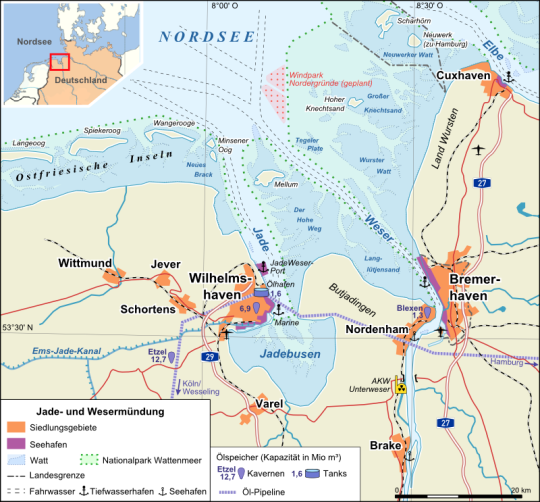
In the opening months of the Second World War, Britain had begun limited bombing efforts against Germany. Though the RAF had in its possession a sizeable force of long-range bombers, they lacked any fighters capable of escorting them. Night bombing had been a regular practice of the RAF in the years leading up to the war, but most raids would be conducted in daylight without fighter escort. Such missions went predictably poorly. Despite their comparatively heavy defensive armament, British bombers were far too vulnerable to German fighters. This vulnerability was demonstrated in its extreme in December 1939, when the RAF sortied 22 Vickers Wellington bombers to attack the Kriegsmarine base at Wilhelmshaven. The bombers were picked up by German radars an hour out from their targets, and, though they arrived over the target without being intercepted, they were followed much of the way home by a massive force of German fighters. Without escort, the bombers suffered the loss of 12 aircraft, along with a further 3 damaged. Though the RAF had suffered heavy losses before, this most recent engagement over Heligoland Bight was the final straw. Daylight operations were to be completely abandoned.
Freya Radar
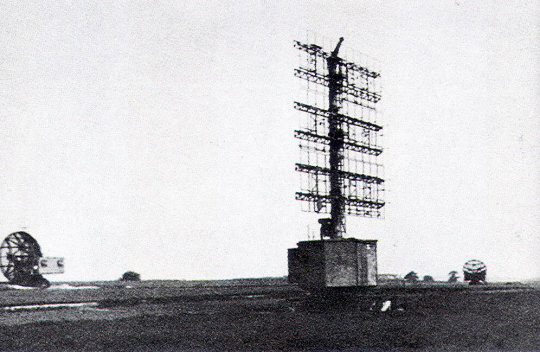
In early 1933, after promising tests of Sonar systems, the Kriegsmarine began experimenting with radar systems. Rudimentary systems were developed at first for a proof-of-concept, but, after successfully showing that a radar system could detect surface ships several miles away, the project gained significant support from the Kriegsmarine. While the Kriegsmarine went on to develop surface-search radars for their ships, the concept saw surprisingly little interest among the Luftwaffe. Though the Kriegsmarine’s radar experiments were showing the clear ability to detect aircraft at range as well, such a system was looked down upon for numerous reasons. First and foremost was an institutional bias against an early-warning network, as it was felt that such systems were purely defensive in nature and thus useless for Germany’s offensive focus. The Luftwaffe had its practical reasons to not want the systems, however, as they lacked a real command and control network that would be necessary to make the most of such systems.

Because of the resistance to air-search radars, it wouldn’t be until the eve of war that the first radar stations were deployed. In early 1937, after successfully delivering their first operational radar sets to the Kriegsmarine, the company GEMA began work on an air-search radar. Known as Freya, the new system was derived from the Seetakt radar developed for the Kriegsmarine, differing in its lower frequency range (120-166MHz vs 368MHz), longer wavelength (2.5m vs 50cm), and longer range (120km vs 20km). The Freya system was ordered by the Luftwaffe in 1938, with the first eight systems reaching service that year. Compared to the Chain Home system being used across the Channel, the Freya was considerably more advanced. With its smaller wavelength, it could use a smaller and more manageable antenna and provide higher resolution images for operators. However, this came at the cost of complexity - only eight Freya stations were operational when war broke out.
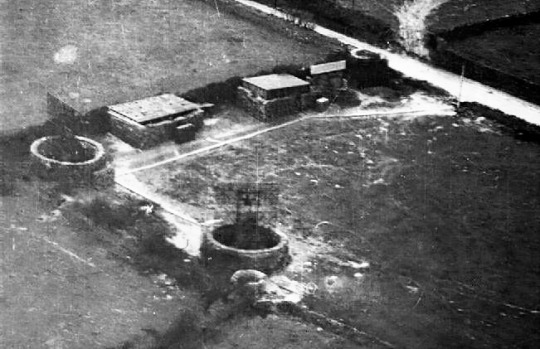
Though the Freya network had large gaps in its coverage early in the war, it would come to demonstrate its utility very quickly. When the RAF made their raid on Wilhelmshaven on December 18, 1939, they were picked up by two Freya radar stations at a range of 113km. Poor coordination prevented the Luftwaffe from intercepting the bombers before they made landfall, but Freya operators were able to guide intercepting fighters to the formation, leading to such devastating losses that the RAF would abandon daylight raids altogether. This success prompted a massive expansion of the radar network. Three more Freya nodes were operational by early 1940, and, once France fell, Freya installations began to pop up all along the occupied Atlantic coast.
Wurzburg

GEMA would follow up on the Freya radar with a more precise piece for guiding AAA and searchlights. First demonstrated in mid-1939, the new set - known as Wurzburg - was an ultra-high frequency radar with a range of 553-566MHz. With a wavelength of a little over 50cm, the Wurzburg could provide much more precise information, so much so that searchlights could be directed with reasonable accuracy towards individual aircraft. As originally conceived, the Wurzburg consisted of a 3-meter dish antenna on a manually operated rotating mount. Tracking targets was done by scanning for a maximum return on the oscilloscope display. In this arrangement, the Wurzburg was hardly a very practical device. Tracking targets was difficult, and, with a range of under 30km, the system was reliant on other elements of the early warning network to alert them of incoming aircraft.
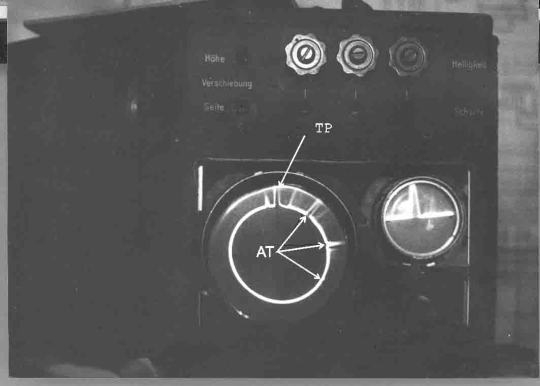
The first Wurzburg sets made it into service in 1940, and very quickly they began to prove their worth. In May 1940, Wurzburg sets were credited with their first shoot-downs, with crews tracking targets and verbally relaying the commands to nearby flak and searchlight units to engage aircraft. As the Kammhuber Line took shape, the Wurzburg set became an integral part of German night-fighting operations. Freya radars would detect incoming aircraft at a standoff range, relaying a general area for the Wurzburgs to scan. Wurzburgs within range would then search for the aircraft, directing nearby flak and searchlights, and even the occasional fighter, to the incoming aircraft.
Night Fighters: Messerschmitt Bf 109
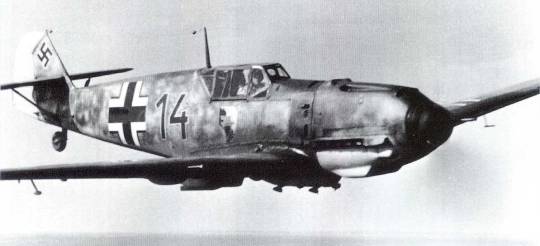
The first fighter the Luftwaffe would commit to night fighting duties was the ubiquitous Bf 109. With no dedicated night fighters in the inventory at the outbreak of war, the Bf 109 was pressed into the role. The Bf 109 was hardly an ideal platform for the role, being a short-ranged single-man machine with no special equipment for night fighting. However, with an onboard radio, the Bf 109 could be directed by ground stations to incoming aircraft. By 1940, the practice of night fighting with the Bf 109 had been fairly well ironed out. Freya radars would detect inbound enemy bombers, and a general intercept area would be relayed to sortieing Bf 109s. Searchlights would then attempt to illuminate the target aircraft, allowing the fighters to acquire the targets visually to engage. With the arrival of the Wurzburg sets later that year, the effectiveness of such missions increased. However, the Bf 109 remained far from an ideal platform, and, with the limited resources available for the defense of the Reich, the practice was unable to prevent RAF bombers from getting through. For the time being, the Bf 109 could manage, as poor navigational practices were making RAF raids incredibly ineffective. However, the RAF was rapidly improving, so something better than the Bf 109 was needed.
Kammhuber Line

As France began to fold under the weight of the German offensive, the Luftwaffe took the opportunity to expand its early warning network. Starting in June 1940, the Freya radar network was expanded into occupied Europe, with stations growing to cover the the mouth of the Rhine to the Denmarks Straits. Meanwhile, in July 1940, Generalmajor Josef Kammhuber was placed in charge of the Reich’s flak, searchlights, and radars. When Kammhuber arrived, the system was in great disarray. Though local cooperation existed between stations and flak batteries, there was no single chain of command. The lack of communication was so poor that newly-developed operational practices were not being shared between stations, causing effectiveness of the air defenses to vary massively by region. Kammhuber swiftly addressed this. A new, streamlined command system was put in place, coordinating communication between radars, flak batteries, and night fighters. Construction continued until March 1941. As the Allies came to recognize the new network of defenses, they would dub it the Kammhuber Line.
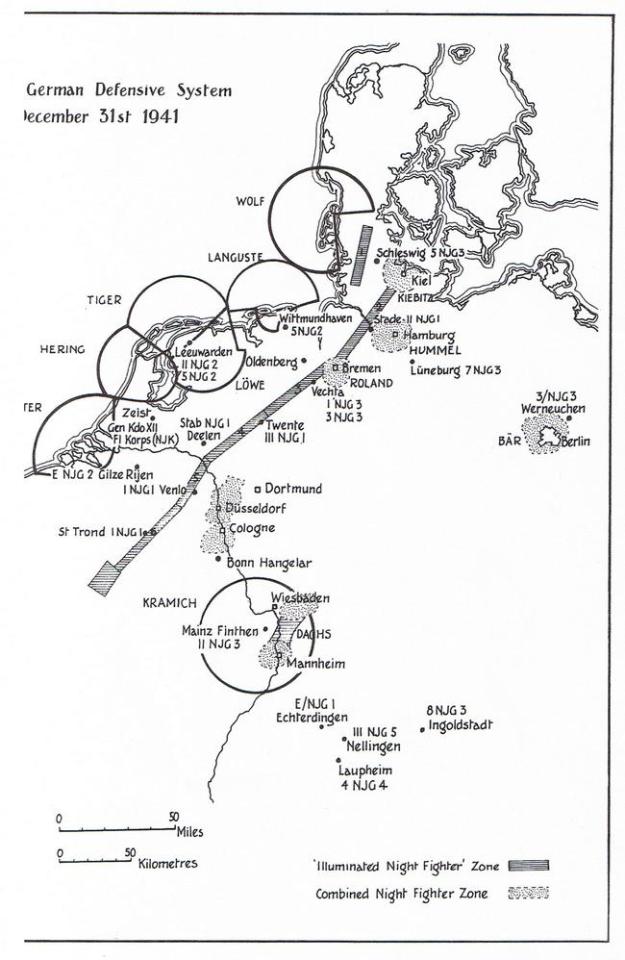
The Kammhuber Line consisted of a well-organized network with three successive zones extending east from the North Sea. The first line was broken into “boxes” roughly 20 by 20 miles in size centered on control centers. Each box was assigned a single Freya radar system and two Wurzburg radars - one to track the bombers for searchlights, and the other to guide night fighters. Manually guided searchlights and flak batteries were also spread throughout the boxes, and a two night fighters - one primary and one backup - were assigned to the box. The three radar sets reported directly to their local control center, which used the data from the three sets to plot the movement of the incoming bombers and keep track of friendly fighters. Behind this frontier line were the “Henaja” (helle Nacthjagdraume) sectors, which consisted of belts of searchlights roughly 22km deep with night fighters assigned to them. Unlike the first line of defenses, the second line was reliant on sound detection equipment to alert operators of an incoming raid. Once the bombers were detected, night fighters were sortied, orbiting local beacons and waiting for the incoming bombers to be illuminated by the searchlights. Like the first layer, however, sectors were limited to just a single night fighter at a time to reduce confusion.
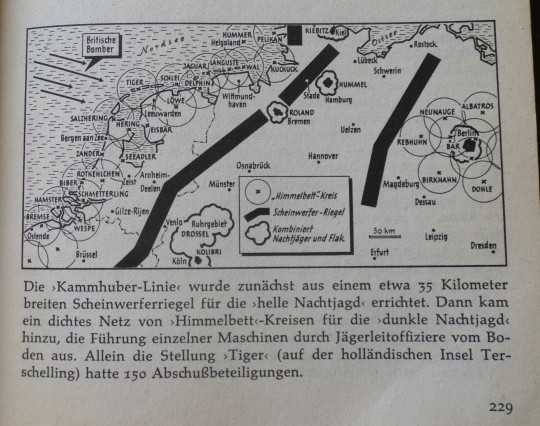
Beyond this second line of defenses, a final zone was established to protect target areas more directly. These final zones were a mix of the previous two. Defended by both night fighters and flak, they were the last line of defense over German cities and industrial areas. Berlin was given an extra line of defenses as well, with a Henaja sector west and northwest of the city in addition to the mixed sector over the city itself. Kammhuber’s system would evolve over time. When construction began in 1940, the Wurzburg radar had yet to enter service, so ground operators were reliant on just the less-accurate Freya. As the Wurzburgs became available, however, they came to augment the line. Once the air defense sectors along the front of the line were filled out, Wurzburg sets began to move backwards, in particular augmenting and finally replacing the impractical listening posts that supported the Henaja zones.

Though the Kammhuber Line was still under construction through the end of 1940, its effectiveness rapidly became apparent. In the second half of 1940, 170 RAF bombers were lost in raids on Germany. 72 were credited to Kammhuber’s night fighters, while 42 more were credited to regular Luftwaffe fighters and 30 to ground fire. With fewer than 60 aircraft operating across 16 Staffeln, the Kammhuber Line had inflicted a higher loss rate upon the RAF than the Luftwaffe had suffered in their own bombing campaign against Britain. And as the Line only continued to improve, RAF losses mounted. In 1941, 421 RAF bombers were lost to the Kammhuber Line. Unfortunately, things were not going entirely to Kammhuber’s plans. Kammhuber hoped to support the domestic defenses with an offensive campaign against the RAF’s bomber airfields. Though a modest campaign had been conducted through 1941, operations against the bombers never saw much priority, and, as the bombing of England ceased, the RAF received a much-needed relief that would only allow them to intensify their campaign.
Night Fighters: Messerschmitt Bf 110
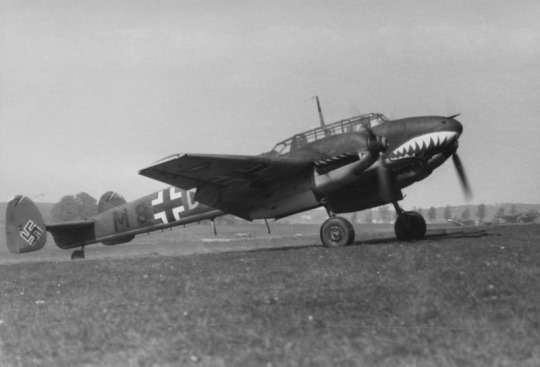
As the Bf 110 had proven itself to be incapable of holding its own as a frontline fighter, the fighter was gradually drawn back in the Fall of 1940. Small numbers of Bf 110s were passed onto Kammhuber’s night fighter forces, immediately proving its worth. Though the Bf 110 lacked the agility of the Bf 109, such shortcomings were of little consequence as a night fighter. However, the Bf 110 massively outperformed the Bf 109 in areas that mattered for night fighting - endurance, firepower, and extra carrying capacity. Early operations were not unlike those of the Bf 109 - unmodified fighters being directed by ground control to targets. Though the system was far from ideal, the low rate of bomber attacks and limited damage being done meant that the Bf 110 was more than good enough to get the job done.
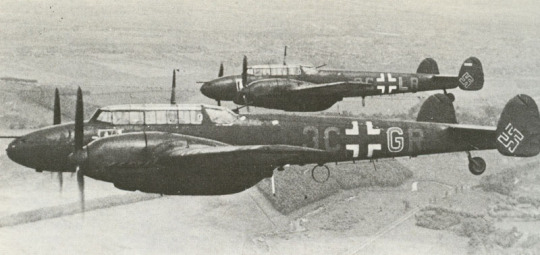
Because of the limited effectiveness of the ground-based radar system, the Bf 110 would find itself at the forefront of efforts to make interceptions easier. By 1941, the new Bf 110E series was entering production, with two dedicated night fighter variants developed. The first made use of the spacious airframe to mount a passive infrared device - Spanner Anlage - to detect exhaust flares from British bombers. Its success was limited, as the British quickly modified their bombers to muffle the engine flare. The more successful variant was a simpler conversion, merely adding a third crewman to give the fighter an extra set of eyes. By mid-1941, however, these were being superseded by the Bf 110F-4 - the first purpose-built Bf 110 night fighter. The F-4 was designed around two new systems - the Lichtenstein air-intercept radar and the Schrage Musik upward-firing cannons. Though these too would be replaced by a newer variant, they marked a major leap in the Bf 110’s night-fighting abilities.
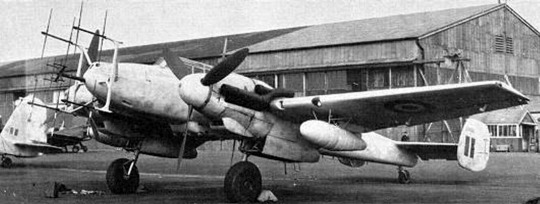
The ultimate development of the Bf 110 night fighter would be the Bf 110G-4. Designed from the start to mount an air intercept radar, the G-4 would see constant updates to its electronics suite to keep it relevant. By the time the Bf 110G-4 began entering service in mid-1943, it was now seen as one of the less capable night fighters, owing to its lower endurance and limited firepower. A series of field modification kits would arise, doing everything from augmenting firepower (either with Schrage Musik guns or replacing the 20mm cannon with 30mm Mk 108s) to expanding fuel capacity. Despite shortcomings, the Bf 110G-4 would be the mainstay of the Luftwaffe’s night fighter corps. Production was handed off to Gotha, with over 1,800 built before production finally ended in February 1945.
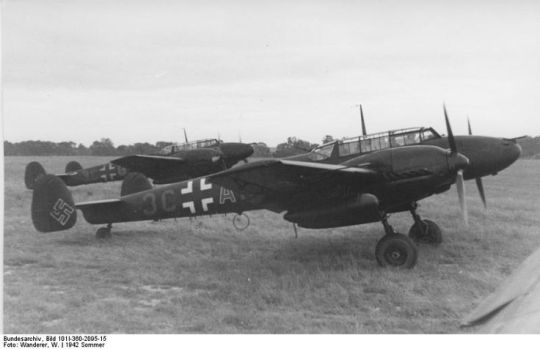
With the introduction of the dedicated night-fighter Bf 110 variants, RAF losses spiked. Even as the RAF began introducing tactics like the Bomber Stream to overwhelm defenses, the Bf 110 exacted a heavy toll on the bombers. The introduction of such systems like the airborne radars and Schrage Musik armament would massively improve the Bf 110’s effectiveness, and, in 1943, Bf 110s would play a part in the destruction of 2,751 RAF bombers. Unfortunately, this excellent performance would not last forever. The introduction of countermeasures such as Window and feint attacks with de Havilland Mosquitos confused defenses and often led to the (comparatively) short-ranged Bf 110s straying too far from the real targets to make interceptions. Worse, Goering was forcing Kammhuber to commit the night fighter force to combatting the daylight raids as well, leading to heavy attrition.

Though losses would subside after the heavy fighters were finally withdrawn from daylight operations, the Bf 110 would get little respite. The development of radar warning receivers by the RAF allowed for the bombers to start being accompanied by escort night fighters. Weighed down by the heavy night fighting equipment and unable to distinguish on their radars between RAF bombers and their accompanying night fighters, the Bf 110s would begin to suffer increasing losses on night missions as well. Losses only continued to worsen as the war went on, and, as the Kammhuber Line fell apart in late 1944, the Bf 110 was no longer capable of operating effectively. The Bf 110 continued flying as a night fighter to the end of the war, but production would halt in February 1945 to free up resources for more promising endeavors.
Night Fighters: Junkers Ju 88
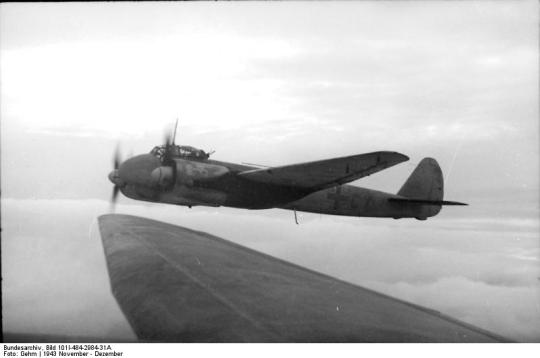
As the Kammhuber Line took shape, small numbers of Ju 88Cs were committed to serve as night fighters. The Ju 88C was originally developed as a heavy fighter, with three MG 17s and a single 20mm MG FF installed in a new solid nose. At first flying with a Zerstorerstaffel of KG 30, they were broken off in July 1940, forming II./NJG 1. Unfortunately, lackluster performance in the early months of the war meant that production of the Ju 88C was limited, even after it took on the night fighter role. After becoming I./NJG 2 in September 1940, the sole Ju 88C unit took a more aggressive stance in the defense of the Reich. Unlike the Bf 110s, which were mostly kept in the rigidly structured network Kammhuber had developed, the Ju 88C was flown on night intruder missions over Britain. These missions coordinated with intercepted RAF radio transmissions and projections from friendly radars, with Ju 88s sortied to intercept the RAF bombers over England as they returned to their airfields. The Ju 88s would orbit the bomber airfields, picking off the aircraft as they presented themselves. Alternatively, payloads of bombs would be dropped across runways.
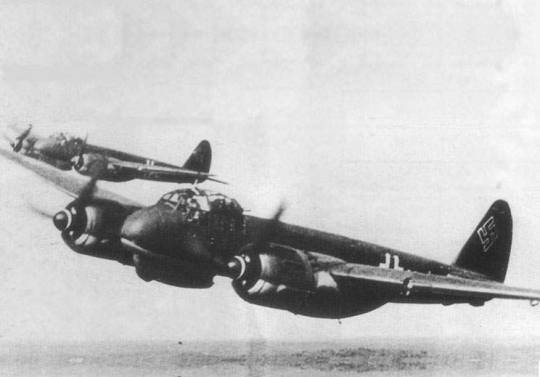
Operations continued for a year with excellent results. Though they started with just 7 aircraft on hand, the unit claimed 143 RAF bombers. Unfortunately, attrition of the fleet and the lack of any tangible results would lead to Luftwaffe commanders halting the attacks on Britain in 1941. With the night intruder mission over Britain over, I./NJG 2 was shifted south the the Mediterranean in October 1941. IV. and II./NJG 2 followed soon after with deployments to Sicily and Benghazi, respectively. Their first kills came in December, when a Ju 88C downed a Beaufighter over Crete, and several days later, a Hurricane was claimed as the fighters escorted Ju 88s making attacks on Malta. Through 1942, Ju 88Cs were spread across the Mediterranean to meet night fighter needs. Despite lacking a coherent air defense network like the Luftwaffe enjoyed over Northern Europe, the Ju 88Cs performed reasonably well. In October 1942, Leutnant Heinz Struning of IV. /NJG 2 was awarded the Knight’s Cross of the Iron Cross for downing 24 enemy aircraft.

The Ju 88 returned to Germany as a night fighter in early 1942, when the first Ju 88Cs equipped with the new Lichtenstein air-intercept radars entered service with I./NJG 1. Flying their operational trials with the unit, they performed well enough to be ordered into production in the new configuration. Delays in production slowed the type’s entry into service, but by the start of 1943, the radar-equipped Ju 88Cs and newly developed Ju 88R (mounting the BMW 801 engine along with radars) had reached squadron service in significant numbers. Unfortunately, just as operations kicked off, disaster struck. A Ju 88R, complete with a full crew and all its advanced electronics, defected to Britain in May 1943. The capture of an intact Lichtenstein radar system allowed the RAF to refine their tactics and countermeasures, leading to the development of the Window chaff system that began to appear in the skies over Europe in July 1943.
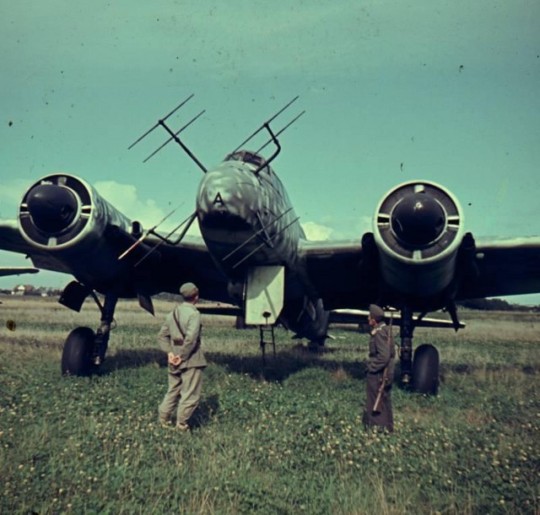
As the new countermeasures compromised the Kammhuber Line, the Ju 88s were forced to adapt. Newly developed tactics called for night fighters to be sortied once a raid was determined to be coming, with the fighters orbiting beacons until the bomber stream was identified. Such tactics put an emphasis on high endurance - something the Ju 88 had over all the other night fighters. With this newfound superiority, production of the Ju 88 night fighter variants accelerated. These new tactics, coupled with the arrival of the newest radar systems, mitigated the impact of the British countermeasures and led to mounting losses. By the end of 1943, losses among the RAF bomber forces were getting unsustainably high.

In late 1943, the ultimate night fighter variant of the Ju 88 entered production. Designated Ju 88G, the new variant was a major overhaul of the design. An all-new fuselage was built for the Ju 88G, omitting the Bola ventral gondola and introducing the enlarged tail of the Ju 188. Powered by the BMW 801 radial engine, the Ju 88G was fitted with the newest electronic equipment - the FuG 220 Lichtenstein radar in the nose and FuG 350 Naxos or FuG 227 Flensburg radar detector in fairings around the aircraft. Four 20mm cannon were carried in a ventral pack, while provisions for two more in a Schrage Musik upward-firing mount were also added. Fuel tanks were also expanded to increase the fighter’s endurance.

Though the Ju 88G marked a new level of effectiveness among the night fighters, it too would soon be the center of disaster when a Ju 88G-1 mistakenly landed in Essex after an issue with the onboard compass. The newly developed radars were captured, and the RAF developed a modified version of their Window countermeasures that once again left the night fighters blinded. By the time new radar sets were available to regain the advantage, the worsening situation on the ground was becoming more critical. The Kammhuber Line began to fall apart at the end of 1944, meaning the early warning radar network could no longer be relied on. Worse, fuel shortages were now hitting the night fighter fleet, negating the Ju 88’s endurance advantage. The final blow came at the end of the war, when the Luftwaffe threw its night fighters back into daylight combat, with predictable results. Already having suffered heavily in 1943 when used against daylight raids in friendly air superiority, the Ju 88 night fighters couldn’t hope to compete in the face of Allied air supremacy. After suffering catastrophic losses, the fleet was finally grounded in early April 1945 owing to fuel shortages.
Dornier Do 17
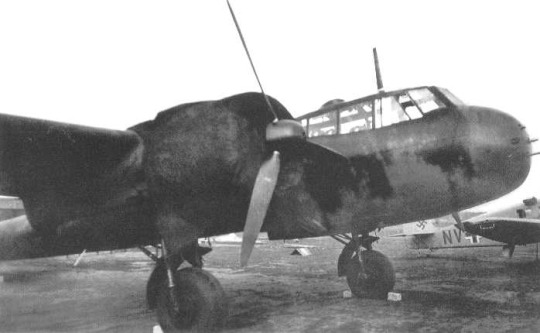
When production of the bomber Do 17Z variants ended in 1940, Dornier began experimenting with night fighter variants. Three Do 17Zs were fitted with the solid nose from the Ju 88C, turning it into the Do 17Z-7. Armed with three machineguns and a 20mm cannon, the Do 17Z-7 had a large fuel tank installed in the bomb bay and an armored plate placed in front of the crew compartment to protect the crew from defensive fire from the bombers. A more substantial reworking in the form of the Do 17Z-10 followed, with armament revised to four machineguns and two 20mm cannon and a Spanner-Anlage infrared detection system installed. However, conversions were limited - only about 10 Do 17s were converted to the new standard. Entering service in 1940, they saw limited use. Crews found the Do 17 to be inferior to the Ju 88 night fighters, and, though experiments were done with mounting the Lichtenstein radars on the Do 17s, the fleet was never fully converted, and surviving aircraft were withdrawn from frontline service in the summer of 1942. Despite a generally poor service record, the type did see use by some of the night fighter Experten, particularly Helmut Woltersdorf.
Dornier Do 215B-5
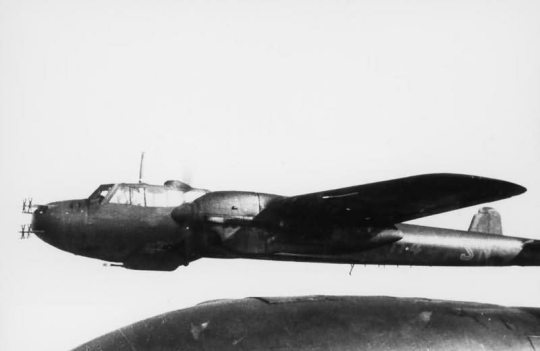
Dornier would also convert a number of Do 215s to night fighters. Taking 20 B-1 and B-4 variants, Dornier modified the aircraft along the same lines as the Do 17Z-10 conversion, with four machineguns, two cannons, and a Spanner-Anlage IR system in the nose. It followed the Do 17Z-10 into service, flying with elements of NJG 1 and 2. The IR detector in the nose rapidly proved to be useless, so, as the Luftwaffe experimented with the new Lichtenstein radar, the Do 215B-5 would be among the first aircraft to be upgraded with the new system. Unlike the Do 17Z-10, the whole fleet of Do 215B-5s would be converted to carry the Lichtenstein radar in 1942. Even with these conversions, however, the Do 215B -5 wouldn’t last much longer than the Do 17 night fighters - the Do 215 doesn’t appear to have lasted in the night fighter role into 1943.
Wurzburg-Riese
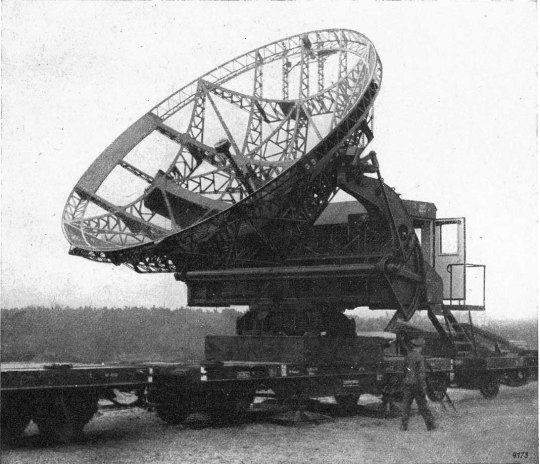
In 1941, GEMA followed up on their successful Wurzburg system with a larger, more sophisticated set fittingly known as Wurzburg-Riese (giant). Making use of the same conical-scanning system developed for the “regular” Wurzburg sets, the Wurzburg-Riese was a much larger system with a 7.4 meter antenna and much more powerful transmitter that gave it a range of up to 70 degrees. Combined with the added accuracy afforded by the conical scanning system, the Wurzburg-Riese provided the Luftwaffe with a long-range system capable of providing accurate enough information for gun-laying. Because of the dish’s larger size, the Wurzburg Riese was placed on a powered mount, complete with an enclosed cabin for the crew to work in. The Wurzburg-Riese began to enter service in 1941, and over the course of the war roughly 1,500 would be built. However, it appears the Wurzburg-Riese never fully replaced the smaller Wurzburg sets. Rather, production and use continued alongside the regular Wurzburg until the end of the war. Though only the Wurzburg-Riese was accurate enough for gunlaying, the conical scanning system was still accurate enough for the regular Wurzburg to direct night fighters and searchlights, all while being significantly less resource-intensive to produce and operate.
Lichtenstein

Though a sophisticated ground-based radar network would be established by early 1941, there was still a glaring need for an aircraft-based system for the night fighters. The first such system would take shape in mid-1941, a product of the Telefunken company known as Lichtenstein. The Lichtenstein radar sets consisted of four cross-shaped antennas mounted in the nose of an aircraft. Operating at 600 MHz, the system had a fairly short range - maxing out at just 4 kilometers and having a minimum range of 200 meters - but, with the accuracy afforded by conical scanning and the aid of ground-based systems would mean that the fairly limited capabilities of the system were still a major leap. Limited operational trials were conducted in 1941, but it took until 1942 for the Lichtenstein radar to get into service as Telefunken refined the system.
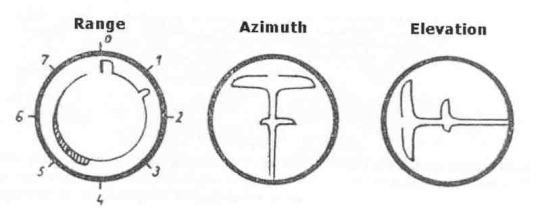
The first Lichtenstein B/C FuG 202 sets entered operational service in early 1942 aboard Ju 88s and Bf 110s. Intercepts with the new system continued with the same practices that Kammhuber had developed. Freya radars would detect the incoming bombers at a distance, directing the Wurzburg sets as the targets got closer, which would then in turn direct the night fighters as they closed in. The FuG 202 would be used in this critical final stage of the intercept, allowing the onboard radar operator to direct the pilot to the target rather than relying on a less accurate ground-based set. The impact of the Lichtenstein was quickly apparent to the RAF. Losses rose, and operators listening in on German radio transmissions were regularly hearing references to an “Emil-Emil.” It wouldn’t be until late in 1942 that the RAF finally learned that it could be an air intercept radar. To confirm the suspicions and learn what kind of radar they were working against, the RAF sent out a lone Wellington bomber fitted with radar receivers to gather details about the frequency range of the new radars. The mission was a success - the Wellington was intercepted, and, though badly mauled, it made it home with data on the new system.
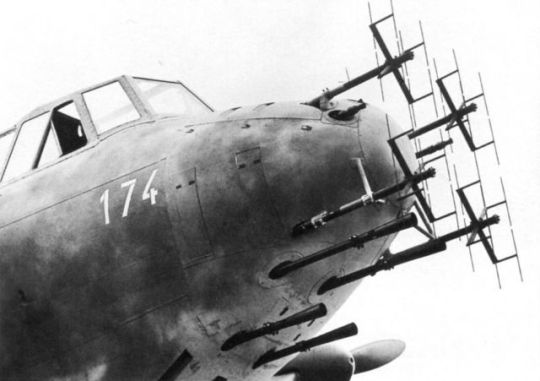
Though this data would prove useful for the RAF, they wouldn’t be able to develop a truly useful countermeasure until a Ju 88, complete with an intact FuG 202 and mostly cooperative crew, defected in May 1943. With a full working set now in their hands, the RAF was able to tailor a new countermeasure - chaff deployment codenamed “Window” - to the radars. By the time this was ready, however, the Lichtenstein B/C was already old news. The FuG 202 had been refined into the FuG 212 by dropping its frequency to extend range and provide a wider view angle, but this too was soon superseded by a far more advanced set. Designated FuG 220 and known as the Lichtenstein SN-2, the new set dropped to a far lower frequency - 81 MHz - that provided a much longer range, wider field of view, and, most critically, relative immunity from British jamming. Because the FuG 220 operated in the same range as the Freya, it took time for the British to recognize its presence. The FuG 220 required a larger antenna array in the nose, producing more drag, and, with a minimum range of 500 yards in early sets, it still lacked the ability to perform close-range targeting. To compensate, the old B/C sets would stick around for a bit, albeit in a greatly reduced form, as it was found that the drag from both the FuG 202 and 220 mounted simultaneously was unacceptable.
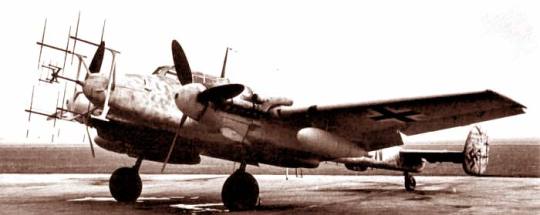
Because of the appearance of the Lichtenstein SN-2, the new British countermeasures were far less effective than the RAF had hoped. Though a combination of jamming and Window deployment, the Lichtenstein B/C was effectively blind for the latter half of 1943, but the RAF struggled to counter the SN-2. It wouldn’t be until July 1944, when a Ju 88G equipped with a FuG 220 radar mistakenly landed in Britain due to a navigational error, did the Allies finally develop countermeasures for the SN-2. Jamming was fine-tuned to the new sets, and the Serrate radar warning receiver was developed to allow for Mosquito heavy fighters to hunt down and destroy German night fighters by tracking their radar emissions.
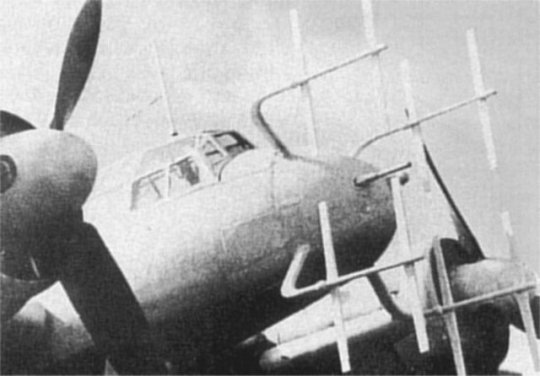
With the Lichtenstein SN-2 compromised, the system’s days were numbered. As jamming closed off the bands in which the Lichtenstein operated, some units transitioned to other sets operating on different bands, while others reworked their antennas to optimize them for the still-operational bands. Attempts were made to refine the Lichtenstein into a new system that could work on a wider spectrum, but by then the war was reaching the point where it made little difference. The last development of the Lichtenstein - the FuG 228 SN-3 - was small enough to fit in a streamlined fairing in the nose of a Ju 88G, but it arrived so late in the war that it saw little service. Even if they had managed to see significant service, they would have been of little use as Germany’s air defense network dissolved.
Dornier Do 217

Dornier’s next attempt to produce a night fighter would be a conversion of their Do 217 bomber. Owing to shortages of Bf 110s and Ju 88s, the decision was made to experiment with a night fighter variant of the Do 217E. Taking shape as the Do 217J, the aircraft was given a new solid nose with four forward machineguns supplemented by four 20mm cannon placed in the ventral gondola. The dorsal turret of the bomber was retained, as were the bomb bays, meaning the night fighter could still carry a payload of eight 50kg bombs. As the prototype, converted from an E-2, took shape in early 1942, it would also mount a FuG 202 radar and Spanner-Anlage infrared sight. Poor performance of the IR system lead to its omission on early series Do 217Js, and, owing to availability issues, the FuG 202 would not make it onto the first series of production, but overall, the prototype performed well enough for production to begin in March 1942.

The first Do 217J-1 reached 4./ NJG 1 soon after production began. Though it carried a formidable armament, it was not popular with crews. The Do 217J was found to be too heavy and unwieldy, with a poor climb rate and unsatisfactory takeoff and landing characteristics. Because of the decision to retain much of the bombing equipment, the Do 217J was significantly heavier than the Do 217E it was derived from. Nevertheless, production continued through 1942. Because the fighter retained its bomb bay, they picked up the night intruder mission that had been halted in 1941, intercepting and harassing RAF bombers as they returned home. However, this role was short-lived, and, as the Luftwaffe again abandoned night intruder missions, the order was given to halt Do 217J production. Dornier kept the production lines going, but by the end of 1942 only 130 Do 217J-1s had been built.

The J-1 was followed by the J-2, which aimed to address some of the shortcomings of the design. The Do 217J-2 installed the FuG 202 radar in the nose of the fighter and faired over the bomb bay, while the MG FF/M cannon were replaced with MG 151/20 cannons. Unfortunately, these changes did little to alleviate complaints, and in May 1942, Erhard Milch ordered Dornier to cease work on night fighters. Nevertheless, Dornier continued to refine the design, producing the Do 217N. The Do 217N addressed the sluggish performance of the J series with more powerful DB 603 engines, and, as trials of Do 217Js with the Schrage Musik armament were promising, the N-series was fitted with upward-firing guns. Fuel tanks would fill the faired-over bomb bay, though bomb release mechanisms remained, and a host of advanced navigational equipment - including the FuG 202 radar - was installed.
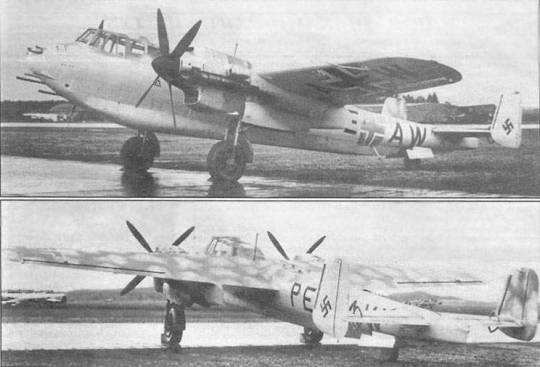
The Do 217N series entered service in January 1943. The N-1 proved just as disappointing as the earlier J-series, with its high endurance coming at the cost of poor performance, but, with the arrival of the N-2, Dornier finally had a workable night fighter. The N-2 finally removed the defensive armament and bomb release mechanisms from the design, dropping weight by two tonnes and allowing for major improvements in performance. Even with the changes, however, the Do 217N’s service was brief. The Luftwaffe began phasing out the type soon after it entered service, and it appears that none lasted beyond mid 1944. Despite consistently unfavorable reports, the Do 217 quite a bit of use by the night fighter corps. Over 300 Do 217 night fighters were built, and the aircraft flew with 11 Gruppen - though they never fully equipped any. Their high endurance gave them a niche advantage, making them particularly useful when deployed over Italy or the Eastern Front. When flying directly in defense of the Reich, however, they were generally found to be less capable than the other night fighters they served around, and, apart from a couple notable pilots like Rudolf Schoenert, crews tended to prefer other aircraft.
Schrage Musik

In 1941, Oberleutnant Rudolf Schoenert of IV. /NJG 2 began experimenting with a new armament layout on his Do 17. Rather than adding extra cannons firing forwards, he mounted two 20mm cannon behind the cockpit angled upwards. Though far from a conventional layout, it offered the benefit of allowing the night fighter to attack British bombers from below, where they lacked any defensive armament. Despite skepticism, Schoenert modified his Do 17Z-10 in late 1941 for operational trials. After several months of experimenting, Schoenert presented the idea to General Kammhuber, who authorized the conversion of three Do 217J-1s for further trials. Fitted with four to six upward-firing guns, the machines flew countless tests through the end of the year, allowing the Luftwaffe to refine the layout. Installed at an angle between 60 and 75 degrees, the arrangement would allow for the attacking aircraft to perform modest maneuvering while still keeping the target in its sights.
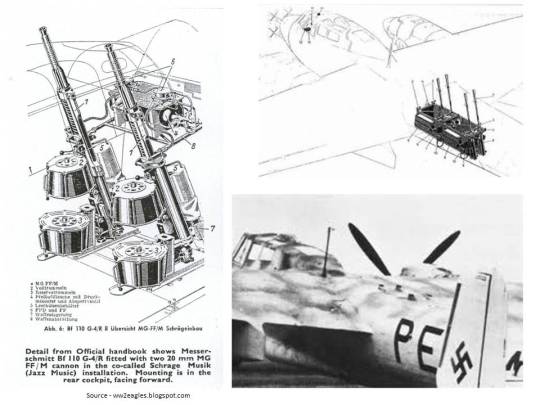
After trials showed the arrangement to be sound, Schoenert was put in charge of II./NJG 5, where he began modifying the Gruppe’s Bf 110s with the new gun arrangement, now known as Schrage Musik (Jazz Music). The conversion for the Bf 110 was fairly simple - a pair of MG FF/M 20mm cannon were mounted in the rear of the crew compartment, extending through holes cut in the top of the canopy. Schoenert himself took the system to the skies, claiming his first kill with it in May 1943. Meanwhile, conversion kits were developed for the Luftwaffe’s other night fighters as well. In June 1943, kits were produced for the Ju 88 and Do 217N, and, by August, enough fighters were equipped with the system for it to finally make its operational debut. Unsurprisingly, Schoenert himself became an expert with the system, claiming 18 kills from August 1943 to the end of the year using the Schrage Musik system.
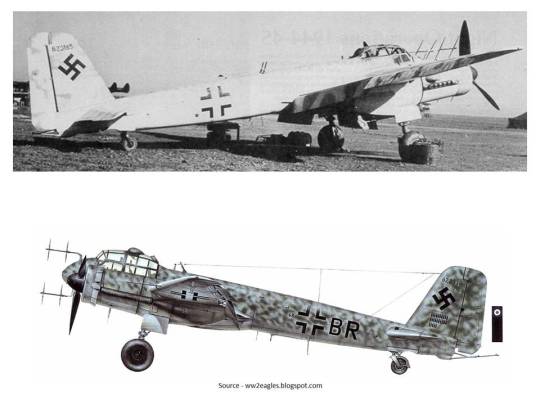
The first operational use of the Schrage Musik system by pilots other than Schoerner came in August 1942 when the RAF bombed Peenemunde. Though diversionary tactics prevented the night fighters from intercepting the first two waves of the bombers, the third wave was caught by the Schrage Musik-equipped night fighters with devastating results - 40 bombers were lost. The success of the system prompted more conversions, and by 1944, a third of all night fighters mounted Schrage Musik guns. Even better, the arrangement was designed into the newest Ju 88 variant - the Ju 88G - and the new He 219. Overall, the Schrage Musik system was devastatingly effective. By the winter of 1943-44, Schrage Musik-equipped fighters were inflicting such a toll on RAF bombers that losses were no longer sustainable. Even better, because the profile kept the attacking aircraft out of view of the bomber’s gunners, Bomber Command was slow to recognize the threat, thinking that it was just unusually accurate flak.

Once the RAF did finally realize where the attacks were coming from, several changes were made. Some bombers were modified in the field with makeshift ventral gun mounts, and others resorted to faired-over observer positions to allow dorsal gunners to keep a look out for night fighters below them. The decision to mix in Mosquito night fighters with the bombers also helped, as the slow, docile flight profile required for Schrage Musik attacks left the night fighters in no position to defend themselves. Even so, the Schrage Musik was never fully countered, and it remained an effective weapon right up to the end of the war.
The Bomber Stream
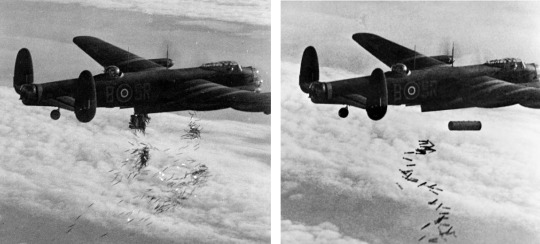
With the Kammhuber Line inflicting ever greater losses upon the RAF’s bombers, a major change in tactics was needed. In the early stages of the war, RAF practices called for bombers to fly individually, with each bomber navigating alone so as to avoid inflight collisions and allow them to better maneuver around air defenses. However, this made the bombers easy targets for Kammhuber’s night fighters. The development of the GEE radio navigation system offered part of a solution by allowing bombers to fly together in formations at night, but standard practices still meant that bomber formations would be vulnerable to enemy fighters. At the end of 1941, RAF officials, following the recommendations of strategist R. V. Jones, looked into a new concept. Known as the “bomber stream,” the practice was less a countermeasure than a brute-force approach. The bomber stream seized upon the limitations of the Kammhuber Line - which could only handle six interceptions per cell per hour - by concentrating bombers into a single cell and overwhelming local defenses. By concentrating hundreds of bombers along the same stream, the bombers could not only reduce losses and overwhelm defenses, but reduce the time the bombers were over their targets from a four-hour window (with the older individual approaches) to just a 90 minute period.
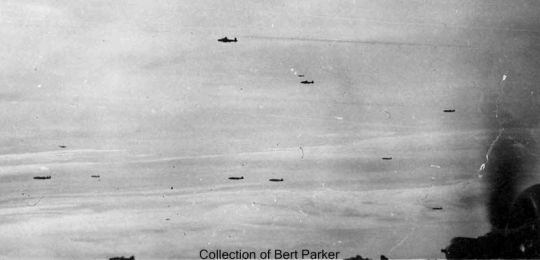
The Bomber Stream would make its debut over Cologne on the last night of May 1942. Under the codename Operation Millennium, Bomber Command would launch the largest raid the world had yet seen. Every single aircraft available was earmarked for the raid, with aircraft and crews drawn from training units and spares. In doing so, Bomber Command was able to field 1,047 bombers - more than double their “regular” strength of only about 400. Though “only” 868 aircraft were aimed at Cologne itself, the new tactic was tremendously effective. 1,455 tons of bombs were dropped on Cologne, two thirds of which were incendiaries. Nearly 13,000 buildings were destroyed, killing nearly 500, injuring 5,000, and displacing 45,000. And for all the damage done, losses were light - just 43 bombers were lost, and only four were downed by night fighters. With a loss rate of under 4% and devastating damage done to Cologne, the Bomber Stream had proven itself.

After the devastating raid on Cologne, Kammhuber was left scrambling to rework the night fighter system. Clearly, the rigidly structured system was not capable of dealing with massive raids like the British had just conducted. The only solution - break the rigid structure and divert all available night fighters to the stream - was itself stretching the abilities of the Kammhuber Line, and, to implement it, Kammhuber needed a major expansion of the air defense network. More powerful Wurzburg sets were brought in to expand the size of individual night fighter boxes, and the boxes were expanded backwards several lines deep to allow night fighters to follow the stream into Germany. The new tactics worked, though it took time for the changes to take effect. Losses slowly crept back up to the rates they were at before the bomber stream was implemented, forcing the RAF to develop new solutions.
Erhard Milch Ruins Everything
Following the disaster that was the 1,000-bomber raid on Cologne, Kammhuber began looking for a new dedicated night fighter to supplement his forces. The appearance of the de Havilland Mosquito that same month would set the de facto requirements for Kammhuber’s new night fighter. A new high-performance machine was needed, capable of carrying all the night fighter equipment for tracking and killing bombers while still being fast enough to intercept the Mosquito. Despite constant contention with the head of the RLM, Erhard Milch, the need for such an aircraft was generally agreed upon. The issue came in procurement. Kammhuber was greatly interested by a design Heinkel had proposed, going as far as ordering it into production without consulting the RLM after seeing the aircraft in November 1942. Milch, who had personally rejected Heinkel’s design earlier that year, had instead favored a competing design from Focke Wulf. Outraged that Kammhuber went behind his back, Milch got Kammhuber reassigned to Luftflotte 5 in Norway while repeatedly trying to cancel Heinkel’s winning design. Only after Focke Wulf’s contender proved impractical and the Ju 388 ended up being failures did Milch finally relent, but by the time production was finally allowed to resume two years had passed and the new fighter would not be able to make a significant impact on the war.
Heinkel He 219

Heinkel’s new night fighter began life in 1938, when Robert Lusser transferred from Messerschmitt and began work on an advanced high-speed bomber project designated P.1055. The P.1055 was to incorporate a host of modern features, including a pressurized cockpit, the first ever ejection seats planned in a combat aircraft, tricycle landing gear, and remote-controlled defensive armament. Powered by the coupled DB 610 engine, it was to have a top speed of 470mph. Unfortunately, the RLM rejected the design when it was first proposed in August 1940 on grounds of its complexity, and even though Lusser reworked it with various new engines and wing planforms, it was again rejected in 1941. However, as Kammhuber began looking for a new night fighter, Heinkel quickly reworked the design to meet the new requirements. The design shrank slightly and used two DB 603 engines with annular radiators. Heinkel saw the design as so promising that he personally funded a prototype while the proposal was sent off to the RLM in early 1942. However, the RLM again rejected the design, opting in favor of Ju 88 and Me 210 variants.
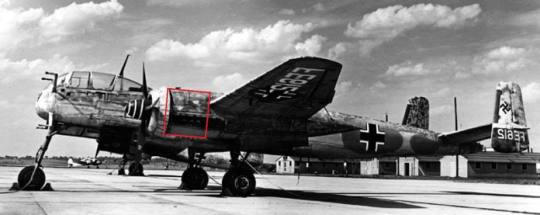
Despite the rejection, Heinkel continued on with the prototype. Because of engine shortages, Heinkel had to make do with a different variant of the DB 603 poorly suited to high altitudes for the prototype. Even then, the engines weren’t ready until August 1942, meaning the prototype wouldn’t fly until early November 1942. The prototype was demonstrated to Kammhuber on November 19, who was so enthusiastic about the aircraft that he immediately ordered it into production as the He 219. Meanwhile, Heinkel refined the design. Defensive armament was removed due to the ineffective mount, and, with weight “freed up,” forward firing armament was increased by adding two 20mm cannon in the wing roots. Combined with the ventral tray carrying four more cannon, the He 219 would have a formidable armament. Being a night fighter, the He 219 also had room for a Lichtenstein radar in the nose.
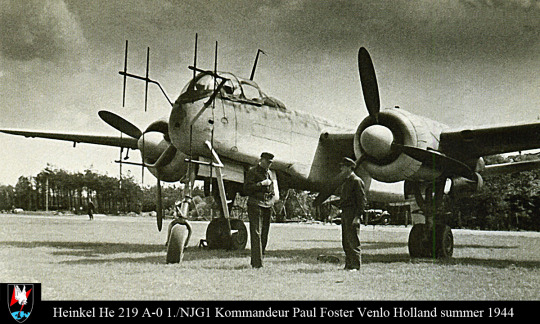
Because of the resistance from Erhard Milch, production proceeded slowly. Though Kammhuber had ordered 300 machines and ultimately hoped for a fleet of 2,000, only three pre-production machines would reach service by April 1943, flying with I./NGJ 1 out of Venlo in the Netherlands. The type’s combat debut came on the night of June 11, when the V9 machine downed five bombers in a little over an hour. In the next ten days, the He 219 continued to excel, reportedly claiming some 20 RAF bombers. Despite an excellent debut, however, the resistance from the RLM and damage done by Allied bombing meant that the first production aircraft wouldn’t reach operational units until October 1943. Though initially intended as a pre-production variant, the He 219A-0 would continue production until mid-1944, with a total of 104 examples built.
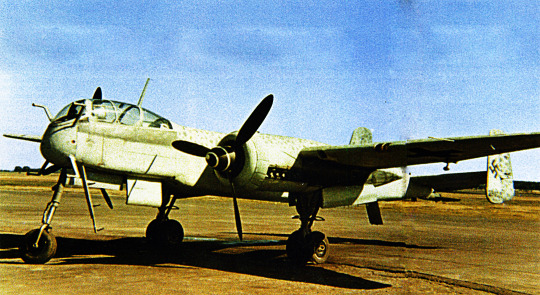
The He 219A-2 would be a more refined production model, incorporating longer engine nacelles filled with fuel tanks, improved engines, and provisions for two 30mm Mk 108 cannon in a Schrage Musik mounting. The A-2 also carried the more advanced SN-2/FuG 220 radar, allowing it to evade jamming. Though the heavy night fighting equipment and high-drag radar antennas meant that the He 219 was still too slow to catch the Mosquito, it was far from an unimpressive aircraft. It was a major improvement over the Bf 110s and Do 217s it served alongside, while also still holding advantages over the Ju 88. Thanks to its heavy firepower and expansive fuel tanks, the He 219 was able to engage multiple bombers in a single sortie, making it far more effective than the older aircraft in the inventory.
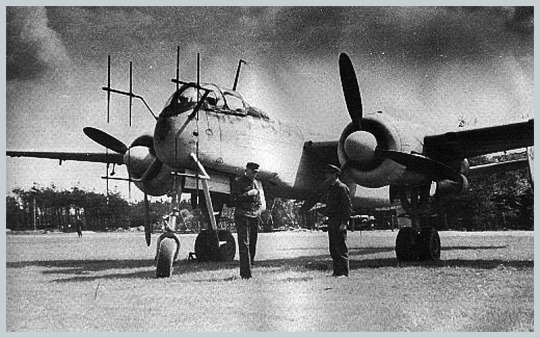
For all the He 219’s impressive performance, however, it still struggled to catch the elusive Mosquitoes. In hopes of giving the fighter the performance necessary to intercept the Mosquito, the stripped-down A-6 variant was developed. The A-6 was a simple conversion that could be done at the unit level, removing some armament and radio systems to bring the top speed up to 400mph. Though none were produced, several were converted in the field. With the failure of the RLM’s favored night fighters - the Ju 388 and Ta 154 - Erhard Milch would finally relent in 1944 and allow mass production to proceed unimpeded. By then, however, it was too late. Though the He 219 finally offered the Luftwaffe a night fighter capable of intercepting Mosquitoes and competing on even terms with the increasingly common Mosquito night fighters, political infighting had held it back until it was too late. The war ended with fewer than 300 He 219s completed.
Focke Wulf Ta 154

In August 1942, reacting to the appearance of the Mosquito in the skies over Germany, Erhard Milch demanded the development of a similar aircraft for the Luftwaffe powered by the Jumo 211F engine and constructed of the Homogenholz plywood. Focke Wulf would be the first to respond, proposing a high-winged twin-engined fast bomber constructed of a mix of conventional metals and the specified plywood laminate. Initially developed as an unarmed bomber, Milch would request the addition of defensive armament, so two 20mm cannon were to be installed in a tail barbette. Focke Wulf also developed a night fighter version of the aircraft, differing in that it was stripped of its bomb bay and given two forward firing 30mm Mk 103 and 20mm MG 151 cannons, as well as 100kg of armor. When the RLM belatedly issued specifications for a new night fighter to catch the Mosquito, they were practically written around Focke Wulf’s new design. The night fighter variant received an order for prototypes, taking shape as the Ta 154.

The V1 prototype Ta 154 would fly on July 1, 1943. It was sent off for comparative trials against the He 219 and Ju 388, where the unarmed prototype easily outflew the competitors, which were weighed down by armament and radars. The Ta 154 V3 was the first example to be armed and fitted with a radar, and when testing began, the effect was painfully clear. While the V1 was capable of a blistering 700km/hr top speed, the V3’s top speed dropped by 75km/hr, making it only marginally faster than the He 219. Nevertheless, having gained favor from Milch, the Ta 154 was ordered into production, with plans for the production aircraft to mount the more powerful Jumo 213. Thus, while the fifteen pre-production Ta 154A-0s used the Jumo 211s of the prototypes, the uprated engines of production machines would give it an edge over the He 219.
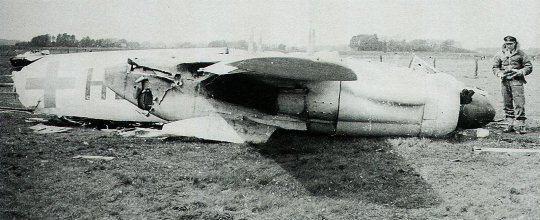
Unfortunately, delays in the Jumo 213 development meant that the engines weren’t ready until June 1944. Just before engines could be delivered, however, the factory making the glue that held together the Ta 154’s wooden structure was bombed out, forcing Focke Wulf to switch to an alternative adhesive that was weaker. Though deliveries finally began in mid 1944, a series of wing failures led to the loss of several Ta 154s - a result of the apparently corrosive nature of the substitute glue. With the Ta 154s literally falling apart and continuing engine shortages plaguing production, Focke Wulf’s Kurt Tank halted production in August, and the RLM cancelled the order for 154 A-1s in September. By then, 50 machines had been completed, and surviving A-0s were brought to the A-1 standard. The extent of their service is unclear - it appears that several Ta 154s did see service with NJG 3, while a few others were used as conversion trainers for jet pilots. However, it’s unclear how many missions they flew, if they downed any enemy aircraft, or even what pilots thought of the fighter.
Junkers Ju 388J
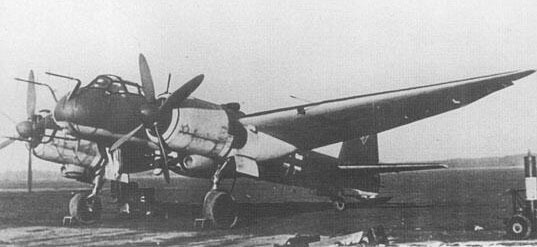
Though the He 219 and Ta 154 were promising designs, they achieved their performance through the use of low aspect-ratio wings, meaning that performance at altitude suffered. The need for a high-altitude fighter actually predated either of the two designs, with development of high-altitude interceptors beginning shortly after Germany learned of the B-29 in late 1942. For high-altitude night fighter duties, Junkers was selected to develop a variant of their Ju 188 high-speed bomber. Becoming the Ju 388, Junkers was to develop not just a night fighter, but also bomber and reconnaissance variants. The general design had the cockpit pressurized and all defensive armament replaced with a twin-13mm machinegun tail barbette that was to be controlled remotely. The Ju 388J would have an all-new solid nose, providing space for two 30mm Mk 103 and 20mm MG 151/20 cannons. For night operations, the Mk 103s were to be switched with shorter-barreled Mk 108s, while two more Mk 108s would be added in a Schrage Musik mount. Space for a radar in the nose was also made.
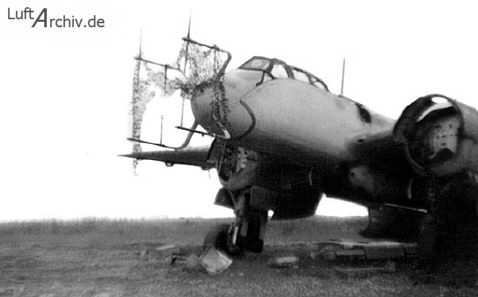
The first Ju 388 prototype would be a reconnaissance-oriented L model, flying in December 1943. Two Ju 388J prototypes would be made, but by the time production was ready, it was clear that the B-29 was being sent to the Pacific, so production concentrated on the L models. Not only had the need for a high-altitude fighter evaporated, but the RLM had long since relented and approved full production of the He 219 by the time the Ju 388J was ready for production. Due to the disruption caused by Allied bombing, deliveries wouldn’t begin until August 1944. Roughly 47 Ju 388Ls and 15 Ju 388K bombers were completed, but only a single Ju 388J beyond the original two prototypes were finished.
Window
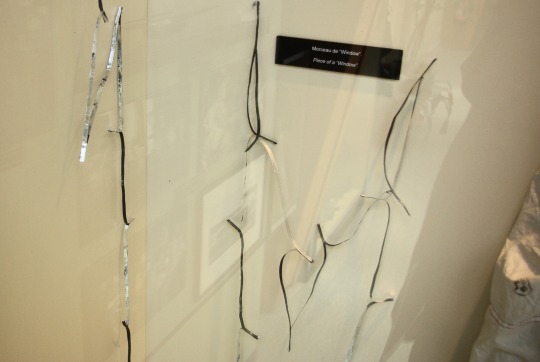
The next groundbreaking countermeasure the RAF would deploy against the Kammhuber Line could trace its origins back to 1937, when British researchers began suggesting deploying wires or foils strips in the skies to create false radar returns. While this seemed promising, development of the concept didn’t pick up until early 1942, when the idea was refined to call for packets of reflective strips to be dropped from aircraft. Working off of data from a Wurzburg radar set that had been captured in a commando raid earlier that year, researchers at the Telecommunications Research Establishment tailored the system to the Wurzburg’s sets. The reflective strips consisted of black paper backed with aluminum foil cut into 27 by 2 cm sections - making their length exactly half that of the Wurzburg’s wavelength for optimum reflectiveness. Though testing showed the concept to be incredibly capable - the Wurzburg would be unable to distinguish between the aluminum strips and actual bombers - it was decided to hold off on the system until bomber losses rose once more. Codenamed Window, the novel new chaff countermeasure would have to wait almost a year before making its debut.
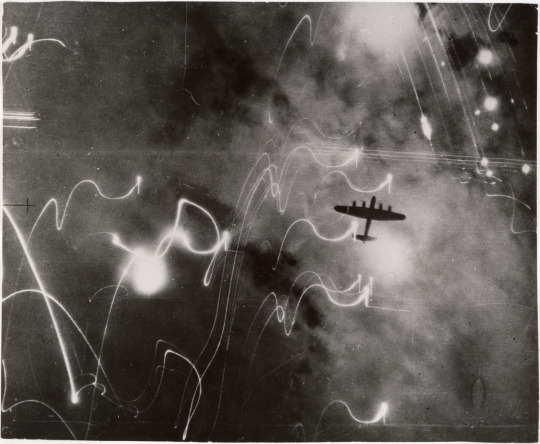
On the night of July 24, 1943, the RAF finally decided to break out Window along with several new jamming platforms to support a new bombing operation against Hamburg. Appropriately named Operation Gomorrah, the operation would last eight days and seven nights, marking the heaviest aerial assault yet launched. 24 aircraft were earmarked to deploy Window, deploying their payloads in a wide swath across the Kammhuber Line. The results were impressive - completely blinded, searchlights scanned desperately and flak fired blindly into the skies. With radar displays overwhelmed, the night fighters were unable to find the bomber stream, allowing the RAF bombers to hit their target over roughly an hour and egress with only 12 of the 791 attacking bombers lost.
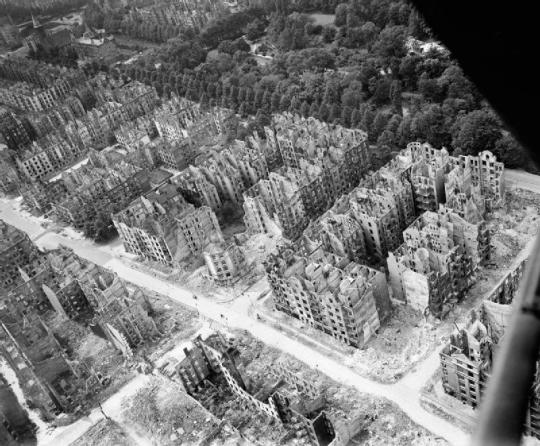
Though this first raid already left Hamburg devastated by ongoing fires, it was far from the end. The USAAF hit the city with 90 B-17s that day while Mosquitoes dropped delayed-fuse bombs to hinder firefighting efforts through the day. The fires continued to rage into the next night, putting out a smoke cloud so dense that the planned 700-bomber raid for the night was diverted to Essen. Thunderstorms prevented any significant attacks to be flown on the 26th, but the RAF would sortie 787 bombers on the night of the 27th. Capitalizing on the damage already done to the city that hindered firefighting efforts, the RAF hit Hamburg with incendiaries. The resulting firestorm engulfed over 21 square kilometers of the city. Two more major night raids were launched on July 29 (777 bombers) and August 3 (740 bombers). By the end of the operation, the Allied forces had flown 17,000 bomber sorties and dropping 9,000 tons of bombs for minimal losses - the heaviest losses occurred on the final raid, with only 30 bombers lost. For the Germans, it would be the most devastating bombing raid of the war. 183 of 524 large factories in Hamburg were destroyed, along with 4,118 of 9,068 small factories, complete disruption of local transport, and destruction of over half the dwellings in the city. 42,600 people were killed and 37,000 wounded, and of the survivors, over a million would flee the city for the duration of the war.
Zahme Sau

The immediate reaction of the German night fighter corps following the Hamburg raids was the implementation of the Zahme Sau practice. Zahme Sau dropped the previous means of directing night fighters wherein ground radars rigidly controlled night fighters within their boxes. Instead, upon the detection of an incoming raid, night fighters were scrambled and sent to orbit several radio beacons until the bomber stream was identified. Once the stream was found, all available night fighters were vectored in by Wurzburg radars. The fighters would feed into the stream, operating independently from ground control until fuel or ammunition ran out. Unlike the previously developed counter to the bomber stream, ground based radars were not relied upon as much for intercepts. Instead, they merely directed the fighters in the direction of the stream, with onboard radars doing the bulk of the legwork.
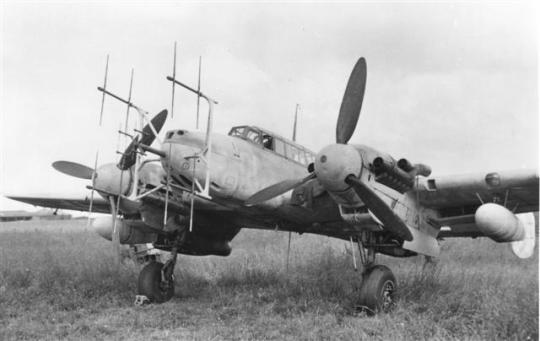
Zahme Sau made its debut on the night of 23/24 August 1943 against a raid on Berlin. Flying against a stream of 727 bombers, the night fighters managed to claim 56 RAF aircraft - a loss rate of 8%. Further improving the chances of interception was the introduction of the Naxos radar detector, which began to reach operational units in September 1943. Though the Naxos was incapable of directing night fighters to individual aircraft, it could detect emissions from the H2S radars on British bombers as far as 35 km out. As the device became more prevalent, the Zahme Sau practice became more effective. Window continued to be a problem, but Zahme Sau would provide the Luftwaffe with a night fighter practice for which the RAF would not be able to develop an effective counter.
Wilde Sau
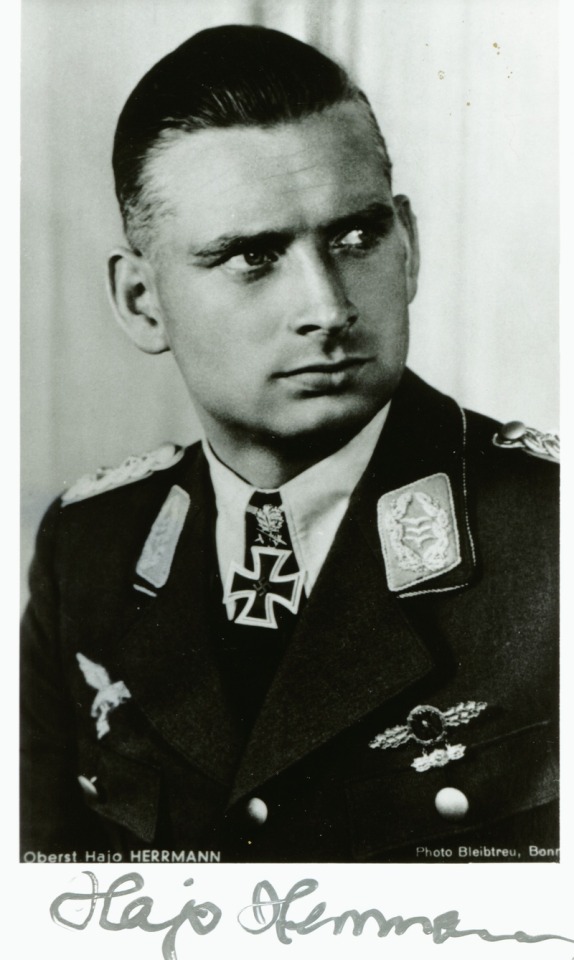
The far more radical reaction to the devastating Hamburg raids was the Wilde Sau practice. Wilde Sau actually predated the Hamburg raid, being proposed by bomber pilot Major Hajo Hermann in early 1943. Wilde Sau completely dropped the use of airborne radars, instead opting to fly unmodified single-engined fighters. Ground controllers would direct the Wilde Sau aircraft to the bomber stream via radio, at which point the fighter would identify and engage targets visually. To provide adequate lighting for the fighters, the target city would produce as much light as possible to illuminate the sky - going completely against all established doctrine. By flying above the bomber stream, the fighters would then be able to identify the bombers over the illuminated city, at which point they would dive in and engage.
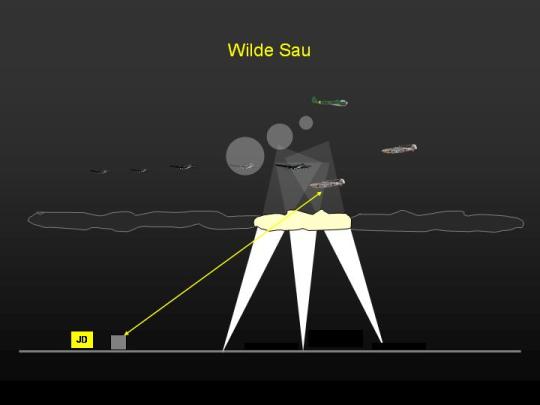
Unsurprisingly, this new concept was hardly popular amongst officials. Such an unorthodox practice was incredibly dangerous, not just because pilots were being drawn from daylight fighter units, but because operations were to be flown exclusively over the flak-filled skies above Germany’s cities. City officials resisted the call to illuminate themselves, so large numbers of searchlights would have to substitute. Nevertheless, Major Hermann’s Wilde Sau concept gained traction. In late June 1943, a test unit was established, drawing pilots and aircraft from JG 1 and JG 11. Known as JG Hermann, they would make their debut over Cologne in early July, flying against 653 RAF bombers. Working with the illumination provided by searchlights, target-marker flares, and fires in the city, the Wilde Sau fighters claimed 12 bombers - shared with ground-based flak. To prevent friendly fire, flak was limited to a certain ceiling, above which the Wilde Sau would operate.
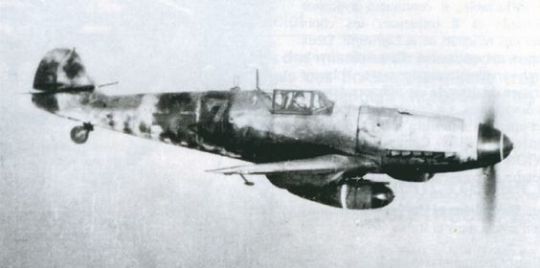
The relative success over Cologne seemed to have validated Hermann’s proposal, leading to the expansion of JG Hermann into a full-fledged Jagdgeschwader - JG 300. Initially, they performed well. They accounted for several bombers downed during Operation Gomorrah, and through August and early September they were regularly claiming more than 10 aircraft per raid. On the night of August 23, 1943, over Berlin, Hajo Hermann himself led the Wilde Sau on their most successful operation ever, claiming 57 RAF aircraft. In September, JG 300 were followed by JG 301, and in November, JG 302 was formed. The Wilde Sau force came under the command of 30. Jagddivision, which commanded the three Wilde Sau Jagdgeschwader, as well as III./KG 3, which was tasked with dropping illumination flares over bomber streams to support the fighters.
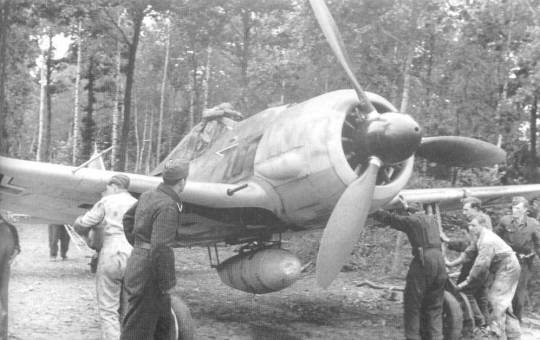
Unfortunately, Wilde Sau was far from sustainable. As the daylight campaign picked up, the pilots of 30. Jagddivision found themselves flying day and night, leading little time for rest and maintenance and leading to high attrition. Poor weather in the Fall and Winter of 1943 led to reduced effectiveness and high accident rates, and, as American fighters began to attain air superiority, losses mounted. With the Zahme Sau proving more effective, the Wilde Sau Geschwader were increasingly relegated to daylight missions. Night operations became scarce, and their strength was drained away by American fighter escorts. JG 302 was folded into JG 301 at the end of 1944, and JG 300/301 would fly almost exclusively daylight missions in the last year of the war.
Dornier Do 335
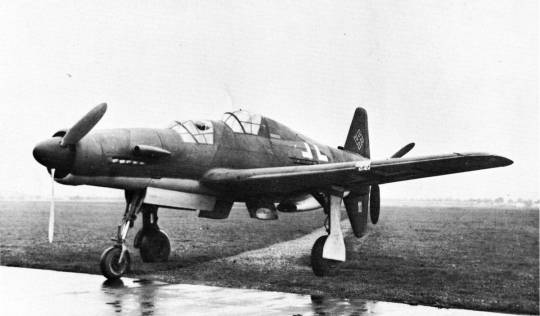
The promising Do 335 tandem-engine heavy fighter would be selected for development as a night fighter sometime in the winter of 1943/44. In mid-January 1944, the RLM ordered five prototypes to be built as night fighters. Unfortunately, Allied bombing seriously hampered production, meaning that these were never completed. Nevertheless, Dornier did make plans for full production night fighters. The Do 335A-5 was slated to be a single-seat machine, while the Do 335A-6 would be derived from the two-seater trainers. Though there was no space in the nose for radar equipment, Dornier apparently planned to mount radar antennas on the aircraft by splitting them across the wings. Thus, the fighter would still be able to use the ubiquitous Liechtenstein and Neptun radars. However, none of these materialized - the limited Do 335 production that took place before the end of the war concentrated on the A-1 series fighter bombers.
Arado Ar TEW 16/43-19

In August 1943, Arado began work on a new multirole jet aircraft. Designed around an all-metal mid-winged monoplane layout, the new aircraft would be powered by two jet engines and feature a crew of two in the nose. Three variants were proposed - a bomber, heavy fighter, and night fighter. The night fighter variant would mount two 30mm Mk 108 cannon under the nose, as well as three 20mm Mk 213 cannon in a ventral pack and two more Mk 213 on the sides of the nose. Provisions were also made for two Schrage Musik Mk 108s behind the cockpit, and the defensive tail barbette seen on the other variants was retained. For night fighter operations, a Berlin radar would be carried in a radome in the nose, and a radar operator would be placed in a compartment aft of the wing to operate the equipment. Unfortunately, the design never materialized, as the success of the Ar 234 and Me 262 made the design surplus to requirements.
Messerschmitt Me 262B

In the Summer of 1944, Messerschmitt had produced the two-seat Me 262B-1a trainer. Though only about 15 were built, the two-seat Me 262 showed promise, offering far better performance than contemporary night fighters while still being able to mount an air intercept radar. To experiment with the concept, an Me 262B-1a was converted to the B-1a/U-1 standard, with a FuG 218 Neptun radar installed in the nose and a Naxos radar homing system. Because of the space taken up by the radar equipment, armament was reduced, but still heavy - two 30mm Mk 108 and two 20mm MG 151. Trials of the new night fighter began in October 1944, flown by Hajo Hermann. Though performance was cut by the protruding radar antennas, the Me 262B-1a/U-1 remained a capable machine, putting its performance far beyond that of the Mosquito night fighters that were devastating the night fighter corps.
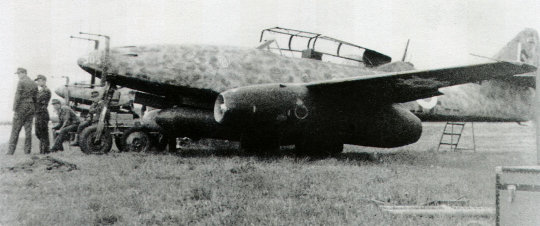
As the two-seater night fighter continued trials, the single-seat Me 262 fighter made its debut as a night fighter. Led by Hauptmann Kurt Welter of NJG 11, a handful of Me 262As began Wilde Sau operations in December 1944. Wilde Sau operations concentrated on hunting down the elusive Mosquito pathfinders, with Welter himself credited with three such aircraft by February. Once the Me 262Bs finished testing, they too were passed onto NJG 11. Seven of these entered service in April 1945. Unfortunately, details of their service are scarce, and, reaching service in the last month of the war, they likely saw little use. As these seven two-seaters were on their way into service, Messerschmitt was also working on a more refined Me 262B-2a. Intended to be the definitive production variant, the Me 262B-2a would have a longer fuselage to increase fuel capacity and a new nose capable of carrying either the Neptun radar or the new Berlin centimetric radar. Additionally, the fighter would have provisions for Schrage Musik guns behind the cockpit. Unfortunately, the war ended before any of these could be completed.
Arado Ar 234B-2N
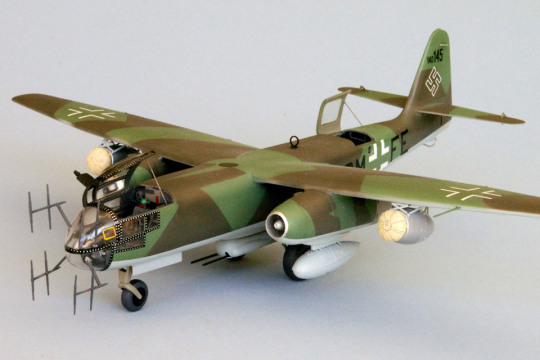
In September 1944, engineers at Arado proposed a night fighter variant of their jet bomber. Designated Ar 234B-2/N, the bomber would be fitted with the FuG 218 Neptun radar in the nose and a pair of 20mm MG 151 in a ventral gun pod. To accommodate the radar operator, a cramped compartment behind the wing was installed. Though hardly an ideal arrangement, it gained enough traction for two prototypes to be ordered. These two prototypes were sent to Kommando Bonow, where they would perform operational trials. Tests began in March 1945, but it was very quickly determined that the aircraft were unsuitable for night fighter operations. Operational trials ended quickly, and no victories were claimed by the aircraft.
Berlin

In early 1943, a Short Stirling Pathfinder, complete with its advanced H2S radar, was downed near Rotterdam. The radar system was pulled from the wreckage mostly intact, allowing technicians to analyze the system. The most important piece pulled from the H2S radar would be its cavity magnetron, which allowed the system to produce centimeter-wavelength signals in a fairly compact package. Developing detection equipment for the H2S was a fairly simple endeavor - the FuG 350 Naxos radar detector would be operational by September. However, creating an air intercept radar out of this captured system was a far more complicated project. Though Telefunken would largely copy the British design, it took nearly two years to complete what became the FuG 240 Berlin radar. The Berlin was a compact system with a .7 meter dish antenna. With a 10cm wavelength, it had a range of up to 9 km. Most importantly, however, it was compact enough to be contained under a radome, allowing for drag to be greatly reduced on night fighters. Unfortunately, development dragged out for far too long. Production didn’t begin until the Spring of 1945, and the first units weren’t installed on combat aircraft until April 1945.
The 1944 Night Fighter
In January 1944, the Technical Air Armaments Board of the RLM issued requirements for a new night fighter. Calling for a top speed of 900 km..hr and endurance of four hours, the new fighter was to have an armament of four cannon and the ability to carry a FuG 240 or FuG 244 radar. Dornier, Arado, Blohm & Voss and Focke Wulf all produced designs. All of the proposals were wildly unconventional, ranging from mixed-propulsion aircraft to full jet-powered designs. Development would go on for over a year without any prototypes materializing before the RLM dropped the requirement, replacing it with a new specification that called for far higher performance than any of these proposals could hope for.
Messerschmitt P.1099B
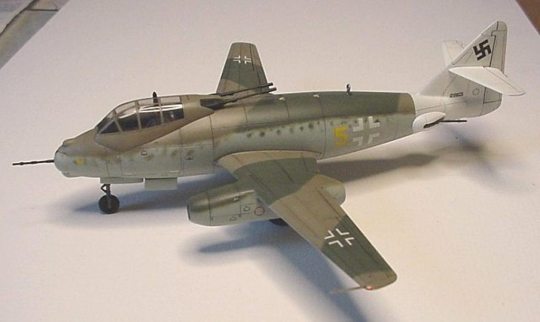
Messerschmitt would begin work on a two-seater multirole development of the Me 262 around the same time as the new night fighter requirements were issued. While a wide variety of armaments were proposed, Messerschmitt’s night fighter development of the design was surprisingly simple. With a solid nose capable of holding a radar, the night fighter P.1099B proposal completely eliminated the elaborate remote-controlled defensive armament of the other designs, instead replacing it with a simple arrangement of two forward firing and two Schrage Musik 30mm Mk 108s.
Dornier P.252

Dornier’s night fighter proposal actually predated the requirements, with Dornier repurposing the design as a night fighter once the RLM issued the specifications in early 1944. The P.252 morphed into three proposals all based off the same general design. A long, slender fuselage would carry a crew of three and two Jumo 213J engines in tandem geared aft to drive contra-rotating propellers. A cruciform tail would protect the propellers from ground strikes. The three proposals differed mainly in their wings. P.252/1 had fairly straight wings, while P.252/2 made use of high aspect-ratio swept wings. P.252/3 also used swept wings, but with a reduced sweep and broader chord. Armament was to be heavy - four forward firing and two upward firing 30mm cannon. Unfortunately, despite the promise of the design, it gained little traction among an RLM now firmly set on procuring a jet aircraft. Thus, Dornier was forced to abandon the proposal.
Blohm & Voss P.215
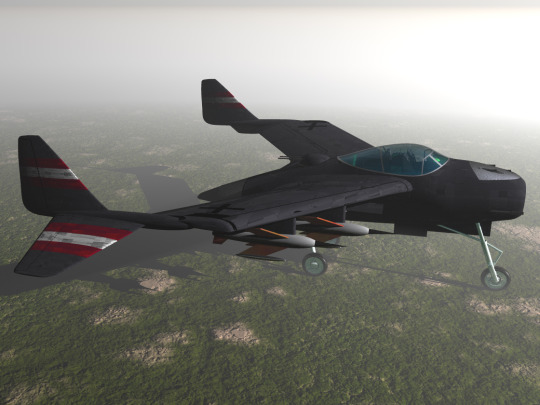
Blohm & Voss would derive their night fighter proposal from the P.122 single-seat fighter. The fuselage of the P.215 was a compact nacelle, containing the crew of three, two He S 011 engines, and a nose-mounted radar. The P.215 lacked a tail, instead relying on the outer sections of its swept wings to provide pitch control. The crew sat in a pressurized cockpit, with pilot and radio operator sitting side by side and radioman facing backwards, controlling a remote-controlled dorsal barbette. A variety of armaments were envisioned, ranging from up to six forward firing 30mm cannon to two 55mm cannon or even several Schrage Musik guns. The P.215 was also designed with ease of transport in mind, with the aircraft able to be transported without any special equipment once the wings were removed. Development work continued until late February 1945, when the specifications were updated. The P.215 fell short of the new requirements, but it still offered far better performance than the other designs it was developed alongside. Likely because of this, it was chosen for further development in March 1945. By then, it was too late. The P.215 would never leave the drawing board, coming to an end when Germany surrendered.
Arado Projekt I

Arado’s first submission to the new requirements would be a sleek tailless design. Powered by two BMW 003A turbojets mounted under the fuselage, the night fighter would have its crew of two sitting side by side in a pressurized cockpit. Four 30mm Mk 108 cannon were mounted in the nose along with a Berlin radar. Provisions were also made for Schrage Musik guns, as well as a small payload of bombs. Unfortunately, when looked over by Luftwaffe officials, several major shortcomings were found. Poor intake design would hurt engine performance, and the small vertical fins on the trailing edges of the wings were deemed to be inadequate. When the Luftwaffe revamped night fighter requirements in early 1945, this proposal was dropped.
Focke-Wulf 1310251-13/II
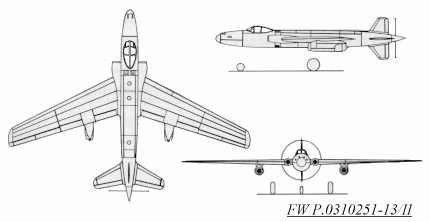
Focke Wulf would propose a mixed-construction design for the new night fighter requirements. Vaguely resembling Dornier’s P.252 with its swept wings and pusher propeller, Focke Wulf’s design was to be powered by a single piston engine in the center of the aircraft and a BMW 003A turbojet slung under either wing for high-speed dashes. A crew of three would sit in a pressurized cockpit near the nose, while an armament of up to four 30mm cannon could be carried around the nose. Alternatively, two of the nose guns could be switched out to allow for two to be mounted in a Schrage Musik configuration. The designation of the design is unclear. Focke Wulf did produce three slightly different variants of the design (differing in their choice of piston engine), but it appears that all that has survived of the aircraft is a few design drawings. Thus, the design is known only by the drawing number of one of the surviving documents.
Collapse of the Kammhuber Line
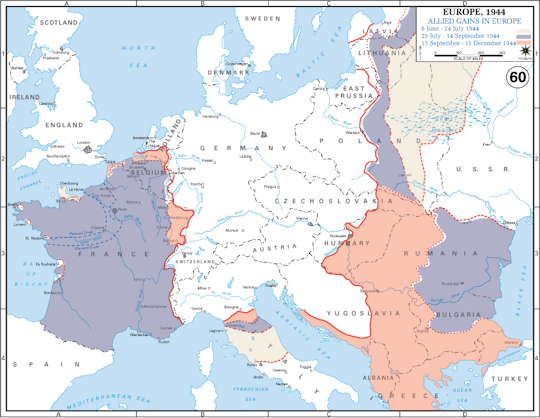
While the Luftwaffe was doing a reasonably good job at keeping pace with British countermeasures and inflicting heavy losses on RAF bombers, the changing strategic situation would be their undoing. Attrition of men and crews was unusually high through the winter of 1943/44 due to poor weather, and as Allied bombing took its toll on aircraft production, replacements became scarce. In just the first 3 months of 1944, 15% of the night fighter crews were lost. The night fighter corps was always lowest on the Luftwaffe’s priorities, so when shortages set in, the night fighters suffered the most. Things only worsened with the introduction of the Mosquito night fighter escorts in mid 1944, which presented the Luftwaffe with something for which they had no real counter. Soon afterwards, oil shortages began to hit the night fighter corps hard, leaving them without enough fuel to train their crews. From then on, effectiveness only continued to decline, with fuel shortages ultimately getting so bad that even the regular patrol methods had to be abandoned.
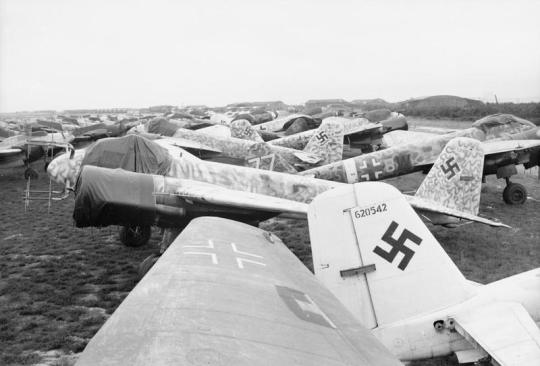
As the Luftwaffe’s night fighter corps declined in quality, another major blow was dealt to them. The liberation of France and the Low Countries saw Allied forces encroach on the leading elements of the Kammhuber Line. With every mile the Allies advanced eastwards, the Kammhuber Line deteriorated. Just as bad, the advancing Allies brought night fighter airfields ever closer to the front. The night fighters would gradually find themselves subject to night intruder raids, forcing ground crews to seriously restrict lighting at airfields. Even with the declining situation, overall numbers increased - from July to October 1944, the night fighter corps went from 800 to 1,020 aircraft. With their early warning network gone, however, this made little difference. By the new year, significant numbers of aircraft were tasked with North Sea reconnaissance to pick up incoming bombers. Night fighter operations in the new year were sporadic. With no more Kammhuber Line to direct them and quality seriously hampered by shortages and inadequate training, the last months of the war was the Luftwaffe’s night fighters reduced to little more than a harassment force. Though they posed no threat on a strategic level, they continued fighting where resources held out right up until the war’s end.
Late War Night Fighters
As the war situation worsened, the RLM revamped their night fighter requirements. Though exact specifications are unclear, the general trend was to increase all requirements. New requirements called for a much faster night fighter, well beyond the capabilities of those then in development. Rather than follow the trend of most late-war fighter programs, this final round of night fighter development would not simplify demands to account for Germany’s rapidly declining industrial capacity. Rather, they continued with demands for advanced, complex designs, taking full advantage of all technology available at the time.
Arado Projekt II
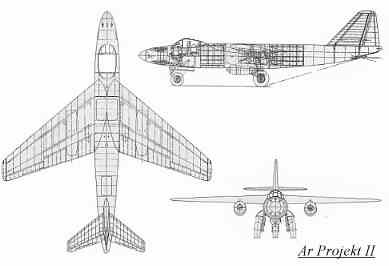
Arado’s final night fighter project of the war would be a fairly conservative proposal. Known as Projekt II, the fighter was a simple twin-engined high-winged design. The crew of two would sit in a pressurized cabin with ejection seats, and a BMW 003A or He S 011 turbojet slung under either wing would power the aircraft. The wings were swept back 35 degrees with the intention of improving performance at high speeds, and armament was to be four 30mm Mk 108 in the nose placed round a Berlin radar. Unfortunately, this design would not progress past the drawing board before the end of the war.
Dornier P.256
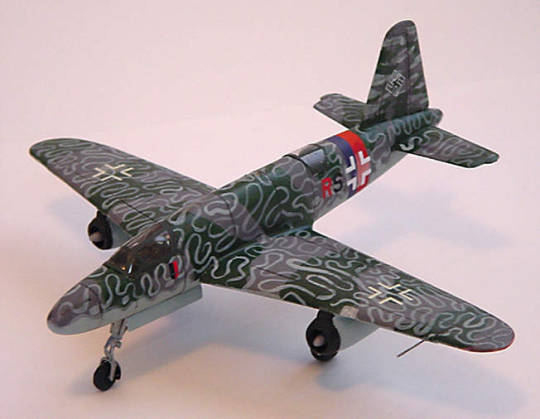
Dornier’s contender to the new night fighter requirements was perhaps the most realistic. Broadly derived from the Do 335, the P.256 was to be powered by an He S 011 turbojet under either wing. Because the piston engines were removed, the fuselage was heavily reworked - the cruciform tail gave way to a more conventional one, and the space made in the nose allowed Dornier to fit a radar and several 30mm cannon in it. The crew compartments were also heavily reworked, with the pilot and radioman sitting side by side in a pressurized cockpit in the forward fuselage, while the navigator had his own station facing aft in the rear fuselage. Unfortunately, while the P.256 offered the easiest way to get a night fighter into production (given that it was heavily derived from something already in production), its unswept wings meant it would fall well short of performance requirements. Thus, it was rejected.
Focke Wulf P.011-47

Focke Wulf would produce a unique three-engined design of mixed construction for the new night fighter requirements. The P.011-47 was fairly conventional in layout, being a mid-winged monoplane with 30 degree swept wings. A single He S 011 turbojet was mounted in the nose, exhausting under the fuselage, while another was carried under either wing. The crew of three sat in a pressurized cockpit in the nose, and a radar would be carried above the nose intake. Two 30mm cannon were to be mounted in the nose, while two more would be carried in a Schrage Musik mount behind the cockpit. The aircraft also had a unique flight profile planned - at least one engine could be shut down inflight for more efficient cruise while still allowing the fighter to perform high-speed dashes. Like the competing designs, it would not materialize before the end of the war, though the design did fall into Soviet hands, where it had significant influence on Soviet postwar all-weather interceptor designs.
Heinkel P.1079

Heinkel’s final night fighter designs would be a series of design studies known as P.1079. All three P.1079 studies would be two-man machines with a 35 degree swept wing powered by an He S 011 turbojet in either wing root. P.1079A was the most conventional, using a long fuselage, wings with no dihedral, and a V-tail. P.1079B shortened the fuselage and replaced the tail with a single vertical surface, while the wings were given a gull-wing layout, and the P.1079C refined this further into a sleek pure flying wing. While Heinkel seems to have developed these studies fairly far, they don’t seem to have been submitted to the RLM, and they never left the drawing board before the war’s end.
9 notes
·
View notes
Text
/k/ Planes Episode 102: German Bombers
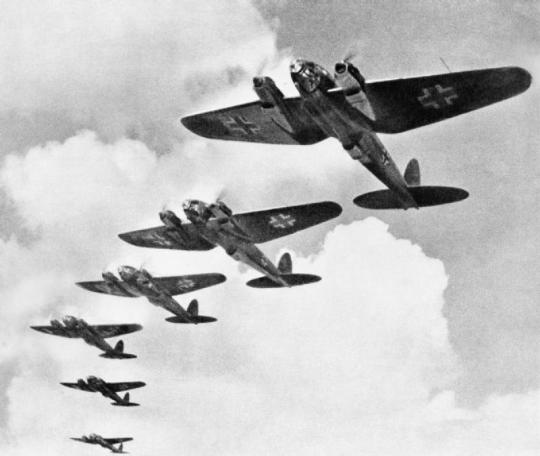
It’s time for another episode of /k/ Planes! This time, we’ll be looking at the bombers of the Imperial German Air Force and the Luftwaffe.
Germany would get its start with bombers in WW1, being among the first nations to develop multi-engined bombers. Over the course of the war, Germany would come to operate a large force of multi-engined bombers, committing them to the first strategic bombing campaign the world had ever seen. Unfortunately, the Treaty of Versailles prevented Germany from possessing an air force, so it wouldn’t be until a decade after the war that Germany would begin bomber development again. Unlike the decidedly strategic focus WW1 bomber development took on, however, the fledgling Luftwaffe would be almost entirely tactically focused. A series of high-speed medium bombers would come to dominate the Luftwaffe bomber corps through the ‘30s, and early attempts to develop strategic bombers were cancelled to free up resources for tactical bombers. When war broke out, the failings of this doctrine soon became apparent. The “fast bomber” doctrine the Luftwaffe bombers were designed around proved obsolete, and a lack of heavy bombers made strategic air campaigns difficult. Attempts to modernize the inventory would fall through as the new class of high-powered engines failed, and by the end of the war, most bomber programs had been cancelled to free up resources for fighters. Several notable advanced jet bomber projects were started towards the end of the war, but only two ever left the drawing board and none would have a significant impact on the war.
The Grossflugzeuge
As war loomed in June 1914, the Idflieg - the bureau responsible for the management of military aircraft procurement and production - began the process of gearing up the Luftstreitkrafte for the conflict. As part of the buildup, a requirement for a high-endurance aircraft known as a Kampfflugzeug was issued. The Kampfflugzeug was to have 200hp of engine power, a crew of three, and an endurance of six hours. As early aircraft motors were fairly low power, such requirements effectively dictated that the resulting aircraft would be large twin-engined machines. Soon after the first Kampfflugzeuge took shape, the Idflieg revised its designation system, with the new aircraft taking on the role of bombers with the official designation Grossflugzeuge. The Grossflugzeuge requirements would evolve over the war, ensuring a constant stream of new designs up until the war’s end.
Gotha G.I
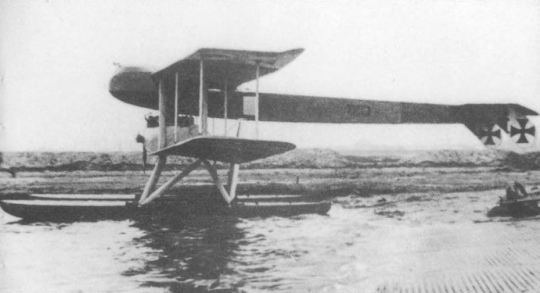
In mid 1914, Oskar Ursinus, the editor of the magazine Flugsport, designed a unique new seaplane design. Powered by two engines, the seaplane had the fuselage mounted on the upper wing while the engines sat on the wing below it. When Ursinus was conscripted upon the outbreak of war, he presented his design to his commanding officer. It was adapted to serve as a land-based bomber, with a single machinegun and 200kg of armor provided for defense, and construction for a prototype was ordered by the commander of Ursinus’s unit. Taking flight in late January 1915, the design met a newly released Luftstreitkrafte requirement for a twin-engined bomber. Despite concerns over structural strength, handling issues, and the low power of the engine, the design was sent to the Eastern Front for service trials, where it performed well as a reconnaissance platform.
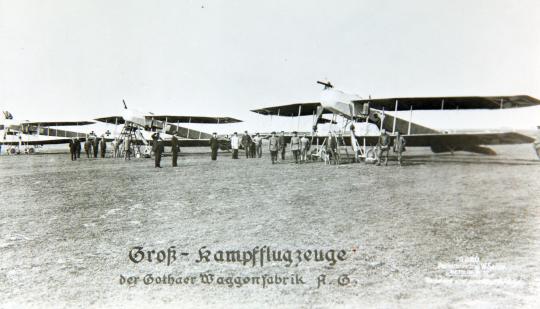
In April 1915, after trials showed the design to be promising, Gotha was contracted to start producing the bomber under license as the G.I. Gotha made a variety of improvements to the design, including the use of more powerful engines, ultimately producing three batches of six aircraft. Unfortunately, the G.I’s career was hardly remarkable. The G.I was tasked with reconnaissance and patrol duties for most of its service, with bombing missions being very rare. By the time it reached the front, the G.I was already outpaced by enemy fighters, and crews tended to dislike the aircraft. Attrition was high, with active numbers peaking at just 6 aircraft in December 1915. The only notably mission flown by the G.I was performed by the sole UWD - a floatplane conversion prototype built for the Navy - which participated in a raid on Dover in 1916.
Rumpler Grossflugzeuge
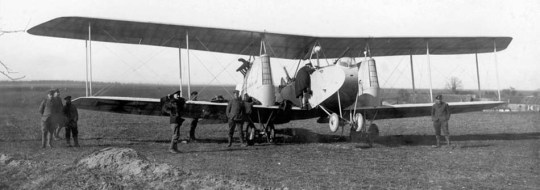
When the Idflieg put out specifications for the Grossflugzeuge, Rumpler responded with a modest twin-engined design. Fitted with two 150hp engines in pusher mounts, Rumpler’s new aircraft carried four-wheel landing gear to avoid nosing over on landing and a single defensive machinegun in the nose. Taking flight in early 1915, it succeeded in winning a production contract, entering service as the G.I. While the G.I went on to enter service by the middle of the year, Rumpler continued to improve upon the design. The next iteration, the G.II, was fitted with more powerful 220hp Benz Bz IV engines. Learning from the lessons of the first two years of war, the G.II also expanded the armament, adding a second machinegun in a dorsal position for defense. Outside of these changes, however, the G.II was identical to the G.I, retaining the same undercarriage and external bomb racks.

The G.II would go on to enter service in 1916, with a total of 72 examples built. Rumpler continued to improve upon the design, however, culminating in the G.III. The G.III was designed around the 260hp Mercedes D.IVa engines, with major aerodynamic refinements made to the design including a revised tail and backwards stagger on the wings. Thanks to this latest development, Rumpler’s Grossflugzeuge would serve from about mid 1915 until the summer of 1918. The first G.Is would come to serve in Germany’s first bomber squadrons, while the G.II was mostly sent to Macedonia, where it served alongside other limited-production Grossflugzeuge. By the Fall of 1917, however, Rumpler G.IIIs were flying over the Western Front on night raids, serving in this capacity until being withdrawn in August 1918.
AEG Grossflugzeuge
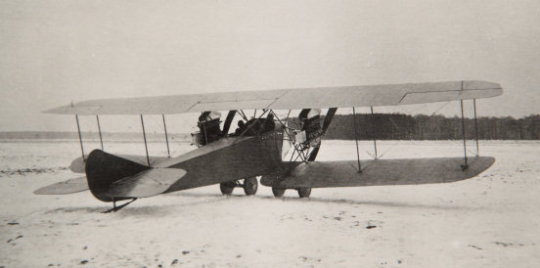
AEG got its start with bombers in early 1915 when they produced the K.I. The K.I was a two-bay, three-man biplane bomber powered by two 100hp Mercedes engines. Defended by two machineguns placed in dorsal and nose positions, the K.I was capable of carrying a payload of 200kg of bombs. Testing began in early 1915, with service tests taking place later that year. Having been redesignated G.I, the bomber was found to be unsatisfactory due to its low-power engines. The solution to this problem came in the form of the G.II, which was fitted with more powerful Benz engines. The G.II proved satisfactory enough to receive a production order, but it too would reveal issues in service tests starting in mid 1915. The G.II was found to have stability problems, leading to the installation of two extra vertical fins on many machines in the field.

AEG would continue to improve upon their bomber design through the end of 1915, resulting in the G.III. The G.III was a general improvement upon AEG’s Grossflugzeuge design, featuring 220hp engines, larger wings, and an enlarged tail. Taking flight in December 1915, the G.III would perform better than previous iterations of the design, but it was soon overshadowed by the ultimate development of AEG’s design - the G.IV. The G.IV was a massive improvement over previous iterations. Fitted with 260hp engines, the G.IV fitted advanced features such as onboard radios, electrical heating, and an all-metal welded-tube frame. Though the empty weight jumped by half a ton from the G.III, the G.IV was an improvement in every way, being faster, more durable, and capable of carrying a larger payload.
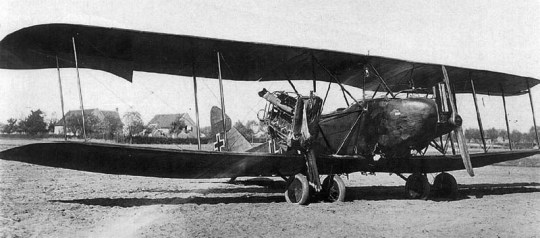
The G.IV would come into service in late 1916, becoming the only design of the series to see significant use. Thanks to its short range, it was largely relegated to tactical bombing close to the front lines, where it flew missions day and night. With over 300 built, the bombers were flown in France, Romania, Greece, and Italy. Unfortunately, it was soon eclipsed by enemy fighters, forcing the bomber to shift to exclusively night missions. With no provisions for accurate night attacks, these night raids would gradually regress into harassment raids, where the G.IV was assigned no specific targets.
Schutte-Lanz G.I
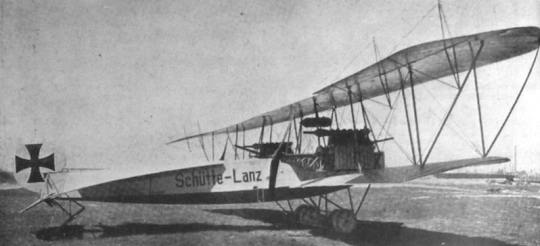
Schutte Lanz joined in on the Grossflugzeuge efforts with a design of their own in 1915. Powered by two Mercedes D.III engines, the G.I had a crew of two in tandem positions in the nose. The fuselage was of an unusual pentagonal cross section, and the whole aircraft was of wood-frame and fabric-skin construction. The engines were placed in open positions well forward on the wings, with long driveshafts extending backwards to the pusher propellers. The tailplane had a very broad chord, with its leading edge reaching most of the way down the fuselage, while the vertical tail was all-moving. A single prototype was built and tested in 1915, but no production was ordered.
The Reisenflugzeuge
Early on in the war, various manufacturers began to propose machines even larger than the Grosflugzeuge then under development. These earliest of these multi-engine machines would be contracted as Grossflugzuege, but as more took shape, they would receive their own designation - Reisenflugzeuge. The Reisenflugzeuge stood out from the Grossflugzuege not only from their sheer size, but their peculiar engine arrangement as well. All of the Riesenflugzeuge would have engines contained in the fuselage to allow them to be serviced in flight, and the resulting machines often carried very large crews (complete with an onboard engineer) and three to four engines (rather than the two carried by the Grossflugzeuge). Like the Grossflugzuege, Riesenflugzeuge development spanned the whole war, with several designs only taking flight for the first time after the Armistice took effect.
Zeppelin-Staaken Riesenflugzeuge
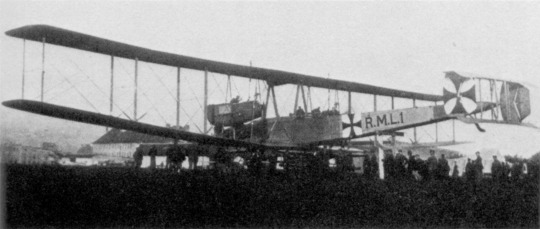
Though better known for his airships, Count von Zeppelin would also begin work on large fixed-wing bombers once war broke out. Initially lacking the facilities to handle construction, Zeppelin outsourced production to Gotha, earning the first bomber the designation V.G.O.I. The new bomber was a unique three-engined machine, with a single powerplant in the nose and two mounted on either side of the fuselage between the wings in rear-facing nacelles. Taking flight in April 1915, the V.G.O.I performed well enough to be accepted into service by the Kaiserliche Marine, who operated it on the Eastern Front. Its service there was brief, however, and it was returned to Staaken later that year to have two more engines mounted in the wing nacelles. Unfortunately, during testing, the V.G.O.I would crash.
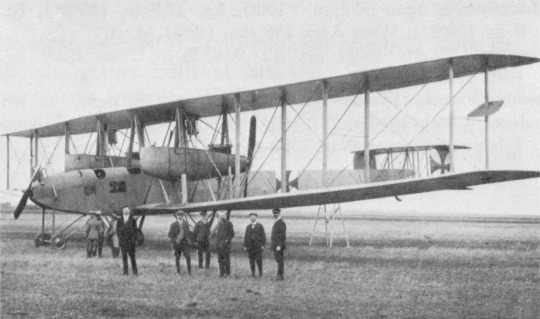
The V.G.O.I was followed by four more designs. The first, the V.G.O.II, was little more than a slightly refined V.G.O.I that served with the Luftstreitkrafte rather than the Kaiserliche Marine. It had a brief debut on the Eastern Front before being relegated to training duties. The V.G.O.III improved upon the design further, making use of six engines (two side-by-side in the nose and wing nacelles geared to drive a single propeller). The penultimate iteration of the design - now designated R.IV - replaced the engines in the nacelles with more powerful ones. It would be the most successful of Zeppelin’s first riesenflugzeug - it operated on both the Eastern and Western Fronts, and, unlike its predecessors, it would survive the war. The R.V improved on this further - the wing nacelles were flipped, giving the bomber an all-trator arrangement, and a nacelle for a gunner was added on the upper wing to account for the loss of the forward-facing gunner positions in the wing nacelles. It would see service over the Western Front. Ultimately, none of the first five R-bombers would be all that influential. Their service was limited, and, with only three examples seeing any significant service, they would be overshadowed by more numerous types.
Siemens-Schuckert R-bombers

The first Siemens-Schuckert design to carry the “R” designation would predate the designation itself, being ordered in 1914. The R.I would have a crew of four in an enclosed cabin that held the aircraft’s three engines and a bomb bay for 500kg of bombs. The design incorporated many unconventional elements. The engines were geared out to propellers between either wing, and, rather than place them in the middle of the fuselage as most other R-bombers did, the engines off the Siemens-Schuckert designs were placed in the extreme nose. The tail was also wildly unconventional - it forked vertically, allowing the gunner to have a clear field of fire to the aft. First flying in May 1915, the design received a small production order for six other aircraft. However, each of the aircraft of the series would bear a new designation - R.II to R. VII - owing to successive improvements to each aircraft. The first three aircraft (including the prototype) would see no operational service, instead being passed onto training units. The final four, however, saw a brief career on the Eastern Front, remaining there until being declared obsolete in 1917.
Friedrichshafen Grossflugzeuge

In 1915, Friedrichshafen began work on a new class of aircraft . Powered by two 150hp Benz engines and carrying a crew of three, the design received the designation G.I. The G.I was a conventional twin-engined aircraft, with engines placed in pusher nacelles on either side of the fuselage. Constructed of wood and fabric, it was fitted with two machineguns for defense and capable of carrying up to 200kg of bombs. Taking flight in 1915, the G.I did prove the general design to be sound, but enough flaws were found to warrant further work before production could be ordered. The G.II that followed in July 1915 would refine the wing bracing and replace the box tail of the G.I with a conventional tail, all while up-engining the design. With the added power, a third machinegun could be added aft of the wings. The G.II was generally a success, with a small production order for 35 aircraft placed. These entered service in early 1916, serving on the Western and Macedonian fronts on tactical bombing missions.
Fokker K.I

Fokker’s only twin-engined aircraft of the First World War would b the K.I bomber. A twin-boom aircraft, the K.I made use of two M.7 reconnaissance aircraft fuselages with faired over noses for the booms, while the engines were carried in a central push-pull nacelle along with the pilot. In the nose of either fuselage, a gunner was placed. Unfortunately, when flight testing began in April 1915, the K.I demonstrated several dangerous flight characteristics. The tails of the two fuselages were not connected, and, because the K.I employed wing warping for roll control, maneuvering caused deflection of the tails in opposite directions. The resulting diverging flight characteristics were deemed too dangerous, so the test program was concluded.
LFG Roland G.I
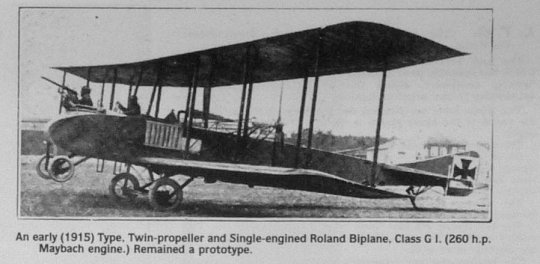
In 1915, LFG began work on an unusual new Grossflugzeug powered by a single engine. Though it shared the same layout as most other Grossflugzeuge, LFG’s G.I relied on a single engine placed in the fuselage linked via driveshafts to propellers on either side of the fuselage. Crew consisted of a pilot and nose gunner both sitting in the nose. A sole prototype was built and flown in 1915, powered by a 245hp Maybach Mb.IV engine. Unfortunately for LFG, the unconventional design failed to win a production order.
Halberstadt G.I
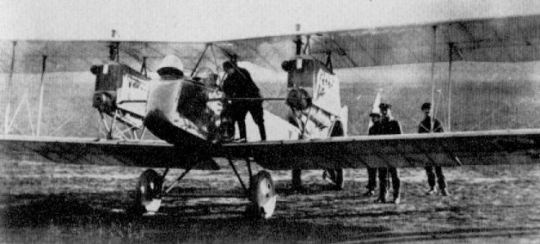
Halberstadt’s sole twin-engined aircraft of the war would take shape in the winter of 1915/16. Powered by two 160hp Mercedes D.III engines, the bomber was overall conventional and unremarkable. It carried a crew of three with two defensive machineguns and provisions to carry 200kg of bombs, while performance projections put it about on par with contemporary designs. Flight testing began in early 1916, but the bomber failed to win favor with the Idlflieg and thus never saw production.
Albatros G.I

In 1915, Albatros began work on their first Grossflugzeuge. Inspired by the Sikorsky Ilya Muromets that had appeared over the Eastern Front, the G.I was a large multi-bay biplane with a crew of five. Like the Ilya Muromets, power was to come from four engines, each of which was mounted on the top of the lower wing. The G.I would fly for the first time on the last day of January 1916 with poor results. The G.I suffered from poor performance and handling. Because of these issues, Albatros abandoned the design, instead moving on to an entirely new layout for their next bombers.
Gotha G.II

Though Ursinus’s G.I had been ordered into production, Gotha’s engineers took it upon themselves to design a more capable Grossflugzeuge. The G.II would revert to a more conventional layout, using a crashed G.I as a basis for the new design. The bomber was repaired and rearranged into a more conventional layout with the fuselage and engine nacelles both mounted on the lower wing. Engines sat in large pusher nacelles that housed both fuel and oil, and an extra machinegun was added to the fuselage, allowing the bomber to defend its rear sector. First flying in March 1916, the G.II was disappointing, being unable to carry the payload specified by the Idflieg. Undercarriage was revised and the wings were completely reworked, solving the worst of the problems and allowing the G.II to receive a small order for 10 aircraft. The G.II entered service in August 1916, making its debut over the Balkans. Serviceability was low, with only four ever operational at any given time. By February 1917, only one remained flying, and by April, the last G.II had left service. Unfortunately, actual details of its service are unknown.
Gotha G.III
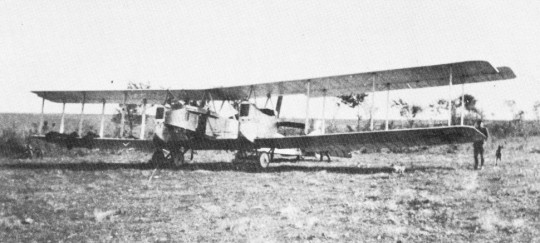
Despite meeting Idflieg requirements, the Gotha G.II’s production remained brief because it was superseded by the next Gotha bomber. Primarily differing from its predecessor in its use of more reliable engines, the G.III was also given a strengthened fuselage and a ventral gun position. Taking flight in 1916, 25 G.IIIs would be produced through the end of the year. These entered service in the Balkans, flying with Kagohl 1 over Romania. Once the Romanian campaign drew down, several G.IIIs were shifted off to Kagohl 2 on the Western Front. There, the G.III established a fairly good reputation. Commanders were complaining to Berlin about the bomber, but not due to any failings of the design - rather, it was too fast, outrunning its escorts. However, the G.III was eventually superseded by more modern designs, and by September 1917 the last surviving aircraft were withdrawn to training units.
Albatros G.II
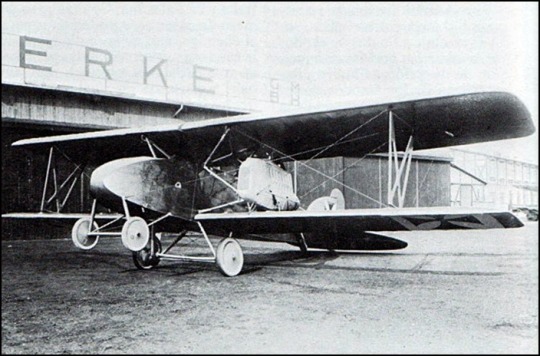
With the G.I proving a failure, the next Grossflugzeuge of Albatros would be a simpler twin-engined machine. Powered by two 150hp engines in pusher nacelles between the wings, the G.II was a smaller single-bay biplane. The wings were designed with a thick airfoil section, while the lower wing had a cutout to allow the engines to be placed further forward. Testing began in 1916, with the G.II demonstrating poor performance. Though performance was poor, however, the general layout was satisfactory, prompting Albatros to carry the design over to their final attempt to build a bomber.
Albatros G.III
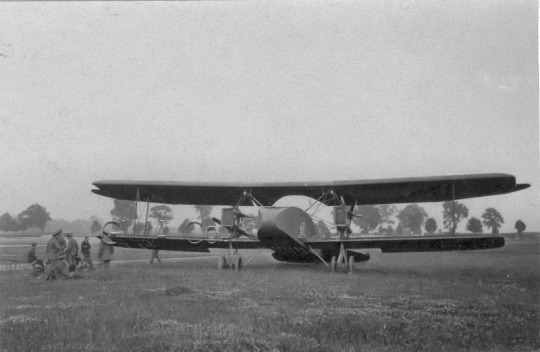
The final Grossflugzeuge design of Albatros - the G.III - was derived from the earlier G.II. The same basic layout and construction methods were carried over to the new design, but the undercarriage was revised and provisions for bombs and machineguns were added. Up to 325kg of bombs could be carried on a combination of internal and external mounts, and two machineguns were provided for defense. Taking flight in mid 1916, the G.III was satisfactory enough to receive a modest production order. The few G.IIIs built were first sent off to KG 6, which was deployed to the Macedonian theater. Small numbers were also sent to Kagohls II and IV, but their numbers on the Western Front peaked in April 1917 at just nine aircraft.
DFW R.I
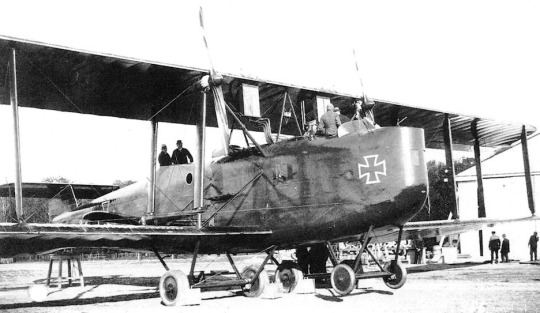
DFW’s first R-bomber would take shape as a private initiative in reaction to the developments of other companies. Like many of the other R-series designs, it had its four engines mounted inside a large, spacious fuselage for in-flight servicing. However, each engine was geared out to its own propeller - two on the leading edge of the upper wing, and two on the trailing edge of the lower wing. Defensive guns were placed in nose, ventral, and dorsal positions, and provisions for up to 2,600kg of bombs were added. The DFW R.I was promising enough in factory tests in 1916 for it to be submitted to military acceptance tests that October. It passed these tests and was purchased by the Luftstreitkrafte, but issues soon arose with the propeller crankshafts. Minor changes to the engine mountings and other aerodynamic improvements allowed the DFW R.I to enter service in April 1917 on the Eastern Front. Unfortunately, the aircraft’s career was brief - it crashed on its second combat sortie due to the failure of both engines.
AEG R.I
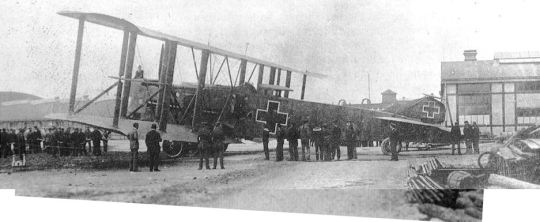
AEG would produce only a single R-bomber design during the war, first flying it in 1916. Coming in a 12 tons gross weight, the AEG R.I was unique in that it had all four of its engines mounted in the fuselage. Power was provided to the propellers via a driveshaft that extended outwards from either side of the fuselage. Layout was conventional for a bomber of the time, though the crew was considerably larger at 7 men. Defensive armament consisted of five machineguns placed around the aircraft, and a payload of up to 3,800kg could be carried. Testing began in 1916, with generally good reports. A further seven examples began construction, but work went slowly. Ultimately, none would be finished by war’s end, and the sole flying example would be lost after a newly designed propeller disintegrated during test flights.
Zeppelin-Staaken R.VI
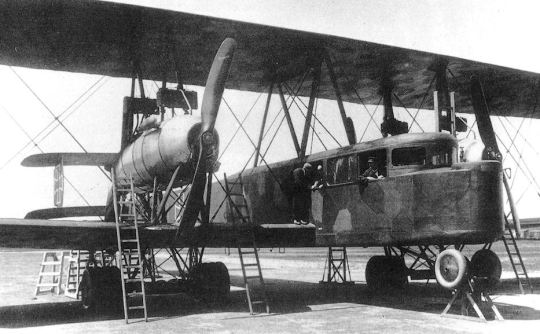
All while Zeppelin was working on the later three-propeller bombers, the Zeppelin works at Staaken were working on a new machine that would become the R.VI. Diverging from the design that had been standard across the first five machines, the R.VI mounted its four engines in push-pull nacelles in the wings. Each nacelle provided space for an engineer, while the fuselage would hold the rest of the seven-man crew. Gunner positions were added in the nose, dorsal, and ventral positions, as well as a position on top of the wing on some aircraft. Payload was 2 tons. First flying in 1916, the R.VI would hold the distinction of being the only Riesenflugzeug to see series production. 18 would be produced, along with several other one-off modifications.
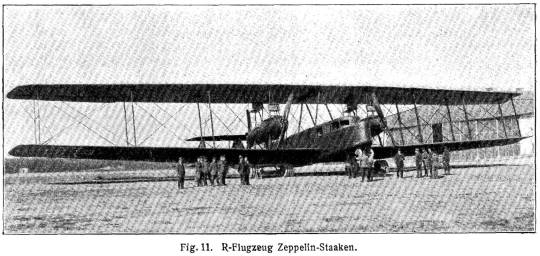
When the R.VI entered operational service in 1917, it would become the largest bomber to fly in the war. Combat sorties began in the latter half of 1917, with missions primarily flown at night with payloads less than 1,000kg. 13 would reach the front by the war’s end, of which four were shot down and six lost in crashes. Despite a high attrition rate, they generally performed well, particularly compared to the Gotha bombers they operated alongside. Missions were flown against both French and British targets, and, unlike the Gotha bombers, the Zeppelin-Staaken R.VI would never be shot down over Britain. The five final machines would be completed after the Armistice, but they would soon be scrapped owing to the terms of the Treaty of Versailles.
Gotha G.IV

Though the Gotha G.III was a success, its armament layout demonstrated some issues, so Gotha followed up with a reworked design. The G.IV overhauled the fuselage to improve the field of fire for the gunners, while also replacing the fabric skinned sections of the fuselage on the G.III with plywood. Owing to complaints about poor lateral control, the G.IV was also given ailerons on the lower wings. The G.IV would receive a production order for 35 aircraft in November 1916, with the order jumping to 50 by February of the next year. 180 more were ordered from other manufacturers. License-produced G.IVs would vary from the Gotha-produced ones largely in their strengthened airframe which cut performance.
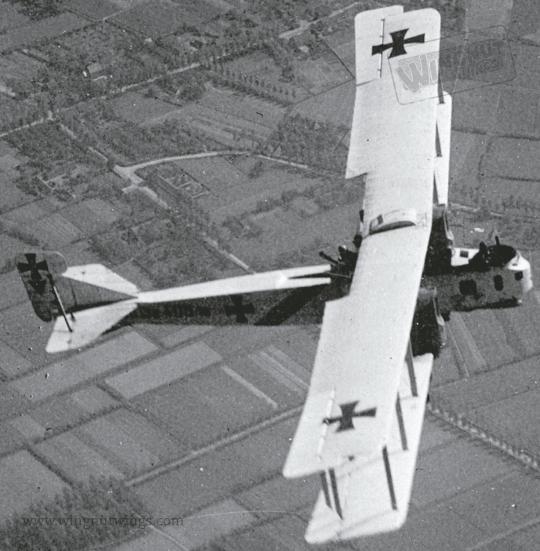
The G.IV entered service with Kagohl 1 in March 1917 just before the unit was redesignated Kagohl 3. The G.IV was selected to take part in the bombing of England, but teething issues would prevent the G.IV from beginning operations until late May. Unlike the airship raids that had been conducted up to that point, the G.IV was making its attacks in broad daylight, with devastating effects. Their first raid would result in 95 deaths and 195 injuries for the loss of just one of the 23 bombers sortied. On June 5, they performed their next raid, killing 162 people and injuring 432 for no losses - the deadliest air raid of the entire war. Over the course of the summer, daylight raids continued. Flying high and fast, the Gotha bombers were mostly able to evade enemy interceptors, and, with the British yet to enact serious practices to mitigate the damage, the damage done by these early raids far outpaced anything the Navy’s airships had managed.
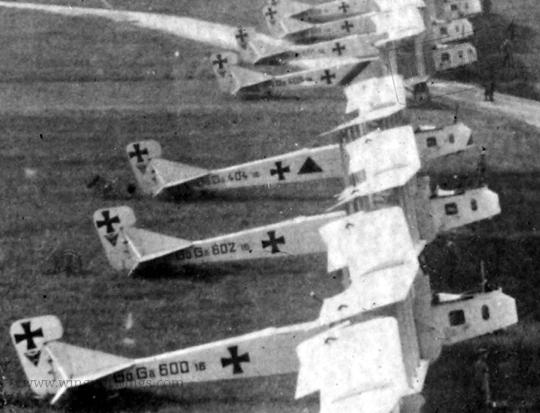
Unfortunately, the British quickly adapted, and by August, daylight raids had become too dangerous to continue. The G.IVs shifted to night missions, flying several raids in September. They were now joined by the larger Zeppelin-Staaken Riesenflugzeuge, though the Zeppelin bombers were never present in large numbers. Operations continued to inflict heavy damage for minimal losses, though difficulties with operating at night did lead to more accidents and aborted missions. As the raids continued, the RFC and RNAS responded by targeting the bomber airfields in Belgium. The bombers were forced to relocate further behind the front for safety, but the raids would continue.
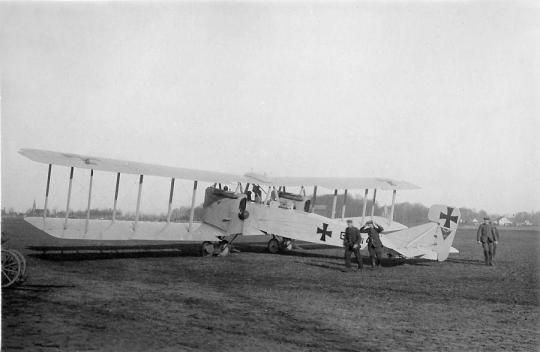
Though the G.IV continued to bomb England into 1918, the strategic bombing would be interrupted in March due to more pressing matters. Called in to support the Spring Offensive, G.IVs were used to bomb English Channel ports and troop concentrations in France. When the raids on England finally resumed in May, the results were disastrous. On May 19, 38 Gothas and 3 Zeppelins took off on the largest raid of the war. British defenses had since massively improved, and thus seven Gothas were lost. Though plans were made to begin incendiary bombing of the Entente capitals, such operations never began. Instead, the Gothas spent the remainder of the war on the more pressing matter of supporting the Army as the front collapsed. Unfortunately, with the end of the war, all Gotha bombers were scrapped in accordance with the terms of the Treaty of Versailles.
Linke-Hofmann R.I
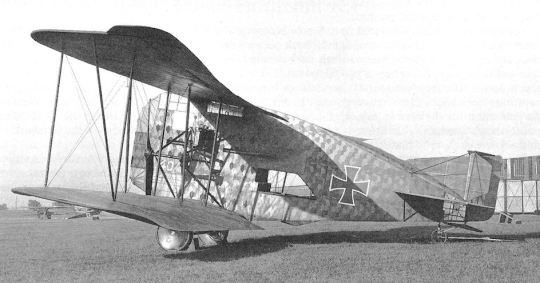
Despite being a railway company with minimal aeronautical experience, Linke-Hofmann would join in on the R-bomber phenomenon in the latter half of the war. Their first design, the R.I, offered perhaps the most peculiar design of all the R-bombers developed during the war. Being a large biplane design, the R.I had a deep fuselage that spanned the entire interplane gap. A spacious fuselage consisted of three decks - a top deck for the pilot and radioman, middle deck for the four engines, and bottom deck for the bombardier, payload, and fuel. The engines were carried entirely within the fuselage, being geared out to propellers between the wings in hopes of reducing drag. The R.I also incorporated transparent Cellon in parts of the aircraft in hopes of reducing visibility. First flying in the Spring of 1917, the R.I quickly demonstrated a number of undesirable features. The height of the cabin made landings difficult, and numerous structural issues - particularly in the wings - made control difficult. Burying the engines in the fuselage led to cooling and vibrational issues, while the Cellon skin was too responsive to temperature changes, negatively affecting trim as the material expanded and contracted. Surprisingly, perhaps the only element of the design that worked as expected was the deep fuselage. The first of four prototypes was lost when the wings collapsed during low-altitude tests, while the second was lost when it nosed-over during landing. The other two survived testing, but the design would never enter service.
Gotha G.V
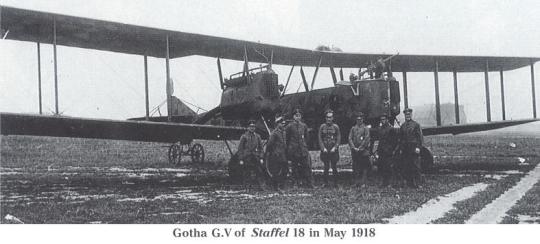
After operational experience with the G.IV showed placing the fuel tanks in engine nacelles was dangerous in all-too-common landing accidents, Gotha went about reworking the design. The G.V was intended to address this concern by moving the fuel tanks to the fuselage. In doing so, the engine nacelles shrank, allowing Gotha to move them to a position between the wings. Because of the placement of the fuel tanks, the bomb bay was eliminated, forcing all bombs to be carried externally. The G.V would received a sizeable production order, with the first examples reaching service in August 1917. While it participated in the same operations the G.IV took part in, it was generally worse performing than its earlier cousin. Due to the changes in the design and poor-quality timber used in construction, the G.V was 450kg heavier than the G.IV while mounting the same engines. Thus, performance was generally worse, and the G.V was consistently limited to lower operational altitudes than the G.IV. Production continued to the end of the war, with the last batch produced delivered directly to the Allies after the Armistice.
Friedrichshafen G.III
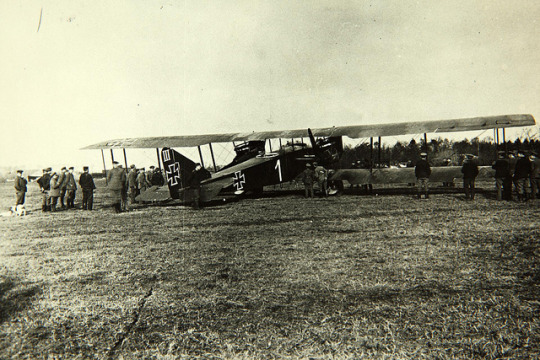
With the relative success of their earlier G.II, Friedrichshafen followed up with an even larger Grossflugzeuge. Designated G.III, the new bomber had larger three-bay wings and more powerful Mercedes D.IVa engines. With the larger wings and added engine power, the payload capacity expanded significantly to 1,000kg in both internal bays and external racks. Taking flight in 1917, the G.III received massive production orders, with 709 ordered from Friedrichshafen, 75 from Daimler, and 280 from Hanseatische Flugzeug Werke. By the time the bomber entered service in 1917, the Luftstreitkrafte had abandoned daylight bomber raids entirely, meaning the G.III would be flown exclusively at night. After operational experience with British night fighters attacking from below, a more refined G.IIIa variant was developed, adding a ventral gun and reintroducing the box tail for better control in the event of an engine failure. This variant quickly took over production, becoming the most numerous variant of the type.
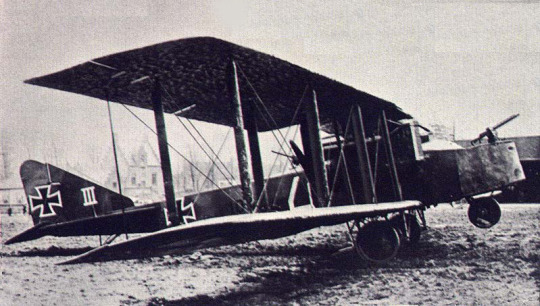
The G.III entered service on the Western Front, flying relatively close-range strikes compared to the cross-Channel raids flown by the Gotha and Zeppelin bombers. It grew to be the most numerous bomber in Luftstreitkrafte service, flying both short-ranged tactical raids as well as strategic raids on urban centers like Paris. The G.III was generally popular with crews thanks to its reliability and robust design. Operationally, the bomber often flew with payloads well below the design limit to extend its range, and generally Friedrichshafen’s G.IIIs would not fly with payloads larger than 600kg. At the end of the war, many of the bombers were passed onto DLR, who converted them for airliner and air mail duties. Conversions varied by aircraft, with some merely being disarmed and fitted with a crude cargo bay in the rear gunner’s position, while others went as far as having an enclosed, glazed passenger’s cabin installed. Unfortunately, these operations were brief, as the terms of the Treaty of Versailles forbid the possession of these aircraft.
The Nachtflugzeuge
In August 1917, the Idflieg produced new requirements, calling for a single-engined two-seat army cooperation aircraft and night bomber. The various aircraft that resulted from these requirements unsurprisingly were mostly derived from the two-seater reconnaissance aircraft of the companies that responded, with the biggest changes to the designs being the use of larger wings to support a heavier aircraft without sacrificing performance. These night bombers originally were given the “CN” designator, but by 1918 the designation had been phased out in favor of the N - Nachtflugzeug - designator.
Albatros C.VIII N
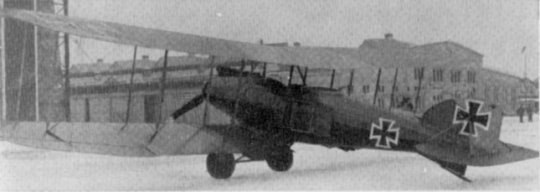
Albatros’ night bomber proposal would receive the designation C.VIII N. Derived from the C.VII reconnaissance aircraft, It shared the characteristic round, streamlined fuselage of other Albatros designs, but it made use of large three-bay wings. To avoid engine shortages, the C.VIII N made use of the 160hp Mercedes D.III engine, providing just enough power to meet the Idflieg’s requirements. Unfortunately, when the C.VIII N took flight in the latter half of 1917, this design decision would come to be the design’s undoing. The C.VIII N was underpowered and slow, being almost 30mph slower than the C.VII it was derived from. While it’s unclear what the fate of the aircraft was, it’s likely that it was rejected without seeing production.
AEG C.IV.N/N.I
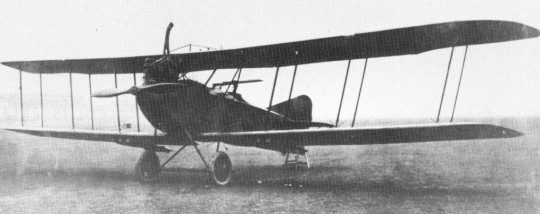
AEG’s night bomber would be derived from their C.IV two-seater. The C.IV.N, as it was originally designated, was a fairly simple conversion of the design. The wings were lengthened, racks for bombs were installed, and the slightly lower-power Benz Bz.III engine replaced the Mercedes D.III of the original design. The C.IV.N would fly in 1917, earning a production order that would see the type starting to reach frontline units at the end of the year. They were assigned to small units of aircraft, where they acted as army cooperation machines. However, their role gradually expanded, and night bombing became a regular part of their mission. Army cooperation missions continued to the end of the war, but night bombing was now the focus of the newly redesignated N.I. Ultimately, the N.I seems to have performed well despite its modest performance, serving through the end of the war and even making it into the hands of the postwar Polish Air Force.
Sablatnig N.I

The last aircraft to receive the Nachtflugzeug designation was Sablatnig’s contender. Adapted from their failed C.I reconnaissance aircraft, the bomber was mostly identical to the reconnaissance aircraft save its use of a 220hp Benz Bz.IV engine in place of the original 180hp Argus As III. Two machineguns were provided for the crew - one fixed forward firing and one flexible - and provisions for carrying 300kg of bombs externally were made. The N.I would fly in 1918, demonstrating little performance gains over the C.I. Whether or not it was ever selected for production is unclear. Whatever the case, only a single N.I was built before war’s end, and following the Armistice, Sablatnig adapted it as a small airliner with a cabin for up to four passengers. Though originally designed as a bomber, it was approved by the Inter-Allied Aviation Control Commission for production as an airliner, allowing it to have a modestly successful career in the immediate postwar period.
AEG G.V
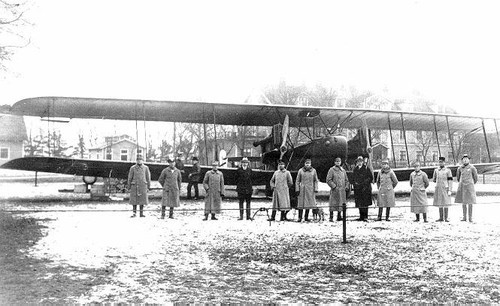
The relatively unimpressive performance of the G.IV would spur AEG to refine the design further into the G.V. The G.V featured significantly enlarged wings and a biplane tail, but otherwise retained much of the previous iteration’s design. Payload expanded again to 600kg, while a third machinegun was added for defense in a ventral hatch. Unfortunately, it took AEG some time to develop the new bomber, and it wasn’t until May 1918 that the G.V flew for the first time. It was ordered into production, but few were completed before the end of the war. Following the Armistice, six were sold off to Sweden, where they served as reconnaissance aircraft until 1922. Others were converted to serve as airliners, where they could carry up to 6 passengers in an enclosed cabin complete with an onboard toilet.
Gotha G.VI
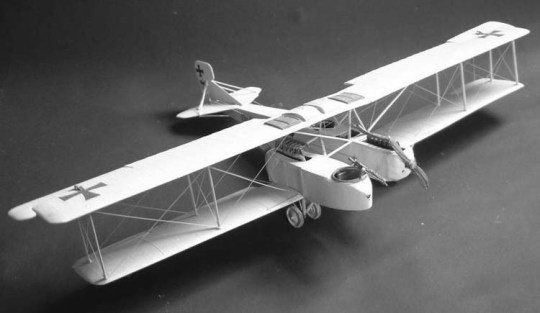
From the early years of the war, Gotha’s engineers had been looking into the design of an asymmetric aircraft, with patents received for an asymmetric design in September 1915. Towards the end of the war, the asymmetric design finally took shape as the G.VI. Making use of parts from the G.V, the G.VI was an asymmetric design with a tractor propeller in the nose of the fuselage and a pusher nacelle offset to the starboard. A gunner was placed in the nose of the pusher nacelle and the remainder of the crew were placed in the fuselage. Flight tests began in the summer of 1918, with the G.VI generally performing well, though buffetting issues were experienced with the tail. An asymmetric tail unit solved the buffeting issues, and, though the first prototype was damaged beyond repair in an accident, work on a second machine began. However, the second machine was not complete before the Armistice, and thus testing could not be completed.
DFW R.II

Though DFW’s first R-bomber had been lost early in its career, it had served favorably enough for the Luftstreitkrafte to order a follow-on design. Designated the R.II, the new bomber shared the general layout of its predecessor (including the unique propeller arrangement). However, a requirement for a 3,400kg payload meant significant structural changes would have to be made. The resulting R.II that flew in August 1918 thus featured a higher gross weight and larger wings to accommodate the larger payload. Minor vibrational issues were found with the propeller driveshafts during testing, but these were easily alleviated, allowing an order for 6 aircraft to be placed. Unfortunately, only two DFW R.IIs would be delivered by the war’s end, having served as training aircraft due to inadequate performance. Plans were in place for an airliner version of the bomber, but ultimately these came to an end with the signing of the Treaty of Versailles.
Gotha G.VII
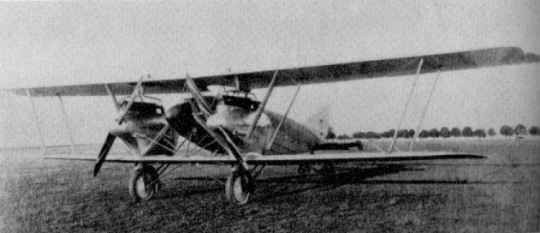
As the war situation deteriorated, Gotha conceived a new high-speed tactical bomber and reconnaissance aircraft known as the G.VII. Though it shared the general layout of Gotha’s previous bombers, it was smaller, with the bombardier’s position in the nose removed to create a more streamlined fuselage and the engines moved closer inboard and placed in more streamlined nacelles. 250 were ordered - 50 from Gotha, 50 from LVG, and 150 from Aviatik. Unfortunately, this late in the war, few would be completed before the Armistice. Gotha would not complete any G.VIIs before the war’s end, and fewer than 20 were delivered to operational units. Though some of these machines did reach operational service, flying as reconnaissance platforms, the war was already lost long before they reached the front. With the end of the war, all but one G.VII were scrapped. The sole survivor made its way into the hands of the short-lived Ukrainian Air Force, before falling into the hands of Czechoslovakia, who operated the machine for the remainder of its career.
Gotha G.VIII/IX/X

Parallel to the G.VII, Gotha created a new series of fast bombers. Derived from the G.VII, the new design made use of the same extensive streamlining seen on the G.VII, but with larger wings and a revised fuselage. Known as the G.VIII, it failed to gain a production order, so Gotha reworked it further into the G.IX. The G.IX featured even larger wings, and testing went well enough for the Idlflieg to order 170 examples from LVG to replace the Gotha G.V. A final variant, the G.X, was also designed, making use of lower-power engines for use in secondary roles. Though both the G.IX and G.X were ordered into production, only the G.IX made it into service before the war’s end. Roughly half the original order of G.IXs were completed by the end of the war, but they failed to make any significant impact on the situation on the front. Following the Armistice, several examples were taken into Belgian service, while the remainder were scrapped.
Schutte-Lanz G.V/LVG G.III
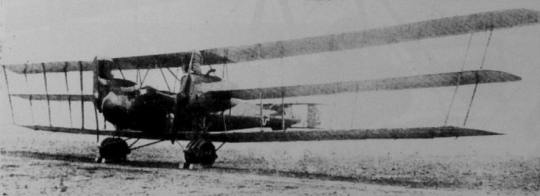
In the final year of the war, Schutte-Lanz developed a large new triplane bomber design. Becoming the only triplane to receive the Grossflugzeug designation from the Idflieg, the bomber featured a streamlined plywood fuselage and two engines mounted in the inner bay of the center wings. The bomber featured a crew of three with gunners in dorsal and nose positions, but the prototype did not appear to have any provisions for carrying bombs. Unfortunately, Schutte-Lanz was occupied with other projects, so production of the prototype was passed on to LVG. LVG only barely completed the prototype before the war’s end, and, though it flew before the Armistice, no production would be ordered before the war ended.
DFW R.III

The final incarnation of the DFW R-bombers, the R.III, would represent a significant divergence from the previous designs. Significantly larger than its predecessors, the R.III was to mount eight engines - four in the fuselage, and two each in nacelles between the wings. The wing-mounted propellers were dropped in favor of a push-pull arrangement on the engine nacelles, complete with one of the earliest examples of co-axial propellers. Each of the aircraft’s eight propellers would be driven by its own engine. Though payload was only 2,500kg, just about everything else about the design had also ballooned. Defensive armament increased to eight machineguns (including dorsal, ventral, nose, and chin mountings), and wingspan increased to 175ft. Had it been completed, the DFW R.III would have been the largest aircraft in the world. However, it was cut short by the Armistice, and it ultimately would never leave the drawing board.
Forssmann Giant

By second year of WW1, an engineer by the name of Villehad Forssman had conceived a design for a transatlantic transport of an unprecedented size. Powered by ten engines, the triplane leviathan would have dwarfed all contemporaries, with a wingspan of 165 ft, length of 150 ft, and endurance of roughly 80 hours. The intended transport role made securing official support difficult, although Forsmann did apparently secure interest from the Kaiserliche Marine and support from several factories and manufacturers. Whatever the case, construction began sometime in 1918. Work went slowly, and development was disturbed by at least one relocation. Ultimately, Forsmann’s aircraft would never fly - the Armistice put an end to construction. The first the Entente heard of it was in 1919, when inspectors discovered the unfinished aircraft (still lacking undercarriage, engines, and tail surfaces) at its airfield in Poll. Though quite an impressive machine even in its unfinished, unassembled state, it would never be completed.
Siemens-Schuckert R.VIII
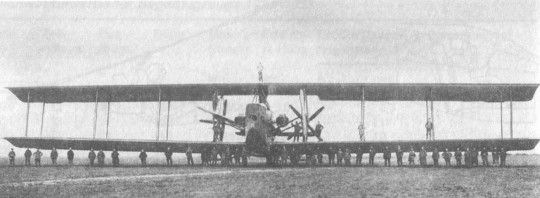
Diverging from their earlier R-series designs, the final R-bomber to come from Siemens-Schuckert would hold the distinction of being the largest R-bomber of the war, both in size (with a wingspan of over 150 ft) and weight (with a loaded weight of 15 tons). Abandoning the unusual layout of the earlier designs, the R.VIII carried six engines in its fuselage, geared out to drive four propellers in a push-pull arrangement between the wings. Outside of its impressive size, however, the R.VIII was conventional for its class of bombers, with a large crew and standard biplane layout. The design received an order for two aircraft, but only the first would be completed, as the Armistice cut work short. Ground trials only began in 1919, but the failure of a propeller caused extensive damage to the aircraft and prevented it from ever flying. The airframe would not be repaired, nor would the second be completed, as the Treaty of Versailles had set in. Thus, the largest airplane in the world would end its career without ever flying.
Linke-Hofmann R.II
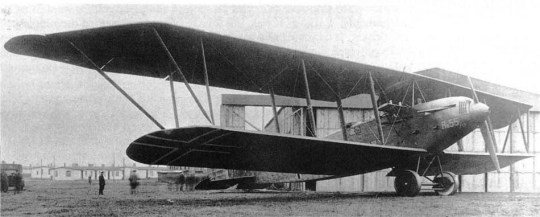
The final R-bomber of Linke-Hoffman, the R.II, at a glance appeared to be more like a light bomber. With a conventional tractor biplane layout and a single propeller in the nose, the unusual design of the R.II only really becomes apparent once the crew provides a sense of scale. The R.II was effectively an average single-engined light bomber design that had been massively scaled up. Crew ballooned to six, with defensive guns placed in two dorsal and one ventral position, while the largest single propeller in aviation history (6.9 meter diameter) was placed in the nose to drive the aircraft. Though it gave the impression of being a single-engined machine, it in fact carried four 260hp Mercedes engines, all geared to the same propeller and accessible from the interior of the aircraft for in-flight servicing. Because of this arrangement, the R.II would be able to shut down up to two engines during flight. Unfortunately, the R.II wouldn’t fly before the end of the war. Only in 1919 did it make its first flight, demonstrating a standard endurance of 7 hours and estimated maximum endurance of 30 hours. Linke-Hofmann hoped to salvage their work in the aftermath of the Armistice by turning the R.II into a 12 passenger airliner, but the conditions of the Versailles treaty put an end to the project.
BFW M.22

As Willy Messerschmitt was negotiating to join BFW in 1927, the German Ministry of Transport pressured Messerschmitt to produce a bomber. Messerschmitt complied, producing the M.22 biplane bomber - one of the only two biplanes he would ever design. The M.22 was similar to contemporary biplane bombers, being a simple twin-engined design with fixed landing gear. A gunner was provided forward and aft of the wings, but no bomb bay was provided, meaning that any payload would be carried externally. It was to be powered by two licence-built Bristol Jupiter engines in faired nacelles. The M.22 flew for the first time in 1928, with mediocre results. Performance was far from that of the high-wing cantilever monoplanes that had made him famous, so no production was ordered.
The Dornier Freighters
As Germany worked to circumvent the terms of the Treaty of Versailles and reestablish an air force, Dornier began work on two new aircraft that would be able to serve as bombers for the new air force. Under the designations Do Y and Do P, Dornier designed and built these aircraft - nominally freighters but easily convertible to bombers - in their facilities in Switzerland. The guise of being freighters hardly held up to scrutiny, with Dornier even going as far as marketing the Do Y as a bomber, but no action was ever taken in response, as the aircraft never came to be officially operated by Germany. Though neither the Do Y nor Do P would enter service with the fledgling Luftwaffe, they served as an important basis for later Dornier projects that would become the Luftwaffe’s first bombers.
Dornier Do P
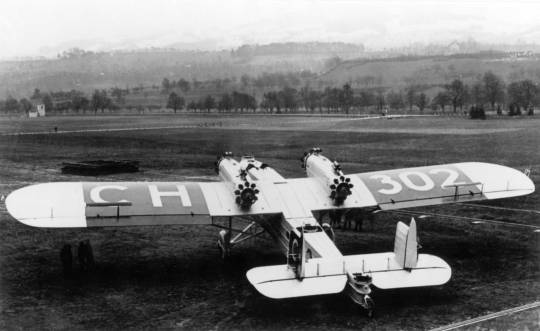
The first of Dornier’s “freighters” to take shape was the four-engined Do P. The Do P was a six-man cantilever monoplane, powered by four license-built Bristol Jupiter engines placed in tandem push-pull nacelles on the top side of the wings. With corrugated skin, a box tail, and fixed, spatted landing gear, the Do P had a distinctly interwar look to it. Taking flight in March 1930, the Do P was unarmed, giving the claim that it was a freighter at least some weight. However, after initial tests in Switzerland were completed, the Do P was converted to a bomber configuration, with open gunner positions placed in nose, dorsal, ventral, and tail positions and racks for bombs placed in both internal bays and external positions. It was taken into German service the next year, where it nominally served as a transport until it was sent to the secret training facility at Lipetsk in the summer of 1932. There, the bomber served as a training aircraft until the facility closed down in October 1933. With the closing of the Lipetsk facilities, the Do P was given to the Soviet Union.
Dornier Do Y

In October 1931, the Do P was followed by the three-engined Do Y. The new “freighter” shared the same Bristol Jupiter engines of the Do P, but used a different mounting - two were mounted on the leading edge of the wing, and the third was carried in a nacelle above the fuselage. The Do Y was slightly smaller than the Do P, but performance was overall better. The guise of being a freighter was dropped fairly quickly, and by 1932, Dornier began marketing the bomber abroad. Austria, Hungary, Romania, and Yugoslavia showed interest in the design, but ultimately only Yugoslavia would purchase the two prototypes, which were fitted with four machineguns paired in nose and dorsal positions and configured to carry twelve 100kg bombs. Though no further orders came, Dornier succeeded in marketing an airliner variant as well, with two aircraft originally ordered by Yugoslavia converted to the new layout after Yugoslavia cancelled its order.
Dornier Do 11

In 1931, Dornier began work on a large new twin-engined aircraft under the designation Dornier F. Powered by two license-built Bristol Jupiter radial engines, the Do F was developed under the guise of a freighter for the German State Railways. Like Dornier’s previous “freighter” projects, the Do F was a high-winged monoplane. However, it was to make use of retractable landing gear. Taking flight in May 1932, the Do F’s retractable gear proved problematic, so it remained lowered, and ultimately was replaced with fixed, spatted gear. Still nominally a freighter, the design received a small order for production aircraft fitted with a small freight compartment. In this capacity, the Do F was revealed to the world in 1934 as a freight aircraft. However, unknown to the public was that every aircraft was also delivered with the components to convert it to a bomber.

The bomber conversion of the Do F was simple, adding three defensive guns in nose, dorsal, and ventral positions along with a bombardier’s position and bomb bay. Operating with Germany’s first bomber units upon the establishment of the Luftwaffe in 1933, the Do Fs were converted to bombers and given the RLM designation Do 11C. Unfortunately, the Do 11C suffered from vibrational issues, leading to a second-series production run - the Do 11D - which shortened the wings slightly to alleviate the issue. Though the Do 11 was primarily intended to serve as an interim trainer until newer designs were available, it ended up seeing a substantial production run of nearly 400 aircraft owing to the failure of the Do 13 that was slated to replace it. Ultimately, the Do 11 was replaced only in the mid-’30s as more modern bombers finally became available.
Dornier Do 13
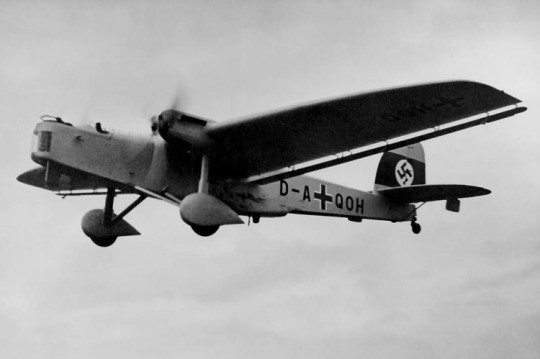
Owing to the failings found in the Do 11, Dornier was contracted to develop an improved variant under the designation Do 13. Though the Do 11 was an advanced aircraft, the teething problems had given the impression that it was perhaps too advanced for the time, so the Do 13 was to simplify the design. Fixed landing gear replaced the (nominally) retractable gear of the Do 11, and the structure of the aircraft was simplified. The first Do 13 prototype flew in February 1933, with series production following soon after. Unlike the Do 11, which made use of domestic radial engines, the Do 13 was to be produced with BMW VI inlines. Soon after deliveries began, disaster struck. Several Do 13s were lost early on due to structural failures in the wings, putting a halt on production. The Do 13s were taken from service, and Dornier worked to strengthen the airframe, resulting in the Do 23.
Focke Wulf Fw 42
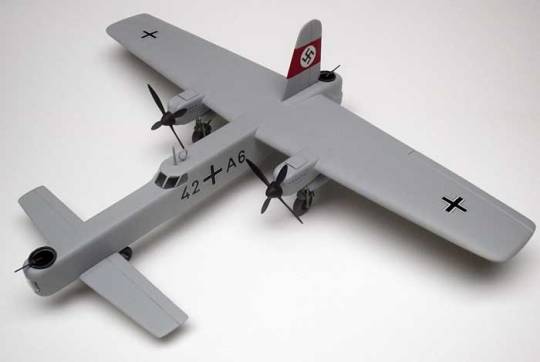
After Focke Wulf’s experimental F 19 canard airliner proved promising, the company moved to militarize the design as a bomber for the fledgling Luftwaffe. Starting out as a simple conversion of the F 19 with gunner stations and a bomb bay, the design evolved over time, dropping the canard from its original position above the fuselage to a low-mounted position and eliminating the multiple vertical fins in favor of a single large one. Crew was to be six, with gunners placed in open positions in the extreme nose and tail. A full-scale mockup was built, complete with machineguns and controls, and the design was marketed to not just the Luftwaffe, but the Soviets and Japanese as well. Unfortunately, despite promising wind tunnel tests and the successful testing of the F 19 airliner, the Fw 42 failed to gain any orders, likely due to the radical design. No prototypes were ever made, and the project never progressed beyond the mockup stage.
Dornier Do 23
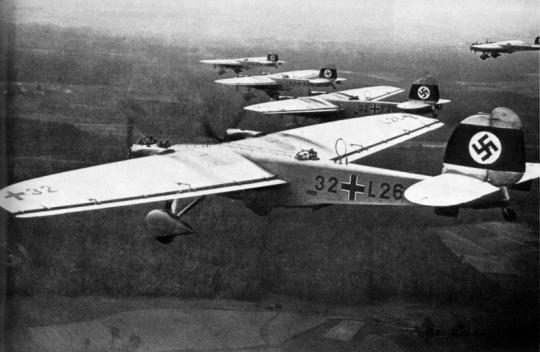
The failure of the Do 13 led to a major overhaul of the structure to salvage the design. Externally, the Do 23 would look very similar to the Do 13, differing mostly in its slightly shorter wingspan and minor changes to the tail. The Do 23 would enter production in 1934, with the bomber slated to replace the Do 11. However, performance as mediocre, and, with more modern bombers just around the corner, the Do 23 would never fully replace the Do 11. Instead, it served alongside it until 1936, when the newest generation of bombers came along to replace both the Do 11 and Do 23.
Junkers Ju 52
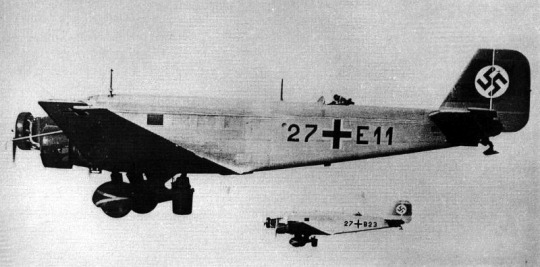
Though originally designed as a transport, the potential of Junkers’ trimotor Ju 52 as a bomber would catch the attention of the fledgling Luftwaffe. With attempts to improve upon the early Dornier bombers failing and the new generation of modern bomber still several years away, the RLM asked Junkers to develop a bomber variant of the transport. The conversion entailed the installation of three bomb bays with a total capacity of 1,500kg of bombs and three defensive gun positions - one over the cockpit, another near the tail, and a third in a retractable ventral “dustbin.�� Though these would serve as bombers, they were still easily convertible back to transports. Plans had called for the Ju 52 to supplement the Dornier bombers, but, as they generally proved to be failures, the new Junkers bomber received a sizeable production order.
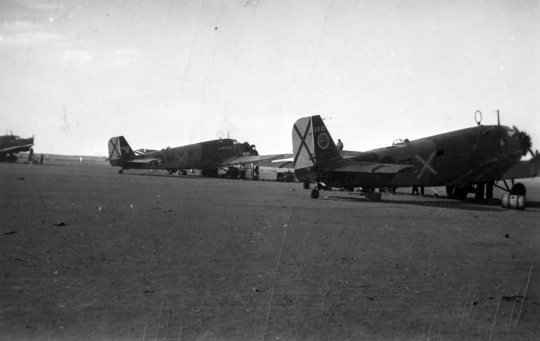
Entering service in 1934, the Ju 52 would make its debut over Spain, where examples were supplied to the Nationalist forces as both transports and bombers. Arriving soon after the war began in mid 1936, they served both with the Condor Legion, starting with three squadrons, as well as with Nationalist forces directly. Though the Ju 52 was gradually eclipsed by the newer bombers reaching the theater like the Do 17 and He 111, it remained in use through the end of the conflict. They would participate in the bombing of Guernica in 1937, and they saw considerable use in support of Nationalist ground forces throughout the war. Though most were on their way out of bomber roles by the time the Second World War broke out, the desperate need for aircraft in the invasion of Poland saw the Ju 52 persist as a bomber. The last major action involving the Ju 52 appears to have been the bombing of Warsaw in September 1939. By 1940, the Ju 52 seems to have been phased out of bomber duties, instead being shifted off to transport units as the Luftwaffe’s standard transport.
Heinkel He 50
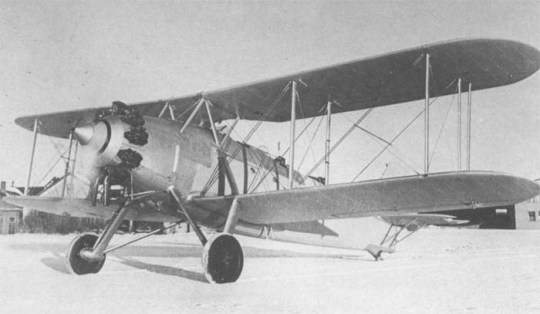
The Luftwaffe’s first dive bomber could trace back its origins to 1931, when the Imperial Japanese Navy requested a two-seat dive bomber from Heinkel capable of carrying 250kg of bombs and operating from a carrier. Originally designed as a square-fuselage aircraft with an inline engine, the design that would go on to enter service with the IJN as the Aichi D1A would instead be a heavily reworked design powered by a Bristol Jupiter radial. Soon after it gained an order from Japan, the German Defense Ministry gained interest. In 1932, after the He 50 V1 was demonstrated to the Defense Ministry, an order for three prototypes and a production batch of 60 aircraft was ordered. China also ordered 12 examples, but these would be commandeered by the Luftwaffe.
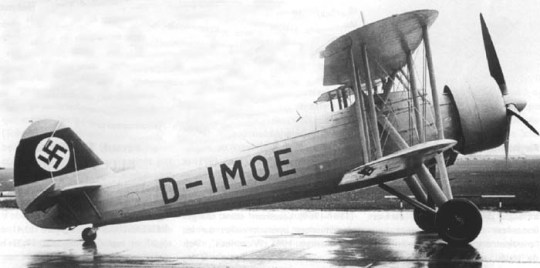
The He 50 would enter service in 1935, delivered to the Luftwaffe’s first dive bomber unit. The 60 He 50As originally ordered were very similar to the Japanese machines, mounting a domestic Bramo 322 radial engine in place of the weaker Jupiter. However, the confiscated Chinese order, powered by Jupiters, retained their engines. The He 50 would come to partially equip nine other dive-bombing units, but its career was brief. The arrival of first the Hs 123 and then the infamous Stuka would quickly overshadow the He 50, which was shifted off to training units. However, in 1943, they were called back to the front, with surviving aircraft delivered to night bombing units on the Eastern Front. From the Spring of 1943 to September 1944, the He 50 would be used to fly night harassment raids on the Eastern Front. However, in light of the ever-worsening war situation , these units were completely disbanded in September 1944.
The Airliner Medium Bomber
In 1934, specifications were issued to Heinkel and Junkers, calling for a high-speed twin-engine airliner for Lufthansa that could be readily converted to serve as a bomber for the Luftwaffe. Both companies produced very modern monoplane designs, both of which put emphasis on the supposedly secondary bomber requirements rather than being truly practical airliners. The resulting aircraft - the Heinkel He 111 and Junkers Ju 86 - would go on to be the first German bombers to see significant service, with both designs serving in some capacity until the very end of the war.
Junkers Ju 86
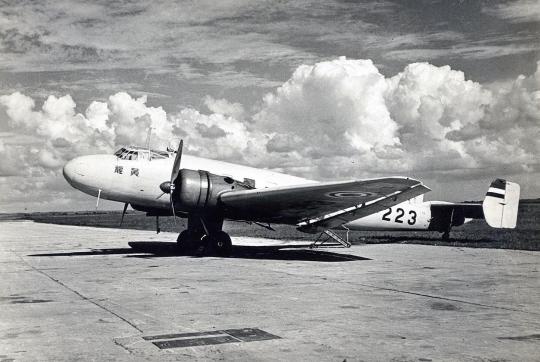
For the new requirements, Junkers abandoned the corrugated skin designs the company had become known for, instead producing the Ju 86 - a low-wing semimonocoque monoplane with retractable landing gear. Nominally designed as an airliner, the Ju 86 had seating for 10 passengers, but, when converted to a bomber, the passenger compartment became a bomb bay. The bomber had a crew of four, with defensive guns placed in the nose, a dorsal position, and a retractable ventral dustbin. Junkers originally designed the bomber around the Jumo 205 diesel engine in hopes of getting better fuel efficiency out of the design, but the powerplants were not ready in time for the first prototype. Instead, the Ju 86 prototype - configured as a bomber - would fly in November 1934 powered by domestic radial engines. It wouldn’t be until April 1935 that the first aircraft configured as an airliner - the third prototype - would fly. Testing revealed stability issues associated with the highly tapered wing, forcing Junkers to reduce the taper and broaden the chord, but otherwise the Ju 86 was a solid design.
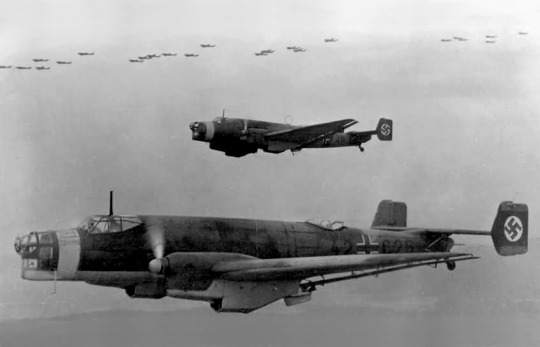
Stability problems in the first production Ju 86 bombers prevented the aircraft from making its operational debut until 1937, when the first Ju 86Ds were available. They made their first deployment to Spain in the summer of 1937, with five deployed to support Franco. Unfortunately, the diesel engines were difficult to service and slow to respond to throttle changes, making them poorly suited to combat. Junkers addressed this with newer variants that made use of conventional engines, culminating in the final bomber variant - the Ju 86G. The Ju 86G made use of BMW 132 radial engines and was fitted with an all-new glazed nose with the gun removed. However, it wouldn’t be until 1938 that production of the new Ju 86 began, by which point the Luftwaffe had already settled on the He 111. The Ju 86 had demonstrated itself to be an inferior bomber to the He 111, so production had been scaled back to make way for the He 111. Limited production continued, but the Ju 86 would never gain a prominent position in the Luftwaffe.
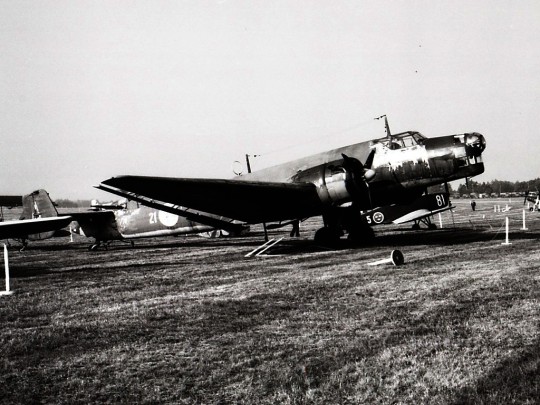
Though the Ju 86 was gradually being phased out in favor of more capable bombers, it remained in service long enough to see use in the invasion of Poland. However, soon after the campaign was over, the Ju 86s were finally retired from Germany’s bomber fleet. In January 1940, Junkers proposed a new high-altitude strategic reconnaissance variant - the Ju 86P - to salvage the design. Featuring a longer wingspan, pressurized cabin, and Jumo 207A1 turbocharged diesel engines, the Ju 86P could take its crew of two up to 39,000ft, well above the ceiling of most fighters. A bomber variant of the Ju 86P was also developed, with internal bays capable of carrying 1,000kg of bombs. The first operations began in late 1940, with the aircraft proving immune to interception as they made flights over England. The bomber variants proved too inaccurate to be effective, but the strategic reconnaissance variant worked excellently. The Ju 86P would serve over Britain, Russia, and North Africa, lasting until August 1942 before the first aircraft was downed by a modified Spitfire.
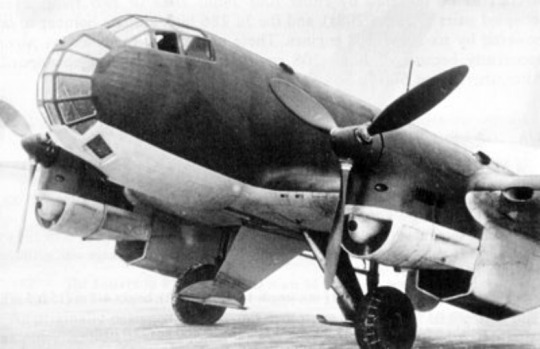
Unfortunately, the onset of losses on these high-altitude missions would spell the end for the Ju 86P. A defensive gun was installed to protect the aircraft, but to no avail. Soon after the first combat loss, two more were downed, forcing the Luftwaffe to end high-altitude overflights of North Africa. The following month, the first interceptions over England occurred as well. Though no losses occurred, the bomber had clearly lost its immunity. Daytime overflights of England ceased, and in May 1943 the last night mission was flown. Fortunately, by then, an even more capable variant had arose. The Ju 86R would raise the ceiling to nearly 50,000ft thanks to its more powerful engines and larger wings. However, its career was brief. The appearance of the Spitfire IX in September 1942 gave the Allies an aircraft that could intercept the Ju 86R, so production was halted fairly early on and operations were limited. By the summer of 1944, the last Ju 86 was retired.
Dornier Do 17
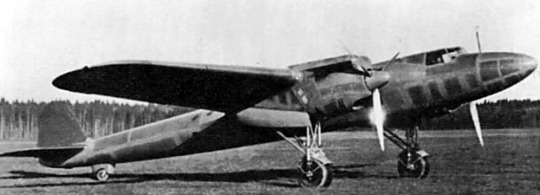
In 1932, a requirement for a “high speed mail plane for Lufthansa” and “freight aircraft for German State Railways” was issued, with Dornier responding with a design. Receiving the designation Do 17 when the Nazis took power in 1933, the contract was altered, calling for a “freight aircraft with special equipment” and a double tail. Unlike the “airliners” being developed by Junkers and Heinkel in parallel, the Do 17 barely even maintained a facade of civil applications, with its slender fuselage impractical for carrying passengers. After reviewing a mockup in 1933, three prototypes were ordered by the RLM. The first prototype would fly with the single-tail configuration the aircraft was originally designed with in November 1934. The twin-tailed prototype followed in May 1935, and the original prototype was eventually given two tails due to stability issues. The design that ended up getting approved for production was an agile, slender aircraft with crew concentrated in the nose. A glazed position was provided for the bombardier, and a total of three machineguns were provided in the nose and a dorsal position. Meanwhile, the narrow bomb bay provided space for 500kg of bombs.
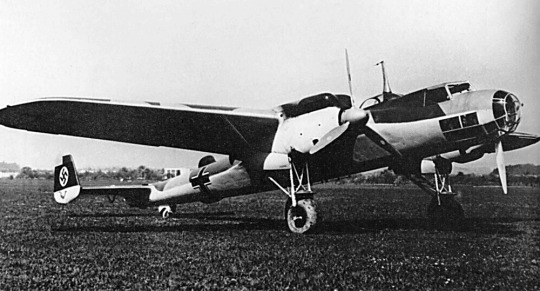
Though not designed to the same specifications as the Junkers Ju 86 and Heinkel He 111, the Do 17 would still fly off against these bombers before production was ordered. After tests revealed excellent performance and agility, the Do 17 was ordered into production, with the first aircraft reaching their units in 1936. It would make its combat debut in 1937, when a complement of 12 Do 17E bombers and a number of Do 17F reconnaissance aircraft was deployed with the Condor Legion to Spain. Initial service went well, with the Do 17 proving far faster than anything else in the theater. Being able to outrun anything it encountered, the relatively poor armament wasn’t a liability until the arrival of the Soviet-built I-16. Losses remained low, but Dornier was prompted to develop a more heavily armed variant. They would serve in most major actions of the war, including Guernica, and, as the Ju 86 lost favor, more Do 17s were called in to replace the Junkers bomber. By the end of the war, a total of 27 Do 17E, F, and P variants had served in Spain with the Condor Legion.
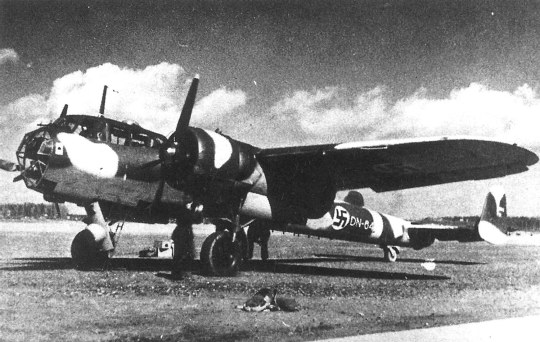
Though none of the up-armed Do 17s would come to see service in Spain, Dornier would create a heavily revised variant - the Do 17Z - that would come to be the most numerous variant to see production. The Do 17Z featured a heavily reworked nose that improved the dorsal gun position and added a ventral position along with a fourth crewman. The bomb bay was expanded, doubling its capacity, and, to accommodate the added weight, the Bramo 323 radial engine was installed. The Do 17Z was widely available by the time Germany invaded Poland in 1939, serving alongside the He 111 as the backbone of the Luftwaffe’s bomber corps. Four Kampfgeschwader flew the type at the outbreak of war, with a total of 533 on hand. They generally performed well in the invasion of Poland, becoming a popular aircraft with crews. Though two Do 17s were the first German aircraft shot down in the war by Polish fighters, they were generally fast enough to outrun enemy interceptors.
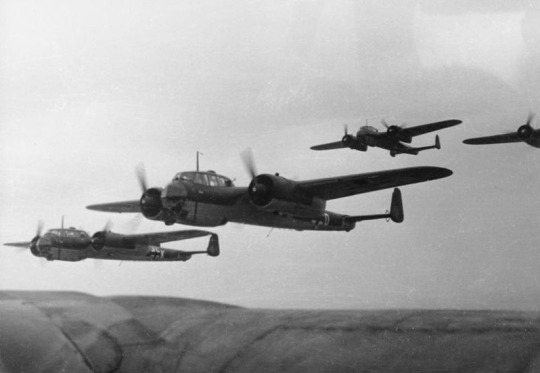
Only a single Gruppe of reconnaissance Do 17s would participate in the Norwegian campaign, but five Kampfgeschwader were on hand when Fall Gelb began in May 1940. Here, the Do 17 began to show its first failings. Though fast and agile, it had a significantly shorter range and smaller payload than other Luftwaffe bombers, limiting its usefulness. Worse, even with the heavier armament of the Do 17Z, it remained vulnerable to fighters, with heavy losses suffered by the Do 17 Geschwaders until air superiority was secured. However, it remained popular with crews, who generally found it an excellent platform for low-level strikes. By the end of the campaign, losses had subsided, and the Do 17 ended the Battle of France having dropped 350 tons of bombs.
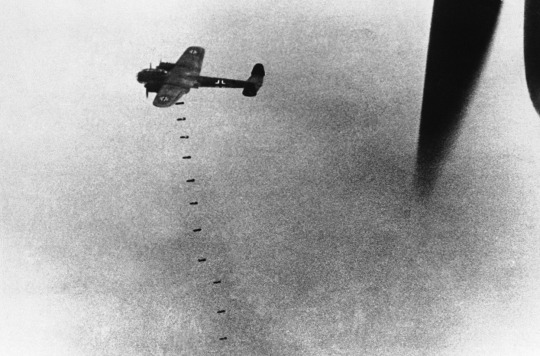
Though the Do 17’s failings were already becoming apparent, it would be over Britain in the latter half of 1940 that the Do 17 would finally fall from grace. At first, the Do 17 was committed to mass low-level raids, done both to make the best of the bombers engines (whose performance rapidly dropped off at higher altitudes) and evade enemy fighters. Though it excelled at these missions, however, British air defenses quickly adapted, leading to considerable losses. Once the Luftwaffe began its raids on London, requiring medium-altitude attacks, losses only worsened. In August 1940, 54 Do 17s were lost and a further 20 written off, and in September, 50 more were lost. Crews began to add extra armament in the field to fend off enemy fighters, but to no avail. Losses continued, and as the campaign dragged on, the Do 17 was gradually replaced by the Ju 88, which offered similar performance but with a longer range and better payload. Even with all the suffering inflicted on the Do 17 crews, however, the Do 17 would come out of the Battle of Britain with the lowest loss ratio of any of the three main bombers committed to the campaign.

Even though the Do 17 was on its way out by the end of the Battle of Britain, the type persisted for some time. Two Kampfgeschwader flying Do 17s were committed to the invasion of Yugoslavia, following the campaign all the way through to the invasion of Greece and fall of Crete. By the time Operation Barbarossa began, however, the Do 17 had been reduced to just three Kampfgruppen and two reconnaissance Staffeln. Though the inadequate armament of the type was not so much of a liability in the opening stages of the war in Russia thanks to the air supremacy gained by the Luftwaffe, the Do 17 still was problematic, with the bomber lacking the range and payload the Luftwaffe needed in such an expansive theater. As more Ju 88s became available, the Do 17 was slowly phased out of combat roles, with the last leaving the Eastern Front in October 1941. Some were converted to night fighters, serving in defense of the Reich until 1944, but most were shifted off to secondary roles - glider tugs, training aircraft, and engine testbeds.
Heinkel He 111
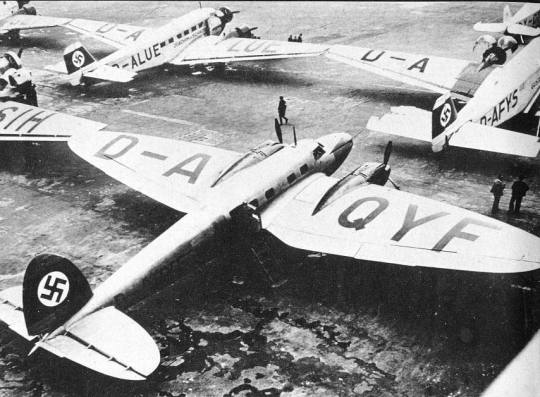
Heinkel’s new bomber would be heavily derived from their earlier He 70 high-speed single-engined airliner. Sharing the He 70’s signature elliptical wing and tail, the He 111 was a larger twin-engine machine. Taking flight for the first time in February 1935, the prototype would be significantly different from the bomber that would later become the mainstay of the Luftwaffe. Being nominally an airliner, the He 111 prototype had a solid nose with a conventional cockpit and no provisions for armament, save a “smoking compartment” that was easily convertible to a bomb bay. Testing went well. The He 111 showed good performance for the time, stable cruise characteristics, and good low-speed handling. It would go on to take part in comparison trials with the Ju 86, being slightly slower but otherwise acceptable. However, once the DB 600C engine became available, the He 111’s performance improved, putting it well ahead of the Junkers competitor. Both designs received contracts, with the He 111 being ordered in both airliner and bomber configurations.

In Luftwaffe hands, the He 111 would make its debut over Spain. Though not originally deployed with the Condor Legion, the appearance of the Soviet I-15 and I-16 fighters in Republican hands spurred the Luftwaffe to commit its most modern bombers to the conflict. Four He 111Bs were deployed alongside five Ju 86 and four Do 17s in early 1937, making their combat debut that March. From the start, it proved superior to the other bombers it served alongside, being both faster and capable of carrying a heavier payload. It was generally fast enough to outrun enemy fighters, and, as the design proved itself, the number of active aircraft rose to 30 He 111Bs. These were slowly replaced by 45 He 111Es which arrived later in the war. Overall, service in the war went very well. Out of 94 He 111s delivered to the Condor Legion, 21 were lost to enemy action, 15 to accidents, and one to sabotage. Having proven itself in combat, production ramped up, and the He 111 became the backbone of the Luftwaffe’s bomber corps.
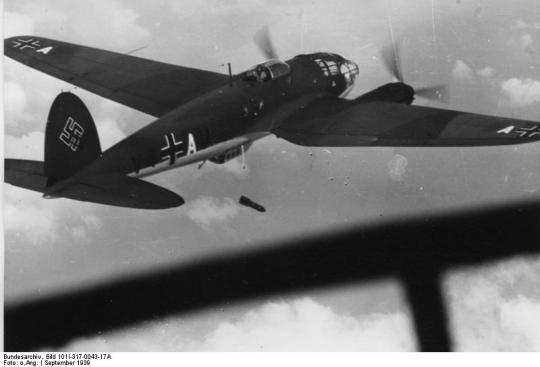
Upon the outbreak of war in Europe, five Kampfgeschwader of He 111 were deployed to support the invasion of Poland. By now, the He 111 had taken the recognizable form it would hold for the remainder of the war, with the newest He 111P variant introducing the stepless glazed nose. Being the most numerous bomber available, the He 111 unsurprisingly saw use in most major actions of the campaign, flying everything from strategic strikes and interdiction to direct close air support. He 111s also participated heavily in the bombing of Warsaw, inflicting serious damage upon the city. Unfortunately, things were not all good. Though the Polish Air Force was antiquated and outnumbered, their fighters still managed to intercept the He 111 on multiple occasions, and the He 111’s modest armament of three rifle-caliber machineguns was unable to adequately protect the bomber.

After the invasion of Poland came to an end, the He 111 shifted operations West, aiming their efforts at the Royal Navy. In October 1939, the odd bombing mission against Scapa Flow and the Firth of Forth were conducted, and through the end of the year, He 111s were used to mine the North Sea. When Germany invaded Denmark and Norway in 1940, three Kampfgeschwader were committed to support the campaign. In the initial invasion, they were used to suppress enemy strong points, though they failed to prevent the sinking of the cruiser Blucher by Norwegian coastal artillery. When the Royal Navy arrived, they turned their attention to holding off British shipping. On April 9, He 111s succeeded in damaging the battleship Rodney, and, as the campaign continued, they put constant pressure on Allied efforts to bring forces into Norway to resist the invasion.
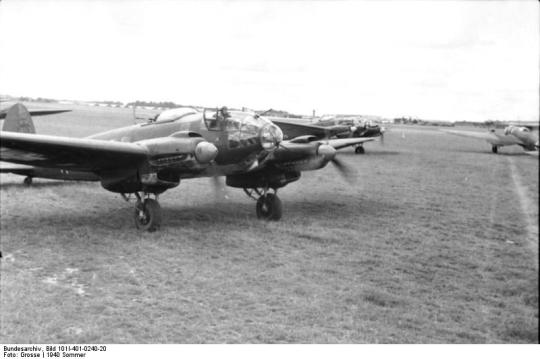
When Fall Gelb began on May 10, 1940, the He 111 was again on the forefront of the campaign. Taking part in the opening strikes of the campaign, they encountered only scattered resistance as the Wehrmacht rushed across the Low Countries. On May 14, the He 111s of KG 54 executed what became known as the Rotterdam Blitz, dropping some 100 tons of bombs and leveling sections of the city. Further south, He 111s were instrumental in supporting the breakout at Sedan, flying nearly 4,000 sorties against French forces. This was followed by heavy support for the push to the sea and eventual destruction of the Allied pocket at Dunkirk. As the pocket was reduced, He 111s played a major part in targeting the French rail network, preventing the Allies from mounting a counterattack. In preparation for Fall Rot, a large number of He 111s were committed to Operation Paula, a major air raid on the airbases around Paris. Though the operation failed to meet its goals of destroying the Armee de l’Air, France would fall soon after. Though the He 111 had served well in France, its failings were starting to become apparent. Too slow to outrun enemy fighters and lightly armed, they suffered greatly when enemy fighters managed to intercept them.
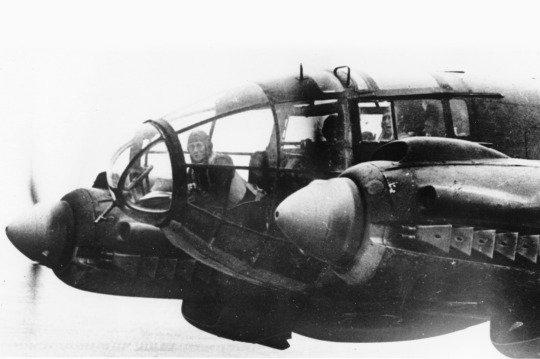
As the Luftwaffe turned its attention across the Channel, 15 geschwader of He 111 were made available for the coming bombing campaign. From the start, He 111s participated heavily. Though slower than the Ju 88 and Do 17, it distinguished itself for its ability to carry a substantial payload and and its exceptional durability in the face of enemy fighters. Though it lacked the payload of a true strategic bomber, it was still capable of wreaking havoc, as several successful raids against factories showed. However, as the Battle of Britain wore on and losses mounted, the Luftwaffe was forced to change tactics. Too vulnerable to operate at day without escort, the bombers shifted to night operations to allow them to strike deeper into the country and evade enemy fighters. For night missions, they made use of the X-Gerat navigation system, which was effective when it worked but was often subject to British jamming. Unfortunately, while the night bombing was effective at first, the RAF was quick to adapt. Night fighters began to appear and losses mounted once more, and ultimately the campaign had to be called off. By the time the Battle of Britain came to a close, 242 of the 463 He 111s that participated in the battle were lost.
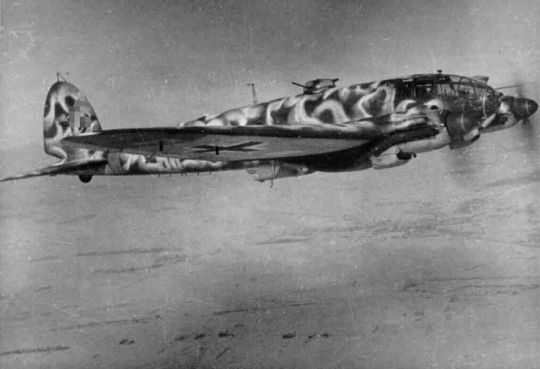
Between the Battle of Britain and invasion of Russia, the He 111 began to take on more roles. While also taking part in conventional bombing campaigns across the Mediterranean, it had begun to take part in torpedo bombing and anti-shipping duties. However, anti-shipping duties largely entailed attacking with conventional bombs - a difficult and often costly endeavor. Difficulties in developing airborne torpedoes meant that the He 111 wouldn’t be able to start torpedo bombing until late 1941. Once torpedo bombing did begin, however, the He 111 proved an effective platform. Operations were concentrated in the Atlantic, Arctic, and Black Sea, where the threat from enemy fighters was minimal. There, the He 111 performed well. In the Mediterranean, however, where the Allies gradually gained air superiority, the He 111 struggled. By April 1943, KG 26 - the sole torpedo bombing unit in the Mediterranean - had been reduced to just 13 Ju 88s and He 111s.

The He 111 would remain the most numerous bomber in the Luftwaffe inventory when Operation Barbarossa began. Unlike the more agile bombers it served alongside, the He 111 was too unwieldy to support tactical strikes. Instead, in addition to its regular operational and strategic level missions, the He 111 was assigned train-busting duties. As train busters, the He 111 was reasonably effective, though losses began to mount after the Soviets started arming their trains. Following the Soviet General Offensive in the winter of 1941-42, some He 111s reverted back to transports to assist in the airlift efforts around the Demyansk pocket. When the same situation happened a year later on a larger scale at Stalingrad, the He 111 was again called into action as a transport. However, refined VVS tactics took a toll on the bombers, with 165 He 111s being lost during the Stalingrad airlift effort.

Though the He 111 continued its long-range strikes even after the tide of the war turned, the situation over Russia was rapidly deteriorating. By the end of 1943, the rapid improvement of the VVS meant that the He 111 was no longer safe on daylight raids, so the bombers were shifted to night missions. Even so, raids continued to be more strategic in nature, targeting factories in recently liberated sections of the Ukraine. Unfortunately, by 1944, the He 111 was finally losing its utility. Unable to operate without air superiority and outperformed by other bombers in service, numbers gradually declined. The He 111 took on some specialist roles, such as carrying V-1 flying bombs for launch, but their effectiveness continued to decline. Many reverted back to transports in the last year of the war, and those that remained as bombers were forced to concentrate efforts on destroying vital bridges and river crossings to halt the advancing Red Army.
The Sofort Dive Bomber
In 1934, with the dive-bomber craze sweeping through the Luftwaffe, the RLM began the process of procuring a modern new dive bomber. Because of the perceived urgent need for a dive bomber, the RLM initiated two parallel programs. The first, the Sofort (immediate) program, called for a simple interim design that could hold over the Luftwaffe while a more capable design was developed in the parallel Sturzbomber program. Henschel and Fieseler would be the only two companies contracted for the interim bomber program, both producing simple single-man biplanes with fixed landing gear. Though development of both went quickly, and prototypes were flying within a year, the interim program ended up being largely superfluous, as the far more advanced Sturzbomber contenders developed incredibly fast. Thus, the winning Hs 123 was quickly overshadowed by Junkers’ infamous Stuka, which would go on to be the mainstay of the Luftwaffe’s tactical bomber force well into the coming war.
Fieseler Fi 98
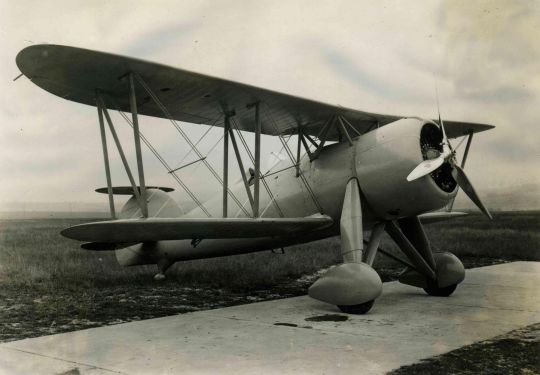
Fieseler’s contender to the interim dive bomber program received the RLM designation Fi 98. The Fi 98 was a sleek, clean, single-seat biplane with an all-metal semimonocoque construction. Powered by a BMW 132 radial engine, the Fi 98 was fitted with two synchronized machineguns and racks for up to four 50kg bombs. Structurally, the only notable feature of the design was the extra horizontal stabilizer, which was a small surface that sat atop the vertical tail without any control surfaces. Unfortunately for Fieseler, the RLM favored Henschel’s competing design from the start. Two prototypes of the Fi 98 were ordered, but only as a backup in the event of the failure of the competing HS 123. The first Fi 98 prototype would fly in early 1935, and the aircraft made it as far as dive testing. However, before the second prototype had been completed, the RLM had already made its decision, so work on the second prototype was halted and testing ceased.
Henschel Hs 123

Henschel would propose a sturdy sesquiplane design that would be contracted by the RLM as the Hs 123. Also a single-seat design powered by a BMW 132 like the competing Fieseler Fi 98, the Hs 123 was considerably more refined, with its wings lacking bracing wires and its landing gear held on single struts. Armament consisted of two synchronized machineguns and a trapeze for a single 250kg bomb or racks for four 50kg bombs. Three prototypes were ordered, the first of which flew in April 1935. The first prototype made use of a clean NACA cowling, but this was later replaced by a tighter-fitting cowling that had fairings over the engine valves. The Hs 123 rapidly outpaced the competing Fi 98, and by the end of the year it was selected for production.
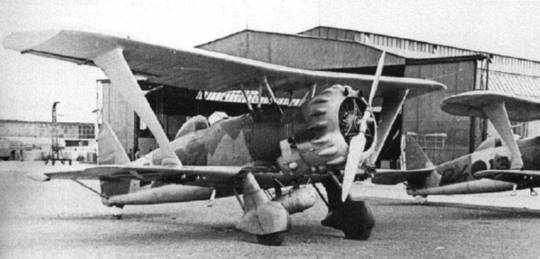
The first Hs 123s entered service with StG 162 in the Fall of 1936. Though service with the Luftwaffe was very brief due to the faster than expected development of the Ju 87, the Hs 123 would manage to be deployed to Spain with the Condor Legion. Five aircraft were deployed soon after it entered service with the Luftwaffe, making their combat debut over Malaga in early 1937. Unfortunately, the Hs 123 proved to be a failure as a dive bomber, being too unstable in dives to make accurate attacks and lacking the range and payload necessary to be effective. It was passed on to ground attack duties, where it began to show its utility. It was found to be able to soak up a good deal of damage and still make it home, all while placing weapons reasonably accurately on the targets. The Hs 123 proved so useful that Spanish would place an order for the aircraft following the war, and the surviving Hs 123s of the Condor Legion would be passed on to the Spanish Air Force.

With lessons learned from Spain, the Hs 123 was shifted away from dive bomber groups. When the Sudetenland crisis began, only one dive bomber squadron still flew the Hs 123, but five new ground attack groups would be formed to fly the aircraft. After the end of the crisis, all but one group was re-equipped with other aircraft, with the last group assigned to Lehrgeschwader 2 as II. (Schl)/LG 2. 39 Hs 123s were flying with this unit when war broke out in 1939. They would prove to be devastatingly effective. Rugged and reliable, the Hs 123 could operate from rough fields close to the front, giving them an excellent sortie rate. Committed to close air support missions, the Hs 123’s roaring engine proved a demoralizing element, and, being able to soak up a considerable amount of damage, the Hs 123 would regain its favor in the eyes of the Luftwaffe. Rather than being phased out, II. (Schl)/LG 2 remained operational into 1940.
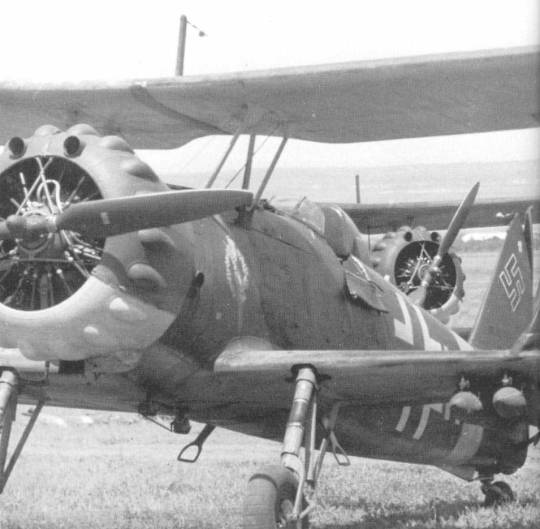
When Fall Gelb began, II. (Schl)/LG 2 was flying with VIII Fliegerkorps as part of Luftflotte 2. Flying directly in support of the Sixth Army, Hs 123s hit enemy positions as the Germans raced through Belgium. However, the focus quickly changed as the spearhead through the Ardennes reached Sedan. On May 13, the Hs 123s were diverted south to support the Wehrmacht’s push across the Meuse at Sedan. Once the breakout was accomplished, they followed the spearheads close behind the front as they raced to the sea. When the French counterattacked at Cambrai, the Hs 123 helped crush them. Through the end of the French campaign, the Hs 123 would closely follow the front, providing vital close air support for German troops.
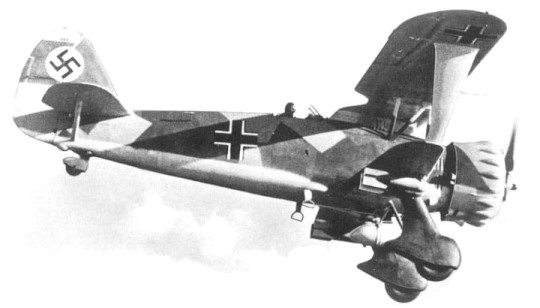
Unfortunately, once the Luftwaffe turned its attention across the Channel, the Hs 123 was found to be too short-ranged to participate. Thus, II. (Schl)/LG 2 was sent back to Germany to reequip with Bf 109E fighter-bombers. The Hs 123 didn’t return to service until March 1941, when one Staffel of the group was equipped to support the invasion of the Balkans. By the time Operation Barbarossa began, 22 Hs 123s were on hand, with 17 serviceable, serving alongside 38 Bf 109E Jabos. Flying in support of Army Group Center, they concentrated their efforts in support of Panzergruppe 3. They were briefly shifted north to support the push on Leningrad in August before shifting their attention back south when Operation Typhoon began. Despite its short range, the Hs 123 continued to prove a vital platform thanks to its robust design and ability to operate so close to the front.

II. (Schl)/LG 2 was withdrawn to Germany at the end of 1941, where it formed the basis of SchlG 1. They were redeployed to Army Group South, flying with the VIII Fliegerkorps in the final operations against Sevastopol before being sent closer to the front to support Fall Blau. While much of the rest of the Luftflotte 2 concentrated its efforts on the spearhead to Stalingrad, the Hs 123s aimed south, supporting efforts to capture the Caucasus oilfields. Unfortunately, attrition was taking hold. At the end of July 1942, just 6 Hs 123s were still serviceable, and, with production having ceased six years prior, replacements were running out. Nevertheless, the Hs 123 remained in use when SchlG 1 was withdrawn in May 1943, and active numbers had rose to 12 aircraft. However, this came at a fairly high cost, with the replacements generally drawn from flight schools. Wolfram von Richthofen, commander of Luftflotte 4, did request production be restarted, but it was decided against because the tooling had already been disposed of. The Hs 123 made it back to the front in time to participate at Kursk before being shifted south to the Crimea. They remained there until mid 1944, when the unit was withdrawn and the Hs 123 finally replaced by Ju 87s.
The Sturzbomber
Parallel to the interim dive bomber program, the RLM initiated a more substantial program - the Sturzbomber. The Sturzbomber was to produce a top-of-the-line dive bomber for the Luftwaffe, with requirements largely written around Junkers’ work with dive bombers dating to the early ‘30s. Nevertheless, the program would see participation from many of Germany’s major aircraft manufacturers. Heinkel, Blohm & Voss, Arado, and Junkers would all submit designs, and all but Blohm & Voss would receive contracts for prototypes. With the requirements written around their proposal, however, Junkers unsurprisingly came out on top with their Ju 87, which would quickly rise to prominence as the Luftwaffe’s primary tactical bomber.
Blohm & Voss Ha 137
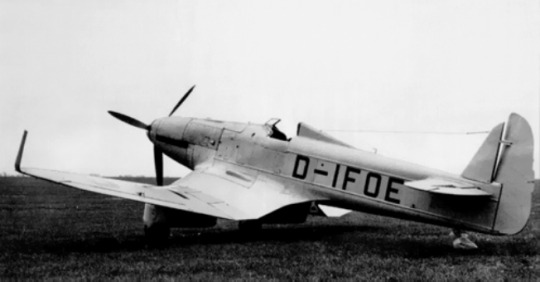
Though Blohm & Voss was not even invited to participate in the competition when specifications were first issued, they opted to produce a design as a private venture. Leveraging off of the experience the company’s top engineer - Dr. Richard Vogt - had gained while working for Kawasaki, the company produced the Ha 137. Effectively a scaled-up version of the Kawasaki Ki-5 fighter, the Ha 137 was an all-metal semimonocoque aircraft. It made use of Vogt’s signature tubular spar, which held a fuel tank in its inboard sections, and an inverted gull wing was used to shorten the length of the fixed, spatted landing gear. The gear spats were designed to allow for a single MG 17 or 20mm MG FF cannon to be mounted in them, and two more machineguns were mounted above the engine. Unlike the other proposals, the Ha 137 had a crew of one. designed around the BMW XV engine, the RLM asked Blohm & Voss to adapt it for the Pratt & Whitney Hornet and Rolls Royce Kestrel. Prototypes were then ordered, with the first Hornet-powered prototype flying in April 1935. While the Ha 137 failed to win the contest, it was still considered for CAS duties along the same lines as the Hs 123. Ultimately, six prototypes were built before the design was abandoned by the RLM. Blohm & Voss tried to continue work on the design with a navalized variant, but this proved impractical, so it too was abandoned. In the end, the Ha 137 prototypes lived out their lives as testbeds for various pieces of equipment.
Junkers Ju 87 Stuka

The infamous dive bomber that would come to be known as the Stuka would have its origins in the company’s K 47 two-seat fighter developed in the late ‘20s. As the design continued testing through the early ‘30s, the K 47 was tested as a dive bomber, validating design elements like the double-spar inverted gull wings and dive brakes that had been developed. When the Sturzbomber program began, the new Junkers dive bomber drew heavily on experience with the K 47. Designated the Ju 87, the new dive bomber was designed around the Rolls Royce Kestrel engine. It shared the characteristic inverted gull wings and fixed, spatted landing gear of the K 47, while the signature Junkers flaps lined the trailing edges of the wings. For dives, advanced dive brakes were fitted under the wings, and a unique automatic pull-out system was devised. This system initiated an automatic recovery from a dive upon the release of the payload, facilitating a safe recovery even in the event that the extreme G-forces experienced temporarily incapacitated the pilot.
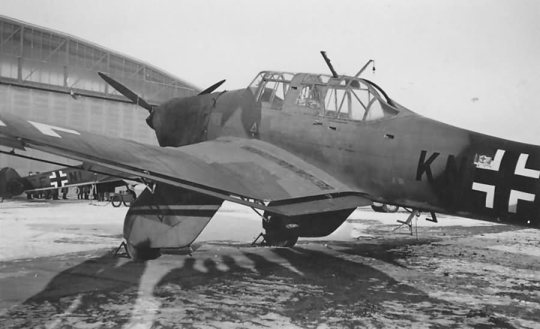
The RLM was hesitant to fly a bomber using British engines, so Junkers reworked the Ju 87, using a DB 600 for the prototype and fitting a Jumo 210 on production aircraft. The first Ju 87 flew in September 1935, with the DB 600-engined prototypes flying early the next year. Though praised for its accuracy and advanced bombing system, it faced resistance among RLM representatives owing to the design’s modest performance. Ultimately, however, it gained support from Ernst Udet, who preferred the superior dive-bombing abilities of the Ju 87 over the higher performance of competing designs. When the most favored competitor - the He 118 - crashed, the Ju 87’s position was secured, and production was ordered. The first early production machines began delivery that same year, and the Luftwaffe immediately began rushing the new Stuka into service.
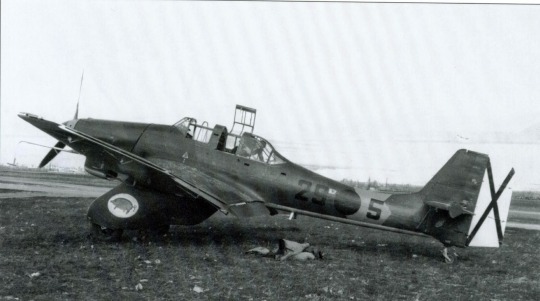
Soon after the Stuka entered service, the aircraft would find itself in combat. In August 1936, a single Stuka was delivered to the Condor Legion in Spain for combat evaluations. It participated in the offensive at Bilbao in 1937, but otherwise the Stuka saw little service until three Ju 87As arrived in early 1938. Teething issues were experienced at first, with the Stuka being incapable of taking off with a full load and experiencing difficulties operating from rough fields. Even so, they were devastatingly effective. Able to deploy their payloads with pinpoint accuracy, the Stuka was able to easily suppress enemy ground forces, and it would demonstrate reasonably good anti-shipping capabilities as well. With the end of the war, the last Stukas returned home, having suffered just a single loss over the course of their deployments.
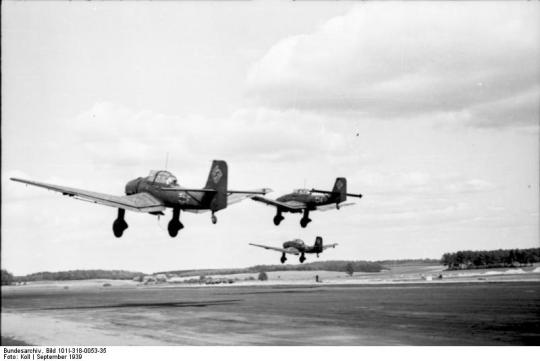
When war broke out in Europe, the Stuka was the backbone of the Luftwaffe's tactical bomber force, with 366 available. Operations began with attacks on demolition charges on bridges on the Vistula, communications centers, and power plants to cripple Polish communications and logistics. Attacks began 11 minutes before the official declaration of hostilities, but they were not followed up fast enough by ground forces, meaning the Poles were still able to destroy many vital bridges. After these opening strikes, the Stuka switched to CAS. A Stuka would claim the first aerial victory of the war when it downed a P.11c fighter taking off, and as German forces raced across Poland, the Stuka became a form of aerial artillery. In the Baltic, Stukas sunk a Polish destroyer, minelayer, torpedo boat, gunboat, and several minesweepers, preventing the Polish Navy from having any impact on the campaign. Meanwhile, the Stuka was devastating Polish forces, coming in to level entrenched and fortified positions where the Poles were not overrun. Over the course of the campaign, Stuka wings dropped 428 tons of bombs while suffering just 31 losses thanks to effective fighter cover.

The Stuka would make its next appearance over Norway, supporting the German invasion of the country in April 1940. After the loss of the cruiser Blucher, Stukas were sortied to suppress the Norwegian coastal fortresses around Oslo. Flying in new variants equipped with drop tanks, the Stukas roamed the theater, taking a heavy toll on enemy shipping. The British and French navies were powerless to fend off the Stukas as they made their attacks, leading to the loss of several ships and heavy damaging of many more. The threat from the Stukas was so great that the Royal Navy soon began steering clear of areas near Stuka airfields. As the seas cleared, the Stukas returned to supporting ground troops, helping them contain Allied landing forces until they were finally withdrawn in June 1940.

When Fall Gelb began, the Stuka was again on the frontlines, opening up with strikes on Belgian fortresses and command centers. These strikes beheaded local command, preventing the destruction of many bridges along the Albert Canal. Meanwhile, Stukas flew in direct support of ground forces, neutralizing countless enemy tanks. As German forces raced through the Netherlands, Stukas began to target Dutch and Royal Navy destroyers providing fire support, sinking and damaging several ships. Further south, at Sedan, Stukas were concentrated to help forced break out. Flying under heavy fighter protection, Stukas flew 300 sorties at Sedan, devastating French positions. In the race to the Channel that followed, the Stuka was invaluable, breaking up enemy forces and halting counterattacks as the Panzer columns raced across the countryside. The Stukas then turned their attention to the Dunkirk pocket, where they targeting the ships evacuating the Allied troops. 89 merchantmen and 29 destroyers were lost as a result of the Stuka attacks. Though Stuka operations were generally going well, the bomber did demonstrate vulnerability if caught by organized resistance. On one occasion, French fighters downed 11 of 12 Stukas in a formation caught without escort, and, by the time the French campaign ended on June 25, 120 Stukas - a third of the fleet - had been damaged or destroyed.

Once the Luftwaffe turned its attention across the Channel, the Stuka was among the first aircraft to begin operations. Aiming at disrupting British shipping in the Channel, Stukas took a heavy toll the convoys they targeted. With the RAF unable to effectively protect the convoys, the Stukas managed to close the Channel to shipping. In the opening stages of the Battle of Britain, the Stuka performed reasonably well, devastating targets when they managed to steer clear of RAF fighters. However, such unopposed raids were becoming increasingly rare. Unable to guarantee air superiority, the Luftwaffe’s Stukas suffered heavily in the face of RAF fighters. Slow and poorly armed, they were helpless when caught without escort. At the end of August, they were mostly withdrawn from attacks on Britain, though the occasional raids against shipping and airfields close to the coast still occurred.
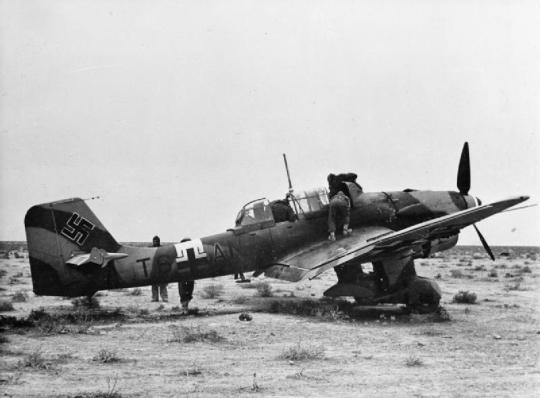
After Italy got itself embroiled in Greece and North Africa, the Stukas of StG 3 were deployed to Sicily in late 1940. Initial operations concentrated on shutting down British shipping in the Mediterranean. In early 1941, they succeeded in heavily damaging the carrier Illustrious, eventually turning their focus to Malta, where they bombarded the island alongside Stukas flying with the Regia Aeronautica. StG 1, 2, and 77 would be committed to the invasion of Yugoslavia in early 1941, following the campaign as it moved south to Greece. With little enemy air opposition, the Stuka continued to reign supreme. During the battle for Crete, Stukas successfully suppressed the Royal Navy’s task force in the region, allowing reinforcements to be ferried into Crete. Stukas also participated in North Africa with the Afrika Korps. Proving invaluable at first, their effectiveness rapidly declined as the Luftwaffe lost air superiority. By the time Operation Torch began, the Stukas were completely unable to conduct operations. They continued to fly with some effect further north in the Italian campaign that followed, but there too they gradually lost effectiveness. By the end of 1943, the Stuka was unable to complete its missions in the Mediterranean.
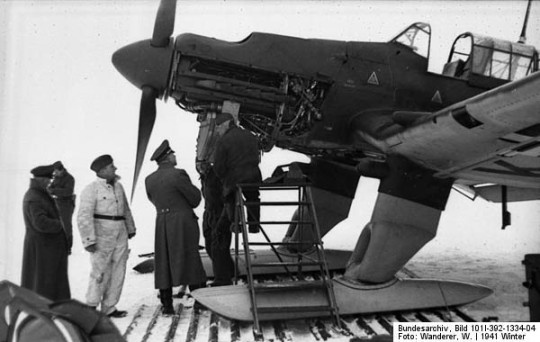
On June 22, 1941, five Geschwader of Stukas were on hand on the Eastern Front. Taking part in the opening strikes, the Stuka’s impact was devastating. The bombers hit everything from airfields to fortresses to logistics and communications lines, crippling enemy forces. Counterattacks were swiftly met by Stukas, and fleeing forces were often halted in their tracks as Stukas destroyed strategic bridges. Near Leningrad, Hans-Ulrich Rudel of StG 2 would sink the Soviet battleship Marat, while other Stukas crippled the battleship Oktyabrskaya Revolutsiya. The only problem with the Stukas was their numbers - as the Army Groups spread out, there were too few Stukas to meet needs for all ground forces across the front. Medium bombers were called in to fill the gap, but they would suffer heavy losses compared to the Stuka. When the Soviets launched the General Offensive in late 1941, Stukas scrambled to contain the attack, inflicting great losses but failing to prevent friendly forces from being pushed back. Nevertheless, by the time Barbarossa had come to an end, the Stuka had proven to be possibly the most effective weapon in the Luftwaffe arsenal. It did not come without loss, however - 157 Stukas were lost to the end of 1941.
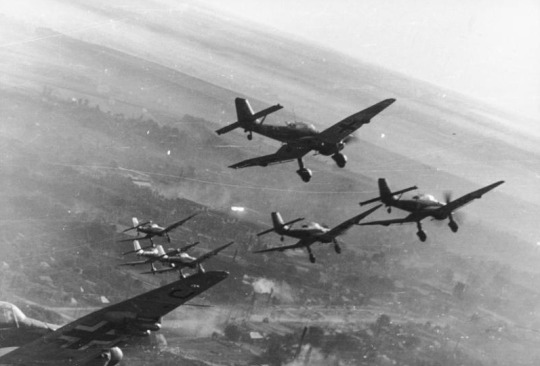
When the Wehrmacht turned its attention South, the Stuka was again called into action. Operations in early 1942 started off with ending the campaign in the Crimea. Starting off at Kerch, Stukas cleared the sea lanes, though the newest Soviet tanks were proving more durable in the face of Stuka attacks. At Sevastopol, StG 77 would fly 7,708 sorties, dropping 3,537 tonnes of bombs against the defenses until the city surrendered. After the Crimean campaign wrapped up, the Stukas were diverted east to participate in Fall Blau. As the Wehrmacht approached Stalingrad, Stukas began to level the city, pushing back Soviet forces until they held just a small strip of land on the west bank of the Volga. Stukas also concentrated efforts on the shipping ferrying men and supplies across the Volga, inflicting heavy losses. Stukas were averaging about 500 sorties a day for the loss of one aircraft a day, with great effect. However, when the Soviets launched Operation Uranus, the Stukas were unable to stop the encirclement of the 6th Army. Though the Luftwaffe tried hard to protect the encircled troops, the VVS maintained a constant presence around the pocket, preventing the Stuka from making any meaningful contribution.

As Army Group South found its forces split across the Sea of Azov, the Stuka remained an invaluable asset. In the Kuban, Stukas were flying nearly nonstop to reduce the Soviet positions on Mount Myskhako southwest of Novorossiysk. There, the new Ju 87G variant would make its combat debut, flying over Krymskaya alongside other cannon-armed aircraft to halt the Soviet offensive. The Ju 87G stood out among the Stuka variants, featuring prominent 37mm autocannon slung under either wing and heavy armor to protect it. Also making an appearance at Kursk, the Ju 87G had mixed results. Though it packed enough firepower to destroy Soviet tanks, it was even more vulnerable than earlier Stukas, being weighed down by all the new equipment. When the Soviets launched their counterattack at Kursk, concentrated application of Ju 87Gs managed to slow the Soviet columns enough that German forces could escape the Orel salient. However, it came at great cost. StG 77 lost 24 Stukas in July 1943, while StG 2 lost another 30. As air superiority became a thing of the past, three Sturzkampfgeschwader were re-equipped with fighter-bomber Fw 190 variants and converted to Schlachtgeschwader.
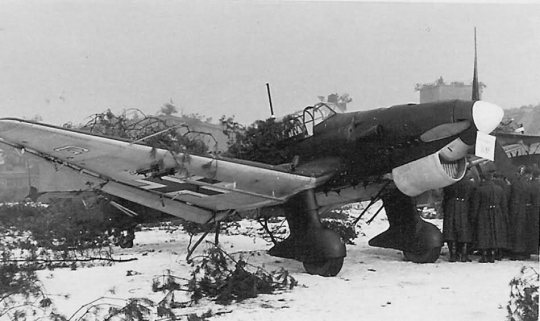
As 1943 turned to 1944, the Stuka stopped being a relevant force over the battlefield. They continued to target Black Sea shipping for some time, but on the front, the Stuka was gradually superseded by Fw 190 fighter bombers. When Operation Bagration kicked off the Soviet 1944 summer offensive, just 12 full Gruppe and five mixed Gruppe were flying the Stuka across all of Europe, and by the start of 1945, just 104 Stukas remained in the Luftwaffe inventory. By then, chronic fuel shortages accomplished what Allied fighters had failed. Stukas rarely if ever still sortied, instead saving ever more scarce fuel for the more capable fighters and fighter bombers struggling to defend the Reich. The final notable use of the Stuka came in the last months of the war, after the 1st Belorussian Front outran its air support during the Vistula-Oder Offensive. For the first time in years, Stukas operated without threat of enemy fighters, making one final devastating attack on the Red Army and halting their attack short of Berlin. However, though the concentration of air power had saved Berlin for the time being, it would not last forever. The effort used up the last German fuel reserves, so, once the Soviet position had been consolidated and the offensive on Berlin resumed, the Luftwaffe was only able to sortie the odd fighter to resist.
Arado Ar 81

Arado would submit the only biplane design to the Sturzbomber competition, receiving the RLM designation Ar 81. Designed around a Junkers Jumo 210C engine, the Ar 81 was a small, slender design with fairly short wings and an all-metal construction. As originally conceived, it mounted double tail to give the gunner a clear field of fire. The crew of two sat in a spacious cabin, with the rear left open to allow the gunner a clear field of fire. Landing gear was fixed and spatted, and a crutch for a single 250kg of 500kg bomb was installed under the fuselage. Taking flight at the end of 1935, the Ar 81 revealed serious stability issues owing to the design of the tail. The second prototype included some minor changes to fix this, but the issues weren’t fully resolved until the third prototype was given a single conventional tail. Testing otherwise seems to have gone reasonably well, with the Ar 81 reportedly being the only contending design capable of deploying a 500kg bomb in a vertical dive. The final prototype also outperformed the Stuka in several ways, including top speed, maneuverability, range, and climb rate. However, the Stuka was found to have more room for evolutionary improvement, so the Ar 81 was not selected for production.
Heinkel He 118
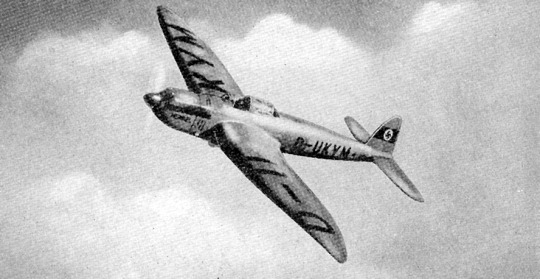
Heinkel would derive their contender from their famous He 70. Making use of the He 70’s signature elliptical wing and rounded tail surfaces, the He 118 introduced a slight inverted gull wing to shorten the length of the retractable landing gear. Powered by a DB 600C engine, the He 118 was considerably more aerodynamically refined than Junkers’ Ju 87. Apart from its use of the efficient elliptical wing and retractable landing gear, the He 118 was far more streamlined, and it made use of an internal bomb bay. Armed with two forward firing machineguns and a single defensive gun, it could carry up to 500kg of bombs. Unfortunately, when testing began in late 1935, the He 118 revealed several failings. It was found to be incapable of making dive attacks steeper than 50 degrees, and, in June 1936, the first prototype disintegrated in a high-speed dive test. Because of the very limited dive angle (the Stuka could make a full 90 degree dive), the He 118 would not be selected for production.
The Ural Bomber
In 1933, General Walther Wever spearheaded efforts to create a long-range strategic bomber to complement the tactical bombers being developed for the Luftwaffe. Recognizing that in a future war, the Soviets would likely move their industry east of the Urals - far beyond the reach of any medium bomber - Wever initiated the Ural Bomber program. The Ural Bomber was to be a long-ranged heavy bomber capable of striking Soviet factories deep behind the front lines, allowing the Luftwaffe to operate on a strategic level. Wever contacted Dornier and Junkers to develop designs, resulting in the Do 19 and Ju 89. Unfortunately, though the program went smoothly, the Ural Bomber had little support from Luftwaffe officials other than Wever. When Wever was killed in an air accident, his replacement, Albert Kesselring, cancelled the entire program to free up resources for more tactical bombers.
Dornier Do 19
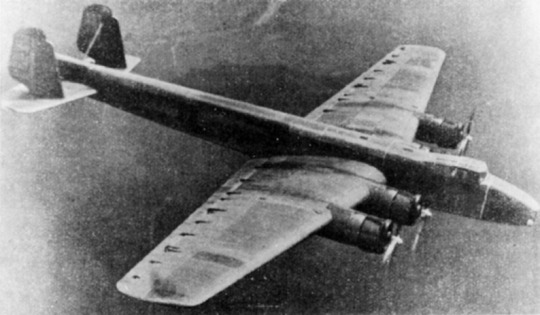
Dornier’s Ural Bomber, the Do 19, would be the first competitor to fly. The Do 19 was a mid-winged cantilever monoplane of mixed construction. Fitted with a long rectangular fuselage and a twin-tail, the bomber was to be powered by four Bramo 322 radial engines in the wings. Owing to the long ranges the bomber was expected to operate at, the Do 19 had a crew of ten, half of which were dedicated gunners. Single machineguns were placed in the nose and tail, while 20mm cannon were placed in dorsal and ventral turrets. Payload was to be up to sixteen 100kg bombs carried in an internal bay. The Do 19 took flight in October 1936, several months after General Wever had died in a plane crash. Because of difficulties getting the Bramo 322 engines, the Do 19 flew instead with BMW 132s. Unfortunately, Wever’s successor saw little utility in the strategic bomber, and, with its modest range, poor performance, and small payload, the Do 19 did little to redeem itself. Kesselring ordered the second and third prototypes scrapped, and, in 1938, the sole surviving Do 19 was relegated to transport duties.
Junkers Ju 89

Junkers would produce a somewhat larger design for the Ural Bomber competition - the Ju 89. The Ju 89 was another four-engined monoplane design, carrying a similar payload and identical armament to the Do 19, but with major design differences. The Ju 89 carried half the crew of the Do 19, and despite having a lower power-to-mass ratio, the bomber was almost 50mph faster than its competitor. The first Ju 89 took flight in April 1937, but less than three weeks after testing began, the Ural Bomber was cancelled by the RLM. However, the Ju 89’s considerably better performance compared to the Do 19 meant that Junkers would be allowed to finish the second prototype, which flew in July 1937. The two prototypes were used to gain experience with controls for large aircraft. In 1938, they set several payload-to-altitude records, and by the end of the year, they were passed onto the Luftwaffe for use as transports. Unfortunately, they lasted less than a year in this role, with both Ju 89s scrapped in late 1939.
The Schnellbomber
In 1935, the RLM issued specifications for a new high-performance tactical bomber. Known as the Schnellbomber (fast bomber), the requirements generally followed the trend of previous bomber projects, calling for a medium bomber that would rely primarily on its performance rather than defensive armament for protection. The bomber was to have the ability to fly at 500km/hr for 30 minutes, takeoff roll of 750m, at least one defensive gun, and a payload of 500 to 800kg of bombs. Junkers, Focke Wulf, Messerschmitt, and Henschel all submitted designs, though Focke Wulf would drop out without producing a prototype. Messerschmitt would also drop the program later, owing to the high demand for their fighters, and ultimately, Junkers would be selected the winner with their Ju 88.
Junkers Ju 88

Junkers’ Schnellbomber would originally be a simple twin-tailed design contracted as the Ju 85. Contracted for prototypes in June 1936, the Ju 85 went beyond several of the requirements, with three defensive guns installed and payload capacity designed to be 2,000kg. Being redesignated Ju 88 before it finally flew in December 1936, the new bomber did away with the twin tails in favor of a single large conventional tail. The Ju 88 took shape as a sleek, modern bomber. It carried a crew of three concentrated in the nose, with two bomb bays placed behind the crew compartment. The Ju 88 was a promising aircraft, ultimately winning the Schnellbomber contract thanks to its superior payload. However, after the contract was won, RLM leadership requested the Ju 88 take on medium-angle dive-bombing as part of its role. Junkers had to radically rework the bomber, strengthening the wings, expanding the crew to four, and adding dive brakes. The changes cut performance, but the Ju 88 was now a reasonably capable dive bomber. However, it did seriously delay production, pushing back the planned service entry date from 1938 to just before the outbreak of war.
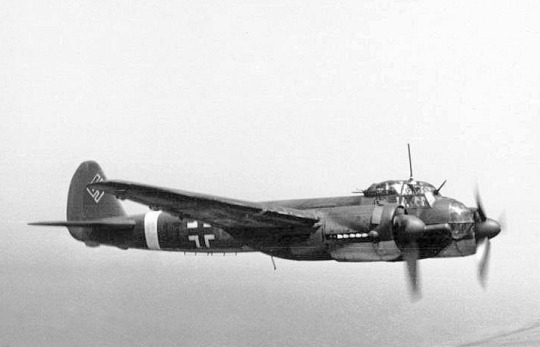
By the time war broke out in September 1939, just 12 Ju 88s were operational. They served through the campaign with operational evaluation units, but saw no significant use. The Ju 88’s first real combat came over Norway, where KG 30 flew the Ju 88 to attack Allied shipping. There, they managed to damage the battleship Rodney in concert with He 111s. The Ju 88 force had massively expanded by the time Fall Gelb began, with all but one Fliegerkorps flying Ju 88s. They participated in the opening strikes of the campaign, destroying nearly 250 Allied aircraft on the ground and shattering the ability of the Dutch Air Force to resist the invasion. Dive bombing attacks were particularly effective, allowing the bombers to make precision attacks on French logistics and even provide direct air support on occasion. However, direct support of ground troops proved costly. Losses to enemy fire and accidents were high, forcing the Ju 88 fleet to be withdrawn for the time being to retrain crews. As crews were retrained, Junkers went to work at refining the aircraft, increasing the wingspan and revising the planform to make it easier to fly.
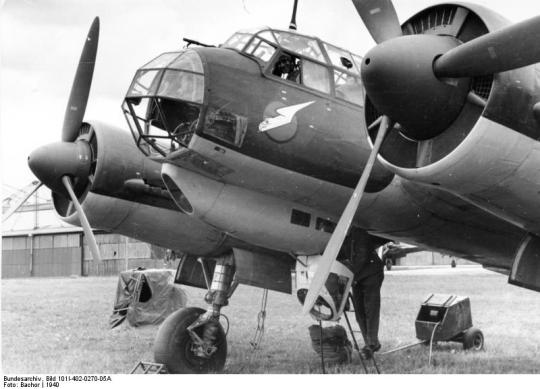
The newly revised Ju 88 returned to operational units in mid 1940, just in time to take part in the Battle of Britain. Unfortunately, the newly revised design did little to keep losses down. Though faster than the He 111, the Ju 88 suffered more heavily than any other bomber committed, despite being present in the smallest numbers. It was unable to fend off RAF fighters, even after field modifications improved defensive armament, and the bomber remained a tricky aircraft to fly, particularly for crews that had recently converted from He 111s. It would only be in the final days of the Battle of Britain that the definitive Ju 88 variant - the A-4 - would come into service. Though performance slightly dropped, the A-4 finally solved the teething issues of the Ju 88, lowering its accident rate. Nevertheless, losses in the Battle of Britain were painfully high - 303 Ju 88s were lost between July and October 1940.
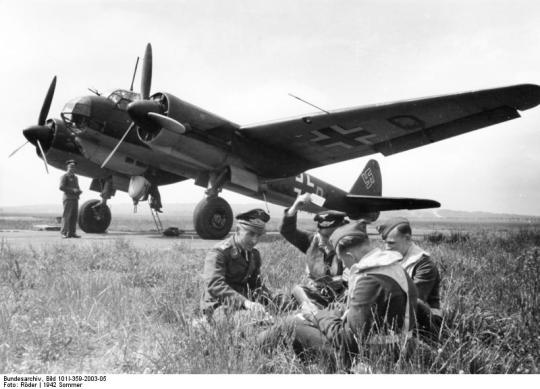
With the teething issues mostly gone, the Ju 88 began replacing the Do 17 in operational units. By the time Operation Barbarossa began, most Do 17 units were in the process of converting to the Ju 88. When the war in Russia began, Ju 88s were on the forefront. They opened the war with massive strikes on Soviet airfields, inflicting enormous amounts of damage upon the VVS. With shortages of Stukas, the Ju 88 was also pressed into service in direct air support roles with mixed results. The Ju 88 was undoubtedly effective when providing close air support, but such attacks often led to heavy losses from ground fire. Though the Luftwaffe had secured air supremacy, the Ju 88 remained vulnerable to enemy fighters when caught without escort. Nevertheless, they followed the campaign across Russia, replacing the Do 17 and providing a more capable counterpart to the He 111.
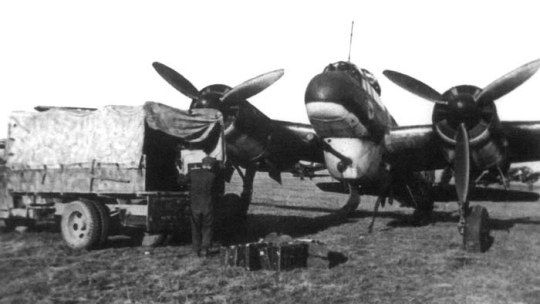
Like the He 111, the Ju 88 gradually began to take on specialist roles. Dedicated torpedo bombing variants were developed, which removed the ventral gondola to allow a torpedo to be carried under the fuselage. These operated in the Mediterranean, Black Sea, and out of Norway, targeting Allied shipping in the area with reasonable success. Thanks to the relatively good agility and performance of the Ju 88, the bomber also took on more aggressive roles. The P-series Ju 88 would carry a variety of heavy cannons for anti-tank duties, making its debut over Krymskaya in the Kuban in 1943. Over the Reich, night fighter variants were also produced to fend off the RAF’s bombers.
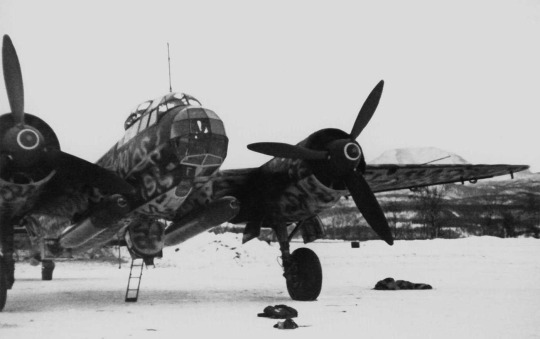
Unfortunately, the Ju 88’s success would not last. Like other Luftwaffe bombers, its success depended on friendly air superiority, and, as the Allies began to take control of the skies, Ju 88 began to drop in effectiveness. Though it was never really replaced, it became an ever-rarer sight over the front in the last two years of the war, with Allied air superiority forcing the Luftwaffe to instead rely on fighter-bombers. Production continued to to the end of the war, but, as the war got increasingly desperate, production increasingly focused on night-fighter variants. By the end of the war, fuel shortages had mostly grounded the Ju 88 fleet.
Messerschmitt Bf 162
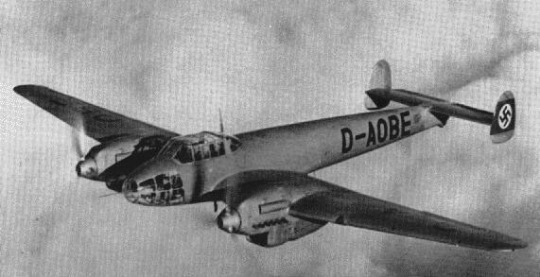
Messerschmitt’s Schnellbomber contender was derived from the Bf 110 heavy fighter. The Bf 162 was given a bombardier in a glazed position in the nose, replacing the heavy forward armament of the fighter, and an internal bomb bay for up to ten 50kg bombs was installed. For defense, just a single machinegun was provided behind the cockpit, just as in the Bf 110. The Bf 162 flew for the first time in February 1937. Flying off against the Ju 88 and Hs 127, it failed to win a production order. However, though development was officially terminated, the design was publicized as a disinformation tactic as the Messerschmitt Jaguar.
Henschel Hs 127
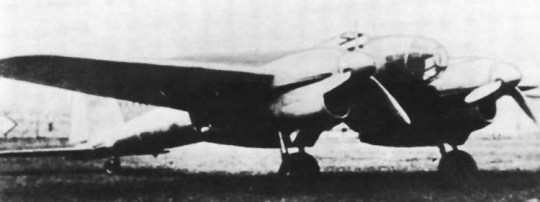
Henschel would produce a compact all-new design for their Schnellbomber, which was contracted as the Hs 127. Also carrying a crew of three, the Hs 127 had the crew of three concentrated in the nose. A DB 600 engine was slung under the low-mounted wings, and an internal bomb bay was installed to provide space for 1,500kg of bombs. Taking flight in late 1937, the Hs 127 was the last of the Schnellbomber designs to fly. Competing against the Bf 162 and Ju 88, it demonstrated the best performance of all competitors, but ultimately it was not selected as the winning design. Instead, the RLM went with the Ju 88, which offered a substantially better payload capacity.
Heinkel He 119
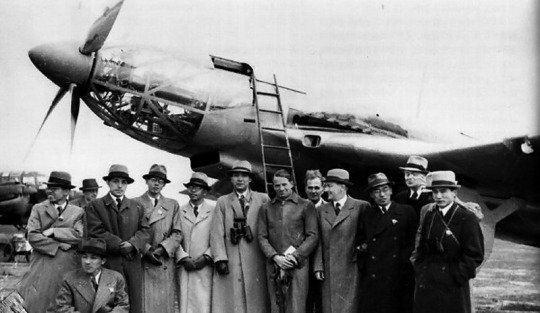
While the Schnellbomber competition was ongoing, Heinkel started its own in-house project to develop a high-performance reconnaissance bomber. Effectively marking the ultimate development of the design elements pioneered in the He 70, the He 119 was to be powered by two DB 601s paired together as the DB 606. This engine was buried deep in the fuselage, extending out to the nose via a long shaft. To keep minimize drag, the cockpit was placed in the extreme nose, with the crew sitting in heavily glazed positions on either side of the driveshaft. To minimize drag, the He 119 was to rely on evaporative cooling, though this proved inadequate, forcing Heinkel to hastily add a radiator to the prototype. The He 119 took flight for the first time in July 1937, proving just as fast as Heinkel had hoped.

Though the performance of the He 119 was spectacular, the RLM had little interest in an unarmed aircraft, so the aircraft was hastily modified with stowable machineguns in dorsal and ventral mounts. The second prototype, flying in late 1937, introduced a semi-retractable radiator and weapons bay, though it still lacked armament. A third and fourth prototype flew soon after. The third, designed as a seaplane, was pitched as a maritime reconnaissance platform, while the fourth would be a conventional landplane that would go on to set a world speed record (under the alias He 111U). Unfortunately, though the He 119 demonstrated incredible performance, and Heinkel went as far as building two pre-production prototypes for a bomber, variant, the RLM had little interest in the design. With no hopes of domestic success, Heinkel sold the seventh and eighth prototypes to Japan in May 1940. The remaining prototypes were retained as engine testbeds, while the fourth was lost in a crash during testing.
Dornier Do 215

The impressive performance of Dornier’s Do 17 would attract interest from foreign air forces, spurring Dornier to develop an export variant. Given the RLM designation Do 215, the first prototypes were merely Do 17Zs fitted with various different powerplants. First flying in 1938, the DB 601-powered third prototype would attract the attention of foreign customers. Sweden ordered 18, allowing production lines to start, while Yugoslavia and the Netherlands also placed tentative orders. However, with tensions heating up in mid-1939, the orders were taken over by the Luftwaffe, who pressed the bomber into service alongside the Do 17. Further production was also ordered, with a total of 105 Do 215s built until production halted in 1941. The small numbers of Do 215s in service generally operated in the same roles as the Do 17s they were derived from, quickly shifting to reconnaissance after their payload proved inadequate for bombing. After being withdrawn from bomber roles, many were converted to night fighters, serving in this capacity until 1944.
Dornier Do 217
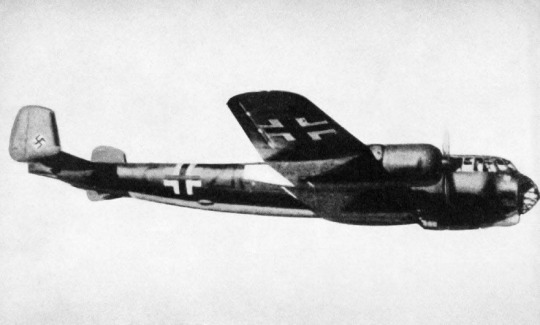
In early 1938, Dornier was issued specifications for a new twin-engined bomber and reconnaissance aircraft powered by the DB 601. Dornier selected the Do 17M as a base for their new bomber, incorporating the new cockpit of the Do 17Z and expanding the fuselage to carry a payload of two 500kg and ten 50kg bombs. Envisioned with dive-bombing in mind, the Do 217 would mount dive brakes and slightly enlarged wings. Interest in creating a naval air arm led to Dornier spending several months optimizing the design for maritime strike, but in early 1938, the naval dive-bomber concept was dropped due to poor performance projections. Ultimately, the Do 217 emerged in October 1938 as a scaled-up Do 215. Development was problematic, with the original prototypes falling well short of expectations and only proving satisfactory after new engines were mounted. Only in July 1939 was production approved, with the Do 217 slated to perform 50-degree dive bombing, conventional level bombing, and attacks on land and naval targets with glide bombs.

The Do 217 began production in early 1940, with the first examples reaching service by the end of the year. II./KG 40 was the first unit to receive the bomber in March 1941, starting minelaying and anti-shipping operations in the North Sea. In the East, the first Do 217s deployed were used for high-altitude reconnaissance missions over Russia in preparation for Operation Barbarossa. KG 40 and KG 2 - the two Kampfgeschwader flying the Do 217 in Western Europe - would deploy their bombers on the endemic raids against Britain, suffering fairly high losses. Nevertheless, missions continued at a sporadic pace until 1944, with losses remaining high. In 1943, the Do 217 made its debut as a precision strike platform when II./KG 100 attacked Royal Navy ships in the Bay of Biscay with Hs 293 guided missiles and Fritz-X guided bombs. Though the attacks only managed to sink a single sloop and heavily damage a destroyer, it forced the Royal Navy to withdraw its ships from the Bay of Biscay until II./KG 100 was diverted to Italy. The last actions of the Do 217 in Western Europe came in the aftermath of the invasion of Normandy. The two Gruppen still flying the bomber - II./KG 2 and III./KG 100 - were thrown at the landings with predictably poor results. After suffering heavy losses, the Do 217 made one final raid in late July 1944, striking bridges on the See and Selune rivers with Hs 293 missiles. While the attacks led to the loss of most surviving Do 217s, they failed to put any of the bridges out of action.
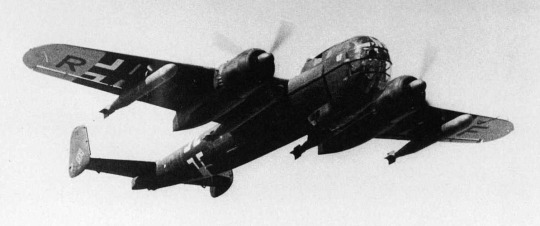
The first Do 217s to appear over the Mediterranean were actually J-series night fighters, arriving in September 1942. Do 217 bombers wouldn’t make it to the theater until 1943, when a Gruppe was shifted south to counter the landings at Salerno. Following the 1943 Armistice, III./KG 100 was used to make precision attacks on the Italian fleet sailing to surrender at Malta. Making attacks with Fritz-X guided bombs, the bombers succeeded in sinking the battleship Roma and heavily damaging Italia. Operating against Allied shipping, they also succeeded in damaging the cruisers USS Savannah and HMS Uganda, as well as the battleship Warspite with Fritz-X attacks. Though these precision attacks were surprisingly effective at first, the Allies quickly adapted, developing radio jamming measures and deploying better fighter cover to counter the guided bombs. Their last major action came in response to the Anzio landings in early 1944, where Allied air supremacy and jamming limited their effectiveness. Nevertheless, attacks with Hs 293 missiles succeeded in sinking a cruiser, several destroyers, and multiple merchant ships.
Henschel Hs 130C
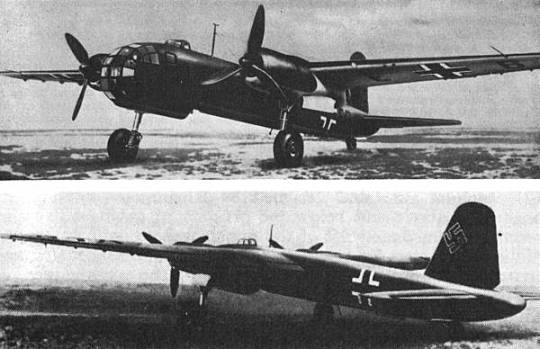
In the late ‘30s, Henschel began work on a new experimental high-altitude aircraft design. First flying as the Hs 128 in April 1939, the project started out as a research endeavor, examining the use of pressurized cabins, superchargers, and new wing designs. Though the Hs 128s were failures, they attracted the attention of the RLM, who requested a militarized development under the designation Hs 130. The Hs 130 was originally conceived as a reconnaissance platform. Retaining the same slender design of the Hs 128, the Hs 130 would add retractable landing gear and a camera bay to the design. In parallel, Henschel proposed a variant replacing the camera bay with a bomb bay, though no production was ordered. An even more ambitious variant was tendered when the RLM issued the Bomber B requirements. Designated Hs 130C, the Bomber B contender featured a shorter wingspan, remotely-controlled armament, a bomb bay for 4,000 kg of stores, and a more extensively glazed cabin. Powered by two DB 603A engines, it apparently gained little interest from the RLM, so Henschel reworked it into the reconnaissance-oriented Hs 130D. Developments culminated in the Hs 130E, which was capable of reaching over 40,000ft when testing began in 1942. At first, it seemed promising - the RLM palcced a pre-production order, followed by a full order for 100 machines. However, the complicated supercharger system integral to the Hs 130’s performance was proving too problematic, so, before any aircraft could be delivered, the Hs 130 order was cancelled.
Heinkel He 177
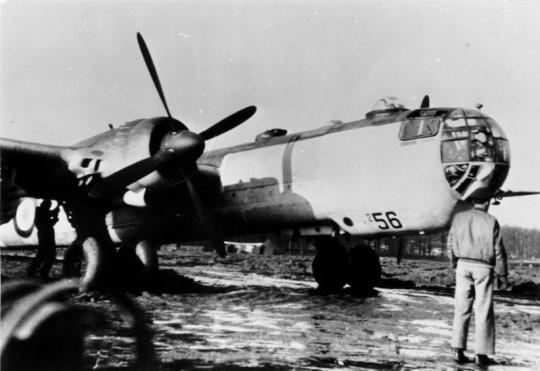
In June 1936, the RLM issued the Bomber A specifications, calling for a bomber capable of carrying a payload of 1,000kg over 5,000km with a top speed of at least 500km/hr. Heinkel responded to the ambitious requirements with what would be contracted as the He 177. Unfortunately, the very day the RLM approved production of prototypes, they added onto the requirements that the He 177 needed to be able to dive bomb. With the already ambitious requirements now taking on a new aspect, Heinkel was forced to resort to radical new features. To meet performance requirements, the He 177 would need at least two powerplants with around 2,000hp. While a four-engined layout was examined, the addition of dive bombing meant that Heinkel would instead have to work with two propellers. Thus, Heinkel selected the DB 606 engine - effectively paired DB 601 engines - driving contra-rotating propellers.
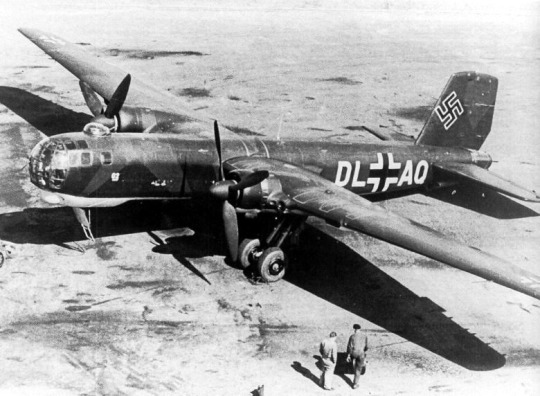
With the powerplant settled, Heinkel incorporated other means to keep drag down. The He 177 was to make use of surface evaporative cooling, eliminating the need for a conventional radiator. However, this was found to be inadequate, so Heinkel was forced to redesign the engine nacelles to accommodate an annular radiator. Defensive armament was light, with guns fitted in two remote-controlled positions and a highly-streamlined tail mount. Owing to the requirements, the He 177 was also stressed for dive-bombing, massively increasing the empty weight of the aircraft. The first He 177 took flight in November 1939, ending early due to engine overheating. Engine problems would plague testing, with fires being a frequent issue. Nevertheless, the unreliable DB 606 was used on the pre-production machines that finally made it into operational trials in 1942.
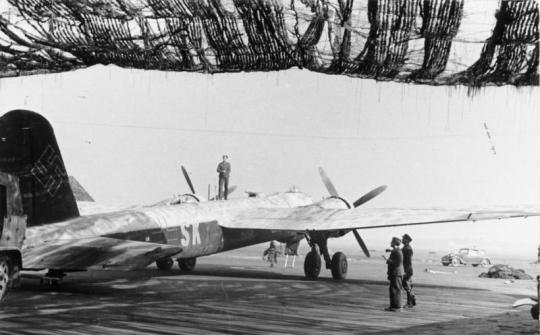
Though the He 177 nominally entered service in 1942, it would be some time before it would see combat. Operational trials revealed continuing engine troubles and inadequate airframe strength. Their combat debut came at the end of the year, with the bombers hastily converted to serve as transports for the Stalingrad airlift. However, they could carry little more cargo than the He 111, so they were soon repurposed for flak-suppression missions. Only 13 missions were flown, during which 7 He 177s were lost to engine fires. Fortunately, by the end of 1942, changes in design were finally starting to show promise. The RLM had relented with the dive-bombing requirements, meaning poor structural strength was no longer an issue, and the new DB 610 engine (paired DB 605s) was selected to power newer production machines.

He 177 operations only really began in 1944 owing to the time it took to re-engine the fleet. Early missions in Operation Steinbock seemed to confirm that the He 177 was a failed design, but the Luftwaffe quickly adapted a unique mission profile. By approaching the target from high altitudes in a shallow dive, the He 177 could reach speeds of up to 700 km/hr as it withdrew, keeping it safe from enemy fighters. Thus, despite high losses at the start of the campaign, the He 177 emerged from Operation Steinbock with one of the lowest loss rates of all bombers committed - 10% compared to the average 60%. Over the Eastern Front, operations could be more relaxed, as the He 177 could fly well above the standard operating altitudes of Soviet fighters. As such, losses on the Eastern Front were relatively light. Unfortunately, as the Allied bombing campaign intensified, the Luftwaffe was forced to ground the He 177. Fuel shortages were only made worse by bombing raids concentrating on fuel production facilities, and, with the complex and fuel-hungry engines of the He 177, the Luftwaffe often gave priority to the more economical bombers in the rare event that there was enough fuel.
Junkers Ju 188

Before the Ju 88 had even entered service, Junkers began work on a variant of the design with a completely revised nose and stepless canopy. Working under the designation Ju 88B, the new design made use of a large new greenhouse canopy that faired into the ventral gondola, offering lowered drag and better visibility. Though the Ju 88B was seen as too radical at first, by the time the RLM began the Bomber B program, interest in the variant peaked. Junkers’ Ju 288 being developed in parallel was leading the Bomber B competition, but delays in developing the engines integral to the program meant that the Luftwaffe was in search of a stopgap. Junkers offered their Ju 88B, and the RLM ordered a prototype. As conceived, the Ju 88B was simply a Ju 88 with a heavily redesigned nose and new Jumo 213 engines. As per RLM requirements, the bomber was also to be able to accept the BMW 801 power egg. The first prototype, modified from a Ju 88A-1, flew for the first time with the BMW engines in early 1940.
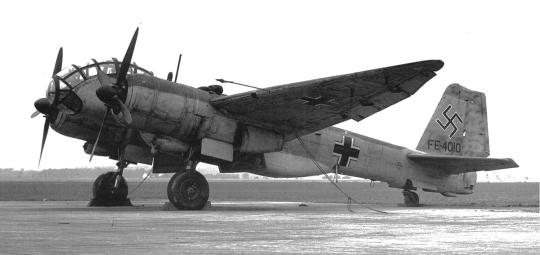
Testing of this first prototype went well, with the biggest issue being that the bomber actually had too small a bomb bay to make use of the extra power. 10 pre-production Ju 88B were built that summer, derived from Ju 88A-4s with their larger wings, but the outer wing sections were given a pointed tip, lowering drag further. Unfortunately, despite excellent reports from test pilots, the RLM remained unconvinced, and thus pre-production models were configured for reconnaissance. It wouldn’t be until 1942, when it was now painfully clear that the Bomber B was not going to be ready anytime soon, that the RLM regained interest in the bomber. Now designated Ju 188, Junkers produced several more prototypes with further refinements, and in October 1942, the Ju 188 was finally ordered into production. Deliveries began in early 1943, and, in August, the Ju 188 made its first operational sorties when three Ju 188E-1s attacked Britain.
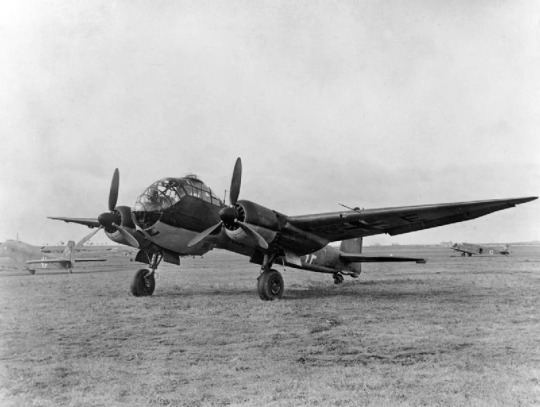
Unfortunately, continuing problems with the Jumo 213 slowed deliveries, ultimately leading to the abandonment of the engine altogether in favor of the BMW 801 power egg. Slow deliveries meant that the Ju 188 didn’t fully equip its first unit - I./KG 6 - until October 1943. The performance gains offered by the Ju 188 were modest, and, with no extra bomb bay space, taking advantage of the expanded payload capacity of the bomber meant sacrificing performance to the point that it was no better than any other bomber in service. Unladen, however, it was still an impressive machine, so the focus of much of production was on reconnaissance variants. Some half of the over 1,000 produced were reconnaissance aircraft. In fact, ten reconnaissance units would fly the Ju 188, while its use as a bomber was limited to KG 2 ad KG 6, as well as several Gruppe of KG 26 and KG 66. Most Ju 188s were rolled out in 1944, right as fuel shortages were starting to hit and Allied air superiority was starting to take hold. Thus, many Ju 188s lived out their lives grounded, and those that were able to fly often were unable to complete their missions.
Junkers Ju 187

With early operations in the Battle of Britain demonstrating the glaring vulnerability of the Ju 87, Junkers began work on a successor under the RLM designation Ju 187. The Ju 187 vaguely resembled the Stuka, retaining its characteristic inverted gull wing and its same general layout. However, it made use of retractable landing gear and a more powerful Jumo 213A engine, intended to reduce drag while providing more power. Because the tandem cockpit was pressurised, defensive armament was placed in a remote-controlled dorsal turret. To provide a clear field of fire for the turret, the Ju 187 incorporated a unique moving vertical tail, which could actuate to move below the fuselage, providing a clear field of fire for the gunner. Payload capacity was identical to the Stuka, with design load being a single 500kg bomb under the fuselage and two 50kg bombs under either wing. The Ju 187 got as far as a full-sized mockup, but it was ultimately abandoned in 1943 after projections showed it offered little over the newest variants of the Stuka. Worse, with air superiority slowly fading and Fw 190s taking over the Stuka’s role, the Ju 187 couldn’t hope to compete over the battlefield.
Bomber B
As Heinkel’s work with the He 177 seemed to validate the idea of a high-performance twin-engined bomber mounting a new class of high-powered engines, the RLM issued new specifications in 1939 for what would be known as the Bomber B. The Bomber B specifications called for a top speed of 600 km/hr and the ability to carry a payload of 4,000kg to anywhere in Britain from bases in France or Norway. Armament was to be remotely controlled, as the crew were to be in a pressurized cabin to allow the Bomber B to operate at higher altitudes. Because of the projected massive leap in performance that the Bomber B would offer over the existing inventory, it was projected that the Bomber B would come to replace the entire Luftwaffe bomber inventory. Unfortunately, the Bomber B was a massive failure, as the new generation of high-powered engines were proving too problematic. After the abandonment of the Junkers Jumo 222 powerplant in 1943, the RLM cancelled the Bomber B altogether.
Junkers Ju 288
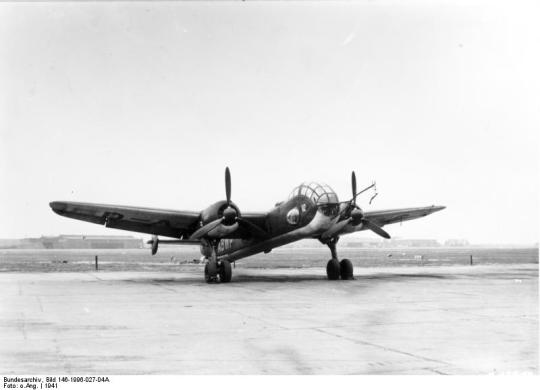
In May 1939, Junkers submitted a design derived from the Ju 88 as their Bomber B contender. Contracted as the Ju 288, it was effectively a scaled-up Ju 88 with Jumo 222 engines and a stepless cockpit similar to that being developed for the Ju 188. The new canopy design allowed Junkers to pressurize the crew compartment. The lengthened fuselage of the Ju 288 would allowed for a larger bomb bay, bringing total internal capacity to over 3,500 kg. Defensive armament consisted of various high-caliber machineguns or cannon placed in remote-controlled barbettes. First flying in November 1940, the Ju 288 was promising enough to gain the favor of the RLM over its competitors. Initial prototypes flew with BMW 801 radials, as the Jumo 222 was not yet ready. Eight prototypes were flown, each adding progressive improvements, including the removal of dive brakes.
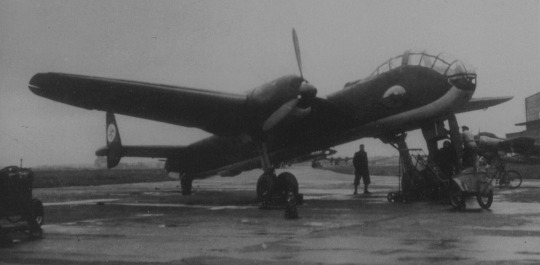
The eight prototypes would not serve as the basis for production, as Junkers had developed the four-seat B-series design with an expanded cockpit and a larger tail. Mass production of the Ju 288B was ordered in October 1941, but this was quickly cut to just 35 aircraft as the RLM looked for alternative powerplants due to problems with the Jumo 222. A solution seemed to have been found in the DB 606 engine, and in early 1942, Junkers began to prepare for production of a DB 606-powered Ju 288 variant. Testing of the DB 606-powered Ju 288C began in August 1942, with promising reports. However, before Junkers could get production lines up and running, the RLM cancelled the Bomber B program in June 1943.
Messerschmitt P.08.01
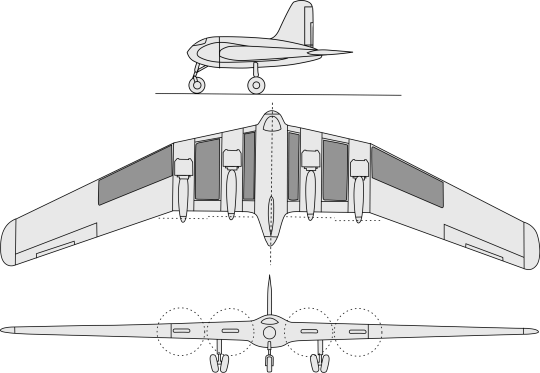
In September 1941, Dr. Alexander Lippisch would produce a massive new flying wing design for Messerschmitt to meet a recently-issued RLM specification for a heavy multirole aircraft that could serve as a bomber with a range of 15,000km and payload of 20,000kg. Four DB 615 engines were to be mounted in the trailing edge of the wing for power, and the crew was to sit in a pressurized cockpit in the nose. Behind the cockpit, a large open space was provided for payload, be it bombs or other cargo. With a takeoff weight approaching 200,000lb and load projections well exceeding anything then in service, the ambitious project unsurprisingly never left the drawing board.
Sanger Silbervogel
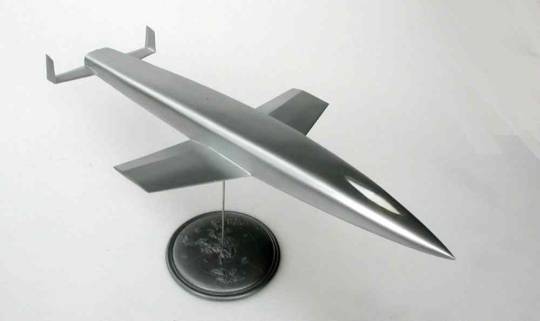
In the mid ‘30s, Dr. Eugen Sanger had developed several concepts for suborbital rocket-powered vehicles. His work on such concepts continued into the start of the war, at which point he began looking to militarize the idea. Known as the Silbervogel, the project called for a unique antipodal bomber that would “skip” across the upper atmosphere in a suborbital profile, allowing the aircraft to fly intercontinental ranges as un-interceptable speeds. The Silbervogel emerged as a large bullet-shaped design with a flat underside and small, wedge-shaped wings. Two large fuel tanks dominated the fuselage, providing fuel for a rocket engine providing 100 tons of thrust. A pressurized cockpit for a single pilot was provided in the nose, and a central bomb bay would hold a single 8,000lb bomb. The empty weight of the machine would be just under 10 tonnes.
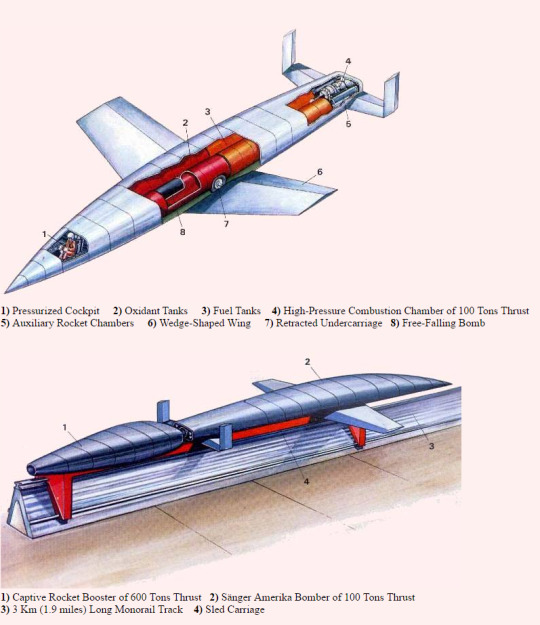
For takeoff, the Silbervogel would be propelled down a 3km track on a rocket sled providing 600 tons of thrust for 11 seconds. From there, it would ascend in a 30 degree climb to 1,500m at a speed of 1,850 km/hr, at which point the main engine would fire, accelerating the machine to a top speed of 22,100km/hr at an altitude of 145km. Still flying at suborbital speeds, it would slowly descend until it hit the upper atmosphere, at which point it would “skip” along the edge of space until finally descending in an unpowered glide. This flight profile would take the aircraft on a 23,500km trip, effectively giving the bomber the range to hit any target in the world. Test facilities for the rocket engines were being made in June 1941 when the invasion of Russia caused the project to come to an end. Ultimately, it was for the best - recent analysis of Sanger’s work discovered errors in heating analysis during reentry. Had the bomber flown as designed, it would not have survived the flight, and, had they augmented the heat shield to compensate, payload would have been reduced to the point that the aircraft was impractical.
Arado E.340
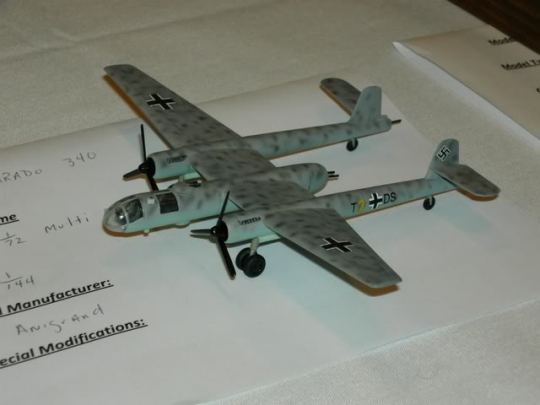
Arado produced perhaps the most unusual Bomber B contender under the internal designation E.340. The E.340 was a twin-boom design, featuring a central fuselage that carried a pressurized crew compartment for a crew of four, along with the bomb bay. The Junkers Jumo 222 engine was selected to power the prototype, with performance projections reaching a top speed of 580 km/hr, while later production aircraft would mount the DB 604 when it became available, bringing top speed up to 625 km/hr. Defensive armament consisted of remote-controlled dorsal and ventral turrets each carrying two 13mm machineguns, as well as three MG 151/20 20mm cannon in single barbettes on the end of each tail. To provide a clear field of fire for the guns, the twin tails were not connected. Unfortunately, the failure of the Jumo 222 engine would kill the project, with no prototypes being constructed before the termination of the Bomber B program in 1943.
Focke Wulf Fw 191
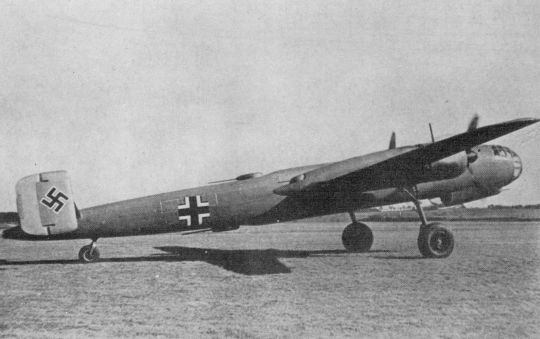
Focke Wulf’s Bomber B proposal would emerge as the Fw 191. The Fw 191 was a large twin-tailed aircraft making use of a stepless canopy to simplify pressurization of the crew compartment. Designed around the Jumo 222 engine, the Fw 191 had much in common with other German bomber projects. Crew was concentrated in the nose, and a ventral gondola was provided to allow a crewman to direct the ventral armament. Defensive armament was controlled remotely, with 20mm cannon placed in chin, dorsal, ventral, and tail positions. Though dive bombing was not required in the Bomber B specifications, the Fw 191 was fitted with unique dive brakes that doubled as flaps. The first prototype Fw 191 flew in early 1942. From the start, it ran into issues, as the problematic Jumo 222s had to be derated to be safe to use. Apart from the power issues, the unique flaps/dive brakes encountered flutter issues, requiring a redesign, and the aircraft’s electrical control system was found to be overly complicated and heavy. A pair of BMW 801 radial engines substituted the Jumo 222s for the completion of testing, and Focke Wulf revised the controls to eliminate much of the electrical system. Meanwhile, as the Jumo 222 faltered, Focke Wulf was left searching for an alternative powerplant. Ultimately, no powerplant could be found, and the Bomber B was cancelled. Development was cut with only three of the originally planned prototypes built.
Arado Ar 234 Blitz
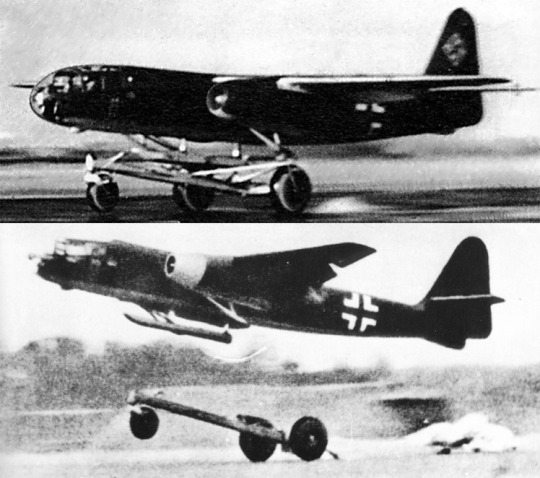
In early 1941, Arado proposed a compact new jet aircraft to meet RLM requirements for a fast reconnaissance aircraft. A sleek, high-winged design powered by a Jumo 004 turbojet under each wing, Arado’s proposal made use of jettisonable landing gear and a compact single-man layout to meet RLM range requirements. The design was contracted as the Ar 234, with two prototypes ordered. Work on the airframes went quickly, with two prototypes ready before the end of 1941, but it wouldn’t be until February 1943 that Arado finally got their hands on the Jumo 004 engines they needed for their aircraft. The Ar 234 prototype first flew in late July 1943, with first tests going smoothly apart from the failure of the landing gear parachutes to deploy after being jettisoned, leading to their destruction. While work on the prototypes continued, the RLM had gained interest in a bomber variant of the design. The bomber variant made significant changes to the design - conventional retractable landing gear was used a remotely operated tail barbette aimed via periscope was installed, and, owing to the lack of internal space, bombs were to be carried externally.
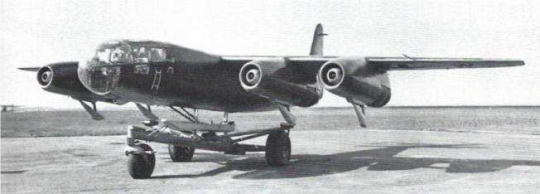
While work began on the Ar 234B bomber, Arado also produced prototypes with alternative arrangements. The sixth and eighth prototypes were both fitted with four BMW 003 turbojets, mounting them in separate and paired nacelles, respectively. Rocket-assisted takeoff modules were also developed for the bomber. The Ar 234B prototype first flew in March 1944, by which time production lines were already setting up. That same month, the fifth and seventh prototypes were sent off for operational trials as reconnaissance aircraft. They made their debut over Normandy in August 1944. A total of 13 missions were flown with reasonable success. The Ar 234 made its flights without being intercepted (or even detected in many cases), providing high-quality images of the Allied buildup. As the Allied forces began to push into France, the Ar 234s were withdrawn to the Netherlands in early September, but, after their airfield was hit by 100 Lancasters in a daylight raid, the two prototypes were withdrawn back to Germany.

Though the two prototypes had ended their service, the Ar 234B was finally ready in serviceable numbers. Beginning operations in October 1944, the Ar 234B started off flying more strategic reconnaissance missions, including some over England. It wouldn’t be until November 1944 that Allied pilots reported their first sighting of the bomber, but no interception was attempted. The first bombing raid came on Christmas Eve 1944, when nine Ar 234Bs, each carrying a single 500kg bomb, made an attack on Liege in support of the Ardennes offensive. Operational problems were revealed as bombing attacks began, with the varying fuel consumption of the Ar 234 with altitude became painfully apparent. Consuming three times as much fuel at sea level as it did at altitude, the Ar 234 had a combat radius of just 190km when flying low-level raids. An advanced bombsight and autopilot made high-altitude attacks more feasible than one would expect, but the Jumo 004 engines severely limited the bomber’s ability to perform precision strikes.
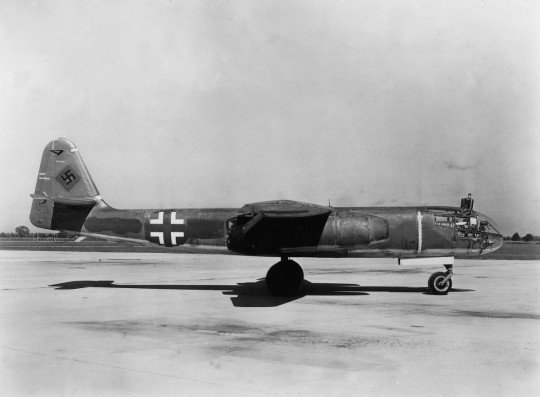
Due to the disruptions of Allied bombing, serviceable numbers of Ar 234Bs remained low. 148 had been built by the end of 1944, but just 17 were operational at the end of the year due to engine shortages. Harassment raids continued without much impact, serving to attract the attention of the ever-present Allied fighters. When 18 Ar 234Bs relocated to a new airfield in early 1945, they were bounced by Spitfires as they came into land. Three were lost and two more damaged, while all the Spitfires escaped. Raids continued as fast as supplies would allow in spite of the losses. However, as fuel shortages worsened and the quality of fuel dropped to stretch the fuel supply the number of flameouts and accidents increased. In late February 1945, an Ar 234 suffered engine failures and came down behind Allied lines. It was captured relatively intact, being the first example to fall into Allied hands.
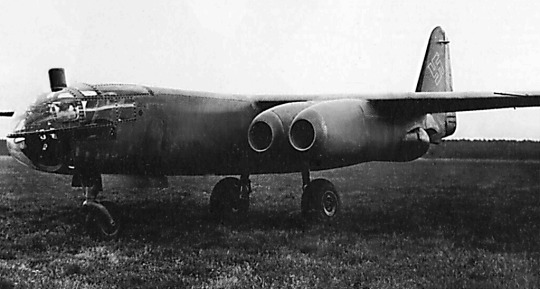
With the BMW 003-powered prototypes proving more promising, Arado shifted production to the Ar 234C, which was based off the eighth prototype. The first Ar 234C flew in October 1944, and, after demonstrating significantly improved performance, it was ordered in the thousands. In March 1945, the Ar 234 was called on to perform a precision strike on the Ludendorff Bridge at Remagen. As engineers had failed to blow the bridge, the Ar 234 was tasked with demolishing it to prevent the Allies from crossing the Rhine. For ten days, Ar 234s flew sorties in an attempt to demolish the bridge. Several aircraft were lost, and, by the time the bridge was collapsed, the Allies had already secured a foothold on the right bank of the Rhine. That same month, the last deliveries of Ar 234s had been conducted. Advancing Soviet forces were threatening Arado’s factories, so the Ar 234 factory was demolished to prevent it from falling into enemy hands. They continued to fight to the last days of the Reich, with a final inventory taken in April 1945 showing 12 bombers, 2 night fighters, and 24 reconnaissance machines in service. In these last days of the war, they increasingly fell victim to ground fire and patrolling enemy fighters that hunted them down at their bases.
Dornier Do 317
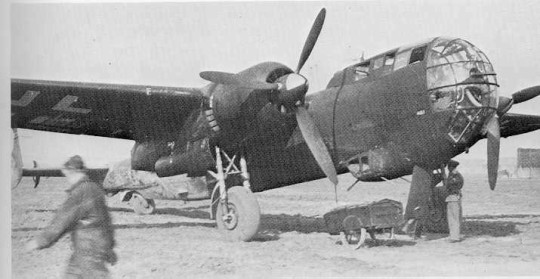
The next evolution of Dornier’s signature series of bombers, the Do 317, would be the company’s submission to the Bomber B competition. The Do 317 was derived from the Do 217M, sharing its unique stepless canopy, which provided space for a crew of four in a pressurized cabin. The Do 317 was to be significantly heavier than the Do 217, and two variants, differing in their wingspan and the choice of either DB 603 or DB 610 engines - were proposed. Defensive armament also varied between the designs, but they both relied on similar layouts of remote-controlled turrets. Unfortunately, when the first Do 317 flew in September 1943, it showed no real improvement over the Do 217. Hoping to salvage the design, Dornier decided to complete the remaining five prototypes with the pressurization equipment removed, planning to pitch it as a replacement for the Do 217 Hs 293 missile carrier. In this configuration, it reverted to the Do 217 designation, becoming the Do 217R. Ultimately, the project was completely abandoned due to the changing war situation.
Blohm & Voss P.163
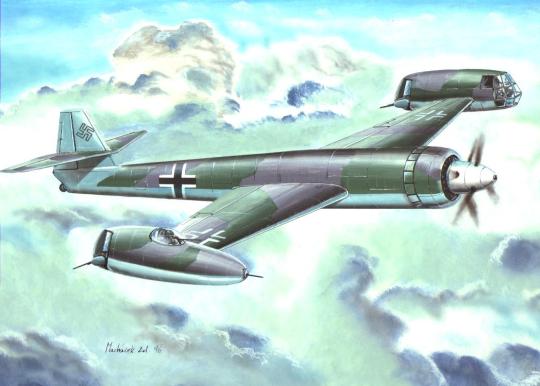
Around the middle of the war, Blohm & Voss developed an unorthodox new fast bomber concept designed around the DB 613C engine (effectively two paired DB 603s). A large fuselage would hold the engine in the nose, driving contra-rotating propellers, with a bomb bay for 2000kg of stores located behind the engine. The crew compartments were split, with one placed on either wingtip. The pilot and navigator were held in a nacelle on the port wingtip, with a gunner’s station in the rear. On the starboard wingtip, a nacelle held two more gunners. Armament was to be six 15mm machineguns in paired mountings in the rear of each nacelle, one forward firing position in the starboard nacelle, and a dorsal position on the starboard nacelle. Blohm & Voss would modify a Bv 141 with a second cockpit mounted on one off the wingtips to test the concept. Unfortunately, testing revealed this arrangement to be unfeasible, so the concept was abandoned.
Blohm & Voss P.170
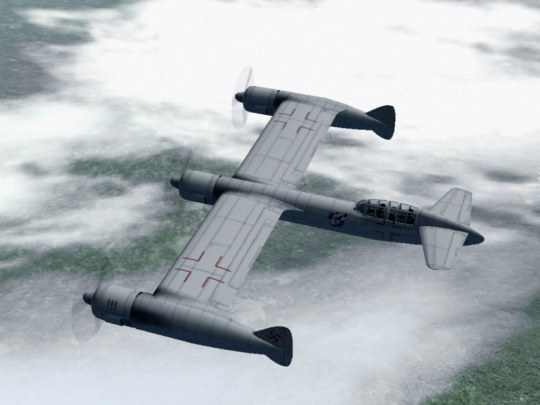
In 1942, Blohm & Voss began another fast-bomber concept, this time opting for a symmetric (but still wildly unconventional) design. Powered by three BMW 801 engines, the P.170 had a single broad-chord wing placed very far forward. A nacelle on either wingtip held an engine, main gear assembly, and rudder, while the fuselage also held a single main gear leg, as well the crew compartment at the extreme tail. No bomb bay was provided, though a payload of 2,000kg of bombs would be carried externally. Blohm & Voss projected a top speed of 820km/hr at 8,000m, so the P.170 was not given any defensive armament, as it was felt it would be able to evade interceptors through speed alone. Unfortunately, nothing came of the design, and it never left the drawing board.
Junkers Ju 388
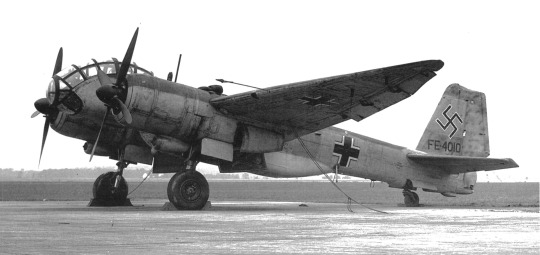
When the YB-29 was revealed to the world in 1942, the Luftwaffe was left scrambling to develop a high-altitude fighter with the performance necessary to intercept it. Junkers’ Ju 188, which had already had heavy fighter variants developed out of it, was selected as the base for a new high-altitude fighter. Defensive armament (apart from a remote-controlled tail barbette) was removed to save weight, while a pressurized crew compartment and enlarged wings were installed. Three models were envisioned. The Ju 388J could be configured as a day or night fighter, swapping out the twin Mk 103s and 20mm cannons for lighter Mk 108s in forward and upward-firing mounts for night operations. Meanwhile, the Ju 388K and L would be a pure high-altitude bomber and reconnaissance aircraft, respectively, mounting a ventral pannier to improve the payload capacity and provide space for cameras. Three engines - the BMW 801, Jumo 222, and Jumo 213E - were selected for the design as well.
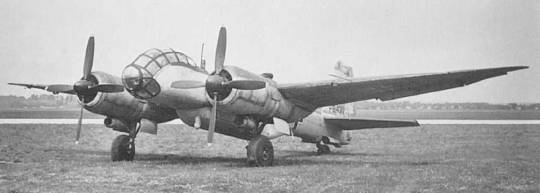
The Ju 388 made its first flight on December 22, 1943. Thanks to the larger tail and improvements in streamlining, it performed far better than the high-altitude Ju 88S. Unfortunately, the Jumo 222 and 213E both ended up being failures, meaning the Ju 388 was forced to rely on the lower-power BMW 801. Nevertheless, it performed well enough for testing to continue, with seven prototypes tested before production was ordered. Deliveries began in August 1944, but by then, the worsening war situation was hurting production. Production concentrated on the reconnaissance-oriented Ju 388L, with 47 built, while only 15 Ju 388 fighters were built and just three Ju 388 bombers were completed before the end of the war. The extent of their service is unclear, though it was undoubtedly minimal. In the end, the very aircraft that spurred the Ju 388’s development - the B-29 - never appeared over Europe, so the Ju 388 never got to be tested to its full potential.
Heinkel P.1068
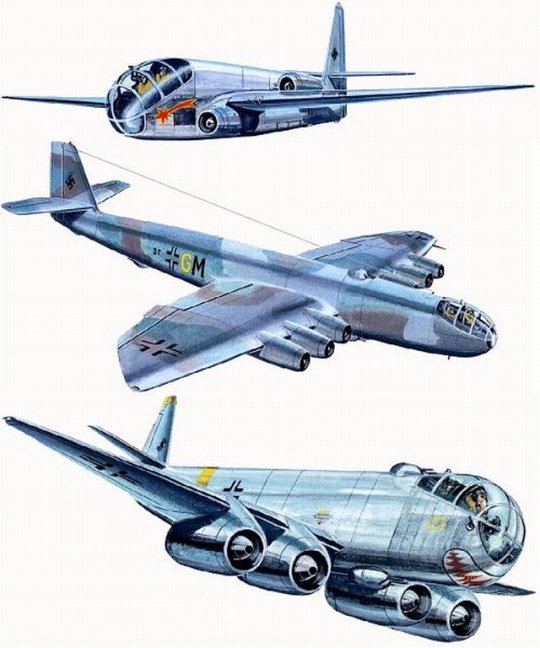
After the RLM asked Junkers to build a four-engined jet bomber in 1942, Heinkel began work on a series of design studies along the same specifications. Under the internal designation P.1068, Heinkel produced four designs. The first three were conventional straight-winged aircraft carrying either four He S 011 (P.1068.01-78, P.1068.01-83) or six Jumo 004s (P.1068.01-80). The fourth and final design, the P.1068.01-84, would have a similar engine layout to Junkers’ Ju 287 prototype, but it made use of 35 degree swept wings. Otherwise, the designs had a lot in common. All had their crew of two concentrated in the nose, and all were designed for a top speed of 800 km/hr, payload of 2,000kg, and range of 2,500km. Heinkel performed extensive wind tunnel testing of the designs, finding that the sole swept-wing design offered little performance gains over the other straight-winged proposals. Ultimately, none of these designs would materialize, as Heinkel was directed to create a jet bomber more heavily derived from Arado’s successful Ar 234.
The Amerika Bomber
Long before America entered the Second World War, there was great interest in Germany for a bomber with the range to strike American cities. With the idea of operating from the Azores Islands, the RLM issued requests to various German companies to develop a bomber. Once America officially entered the war, the Amerika Bomber became official - a project plan was completed in April 1942. Though realistically these raids would be little more than harassment, the hope was that such raids would force America to devote large amounts of resources to domestic air defense. The Amerika Bomber raids never materialized (Portugal ended up leasing the Azores to the British in 1943), but the bomber projects persisted as the RLM hoped to repurpose them for long-range maritime patrol.
Messerschmitt Me 264
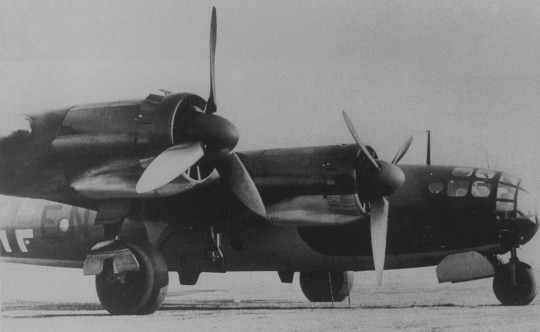
The first of the Amerika Bombers to take flight would be Messerschmitt’s Me 264. The Me 264 could be traced back to 1937, when Messerschmitt created a series of long-range aircraft projects. Though work was low priority at first, the request for proposals in 1940 for a long-range bomber caused Messerschmitt to accelerate development. Contracted as the Me 264, the resulting bomber was a large four-engined machine with long tapered wings and a stepless canopy. With crew concentrated in the nose, the bomber could reduce the weight of armor. Defensive armament was light, consisting of remotely-controlled guns. Details like engines, range, and payload changed over the course of development, with work still progressing slowly due to the high demand for other Messerschmitt designs. Ultimately, the configuration settled on made use of four BMW 801 radial engines, providing for a range of roughly 15,000km and payload of about 5 tons. Much of the aircraft’s 45 ton gross weight was devoted to fuel, with Messerschmitt sacrificing everything from armor to payload to meet the range requirements.
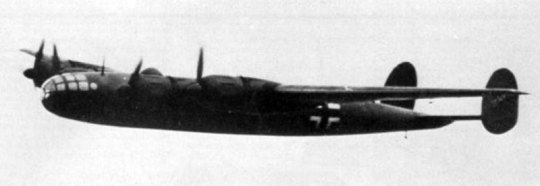
The first Me 264 prototype would fly on December 23, 1943. Minor issues were found, particularly owing to high wing loading, but the bomber was satisfactory. The second prototype was to improve on the design’s failings, adding a metric ton of armor and extending the wingspan to reduce wing loading. However, it was destroyed in an air raid before it could begin testing. Over the course of testing, the project fell into confusion over its status in the Amerika Bomber competition. Ultimately, continued support for the Me 264 was assured by Hitler himself, but only as a maritime patrol aircraft, as the Amerika Bomber program was soon to be dropped. However, the Kriegsmarine had little interest in the aircraft, and in October 1943, Erhard Milch ordered the Me 264 cancelled. It seems that testing still continued on very low priority, with the first prototype operating with Transportstaffel 5 while the third prototype was being completed. However, on July 18, 1944, an Allied bombing raid hit the airfield where both aircraft were stored, destroying the incomplete third prototype and damaging the first. Though effectively terminated, the Me 264 project nominally continued until finally officially cancelled on September 23, 1944.
Junkers Ju 390
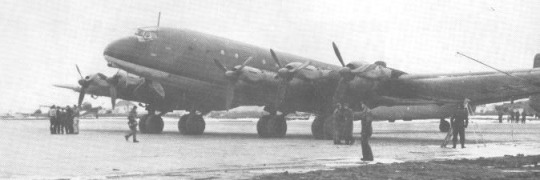
The Junkers proposal for the Amerika Bomber project was conceptually the simplest of the designs that gained official support. Derived from the Ju 290 design (itself an enlarged, militarized version of the Ju 90 airliner), the Ju 390 took the designs to the next level, enlarging them once more. Two prototypes were constructed in 1943, with Junkers engineers merely extending the fuselage of a Ju 290 and adding an extra set of center wing sections to extend wingspan and add two more engines. With this simple conversion, the bomber was now the largest aircraft in the world, with a max takeoff weight of over 75 tons and wingspan of 165 feet. The first prototype would fly in October 1943 - after the Amerika Bomber was cancelled - but it gained the attention of the RLM and Kriegsmarine, who ultimately placed contracts for 26 Ju 390s to serve as maritime patrol aircraft.

The details of the second Ju 390 are unclear. Historians disagree on when exactly it was completed (ranging from October 1943 to June 1944), but it appears that it was configured as a maritime patrol platform, complete with a bristling armament of various machineguns and cannon and a air to surface radar. Ultimately, the worsening war situation saw the cancellation of the production contract in June 1944 and complete cessation of all work in September of that year. The first prototype was returned to the factory in Dessau in November 1944, where it was stripped for parts and ultimately destroyed as American troops approached. The fate of the second prototype is unclear - pilots reportedly flew it as late as February 1945, while the chief designer of Junkers claims that the second Ju 390 was never completed.
Focke Wulf Ta 400

Focke Wulf’s Amerika Bomber - a six-engined machine - would receive the RLM designation Ta 400. Design work began in 1943, with most work outsourced to French technicians to speed development. The design that took shape made use of a shoulder-mounted wing and double tail, with six BMW 801 radial engines mounted in the wing. A crew of nine was split between a forward and aft pressurized compartment. The forward compartment encompassed a stepless canopy that contained the pilots and bombardier, and a rear compartment that held the gunners. Defensive armament was placed in remotely controlled turrets and a tail position, with turrets controlled from positions in bubble canopies along the fuselage (similar to the B-29). At a gross weight of 50 tons, the Ta 400 was to have a maximum range of 9,000km with a payload of 10 tons of bombs. In overload conditions, it was envisioned to be able to carry over 24 tons of bombs. Later versions of the design would add two Junkers Jumo 004 turbojets, while other variants included DB 603 engines would extend range to as far as 14,000km. Ultimately, the Ta 400 would never leave the drawing board. It was considered a backup to the Me 264, so once the Me 264 showed enough promise, the RLM cancelled the Ta 400. Nevertheless, it appears work continued on low priority for some time longer, with Kurt Tank reportedly meeting with Italian industrialists about cooperative development in 1944.
Focke Wulf Fw 238

Parallel to the Ta 400, Focke Wulf developed a second Amerika Bomber under the RLM designation Fw 238. The Fw 238 was a massive all-wood design powered by four BMW 803 engines driving contra-rotating propellers. A long boxy fuselage carried the crew in a pressurized, stepless cockpit in the nose, while armament was carried in four turrets placed in tandem positions on the top and bottom of the fuselage. Alternative powerplants were also considered, with Focke Wulf developing plans to use four Jumo 222 or six DB 603 engines if the BMW 803 didn’t pan out. A smaller variant, designated Fw 238H, was also developed, sacrificing performance for increased range and endurance. Unfortunately, the Fw 238 wouldn’t even outlast the parallel Ta 400 - it was cancelled in early 1943 when the RLM ordered work on the project to cease.
Heinkel He 277
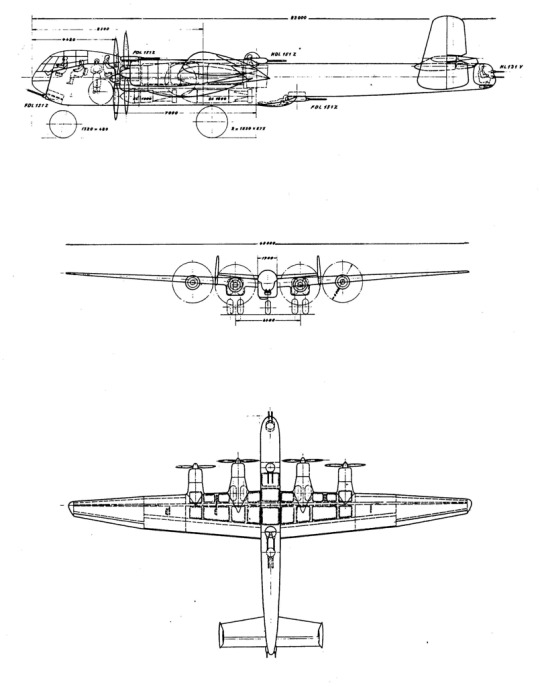
Heinkel opted to derive their Amerika Bomber submission from the He 177. Heinkel had been working for some time on creating a more reliable version of the He 177 making use of four engines under the designation He 177B. When this was finally approved in 1943, Heinkel used this as the base for the He 277 - their Amerika Bomber. The He 277 was powered by four BMW 801 radials mounted on a massive shoulder-mounted wing. Crew was concentrated in the nose under a glazed canopy, although manned gunner stations were also provided in dorsal, ventral, and tail positions. Defensive armament consisted of twin 20mm cannon positions under the nose, in a ventral turret, and in twin dorsal turrets, as well as a quad-13mm machinegun turret in the tail. For transatlantic flights, the He 277 would carry up to 3,000kg of stores, while short-ranged missions would bring payload capacity up to 5,600kg. Unfortunately, the He 277 would never materialize. The aircraft was always competing with more pressing projects for resources, and the RLM seemed to favor projects from other companies. The closest Heinkel got to a working prototype was the flying of two He 177B prototypes. Ultimately, in April 1944, the RLM ordered Heinkel to cease work on the He 277 and scrap the tooling.
Blohm & Voss P.184

In the latter half of the war, Blohm & Voss developed a new long-range bomber design with a focus on simplicity of construction. Constructed entirely of steel, the P.184 had a long, untapered wing placed low on the fuselage. The box-shaped spar of the wing was sealed, allowing it to serve as the fuel tank for the aircraft. Four BMW 801 engines were placed in nacelle on the wings, with each nacelle also housing a main landing gear leg. A crew of five was to be housed in a pressurized cabin in the nose of the circular fuselage, and armament of two tail guns and a single nose gun would be controlled remotely. Payload was to be up to 4,000kg, all ow which would be carried internally. Unfortunately, performance projections weren’t all that impressive, with the P.184’s projected top speed being just over 300mph. Blohm & Voss had pitched the design as both a heavy bomber and high-endurance maritime patrol aircraft, but by the time the proposal had been finalized, the P.184 was obsolete as a bomber and the need for maritime patrol aircraft had disappeared.
Junkers Ju 287
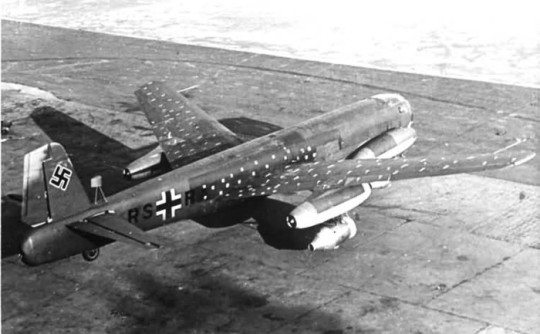
In 1943, Junkers began work on a new jet bomber design under the designation Ju 287. Originally looking at swept-back wings, preliminary tests found that such a layout led to poor low-speed handling. Instead, Junkers moved to forward-swept wings, which eliminated the poor handling while still keeping the wing spars out of the central fuselage to make space for the bomb bay. Because of the ambitious design elements, Junkers decided to modify an He 177 as a demonstrator. An He 177A-5 was fitted with the new forward-swept wings, the tail of a Ju 388, and four Jumo 004 engines. Because the main gear of the He 177 had been eliminated, the prototype was fitted with fixed, spatted gear. A more proper prototype was also in the works. This second prototype would be a more practical aircraft, using a revised canopy, retractable landing gear, and a new engine layout with three BMW 003 engines clustered under either wing.

Though work all bomber projects had been ordered cancelled in mid-1944, Junker was given special permission to fly the Ju 287 prototype. Taking flight in August 1944, the bomber made 17 test flights, including one high-speed dive that reached 660 km/hr, before being put into storage. In March 1945, however, the program was revived by a new requirement for a jet bomber. The first prototype was taken out of storage, only to be destroyed in Allied bombing raids before it could fly again, and work on the second prototype (along with a pre-production machine) continued. The Junkers factory was overrun by the Soviets in late April 1945 with the second prototype 80% complete, and work just starting on the third. The two incomplete prototypes were taken to the USSR along with the project’s staff, where the remaining aircraft were completed and flown by 1947. However, jet development had since outpaced the aircraft, so they would see little use. The design briefly lived on as the Soviets hoped to enlarge it as the EF 140, but no production would ever result.
Junkers Ju 488

Germany’s last real attempt to build a heavy bomber came in early 1944, when the Junkers works at Dessau proposed a new bomber design making use of existing parts and jigs to create a composite aircraft. Given the designation Ju 488, it was effectively the culmination of all previous -88 series Junkers bombers. The pressurized cabin, ventral pannier, and outer wing sections from the Ju 388K would be attached to the rear fuselage of a Ju 188E, while the twin tail of the Ju 288C would be used. The only new pieces would be an extended central fuselage and the center wing sections, which would make the Ju 488 a larger four-engined machine. Construction of two prototypes was ordered, each powered by the BMW 801 radial engine. Work began in the Junkers works at Toulouse in early 1944. Work went quickly, but after the Allied landings at Normandy, the decision was made to move the incomplete fuselage to Bernburg for completion. Unfortunately, while being transported by rail, the pieces were attacked by resistance fighters, damaging them to the point that they could not be salvaged. The project nominally continued for some time after that, only being officially being cancelled in November 1944.
Blohm & Voss BV 237
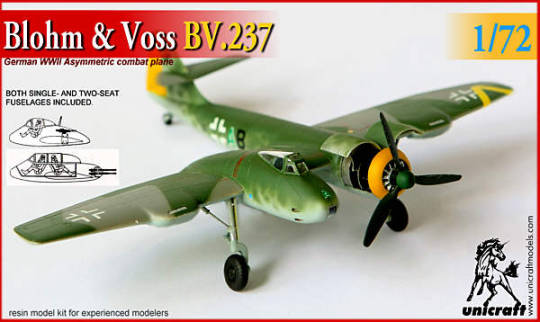
With the failure of Junkers’ attempt to create a replacement for the venerable Stuka, Blohm & Voss began work in 1942 on a dive bomber that could meet the Luftwaffe’s requirements. Working under the project designation P.177, the aircraft was an asymmetric design similar to the company’s famous BV 141. Powered by a single BMW 801 in a fuselage offset to the port, the aircraft had its pilot sitting in a cockpit nacelle placed to the starboard of the fuselage. Main landing gear retracted outwards, extending almost to the wingtips when retracted. The cockpit was heavily armored and fitted with two fixed forward firing 15mm cannon as well as two rear firing 13mm machineguns. 500kg of bombs would be carried under the cockpit, though overload conditions allowed for a further 500kg to be carried on the opposite side of the fuselage. Variants were also proposed with three forward firing 30mm Mk 103 cannon or a single Jumo 004B turbojet under the wing center section. Production of the P.177 was ordered in 1943 as the BV237, but, after the devastating raids on Hamburg later that year, work was halted. Blohm & Voss convinced the RLM to resume the project with assurances that the aircraft would be in service by mid 1945. The BV 237 got as far as a full-scale mockup before the RLM cancelled it for the second and final time in late 1944.
Heinkel He 343
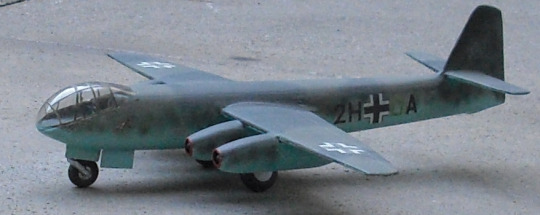
In January 1944, Heinkel was directed to develop a four-engined jet bomber that would be able to enter production as quickly as possible. Rather than continue with the in-house P.1068 designs, Heinkel selected the proven Arado Ar 234 bomber as a base. The resulting He 343 was a general enlargement of the Ar 234, being about 1.25 times larger in most dimensions. The extra space provided room for an internal bomb bay and redesigned landing gear, along with a second crewman. Four Jumo 004Bs were selected to power the design with the hopes that the more powerful Jumo 004C would be ready when production began. Alternatively, the design could be easily adapted to carry either the BMW 003 or He S 011. The bomber variant was to have a payload of 3,000kg (2,000 internal, 1,000 external), along with provisions to carry a third crewman to deploy the Fritz-X guided bomb. Two heavy fighter variants were also proposed, with a heavy forward-firing armament of cannons. All variants retained the twin 20mm cannon tail barbette of the original Ar 234. The RLM would place an order for 20 He 343s, though they were never really enthusiastic about the design, instead favoring Junkers’ Ju 287. Despite Heinkel’s lobbying, citing reduced costs and development times, the RLM would cancel the project, ordering all components scrapped in late 1944.
Arado E.555 Series
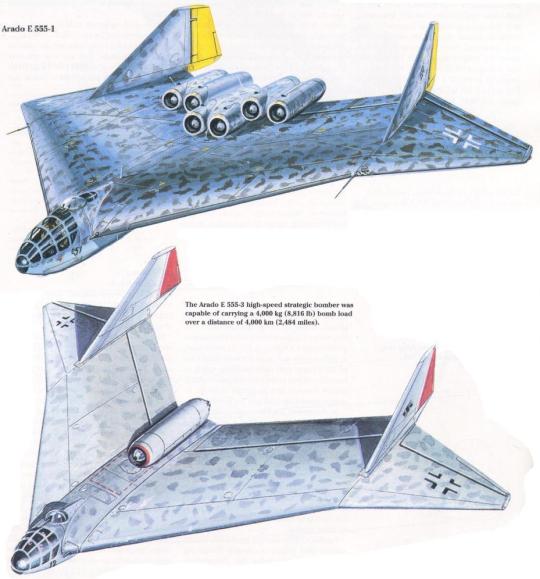
In December 1943, Arado began work on a series of flying wing bomber design studies designated E.555. The E.555 series varied greatly across design studies, but shared a common highly-swept wing planform with a prominent dihedral on the inner sections and anhedraled outer sections. Specifications issued by the RLM in early 1944 guided the designs, which were to have a payload of at least 4,000kg, range of 5,000km, and a high cruise speed. All designs included a pressurized crew compartment and remote-controlled armament. Early studies made use of larger numbers of low-powered engines (E.555-1 had six BMW 003s and E.555-2 had four He S 011), while later studies settled on the BMW 018 turbojet. The gross weight of the designs rose in later studies, and the designs gradually changed from pure flying wings to twin-boom designs, culminating in the fairly conventional E.555-11, which made use of a conventional fuselage and tail. Ultimately, nothing would come of any of these design studies - Arado was ordered to cease work on the E.555 studies in late December 1944.
Blohm & Voss P.188
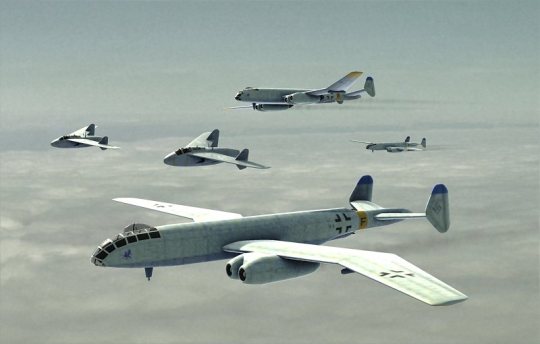
Though the P.184 wouldn’t not materialize, Blohm & Voss would use their experience developing that design to create a more modern jet bomber. Working under the designation P.188, the new bomber retained the unique steel box spar/fuel tank, but was considerably smaller. Crew was reduced to just two, and the piston engines of the P.184 gave wa to four Jumo 004 turbojets. The most notable feature of the design, however, was the unique wing planform. The inner sections had a 20 degree sweep back, while the outer sections had a 20 degree forward sweep. The idea of the unique planform was to allow for the bomber to reach higher speeds without experiencing the low-speed handling problems of conventional swept wings or the structural issues of forwards swept wings. To further avoid structural issues, the outer wing sections were variable-incidence. The first P.188 design had a payload of 1,000kg, but this was enlarged in the final design, bringing payload to 2,000kg. Work unfortunately went slowly due to a shortage of resources. The project dragged on to the end of the war, ultimately coming to an end without ever leaving the drawing board.
Focke Wulf 1000 X 1000 X 1000 Bomber Studies
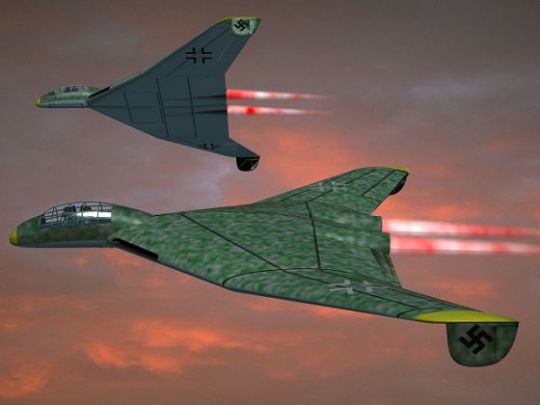
In 1944, Focke Wulf began a series of design studies for bombers designed around two He S 011 turbojets. Known by their project name - 1000 X 1000 X 1000, the bombers were to be able to carry a load of 1,000kg over 1,000km with a top speed of 1,000km/hr. Focke Wulf’s first design was fairly conventional, making use of a long, slender fuselage with 35 degree swept wings and tail surfaces. An He S 011 turbojet would be slung under either wing, canted slightly outwards to counter the adverse yaw effects in the event of engine failure. The second design was the most radical, being a flying wing with a small fuselage placed in the leading edge for the single pilot. Engines were buried in the wing roots, while the outer wing sections were turned down to act as rudders. The final design reverted back to the more conventional layout of the first, but used a shoulder-mounted wing, conventional cockpit, and crew of three. It also had engines canted outwards, but the angle of the cant was significantly more than the first proposal. None of the proposals were armed, instead relying on speed for protection. The projects apparently continued to the end of the war, terminating when Germany surrendered.
Arado E.560
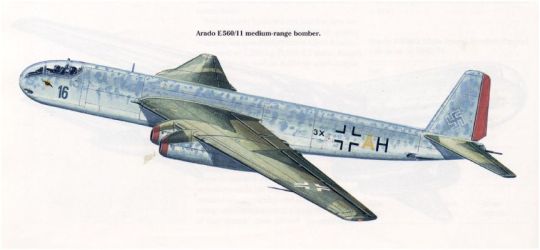
Late in the war, Arado began work on a successor design to the Ar 234 jet bomber. Working under the general designation E.560, the program resulted in a series of design studies with vastly varying specifications, generally only being similar in that they held a crew of two in a pressurized cabin in the forward fuselage. All E.560 proposals were fairly unambitious, making use of conventional tail surfaces and slightly swept wings. Defensive armament was to be remotely controlled in various barbettes. Two of the E.560 designs proposed the use of still-developing turboprop engines, whereas the others intended to use four to six BMW 003 or 018 turbojets. Ultimately, none of the designs would leave the drawing board before the end of the war terminated development. In the turmoil surrounding the end of the war, only five designs of at least 11 studies survived.
Horten Ho XVIII

In 1944, the RLM had issued new requirements for an Amerika Bomber, calling for a range of 11,000km and payload of 4,000kg. Five companies had submitted designs, but none could meet requirements. After learning of these failures, the Horten brothers, who were not invited to participate, decided to design their own Amerika Bomber. In late 1944, they developed a series of design studies, ultimately settling on a massive flying wing design powered by six Jumo 004B turbojets buried in the center wing section. Built mainly of wood, it would use jettisonable landing gear to save weight in flight. This design was presented to the RLM in early 1945, but RLM officials ordered a series of changes to the design. Unsatisfied with the demands, the Horten brothers reworked their clean flying wing into a four-engined machine with fixed landing gear. Large ventral fairings would carry the landing gear, with Jumo 004B turbojets placed on either side of the fairing. Though this didn’t meet RLM demands for a vertical tail, it was considered good enough to begin production. The prototype, designated Ho XVIII B, was to be ready by the Fall of 1945. However, two months before construction was scheduled to begin, Germany surrendered, putting an end to the project.
BMW Strahlbombers
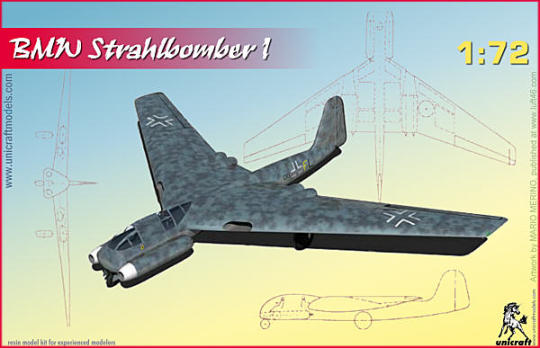
In 1944, BMW began work on a series of new bomber projects designed around their in-house turbojet designs. Two general designs were produced. Strahlbomber I was powered by six BMW 003 turbojets, with two buried in either wing root and the remaining two engines placed on the lower fuselage cheeks. A large swept wing was used, and, though a large vertical tail extended backwards, the bomber was devoid of any horizontal tail. Armament was to be two rear-firing 30mm cannon, and a bomb bay was placed in the fuselage. The aircraft was also designed in such a way that the still-developing BMW 018 could be easily substituted on the airframe. The second Strahlbomber was a more refined flying wing designed around the BMW 018. Mounting two of these engines side-by-side in the rear of the fuselage, Strahlbomber II had a prominent air intake in the nose and a crew of three. A ventral compartment was provided for the bombardier to operate, and two defensive cannons in a remote-controlled barbette were installed in the rear of the aircraft. Payload for this machine was to be 5,000kg. Unfortunately, neither design would leave the drawing board.
BMW Schnellbombers
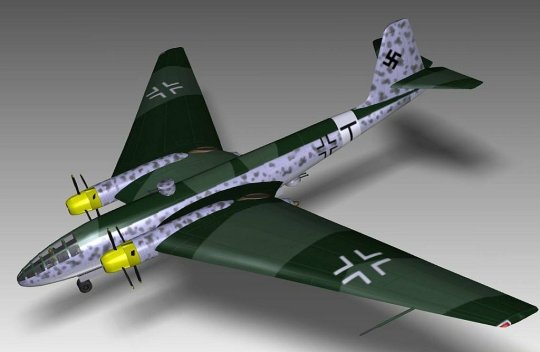
Parallel to the Strahlbombers, BMW also produced two bomber designs making use of an in-house turboprop engine. Both aircraft were designed around the BMW 028 turboprop, but otherwise the aircraft were very different. The first Schnellbomber proposal was a three-man machine with conventional swept wings and the turboprops mounted on the leading edges of the wings. For extra power on takeoff and high-speed dashes, a BMW 018 turbojet was also mounted under the trailing edges of the wings. Two remote controlled barbettes would protect the bomber, and a bomb bay for 15 metric tons of bombs was provided. Schnellbomber II was a far more radical two-man design. The second Schnellbomber had its turboprop engines mounted on struts that extended above the wings and fuselage, intended to keep the flight surfaces out of the propeller wash. The aircraft also had forward-swept wings, with wingtips extending well beyond the nose of the aircraft. Like the company’s Strahlbomber proposals, the Schnellbombers remained paper projects.
Heinkel He 274
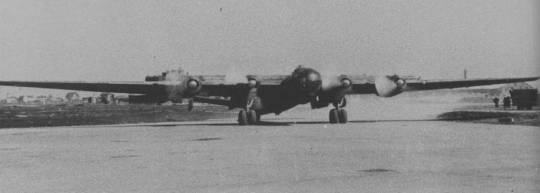
Though the RLM had initially been focused on the twin-engined He 177 with a focus on dive bombing, interest in a more conventional high-altitude variant had arose as the war began. Contracted as the He 177H in October 1941, the design made considerable changes from the He 177. Crew was reduced to just four concentrated in a pressurized nose compartment, and defensive armament was reduced to five 13mm machineguns in remote-controlled nose, dorsal, and ventral turrets. The most notable change was the abandonment of the twin-coupled engines in favor of individually-mounted DB 603 engines, along with lengthened wings and a longer fuselage for high-altitude flight. Six prototypes were ordered, shortly thereafter receiving the designation He 274. Production was outsourced to France - Farman would build the two prototypes, while Heinkel-Nord’s facilities in Rostock-Marienehe. Unfortunately, work was stalled after Allied bombing hit the factories in Toulouse that were making components for the bombers. The first prototype was only rolled out in July 1944, and before it could fly, the facilities had to be abandoned in the face of advancing Allied troops. Though slightly damaged in the evacuation, it was repaired and taken into service by the Armee de l’Air, along with the second prototype. The He 274 would only fly for the first time in December 1945. The Armee de l’Air used the two bombers as research aircraft, flying them in high altitude experiments and using them as motherships for various experimental designs. They served on in this role until 1953, when they were both retired and scrapped.
Junkers EF 132
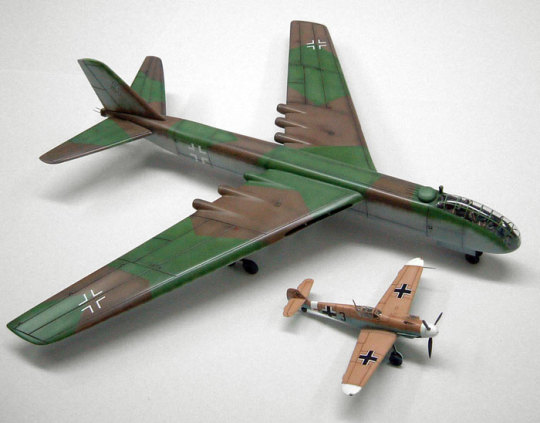
In the last year of the war, Junkers started a new bomber project even more advanced than the Ju 287. Fitted with a 35-degree swept wing, the EF 132 was to be powered by six Jumo 012 jet engines buried in the wing roots. The shoulder-mounted wing and choice of bicycle landing gear left the fuselage clear for a spacious bomb bay that spanned 12 meters long, giving it space for up to 5,000kg of bombs. A glazed, pressurized compartment was placed in the nose for the crew of five, with the armament of four 20mm cannon in dorsal, ventral, and tail barbettes controlled remotely. A wind tunnel model was tested early in 1945, and Junkers built a full-size mockup to test various components and engine layouts. Though work on a prototype had yet to begin, when the Soviets overran the factory at the end of the war, sufficient work had been done on the design for the Soviets to order the project continued. Junkers’ factory at Dessau was partially rebuilt to keep the project going until the Junkers team was ultimately forcibly moved to the USSR in October 1946. There, a glider was built to test handling characteristics, which were found to be excellent. However, just after work began on the first prototype, Soviet officials cancelled the project.
OKB-1 140
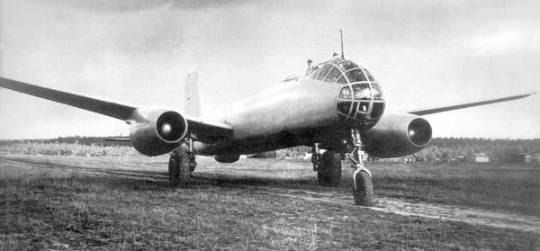
At the end of the Second World War, the Soviets had overrun Junkers’ factories, capturing two incomplete prototypes for the Ju 287 along with their design staff. The engineers and the aircraft were taken back to the USSR for completion and testing, but by the time the Ju 287 was flying, the aircraft was obsolete. Hoping to modernize the design, the engineers of OKB-1 (where the captured German engineers were working) took the second prototype EF 131 (the designation for the Ju 287 in Soviet service) and refit it with two Mikulin AM-TKRD-01 turbojets. Armament was slightly revised, with twin 23mm cannon barbettes placed in dorsal and ventral positions, while the crew was expanded from three to four. Tests began in late September 1948, but problems with the Mikulin engines led to the aircraft being refit with the Klimov VK-1. Though the USSR hoped to operate the design as a reconnaissance bomber, tests were not promising. Severe vibrations were experienced in all flights, and, before testing could be completed, the project was cancelled in 1950.
OKB-1 150

The culmination of German bomber development from WW2 would be OKB-1’s project 150. After the Soviets overran eastern Germany at the end of the Second World War, they took in various German engineers, bringing them back to the USSR to design aircraft with OKB-1. OKB-1’s final bomber design, originally designated RB-2, began development in 1948 when Soviet Long Range Aviation (ADD) produced new specifications for a jet bomber. The resulting 150 was a fairly modern design, with a 35 degree swept wing and swept tailplanes. Kneeling bicycle undercarriage was used to shorten takeoff rolls, and remotely controlled dorsal and tail barbettes were installed for defense. Offensive armament consisted of a bomb bay with space for 6,000kg of bombs, as well as a single forward firing cannon controlled by the pilot. The Lyulka TR-3 engine was selected to power the 150, with one engine slung under either wing. The bomber was also fitted with a host of advanced equipment , ranging from ground-mapping bombsight radars to the latest navigational aids. Despite high priority given to the bomber, OKB-1 had little resources to work with, so it wasn’t until September 1952 that the aircraft first flew. It would only make 17 flights until May 1953, when the sole prototype crashed on landing. Though damage was repairable, the decision was made not to continue work. Instead, OKB-1’s resources were dispersed to other OKBs, and the German engineers were finally repatriated to East Germany.
6 notes
·
View notes
Text
/k/ Planes Episode 101: Royal Air Force Bombers
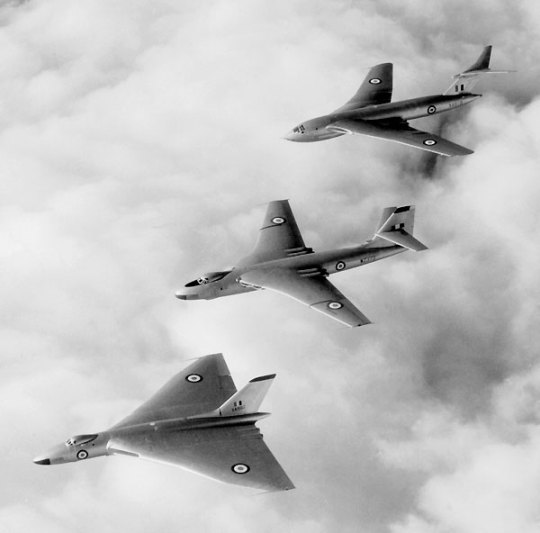
It’s time for another episode of /k/ Planes! This time, we’ll be looking at the bombers of the Royal Air Force.
As one of the world’s first air forces, the British Royal Air Force would have a long and influential career in bomber development. Getting its start with the Royal Flying Corps in WW1, early doctrine centered on the use of light bombers for tactical duties. However, by the time the RFC became the RAF in 1918, the utility of multi-engined strategic bombers had been realized. Through the interwar period, the RAF would come to operate a wide variety of bombers, holding onto the concept of light bombers far longer than many other nations (most of which who shifted the role off to fighter-bombers, heavy fighters, and attack aircraft). As a new war loomed, the RAF would procure a new generation of heavy bombers, giving them one of the most potent bombing forces in the world. While tactical bombing was passed off to American-built medium bombers and even fighters, the RAF’s heavy bombers - all flying at night due to heavy losses experienced in daylight raids - would be a devastating force. Unfortunately, the RAF bomber force rapidly declined postwar. Only a single generation of jet bombers would take shape in the postwar period, with the aircraft being rapidly outpaced by Soviet air defenses and the development of ballistic missiles. Unlike the US or USSR, the British lacked the funds to keep a massive nuclear deterrent of both missiles and bombers active, so the RAF’s bomber force gave way to the Royal Navy’s ICBMs and a new generation of tactical strike aircraft.
Royal Aircraft Factory B.E.2c
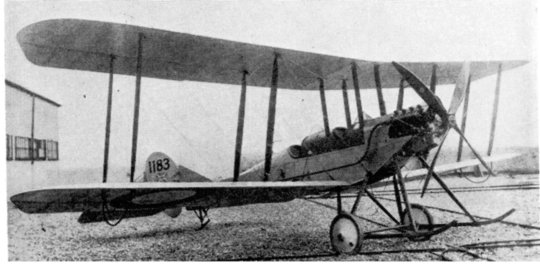
The Royal Aircraft Factory’s B.E.2c biplane would be the first domestically produced aircraft to serve as a bomber with the RFC. First flown in 1912, the B.E.2 was designed as a general-purpose aircraft. Large numbers were sent to France with the British Expeditionary Force in 1914, though these were primarily early variants that were rapidly replaced once more modern aircraft became available. By the end of 1914, the B.E.2c would begin reaching frontline units, providing the RFC with a robust and reliable aircraft to perform operations. The B.E.2c was a simple two-seat tractor biplane that was generally stable and easy to fly, making it a prime choice for combat roles. Initially, the B.E.2c was used for reconnaissance, carrying a camera off the side of the fuselage to be operated by the observer. However, it would gradually take on bomber roles as well.

Though the B.E.2c would prove capable of carrying bombs, it was hardly a practical arrangement. To operate as a bomber, the aircraft had to fly without its observer, and endurance was limited. Unfortunately, the modest performance of the B.E.2c was quickly found to be a liability after the appearance of the first German fighters. Though the B.E.2c could be fitted with a defensive gun, the placement of the observer ahead of the pilot and under the wing limited its usefulness, and, unsurprisingly, losses mounted. Despite the heavy losses to German fighters, the B.E.2c persisted in frontline roles. The arrival of new fighters would allow the B.E.2 to fly in safer skies, and the newer B.E.2e variant promised to address some of the design’s shortcomings. This resurgence was short-lived, however. A new generation of German fighters arrived over the front in the Spring of 1917, leading to the highest losses yet experienced by B.E.2 crews. Though plans had called for the R.E.8 and F.K.8 to replace the B.E.2 on the front by early 1917, crews suffered in the obsolete aircraft until the middle of the year.
Farman MF.11 Shorthorn
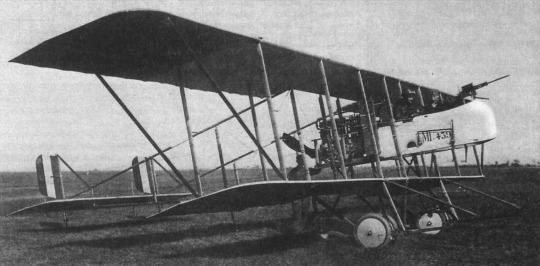
One of the first bomber aircraft to operate with the Royal Flying Corps would be a pre-war design from the French manufacturer Farman. The MF.11 was a simple two-man sesquiplane pusher design, powered by a 100hp Renault engine and fitted with a single machinegun in the forward cockpit. Originally designed for reconnaissance, it would occasionally mount a small payload of eighteen 16lb bombs on underwing racks. In the first years of the war, the MF.11 saw considerable use, with an RNAS MF.11 making the first bombing raid of the war on December 21, 1914. Though the MF.11 was quickly made obsolete and withdrawn from the Western Front in 1915, it continued to serve on in tertiary theaters. 13 RFC squadrons would fly the MF.11, operating them over the Dardanelles, Africa, and Middle East. In these theaters, the MF.11 would persist until 1916, though, with its modest payload, their bombing missions were unsurprisingly not too decisive.
Martinsyde G.100 Elephant
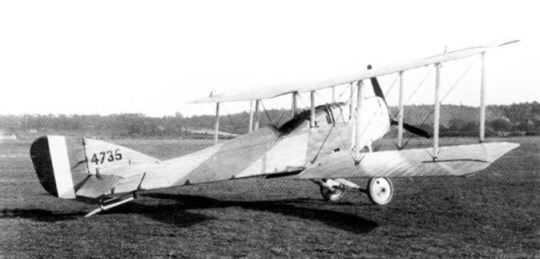
In 1915, Martinsyde had developed a large single-engined tractor aircraft intended to serve as a long-ranged fighter and scout. Though it carried only a single pilot, it had an unusual armament scheme, with a Lewis gun mounted firing forward on the upper wing and a fixed rear-facing Lewis gun aft of the cockpit. The G.100 would first fly in 1915, but by the time it was introduced in 1916 it was determined to be too large and unwieldy to serve as a fighter. Instead, the aircraft entered service in mid 1916 as a bomber. In the bomber role, it performed reasonably well. It could carry up to 260lb of bombs or cameras for reconnaissance, and, with a long range and endurance, it was fairly successful in both of these roles. However, production was limited to just 270 aircraft, so service was limited. They flew only in France and the Middle East, and only one squadron would be fully equipped with the type. Service was brief, and by the end of 1917 the G.100 had left service.
Short Bomber
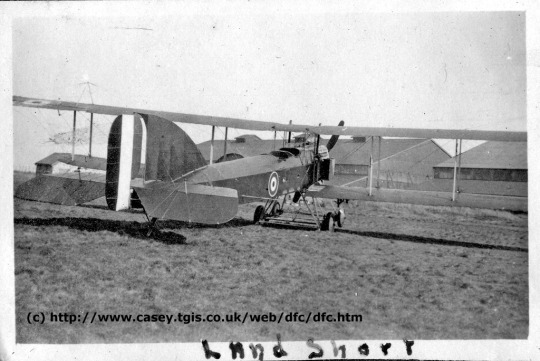
In 1915, Short began work on a long-ranged land-based aircraft for the Admiralty. Developed from the successful Type 184 seaplane, the Bomber would incorporate the fuselage of the 184 with larger wings developed from the Type 166. As originally designed, the crew of two sat in tandem with the observer sitting ahead of the pilot so as to allow him to operate a gun mounted on the upper wing. However, later production aircraft would use a more practical layout with the pilot sitting further forward with the gunner operating a Lewis gun mounted on a Scarff ring. Designed primarily for endurance, the Bomber’s payload was modest at just eight 112lb bombs. Initial testing in 1915 revealed the Bomber was unable to carry the originally specified payload, so Short extended the wings by 12ft. Orders for 80 aircraft were placed, with the first Bombers entering service with the RNAS in late 1916. Though the Bomber would see most of its use by the RNAS, small numbers were also operated by the RFC. The RNAS would make several cross-channel raids into Belgium with the Bomber, but the RFC’s Bombers seem to have had considerable less use. Ultimately, both services would retire the Bomber by mid 1917, as it was determined to be underpowered and vastly outperformed by the Handley Page Type O.
Royal Aircraft Factory R.E.7
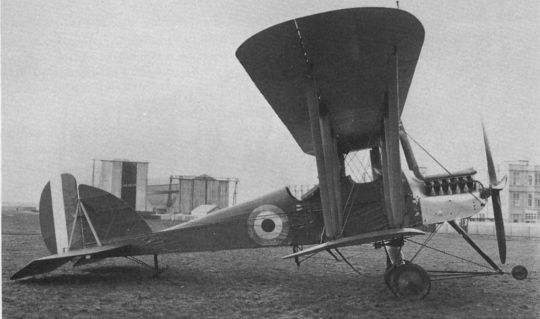
In 1915, the Royal Aircraft Factory produced an improved variant of their R.E.5 spotter. Designated R.E.7, it was intended to be a larger machine capable of carrying a useful combat payload. The R.E.7 was similar in design to most other two-seater tractor biplanes, with crew in tandem open cockpits and a single machinegun provided for defense. Racks were placed under the wings, allowing the bomber to carry a single 336lb bomb or up to 324lb of smaller bombs. The R.E.7 began testing in 1915 and was in France by 1916. Original plans called for the R.E.7 to serve as an escort for other aircraft, but the poor field of fire of the gun limited its usefulness in that role. However, it did prove an effective bomber for some time. Unfortunately, by mid 1916, the R.E.7’s brief peak had ended and the aircraft’s losses were already mounting. The bomber’s low speed and flight ceiling left it vulnerable, and, as losses rose, the R.E.7 was withdrawn from combat roles by the end of 1916.
Handley Page Type O

The preeminent British bomber of the war would have its origins in late 1914, when the Admiralty began looking into developing a long-range bomber capable of hitting the German High Seas Fleet base at Kiel. Handley Page proposed a large landplane to meet the requirements under the internal designation Type O/100. The Type O/100 was to be a massive biplane powered by two 150hp Sunbeam engines with a payload of six 100lb bombs. The design was approved for full development in early 1915, though the design was revised to mount more powerful Rolls Royce Eagle engines. The design that took shape by the end of the year was surprisingly modern, with sleek, streamlined nacelles, a massive sesquiplane wing, and propellers that rotated in opposite directions to avoid adverse torque effects. As originally designed, it had an enclosed cockpit with just a single gun installed for defense. Instead, the bomber would rely on heavy armor to protect its crew.
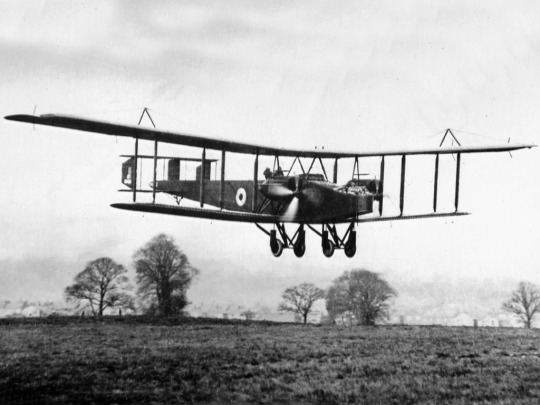
The Type O/100 flew for the first time in December 1915, but testing quickly revealed numerous control and vibrational problems. A second prototype, flying in April 1916, revised the design with an open cockpit and longer nose that added a gunner’s position, as well as reduced armor. Vibrational and stability problems persisted, however, forcing the evolution of the design through two more prototypes. The ultimate design would feature a total of four defensive gun positions in nose, waist, and ventral positions, uprated Eagle engines, enlarged fuel tanks, and the elimination of all armor. More notably, it carried a mechanical bombsight, making it one of the first bombers to do so.
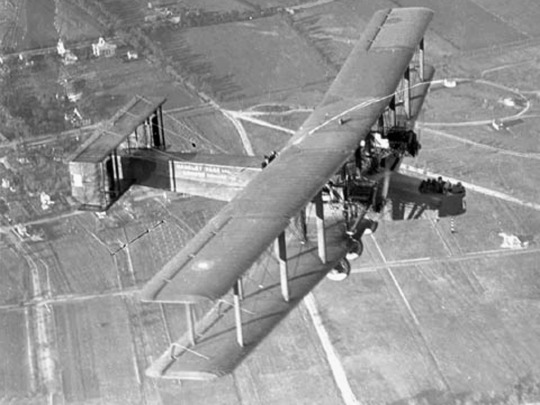
The first Type O/100s reached RNAS service at the end of 1916. Their first combat sorties came in March of the next year, where they were used against targets in Belgium. They started with daylight raids, but after heavy losses to enemy fighters, RNAS Type Os transitioned to night bombing. The success of the type in RNAS service caught the attention of the RFC, who procured the type for themselves as well. The arrival of the new Type O/400 with uprated engines and an improved payload capacity provided the RNAS and RFC with the most potent Allied bombers of the war. 10 RAF squadrons would come to fly the Type O/400, making it into service just in time to be thrown into action against the German Spring 1918 Offensive. The Type Os also were committed to the strategic bombing effort of the Independent Air Force in the final months of the war. Unfortunately, despite the Type O’s capabilities, its postwar career was brief. The RAF decided to standardize the bomber inventory around the Vickers Vimy at the end of the war, so by the end of 1919 all Type Os had been retired.
Armstrong Whitworth F.K.8
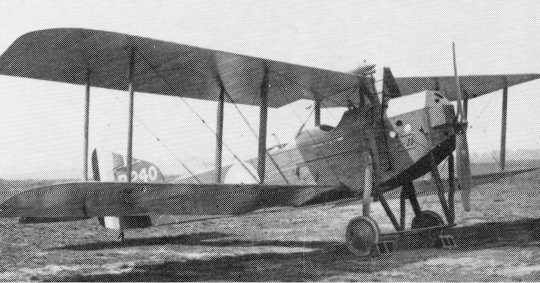
Armstrong Whitworth’s first dedicated bomber aircraft, the F.K.8, would be a single-engined reconnaissance bomber developed as a replacement for the B.E.2c and F.K.3 reconnaissance aircraft. The F.K.8 was a sturdy design powered by a 160hp Beardmore water-cooled engine and fitted with a single machinegun for defense. The crew of two sat in separate cockpits, each fitted with controls, and racks for up to 260lb of bombs were fitted. The prototype F.K.8 first flew in May 1916, ultimately receiving a modest production order for 50 aircraft. Production aircraft added a single Vickers gun synchronized to fire through the propeller. However, numerous teething problems were found. The first aircraft delivered to France were often fitted with French interrupter gears owing to flaws in the Armstrong Whitworth system, and the weak undercarriage was regularly replaced in the field with more robust systems from other aircraft.

The F.K.8 would grow to be a popular aircraft, with orders ballooning to over 1,500. They would go on to serve in France, Macedonia, and Palestine, where they proved more popular than the Royal Aircraft Factory R.E.8 they were developed alongside. Though primarily used for reconnaissance, they did see significant use as light bombers. Unusually, though configured with controls like many trainers, the F.K.8 remained purely a combat aircraft through the end of the war. The RFC planned to replace both the F.K.8 and R.E.8 with a variant of the Bristol Fighter, but that variant never materialized and the F.K.8 persisted to the end of the war. However, the postwar drawdown would see the F.K.8 rapidly phased out of service. Many squadrons were withdrawn before the end of 1918, and the last operational F.K.8 squadron - 150 Squadron - was disbanded in September 1918.
Royal Aircraft Factory R.E.8
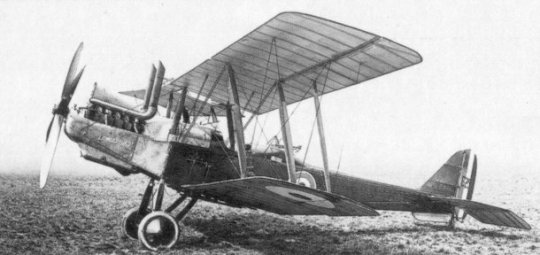
In 1915, the Royal Aircraft Factory began work on a successor to the B.E.2 under the designation R.E.8. The R.E.8 was another two-man tractor biplane design like most light bombers. While it generally retained most design elements of later B.E.2s, it mounted a much more powerful engine, vastly improving performance. The R.E.8 also made use of an improved crew layout, which put the observer/gunner behind the pilot, and, with the added power afforded by the new engine, the R.E.8 could carry a synchronized gun and a considerably larger payload. The first prototype flew in June 1916, with a second prototype sent to France the next month for service trails. With service trails going well, the type was rushed into production.
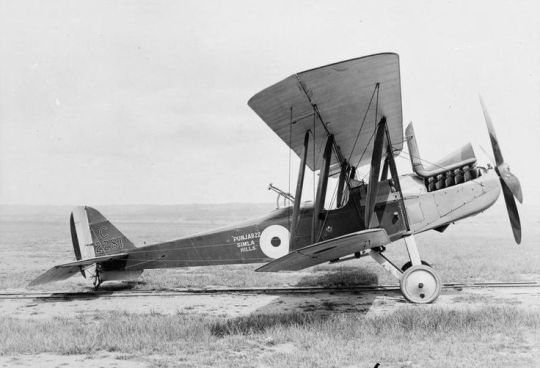
The first R.E.8s reached frontline units in France in November 1916. Unfortunately, the R.E.8 soon gained itself a reputation for being difficult to fly. It had a higher landing speed than the B.E.2s it replaced, which led to many accidents during transitions to the new type, and the aircraft gave almost no warning of stall, which cost the lives of several crews. Nevertheless, the R.E.8 was performing well with experienced crews, so production continued. The R.E.8’s debut would be less than auspicious. Making its operational debut in April 1917, their first operations coincided with what was known as “Bloody April,” where all RFC units suffered painfully high losses. Loss rates would drop as training improved an air superiority was regained, but the R.E.8 would never shake its unfortunate reputation it gained.

Though the R.E.8 was never too popular with crews, it did prove to be an effective aircraft. 18 RFC squadrons were flying the R.E.8 by 1917, becoming the mainstay of the RFC’s reconnaissance and light bomber force. Despite underwhelming performance, they managed to rack up an impressive score of victories, with 3 Squadron alone credited with 50 victories in 12 months of operations. Though the RFC planned to replace the R.E.8 with a variant of the Bristol Fighter by the end of the war, these plans fell through. Instead, one more operational squadron joined the R.E.8 fleet in 1918, sticking around until the end of the war. Despite its fairly good career in the war, however, it was quick to leave service after the Armistice. Now considered obsolete and surplus to requirements, R.E.8s were rapidly retired after the end of the war.
Airco DH.3

In 1916, Airco opted to produce a private venture design pitched to the War Ministry as a long-range bomber for hitting German industrial targets. Designed by Geoffrey de Havilland, who leveraged on experience working with the Royal Aircraft Factory, the DH.3 was a conventional two-bay biplane fitted with two 120hp Beardmore engines in a pusher arrangement between the wings. The bomber carried a crew of three, complete with two Lewis guns for defense and provisions for up to 680lb of payload. The first prototype, completed in 1916, was followed up by the DH.3A, which mounted 160hp engines. Unfortunately, the DH.3 would fall victim to biases within the War Ministry. The War Ministry saw no use in the strategic bombing mission the DH.3 was designed for, and any hopes for the type being ordered for tactical duties were dashed by the feeling among the War Ministry that twin-engined bombers were impractical.
Airco DH.4
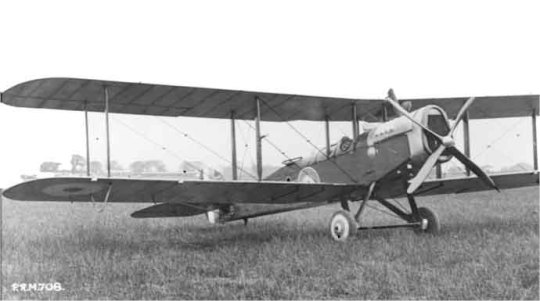
Parallel to the development of the ill-fated DH.3, Airco also had de Havilland working on a conventional single-engined bomber under the internal designation DH.4. At a glance, the DH.4 was unremarkable, being a conventional two-seat tractor biplane designed around a 160hp Beardmore engine. However, during development, the 200hp Beardmore B.H.P engine became available just as the prototype for the new aircraft was completed, so the DH.4 would be flown with the newer, more powerful engine instead. Taking flight in August 1916, the DH.4 performed respectably, demonstrating a good top speed and climb rate while being able to carry up to three machineguns (one synchronized, two defensive) and an external payload of up to 460lb of bombs. A second prototype, mounting the even more powerful Rolls-Royce Eagle, soon followed the first aircraft and went on to form the basis of the production design.
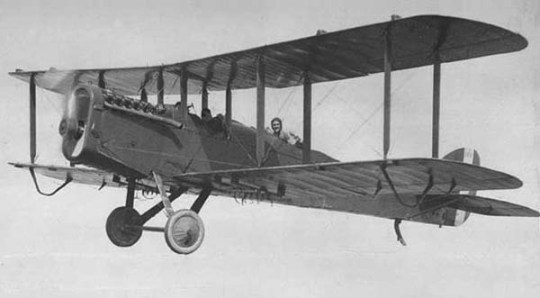
Unfortunately, though the DH.4 had been ordered into production, it would be hampered by a shortage of Eagle engines. To get the bombers to the front in a timely manner, Airco looked at reverting back to the original B.H.P engine before settling on three engines - the Royal Aircraft Factory RAF3A, Siddeley Puma, and 260hp Fiat. While these powerplants would allow the DH.4 to reach service, none of the powerplants offered anywhere near the performance of the Eagle. 55 Squadron would be the first to convert to the DH.4 in January 1917, deploying to France in March of that year. The DH.4’s combat debut came that April over Arras, where the type distinguished itself. Though its modest numbers hardly made a decisive impact, 55 Squadron was notably spared the carnage inflicted on the rest of the RFC aircraft participating in the battle. Thanks to its excellent speed and climb rate, the DH.4 was largely able to evade interception in these early operations.

DH.4 numbers gradually grew through 1917, peaking at the end of the year with six squadrons flying with the RFC and several more with the RNAS. The bomber grew to distinguish itself in combat, consistently showing itself to be agile enough to operate without fighter escort. Flaws were found in the design, however, mostly in the crew arrangement that placed the crew far from eachother in separate cockpits, making communication difficult. Though the DH.4 had proven itself in 1917, the development of the DH.9 caused the RFC to start drawing down the bomber by early 1918. Production lines switched over to the more promising DH.9, while engine shortages on the front gradually forced operational squadrons to stand down. Nevertheless, the DH.4 would persist thanks to the disappointing performance of the DH.9. Though the Liberty-engined DH.9A would solve the problems of the DH.9, it came late enough in the war that the DH.4 would never be completely retired before the Armistice. In fact, 55 Squadron would even be deployed as part of the Independent Air Force in June 1918 to perform daylight strategic raids into Germany, ending the war as the only day-bomber squadron in the IAF that didn’t have to stand down due to attrition. The last major use of the RFC’s DH.4s came after the Armistice, where the bombers were used as liaison aircraft for the Paris Peace Talks.
Royal Aircraft Factory F.E.2b
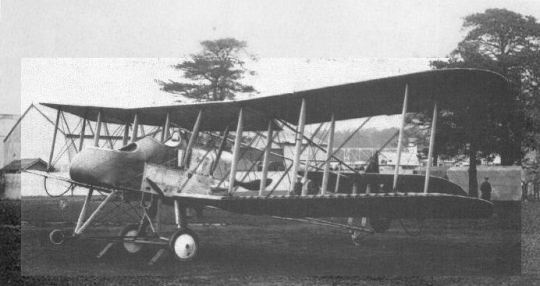
Though in its early career it had served as a fighter and reconnaissance aircraft, the F.E.2b would live out the end of the war as a night bomber. The two-man pusher-engined fighter had long since lost the advantage it held in the days of the Fokker Scourge, but the aircraft was hardly useless, so the RFC decided to repurpose it for night bombing. Capable of carrying up to 517lb of bombs, the F.E.2 would find new life in the night bomber role. The first night raid was conducted in November 1916, and in February of the next year the first specialist squadron was formed. Though such raids were purely tactical ventures, it became a popular practice. 860 F.E.2s were either built as or converted to the night bomber standard, and a total of eight squadrons would come to fly the night bomber variants. By the end of the war, F.E.2bs were even flying strategic missions with the Independent Air Force.
Airco DH.9

Following the success of the DH.4, de Havilland went to work on creating an updated version addressing the flaws of the design. Designated DH.9, the new aircraft retained the wings and tail of the DH.4, but revised the fuselage and engine. A new crew layout put the crew close together and placed the fuel tank away from the crew, and the promising new BHP/Galloway Adriatic engine was selected to keep the DH.9 competitive. The design caught the attention of the RFC very early on. Owing to the excellent projected performance of the type and ease of converting production lines of existing DH.4s to the new bomber, the RFC placed an order for nearly 5,000 DH.9s in mid 1917 before the bomber had even flown.
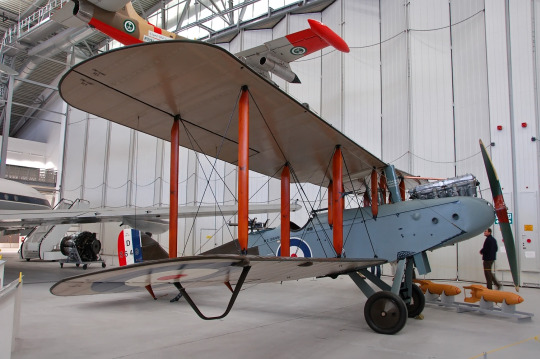
Unfortunately, when the DH.9 did finally fly in July 1917, it ran into major problems. The engine the bomber was designed around - originally rated at 300hp - was unreliable and ultimately de-rated to 230hp. The drop in power drastically cut performance, so much so that the DH.9 was actually outperformed by the very aircraft it was to replace. Nevertheless, orders were already being filled, so Airco scrambled to find adequate replacement engines. Deliveries to frontline units began in November 1917, with the DH.9 seeing its first combat in March of the next year. Unsurprisingly, the aircraft’s service was disastrous. Despite derating the engine for increased reliability, the DH.9 suffered from continuing engine failures, and its inadequate performance saw further aircraft lost to enemy action.
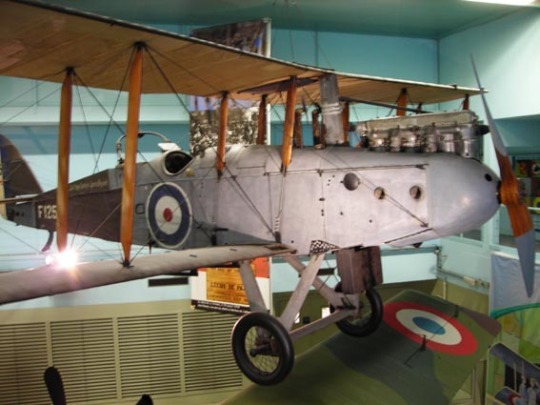
Despite a disastrous debut over Europe, the DH.9 would perform better in other theaters. 13 squadrons were kept at home (compared to nine in France) for antisubmarine patrols, and several others were deployed to the Middle East, where their long range made them useful in the clearer skies of the region. Ultimately, despite the disastrous debut of the DH.9, the production run was never cut. 3,204 were delivered by the Armistice, and by the time production had finally been halted by postwar drawdowns, 4,091 DH.9s had been built. However, the massive drawdown at the end of the war meant that the sub-par bomber was no longer necessary, so the DH.9 fleet was rapidly retired. Most of the last 800 DH.9s produced rolled straight from the factory to storage, and by July 1919, the last DH.9s had been struck from the RAF inventory.
Vickers Vimy
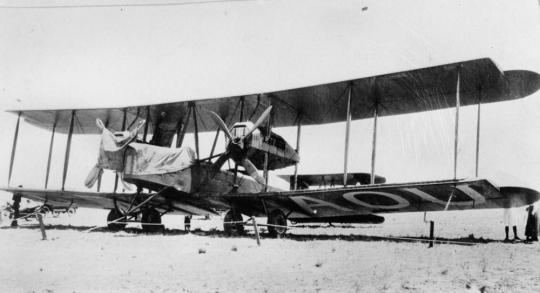
In 1917, Vickers began work on a new bomber to meet an RFC requirement for a twin-engined night bomber capable of hitting targets in Germany. Design work went quickly, with the bomber receiving a contract for three prototypes in August 1917 as the Vimy. The Vimy was an overall unremarkable bomber for the time, powered by two Hispano-Suiza 8 engines between the wings and fitted with Lewis guns in nose and dorsal positions for defense. Taking flight in November 1918, the bomber performed well enough to receive orders totaling 776 aircraft by war’s end. However, Vickers ran into supply difficulties with the new engine, delaying production while alternative powerplants were examined. Ultimately, variants were developed with the BHP Puma, Liberty, and Rolls-Royce Eagle engines, but by the time this was settled, the war was almost over.
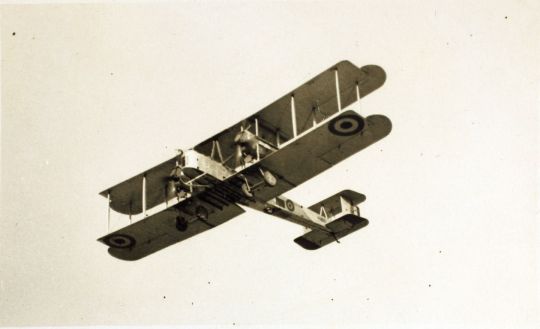
Ultimately, only three Vimys had been delivered to the RAF by the end of the war. At the end of the war, orders were slashed, with only the Eagle-powered Vimy orders remaining. A total of 239 Vimys would be built, with the bomber finally reaching operational service in July 1919. Fortunately, despite a late debut, the Vimy managed to be selected as the RAF’s standard bomber of the immediate postwar period. 11 squadrons would come to fly the Vimy, with deployments concentrated in the Middle East and Britain. They began to leave frontline roles in 1925, when they were replaced by the Vickers Virginia. However, in reserve and training units, the Vimy stuck around well into the next decade, with the final training aircraft not leaving service until 1938.
Airco DH.10 Amiens
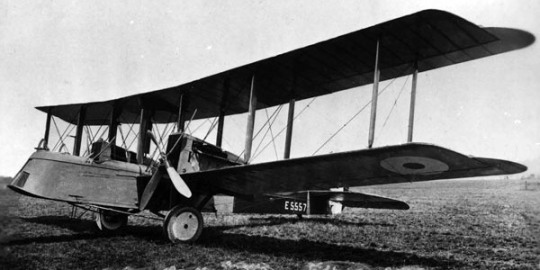
Though Airco’s first twin-engined bomber was rejected by the War Ministry, the onset of the German bombing campaign against England saw a sudden reversal of policy. In August 1917, the Air Board hastily ordered production of three new Airco bomber prototypes based off of the DH.3 but fitted with more powerful engines. By October, the design had taken shape as the DH.10, which boasted a similar appearance, but made use of the 230hp Siddeley Puma engine. First flying in March 1918, the bomber demonstrated poor performance. Owing to these issues, de Havilland conducted a radical redesign. The 360hp Rolls Royce Eagle engine mounted in a tractor configuration was substituted, finally meeting specifications. Unfortunately, the Eagle was already in use by countless other designs, so the bomber was designed once more to use the ubiquitous 400hp Liberty 12 engine from America. Following successful evaluation of this final design, orders for 1,291 DH.10s were placed.
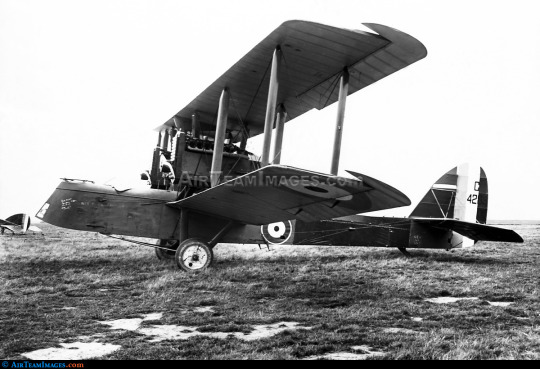
Unfortunately, the production delays would prevent the DH.10 from seeing any significant service. The first DH.10s were delivered to France only in September 1918, and the first and only combat sortie came the day before the Armistice. Following the Armistice, orders were slashed, and production ended with a little over 250 DH.10s built. Though many would go into squadron service, their career would be brief. 120 Squadron served out its career ferrying mail from Britain to the British occupation zone in the Rhineland, and 216 Squadron flew Cairo-to-Baghdad mail routes. The only squadron to actually see any combat use would be 97/60 Squadron, which supported ground troops in the Third Anglo-Afghan War. Most DH.10s were retired and sold off by the end of 1922.
Airco/Westland DH.9A
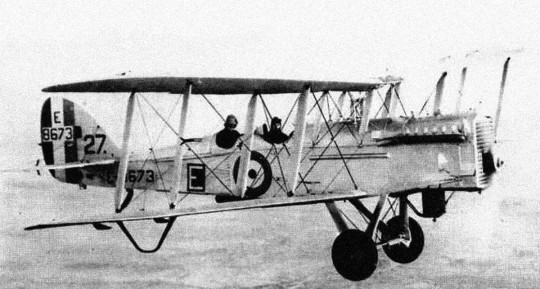
As Airco scrambled to find a suitable engine for the struggling DH.9, America had entered the war, opening up the possibility of using the 400hp Liberty engine. Airco themselves were occupied with design work on the DH.10, so the project was passed off to Westland. Westland reworked the design to accommodate the larger engine, test flying a DH.4 with the Liberty in October 1917. However, it took time for adequate supplies of Liberty engines to reach Britain, so, when the first DH.9A prototype flew in March 1918, it was actually fitted with a Rolls-Royce Eagle VIII - a powerplant that had previously been rejected due to shortages of the type. Apart from the new engine, the DH.9A also incorporated several improvements to the airframe. The wingspan was increased by 12%, while the structure of the fuselage was refined to strengthen it. Testing of the DH.9A went well, and orders totaling 2,250 aircraft would be placed.
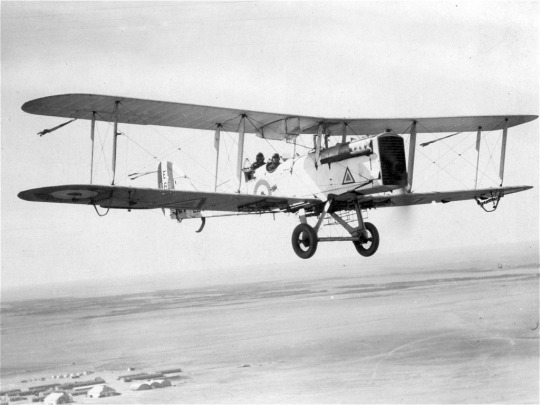
The DH.9A reached service in July 1918 with 110 Squadron, which deployed to France at the end of August, where it served as a strategic bomber with the Independent Air Force. The first combat mission came in September 1918, where the bombers hit a German airfield. By the end of the war, a total of four squadrons would be flying the DH.9A, while 885 DH.9As had been completed. Unfortunately, despite significantly improved performance over the DH.9, the DH.9As still suffered heavy losses on their daylight raids. In the two months they operated over Germany, they suffered the loss of 17 aircraft to enemy action and a further 28 in accidents.

Though the end of the war saw production of most aircraft cut, the DH.9A would have 1,730 of the originally ordered 2,250 filled following the Armistice. The DH.9A would grow to be the RAF’s standard light bomber of the early interwar period, flying with 24 squadrons to 1931. Their first major deployment came in 1919, when they were deployed to Russia in support of the White Army around Crimea in the Russian Civil War. Five squadrons were also deployed to the Middle East, where they were used to suppress rebels in the occupied former Ottoman territories. Though the DH.9A was gradually eclipsed by other light bombers, it remained a popular machine due to its reliability. As they were replaced in frontline units by more modern types, they were withdrawn to domestic squadrons before finally being shifted to the Royal Auxiliary Air Force as the first aircraft of the force. There, they remained in service until 1931.
Handley Page V/1500
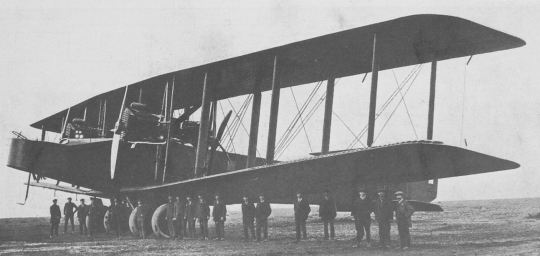
In 1917, the British Air Board set out requirements for a long-range bomber with a longer range than the Handley Page Type O already in service while carrying a 3,000lb payload. With the most experience with heavy bombers, Handley Page unsurprisingly won the competition with their V/1500 design. The V/1500 carried over many elements of the Type O - particularly the fuselage - but it had much larger wings and four engines in push-pull nacelles. It would carry a crew of up to nine, with defensive guns in nose, dorsal, and tail positions. Payload was up to 7,500lb of bombs carried in an internal bay. The first V/1500 took flight in May 1918, and very quickly orders were placed for a total of 210 bombers.
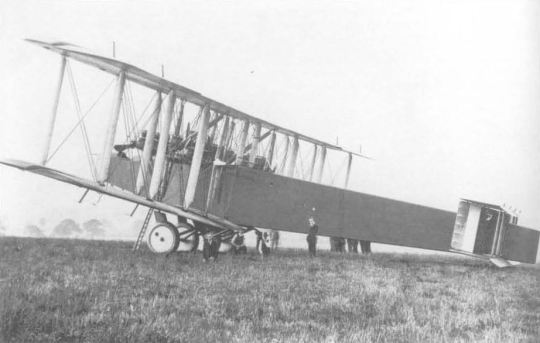
Though the first V/1500s reached their units in October 1918, their first mission wasn’t scheduled until November 8. Plans called for the bombers to hit Berlin before flying on to Prague (the Austrians had surrendered by then) to refuel and rearm, allowing them to hit Dusseldorf on the return flight. Unfortunately, the mission would never be flown. A series of engine changes delayed the mission until November 11, and, as the bombers were about to take off, they were halted due to the Armistice being declared. Because of the end of the war, production was cut to just 60 aircraft. Though the bomber would be the largest Entente aircraft to see service in the war, the V/1500’s operational use was fairly disappointing. The only actual combat use of the V/1500 came in the Third Anglo-Afghan War, where a single bomber hit the palace at Kabul with four 51kg bombs. There were plans to use the fleet to break several records, including making the first transatlantic flight, but these plans never panned out. In the end, the modest V/1500 fleet would be replaced by the considerably smaller Vickers Vimy.
Bristol Braemar

With the establishment of the Independent Air Force, Bristol was commissioned to create a new long-range bomber capable of hitting cities deep behind the front lines. Contracted as the Braemar, the new bomber was a large four-engined triplane with internal bomb bays for up to six 250lb bombs. Original plans called for the engines to be carried in the fuselage and geared out to propellers in the wings, but this was abandoned in favor of a far less complex push-pull mounting for the four engines in the wings. The first prototype Braemar flew in August 1918, powered by four 230hp Siddeley Puma engines. After showing generally good performance, a second prototype was built with minor improvements to the fuselage and more powerful Liberty engines. Unfortunately, this second prototype didn’t fly until early 1919, by which time the war was already over. Though the Braemar was promising, the postwar drawdown led to the cancellation of the development program.
Air Ministry Specification Types IV, VI, and VII
In 1918, the Air Ministry decided to begin development of a replacement for the DH.10 medium bomber before it had even entered service. Owing to the promising development of the new ABC Dragonfly radial engine, Type IV and VI specifications issued for the new bomber would require designers to make use of the new powerplant. The specifications saw a fair amount of interest, with Sopwith, Airco, Avro, and Boulton Paul all submitting proposals for relatively modest biplane bombers. In parallel, specifications for a night bomber were released with similar requirements, to which Nieuport responded. Unfortunately, the whole program would fall apart for a number of reasons. The end of the First World War saw the RAF reevaluate their needs, leading to the decision that the Vickers Vimy could meet RAF requirements in the immediate postwar period. Thus, most contracts were cancelled soon after the Armistice, and, though all competitors still did fly prototypes in hopes of attracting a production order, the complete failure of the ABC Dragonfly led to the abandonment of all the bombers.
Avro 533 Manchester
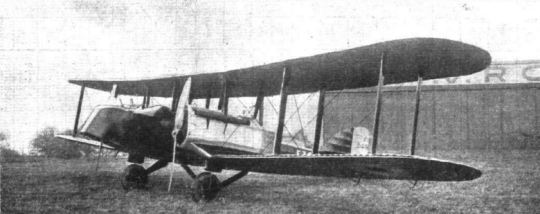
For the new bomber requirements, Avro developed an aircraft out of their failed Type 523 anti-zeppelin aircraft evaluated by the Admiralty. The Manchester, as it became known, shared the general layout used by most bombers of the time, with a three-man crew protected by two machineguns in nose and dorsal positions and engines mounted on either side of the fuselage. Original plans called for the Manchester to mount the ABC Dragonfly engine as per specifications, while payload was to be 880lb of bombs in an internal bay. Unfortunately, sluggish development of the Dragonfly engine meant that the first Manchester to fly would actually mount 300hp Siddeley Puma engines. Testing began in December 1918, and it wasn’t until a year later that a prototype was flying with the Dragonfly engines. However, the postwar drawdown eliminated the need for the new bomber, and, as the Dragonfly engine proved to be a failure, Avro abandoned development mid-testing. All prototypes, including a third aircraft yet to mount any engines, were scrapped.
Airco DH.11 Oxford

Airco’s proposal to meet the new bomber requirements would be another design from de Havilland. The DH.11 shared the layout of Airco’s previous twin-engined bombers, with an internal bomb bay and crew of three, but it made use of a deeper fuselage that spanned the entire interplane gap. Powered by two ABC Dragonfly engines as per specifications, the DH.11 was to carry a payload of up to 1,000lb of bombs. While defensive armament remained the same as Airco’s earlier bombers - just two machineguns - their field of fire was considerably improved by the new fuselage. Unfortunately, when the ABC Dragonfly proved to be a failure in 1918, work was temporarily suspended. Airco tried to rework the design with less powerful and heavier Siddeley Puma engines, but ultimately settled on the unreliable and underpowered Dragonfly. The DH.11 would finally fly for the first time in January 1919, demonstrating poor stability and handling. Testing continued for a short period until a structural failure forced the aircraft to be sent back to the factory for repairs. Unfortunately, as the DH.11 was undergoing repairs, the whole program was cancelled due to postwar budget cuts.
Sopwith Cobham
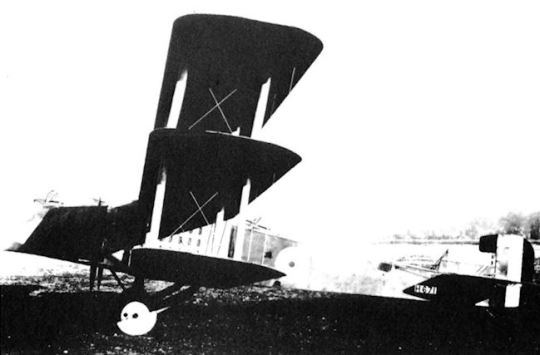
One of two triplane bomber design submitted would be Sopwith’s Cobham. The Cobham was another all-wood three-man design, differing from the other proposals submitted primarily in the extra wing. An internal bomb bay carried up to three 250lb bombs, while two Lewis guns were mounted in dorsal and nose positions for defense. Three prototypes were ordered. The first prototype was completed in December 1918, but because the Dragonfly wasn’t available yet, Siddeley Puma engines were substituted. With the new engines, the Cobham made its maiden flight in April 1919. Flight testing continued into 1920, with further prototypes mounting uprated Puma engines and newly arrived Dragonfly engines. However, the Dragonfly proved heavier than expected, forcing a major redesign of the wing structure. Ultimately, testing didn’t last long. The two Dragonfly-powered prototypes were scrapped when Dragonfly development halted in September 1920, and the final prototype would cease testing in late January 1921.
Boulton Paul P.7 Bourges

Boulton Paul’s contender, the P.7 Bourges, was a fairly unremarkable all-wood design. Defensive armament was two Lewis guns in nose and dorsal positions, while the aircraft was manned by a crew of three. The bomb bay was split into three compartments by structural members, creating three separate cells that had a total capacity of 900lb. Three prototypes were ordered by the Air Ministry. Unfortunately, delays in development of the originally specified Dragonfly engine meant that Boulton Paul would be forced to substitute the far less powerful Bentley BR2 rotary engine for the first prototype. The Bourges would first fly in June 1919, with Dragonfly engines being fitted the next month. The Bourges did demonstrate excellent performance with the new engines, reportedly being able to perform a loop. The excellent performance was apparently enough to warrant further development. A second prototype was fitted with a gull wing to improve the gunners’ field of fire, and in 1920 a third prototype was built. Though the Dragonfly engine had since proved a failure, the Bourge would continue to fly, this time powered by 450hp Napier Lion engines. Unfortunately, while the Bourges continued to prove successful, the RAF had since abandoned the requirement for the new bomber. The prototypes would serve on as test aircraft at the Royal Aircraft Establishment until 1924, but no production order was ever placed.
Nieuport London
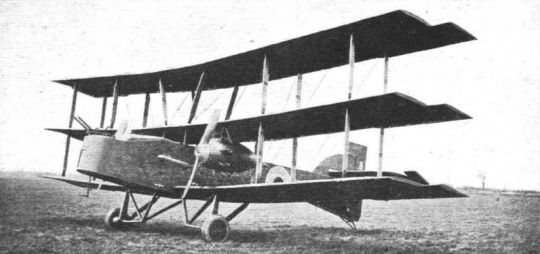
The second triplane design submitted to the new specifications was the Nieuport London. Designed to meet the night bomber requirements, the London was the most unique of the Dragonfly-engined bomber designs. Consisting primarily of wood, the bomber featured two-bay unstaggered wings with ailerons fitted to every wing. Payload was heavy, with internal bays providing for a capacity of nine 250lb bombs, while, because the bomber was to operate solely at night, defensive armament was limited to just two Lewis guns in a nose position. Six prototypes were ordered, though four were cancelled in December 1918 with the end of the war. Delays in development of the Dragonfly engine meant that the London wouldn’t fly until April 1920. Despite the delays, the London generally seemed promising, showing good handling and performance despite a rudimentary structure. Though any hopes of the design serving as a bomber were dashed by the dropping of the requirement by the RAF, Nieuport had plans to convert the design to an airliner. Unfortunately, those plans would never materialize, as Nieuport and General closed in August 1920.
Tarrant Tabor

After securing patents for various elements of aircraft structure, the woodworking company Tarrant Ltd hired Walter Barling of the Royal Aircraft Factory to develop a long-range heavy bomber for the company. Original plans called for the bomber to be a large biplane powered by four Armstrong Siddeley Tiger engines in tandem pairs. However, when it became clear that the engines were delayed, the aircraft was completely redesigned. Six Napier Lions were mounted, and a third wing was added, turning the aircraft into a triplane. The fuselage itself was a finely streamlined monocoque structure with a capacity of six crew and up to 9,000lb of cargo. However, it had no bomb bay, with payload of 4,600lb instead supposed to be carried under the bottom wing. The resulting aircraft was massive - it came in at a loaded weight of 20 tons. Though the end of the war put an end to the bomber’s prospects, work continued with the aircraft serving as a transport. Ultimately, the Tabor began testing in May 1919. During what would have been its first flight, the upper two engines caused the aircraft to nose-over on takeoff, killing the two pilots and injuring all aboard. The crash marked the end of the program, and Tarrant would never again make an aircraft.
De Havilland DH.14 Okapi
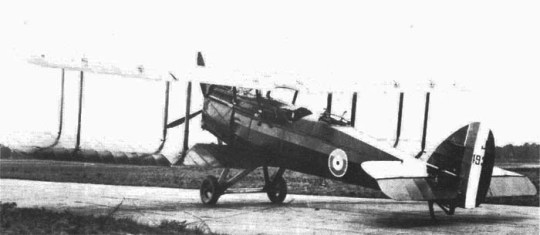
As the end of the First World War neared, the Air Ministry issued requirements for a medium bomber to replace the DH.4 and DH.9. Though Airco was no more, de Havilland continued to design aircraft, so unsurprisingly it would be de Havilland’s DH.14 that would receive a contract for prototypes. The Okapi was a scaled-up version of de Havilland’s earlier single-engined bombers, retaining its two man crew but making use of a more powerful Rolls Royce Condor engine. Though armament remained identical to the bombers it was to replace, the larger design meant that the DH.14 could accommodate its payload in an internal bomb bay. Unfortunately, by the time the DH.14 finally flew, the war had ended and the RAF was reluctant to accept the bomber. Ultimately, the RAF would only accept two of the originally ordered three prototypes, with the third hastily converted to serve as a mailplane. The postwar drawdown meant that the Okapi would see no production, and its career was limited to a high-profile record attempt flight in private hands.
Siddeley-Deasy Sinai
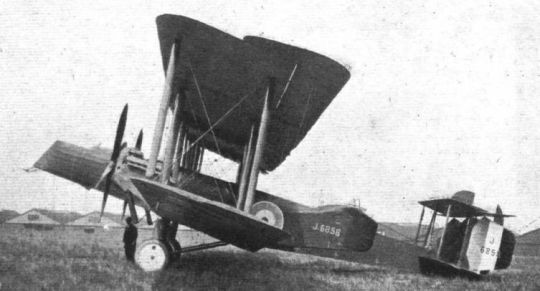
In response to a new Air Ministry requirement for a day bomber, Siddeley-Deasy produced the firm’s only bomber - the Sinai. The Sinai was a fairly conventional twin-engined biplane bomber, standing out mostly in the large nacelles the engines were placed in. These wing nacelles extended well aft of the wing, holding a position for a gunner. The bomber also made use of an experimental new powerplant - the Siddeley Tiger - which would end up dooming the project. The Tiger had seen little testing before being selected as the powerplant for the Sinai, and frequent issues with the engine meant that fight testing of the bomber would be delayed until June 1921. By then, the need for such a bomber had long since evaporated, so once the Sinai started showing structural issues in October 1921, it was retired.
Air Ministry Specification 2/20
In 1920, the Air Ministry began the process of modernizing the postwar inventory with a new set of requirements for a single engined bomber. The new bomber, which was to be powered by the Rolls Royce Condor engine, was to have a range of 500 miles and payload of 2,000lb with the capacity to carry a single 1,800 SN bomb (though this would change to four 500lb bombs externally or eight 250lb bombs internally). In addition, the bomber was to be able to operate in both day and night bomber roles. Only Avro and de Havilland would submit designs for the new requirements. Ultimately, the results were underwhelming. Though Avro would be declared winner, the Air Ministry quickly decided to abandon the concept of a single-engined night bomber, so Avro’s winning design never saw much use.
Avro Aldershot
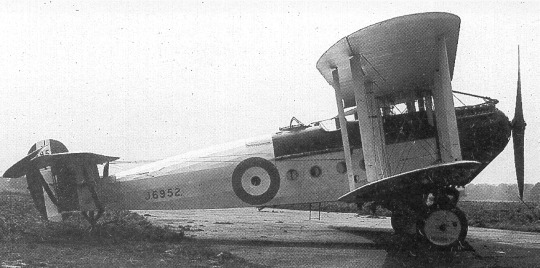
Avro’s contender to the new requirements, the Aldershot, was a mixed-construction biplane. The Aldershot featured a deep fuselage, allowing the aircraft to accommodate both a bombardier’s station and an internal bomb bay. The pilot and navigator/bombardier sat side by side under the wing trailing edge, with a cabin behind them in the fuselage for bomb-aiming and access to a ventral gun position. Behind that, a gunner sat in an open position. The Aldershot first flew in October 1921, flying off against the de Havilland Derby late the next year. It proved to be a superior aircraft, both in that it met specifications by having an internal weapons bay and by being considerably lighter thanks to its mixed construction. An order for 15 Aldershots was placed in early 1923, with the aircraft entering service with 99 Squadron in April 1924. Unfortunately, the Aldershot’s career was brief. After a year of training and exercises, primarily at night, the Air Ministry changed its policy, shifting away from the use of single-engined heavy bombers. The Aldershot was phased out, and the sole squadron operating the type shifted over to the Handley Page Hyderabad in early 1926.
De Havilland Derby

De Havilland’s design, contracted as the Derby, was a conventional all-wood biplane with a crew of three. A pilot was placed just under the leading edge of the wing, while an observer/gunner was placed aft of the wing. Buried in the fuselage between them, a navigator/bombardier station was installed for the third crewman. Though specifications called for the bomber to be capable of carrying some payloads internally, the Derby had no bomb bay. Two prototypes were built, the first of which flew in October 1922. Unfortunately for de Havilland, the Derby was vastly outperformed by the Avro Aldershot it competed against. Not only did the Aldershot have an internal weapons bay, but its mixed construction also left it 800lb lighter than the Derby. Thus, no production of the Derby was ordered.
Vickers Virginia

In 1920, Vickers began work on a successor to the Vimy that was then serving as the primary bomber of the RAF. Heavily derived from the Vimy, the resulting Virginia was an overall refinement of the bomber. The nose gunner’s position was lowered to improve the pilot’s view, and the wings and fuselage were enlarged. The prototype was fitted with two Napier Lion engines, and, though it was deleted on production aircraft, a gunner position was added on top of the upper wing. The design caught the attention of the RAF, who ordered several prototypes. The first of these prototypes took flight in November 1922. Results were hardly promising, with the Virginia demonstrating mediocre performance, but nevertheless it received a sizeable order for over 100 aircraft.
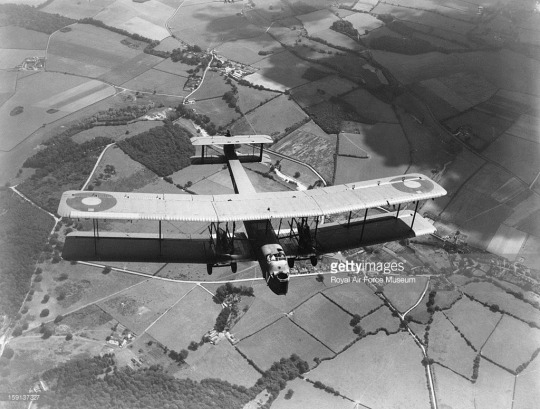
The Virginia would enter service in 1924. Though performance was never really exceptional, the type persisted until almost the outbreak of war in frontline units owing to the constant progressive improvements to the design. Later marks added a sweep to the wings, and the final variant even transitioned to an all-metal construction. Thanks to these constant upgrades, it wouldn’t be until the Heyford entered service in 1934 that the Virginia lost its title as the most numerous bomber in RAF service. Even then, the Heyford never replaced the Virginia, instead supplementing their numbers. Only in 1938, with the arrival of Britain’s first generation of modern monoplane bombers did the Virginia finally begin to leave service. As Virginias were phased out of frontline roles, they were shifted off to experimental and training duties. Some were used in experiments with midair refueling, while others served as parachute trainers. Thanks to this, the Virginia would remain in RAF service until late 1941.
Fairey Fawn
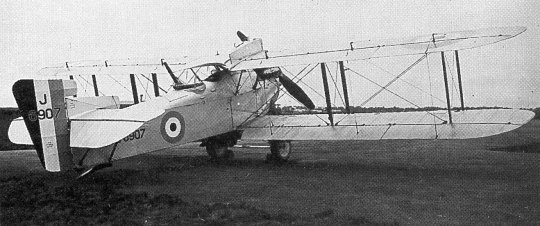
In the early ‘20s, the RAF was in search of a replacement for the DH.9A. Fairey was selected to produce a new light bomber, with contracts for three prototypes of what would be known as the Fawn placed. The Fawn was a conventional single-engined bomber powered by a Napier Lion, with the only unique feature of the design being the fuel tanks mounted atop the upper wing. Flight testing began in March 1923. Though the Air Ministry ended up ordering a total of 75 aircraft, the Fawn was generally a failure. When it entered service in 1924, it was found that it was actually no faster than the DH.9A it was to replace. Visibility was also poor, and ultimately only three of the originally planned seven squadrons were equipped with the Fawn. Meanwhile, the DH.9A continued to serve alongside it until both were replaced in 1926 by the Hawker Horsley and Fairey Fox.
Parnall Possum

At the end of the First World War, Bristol proposed a large bomber concept with engines buried in the fuselage and geared out to propellers in the wings. The concept caught the attention of the Air Ministry, who decided to commission Parnall and Boulton Paul to create smaller-scale demonstrators. Parnall’s demonstrator, the Possum, was a three-man triplane design fitted with a single engine in the fuselage. Gunners were placed behind the wings and in the nose, but, being primarily an experimental aircraft, no provisions for carrying bombs were made. The single engine was geared out to a propeller in either middle wing, with the propellers spinning in opposite directions. Testing began in June 1923, and the next year it was passed on to the Royal Aircraft Establishment. A second prototype was built in 1925, with both being tested extensively. Unfortunately, though both prototypes seem to have performed without any major issues, the Air Ministry went no further with the concept.
Boulton Paul Bugle

In 1922, Boulton Paul was contracted to develop a twin-engined medium bomber known as the Bugle. Drawing heavily on the Bolton and Bourges twin-engined aircraft, the Bugle made use of two Jupiter engines mounted between the wings. A deep, angular fuselage carried a crew of four, including gunners in nose and dorsal positions,and an external payload of up to 690 lb of bombs was to be carried. The first Bugle would fly in June 1923, followed by a second prototype later that year. Three more were built in 1924, fitted with shorter wings, and in 1925 all began operational evaluation tests. Two final aircraft were ordered in early 1924, differing from the others by their use of Napier Lion engines. Unfortunately, though operational evaluations went without incident, no further orders came due to funding cuts.
Handley Page Hyderabad
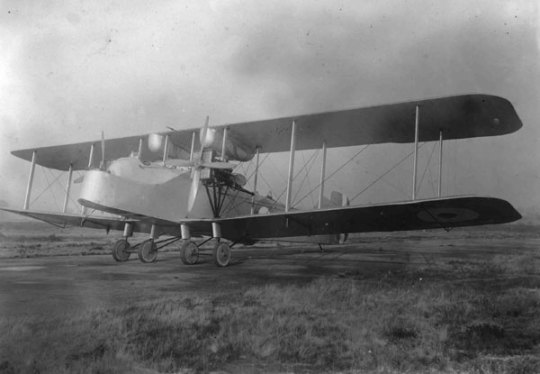
Though the Vickers Vimy would become the standard bomber for the RAF in the immediate postwar period, by the early ‘20s its age was showing. Thus, the Air Ministry issued requirements for a two-engined bomber to replace it in night bomber roles. Handley Page would respond with a derivative of their W.8 airliner, which was contracted as the Hyderabad. The Hyderabad would be a four-man machine fitted with three machineguns for defense in nose, dorsal, and ventral positions. Power was to come from two Napier Lion engines in the wings, and, seemingly regressing from the bombers of the First World War, the Hyderabad would carry its payload of 1,100lb of bombs externally. Though most of the design was generally unremarkable, the bomber was one of the first large aircraft to be fitted with Handley Page’s leading edge slats.

The Hyderabad would fly for the first time in October 1923. Testing took over a year, but by the end of 1925 the Hyderabad had entered squadron service. With this, the Hyderabad became the last all-wood heavy bomber to enter RAF service. Unfortunately, deliveries went slowly and operational accidents were high. It took until 1928 for the second squadron to form, and the two reserve squadrons to fly the type would later be re-equipped with the all-metal Hinaidi instead. Ultimately, production halted with less than 50 built, and the bombers were out of service by 1933 without ever seeing operational use.
Boulton Paul Bodmin

Parallel to Parnall’s Possum demonstrator, Boulton Paul was contracted to develop the Bodmin, a larger demonstrator for a similar concept. The Bodmin was a large twin-engined biplane, with two Napier Lion engines placed in tandem in an engine room in the fuselage. Geared out from the fuselage, the engines drove two propellers between the wings with driveshafts going through a streamlined fairing with the radiators on their leading edge. Gunner positions were placed in the nose and behind the wings, and provisions were made for a dedicated engineer to be carried in the engine room. The first of two Bodmins would fly in early 1924. Testing found minor issues relating to driveshafts and cooling the engines, but overall the design was workable. Though the undercarriage would fail on the first prototype during testing, the second would keep flying, allowing trials to be completed. Ultimately, though the Bodmin proved the concept to be sound, no further development of the concept was undertaken.
Avro 557 Ava
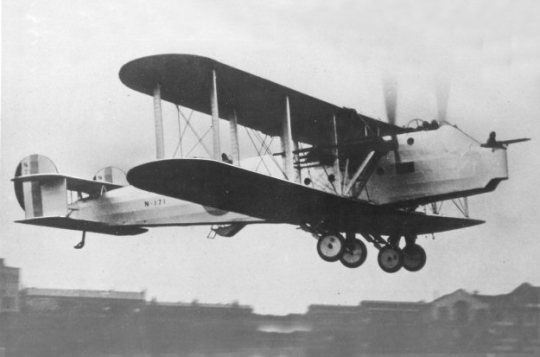
In response to a 1922 specification for a long-ranged land-based torpedo bomber, Avro was contracted to develop the Ava. The Ava originated as a large biplane powered by a Napier Cub engine, but this was rejected, prompting Avro to rework the basic design into a twin-engined machine powered by two Rolls Royce Condors. The Ava was designed around a fuselage capable of carrying a 21-inch torpedo, with a secondary capability to carry an equivalent load of bombs. A crew of five, consisting of two pilots sitting side-by-side and gunners in nose, dorsal, and retractable ventral positions was accommodated with a large enclosed cabin. The Ava would first fly in 1924, with the first prototype being all-wood in construction. Unfortunately, over the course of testing, the Air Ministry dropped the requirement. Avro continued work on an all-metal second prototype, which flew in 1927, in hopes that it would be ordered by the Air Ministry to meet a new heavy bomber requirement. However, it was unsuccessful, leading to the abandonment of the project.
Blackburn Cubaroo
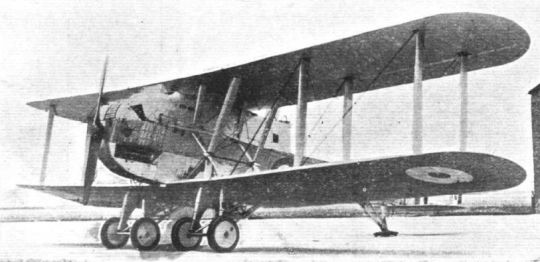
In 1921, the Air Ministry had issued specifications to Blackburn for a coastal defense torpedo bomber. As Blackburn worked on a new design, the specification had been revised, calling for a long-range machine capable of deploying the new 21-inch torpedo. Blackburn would create a massive single-engined design using the new 1,000hp Napier Cub engine known as the Cubaroo. The Cubaroo carried a crew of four in a deep fuselage, with defensive guns placed in waist and midships positions. The bomber itself was of mixed construction, and, owing to its massive 88ft wingspan, it was configured with folding wings. The torpedo (or an equivalent load of bombs) would be carried externally under the centerline. The first Cubaroo prototype flew in mid 1924, showing good handling. It was submitted for evaluations later that year, only for it to be written off after the undercarriage collapsed in early 1925. The second prototype would be delivered later in 1925, but by then the Air Ministry had abandoned plans to develop a bomber to carry the 21-inch torpedo. Thus, the second prototype would live out its career as an engine testbed.
Air Ministry Specification 26/23
In August 1923, the Air Ministry issued new requirements for a two-seat light day and night bomber to be powered by the Rolls Royce Condor engine. Additionally, the specifications required an all-metal construction, 550lb payload, and 500 mile range. Hawker, Bristol, Handley Page, and Westland would respond with proposals. All four submitted designs were largely similar in layout, being tractor biplanes not unlike the ubiquitous light bombers of the First World War. Prototypes were produced and flown through 1925, but by the time comparative testing had begun, the RAF had decided against procuring more single-engined night bombers. Thus, the specifications were revised, dropping the night-bomber requirements and increasing the specified payload to allow the bomber to carry both conventional bombs and a torpedo. The new specifications ultimately disqualified most contenders, leaving only Hawker’s Horsley to be selected for production.
Handley Page HP.28 Handcross
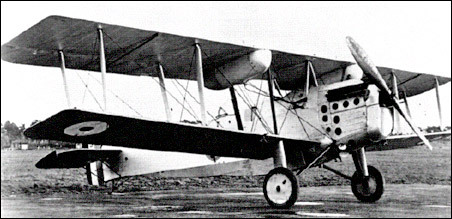
Handley Page’s Handcross would be the first proposal to take flight, flying in early December 1924. The Handcross was a wood-and-canvas design with unstaggered wing and slab-sided fuselage, giving it an outwardly unimpressive appearance. Payload was to be carried in a recessed position under the fuselage, while the rear gunner had a spacious position in the aft fuselage where he could move between a dorsal gun mount, fixed rear-firing machinegun, and a bombsight in the aircraft’s belly. Three prototypes were ordered, with all three aircraft being submitted to the RAF for testing in 1925. Testing led to several modifications, with the ventral gun position deleted due to the adverse draft it produced in the fuselage, fuel tanks relocated due to vibrational issues, and exhaust pipes modified to reduce flame dazzle. Despite the improvements, however, the Handcross failed to impress during competitive trials later that year. Though no production order was placed, the machines remained with the RAF for testing until 1928 for various purposes.
Bristol Berkeley
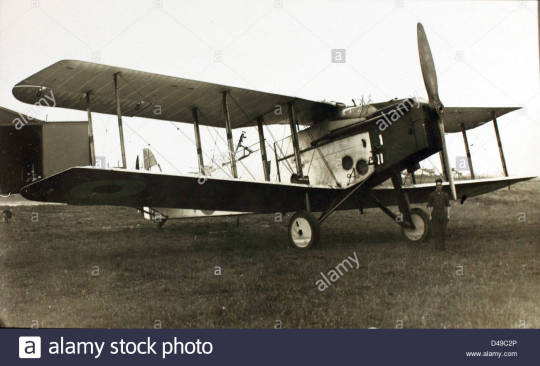
Despite the request that the submitted designs be of all-metal construction, Bristol’s Berkeley bomber would be the only submitted design to actually follow those guidelines. With a metal-framed fabric-covered fuselage and duralumin wings, the Berkeley had the crew positions sitting far from eachother on either side of the wing. The observer manned the only machinegun on the aircraft in an open dorsal position, and a ventral bombsight position was placed low in the fuselage for the observer to use. The Berkeley would fly for the first time in March 1925, reaching the RAF for trials in May. The Berkeley was one of the larger machines submitted and was generally considered more suitable for the night bomber role, but the Air Ministry had since dropped plans to continue flying single-engined night bombers, so the advantage was negated. The Berkeley was not selected for production, and the final two prototypes ordered were passed directly to the Royal Aircraft Establishment for experimental testing. There, they lived out their careers primarily testing propellers until being retired in 1930.
Westland Yeovil
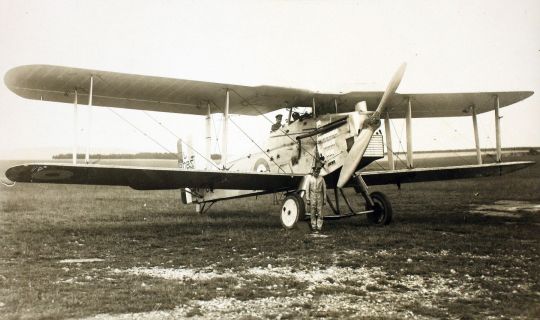
Westland’s contender to the new bomber requirements, the Yeovil, was a smaller design of mixed construction. The Yeovil made use of staggered wings, and the crew positions were separated on either side of the wing. For defense, machineguns were provided in dorsal and ventral positions, and, harkening back to the First World War, a synchronised forward firing machinegun was also added. Three prototypes were ordered, all of which would fly by the end of 1925. Unfortunately, though the Yeovil demonstrated no glaring flaws during evaluations, the design was not suited to meet the recently revised specifications. As such, no production was ordered, and the three prototypes were passed on to research and experimental testing.
Hawker Horsley

Hawker’s bomber proposal completely ignored the all-metal construction requirements, instead creating the wooden Horsley. The Horsley was a two-bay design fitted with a twin-Lewis gun mount in a dorsal position for defense, as well as a radio and ventral bombardier’s position in the aft fuselage. Unlike all other competitors, the design was fitted with dual controls. The Horsley would first fly in March 1925, with prototypes submitted for evaluation in May. Though specifications had since been revised, the Horsley proved more than capable of handling the sudden increase in payload, allowing it to be selected as the winner of the design competition. An initial order of ten all-wood Horsley Mk Is and 30 mixed-construction Mk IIs were ordered, with deliveries beginning in early 1927.
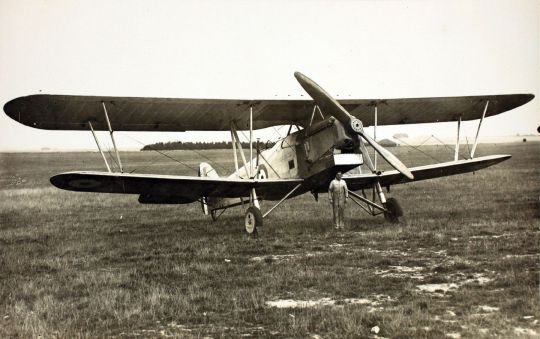
The first Horsleys entered service in September 1927, replacing the Fairey Fawn. The Horsley proved vastly superior to the Fawn in everything from payload to performance and agility, and overall it was a popular aircraft with crews. In 1928, the first torpedo-bomber squadron was formed, transferring to Singapore in 1930. There, it saw its only operational service, where the torpedo bombers flew conventional bombing missions against Burmese rebels. The Horsley’s career was ultimately fairly uneventful, with the last day bomber squadron phasing out their bombers in 1934 for Westland Wallaces and the final torpedo bomber squadron retiring the aircraft in 1935. Examples persisted as testbeds for several more years, but by 1938 the last Horsley was retired.
Boulton Paul Sidestrand

Though none of Boulton Paul’s earlier projects had received production orders, the promise shown by the designs had prompted the Air Ministry to issue new specifications to the company in 1924 for an all-metal twin-engined medium bomber. Taking shape as the Sidestrand, the bomber was designed around two Napier Lion engines. It was fitted with guns in nose, dorsal, and ventral positions, and provisions for a payload of up to 1,050lb of bombs were made. The first Sidestrand flew in 1926, fitted with Bristol Jupiter rather than Napier Lion engines. 20 Sidestrands would be built, reaching the sole squadron to fly the type in 1928. They proved to be stable and maneuverable aircraft just like Boulton Paul’s earlier bombers, but they failed to attract further orders. They would live out their career without ever seeing combat. Four were converted to the Overstrand standard intended to replace the Sidestrand, while the remaining aircraft served on until 1936.
Handley Page Hinaidi
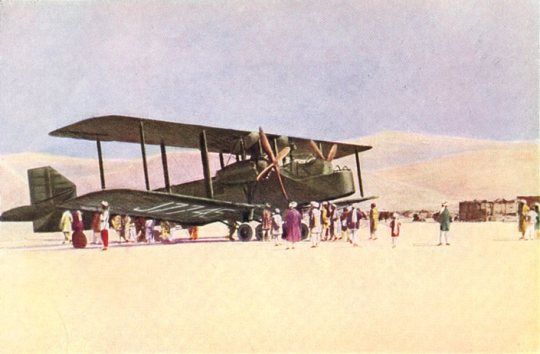
Even as the first Hyderabads were entering service, Handley Page had developed an improved variant to meet new Air Ministry specifications for the same role. Contracted as the Hinaidi, the prototype that would fly in March 1927 was actually converted from a Hyderabad. The original Hinaidi was little more than a Hyderabad fitted with more powerful Bristol Jupiter engines and a more racks for bombs, but, after the successful testing and service of seven aircraft converted to the new standard, Handley Page developed an all-metal variant that would go on to be make up the bulk of production. A total of 36 Hinaidis would be made or converted, with most entering service in 1929. Three squadrons would come to fly the bomber. Like the Hyderabad, their service was brief and uneventful, though several of their number would be converted to transports for colonial duties.
Air Ministry Specifications 23/25 and 24/25
Though the Horsley would serve well for the time being, the Air Ministry was quick to begin looking for a replacement. In 1926, two parallel requirements were issued for a two-seat torpedo bomber and day bomber (23/25) and high-altitude light bomber (24/25) to replace the Horsley in its respective roles. Though these were two separate requirements, they were similar enough that two contenders - Handley Page and Blackburn - would develop a design to meet both simultaneously. Others were not so ambitious. Gloster, Hawker, and Vickers would develop designs to meet just the torpedo bomber requirements, while Westland would be the only other company to produce a design for the high-altitude bomber requirement.
Gloster Goring
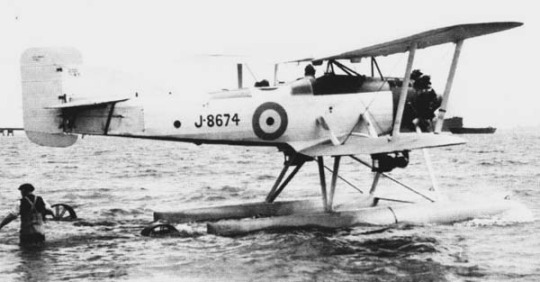
Gloster would produce their contender to the two requirements, the Goring, fairly quickly. The Goring was a fairly conventional single-engined bomber design, with the most notable design element being the slight inverted-gull layout of the lower wing, which aimed to reduce the size of the landing gear. Considerable work was done to make the design adaptable to a variety of roles, with three easily interchangeable variants of the landing gear developed. The original gear had a simple single axle, though split-axle and twin-float landing gear was also developed for torpedo bombing duties. The Goring would be the first aircraft designed for these specifications to fly when it took flight in March 1927, but it wouldn’t be until the next year that the aircraft was submitted for testing, as Gloster was busy up-engining the aircraft. Unfortunately, the Goring fell short of specifications, so it was returned to Gloster in 1930. With Gloster, the Goring was converted to a seaplane and fitted with an even more powerful engine before serving out the remainder of its career as an engine testbed.
Westland Witch
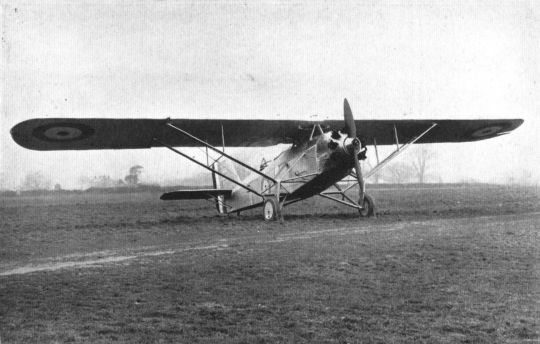
Westland’s contender to the high-altitude bomber requirements would be the Witch - a mixed-construction parasol monoplane. The Witch shared the layout of contemporary single-engined bombers, with a ventral bombardier’s position in the aft fuselage and single defensive machinegun in a dorsal position. A bomb bay separated the crew, providing space for a number of small bombs or a single 520lb bomb. Due to the planned high-altitude flight profile Westland planned to make use of the turbocharged Bristol Orion engine for the bomber. However, owing to development difficulties with the Orion, Westland would substitute the Jupiter engine the Orion was derived from for the prototype. Testing began in late January 1928, with generally good results. The Witch was seen as a fast, stable bombing platform, and generally it demonstrated good performance. However, structural deficiencies were found in the design, leading to the design being declared unsuitable for operational service.
Blackburn B.T.1 Beagle
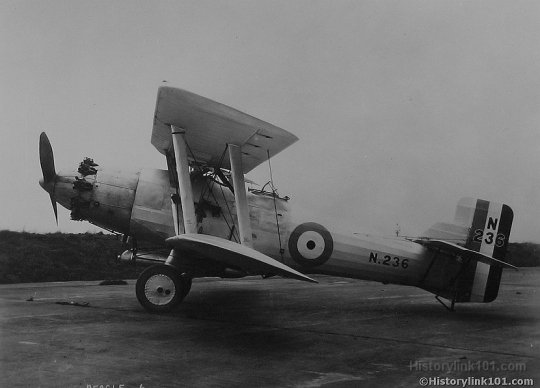
The Blackburn Beagle would originally be designed to meet the high-altitude bomber specifications, only to be refocused on the torpedo bomber requirements. The Beagle was a mixed-construction design with a steel-tube fuselage and slightly swept, staggered wings. Unlike many of the aircraft it competed against, the crew were placed very close together, and the bombardier’s station was actually placed underneath the pilot. The landing gear, split to allow for the carriage of a torpedo under the centerline, was configured to also hold a large fuel tank for long-range reconnaissance duties. The Beagle would first fly in February 1928, though it wouldn’t be until mid 1929 that it began competitive trials. Ultimately, none of the aircraft were able to meet specified requirements, but the favorable performance and handling of the Beagle saw it pass on to further testing against the Vickers Vildebeest and Handley Page Hare. The Beagle was sent back to the factory to receive a more powerful engine, but by the time it returned to testing, the Vildebeest had already been declared winner. Having lost the competition, the sole Beagle would serve on as a test aircraft until 1933.
Hawker Harrier
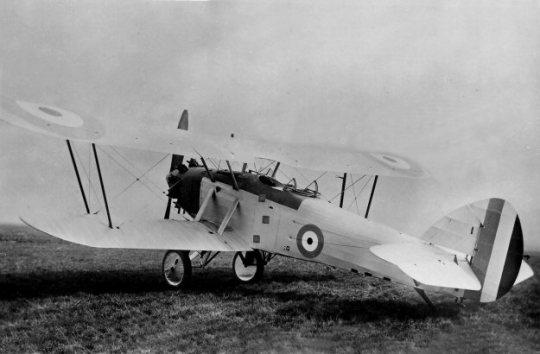
Hawker’s proposal to meet the two bomber requirements was the sleek but otherwise unremarkable Harrier. Fitted with two machineguns and designed around a payload of 1,000lb of bombs or a single torpedo, the Harrier was powered by a geared Bristol Jupiter engine. The Harrier first flew in February 1928, with the aircraft delivered for acceptance testing later that year. Unfortunately, testing went poorly. Though the Harrier had excellent handling, the geared engine left the Harrier underpowered and the design featured a lower payload than the Horsley it was to replace. Nevertheless, it was modified for torpedo testing, only for crews to find that the Harrier was unable to take off with a torpedo, crew, and full load of fuel. Thus, it was excluded from the final phase of the competition.
Handley Page HP.34 Hare
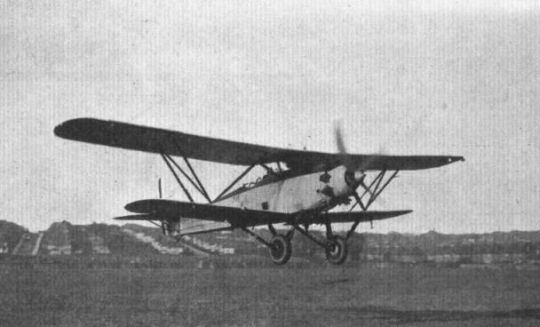
Handley Page’s contender to both requirements was a mixed-construction sesquiplane that would be contracted as the Hare. The Hare was a fairly compact design fitted with a forward firing and flexible rear firing gun for defense and provisions for a single 2,000lb torpedo to be carried under the centerline. Like previous Handley Page bombers, the Hare featured a bombardier’s position under the gunner’s position. The sole Hare prototype flew for the first time in February 1928, powered by a Gnome Rhone Jupiter engine owing to shortages of the planned Jupiter VIII. Unfortunately, testing revealed serious handling and vibrational issues. Handley Page alleviated these by lengthening the fuselage. Unfortunately, the Hare failed to win either competition it was entered in. Vickers ended up winning the torpedo bomber contract, while the high-altitude bomber program was dropped altogether.
Vickers Vildebeest/Vincent

The Vickers proposal to the torpedo bomber/light bomber requirements, the Vildebeest, was perhaps the least remarkable of all designs. With equal-sized unstaggered wings and an all-metal fuselage, the Vildebeest would be the last of the competing designs to fly when it took to the skies in April 1928. When submitted for testing, results were just as poor as all the competitors, with the Vildebeest failing to meet specifications. However, the type demonstrated favorable handling, securing it a place in a second round of evaluation. Vickers quickly reworked the aircraft with a more powerful Armstrong Siddeley Panther engine, which allowed it to beat out its competitors. Though vibrational issues plagued the new engine, forcing Vickers to revert back to a Jupiter variant, the production order was secured in 1931, making the Vildebeest the RAF’s new coastal torpedo bomber. In parallel, Vickers offered an Army Cooperation variant dubbed the Vincent, which also secured a production order.
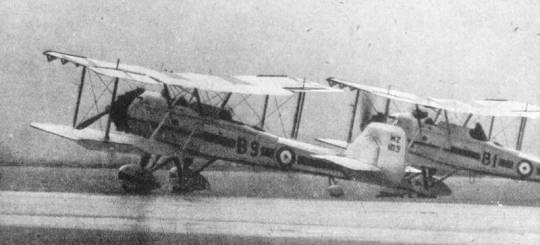
The Vildebeest would enter service in October 1932, coming to fly with two torpedo bomber squadrons in Britain and two more in Singapore. The Vincent was put on lower priority, meaning that it wouldn’t enter service until the end of 1934. Nevertheless, it would see considerable use as well, with the aircraft flying with six general purpose squadrons in the Middle East and East Africa. 101 Vildebeests and 84 Vincents were still in RAF service when war broke out in 1939. In Britain, the Vildebeest served in coastal patrol and convoy escort roles until finally replaced by the Beaufort in 1940. Vincents were also on their way out in favor of more modern bombers, but they too saw considerable use in the Ethiopian campaign in 1940 and later during the uprising in Iraq. The last Vincents would serve on until 1943. The two Vildebeest squadrons in Singapore had yet to receive their replacements when Japan invaded at the end of 1941. They made desperate but futile attempts to stop the Japanese advance, suffering heavy losses despite fighter escort. At the end of January 1942, they were withdrawn to Java, and, in March 1942, the last Vildebeests were retired.
Air Ministry Specification 12/26
In 1926, the Air Ministry issued new specifications for a single-engined high-speed day bomber. Unlike many other specifications, high performance was the stress of the new program, with specifications calling for a top speed of 160mph. Hawker, Avro, and de Havilland were asked to submit tenders for the new specifications. Fairey, who had not been contacted, would protest this, and after some time they were allowed to submit a tender as well. In the end, the program was a smashing success. The winning Hawker Hart ended up being incredibly fast, performing so well that it was later developed into a fighter. Fairey, who had submitted their Fox, failed to win a larger production order, but still managed to gain enough attention for their design to secure a considerable export order.
Fairey Fox
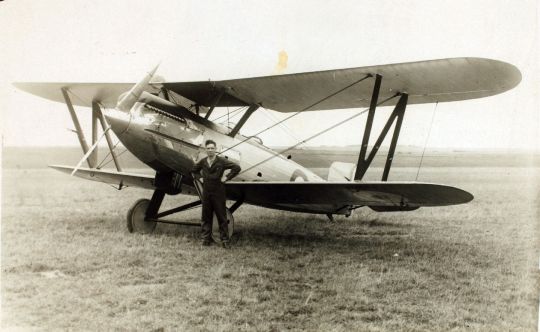
Fairey’s contender dated back to a private venture project produced in 1925 as a replacement for their underwhelming Fawn bomber. As originally conceived, it was a simple composite construction biplane designed around the Curtiss D-12 liquid-cooled engine. First flying in early 1925, it demonstrated excellent performance and handling, but, because it used an American engine, it faced resistance among the Air Ministry. In the end, the Air Ministry would order just a squadron’s worth of aircraft. When the new light bomber specifications were issued in 1926, Fairey hoped to capitalize on this by reworking the Fox. Effectively becoming an all-new aircraft, the new Fox was an all-metal machine powered by the Rolls-Royce Kestrel. Unfortunately, this reworking took until 1929, by which time Hakwer’s Hart had been selected as the winner. In the end, only 28 Foxes would enter RAF service, with all aircraft refitted with Kestrel engines. There, they served without incident from 1926 until 1931, when they were replaced by the Hawker Hart.
De Havilland Hound
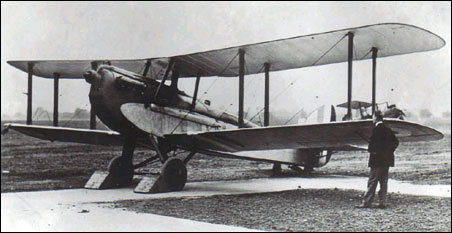
De Havilland would be the first to produce a contender to the new light bomber requirements with their Hound. Being all-wood in construction, it was powered by the Napier Lion. Because it failed to meet specifications for an all-metal construction, it was not contracted for prototypes. Nevertheless, de Havilland would continue work as a private venture, flying the prototype in November 1926. It was submitted to the RAF for evaluations in January 1928, but it would be rejected owing to its wooden construction. After its rejection, de Havilland took back the aircraft, using it to set a world speed record in its class.
Hawker Hart

Hawker would also produce a sleek Kestrel-powered aircraft under the designation Hart. With a metal structure, it made use of a steel-tube fuselage and all-metal wings. A prone bombardier’s position was added in the underside of the fuselage, and provisions for up to 520lb of bombs were installed. The first Hart would fly in June 1928, demonstrating a top speed of 176 mph and good handling. Ultimately, the Hart would be the winning design of the competition, thanks to its excellent performance and ease of maintenance. The Hart would be ordered into production, with the first examples reaching service in early 1930. They replaced the older Hawker Horsley and Fairey Fox. The Hart made its combat debut in the 1935 Abyssinia Crisis, and it saw extensive use in British India. Though it proved a popular export aircraft, it ended up seeing little actual combat use because it was obsolete by the time war broke out. However, Rhodesian Harts would see use in the opening stages of the East African campaign in WW2. Despite its fairly uneventful career, the Hart was far from an unsuccessful aircraft. It saw countless variants developed and extensive export service, and only with the arrival of modern monoplanes was it finally phased out.
Avro Antelope
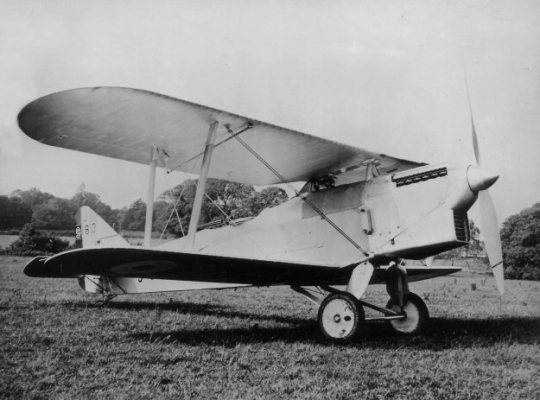
Avro would propose the Antelope, an all-metal single-bay biplane powered by the Rolls Royce Kestrel engine. Fitted with one forward-firing machinegun and one for defense, the Antelope had a capacity of two 250lb bombs. The Antelope first flew in July 1928, generally performing well. With a top speed of 173 mph, it more than met performance specifications. However, low-speed handling and spin characteristics were poor, and the machine was difficult to service. Thus, the Air Ministry selected the competing Hart as the winning design.
Air Ministry Specification B.19/27
At the end of the ‘20s, the Air Ministry began the process of replacing the Vickers Virginias that were the RAF’s primary night bomber at the time. Under the specification B.19/27, the Air Ministry requested a twin-engined aircraft with a payload of over 1,500lb, range of 920 miles and cruise speed of 115mph. The requirements would see proposals come in from Handley Page, Fairey, and Vickers, all of whom produced very unique designs. Though the primary winner of the competition was Handley Page’s Heyford biplane, the B.19/27 competition was unique in that it resulted in both the RAF’s first monoplane heavy bomber and last biplane heavy bomber.
Vickers Vanox
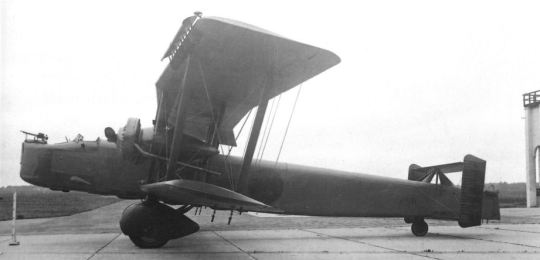
The first Vickers proposal, the Vanox, actually predated the Air Ministry requirements, as it was developed as a private venture. Three proposals had been issued to the Air Ministry after the specifications were released - two biplanes differing primarily in engine arrangement and a monoplane - with a Bristol Mercury-engined biplane being contracted for prototypes as the Vanox. The Vanox would go on to be the most conventional of all designs submitted to the new requirements. Though it featured spatted landing gear and considerable streamlining, the Vanox mostly resembled a slightly refined version of the old biplane bombers it was to replace. Before the Vanox took flight in November 1929, the contract was modified to allow Vickers to use the Rolls Royce Kestrel in place of the Mercury. Unfortunately for Vickers, testing went poorly. The Vanox was unstable, difficult to fly, and prone to flexing issues. A series of modifications were made over the following years to alleviate the problems, but by the time the last round of changes finally fixed the worst of the issues in early 1933, the Fairey Hendon and Handley Page Heyford had both been ordered into production. Thus, the bomber was passed on to the Royal Aircraft Establishment for experimental work.
Handley Page Heyford

Though Handley Page’s Heyford was also a biplane, they took a far more radical approach to their design. The Heyford’s aluminum monocoque fuselage was mounted on the upper wing to improve the field of fire for the gunners, while the spatted landing gear was placed on the lower wing. Defensive gunners were placed in nose, dorsal, and retractable ventral positions, and the bomb bay was placed in a thickened center wing section. Power was provided by two Rolls Royce Kestrel engines hung under the upper wing. The Heyford first flew in June 1930, entering trials later that year. Though the bomber had its peculiarities, such as the difficulty the crew had entering and exiting the high-mounted fuselage, it generally performed well. Crews liked the excellent visibility from the cockpits, while the location of the bomb bay meant that ground crews could mount bombs while the engines were running. The Heyford ended up winning the production contract, beating out the competing Vickers and Fairey designs.

The first Heyfords entered service in late 1933. As the RAF expanded, an order for 70 more Heyfords was placed in 1936. With nine squadrons flying the Heyford by the end of 1936, the bomber formed a major part of the RAF’s night bomber force. The Heyford would live out its career flying constant exercises, doing everything from flying mock attacks against France to testing Britain’s nascent early warning radar network. Despite the massive expansion of the Heyford force in 1936, the RAF was quick to replace the bomber. In 1937, the Heyford already began phasing out for the Whitley and Wellesley bombers. The last Heyfords had completely left frontline service by mid 1939. Some examples persisted in secondary roles as gunnery trainers and target tugs, but by 1941 the last Heyfords had been retired.
Fairey Hendon

Fairey would propose the only monoplane bomber for the new requirements in the form of the Hendon. The Hendon was a unique mix of modern layout with archaic features, being of steel tube and fabric skin construction and featuring fixed landing gear, but also incorporating a low-wing cantilever monoplane layout that would become standard for most bombers to come. The Hendon featured a crew of five, with defensive gunners placed in nose, dorsal, and tail positions and a bomb bay along the centerline for over 1,600lb of bombs. The Hendon was first flown in November 1930, originally powered by two Bristol Jupiters. After it was damaged in a crash in March 1931, the Hendon was rebuilt with Kestrel engines. Though it failed to win the larger production order given to the Heyford, the Hendon still performed well enough to receive a production order for 14 aircraft. The first squadron would only begin to equip the Hendon in 1936, with a further order for 60 bombers cancelled owing to the development of the next generation of bombers. The sole squadron flying the Hendon saw little use before phasing out their bombers in 1938 for the more modern Vickers Wellington.
Vickers Type 163
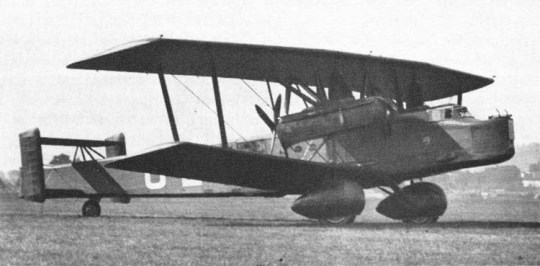
Though Vickers already had a contender to the new bomber requirements in the form of the Vanox, they would produce a second design to meet both the same bomber requirements and the parallel C.16/28 transport requirements. The Type 163 was similar in layout to the Vanox, sharing the same slightly swept wings, boxy fuselage, and spatted landing gear, but it made us of four (rather than two) Kestrel engines in paired mountings. Defensive armament was fairly light, with only two guns mounted in nose and tail positions, but payload was massively expanded to a total capacity of twelve 250lb bombs or ten fully-equipped troops. The Type 163 would take flight in January 1931. Unfortunately, the Type 163 failed to meet either requirement, and thus it was abandoned.
De Havilland DH.72

When the Air Ministry issued specifications for a night bomber to replace the Vickers Virginia, de Havilland responded with the DH.72, a scaled-up version of their successful Hercules airliner. The DH.72 was a three-engined machine with a fuselage mounted low on the bottom wing. The lower wing held a Bristol Jupiter engine on either side of the fuselage, and mounted on the center of the upper wing was the third Jupiter. A crew of five was carried in the deep fuselage, but the payload of 2,500lb of bombs was to be carried externally. Perhaps most unusually for de Havilland, the DH.72 was to use duralumin wings. This element would end up greatly delaying the project. It took three years to build the sole prototype, with the DH.72 not flying until July 1931. It was submitted for RAF evaluation later that year, but it ended up being rejected along with the competing Boulton Paul P.32.
Boulton Paul P.32

The only competitor to de Havilland’s DH.72 night bomber was the Boulton Paul P.32. Overall, the P.32 resembled a more refined version of de Havilland’s bomber, with the same layout but a sleeker fuselage and recessed positions for the bombs. The deep fuselage provided space for a navigator’s table and bombardier’s station, as well as a passageway back to a tail gun. Though Boulton Paul had more experience with metal aircraft, their design was also greatly delayed by a series of design changes made at the request of the Air Ministry. Thus, the P.32 didn’t fly until October 1931. It joined the DH.72 for evaluations later that year, but unfortunately the Air Ministry ended up dropping the requirement altogether, meaning that none of the designs would be ordered into production.
Gloster TC.33
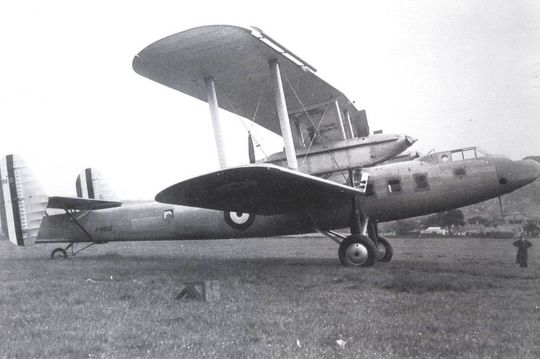
In 1928, the Air Ministry issued specifications for a new bomber-transport, calling for an aircraft capable of carrying 30 troops over 1,200 miles. Gloster responded with the RC.33, a four-engined biplane with a sleek enclosed fuselage. The metal-structured wings featured a minor sweep, and the lower wing was given an inverted-gull layout so that the spars did not pass through the fuselage. Four Rolls Royce Kestrel engines were mounted in push-pull nacelles between the wings to drive the machine. The sleek metal fuselage featured an enclosed cockpit and open gunner positions in the nose and tail. Apart from the passenger capacity, the TC.33 was fitted with racks for up to 3,600lb of bombs. Testing began in early 1932, showing good performance but suffering from flutter on the control surfaces. Unfortunately, though it performed well in the air, it struggled to get off the ground at a full load. Because of the issues the aircraft had taking off in the comparatively favorable conditions it was tested in, the Air Ministry feared the TC.33 would be unable to fulfill its duties in the hot and high regions it would likely be operating in. Thus, it was deemed unfit for duties and not ordered into production.
Handley Page H.P.43

The H.P.43’s origins can be traced back to 1928, when Imperial Airways issued a request for a three-engined airliner. Though the design that Handley Page produced - the H.P.43 - failed to attract any orders, it found new life when the Air Ministry issued specifications later that year for a dual-purpose bomber/transport to replace the Handley Page Hinaidi and Vickers Victoria. Handley Page reworked their design for the new requirements, giving it a new fuselage but retaining the old wings. The H.P.43 was a large sesquiplane fitted with two Bristol Pegasus engines on the lower wing and one on the upper wing. The large slab-sided fuselage was intended to accommodate up to 30 troops, though provisions for converting the aircraft to carry bombs were also made. Defensive armament was fairly light, being just a single Lewis gun in nose and tail positions. The H.P.43 flew for the first time in June 1932, with poor results. It was poorly received by pilots, who found performance lacking and the controls to be heavy. Even without those issues, it seemed that monoplanes were soon going to take over the market for both bombers and transports, meaning that the H.P.43 was obsolete. Handley Page worked to adapt the design as a monoplane, but the H.P.43 as it flew in 1932 would never enter service.
Boulton Paul Overstrand

Owing to the relative success of the Sidestand medium bomber, Boulton Paul created the Overstrand as a general upgrade to the design in the early ‘30s. Because of the high speeds the Sidestrand operated at, the open positions were uncomfortable for crews, so Boulton Paul enclosed the crew compartment. A powered nose turret was added, and, though the dorsal and ventral positions remained open, they were shielded to improve crew comfort. New Bristol Pegasus engines were also added, and the fuselage was strengthened, bringing total payload up to 1,500lb. The first Overstrand would fly in 1933, generally proving to be an improvement over the Sidestrand. Four Overstrands were converted from operational Sidestrands, and an order for 24 new-production machines was placed. The Overstrand replaced the sole operational Sidestrand squadron in 1934, but their service was brief and uneventful. They were replaced by Bristol Blenheims in 1938, and those that remained in service when war broke out in 1939 were shifted off to gunnery training.
Vickers Type 264 Valentia
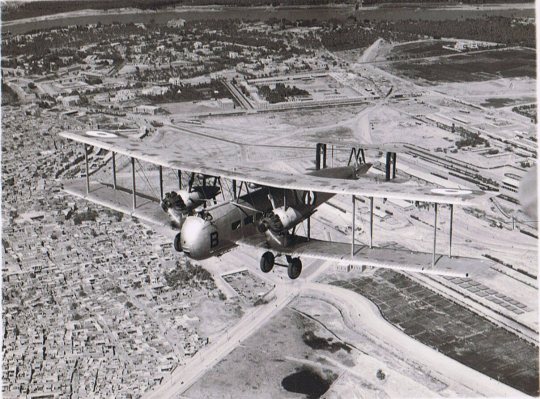
By 1932, the Napier Lion engines used on the Vickers Victoria transports were beginning to show their obsolescence. The RAF wanted to upgrade the aircraft with the more powerful Bristol Pegasus engine, but the decision was made to perform a more substantial reworking to keep the transports competitive. Under the new designation Valentia, the transports were re-engined and had their airframes strengthened, allowing them to carry heavier payloads. First flying in 1934, 54 would be converted from Victorias, while a further 28 were built new. Though they were still first and foremost a transport, part of the conversion entailed the addition of underwing racks for up to 2,200lb of bombs. Given that the Valentias were deployed to Iraq, India, and Persia, the bombing capabilities would prove very useful. They were used as bombers to suppress rebels in the years leading up to the Second World War, and, due to a shortage of bombers in Egypt, Valentias were also used for night bombing operations against Italian Libya in 1940. In South African hands, the Valentia also saw use as a bomber in the brief East African campaign.
Air Ministry Specification G.4/31
By the early ‘30s, the RAF was looking for a general purpose bomber capable of replacing the Vickers Vincent and several other aircraft for colonial duties. The new bomber was to have a focus on durability, as it was to be operating from unprepared airstrips in remote regions like Aden and Malaya, and it would have to meet a variety of roles, as it was replacing not only the torpedo-bomber Vincent, but the aging army cooperation aircraft like the Fairey Gordon and Westland Wapiti. Because of the projected rough operating conditions, the Air Ministry preferred air-cooled engines for simplicity of maintenance.The requirements saw nearly every major manufacturer submit a proposal, with designs coming in from Bristol, Blackburn, Fairey, Handley Page, Hawker, Parnall, Vickers, and Westland. Though most designs were fairly unremarkable biplanes, the winner would be the uniquely modern Vickers Wellesley monoplane.
Westland PV.7

Westland would submit a high-winged monoplane under the designation PV.7. The PV.7 was a tall all-metal monoplane fitted with Handley Page slats to improve low-speed handling. Powered by a Bristol Pegasus engine, the PV.7 would be able to carry a single torpedo under the centerline or a pair of 500lb bombs under the wings. The PV.7 would fly for the first time in October 1933, well before any of the competitors. After some minor modifications in response to initial testing (most notable being enclosing the cockpit) it was passed onto the RAF for further testing. Initial testing by the RAF was encouraging, and in mid 1934, Westland’s test pilot began flying the aircraft again to examine its behavior with different centers of gravity. During one of these test flights, unfortunately, the unusual loading caused the failure of one of the wings. Though the pilot escaped, the PV.7 was lost. The RAF meanwhile refused to pay for a second aircraft on the grounds that it was a civilian pilot that caused the loss of the aircraft, and Westland lacked the funds to replace it. Thus, they were forced to withdraw from the competition before the selection process had begun.
Armstrong Whitworth A.W.19

Armstrong Whitworth would produce a private venture biplane - the A.W.19 - for the new requirements. Unlike other designs, the A.W.19 had provisions for a crew of three to be carried comfortably, with a windowed navigator’s cabin placed in the center of the deep fuselage. The pilot and observer sat high in open cockpits, though the observer’s position was fitted with a sliding canopy that could be closed when the gun was not in use. Power came from an 810hp Armstrong Siddeley Tiger engine enclosed in a cowling. Testing began in late February 1934. The A.W.19 would perform well, but it suffered from cooling issues with the engine. Though the bomber featured some novel elements, they were not enough to win it a production contract. Thus, the A.W.19 returned to the manufacturer, serving out its career as an engine testbed for Armstrong Whitworth.
Fairey G.4/31

Fairey would submit a private venture design for the new Air Ministry requirements, known only by the specification issued by the government. Fairey had initially submitted both the biplane G.4/31 and a parallel monoplane design, with the monoplane receiving a contract for prototypes. However, when Fairey ran into difficulties with the monoplane, the contract was shifted over to the biplane. The G.4/31 was a simple two-man biplane powered by an Armstrong Siddeley Tiger engine and designed to carry single 1,500lb torpedo or equivalent payload of bombs. First flying in March 1934, it would be refined before being submitted to the Air Ministry the next year. Unfortunately for Fairey, the G.4/31 failed to win a production order, first losing out to Vickers’ Type 253 and then again being overshadowed when another Vickers design was awarded the production contract.
Vickers Type 253
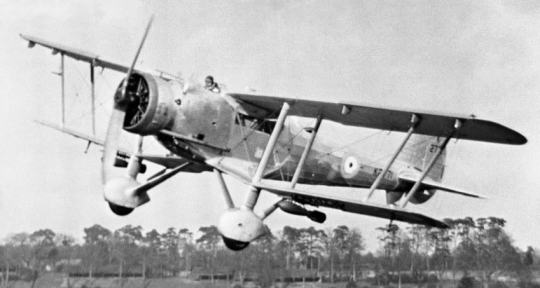
The first Vickers proposal submitted to the new requirements was a fairly unremarkable biplane given the internal designation Type 253. The Type 253 outwardly looked like any other two-seat light bomber, with conventional biplane wings and fixed undercarriage. However, it made use of a novel new construction system developed by Vickers engineers. This new system, known as geodetic construction, would make use of a weaving frame of metal members in the fuselage, resulting in a highly efficient structure. The Type 253 would receive a contract for a single prototype from the Air Ministry, flying for the first time in August 1934. It was submitted for acceptance trials after some minor improvements, where it generally performed well. In fact, the Type 253 initially won the competition, receiving a production order for 150 aircraft. However, in June 1935, the decision was reversed after testing of a parallel monoplane design Vickers had submitted as a private venture - the Wellesley. The Wellesley offered considerably better performance, prompting the Air Ministry to cancel the order for the Type 253 and instead order the Wellesley into production.
Handley Page H.P.47
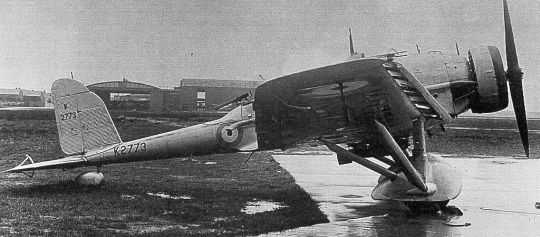
Handley Page would one of the two monoplanes to receive a contract for prototypes. The H.P.47 would be a low-wing cantilever monoplane with a semi-monocoque all-metal construction. The wing itself was decidedly modern, fitted with leading edge slats and trailing edge flaps. The crew of two sat in tandem in a streamlined cockpit, and space was made behind the cockpit to carry up to three passengers or two stretchers. In addition, owing to the torpedo bomber requirements, the H.P.47 was capable of carrying a substantial payload under the centerline of the aircraft. The H.P.47 would fly for the first time in November 1934. Initial tests saw minor changes made, such as the installment of spats for the landing gear, a Townend ring, and a more powerful engine. It was then submitted for acceptance tests, where it flew off against competitors. Unfortunately, the H.P.47 demonstrated stability issues, and ultimately was not selected for production.
Blackburn B-7

Blackburn initially had no interest in the new requirements, only submitting a contender once the Air Ministry extended specifications to call for torpedo bombing. Receiving the internal designation B-7, the new bomber was heavily derived from their earlier Shark torpedo bomber. The folding wings of the Shark were eliminated, and the wings were enlarged to improve payload capacity. The watertight semi-monocoque fuselage of the Shark was retained, as was the split undercarriage necessary for torpedo bombing. Even the engine was retained. In effect, the B-7 was little more than a de-navalization of the Shark. Testing began in in late November 1934 with the aircraft submitted for trials in May of the next year. Unfortunately, the B-7 failed to win any favor, so it was scrapped at the end of the competition.
Hawker P.V.4
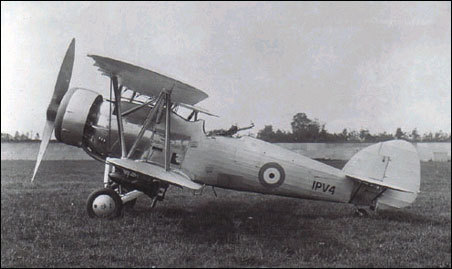
Hawker would submit a private-venture design based off of their Hart/Hind two-seat fighter. Heavily derived from the Hind, the P.V.4 made significant changes to accommodate the dive bombing and air-cooled engines requirements. A Bristol Pegasus radial engine replaced the water-cooled inline of the Hart, and, although payload remained the same at just 570lb of bombs, the structure was reinforced to support dive-bombing. The P.V.4 took flight in December 1934, entering trials the next year after receiving a more powerful engine. In trials, it proved to be the only competitor capable of dive-bombing, but, because of the single-axle undercarriage, it failed to meet torpedo-bombing requirements. Ultimately, the dive-bombing requirement was dropped entirely, leaving the P.V.4 with little utility. The sole prototype was passed on to Bristol for engine testing, and later that decade it was evaluated by the Finnish Air Force, who was in search of a new dive bomber. However, it failed to gain a production order, and was ultimately retired in 1939.
Parnall G.4/31
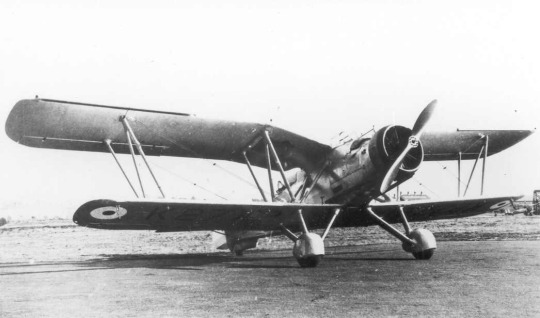
Parnall would produce another nameless biplane proposal for the Air Ministry requirements. Overall, the bomber was unremarkable. With a metal-tube and fabric-skin construction, the bomber was designed around the torpedo bombing requirements and fitted with a gull wing to provide a good field of view for the crew. It would be the last of the original contenders to fly, taking flight in 1935. It would not be delivered for evaluation until early 1936 owing to a number of problems revealed in the design that required significant modifications, by which time the competition had already ended and a winner had been selected. The sole prototype flew on in armament trials until 1937, when it was damaged in a crash and subsequently scrapped.
Vickers Wellesley
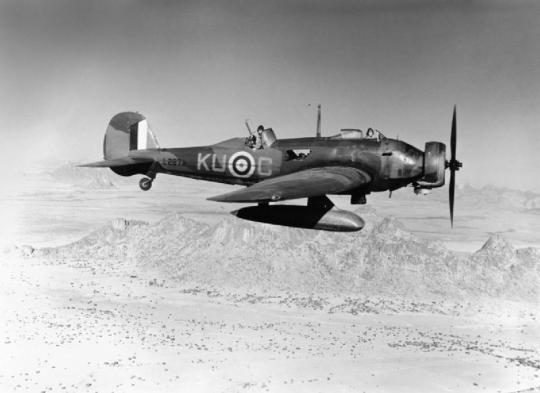
Though Vickers had already received a contract for their Type 253 monoplane, they would also develop a considerably more advanced monoplane contender as a private venture. The new monoplane made use of the same geodetic construction as the Type 253, and it made use of a long, high aspect-ratio wing, streamlined fuselage, and retractable landing gear. First flying in June 1935, it was submitted to the Air Ministry after the original round of selection had already concluded. Though the new bomber was designed for a pure bomber role rather than the multirole requirements of the specification, it offered far better performance than any of the other competitors. Thus, the Air Ministry rewrote specifications around it, cancelled the order for the Vickers Type 253 that had originally won the production contract, and placed a sizeable order for the new bomber under the service name Wellesley.

The Wellesley would enter service in April 1937, coming to fly with six squadrons in the UK and six more abroad. Three were modified for long-range flights, setting a distance record in 1938 when they flew nonstop from Egypt to Darwin, Australia - a record that still stands for single-engined piston aircraft. Though the Wellesley was impressive when it first flew, however, it was rapidly made obsolete, and by the outbreak of war in Europe, most squadrons were phasing the bomber out of service. However, when Italy entered the war in 1940, Wellesleys in Africa and the Middle East were called into action. Their first bombing mission came the day after the Italian entry into the war, hitting targets in Ethiopia. The bombers proved to be incredibly vulnerable to Italian fighters due to a lack of available escort, but losses remained low enough for the bomber to continue operations through the end of the campaign. With the end of the combat in East Africa, the Wellesleys shifted over to maritime reconnaissance in the Red Sea, where they remained until being retired in September 1942.
Bristol Blenheim
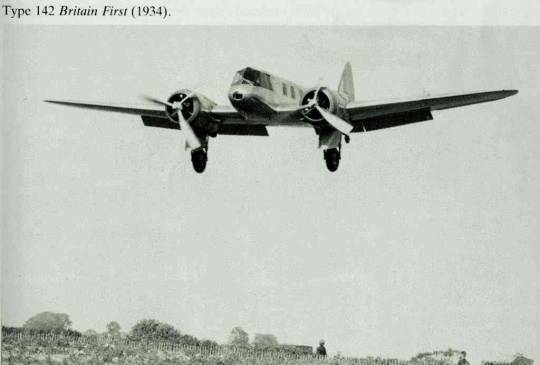
In 1934, the Daily Mail newspaper challenged the British aviation industry to develop a high-speed transport to compete with aircraft like the He 70 coming out of Germany at the time. Bristol responded, repurposing another design they were working on to produce the Type 142. First flying in April 1935, the Type 142 was a sleek twin-engined monoplane that proved to be faster than any fighter then in service. Unsurprisingly, this caught the attention of the Air Ministry, who wrote specifications around a militarized version. Bristol quickly adapted the design, moving the wing up to accommodate a bomb bay. The new bomber had a crew of three, with a pilot and bombardier in a stepless canopy and a gunner in a dorsal turret. Armament consisted of a single forward firing machinegun and two in the dorsal turret and a 1,000lb payload capacity. The new bomber, now known as the Blenheim, was ordered directly from the drawing board, with deliveries starting in March 1937.

Though the Blenheim Mk I was a capable aircraft, the stepless canopy was found to make flying the plane difficult, so it was quickly replaced by the Mk III, which featured a conventional nose. It quickly caught the attention of several foreign powers like Finland, who placed small orders, while the RAF began phasing it into most light and medium-bomber squadrons. Unfortunately, though the Blenheim had unparalleled performance when it first entered service, it soon lost this advantage. Rapidly advancing aircraft technology outpaced the bomber, and, as more equipment was added to the design, it became weighed down. By the outbreak of war, the Blenheim was no longer fast enough to evade enemy fighters, and, with its modest armament, it was unable to protect itself.

The Blenheim was among the first aircraft called into action when Britain entered the war in 1939. Deployed to France with the British Expeditionary Force, they served as reconnaissance aircraft and bombers. It would fly the RAF’s first wartime sortie on September 3 with a reconnaissance flight over Wilhelmshaven, and later they would also fly the RAF’s first bombing mission. Like the Fairey Battle, early service was already starting to demonstrate the type’s vulnerability, but it wasn’t until the Battle of France kicked off that the Blenheim really started to suffer. Though they were not thrown into missions as suicidal as those assigned to the Battle, the Blenheim still suffered heavy losses over France. However, unlike the Battle, the Blenheim was kept in service even after the Battle of France came to an end.
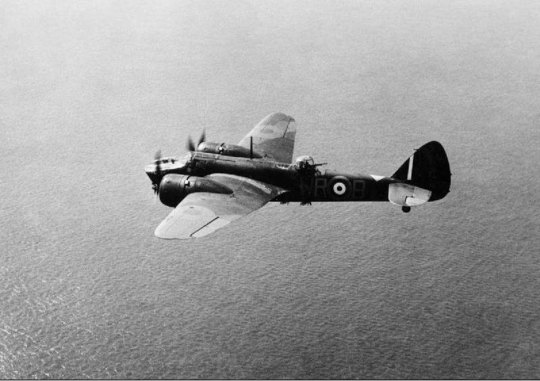
Once withdrawn across the Channel, Blenheims continued to strike at enemy forces. Heavy losses in daylight raids would cause the RAF to shift all bomber missions to night raids, where the Blenheim fared better. Once the Battle of Britain began, the Blenheim was thrown into action on daring cross-Channel raids, hitting German airfields in France around the clock to keep pressure on enemy aircrews. Unsurprisingly, these raids saw the Blenheims suffer heavy losses, with many missions leading to the loss of all aircraft involved. Some Blenheims were also used for long-range strategic reconnaissance, but those missions were soon abandoned as the bomber proved too slow and vulnerable. Several Blenheims were converted to serve as night fighters as well, taking a more active role in the defense of Britain in the Fall of 1940. Raids into Europe continued through 1941, but losses continued to mount while newer variants were proving incapable of keeping the bomber competitive. By 1942, the Blenheim began being replaced, with the last bombing mission over Europe flown in August.
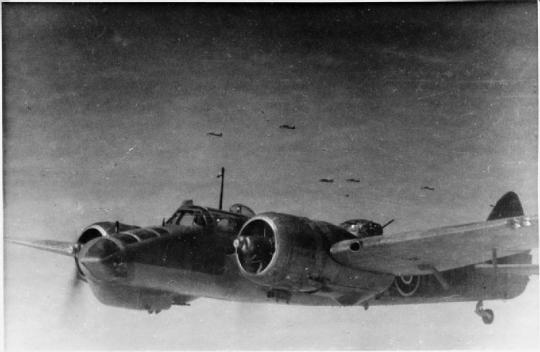
Though the Blenheim was phased out of service in Britain, it took longer for those in tertiary theaters to be replaced. Many remained in use in the Mediterranean, where the reduced threat from enemy fighters allowed them to excel. Long-range reconnaissance sorties were frequently flown from Egypt and Malta, and in North Africa, the Blenheim would continue to serve as a bomber. In the Far East, the Blenheim also saw considerable use, particularly in the Burma campaign, where they made several daring raids on IJA airfields in Thailand early in the campaign. Unfortunately, they soon ran into the same shortcomings that cost them so many aircraft over Europe, and, by the end of 1942, the Blenheim had generally been phased out of RAF service.
Armstrong Whitworth A.W.23

When the Air Ministry issued specifications for a new monoplane bomber-transport, Armstrong Whitworth responded with a new low-winged monoplane designated A.W.23. The A.W.23 was a twin-engined machine with a long, boxy fuselage capable of accommodating up to 24 troops or 2,000lb of bombs internally. Though the fuselage was a fabric-covered steel tube frame, the wing was made of a novel new construction that was extremely strong. Taking flight in early June 1935, the A.W.23 was delayed for testing owing to reliability problems with its engines. Thus, by the time it was submitted to the Air Ministry, Bristol’s competing Bombay had already been selected as the winning design. Fortunately, the A.W.23 was not a complete waste, with Armstrong Whitworth reworking the desgin into the Whitley bomber.
Bristol Bombay
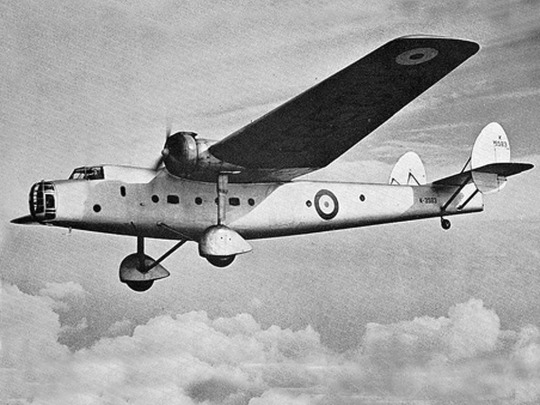
In response to an Air Ministry specification for a bomber-transport to replace the Vickers Valentia with a monoplane, Bristol produced a design that would be contracted as the Bombay. Designed around a requirement for a capacity of 24 troops, the Bombay was a shoulder-winged all-metal monoplane with fixed landing gear. As a transport, the Bombay would have a capacity of 24 troops and a crew of three - a pilot, navigator/bombardier, and radio operator/nose gunner. For bombing, eight 250lb bombs could be fitted under the fuselage and an extra crewman would be added to man the tail turret. The Bombay flew for the first time in June 1935, driven by two Pegasus engines. Testing went well, and an order for 80 was placed with uprated engines, variable-pitch propellers, and no wheel spats.
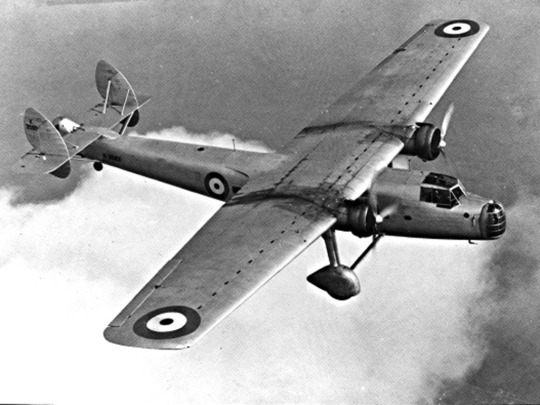
Unfortunately, due to the complex structure of the Bombay’s wing, the first production aircraft wasn’t delivered until September 1939. By then, it was obsolete as a bomber, so it was primarily flown as a transport. They were used to support the British Expeditionary Force in France, though the bulk of the force was sent to the Middle East. When Italy entered the war, Bombays were pressed into service as night bombers in North Africa, with the normal load of 250lb bombs supplemented by crewmen throwing bombs out the aircraft by hand. These night raids were fairly long range, with the bombers hitting targets as far away as Benghazi, Tobruk, and Italian Somaliland. However, their career was bombers was brief, and they were shifted back to transport roles once adequate numbers of Wellingtons made it to the theater. The remainder of their career was marked by high-profile transport missions. They regularly saw use evacuating wounded and ferrying men in the Mediterranean, and five were used in the inaugural mission of the SAS in late 1941. Missions continued into 1944, with the Bombay ferrying wounded out of Sicily and Italy before they were finally withdrawn at the end of the year.
Fairey Battle

In 1933, the Air Ministry issued Specification P.27/32 for a two-seat single-engine monoplane bomber with a range of 1,000 miles and payload of 1,000lb of bombs. Intended to replace the Hart and Hind fighter-bombers, the specification was also intended to preserve the RAF’s long-range bombing capabilities in the event heavier machines were banned at the Geneva disarmament conference. Fairey submitted several designs, with their winner emerging as a low-wing monoplane with a semi-monocoque structure. Powered by a Rolls Royce Merlin, the new bomber looked more like a fighter. A crew of three was carried in a long greenhouse canopy, and a ventral bombardier’s position was added. A bomb bay provided space for four 250lb bombs supplemented by racks under the wings for two more. Defensive armament was light, however, with just a single .303 machinegun in the starboard wing and a single flexible gun in the rear cockpit.

Taking flight in March 1936, the Battle did meet the specifications, but by then it was badly out of date. Nevertheless, the rapid push for rearmament secured a massive order for the new bomber. 155 had been ordered in 1935 before the first prototype even flew, and these orders ballooned as war loomed. The first Battles reached operational squadrons in 1937, and by the outbreak of war in 1939 ten bomber squadrons were flying the Battle. These ten squadrons were deployed to France in September 1939, but their use was limited. They primarily flew reconnaissance missions over Germany, with no real bombing missions ordered just yet. On one of these flights, a Battle downed a Bf 109, marking the first RAF kill of the war. However, many were lost to enemy fighters, foreshadowing the catastrophic performance to come.
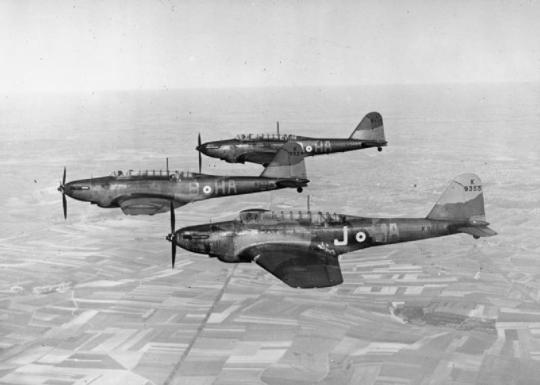
Though the Battle was already showing its issues, the gravity of the problem wouldn’t become clear until Germany invaded France in 1940. On May 10, 1940, the first day of the Battle of France, 32 Battles sortied to attack advancing enemy troops, suffering the loss of 13 of their own. The next day, seven of eight were lost, and an entire formation of five attacking bridges on the Albert Canal were downed. An emphasis on low-level attacks was clearly proving untenable, with the Battle incapable of flying such missions in the face of enemy aircraft and ground fire. Missions transitioned to medium altitudes, where the situation briefly improved, but this change was short-lived. On May 14, the 63 remaining Battles in France were sortied against bridges, only to be intercepted and suffer the loss of 35 of their own.
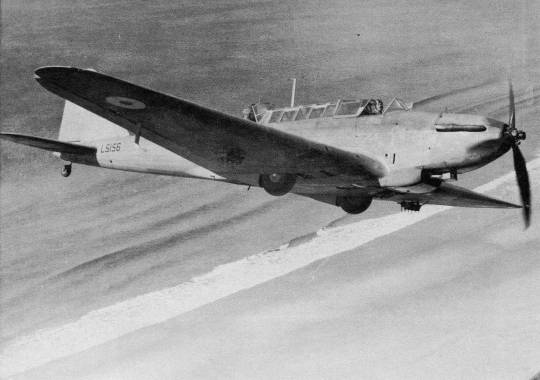
High losses persisted through the end of the Battle of France, with the beaten Battle squadrons finally being withdrawn to Britain on June 15. The Battle squadrons were briefly reorganized and thrown back into cross-Channel nighttime raids, but their career was short-lived, and they were replaced by Vickers Wellingtons by the end of 1940. Three squadrons of Battles were shifted off to Coastal Command, who flew them as patrol aircraft over the North Sea and Atlantic as late as 1941. However, most would live out their lives as training aircraft. The last combat use of the Battle came in 1942, where the South Africans flew the type in North Africa before being replaced by more modern types.
Armstrong Whitworth Whitley
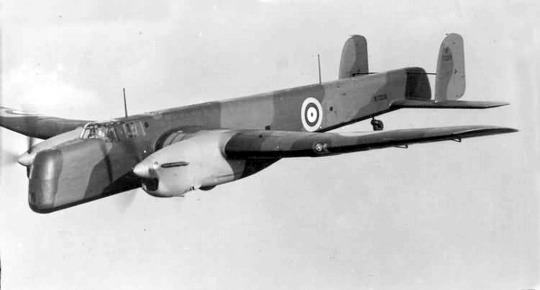
When the Air Ministry issued requirements in 1934 for a new night bomber, Armstrong Whitworth decided to adapt their failed A.W.23 bomber-transport. Retaining the wings and tail of the A.W.23, Armstrong Whitworth developed an all-new semi-monocoque fuselage. The distinct nose and tail turret remained as the bomber’s only defensive armament, but bomb bays were added in the fuselage and inner wing sections, providing provisions for a total payload capacity of 7,000lb. Because of the added weight, Armstrong Whitworth needed to compensate to allow takeoff and landing rolls to still be reasonable. As its engineers were uncomfortable working with flaps on such a large machine, they instead gave the wings an 8.5 degree angle of incidence. While it would improve low-speed performance, it made cruising flight inefficient, as the bomber was forced to fly with a noticeable nose-down attitude. The first prototype took flight in March 1936, but before the bomber had even flown an order for 80 had been placed owing to the urgent need to modernize the inventory

The Whitley first entered service in March 1937, replacing the biplane Heyford. Seven squadrons would be operational by the outbreak of war in 1939, all of which were later mark variants that mounted the Rolls Royce Merlin engine. Even with the new engine, however, the Whitley was obsolete by the outbreak of war. They were called into action on the first night of the war, dropping propaganda leaflets over Germany. Together with Hampdens, they made the first bombing raid on German soil on the night of March 19, 1940, and in June, they made their first raids on Italy. Despite its obsolescence, the Whitley suffered far lower casualties than the Wellington and Hampden thanks to it being flown exclusively on night missions.
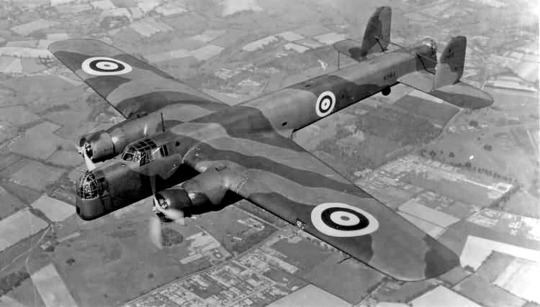
Despite the obsolescence of the Whitley, it continued to fly in RAF service well into the war. Over 1,000 would be produced, with the bombers flying nearly 9,000 missions and dropping almost 10,000 tons of bombs for the loss of 269 aircraft. They were finally retired from frontline service at the end of 1942, with the bombers shifting over to transport and electronic warfare duties. In that role, the Whitley continued to fly over Europe, towing gliders and deploying paratroopers on various covert operations. RAF Coastal Command also operated the bomber, using it as an antisubmarine patrol platform in what would be its last combat use. In these secondary roles, the Whitley would persist until the end of the war.
Air Ministry Specification B.9/32
Though several biplanes were coming into service at the start of the ‘30s, the Air Ministry could tell that the future was clearly in monoplanes. Hoping to kickstart the modernization of the RAF bomber force early, the Air Ministry issued specifications in September 1932 for a new twin-engined bomber with significantly higher performance than anything then in service. Though requirements initially called for a 1,000lb payload and 720 mile range, the Air Ministry successively revised the specifications over the years. As a result, it wouldn’t be until nearly four years after the specifications were issued that the two winning designs - the Vickers Wellington and Handley Page Hampden - would fly. Fortunately, all the work put into the two bombers paid off - they would rise to be the backbone of the RAF’s bomber force in the early years of the war and they would be some of the most successful bombers of the war.
Vickers Wellington

For their new bomber, Vickers created a large aircraft using the same geodetic construction methods that had been so successful with the Wellesley bomber. Designed around a long, slender fuselage, the Wellington was outwardly fairly conventional, really only standing out with its unique structure. By the time the prototype finally took shape in 1936, the Wellington had a payload of 4,5000lb and range of 2,800 miles. Taking flight in June 1936, the Wellington prototype was significantly different from production machines, using a thinner fuselage and lacking the characteristic nose and tail turrets that would be seen on production machine. Testing went well, and the RAF ordered 180 bomber after some modifications. The production machine would make use of a deeper fuselage and have six machineguns placed about the aircraft in twinned nose and tail turrets and individual waist positions.

The Wellington entered RAF service in October 1938, with six squadrons operational when war broke out. On September 4, 1939, they launched their first raid of the war against German shipping, losing two of their own in what became the first RAF losses over the Western Front. Despite this early failure, the RAF believed the heavy armament of the Wellington could protect it, so daylight raids continued. In mid-December, three squadrons made two successive raids on Wilhelmshaven, failing to hit their targets but suffering catastrophic losses. In the aftermath of these disasters, the RAF completely abandoned daylight raids. The switch to night raids also signaled a lull in the bombing campaign. Until May 1940, Wellingtons would only fly the sporadic leaflet-dropping mission.

Strategic bombing finally resumed on May 15, 1940, when Wellingtons flew alongside Whitleys and Hampdens to hit targets in the Ruhr. These early raids had little impact, however. The difficulties of navigating at night over long distances meant that the bombers often missed their targets, and, even when they did hit close to the targets, the small bombs they were dropping often did little damage. Strategic bombing continued endemically, but it wouldn’t be until 1941 that the Wellington really started to show its utility. The Wellington was one of the few aircraft capable of carrying the 4,000lb “blockbuster” bomb, dropping the first of these weapons in April 1941. Meanwhile, a radio navigation system had been developed for Bomber Command, becoming operational in March 1942. By then, the Wellington had become the mainstay of Bomber Command, replacing the twin-engined machines it was developed alongside.
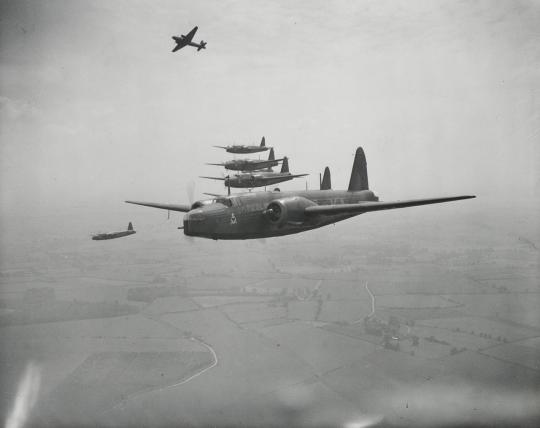
In 1942, a new tactic was deployed by Bomber Command. On May 30, 1942, the RAF brough every bomber out of reserve to launch a massive new raid. 599 Wellingtons would form the backbone of the 1,042-bomber force aimed at Cologne. The attack was a success. German air defenses were overwhelmed, and 898 bombers reported hitting their target, for the loss of just 40 aircraft. Though the Wellington was serving well, however, its time as the mainstay of Bomber Command was limited. The arrival of the new generation of four-engined bombers meant that the Wellington would gradually be drawn down and shifted to secondary roles. Nevertheless, its service was hardly unimpressive. The tremendously durable machine would fly 47,409 missions, dropping 41,823 tons of bombs for the loss of 1,332 in action during its stay with Bomber Command.

As Bomber Command’s demand for Wellingtons declined, Coastal Command began to take on the aircraft. The spacious fuselage, long range, and heavy payload of the Wellington made the bomber an incredibly useful patrol platform. Equipped with radars and a complement of torpedoes or bombs, the Wellington was an effective antisubmarine platform. Several Wellingtons were configured with a massive ring-shaped magnetic field generator placed around the fuselage for minesweeping work. Having entered service with Coastal Command in 1940, the Wellington would claim its first submarine in July 1942. As the war came to an end, several Coastal Command Wellingtons were deployed to Greece, where they flew support for the RAF while they intervened in the Greek Civil War.
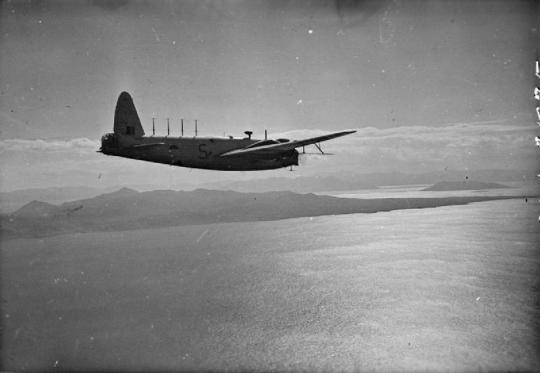
In the Mediterranean, the Wellington would really come to shine. Coastal Command Wellingtons operating out of Malta took a heavy toll on Axis shipping, crippling the Axis war effort in North Africa. Meanwhile, it came to be the primary bomber of British forces in the theater. Replacing Blenheims when it first arrived in September 1940, the Wellington would come to fly with five squadrons over North Africa. In addition to flying strategic strikes against enemy forces in Libya, they were called into action to support Allied operations in Crete and crush the 1941 rebellion in Iraq. Three squadrons remained in service through the end of the North Africa campaign, supporting the invasion of Italy. As the war came to an end, Wellingtons were slowly replaced with more modern types, but the Wellington would remain operational in Italy until the end of the war.
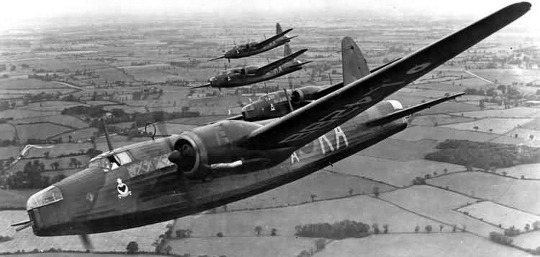
The last theater where the Wellington would make an appearance was the Far East. With priority given to the more pressing matters in Europe, the Wellington wouldn’t arrive in the Far East until well after war had broken out in 1942. Operating out of India, they were used to support British operations in Burma. With operations focused around Burma, they remained there until the end of the war. In addition to the more active bombing role, maritime patrol Wellingtons were also deployed, starting their operations in October 1942. Unfortunately, for all the Wellington’s impressive career, it would not last beyond the end of the war. By 1945, most units were already replacing the bomber, even in tertiary theaters, and with the end of the war, the entire Wellington inventory was retired.
Handley Page Hampden
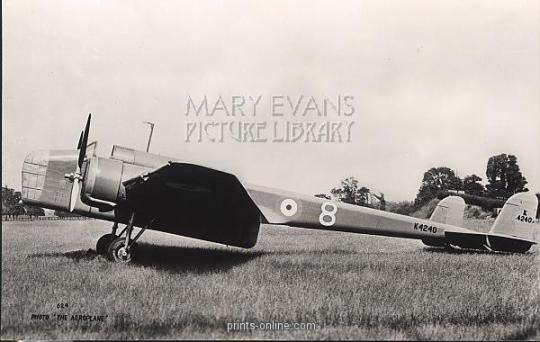
Handley Page took a different approach from Vickers, developing a compact new bomber intended to provide crews with a more agile platform. Known as the Hampden, the bomber had a crew of four concentrated in a compact forward fuselage. Flexible gun mountings were used in place of turrets to keep weight down, with guns mounted in nose, ventral, and dorsal positions. A slender tail extended backwards from the fuselage, split into two rudders, and a long bomb bay under the cockpit provided spaced for 4,000lb of bombs or a single torpedo. The Hampden would first fly six days after the competing Wellington on June 21, 1936. After two months of testing, an order for 80 Hampdens was placed, with the first production aircraft rolling out in May 1938.

The Hampden entered service in September 1938, with 226 reaching service with 10 squadrons by the time war broke out a year later. Unfortunately, crews quickly found that the Hampden was no match for Luftwaffe fighters, despite its speed and agility. Like nearly every fast bomber designed before the outbreak of war, Hampden crews quickly found that they lacked the speed to evade enemy fighters and the armament to adequately defend themselves. Daylight operations were brief and devastating, and very quickly the Hampden was shifted off to night bombing. As a night bomber, the Hampden saw heavy use, participating in the first attacks on German soil, the first attacks on the German mainland, and the first raid on Berlin. With its bomb bay capable of carrying torpedoes, the Hampden was also deployed as an anti-shipping platform. It would make several attacks on the German capital ships stationed in France in 1940, and they saw heavy use mining North Sea and French ports.
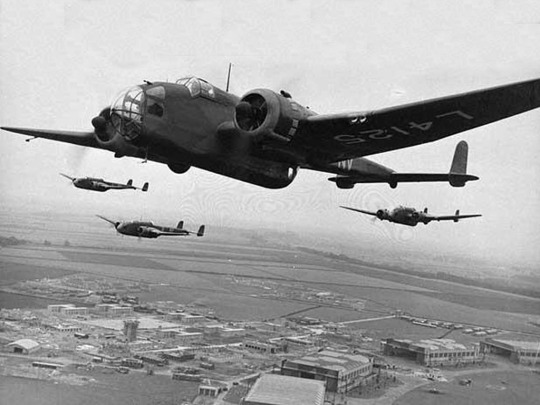
Despite its utility, by July 1940 production of the Hampden by Handley Page had ceased to make way for four-engined heavy bombers. Its cramped fuselage was one of the chief reasons for its retirement before the Wellington, while the narrow bomb bay also became a liability as larger bombs were developed. Though the bomber was on its way out by 1941, examples did stick around through 1942. 79 would participate in the first 1,000-bomber raid of the war, and they continued to fly night missions until their retirement in 1943. By the time the Hampden was finally retired, losses were staggering. Of the 1,430 Hampdens built, 714 were lost in operations. Though by no means a bad aircraft, it was clearly unable to cope with the intensity of the war.
Handley Page H.P.54 Harrow
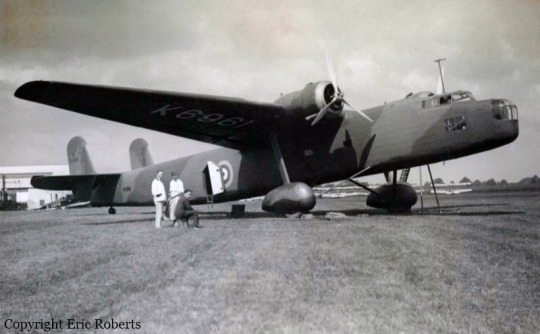
Though the H.P.43 was a failure, Handley Page began heavily reworking the design into a high-winged monoplane under the designation H.P.51. In parallel, they also began a more radical reworking of the design, creating a twin-engined bomber with a deep fuselage and ggull wing under the designation H.P.54. Both were designed around the same bomber-transport specification, though neither succeeded in meeting the requirements. However, the H.P.54 caught the attention of the RAF, who were looking to rapidly modernize their inventory. A new specification was written around the H.P.54, emphasizing the bomber role while retaining modest transport capabilities. Ordered off the drawing board as the Harrow, the bomber would receive a production order of 100 aircraft months before it first flew. Overall, the Harrow seemed a promising aircraft. It was fitted with powered dorsal, nose, and tail turrets, while an internal bomb bay provided space for 3,000lb of bombs. The Harrow prototype first flew in October 1936, and testing went smoothly enough for the first production aircraft to reach service in January of the next year.
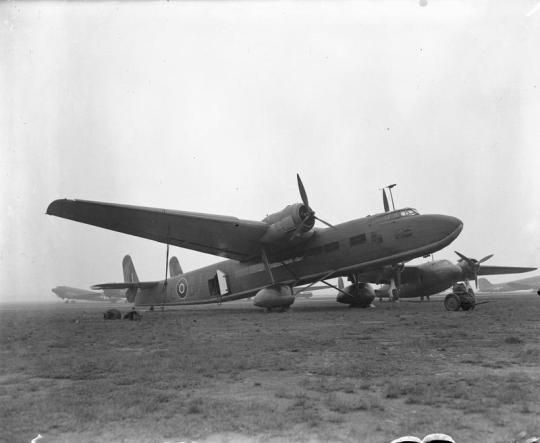
Production of the Harrow concluded quickly, with all 100 aircraft delivered to five squadrons by the end of 1937. Unfortunately, the Harrow was never a very popular aircraft, as the novel turret design led to a cold, draughty cabin. Being an interim bomber, it was phased out of frontline units by the end of 1939 without ever seeing combat. However, in secondary roles, it persisted. Transport variants served until the last days of the war in Europe, and several were used to experiment with in-flight refueling systems. Most notably, six Harrows were used to test towed aerial mines to combat German night bombers in 1940. Though unorthodox, the tactic left the bombers credited with 4 to 5 kills for no losses before the practice was deemed impractical and the program cancelled.
Armstrong Whitworth A.W.29
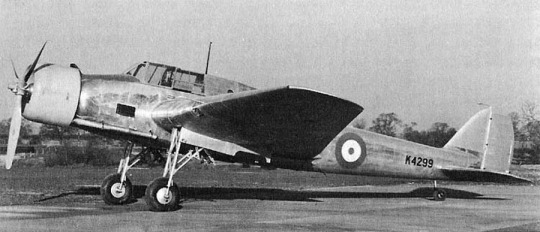
In response to the same single-engined long-range bomber requirements that produced the Fairey Battle, Armstrong Whitworth developed the A.W.29. The A.W.29 was a mid-winged all-metal monoplane designed around the Armstrong Siddeley Tiger radial engine. The crew of two were seated in tandem, with the rear gunner manning a manually-operated turret. Landing gear was retractable, but it was designed in such a way as to leave the tires partially exposed. The A.W.29 took flight for the first time in December 1936, well after the first flight of the competing Battle. Not long after it first flew, it was damaged in a wheels-up landing. Though repairable, by then Fairey had already been awarded the production contract, so the A.W.29 was scrapped.
Air Ministry Specification M.15/35
In September 1935, the Air Ministry issued new specifications for a three-seat twin-engined reconnaissance aircraft/torpedo bomber. Only two companies - Blackburn and Bristol - would submit designs, with Bristol deriving their proposal from the successful Blenheim fast bomber. Unusually, the Air Ministry would order both designs into production straight from the drawing board. Because of the rush to modernize the inventory and keep parity with Germany, massive orders for both aircraft were placed, with the first examples rolling out on the eve of war.
Bristol Beaufort
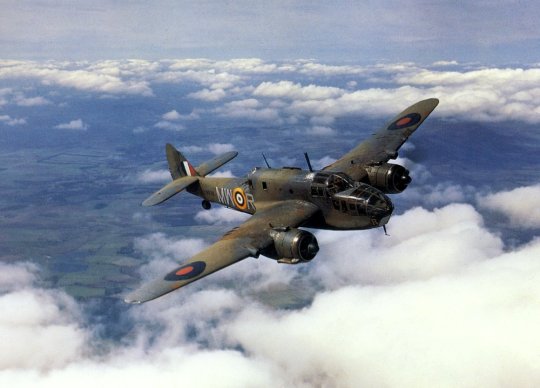
Bristol’s new torpedo bomber, the Beaufort, was developed from the Blenheim. The Beaufort in many ways resembled a larger Blenheim, keeping its characteristic layout but using a deeper fuselage to accommodate a semi-recessed torpedo or an increased bombload. Because of the higher gross weight, the wingspan was increased slightly and more powerful engines were mounted. Despite being larger than the Blenheim, refinements to the aircraft’s structure meant that empty weight didn’t increase by much. The first Beaufort was rolled out in mid 1938, but the new Bristol Taurus engines were prone to heating issues, meaning that the first flight wouldn’t take place until October 1938. Even as testing concluded, priority for production remained with the Blenheim, so the type didn’t start to reach squadron service until January 1940.

The first squadrons to receive the Beaufort required a fair amount of retraining, as they were transitioning from the far slower Vickers Vildebeest that required a much shorter approach to deploy its torpedoes. Early operations consisted of minelaying, and, owing to a shortage of torpedoes, the first real antishipping operations would be conducted with newly developed 2,000lb bombs. Torpedo attacks didn’t begin until September 1940, with armed maritime patrol missions beginning soon after. Through 1941, Beauforts took part in operations against German capital ships, most notably Scharnhorst and Gneisenau, which were stationed in France. In early 1942, when the Kriegsmarine attempted to pass Scharnhorst, Gneisenau, and Prinz Eugen through the Channel to move them to Norway, 28 Beauforts were sortied to stop them. Unfortunately, they made a poor showing. Only 11 Beauforts actually sighted the ships and launched their torpedoes, and none of them managed to hit their targets. Due to the failure in this operation, Coastal Command made the decision to replace the Beaufort with a more capable torpedo bomber. One final major attack on Prinz Eugen would be made in May 1942, after which the Beauforts were replaced by the Beaufighter heavy fighter.

In the Mediterranean, Beauforts began arriving in January 1941. Operations against Italian shipping began the next year, with the bombers flying out of Egypt and Malta. Active numbers gradually grew, with 86 Squadron arriving from England in July 1942, and the Beaufort began to take a major toll on Axis shipping. Working in conjunction with Wellingtons and Beaufighters, they regularly made attacks on Axis convoys supplying forces in North Africa, crippling and sinking many ships, including the cruiser Trento. Unfortunately, the Beaufort’s career here was doomed to be brief. By 1943, Beaufighters had started to replace the Beaufort, and by June of that year, the last squadron had converted over.
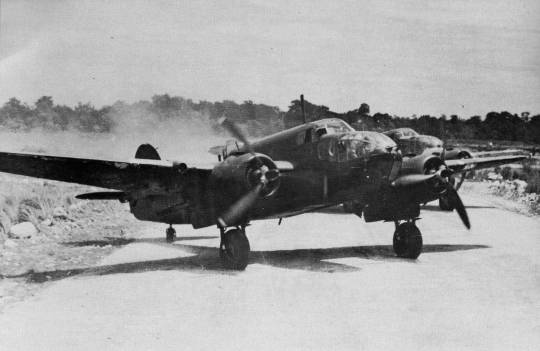
The Beaufort would undoubtedly see its greatest service in the Far East. Six Australian-built Beauforts would be among the first aircraft to reach Singapore after Japan invaded Malaya in December 1941. Unfortunately, after just a single reconnaissance sortie ended with a heavily-damaged Beaufort being written off, the surviving bombers returned home. However, the Australians quickly retrained crews, and by mid 1942, they were performing just as well as their RAF cousins in the Mediterranean. Meanwhile, the RAF shifted several squadrons from Britain to Ceylon, where they supported operations in Burma. In all, some 19 squadrons would fly the Beaufort in the Pacific, with production increasing until 1943. It became an invaluable part of the Allied effort in the New Guinea theater, remaining in service there until finally replaced by Beaufighters in 1944.
Blackburn Botha
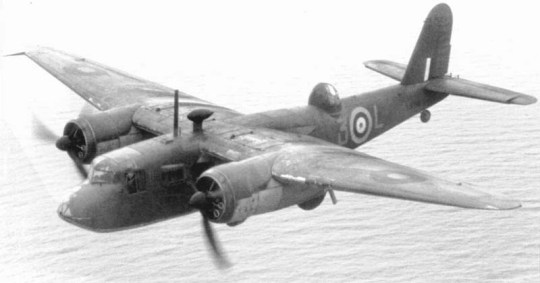
Blackburn would produce an entirely new aircraft, known as the Botha, for the torpedo bomber requirements. The Botha was another twin-engined monoplane, making use of a shoulder-mounted wing that allowed for a deep bomb bay. Designed around the Bristol Perseus engine like the competing Beaufort, Blackburn would not upgrade the design to the more powerful Taurus like Bristol did with their bomber. In terms of armament, the Botha was similar to the Beaufort, with a single forward-firing machinegun and a twin-gun turret for defense as well as a payload of up to 2,000lb of bombs or a single torpedo. Taking flight for the first time in December 1938, it was quickly found to have major problems. The location of the engines made the view from the cockpit terrible, causing the RAF to declare it “useless as a General Reconnaissance aircraft.” Worse, it proved to be underpowered. It did manage to pass torpedo and mining trials, but the decision was made to not equip it to torpedo squadrons. Instead, only four reconnaissance squadrons would fly the Botha, with the first squadron receiving the aircraft in June 1940. They would fly convoy escort through the end of the year, but high losses due to the aircraft being underpowered and unstable led to its withdrawal from frontline service in 1941. They were transferred to training units, where they remained until 1944.
Air Ministry Specification B.12/36
As war loomed, the Air Ministry began the process of procuring a new generation of heavy bombers for the RAF. Though the RAF had previously preferred twin-engined machines, difficulties in development of the newest generation of high-end piston engines prompted the Air Ministry to start looking into the development of four-engined bombers. Thus, the new specifications would call for a four-engined machine with a payload of 14,000lb over a range of 2,000 miles or payload of 8,000lb with a range of 3,000 miles. Cruise speed was to be 230mph at 15,000ft, and the bomber was to have three defensive turrets to protect itself. The bomber was to also have secondary transport capabilities, with provisions made for 24 troops to be carried inside. Because it was expected that the bomber would be operating from far-flung colonial theaters, the bomber was to have a takeoff roll of 500ft. Only Short and Supermarine would end up getting contracts for designs. Short, deriving their design from their successful Sunderland flying boat, would produce a fairly successful design, but Supermarine’s project would drag on into the war before being cancelled without ever flying.
Short Stirling

Short was originally given low priority for development, having derived their design from the Sunderland flying boat. Known as the Stirling, the bomber was a fairly simple adaptation of the flying boat, with the lower deck removed and landing gear and a bomb bay added. Much of the design was identical to the Sunderland, down to the slight upward bend of the tail intended to keep the Sunderland’s tail clear of sea spray. Though placed on low priority by the Air Ministry, Short was contracted to develop their design as a fallback in the event Supermarine’s more promising design proved to be a failure. A subscale prototype was flown in September 1938, followed by the first real prototype in May 1939. Though intended as a stopgap, the urgent need for modern bombers meant that the Stirling was ordered into production. It was hardly a poor decision. The Stirling was a massive plane, larger than anything else the RAF was operating, and, with a 14,000lb payload, it was in a class of its own.

The Stirling reached operational status in January 1941, flying its first missions in February against targets in Rotterdam. Despite its size, it handled surprisingly well, with its thick wing giving it better agility than even the night fighters it encountered on missions. However, the bomber suffered from a low service ceiling that made operations difficult, particularly when attacking Italy, where the bombers were forced to fly through rather than over the Alps. Because it was forced to fly at lower altitudes, it was often the first to be targeted by enemy fighters, leading to heavy losses. It was quickly overshadowed by the Lancaster and Halifax heavy bombers, both of which had better performance than the Stirling. Despite its large bomb bay, the types of payloads that could be carried were limited because of the structural members dividing the bay, and, though payload was impressive for short-ranged missions, the Stirling could carry no more bombs than the RAF’s medium bombers for the longer-ranged missions.

Because of all the shortcomings, the Stirling’s operational career was brief. Serviceable numbers peaked in 1942, and by the end of 1943, Bomber Command was phasing them out to secondary roles. It began to shift off to less dangerous missions such as minelaying, electronic warfare, and dropping agents behind enemy lines. Dedicated glider-towing variants were developed to work with Britain’s heavy transport gliders, with these Stirlings taking part in the airborne operations in Normandy and at Market Garden. By the end of the war, Stirlings had flown some 14,500 sorties with Bomber command, dropping 27,000 tons of bombs, and losing 582 in action. Though Stirlings persisted in combat roles into 1944, they flew exclusively in secondary roles by the end of the war.
Supermarine B.12/36
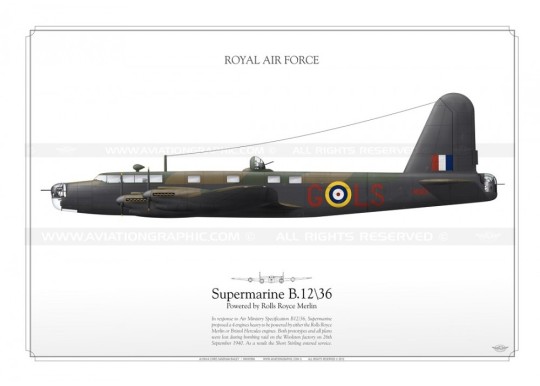
Supermarine would propose a massive new aircraft for the heavy bomber requirements, developing a design that made use of bomb bays in not just the fuselage, but inner wing sections as well. With the Merlin, Hercules, and Napier Dagger engines selected as possible powerplants, the design gained favor with the Air Ministry, who ordered it in 1937. Unfortunately, development ran into major delays. The death of the chief designer of the project slowed work, and priority given to other projects - particularly the Spitfire - meant that Supermarine’s new bomber would still be under construction when war broke out. Unfortunately, Supermarine’s facilities would be targeted by Luftwaffe bombers, irreparably harming the program. The two incomplete prototypes along with their plans were destroyed when Supermarine’s factory was bombed on September 26, 1940. Development continued officially for a bit longer, but in November 1940, the order was finally cancelled.
Air Ministry Specification P.13/36
In 1936, the Air Ministry issued specifications for a new heavy bomber, calling for a twin-engined aircraft making use of the still-in-development Rolls Royce Vulture engine. Original specifications were fairly demanding, calling for the bomber to be capable of dive bombing, torpedo bombing, and catapult-assisted takeoffs. Avro, Handley Page, Hawker, and Vickers would all respond with proposals, with Avro and Handley Page receiving orders for prototypes.Unfortunately, though all designs showed promise, the failure of the Vulture engines led to the abandonment of the requirements with none of the contracted designs seeing heavy use. However, the aircraft developed for the specification would later be heavily reworked into four-engined machines, resulting in the most successful RAF bombers of the war - the Handley Page Halifax and Avro Lancaster.
Avro Manchester
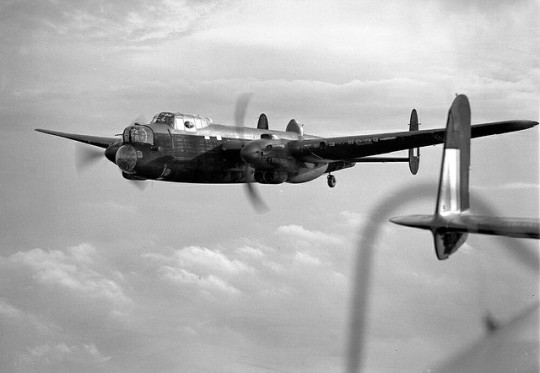
To meet the unusual new Air Ministry requirements, Avro would design an unusual new aircraft with an expansive bomb bay. Known as the Manchester, the bomber was a twin-tailed machine fitted with turrets in nose, dorsal, and tail positions for defense. The pilot sat under a greenhouse canopy mounted high on the fuselage, and a massive bomb bay would run much of the length of the fuselage, providing space for over 10,000lb of bombs. The design proved promising enough for the RAF to order 200 Manchesters off the drawing board in 1937, two years before it would fly. By the time it did fly for the first time in July 1939, several shortcomings were found. The wings had to be extended by 10 ft, and directional instability forced Avro to add a third vertical tail along the centerline. More glaringly, the Vulture engines the Manchester had been designed around were terrible unreliable. Despite the problems, production had already begun, so the RAF would have to find a use for the bomber.

The first production Manchester was delivered in August 1940, with the bomber officially entering service in November. Operations began in February 1941 with a raid on Brest, but operations were few and far between. Serviceability was low, and in April 1941, all Manchesters were grounded due to an engine defect. When they returned to service in August, flutter issues arose, keeping most aircraft out of combat. When the RAF sortied all serviceable bombers on a raid on Berlin in November 1941, only 15 Manchesters could participate, and even when the RAF brought every bomber available into service for the 1,000-bomber raid on Cologne in May 1942, only 35 Manchesters were able to fly. Ultimately, production of the Manchester was halted in November 1941 with only 209 built. The bomber was phased out of service by June 1942, flying just 1,269 sorties and dropping 1,826 tons of bombs for the loss of 78 aircraft in action and a further 45 in non-operational incidents (30 of which involved engine failure). As they left combat roles, the surviving Manchesters served as conversion trainers for the new Lancaster, which Avro had hastily developed out of the bomber in 1941.
Vickers Warwick
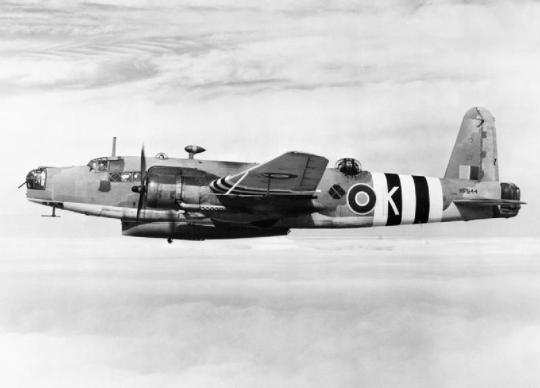
The Vickers proposal dated all the way back to 1935, when Vickers proposed an enlarged derivative of the Wellington bomber to meet a requirement for a two-engined heavy bomber. Originally designed around the Bristol Hercules engine, Vickers would offer an alternative variant with Rolls Royce Vulture engines to meet the new bomber requirements as well. At a glance, the Warwick looked like a larger Wellington, with the only distinguishing feature being the dorsal gun turret. Two prototype Warwicks were built, the first of which flew in August 1939. As testing went on, Vickers dropped plans to mount the Vulture on the bomber, instead opting for the far more promising Bristol Centaurus engine. Ultimately, availability issues with the Centaurus meant that the Warwick would instead be ordered into production with two American Pratt & Whitney Double Wasp engines with slightly less power.
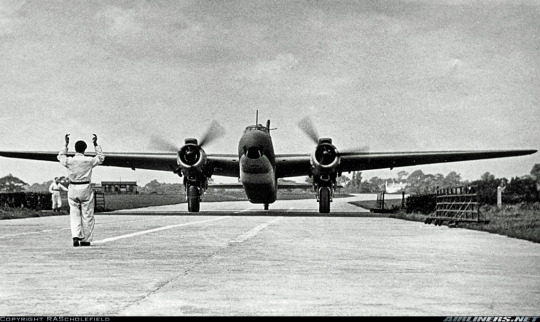
The first Warwicks were delivered for testing in July 1942. Though originally configured as a bomber, the order was modified after just 16 bombers were delivered to configure the aircraft for patrol duties owing to the development of far more capable four-engined bombers. Testing found the Warwick to be underpowered and suffering from severe handling issues. Though later variants making use of the Centaurus engine solved some of the issues, the Warwick remained a problematic aircraft throughout its career. The Warwick ended up living out its career with Coastal and Transport Commands. Transports were primarily sent to the Mediterranean, with plans to send them to the Far East halted when it was recognized that the fabric skinning of the aircraft couldn’t handle the hot, humid conditions in Burma. Patrol variants of the Warwick were generally configured for air-sea rescue, carrying an airborne lifeboat in place of bombs to rescue aircrews that ditched over the North Sea. By 1944, many Warwicks were going straight from the factory to storage, and at the end of the war, the Warwick was retired.
Handley Page Halifax
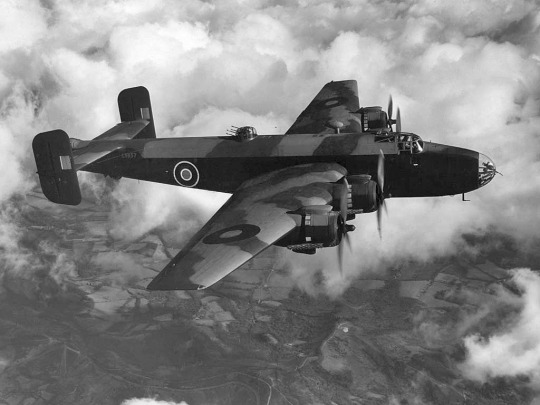
Handley Page would develop another twin-tailed design to meet the new bomber requirements, which was ordered off the drawing board in 1937 along with Avro’s Manchester. Known as the Halifax, it was a fairly unremarkable twin-tailed design with a deep fuselage to accommodate a large bomb bay. However, soon after the production order was placed, Handley Page was ordered to redesign the bomber as a four-engined aircraft, owing to the technical issues being found in the Vulture engine. The redesign led to a significant enlargement of the bomber. Wingspan increased by 11 feet to 99ft, and gross weight rose by 13,000lb. Four Rolls Royce Merlin engines were selected as the powerplant for the new bomber, which, after being presented as a mockup in 1938, was ordered off the drawing board once more. The Halifax would have a 22ft long bomb bay in the fuselage as well as six bomb cells in the wings, giving it a total payload capacity of 13,000lb. Defensive guns were placed in nose and tail turrets along with waist positions, though later machines would add a dorsal turret. The Halifax finally flew for the first time in October 1939, being rushed into production not long afterwards.
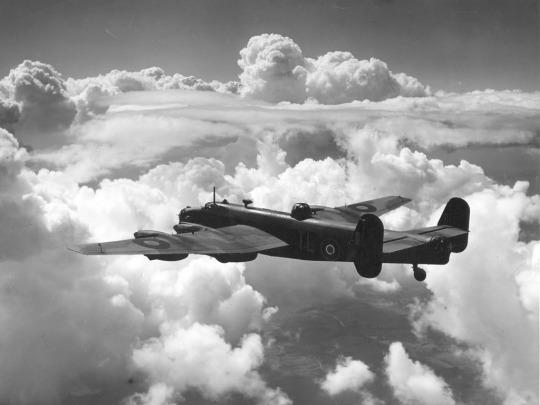
The Halifax would enter RAF service in November 1940, with missions starting in February of the next year. Due to shortages in Merlin engines, production machines would instead mount the Bristol Hercules engine. Early service was sporadic and uneventful, only picking up with Air Chief Marshal Harris came into command of Bomber Command. Halifax numbers rapidly rose, and the bomber briefly held the position as the RAF’s preeminent heavy bomber. However, the Halifax was quickly overshadowed by the Avro Lancaster. The Lancaster, with its cavernous bomb bay, was capable of carrying even the largest bombs in the RAF inventory, while the Halifax could not. Nevertheless, the Halifax did have its benefits, with lower loss rates and higher survival rates among crews. When the first 1,000-bomber raid was launched in May 1942, 131 Halifaxes were the most numerous heavy bomber to participate in the raid.
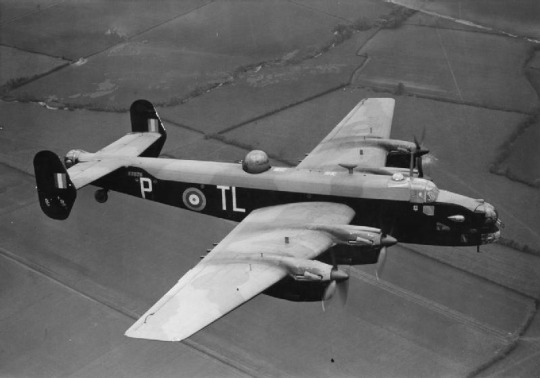
Unfortunately, though Halifax numbers progressively grew, it began to fall out of favor as the Lancaster proved itself more capable of undertaking the firebombing missions the RAF was now flying. Unable to carry the 4,000-lb “Cookie” necessary for firebombing missions, the Halifax would be eclipsed by Lancasters from 1943 onwards. Though Halifax production continued, as the disparity in performance with the Lancaster wasn’t considered enough to be worth disrupting production, the Halifax was slowly transitioned to tertiary theaters. Nevertheless, the Halifax would rack up an impressive record by the end of the war. 82,773 missions were flown by Halifaxes, dropping 224,207 tons of bombs for the loss of 1,833 aircraft.

Outside of bomber command, the Halifax would make appearances in the Middle East and Far East. The first Halifaxes arrived in Palestine in 1942, just in time to support Allied forces at Tobruk that July. Thanks to their various navigation aids, they became an integral part of the bomber force there, with one squadron serving as pathfinders for other bombers in the theater. The Halifax would follow the North African campaign into Sicily and finally Italy, ending the war there. Though plans called for the Halifax to be replaced by the Liberator by war’s end, the Halifax remained in service in Italy in 1945. A small number of Halifaxes were also deployed to the Far East in 1945. Because the bombers were better suited to tropical conditions than the Lancaster, they were deployed both to support jamming operations around India as well as prepare for the planned invasion of Japan.
Armstrong Whitworth Albemarle
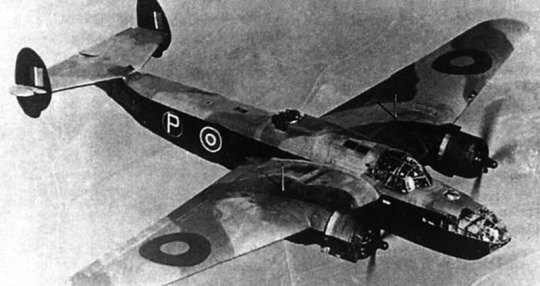
In 1938, the Air Ministry issued specifications for a twin-engined mixed construction bomber that could be easily built by manufacturers with little experience in aircraft construction. Bristol, de Havilland, and Armstrong Whitworth were approached for designs, but only Armstrong Whitworth’s proposal would materialize. Known as the Albemarle, it was a twin-engined aircraft with tricycle undercarriage divided into sub-sections that could be built independently. A dorsal turret and retractable ventral position were added, and payload was 4,500lb of bombs. Owing to the urgent need for aircraft, in October 1938, 200 examples were ordered off the drawing board. The first Albemarle prototype flew in March 1940. Unfortunately, testing revealed the Albemarle held no advantages over existing designs, so plans for it to serve as a bomber were dropped. However, it still showed promise as a reconnaissance aircraft, so production continued. The first Albemarles entered service in January 1943, with several squadrons eventually flying the type. They ended up being used mostly for transport and glider tug duties instead of combat roles. As a transport, it was cramped and uncomfortable, but it served reasonably well as a glider tug, supporting the airborne drops at Normandy and Market Garden.
Martin Maryland
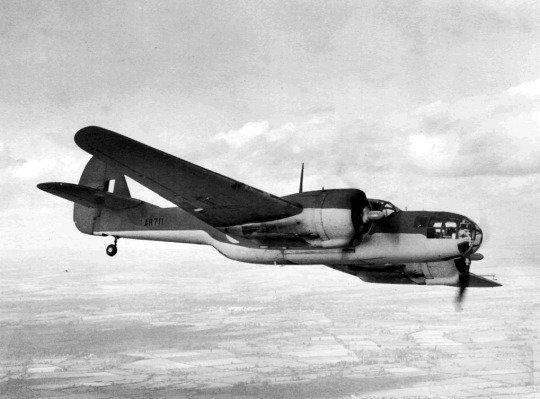
Among the various foreign aircraft operated by the RAF during the Second World War was the Martin Maryland. The Maryland had originally been ordered by France in the leadup to the war, as their domestic industry was unable to meet demand. Having originally ordered over 200 examples of the Martin 167F, France capitulated with 75 of the order yet to be delivered. However, just before the armistice, France signed an agreement in which all of their orders would transfer over to Britain. 32 undelivered aircraft had been completed to French specifications, so they were quickly modified to meet British requirements. The Wright Cyclone engines were replaced with Pratt & Whitney Twin Wasps, and various instruments and weapons were replaced. The remainder of the order was completed to British specifications. These entered service in 1940 as the Maryland. The Marylands were delivered straight to the Mediterranean, where they operated out of Egypt and Malta. Being faster than the Bristol Blenheim, they took over the older aircraft’s reconnaissance mission. Armed with forward firing guns, the Maryland would engage patrolling enemy aircraft on more than one occasion, with one pilot even reaching ace in the machine. However, the Martin never saw too much use, with the type replaced by more capable machines - both domestic and Lend-Lease - as they became available.
Boeing Fortress
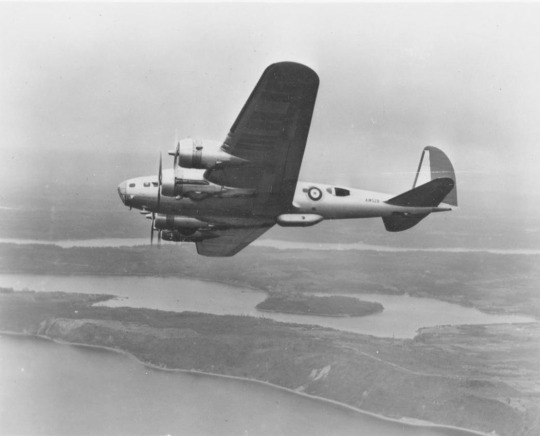
With the RAF’s heavy bombers then in development still yet to enter service as of 1940, the RAF looked abroad for a stopgap solution. In early 1940, the RAF made an agreement with the USAAC, receiving 20 B-17Cs that would serve as the Fortress. Operations began in July 1941. Though it did manage to severely damage the battleship Scharnhorst, it was generally a failure, proving no more suitable for daylight raids than the rest of the RAF’s inventory. Eight B-17Cs were lost by September 1941, after which they were handed off to Coastal Command for long-range patrol work. In August 1942, 19 B-17Fs and 45 B-17Es arrived, joining the older Fortresses with Coastal Command. One squadron was configured as electronic warfare aircraft, however, flying closer to Europe to jam radio communications with German night fighters.
De Havilland Mosquito
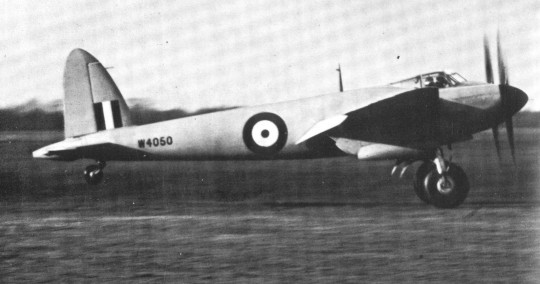
When the Air Ministry issued the P.13/36 requirements in 1936 (that led to the Halifax and Manchester), Handley Page would propose an unarmed high-speed bomber capable of outrunning any enemy fighters. Though it received little interest among the RAF at the time, it caught the attention of de Havilland. In 1938, de Havilland pitched a new proposal to the Air Ministry. Powered by two engines (Merlins, Hercules, or Sabres), it was to be a sleek lightly-armed machine made entirely of wood. Initial work involved repurposing airliner designs like the Flamingo or Albatros, but eventually de Havilland settled on a new design. The new design would be completely devoid of armament, though various different configurations were still proposed. A month after the outbreak of war, de Havilland finalized the design as the DH.98. Powered by two Merlin engines, the DH.98 was to be a two-man all-wood bomber with no defensive armament, instead relying on speed for defense. After much lobbying, de Havilland succeeded in getting an order for a single prototype ordered at the end of 1939.
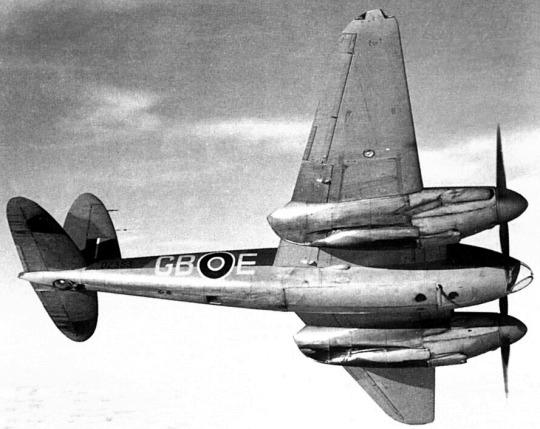
Unfortunately, de Havilland had to struggle to keep official support for the project, only preserving funding by assuring the government that the project would not interfere with production of other aircraft. In November 1940, the prototype Mosquito finally flew for the first time. The new bomber performed well, with trials showing that it outpaced the Spitfire at 6,000ft. Though the Mosquito had initially faced resistance, its excellent performance was now gaining it official support. Production was authorized by mid 1941, and, when the first production aircraft was delivered later that year, it became the world’s fastest operational aircraft. Production was slow at first, but by 1942, enough Mosquitoes had reached service for operations to start.
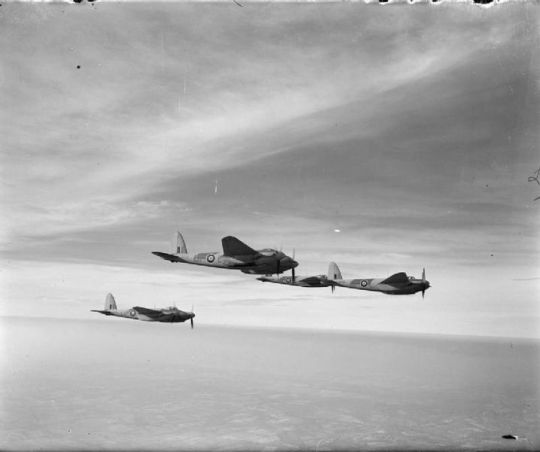
The Mosquito started operations in the summer of 1942, starting off with a series of low-level daylight raids across the Channel. Early missions already were showing promise, with the Mosquito managing to outpace even the fast new Fw 190. On September 19, Mosquitoes would make the first ever daylight raid on Berlin, again outrunning fighters sortied to intercept them. With such incredible performance, the Mosquito soon began to take on special missions. On January 30, 1943, Mosquitoes were sortied to carry out attacks to disrupt speeches being made by Hermann Goering and Joseph Goebbels in Berlin. By hitting a broadcasting station at low level in Berlin, they managed to interrupt the speeches of both men. However, it was not without loss. Berlin’s air defenses were on high alert, and they managed to down one of the attacking bombers.

As the strategic bombing campaign kicked off, the Mosquito grew to be a major part of Bomber Command’s efforts. While other bombers were limited to inaccurate night raids, the Mosquito could carry out precision daylight attacks. For night missions, they often acted as diversions, simulating large formations using chaff to draw away enemy night fighters. Mosquito attacks came every night, keeping constant pressure on enemy air defenses even when larger attacks were not scheduled. When they weren’t flying diversions, Mosquitoes were often marking targets for larger formations of bombers, dropping flares for the coming bombers to aim at. Later, once Allied forces got a foothold in France, Mosquitoes were kept available to hit targets on short notice. These included V1 launch sites, bridges, and tunnels, which Mosquitoes proved more effective than any other bomber at hitting.
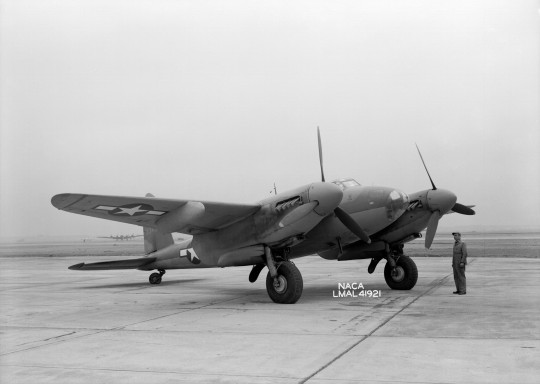
By the end of the war, Mosquitoes had flown over 28,000 missions, dropping 35,000 tons of bombs for the loss of just 193 aircraft - less than a third the loss rate of Bomber Command’s four-engined heavy bombers. Outside of Bomber Command, it would prove itself in every role from night fighter to fighter-bomber, and only at the very end of the war with the appearance of the last generation of German fighters did the Mosquito really start to lose its edge. The end of the war didn’t spell the end for the Mosquito in RAF service, though many of the bombers sold off to foreign powers. Unfortunately, the postwar career was brief even in foreign hands, as the rapid development of jets quickly took away the biggest advantage the Mosquito held. Ultimately, the Mosquito ended its RAF career as a strategic reconnaissance platform, finally being retired in the early ‘50s with the arrival of the Canberra.
Avro Lancaster
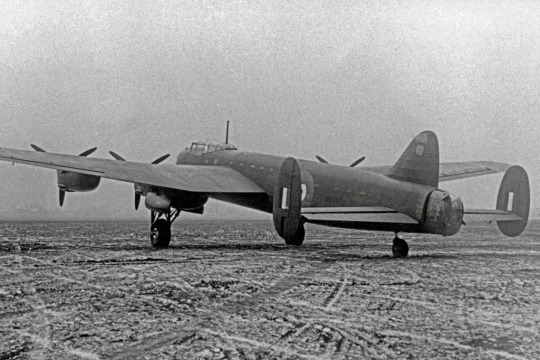
As attempts to alleviate the issues with the Vulture engine that drove the Manchester failed, Avro began to look to alternative powerplants to salvage the bomber. By 1941, the Rolls Royce Merlin engine was selected as a new powerplant, and the bomber was quickly adapted to the new engine. Four Merlins were installed on a larger wing, creating the four-engined bomber that would become the Lancaster. Initially known as the Manchester III, the prototype was little more than a Manchester with the new wings and engines. Taking flight in January 1941, the Manchester III was modified slightly with a revised twin-fin tail for the second prototype, which was then ordered into production as the Lancaster. The design was so promising that many Manchester orders were cancelled and switched over to the new Lancaster.
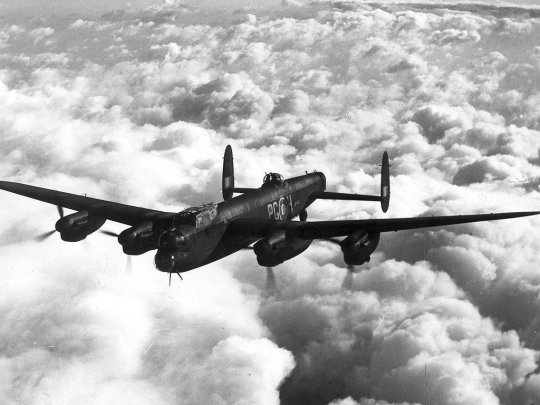
Unfortunately, it would take a year for the Lancaster to start to reach operational units, with the first squadron only converting to the new bomber in early 1942. With reasonably good performance, a long range, and most critically, a spacious bomb bay, the Lancaster would quickly become a favored aircraft among Bomber Command, rising to prominence as the primary British bomber for the bombing of Germany. With a cavernous, unobstructed bomb bay, the Lancaster was a versatile platform that could carry a wide variety of bombs for various missions. For firebombing, for example, the Lancaster would carry a single 4,000lb “Cookie,” several 1,000lb general purpose bombs, and over a thousand incendiary bomblets. The larger bombs would shash buildings and kick up debris, allowing the fire to take hold better. Standard payloads of general purpose bombs were also used regularly, as were full loads of pure incendiary bombs.

Being well liked by crews and commanders alike, the Lancaster unsurprisingly would rise to be the most numerous bomber in the RAF inventory. As per RAF policy, missions were flown solely at night, with Lancasters flying alongside other Bomber Command aircraft to take part in area bombing of German cities. Because it was one of the few bombers capable of carrying the 4,000lb “Cookie” bomb, it was a necessity for any firebombing mission, and, with its unparalleled payload capacity, the Lancaster would end up dropping the majority of Bomber Command’s tonnage over the course of the war. Flying 156,000 sorties, they dropped 608,612 tons of bombs until the end of the war, amounting to 65% of the tonnage dropped by the RAF during the war. However, this came at a heavy price. Over 3,000 Lancasters were lost in action, with many falling victim to German night fighters. Though the Lancaster did have a formidable defensive armament, it was vulnerable on its underside, which German night fighters took advantage of. In the end, no real solution for this was ever implemented - instead, efforts were made to degrade the German early warning network so that the bombers could not be found.

Given the spacious accommodations the Lancaster made for payload, it’s not too surprising that the Lancaster would be tasked with a great deal of specialist bombing. Among the most famous specialist raids were Operation Chastise, where Lancasters were tasked with destroying dams in the Ruhr Valley. Carrying specially designed rotating drum-shaped bombs, Lancasters were required to fly a low, straight path up to the rear face of the dam for release. The rotating bomb would then skip across the surface of the water, over the torpedo nets, before hitting the face of the dam and sinking to the bottom, where it would detonate. The incredibly ambitious mission involved 19 Lancasters targeting three dams. Tactically, the operation was a success. Though eight aircraft were lost, two of the three target dams were breached, damaging much of the infrastructure downstream of the dams. However, the raids had little strategic impact, as the dams were quickly repaired and returned to operational service.
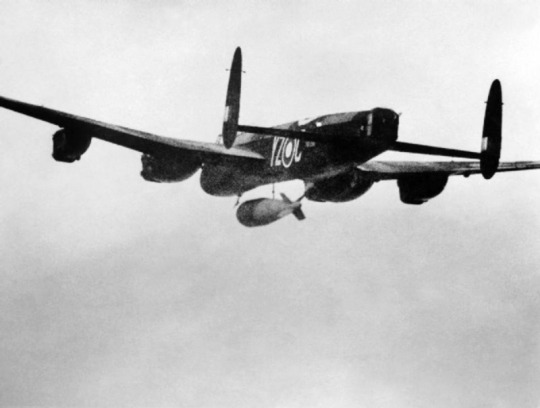
For hardened targets, Lancasters could also carry two massive armor-piercing bombs - the 12,000lb Tallboy and 22,000lb Grand Slam bombs. These massive bombs, which took up the entire bomb bay of the Lancaster, were designed to penetrate deep into the ground before detonating, creating an effect similar to an earthquake to damage hardened targets. The Tallboy was the first of the bombs to become operational, with the first bomb dropped in June 1944. Missions targeted everything from bridges and rail tunnels to dockyards and submarine pens. The most notable use of the Tallboy came in November 1944, when two Tallboys struck the German battleship Tirpitz at anchor, causing it to capsize. For even harder targets, the 22,000lb Grand Slam entered service in 1945. Being so large that the Lancaster’s bomb bay doors had to be removed, the Grand Slam proved even more successful than the Tallboy. Often used in conjunction with its smaller cousin, its distinguishing moment came with its use against the Valentin submarine pens at Farge, where the bombs penetrated the 23ft thick roof of the pens and detonated inside.
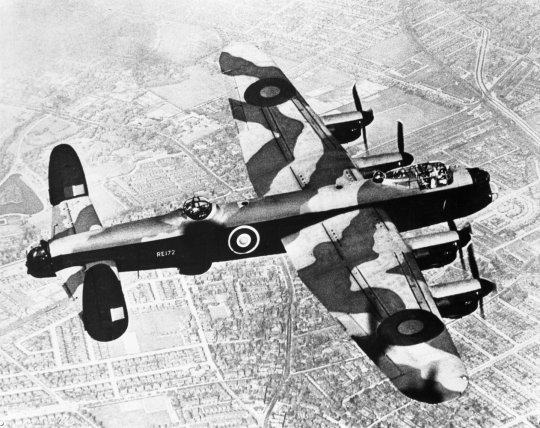
With priority given to the Lancaster in Europe, the bomber didn’t see much use elsewhere. Bombers the Lancaster replaced were often shifted off to tertiary theaters like the Mediterranean, and in cases like the Burma theater, the Lancaster was seen as poorly suited for the region. The only notable foreign deployment of the Lancaster came in 1945, when they were deployed as the largest part of the Tiger Force - the RAF component intended to support the invasion of Japan. The end of the war would see the end of the Lancaster’s career. Massive drawdowns in the RAF led to the retirement of much of the fleet, with many aircraft passed on to Commonwealth operators and the newly reestablished French Air Force. Others were converted to serve as transports, and several were even converted to aerial refueling platforms. Ultimately, the development of the far more capable Avro Lincoln spelled the end for the Lancaster in RAF service, and by the end of the ‘40s, the last Lancaster had been retired.
Vickers Victory Bomber
In 1941, Vickers began working on a new bomber project designed around the 22,000lb “Grand Slam” bomb. While Avro’s Lancaster could carry the bomb after extensive modification, Vickers intended to develop a bomber that could more readily carry the payload. Thus, Vickers created what became known as the Victory Bomber - a massive six-engined machine designed to drop a Grand Slam bomb from 40,000ft. Making use of the geodetic structure made famous on the Wellington, the Victory Bomber was to be a 50 ton machine with a ceiling of 45,000ft, cruise speed of 320mph, and range of 4,000 miles. Because of the protection offered by the high altitudes it would fly at, protection was minimal - just a single four-gun tail turret - and to keep crew comfortable, the cabin was to be pressurized. Unfortunately for Vickers, the Air Ministry saw little utility in a massive bomber designed for just a single payload, so in May 1941 they rejected the design, as it was believed it would not be completed before war’s end. Vickers appears to have gotten as far as wind tunnel testing of a large scale model before work came to an end.
Douglas Boston/Havoc

As with the Maryland, the Boston would originally come into RAF service due to the transfer of French orders before the 1940 Armistice. However, the British were a far more enthusiastic operator of the Douglas bomber, coming to equip 24 squadrons with the type. The first Bostons entered service with Bomber Command in 1941, starting operations against enemy shipping early the next year. By mid 1942, they began cross-channel raids, taking over the role from the obsolete Blenheim before themselves being replaced by the more capable Mosquito. Others were converted to night fighters, with several Havocs fitted with a large searchlight in the nose to light up targets for other night fighters. After the invasion of Normandy, Bostons were moved to France to support ground forces, but they were slowly phased out through the end of the war. By the time Germany left the war, only one squadron in Europe was still flying the Boston.

The Boston would make its real showing with the RAF over North Africa. The first Bostons arrived in North Africa in November 1941, kicking off operations with poorly-executed unescorted reconnaissance missions. In March 1942, two squadrons of Bostons were now in the theater, arriving just in time to take part in the Second Battle of El Alamein. Missions involved low-level attacks that were costly for the crews, but incredibly effective against the soft targets they encountered. Two more squadrons arrived to take part in operations in Tunisia in 1943, following the campaign into Sicily later that year. At the end of 1943, however, the South African squadrons flying the bomber would convert to the Marauder. In Fall 1944, there were again four operational squadrons in Italy, which flew constant night intruder raids over Axis-occupied Europe until the end of the war.
North American Mitchell
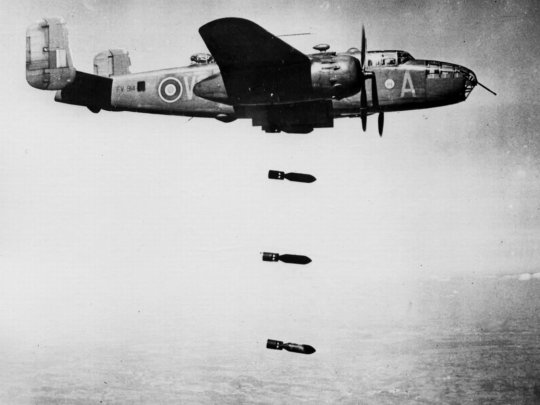
The RAF would be one of the first customers of North American’s B-25 medium bomber. Purchased under the service name Mitchell, the first of the bomber were delivered in August 1941 to a training squadron in the Bahamas. However, it took time for the RAF to adopt the bomber, so it wouldn’t be until January 1943 that RAF Mitchells flew their first operations. Up until the invasion of Normandy, they participated in sporadic cross-Channel raids at various targets in France. Once a bridgehead was secured, the four squadrons flying the bomber were transferred to France and Belgium to directly support Allied forces. Two squadrons were also sent to the Far East, where they flew the Mitchell on photo-recon missions. By the end of the war, total deliveries of the Mitchell amounted to 167 B-25Cs, 371 B-25Ds, and 240 B-25Js.
Consolidated Liberator
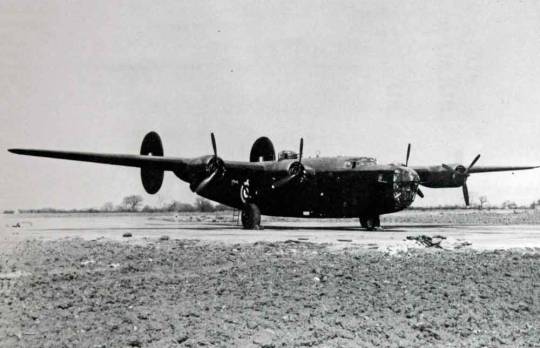
The British would place orders for Consolidated’s new bomber in 1940, alongside the French. Before any aircraft could be delivered, however, France fell, so the entirety of the French order was transferred to the British. The first 20 Liberators on order reached RAF service by mid 1941, but they were found to be unsuitable for combat. Lacking any self-sealing fuel tanks and having poor defensive armament, they were passed on to Coastal Command, who used them for antisubmarine patrol. They were converted for the role by adding a ventral cannon pack and a search radar, with some modified further with searchlights and mounts for 3 inch rockets. Later in 1941, a second order began to arrive with major improvements. Configured for turrets (to be fitted domestically upon their arrival), it featured self-sealing fuel tanks and a slightly longer fuselage for more crew. A large order of Liberator transports was also delivered, serving with all parts of the RAF.

Unlike the Fortress, the RAF’s Liberators would actually see considerable use. Two bomber squadrons of Liberators were deployed to the Middle East in 1942 to support Allied operations in the Mediterranean, and, though the RAF operated no Liberators as bombers over Germany, they did configure one squadron as jamming aircraft to support night raids. In October 1944, two squadrons were deployed to India, where they supported Allied covert operations in the Far East. For the most part, however, RAF Liberators flew as maritime patrol aircraft with Coastal Command, being extensively modified for the role. Though they were undoubtedly effective at the role, it was far from the glorious missions American B-24s would see over Europe.
Lockheed Ventura

In 1940, the RAF had placed an order for 188 Lockheed Venturas, an improved variant of the Hudson medium bomber. Deliveries began in September 1941, with the aircraft ferried across the Atlantic in April 1942. Combat missions began in November 1942, with the Ventura sent against targets in the Netherlands. Flying alongside Mosquitoes and Bostons, Venturas were sent on low-level daylight raids with poor results. The Ventura proved poorly suited to low-level raids, and transitioning to medium-level missions only saw losses mount. Ultimately, it was deemed to be unsatisfactory as a bomber. Though considerably more capable than the Hudson it was derived from, its poor performance in combat saw it quickly replaced by the Mosquito. The Ventura’s last mission with the RAF was flown in September 1943, after which survivors were shifted off to Coastal Command. Coastal Command operated a total of 387 Venturas, flying them in the Atlantic and Mediterranean. They seem to have performed better in that role, although their service was uneventful.
Martin Baltimore
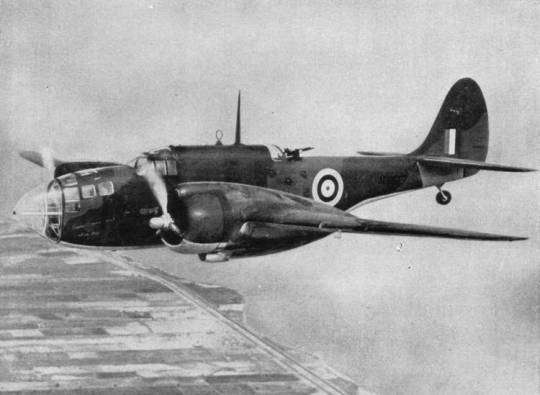
In May 1940, the joint Anglo-French Purchasing Commission had placed an order for 400 Martin Model 187 medium bombers to replace the earlier Maryland. Unfortunately, the Fall of France meant that none of the French order was delivered in time, but the order was passed on to the RAF. Deliveries began in late 1941 under Lend Lease, with the bomber entering service as the Baltimore. The Baltimore was sent to the Mediterranean, where it replaced the Bristol Blenheim. The Baltimore would become popular with crews owing to its heavy armament and agility, although crews complained about the cramped interior. Baltimores were thrown into action soon after arriving to stop the advancing Axis forces in North Africa, suffering heavy losses when flown on low-level attack missions. Once the situation stabilized, however, they began to fly at medium altitudes with escorts, where they performed far better.
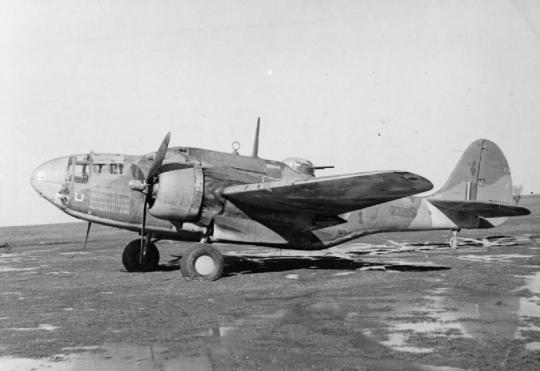
Outside of the bomber role, the Baltimore also took on a variety of other tasks. The Baltimore was tasked with reconnaissance just like the Blenheim it replaced, as well as maritime patrol and antishipping duties. On occasion, the Baltimore was even used as a high-speed liaison aircraft. It ended up being a moderately successful patrol aircraft, sinking eight U-boats during its career in the Mediterranean. After the war moved to Italy in 1943, the Baltimore was used more directly to clear the road to Rome, and, after the 1943 Armistice, a squadron’s worth of aircraft were passed on to the Italian co-belligerent air force. Operations eventually extended across the Adriatic, aiming to support partisans in Yugoslavia. Postwar, most Baltimores were scrapped, though a single squadron remained in service briefly for mapping projects in Kenya.
Martin Marauder

In 1942, 52 B-26As were supplied to the RAF under Lend-Lease. As with earlier American medium bombers, they were sent to the Mediterranean, where they replaced a squadron of Blenheims. Operations began in late 1942, with the bombers used for maritime patrol, minelaying, and antishipping duties. Unlike USAF crews, the RAF was fairly successful with torpedo-bombing with the Marauder, sinking several ships with the aircraft. Thanks to the bomber’s forward-firing guns, they also succeeded in downing several transports ferrying supplies to North Africa. In 1943, a further 100 Marauders were delivered (this time B-26Cs), being supplied to SAAF squadrons in North Africa. Flying out of Egypt, they struck targets in the Aegean and Italy. 350 more B-26Fs arrived in 1944, supplying enough aircraft for the SAAF to form an all-Marauder wing. Now operating out of Italy, the Marauders were used in attacks across the Adriatic to support partisans in Yugoslavia. It would be during one of these operations that an SAAF Marauder was downed on May 4, 1945, making it the last Marauder of the war to be shot down. Following the end of the war, the entire inventory was quickly scrapped.
Bristol Buckingham
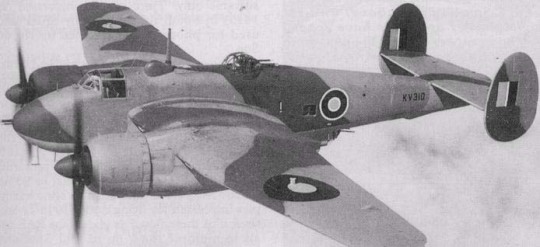
In 1939, Bristol developed a private venture design for a new medium bomber developed from the Beaufighter. Work proceeded on low priority, but when specifications were issued in 1940 for a Blenheim replacement, Bristol decided to tender their new design. Contracted as the Beaumont, the design mated a new forward and center fuselage to the Beaufighter. A dorsal turret was installed with four machineguns, while four forward firing and two rear firing machineguns were also added. New specifications were written around the bomber, calling for a top speed of 360mph and payload of 4,000lb. This required Bristol to rework the design around the Centaurus engine, which in turn required a new wing. The new design, now known as the Buckingham, had armament overhauled as well. Nose, dorsal, and ventral turrets were added, and a ventral gondola was installed for the bombardier. The Buckingham finally took flight for the first time in February 1943, with an order for 400 placed well before with the expectation that deliveries would begin in March 1943. Unfortunately, tests revealed terrible stability issues that could not be resolved. The type still managed to get into service by early 1944, but by then its intended role was being handled by the Mosquito. Thus, it was sent overseas to replace Wellingtons, only for these plans to be cancelled once the scale of the stability problems became apparent. Ultimately, production ceased with 119 built, and most lived out their extremely brief careers as high-speed couriers.
Avro Lincoln

In 1943, Avro began work on a follow-on to the Lancaster. Working off of the Lancaster, the new bomber made use of a larger, stronger wing with newer Merlin engines mounted to a larger fuselage capable of carrying a larger payload of fuel and bombs. Ordered as the Lancaster IV, the bomber would have a higher service ceiling and longer range than the Lancaster, as well as a significantly higher payload. The Lancaster IV prototype would fly for the first time in June 1944, with the type rapidly ordered into production as the Lincoln. Though production began domestically as well as in Canada and Australia, it would take a while for the factories to get up and running. It wouldn’t be until 1945 that deliveries of the Lincoln would begin, and by the time the war ended and much of production was cancelled, Canadian factories had completed just a single Lincoln.
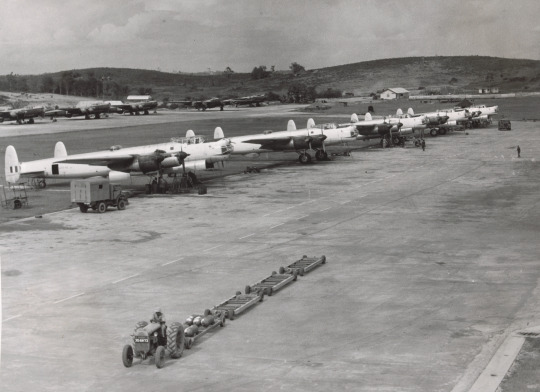
With the war already effectively over in Europe by the time the Lincoln entered service, the first operational aircraft were deployed to the Pacific in preparation for the invasion of Japan. However, few made it into service before the end of the war. The Lincoln would come to be the backbone of the postwar RAF Bomber Command, replacing the Lancaster. 29 RAF squadrons would come to fly the bomber, with some being partially replaced by the longer-ranged B-29 in 1950. The Lincoln made its combat debut in the 50’s in various colonial conflicts. The bombers were deployed to both Kenya and Malaya to combat insurgencies there, with Lincolns flying some 3,000 sorties and dropping half a million pounds of bombs (85% of the tonnage dropped in the campaign) in their seven-year stay in Malaya.

As the 1950s came, the RAF began looking for a more modern replacement for the Lincoln, but it would be some time before something would come. A small number of B-29s were loaned from the US to provide the RAF with the ability to strike targets in Eastern Europe, but the Lincoln itself would stick around into the late ‘50s. Several were configured for radar reconnaissance, flying patrols near the Iron Curtain in the early days of the Cold War. However, with the arrival of the new generation of jet bombers - first the English Electric Canberra and then the V Bombers - the Lincoln was progressively retired, ending its career as the last piston-engined bomber of the RAF.
Boeing Washington
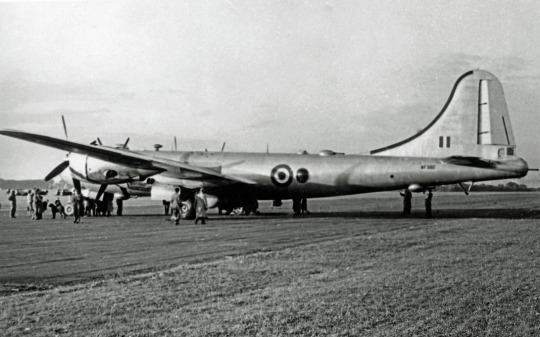
Though the RAF had largely operated with domestic designs during the Second World War, the appearance of the American B-29 presented the RAF with something for which they had no equal. With nothing similar anywhere near production, the RAF would opt to receive several squadrons worth of B-29s under the service name Washington. Starting in January 1950, the USAF loaned the RAF 70 B-29s. The aircraft, which had been sitting in storage since they left the factory at the end of WW2, were virtually new. Nine squadrons would come to fly the Washington, serving as a stopgap for Bomber Command until the English Electric Canberra was ready for service. Unlike the B-29s of the USAF, Bomber Command’s Washingtons saw no use in Korea, instead remaining stationed domestically for their entire career. When the Canberra began to enter service in 1953, the RAF started to return the Washingtons. However, one squadron kept their aircraft until 1958, operating as ELINT platforms.
English Electric Canberra
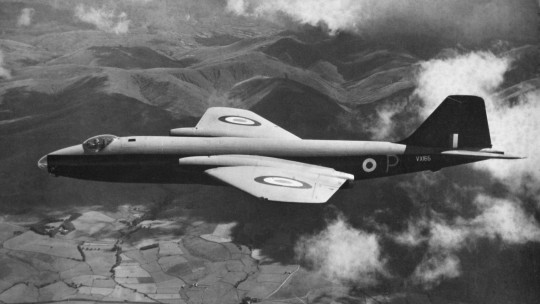
In 1944, the Air Ministry issued requirements for a successor to the Mosquito. Though English Electric had little experience of their own in designing aircraft, their considerable work in constructing other companies’ designs during the war saw them contacted to develop a proposal. In late 1944, the chief engineer from Westland joined the company, developing a twin-engined fighter-bomber design he had proposed earlier that year. The design took shape as a twin-engined aircraft with a long cigar-shaped fuselage and thick wings. Midway down the wings, engines were to be mounted, and the wings themselves would have untapering center sections and tapered outer sections. A crew of three would be carried in a pressurized nose compartment, complete with a glazed bombardier’s position and fishbowl canopy for the pilot. English Electric began construction of the four prototype Canberras in 1946, but postwar cuts meant the bomber wouldn’t fly until 1949.

Fortunately, the Canberra design was sound enough to be ordered into production with minimal changes. Powered by two Rolls Royce Avons, the first production aircraft took to the skies in April 1950. With a top speed of 540mph, ceiling of nearly 50,000ft, and payload of 7,900lb, the Canberra was an impressive platform for the time. It entered service in January 1951, with production accelerating due to the outbreak of war in Korea. It replaced Mosquitoes, Washingtons, and Lincolns in bomber and reconnaissance roles. Exercises soon showed the bomber’s potential, with the Canberra frequently proving fast enough to evade interception until the arrival of the Hawker Hunter. As newer variants became available, older Canberras were shifted off to overseas squadrons.
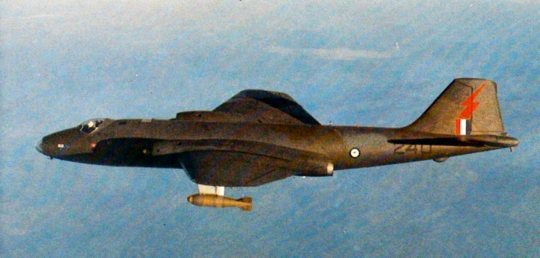
The Canberra’s early career was marked by fairly frequent strategic reconnaissance flights around Eastern Europe and the peripheries of the USSR. Often made in cooperation with the US, these flights continued until 1956, by which point the American U-2 took over the role. Meanwhile, strategic bombing was passed off to the V Bombers starting in 1955, when the Vickers Valiant entered service. However, the Canberra stuck around for tactical and low-level strike roles, with dedicated variants soon developed for it. New variants were fitted with forward-firing cannons and a new fighter-style canopy, while underwing pylons for bombs and rockets were added. As nuclear weapons shrunk, the Canberra took on a new bombing system to allow it to deploy these warheads from low altitudes. Squadrons based out of Germany were equipped with the American Mk 7 nuclear bomb, while squadrons in Cyprus and Singapore were armed with the British Red Beard.

The V bombers finally replaced the Canberras in Bomber Command in 1961, but tactical squadrons based abroad continued to fly the Canberra. As the decade wore on, however, they were progressively retired. The Cyprus and one Germany-based squadron were retired in 1969, and the Singapore squadron followed the next year. Three remaining squadrons flew on in Germany until 1972, when they too were retired. The RAF continued to operate reconnaissance variants long past that date, fitting the bombers with long-range oblique photography equipment to look deep over the border into Eastern Europe. In this role, the Canberra remained in service into the new millennium. Photo-recon Canberras made appearances over Bosnia and Kosovo in the ‘90s, and they saw service as late as 2006 in Afghanistan and Iraq. The RAF’s last Canberra sortie was flown on July 28, 2006, with a flypast marking the standing down of the last operational Canberra squadron.
The V Bombers
In late 1944, the Chiefs of Staff requested an analysis from Sir Henry Tizard on the future of warfare. The resulting report, issued in mid 1945, recommended the development of atomic weapons and jet bombers capable of deploying them as a deterrent. The start of the Cold War provided impetus for development of such capabilities. As work began on development of nuclear weapons, the Air Ministry issued new specifications for a bomber to carry the weapons. Requirements called for a medium-ranged bomber capable of carrying a 10,000lb payload to a target 1,500nmi away. Loaded weight was limited to no more than 100,000lb, while cruise speed was to be 500 knots and service ceiling to be 50,000ft. Handley Page and Avro would produce two very advanced designs for the new requirements, leading to concerns that the ambitious designs may fail. Thus, the Air Ministry followed up with a new specification in July 1947 for a more conservative design from Vickers, and finally in August, Short was contracted to develop an even more conservative fallback design.
Vickers Valiant

For their bomber, Vickers would develop a new bomber that was a fair mix between conventional features and modern elements. Though it made use of a fairly conventional layout, the Valiant had a large compound-sweep wing, with the inner wing section having a 45 degree sweep and the outer wing reduced to 24 degrees. Four Avon turbojets were place in the wing roots. The crew was housed in a pressurized compartment in the nose, while an expansive bomb bay provided space for a single nuclear weapon or up to twenty-one 1,000lb bombs. Large external tanks were designed to be placed on the outer wing sections, aimed at extending the range. The Valiant flew for the first time in May 1951, receiving a production order and the name of Valiant just a month later.
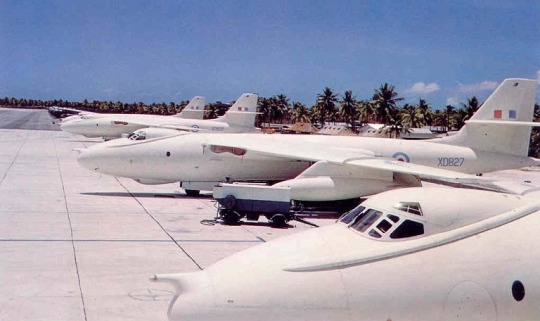
The first Valiant squadron was formed in January 1955, with the bomber reaching eight operational squadrons at its peak. Being the first of the V Bombers to enter service. Soon after its operational debut, Valiants were deployed to Cyprus as part of British intervention in the Suez Crisis. There, they dropped 856 tons of bombs on seven Egyptian airfields. However, having come so soon after the type entered service, results were poor. Many aircraft had yet to receive their attack radars, and the inexperienced crews only managed to disable three of the seven target airfields. Later in 1956, the Valiant became the first British aircraft to drop a nuclear bomb, deploying a downrated Blue Danube at a test range in Australia. A few months later, it followed up with the first British hydrogen bomb - Green Granite Small.
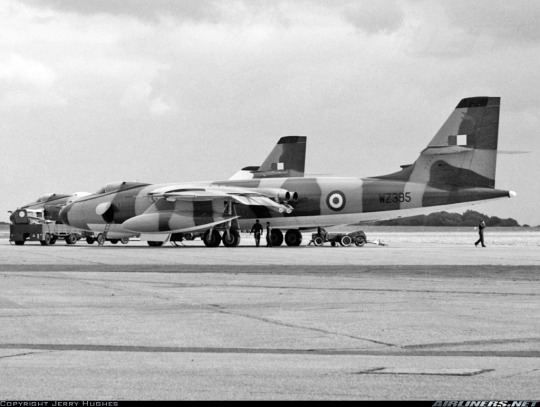
The Valiant continued nuclear testing through 1958, becoming the only V Bomber to drop a nuclear bomb. By the late ‘50s, Valiants were being fitted with refueling probes, while others were configured for serving as tankers. They also began transitioning to low-level approaches, often flying with American-made weapons. However, this new flight profile was only briefly used. As the newer V Bombers started to enter service, the considerably less advanced Valiant began to be phased out of combat role. Plans called for the Valiants to be phased out by 1965, but the new low-level profile took a toll on the airframes. As airframes fatigued faster than normal, the decision was made to phase out the Valiant early. In 1965, the Valiant fleet was grounded, with the exception of a single example that had been re-winged. The sole Valiant that remained flying would continue flying until 1968 as a test aircraft before it was finally retired.
Short Sperrin
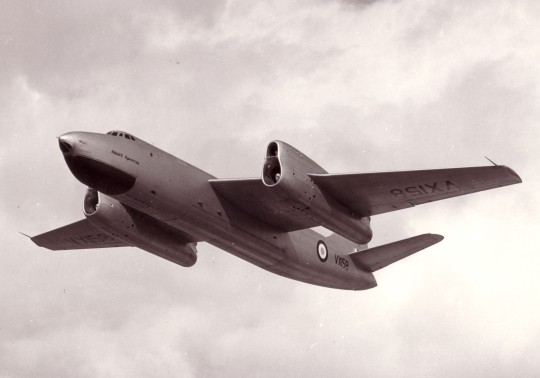
Being contracted to develop a very conservative fallback design, Short’s Sperrin was unsurprisingly hardly remarkable. Mostly resembling a WW2 bomber with jet engines hastily applied, the Sperrin had a conventional fuselage with unswept tail surfaces and a tapered shoulder-mounted wing. Four Avon turbojets were mounted halfway down the wings, paired together in pods that straddled the spar. The Sperrin was given a crew of five in a pressurized cabin, but it lacked any defensive armament. Instead, the bomber was filled with an advanced avionics suite, complete with advanced navigation and attack systems and a defensive electronic countermeasures system. The first prototype was flown in August 1951, taking flight several months after Vickers’ more radical Valiant. Unfortunately, the Air Ministry had since dropped plans to procure the Sperrin, as the development of the other V Bombers was going smoothly. Thus, the two Sperrin prototypes were instead used for a variety of tests, including the new de Havilland Gyron turbojet, Blue Danube nuclear bomb, and Blue Boar guided missile.
Avro Vulcan

Avro would propose undoubtedly the most radical design for the new bomber requirements. Avro’s engineers envisioned a massive tailless delta wing bomber, powered by four Bristol Olympus turbojets stacked on either wing root. Vertical surfaces were to be on the wingtips, making the bomber more or less a flying wing. The design was promising, but it was so radical that Avro would first have to fly a sub-scale demonstrator to validate the aircraft. Originally contracted to fly a twin-engined half-scale demonstrator, the projected complexity of this demonstrator saw this reduced to a third-scale machine known as the Avro 707. Apart from the dorsal intake, the 707 in many ways looked almost identical to the final product, with later aircraft in the series eventually taking on the final design’s appearance with its revised wing-root intakes. The first of five 707 prototypes flew in September 1949. Testing was extensive, though by the time the 707 flew Avro had already finalized the design for the bomber. Nevertheless, the 707 would prove valuable, validating the radical new design.

The Vulcan bomber that took shape in 1952 differed in many ways from the original proposal. Though it was still a four-engined delta wing, a single vertical tail was installed in place of the wingtip surfaces, and the four engines were placed side-by-side rather than stacked atop eachother. The first Vulcan prototype took flight in August 1952, powered by four Avon turbojets because the Olympus was not yet available. Two prototypes were built, with various different engines fitted over the course of testing. During testing, Avro had developed a new wing planform that involved a curved - rather than straight - leading edge. The new wing was fitted on the second prototype during testing, with the new wing showing promise. Overall, the design was promising, and in mid 1952, an order for 25 Vulcans was placed.

The first Vulcan was delivered in September 1956, with the first squadrons becoming operational the next year. In 1959, the fleet was outfitted with aerial refueling equipment, and several of the bombers were configured as tankers. RAF planners wished to have Vulcans fly continuously airborne patrols, but this practice was quickly deemed untenable and dropped. Still, Vulcans remained on constant standby, with small numbers of the bombers always ready to take off with a nuclear payload. Like the other V Bombers, the RAF hoped to use the Vulcan as a carrier for the Skybolt air launched ballistic missile that was then in development. The last 28 Vulcans produced were fitted with pylons to accommodate the missile, and a dedicated Skybolt-carrying variant was even proposed.

Unfortunately, the Skybolt would be cancelled in the early ‘60s, and, as Soviet air defenses rapidly improved, the RAF was forced to adopt new tactics to keep their nuclear deterrent relevant. The Vulcan attack profile shifted to low-level penetration, but the practice was hardly practical. The Vulcan was limited to 350 knots at low level, and the low-level profile cut range and took a heavy toll on airframes. As the Royal Navy’s Polaris Missiles took over the strategic nuclear strike role in the ‘70s, the Vulcan was shifted off to tactical nuclear strike. The constant alert they bombers saw when in the strategic role was dropped, but they continued to fly nuclear weapons. Even so, by the end of the ‘70s, the RAF was drawing down the Vulcan force as more capable tactical aircraft were assigned its role.
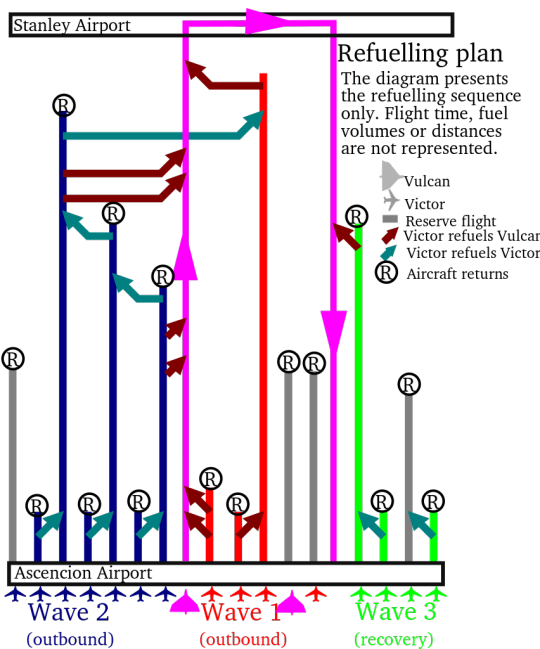
When Argentina invaded the Falklands in 1982, however, the British suddenly found themselves in search of an aircraft capable of hitting targets in the Falklands from the nearest airbase in Ascension. The Vulcan, being the last of the V Bombers to be retired, was selected, with the five newest airframes selected for the mission. Though they lacked the range to make the trip unaided, the RAF devised an elaborate refueling scheme, requiring 14 Victor refueling aircraft to perform a total of five inflight refuelings per sortie. Two Vulcans would takeoff on the mission, with one turning back if the other had no issue. To counter Argentine air defenses, the Vulcans were fitted with the ECM pods from the Buccaneer. Meanwhile, a new navigation suite and avionics to use the AGM-45 Shrike antiradiation missile were added.

The first Black Buck raid came on May 1, 1982, with a single Vulcan dropping a load of bombs over the airfield at Port Stanley. The bombing run crossed the airfield, dropping a single bomb right in the center of the runway and making it unsuitable for launching fighters. Black Buck 2 also hit the runway several days later, ensuring that the Argentines would have to operate all their fighters and strike aircraft from the mainland. At the end of May through mid-June, three sorties were also flown against Argentine radars on the islands with moderate success. Though the actual impact of the raids on the war is still up for debate, Black Buck was nevertheless an impressive feat, with the 6,800 nmi 16-hour missions being the longest bombing raids in history until the record was broken in 1991 by USAF B-52Gs. Unfortunately, this also marked the end of the Vulcan’s career. Once the war in the Falklands was over and tensions declined, the RAF continued to retire the Vulcans. Less than two years after the end of the was in the Falklands, the last Vulcans had been retired.
Handley Page Victor
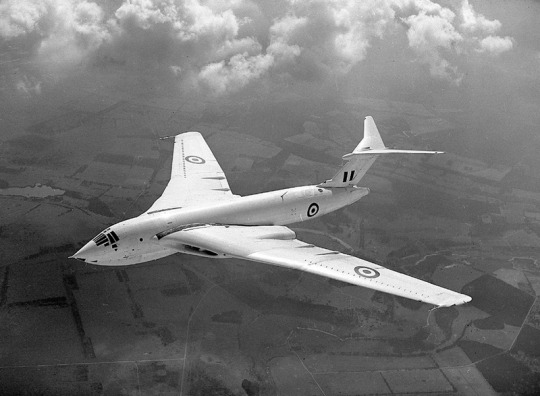
Handley Page’s Victor would be a more ambitious design than that of Vickers or Short. Designed around a crescent-shaped wing that was intended to ensure a constant critical Mach number across the wing, the bomber matured from a tailless proposal to a more conventional layout with a T-tail. As with the Valiant, the Victor was fitted with four turbojets mounted in the wing roots, and the crew was stationed in a pressurized compartment in the nose. A bulging chin carried a bombing radar and bombardier’s station, and the crew of five was placed all on the same level unlike the other V Bombers. The Victor would be the last of the V Bombers to fly, taking flight for the first time in December 1952. It would also become the last V Bomber to enter service, first becoming operational in late 1957.
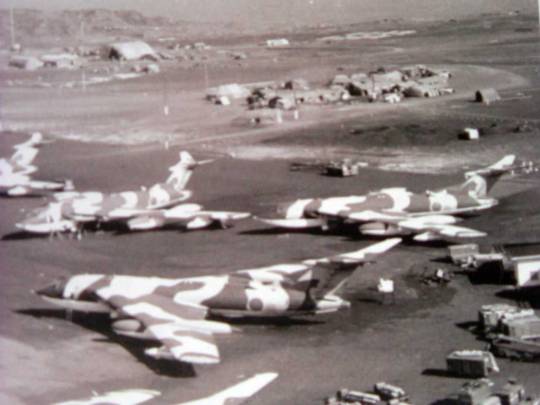
Through the end of the 50’s, the Victor fleet grew to a peak strength of six operational squadrons. Replacing the Valiant, the Victor would serve alongside the Vulcan as the RAF’s primary nuclear strike platform. Thanks to an advanced navigation and attack suite, the bomber was able to operate completely independently to complete its mission. They were frequently dispersed during times of tension, with the bombers capable of launching in under four minutes if called into action. Soon after its debut, the RAF made a transition to low-level approaches, as it was determined that the V Bombers could be detected as far as 200 nmi out by Soviet radars. This, employed in conjunction with the Victor’s advanced ECM suite, was to improve the bomber’s chance of success.
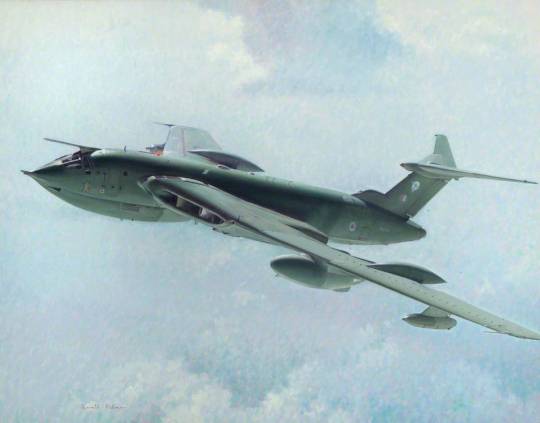
Unfortunately, as the transition to low-level attacks began, the Victor fleet was downsized. Only two squadrons of second-generation Victor B.2s would be delivered, with the last 28 ordered cancelled. Worse, the promising new Skybolt air-launched ballistic missile, which offered the potential of keeping the Victor relevant, was cancelled in late 1962. The Victor continued to serve as a deterrent however, deploying to Singapore in 1964 to counter rising tensions between Indonesia and Malaysia. The Victor’s career as a nuclear deterrent continued until 1968, when fatigue cracks were discovered on the wings of much of the bombers. The fleet was abruptly grounded, putting an end to the Victor’s career as a bomber.
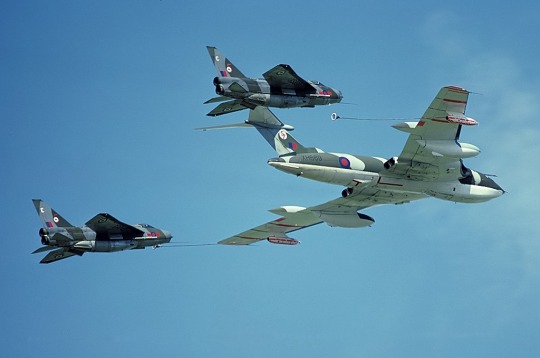
Though the Victor’s career as a bomber was over, it would live on as a tanker. Tanker variants of the Victor had been developed in the ‘60s, but these were scheduled to be retired by 1970. Thus, the RAF approved a major overhaul of the recently-retired Victor fleet. The Victors were fitted with tip tanks and the wing structure revised and repaired to limit fatigue. Several others were converted for strategic reconnaissance, where they served as maritime patrol platforms. Reconnaissance Victors remained in service to 1974, but the overhauled tankers lasted far longer. Their high point came in 1982, where Victors provided the extensive tanker support required for the Black Buck raids. Their last major showing came in the Gulf War, where they supported Coalition air efforts. Unfortunately, the fleet wouldn’t last much longer than that, with the Victor tanker fleet being retired in 1993.
10 notes
·
View notes
Text
/k/ Planes Episode 100: Desert Storm
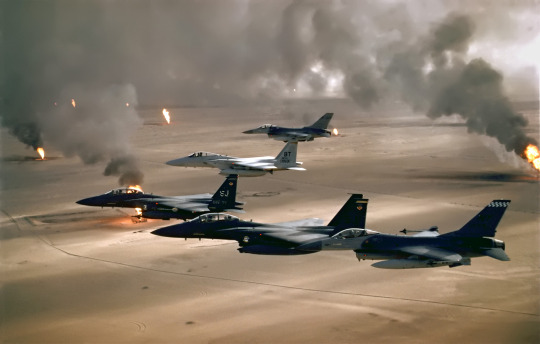
It’s time for another episode of /k/ Planes! This time, we’ll be looking at the air campaign of the 1990-91 Gulf War.
In 1990, after building tensions over alleged slant-drilling, the forces of Saddam Hussein invaded neighboring Kuwait, kicking off what would be known as the Gulf War. The resulting international backlash would create a massive coalition to oppose Saddam with the ultimate intention of removing Iraqi forces from Kuwait. However, though the Coalition forces were intent on liberating Kuwait, the war itself would be primarily fought in the air. Thanks to a lengthy period between the forming of the Coalition and the deadline for the UN’s withdrawal ultimatum, Coalition forces had time to plan out what would become one of the most perfectly executed strategic air campaigns in history. The Coalition air assault unleashed in mid-January 1991 would rapidly degrade the Iraqi war machine on all fronts, turning it into but a fragile husk of its former glory that was easily shattered once the ground war began.
Belligerents: Iraqi Air Force

In August 1990, the Iraqi Air Force appeared quite a potent force. The IQAF had assembled a formidable fleet of Soviet and French aircraft in the years leading up to the war, including well over 500 fighters and fighter bombers. However, despite having just come out of an eight-year conflict with Iran, the IQAF was severely lacking in pilot quality. Postwar purges had cut out many experienced personnel, and economic difficulties in the interwar period had forced the IQAF to cut training hours. Nevertheless, the IQAF hoped to make up for the declining quality of its crews my making use of the country’s extensive air defense network. Unfortunately, purges seem to have hit all aspects of Iraqi command, and the result was predictable. Already working under strictly regimented Soviet air doctrine, the IQAF would centralize its command so much so that they would become unable to respond effectively once the Coalition air campaign picked up.
Belligerents: Kuwaiti Air Force

The Kuwaiti Air Force would bear the unfortunate burden of being the first Coalition power to face the Iraqis in the air. Given the size of the nation, not much could be expected from the KAF, especially in the face of one of the largest armies in the world. Their combat aircraft inventory consisted of a little over 30 Mirage F1s and 36 TA-4KU Skyhawks deployed across two major airbases. Though the KAF was caught completely unprepared by the Iraqi invasion, they still managed to muster a respectable effort. Nevertheless, the airfields were soon overrun, and, while the majority of the KAF would escape to the relative safety of Saudi Arabia, many aircraft would fall into Iraqi hands. The remnants of the KAF would join the growing Coalition forces, supporting them during the much larger air campaign that followed.
Belligerents: United States Air Force

By far the largest and most active force in the Gulf War air campaign was the USAF. Within a week of the invasion of Kuwait, USAF fighters had been deployed to Saudi Arabia to conduct patrols along the border, and an extensive airlift effort was used to rapidly deploy assets to defend against a possible Iraqi push into Saudi Arabia. Once it became apparent that no such push was happening, the USAF took to the forefront of the planning for the coming air campaign. Under the guidance of Lieutenant General Chuck Horner, the USAF bore the brunt of the coming campaign, working jointly with USN, USMC, and other coalition air forces. Forces were broken into five air divisions and one composite wing, organized primarily by role. The 14th AD consisted of strike aircraft and supporting elements, with the 15th managing tactical reconnaissance and EW elements, 1610th handling strategic airlift, 17th handling aerial refueling, and 7th managing B-52s. Supporting them was the 7440th Composite wing, operating from Turkey.

For the coming war, the USAF would bring all of its latest weapons and tactics to bear. The newly developed F-117 strike aircraft would make its debut in the skies over Baghdad, and the E-8 Joint STARS battlefield management aircraft would be deployed to support ground operations. Aircraft would be flying from all over the world to hit targets in Iraq, with B-52s operating out of their base in Louisiana and flying off to Diego Garcia in the Indian Ocean for subsequent operations while shorter-ranged tactical aircraft were flying from all over Saudi Arabia and select bases in Turkey. With its aircraft making up over half the inventory available to the Coalition, it would be a USAF general - Lt. Gen. Chuck Horner - that would lead the Coalition air campaign.
Belligerents: United States Navy/Marine Corps
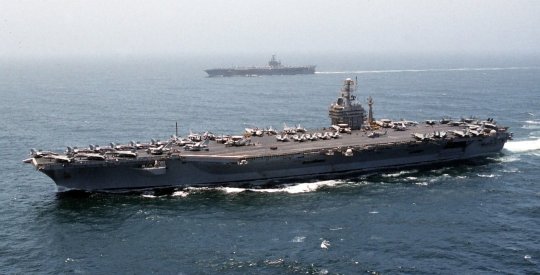
Though the USN and USMC may have had a quieter experience in the war, their involvement was just as important to the war effort. Two carriers - Eisenhower and Independence - were dispatched to the Gulf within a week of the invasion of Kuwait, and as the air campaign took shape, the USN was largely tasked with maintaining control over the airspace closer to the sea. A smaller USMC aircraft contingent had a more active role, with their aircraft tasked with providing direct close air support for the coming land battle. Somewhat surprisingly, the war as seen by USN and USMC pilots was considerably quieter than that of the USAF. This hardly means that the USN and USMC were inactive - their operations were integral to the air campaign. Rather, they were merely overshadowed by the operations of the USAF, which had a far wider scope.
Belligerents: Coalition Air Forces

The combined air forces committed by the coalition primarily came from the larger coalition partners - Saudi Arabia, Britain, and France. The Saudis were on the frontlines from the start, with their large force of Panavia Tornadoes flying in both fighter and strike roles. The Royal Air Force would deploy its first aircraft to Saudi Arabia 9 days after the invasion of Kuwait, with their contingent eventually growing to a large force of Tornadoes (both F.3 fighters and GR.1 strike aircraft), Buccaneers, and Jaguars, supported by Hercules transports, VC10 and Tristar tankers, and Nimrod patrol aircraft. In addition, Rapier SAMs were deployed to support ground bases. In all, some 6,000 RAF personnel would be deployed to support the Coalition, becoming the third-largest coalition contingent behind the US and Saudis.
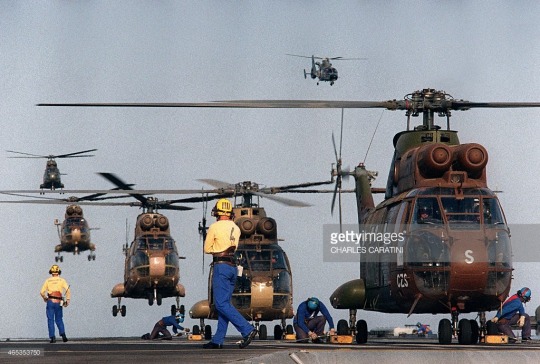
Coming in just behind the RAF was France’s Armee de l’Air, which deployed 40 aircraft. SEPECAT Jaguars and Mirage F1s were deployed for strike and reconnaissance missions, while Mirage 2000s were provided for fighter cover. In addition, the French used the carrier Clemenceau to ferry 40 helicopters and three patrol aircraft to the theater. Other Coalition members committed aircraft, though in considerably smaller numbers. The Italians deployed eight Tornadoes to the region, while Qatar and Canada also deployed modest numbers of their strike aircraft to support the war effort.
The Aircraft: Dassault Mirage F1
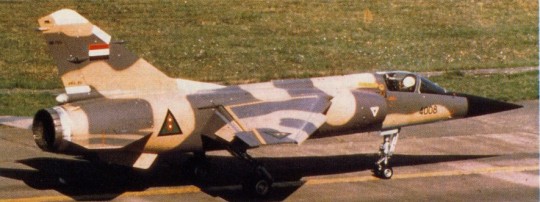
Quite possibly the first fighter to see combat in the Gulf War was the ubiquitous Mirage F1. Flying in both Kuwaiti and Iraqi hands at the outbreak of war, the F1 was a fairly capable multirole fighter. While fighter armament was lacking owing to the inability to use radar-guided missiles, it could carry a formidable load of bombs, and, more importantly for the Iraqis, anti-ship missiles. 88 F1EQs were in IQAF service at the outbreak of war, and eight Kuwaiti F1Ks would be taken into IQAF service. They were perhaps the most active component of the IQAF during the war, making several (failed) attempts to rise to face Coalition aircraft, and on at least one occasion going as far as trying to strike Saudi oil facilities. France also deployed a force of F1s to the region, but they were grounded during the opening phases of the air campaign to avoid being mistaken for Iraqi fighters. They were found to be more useful than France’s Jaguars owing to their more sophisticated navigation system, but nevertheless their operations were largely limited to reconnaissance.
The Aircraft: Sukhoi Su-20/22 “Fitter”
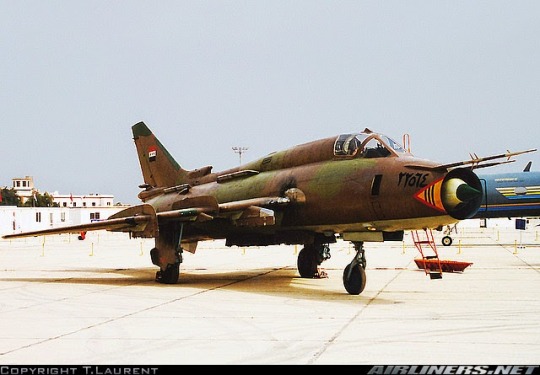
The most numerous strike aircraft in the IQAF inventory when Iraq invaded Kuwait was the swing-wing Su-22. Though it had distinguished itself in both Soviet and Iraqi service as a robust and capable strike aircraft, the IQAF’s Fitters saw surprisingly little use in the war. While it’s very likely that they flew strike missions during the invasion of Kuwait, they seem to have been kept on the ground during the latter part of the war. Even though the Fitter featured similar performance to the F1, the IQAF seemed to prefer their French-built fighters on the rare occasion that they did try to fly offensive strikes during the Desert Storm air campaign. Though the IQAF seems to have kept their Fitters grounded, that hardly seems to have saved them. Opening strikes against airfields took a heavy toll on Iraq’s air forces, particularly the Su-22s, and between those destroyed, damaged, and gone after fleeing to Iran, the remnants of Iraq’s fighter bombers were just a shadow of their prewar strength by the conclusion of hostilities.
The Aircraft: Mikoyan-Gurevich MiG-25 “Foxbat”
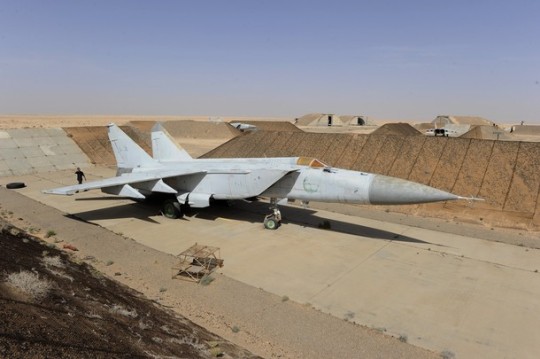
Though Iraq possessed a large force of older Soviet fighters, the MiG-25 was the only such fighter to attain anything close to success in the war. With 9 MiG-25RB and 19 -PDS at their disposal, the Iraqis sortied the MiG-25 quite often in the opening days of the air campaign. On the first night of the war, a MiG-25PDS would down a USN F/A-18 with a radar-guided missile. After the opening day, the MiG-25s seem to have been deployed on hit-and-run missions, swooping in to make attacks on vulnerable aircraft (like the EF-111) before CAP could get to them. There, results were mixed - sorties could force jammer aircraft to abort missions, and on one occasion, a MiG-25 managed to escape a total of 10 missiles fired at it. However, Other attacks didn’t go nearly as well, and at least two MiG-25s would be downed by USAF F-15s. The threat posed by the MiG-25s seems to have been a double-edged sword for the Iraqis, with strikes fairly quickly taking out most of their fleet.
The Aircraft: Mikoyan-Gurevich MiG-29 “Fulcrum”
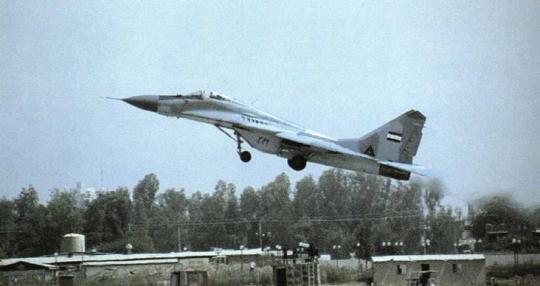
The most modern fighter in the IQAF inventory was the MiG-29A, of which the IQAF possessed 37. Details of the MiG-29’s service in the war are unclear, although the IQAF would make quite a few unsubstantiated claims with the fighter, including an RAF Tornado (which crashed on a mission but was not shot down) and a B-52 (which was hit by a wayward HARM, not a MiG-29’s missile). Despite being on par with all but the most modern fighters the Coalition was fielding on paper, the MiG-29 fared poorly in air-to-air engagements. Some five MiG-29s would be downed by USAF F-15s, and it appears that no MiG-29 kill claims are substantiated by Coalition loss reports.
The Aircraft: Panavia Tornado IDS

The Panavia Tornado would be the most numerous non-American coalition strike aircraft of the war. The RSAF’s 48 Tornado IDS strike aircraft would quickly be supplemented by 60 RAF and 8 Italian Tornadoes as forces built up for Desert Storm. They would participate in the air campaign from the first day, prioritizing IQAF airfields. Unfortunately, these strikes would cause the Tornado to suffer some of the highest loss rates of the war. Owing to the vulnerable low-level profile the anti-runway weapons required, several Tornadoes were lost to enemy ground fire. Low-level strikes were found to be costly and far from decisive, so after the opening days of the campaign, all Coalition members flying the Tornado would transition to safer medium-level operations.
The Aircraft: Panavia Tornado ADV

Though the Tornado IDS was the more popular variant of the aircraft, the Tornado ADV fighter variant also saw considerable use in the war. 18 RAF Tornado F.3s were deployed to Saudi Arabia, supplementing a smaller force of RSAF Tornado ADVs. Unfortunately, their showing was fairly poor. RAF Tornadoes lacked appropriate IFF equipment, meaning that they were generally kept back from the more dangerous areas over the front to avoid being mistaken for enemy aircraft. Saudi Tornadoes would only fly 451 CAP sorties, generally operating in conjunction with F-15s. Though the RSAF Tornadoes didn’t have the IFF issues that prevented the RAF’s fighters from seeing serious use, they nevertheless saw no combat, and generally were less popular with the RSAF than the F-15.
The Aircraft: SEPECAT Jaguar
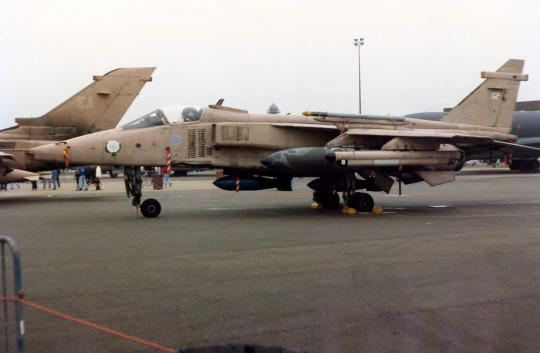
The Anglo-French Jaguar strike aircraft would be deployed by both the RAF and Armee de l’Air when war broke out, though in considerably smaller numbers than the other aircraft committed by the respective air forces. French Jaguars had a mixed experience - though they proved effective with their AS-30L laser-guided missiles, their rudimentary avionics and navigation suite made operations difficult enough that they were often passed over for the more capable Mirage F1. RAF Jaguars had a somewhat more sophisticated avionics suite, but, unusually, they were often deployed with simpler weapons - namely unguided rockets and cluster bombs. RAF Jaguars were also fitted with reconnaissance pods on occasion. In all, both the British and French flew similar numbers of sorties with their Jaguars - both about 600 sorties each.
The Aircraft: McDonnell Douglas F-15C Eagle
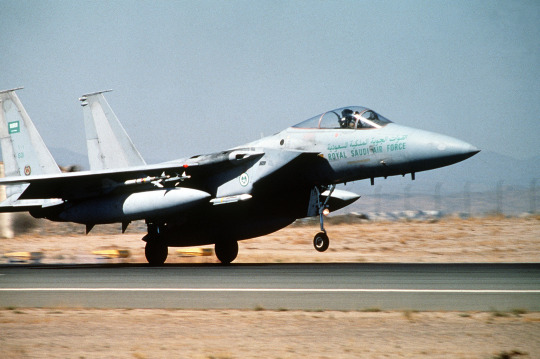
Without a doubt the most successful fighter of the Gulf War was the F-15C. Flying with both the USAF and RSAF, the F-15 was the very first aircraft deployed to Saudi Arabia after the invasion of Kuwait. With a standard armament of four radar-guided AIM-7s and four IR AIM-9s, the F-15 far outpaced anything the Iraqis could field. Supported by the constant presence of AWACS, F-15s of the USAF and RSAF would keep an almost unending patrol over the border region during the war. Unsurprisingly, F-15s would account for the vast majority of Coalition air-to-air victories during the war without suffering a single loss to enemy fighters.
The Aircraft: McDonnell Douglas F-15E Strike Eagle
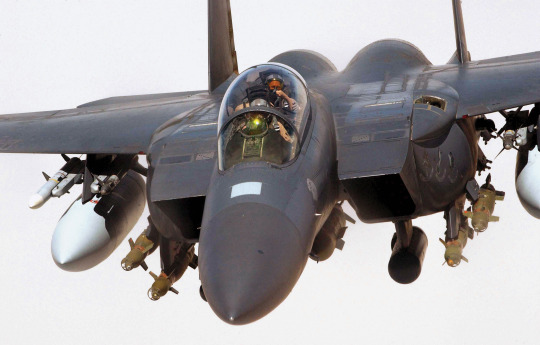
The far less glorious counterpart to the F-15C was the F-15E interdictor. Fitted with conformal fuel tanks, a second crewman, and various systems for ground attack, the F-15E was an invaluable component to the strategic air campaign. They would be among the first aircraft across the border on the opening night of the air campaign, and over the course of the war they would fly everything from strategic strikes to Scud hunting and tank-plinking. Unlike their fighter counterpart, they would suffer losses to enemy fire owing to the heavy defenses around many of their targets, but nevertheless they were successful. Strike Eagles managed to get into several engagements with IQAF fighters without being credited with kills, and ultimately their only aerial victory of the war would be an unfortunate Mi-4 hit with a GBU-10.
The Aircraft: General Dynamics F-111F
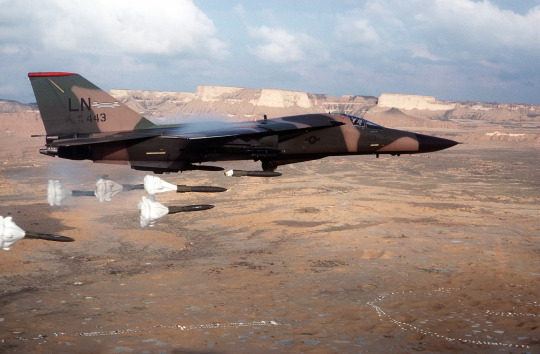
The swing-wing F-111 strike aircraft would be yet another integral component to the air war. 66 F-111Fs and 18 F-111Es deployed took on similar interdiction roles as the F-15E, although the most dangerous targets (and Scud hunting) were generally left to the Strike Eagle. Though the F-111 was kept out of the more dangerous missions, it went far to distinguish itself. They would go on to demonstrate the highest success rate of any USAF strike aircraft in the war, and the bombers would drop some 80% of the laser-guided bombs deployed in the war. With the ability to carry eight bombs and designate their own targets, they were spectacularly well suited to tank-plinking missions, and by the end of the war F-111s would be credited with the destruction of over 1,500 AFVs.
The Aircraft: General Dynamics/Grumman EF-111 Raven

The jammer variant of the F-111 would be a constant presence in the skies over Iraq. Though completely unarmed, the EF-111 was often used for supporting strike packages flying deep into Iraq. Along with the F-117, the EF-111 was the only aircraft capable of flying over downtown Baghdad at the height of the war, and, though it was often a target for IQAF fighters, the EF-111 would survive the war without a single loss to enemy action. In fact, the unarmed EF-111 is even credited with a single kill during the war after one crew maneuvered a pursuing fighter into the ground on the opening night of the war. Regular EF-111 flights continued to the end of the war, with only a single EF-111 lost when the crew crashed while evading a perceived enemy.
The Aircraft: General Dynamics F-16
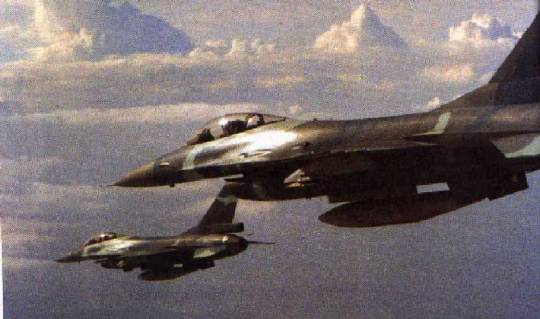
The F-16 would be one of the most numerous aircraft deployed as part of Desert Storm, with 249 aircraft operating in the theater. The versatile multirole would be invaluable for the war effort, with the aircraft flying everything from close air support to strategic strikes. While the F-16 lacked the endurance and payload to participate in the Scud hunting missions (standard loadout was just two 2,000lb bombs, two AIM-9s, and two drop tanks) they would see heavy use in several long-range strikes, particularly on targets near Baghdad. F-16s would also fly Wild Weasel missions alongside older F-4Gs. Only 13 F-16s were configured to deploy the AGM-88 HARM, however, and they lacked the more advanced systems mounted on the F-4G, so the bulk of Wild Weasel duties were generally handled by the Phantoms.
The Aircraft: McDonnell Douglas F-4G Phantom II

The venerable F-4 Phantom would make its last major appearance in the Gulf War. In August 1990, 24 F-4Gs and six RF-4Cs were deployed to Bahrain to support the coming air campaign. Despite their age, the F-4Gs were the only aircraft in the inventory configured as Wild Weasels, complete with an extensive ECM suite. They would perform admirably, flying the same tactically-oriented SEAD mission developed in Vietnam while other strike aircraft worked to hit command centers further from the front. Despite flying some of the most dangerous missions of the war, the F-4G would perform admirably, losing just a single aircraft to enemy fire. The six RF-4Cs also proved invaluable, as they were the only aircraft deployed as part of the campaign equipped with long-range oblique photography equipment.
The Aircraft: Fairchild Republic A-10 Thunderbolt II
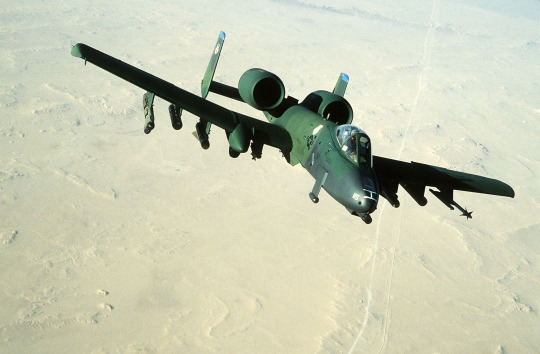
Though the Air Force had long been trying to retire the A-10 in the years leading up to the Gulf War, the twin-engined attacker would make a reasonably good showing in the war. Flying 8,755 sorties and firing over 5,000 AGM-65 Mavericks, the A-10s deployed for Desert Storm would be credited with 900 tanks, 2,000 vehicles, and 1,200 artillery pieces. After the Iraqi IADS was disabled, they were a near constant presence over the frontlines, flying both in direct air support missions and as forward air controllers to direct other aircraft. Despite impressive numbers of destroyed equipment and a generally excellent mission-capable rate, the A-10 still did reveal numerous failings. The rudimentary avionics suite of the aircraft meant that operations were generally limited to clear skies (though several A-10s did use their Maverick seekers to fly at night), and, despite a reputation for durability, the A-10 proved surprisingly vulnerable. Even after the destruction of the Iraqi air defense network, the A-10 still proved vulnerable to smaller distributed systems like MANPADS and AAA. In effect, A-10 pilots learned the hard way the same thing Tornado crews discovered at the start of the war - low-level operations were not viable.
The Aircraft: McDonnell Douglas AV-8B Harrier II

The Harrier jump-jet would be the primary combat aircraft deployed by the USMC during Desert Storm, with 86 deployed. Harriers were kept close to the front for direct close air support, often flying in concert with OV-10s or F/A-18s that would designate targets for the aircraft. The Harrier offered a unique capability to the Marines, with its ability to operate from short forward airfields giving the USCM a very quick reaction time to changing situations on the front. 3,380 sorties would be flown with an availability rate of 90%, and at the end of the war, the Harrier was cited by General Schwarzkopf as being one of the most critical weapons of the war. However, the Harrier did suffer some losses, in particular demonstrating great vulnerability to IR SAMs.
The Aircraft: McDonnell Douglas F/A-18 Hornet
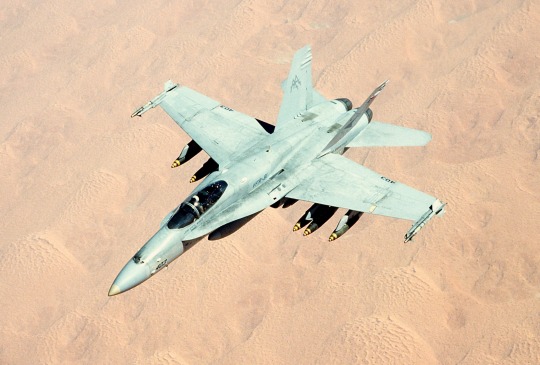
Though the USN would deploy a large air contingent to the Gulf for Desert Storm, the only aircraft to really see significant action was the F/A-18. The Navy would deploy 106 Hornets, while the USMC deployed a further 84. Flying with both USN and USMC squadrons, the F/A-18 would form the backbone of the USN’s strike packages during the war. Though similar in performance to the USAF’s F-16s, F/A-18s generally carried larger payloads (four 2,000lb bombs with no drop tanks), allowing them to hit targets harder. USMC F/A-18s would fly both regular strike missions as well as forward air controller sorties, where two-seater models would use a laser designator to light up targets for other aircraft carrying guided munitions. By the end of the war, the Hornet had racked up an impressive record. 4,551 sorties were flown, with two enemy aircraft claimed (MiG-21s), and two lost to enemy fire.
The Aircraft: Lockheed F-117A Nighthawk
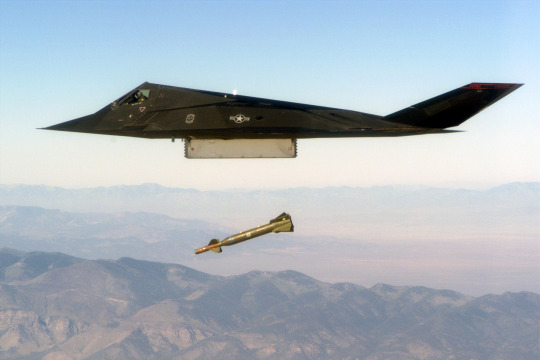
The 36 F-117A stealth fighters would be the most advanced aircraft deployed during the war. Designed with state-of-the-art stealth as an integral part of their design, the F-117 was one of two aircraft (the other being the EF-111) capable of flying though even the most heavily defended pieces of Iraqi airspace. With a modest payload of two guided bombs, the F-117 was tasked with hitting strategic targets in downtown Baghdad, where no other strike aircraft could venture. Limited to flying at night to make the most of their stealth, the strike aircraft would fly 1,300 sorties over the course of the war, hitting 1,600 high-value targets. Though reports of their success were initially overstated, they nevertheless were tremendously successful, accounting for more than 40% of strategic targets hit in the war.
The Aircraft: Boeing B-52G Stratofortress

The only strategic bomber to participate in the Gulf War was the B-52G. They would kick off the air war, flying from their base in Louisiana on a 14,000 mile trip to launch 35 cruise missiles at targets across Iraq before flying on to Diego Garcia. The bombers would operate out of Spain, Britain, Diego Garcia, and Saudi Arabia over the course of the war, generally flying high-altitude conventional bombing raids. Once the opening air strikes of the war had largely disabled the Iraqi IADS, the B-52 became an integral part of the psychological campaign against the Iraqis. Every other day, leaflets would be dropped on forces on the front, warning of a coming B-52 raid. The day after the leaflet drops, the B-52s fulfilled the promise, plastering enemy forces with 153 750-lb bombs. The demoralizing effect was tremendous, with many Iraqi soldiers citing the B-52 as their reason for surrendering. During the conflict, one B-52 was hit by a wayward HARM that locked onto the radar of a B-52’s tail gun. Though the bomber survived, this incident would lead to every B-52 having their tail guns removed.
Prologue
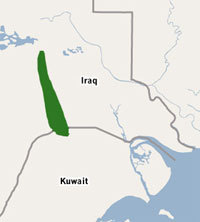
In the aftermath of Iraq’s eight-year war with Iran, the nation was left struggling from war-related debts, particularly to Saudi Arabia and Kuwait. As Iraq searched for a way to alleviate its situation, tensions with neighboring Kuwait gradually escalated. Iraq accused Kuwait of over-producing oil and undercutting prices, and, later in 1989, accusations that the Kuwaitis were slant-drilling across the border into Iraq were raised. As 1990 came, tensions only continued to rise. Iraq became openly hostile, deploying forces near Kuwait in late July 1990 and threatening military action unless Kuwait ceased their actions and met demands for lost revenue. Talks were raised at Jeddah to alleviate the tensions, with Kuwait and the UAE agreeing to Iraqi demands that oil production be limited. However, Iraq also demanded considerable reparations in the form of $10 billion from Kuwait. Kuwait attempted to negotiate this value down to $9 billion, but such efforts would prove disastrous.
Invasion of Kuwait
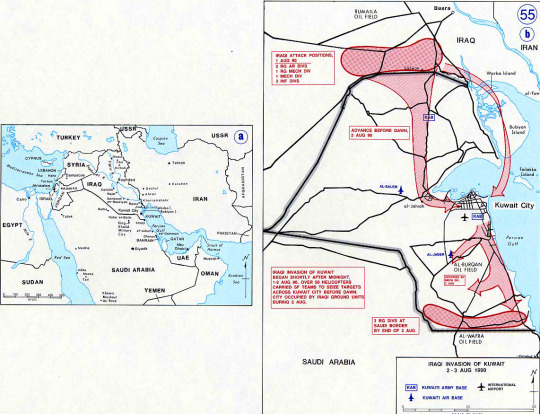
At 2:00 AM local time on August 2, 1990, four Iraqi Republican Guard divisions streamed across the border into Kuwait. The main thrust was aimed at the capital, while forces branched off to take the Kuwaiti Air Force’s airfields. A helicopter assault led the drive on Kuwait City with the intention of taking the capital by surprise and capturing the Emir. This was supported by five squadrons of the IQAF - two of Su-22s, one Mirage F1, one Su-25, and two MiG-23. IQAF efforts concentrated on the two main Kuwaiti air bases, aiming to suppress the Kuwaiti Air Force before it could sortie to resist the invasion. Small numbers of IQAF aircraft also attacked the capital directly.

Surprisingly, despite months of rising tensions, the Kuwaitis were caught off guard. The first sign of anything wrong came early that morning when an early-warning radar-equipped aerostat detected an armored column moving south. The Kuwaiti Air Force was scrambled, but it was unable to fend off the IQAF attacks. A desperate and disorganized defense was launched as the situation became clear. North of Kuwait City, the 35th Armored Brigade deployed to oppose the advancing Iraqis, and at the Royal Palace, the Emiri Guard worked to repel the Iraqi airborne assault. Unsurprisingly, the defense did not last long. The initial airborne assault on the capital was repelled, allowing the Emir to escape, but the fighting that lasted throughout the day had largely ended by nightfall.
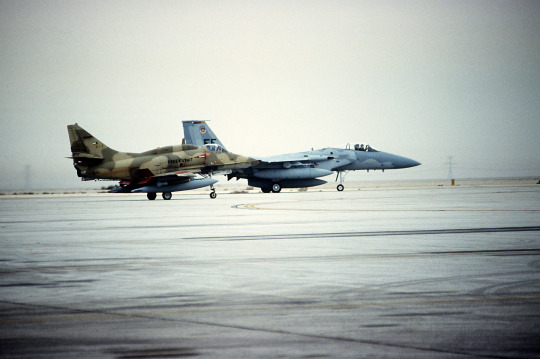
After just a day of fighting, the war was effectively lost. Some 20% of the Kuwaiti Air Force had been downed or captured, and on August 3 only a single air base remained out of Iraqi hands. Kuwait City had fallen, and remnants of the defeated Kuwaiti ground forces were reduced to fighting delaying actions at various choke points. Meanwhile, the Kuwaiti Air Force had fled altogether, with its remnants flying south to friendly bases in Saudi Arabia and Bahrain. By nightfall on August 3, the last major pockets of resistance had fallen. On August 4, the invasion of Kuwait had officially come to an end. Iraq suffered the loss of about 40 aircraft and about 600 casualties, while the Kuwaiti military was virtually annihilated, suffering 4,200 killed, 12,000 captured, and the loss of 57 aircraft and 23 ships.
International Response

To the surprise of literally nobody but the Iraqis, the invasion of Kuwait was met with almost instant condemnation from the international community. The reasons behind the outrage were twofold - not only was the invasion entirely unwarranted, but it put Iraq in control of a substantial portion of the world’s oil reserves and left their armed forces poised to march unopposed into Saudi Arabia. The very real fear that Saddam Hussein would seize the majority of the world’s oil supply spurred the US to act. Two days after the invasion of Kuwait concluded, Lt. Gen. Chuck Horner was sent along with various other USAF personnel to coordinate defenses, and on August 8, the first USAF fighters landed in Saudi Arabia (48 F-15s of the 36th TFW). Two carrier groups - Eisenhower and Independence - along with the battleships Missouri and Wisconsin were dispatched to the Persian Gulf.

Even as the international community flooded in objections, the Iraqis only continued to exacerbate the situation. On August 8, Saddam Hussein declared Kuwait to be Iraq’s 19th province, installing his cousin as the governor. As a result, the focus of the buildup in Saudi Arabia drastically changed. For the time being, forces continued to pour in with a purely defensive focus, as the Iraqis still had a straight shot to Riyadh. In fact, until more substantial reinforcements could be ferried in, the only thing standing between 27 Iraqi divisions in Kuwait and the Saudi capital was the lead elements of the XVIII Airborne Corps that had been hastily flown into the theater. However, once the Saudi side of the border was secured, the Iraqis would have to be removed from Kuwait.

The UN would get involved in the crisis as well, passing a series of resolutions condemning the invasion. One in particular - Resolution 678 - demanded the Iraqis withdraw by January 15, 1991. Meanwhile, the US had begun building a coalition in the likely event that Saddam refused the ultimatum. Great effort was put into securing support from Arab nations, including Syria, Egypt, Qatar, and Bahrain, and in all, 34 countries would commit soldiers in support of the Coalition. At home, a great deal of effort was also put forward to garnering support from the US population for going to war. The human rights abuses of the Iraqi government were widely publicized, and Iraq’s possession of chemical and biological weapons was also presented as a casus belli.
Operation Desert Shield

As the Coalition formed, the US kicked off Operation Desert Shield, aimed at securing the Saudi Border. Within a week of the invasion of Kuwait, F-16s of the 363rd TFW arrived to provide support to ground forces. Fortunately, E-3 AWACS aircraft had already been operating in the country, allowing for defensive patrols to begin immediately. However, the sheer scale of the forces flooding in would briefly overwhelm the Saudis. Strategic airlifters were flying around the clock, ferrying men and materiel into the region as fast as physically possible, leading to a chaotic mess. In the confusion, supplies and men were often unloaded at bases hundreds of miles from their intended destination, and the situation only worsened as more men and materiel poured in faster than the misplaced cargo could be sent to their correct destination. Worse, the number of men coming in was rapidly outpacing the capacity of Saudi bases. Tent cities popped up across the country, and even then men were forced to sleep in shifts to have enough bunks until the airlift stabilized.
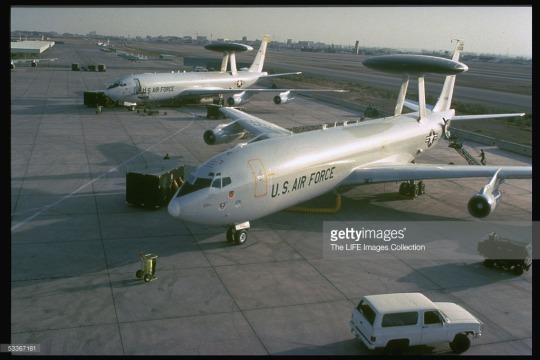
Despite the chaos, the situation in Saudi Arabia was improving with every day. The arrival of two carrier groups bolstered the defenses near the coast, and soon after F-16s and A-10s were flown in to blunt any Iraqi thrust. The situation on the land improved as well, with first a Marine Amphibious Ready Group and then the 7th Marine Expeditionary Battalion arriving in Dhahran, complete with a wing of fighters. The Army also deployed its rapid-reaction forces, with the 82nd Airborne Division coming in just after the Marines. A-10s and F-16s were kept stationed close to Dhahran to provide a rapid response to any coming attack from the Iraqis, but as more aircraft poured in, many were moved further from the front. F-111s and F-117s - not originally part of the battle plan, but supplied at the request of Horner - were deployed much further south near Mecca.
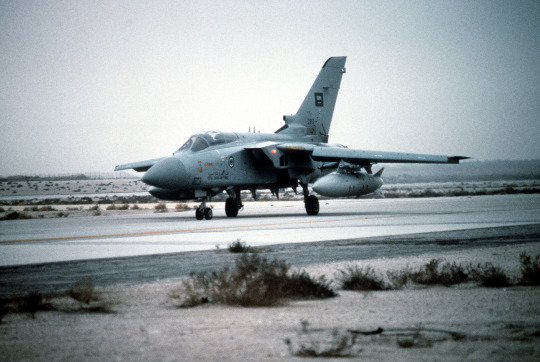
As August turned to September, the chaos began to die down a bit. More substantial ground forces had now arrived, finally giving the Coalition forces something that could reasonably hold of an Iraqi offensive, and ground forces from other nations - particularly France and Britain - were coming into place. The buildup continued, but by now it appeared that Saddam had little intention of pushing south. That’s not to say the Iraqis had any intentions of de-escalating the situation, however. Iraqi forces entered the residence of France’s ambassador to Kuwait, spurring further French involvement in the war, and, although the UN passed an ultimatum for withdrawal in late November, it was clear that Saddam had no intentions of heeding the declaration.
Planning
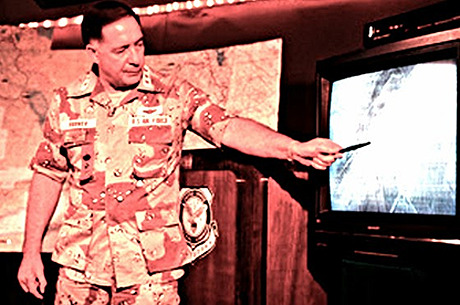
Long before the UN ultimatum was issued, the US had begun planning to forcibly remove the Iraqis from Kuwait. From the start, air operations had been tasked with Lt. Gen. Horner, who would go to centralize command of all air operations for the war. Such efforts were not without their opponents, particularly from the USMC and USN. USMC commanders feared that relinquishing control of their aircraft left ground forces vulnerable, though these fears proved unfounded. USN commanders preferred strict delineation of zones of control for respective air forces, much like the “Route Package” practice seen in Vietnam. There, the Navy got a firm “no” - Horner would not allow this to be another disjointed air campaign like Rolling Thunder.

The strategic air campaign that took shape drew heavily on the Internal Look exercise, conducted just a month before the invasion of Kuwait. Involving the defense of Kuwait and Saudi Arabia from an Iraqi attack, Internal Look would heavily shape the planning of the air campaign. This in turn morphed into the Instant Thunder plan, which gradually grew to incorporate the other Coalition members into the campaign. The general idea of the campaign remained the same from the pre-war plan. Initial efforts would be focused on halting any Iraqi offensive, after which attacks would be conducted deep into Iraq to destroy the country’s warfighting capability. Such strategic strikes would hit command and control networks, production and storage facilities (particularly those responsible for biological and chemical weapons), and infrastructure, with the idea of isolating the Iraqi forces near the front for a coming land campaign. Overall, the plan was broken into four phases. Phase I entailed the strategic campaign to isolate the battlefield, with Phase II focusing on eliminating defenses near the battlefield itself and Phase III attacking enemy ground forces directly. Only the final phase would see any ground action, with air forces supporting ground forces as they moved against a severely battered enemy.

The biggest change in the final product was the scope. From the time Instant Thunder was first tendered to the launching of the first strikes on January 17, the number and scope of targets grew massively. Instant Thunder had identified only 84 targets, but this would grow to nearly 500 by the eve of the campaign. Similarly, the numbers of aircraft involved grew, with the originally planned 75 long-range strike aircraft growing to over 200. In all, the number of aircraft necessary for the campaign grew some 40%. In the meantime, air forces began extensively training for the coming campaign. CAP, directed by AWACS, was kept aloft all day every day, and was to remain so until the end of the war. A quick-turnaround base was also established at King Khalid Military City, just 50 miles from the Iraqi border, to allow aircraft to fly multiple sorties per day. As the date set by the UN ultimatum neared, the plan solidified. Now known as Desert Storm, the coming campaign would be one of the most devastatingly successful campaigns in history.
January 17, 1991

Shortly after the UN deadline passed, Desert Storm was set into motion. On January 16, seven B-52s took off from their base in Louisiana on a 14,000 mile trip to deliver 35 cruise missiles to targets across Iraq. That evening, over 160 tankers took to the skies, loitering just outside the view of Iraqi early warning radars to support the coming assault. Countless AWACS and EW aircraft sat in their standard orbits, waiting for H-hour to approach. Finally, at H-90 minutes, the first shots that could not be recalled were fired when USN warships launched TLAM cruise missiles to targets in Baghdad. At H-22 minutes, the first shots of the war were fired, with Army AH-64s being led at extremely low levels in sheer darkness by Pave Lows destroying early warning installations along the Iraqi border. The opening in the radar network signaled the start of the greater air campaign, with strike packages rushing into the gaps to go hit targets across Iraq. As the strike aircraft streamed forwards, the AWACS aircraft moved forwards as well into the orbits they would hold for the coming campaign.

At H-Hour - 0300 - ten F-117As dropped the first bombs on Baghdad with the support of three EF-111s. The 3,000 antiaircraft guns protecting the city opened up, but the strike package evaded detection in the moonless night and made it home safely. Minutes after the first bombs fell on Baghdad, the cruise missiles launched from warships in the Gulf and the B-52s began falling around the city. The aim of these initial strikes on Baghdad was to take out critical command and control elements of the highly centralized Iraqi integrated air defense network. A total of 30 F-117s and 54 TLAMS would strike Baghdad as part of the first wave of attacks, hitting 20 strategic targets in the first five minutes of the campaign. In all, almost 50 targets in or near Baghdad had been struck by the end of the day, practically beheading Iraq’s air defense network.
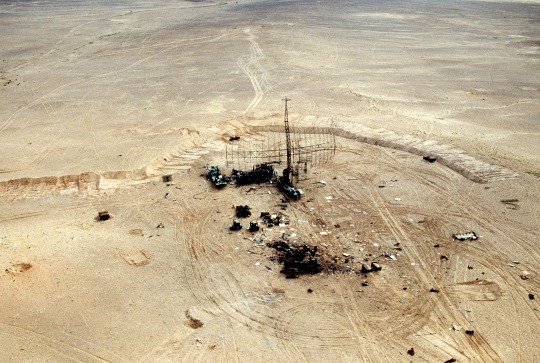
Closer to the border, Wild Weasels were working hard, firing over 200 HARMs against Iraqi radars. The leading F-4G flight would hit some 15 sites just on its own, while the USMC’s F/A-18s played just as active a role in the SEAD effort as the USAF. The Navy employed TALD decoy drones to bait out enemy radars, while heavy support from EF-111s, EA-6Bs, and EC-130s provided jamming support. Just across the border in Kuwait, a strike package of 16 LANTIRN-equipped F-16s supported by four F-4Gs, and EA-6B, and four F/A-18 hit the main airbase in the south of the country, taking full advantage of the rapidly deteriorating capabilities of the Iraqi IADS.
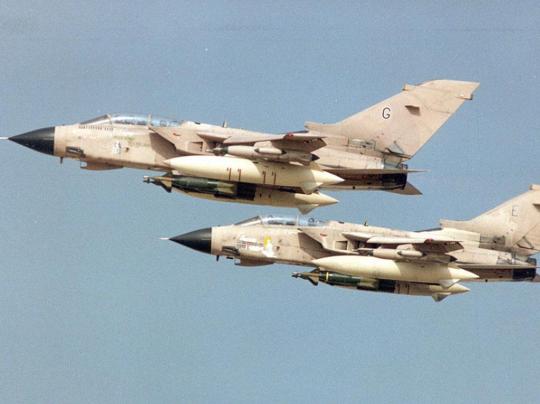
Further west, nineteen Strike Eagles crossed the border, reaching deep into Iraq to strike Scud missile sites. Accompanying them as they exploited the holes recently punched into the Iraqi radar picket were EF-111s, F-111Fs, and Tornados, all aimed at hitting strategic targets. The American strike aircraft proceeded at medium level, while the Tornadoes followed their standard doctrine of low-level strikes. Unfortunately, these low-level strikes went poorly - the RAF lost two Tornadoes that night. Though the Iraqi IADS had been practically beheaded in the opening strikes, their Air Force was not completely inactive. The odd aircraft did sortie to oppose the intruders in the predawn darkness, with one Mirage F1 in particular chasing down an EF-111, crashing into the ground as its pilot lost focus while trying to get into a position to fire on the wildly evading EW aircraft.

As dawn broke, the second wave of aircraft took to the skies. A-10s opened up with 1450 sorties against Iraqi ground forces and radars in Kuwait, while F-16s hit a bit deeper, mainly aiming at airfields and SAM sites. Strategic targets in Kuwait were hit hard, with Tallil Airfield receiving 31 sorties from the second wave, 12 striking Shaybah, and 36 aircraft hitting Al-Hasrah. Railways and bridges were also hit, and the USMC even made direct attacks on frontline forces with their AV-8Bs. This second wave of strikes continued through the day, further wearing down the Iraqis.
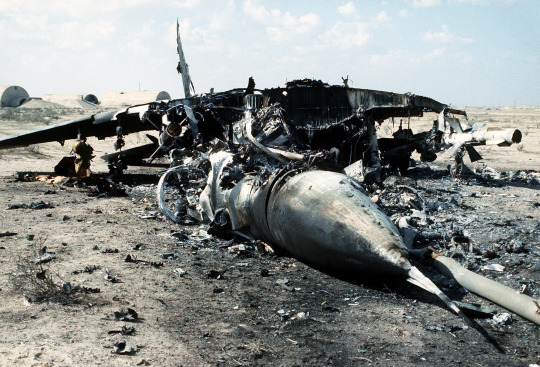
The third and final wave of the first day of operations came at nightfall. More long-range strike aircraft took to the skies, this time emphasizing air defenses deep in enemy territory. B-52s also made their second appearance, now hitting Republican Guard forces with conventional bombing runs. In the north of the country, KC-135s, EC-130s, and EF-111s established orbits operating out of Turkey, heavily supported by F-15 fighter CAP. Supported by these elements, strike aircraft turned south to hit strategic targets by the next morning. Overall, the impact of the first day of operations was incredible. Over the first 24 hours, 2,775 sorties had been flown, hitting 37 targets in Baghdad, as well as directing 200 sorties against airfields, 175 against Scuds, 750 interdicting Iraqi supplies, 436 for CAP, 432 tanker sorties, and 652 offensive counter-air (Wild Weasel and airfield attacks). The Iraqi Air Force had mustered just 50 sorties, losing eight aircraft to Coalition fighters and claiming just a single F/A-18 in return, despite repeated attempts to intercept strike aircraft and even several successful missile hits on strike aircraft. The Iraqi IADS was already rapidly losing effectiveness, and the situation for the Iraqis on the ground and in the skies would only continue to rapidly deteriorate as the days went on.
Phase I and II Operations: Rolling Back the Iraqi IADS

The second day of operations would see no drop in intensity. NBC weapons facilities lucky enough to survive the first night of the war were first on the list, followed by more electrical, communications, and logistical targets. More than 80 Coalition aircraft again streamed deep into Iraq in the predawn hours to hit their targets while F-16s and F/A-18s took an active role in Kuwait against helpless ground forces. Daybreak again saw A-10s and AV-8Bs springing into action to whittle down frontline troops, and strikes against the airfields in Kuwait continued. With Turkey finally approving of strikes being flown from their country, F-111s began hitting Iraq from the north as well, striking oil facilities that had thus far avoided the brunt of the air campaign. B-52s and F-1117s returned that night, hitting ground forces in Kuwait and strategic targets in downtown Baghdad, respectively.

The first week of operations showed a similar trend as the first night. Nearly every major strategic target had been hit, and the highly centralized Iraqi IADs had been beheaded. However, fully disabling the network took more work, with local command centers receiving attention after contact with Baghdad was sufficiently cut. Though this took some time, generally things were going well. Highly effective Wild Weasel and EW support for strike packages did a fairly good job at keeping Iraqi air defenses from fending off attacks, and, with almost everything but the Tornadoes flying at medium altitudes beyond the reach of AAA and MANPADs (which were more difficult to render ineffective than SAMs were), losses remained low. Tornado crews were still suffering however, and only after heavy losses (eight RAF, one Italian, and two Saudi) did they finally abandon their costly and ineffective low-level approaches.

Unfortunately, despite all the damage being done, things weren’t going perfectly. A weather front stalled over the battlefield for three days, forcing many sorties to be cancelled or diverted to other targets. Perhaps more glaringly, the feared mobile Scud launchers were proving far more resilient than expected. Scuds were being thrown not just south at Coalition forces, but westward to Israel in hopes of provoking Israeli involvement that could cost the Coalition its Arab support. Fortunately, the Patriot SAMs installed in both locations were doing a reasonably good job to stave off the missiles, and even when they did make it through, the damage was fairly minimal. Still, their persistence forced the Coalition to devote much more effort to hunting down the Scuds.
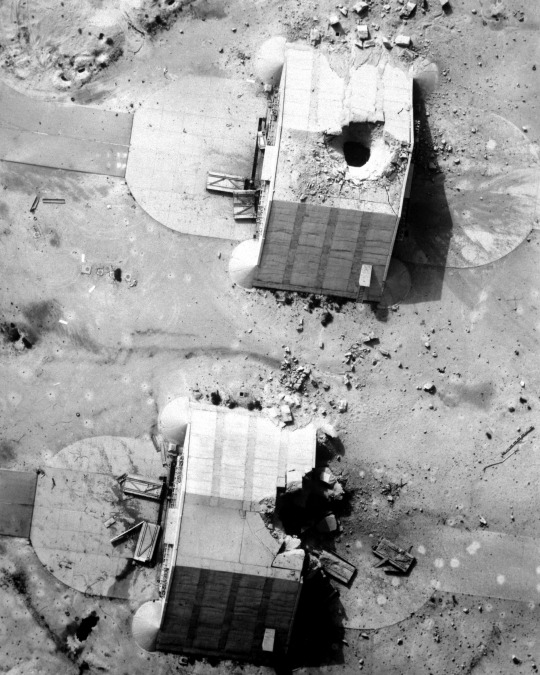
Ultimately, Phases I and II of the original plan - destroying Iraq’s strategic warfighting capabilities and attaining air superiority - were over incredibly fast. By the third day of operations, Phase I targets were mostly destroyed, although Scud hunting and sporadic strikes on strategic targets would persist. Phase II - attaining air superiority over Kuwait - was over just as soon as it started, with the IQAF not even making any effort to contest the skies. By January 17 - day 10 of operations - air supremacy was declared. To this point, the IQAF had rarely mustered more than 30 sorties a day, and it was becoming clear that Saddam was hiding his fighters rather than risk them in the air. Wary of these aircraft being used at a later date for surprise attacks, the Coalition thus begun a concerted effort against the bunkers in which these aircraft were stored. Though the nearly 600 shelters in which the remnants of the IQAF were distributed were heavily hardened against airstrikes, they would prove no match for bunker-busting bombs.
Clear Skies

With the Iraqi IADS disabled and Coalition aircraft now flying relatively freely over the country at medium altitudes, the campaign took a new turn. Over Western Iraq, Scud hunting continued, with F-16s, Strike Eagles, A-10s, and AC-130s scouring the desert for mobile launchers. Despite the destruction of storage facilities and fuel supplies, launches of the elusive missiles continued for some time. On January 25, ten Scuds would be launched from Western Iraq, marking the high-water point of the Scud operations. Tactics soon caught up with the Iraqis, fortunately. Coalition aircraft hunting for the Scuds began working with SAS crews scouting from the ground, and as the days went on, launches subsided (but never fully stopped). Meanwhile, shorter-ranged aircraft like the A-10 would manage to locate and destroy hidden depots, further hurting Iraq’s ability to launch Scuds at its neighbors.

As the poor weather from the first week of operations gave way to clearer skies, the Coalition intensified its air campaign, now concentrating on isolating the battlefield in Kuwait. With only three of the 16 operations centers that controlled the Iraqi IADS still operational, most long-range strike aircraft were now shifted to battlefield interdiction. Even in those sectors where the operations centers remained intact, radar operators were often too afraid to turn on their radars lest they fall victim to the Wild Weasels. In Kuwait, the Marines continued their intensive effort against frontline forces as well. Overall, the campaign was going even better than in the first week - the only Coalition losses from the first week were an F-16, an AV-8B, and an RAF Tornado, while the IQAF still managed to get 11 of their fighters shot down.

The increasingly poor outlook of the war would cause the Iraqis to make some rash decisions. On January 25, the Iraqis opened up Kuwait’s oil wells, spilling millions of barrels of crude oil into the Gulf. While motives were unclear, it forced immediate Coalition action - two F-111Fs were sortied to destroy pumps and manifolds, stopping the spillage for the time being. Around the same time, the devastating impact of the bunker-busting bombs was showing the Iraqi Air Force that their shelters could not save their aircraft. On January 26, a sudden mass exodus of IQAF aircraft across the border to Iran began. Over the next three days, IQAF aircraft took advantage of holes in the coalition air cover, with some 80 aircraft escaping. A barrier air patrol was established to halt the exodus, and for some time it seemed to be successful. However, whenever patrols relaxed, more IQAF aircraft would flee the country.
Battle of Al-Khafji
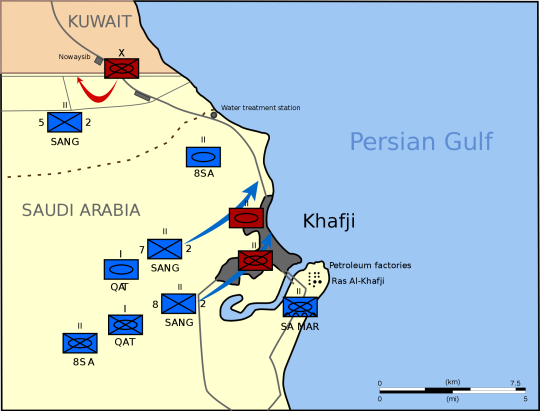
As the third week of the war began, the Iraqis launched their first and only offensive of the campaign. On the night of January 29, Iraqi forces attacked the abandoned town of Al-Khafji just across the border, running into a mixed force of Saudi and USMC soldiers. Though they did not know if, the Iraqis threatened to seriously unhinge Coalition effort. Uncomfortably close to the Iraqi push, the USMC had several important supply depots open and exposed in the desert. Worse, taking Al-Khafji would put the Iraqis in a position to engage Syrian and Egyptian forces, which would make providing CAS nearly impossible owing to the fact that Syria and Egypt operated the same Soviet equipment as the Iraqis.
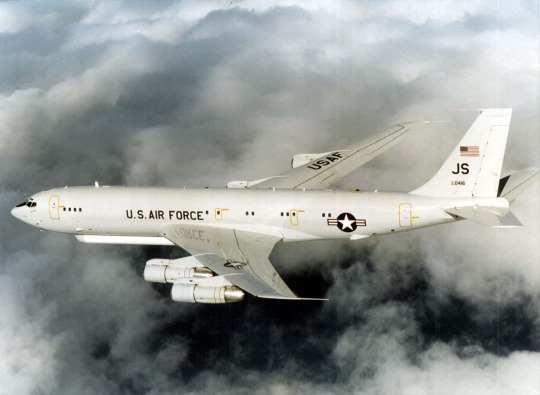
Late in the night of January 29, thousands of Iraqis emerged from defensive positions to make their attack. Unfortunately for them, darkness gave them no cover. An orbiting E-8 Joint STARS picked up the advancing column and called in all available aircraft to help. A-10s, AV-8Bs, F-16s, F/A-18s, AC-130s, and even B-52s would arrive to support ground forces. As lead elements hit USMC forces, AV-8Bs and F/A-18s were thrown at the assaulting enemy to blunt the attack. Iraqi forces that made it into Al-Khafji fared better, as the Saudis were further down the chain of command and unable to call upon air support so readily. Nevertheless, the Iraqis were hardly faring well. A USMC drone had located Iraqi forces massing just across the border in the Kuwaiti National Forest, so incoming B-52s were diverted to deal with it. After the B-52s made their run, A-10s swooped in to mop up, picking off fleeing vehicles with their Mavericks.
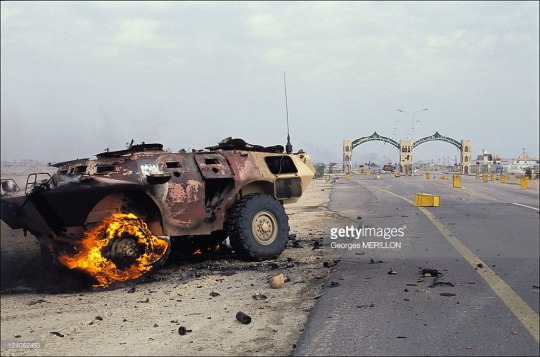
By daybreak, the battle had slowed down. Outside of Khafji, the Iraqi advance had been shattered, as A-10s had bottled up and annihilated advancing columns. However, those forces in Khafji had succeeded in taking much of the town. The Saudis withdrew, only to re-engage later in the day. They soon ran into a major issue as their commander requested air support - the Marine air controllers responsible for directing air support were trapped in the town, surrounded by hostile troops. Though hundreds of sorties were being directed at the battlefield, there was nobody to direct them at the Iraqis in Al-Khafji. Thus, efforts remained focused on hitting those engaging the Marines to the West or destroying artillery positions further back.
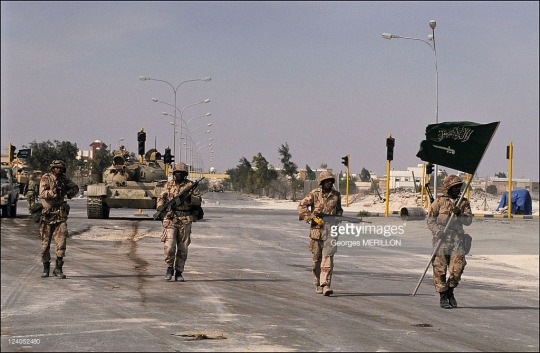
Fortunately, nightfall saw the situation improve. A ceaseless onslaught of airpower began hitting Iraqi positions, with three AC-130s returning to provide direct fire support under cover of darkness. Far behind the border, the Joint STARS spotted two Iraqi divisions preparing to rush south to take advantage of the destabilized front. Strike aircraft were vectored in, however, and by the end of the night, Iraqi forces involved in the battle were decimated. Unfortunately, the battle wouldn’t go without a loss. As day broke on January 31, an AC-130 lingering too long over the battlefield caught a MANPADS, leading to the loss of the aircraft and its entire crew. By midday, the Iraqis were retreating in disarray and the battle was over. Coalition casualties were light - fewer than 50 killed and about 50 wounded - while the Iraqis suffered several hundred dead and captured and countless vehicles destroyed.
Isolating the Iraqi Army

As January turned to February, the campaign against Iraqi forces in Kuwait ramped up. With numerous rivers crossing Iraq and Kuwait, the Iraqi logistics chain was constrained by vulnerable bridges. Original estimates estimated that only about 2-300 sorties would be necessary to destroy these vital crossings, and they proved fairly accurate. With the precision of laser-guided bombs,F-111s, Tornadoes, and Strike Eagles could down multiple bridges in a single sortie, and early on there remained few bridges standing. However, the Iraqis proved more resourceful than expected. Poor fuse design meant that bombs would often penetrate the bridge deck and detonate (relatively) harmlessly underneath, allowing the span to be quickly repaired and made serviceable again. Once spans did start dropping, the Iraqis seemed to have an inexhaustible supply of pontoon bridges. To account for this, the Coalition could do little more than devote extra sorties to bridge-busting. By the end of the war, it was found that the number of sorties required for the bridge-busting campaign was nearly five times the original projection, and constant patrols were required to ensure that destroyed crossings remained unusable.

While larger strike aircraft handled the bridge-busting, there was still the issue of the massive numbers of trucks and supply vehicles the Iraqis had. On active bridges, strikes against the bridge itself were usually followed up with attacks on the resulting traffic jam, but gradually the Iraqis moved to trying to sneak supplies in through the desert. Once again, the Joint STARS came in handy. During daylight, A-10s, F/A-18s, F-16s, AV-8Bs, and Jaguars roamed free, hunting down trucks moving across the desert. Though not configured for night operations, A-10s continued to hunt trucks at night, using the IR seekers of their Mavericks to guide them.
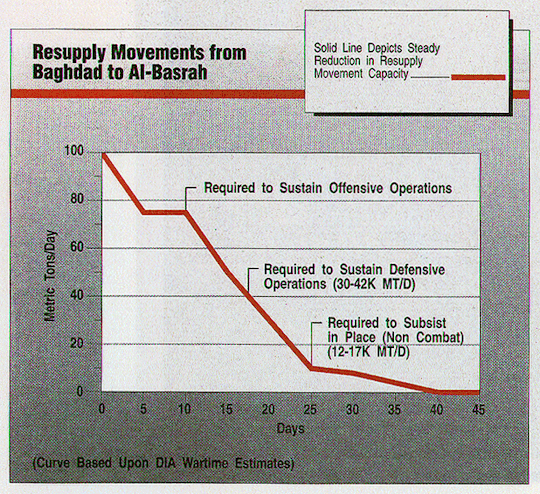
The effect of the interdiction campaign was palpable. Crews began to outright refuse supply missions owing to the roaming aircraft, and supplies had halved by the first week of February from a prewar total of 200,000 metric tons per day (for reference, a minimum of 50,000 tons per day were required for combat, and 20,000 tons for non-combat operations). Attacks against depots had caused the Iraqis to disperse and hide their supplies, meaning that even once supplies got to the theater, ground forces often had difficulties getting them. The elite Republican Guard units were given priority as supplies ran short, meaning regular units suffered. For lower priority units, resupply only came every two or three days, and for some, they stopped receiving supplies after the first week of the war.
Degrading the Iraqi Army
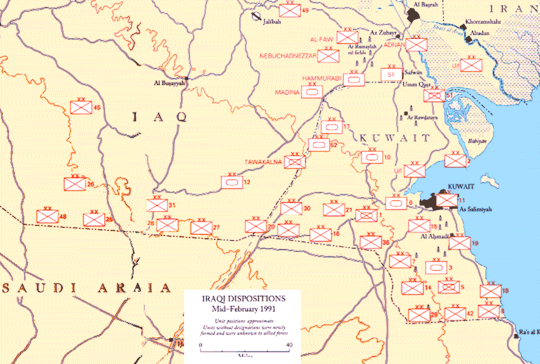
Closer to the front, the Coalition also aimed to degrade the Iraqi Army’s combat effectiveness more directly. Since the opening day of the air campaign, Coalition forces had been hitting frontline forces with everything from rockets and bombs to artillery. However, until February, the Iraqi Army remained a reasonably effective fighting force. Heavy defensive positions had been created along the Saudi-Kuwaiti border, complete with oil-filled trenches to be set alight in the event of a battle. As the attacks on ground forces intensified, the situation rapidly deteriorated on the ground.
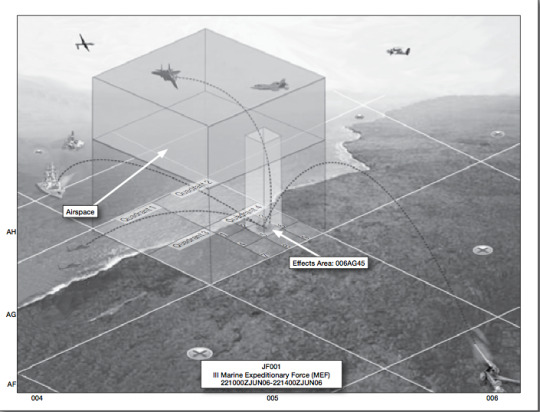
To ease the complex task of directing hundreds of aircraft over a relatively small front, a system of Kill Boxes was established. Each box consisted of a 30 by 30 mile square broken into three quadrants and controlled by forward air controllers. Each quadrant was assigned to a single flight for a specified time, allowing commanders to avoid airspace conflicts. Along with a more concrete plan to destroy Iraqi forces, a unique psychological warfare campaign had also begun. Over 21 million leaflets would be delivered over Iraqi forces, urging surrender and warning of the coming bombing. In one unusual case, some leaflets warned of coming B-52 raids, with B-52s following through with the threat. Alternating days of leaflets and bombings greatly demoralized ground forces already hit hard by the devastating campaign.

At night, F-111s roamed the skies on missions that became known as “tank-plinking.” Loaded up with smart bombs, the bombers orbited around until they found tanks sitting in the desert on their Pave Tack pod. Loaded with up to eight bombs, the F-111s were regularly scoring roughly one tank kill per bomb, and at their peak, tank plinkers were killing some 150 tanks per night. For crews of these unfortunate vehicles, the psychological impact was devastating. Crews had gotten used to sleeping in their vehicles for safety during the Iran-Iraq war, but now they were forced to spend their nights a safe distance away in uncomfortable and exposed trenches.
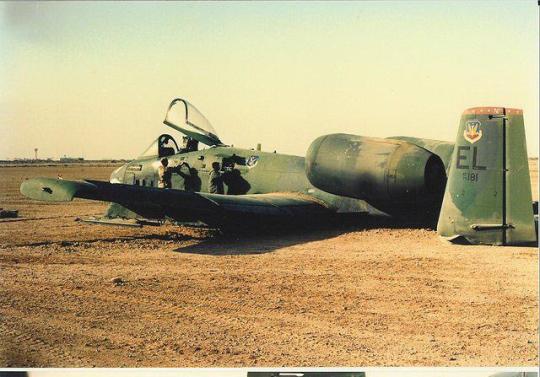
Though the Iraqi Army was rapidly deteriorating, they still retained the ability to threaten Coalition aircraft in the right circumstances. Approval to fly A-10s low enough for gun-runs had been given at the end of January, and A-10 operations slowly creeped further away from the safety of the border. Finally, A-10 crews began to learn the same hard lesson the Tornado pilots had. An A-10 was downed by an SA-16 on February 2, and another lost to AAA fire on the 5th. The A-10 had been pitted against Republican Guard units well north of the border, and crews were suffering. The aircraft was undoubtedly durable, and the countless damaged aircraft limping home showed, but that in itself was the issue - the A-10s were getting hit, while the faster, higher-flying jets were not. Thus, Lt. Gen. Horner recalled the A-10s and resumed the restrictions on low-altitude flying.
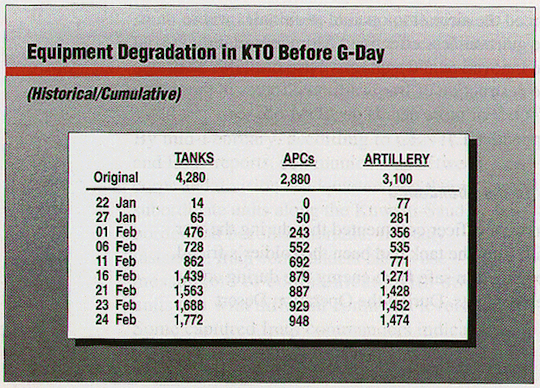
As the ground offensive neared, sorties increasingly worked to prepare the battlefield. F-117s hit the pumping stations that kept the oil trenches filled, while other aircraft bombed the trenches directly to burn off the oil. Estimates of percentage of vehicles destroyed varied from nearly 50% to less than 10% depending on the agency, but it was clear that Iraqi combat effectiveness was plummeting. Though the hope was that the air campaign would definitively reduce the Iraqi army to combat ineffectiveness by the time the ground offensive started, commanders were now under pressure to bring the war to an end. From January 17 to February 23, nearly 100,000 sorties had been flown against Iraq. The sustained air offensive had almost completely isolated forces in Kuwait, with the minimum non-combat supply threshold passed around February 23, and the forces along the front had been seriously disrupted.
The 100-Hour War
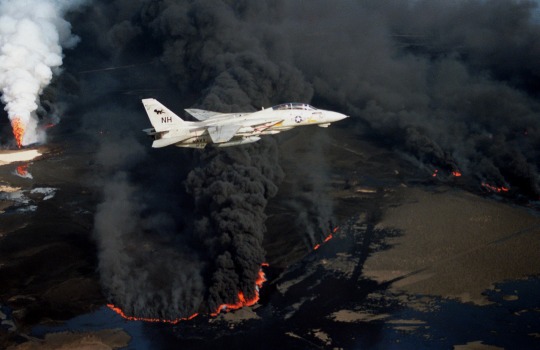
By late February, the decision was finally made to launch the ground campaign. For all the effort made at softening up Iraqi forces in Kuwait, the actual push into Kuwait was intended more as a feint. While USMC forces made a frontal assault on Iraqi forces, a large armored thrust would swing across the desert west of Kuwait with the intention of swinging around the Iraqi flank. From there, the Coalition would be able to trap the Iraqi Army in Kuwait to decisively defeat them. The exact date of the start of the ground campaign was selected to be early in the morning of February 24. As the date approached, weather projections called for terrible visibility. Worse, the Iraqis set alight over 700 oil wells on the eve of the invasion, blackening the skies over Kuwait.

Despite the less than favorable conditions, the offensive proceeded on schedule. At 0400 hours on February 24, the ground war began. The Marines led the push into the teeth of Iraqi defenses, while at the western edges of the front the XVIIIth Airborne Corps and French forces sped across the desert. Much to everyone’s surprise, however, the Marines ran into little opposition. After picking their way through largely abandoned trenches and minefields, Marine forces encountered Iraqi troops surrendering en masse. With nothing really standing in their way, the Marines were speeding well ahead of schedule, advancing five to ten times faster than expected.

Despite the favorable situation on the ground, commanders were taking no chances. Strike aircraft braved the poor weather, concentrating their efforts on the fairly intact Republican Guard units. Though commanders feared they would be thrown at the advancing troops, no such counterattack came - the Iraqi Army was frozen in place. On the front, the Iraqis were already routing by midday. What little opposition they faced was quickly silenced by tanks and airstrikes, and the Marines were in fact advancing so quickly that they were threatening to unhinge the plan. To their right, along the coast, a Republican Guard division sat paralyzed, failing to engage the Marines as expected. As such, the Coalition forces holding the front on the Marines’ right flank were ordered to advance ahead of schedule so as to hold the Republican Guard in place while the Marines continued their push.
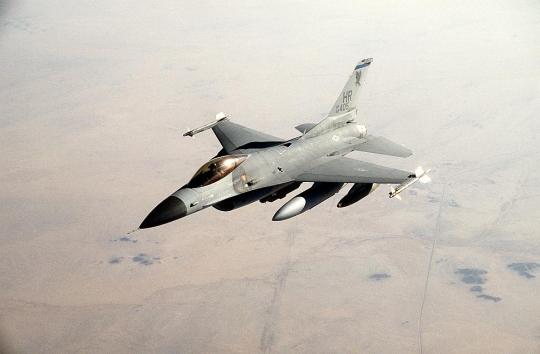
The rapid advance of forces soon led to issues with providing CAS. The primary lines for guiding air support - the Forward Line of Own Troops and Fire Support Coordination Line - were determined at a corps level, meaning the lines often jumped several miles at junctions between corps. Nevertheless, CAS sorties jumped to surge levels. Forward Air Controllers were present across the front, directing aircraft as they cycled through holding points. Aircraft would sortie, fly to the first holding point - usually a certain point along the front, where they would orbit for some time until directed to a target by FACs. If they were not required over the front, they then flew deeper to one of several Kill Boxes, where they were again directed by a local FAC.

By February 25, the Iraqi Army had collapsed into a rout. A massive, disorganized withdrawal from Kuwait began, with Iraqi forces fleeing in not only their own vehicles, but many vehicles seized from Kuwait as well. On the two major highways leading north out of the country - Highways 8 and 80 - long columns of vehicles jammed the roads. To prevent the retreat, aircraft were directed against the column. A-6s hit the front of the column with Rockeye cluster bombs to block up the road. Over the next ten hours, Highway 80 became the “Highway of Death” as Coalition aircraft swooped in to pick off the unfortunate vehicles trapped in the traffic jam. To the east on Highway 8, a smaller retreating column of Republican Guard forces was targeted by Army artillery and AH-64s, suffering similarly devastating losses.

By February 27, the war was effectively over. The Iraqis were in a complete rout, and Saddam had belatedly issued an order to withdraw from Kuwait. Coalition forces were running down the Euphrates to encircle what was left of the Iraqi Army, and, apart from a small contingent of Iraqi forces at Kuwait International Airport that had not received the retreat order, resistance had completely collapsed. Men were surrendering in the tens of thousands, and the Iraqi Army was disintegrating. By the end of February 27, President Bush declared Kuwait to be liberated. Peace talks began in southern Iraq, with Iraqi delages receiving permission to take helicopters to the meetings due to the extensive damage to road infrastructure. One hundred hours after the ground campaign started, on February 28, 1991, President Bush declared a ceasefire. The war was over.
Epilogue

Though the war was officially over, things would not return to normal. Kuwait was liberated, but the country had suffered serious damage from the war, and was faced with the immediate threat of the burning oil wells and massive oil spills. The oil deliberately dumped into the Gulf marked the largest such spill in history, and the burning wells had been heavily mined, making extinguishing the infernos difficult. Ultimately, it took until November 1991 for the fires to be extinguished even with heavy international support, all at the cost of $1.5 billion. Though Iraq had left Kuwait, many sanctions remained in place. Combined with the extensive damage to Iraqi infrastructure done by the war, the economic situation in the country was bleak. This may have been part of an effort to oust Saddam Hussein without being forced to go in and do so with Coalition troops. It was hoped that the disastrous defeat would combine with simmering discontent would cause an uprising that would oust the current government.

Almost immediately following the cessation of hostilities, uprisings began among the Shia population in the south of the country and Kurdish population in the north. Unfortunately, these uprisings failed to overthrow Saddam. Though the Iraqi Army had been shattered, they were still more than capable of suppressing the dissent. A brutal crackdown ensued, lasting into early April. Tens of thousands of civilians were killed and over a million were displaced, leading to further international condemnation. Thus, on April 5, 1991, the UN passed Resolution 688, demanding Iraq cooperate with humanitarian organizations to aid the devastated populations and halt its attacks on civilians. With this resolution as their basis, the US, France, and UK established Operations Northern and Southern Watch, creating two No-Fly Zones over the affected areas. These operations continued into the new millennium, ultimately coming to an end with the final invasion of Iraq in 2003.
Aftermath

The First Gulf War would last nearly seven months from the day Iraqi troops first set foot in Kuwait to the signing of the ceasefire on the last day of February 1991. The results of the campaign were incredibly one-sided. The Iraqi Army was shattered, suffering roughly 100,000 casualties, tens of thousands captured or deserted, and the loss of countless vehicles. The Coalition, on the other hand, suffered such light losses that accidents and friendly fire incidents rivaled the damage done by enemy fire. A total of 147 Coalition soldiers were killed in action, with a further 145 killed outside of combat and a total 776 wounded (both by enemy fire and accidents/friendly fire). Even Kuwait, who had suffered the overwhelming invasion, had suffered a mere 200 casualties. Civilian losses were low with respect to previous wars, but they remained painfully high, especially given how quickly images of the suffering could be broadcast around the world. Around 1,000 Kuwaiti civilians were killed in the occupation of their country, and around 3,500 Iraqi civilians were killed by Coalition forces, particularly in the air war. Though great efforts had been made to avoid collateral damage through the use of precision weapons, Coalition airstrikes would hit civilian targets on occasion, causing great damage.

The results of the air campaign were even more lopsided. The Iraqi Air Force would suffer the loss of 36 aircraft in air combat, while their pilots claimed only two Coalition aircraft - an F/A-18 on January 17th and an RAF Tornado on the 19th. They had mustered a single offensive mission over the entire duration of the campaign - an attack with two Mirage F1s on a Saudi refinery that ended in the loss of both aircraft before they could release their weapons - and had generally been reduced to hiding their aircraft within a week of the start of operations. 137 IQAF aircraft would flee to Iran at various points during the war, where they were interned indefinitely. Iran put some of the aircraft into service - particularly the Mirage F1s - and, apart from seven Su-25s returned in 2014, all interned aircraft were kept by Iran under the justification of reparations for the Iran-Iraq war. At the end of the war, Iraq reported the loss of 324 of the air forces’ pre-war fleet of over 750 aircraft. Immediately after the war, the air force deteriorated further, dropping to a single squadron of MiG-25s, several MiG-23s and Su-22s, and a single Su-24. The MiG-29 fleet was retired as they reached the end of their engine lives in 1995, and the numerous MiG-21s were all retired due to obsolescence.
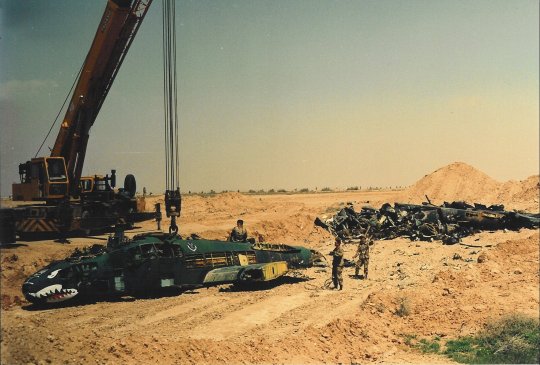
On the Coalition side, the situation was far better. 52 fixed-wing and 23 rotary-wing aircraft were lost in Desert Storm for the loss of 54 airmen (46 KIA, 8 POW). 29,393 combat sorties were flown by the USAF for the loss of 14 aircraft in combat (39 across the whole Coalition), giving a loss rate of 0.047% - the lowest of any major war the USAF had participated in to that point. Over the course of the month and a half campaign, the USAF averaged over 40,000 tons of bombs dropped, coming just short of the 44,000 tons per month dropped in Vietnam and well behind the monthly tonnage dropped in WW2. A total of 112,000 sorties were flown by all Coalition aircraft during Desert Storm, with the majority being flown by the USAF. Of these, the majority of sorties were actually support missions - tankers, AWACS, and EW.
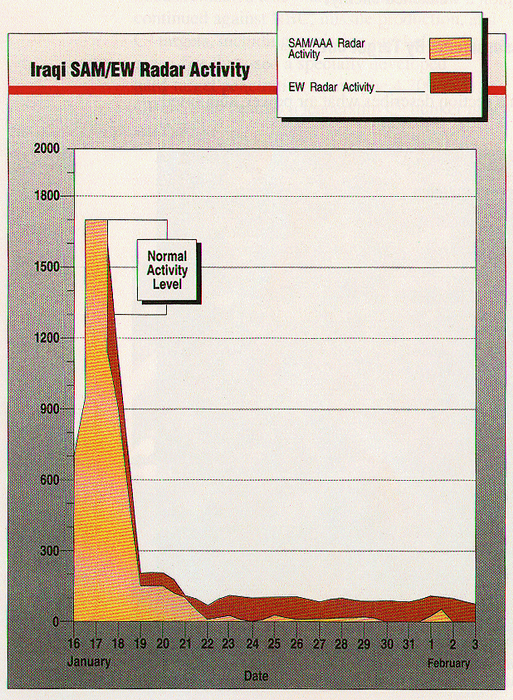
Unsurprisingly, the strategic component of the air campaign was devastatingly effective, and was only made more so by the rigidly centralized nature of Saddam’s regime. The airstrikes on Baghdad that opened up the war hit numerous command centers and the city’s power grid, and the ability of commanders to communicate with forces away from Baghdad rapidly deteriorated. Strategic strikes hit both military and civilian telecommunications systems, as the regime was heavily reliant on the civilian network, and as the Iraqi IADS was rolled back, jamming efforts along the front ensured that what little broadcasting ability remained was ineffective. The degradation of communications systems facilitated the weakening of the IADS as well, as they were controlled through a highly centralized system based out of Baghdad and branching out into regional nodes. SEAD efforts did an excellent job at reducing the early warning network, and an aggressive campaign against SAM sites ensured that they stopped being a serious threat by the third week of the campaign.
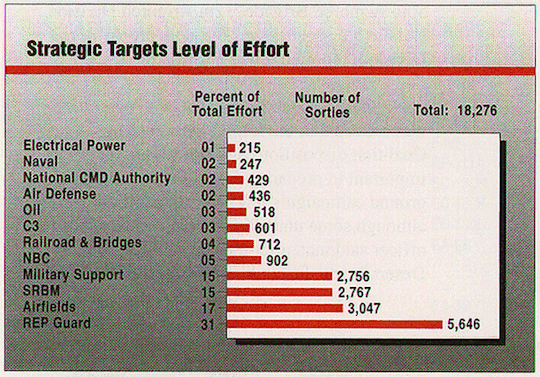
For all the success against the IADS, ground fire remained a persistent threat through the end of the war. Pilots quickly learned that flying at low altitudes was prohibitively dangerous over defended targets, and, even as the Iraqi IADS deteriorated, AAA and MANPADS would claim several Coalition aircraft. The threat of these smaller distributed systems was largely alleviated by flying aircraft up at medium altitudes, beyond the reach of ground fire, but these restrictions were relaxed once the ground war began, and the losses returned. In fact, of the five American aircraft downed during the ground war, all were hit by MANPADS or AAA. Fortunately, the campaign against the IQAF was very successful. Patrolling fighters deterred the IQAF from sortieing after the first few days of the war, and the hardened bunkers used to shelter the aircraft were unable to protect them from Coalition bombs. The majority of the nearly 600 aircraft shelters Iraq used in the war were put out of action, denying Iraq the ability to hide its air force.
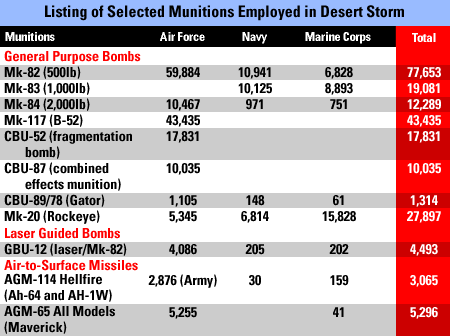
On an operational level the air campaign was a smashing success. The interdiction campaign against supplies heading into Kuwait was tremendously effective, reducing many units to starvation by the time the ground war actually began. Heavy use of PGMs allowed the Coalition to effortlessly drop the numerous strategic bridges across the region, and the presence of all-weather strike aircraft meant that even nighttime provided no refuge for Iraqi supply vehicles. More direct efforts against forces on the ground were similarly devastating. Again, PGMs proved invaluable, allowing single aircraft to destroy multiple vehicles on a single mission, and even the elite Republican Guard would be unable to weather sustained air attacks. Just as vital was the new E-8 Joint STARS command aircraft, which provided Coalition forces with the unique ability to map the battlefield and spot enemy forces. Without the assistance of the E-8, command and control over the Kuwait theater would have been considerably more difficult.
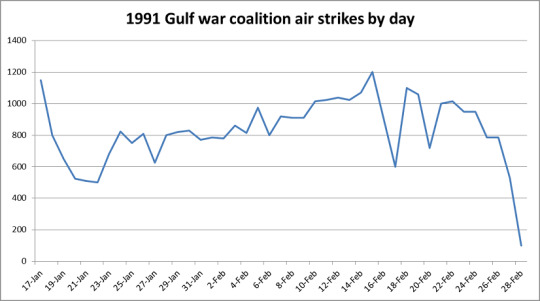
In all, the Gulf War would be one of the most perfectly executed air campaigns in history. A host of state-of-the-air technology would make its debut, and the air campaign was completed with acceptably low losses. The ability of Iraq to resist the air campaign and subsequent land war was completely destroyed, making for a relatively quick and easy war. Failings in doctrine were revealed, particularly in the vulnerability of low-level operations even after air supremacy was secured, but these same operations also revealed that medium-altitude operations were practical, especially with an increasingly heavy reliance on PGMs. Ultimately, PGMs may have been the most decisive factor in the war, allowing for Coalition forces to efficiently and decisively hit all manner of targets without fear of collateral damage.
15 notes
·
View notes
Text
/k/ Planes Episode 99: USAF Bombers

It’s time for another episode of /k/ Planes! This time, we’ll be looking at the bombers of the United States Air Force.
Soon after the Second World War came to an end, the Army Air Forces broke off completely from the Army, forming an entirely new branch known as the Air Force. As Cold War tensions rapidly ramped up, the Air Force soon found itself on the forefront of this standoff, using their nuclear-armed bombers to serve as a deterrent. With the bombers of the Strategic Air Command being the only way of delivering nukes in the early years of the Cold War, bomber development unsurprisingly ramped up. By the mid-50s, SAC had begun programs for everything from Mach 3 intercontinental bombers to nuclear-powered aircraft. However, just as bomber development was peaking, massive doctrinal changes set in. The advent of surface-to-air missiles killed the concept of a high-speed, high-altitude bomber, forcing SAC to hastily adopt a low-altitude approach to avoid detection by enemy air defenses. More critically, the development of ICBMs was seen by many to make strategic bombers no longer necessary. SAC would manage to hold onto its bombers, but overall bomber development ground to a halt. For the remainder of the Cold War, bomber programs would be few and far between, and they would be continually hampered by politics. Fortunately, the USAF’s strategic bombers have survived the dissolution of SAC in 1992, and, though the current fleet is rapidly aging, current plans to procure new bombers seem to be fairly secure.
Douglas A-26 Invader
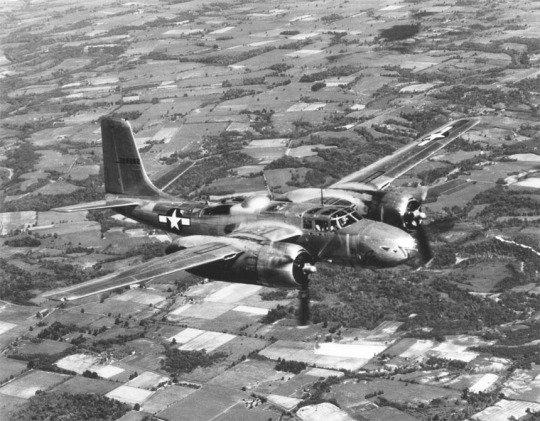
In 1940, the USAAF issued requirements for a new light bomber to succeed the A-20. Douglas, capitalizing on their success with the bomber, designed a new machine along the same lines as the A-20 making use of various major advances in technology. The new bomber used the same three-man crew and general layout, but a new laminar-flow wing was developed and more powerful Pratt & Whitney Double Wasps were mounted, allowing for vastly improved armament. Two remotely operated twin-.50 turrets were installed in dorsal and ventral positions for defense, while the glazed nose had two flexible guns for the bombardier. Internal payload capacity increased to 3,000lb, while external hardpoints provided space for another 2,000lb. The first prototype flew in October 1941, followed by a night-fighter prototype outfitted with a radar in the nose and a ventral cannon pack. The third prototype followed the pattern set by B-25 attackers, fitting a 75mm cannon in the nose.
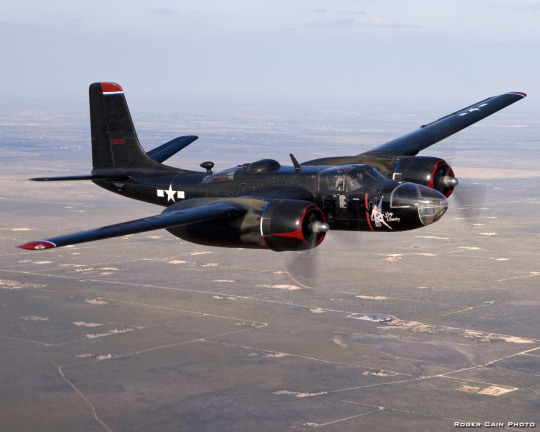
While the latter two prototypes would not enter production, the original design was a smashing success. Carrying double the payload specified, it still managed to come in 700lb under the projected weight. The bomber was ordered into production as the A-26B, with the first production variant replacing the glazed nose with a solid nose fitted with six machineguns. Production of the A-26B began in 1943. With an emphasis placed on ground-attack, the bomber was soon fitted with four underwing blisters each holding two .50s, and later production variants would expand the nose armament to hold a total of eight (rather than the original six) machineguns.

The A-26 was first deployed to the 5th Air Force in the Pacific, making its debut in July 1944 over New Guinea. Unfortunately, operational evaluations found the cockpit to be poorly designed, so the A-20 persisted with frontline units. Only after major changes to the canopy and armament took effect in early 1945 did pilots in the Pacific really start to accept the bomber. The 7th Air Force began receiving the bomber in March 1945, opening up operations from Okinawa into China and Japan. Unfortunately, the delays in acceptance of the A-26 meant that it wouldn’t see too much use in the Pacific. Apart from the sole bomb group flying the type off of Okinawa, it appears that most other units flying the A-26 in the Pacific were composites also operating the B-25 or A-20.

The 9th Air Force in Europe received the bomber in September, with their operational evaluations going far better. By the end of the year, A-26s were replacing A-20s and B-26s in operational units. Early operations attempted to return to the low-level tactics that had been so successful in the Pacific, but, after heavy losses, the A-26 switched to medium-level attacks. As a result, many units switched over to conventional glass-nosed variants. Early in 1945, the A-26 reached the 12th Air Force in Italy, supporting the final campaigns of the war. Across Europe, the bombers participated in night intruder missions, striking enemy logistical elements attempted to avoid air attacks by only moving at night. Despite initial difficulties, the A-26 was a smashing success in Europe - 9th Air Force Invaders had flown 11,567 missions, dropping over 18,000 tons of bombs and claiming 7 enemy aircraft while losing only 67 of their own.

As the USAAF transformed into the independent Air Force, the A-26 was passed onto both the Strategic and Tactical Air Commands, becoming the B-26 as the “A” designator was dropped. When the Korean War broke out in 1950, the A-26 was called back into action. On June 29, 1950, they conducted the first USAF bombing mission on North Korea, striking an airfield near Pyongyang, claiming 25 aircraft on the ground and another in the air for no losses. Flying day and night, B-26s served until the end of the war as an invaluable part of the war effort. The 452nd Bombardment Wing, one of two B-26 units involved in the war, would be credited with 15,000 sorties (7,000 at night) for the loss of 85 crewmen by the time they were deactivated in 1952. By the end of the war, B-26s had been credited with the destruction of 38,500 vehicles, 406 locomotives, 3,700 railway cars, and seven enemy aircraft on the ground.
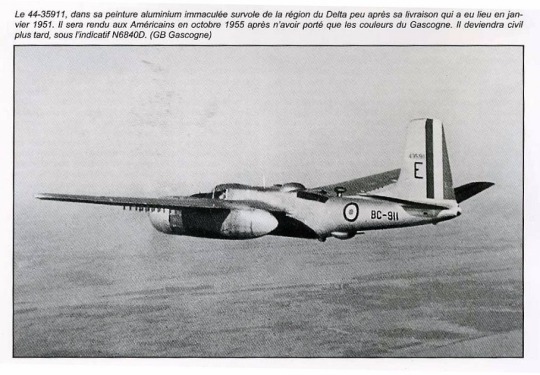
In early 1951, 111 Invaders were loaned to France for use in Indochina. Though most were stationed in Southeast Asia, several were moved to North Africa where, they were deployed against insurgents in Algeria. Operating out of Haiphong, they would make an appearance during the Battle of Dien Bien Phu, though they would fail to make a difference in the outcome of the war. In 1954, with the end of the war in Indochina, the surviving 85 B-26s were returned to the US. The use of the B-26 as a counterinsurgency platform would characterize its career with most foreign powers. Indonesia acquired six aircraft in 1959, using them against domestic rebels, while the bomber made a significant showing in the conflicts in Biafra and Portuguese Angola in the mid- to late-60’s. It was also a critical part of CIA covert operations, supporting efforts to overthrow the Indonesian government in 1958 and providing the only air support for the failed Bay of Pigs invasion in 1961.

The last significant use of B-26s by the US would come in Southeast Asia. In 1960, the CIA deployed several B-26s to the region to assist Laos in fighting communist insurgents. Owing to backlash over the Bay of Pigs invasion, initial operations were purely reconnaissance flights, though full-blown attack missions would eventually come. As part of Project Farm Gate, the B-26 was the primary strike aircraft in the region, remaining in that role until replaced by the A-1 in 1964. Around the same time, the B-26 fleet was abruptly withdrawn owing to several accidents related to wing fatigue. However, the utility demonstrated by the Invader convinced the USAAF to return the fleet to service. Overhauled with upgraded engines and propellers, new wings, and wingtip fuel tanks, 40 Invaders became B-26K Counter-Invaders. They were redesignated A-26A owing to Thailand’s refusal to station American bombers in the country, and they were returned to Southeast Asia. There, they operated against the Ho Chi Minh Trail until being withdrawn in 1969.
The American Long-Range Bomber
Though the USAAC’s 1935 long-range bomber program would come to an end in 1936, the push to create a bomber with an intercontinental range would persist. In 1938, a new program to create a high-performance long-range bomber began, with Boeing contracted to begin preliminary development. In December 1939, a formal specification - calling for a payload of 20,000lb, operational radius of over 2,500 miles, and top speed of 400mph - was issued, with Boeing, Consolidated, Douglas, and Lockheed receiving contracts. Though Lockheed and Douglas would soon drop their projects, Boeing and Consolidated soldiered on, producing the B-29 and B-32, respectively. Given the requirements issued, the resulting aircraft were unsurprisingly massive, marking some of the largest combat aircraft of the war.
Lockheed L-249/XB-30

Lockheed’s bomber proposal, which received the designation XB-30, was the smallest of all designs submitted. Based off of the still-developing L-049 Constellation airliner, the XB-30 would be powered by the same Wright Duplex-Cyclone radial engines of the airliner and retain the same wings and tail. An all-new fuselage would carry six defensive turrets (two dorsal, two ventral, one nose, and one tail) carrying ten .50s and a single 20mm cannon - all remotely controlled to allow the fuselage to be pressurized. Two ventral bomb bays would be installed as well, providing a total payload capacity of 16,000lb. Coming in at a max takeoff weight of just under 100,000lb, it was considerably heavier than the Constellation it was based off of, but it had markedly better performance projections, including a top speed of 382 mph and an operational range 1,000 miles longer. Unfortunately, the design would not leave the drawing board - Lockheed dropped it early in development when it became clear that Boeing had a two-year head start on development.
Douglas XB-31
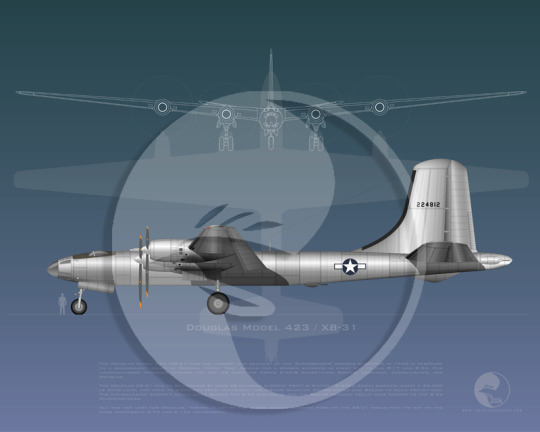
Whereas Lockheed had produced the lightest of all proposals, Douglas took a different approach, resulting in the largest design to receive a contract. The XB-31 also made use of four Duplex-Cyclones and a pressurized cabin, but the aircraft itself was massive. The shoulder-mounted wing was to be over 200 ft in span, while the max takeoff weight would be just short of 200,000lb. Defensive armament was comparatively light, with four .50s placed in dorsal and ventral turrets and two 37mm cannon in a tail position, but payload was very heavy at 25,000lb. Unfortunately, the design couldn’t hope to compete with the Boeing design. In late 1941, with Boeing and Consolidated having received contracts for further development, the XB-31 was canceled without ever leaving the drawing board.
Consolidated B-32 Dominator
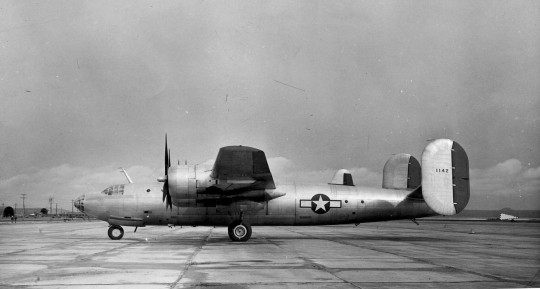
The Consolidated proposal would be heavily based off of their successful B-24 Liberator design, sharing its high aspect ratio wing and double tail in its original incarnation. Contracted as the B-32, the bomber featured an all-new pressurized fuselage and remote-controlled retractable defensive turrets with a total of 14 machineguns. Power would come from four Duplex-Cyclones, and gross weight would be just over 100,000lb. The first prototype would fly on September 7, 1942, but it was a far cry from the final design. Issues with cabin pressurization, landing gear, and gun turrets meant that the XB-32 lacked a pressurized cabin, landing gear doors, and defensive armament. Additionally, persistent issues with the engines plagued the design (as they would with the B-29). Eventually, armament was installed in the form of eight machineguns in dorsal and ventral turrets and a combination of two machineguns and 20mm cannon firing rearwards from the outboard engine nacelles.

A contract for 300 B-32s was placed in March 1943, but development issues only intensified. The XB-32 prototype crashed in May 1943, and the second prototype would only be ready to fly that June. Stability issues were found, leading to the replacement of the double tail with a larger, more conventional single tail. Meanwhile, persistent problems with the pressurization and defensive armament spurred the decision to repurpose the design as a medium-altitude bomber. Pressurization was dropped, and the complicated remote-controlled turrets were replaced with conventional manned ones. By 1944, testing had gone well enough for the order to be expanded to 1,500 aircraft. The first delivery of a production aircraft came in September 1944. Unfortunately, the first deployment wouldn’t come until May 1945 in the Philippines. The first combat missions were flown against Formosa as the sole squadron to fly the type transitioned. Ultimately, just 10 combat missions were flown before the war’s end. In the last days of the war, they were relegated to reconnaissance missions, continuing these sorties until the end of August, when the unit was stood down. Production was cut in September 1945 with only 118 aircraft completed, and the bomber was almost immediately retired in favor of the more capable B-29 at the end of the war.
Boeing B-29 Superfortress
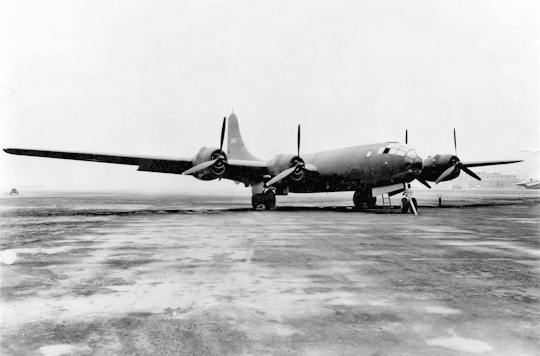
With work starting back in 1938, Boeing had been working to roughly adapt their B-17 into a longer-ranged bomber with a pressurized cabin. However, when their Model 345 was contracted as the B-29 in May 1940, there was little resemblance between the new design and the older B-17 apart from the tail. The new pressurized fuselage of the B-29 included a glazed nose and stepless canopy, while its four defensive turrets (two dorsal and two ventral) were all remotely controlled. Two bomb bays straddled the wing spars, providing a total payload capacity of 20,000lb, and long, thin wings would provide for excellent performance at altitude. Due to the promise the design showed, the initially contracted order for 250 aircraft ballooned to 500 by January 1942. In late September, the first XB-29 would fly. Though it lacked any armament, the second prototype (flying at the end of December 1942) would be closer to the production design.
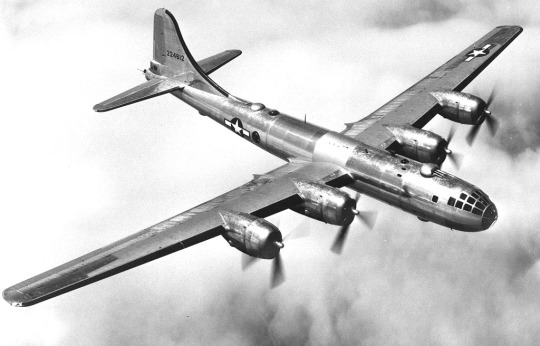
Unfortunately, testing was plagued with many issues. An engine fire caused the crash of the second prototype in February 1943, and continual modifications meant that production was also delayed. Even once deliveries of production aircraft did begin, most were flying straight from the factory to a depot for modifications to meet the latest standard for the aircraft. Because the B-29 was much larger than anything else in service, however, storage became an issue, and many would be damaged by inclement weather. By the end of 1943, only 15 of the 100 B-29s delivered were flyable. Intervention from General Hap Arnold sped the modification process, but it wouldn’t be until 1944 that the B-29 would reach operational service. Even then, many issues persisted, especially with the temperamental engines.

Though original plans had called for the B-29 to make its debut in Europe, the B-17 and B-24 were doing well enough there that it was decided to instead send the bomber to the Pacific, where it would be the only aircraft capable of striking Japan. Plans called for the bombers to operate out of southern China, with supplies being airlifted in over the Himalayas. The first B-29s arrived at their bases in China in April 1944, and on June 5, the first combat mission came when 77 B-29s were launched against targets in Thailand. Though they suffered no losses to enemy fire, the poor reliability of the bombers meant that 5 aircraft would still be lost. Ten days later, 47 B-29s made their first raid on Japan, striking the steel works at Yahata. Unfortunately, they did little damage, missing their target and losing two of their number to enemy fire. Just as bad, the raid exhausted the fuel stocks, forcing the raids to pause until more fuel was flown in. Due to the difficulties associated with operating out of China, B-29 operations were never very intense from the region. Raids continued across Southeast Asia and Japan, but by January 1945 the last B-29s were withdrawn from China.
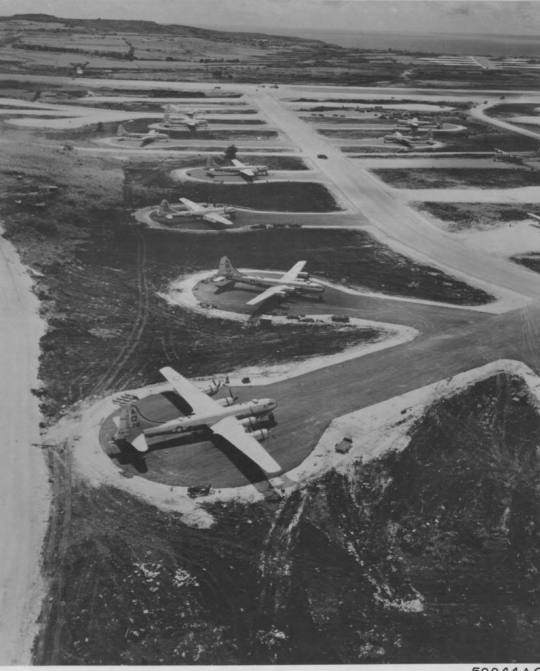
Because of the difficulties of operating out of China, an operation was launched to capture the Marianas Islands, which would bring Tokyo in the range of the B-29s. Once the islands came into Allied hands, five airfields were constructed, providing enough space for 180 B-29s to operate. B-29s began arriving on Saipan in October 1944, and by the end of the month they had launched their first raid (against Truk). By the end of the year, raids against Japan had begun, with 111 B-29s sent against Tokyo on November 24. The results of these early raids were mixed. The B-29s flew high and fast enough to make interception by enemy fighters difficult, and early on in the raids the Japanese were already resorting to fairly desperate tactics such as ramming. However, the high-altitude attacks with regular high explosive bombs weren’t nearly as effective as planners had hoped.

The solution to the B-29’s bombing problems would come in the form of the firebombing campaign. In early March, the B-29s changed tactics, abandoning high-altitude daylight raids in favor of low-altitude (5,000ft) night bombing with incendiaries. Operation Meetinghouse - the raid on Tokyo - would be the first of these missions. On March 9/10, 279 bombers dropped 1,665 tons of bombs on Tokyo. The resulting fire destroyed 7% of the city, killing some 80,000, injuring a further 40,000, and leaving roughly a million without homes. Despite the vulnerable low-altitude approach, the bombers had suffered few losses - just 14 B-29s were lost, while a further 42 were damaged. Over the next week, these raids hit Nagoya, Osaka, and Kobe, with similarly devastating results. Though the conventional high-explosive raids would also continue, the firebombing of the cities would be the most devastating element of the bombing campaign up until the end of the war.
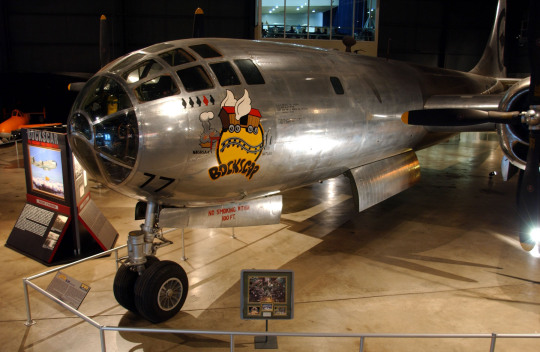
Of all the B-29’s missions, the atomic bomb raids on Japan would undoubtedly be the most famous. Though the B-29 was by far the most capable bomber in the USAAF inventory, the sheer size of the atomic bombs meant that serious modifications would have to be made to allow the bomber to carry the weapons. Under the codename “Silverplate,” 65 B-29s were configured to carry atomic bombs. Modifications involved the removal of the defensive turrets and the enlargement of the bomb bays into a single 33-ft bay (long enough to carry the cancelled Thin Man bomb). A Silverplate B-29 named Enola Gay would make history on August 6, 1945, when it delivered the gun-type Little Boy bomb to Hiroshima. Three days later, Bockscar dropped the second bomb - the implosion-type Fat Man - on Nagasaki. Several days after the obliteration of the two cities, on August 15, 1945, Japan surrendered to the US.
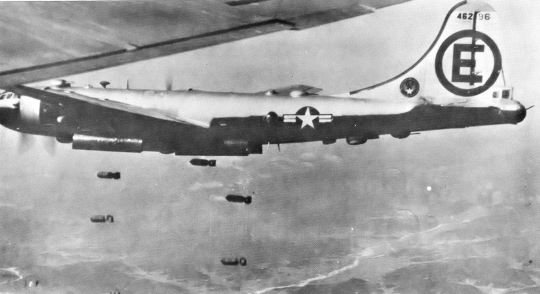
B-29 production would end in 1946, with all surviving examples passing on to the newly formed USAF. The 65 Silverplate B-29s would form the backbone of SAC’s nuclear deterrent until the B-36 and B-50 entered service, and in the years following WW2, they would be the primary means for testing nuclear weapons. As more capable bombers took over its strategic role, reconnaissance, ELINT, and tanker variants would be developed, extending the B-29’s service. Though the B-36 would begin to replace the B-29 in 1949, the B-29 would be the only strategic bomber to fly in Korea. Unfortunately, five years of technology advancing seemed to have caught up with the B-29. The arrival of the MiG-15 in Korea saw a surge of losses, and very quickly the B-29s were limited to night missions. Despite the restrictions, however, the B-29 performed admirably over Korea - 20,000 sorties were flown, dropping 200,000 tonnes of bombs.
Douglas XB-42 Mixmaster
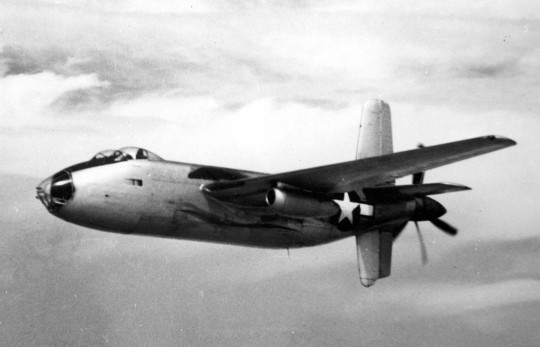
In 1943, engineers at Douglas conceived a concept for a twin-engined bomber with a 2,000 mile range, 400mph top speed, and 2,000lb payload. The concept, which entailed burying engines in the fuselage to allow for a clean, low-drag wing, was submitted to the USAAF in 1943. The Army was impressed with the design, and in June 1942 an order was placed for two prototypes as the XA-42 (changed to XB-42 at the end of the year). The XB-42 would take shape as a peculiar looking machine. Its two Allison V-1710 engines were mounted behind the cabin, geared aft to drive contra-rotating propellers. To prevent ground strikes, a large four-surface cruciform tail was used. The crew all sat in the nose, with the pilots placed in individual bubble canopies and a bombardier in the nose. Four remote-controlled machineguns were mounted facing aft in the wings, firing outboard of the propellers, and two more were fixed forward firing. The aircraft had also grown since the proposal, with an internal bay capable of carrying four 2,000lb bombs or a single 10,000lb bomb if the bomb bay doors were left slightly open.
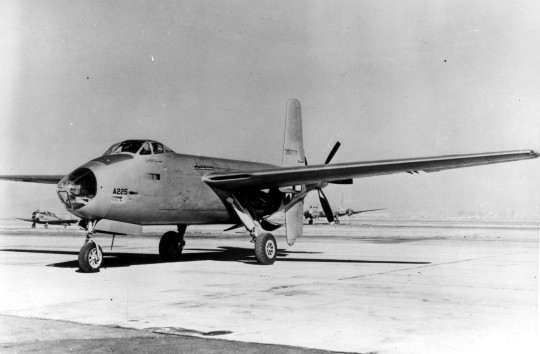
The XB-42 prototype would make its maiden flight in May 1944. Its top speed was just over 400 mph, and it far exceeded the projected range and climb rate. Minor issues were found with the controls, engine cooling, propellers, and crew layout, but overall the aircraft was satisfactory enough to warrant further work. While Douglas refined the design, the end of the Second World War put an end to their hopes. With a new generation of jet bombers just over the horizon, the Air Force opted to wait rather than order the XB-42 into production. Testing continued regardless, with a revised second prototype even setting a transcontinental speed record at the end of 1945. Unfortunately, this prototype was lost in a crash, forcing the test program to be completed with just a single aircraft. The sole surviving XB-42 was fitted with a Westinghouse 19XB-21 turbojet under each wing, following through with a proposal Douglas had tendered around the same time as the original XB-42. Flying as the XB-42A in 1947, it did demonstrate far better performance, with a top speed of nearly 500mph and cruising speed of 442 mph. However, after just 22 flights, a hard landing damaged the tail. The XB-42A was repaired, but it would never fly again, as the USAF’s focus had since shifted to pure jet-powered designs.
Boeing B-50 Superfortress
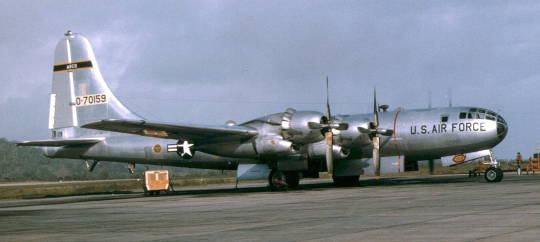
Though the B-29 was a solid airframe that met the requirements set out for it, the Wright Duplex Cyclone engines that it used had been problematic all through its development (and in fact, through its entire career). In 1944, with B-29 production going smoothly, it was decided to work on an improved variant making use of the more powerful Pratt & Whitney Wasp Major engines. Coming in at a 3,000hp, the Wasp Major was the most powerful American piston engine to ever see mass production, producing almost a third more horsepower than the Duplex Cyclone. The first prototype for the re-engining, designated the XB-44, would take flight in My 1945. While it performed reasonably well, Boeing had plans for the final production variant - the B-29D - to feature far more changes than just a new powerplant. The new bomber made use of a new aluminum alloy that would make the wings both stronger and lighter, while a strengthened undercarriage increased the max takeoff weight by 40,000lb. To account for the extra weight, the tail was enlarged, and, while the standard payload bay and defensive armament was retained, external racks for a further 8,000lb of bombs were added.
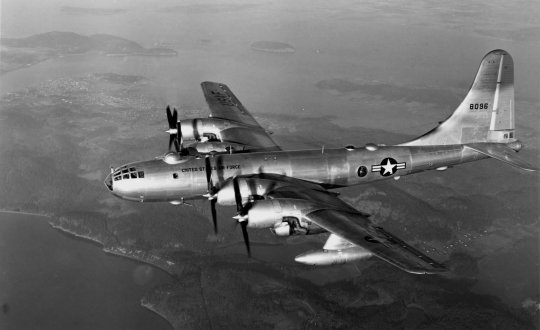
An order for 200 B-29Ds had been placed in June 1945, but the end of the war that came soon after saw the order caught up in the mass cancellations that followed. In December, the order was slashed to 60, with the designation changed to B-50. The first production B-50A wouldn’t take flight until two years later in June 1947, followed by an expanded order for 78 more aircraft. While the Air Force planned to replace the B-50 with the further improved B-54, development of less ambitious B-50 variants continued. The B-50B would further increase the max takeoff weight and add underwing fuel tanks, and the definitive production version, the B-50D, would increase max takeoff weight to 173,000lb, add an inflight refueling receptacle, and revise the nose windows. Though intended as little more than a stopgap until the new generation of strategic bombers was available, the B-50 nevertheless saw a fairly large production run totaling nearly 400 aircraft.
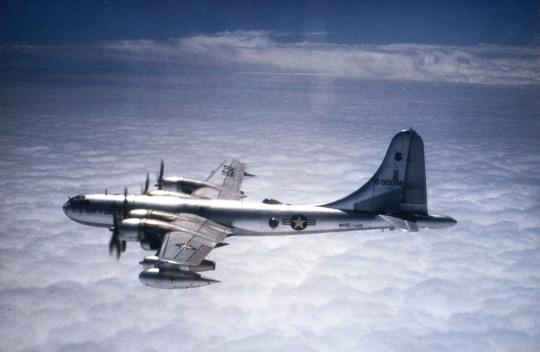
B-50s began reaching SAC bomber units in 1948, taking on the nuclear deterrent role. In this role, the B-50’s career was brief and uneventful, and within a couple of years the B-47 had come along to replace it. In 1949, a reconnaissance-oriented RB-50 took shape, intended to replace the aging RB-29s then in use. They would make their debut in the Korean War, replacing RB-29s, and later they would begin overflights of periphery areas of the Soviet Union. However, even with vastly improved performance over the B-29, the RB-50s were incredibly vulnerable to Soviet air defenses. Several RB-50s were downed by Soviet interceptors, and, once the RB-47 came into service in 1954, the RB-50 was retired. The final B-50 variant to take shape, the KB-50 tanker, would again be developed as a replacement of an earlier B-29 variant. Fitted with strengthened wings and receptacles to refuel up to three fighters at a time, the KB-50 would form the backbone of TAC’s aerial refueling force soon after its introduction in 1956. Their service was generally uneventful, although several were deployed to Thailand in the early stages of American involvement in Southeast Asia before metal fatigue finally forced the retirement of the last KB-50s in 1965.
Douglas XB-43 Jetmaster

Soon after Douglas had tendered their proposal for the XB-42, they began examining the idea of installing turbojets in place of the piston engines in the tail. By 1944, the idea had gained considerable traction, so in March the XB-42 contract was modified to call for two prototypes powered entirely by turbojets, designated XB-43. Douglas ended up modifying the static test airframe for the XB-42 for the first prototype. Two J35 turbojets were placed in the rear fuselage where the original piston engines were, with two intakes cut on the sides of the fuselage and exhausts piped out the tail. With no propeller to protect from ground strikes, Douglas removed the lower vertical tail, enlarging the upper surface to compensate for loss of yaw stability. With no propeller in the way, Douglas could also revise armament, replacing the awkward wing guns of the XB-42 with two remote controlled machineguns in a tail position. While work went ahead on the standard bomber variant, Douglas was also working on an attacker variant fitted with 16 forward-firing machineguns in a solid nose and 36 5-inch rockets.
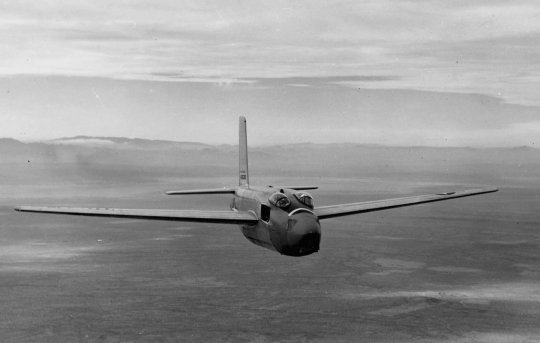
Thanks to the relatively simple conversion of the prototype, the XB-43 was ready for testing by 1945. Unfortunately, the end of the war saw a general slowdown of manufacturing, leading to delays in engine procurement. Ultimately, due to problems with the engines, the XB-43 wouldn't make its maiden flight until May 1946. Though this would make it the first American jet-powered bomber to fly, it came just too late to gain a production order. Though the XB-43 performed even better than the XB-42 with minimal compromises to range and payload, it was outperformed by the new class of jet bombers designed at the end of the war and was generally underpowered. Douglas would complete the second prototype as an engine testbed, retaining one J35 engine but arranging the aircraft to allow the second engine to be replaced. The second prototype would enter Air Force service as the YB-43, serving as a testbed for the J47 engine. In this configuration, the YB-43 would fly some 300 hours of test flights before being retired in 1953.
The American Superbomber
In early 1941, the USAAC initiated a program to create a bomber capable of striking targets in Europe from the mainland US, fearing that Britain would fall to German forces. In April of that year, requirements were issued calling for a bomber with a 450mph top speed, 275mph cruise speed, ceiling of 45,000ft, and a maximum range of 12,000 miles. These requirements quickly proved impractical, so requirements were refined. Service ceiling and cruise speed dropped slightly, and range requirements were refined to call for an operational radius of 4,000 miles with a 10,000lb payload. The requirements were originally submitted to Boeing and Consolidated, though Northrop was added to the team a month later. Ultimately, only Consolidated (later Convair) and Northrop would receive contracts for development. Not too surprisingly, the requirements led to the development of some of the largest aircraft ever built.
Northrop YB-35
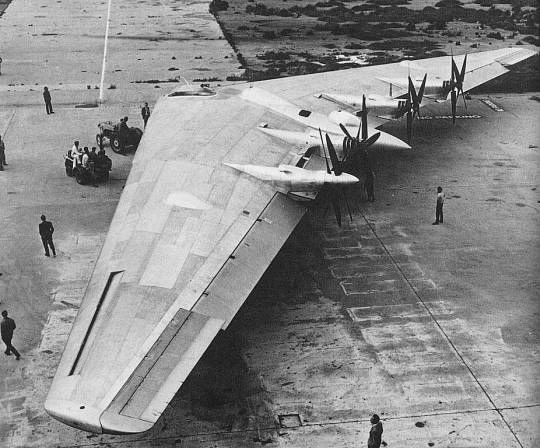
Northrop’s bomber proposal capitalized on their research with flying wings, scaling up their basic design to create a strategic bomber. The B-35 would have a fuselage-like cabin along the centerline to carry its crew of nine, complete with bunks for long flights. Twenty guns would be mounted along six remotely controlled turrets, and six bomb bays (three on either wing) were to carry a payload of over 50,000lb. The bomber itself was a 172 ft flying wing, powered by four Pratt & Whitney Wasp Major engines in a pusher arrangement. With a loaded weight of 180,000lb, the B-35 was far larger than any bomber to fly in WW2, and, with a range of over 8,000 miles, it posessed a truly intercontinental range. The original contract for the XB-35 called for the bomber to be flying by 1943, but, given the advanced nature of the design and priority given to other projects, the first XB-35 wouldn’t fly until June 1946.
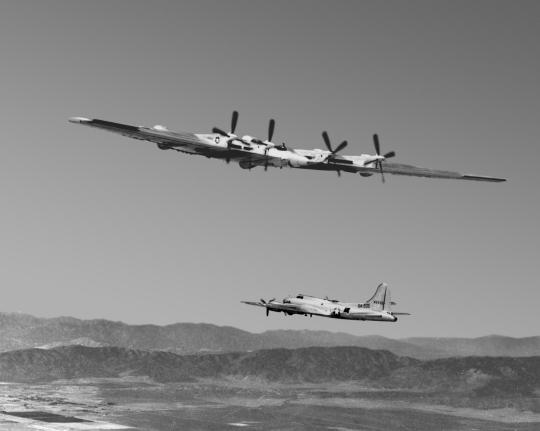
Unfortunately, the XB-35 would run into major problems. Though it had already received an order for 200 aircraft, the Air Force was reluctant to operate the plane, owing to issues with the original contra-rotating propellers and the more promising B-36 that the bomber was competing with. The original design’s bomb bays were too small to carry a nuclear weapon, but Northrop was not permitted to modify the design despite USAF insistence that they would not buy it unless it could carry the Mk.3 bomb. Despite issues, several pre-production YB-35s were built, the first of which flew in 1948. Meanwhile, the USAF ordered several airframes to be converted to the jet-powered YB-49 standard. Ultimately, however, Northrop was unable to overcome the issues. The YB-35 was outperformed by the B-36, and, though the YB-49 offered better performance, it lacked the range to compete with the B-36. In 1949, the B-35/49 program was controversially cancelled on grounds of the technical issues associated with the design, and all airframes were ordered scrapped.
Convair B-36 Peacemaker
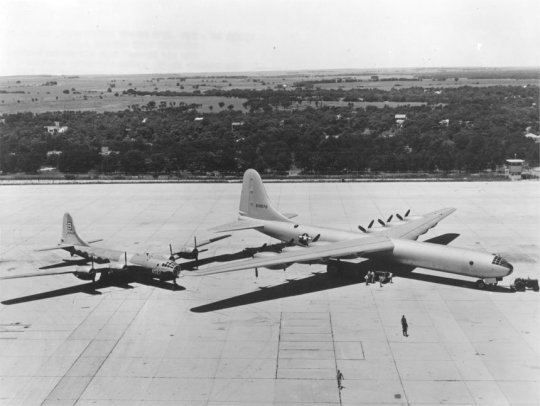
The competing design from Convair, designated B-36, was more conventional than the Northrop flying wing, but it would stand out due to sheer size. Standing 46ft high and 162ft long, the B-36 had the largest wingspan of any bomber ever (a record that holds to this day), with a span of 230ft. Its massive wings were seven feet thick at the root, providing enough space for a crawlspace to be added to service the engines. As originally designed, power came from six Wasp Major radials placed in a pusher arrangement driving the second-largest propellers ever fitted on an aircraft. Dwarfing everything else in terms of size, the B-36 was also incredibly heavy - it had a gross weight of over a quarter million pounds, and the max takeoff weight was over 400,000lb. The bomber carried a crew of 15 in a large pressurized fuselage, with a tunnel connecting the forward and rear compartments that straddled the four bomb bays. Defensive armament consisted of six retractable remote-controlled gun turrets, as well as fixed tail and nose positions. The centerpiece of the design, however, was the spacious bomb bays, which provided a total payload capacity of 86,000lb.
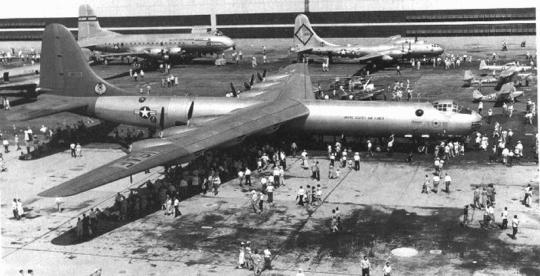
Like the B-35, the B-36 would not be ready to fly by the contracted 1943 deadline, instead taking flight in August 1946. Oddly enough, the unarmed pre-production B-36A would fly several months before the second prototype - the YB-36, complete with armament - flew. Despite teething issues just as bad as those experienced by the B-35, the B-36 would be ordered into service fairly quickly, owing to its record-breaking payload and 10,000 mile range. By the end of 1948, the first operational group of B-36Bs had been formed. The aircraft’s unprecedented size did present some issues, as there were no hangars large enough to house the behemoths, but otherwise they were serving well. On December 7, 1948, the B-36 demonstrated its true potential for the first time. Taking off from its base in Carswell, Texas, a B-36B flew all the way to Hawaii to drop a 10,000lb payload before returning home. The round trip, which was over 8,000 miles, took over 35 hours to complete.
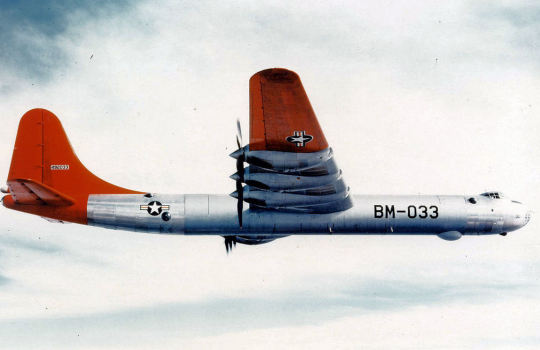
Despite impressive performance, the exorbitant costs, difficult maintenance, and high profile of the program in an era of budget cuts saw it be targeted for cancellation. It became a contentious issue, particularly between the USAF and USN. Fortunately, rising tensions between the US and USSR would save the B-36, as it was the only platform available to perform nuclear strikes on the Soviet Union. Fairly early in the B-36’s service, Convair finally decided to address complaints about poor performance. Though the B-36 had an impressive range, it had a poor power-to-weight ratio that led to excessive takeoff rolls and a poor climb rate. A fairly simple solution was found in the B-36D, which added twin turbojet engines slung outboard of the props on the wings. First delivered in 1950, 26 B-36Ds would be new-built, while 59 others would be converted from B-36Bs. Several RB-36Ds were also produced for strategic reconnaissance.
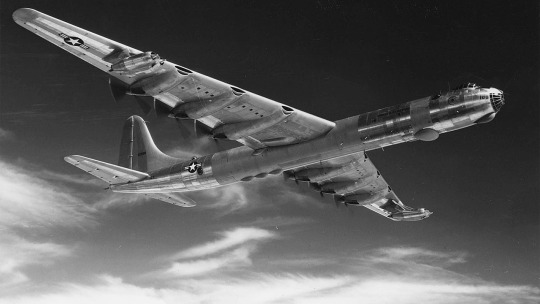
Though the B-36 would never drop a bomb in anger, it would have an extensive service career as a test platform. Being nuclear bombers first and foremost, they took part in several nuclear tests, sitting at a standoff distance to simulate the effects on a bomber as it escaped the target. Because the B-36 far outstripped the range of any fighters, it became the subject of various parasite fighter experiments.. Early experiments involved connecting wingtip-to-wingtip with various other aircraft (Project Tom-Tom) ranging from other B-36s and B-29s to F-84 fighters. Such an arrangement would allow the bomber to carry its own fighter escort, while docking with another bomber would increase fuel efficiency. While a crash during testing put an end to Tom-Tom, attempts to carry a fighter in the bomb bay went better. A specially designed parasite fighter, the XF-85, would take shape, and experiments were performed with both XF-85s and F-84s to test the efficacy of the arrangement. Ultimately, the parasite fighter concept proved impractical, though it was not a complete waste - 25 RB-36Ds were converted to the GRB-36D standard to carry RF-84Ks for reconnaissance missions. These saw limited service between 1955 and 1956, ultimately being phased out in favor of the far more practical and capable U-2.
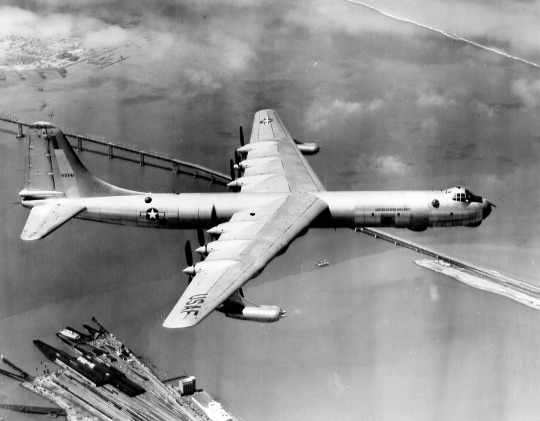
Having been kept out of Korea, the B-36’s only operational use would come as a strategic reconnaissance platform. Thanks to the extremely high service ceiling of the B-36, the bomber was selected for overlights of the edges of the Soviet Union. Such flights began in 1951, gradually probing the edges of the Soviet arctic regions. Ultimately, however, such flights were limited as Soviet air defenses rapidly expanded. Meanwhile, service in Korea and advances in air-to-air missiles had shown that the B-36’s operating altitude may not be as practical as expected. In 1954, the USAF began the Featherweight program, which stripped the now-obsolete armament from the B-36, reducing crew to 9 and lightening the airframe. Even so, the landing gear was strengthened and fuel tanks expanded, giving the bomber the longest range and highest max takeoff weight of any B-36 series. Such modifications significantly improved performance, increasing the operating ceiling to 47,000ft.

Ultimately, the B-36 was made obsolete by the rapidly advancing technology of the time. Slow and lumbering, it could no longer count on its high ceiling to protect it from fighters, even with the benefits offered by the Featherweight modifications. Though it had an impressive range and payload, it was incapable of performing aerial refueling, meaning it was unable to reach many bases deep in the Soviet Union. When Eisenhower came into office, modernization of the Air Force took priority, and in 1955, the process of phasing out the B-36 in favor of the B-52 began. Defense cuts would extend the B-36’s service life longer than expected, but SAC had phased out most of their B-36s by the end of 1956. By the end of 1958, only 22 B-36Js were still operational. Early the next year, the last B-36J was retired.
Northrop YB-49

As the XB-35 fell behind schedule and developments in jet technology proved promising, a study was commissioned in 1944 to examine the feasibility of mounting jet engines onto the XB-35 design. When Northrop was contracted to create 13 B-35 prototypes in June 1945, authorization was given to convert two of these to a jet-powered configuration under the designation YB-49. Originally planned with six J35 turbojets, the YB-49 would finally take shape as an eight-engined machine. Due to the removal of the prop shaft housings that provided yaw dampening, the bomber was fitted with four large wing fences that extended into fins at the trailing edge. Apart from the changes made to accommodate the new powerplants, however, the YB-49 was almost identical to the XB-35.
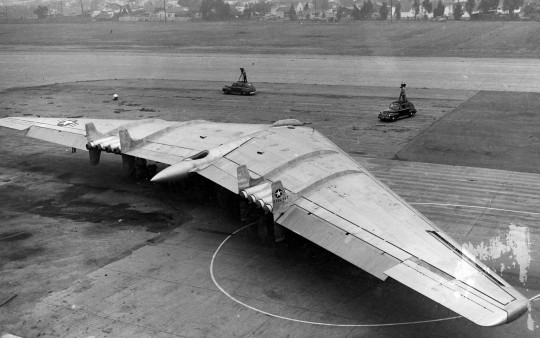
The first YB-49 prototype would fly in October 1947. Extensive testing of the prototype would occur, followed by a second prototype that would fly in 1948. Unfortunately, the second prototype would crash just after being accepted by the Air Force, killing its entire crew. Following the crash, extensive testing of the surviving prototype was performed to determine the aircraft’s stability, with poor results. Pilots found the bomber to be extremely unstable, and, in comparative flyoffs against B-29s, the YB-49 was found to take four times as long as the B-29 to attain bomb run stability. Even worse, the jet engines were far less efficient than the piston engines of the XB-35, cutting range so significantly that the YB-49 was more in the class of the jet-powered medium bombers being developed at the time. However, while it had the same range as other bombers in development like the B-45 and B-47, it was considerably slower thanks to its thick wing. Unsurprisingly, the YB-49 was found to be unfit for the bombing role, and in 1950 the program was cancelled and the first prototype scrapped.

As development of the YB-49 hit delays, Northrop proposed a reconnaissance variant. While nominally based off of the YB-49 (and in fact sharing the RB-49 designation), the new variant featured substantial changes to the powerplants. An initial prototype would mount eight J47s in the original configuration, while the second prototype would use six J40s (two of which were carried under the wing), and the final configuration would mount two J40s and two T-37 turboprops (once they became available). Hoping to salvage something out of the disaster that was the Northrop flying wing bomber program, the Air Force placed an order for 30 YRB-49s in 1948. Unfortunately, the program soon came under fire, as it became apparent that all projected variants fell short in some aspect of performance. Ultimately, in January 1949, the contract was slashed to just a single YRB-49A prototype. Hastily completed in early 1950, the YRB-49A mounted six J35s, with two slung under the wing. Flight testing began in May 1950, but by September, the brief test program had come to an end. It would make its final flight in mid 1951, finally being scrapped in 1953.
The Class of ‘45
In 1943, the USAAF had issued informal requirements for a jet bomber to kickstart research into such designs. By 1944, this had evolved into a full-blown requirement calling for an 80,000lb class machine with a top speed of 550 mph, cruise speed of 450 mph, range of 3,500 miles, and service ceiling of 45,000ft. North American, Convair, Boeing, and Martin all responded to the requirements, resulting in two four-engined designs (from North American and Convair) and two six-engined designs (from Boeing and Martin). Unsurprisingly, all the original designs submitted to the requirements were poorly optimized transitional machines, largely resembling a piston-engined aircraft with jet engines hastily slapped on. Nevertheless, the rapidly rising tensions as the Cold War began spurred the USAF to speed up the procurement process. While Boeing was working on refining their design to make a truly modern bomber, the USAF had a flyoff between the first two designs to fly - the North American XB-45 and Convair XB-46. The result was a unique two-stage procurement as the Air Force scrambled to get a stopgap into service.
North American B-45 Tornado
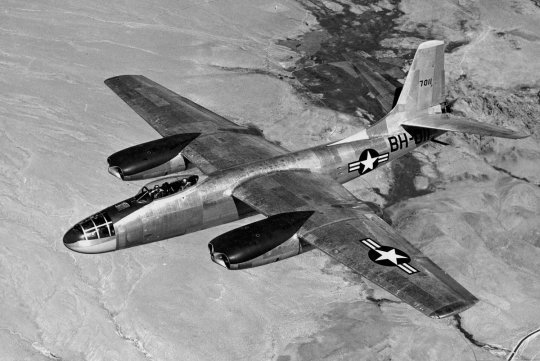
North American’s contender to the new bomber requirements, contracted as the XB-45, was a four-man four-engined machine designed with a payload of 22,000lb. Outwardly unimpressive, the bomber mounted its four J35 turbojets in twinned nacelles under the straight wings. More closely resembling a WW2 bomber with jets hastily slapped on than a truly modern aircraft, the XB-45 featured a glazed nose for the bombardier and a tailgun position fitted with two machineguns. First flying in March 1947, it would be the first of the competing designs to take to the skies. A total of three XB-45 prototypes were built, flying 131 flights over the course of testing. While hardly a remarkable aircraft, and in fact falling short of several requirements (namely range), the rush to get a jet bomber into service would save the design. Delays in the more capable Boeing and Martin competitors spurred the Air Force to make an interim selection between the XB-45 and Convair’s competing XB-46. The B-45 was found to be superior, so, after several minor modifications, the bomber was ordered into production.

Unfortunately, the B-45 ran into problems very quickly. Though original plans called for the bomber to equip eight bomb groups and three reconnaissance groups, a variety of factors collided to reduce the planned procurement. Soon after the selection of the B-45, the promising flight testing of the B-47 put further production into question as the Air Force began looking towards purchasing the far more capable Boeing bomber. In 1948, budget cuts saw the planned order cut to just 142 airframes. Though it would still enter service in 1948, it was plagued by various technical issues. The engines themselves were problematic, and the complicated bombing system was a constant source of problems for crews. Perhaps more glaringly, the pressurization system of early production models was prone to failure, severely hampering the performance of the aircraft.
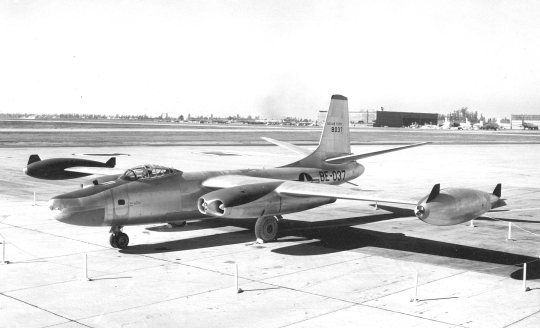
Despite all the early issues with the type, the B-45 would go on to prove its importance. When the war in Korea broke out, the mass movement of American forces to Korea left Europe vulnerable. The USAF, needing to retain its nuclear deterrent in Europe, began a process of upgrading the B-45 fleet to carry nuclear weapons. 40 B-45s were converted to the new role, arriving in the UK in May 1952. While B-45s were forming a vital part of the strategic deterrent over Europe, RB-45s were making their operational debut in Korea. Owing to the heavy losses suffered by RB-29s in Korea, a squadron of RB-45s was sent to the theater to supplement the older bombers. Thanks to their speed, they were capable of flying daylight missions in relative safety. These daylight missions continued until an RB-45C was almost lost to a MiG-15, forcing a shift back to night operations. Despite their limited numbers, they would serve through the end of the Korean war, providing invaluable strategic reconnaissance.

Despite a good showing in the early ‘50s, the B-45’s career would be brief. In the strategic bombing role, the B-45 was soon superseded by the more capable B-47, and, while an initial round of upgrades had given the B-45 fleet basic nuclear capabilities, the Air Force was reluctant to continue upgrading what they considered an obsolete aircraft to keep up with rapidly improving nuclear weapons technology. By the mid-50s, strategic reconnaissance would be primary focus of B-45s. Several RB-45Cs were passed on to the UK to perform overlights of the Soviet Union from Europe, while several American squadrons also seem to have been tasked with overflights from bases elsewhere. By 1958, some 50 B-45s of all types remained in service, all operating with Tactical Air Command’s 47th Bomb Wing. With the arrival of the B-66 that year, the bombers were rapidly phased out, and by July 1958, the last B-45 had been retired.
Convair XB-46

Convair’s contender to the new bomber requirements was a similar design to North American’s XB-45. Designated the XB-46, the Convair bomber had engines paired in nacelles under its straight wings. While it maintained a sleek appearance, it still carried archaic features that made it obsolete, and, as development went on, Convair found their project struggling to retain support even against another internal project - the XA-44/XB-53. The XB-46 project would survive the resistance, but only after its order for prototypes had been slashed to just a single aircraft with only basic systems installed. Testing began in April 1947, making it the second of the four contending designs to fly. Though by no means competitive with the larger Martin and Boeing designs, the decision of the USAF to evaluate the two earliest contenders as a stopgap gave hope to the design. Unfortunately for Convair, the XB-46 was outperformed by the XB-45. Though it boasted a longer range than the XB-45, it was considerably slower, and, given the size of the bulky radar bombing system slated for production aircraft, a production B-46 variant would likely have required an extensive reworking to make it combat-capable. Ultimately, the B-46 program was cancelled in August 1947 before flight testing could even be completed. Testing would continue for a further 44 flight hours beyond the cancellation of the aircraft to examine stability and vibration issues, but in August 1949, the XB-46 was taken out of service owing to difficult maintenance.
Martin XB-48
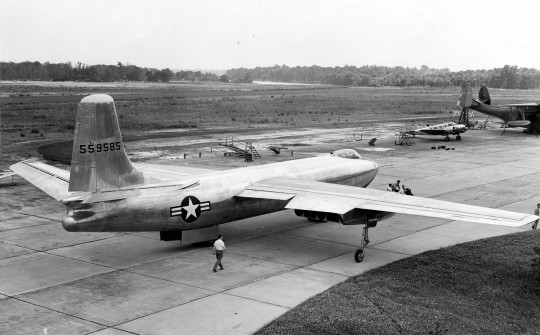
Unlike the Convair and North American contenders, Martin’s XB-48 would be a six-engined aircraft. Significantly larger than the XB-45 and XB-46, the XB-48 retained the same archaic straight wing, but made attempts to address the unsatisfactory layout by making use of a very thin airfoil section. Engines were grouped together under the wings in special nacelles fitted with airflow channels to keep the engines cooled, and, as a consequence of the very thin wings, the bomber was fitted with bicycle landing gear. Unfortunately, the XB-48 would take flight just too late to be considered a contender for the initial round of selection, instead being held back as a backup in the event Boeing’s B-47 did not pan out. Unfortunately for Martin, the B-47 very much did pan out, massively outperforming the other three bombers it was developed alongside. With the B-47 going smoothly, the XB-48 program came to an end.
Boeing B-47 Stratojet
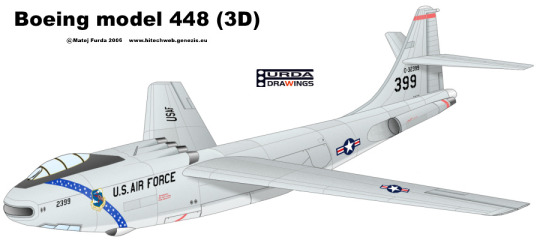
Boeing’s original proposal submitted to the USAAF requirements in 1944 was not too far from the competing designs from other companies. Given the internal designation Model 424, the bomber was a scaled-down development of the B-29 mounting four turbojets in paired nacelles under the wings. When wind tunnel testing revealed the Model 424 to be unsatisfactory, however, Boeing radically redesigned it into the Model 432. The Model 432 retained the conventional straight surfaces of the original design, but moved the four engines into an unusual arrangement behind the cockpit. Soon after the Model 432 took shape, however, Boeing engineers got their hands on German swept-wing data, and Boeing revised the design once more into the Model 448. The Model 448 added 35 degree swept wings, a new intake for the four forward engines in the nose, and two further engines placed in the tail - a consequence of a push for greater range and performance.
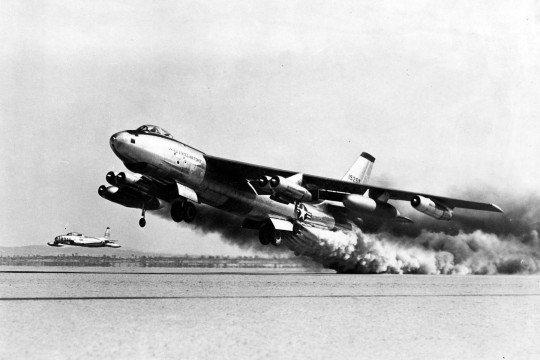
Despite all Boeing’s work to optimize their bomber, the Model 448 was rejected almost immediately upon its submission. While it offered significantly better performance than the other contender designs, the hazard presented by engine failures in flight was deemed too great, forcing Boeing to redesign their bomber with engines in the wings. Fortunately for Boeing, the reworking was simple. The four engines behind the cockpit were moved to paired nacelles around the mid-span, while the two remaining engines were placed further towards the wingtips. Because of the thin wings and spacious bomb bay the design called for, Boeing was forced to incorporate bicycle landing gear. The crew arrangement was similar to the other contenders, with a crew of three placed under a tandem cockpit, as was the payload (25,000lb) and defensive armament (a tail barbette fitted with two 20mm cannon). Though the substantial redesigns had heavily delayed the bomber, the extremely modern design offered considerable promise, leading to the Air Force making a special exception to their procurement process to get the bomber into service. Although it would only take flight at the end of 1947, the B-47 demonstrated substantially better performance than the rest of the “class of ‘45,” and by the end of 1948, had been ordered into production.

The first B-47s reached units in June 1951, but various teething problems would keep it out of operational service until 1953. Cabin ergonomics were poor and crew workload was high, making flying the plane difficult. Takeoff and landing in particular was tricky, with sluggish performance on takeoffs and high landing speeds only made worse by its unusual bicycle landing gear. Nevertheless, teething problems subsided as training improved, and the B-47 rapidly rose to prominence as Strategic Air Command’s primary intermediate-range bomber. By 1956, 28 wings were flying with B-47, with a total of 1,306 bombers and five wings totaling 254 RB-47s. Having taken over the strategic bomber role from the B-45, the B-47 fleet was made compatible with most freefall weapons in the nuclear arsenal. They would serve as the first line of the strategic deterrent, with bombers rotating every 90 days to bases in the UK, Morocco, Spain, Alaska, and Guam.

By the late ‘50s, advances in air defenses led to a doctrinal shift away from high-altitude penetration. Crews began training for low-altitude pop-up attacks, developing a flight profile that entailed a low-altitude penetration, toss-bombing attack, and low-altitude egress. Unfortunately, these practices were hard on the airframes, and, coupled with the already high crew workload, accident rates unsurprisingly soared. In 1958, the added stresses to the airframe had forced the initiation of a refit program to strengthen the wings. Even as this program began, however, the B-47’s days were numbered. In 1959, the B-52 began to take over the strategic deterrent role, leading to a cutback in B-47 numbers. Operational squadrons slowly drew down, with final phaseouts beginning in 1963. By 1965, the last B-47 had left the Air Force inventory.

While the nuclear-armed B-47s would be far more numerous, it would be the RB-47 spyplanes that would see the most interesting use. Starting in 1952, RB-47s began flying missions over the Soviet Union, with missions generally taking the bombers around more lightly defended regions such as Siberia and the Kola Peninsula. While these missions were generally successful, the bombers were far from invulnerable. Such overflights relied on flying high and fast enough to escape interceptors before they could reach the bombers, meaning that the RB-47s were heavily reliant on inadequate early warning networks. Unsurprisingly, the bombes were not always able to evade Soviet interceptors. In May 1954, an RB-47E was damaged by an intercepting MiG-17, and in April 1955, MiG-15s bounced an RB-47 near the Kamchatka Peninsula, presumably downing. In 1956, these flights ramped up with Project Home Run, entailing 156 overflights of Siberia. RB-47 flights continued into the mid-60s, with countless run-ins with enemy interceptors occurring, almost always in international airspace.
Convair XB-53
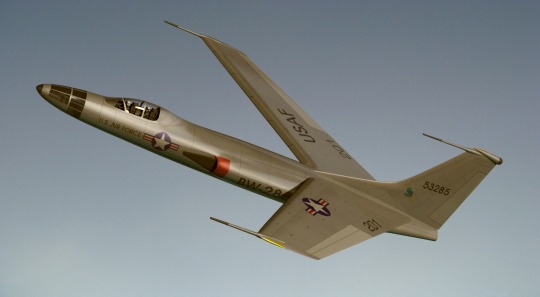
In 1945, Convair was contracted to develop a jet-powered attack aircraft for the USAAF under the designation XA-44. Taking full advantage of captured German research, Convair developed an unusual design featuring a 30 degree forward-swept wing and a tailless layout. Developed in parallel with the XB-46, it was considerably lighter, with a gross weight of just 60,000lb, and it was to be powered by three J35 turbojets buried in the rear fuselage. Payload was to be 12,000lb of bombs, and provisions for up to 40 HVARs to be mounted under the wings were made. Despite its unusual layout, the project gained considerable support both internally and within the USAF, so much so in fact that it threatened the contract of the XB-46. Ultimately, a revised contract saw the XB-46 order cut to a single stripped-down prototype, substituting the other two contracted airframes with XA-44 prototypes. Meanwhile, in 1948, the “A” attacker designation was dropped, and the XA-44 was redesignated the XB-53. Unfortunately, despite its promise, the XB-53 would never materialize. In 1949, before construction of a prototype could begin, the XB-53 contract was cancelled.
Boeing B-54
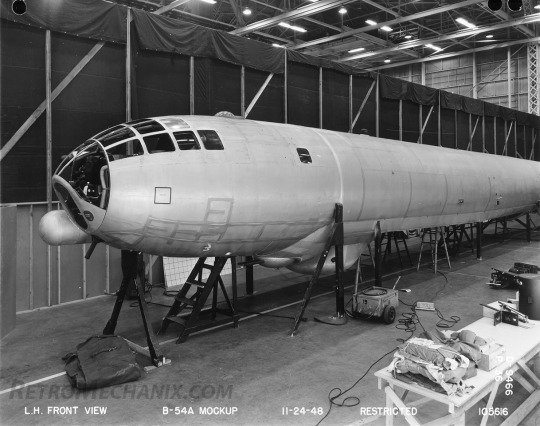
In 1947, Boeing began yet another major overhaul of the venerable B-29 design under the designation YB-50C. The YB-50C was an ambitious project, aiming to mount the new Pratt & Whitney R-4360-1 Variable Discharge Turbine engines, each providing a total of 4,500hp, onto a substantially improved airframe. The fuselage was lengthened by 10 feet, while wingspan grew by 20 ft. Larger underwing tanks increased fuel capacity by 3,000 gallons, bringing projected range to 9,3000 miles. Two extra landing gear struts were added under the outboard engines, bringing the max takeoff weight to an impressive 230,000lb - 36,000 of which could be payload. By now, the design had changed significantly enough to warrant an entirely new designation - B-54. Both conventional bomber variants and a reconnaissance RB-54 version were planned, with Boeing going as far as building a full-scale mockup of the RB-54. Contracts for 21 B-54A and 52 RB-54A bombers were placed in May 1948, but, just under a year later, the Air Force reversed their decision owing to the coming availability of far more capable jet bombers. The B-54 program was cancelled in April 1949, and construction on the prototype was halted.
Boeing XB-55

In October 1947, before the B-47 had even flown, the USAF issued preliminary requirements for a medium bomber to eventually replace the Stratojet. Boeing would produce a turboprop design under the internal designation Model 474, which was declared the winner of the competition in 1948 and contracted as the XB-55. The XB-55 was vaguely similar to the B-47, using a shoulder-mounted swept wing and bicycle landing gear, but it had several notable changes. The six turbojets of the B-47 gave way to four T40 turboprops on a wing with a reduced sweep. Coming in at a gross weight of 153,000lb, the XB-55 would be significantly larger than the B-47, but payload would remain largely the same at 24,000lb. Due to the use of turboprops and the lower wing sweep, top speed was reduced to just under 500mph (over 100mph less than the B-47), but service ceiling jumped over 10,000ft to 42,000ft, and range increased to 5,000 miles. A crew of ten would man the machine, with ten 20mm cannon placed around the machine to defend it from enemy fighters. Despite all the work put into the project, however, it would never materialize. The B-47 was proving promising once testing began, and delays with the T40 powerplants saw Boeing look to mounting turbojets on a parallel project - the XB-52. As the revision was examined, it became apparent that the XB-52 would not only vastly outperform the XB-55, but it would be ready a full year earlier. Coupled with the resounding success of the B-47, this drove the USAF to cancel the XB-55 program in 1949.
Martin XB-51
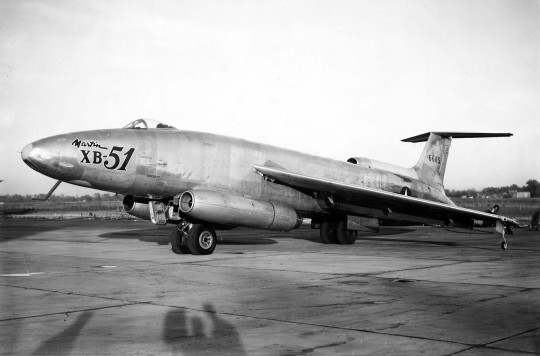
In 1945, the USAAF issued requirements for a light bomber, to which Martin responded with a six-man composite powerplant design which would be contracted as the XA-45. However, soon after the contract was placed, the program requirements were heavily revised, calling for all-weather close air support operations. Martin heavily revised the design, turning it into a three-engined jet-powered bomber with a crew of two. Meanwhile, the “A” designation had been dropped, so the new bomber was designated XB-51. The revamped bomber was to carry eight 20mm cannon and a payload of 4,000lb, along with equipment to make use of the SHORAN navigation system. The bomber itself made use of an incredibly unconventional layout. Fitted with three J47 engines, the XB-51 mounted two of the powerplants low on either side of the nose, while the third was placed in the tail. The 35 degree swept wings were fitted with a variable-incidence mechanism to improve takeoff performance, but the unusual mechanism forced Martin to work with bicycle landing gear. The bomb bay itself was a unique rotating design with a maximum payload of 10,400lb.
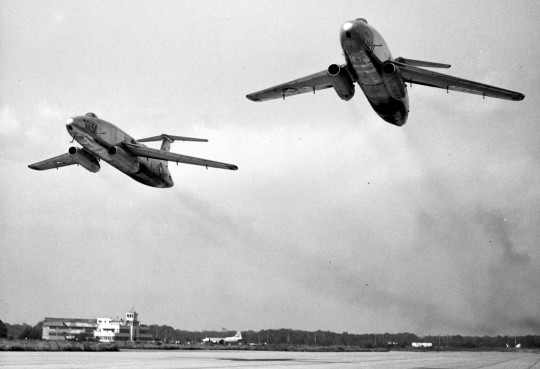
Two XB-51 prototypes were made, the first of which flew in November 1949. As testing began, the Air Force began a new program to procure a night intruder, with the XB-51 emerging as a favored design alongside the English Electric Canberra. XB-51 testing generally went well, with the bomber demonstrating excellent low-level maneuverability and a substantially higher top speed than the Canberra. Unfortunately, the better performance hid some operational failings. The Canberra had a considerably longer range than the XB-51, and elements of the XB-51 design, notably the low-mounted forward engines and bicycle landing gear, were considered unsuitable for the forward airfields the XB-51 was expected to be operating from. Ultimately, the Canberra was selected as the winner of the program, and the XB-51 was cancelled. It was not a complete loss, however, as the Canberra production contract was given to Martin, who incorporated elements of the XB-51 - notably the rotating bomb bay - into production Canberra variants.
Boeing B-52 Stratofortress
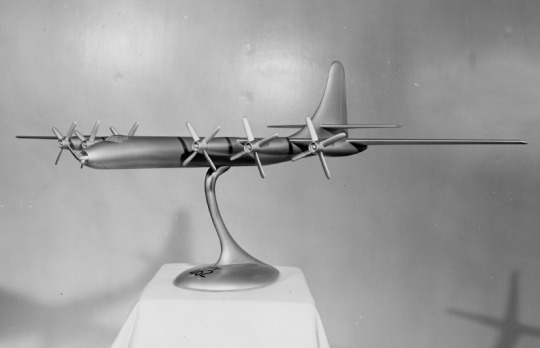
Though the products of the USAAF’s previous long-range bomber program (the XB-35 and XB-36) had yet to fly, the USAAF would issue requirements for a replacement in later 1945. Formal specifications issued in February 1946 called for a bomber with five or more gunners, a six-man relief crew, cruise speed of at least 300mph, operational radius of 5,000 miles, and payload of 10,000lb. Boeing, Consolidated, and Martin would all submit proposals, with Boeing’s Model 462 declared winner in June of 1946. Contracted as the XB-52, the Model 462 was hardly an ambitious design. Coming in at a gross weight of 360,000lb, it was to be powered by six T35 turboprops and have an operational radius of just over 3,000 miles. Though it had won the contract, the Air Force soon expressed concerns over the projected size of the aircraft and its inability to meet specified range requirements, so Boeing scaled it down to the Model 464, which came in at just 230,000lb and mounted four engines. This was soon reversed, however, as requirements were revised once more in late 91946 to call for a 400mph cruise and range of 12,000 miles with a nuclear payload. The final iteration of the Model 464 selected for further development, the Model 464-17, carried the same T35 turboprops, but came in at a whopping 480,000lb.
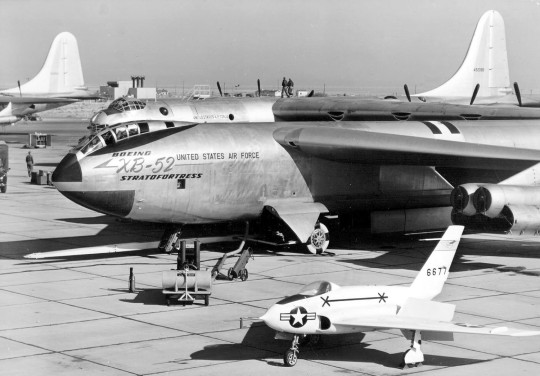
Unfortunately, the Air Force was unenthusiastic about Model 464-17. Boeing continued to refine the design, introducing a 20 degree swept wing, more powerful turboprops, and reducing defensive armament to just a single tail gunner position, but interest continued to wane. The start of the Berlin Blockade in 1948 revived interest in the XB-52, but the bomber still fell well short of Air Force hopes. In October 1948, a Boeing design team went to Wright-Patterson AFB to present the latest iteration of the bomber, only to be told that the Air Force was no longer interested in a turboprop bomber - they wanted an all-jet machine. Frantically reworking their proposal, the Boeing design team successfully produced a new design that would meet the requirements. Fitted with a shoulder-mounted 35 degree swept wing much like the B-47, the bomber would carry eight J57 turbojets in four underwing nacelles. After a day of intense design work, Boeing employees presented the Model 464-49 to the Air Force in the form of a 35-page proposal and a hastily made balsa wood model. The USAF was very interested in the proposal, and in 1949 production of two prototypes began. Though the Air Force continued to waffle, SAC leadership remained enthusiastic about the new design, and in early 1951, a contract for 13 pre-production B-52As was placed.

The XB-52 prototype was rolled out in late 1951, but a failure of the hydraulic system during ground testing meant that the first B-52 flight wouldn’t take place until the YB-52 was ready in April 1952. In many ways, the YB-52 resembled a scaled-up B-47, sharing the same general layout, fighter-style cockpit, and tandem undercarriage. A spacious bomb bay spanned much of the fuselage, and a substantial crew was included to keep workload manageable. In the tail, a gunner manned a position with four .50s, and a weapon systems officer and navigator would support the pilot and copilot. While the B-52 prototypes were fitted with the fighter-style canopy of the B-47, the three pre-production B-52As would revert to a more conventional canopy, giving the bomber its distinct appearance. While 13 B-52As had originally been ordered, the final 10 aircraft of the order would be completed as B-52Bs, differing primarily in that they were fully combat capable rather than mere evaluation machines.
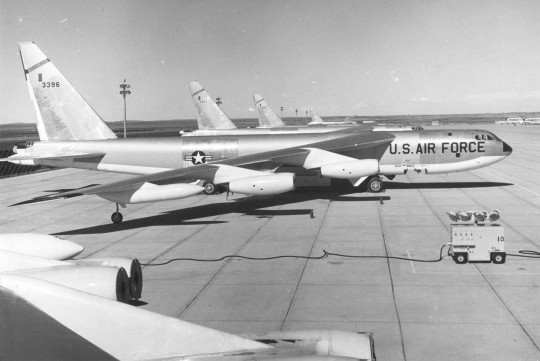
The first B-52 squadron became operational in March 1955, slowly replacing the B-36. Though the new bomber actually had a smaller payload capacity than the massive B-36, it presented a massive improvement in performance over the older bomber, and, with the rapidly shrinking size of nuclear warheads, the decrease in capacity soon became a non-issue. Like most aircraft, early service was plagued with teething problems, particularly with the advanced bombsights and navigational systems, but the B-52 would quickly become the backbone of SAC’s nuclear deterrent. In 1956, the B-52 became the first aircraft to drop a thermonuclear bomb during the Operation Cherokee tests, and in their early years they would go on to set several records in their class. As part of SAC’s policy of airborne alerts, through the end of the ‘50s and much of the ‘60s the B-52 was kept on constant alert, with roughly a third of the fleet airborne with nuclear weapons at any time. Unfortunately, this led to several notable accidents involving nuclear weapons, including a crash over Spain where two weapons had their casings broken, requiring an extensive cleanup effort. As a consequence of the multiple high-profile crashes, SAC ended the airborne alert system in 1968. B-52s still waited on alert, but such alerts were now with aircraft on the ground standing by to sortie.
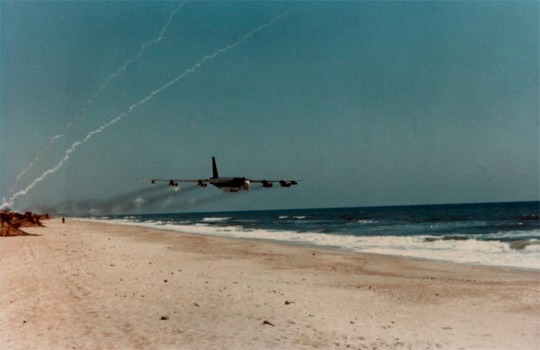
By the end of the ‘50s, the advent of surface-to-air missiles had forced a sudden shift in strategic bomber doctrine towards low-level penetration and the use of standoff missiles. Starting in 1959, the B-52 fleet underwent an upgrade program to allow them to carry the AGM-28 standoff missile and ADM-20 Quail decoy, along with avionics upgrades that added an advanced ECM suite and the ability to fly all-weather low-level operations. Though the B-52 proved better suited to low-level operations than supersonic bombers like the B-58 or (still in development) B-70, the new flight profile took a heavy toll on airframes. Denser air at lower altitudes caused more strain on airframes than the aircraft were originally designed for, and, as the B-70 program was cancelled in 1961, there was a great deal of concern among the USAF over the viability of the rapidly aging fleet with no prospects of a replacement.

Though the B-52 was primarily intended to serve as a strategic weapon, escalating tensions in Southeast Asia in 1964 saw the USAF approve a conversion of several B-52Fs to carry conventional munitions. The refit added multiple ejector racks on the pylons originally added to deploy AGM-28s, while the bomb bay was also configured for conventional bombs. After the refit, the bombers were capable of carrying a total of 51 750lb bombs. In 1965, these B-52Fs were deployed to Guam, where they would operate out of to perform their strikes. Unfortunately, the deployment was hamstrung by politics. SAC and the White House were unwilling to risk the bombers over North Vietnam, so while the strategic bombing campaign was handled by tactical bombers, B-52s were used in tactical strikes under the codename Arc Light. Initial Arc Light strikes were a disaster. The very first mission, involving 27 B-522s, resulted in the loss of two B-52s in a mid-air collision with no effect on the ground, as the enemy had already left the area long before the bombers had arrived. While later missions would have a better record, operational issues remained, particularly in the insistence that the approval for every single mission had to come from the White House.

As the Arc Light strikes continued, however, practices improved. The chain of command was shifted so that the bombers only needed the approval of the Joint Chiefs of Staff, and larger raids gave way to smaller, spread-out missions that allowed for the bombers to hit multiple targets at a time. The scope of operations slowly expanded, with the bombers flying some 300 sorties a month and eventually ranging across most of South Vietnam, Laos, and even parts of North Vietnam. Meanwhile, the Air Force began the Big Belly upgrade, modifying the B-52 fleet to bring their total conventional payload capacity to a whopping 60,000lb. As Rolling Thunder raged on, the effectiveness of the B-52s only continued to improve. The introduction of the Combat Skyspot bombing system, which worked with ground radar stations to guide the bombers to targets, allowed the B-52s to perform close air support missions. In 1967, B-52s were deployed to Thailand, allowing for the bombers to conduct operations more quickly. The impact of these changes would be most apparent at the end of Rolling Thunder during the Khe Sanh siege, where B-52s flying in support of the base turned the area surrounding the fort into a cratered moonscape.
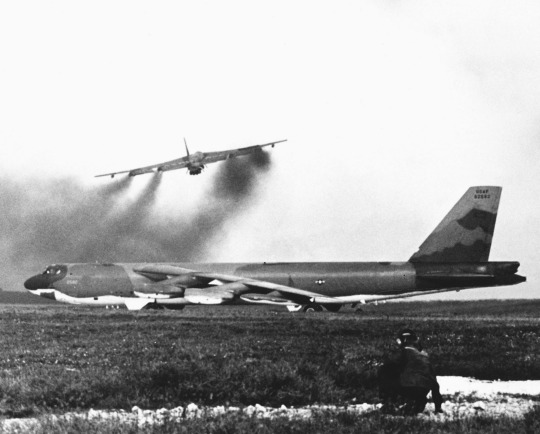
Though Nixon’s policy of Vietnamization would see a drawdown of B-52 operations starting in 1968, this trend would rapidly reverse in 1972, when the North Vietnamese launched an offensive across the DMZ. In response to the invasion, Nixon launched Operation Linebacker. The 206 B-52s deployed as part of the offensive again flew primarily tactical strikes, making use of years of refined tactics to smash the NVA offensive. Linebacker gradually drew down until after the election that November, but, as Nixon lost his patience with the North Vietnamese belligerence in negotiations, he ordered the most intensive bombing campaign of the war - Linebacker II. Starting on December 18, 1972, Linebacker II put the B-52 on the forefront of the campaign. No more were the bombers flying tactical strikes, but instead they were going straight to Hanoi. 48 bombers were supported by F-4s flying CAP and laying chaff, F-105s flying Wild Weasel, EB-66s with jamming support, and EC-121s keeping their eyes out for enemy fighters. Over 12 days, B-52s flew 729 sorties, dropping 15,237 tons of bombs on strategic targets in North Vietnam. For their efforts, they managed to down two hapless MiGs with their tail guns, while 15 B-52s were downed by air defenses and another five heavily damaged. Despite the losses, Linebacker II was devastatingly effective. The North Vietnamese were forced to the negotiating table, allowing a ceasefire to be signed in January 1973, ending American involvement in Vietnam. Arc Light strikes continued across the region into the middle of 1973, but for the most part, the war in Vietnam was over.
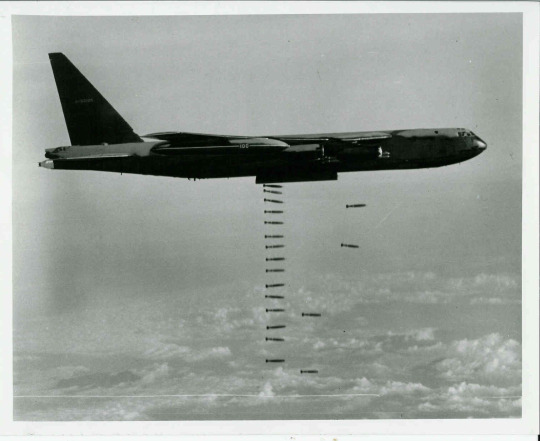
By the ‘70s, much of the B-52 fleet had reached the end of its service lives. Newer variants were overhauled, while the older part of the fleet was retired. A new round of upgrades integrated the B-52G and -H models with the SRAM nuclear missile and SCUD decoy, and added such features as an improved ECM suite and an electro-optical viewing system with FLIR. By the early ‘80s, the B-52G and -H would form the bomber arm of America’s strategic deterrent. The bombers remained on constant standby in the same ground-standby practice that had been adopted in the late ‘60s. Meanwhile, the USAF had moved to supplement the bombers with FB-111s as an intermediate-range stopgap until a suitable replacement for the B-52 could be developed. Unfortunately, the next effort to replace the B-52 would be hamstrung by politics. The B-1, intended to serve as a supersonic replacement for the B-52, was briefly cancelled before being revived with a slashed order. The result was a force of new bombers only large enough to replace the FB-111, meaning the B-52 would soldier on. Though the end of the Cold War and signing of the START treaties would see a massive drawdown of the B-52 fleet, the bomber would soldier on into the new millennium, surviving not only the B-1 program, but the B-2 as well.

In 1991, the B-52 was called into action once more when Iraq invaded Kuwait. On January 17, 1991, seven B-52Gs would take off from their base in Louisiana, marking the first combat sortie of Operation Desert Storm. Flying for a total of 35 hours, they launched 35 cruise missiles aimed at command and control targets across Iraq. Later that day, B-52s also performed their first combat low-level mission, targeting four airbases and a highway. Once the Iraqi air defense network fell apart, B-52s reverted to conventional high-altitude bombing missions. As part of the psychological warfare conducted during the war, B-52s would alternate between bombing and dropping leaflets, warning Iraqi troops that a raid was coming the next day and following through with the threat. The result was devastating to Iraqi morale, with many surrendering Iraqi troops talking with interrogators about their dread of the bomber. Over the course of the war, B-52s flew 1,600 sorties, dropping 25,000 tons of bombs. No B-52s were lost in action, although two were hit by SAMs and another hit by a HARM after the missile locked onto the radar of the tail gun.
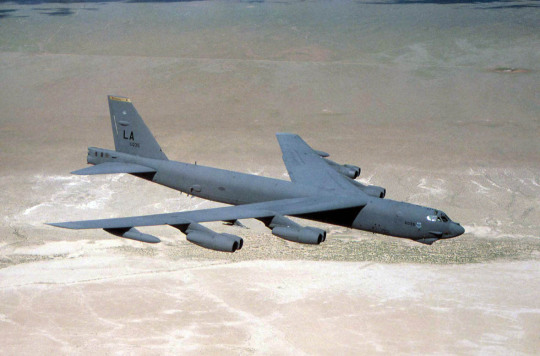
Following the end of the Gulf War, much of the B-52 fleet was retired owing to the post-Cold War drawdown. However, those that remained in service would get yet another overhaul to keep them flying. The B-52G was retired from service, leaving only the B-52H. The B-52 fleet would get another round of upgrades, removing the tail gun (a consequence of the HARM hit in the Gulf War), adding new navigation and communication systems, and integration with the newest guided munitions, particularly the JDAM and JSOW guided bombs. In the years since the Gulf War, the B-52 has continued to see action, flying over Iraq in 1996 (Operation Desert Strike), Yugoslavia in 1999 (Operation Allied Force), and Operations Enduring and Iraqi Freedom in 2001 and 2003, respectively. Though the Air Force had originally planned to replace the B-52 with the B-1 and B-2, the low numbers of those bombers has meant that the B-52 remains in heavy use. Though its age is showing, giving it a higher per-hour flight cost than the B-1, it has consistently shown the highest mission-capable rate of all USAF bombers. The USAF intends to eventually replace the B-52 with the Long Range Strike Bomber, but the retirement of the B-52 is still very far off - current plans call for the B-52 to be flying until 2045.
Convair YB-60
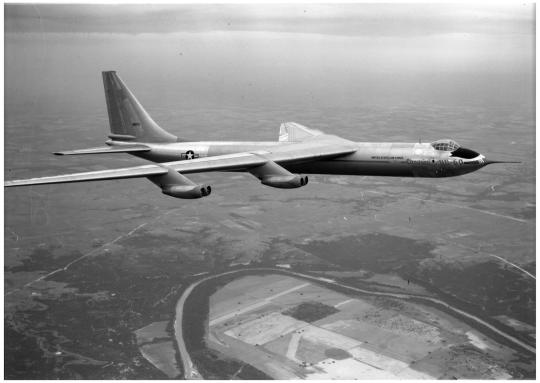
In 1950, as the B-52 program was facing resistance from multiple angles, Convair pitched a proposal to develop an all-jet variant of the B-36F as a cheaper alternative. Proposed as the B-36G, Convair was contracted to convert two B-36Fs to the new standard. The conversion was extensive, involving the fitting of entirely new swept wing and tail surfaces, along with eight turbojet engines, a new nose, and extended tail. As the proposal materialized, the bomber quickly lost its commonality with the B-36, leading to the USAF changing the designation to YB-60. The first YB-60 would fly in April 1952, just three days after the competing B-52 made its first flight. Flight tests were initially successful, with the bomber demonstrating good handling. Unfortunately, the bomber couldn’t compete with the B-52. Though no official flyoffs were ever held, the B-52 clearly outperformed the YB-60, being well over 100 mph slower than its Boeing competitor. The YB-60 did offer a higher payload capacity, but the shrinking size of nuclear weapons meant that the difference in payload was less of a concern than the performance disparity. Ultimately, in January 1953, the Air Force cancelled the YB-60 contract. The second prototype, being over 90% completed, was never flown, and ultimately, both prototypes were scrapped by the end of June 1954.
Martin B-57 Canberra

With the outbreak of war in Korea, the USAF quickly developed a new requirement for a jet-powered interdictor to replace the A-26. While several domestic designs were considered, including the XB-51, the USAF also looked abroad, considering the British English Electric Canberra bomber. The Canberra and XB-51 would quickly emerge as frontrunners in the program, with the Canberra ultimately winning the production contract owing to its longer range and more conventional layout. However, English Electric lacked the production facilities to meet the USAF order for 250 aircraft in a timely manner, so the design was licensed, with Martin producing the bomber as the B-57. A Canberra B.2 was delivered in 1951 to serve as a pattern aircraft, and the first B-57A would be rolled out in 1953. At a glance, the B-57A was identical to the Canberra B.2, retaining its distinctive fishbowl canopy. However, it included several changes, including more powerful J65 engines in place of the Rolls-Royce Avons, and a reduced crew of two with the cockpit moved forward.
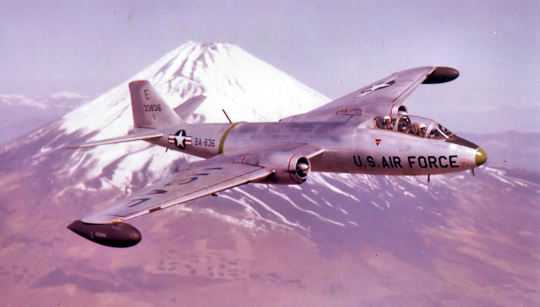
Ultimately, only eight B-57As would be built, with the bulk of early production instead being RB-57As. None of these early-production B-57s would see little operational use, instead being used for development of a more fleshed-out variant. The first definitive production variant would be the B-57B, which took on the distinctive appearance that the B-57 would hold through its career. The rotating bomb bay developed on the XB-51 was applied to the bomber, and four stores pylons were added under each wing for a total payload of 10,000lb. Four .50s were mounted in each wing, and avionics upgrades included the AN/APW-11 bombing system and a radar warning receiver in place of the tail radar on the B-57A. Most important, however, was the new cockpit. The ugly fishbowl canopy and “coal hole” radioman’s position - originally designed for high-altitude operations - was completely reworked, with a tandem fighter-style cockpit fitted instead.

Despite the unsatisfactory nature of the B-57A, the RB-57As would be the first variant to see operational use. RB-57As were deployed to Japan and Europe, with heavily modified variants taking part in reconnaissance missions over Europe. Two RB-57As were delivered to the Republic of China in the late ‘50s, allowing for overflights of mainland China to begin. However, both would be lost to Chinese air defenses by 1959. That same year, Martin began modifying surviving RB-57As, which were now being phased out of service, into ECM platforms. Redesignated EB-57A, the bombers were fitted with ECM equipment in their bomb bays, allowing them to serve effectively in training units. As the RB-57A was retired, the reconnaissance role was passed on to the RB-57B and the significantly refined RB-57D.
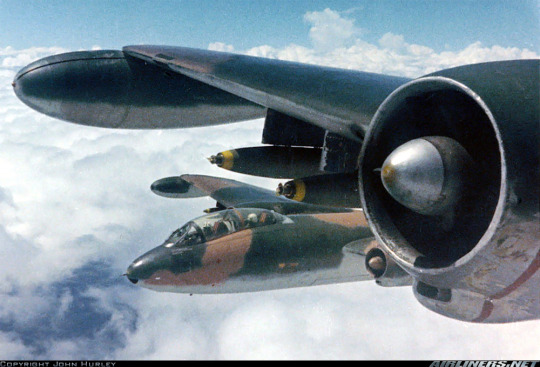
In 1964, two squadrons of B-57Bs were deployed to Bien Hoa in South Vietnam to support the local government. Early operations were limited by politics, with bombers only flying reconnaissance missions. Unfortunately, base security was lax, and ate that year five B-57Bs would be destroyed in a mortar attack. With the escalation of American involvement in 1965, the B-57 finally began flying strike missions. In March 1965, they flew their first mission into North Vietnam, and by April, they were relegated to the efforts to interdict the Ho Chi Minh Trail. Missions were flown at night on both sides of the border, requiring the deployment of flares to illuminate the targets owing to the lack of any all-weather equipment on the bombers. Unfortunately, the rapidly improving North Vietnamese air defenses would force the cross-border missions to be curtailed, and by Fall 1966, the B-57B was withdrawn from missions into North Vietnam.
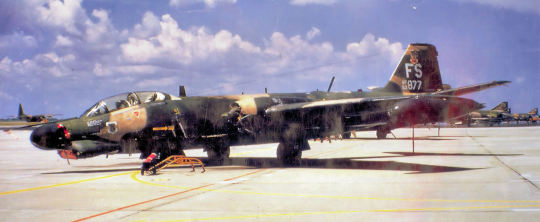
Though the B-57B would bear the brunt of early operations, it had proven lacking for night operations. In 1967, three B-57Bs were fitted with low light TV systems for operational trials, performing well enough for a more fleshed-out variant - the B-57G - to be ordered. 16 B-57s were converted to the new B-57G standard, entailing the installation of an AN/APQ-139 radar, LLTV system, FLIR, and a laser targeter for guided bombs. Because of the added weight, the gun armament was deleted. 11 B-57Gs would be deployed in 1970 to Thailand, beginning strikes that year. The results of the operations were mixed. The B-57G was tremendously effective when it was in the air, but the advanced systems mounted on the machine were horribly unreliable, making serviceability low. They would fly on in the theater until 1972, losing only one of their number to enemy fire. Meanwhile, B-57Bs had long since been withdrawn. After attrition reduced their force to a mere shadow of its former glory, the B-57Bs had been withdrawn in 1959. 51 of 94 B-57Bs sent to Vietnam were lost, and only one of the B-57s in the first deployment would survive the war.

The end of American involvement in Vietnam effectively marked the end of B-57 operations by the USAF. B-57Bs had been retired before the war was even over, and the last B-57G left service in 1974. EB-57Es, optimized for all-weather reconnaissance, would soldier on until 1982, but their use was limited in the post-Vietnam USAF. Pakistan would be the only foreign operator of the B-57, flying 24 B-57Bs and two B-57Cs starting in 1959. They would make their combat debut in the 1965 war with India, flying 167 sorties and dropping 600 tons of bombs for the loss of three of their number. By relocating the bombers after every sortie, the PAF managed to keep the bombers safe from IAF fighters, while their own B-57 operations would prove quite successful at disrupting IAF operations. In the 1971 war, they again went into action, hitting 12 IAF runways on the first night of the war. Through the remainder of the war, they flew primarily night missions, but they would be far less successful than six years’ prior, losing five bombers to enemy action. The PAF B-57s would be retired in 1985, becoming the last B-57s to leave service.
Douglas B-66 Destroyer
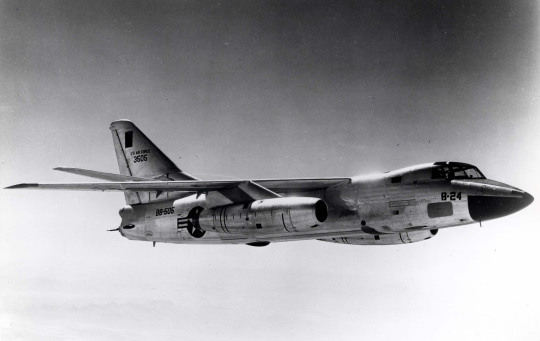
Parallel to the program that resulted in the B-57, the USAF launched a similar requirement for a tactical bomber, leading to Boeing, North American, Martin, and Douglas all submitting proposals. All proposals were based off of existing designs, though the Douglas proposal was the only one based off of an aircraft that was yet to fly - the Navy’s A3D Skywarrior. Contracted as the B-66 in November 1951, the bomber was to be a simple de-navalization of the A3D with a payload of 10,000lb of conventional or nuclear stores or a reconnaissance kit and an operational radius of 1,000 nautical miles. The reconnaissance RB-66 variant was given priority, and, as the design was to be a simple conversion of the A3D, no prototypes were ordered. Instead, five pre-production RB-66As were ordered.
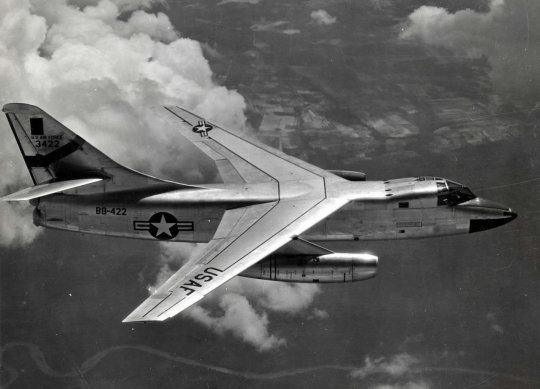
Unfortunately, changing requirements soon meant that the B-66 would require significant development. While aspects like the general layout, defensive turret, and three-man crew remained, the bomber required major structural changes. The cockpit had to be completely redesigned to accommodate new ejection seats, and, requirements for low-altitude operations meant that the wings and airframe had to be significantly strengthened. An all-new wing was developed with a new airfoil section and larger area, and a larger radar required a new nose. Thanks to requirements for rough-field operations, the wheels also had to be enlarged, and, owing to concerns over the availability of the J57 engine the A3D used, the Air Force changed over to the J71. The result was an aircraft that superficially looked very similar to the A3D, but was in fact almost an entirely new design. Such changes meant that the first B-66 wouldn’t fly until mid 1954.
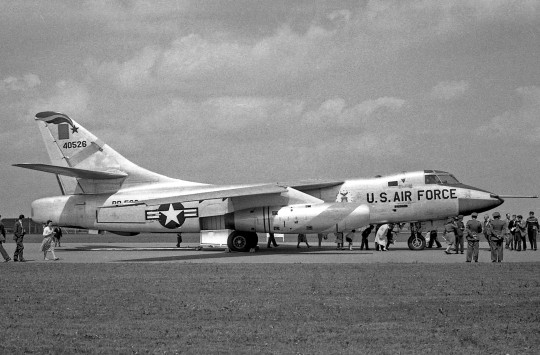
Deliveries of RB-66Bs began in 1956, with a total of 145 RB-66Bs and 72 B-66Bs built. All examples would go into service with the Air Force’s Tactical Air Command, becoming TAC’s primary night reconnaissance platform. Despite being designed for tactical reconnaissance and bombing, however, the B-66 would end up in the niche EW role. In 1955, the first RB-66C was flown, fitted with an extensive ECM array including jammers, chaff pods, and a crew of seven (including four EWOs in the bomb bay). The operational debut of the B-66 came during the Cuban Missile Crisis, when the jammer variants were used to support the blockade.

As the war in Vietnam escalated, the demand for EW assets skyrocketed, spurring the conversion of 13 B-66Bs and 52 RB-66Bs for EW duties. In 1966, the new jammer aircraft were redesignated EB-66. Flying solely as jammers in the war, they EB-66 would initially be used to provide jamming support for strike packages. However, it was slow compared to the fighters t often flew alongside, and as dedicated jammer equipment was developed for the fighters to carry, the EB-66s were withdrawn from these escort missions. EB-66s would also fly ELINT and larger-scale jamming missions over North Vietnam early in the war, but after one was downed by a MiG, they were withdrawn south of the border. They continued to fly standoff jamming missions from the relative safety of South Vietnam, blinding long-range North Vietnamese early warning radars. Though they returned to a more active role during Operation Linebacker II when they supported the B-52 raids, they were rapidly losing their utility. With the end of the war in Vietnam, the EB-66 was gradually phased out, and in 1975, the last EB-66s were retired.
Aircraft Nuclear Propulsion
In 1946, the USAAF started the Nuclear Energy for the Propulsion of Aircraft project to investigate the feasibility of a nuclear-powered bomber. After five years of studies, the program was replaced by a full development project in May 1951, known as the Aircraft Nuclear Propulsion. Based on the NEPA studies conducted, contracts were handed out to Convair and Lockheed to develop nuclear-powered bomber testbeds. Though tentatively bombers, these design studies were more intended to be testbeds to investigate the feasibility of a nuclear powerplant on an aircraft. As such, the designs were hardly practical in a military sense. Convair’s proposals centered around the obsolete B-36 strategic bomber, and, while Lockheed’s original design may have had more of a military focus, it too was little more than a technology demonstrator.
Convair X-6/NB-36H

Convair’s nuclear testbed proposal, the X-6, was designed around the B-36 airframe. Final plans called for the X-6 to mount a P-1 reactor in the fuselage to provide power to X-39 engines (nuclear-powered variants of the J47 turbojet). Owing to the safety and weight concerns with operating a reactor in the air, it was decided to first convert a B-36 to test the general feasibility of an airborne reactor. A single B-36 was converted for the role as the NB-36H, with the nose completely reworked to hold an 11 ton lead and rubber-lined crew cabin complete with foot-thick lead glass to keep the crew safe from radiation. In the aircraft’s spacious bomb bays, a single three-megawatt reactor was placed. The reactor would run during testing, but it would not power any systems in flight. Flight tests began in September 1955, with the reactor running for the first time in February 1956. A total of 47 flights were flown, ending in 1957. By then, however, interest in a nuclear bomber was waning, and tests seemed more concerned with the effectiveness of the shielding than the feasibility of the airborne reactor. The budget for the ANP had been slashed by 50% in 1953, and in 1958, the NB-36H was scrapped, putting an end to the ANP.
Lockheed CL-225
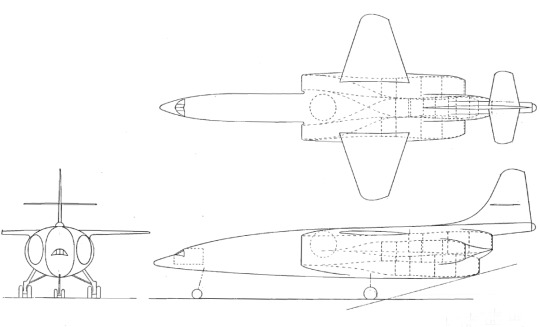
Lockheed’s nuclear aircraft concept, the CL-225, was a considerably more ambitious proposal. Sharing the same stubby wings and T-tail layout of the F-104, the CL-225 was a portly machine designed around a reactor developed by Pratt & Whitney. Two layers of radiation shields were designed - the first surrounding the reactor in the center of the aircraft, and the second protecting the crew in the extreme nose. The reactor was to power four engines mounted around the fuselage, and a payload bay was provided between the reactor and the cockpit. Projections called for the CL-225 to attain supersonic speeds, but, unsurprisingly, the ambitious project would never leave the drawing board, failing to even make it to the mockup stage.
Martin XB-68
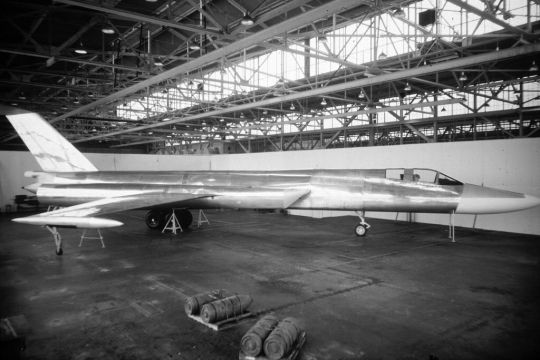
In 1952, the USAF issued requirements that became known as Weapon System 302A, calling for a supersonic intermediate-range strategic bomber. North American, Douglas, and Martin all submitted proposals, with Martin’s Model 316 winning the design competition in 1956. Contracted as the XB-68, the bomber was expected to reach operational service by the early ‘60s. The XB-68 was unusually small given the requirements, coming in at a max takeoff weight of just over 100,000lb. It was of primarily steel construction, and was vaguely reminiscent of the F-104, with stubby trapezoidal wings and a T-tail. Power was to come from two J75 turbojets, and a crew of two was to be placed in a tandem cockpit. Plans called for a top speed of Mach 2 and an operational radius of 1,250 miles with a 3,700lb nuclear payload. Unfortunately, the project rapidly ran into issues with the inertial guidance bombing and navigation system, delaying the planned introduction of the bomber. Meanwhile, the Air Force was hit with major budget cuts, and in 1957, the bomber contract was cancelled.
Weapon System 125A
As interest in a nuclear-powered bomber increased, the USAF issued full-fledged requirements for a nuclear bomber under the designation Weapon System 125A. Issued in 1954, it continued to leverage upon ongoing research by Convair and Lockheed to create a fully combat-capable weapon system. Initial requirements called for a cruise speed of Mach 0.9 with the highest possible dash speed over the target, and a design capable of entering service by 1963. In 1956, Convair would team up with GE, while Lockheed joined Pratt & Whitney to jointly develop an airframe and reactor system for the project. The project seemed promising at first, with the WS-125A given the same priority (but a fraction of the budget) as the Atlas ICBM project. However, interest waned alarmingly quickly. Despite the successful demonstration of the X211/J87 nuclear-powered turbofan in 1956, the Air Force would convert the program to a pure research project in late 1957, ultimately splitting it at the end of 1958 into a four-phase program for the development of a variety of nuclear-powered aircraft. Development continued on with low priority until 1961, when all funding for nuclear propulsion was removed. The reasons behind the cancellation were numerous, ranging from the higher than expected weights, failures to meet performance objectives, and safety concerns with operating the aircraft.
Lockheed WS-125A

Lockheed’s WS-125A proposal leveraged off of their work with the ANP program. Coming in at a whopping 600,000lb gross weight, the bomber was powered by a single 320 megawatt nuclear reactor driving six turbojet engines. The general layout of the CL-225 was to be retained, but a much flatter profile was to be used. The exact details of the propulsion system are unclear, it’s likely that the design used a closed-cycle engine rather than the open-cycle engine Convair and GE successfully lobbied for. This system would ideally provide more efficient heat transfer t o the engines, but at the cost of increased complexity and weight. Unfortunately, Lockheed’s WS-125A proposal would not leave the drawing board.
Convair WS-125A
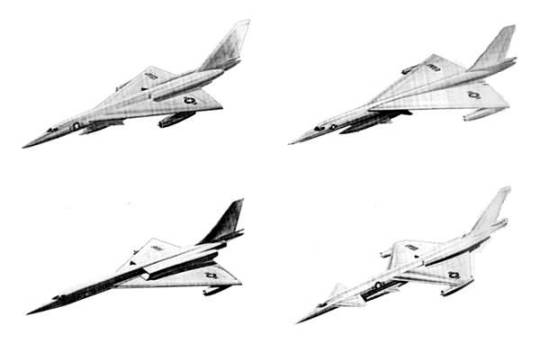
Convair’s WS-125A proposals were equally ambitious, making use of many elements developed for the B-58 conventional supersonic bomber. Most details are unclear, but it appears that a variety of layouts were examined, generally retaining the basic tailless-delta layout of the B-58 with different engine configurations. Convair originally had planned to implement a much safer liquid-cooled closed-circuit reactor for the aircraft’s powerplant, but, as the complexity of the proposal increased and it became apparent that this would make meeting the deadlines impossible, Convair and GE successfully lobbied to be allowed to use a much simpler direct-cycle engine. Though Convair and GE would manage to demonstrate the planned J87 powerplant at near full power, this phase of the design project came to an end in 1956 as the Air Force lost favor in the WS-125A.
Weapon System 102
In 1949, the Air Force issued the Generalized Bomber Study (GEBO II), which aimed to create a supersonic intermediate -range bomber to replace the B-47. Boeing, Convair, Curtiss Douglas, Martin, and North American would all submit bids. GEBO II requirements were finalized in April 1950, calling for a bomber with a range of 4,500 nautical miles and a cruise speed anywhere from Mach 0.9 to 1.5. Boeing and Convair emerged as the victors of the initial round of proposals, with their designs receiving project designations MX-1965 and MX-1964, respectively under the program name WS-102. In mid-1952, the designs were finally given operational designations, with Convair receiving XB-58 and Boeing XB-59. Development continued in parallel until October 1952, at which point Convair was declared the winner of the full development contract.
Boeing XB-59

Boeing’s XB-59 would emerge as a surprisingly conventional bomber design. Powered by four J73 turbojets buried in the wing roots, the XB-59 carried over staples of early Boeing jet bombers, including bicycle landing gear and a shoulder-mounted wing. A crew of three was to be carried in the nose, just as in the B-47, with defensive armament of a single cannon operated remotely placed in the tail. Following design requirements, the XB-59 was designed with a 10,000lb payload in mind and a Mach 2 dash speed. Unfortunately for Boeing, the Air Force favored Convair’s more radical approach, which offered better performance projections and a lighter airframe. Convair was selected as the winner in October 1952, and development of the XB-59 came to an end.
Convair B-58 Hustler

Convair’s original proposal for the GEBO II requirements was an unusual parasite bomber concept, relying on a B-36 to carry a fairly small vehicle near the target area before being released for a supersonic attack run. Fortunately, these concepts gave way to a far more feasible concept that would eventually become the B-58. Designed around a tailless delta wing layout, the bomber would make use of four J79 engines. Convair, recognizing the performance penalty that would come from making the bomber large enough to carry its payload internally, instead developed an external pod that would carry weapons and fuel for the bomber, allowing the clean aircraft to remain sleek and aerodynamic. The fuselage was area-ruled, and, after going through several different engine configurations, Convair settled on hanging each engine individually under the wings. A crew of three would sit in tandem in an incredibly advanced cockpit, complete with their own individual ejection pods, and a remote-controlled 20mm cannon would be mounted in the tail.
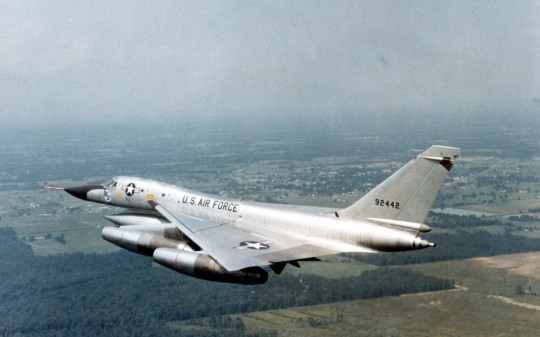
Though Convair was declared winner in 1952, it would be some time before the B-58 would fly. The incredibly advanced design unsurprisingly hit delays, and, as the scheduled first flight kept getting pushed back, the program began to hit resistance from the USAF. By the mid-50s, the B-58 was very controversial. SAC was moving towards ICBMs, and, with a range only half that of the B-52, the B-58 seemed to have limited utility. Worse, the B-58 was already incredibly expensive, and it would only get moreso. Nevertheless, the B-58 advocates would win out, with the XB-58 finally flying for the first time in November 1956. Testing took three years and took 30 pre-production machines, owing to the advanced nature of the aircraft and its associated systems, but by 1959, it was finally materializing. The first deliveries began in early 1959, and by the end of the year it was demonstrating incredible performance, achieving a climb rate of over 200 m/s and holding Mach 2 flight for a full hour.
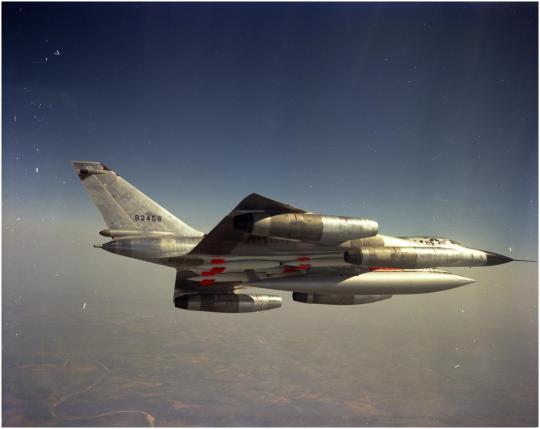
The 30 trial machines created would be followed by 86 production B-58s, with deliveries ending in 1962. Most trial machines were brought to operational specifications, though eight were converted to trainers. The B-58 would have a mixed reputation in service. It was undoubtedly an incredible aircraft, with performance better than most fighters of the time, and it was surprisingly maneuverable despite its size. However, it was tricky to fly owing to the high sweep of the delta wing, and it had unusual stall characteristics that made flying the aircraft at low speeds and altitudes incredibly dangerous. Even with the development of trainers, the B-58 suffered from a high accident rate, losing 26 of their number over the course of the bomber’s service. Also, the bomber was absurdly expensive to fly, with the two B-58 wings costing just as much as six B-52 wings.
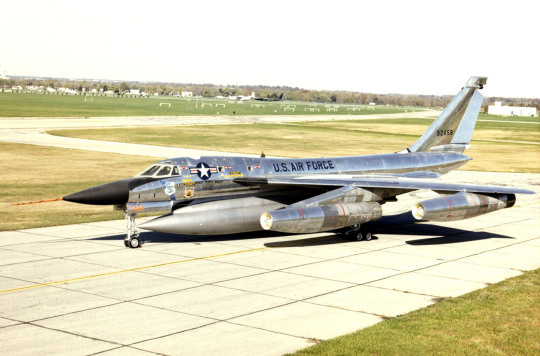
By the mid ‘60s, the advent of surface to air missiles meant that the B-58’s high-speed, high-altitude approach path was no longer feasible. The bomber was capable of operating at low levels, but it could not fly supersonically while doing so, and the new flight profile further cut into the bomber’s range. With the B-58 having lost the one niche it held, its days were numbered. In 1965, McNamara ordered the bomber retired by 1970. It would leave service on schedule, having never fired a shot in anger. Though the Air Force had examined the possibility of using the B-58 in Vietnam, they decided against it, as the bomber could only carry a modest payload and was absurdly expensive to operate. Thus, the B-58 would live out its brief career as a sleek but ineffectual strategic asset.
Continuously Airborne Missile-launcher and Low-level Weapon System
Though the original WS-125A requirements had proven far from feasible, there remained considerable interest in the Air Force relating to the expected endurance of a nuclear-powered aircraft. In 1958, the CAMAL program was launched, calling for a subsonic nuclear-powered aircraft with an endurance of 120 hours and a payload consisting of several missiles or gravity bombs. As with previous projects, contracts were handed out to the Lockheed/Pratt & Whitney and Convair/GE teams. The CAMAL program was considerably more realistic in its goals than the previous phase of the WS-125A, but nevertheless it ran into the same problems, particularly owing to operational safety concerns.
Lockheed GL-232
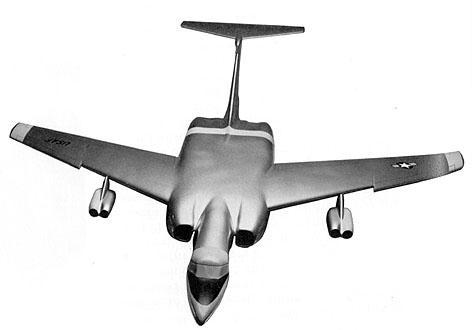
Lockheed’s GL-232 proposal would be a swept-wing design with a conventional T-tail, powered by a mixed propulsion of conventional jet and nuclear engines. Fitted with two XMA-1 nuclear reactors, the bomber would be supplemented by four conventional jet engines slung under the wings to assist in takeoffs. Unlike Convair’s proposal, the GL-232 would make use of a closed-cycle engine, which circulated liquid metal from the engine to heat exchangers in the engine. Elements of previous designs, particularly the two-stage radiation shielding, were also carried over to the GL-232. Unfortunately for Lockheed, the GL-232 would not be selected as the winner of the design competition, so the project was dropped.
Convair NX-2
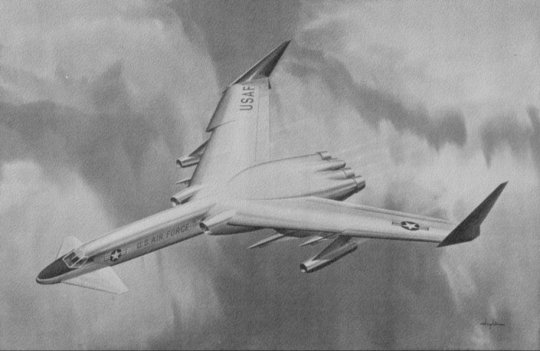
For the CAMAL requirements, Convair would produce a tailless canard design under the internal designation Model 54. The centerpiece of the Model 54 was to be three XNJ140E nuclear turbojets in the rear fuselage for cruising flight, while two conventional J75 turbojets were to be carried under the wings to assist in takeoff and landing. Coming in at 260 tons, the bomber was slightly smaller than the supersonic proposals from the first phase of the WS-125A competition. The Model 54 would end up winning the initial development contract, leading to extensive scale testing. Unfortunately, though the bomber got as far as scale wind tunnel testing in 1960, it wouldn’t survive to the end of the year. In late 1960, the program was cancelled in light of a doctrinal shift towards ICBMs, and in January 1961, Secretary of Defense McNamara definitively cancelled all nuclear aircraft projects.
Weapon System 110A
In 1954, the USAF began the next stage of supersonic bomber development to follow on to the B-58. Emerging in 1955 as the Weapon System 110, the project was even more ambitious than the B-58. The WS-110 requirements called for a Mach 0.9 cruise with a maximum possible dash speed over a 1,000 nmi entrance and exit from the target. Payload was to be 50,000lb of stores, and the bomber needed to have a combat radius of 4,000 nmi. The program broke into two phases - the WS-110A bomber and WS-110L reconnaissance system (that was later cancelled). Six contractors were selected to bid in mid -1955, but only Boeing and North American would respond with proposals. The initial round of proposals resulted in two similar designs, both making use of jettisonable outer wing sections for cruising flight and a gross weight approaching three-quarters of million pounds. Worse, they were too large to fit in existing facilities, and were only capable of supersonic flight for a short dash over the target. When the Air Force rejected these, the companies went back to the drawing board for more realistic proposals. North American would emerge the winner with their proposal, earning the designation XB-70.
Boeing WS-110A Proposal
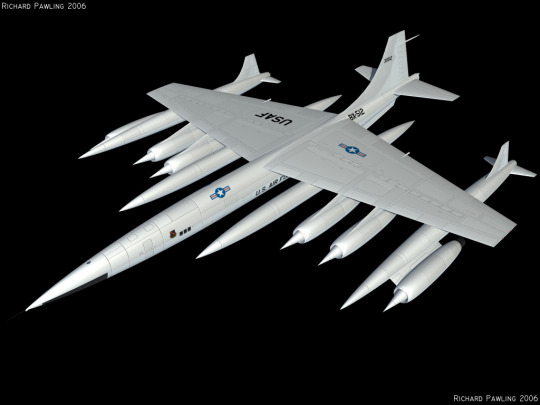
Boeing’s WS-110A proposal, working under the internal designation Model 725, was a massive six-engined machine with several external fuel tanks and a long cigar-shaped fuselage. Two engines and external tanks were slung under jettisonable outer wing sections, while the remaining four would be carried further inboard for the duration of the flight. These outer panels were independent of the rest of the aircraft, being fitted with their own landing gear and fuel tanks, and were to be jettisoned once the subsonic cruise portion of the flight had ended. The panels were free-floating, ideally reducing loads on the rest of the airframe. Details of the engines are unclear, although Boeing planned to make use of boron-enriched zip fuels to improve performance. Unfortunately, this ambitious design was far from practical. Coming in at about 750,000lb gross weight, it was impractically large, and was consequently rejected.
North American WS-110A Proposal
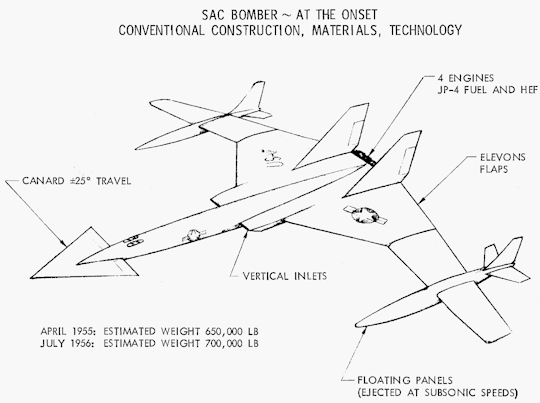
North American’s WS-110A proposal would share the same novel jettisonable outer wings of Boeing’s design, differing primarily in minor details. North American opted to use just four engines, all buried in the rear fuselage, with the jettisoning outer wing sections being unpowered. These outer sections carried large external fuel tanks partially faired into the wing, and were swept slightly forward. A large canard foreplane extended past the nose, likely to improve low-speed handling. The North American proposal also entailed the use of the same zip-fuels Boeing intended to use to meet performance goals. With only four engines, the proposal was slightly lighter than Boeing’s design, starting out at 650,000lb and growing to 700,000lb for the final submission, but it too was deemed impractically large and subsequently rejected.
North American XB-70 Valkyrie

After the rejection of the initial round of proposals, North American and Boeing went back to the drawing board. North American produced a radically new design, winning the full development contract in late 1957. Contracted as the XB-70, the bomber was a sleek delta-winged aircraft with a long nose craning forward above the aircraft. Power was to come from six J93 turbojets carried in a wedge-shaped fairing under the wing that also held the bomb bay and landing gear. Canards were placed near the cockpit, and the nose was designed to droop for takeoff and landings, allowing an optimal nose shape to be retained for high speed flight. Perhaps most significant, however, were the drooping outer wing sections. During supersonic flight, the outer sections of the wings would droop, working in concert with the shocks created by the engine intakes to “ride” the shockwaves produced for an efficient supersonic cruise. The result was a bomber a little over 500,000lb gross weight capable of meeting the specified operational range, with a payload of 20,000lb, all while doing so at Mach 3.
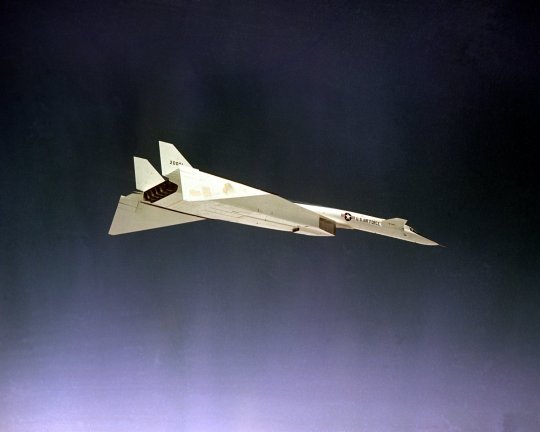
Unfortunately, while North American’s new bomber offered amazing performance, bomber doctrine was rapidly changing. A new generation of surface-to-air missiles being developed in the latter half of the ‘50s was increasingly threatening, even to high-speed, high-altitude aircraft. The only solution to this seemed to be low-altitude penetration to fly under enemy radars. This worked fine for older bombers like the B-52, but the performance losses at low altitude for the B-70 were unacceptable - the bomber was limited to just Mach 0.95 at low altitudes, barely faster than the B-52. Worse, the B-52 had a longer range and higher payload, meaning that, under the new low-altitude penetration doctrine, the B-70 was actually outperformed by the bomber it was to replace. Developments elsewhere further threatened the program. The zip fuel program was cancelled in 1979, further hurting the bomber’s performance, and in September of that year, the XF-108 - which shared many elements with the B-70 - was cancelled as well. Politics would keep the XB-70 alive through the 1960 election, despite an Air Force shift towards ICBMs, but, upon taking office and realizing the reality of the situation, Kennedy cancelled the B-70 program.
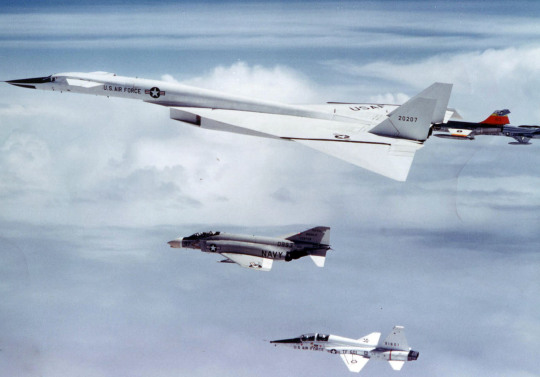
Though the B-70 had been cancelled, too much money was sunk into it to just stop development. Instead, Kennedy allowed the bomber to continue development for use as a high-speed research aircraft. In that capacity, it received an order for two prototypes, the first of which flew in 1964. The first flight was marred by a series of technical issues, but by its third flight, the Valkyrie had broken the sound barrier. The first prototype would eventually push to a top speed of Mach 3.02 in testing, before damage to the structure forced subsequent tests to be limited to Mach 2.5. The second prototype, with a refined structure, would push this further, reaching a top speed of Mach 3.08. Unfortunately, the second XB-70 was lost in a mid-air collision during a formation flight in 1966. The original prototype continued flying until the end of testing in 1968. In December 1968, it made its last supersonic flight, and on February 4, 1969, the XB-70 made its final flight, landing at Wright-Patterson Air Force Base for museum display, where it remains today.
General Dynamics FB-111A
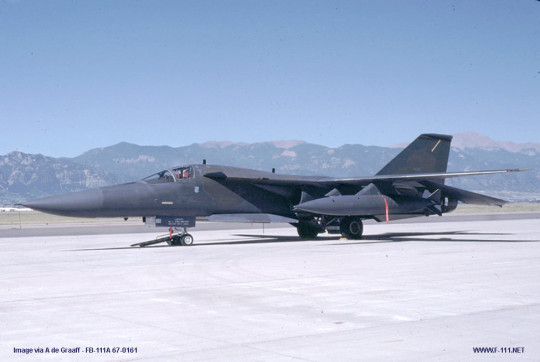
As the cancellation of the B-70 suddenly left the Air Force without a replacement for the B-52, a program to develop a stopgap was hastily launched while a more suitable replacement was developed. After several years of searching the USAF found its stopgap in the form of the F-111. In 1963, General Dynamics had submitted a proposal for a minimally modified version of the F-111A, which was accepted as the FB-111A. Selected in 1965, orders would expand to 263 aircraft under McNamara’s guidance, only to have the order slashed to 76 once Nixon took office. Optimized for nuclear strike, the FB-111A made use of the longer wings from the F-111B, stronger landing gear of the F-111D, enhanced air brakes, uprated engines, and the newest intakes. Avionics upgrades over the standard F-111 were minor, mostly amounting to a stellar navigation system satellite communications, and automatic stores release systems. Total payload was raised to 35,500lb, with standard mission profiles calling for anywhere from two to four AGM-69 SRAM standoff missiles to be carried. The bomber also had the ability to deploy nuclear gravity bombs.

The first production FB-111A flew in 1968, with most production aircraft built from components diverted from the cancelled British F-111K order. Deliveries continued until June 1971. Being strategic weapons, their service with SAC was uneventful. As the B-1B began to enter service, the FB-111A was phased out, as it became surplus to requirements. As the bombers were retired, the decision was made to convert several to conventional bombers under the designation F-111G. Conversions began in 1989, with 34 FB-111As converted to the new standard. Remaining FB-111As were retired in 1991, though the F-111G survived slightly longer, being retired in 1993. Following the retirement of the F-111G, 15 were purchased by Australia to supplement their fleet of F-111Cs, serving until the retirement of the type in 2007.
Advanced Manned Strategic Aircraft
Soon after the cancellation of the B-1, the Air Force began a new series of design studies to develop a B-52 replacement optimized for low-altitude penetration. Starting in 1961, design studies evolved over time, creating a compact subsonic design with high-bypass engines and a fairly modest payload. Further studies refined it to add swing-wings and increase the size and payload of the aircraft. In 1963, the Advanced Manned Precision Strike program was started, in which Boeing, General Dynamics, and North American were issued contracts to study a new aircraft. This culminated in the 1964 Advanced Manned Strategic Aircraft, which added high-speed high-altitude capabilities to the requirements as well. Secretary of Defense McNamara resisted the efforts to develop a new bomber, however, so the program remained on low priority until Nixon took office in 1968. Unfortunately, the AMSA would be yet another major program to be the target of politics, being fully cancelled and then revived under new requirements, ultimately only finally entering service just as the Cold War came to an end.
General Dynamics AMSA Proposal
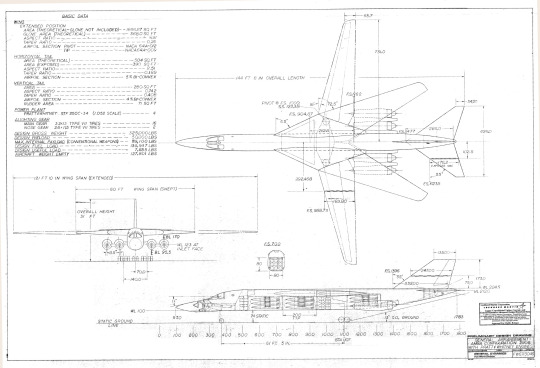
The final design that General Dynamics settled on a design study that dated back to at least 1967. Though details such as wing sweep, overall size, and payload varied over time, the general arrangement remained the same. The aircraft had a shoulder-mounted swing-wing and conventional tail, mounting the projected four GE F101 engines on pylons extending from the rear fuselage under the wings. Details on the final design are hard to find, but whatever the case, it appears that General Dynamics’ proposal was not enough to compete with North American Rockwell’s AMSA design.
North American Rockwell B-1A
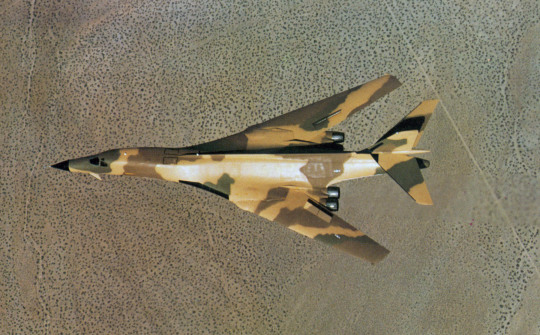
North American had produced another swing-wing design study for the AMSA. The sleek design that would become the B-1A resembled a fighter more than a bomber - it had a low-mounted swept wing that blended into the fuselage, and the four engines were paired together just under the trailing edge of the fixed section of the wings. As contracted in June 1970, Rockwell was to produce one static and five flying prototypes, though this would be reduced to just three flying airframes. The first B-1A prototype would take flight in late 1974, followed by the second and third prototypes in 1976. Unfortunately, the B-1A would become a target for the Carter Administration. Costs were spiraling upwards, and a combination of the belief of the superiority of ballistic missiles and the push for disarmament caused Carter to cut the program in 1977. The decision was not entirely ill-conceived, considering Carter was informed of the development of stealth bombers in 1975, and the newest generation of cruise missiles would allow the B-52 to perform the nuclear strike role just as well as the B-1A.Testing of the B-1A was allowed to continue, and Rockwell would conduct a series of studies simplify the design and reduce costs, but as originally conceived, the B-1A was dead.
General Dynamics FB-111H
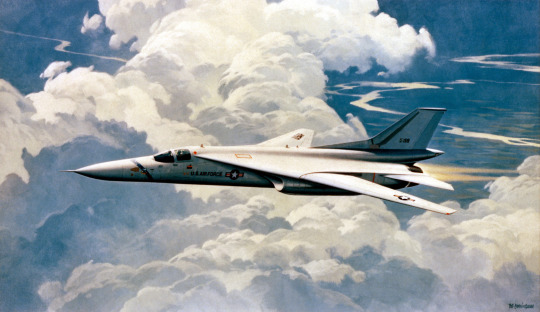
After the cancellation of the B-1A by the Carter Administration, General Dynamics began proposing several upgraded versions of the FB-111A to fill the gap left by the end of the program. The culmination of these developments, the FB-111H, was proposed to provide a more capable FB-111A variant to meet SAC’s needs. The FB-111H was a general enlargement of the FB-111A, using more powerful F101 turbofan engines and extending the fuselage by ten feet. Revised stores pylons would allow for up to twelve AGM-69 SRAMs to be carried under the wings, while the expanded internal bay would provide space for a further four SRAMs. Unfortunately for General Dynamics, this proposal was short-lived. President Reagan revived the B-1 program upon taking office, and the need for an improved FB-111A quickly evaporated.
Rockwell Pre-Advanced Technology Bomber Oblique Wing Study
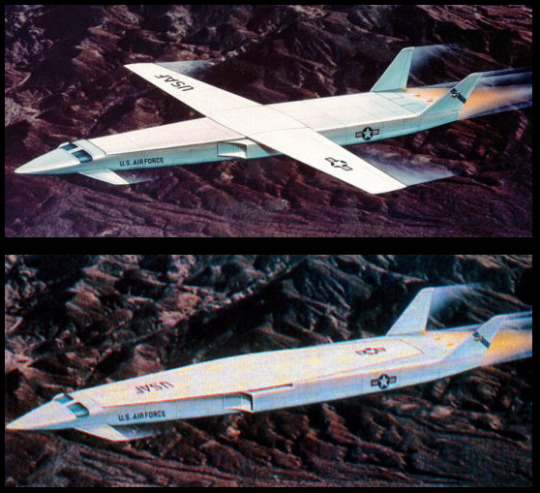
Even as Rockwell worked on the B-1, they were conducting studies for a next-generation bomber. Sometime in the mid-’70s, they began a study for supersonic bomber making use of their recent experimental work with oblique wings. The study produced an unusual four-engined design with a wide, flat fuselage and large shoulder-mounted wing. The wing would pivot around its root, providing a completely unswept surface for optimal low-speed performance, while being able to be completely folded flush with the upper fuselage for high-speed flight. With the wing folded completely away, the flat fuselage would ideally provide enough lift to keep the aircraft aloft in high-speed flight. The design also showed evidence of minor RCS-reducing features, particularly in the twin tails that were canted outwards.
Boeing Control Configured Vehicle CCV-100-2
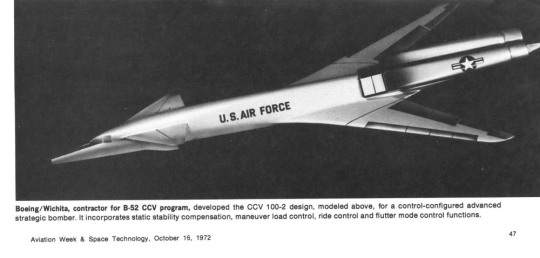
Sometime in the mid-70s, Boeing would work on a control configured vehicle bomber concept under the internal designation CCV-100-2. Appearing in a 1974 patent, the design appears to be a twin-engined, swing-wing design. Given the CCV designation and lack of a tail, the concept appears to be a fly-by-wire design. It features a couple of very unusual elements, including a vertical surface under the nose and intakes mounted above the aircraft. It’s made appearances in some Boeing concept art, as well as had a brief mention in an issue of Aviation Week around the time the design was developed, but there’s little actual information out about the bomber. Details as basic as the bomber’s size are unclear, and the only indication of performance the patent gives is that the bomber is to be supersonic.
Rockwell B-1B Lancer
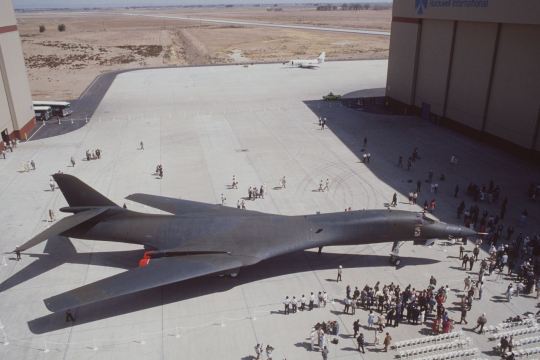
Although Carter had killed the B-1A, the Air Force worked with Rockwell to develop an improved cruise missile-carrying variant on low priority. Rising tensions with the Soviets led to a resurgence in defense spending, and when Reagan took office in 1980, he revived the B-1 as the B-1B. Though the B-1B would retain the same outward appearance of the B-1A, the B-1B would have countless changes. The high-altitude, high-speed envelope was all but abandoned due to the expected superiority of Soviet air defenses, allowing Rockwell to eliminate features like the variable-geometry intake ramps and reduce the top speed below Mach 2. Instead, the new focus became low-altitude operations with reduced chances of detection. New engine inlets and other design features reduced radar-cross section, and, although top speed at altitude dropped to Mach 1.25, low-altitude top speeds went up from Mach .85 to Mach .92. Max takeoff weight increased by over 80,000 lb, allowing for more fuel to be carried as well as a massive internal and external payload. The focus of payload would also switch to cruise missiles rather than freefall bombs.

The advanced B-1B would prove equally controversial and even more expensive than its predecessor, but Reagan would keep the program alive. The B-1A prototypes were modified to the B-1B standard to test the design, and in 1984, the first production B-1B would take flight. Deliveries began in 1985, and by the end of the decade, the entire production order of 100 aircraft was delivered. Unfortunately, it remained controversial early in its service. Several aircraft were lost to accidents, and availability was low (due to inadequate funding for spares). It faced further criticism when it didn’t make a showing in the 1991 Gulf War, although this was due to the fleet being reserved for nuclear strike and not yet equipped for conventional strike. However, as a response to the criticism over its lack of utility, the USAF embarked on a program to expand the B-1B’s ability to use conventional munitions in the mid-90’s.
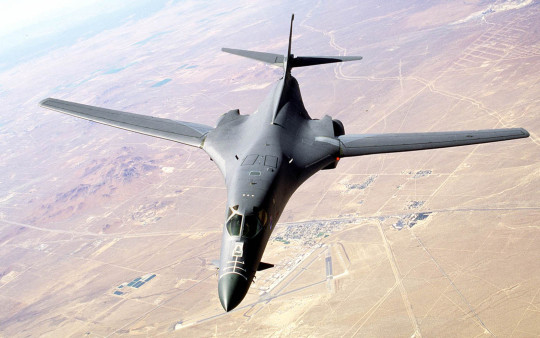
The B-1B would finally make its combat debut in 1998 over Iraq as part of Operation Desert Fox, where it dropped unguided bombs for four days. Several months later, it made an appearance over Kosovo during Operation Allied Force, again dropping iron bombs. The B-1B would really come to shine in the post-9/11 rampage across the Middle East and Central Asia. During both invasions, they showed their utility as a CAS platform, loitering for long periods over battle zones loaded with JDAMs to hit whatever targets arose. Although they would run into the issue of being unable to confirm targets, the USAF would address this by the end of the decade by fitting the B-1B with an external targeting pod. Nowadays, the B-1B is perhaps the most useful bomber in the inventory. Experience over Iraq and Afghanistan cemented its utility as a tactical bomber, and all of the teething issues experienced early in service seem to be gone. Not only is availability rate high, but it has a lower cost-per-flight-hour than the B-2 and even the archaic B-52.
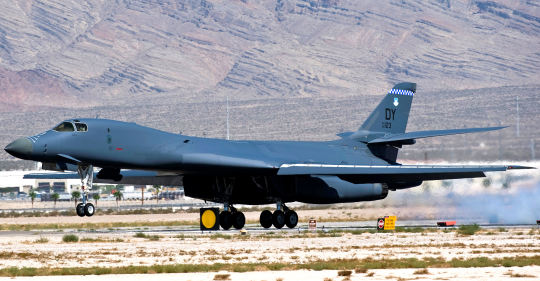
Although the B-1B was originally intended to be a state-of-the-art strategic bomber, it has since lost its ability to deploy nuclear weapons. Thanks to various strategic arms reduction treaties and the renewed focus on conventional strike, the entire fleet had its nuclear capabilities disabled. However, it has hardly lost its place as an effective bomber. The USAF continues to employ it in various COIN operations and incidents like the bombing of ISIL. It continues to be upgraded to deal with more conventional threats, both in terms of sensors and countermeasures as well as armament. Though the Long Range Strike Bomber will eventually come along to supplement the B-1B, the Air Force plans to keep the B-1B flying for the foreseeable future.
Advanced Technology Bomber
By the mid-70s, DARPA had initiated a program to develop a stealthy strategic bomber. Lockheed and Northrop were both contracted to develop stealth bomber designs for the Advanced Technology Bomber program in 1978, with proposals to be submitted by August of the next year. The two proposals - the Lockheed SENIOR PEG and Northrop SENIOR ICE - followed roughly similar designs. SENIOR PEG would be a tailed flying wing with a passing resemblance to the F-117, while SENIOR ICE was a full flying wing with much cleaner lines. Initially, Northrop participation was seen only as a fallback in case SENIOR PEG was a catastrophic failure. However, Northrop’s design would prove to be better suited to the ever-evolving Air Force requirements. Originally calling for a high-altitude penetration bomber, requirements formally issued in 1980 would call for exceptional low-altitude capabilities as well. Additionally, total payload and loaded weights had rose, putting the program in Northrop’s favor. Ultimately, Northrop would win the ATB contract in 1981.
Lockheed SENIOR PEG
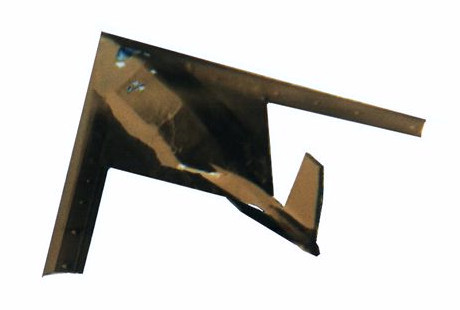
As originally designed, SENIOR PEG would roughly resemble a scaled-up HAVE BLUE. SENIOR PEG would have a diamond-shaped fuselage with wings extending out past its edges and a V-tail extending backwards on a boom. Critical elements of the HAVE BLUE design - including the engine inlet grates and heavily faceted design - would be carried over to SENIOR PEG. With computer analysis of radar cross sections improving since the development of the HAVE BLUE, Lockheed could improve upon their design, making limited use of curved sections on the SENIOR PEG. However, the limited use of curved sections could not compete with Northrop’s far more advanced design, and thus, in 1981, Northrop’s design was selected for development as the B-2.
Northrop B-2 Spirit
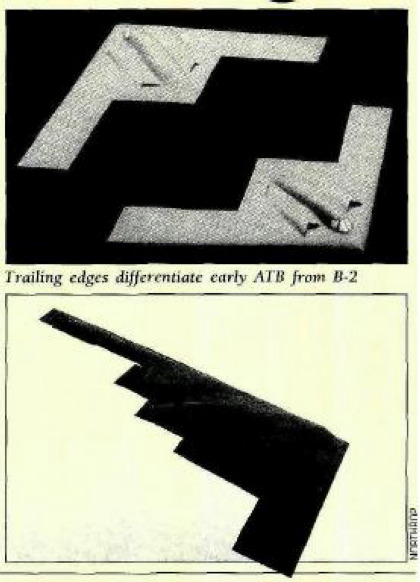
Northrop’s SENIOR ICE would be a pure flying wing design from the start. Such a design allowed for the elimination of vertical surfaces improving stealth. As originally designed around the high-altitude mission, SENIOR ICE used a diamond-shaped center section with long, high-aspect ratio wings extending outwards from it. The decision to add low-altitude capabilities briefly forced Northrop to re-evaluate their design. The large wings of the SENIOR ICE would lead to high gust loading at low altitudes and a bumpy ride, so Northrop looked into configurations with a higher sweep and lower aspect ratio. However, these configurations reduced range and affected directional stability enough to require the addition of vertical fins. Worse, it hampered takeoff performance to the point that SENIOR ICE would have to incorporate afterburning engines purely to meet takeoff requirements. Thus, Northrop reverted to the original design, making a superficially minor change to compensate instead. The trailing edge of the center section was modified heavily, giving it a W-shaped cutout to change the aerodynamic loading and smooth the ride. This was accompanied by a structural change as well, allowing SENIOR TREND to meet the USAF requirements perfectly.
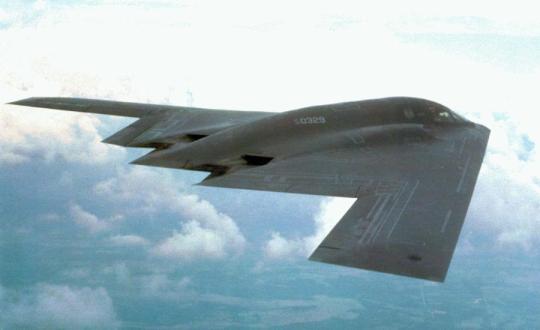
The design that would win the ATB contract in 1981 would come to be known as the B-2. Taking flight for the first time in mid 1989, the B-2 was a large smoothly contoured flying wing. The four F118 engines are paired together on nacelles on either side of the cockpit, with RAM-lined S-curve intakes and exhausts carefully designed to reduce IR signatures. A rear-facing LIDAR system would be installed as well to detect contrails and alert the pilot, allowing them to adjust altitude to compensate. Two side-by-side bays were designed to accommodate up to 50,000lb of munitions, and bomb bay doors were specially designed to reduce their RCS impact. Rotary launchers allow the bomber to carry up to 16 1,000kg-class munitions, including the B61 nuclear bomb, while the bomb bay also has space for up to eighty 500lb conventional bombs. Thanks to extensive automation, the B-2 has a crew of just two men. Navigational systems were originally an “astro-inertial” system, combining stellar navigation with a standard INS for greater accuracy. It also possesses the AN/APQ-181 radar for navigation and attack, and an extensive (but very secret) countermeasures suite was installed to protect the aircraft.
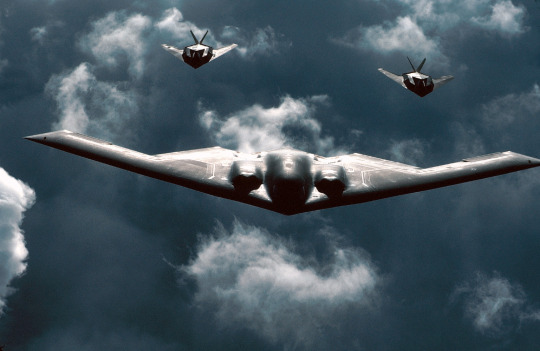
Originally, the USAF had planned to procure 132 B-2s to form the backbone of the strategic bomber force. However, even before the end of the Cold War, escalating costs due to delays and the design’s highly advanced nature made it controversial. With the order slashed to just 20 aircraft, it would become even moreso. Without a long production run to spread costs over, the flyaway cost ballooned to nearly a billion dollars. Although 10 of the 20 B-2s would be delivered by 1995, they were only Block 10 machines, lacking most of the capabilities the bomber was advertised with. Only in 1997, with the delivery of the last 10 aircraft as Block 20 machines, did the B-2 fleet finally reach IOC. The entire fleet was rapidly brought up to the Block 20 standard, which was soon followed by the Block 30 upgrade, including avionics improvements, a satellite link, support for the latest guided weapons, and substantial improvements to the stealth features.
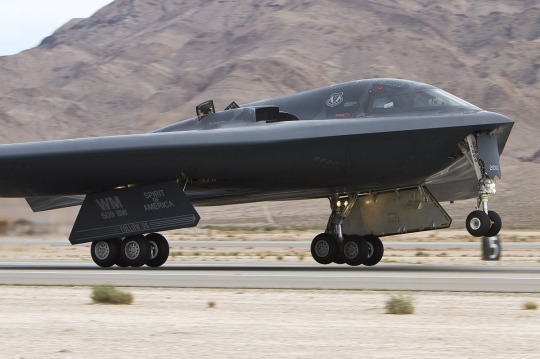
The B-2 would finally make its combat debut in 1999, taking part in the opening phases of Operation Allied Force. Over the course of the campaign, the B-2 would fly several strikes against heavily-defended targets, dropping JDAMs with impunity. In 2001, they were called into action again, this time over Afghanistan. One mission, lasting 44 hours, took bombers from Whiteman AFB in Missouri to Afghanistan to Diego Garcia, where the aircraft refueled and rearmed before performing the same trip in reverse. Four B-2s would see action over Iraq two years later. Despite its incredible capabilities, however, the B-2 has been an expensive aircraft to fly. The RAM on the aircraft’s skin is sensitive to weather, requiring special storage conditions, and, until the post-Block 30 upgrades maintenance-per-flight-hour has amounted to 20.8 hours. The newest upgrades have significantly reduced maintenance, lowering it to 9.2 hours-per-flight-hour. The latest round of upgrades has also added AESA radars, as well as the capability to deploy the SDB II and Massive Ordnance Penetrator. Currently, there are no plans to replace the B-2 anytime soon. It’s scheduled to fly until at least 2040, although the fairly docile flight profiles of the bomber mean it likely will be able to fly long past that date.
2018 Bomber
In 1999, the Air Force formed a tentative plan that called for a new strategic bomber to be developed by 2037 to replace the aging fleet of strategic bombers. However, such a timeframe left a massive gap between bomber development programs, so several aerospace manufacturers began efforts to create interim designs to bridge the gap until the 2037 bomber was ready. In 2004, these efforts seemed to have caught the attention of the Air Force, leading to an official request for information being sent to manufacturers. Studies looked at the possibility of procuring a new aircraft to augment the existing bomber fleet to be fully operational by 2018. All three major manufacturers would submit multiple proposals, with at least one joint proposal materializing from Lockheed and Boeing. Though the 2006 Quadrennial Defense Review would put an end to several early 2018 bomber projects, the program as a whole survived on until 2009. By that point, budgetary and nuclear arms treaty restrictions had made the project no longer feasible. The interim bomber concept would live on, but the 2018 bomber program would be no more.
Lockheed FB-22

Lockheed’s most developed concept for the 2018 Bomber would be the FB-22. Derived from the F-22, the FB-22 began development in 2002, starting out as just an F-22 with expanded air-to-ground capabilities but radically changing over time. Initial concepts centered around an enlarged fuselage to make space for more weapons. The conventional planform of the F-22 was replaced with a semi-delta wing, with wing area increasing with each successive concept. The final concept used the stock F-22 fuselage, but enlarged the bomb bays by bulging the doors out. The largest wing yet proposed was to be mounted increasing payload and range, and stealthy external pods for various munitions were to be designed, bringing total payload of SDBs from 8 (on the F-22) to 30. Additionally, the expanded bomb bays allowed for larger bombs to be carried - while the F-22 was limited to 1,000lb JDAMs, the FB-22 would be able to carry the 5,000lb GBU-28 internally. Because supermaneuverability was not part of the requirements, the thrust-vectoring nozzles were eliminated. However, air-to-air capabilities remained. This came at the cost of supercruise abilities and top speed, but overall the concept was solid. Lockheed tried to keep the concept alive in the aftermath of the 2006 Quadrennial Defense Review, but it was ultimately cancelled.
Northrop FB-23

Northrop’s FB-23 was a more straightforward development of their failed F-23. Making use of the refined design they planned for the production F-23, Northrop enlarged the aircraft, bringing it to roughly 30 meters in length. The added drag would be compensated for by two Pratt & Whitney F135s or GE F136s (of the F-35), which were to be buried in the aft fuselage to preserve stealth. Projections with the more powerful F136 engine called for a top speed of Mach 2.4, making the hypothetical FB-23 even faster than the F-23. Diverterless supersonic inlets were used, further improving stealth characteristics. The distinctive humps for the engines seen on the F-23 would disappear, however, as the aft fuselage filled out to make space for fuel and payload. A crew of two seems to be planned, with crew sitting in tandem seating. The fate of the project is not known. It appears that Northrop didn’t follow Lockheed’s example and try to carry the design beyond the 2006 Quadrennial Defense Review, so the FB-23 was likely cancelled in 2006.
Boeing B-1R
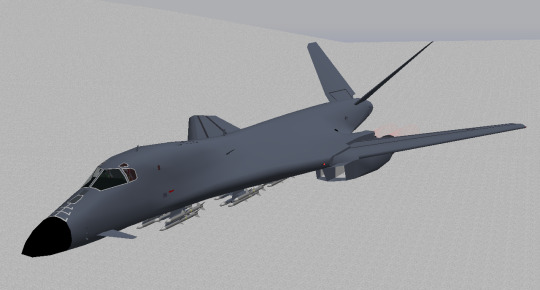
Boeing’s most famous proposal for the 2018 bomber would be the B-1R. Derived from the B-1B, the B-1R was to mount the same F119 engines of the F-22, giving the bomber a top speed over Mach 2 at the cost of a minor reduction in range. This would be accompanied by minor improvements to stealth features, as well as a revamped avionics and countermeasures suite. New external hardpoints were to be added, and, unusually, the bomber would be integrated not just with a new generation of guided munitions, but with the AIM-120 AMRAAM as well. Apparently the idea behind the AMRAAM compatibility was to offer the aircraft as a dual-role bomber and “arsenal plane” to operate in concert with fighters. Whatever the case, the B-1R would not proceed past the proposal stage.
Northrop Grumman B-21

Though 2009 would mark the end of the 2018 Bomber, the requirement would only be replaced by a new program known as the Long Range Strike Bomber. Formed from the ashes of the 2018 Bomber, the LRS-B aimed to create a similar interim design for long range strike making use of proven technologies to keep costs down. Initial statements in 2010 declared that the bomber would be nuclear capable, but not necessarily at the start of its service life owing to treaty limitations. Full requirements were issued in 2014, calling for 80-100 bombers with a unit cost of $550 million. Boeing, Lockheed, and Northrop Grumman all submitted proposals, with Northrop Grumman declared winner in October 2015. Boeing contested the decision, though they have failed to overturn it. As of 2016, the LRS-B was officially given the B-21 designation, with current plans calling for anywhere from 100 to 200 bombers to be ordered, reaching IOC by the mid 2020s. While few details are actually known about the B-21’s design, it is likely going to make use of many technologies matured with the F-35 to reduce costs, particularly the engines. Avionics are also to make use of an open architecture, allowing for easier upgrading and integration of the bomber in the future.
14 notes
·
View notes
Text
/k/ Planes Episode 97: HIGH TEST

It’s time for another episode of /k/ Planes! This time, we’ll be looking at the giants of aviation history.
From the first days of fixed-wing aviation, engineers have been looking to build ever-larger aircraft. High payloads and long ranges pushed designers to technological limits, often resulting in lumbering beasts. Unsurprisingly, the largest aircraft of the early years of aviation would be bombers, owing to the First World War taking priority in development. However, the boom in commercial aviation that came in the interwar period caused a shift - large aircraft were increasingly designed as airliners and transports. Transatlantic voyages generally became the driving force for such new aircraft, setting the baseline requirements for the world’s largest aircraft. Once WW2 rolled around, the focus for large aircraft again shifted to bombers, while the intercontinental focus remained. For several years, bombers would hold the record for the world’s largest and heaviest aircraft, but, as advances in technology in the Cold War made the lumbering behemoths no longer practical, the giant bombers gave way to even larger transports. With survivability no longer important, the size and weights of the world’s largest aircraft skyrocketed. Record-breaking transports now dwarf all military aircraft, with the world’s largest aircraft - the An-225 - having a payload capacity almost as much as the largest military aircraft’s (Tu-160) max takeoff weight.
Sikorsky S-21 Russky Vityaz

In the early days of aviation, aircraft had been steadily increasing in size and performance. However, they remained fairly small, docile machines with each successive generation only representing a modest improvement over the predecessors. In 1911, Russian designer Igor Sikorsky would conceive a radical design for an aircraft far larger than anything the world had ever seen. Designated the S-21, the aircraft was a large multi-bay biplane with two spacious enclosed cabins for crew, passengers, and storage. Originally designed as a twin-engined machine, the S-21 that took shape in 1913 instead mounted four 100hp Argus As 1 engines in tandem pairs on the lower wing. With a wingspan of 27 meters and gross weight of 4 tons, the S-21 (soon renamed Russky Vityaz) was the largest aircraft in the world, as well as the first four-engined aircraft. Taking flight in May 1913, the Russky Vityaz shattered the standing world records for payload, taking a crew of 3 and 7 passengers aloft for brief flights. In fact, the machine was so large that, unlike most other aircraft of the time, passengers and crew could move about the cabin without affecting the aircraft’s stability. For all the Russky Vityaz’s significance, however, its career was short-lived. In late June 1913, the Russky Vityaz was crushed by an engine that fell off an aircraft coming in for landing.
Sikorsky Ilya Muromets

Following the successful testing of the four-engined Russky Vityaz, Sikorsky set his sights on an even larger design. Dubbed the Ilya Muromets, the aircraft was conceived as a luxurious four-engined airliner, complete with an insulated cabin, electric lighting and heating, and even the world’s first airborne toilet. First flying in December 1913, the two prototypes began to set records immediately. While it brought Sikorsky much glory, the focus of the design would shift radically as war loomed in 1914. Sikorsky redesigned the Ilya Muromets, creating the world’s first purpose-built bomber. The militarized Ilya Muromets replaced the passenger cabin with an internal bomb bay for 800kg of bombs, as well as 5mm armor plates around the engines and nine defensive machineguns.
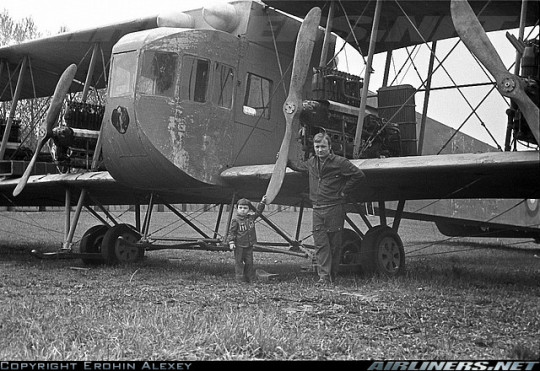
Only two Ilya Muromets were in service when war broke out, and it would take until December for the first bomber squadron to be formed. Bombing operations began in February 1915, primarily targeting frontline positions. It gained a fearsome reputation amongst German pilots thanks to its formidable defensive armament, and, while its bombing sorties were hardly decisive, it was enough for a more substantial production run to be ordered. It would take until September 1916 for the first loss to occur, with a Muromets downing three enemy fighters before being shot down itself. Meanwhile, the Russians refined their tactics, introducing formation flying and adopting such practices as night raids and post-raid reconnaissance.

Unfortunately, the Ilya Muromets would be eclipsed in the latter half of the war by the first generation of bombers from other powers. They were withdrawn to training roles in early 1917 after flying some 400 sorties and dropping 65 tons of bombs. When the 1917 revolution began, several returned to combat service, flying with the Imperial Army, Red Army, and Polish forces. This allowed their combat service to extend a bit longer - until 1919. A handful of Ilya Muromets served into the early ‘20s as airliners, but ultimately the last Ilya Muromets airliners would be retired in 1922 due to the difficulty of maintaining the engines and airframes.
Curtiss Model T
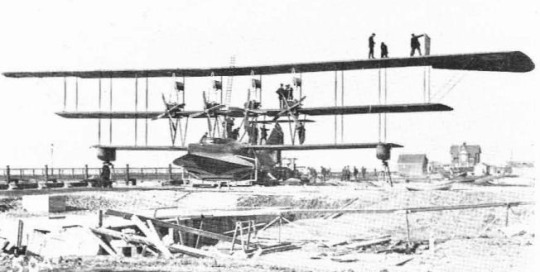
In 1915, Curtiss was commissioned by Rodman Wanamaker to develop a new large flying boat to perform the first ever transatlantic flight. Curtiss would develop a massive triplane, with each successive wing being larger than the one below it. The six-bay wings had a maximum span of 133 feet, and the design was projected to have a loaded weight of about 10 tons. The impressive projected endurance and payload capacity of the design caught the attention of the British Royal Navy Air Service, who placed an order for 20 examples. Original plans called for six engines to drive three propellers, but the planned engines were not ready when the prototype was completed, so the aircraft was shipped across the Atlantic for testing by the British. There, it was fitted with four Renault 240hp engines, making it the first ever American-built four-engined aircraft. When the Model T took flight for the first time in 1916, it was the largest flying boat in the world. Unfortunately, this flight would be its last. It was damaged beyond repair during its maiden flight, and the RNAS decided to cancel the order for 19 more aircraft.
The Riesenflugzeuge
As military aviation picked up in the First World War, many German engineers began work on a series of large bombers. While there were already heavy multi-engined machines in the works (designated Grossflugzeug), the Reisenflugzeug designs were considerably larger, with gross weights exceeding 10 tons, crews of 6 to 7, and four engines arranged in such a way that they could be maintained in flight. Development spanned the whole war across multiple manufacturers, with the only real consistency between the designs being their incredible size and the ability to service engines in flight. For all their impressive stature, however, the R-series bombers would have little impact on the war. The massive machines had very limited production runs, and very few of the aircraft would ever make it into service.
Zeppelin-Staaken Riesenflugzeuge

Though better known for his airships, Count von Zeppelin would also begin work on large fixed-wing bombers once war broke out. Initially lacking the facilities to handle construction, Zeppelin outsourced production to Gotha, earning the first bomber the designation V.G.O.I. The new bomber was a unique three-engined machine, with a single powerplant in the nose and two mounted on either side of the fuselage between the wings in rear-facing nacelles. Taking flight in April 1915, the V.G.O.I performed well enough to be accepted into service by the Kaiserliche Marine, who operated it on the Eastern Front. Its service there was brief, however, and it was returned to Staaken later that year to have two more engines mounted in the wing nacelles. Unfortunately, during testing, the V.G.O.I would crash.
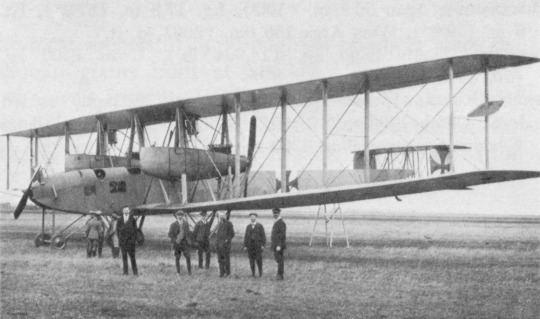
The V.G.O.I was followed by four more designs. The first, the V.G.O.II, was little more than a slightly refined V.G.O.I that served with the Luftstreitkrafte rather than the Kaiserliche Marine. It had a brief debut on the Eastern Front before being relegated to training duties. The V.G.O.III improved upon the design further, making use of six engines (two side-by-side in the nose and wing nacelles geared to drive a single propeller). The penultimate iteration of the design - now designated R.IV - replaced the engines in the nacelles with more powerful ones. It would be the most successful of Zeppelin’s first riesenflugzeug - it operated on both the Eastern and Western Fronts, and, unlike its predecessors, it would survive the war. The R.V improved on this further - the wing nacelles were flipped, giving the bomber an all-trator arrangement, and a nacelle for a gunner was added on the upper wing to account for the loss of the forward-facing gunner positions in the wing nacelles. It would see service over the Western Front. Ultimately, none of the first five R-bombers would be all that influential. Their service was limited, and, with only three examples seeing any significant service, they would be overshadowed by more numerous types.
Siemens-Schuckert R-bombers

The first Siemens-Schuckert design to carry the “R” designation would predate the designation itself, being ordered in 1914. The R.I would have a crew of four in an enclosed cabin that held the aircraft’s three engines and a bomb bay for 500kg of bombs. The design incorporated many unconventional elements. The engines were geared out to propellers between either wing, and, rather than place them in the middle of the fuselage as most other R-bombers did, the engines off the Siemens-Schuckert designs were placed in the extreme nose. The tail was also wildly unconventional - it forked vertically, allowing the gunner to have a clear field of fire to the aft. First flying in May 1915, the design received a small production order for six other aircraft. However, each of the aircraft of the series would bear a new designation - R.II to R. VII - owing to successive improvements to each aircraft. The first three aircraft (including the prototype) would see no operational service, instead being passed onto training units. The final four, however, saw a brief career on the Eastern Front, remaining there until being declared obsolete in 1917.
DFW R.I
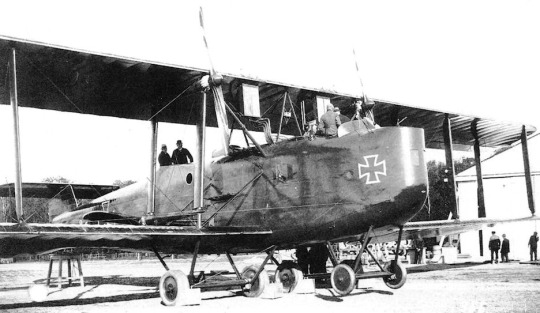
DFW’s first R-bomber would take shape as a private initiative in reaction to the developments of other companies. Like many of the other R-series designs, it had its four engines mounted inside a large, spacious fuselage for in-flight servicing. However, each engine was geared out to its own propeller - two on the leading edge of the upper wing, and two on the trailing edge of the lower wing. Defensive guns were placed in nose, ventral, and dorsal positions, and provisions for up to 2,600kg of bombs were added. The DFW R.I was promising enough in factory tests in 1916 for it to be submitted to military acceptance tests that October. It passed these tests and was purchased by the Luftstreitkrafte, but issues soon arose with the propeller crankshafts. Minor changes to the engine mountings and other aerodynamic improvements allowed the DFW R.I to enter service in April 1917 on the Eastern Front. Unfortunately, the aircraft’s career was brief - it crashed on its second combat sortie due to the failure of both engines.
AEG R.I

AEG would produce only a single R-bomber design during the war, first flying it in 1916. Coming in a 12 tons gross weight, the AEG R.I was unique in that it had all four of its engines mounted in the fuselage. Power was provided to the propellers via a driveshaft that extended outwards from either side of the fuselage. Layout was conventional for a bomber of the time, though the crew was considerably larger at 7 men. Defensive armament consisted of five machineguns placed around the aircraft, and a payload of up to 3,800kg could be carried. Testing began in 1916, with generally good reports. A further seven examples began construction, but work went slowly. Ultimately, none would be finished by war’s end, and the sole flying example would be lost after a newly designed propeller disintegrated during test flights.
Zeppelin-Staaken R.VI
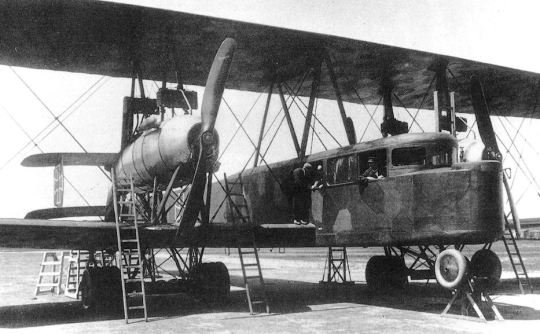
All while Zeppelin was working on the later three-propeller bombers, the Zeppelin works at Staaken were working on a new machine that would become the R.VI. Diverging from the design that had been standard across the first five machines, the R.VI mounted its four engines in push-pull nacelles in the wings. Each nacelle provided space for an engineer, while the fuselage would hold the rest of the seven-man crew. Gunner positions were added in the nose, dorsal, and ventral positions, as well as a position on top of the wing on some aircraft. Payload was 2 tons. First flying in 1916 the R.VI would hold the distinction of being the only Riesenflugzeug to see series production. 18 would be produced, along with several other one-off modifications.
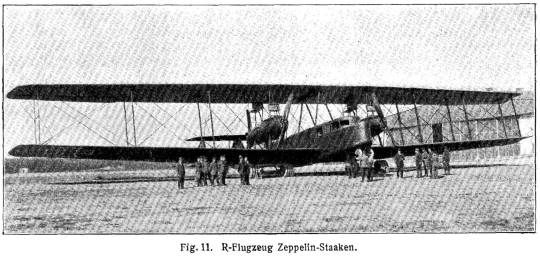
When the R.VI entered operational service in 1917, it would become the largest bomber to fly in the war. Combat sorties began in the latter half of 1917, with missions primarily flown at night with payloads less than 1,000kg. 13 would reach the front by the war’s end, of which four were shot down and six lost in crashes. Despite a high attrition rate, they generally performed well, particularly compared to the Gotha bombers they operated alongside. Missions were flown against both French and British targets, and, unlike the Gotha bombers, the Zeppelin-Staaken R.VI would never be shot down over Britain. The five final machines would be completed after the Armistice, but they would soon be scrapped owing to the terms of the Treaty of Versailles.
Linke-Hofmann R.I
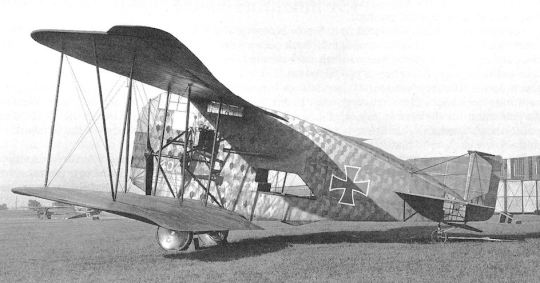
Despite being a railway company with minimal aeronautical experience, Linke-Hofmann would join in on the R-bomber phenomenon in the latter half of the war. Their first design, the R.I, offered perhaps the most peculiar design of all the R-bombers developed during the war. Being a large biplane design, the R.I had a deep fuselage that spanned the entire interplane gap. A spacious fuselage consisted of three decks - a top deck for the pilot and radioman, middle deck for the four engines, and bottom deck for the bombardier, payload, and fuel. The engines were carried entirely within the fuselage, being geared out to propellers between the wings in hopes of reducing drag. The R.I also incorporated transparent Cellon in parts of the aircraft in hopes of reducing visibility. First flying in the Spring of 1917, the R.I quickly demonstrated a number of undesirable features. The height of the cabin made landings difficult, and numerous structural issues - particularly in the wings - made control difficult. Burying the engines in the fuselage led to cooling and vibrational issues, while the Cellon skin was too responsive to temperature changes, negatively affecting trim as the material expanded and contracted. Surprisingly, perhaps the only element of the design that worked as expected was the deep fuselage. The first of four prototypes was lost when the wings collapsed during low-altitude tests, while the second was lost when it nosed-over during landing. The other two survived testing, but the design would never enter service.
DFW R.II

Though DFW’s first R-bomber had been lost early in its career, it had served favorably enough for the Luftstreitkrafte to order a follow-on design. Designated the R.II, the new bomber shared the general layout of its predecessor (including the unique propeller arrangement). However, a requirement for a 3,400kg payload meant significant structural changes would have to be made. The resulting R.II that flew in August 1918 thus featured a higher gross weight and larger wings to accommodate the larger payload. Minor vibrational issues were found with the propeller driveshafts during testing, but these were easily alleviated, allowing an order for 6 aircraft to be placed. Unfortunately, only two DFW R.IIs would be delivered by the war’s end, having served as training aircraft due to inadequate performance. Plans were in place for an airliner version of the bomber, but ultimately these came to an end with the signing of the Treaty of Versailles.
DFW R.III

The final incarnation of the DFW R-bombers, the R.III, would represent a significant divergence from the previous designs. Significantly larger than its predecessors, the R.III was to mount eight engines - four in the fuselage, and two each in nacelles between the wings. The wing-mounted propellers were dropped in favor of a push-pull arrangement on the engine nacelles, complete with one of the earliest examples of co-axial propellers. Each of the aircraft’s eight propellers would be driven by its own engine. Though payload was only 2,500kg, just about everything else about the design had also ballooned. Defensive armament increased to eight machineguns (including dorsal, ventral, nose, and chin mountings), and wingspan increased to 175ft. Had it been completed, the DFW R.III would have been the largest aircraft in the world. However, it was cut short by the Armistice, and it ultimately would never leave the drawing board.
Forssmann Giant

By second year of WW1, an engineer by the name of Villehad Forssman had conceived a design for a transatlantic transport of an unprecedented size. Powered by ten engines, the triplane leviathan would have dwarfed all contemporaries, with a wingspan of 165 ft, length of 150 ft, and endurance of roughly 80 hours. The intended transport role made securing official support difficult, although Forsmann did apparently secure interest from the Kaiserliche Marine and support from several factories and manufacturers. Whatever the case, construction began sometime in 1918. Work went slowly, and development was disturbed by at least one relocation. Ultimately, Forsmann’s aircraft would never fly - the Armistice put an end to construction. The first the Entente heard of it was in 1919, when inspectors discovered the unfinished aircraft (still lacking undercarriage, engines, and tail surfaces) at its airfield in Poll. Though quite an impressive machine even in its unfinished, unassembled state, it would never be completed.
Siemens-Schuckert R.VIII

Diverging from their earlier R-series designs, the final R-bomber to come from Siemens-Schuckert would hold the distinction of being the largest R-bomber of the war, both in size (with a wingspan of over 150 ft) and weight (with a loaded weight of 15 tons). Abandoning the unusual layout of the earlier designs, the R.VIII carried six engines in its fuselage, geared out to drive four propellers in a push-pull arrangement between the wings. Outside of its impressive size, however, the R.VIII was conventional for its class of bombers, with a large crew and standard biplane layout. The design received an order for two aircraft, but only the first would be completed, as the Armistice cut work short. Ground trials only began in 1919, but the failure of a propeller caused extensive damage to the aircraft and prevented it from ever flying. The airframe would not be repaired, nor would the second be completed, as the Treaty of Versailles had set in. Thus, the largest airplane in the world would end its career without ever flying.
Linke-Hofmann R.II
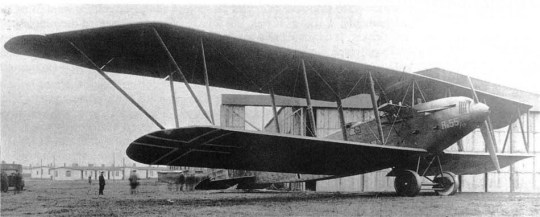
The final R-bomber of Linke-Hoffman, the R.II, at a glance appeared to be more like a light bomber. With a conventional tractor biplane layout and a single propeller in the nose, the unusual design of the R.II only really becomes apparent once the crew provides a sense of scale. The R.II was effectively an average single-engined light bomber design that had been massively scaled up. Crew ballooned to six, with defensive guns placed in two dorsal and one ventral position, while the largest single propeller in aviation history (6.9 meter diameter) was placed in the nose to drive the aircraft. Though it gave the impression of being a single-engined machine, it in fact carried four 260hp Mercedes engines, all geared to the same propeller and accessible from the interior of the aircraft for in-flight servicing. Because of this arrangement, the R.II would be able to shut down up to two engines during flight. Unfortunately, the R.II wouldn’t fly before the end of the war. Only in 1919 did it make its first flight, demonstrating a standard endurance of 7 hours and estimated maximum endurance of 30 hours. Linke-Hofmann hoped to salvage their work in the aftermath of the Armistice by turning the R.II into a 12 passenger airliner, but the conditions of the Versailles treaty put an end to the project.
Handley Page V/1500
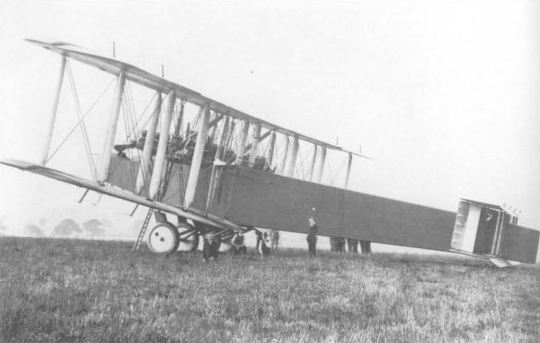
In 1917, the British Air Board set out requirements for a long-range bomber with a longer range than the Handley Page Type O already in service while carrying a 3,000lb payload. With the most experience with heavy bombers, Handley Page unsurprisingly won the competition with their V/1500 design. The V/1500 carried over many elements of the Type O - particularly the fuselage - but it had much larger wings and four engines in push-pull nacelles. It would carry a crew of up to nine, with defensive guns in nose, dorsal, and tail positions. Payload was up to 7,500lb of bombs carried in an internal bay. The first V/1500 took flight in May 1918, and very quickly orders were placed for a total of 210 bombers.
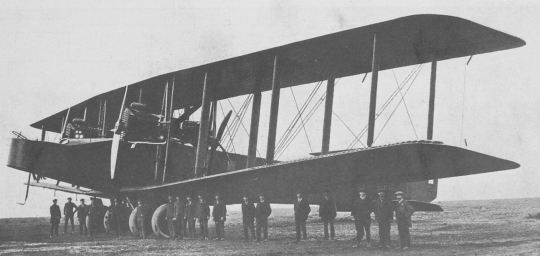
Though the first V/1500s reached their units in October 1918, their first mission wasn’t scheduled until November 8. Plans called for the bombers to hit Berlin before flying on to Prague (the Austrians had surrendered by then) to refuel and rearm, allowing them to hit Dusseldorf on the return flight. Unfortunately, the mission would never be flown. A series of engine changes delayed the mission until November 11, and, as the bombers were about to take off, they were halted due to the Armistice being declared. Because of the end of the war, production was cut to just 60 aircraft. Though the bomber would be the largest Entente aircraft to see service in the war, the V/1500’s operational use was fairly disappointing. The only actual combat use of the V/1500 came in the Third Anglo-Afghan War, where a single bomber hit the palace at Kabul with four 51kg bombs. There were plans to use the fleet to break several records, including making the first transatlantic flight, but these plans never panned out. In the end, the modest V/1500 fleet would be replaced by the considerably smaller Vickers Vimy.
Curtiss Model NC

Towards the end of the First World War, the Navy was in search of a long-range patrol flying boat with the range and endurance to make unassisted transatlantic flights (to avoid the threat of enemy submarines to aircraft being ferried to Britain by ship). With such ambitious requirements, the result was unsurprisingly one of the largest flying boats yet produced. The Curtiss NC featured a spacious fuselage, complete with a wireless radio station and sleeping quarters for its crew of 5. Three Liberty engines were placed between its 126 ft wings, with a fourth added in a pusher arrangement in the center nacelle during testing. Unfortunately, the first NC wasn’t completed until the latter half of 1918, and it would only take flight that October. Though the war would end before testing could conclude, the NC would go on to set several records, including the world passenger record when it took 51 people aloft on November 25. A total of 10 NCs would be built, but their service was limited. Three NCs were set out on a demonstration transatlantic flight from Newfoundland to the Azores in May 1919, but only one would make it through. The remaining NCs that survived testing and the demonstration flights would serve on into 1921.
Felixstowe Fury
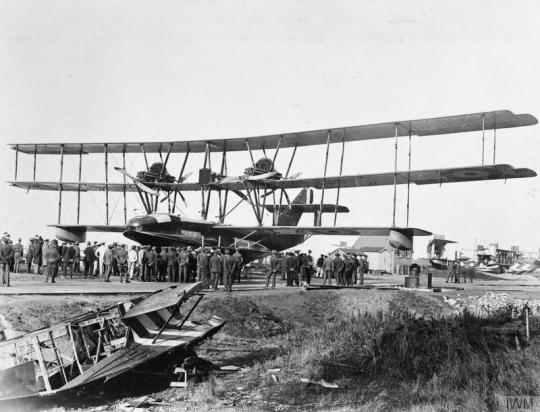
Though Curtiss’s Model T flying boat was lost early on in testing, it had inspired the engineers at Felixstowe to create an even larger design. Working under the name “Fury,” the new flying boat shared many elements of the failed Curtiss design, including its triplane wings. Structural improvements meant that the Fury required only three-bay wings (as opposed to the six-bay wings of the Model T), and the upper two wings were of equal span, allowing total wingspan to be slightly smaller than the Model T’s. Original plans called for the Fury to mount three Rolls Royce Condor engines, but, as they were not available when the prototype was complete, they were substituted with five Rolls Royce Eagles. By the end of 1918, the Fury was taking shape as an impressive design. It was to have a crew of three with a capacity for some 30 passengers, while positions were placed around the aircraft for up to four defensive machineguns and various bombs. Coming in at a loaded weight of 25,000lb, it was the largest flying boat in the world.
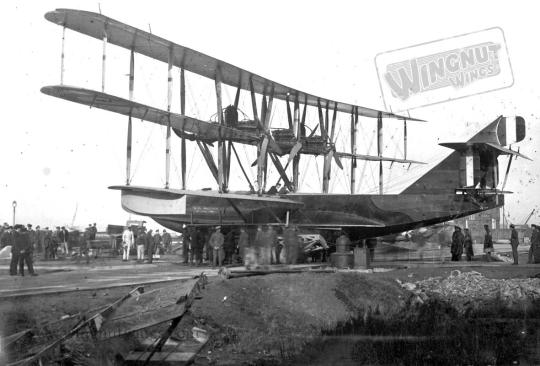
The Fury took flight for the first time on Armistice Day, ending any prospects for significant production. Nevertheless, the design showed great potential for record-breaking flights, and interest soon rose in using the aircraft to perform the first ever transatlantic flight. Unfortunately, official interest in the project waned as the Air Ministry preferred to leave such ventures to private initiatives. Other proposals for long-range flights were tendered, including an 8,000-mile trip from England to Cape Town. The flight would make several stops across British-controlled Africa, and it was scheduled to begin on August 12, 1919. However, on August 11, as the Fury made its final preparations for the record-setting flight, disaster struck. It crashed on takeoff, killing one of its crew. Following the tragedy, the plans for the long-distance flight were cancelled.
Tarrant Tabor
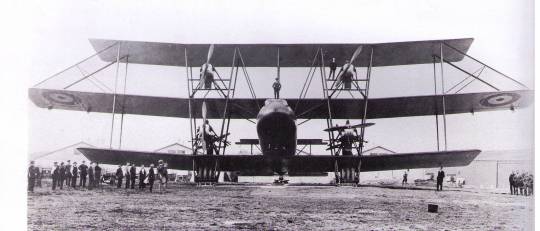
After securing patents for various elements of aircraft structure, the woodworking company Tarrant Ltd hired Walter Barling of the Royal Aircraft Factory to develop a long-range heavy bomber for the company. Original plans called for the bomber to be a large biplane powered by four Armstrong Siddeley Tiger engines in tandem pairs. However, when it became clear that the engines were delayed, the aircraft was completely redesigned. Six Napier Lions were mounted, and a third wing was added, turning the aircraft into a triplane. The fuselage itself was a finely streamlined monocoque structure with a capacity of six crew and up to 9,000lb of cargo. However, it had no bomb bay, with payload of 4,600lb instead supposed to be carried under the bottom wing. The resulting aircraft was massive - it came in at a loaded weight of 20 tons. Though the end of the war put an end to the bomber’s prospects, work continued with the aircraft serving as a transport. Ultimately, the Tabor began testing in May 1919. During what would have been its first flight, the upper two engines caused the aircraft to nose-over on takeoff, killing the two pilots and injuring all aboard. The crash marked the end of the program, and Tarrant would never again make an aircraft.
Witteman-Lewis XNBL-1
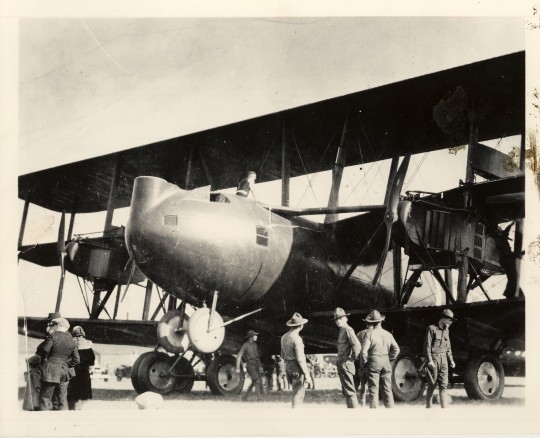
In 1919, General Billy Mitchell contacted Walter Barling, formerly of the Royal Aircraft Factory, asking him to develop a bomber capable of carrying enough bombs to sink a battleship to demonstrate the potential effectiveness of airpower. Barling’s proposal vaguely resembled his failed Tarrant Tabor, albeit with improvements to avoid the catastrophic crash the Tabor suffered. Commissioned around requirements for a 5,000lb bomb load, service altitude of 10,000ft, and top speed of 100mph, the bomber was a large triplane with a cigar-shaped fuselage and six engines placed across four nacelles. A crew of seven was to man the aircraft, supported by seven Lewis guns across five stations. The fuselage carried a bomb bay large enough to carry any bomb in the Air Service inventory, including the 4,000lb bombs specially designed to sink a battleship. Wittemann-Lewis was contracted to produce two prototypes for the bomber, which received the designation XNBL-1.

Unfortunately, construction of the bomber was plagued by cost overruns and delays. Numerous changes were required to the design, and total costs ballooned from the contracted $375,000 for two aircraft to $525,000 for just a single example. The second airframe was cancelled, and Wittemann-Lewis was forced to absorb the cost overruns. The completed bomber was disassembled and shipped to Fairfield, Ohio in May 1923, where testing would occur. Coming in at over 40,000lb, it was by far the heaviest aircraft in the world, but this came at a high cost - there were only six airfields in the country large enough to accommodate it. Though it would set numerous payload records over the course of testing,and it did meet the 5,000lb bombload requirements, the XNBL-1 was overall disappointing. Range was just 170 miles, and the bomber was seriously underpowered. It was scheduled to make an appearance at an airshow in Washington, D.C., but it proved incapable of flying over the Appalachian Mountains and was forced to turn back. Overall, despite the aircraft's impressive size, it would be a scandal at the time due to the high costs and mediocre performance of the design. Ultimately, the XNBL-3 was disassembled in 1927 and burned in 1930. It would be the largest American aircraft until the XB-15 took shape in 1935.
Caproni Ca.90
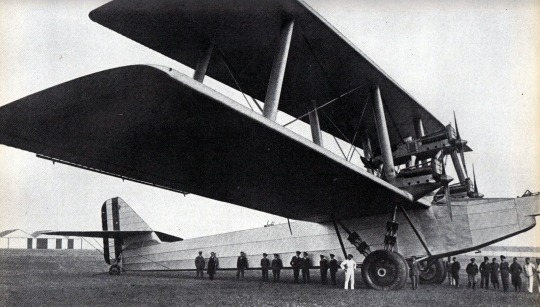
Caproni’s ultimate biplane bomber would come at the end of the 1920s in the shape of the Ca.90. Epitomizing the aerial battleships intended to fly to strategic depths to drop massive payloads theorized by Giulio Douhet of the Regia Aeronautica, the Ca.90 was the largest biplane in history. Powered by six Isotta Fraschini inline engines providing 1,000hp each in three tandem nacelles, the Ca.90 was a steel tubing and fabric machine that was to carry a crew of seven. Defensive armament was in the form of seven machineguns (in one nose, two dorsal, two waist, one ventral, and one upper-wing positions), while offensive payload was quite possibly the largest of its time at 8,000kg.
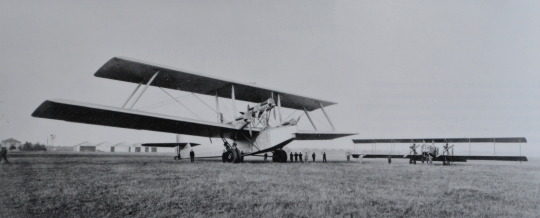
Taking flight in October 1929, the Ca.90 was passed on to the Regia Aeronautica’s 62 Squadron for testing. On February 22, 1930, the Ca.90 took to the skies with a 10,000kg payload for testing. It would fly for over an hour and a half, reaching a maximum height of over 10,000 feet, breaking six altitude and payload records. Unfortunately, this aerial leviathan gained little traction within the Regia Aeronautica. The strategic bombing ideas of Giulio Douhet died with him in 1930, and Italy’s poor manufacturing capacity was hardly capable of making such a massive machine in significant numbers. Rather, the Regia Aeronautica followed the trends of the rest of the world, moving towards smaller, faster bombers.
Dornier Do X
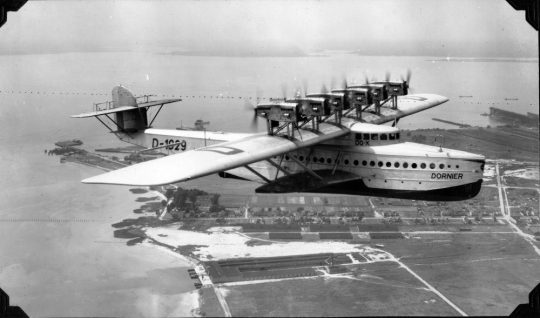
Towards the end of the ‘20s, Claudius Dornier began work on a massive flying boat airliner designed to carry passengers on a luxurious flight across oceans. The design itself was fairly standard for Dornier designs of the time, with a shoulder-mounted semi-cantilever wing and Dornier’s signature airfoil-shaped stabilizing floats mounted near the waterline. Mounted atop the wing were twelve Bristol Jupiter engines in push-pull nacelles. Coming in at 56 tons gross weight, Dornier styled the aircraft less like an aircraft and more like a boat. The cockpit closely resembled the bridge of a ship, and throttle controls were done by a dedicated engineer, owing to the complexity of managing 12 engines at once. The passenger compartment was designed with luxury in mind, with three decks for up to 100 passengers. Accommodations for passengers included a bar, dining salon, an all-electric galley, bathrooms, and 66 seats that could be converted to sleeping berths.
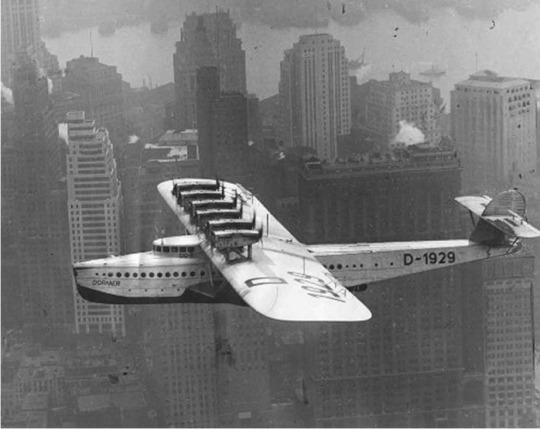
The Do X would first fly on July 12, 1929, making it the largest aircraft in the world by weight. Though underpowered with the Bristol Jupiter engines, it nevertheless was performing well, even going as far as setting a world passenger record on its 70th test flight by carrying 169 people including 14 crew aloft - a record that would stand for 20 years. After about 100 flights, the Do X was overhauled with more powerful Curtiss Conqueror engines, giving the aircraft enough power to finally make transatlantic flights. The first of these came in November 1930, with the Do X taking off from the Netherlands, making stopovers in England, France, Spain, and Portugal before traveling on to Cape Verde and Natal in Brazil. It then traveled north, reaching New York in late August 1931. It remained there for an overhaul for nine months, but it failed to gain any commercial interest before returning home due to the onset of the Great Depression. The original Do X was turned over to Lufthansa in 1932, while the Regia Aeronautica operated two others as airliners and propaganda machines. Unfortunately, the careers of all three machines were brief. The original Do X lost its tail in a hard landing in 1933, and, though repaired, it was put in a museum, never to fly again. The Italian aircraft proved economically unfeasible, and their flights were gradually scaled back until they were finally mothballed in 1935.
Tupolev ANT-16/TB-4

Though Tupolev’s four-engined TB-3 was already one of the largest bombers in the world when it entered service, Tupolev had his sights set on bigger projects. The next evolution of his corrugated metal bombers would be the gigantic ANT-16, which would gain the tentative service designation of TB-4. The TB-4 scaled up the design once more, creating the largest bomber the world had yet seen. Coming in at 33 tons gross weight, the TB-4 had a 54 meter wingspan and a payload of up to 10 tons. Supplementing the four engines that lay on the leading edge of its two-meter wings were two more engines mounted in a push-pull nacelle above the fuselage. To carry payload, the fuselage was fitted with two 5X1.8X1.8 meter bomb bays - the largest in the world at the time. Twelve men would crew the machine, protecting it with a complement of two 20mm cannon and ten machineguns in double mounts. Taking flight in July 1933, the bomber would complete its test program by the end of September. Results were disappointing. The engines all performed poorly - the wing-mounted ones due to the thick wing behind it, and the upper two due to the poor layout of the nacelle. Though it posessed an impressive payload capacity and respectable range, the top speed of just 200km/hr was too slow for the VVS, and the design was ultimately rejected.
Tupolev ANT-26/TB-6

Even the absurdly large TB-4 apparently wasn’t enough for Tupolev’s engineers. Soon after design work began on the TB-4, an even larger bomber would begin development. Planned to be called the TB-6, the aircraft would be powered by twelve AM-34 engines producing 1,200hp each. Four engines were to be mounted in either wing, while the remaining engines were to be carried above the fuselage in push-pull nacelles. Taking everything from the TB-4 to the extreme, the TB-6 would have a gross weight of 70 metric tons and wingspan of 95 meters, making it one of the largest aircraft in the world even by today’s standards. Normal payload would dwarf anything else then flying - 15 tonnes - while external racks could boost that to almost 25 tonnes in overload. Of course, the TB-6 would be slow like its predecessors, but it was hoped that a heavy defensive armament of one 37mm cannon, four 20mm ShVAK, and five machineguns could adequately protect the bomber. And of course, this behemoth would not be complete without a fittingly impractically large crew of 17. A scale model glider prototype with a wingspan of 20m was flown to validate the design, and in October 1932 construction of the prototype began. However, work proceeded slowly, and, after the VVS found even the smaller TB-4 to be impractical, the decision was made to abandon the TB-6 as well.
Tupolev ANT-20 Maksim Gorky

Although the VVS had decided to give up on the idea of massive lumbering bombers, the state did see the propaganda appeal of such a large aircraft. Tupolev went to work on an enlarged derivative of the failed TB-4 under the pretext of celebrating the revolutionary writer Maksim Gorky. The ANT-20 would be even larger than the TB-4, but it it was designed to have just half the takeoff roll to allow it to fly from more remote airfields. It added two more engines to the TB-4 design, while the fuselage was slightly enlarged and wingspan was longer, making it the largest aircraft in the world at the time (and second heaviest after the Dornier Do.X). The Maksim Gorky would be an engineering marvel for the time - not only was it impressive in size, but it carried a radio broadcast transmitter, loudspeakers, and an onboard theater and library. It was the first Soviet aircraft to be fitted with an autopilot, and it would be the first aircraft in the world to have both AC and DC power available onboard. Even with all of this equipment, the ANT-20 had an impressive capacity of eight crew and 72 passengers.
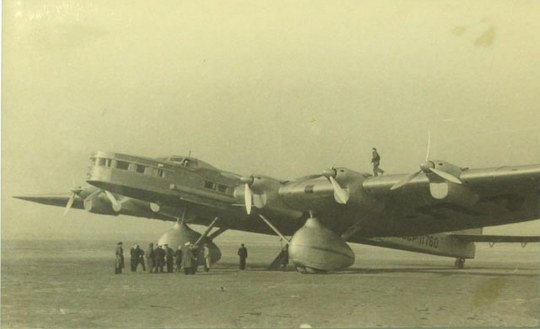
The Maksim Gorky made its inaugural flight in May of 1934. It kicked off its career by setting several payload records, but its life would be short. During a demonstration flight over Moscow in May 1935, an I-15 collided with the aircraft while trying to loop over it. The Maksim Gorky and the fighter were both lost, killing 45 people. To replace the Maksim Gorky, Tupolev created the ANT-20bis. The ANT-20bis incorporated several improvements such as six more powerful engines (which allowed the deletion of the poor-performing dorsal nacelle), but it lacked the extravagant elements of the Maksim Gorky. Rather, it was configured as a 64-seat airliner. The ANT-20bis took flight in May 1939. Despite plans to mass produce the type, only one ANT-20bis would ever be made. It ended up serving out its career with Aeroflot until 1942, when it crashed near Tashkent.
The American Long Range Bombers
In 1933, the USAAC issued specification for a new long-range bomber, asking for a range of 5,000 miles, 2,000lb payload, and 200 mph cruise speed. The next year, Boeing and Martin received contracts for their designs, designated XB-15 and XB-16, respectively. Given the requirements issued, the designs were unsurprisingly quite large, promising to be some of the largest combat aircraft in the world. In 1935, the project was combined with another similar requirement calling for “the maximum feasible range into the future,” and the XB-15 was redesignated XBLR-1. The new program would be short-lived, however, and within a year the original designations returned. Ultimately, despite the countless advanced features of both designs, the long-range bomber program would never pan out. The XB-16 would be cancelled, while the XB-15 would remain a one-off design, living out its career as a transport. Ultimately, it wouldn’t be until the B-29 entered service that anything approaching the program’s requirements was available.
Martin XB-16
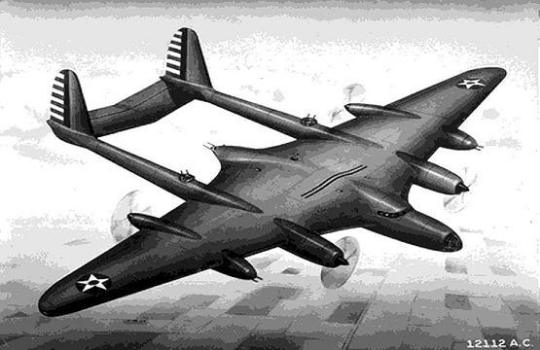
In response to the original requirements, Martin would produce the Model 145A, which received the designation XB-16. The XB-16 was to be large twin-boom machine powered by four Allison V-1710 V-12 engines. As originally designed, it was to have a wingspan of 140 ft, crew of 10, and gross weight of 65,000lb. While this was enough to receive a contract, Martin would take the design a step further in 1935. Loaded weight ballooned to over 100,000lb, while wingspan was increased to 173 feet to compensate. Had it materialized, the XB-16 would have been the largest combat aircraft in the world by size. Unfortunately, the design had its failings. Though top speed was above the required 200mph, the XB-16 was projected to fall well short of the 200mph cruise speed the program called for. As it became apparent that neither design would meet the required cruise, the XB-16 was cancelled before construction of the prototype could begin.
Boeing XB-15

The Boeing proposal, designated XB-15, was a much more conventional design. Designed around four 2,600hp Allison V-3420 engines, the bomber in many ways resembled a scaled-up version of Boeing’s B-17. Given the long flight times that would come with the bomber’s range, Boeing added elements to improve crew comfort. The spacious fuselage featured bunks, a galley, and a lavatory. An autopilot was developed for the bomber, and advanced features like deicing equipment and a 110-volt electrical system (powered by two small gasoline generators) were incorporated into the design. The wings themselves were thick enough for a crawlspace to be added, allowing the crew to service the engines in flight. Unfortunately, things wouldn’t go as well as planned. The planned Allison engines didn’t pan out, so four 850hp Pratt & Whitney Wasp radial engines were used instead. The bomber would take flight in December 1937, but testing went poorly. With far less power than expected, the XB-15 couldn’t even break 200mph empty, and with the specified payload, the bomber could reach just 145mph.

The failure of the XB-15 to meet requirements signaled the end of its prospects as a bomber. However, with a maximum payload capacity of 8,000lb and an impressive range, it had promise as a cargo aircraft. The sole prototype was assigned to the 2nd Bombardment Group. Its first missions came in 1939, when it was called to deliver medical supplies to Chile in the aftermath of a major earthquake. Flying from Langley, Virginia, it reached Santiago with only two stops (Panama and Lima, Peru) along the way. In the years leading up to the war, the XB-15 set numerous payload records (including a maximum payload of 31,000lb) and served as a test aircraft for canal bombing tests.At the end of 1940, its defensive guns were removed, and in 1943, it was oficially converted to a transport (redesignated XC-105). The conversion added cargo doors and a hoist, increasing gross weight to 92,000lb. Though it proved a capable transport, it was problematic, and ultimately it was retired in late 1944. In the 18 months it served as a transport, however, it carried more than 5,200 passengers, 440,000 lb of cargo, and 94,000lb of mail over 70 trips, along with another 60 sorties as an ASW patrol aircraft.
The Grossraumlastensegler
In the latter half of 1940, the Luftwaffe Transport Command recognized the need for a heavy transport to supplement the Ju 52s that made up the bulk of the fleet. By the end of the year, it was decided that a glider would best suit the Luftwaffe’s needs. Tenders were issued to Junkers and Messerschmitt, calling for a glider capable of carrying an 88mm gun and a tractor or a medium tank, with a total payload capacity of 20 tons. Also, the machine was to be built using non-strategic materials so as to not interfere with production of other types. Unsurprisingly, such requirements meant that both designs produced were among the largest gliders ever built. The competing aircraft would make their first flights in the first half of 1941, with the Messerschmitt contender being declared the winner.
Junkers Ju 322 Mammut
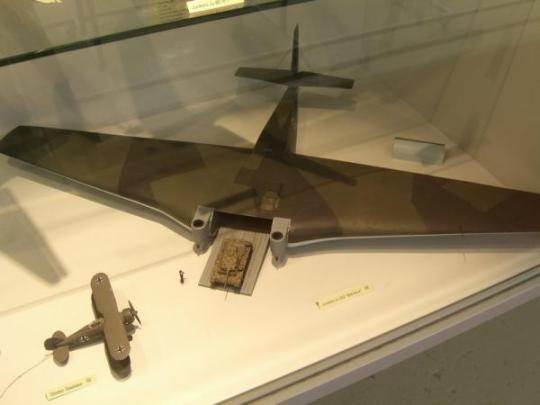
The Junkers proposal - the Ju 322 - would be a massive blended wing/body design. The wing center section contained a spacious cargo bay, with doors opening forward to load and unload cargo. Because of the location of the cargo bay, the cockpit was offset to the port to keep the profile low. Though the two prototypes were unarmed, the production aircraft would be fitted with two MG 15 machineguns on either side of the cargo bay doors. Because of the restriction on strategic materials, the Ju 322 was built entirely of wood. Unfortunately, this construction choice would be the project’s downfall. Junkers lacked experience with such construction practices, leading to a heavier than expected design that had just a 16 ton payload. After tank loading tests showed the structure was inadequate, the aircraft was revised, cutting payload down to just 11 tons. Nevertheless, the glider would make its first flight in April 1941, towed by a Ju 90. Tests found the glider to be unstable under tow but controllable in gliding flight. While Junkers had various improvements planned for the design, they would never materialize - the RLM ordered the project cancelled in May 1941.
Messerschmitt Me 321 Gigant

Messerschmitt opted for a more conventional design, initially designated Me 263. Later redesignated Me 321, the aircraft made use of steel tube framework and wooden spars covered in fabric for quick construction and easy repair. Standing over 6 meters high, the fuselage carried a spacious payload bay with 100 square meters of space for a total capacity of 23 tons or 130 troops. Large clamshell dooors in the nose allowed cargo to roll on and off. Jettisonable four-point undercarriage was made, consisting of Bf 109 tailwheels and Ju 90 main wheels. For defense, four MG 15s were provided at various points around the aircraft. The first Me 321 prototype took flight in February 1941, towed aloft by a Ju 90. The Ju 90 had difficulties towing the aircraft aloft, so three Bf 110s flying in formation were used for most of testing. Nevertheless, this was a dangerous maneuver, so Heinkel was asked to create a dedicated towing platform (resulting in the He 111Z).

Despite the Me 321’s unwieldy size, it proved satisfactory enough to be ordered into production. It would enter service just before Operation Barbarossa began, allowing it to serve in the invasion of Russia. Service of the type uncovered numerous issues. Even ignoring operational problems endemic to gliders, the Me 321 was impossible to move on the ground without specialized vehicles, and, until the introduction of the He 111Z, the Me 321 had a cripplingly short operational radius of just 400km. During 1941, an accident claimed a Me 321 and all three tow Bf 110s, resulting in 129 deaths - the worst air accident until 1960. In 1942, the surviving Me 321 fleet was withdrawn to Italy in preparation for a planned invasion of Malta, but the operation was abandoned due to a lack of tow aircraft. They returned to Russia as part of the Stalingrad relief effort, but by the time they reached the theater, the last suitable airfields in the Stalingrad pocket had been overrun. By the end of 1942, remaining Me 321s were either retired or converted to powered Me 323s.
Douglas XB-19
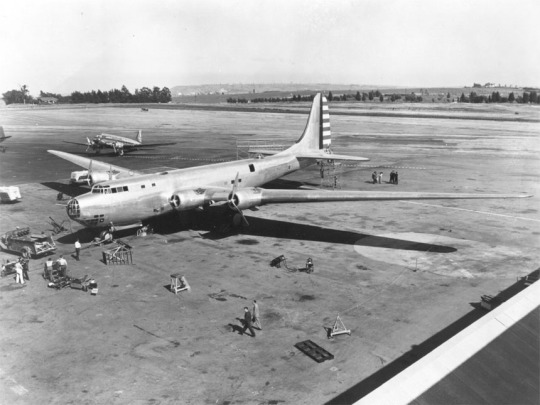
In 1935, the USAAC initiated a program to develop a bomber with the maximum possible range. Preliminary discussions led to Douglas and Sikorsky receiving the designations XBLR-2 and -3, respectively, to develop designs, which were to be flying by 1938. Both companies produced mockups by 1936, and, with Douglas’s design being deemed superior, the XBLR-3 was cancelled to make way for the Douglas aircraft. Soon after the selection, however, the BLR designation was dropped along with the long-range bomber program. The Douglas design survived, now designated XB-19, but it would suffer from a chronic lack of funding. The XB-19 would take shape as a massive four-engined bomber, powered by four Wright Cyclone engines mounted on a large wing vaguely reminiscent of Douglas’s famous DC-3. Crewed by 18 men, the bomber would have a bomb bay capable of carrying 18,700lb of bombs, with external racks bringing total overload payload to over 37,000lb. Though light in retrospect, defensive armament was heavy for the time - five .50s, six .30s, and two 37mm cannon.
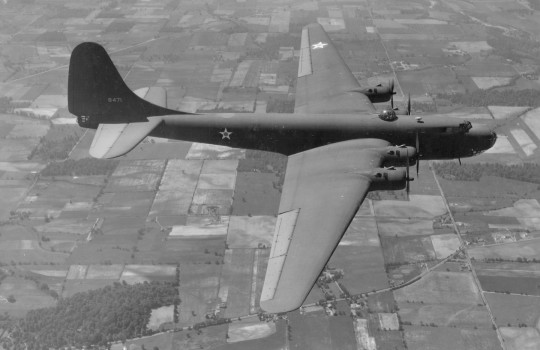
For all the bomber’s impressive stature, the program was hardly going well. Funding for the project was sporadic and inadequate, and the advanced design rapidly fell behind schedule. In 1938, Douglas recommended the XB-19 be cancelled, but the USAAC refused. Only in 1941 was the XB-19 finally completed, by which time the Army no longer had any serious plans to use the aircraft as anything but a testbed for construction techniques for large bombers. Despite being three years behind schedule, the XB-19 performed reasonably well when testing finally began in 1941. It was accepted into USAAC service the next year, and in 1943 it was fitted with more powerful Allison liquid-cooled engines. Upon its acceptance by the Army, it would live out its career as a domestic cargo carrier, ultimately making its last flight in 1946. The newly established Air Force had plans to preserve the aircraft, but, without any established museums to store the behemoth, it was scrapped in 1949.
Messerschmitt Me 323 Gigant
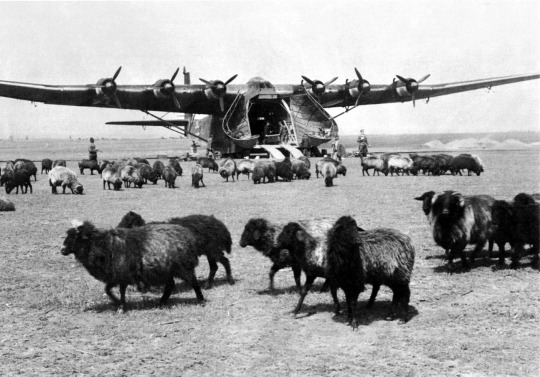
Though the Me 321 had provided the Luftwaffe with the ability to airlift tanks, there were still many flaws in the design, particularly relating to deploying it as a glider. Thus, early on in the service of the aircraft, it was decided to produce a powered variant under the designation Me 323. Initial tests involved a simple mounting of four Gnome et Rhone GR14N radial engines (French engines so as to avoid further straining domestic industry) on a strengthened wing. Undercarriage was fixed, although a streamlined shroud was placed around it. The results of preliminary testing were underwhelming. The four-engined Me 323 was 50mph slower than the Ju 52, and, more critically, it still required a tow aircraft to get airborne while fully loaded. Because of these shortcomings, Messerschmitt would mount two more engines on the second prototype, allowing it to operate independently. Other modifications included an expanded crew (two flight engineers joined the original crew of three), complete with engineer’s stations (and guns) in each wing. Payload dropped to 12 tons and performance remained underwhelming, but the Me 323 was nevertheless capable enough to be ordered into production.
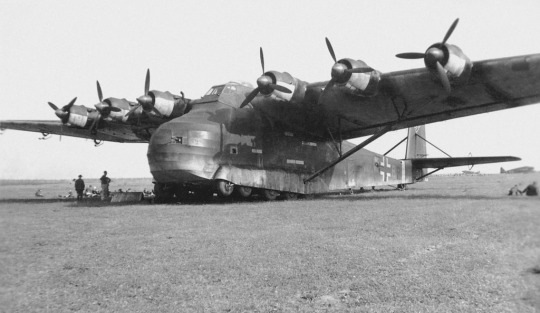
Nearly 200 Me 323s were constructed, with several converted from Me 321 gliders. When they entered service in the latter half of 1942, they would become the heaviest transport aircraft to serve in the war. They would make their operational debut in the closing stages of the North Africa campaign, serving in the strategic airlift effort to Tunisia that became necessary as Allied anti-shipping efforts became increasingly effective. While the Me 323 offered a unique airlift capability due to their heavy capacity and resilient structure, they were still incredibly vulnerable. In April 1943, a formation of 27 transports was intercepted by seven squadrons of Allied fighters. Despite escort from JG 27, they suffered the loss of 21 Me 323s for the downing of just three enemy fighters. Losses over North Africa were high as the Allies gained air superiority, ultimately claiming most of the fleet. The Me 323 would serve into 1944, making appearances in several other major operations (particularly over Crimea in 1944), but it seems that none of the fleet remained operational by the end of 1944.
The American Long-Range Bomber
Though the USAAC’s 1935 long-range bomber program would come to an end in 1936, the push to create a bomber with an intercontinental range would persist. In 1938, a new program to create a high-performance long-range bomber began, with Boeing contracted to begin preliminary development. In December 1939, a formal specification - calling for a payload of 20,000lb, operational radius of over 2,500 miles, and top speed of 400mph - was issued, with Boeing, Consolidated, Douglas, and Lockheed receiving contracts. Though Lockheed and Douglas would soon drop their projects, Boeing and Consolidated soldiered on, producing the B-29 and B-32, respectively. Given the requirements issued, the resulting aircraft were unsurprisingly massive, marking some of the largest combat aircraft of the war.
Lockheed L-249/XB-30

Lockheed’s bomber proposal, which received the designation XB-30, was the smallest of all designs submitted. Based off of the still-developing L-049 Constellation airliner, the XB-30 would be powered by the same Wright Duplex-Cyclone radial engines of the airliner and retain the same wings and tail. An all-new fuselage would carry six defensive turrets (two dorsal, two ventral, one nose, and one tail) carrying ten .50s and a single 20mm cannon - all remotely controlled to allow the fuselage to be pressurized. Two ventral bomb bays would be installed as well, providing a total payload capacity of 16,000lb. Coming in at a max takeoff weight of just under 100,000lb, it was considerably heavier than the Constellation it was based off of, but it had markedly better performance projections, including a top speed of 382 mph and an operational range 1,000 miles longer. Unfortunately, the design would not leave the drawing board - Lockheed dropped it early in development when it became clear that Boeing had a two-year head start on development.
Douglas XB-31

Whereas Lockheed had produced the lightest of all proposals, Douglas took a different approach, resulting in the largest design to receive a contract. The XB-31 also made use of four Duplex-Cyclones and a pressurized cabin, but the aircraft itself was massive. The shoulder-mounted wing was to be over 200 ft in span, while the max takeoff weight would be just short of 200,000lb. Defensive armament was comparatively light, with four .50s placed in dorsal and ventral turrets and two 37mm cannon in a tail position, but payload was very heavy at 25,000lb. Unfortunately, the design couldn’t hope to compete with the Boeing design. In late 1941, with Boeing and Consolidated having received contracts for further development, the XB-31 was canceled without ever leaving the drawing board.
Consolidated B-32 Dominator
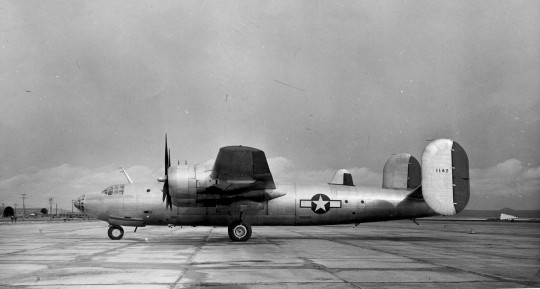
The Consolidated proposal would be heavily based off of their successful B-24 Liberator design, sharing its high aspect ratio wing and double tail in its original incarnation. Contracted as the B-32, the bomber featured an all-new pressurized fuselage and remote-controlled retractable defensive turrets with a total of 14 machineguns. Power would come from four Duplex-Cyclones, and gross weight would be just over 100,000lb. The first prototype would fly on September 7, 1942, but it was a far cry from the final design. Issues with cabin pressurization, landing gear, and gun turrets meant that the XB-32 lacked a pressurized cabin, landing gear doors, and defensive armament. Additionally, persistent issues with the engines plagued the design (as they would with the B-29). Eventually, armament was installed in the form of eight machineguns in dorsal and ventral turrets and a combination of two machineguns and 20mm cannon firing rearwards from the outboard engine nacelles.
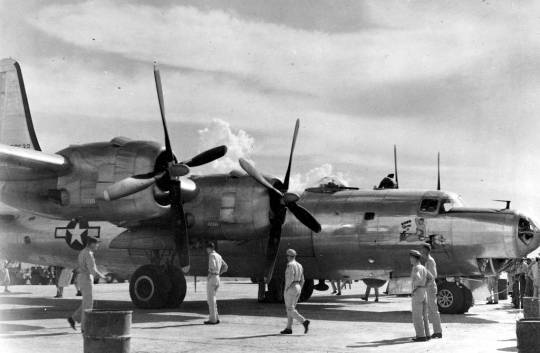
A contract for 300 B-32s was placed in March 1943, but development issues only intensified. The XB-32 prototype crashed in May 1943, and the second prototype would only be ready to fly that June. Stability issues were found, leading to the replacement of the double tail with a larger, more conventional single tail. Meanwhile, persistent problems with the pressurization and defensive armament spurred the decision to repurpose the design as a medium-altitude bomber. Pressurization was dropped, and the complicated remote-controlled turrets were replaced with conventional manned ones. By 1944, testing had gone well enough for the order to be expanded to 1,500 aircraft. The first delivery of a production aircraft came in September 1944. Unfortunately, the first deployment wouldn’t come until May 1945 in the Philippines. The first combat missions were flown against Formosa as the sole squadron to fly the type transitioned. Ultimately, just 10 combat missions were flown before the war’s end. In the last days of the war, they were relegated to reconnaissance missions, continuing these sorties until the end of August, when the unit was stood down. Production was cut in September 1945 with only 118 aircraft completed, and the bomber was almost immediately retired in favor of the more capable B-29 at the end of the war.
Boeing B-29 Superfortress

With work starting back in 1938, Boeing had been working to roughly adapt their B-17 into a longer-ranged bomber with a pressurized cabin. However, when their Model 345 was contracted as the B-29 in May 1940, there was little resemblance between the new design and the older B-17 apart from the tail. The new pressurized fuselage of the B-29 included a glazed nose and stepless canopy, while its four defensive turrets (two dorsal and two ventral) were all remotely controlled. Two bomb bays straddled the wing spars, providing a total payload capacity of 20,000lb, and long, thin wings would provide for excellent performance at altitude. Due to the promise the design showed, the initially contracted order for 250 aircraft ballooned to 500 by January 1942. In late September, the first XB-29 would fly. Though it lacked any armament, the second prototype (flying at the end of December 1942) would be closer to the production design.
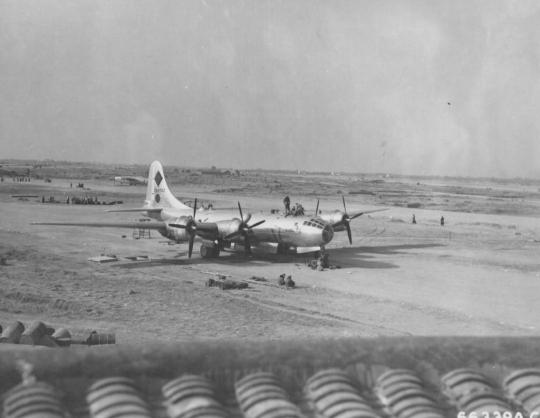
Unfortunately, testing was plagued with many issues. An engine fire caused the crash of the second prototype in February 1943, and continual modifications meant that production was also delayed. Even once deliveries of production aircraft did begin, most were flying straight from the factory to a depot for modifications to meet the latest standard for the aircraft. Because the B-29 was much larger than anything else in service, however, storage became an issue, and many would be damaged by inclement weather. By the end of 1943, only 15 of the 100 B-29s delivered were flyable. Intervention from General Hap Arnold sped the modification process, but it wouldn’t be until 1944 that the B-29 would reach operational service. Even then, many issues persisted, especially with the temperamental engines.
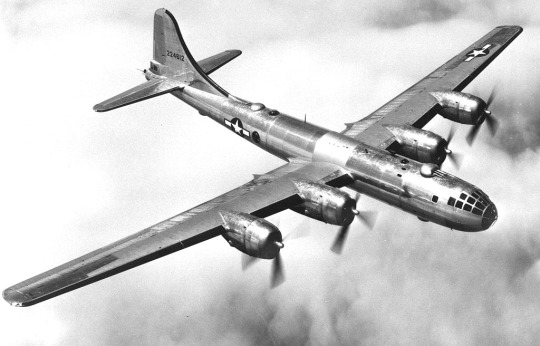
Though original plans had called for the B-29 to make its debut in Europe, the B-17 and B-24 were doing well enough there that it was decided to instead send the bomber to the Pacific, where it would be the only aircraft capable of striking Japan. Plans called for the bombers to operate out of southern China, with supplies being airlifted in over the Himalayas. The first B-29s arrived at their bases in China in April 1944, and on June 5, the first combat mission came when 77 B-29s were launched against targets in Thailand. Though they suffered no losses to enemy fire, the poor reliability of the bombers meant that 5 aircraft would still be lost. Ten days later, 47 B-29s made their first raid on Japan, striking the steel works at Yahata. Unfortunately, they did little damage, missing their target and losing two of their number to enemy fire. Just as bad, the raid exhausted the fuel stocks, forcing the raids to pause until more fuel was flown in. Due to the difficulties associated with operating out of China, B-29 operations were never very intense from the region. Raids continued across Southeast Asia and Japan, but by January 1945 the last B-29s were withdrawn from China.

Because of the difficulties of operating out of China, an operation was launched to capture the Marianas Islands, which would bring Tokyo in the range of the B-29s. Once the islands came into Allied hands, five airfields were constructed, providing enough space for 180 B-29s to operate. B-29s began arriving on Saipan in October 1944, and by the end of the month they had launched their first raid (against Truk). By the end of the year, raids against Japan had begun, with 111 B-29s sent against Tokyo on November 24. The results of these early raids were mixed. The B-29s flew high and fast enough to make interception by enemy fighters difficult, and early on in the raids the Japanese were already resorting to fairly desperate tactics such as ramming. However, the high-altitude attacks with regular high explosive bombs weren’t nearly as effective as planners had hoped.
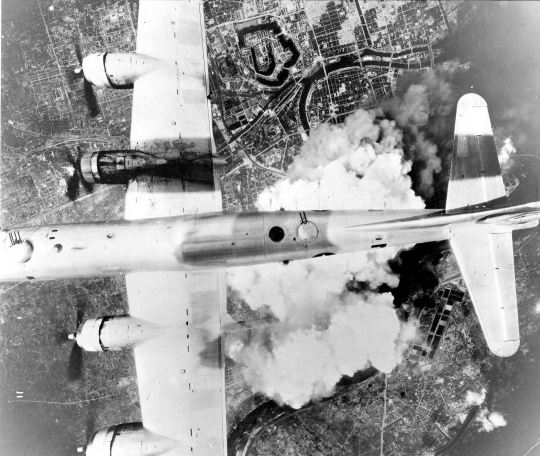
The solution to the B-29’s bombing problems would come in the form of the firebombing campaign. In early March, the B-29s changed tactics, abandoning high-altitude daylight raids in favor of low-altitude (5,000ft) night bombing with incendiaries. Operation Meetinghouse - the raid on Tokyo - would be the first of these missions. On March 9/10, 279 bombers dropped 1,665 tons of bombs on Tokyo. The resulting fire destroyed 7% of the city, killing some 80,000, injuring a further 40,000, and leaving roughly a million without homes. Despite the vulnerable low-altitude approach, the bombers had suffered few losses - just 14 B-29s were lost, while a further 42 were damaged. Over the next week, these raids hit Nagoya, Osaka, and Kobe, with similarly devastating results. Though the conventional high-explosive raids would also continue, the firebombing of the cities would be the most devastating element of the bombing campaign up until the end of the war.

Of all the B-29’s missions, the atomic bomb raids on Japan would undoubtedly be the most famous. Though the B-29 was by far the most capable bomber in the USAAF inventory, the sheer size of the atomic bombs meant that serious modifications would have to be made to allow the bomber to carry the weapons. Under the codename “Silverplate,” 65 B-29s were configured to carry atomic bombs. Modifications involved the removal of the defensive turrets and the enlargement of the bomb bays into a single 33-ft bay (long enough to carry the cancelled Thin Man bomb). A Silverplate B-29 named Enola Gay would make history on August 6, 1945, when it delivered the gun-type Little Boy bomb to Hiroshima. Three days later, Bockscar dropped the second bomb - the implosion-type Fat Man - on Nagasaki. Several days after the obliteration of the two cities, on August 15, 1945, Japan surrendered to the US.
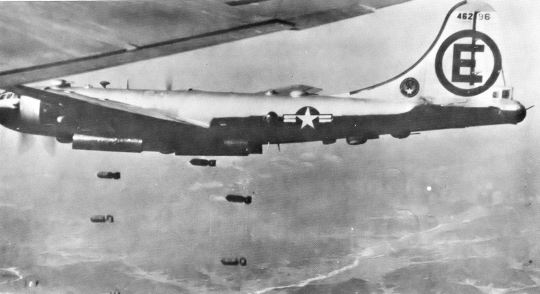
B-29 production would end in 1946, with all surviving examples passing on to the newly formed USAF. The 65 Silverplate B-29s would form the backbone of SAC’s nuclear deterrent until the B-36 and B-50 entered service, and in the years following WW2, they would be the primary means for testing nuclear weapons. As more capable bombers took over its strategic role, reconnaissance, ELINT, and tanker variants would be developed, extending the B-29’s service. Though the B-36 would begin to replace the B-29 in 1949, the B-29 would be the only strategic bomber to fly in Korea. Unfortunately, five years of technology advancing seemed to have caught up with the B-29. The arrival of the MiG-15 in Korea saw a surge of losses, and very quickly the B-29s were limited to night missions. Despite the restrictions, however, the B-29 performed admirably over Korea - 20,000 sorties were flown, dropping 200,000 tonnes of bombs.
Latécoère 631

The largest flying boat to be built in France would be the result of a 1936 specification issued by the French government calling for a 40 passenger airliner with a 4,000km range. Latécoère designed a six-engined flying boat with unique retractable outrigger floats and a double tail. The crew sat in a deck above the passenger compartment, with the cockpit placed just ahead of the wing leading edge. An order for a prototype was placed in 1938, but work would be suspended with the outbreak of war. Only after the 1940 Armistice did work on the Latécoère 631 resume, allowing the aircraft to make its first flight in November 1942. It was confiscated by the Germans and flown to Lake Constance, where it remained until it was destroyed in an air attack in 1944. Despite the loss of the prototype, work continued on the project in 1945 after the liberation of France. Nine production aircraft were built, flying with several airliners starting in 1947. However, by then, the era of the flying boat airliner was over. Already uneconomical to operate, its service was marred by a series of accidents that led to the withdrawal of the type from service within 10 years of its introduction.
Dornier P.192/Do 214
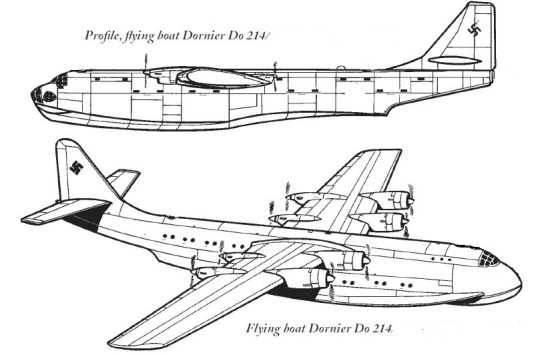
In the early years of the Second World War, Dornier began work on a massive new flying boat airliner project under the internal designation P.192. Intended to operate as a transatlantic airliner, the P.192 was a double-decker design intended to carry up to 15 crew and 40 passengers in extreme luxury. Powered by eight DB 613 engines in a push-pull configuration, the aircraft was projected to have a gross weight of 145 tons, making it the largest aircraft in the world. In 1940, a 1:5 scale glider was tested to validate the design, and in 1941 the aircraft received the RLM designation Do 214. Work got as far as a fuselage mockup, but in 1942 the focus of the project abruptly changed when the RLM ordered Dornier to focus on a militarized variant. The militarized variant seems to have added a small bomb bay and several defensive turrets around the aircraft, but it would never leave the drawing board. By 1943, the worsening war situation had convinced the RLM that there was no longer a need for such a flying boat, so the Do 214 was terminated.
Martin JRM Mars

In 1938, the USN placed an order with Martin for a long range patrol bomber, designated XPB2M-1. Taking flight in June 1942, the XPB2M was the largest flying boat in the world at the time, coming in at a gross weight of 90,000lb and max takeoff weight of 165,000lb. Compared to the final design, the XPB2M differed in that it featured a twin tail and several defensive turrets. Testing was delayed by an engine fire, but the aircraft passed testing by 1943 and was passed onto the Navy. By then, however, the patrol bomber concept was obsolete, so the Navy repurposed the prototype as a transport. Armament was removed, and the twin tail was replaced with a more conventional one. The aircraft was redesignated JRM, and an order for 20 was placed.
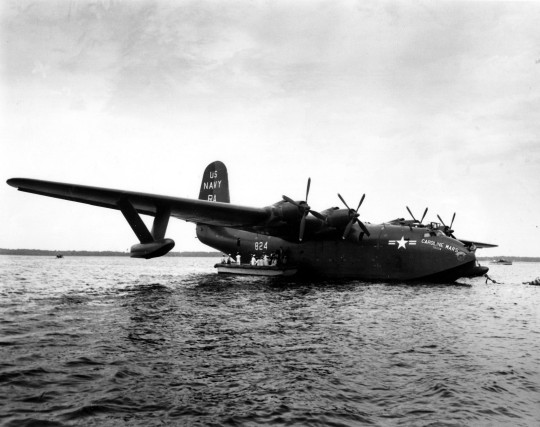
Unfortunately, the first JRM wouldn’t be delivered until June 1945. The first four production aircraft would be built to the JRM-1 standard - with a simplified structure that reduced airframe weight to increase payload - but the final aircraft would replace the Wright Cyclones of the original design with 3,000hp Pratt & Whitney Wasp Majors, vastly improving performance. Nevertheless, the end of the war saw production cut, and only six production JRMs would ever enter service. Initial service saw the JRM ferrying cargo around the Pacific. In 1949, a JRM would set the world passenger record when it carried 269 people aloft, and a year later one of the aircraft was lost in an engine fire. The remaining four aircraft continued to fly cargo between San Francisco and Honolulu until 1956, when they were retired. They were slated to be sold for scrap, but a Canadian company bought up the aircraft and all their spares. They were converted to water bombers, allowing them to carry up to 30 tons of water. Though one Mars was lost in an accident and another damaged beyond repair by a typhoon, the surviving two aircraft served beyond 2010. Currently, there are plans to convert the survivors to museum pieces.
The Amerika Bomber
Long before America entered the Second World War, there was great interest in Germany for a bomber with the range to strike American cities. With the idea of operating from the Azores Islands, the RLM issued requests to various German companies to develop a bomber. Once America officially entered the war, the Amerika Bomber became official - a project plan was completed in April 1942. Though realistically these raids would be little more than harassment, the hope was that such raids would force America to devote large amounts of resources to domestic air defense. Though the Amerika Bomber raids never materialized (Portugal ended up leasing the Azores to the British in 1943), the bomber projects persisted as the RLM hoped to repurpose them for long-range maritime patrol.
Messerschmitt Me 264
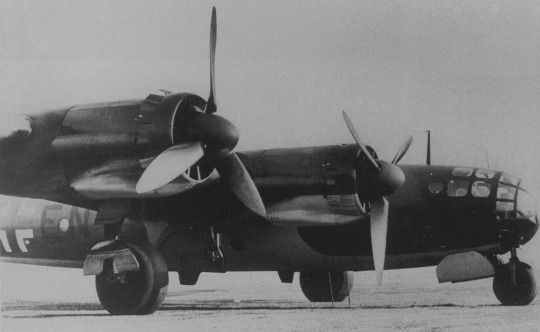
The first of the Amerika Bombers to take flight would be Messerschmitt’s Me 264. The Me 264 could be traced back to 1937, when Messerschmitt created a series of long-range aircraft projects. Though work was low priority at first, the request for proposals in 1940 for a long-range bomber caused Messerschmitt to accelerate development. Contracted as the Me 264, the resulting bomber was a large four-engined machine with long tapered wings and a stepless canopy. With crew concentrated in the nose, the bomber could reduce the weight of armor. Defensive armament was light, consisting of remotely-controlled guns. Details like engines, range, and payload changed over the course of development, with work still progressing slowly due to the high demand for other Messerschmitt designs. Ultimately, the configuration settled on made use of four BMW 801 radial engines, providing for a range of roughly 15,000km and payload of about 5 tons. Much of the aircraft’s 45 ton gross weight was devoted to fuel, with Messerschmitt sacrificing everything from armor to payload to meet the range requirements.

The first Me 264 prototype would fly on December 23, 1943. Minor issues were found, particularly owing to high wing loading, but the bomber was satisfactory. The second prototype was to improve on the design’s failings, adding a metric ton of armor and extending the wingspan to reduce wing loading. However, it was destroyed in an air raid before it could begin testing. Over the course of testing, the project fell into confusion over its status in the Amerika Bomber competition. Ultimately, continued support for the Me 264 was assured by Hitler himself, but only as a maritime patrol aircraft, as the Amerika Bomber program was soon to be dropped. However, the Kriegsmarine had little interest in the aircraft, and in October 1943, Erhard Milch ordered the Me 264 cancelled. It seems that testing still continued on very low priority, with the first prototype operating with Transportstaffel 5 while the third prototype was being completed. However, on July 18, 1944, an Allied bombing raid hit the airfield where both aircraft were stored, destroying the incomplete third prototype and damaging the first. Though effectively terminated, the Me 264 project nominally continued until finally officially cancelled on September 23, 1944.
Junkers Ju 390

The Junkers proposal for the Amerika Bomber project was conceptually the simplest of the designs that gained official support. Derived from the Ju 290 design (itself an enlarged, militarized version of the Ju 90 airliner), the Ju 390 took the designs to the next level, enlarging them once more. Two prototypes were constructed in 1943, with Junkers engineers merely extending the fuselage of a Ju 290 and adding an extra set of center wing sections to extend wingspan and add two more engines. With this simple conversion, the bomber was now the largest aircraft in the world, with a max takeoff weight of over 75 tons and wingspan of 165 feet. The first prototype would fly in October 1943 - after the Amerika Bomber was cancelled - but it gained the attention of the RLM and Kriegsmarine, who ultimately placed contracts for 26 Ju 390s to serve as maritime patrol aircraft.
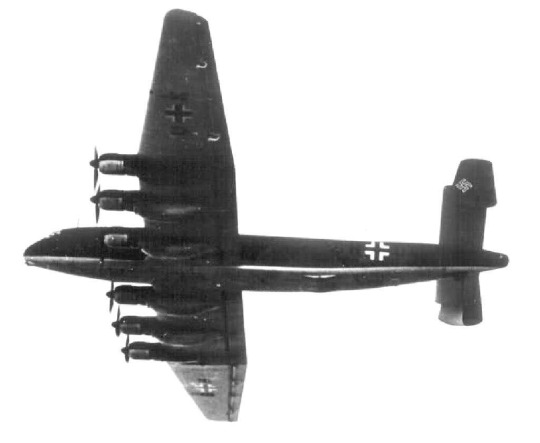
The details of the second Ju 390 are unclear. Historians disagree on when exactly it was completed (ranging from October 1943 to June 1944), but it appears that it was configured as a maritime patrol platform, complete with a bristling armament of various machineguns and cannon and a air to surface radar. Ultimately, the worsening war situation saw the cancellation of the production contract in June 1944 and complete cessation of all work in September of that year. The first prototype was returned to the factory in Dessau in November 1944, where it was stripped for parts and ultimately destroyed as American troops approached. The fate of the second prototype is unclear - pilots reportedly flew it as late as February 1945, while the chief designer of Junkers claims that the second Ju 390 was never completed.
Focke Wulf Ta 400
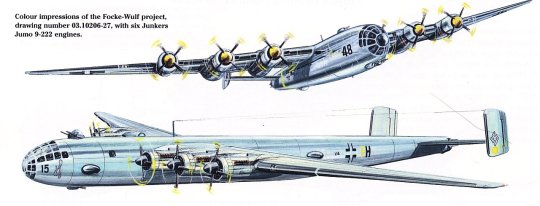
Focke Wulf’s Amerika Bomber - a six-engined machine - would receive the RLM designation Ta 400. Design work began in 1943, with most work outsourced to French technicians to speed development. The design that took shape made use of a shoulder-mounted wing and double tail, with six BMW 801 radial engines mounted in the wing. A crew of nine was split between a forward and aft pressurized compartment. The forward compartment encompassed a stepless canopy that contained the pilots and bombardier, and a rear compartment that held the gunners. Defensive armament was placed in remotely controlled turrets and a tail position, with turrets controlled from positions in bubble canopies along the fuselage (similar to the B-29). At a gross weight of 50 tons, the TA 400 was to have a maximum range of 9,000km with a payload of 10 tons of bombs. In overload conditions, it was envisioned to be able to carry over 24 tons of bombs. Later versions of the design would add two Junkers Jumo 004 turbojets, while other variants included DB 603 engines would extend range to as far as 14,000km. Ultimately, the Ta 400 would never leave the drawing board. It was considered a backup to the Me 264, so once the Me 264 showed enough promise, the RLM cancelled the Ta 400. Nevertheless, it appears work continued on low priority for some time longer, with Kurt Tank reportedly meeting with Italian industrialists about cooperative development in 1944.
Blohm & Voss BV 238
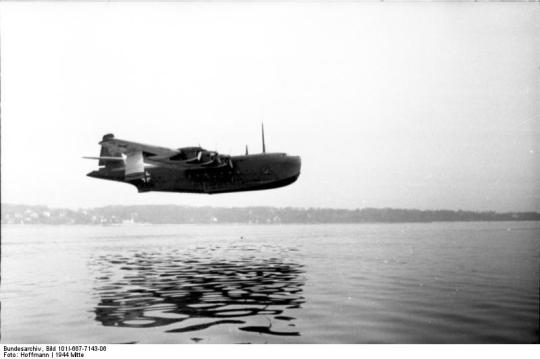
Though Blohm & Voss’s BV 222 flying boat was already far larger than anything else in German service, the company had its sights set on an even larger design. Intended to serve as everything from a maritime patrol aircraft to bomber to heavy transport, the BV 238 was the largest Axis aircraft to fly during the war. Coming in at 100 tons max takeoff weight, the BV 238 had a wingspan of nearly 200 feet and was powered by six DB 603G engines. A crew of 12 was to man the machine, which was bristling with guns. Quad 13mm machinegun turrets were placed in the nose, tail and wings, and twinned MG 131s were placed in waist positions. A dorsal turret was also installed, fitted with two 20mm cannon. Bomb bays in the wings provided space for up to 20 SC 250 bombs, while external racks could carry various larger payloads. The sole BF 238 prototype took flight in April 1944, long past the point where such a heavy flying boat was within the RLM’s requirements. It appears that it never saw any significant service, and it’s unclear if it even finished testing. Whatever the case, it caught the attention of the Allies, who feared the bomber would be used to allow top Nazi officials to escape as Germany crumbled. It was strafed at anchor and sunk sometime in the closing days of the war. Two other prototypes were started, but never completed before the war ended.
Nakajima G10N Fugaku

In 1942, the IJA issued specifications for a bomber capable of striking the continental US from the Kuril Islands. Dubbed “Project Z,” the bomber would not return to Japan, but rather overfly the whole of the US to land in German-occupied Europe. Nakajima would initiate design efforts for the bomber in April 1943. It became a joint Army-Navy project, gaining the designation G10N. Initial plans called for the G10N to mount six Nakajima Ha-505 engines producing 5,000hp. With these powerplants, the G10N would have a wingspan of over 200ft and a gross weight of 120 tons (MTO of 160 tons). However, delays in development of the engines forced Nakajima to settle on the 2,500hp NK11A engines instead. This forced a substantial redesign to preserve performance. The result was an aircraft slightly smaller in dimensions with a similarly impressive range, but significantly lighter - loaded weight was now just over 40 tons, while max takeoff weight was 70 tons. While this design would prove far more practical, it wouldn’t leave the drawing board, with the war ending before any significant progress could be made on the design.
The American Superbomber
In early 1941, the USAAC initiated a program to create a bomber capable of striking targets in Europe from the mainland US, fearing that Britain would fall to German forces. In April of that year, requirements were issued calling for a bomber with a 450mph top speed, 275mph cruise speed, ceiling of 45,000ft, and a maximum range of 12,000 miles. These requirements quickly proved impractical, so requirements were refined. Service ceiling and cruise speed dropped slightly, and range requirements were refined to call for an operational radius of 4,000 miles with a 10,000lb payload. The requirements were originally submitted to Boeing and Consolidated, though Northrop was added to the team a month later. Ultimately, only Consolidated (later Convair) and Northrop would receive contracts for development. Not too surprisingly, the requirements led to the development of some of the largest aircraft ever built.
Northrop YB-35
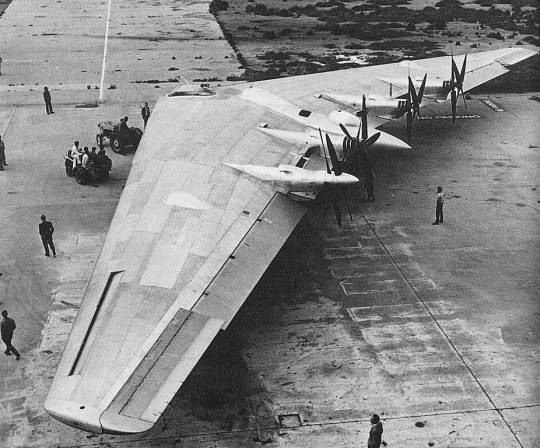
Northrop’s bomber proposal capitalized on their research with flying wings, scaling up their basic design to create a strategic bomber. The B-35 would have a fuselage-like cabin along the centerline to carry its crew of nine, complete with bunks for long flights. Twenty guns would be mounted along six remotely controlled turrets, and six bomb bays (three on either wing) were to carry a payload of over 50,000lb. The bomber itself was a 172 ft flying wing, powered by four Pratt & Whitney Wasp Major engines in a pusher arrangement. With a loaded weight of 180,000lb, the B-35 was far larger than any bomber to fly in WW2, and, with a range of over 8,000 miles, it posessed a truly intercontinental range. The original contract for the XB-35 called for the bomber to be flying by 1943, but, given the advanced nature of the design and priority given to other projects, the first XB-35 wouldn’t fly until June 1946.
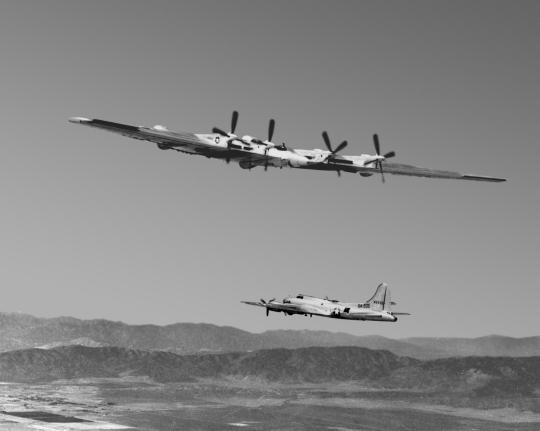
Unfortunately, the XB-35 would run into major problems. Though it had already received an order for 200 aircraft, the Air Force was reluctant to operate the plane, owing to issues with the original contra-rotating propellers and the more promising B-36 that the bomber was competing with. The original design’s bomb bays were too small to carry a nuclear weapon, but Northrop was not permitted to modify the design despite USAF insistence that they would not buy it unless it could carry the Mk.3 bomb. Despite issues, several pre-production YB-35s were built, the first of which flew in 1948. Meanwhile, the USAF ordered several airframes to be converted to the jet-powered YB-49 standard. Ultimately, however, Northrop was unable to overcome the issues. The YB-35 was outperformed by the B-36, and, though the YB-49 offered better performance, it lacked the range to compete with the B-36. In 1949, the B-35/49 program was controversially cancelled on grounds of the technical issues associated with the design, and all airframes were ordered scrapped.
Convair B-36 Peacemaker
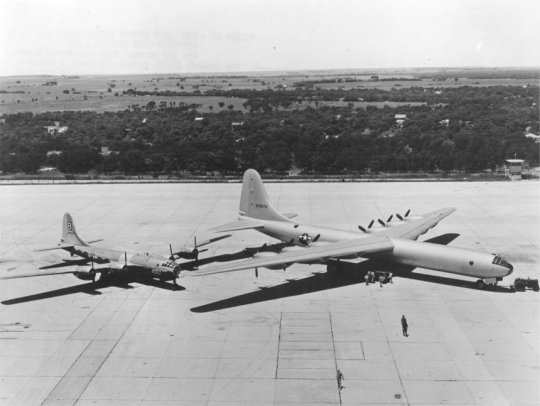
The competing design from Convair, designated B-36, was more conventional than the Northrop flying wing, but it would stand out due to sheer size. Standing 46ft high and 162ft long, the B-36 had the largest wingspan of any bomber ever (a record that holds to this day), with a span of 230ft. Its massive wings were seven feet thick at the root, providing enough space for a crawlspace to be added to service the engines. As originally designed, power came from six Wasp Major radials placed in a pusher arrangement driving the second-largest propellers ever fitted on an aircraft. Dwarfing everything else in terms of size, the B-36 was also incredibly heavy - it had a gross weight of over a quarter million pounds, and the max takeoff weight was over 400,000lb. The bomber carried a crew of 15 in a large pressurized fuselage, with a tunnel connecting the forward and rear compartments that straddled the four bomb bays. Defensive armament consisted of six retractable remote-controlled gun turrets, as well as fixed tail and nose positions. The centerpiece of the design, however, was the spacious bomb bays, which provided a total payload capacity of 86,000lb.

Like the B-35, the B-36 would not be ready to fly by the contracted 1943 deadline, instead taking flight in August 1946. Oddly enough, the unarmed pre-production B-36A would fly several months before the second prototype - the YB-36, complete with armament - flew. Despite teething issues just as bad as those experienced by the B-35, the B-36 would be ordered into service fairly quickly, owing to its record-breaking payload and 10,000 mile range. By the end of 1948, the first operational group of B-36Bs had been formed. The aircraft’s unprecedented size did present some issues, as there were no hangars large enough to house the behemoths, but otherwise they were serving well. On December 7, 1948, the B-36 demonstrated its true potential for the first time. Taking off from its base in Carswell, Texas, a B-36B flew all the way to Hawaii to drop a 10,000lb payload before returning home. The round trip, which was over 8,000 miles, took over 35 hours to complete.
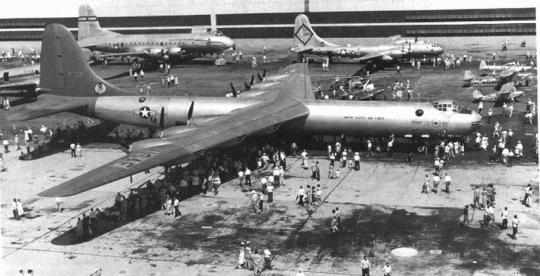
Despite impressive performance, the exorbitant costs, difficult maintenance, and high profile of the program in an era of budget cuts saw it be targeted for cancellation. It became a contentious issue, particularly between the USAF and USN. Fortunately, rising tensions between the US and USSR would save the B-36, as it was the only platform available to perform nuclear strikes on the Soviet Union. Fairly early in the B-36’s service, Convair finally decided to address complaints about poor performance. Though the B-36 had an impressive range, it had a poor power-to-weight ratio that led to excessive takeoff rolls and a poor climb rate. A fairly simple solution was found in the B-36D, which added twin turbojet engines slung outboard of the props on the wings. First delivered in 1950, 26 B-36Ds would be new-built, while 59 others would be converted from B-36Bs. Several RB-36Ds were also produced for strategic reconnaissance.
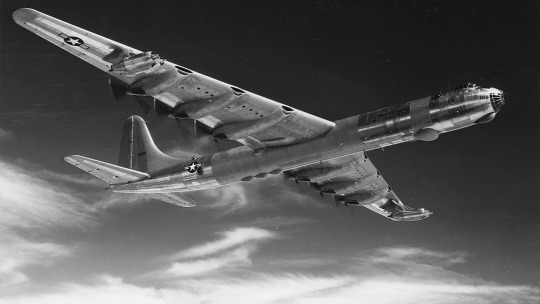
Though the B-36 would never drop a bomb in anger, it would have an extensive service career as a test platform. Being nuclear bombers first and foremost, they took part in several nuclear tests, sitting at a standoff distance to simulate the effects on a bomber as it escaped the target. Because the B-36 far outstripped the range of any fighters, it became the subject of various parasite fighter experiments.. Early experiments involved connecting wingtip-to-wingtip with various other aircraft (Project Tom-Tom) ranging from other B-36s and B-29s to F-84 fighters. Such an arrangement would allow the bomber to carry its own fighter escort, while docking with another bomber would increase fuel efficiency. While a crash during testing put an end to Tom-Tom, attempts to carry a fighter in the bomb bay went better. A specially designed parasite fighter, the XF-85, would take shape, and experiments were performed with both XF-85s and F-84s to test the efficacy of the arrangement. Ultimately, the parasite fighter concept proved impractical, though it was not a complete waste - 25 RB-36Ds were converted to the GRB-36D standard to carry RF-84Ks for reconnaissance missions. These saw limited service between 1955 and 1956, ultimately being phased out in favor of the far more practical and capable U-2.
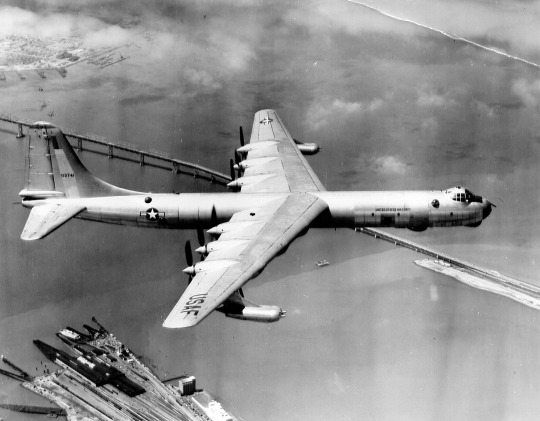
Having been kept out of Korea, the B-36’s only operational use would come as a strategic reconnaissance platform. Thanks to the extremely high service ceiling of the B-36, the bomber was selected for overlights of the edges of the Soviet Union. Such flights began in 1951, gradually probing the edges of the Soviet arctic regions. Ultimately, however, such flights were limited as Soviet air defenses rapidly expanded. Meanwhile, service in Korea and advances in air-to-air missiles had shown that the B-36’s operating altitude may not be as practical as expected. In 1954, the USAF began the Featherweight program, which stripped the now-obsolete armament from the B-36, reducing crew to 9 and lightening the airframe. Even so, the landing gear was strengthened and fuel tanks expanded, giving the bomber the longest range and highest max takeoff weight of any B-36 series. Such modifications significantly improved performance, increasing the operating ceiling to 47,000ft.
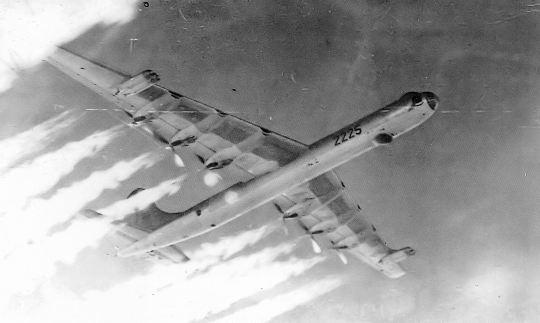
Ultimately, the B-36 was made obsolete by the rapidly advancing technology of the time. Slow and lumbering, it could no longer count on its high ceiling to protect it from fighters, even with the benefits offered by the Featherweight modifications. Though it had an impressive range and payload, it was incapable of performing aerial refueling, meaning it was unable to reach many bases deep in the Soviet Union. When Eisenhower came into office, modernization of the Air Force took priority, and in 1955, the process of phasing out the B-36 in favor of the B-52 began. Defense cuts would extend the B-36’s service life longer than expected, but SAC had phased out most of their B-36s by the end of 1956. By the end of 1958, only 22 B-36Js were still operational. Early the next year, the last B-36J was retired.
Hughes H-4 Hercules
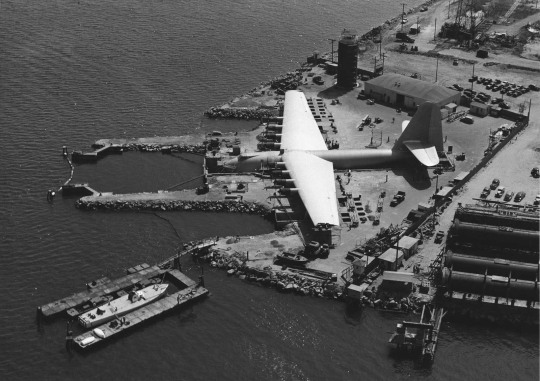
In 1942, the War Department was facing heavy losses of transatlantic shipping to U-boats. With the war still far from certain, requirements were issued for a transport aircraft capable of avoiding the U-boats altogether by flying over them - a concept tendered by the shipbuilder Kaiser. Kaiser would team up with Hughes to develop such an aircraft, aiming to create a transport made of non-strategic materials that could carry up to 150,000lb of materiel, including 750 troops or two M4 tanks. A contract was issued in 1942, calling for three prototypes to be constructed within three years. Kaiser deferred design to Hughes, who settled on a massive conventional machine powered by eight Wasp Major radial engines. With a loaded weight of 400,000lb to support, the H-4 was given the largest wings of any aircraft ever, complete with a 320ft wingspan.
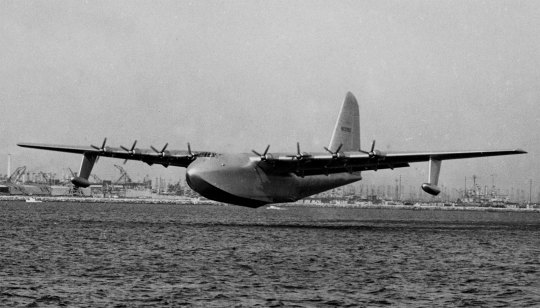
Unfortunately, the project soon ran into issues. Kaiser withdrew from the project soon after construction began due to restrictions placed on strategic materials and issues dealing with Howard Hughes. Hughes continued construction on his own, signing a revised contract for just a single example. The aircraft that took shape would be made primarily of a modern wood laminate, reducing the use of strategic materials. Nevertheless, the war came to an end without the project being completed. It soon came under scrutiny, and in 1947, Hughes was called before the Senate to testify on the use of government funds for the aircraft. During a break in the hearings, Hughes returned to California to finally take the H-4 to the skies. On November 2, 1947, the H-4 began taxi tests with Hughes at the controls. Two high speed runs were made, followed by a final run which brought the aircraft to 70 feet. Though still in ground effect during its brief flight, it seemingly vindicated Hughes’ controversial project. However, with the war over, there was no more need for the H-4. The aircraft would never fly again, with Hughes instead secretly storing it in a climate-controlled hangar, where it would remain, being maintained by company employees, until Hughes’ death in 1976.
Convair XC-99
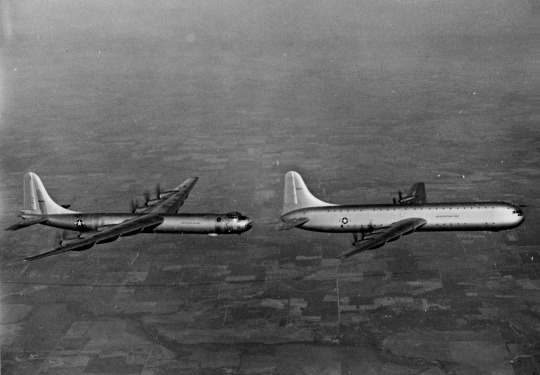
As Consolidated worked on the B-36, they were also considering a transport variant of the design. Developed internally as the Model 37, it would mate a new double-decker fuselage to the B-36 wings and tail, giving a capacity of 400 troops or 100,000lb of cargo. Though put on low priority, it was contracted for a single prototype as the XC-99. Because of the low priority, it wouldn’t fly until late November 1947. Unfortunately, by then, the USAF had no need for such an aircraft. Convair attempted to pitch the design to airliners, but its maintenance-intensive piston engines were not economically viable, and no suitable alternative powerplant was materializing fast enough. The sole XC-99 would make its way into USAF service. In 1950, it set a world record when it lifted 104,000lb from an airfield at 5,000ft. Though the Air Force claimed it had no need for the aircraft, they would get more than their money’s worth out of the prototype. Regular flights were made to ferry around B-36 supplies, and, until the XC-99’s retirement in 1957, the aircraft would log 7,400hrs of flight time.
Bristol Brabazon
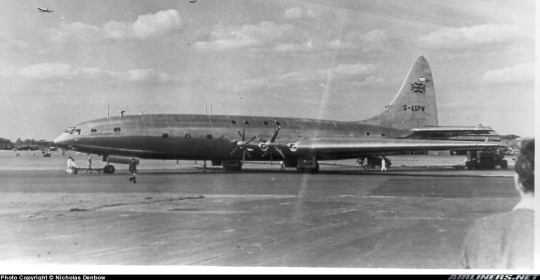
In 1942, recognizing the vulnerability of the British aeronautical industry in the postwar period due to the heavy reliance on American aircraft during the war, the British government set up a committee under Lord Brabazon to investigate postwar civil aviation needs. The Brabazon Committee would produce requirements for various airliners, including a very large transatlantic airliner. When formal requirements were issued, Bristol responded with a design derived from their work on heavy intercontinental bombers (that would remain paper projects) to develop the futuristic Type 167. Contracted as the Brabazon, the airliner had a futuristic appearance. Power came from eight Bristol Centaurus engines paired around contra-rotating propellers, and space was made in the fuselage for up to 100 passengers and 12 crew - all carried in luxurious conditions. To meet the necessary range requirements, the Brabazon had massive wings, with a total wingspan of 230ft. Construction of the Brabazon was difficult, as the aircraft was far larger than any of Bristol’s hangars. Building the prototype ultimately required the construction of an entirely new hangar for assembly and a 6,000ft extension to the 2,000ft runway at the factory to accommodate the new aircraft.
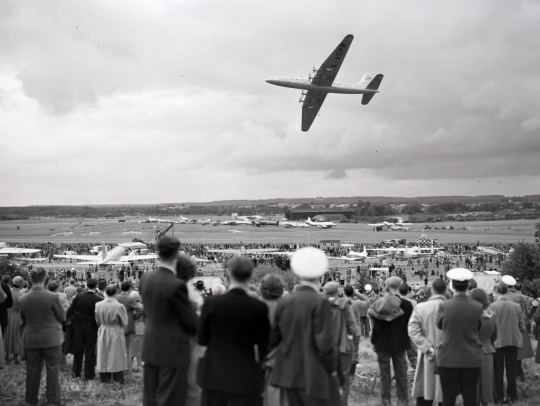
Because of Bristol’s inexperience with large aircraft, the Brabazon prototype wouldn’t fly until 1949. It made numerous public demonstrations at airshows in the coming years, and work was already beginning on a significantly improved turboprop-powered Mk II Brabazon. However, despite an aggressive marketing campaign, the Brabazon was failing to find any customers. Its massive size made it difficult to operate, and its small capacity relied on an outdated business model of expensive, luxurious flights for small numbers of wealthy passengers. In the end, it just wasn’t economical to operate. BOAC withdrew from the program in 1950, and no other customers would express interest in the Brabazon. In 1953, the program was finally cancelled - its only significant legacy being the rapid expansions of airstrips and hangars that were made to accommodate the massive airliner.
Saunders-Roe Princess

At the end of WW2, the Ministry of Supply put out a request for a long range flying boat airliner to serve with BOAC on transatlantic routes. Saunders-Roe responded with their SR.45 design, which was contracted as the Princess. The Princess was to be the largest all-metal flying boat ever, with a gross weight of 330,000lb. It made use of retractable outrigger floats that folded up into the wingtips, and was designed to carry a load of 137,000lb or 105 passengers in a luxurious pressurized double-decker cabin. Power came from ten Bristol Proteus turboprops, with two sets being paired together to drive the inboard set of contra-rotating propellers. Unfortunately, the advanced design slowed construction, and by the time the Princess first flew in 1952, BOAC had already deemed it to be surplus to their needs. Construction continued regardless, with plans changing to create three examples for the RAF. Ultimately, the test program was brief. Only one Princess would fly, making 46 flights for a total of 100 hours, while the others were mothballed without ever having engines installed. Saunders-Roe made several efforts to sell the aircraft in the years that followed, with Aero Spacelines finally buying the three Princesses in 1964 to use as freighters for Saturn V components. However, when taken out of storage, it was found that the aircraft were badly corroded. Thus, they were scrapped.
Douglas C-124 Globemaster II
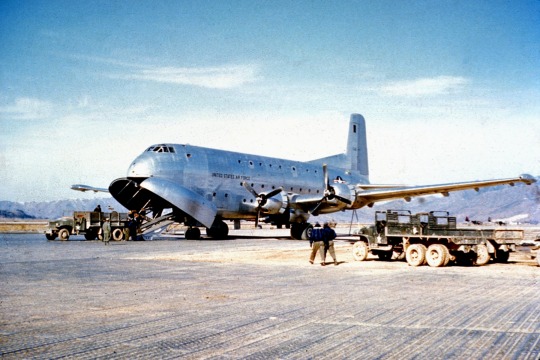
Following the success of Douglas’ C-74 Globemaster, the USAF would request a larger version that took advantage of lessons learned from the Berlin Airlift. Starting in 1947, Douglas produced a new design that shared the same wings, tail, and engines of the C-74. A new double-decker fuselage was added, featuring a 77ft cargo bay, clamshell doors, and strengthened landing gear. Cargo capacity was 74,000lb or up to 200 troops. Though based on the C-74, the significant change earned it a new designation - the C-124. The YC-124 would irst fly in November 9149, with deliveries of production aircraft beginning in May of the next year. Over 400 C-124s would be built, including 243 C-124Cs fitted with uprated engines, a nose radome, and heaters for the cabin and deicing systems.Operations were fairly quiet, though the airlifter would see service everywhere from Korea to Antarctica. SAC operated a number of C-124s to ferry around nuclear weapons and personnel. Though verging on obsolescence by the time the Vietnam War came around, it, along with the C-133, was the only heavy strategic airlifter in the inventory until the C-5 entered operational service. By Vietnam, however, its popularity was waning due to its slow speed. In 1970, it was phased out to ANG units, and by 1974, the C-124 had been completely retired.
Douglas C-133 Cargomaster
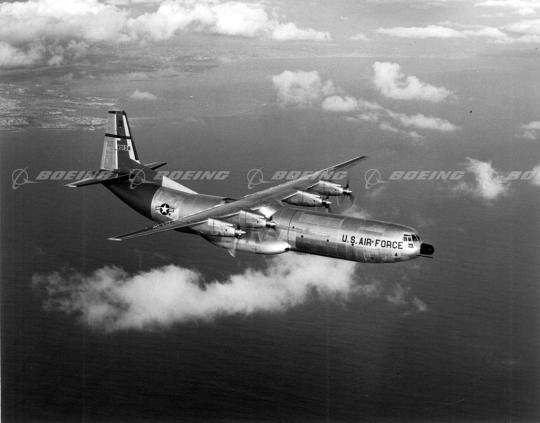
In 1952, the USAF issued requirements for a heavy strategic airlifter capable of carrying oversized cargo. Douglas began work on an all-new design in 1953, receiving a contract for the C-133 in 1954. No prototypes were constructed, with the first C-133A taking off in April 1956. The C-133 was a significant divergence from earlier Douglas transports. It used a shoulder-mounted wing and external fairings to house landing gear, allowing for a spacious 90ft long and 12ft high pressurized and climate-controlled cargo bay. The C-133 would enter service in 1957, and immediately they began setting records. Their first flight to Europe set transatlantic speed records for their class, and over the course of their service they would set several speed and payload records. A major part of the C-133’s service involved ferrying ballistic missiles from factories to launch sites, which the spacious cargo bay was perfectly suited for. With a payload capacity of 110,000lb, the C-133 would also prove invaluable as a strategic airlifter, particularly in Vietnam. However, it did have issues, particularly with the unreliable turboprop engines. High accident rates and poor availability rates plagued the career, and, though it was often used for ferrying materiel, it would never be used as a troop transport. Ultimately, the C-133 was withdrawn from service in 1971 owing to airframe fatigue issues.
Antonov An-22 Antheus “Cock”
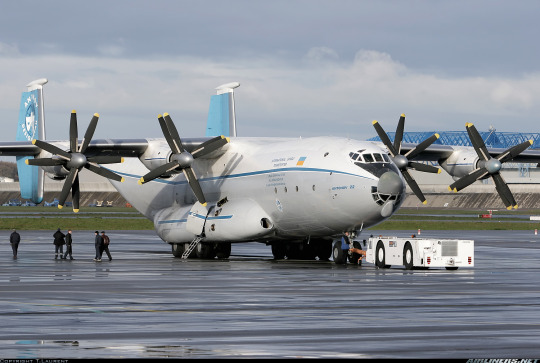
In the late ‘50s, Antonov began an effort to create a heavy airlifter to supplement the lighter An-8 and An-12. Designated the An-22, the aircraft in many ways resembled a scaled-up An-12, with a shoulder-mounted wing and four turboprop engines. Four 15,000hp Kuznetsov NK-12s - the same engines of the Tu-95 - drive contra-rotating propellers in the wings, and a massive double tail was used to keep the height of the tail within reasonable limits. First flying in late February 1965, it would make its public debut at the Paris Airshow that same year. There, the true scale of the machine became apparent. The An-22 has a payload capacity of 80 tons with a max takeoff weight of 250 tons, making it the largest turboprop aircraft in the world. Despite a massive size and comparatively small wings, the aircraft’s double-slotted flaps and rugged landing gear provide excellent performance from rough airstrips. The main cargo bay is 33 meters long, complete with a loading ramp in the rear. The cargo bay is pressurized, but to save weight, it can only pressurize to 3.55 PSI.

68 An-22s would be built over the course of the next decade, with aircraft evenly split between Aeroflot and the Soviet military airlift service. They would come to see service in just about every major Soviet airlift operation of the Cold War. In 1970, they delivered aid to Peru following an earthquake, and during the Ogaden War, they took part in the intensive airlift effort into Ethiopia. For domestic flights, they became invaluable for supplying the remote corners of the Soviet Far East, where they were the heaviest aircraft capable of operating in the rough conditions. It would remain the heaviest-lifting Soviet transport until the An-124 entered service in 1987. The An-22 survived the end of the Cold War, with most examples ending up in the hands of Russia. However, as Russia slowly works to modernize their fleet, the An-22 is in the process of being phased out in favor of the more capable An-124.
Lockheed C-5 Galaxy
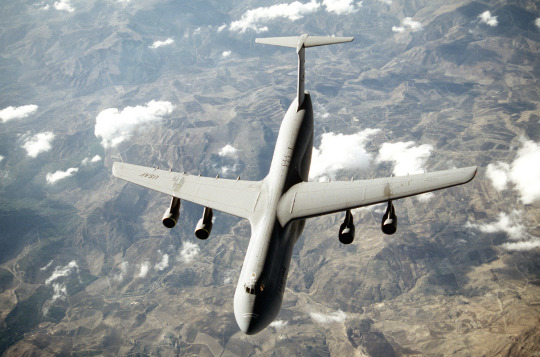
In 1963, the Military Air Transport Service put out a requirement for a new heavy strategic airlifter with a 8,000 mile range and 125,000lb payload - double that of the C-141 it was supposed to supplement. Lockheed, building on their experience with the C-141, produced a massive design with a similar configuration. The C-5, as it was contracted as, would have a shoulder-mounted wing with a 25 degree sweep, T-tail, four engines, and landing gear retracting into external fairings. Though similar in configuration to the C-141, it was considerably larger - in fact, it would be the largest aircraft in the world, a record it would hold until the An-124 took flight 15 years later. The centerpiece of the design was a 121ft long by 13.5ft high by 19ft wide cargo bay with clamshell doors in the rear and a nose that folded up in the front, providing for a total load capacity of 270,000lb. Forward of the wing is a crew compartment for a standard crew of 6 with bunks for a relief crew. Behind the wing, a deck holds seating for up to 75 passengers. The C-5 would fly for the first time in June 1968, seizing the title of largest aircraft in the world from the An-22.
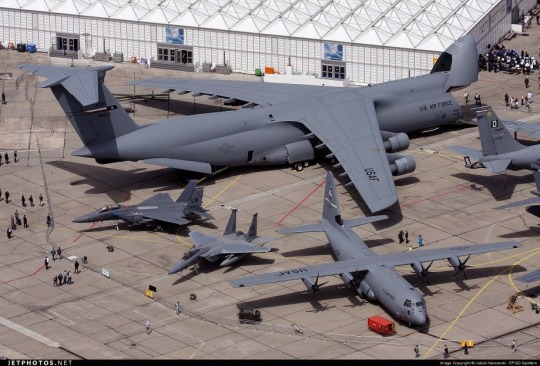
The C-5’s first mission came in 1970, with the aircraft called to ferry supplies into and out of Vietnam. Thanks to its size and payload capacity, it would ferry not just troops and supplies, but tanks and even aircraft. As Saigon fell, the C-5 would take part in evacuation efforts. Apart from regular strategic airlift duties, the C-5 would also be used as a testbed for aerial launches of the Minuteman ICBM. While tests went well, the capability was never implemented. Other notable service included ferrying partially assembled F-117s from factory to test locations in secrecy, and supplying Antarctic bases at McMurdo Station - making it the largest aircraft to ever land in Antarctica. Unfortunately, the C-5’s service wasn’t all good. The original C-5As suffered from a fatigue life far below the originally planned 30,000hrs, and in 1975 Lockheed was contracted to give the fleet new wings. In the mid-80s, the improved C-5B and C-5C were produced, and, around the turn of the millennium, another series of upgrades began to bring the C-5 fleet to the new C-5M standard, intended to keep the fleet operational well into the new century.
Boeing 747
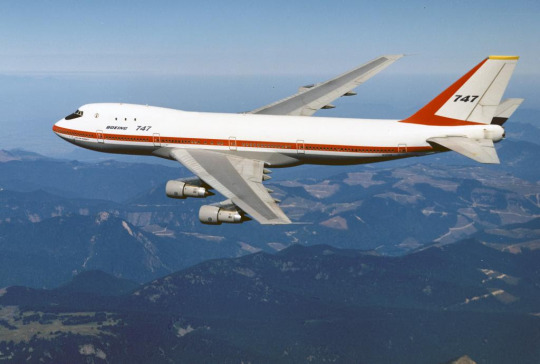
By the ‘60s, the era of luxurious airliners was long gone, and the focus was now on increased capacity. With airliners looking for ever-larger planes to improve efficiency, Pan Am began pushing for Boeing to develop a new high capacity airliner far exceeding that of the 707. With the US military running a parallel program for a new heavy transport, Boeing decided to develop a new design that could be easily adapted to the transport role should it fail as an airliner. Original plans called for a full-length double-decker design with a high wing, but, when the USAF selected the C-5 over Boeing’s design, it was decided to abandon most elements of this design over safety concerns. Instead, the aircraft would morph into a wider low-wing design with a partial upper deck. Meanwhile, Boeing had worked with Pratt & Whitney to develop a new high-bypass turbofan engine, of which four would be used to propel the machine.
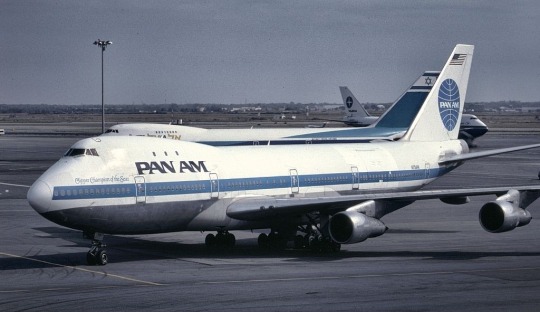
The aircraft that would take shape as the Boeing 747 in 1969 would be the largest airliner in the world. The 747-100 would have a maximum capacity of over 500 passengers, with an empty weight of 358,000lb and a MTO weight of 735,000lb. As the most advanced, highest capacity airliner in the world, it gained significant attention long before it had even taken flight, with over 200 orders from 26 airlines placed by the time the 747 had flown. Minor technical problems complicated testing, but by 1970, the Boeing 747 was flying with Pan Am. Unfortunately, a global recession slowed 747 production early in its career, threatening the aircraft. Fortunately, orders picked up, allowing the Boeing 747 to become an icon of modern air travel.
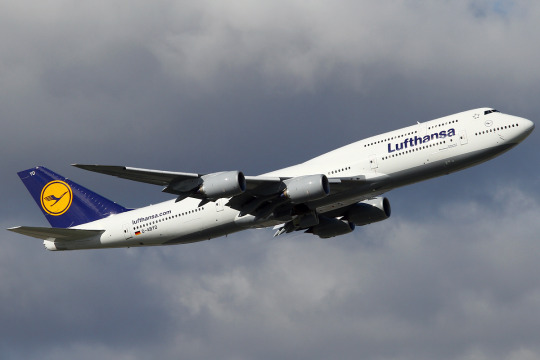
Through the years, Boeing has continued to create new variants of the Boeing 747, allowing it to remain competitive on the global market. Thanks to its unique double-decker layout, it would offer the highest passenger capacity of any airliner until the Airbus A380 entered service, and continuing upgrades to engines, avionics, and airframes would ensure the aircraft would remain safe and cost-efficient for operators. Thanks to its spacious design, it’s been a popular transport aircraft, and over the years numerous proposals have popped up for militarized variants that take advantage of its impressive payload capacity. While some, like the VC-25 (Air Force One) and E-4B have had comparatively docile roles, the 747 has been the basis for proposals for everything from an airborne laser system to cruise missile carrier and even parasite fighter carrier. With production of the new 747-8 series aircraft beginning in 2005, Boeing’s most iconic airliner seems to be set to serve well into the new millennium.
Lockheed CL-1201
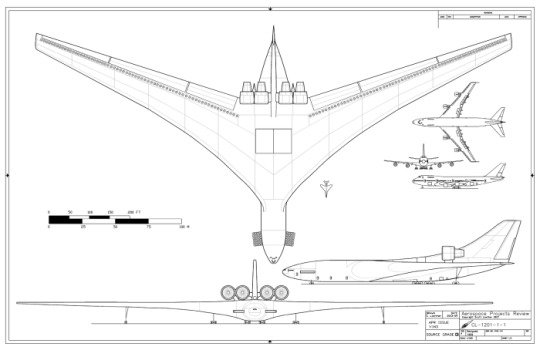
At the end of the ‘60s, Lockheed began work on a unique new project that amounted to an airborne battlestation. Working under the internal designation Cl-1201, the aircraft was perhaps the largest and most ambitious design ever seriously developed. Powered by and 1800 megawatt nuclear reactor, the CL-1201 would have a wingspan of 1,120ft and gross weight of nearly 12 million lb. Power was to come from four massive turbofan engines providing a total thrust of half a million lb. Below 16,000ft, these engines would be powered by conventional fuel, and for takeoff, they would be supplemented by 182 lift engines. At higher altitudes, however, the CL-1201 would switch to nuclear power, giving it the ability to cruise for as long as 41 days. Two variants of the CL-1201 were envisioned - a Logistics Support Aircraft, which would act as a massive transport complete with airborne docking of transports to ferry supplies to and from the aircraft, and an airborne aircraft carrier, which was to carry 22 fighters under the wings in special pylons that would allow for maintenance and rearmament of the aircraft. The latter variant would also have an internal dock to handle air-to-ground shuttles. While the exact date that Lockheed stopped working on the CL-1201 is unclear, it would never leave the drawing board.
Conroy Virtus
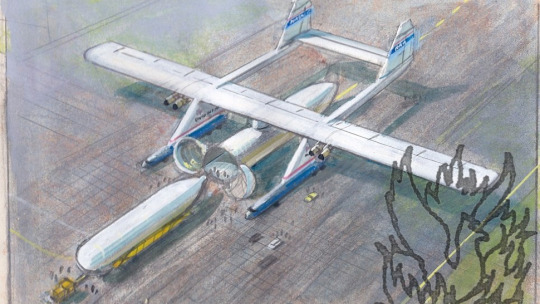
Of the proposals for a carrier aircraft for the Space Shuttle, perhaps the most ambitious would come from John Conroy, creator of the oversized “Guppy” series cargo aircraft. Dubbed the Virtus, the aircraft was to be a massive twin-boom design, much like early proposals from Lockheed and Boeing. Unlike the Lockheed and Boeing proposals, however, which were mostly based off of twin-linked C-5s and 747s, respectively, the Conroy Virtus would be an almost entirely new aircraft. Two B-52 fuselages would form the base of the design, with large booms extending upwards to hold the wing and tail assembly. The wing itself had a 450ft span with an aspect ratio of 9, with four Pratt & Whitney JT9D-3A turbofans placed outboard of the fuselages. The very high mounted wing would provide ample room to carry the Space Shuttle, as well as any other oversized cargo - in fact, Conroy had plans for the aircraft to carry a container 35ft in diameter and 184ft long. Projected max takeoff weight was 850,000lb, of which 375,000lb would be payload. Unfortunately, the Conroy Virtus would never leave the drawing board - a more conservative proposal based off of the Boeing 747 would end up winning.
Boeing 747 Shuttle Carrier Aircraft

While various radical approaches were considered for the Shuttle Carrier Aircraft, NASA eventually settled on a more conventional layout utilizing a heavy-lift transport carrying the Shuttle on the aircraft’s back. Boeing and Lockheed both had proposed aircraft for the role (747 and C-5), with NASA ultimately choosing the 747 as the Shuttle Carrier due to the fact that a C-5 Shuttle Carrier would have to remain in Air Force hands. The first Boeing 747 Shuttle Carrier would be converted from a 747-100 NASA had been operating since 1974. Extra vertical stabilizers were added on the tail, and the cabin was stripped of most passenger accommodations (except the first-class cabin) and strengthened. External struts were added to mount the Shuttle itself, and avionics were overhauled.
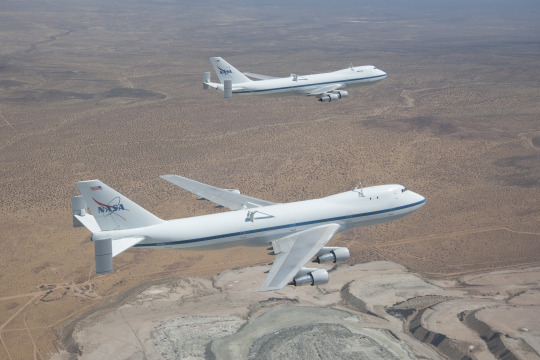
The first Shuttle Carrier took flight in 1977, with test flights using the shuttle Enterprise through the end of the year. Actual ferry flights began in 1978, with the sole Shuttle Carrier ferrying the shuttles around as needed for the next decade. In 1988, NASA decided to create a second Shuttle Carrier. Another 747-100 was procured from Japan Airlines and converted to the same standard as the original aircraft, entering service in 1990. The two Shuttle Carriers would serve until the end of the Space Shuttle program. Upon the retirement of each of the surviving shuttles, the Carriers were used to ferry the aircraft to their final destinations. In 2010, the second Carrier would also break the trend, ferrying Boeing’s Phantom Ray demonstrator to a test site. The final flight of the Shuttle Carrier Aircraft came in 2012, with shuttle Endeavor being ferried to a museum in Los Angeles from Kennedy Space Center.
Myasishchev VM-T Atlant
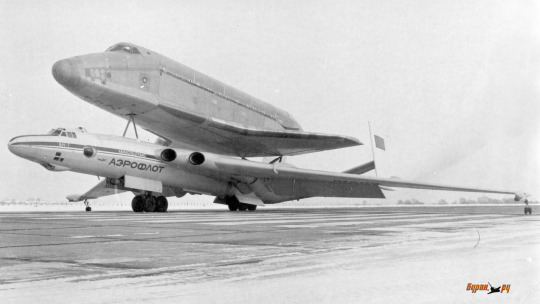
As the newest phase of the Soviet space program took shape, the Soviets were faced with the issue of transporting rockets from factories near Moscow to the Baikonur Cosmodrome in Kazakhstan. In 1978, Myasishchev proposed to convert a 3M bomber to serve as an outsized cargo aircraft to fill the space program’s needs. For this, two bombers were modified, becoming the VM-T. The VM-T would replace the conventional tail of the Bison bomber with an all-new double tail that kept the surfaces clear of the wake of the payload. A large aerodynamic container was designed to be carried on struts above the VM-T, allowing the aircraft to carry payloads as heavy as 50 tons and as large as twice the diameter of the aircraft. Control systems were also modified to account for the effects of the payload. The VM-T would first fly in April 1981, and by January of the next year, it was ferrying Energiya rocket boosters to their launch site. Later in its career, the VM-T would also ferry the Buran around. The career of the VM-T was brief, however, with the An-225 replacing both aircraft when it came into service in 1989.
Antonov An-124 Ruslan “Condor”
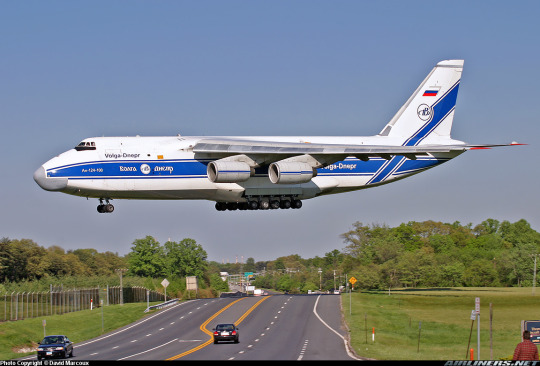
By the mid-70s, Antonov had begun work on a next generation superheavy cargolifter to replace the An-22. Aiming to make up for shortcomings in Soviet strategic airlift capabilities, Antonov produced an even larger aircraft that received the designation An-124. The An-124 in many ways resembled the American C-5. It was a high-winged design with a spacious cargo hold, four turbofan engines, and, apart from the conventional tail, the design could easily be mistaken for a C-5. However, the An-124 was significantly larger. Though similar in dimensions to the C-5 (it’s slightly shorter but with a larger wingspan), it offers a 25% higher payload than its American cousin. Coming in at a gross weight of over 400 tons and with a payload capacity of 150 tons, the An-124 would become the world’s largest aircraft and most capable cargolifter when it finally flew for the first time in late 1982.
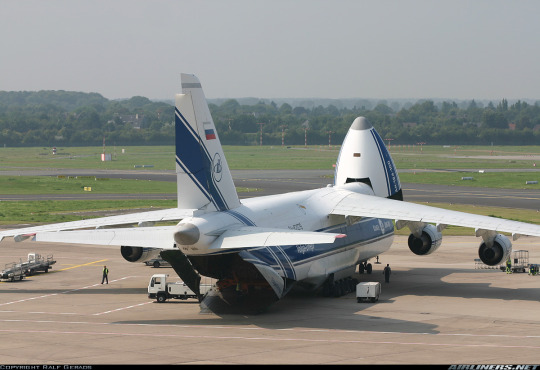
The An-124 would enter service in 1986, slowly working to replace the An-22. Due to the end of the Cold War, production would halt in the 90’s with fewer than 50 built. Initial production aircraft were split between Aeroflot and the military transport command. Because of the aircraft’s record-breaking payload capacity, it has been contracted to fly for foreign customers numerous times. An-124s are contracted by United Launch Alliance to transport Atlas V rockets from the factory to launch pad, and, oddly enough, Germany leases two An-124s to supplement NATO strategic airlift capacity, with the aircraft being seen flying men and materiel into Afghanistan and Iraq. With Russia somewhat recovering from the economic situation of the ‘90s, production of the An-124 has also resumed in 2008. The new production aircraft featured more reliable engines, among other minor improvements. However, production has come to a halt more recently due to the ongoing crisis in Ukraine.
Antonov An-225 Mriya “Cossack”
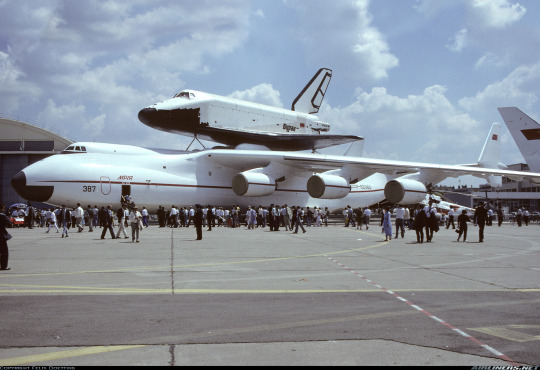
During development of the An-124, Antonov had their sights set on an even larger derivative intended to carry oversized cargoes, particularly the Buran space shuttle and Energia rocket boosters. The changes of the new design were fairly simple - the wings were increased in size and fitted with two more engines, fuselage plugs were installed forward and aft of the wings, two more main wheels were added on either side (bringing the total to 7 per side), mounting points for outsized cargo were added, and a double tail was installed. The result was without a doubt the largest aircraft in the world. Coming in at a max takeoff weight of 385 tons, the An-225, as it is designated, has a wingspan of nearly 300ft and length of 275ft. It shattered the record for maximum payload, with a maximum internal payload of 250 tons and external payload limited to 200 tons. Two An-225s were ordered. The first, which flew in December 1988, was intended to serve as a shuttle carrier and followed the original design. The second, whose construction was halted by the end of the Cold War, would do away with the outsize cargo mounts, receiving a conventional tail and being arranged for better carrying cargo conventionally.
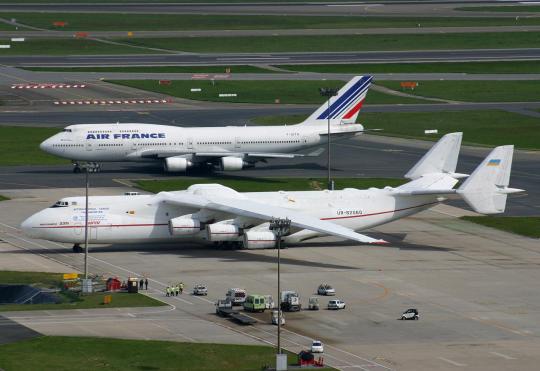
Unfortunately, the end of the Cold War halted the plans to use the An-225 as designed. Though it has carried the Buran space shuttle numerous times, the Buran would be cancelled with the end of the Cold War. The An-225 continued to serve domestic needs for some time, but in the late ‘90s, Antonov decided to offer the aircraft up for commercial customers once it became apparent that even the An-124 was incapable of lifting some payloads. The An-225 was overhauled with new engines and modified for heavy cargo before being placed into service with Antonov’s cargo fleet. Since the turn of the millennium, the An-225 has thus served as a lifter for commercial and military partners. In 2002, it made its first commercial flight when it ferried 216,000 meals weighing 187.5 tons from Stuttgart to Oman for the American military. In 2009, it set the record for the heaviest single piece of cargo airlifted when it carried a 189 ton generator for a powerplant in Armenia. In 2010, it broke records again when it carried the longest piece of cargo in history - a 42 meter wind turbine blade. The An-225 continues flying for military and commercial partners to this day, with no signs of stopping.
Myasishchev M-90
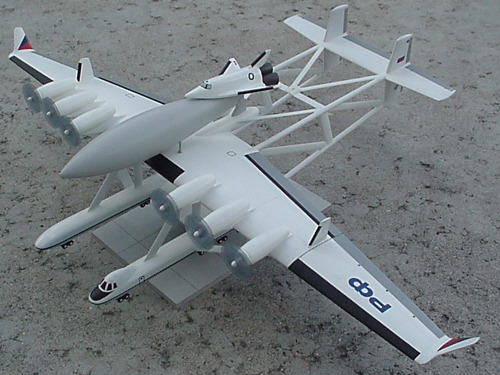
During development of the MAKS space shuttle, Myasishchev began work on a new transport capable of carrying the system to a launch altitude. Working under the designation M-90, Myasishchev created a large twin-boom design similar to the American Conroy Virtus concept. Two fuselage-like elements were suspended under a massive wing with a span of 96m, with six turboprop engines placed outboard of the fuselages. The wing center section was arranged such that oversized payload of up to 250 tons could be carried either above or below the wing, allowing for air-launches of the MAKS system. The entire system had a projected max takeoff weight of 700 tons, giving it the potential to be the largest and heaviest aircraft ever. Unfortunately, the M-90 would remain a paper project, coming to an end with the collapse of the Soviet Union.
McDonnell Douglas MD-12

In the early ‘90s, McDonnell Douglas joined the various aerospace corporations looking into the development of a “Superjumbo” airliner. Original plans centered around a general enlargement of the tri-jet MD-11, designated MD-12X. While this gained considerable support, the design would morph by the end of 1991 into something even larger, becoming the MD-12. The MD-12 was a more conventional four-engined proposal about the same size as the Boeing 747. However, it was to have two decks down its entire length. McDonnell Douglas teamed up with Taiwan Aerospace to produce the design, planning to have the first flight take place in 1995. Despite aggressive marketing, however, no orders materialized. Taiwan Aerospace would leave the project, and McDonnell Douglas lacked the resources and experience to pursue the design on their own. Thus, the MD-12 was abandoned, with McDonnell Douglas instead pursuing simpler MD-11 derivative designs.
Boeing New Large Airplane
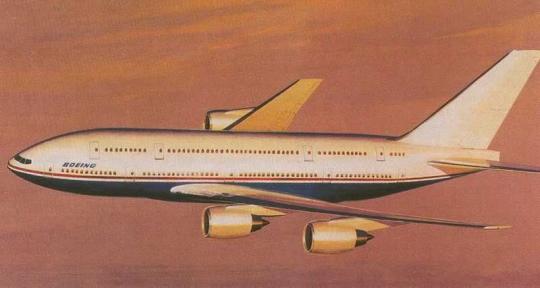
Though Boeing’s 747 had given them a monopoly on the high-capacity airliner market for several decades, the decision of several different manufacturers to look into developing “Superjumbo” airliners in the 90’s spurred Boeing to begin their own efforts for a 747 successor. Working under the moniker New Large Airplane, Boeing proposed a concept for a large double-decker design somewhat larger than the 747. With the added upper deck area, Boeing projected the design would have a capacity of over 600 passengers in a three-class layout - 200 more than the regular capacity of the 747-400s that were then flying. Ultimately, however, Boeing decided not to pursue the project, dropping it in 1993 in favor of updating the 747.
Tupolev Tu-404
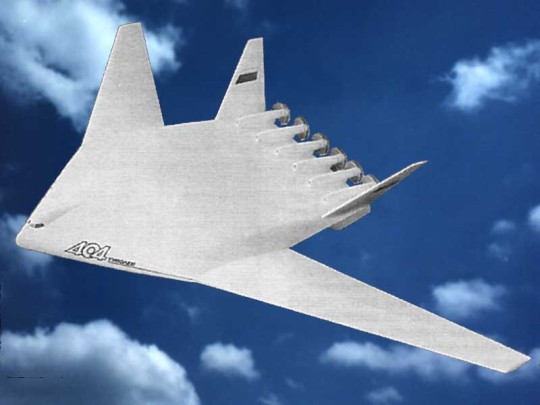
In 1991, Tupolev began working on a series of large airliner projects. The largest of these, the Tu-404, would parallel the thinking behind the Superjumbo designs of other manufacturers, but it would have by far the most unique design. The Tu-404 would designate two very different design studies, with the only real commonality between the designs being their capacity (1200 passengers) and weight (max takeoff weight of 600 tons). The more conventional Tu-404 design was a double-decker aircraft powered by four turbofans and with a 77 meter wingspan. The other design was a radical divergence from conventional airliners, with a massive blended wing body layout, 110 meter wingspan, and six turboprop engines mounted in a pusher configuration. With such a configuration, the Tu-404 had the potential to be one of the most efficient airliners in the world. Unfortunately, the Tu-404 would never leave the drawing board, ultimately being cancelled sometime in the ‘90s along with most other Superjumbo projects.
Sukhoi KR-860
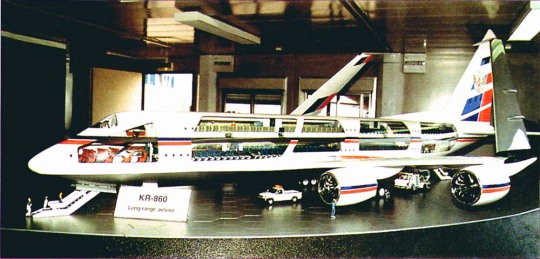
In the latter half of the ‘90s, Sukhoi began their own Superjumbo program, aimed to compete on the international market with the various other Superjumbos being developed. Revealed at the 1999 Paris Airshow, the aircraft would be known as the KR-860. It was to have a projected weight of 650 metric tons and payload of 300 tons, making it by far the largest aircraft ever. The double-decker cabin was to have 12-abreast seating on the lower level with three aisles, while the upper deck would have two aisles with 9-abreast seats. In such a layout, the aircraft would have a capacity approaching 1,000 passengers. This required the aircraft to be fairly large - it was to be 262ft long with a 288ft wingspan. Because of projected issues with such a massive wingspan at airports, Sukhoi designed the wings to be able to fold outboard of the engines, bringing the wingspan to a more manageable 210ft on the ground. Unfortunately, Sukhoi wildly misjudged the market. They projected a total order of 300 aircraft, allowing them to get a prototype flying before 2000. However, no interest materialized in their design, and, in the economic climate of post-Soviet Russia, Sukhoi was unable to pursue the design on their own.
Airbus A380
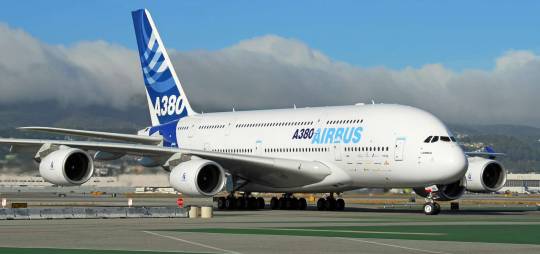
In 1988, Airbus began looking into the development of a new superheavy airliner in parallel with all the other Superjumbo design studies occurring around the same time. Formal approval came in 1990, and over the course of the next decade a series of feasibility studies were conducted. By the end of the decade, the general design had been selected - a massive four-engined aircraft with two flight decks. Designated the A380, the aircraft had 40% more floor space than the 747-800, providing for a maximum capacity of 853 seats. The cabin itself is pressurized to a lower altitude than most airliners and extensively soundproofed, aiming to reduce passenger fatigue on long flights. Initial marketing proposed various luxurious configurations for the A380, with the upper deck consisting of shops, bars, and restaurants. However, these largely gave way to more seating. The A380 would first fly in April 2005. Singapore Airlines would be the first to receive the A380 in 2007, followed by Emirates the next year.
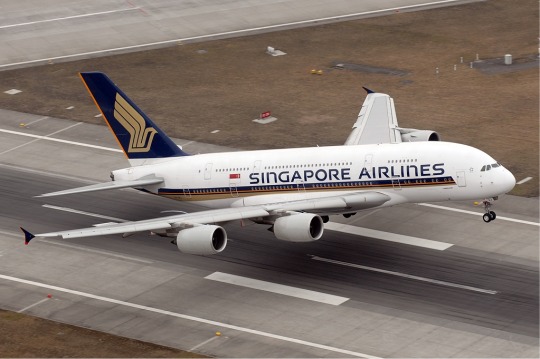
Despite the A380’s massive size, the airliner has integrated surprisingly well with existing infrastructure. The drive among multiple different companies in the ‘90s led to many larger airports redesigning their facilities to accommodate an 80X80 meter aircraft, creating requirements which the A380 just barely fits.Despite having a 540 ton operating weight, the A380’s 22 wheels distribute its weight well enough that most runways have no problem supporting the aircraft. Though the 80 meter wingspan restriction had forced Airbus to work with a lower aspect ratio than would be most efficient, the A380 nevertheless is very efficient, with Singapore Airlines noting that it gets 20% better fuel efficiency per seat-mile than the 747-400. Of course, with an aircraft of such size, not every issue could be avoided. Thanks to the massive wake of the aircraft, the A380 requires a larger separation from other aircraft, in particular affecting smaller aircraft the most. Despite the minor operating issues and some teething problems, however, the A380 seems to be doing fine. Some 180 are currently in service, and a total of 319 have been ordered as of early 2016.
Boeing 747 Dreamlifter Large Cargo Freighter

During development of Boeing’s 787 airliner, Boeing was faced with the issue of transporting parts from various factories around the US to their final assembly point in Washington state. Traditionally, large assemblies like that would be shipped, but the long time and high cost associated with such methods spurred Boeing to look for alternatives. In 2003, they settled on a unique new cargo aircraft derived from the 747-400 airliner. Dubbed the Dreamliner, the aircraft has a completely redesigned fuselage, replacing almost everything aft of the cockpit with a massive cargo bay. With a total cargo space of 65,000 cubic feet, the Dreamlifter has the largest cargo hold in the world. The first conversion was completed by 2006, and, after some testing, the Dreamlifter was in service in 2007. A total of four Dreamlifters were converted from Boeing 747s, all of which have been used exclusively for ferrying Boeing 787 parts around the country.
Scaled Composites Stratolaunch

As commercial spaceflight has boomed in recent years, air-launch-to-orbit systems in particular have become popular. Though the current generation of air-launch systems have been limited by the capacities of carrier aircraft, a great deal of interest has been shown in creating an air-launch system that can get heavier payloads into orbit. In 2011, Vulcan Aerospace announced a project to create a massive new air-launch-to-orbit system. Teaming up with SpaceX and Scaled Composites, the idea was to create a carrier aircraft capable of deploying a rocket that could get a far heavier payload than current systems could into space. Dubbed the Stratolaunch, the aircraft that took shape would have the largest wingspan in the world. The Stratolaunch is a twin-boom design with a wingspan of 385 feet, shattering the record set by the Hughes H-4. It is to have a max takeoff weight of 1.3 million pounds, and is powered by six Pratt & Whitney PW4056 turbofans. The payload, carried in the wing center section, was originally to be a multistage rocket developed by SpaceX, but in late 2012, SpaceX left the program. Orbital Sciences joined on in 2013, contracting to develop a 13,500lb-payload rocket for the Stratolaunch. Though they left the program in mid-2015, the Stratolaunch continued construction without any solid plans for a rocket. Currently, the Stratolaunch is in the late stages of construction, with the first flight planned for 2016.
9 notes
·
View notes
Text
/k/ Planes Episode 96: Barbarossa
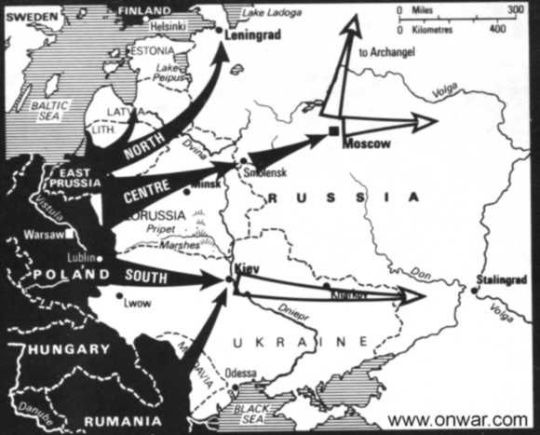
It’s time for another episode of /k/ Planes! This time, we’ll be looking at the air campaign during Operation Barbarossa.
On June 22, 1941, the Second World War expanded eastward, drawing the Soviet Union into the conflict. In the largest invasion in history, Germany, backed by Romania, Slovakia, Italy, Hungary, and Finland opened up a devastating campaign against an unprepared Soviet Union. Operation Barbarossa would see some of the most lopsided defeats in history, both on the ground and in the air. The Luftwaffe opened up a devastating air offensive, shattering the VVS and seizing air superiority that would last for the remainder of the year. Luftwaffe bombers crippled command and logistics centers, allowing for massive encirclements of hundreds of thousands of men. Despite the crushing defeats, however, the Soviets would persist. For the remainder of the summer, the Red Army and VVS would put up a valiant defense, sacrificing countless lives and aircraft to slow the Axis advance.
The Belligerents: VVS
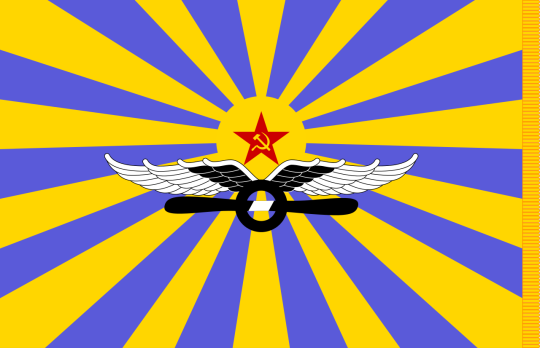
In June 1941, the USSR possessed the largest air force in the world, with just under 10,000 aircraft spread across the VVS, PVO (air defense units), DBA (long-range aviation), and Soviet Navy. Of those, some 5,440 aircraft of the VVS and DBA were in the five western military districts (1,688 bombers, 2,736 fighters, 336 Sturmoviks, 252 reconnaissance aircraft, and 430 army cooperation aircraft), while a further 1,500 were with the Soviet Navy (114 in the Arctic, 707 in the Baltic, and 624 in the Black Sea) and 1,445 with the PVO. Of those frontline units, 1,360 bombers and 1,490 fighters were operational. Total operational strength along the front consisted of 70 air divisions and five brigades, plus 13 bomber and five fighter divisions with the DBA and PVO, respectively. A further 25 divisions were also in the making, and as a whole the VVS was in the process of massively expanding. Some 2,000 airfields (including 250 bomber fields) were available to the VVS, though many were rough strips only suitable for lighter aircraft. Because of the ongoing modernization efforts, a significant portion of the frontline forces were obsolete types, with modern types only recently arriving to the front. Nevertheless, production was moving fast - some 4,000 aircraft were leaving the factories every month.
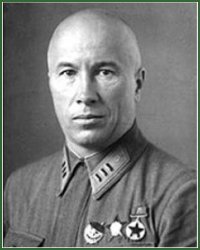
For all the impressive strength the VVS had on paper, they had numerous faults that would prove catastrophic. The poor preparedness of the VVS to the oncoming offensive would contribute greatly to losses in the opening days, with many aircraft caught lined up at airfields with no efforts to conceal or disperse them. Even once the initial shock of the invasion wore off, there were numerous doctrinal issues. Radios were a rarity and of poor quality, and the VVS officer corps had been weakened by the recent purges. Training was horrifically poor, particularly with units recently transitioned to modern types, with many pilots having never even fired their weapons by the time war broke out. Communication was poor, both with aircraft and between ground units, making it difficult for the VVS to respond to the rapidly changing situation. Perhaps just as bad was the quality of the “modern” types of aircraft entering service. Of the three “modern” fighters then coming into service - the LaGG-3, MiG-3, and Yak-1 - only the Yak-1 was really competitive with the Luftwaffe’s fighters. Across the board, the VVS aircraft were outclassed by their Luftwaffe counterparts, and, not too surprisingly, the VVS would struggle to contest the skies during Operation Barbarossa.
The Belligerents: Luftwaffe
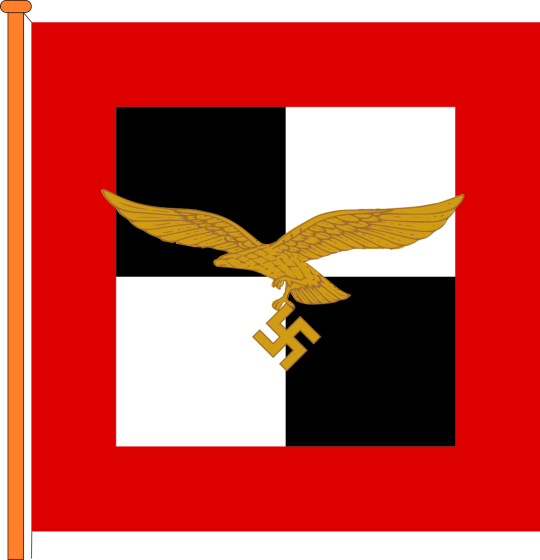
On paper, the Luftwaffe appeared to be massively inferior to the VVS. On June 21, 1941, they possessed just 4,389 aircraft of all types, of which 2,598 were combat types and 1,939 were operational. These included 929 bombers, 793 fighters, 376 dive bombers, 70 Zerstorers, 102 reconnaissance aircraft, 60 ground attack, 200 reserve fighters, and 60 other types. These were spread across 31 bomber, 8 dive bomber, 1 ground attack, two Zerstorer, and 19 fighter Gruppen spread across Luftflotten 1, 2, 4 and 5. Compared to the Soviets, the Luftwaffe also had cripplingly low aircraft production numbers - whereas the Soviets were pumping out some 4,000 aircraft a month, German production was closer to their own predictions of the Soviet industrial capacity. Total production for all types in 1940 was just under 8,000 aircraft, while production for 1941 would climb to 9,422. In short, the Soviets were producing in two to three months what took Germany the whole year.
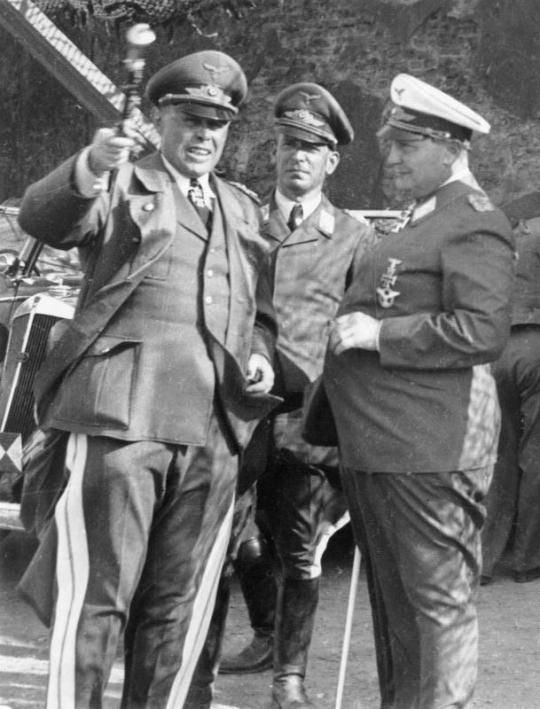
Fortunately for the Luftwaffe, their inferiority was mostly in numbers. Across the board, they were superior to the VVS in nearly every relevant aspect, from aircraft quality to crew training and operational organization. Whereas radios were a rarity among the VVS, they were standard for the Luftwaffe, and ground forces were given radios capable of communicating with bombers to facilitate accurate air support. Despite the losses suffered in the Battle of Britain, the Luftwaffe’s air crews were still far superior to those the VVS mustered. Generally, tactics were also superior to the Soviets’, with fighters flying in flexible Rotte and Shwarm formations and flying free hunting sorties. On an operational level, organization was also far better, particularly with the emphasis on reconnaissance - where the Soviets relied on a small number of obsolete types for reconnaissance duties, the Luftwaffe operated a much larger force consisting of modern aircraft.
The Belligerents: Axis Minors
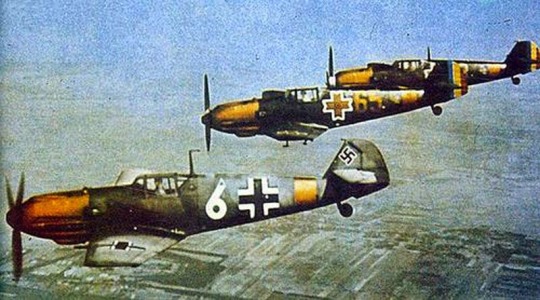
Supporting the German-led invasion of the USSR were four other nations - Romania, Italy, Hungary, and Slovakia. Romania, with their air force of 621 aircraft, would commit the largest contingent to the war, although smaller forces were supplied by Italy, Slovakia, and Hungary. Concentrated around Army Group South, the Romanians committed 160 fighters and 82 bombers to the invasion, 30 of which were Bf 109Es. Romanian Air Forces would come to operate significant numbers of both the foreign-designed Bf 109E and domestic types like the IAR 39 and 37. Units were tasked with both supporting operations along the front as well as providing air defense for domestic oil facilities, as the VVS would be launching raids into Romania from Sevastopol in the opening months of the war. Soon after the war began, air forces were reorganized - modern types were put under a single unified command, while obsolete types were passed onto the Romanian Fourth Army, which was subordinated under Army Group South.
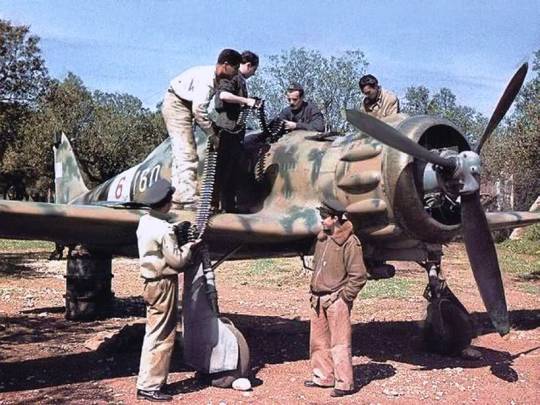
Hungary would join in on the campaign on June 27, committing a force of 117 aircraft among other forces. Their inventory of aircraft consisted of a mix of Italian designs like the Re.2000, as well as the Bf 109. They would operate independently until 1942, when they were attached to VIII. Fliegerkorps. The Italians would send 104 aircraft to support their contingent of 60,000 men committed to the invasion, but their forces were rather unimpressive. The Regia Aeronautica’s combat strength in Russia was just a single fighter group, one bomber/recce group, and one transport squadron. Unlike the aircraft of the other belligerents, they were generally verging on obsolescence, and, as they were designed for the hotter Mediterranean climate. Despite their limited resources, the Slovaks also committed 2 divisions of men and 70 combat aircraft, These primarily consisted of German-built Bf 109s. All foreign contingents would operate alongside Army Group South in their operations across Ukraine.
The Aircraft: Messerschmitt Bf 109E/F
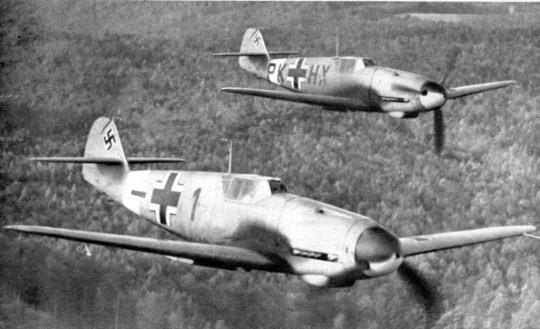
The backbone of the Axis fighter corp was Messerschmitt’s ubiquitous Bf 109. Operation Barbarossa fell in the middle of the transition from the older E series models to the sleek, modern F series, so both models would see action in the coming campaign. The Bf 109E featured rougher surfaces, with a small spinner and squared-off wings. It shared the twin synchronized machineguns of all Bf 109s, but it had a 20mm cannon in either wing in place of a hub-mounted cannon. The F-series Bf 109, on the other hand, featured a new engine, hub-mounted cannon in place of the wing guns, and significant aerodynamic improvements. The result was very tangible - whereas some of the more modern VVS fighters were a match for the Bf 109E, the Bf 109F outflew anything the VVS could field. Whatever the case, the difference in performance meant little compared to the massive training disparity between Axis and Soviet pilots. For the Luftwaffe, all of their 793 fighters were Bf 109s, flying with 19 Gruppen. Bf 109Es also saw use with Jabo (fighter-bomber) units, including SchlG 2.
The Aircraft: Messerschmitt Bf 110
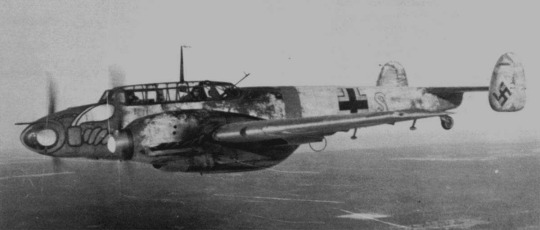
Messerschmitt’s famous Zerstorer had long since fallen from grace, but it remained in active service in many combat roles for Operation Barbarossa. Two Bf 110 Gruppen took part in Barbarossa - ZG 26 and ZG 76 - with a total of 70 aircraft. A further Geschwader - SKG 210 - was also created to operate the fighter, but it would be folded into ZG 1 at the end of the year. With Bf 109s handling fighter duties, Bf 110s were generally tasked with strike missions, particularly against targets heavily defended by AAA. Thanks to the near total air supremacy of the Luftwaffe, they performed well, racking up impressive scores of ground targets, be they artillery, tanks, or aircraft, as well as quite a few aerial victories. They also took on reconnaissance missions, which grew to dominate their operations as the war dragged on.
The Aircraft: Junkers Ju 87 Stuka
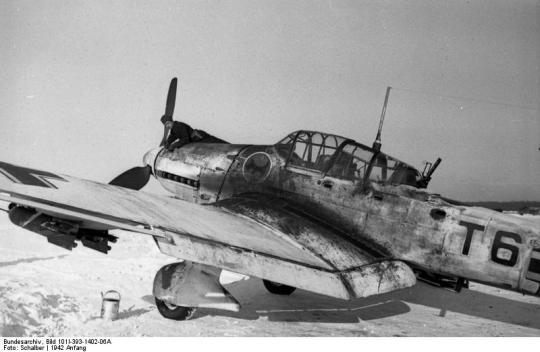
The infamous Stuka dive bomber flew with all eight of the Sturzkampfgeschwader committed to the invasion. Though slow and lumbering, they offered an incredibly accurate bomb delivery platform, and, with the Luftwaffe easily securing air supremacy, they proved tremendously effective. Thanks to their radios, they could work closely with ground forces, providing much needed air support for units often outrunning their artillery. Though outnumbered by the fighters and medium bombers committed with just 376 aircraft, the Stukas were arguably the most effective platform the Luftwaffe possessed on a tactical level. As the Axis forces stormed across Russia, the Stuka claimed countless vehicles, artillery pieces, trains, and even the battleship Marat. They were not invulnerable, however - the lumbering machines were vulnerable to even the most archaic fighters in the VVS inventory, and on occasion they would fall victim to enemy defenses, even with the benefit of air supremacy.
The Aircraft: Junkers Ju 88
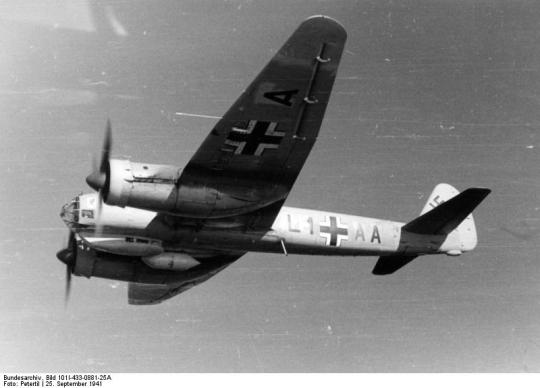
As the most modern bomber in the Luftwaffe’s inventory, the Ju 88 unsurprisingly performed very well in Operation Barbarossa. Most units flying the Dornier bombers had either transitioned over to Junkers’ new bomber or were in the process of doing so when the offensive began. They would form the backbone of the Luftwaffe medium bomber corps alongside the He 111, and they participated heavily in the opening strikes of the campaign. The Ju 88 was significantly more capable than either the Do 17 it replaced or the He 111 - it was fast enough to outrun the I-16 at high altitudes, all while boasting a similar range and payload to the He 111 but with greater agility and the ability to undertake shallow-angle dive bombing. The agility in particular became very important, as Ju 88s would be pressed into CAS roles due to shortages of Stukas. Though they performed well, they would suffer heavy losses during such operations. Though they were generally fast enough to evade interception, their poor defensive armament left them vulnerable in the all-too-common event that enemy fighters did catch up.
The Aircraft: Heinkel He 111
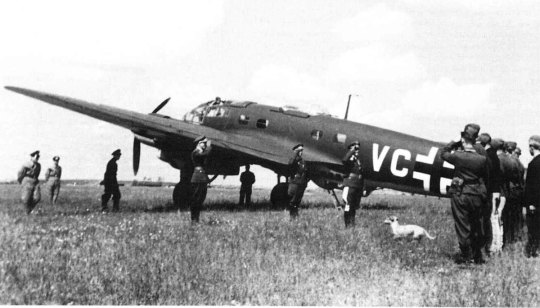
Three Kampfgeschwader - KG 53, KG 27, and KG 55 - of He 111 would be committed to Operation Barbarossa. Though the He 111 offered similar ranges and payloads to the Ju 88, it was far less agile, and consequently proved far less useful. It performed well in the opening strikes of the campaign against static targets, but as the Luftwaffe increasingly called on its medium bombers to fill the CAS gap left by inadequate Stuka numbers, the He 111 was found to be incapable of adequately filling the role. Instead, they were switched to more docile duties - interdiction, train-busting, and, as Moscow finally came within reach, bombing of cities. Train busting in particular proved effective, but the Soviets would quickly learn. Air defenses, both on the trains themselves and at strategic points, would take their toll on the He 111 fleet, slowly sapping their numbers over the course of the campaign.
The Aircraft: Dornier Do 17
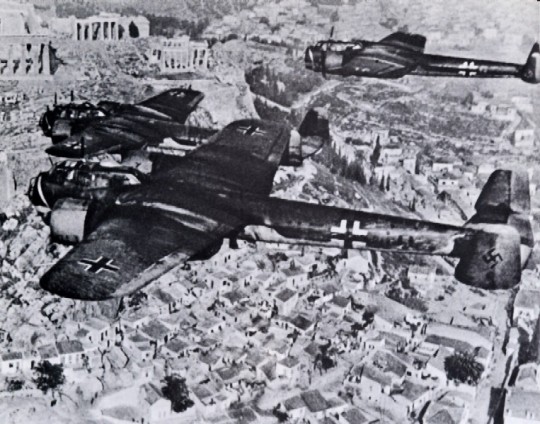
As the Do 17 was on its way out when Barbarossa began, the type’s service was limited. Only a single Kampfgruppen - KG 2 - was fully equipped with the type, along with two others that flew single Staffeln. Two reconnaissance Staffeln also operated the type. Though the modest Do 17 fore would perform admirably in the opening stages of the campaign, its flaws quickly became apparent. The Do 17 had a very limited payload and range, which increasingly became a liability as the front rapidly expanded. By the end of October, KG 2 was withdrawn and reequipped with the Ju 88, marking the end of the Do 17’s frontline service in Russia.
The Aircraft: Polikarpov I-153

A product of the Spanish Civil War, the distinctive I-153 Chaika was arguably the ultimate development of the biplane fighter. Fitted with a sleek exterior and retractable landing gear, the I-153 had first appeared in 1939, proving lackluster from the start. Despite underwhelming performance, the I-153 had been fast-tracked into production, so large numbers of the type would by in service when war broke out. Unsurprisingly, their performance was poor. Initially, they were flying with frontline fighter units, replacing the older I-15bis that had transitioned to ground attack roles. However, as experience on the front rapidly proved the I-153 to be obsolete, they too were shifted to attacker roles. Production was suspended in the months following the outbreak of war, partly due to the relocation of factories, and part due to the priority given to modern types. On the front, I-153 numbers continued to deplete as the aircraft was increasingly shifted away from fighter duties.
The Aircraft: Polikarpov I-16
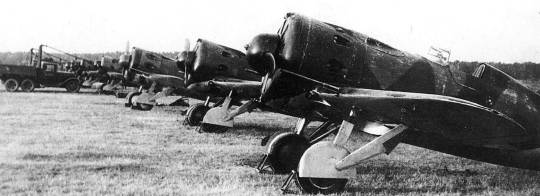
The most numerous fighter in the VVS inventory on June 22, 1941 was the iconic I-16. 1,635 I-16s, flying with 57 regiments, were active on the front when war began, and they would be among the first aircraft in the line of fire. Those that managed to rise to meet their attackers generally found themselves outclassed. Though the I-16 possessed a slight edge in maneuverability, the Bf 109 was far superior in everything from climb rate and top speed to firepower. Though the pilots were far more suited to the portly machine than those flying the modern types rushed into service, training quality was still lacking, and, without radios in their aircraft, discipline among units was generally poor. Nevertheless, the I-16 was modern enough to stay fairly competitive, so, while the older biplanes were shifted away from service, the I-16 stuck around as the mainstay of the VVS fighter force until the end of the year.
The Aircraft: Tupolev SB
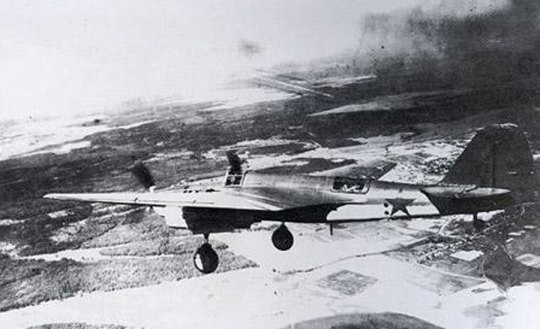
A relic of the “fast bomber” doctrine developed in the mid-30s, the SB was already showing signs of obsolescence in 1939 when the VVS faced off against Japan in Manchuria. Though slated to be replaced by the Pe-2, some 1,500 SBs were still in service in June 1941, making up over 90% of the Soviet frontline bomber force. Those that survived the opening strikes of the war found themselves hastily committed to poorly organized, unescorted daylight raids, with predictable consequences. The time had long since past that the SB could rely on its speed to protect it, and, with no fighters to protect them and poor training preventing the bombers from making the most of their modest defensive armaments, SB forces were regularly slaughtered by the German fighters. With losses becoming unsustainably high and modern types becoming ever more available, what remained of the SB fleet was shifted to night raids, taking advantage of the Luftwaffe’s lack of night fighters. As operation Barbarossa came to an end, those few SBs still flying with combat units were now operating exclusively as night bombers.
The Aircraft: Mikoyan-Gurevich MiG-3
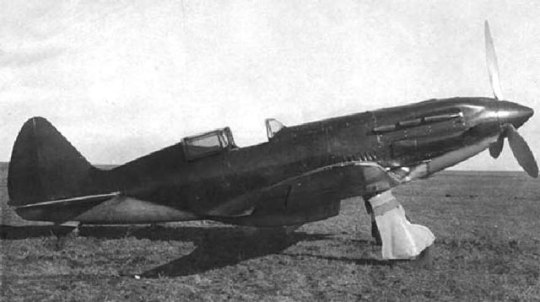
The most numerous modern fighter in VVS service at the outbreak of war was the MiG-3. Some 1,029 MiG-3s were in the inventory in June 1941, but only five units had fully transitioned. Unfortunately, the ubiquitous MiG-3 proved poorly suited to the coming war. Designed as a high-altitude fighter, its performance was poor at the medium-to-low altitudes that air combat generally occurred at over the Eastern Front. These shortcomings readily became apparent, and, while production continued, the MiG-3 was gradually shifted to PVO units while Yak-1s and LaGG-3s took their place.
The Aircraft: Yakovlev Yak-1

Undoubtedly the most capable fighter available to the VVS was the Yak-1. Though between 330 and 430 Yak-1s had been produced by the outbreak of war, just 92 had reached operational service, and only a single unit had fully converted. Fortunately, the Yak-1 proved surprisingly capable. Its easy-to-produce airframe avoided the manufacturing defects that plagued the LaGG-3, while it was overall far better performing than either the MiG-3 or the LaGG-3 at the altitudes air combat was taking place at. Not only was it superior to contemporaries in friendly service, but it also was competitive with the Luftwaffe’s fighters. The Yak-1 climbed faster than the Bf 109E, and it had similar turn performance to both types. Though it lost energy faster than the Bf 109 in a turning fight, it could generally hold its own in the crucial opening stages of an engagement.
The Aircraft: Lavochkin-Gorbunov-Gudkov LaGG-3

The least numerous “modern” fighter in VVS service at the outbreak of war was the LaGG-3. Made out a unique wood composite and powered by the ubiquitous Klimov M-105 engine, the LaGG-3 was plagued with problems related to poor construction quality and overweight airframes that delayed production. Consequently, only 322 LaGG-3s were available when war broke out, and only one unit had fully converted to the type. Unfortunately, as the LaGG-3 had originally been designed for the more powerful M-106 engine, performance was poor. The LaGG-3 lacked in nearly every area of performance, and handling was sluggish and generally poor. Even compared to the I-16, stall and spin performance was bad, and, as pilots soon found, the LaGG-3 was completely outclassed by the Bf 109. Unusually, however, production continued at a high pace, despite universally negative reports.
The Aircraft: Ilyushin Il-2
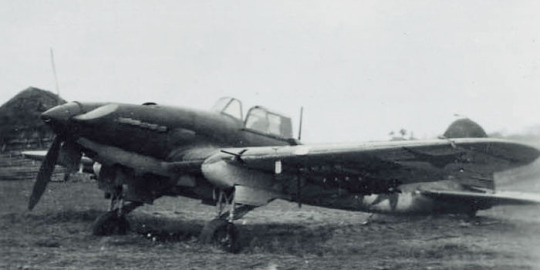
Perhaps the most famous Soviet aircraft of the war would have quite an arduous start to its career. Four factories were slated to produce the Il-2 at the start of 1941, but by the time war broke out, only one factory had began production, and only 249 Il-2s had been built. The 4th ShAP was the only unit to fly the type on June 22, having converted so recently that pilots had minimal training in their aircraft and ground crews had yet to be trained in servicing the machines. Worse, the Il-2 of mid 1941 was hardly the machine it would become famous for later in the war. Slow and lumbering, it had just enough armor to weigh it down without really improving survivability. It lacked the rear gunner that would appear on later models, and primitive gunsights, poor payload capacity, and the inaccuracy of the RS rockets meant that the Il-2 would struggle to contribute to the campaign. Regardless, the Il-2 represented a significant improvement over most other light bombers in service, so production was fast-tracked. Despite a consistently high loss rate, the Il-2 would persist on the front for the duration of the campaign.
The Aircraft: Ilyushin DB-3/Il-4
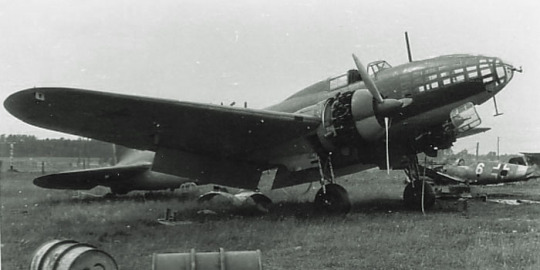
The twin-engined DB-3 medium bomber would form the backbone of the DBA’s long-range bomber force when war broke out. Unlike nearly every other aircraft in service, losses among the DB-3 fleet in the opening days of the invasion were fairly low, as the bombers were based far from the front. However, the desperate situation would see the bombers thrown into combat on the frontlines, unsurprisingly leading to high casualties. With a very poor defensive armament and unimpressive performance, the unescorted bombers would suffer heavy losses to Axis fighters. Outside of these poorly organized raids of desperation, however, the DB-3s would also perform long-range missions, particularly multiple raids on Berlin and Romania. Though these raids caused little damage, they provided a much-needed morale boost for the Soviets. Ultimately, however, long-range operations were suspended as the war grew increasingly desperate, and by the end of the year, DB-3 production was suspended to give priority to tactical aircraft like the Il-2 and Pe-2.
The Aircraft: Petlyakov Pe-2
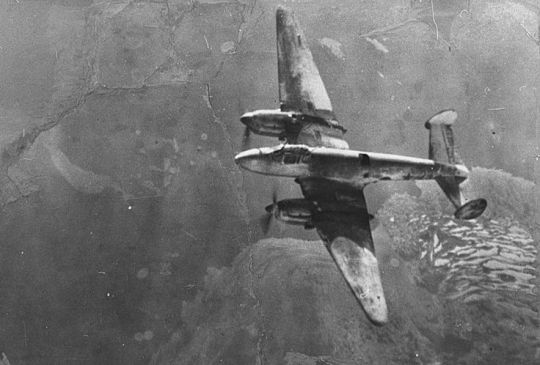
One of the few success stories among the VVS in the disastrous opening months of the war would be the Pe-2 medium bomber. Adapted from a cancelled project for a heavy fighter, the Pe-2 was an agile and capable bomber capable of performing accurate dive-bombing attacks. Just 128 were available at the outbreak of war, flying with two units (16th and 39th BAP). Crews quickly discovered the Pe-2’s capabilities. It was incredibly fast, often able to outrun enemy fighters, and on various unescorted retaliatory raids on the opening days of the war, they managed to complete their missions with minimal losses. Reconnaissance Pe-2s would begin to enter service that Fall, providing the VVS with a much-needed replacement for their archaic R-5s and R-Zs that made up the bulk of their reconnaissance force. By the end of the year, Pe-2s were given production priority, allowing them to replenish depleted units and slowly replace the obsolete types being rushed out of service. Unfortunately, the excellent design wasn’t enough to make up for the innumerable failures of the VVS. Poor operational practices and training meant that the Pe-2 wouldn’t really come to make a decisive impact until the Germans were already on the gates of Moscow.
Preparation

Soon after the Battle of France came to a conclusion, Hitler authorized preliminary planning for an invasion of the Soviet Union. Even as Nazi Germany openly negotiated with the Soviets, going as far as offering them a position in the Axis alliance, they were quietly preparing for an invasion, aimed at conquering a swath of territory spanning from Arkhangelsk to Astrakhan. On December 18, 1940, Hitler issued Directive 21, officially authorizing preparations for the invasion, which would become known as Operation Barbarossa. Romania, who had recently been forced to cede Bessarabia to the USSR, and Finland, who had lost Karelia the previous winter, were brought in on the plans, as was the puppet state of Slovakia. The three nations became bases for German forces, all while they prepared themselves to assist in the coming invasion.
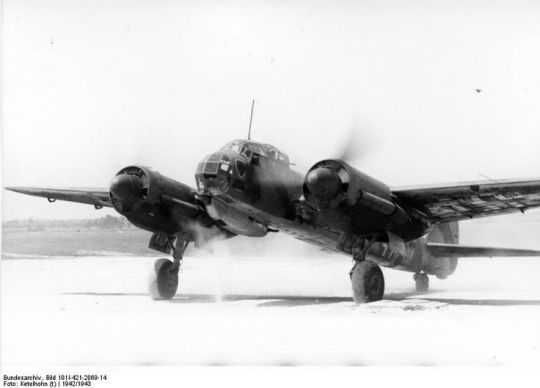
Aerial reconnaissance efforts, spearheaded by Ju 86, He 111, and Do 217 bombers, began in September 1940, aimed at mapping the airfields along the frontier military districts. Flying at extreme altitudes, they flew some 500 sorties up to June 15, 1941, identifying 100 major airfields between Murmansk and Rostov-on-the-Don. The flights did not go unnoticed by the Soviets - while many flights were low enough for interceptors to easily reach the aircraft, a policy of non-provocation prevented the VVS from opposing the intruders. Even so, two reconnaissance aircraft would end up crashing over the USSR, including one on April 15, 1941 that landed with an intact camera roll full of images of strategic airfields. VVS leaders noted that an offensive was likely to follow, but official orders prevented any action.

While the intensive aerial reconnaissance effort was beginning, German intelligence was analyzing the Soviet capabilities. Attaches in Moscow noted the poor state of the VVS owing to the ongoing reorganization, and estimates of the total number of aircraft available were surprisingly accurate - 7,300 compared to the actual VVS numbers of 7,850. However there were many flawed pieces of intelligence. The OKL underestimated the size of Soviet industry, dismissing reports from members of the Moscow attache pointing to the massive capacity of Soviet factories. While actual monthly production of aircraft numbered some 3-4,000, the OKL put the number at a mere 600 per month. They also vastly underestimated the enemy logistical capacity, both in terms of the reliance on airlift and the assumption that fuel supplies would be scarce for the VVS. Perhaps most glaring of all was the flawed analysis of Soviet factories - what little intelligence there was of trans-Ural factories was dismissed, as was the idea that the Soviets would be able to relocate their factories across the Urals in the face of the advancing forces.
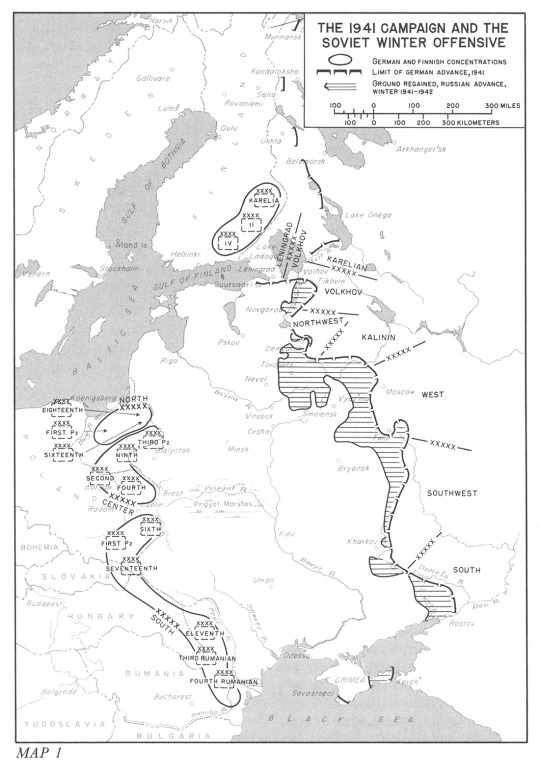
Whatever the case, the Axis forces would assemble and impressive force. By June 21, 1941, 3.8 million men had been assembled on the western side of the Soviet border, broken up into three Army Groups - North, Center, and South. They were supported by some 3,000 tanks, 7,000 artillery pieces, and 2,770 aircraft. Luftflotte 5, based in Norway, would aim to disrupt operations around Murmansk, with Luftflotten 1, 4, and 2 supporting the advances of Army Groups North, Center, and South, respectively. Far from oblivious but forbidden from preparing, the Soviets had just under 3 million men in the frontier districts right in the line of fire, supported by 11,000 tanks and 8,342 aircraft. Still operating under peacetime conditions, aircraft lay at airfields lined up neatly as if on display. No effort was made to disperse or hide the aircraft, nor was any such effort authorized.
June 22, 1941
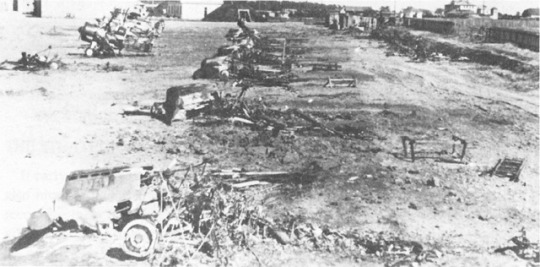
At 0330, June 22, 1941, a report reached Moscow of a series of airstrikes along the front. 30 hand-picked bomber crews had come in high over the borders in the dead of night, swooping down on ten fighter airfields across the front to begin their attacks at 3:00 that morning. As the bombs fell, artillery opened up, signaling the advance of a force of nearly 4 million men. At sunrise, the next wave of bombers came. 500 bombers, 270 Stukas, and 480 fighters swept across the border, hitting 66 airfields that held nearly 75% of the combat aircraft in the frontier districts. The bombers arrived on target to find the airfields silent, with aircraft neatly lined up along the strips for destruction.

Those units unfortunate enough to be caught in these opening strikes were nearly annihilated. The 9th SAD lost 347 of its 309 aircraft, while the 10th lost 180 of their 231 and the 11th 127 of 199. Pinsk Aerodrome had suffered the loss of 43 SBs and five Pe-2s, while the assaulting KG 3 had lost just a single bomber. Korbin Airfield, the base of the 74th ShAP, suffered the loss of 47 I-15s, 5 I-153s, and 8 Il-2s in these opening strikes With the fighter airfields taking the brunt of the first strikes, the VVS could hardly muster a response. On occasion, a lone I-153 or I-16 would rise to meet the invaders, but such bravery never ended well. Out of desperation, several pilots resorted to ramming. The VVS reported 19 aerial ramming incidents on June 22, resulting in the downing of at least two bombers.

The Stavka was stunned, and it would take several hours for orders to reach the front. 10 hours after the assault began, Pavel Zhigarev, the commander of the VVS, ordered every bomber into the air to resist the invaders. The first such raid came at 1315, when 27 SBs of the 130th SBAP sortied against German forces north of Brest. Lacking escort and poorly coordinated, the results were predictable. They were met by withering ground fire that dispersed their formation, allowing four Bf 109s to penetrate the formation. They soldiered on and dropped their bombs, but were caught by 30 more Bf 109s as they egressed, ultimately losing 20 of their 27 bombers. All across the front, the story was similar. DB-3s and SBs were appearing in waves without fighter escort, desperately trying to stop the advancing enemy columns. Some flew high, dropping bombs with little effect due to poor training. Others flew lower, making them easy prey for German air defenses and fighters.
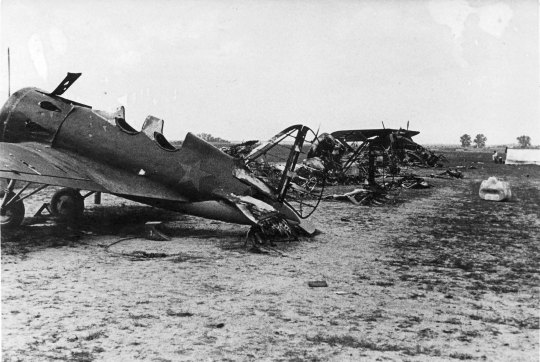
As the first day of Operation Barbarossa came to a close, both sides tallied the score. Initial reports claimed some 1,489 Soviet aircraft destroyed. A testament to the enormity of the loss, even Goering refused to believe the totals, and ordered a recount, only to find that the number rose to over 2,000. In all, the two waves of aircraft had inflicted incredibly high losses upon the VVS - the first wave was credited with some 1,800 enemy aircraft for a mere two losses, while the second wave destroyed a further 700 for the loss of 33 of their own. Total Luftwaffe losses for the day amounted to 24 Bf 109s, 7 Bf 110s, 11 He 111s, 2 Stukas, 1 Do 17, and 10 others. The Romanians also reported the loss of two PZL. P.37 fighters, two SM.79 bombers, four Blenheims, one Potez 633, one IAR 37, and one IAR 39. The incredible disparity in losses was by no means due to complete inaction on the part of the Soviets - the VVS reported some 6,000 sorties flown on June 22 alone, compared to the Luftwaffe’s 2,272.
Army Group Center

The coming week only saw things worsen for the Soviets. Only one district - the Baltic (soon redesignated Northwestern Front) -had any semblance of preparedness for the coming offensive, but their desperate attempts to counterattack were halted by Luftflotte 1’s KG 76 and 77. The Luftwaffe kept up the constant pressure on enemy airfields, though many bombers were now being tasked with close air support missions. Though these sorties more often than not were successful, they were costly. For example, when KG 76 and 77 were sent in to halt the Northwestern Front’s counterattack, they lost 22 of their number to ground fire. Even with such losses, they were still doing far better than the VVS. The desperate, poorly organized bomber raids continued with predictable results. VVS bomber formations were regularly slaughtered as they scrambled to halt the enemy, their bombs scarcely making an impact on the battlefield. Losses on June 23 were more even than the first day of the invasion, but still clearly in the Germans’ favor - Erhard Milch reported 800 enemy aircraft destroyed that day, while the Soviets claimed a mere 78 aircraft thus far in the war.

Though more counterattacks materialized on June 24, the situation hardly improved. Communication was becoming difficult due to the lack of radios and vulnerability of the telephone lines used, and the ongoing air campaign continued to claim countless Soviet aircraft. Operating under complete air supremacy, the Luftwaffe broke a counterattack at Grodno. On the other side of the front, the unescorted bomber raids persisted, with predictable results. June 24 came to an end with a further 557 Soviet aircraft destroyed, while the Luftwaffe had suffered just 40 destroyed and 30 damaged. Still reeling from the losses, the Stavka hastily reorganized the front. Leningrad Military District became the Northern Front, while the Baltic, Western, Kiev, and Odessa Military districts became the Northwestern, Western, Southwestern, and Southern Fronts, respectively.

On June 25, organized retaliatory raids across the border finally began. Aimed at striking German airfields, they ended with predictably high losses, but marked one of the first real strategic raids the VVS had launched. In Belorussia, the Luftwaffe supported the spearheads of the 2nd and 3rd Panzer Armies as they sped past the Soviet 4th Army’s headquarters at Brest. Threatened with encirclement, the 4th Army began withdrawing, but they would fall victim to air attacks. The Luftwaffe struck the headquarters at Brest Fortress, with StG 77’s Stukas hitting the headquarters themselves and KG 3 leveling fortifications with 1800 SC bombs. As June 25 came to a close, VVS losses were again painfully high at 351.
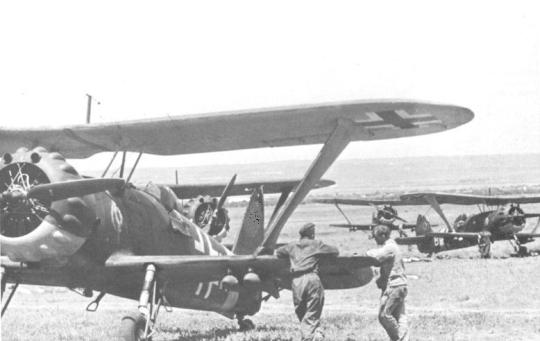
Despite efforts to escape the encirclement, the 2nd and 3rd Panzer Armies successfully closed the trap at Minsk on June 27. Luftflotte 2 now shifted its focus to suppressing and destroying the pocket. On a strategic scale, bombers continued raids on vulnerable communication lines, making coordination of the Western Front’s forces impossible. Meanwhile, armed reconnaissance sorties, primarily flown by Hs 123s, began, aimed at stopping the steady flow of Soviet forces escaping the Bialystok-Minsk Pocket at night. Even so, sortie rates were declining due to a combination of high losses to ground fire and straining logistics. Total sorties across the entire front had dropped to some 800 on June 26, and by June 28 it was down to 458. The following day, just 290 sorties were flown.
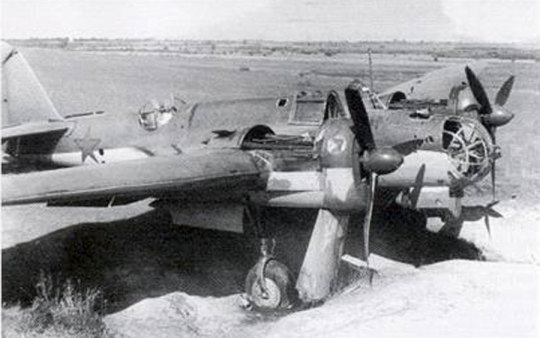
The VVS had hardly been sitting idle this whole time. VVS Western Front had committed nearly its entire surviving bomber force, including the 1 and 3 TBAP (flying archaic TB-3s) on low-level raids on the Berezina River crossing. However, flying against heavy ground fire and the aces of JG 51, they suffered some 146 losses. By July 1, the Bialystok pocket had collapsed, and the VVS Western Front had been reduced to just 374 bombers and 124 fighters of an initial strength of 1,789. The focus now shifted to the Minsk pocket, where a further four armies were encircled. Though the 2nd Panzer Army had its issues due to outrunning its air support, the concerted efforts of the II and VIII Fliegerkorps were taking their toll on the enemy.
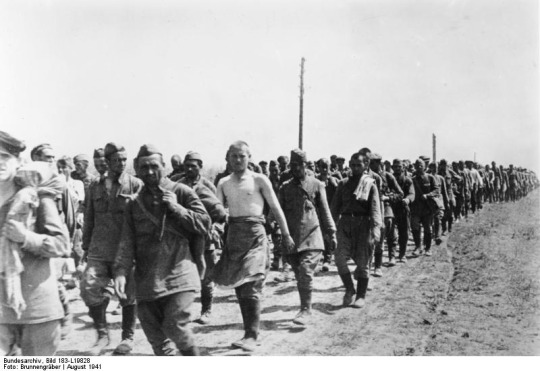
Further from the front, the interdiction efforts against Soviet communications and railways continued. However, much to the surprise of the Germans, the Soviet infrastructure was proving quite resilient. Telephone lines may have been easy to cut, but the Soviets were quick to mobilize crews to repair rail lines and bridges, so it was rare for any damage to last for more than 24 hours. However, such speedy repairs were not to be decisive in the near term. The Minsk pocket collapsed on July 3, and with it nearly 300,000 men became German prisoners. By then, the VVS Western Front had tallied some 1,669 losses to Luftflotte 2’s 699 losses (of which 480 were due to enemy action). The disparity in losses may have been evening out, but that was little solace to the men on the front. For the time being, the VVS Western Front no longer existed as a fighting force.
Army Group North
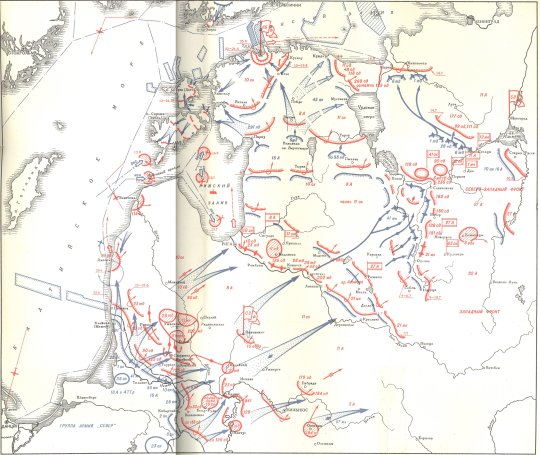
As the Baltic Military District/Northwestern Front had actually made steps to prepare itself for the invasion, they would suffer far less than the other districts in the opening strikes of the war. Having dispersed and camouflaged their aircraft in the days leading up to the war despite official orders, they had started the war with 1,211 aircraft across five air divisions and 71 airfields. Nevertheless, their comparatively light losses were still crippling - 425 aircraft were shot down and a further 465 destroyed on the ground by June 30. This came all while a counterattack by ground forces had been shattered by Luftflotte 1, followed by the 4th Panzer Army rocketing to Daugavpils (near Riga) by June 26. In fact, the advance was so fast that several airfields had to be abandoned in the face of the enemy. When III./JG 54 arrived at their airfield on June 25, they found 86 undamaged Soviet aircraft.

Though the VVS Northwestern Front had suffered catastrophic losses, they received some reinforcement in the form of the VVS KBF (Red Banner Baltic Fleet). On June 29 and 30, three massive raids were launched with a force of VVS KBF bombers and the remnants of the VVS Northwestern Front’s bombers. They targeted the bridges and airfield at Daugavpils, hoping to neutralize JG 54 and prevent the further advance of the 4th Panzer Army. As with most raids to this point, the missions were unescorted, leading to heavy losses. Most of the bombs missed their marks by a wide margin, while the fighters of JG 54 rose in number to intercept the Soviet bombers. The failure of the raids saw the arrest and replacement of VVS Northwestern Front’s commander, but by now the local air forces had ceased to be a functional fighting force.
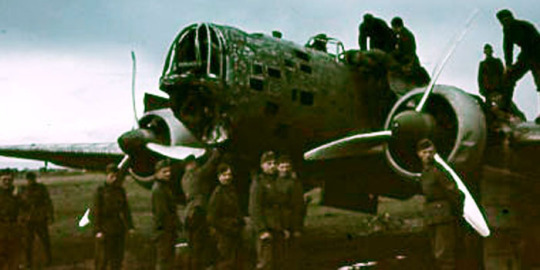
With the VVS Northwestern Front no longer available to defend against Army Group North, the VVS Northern Front, until then tasked with defending the fairly quiet Murmansk and Leningrad regions, was sent south to cover the Baltic. Commanded by Major General Alexander Novikov, the VVS Northern Front would be the only of the frontier military districts to muster a coherent response on the opening days of the war. On June 25, he had ordered a strike consisting of five fighter and twelve bomber regiments on Luftwaffe bases in Finland. Nearly 500 aircraft spent the day striking 18 Finnish airfields, catching Axis forces off guard, and perhaps more surprisingly, inflicting actual damage on the targets. And all this came at a fairly low cost - just 23 bombers and 11 fighters had been lost.

Novikov would continue these attacks with varying intensity even after the VVS Northern Front was expanded to encompass the Baltic. Unfortunately, Novikov’s leadership could only go so far. While the insistence on using radios and fighter escort meant that the VVS Northern Front’s forces were generally better performing, they still suffered an unsustainably high loss rate. Back in the Baltic, things continued to worsen. The VVS Northern Front first appeared in numbers over the theater on July 5, to which Luftflotte 1 responded with retaliatory strikes on airfields that claimed 112 aircraft. The Luftwaffe retained air supremacy, continuing their interdiction campaign to isolate Ostrov. Novikov continued his intensive bombing campaign against the German spearheads, but these raids were repulsed with high losses.
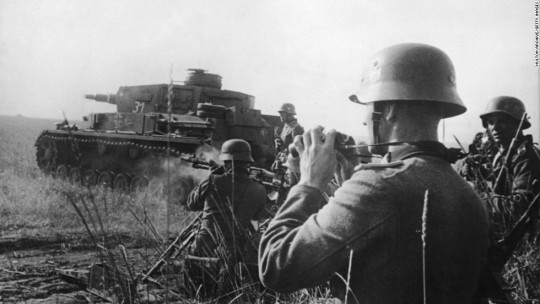
On July 7, Novikov’s bombers made perhaps their most decisive contribution yet. Recognizing the vulnerability of the bridges over the Velikaya River, Novikov sent out a large strike force that succeeded in disrupting the logistics of the 4th Panzer Army. However, this came at the cost of 42 bombers. In the first 10 days of July, Novikov’s Northern Front had flown roughly 1,200 sorties and dropped 500 tons of bombs. Unlike the VVS bombing efforts elsewhere, these raids were having a significant impact. Army Group North was reporting heavy losses of equipment to air attacks, particularly among the 1st and 5th Panzer Divisions. Though several units had nearly been annihilated, the VVS Northern Front had stopped the 4th Panzer Army short of Leningrad, buying them time to build defenses.
Army Group South

Perhaps the largest task of all fell upon Army Group South. Separated from Army Groups Center and North by the vast Pripyat Marshes, Army Group South was tasked with conquering Ukraine. Supported by Luftflotte 4, they were to take on the Southwestern and Southern Fronts, complete with 1,901 and 962 aircraft, respectively. Though most of these aircraft had been stationed along the front on June 22, they were spared the worst of the Luftwaffe’s bombing efforts in these first days. VVS forces in the south were more dispersed than those in the Western Front, and, in the Southern Front, several proactive commanders had taken steps to protect themselves from the coming invasion. Such efforts meant that the VVS was generally able to muster some serious opposition to these raids at first.
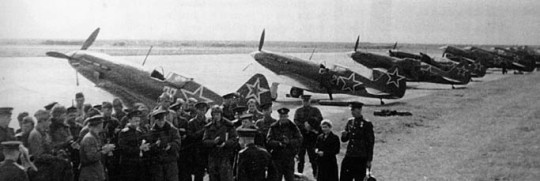
Unfortunately, these efforts could only go so far. There were no provisions for dispersing units to alternative airstrips, so the Luftwaffe would merely have to return to targets several times to annihilate the VVS. By the third day of fighting, the Southwestern Front had lost 237 aircraft on the ground. For the Southwestern Front and VVS ChF (Black Sea Fleet), the situation was somewhat better, as their bases were largely outside the range of the Luftwaffe. Energetic defenses were put up across Ukraine, with the sheer size of the theater preventing the Luftwaffe from ensuring complete air supremacy. VVS units were demonstrating an unparalleled aggressiveness even in the face of horrific losses. Concerted efforts were made against fixed positions such as artillery batteries, airfields, and decisive bridges, slowing down the Axis advance.
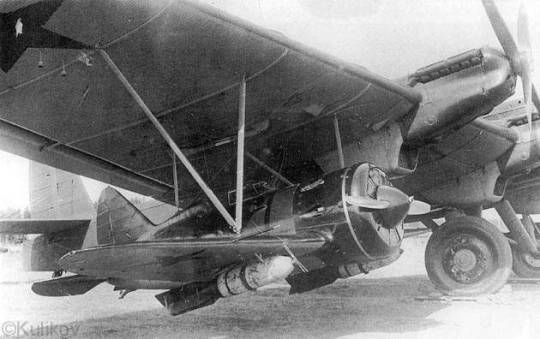
On the Black Sea, the VVS ChF had been running its own intensive air campaign since the outbreak of war. From the first day of the war, bombers had been flying from Crimea to Romania, striking the ports of Constanta and Sulina. These sporadic raids caught the Axis off guard, as Crimea had largely been ignored in pre-war planning. The endemic bombing of Romania would last until the Germans reached Perekop, forcing a significant fighter force to remain in Romania for some time to protect strategic refineries. These raids would gradually move closer to the front as the Axis advanced, eventually working to target decisive bridges as the enemy rolled across Ukraine.
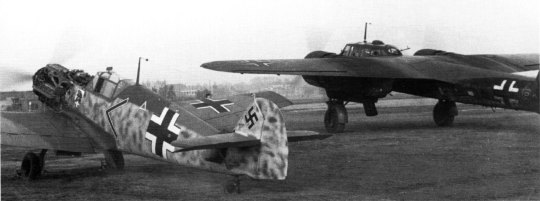
On the Kiev axis, the Hungarian Air Force made a decisive contribution, filling the gap left by a thinly spread Luftwaffe. Though mostly obsolete, they provided much needed reinforcement for V Fliegerkorps, allowing them to halt a Soviet counterattack and clear a path for the 1st Panzer Army. However, the Germans would experience the heaviest resistance in the air to date. By July 1, KG 55 had lost 24 He 111s, KG 51 a third of their strength, and KG 54 16 Ju 88s. Just as over Leningrad, the VVS Southwestern Front had thrown aircraft at the problem regardless of casualties, stalling the enemy advance long enough for the Red Army to establish a defensive line at Kiev.
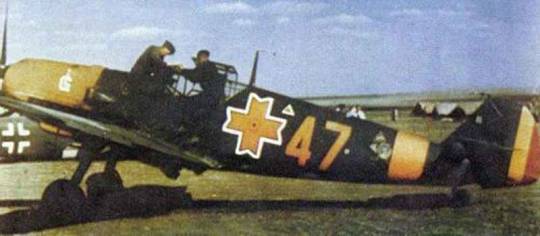
Over Bessarabia, the VVS put up an even more impressive defense. The Southern Front flew offensive sorties up until the region fell, going as far as knocking out 11 Stukas on July 12 when the 55 IAP struck an airfield. During this time, the Romanian Air Force flew 5,100 sorties, claiming 88 Soviet aircraft for 58 losses. JG 77, which supported the Romanians, was credited with 130 enemy aircraft, while German losses in the region were 31 destroyed and 30 damaged. Soviet admitted losses were 204, but at the same time records show the VVS Southern Front’s on-paper strength drop from 826 to 358.
Battle of Smolensk
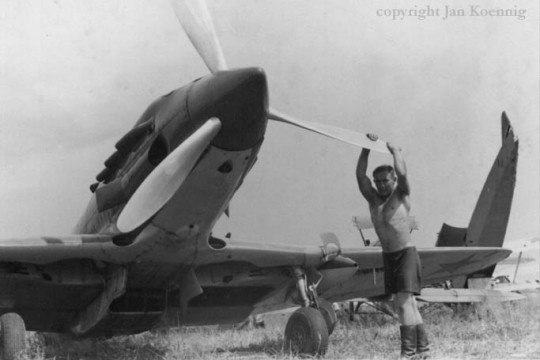
As the first phase of Operation Barbarossa came to an end, the VVS was a shadow of its former self. As of July 10, the VVS had just 774 bombers (181 modern) 128 ground attack aircraft (29 modern), 1,532 fighters (335 modern), and 82 reconnaissance aircraft (24 modern). The VVS Western Front in particular was in poor shape, having received not only the brunt of the opening strikes of the war, but also the worst leadership. On the other side of the front, the Luftwaffe was reigning supreme. They held air supremacy almost uncontested, and, although they had suffered not insignificant losses, they retained the bulk of their operational capacity - more than could be said for the Soviets. In the first five days of July, Luftflotte 2 logged another 2,019 sorties, claiming another 353 Soviet aircraft for just 41 losses of their own, with 183 aircraft claimed on July 5 alone. Regardless, reinforcements poured in. Aircraft were arriving from the factories as fast as they could be rolled out, and units were being drawn from the Moscow PVO and even the Far East.
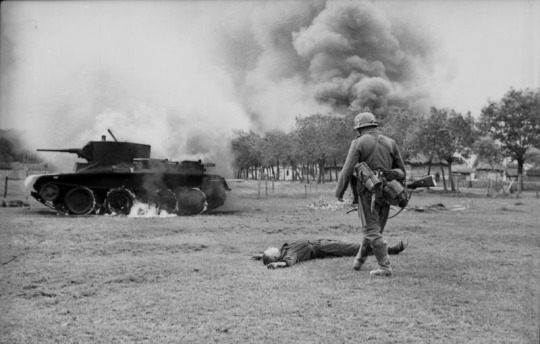
Despite the massive losses both in the skies and on the ground, the Soviets were quick to counterattack. On July 6, the Western Front launched an armored offensive near Lepiel, northeast of Minsk. Though the assault ended in disaster, as they ran directly into German anti-tank defenses, it showed the resilience of the Soviet forces. Four days later, the Germans launched their own offensive when the 2nd Panzer Group crossed the Dnieper between Mogilev and Orsha. The Luftwaffe contributed 1,048 sorties to the crossing, allowing the panzers to overrun the 13th Army. By July 13, the remnants of the 13th Army were encircled at Mogilev, and the 2nd Panzer Army was just 18km from Smolensk. Despite the Luftwaffe air superiority, the VVS was a constant presence, with the usual aggressive sortieing putting constant pressure on German units unfortunate enough to be caught without air cover.
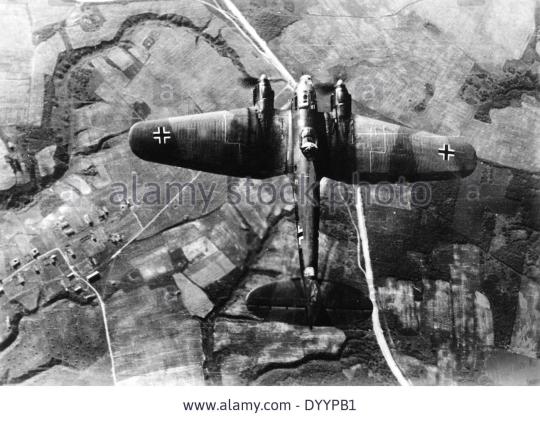
As the 2nd Panzer Group broke out to the south, the 3rd Panzer Group made its own push near Vitebsk. They made their way parallel to the 2nd Panzer Group, taking Polotsk and Vitebsk before ultimately capturing Yartsevo to the northeast of Smolensk on July 15. By mid-July, the front now consisted of two overlapping salients - a Soviet one consisting of three armies near Smolensk, and the one created by the 2nd Panzer Group’s advance south of Smolensk and extending to Yelnya. With Soviet forces threatened with encirclement, the theater devolved into chaos. Forces were both retreating from the salient and streaming into it, and the battle in Smolensk itself quickly devolved into bitter street fighting. The whole time, the Luftwaffe continued to wreak havoc, flying over 600 sorties on July 16 against the 21st Army alone.

By July 17, the trap had again been closed. The 16th and 20th Armies had been encircled at Smolensk, while the 21st Army was trapped even further to the west. As this occurred, however, there was a change of plans. The slow progress of Army Groups North and South had driven Hitler to order Army Group Center to divert forces north and south to help solidify the front. Army Group Center would work to straighten out their section of front, but the final push to Moscow would have to wait. Straightening the front, however, was no easy prospect. Though Army Group Center possessed numerical superiority in just about every piece of equipment from artillery to aircraft, the Soviets were persistent. Four new armies were thrown into the meatgrinder, performing a counterattack operation that lasted from July 21 to 30. However, though heavily strained, the Germans held on. Bf 110s were brought in to support ground-attack operations, and they would be pitted against the assaulting enemy after the Smolensk pocket finally fell. As for the VVS Western Front, there wasn’t much that could be done, as they had been reduced to fewer than 400 aircraft.
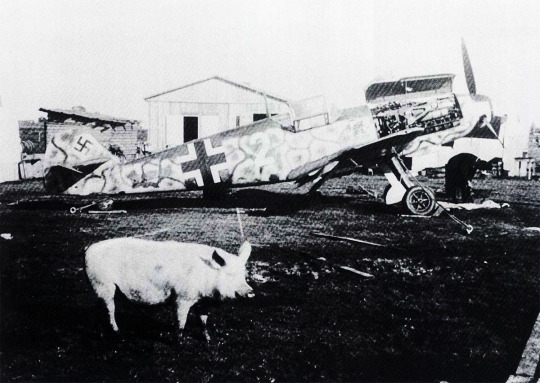
By early August, the Battle of Smolensk had come to an end. Though it was indeed an impressive victory - a further 300,000 men had been captured - it revealed several major failings of the Luftwaffe. 100,000 men had escaped the encirclement, owing in part to the inability of the Luftwaffe to maintain a round-the-clock presence. Worse, the Luftwaffe was not able to keep up with losses. Luftflotte 2 had lost 447 aircraft between July 6 and 19, and, while they still held air superiority, replacement rates would not be able to keep up with losses. On the other hand, the VVS Western Front had a seemingly endless supply of aircraft. In July, 900 new aircraft had reached the VVS Western Front - more than the average monthly production of all of Germany. Fortunately, the interdiction efforts seemed to be working - the Luftwaffe had flown 12,653 sorties over Smolensk, while the VVS Western Front was only able to muster 5,200.
Leningrad
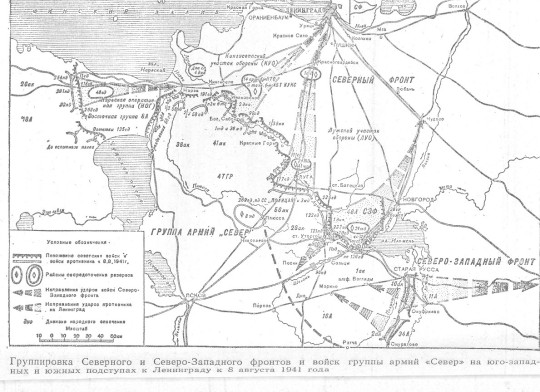
With Army Group Center ordered to disperse its forces to aid at Leningrad and Kiev, Fliegerkorps VIII was transferred from Luftflotte 1 to 2 to support Army Group North. Bolstered with two Staffeln of fighters, four of bombers, and four of Stukas, Army Group North finally had much-needed ground attack aircraft to support their coming offensive. In the lull since the 4th Panzer Army’s offensive came to a halt in early July, however, the Soviets had received their own reinforcements. VVS Northwestern Front had been replenished to 560 aircraft, while the Baltic Fleet remained a potent force , as did Novikov’s Northern Front. Despite their heavy losses, they maintained an offensive posture, with the Baltic Fleet even going as far as launching raids on Berlin and Konigsberg from their bases in the Gulf of Riga.
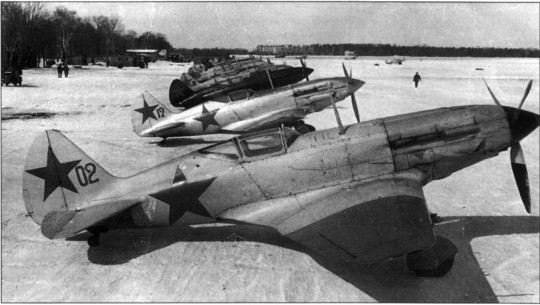
Unfortunately, the scope of the front would force the dispersal of Soviet air forces. When the German offensive resumed on August 8, the VVS KBF was occupied with long-range raids on Germany and local defense of the Baltic states, while the resumption of the Finnish offensive in Karelia tied up a further 162 aircraft. Poor weather precluded the use of aircraft until August 10, at which point Novikov diverted the 2BAD and 7 IAP/5 SAD to the front. The VVS Northwestern Front mustered 908 sorties against the advancing Germans, whereas Luftflotte 1 flew 1,126 of their own. The intensity of the Soviet air operations sparked another wave of airfield attacks, with ZG 26 and II./JG 54 sent out to harass the enemy airstrips.

Despite the frantic response of Novikov’s forces, the Germans were advancing quickly. The rail line between Leningrad and Tallinn was captured on August 13, threatening to trap the 8th Army in Estonia. Novikov dispatched 126 aircraft of the Baltic Fleet to assist them, but with little effect. Meanwhile, the German 11th Army had reached Lake Novgorod, threatening to sever communications between Leningrad and Moscow. The Red Army launched a counterattack to throw the enemy back, to which Luftflotte 1 responded by throwing the entirety of Fliegerkorps VIII as well as Fliegerkorps I’s KG 76 and 77 into the fray. Fliegerkorps I focused on interdiction, destroying logistical lines leading to the battlefield, while Fliegerkorps VIII took a more active approach, wreaking havoc on aircraft and vehicles in the theater. As the Soviet counteroffensive ground to a halt, StG 2’s Stukas shifted their focus to Novgorod, leveling fortifications and destroying bridges into the city.
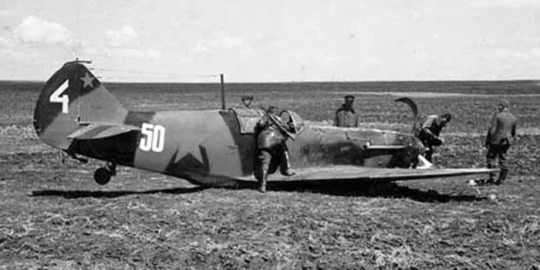
On August 20, the German 18th Army reached Narva, cutting of Soviet forces in Estonia. North of Novgorod, Chudovo fell, severing the road between Leningrad and Moscow. Up to this point, Fliegerkorps VIII had dropped some 3,000 tons of bombs in support of Army Group North’s offensive. Despite the steady progress of the German Army, however, the VVS remained an ever-present force. Though Novgorod fell on August 24, VVS Northwestern Front received the 402 and 6 IAP, reviving their presence in the air. Elsewhere, the fronts were reorganized. The VVS Leningrad Front took shape, complete with 299 aircraft, along with the VVS Karelian Front. The reinforcement and reorganization quickly made its impact. VVS fighters would appear in numbers over the front in late August to oppose Fliegerkorps VIII. Though even by their own admission they were suffering at least double the losses they were inflicting, the Luftwaffe was beginning the feel the effects of the losses as ever more invaluable Stukas and bombers fell.

In late August, the German focus had shifted to Estonia. Cooperating with the Finns, a combined air-and-sea blockade was established. Meanwhile, land forces were slowly working to crush resistance in the Baltic islands, again heavily supported by Fliegerkorps VIII. The Soviets began an evacuation on August 27. The Luftwaffe air blockade efforts were devastating, sinking several ships and forcing the Baltic fleet to divert its routes through a minefield, leading to further losses. By the time the evacuation of Estonia ended, the Soviets had lost 34 merchant vessels, 16 warships, and 34 transports, as well as 5,000 men of the trapped force of roughly 30,000. The fortified positions in the Baltic islands held on longer, but by the end of October the last of these was crushed.
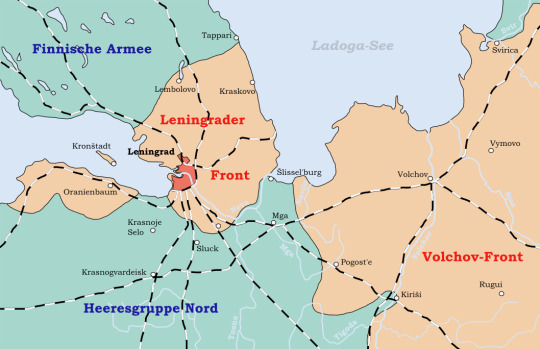
By early September, the Axis forces were closing in around Leningrad. The Finns had advanced just past the 1939 border in Karelia, closing off the northern route out of the city, and, the last railway into the city was severed when the Germans reached the Neva River. Bombing of the city began, and the interdiction efforts against the White Sea/Baltic Canal intensified, ultimately knocking out several locks. On September 8, German forces reached the shores of Lake Ladoga, severing the last land route into the city. Bombing of the canal continued into October, but once the stranglehold on the city was tightened, the aircraft tasked with the canal-bombing were sent back to Fliegerkorps I.
Turning South
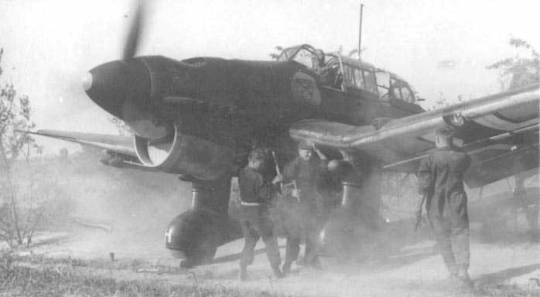
South of the Pripyat Marshes, the Soviets had put up a much better defense. Though Army Groups North and Center had reached as far as Riga and Smolensk by early July, the Red Army’s Southwestern Front had halted Army Group South just short of Kiev. With Army Group South well behind schedule and the Soviets dug in at Kiev, the decision was made to push south. By breaking out south of Kiev, Army Group South hoped to isolate the garrison at Odessa while threatening Kiev with encirclement. Luftflotte 4 was tasked with supporting the operation, while the VVS could only muster the Southwestern Front, as the Southern Front was still occupied with the Romanians.

Army Group South opened up its offensive south of Kiev on July 15, supported by an extensive Luftwaffe interdiction campaign on Soviet supply lines across the Dnieper. By targeting the rail bridges across the river, the Germans prevented any significant response on the part of the Red Army. The battered VVS Southwestern Front made an attempt to halt the advance, but they were soon withdrawn to concentrate their strength around Kiev. With no friendly air cover to speak of, the 6th and 12th Armies that lay west of the Dnieper were helpless. For ten days they were battered by Stukas and ground attack aircraft while the bombers roamed free, preying on unfortunate trains and trucks. By July 25, the situation was considered hopeless, and the order to withdraw across the Dnieper was given.
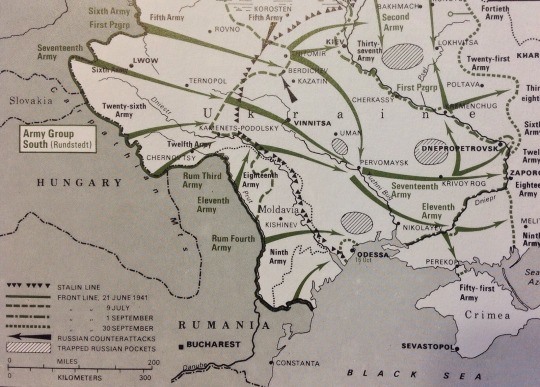
Unfortunately, exactly what Army Group South was attempting was not recognized until it was too late. A combination of the interdiction efforts and unclear withdrawal orders slowed the Soviet withdrawal, and on August 2, the German pincers closed yet another pocket around the 6 and 12th Armies. Hoping to relieve the pocket, the Soviets launched a counterattack on August 7. However, without any air support, they were unable to break out their allies. Fliegerkorps V halted the assault, destroying hundreds of tanks and other vehicles. The next day, the pockets had collapsed, leading to the capture of another 100,000 Soviet soldiers. The 26th Army, which led the failed relief attempt, had been so severely battered that it was withdrawn across the Dnieper.

After the disaster at Uman, all Soviet forces began withdrawing east of the Dnieper save those holding Odessa. Army Group South had just annihilated two Soviet Armies, and their momentum was still going strong. With Axis forces now holding most of the land south of Kiev, a new offensive was launched, aimed at encircling the battered 26th Army from the south. To slow the 26th Army’s withdrawal across the Dnieper, the Luftwaffe was called into action. StG 77 was deployed against the numerous bridges on the Dnieper, supported by the fighters of JG 3. Unlike earlier battles, the VVS Southwestern Front was active over the battlefield, fighting hard to protect the bridgehead. The efforts seemed to have worked, as the 26th Army was able to successfully reach the east bank of the river.
Battle of Kiev

As Army Group South consolidated its position, the battlefield slowed down. Luftflotte 4 was depleted and exhausted, and, as the efforts to block the 26th Army’s escape at Kiev showed, they were no longer able to decisively complete their mission. Nevertheless, they soldiered on, shifting their focus to attacking the transportation hub of Dnepropetrovsk on August 17. Fortunately, the were bolstered from the north by Luftflotte 2. Their front now shortened, Luftflotte 4 concentrated on preventing straggling Soviet units from escaping across the Dnieper, but to no avail. Soon enough, their focus would change once more. The coming offensive entailed a major push across the Dnieper swinging east of Kiev to link up with forces from Army Group Center. Due to the depletion of forces, interdiction efforts would give way to more direct support missions.
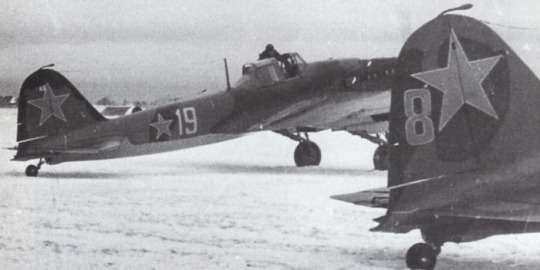
On August 23, the German offensives opened up. Army Group South crossed the Dnieper at Zaporozhye and Cherkassy, while Army Group Center’s 2nd Panzer Army swung down from GOmel supported by JG 51 and SKG 210. The 2nd Panzer Army struck right at the junction between the 13th and 40th Armies, driving between them and advancing nearly 100km in a day. KG 3 and KG 53 flew deep into enemy territory to destroy the rail stations at Chernigov, spreading chaos among Soviet logistics. VVS Southwestern Front was quick to respond. Aircraft were thrown at the German 6th Army’s bridgehead on the Dnieper, knocking out the sole bridge for the loss of 33 aircraft. Further south at Dnepropetrovsk, the 210 ShAP attacked the Axis bridgehead, which was protected by a mix of Romanian, Hungarian, Italian, and Slovak units. In particular, the Macchi C.200s of 22 Gruppo appeared in strength, claiming several victories for no loss.
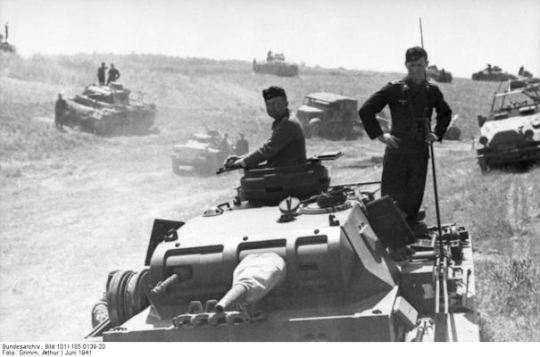
Responding to the rapidly advancing German thrust on the north, the Stavka formed the Bryansk front, complete with its own VVS force of 464 aircraft. Drawn primarily from reserve groups and consisting primarily of modern aircraft, the VVS Bryansk Front was supplemented by aircraft drawn from the Transcaucasus Military District, naval aviation, Moscow PVO, and even flight schools. They were throw into combat quickly, suffering heavy losses to the veteran pilots of JG 51. The bombers of Fliegerkorps II responded to the new threat with renewed interdiction efforts aimed at halting the supply of new equipment. Nevertheless, the air offensive on August 29 was enough to briefly stall the 2nd Panzer Army’s advance.

By the end of August, the balance had seemed to tip in favor of the VVS. Luftflotte 4 had been reduced to just 320 bombers, 100 fighters, and 35 reconnaissance aircraft, while VVS Southwestern Front had nearly 500 bombers and another 500 fighters at its disposal. Though encircled, the 119 machines of VVS Southern Front at Odessa presented another threat that would have to be contained by the Luftwaffe. The VVS kept constant pressure on enemy bridgeheads and airfields in a desperate attempt to stop the enemy advance. In the south, it seemed to be working - Luftflotte 4 was struggling to achieve their objectives, and operations against bridgeheads were slowing the advance.

The 2nd Panzer Army’s spearhead from the north, however, would not be stopped. The entirety of JG 3 and the Slovak 12 Letka was committed to protect the advancing Panzers, and the intense efforts of the 249 IAP would fail to dislodge them. Worse, the comparatively fresh forces of Luftflotte 2 continued to devastate Soviet logistics. The 40th Army, which had been on the frontlines since the operation began, had been reduced to a mere 5,000 men, and the 38th Army was immobilized by the constant air attacks. Bryansk Front, which had been tasked with stopping the 2nd Panzer Army’s advance, was forced to halt their counterattack.
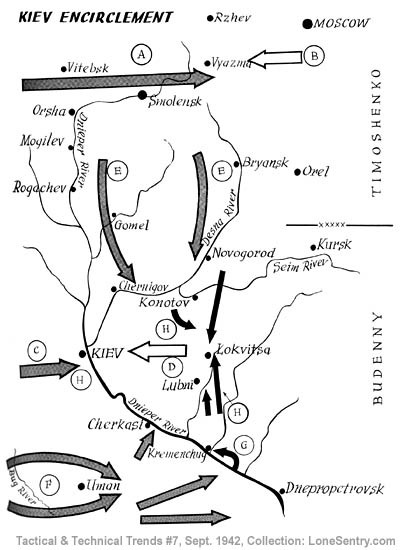
On September 14, the 1st and 2nd Panzer Armies met up at Lubny, closing the pocket and trapping almost half a million men at Kiev. The two Luftflotte now turned their attention inwards, hoping to contain the encircled forces for destruction. Operations concentrated on transportation - trucks, trains, and aircraft - immobilizing the encircled forces and devastating morale. Owing to fuel shortages, the Kampfgeschwaders passed off their duties to the less logistically straining Stukas, which performed the duties admirably. Through the rest of September, Fliegerkorps V worked with ground forces to destroy the Kiev pocket. 1,422 sorties would be flown, with 5,67 tons of bombs dropped during the operation. Kiev itself fell on September 19, but remnants held out in the pocket until September 26. The failure of the Kiev operation marked another major blow to the Red Army - some 600,000 men were dead or captured, while Axis losses were just 130,000, of which only about 30,000 were killed or captured.
Aftermath
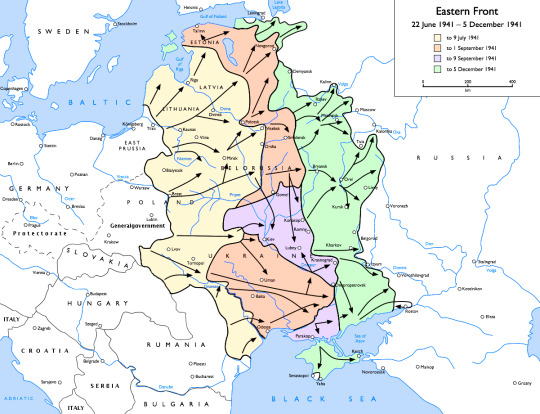
Though the German offensive was far from over, the end of the Kiev operation effectively marked the end of the first stages of Operation Barbarossa. Without a doubt, the period between June 22 and October 1, 1941 had marked some of the fiercest air and land combat in history. Though exact numbers are unclear, VVS losses across the whole front easily numbered in the tens of thousands, while Axis losses were far lower - likely somewhere between 2-3,000 aircraft from all causes. By October 1, the VVS had been reduced to just 1,716 aircraft (508 bombers, 180 ground attack, 948 fighters, and 80 reconnaissance), most of which were concentrated around Moscow. For the time being, the Luftwaffe actually held numerical superiority over most of the front. On the ground, things had gone similarly bad. Soviet losses were already in the millions, and untold numbers of precious tanks, trains, and other equipment had been lost. Kiev and Smolensk had fallen, Leningrad, Odessa, and Crimea were encircled, and Army Group Center was poised to launch the final coup de grace on Moscow.
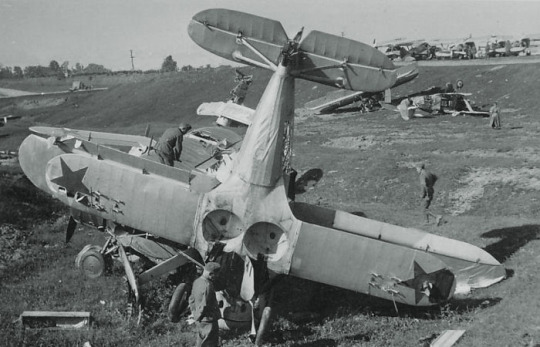
Of course, the raw numbers hid an underlying situation that was far from favorable for the Axis forces. The Soviets proved to be absurdly resilient in nearly every aspect. Far from “only hav[ing] to kick in the door” and have “the whole rotten structure come crashing down, ” the Germans were having to annihilate new Soviet forces that kept popping up. For every Army destroyed, the Soviet seemed to be able to raise a replacement almost instantly. Interdiction efforts may have been effective at paralyzing forces on the front, but the Soviets were repairing things far faster than the Germans had predicted, forcing the Luftwaffe to devote more sorties than expected to keeping the supply lines closed. The VVS also experienced this resilience, with individual VVS fronts receiving more replacements in a month than Germany could muster for the entire Luftwaffe. In short, the Russians were producing aircraft faster than the Luftwaffe could shoot them down.
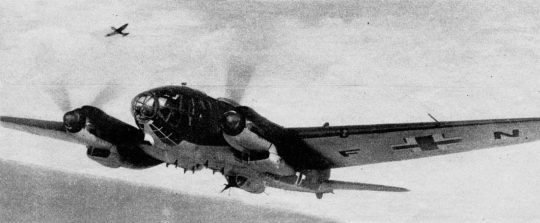
The campaign had also revealed numerous failings in the Luftwaffe. The Luftwaffe lacked the ability to operate at night, allowing countless men in the numerous salients to escape to friendly lines. Though they worked to address this by using obsolete Hs 123s for night patrols, this vulnerability remained for some time. The VVS would take advantage of this, sending many of their obsolete types on night raids for which the Luftwaffe had no real counter. Overall, there was a shortage of aircraft that only became more apparent the further the Germans advanced. Numerous fronts experienced shortages of ground attack aircraft, and, although medium bombers had been adequate substitutes, their use in close air support sorties led to high losses that only exacerbated the situation. As the front expanded and numbers dropped from attrition, commanders were increasingly finding that the Luftwaffe would only be able to achieve its objectives in one sector by ignoring others.
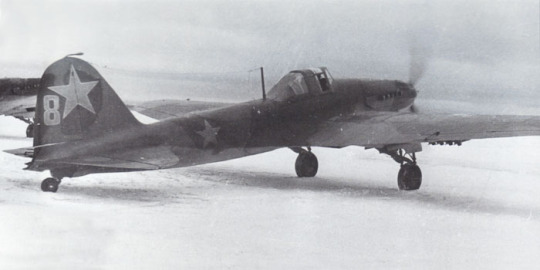
For all the VVS’s failings in the opening stages of the campaign, they were quickly improving. Across the front, capable leaders were put in place, including Major General Alexander Novikov near Leningrad. These men were quick to adapt, steadily improving the quality of their air forces even in the face of the vastly superior Luftwaffe. Through all the chaos, perhaps the greatest success of the VVS and failing of the Luftwaffe came with Soviet industry. German intelligence underestimated the ability of the Soviets to relocate their factories, and bombing efforts had accordingly ignored Soviet factories under the assumption that they would soon be in Axis hands. However, the valiant efforts of the VVS and Red Army - particularly at Kiev - allowed most Soviet industry to be relocated east of the Urals, out of the reach of German bombers. The massive relocation effort led to a temporary lull in production that suspended replenishment of many types (particularly older aircraft), but it kept the factories out of German hands and preserved much of the Soviet industrial capacity.
Epilogue
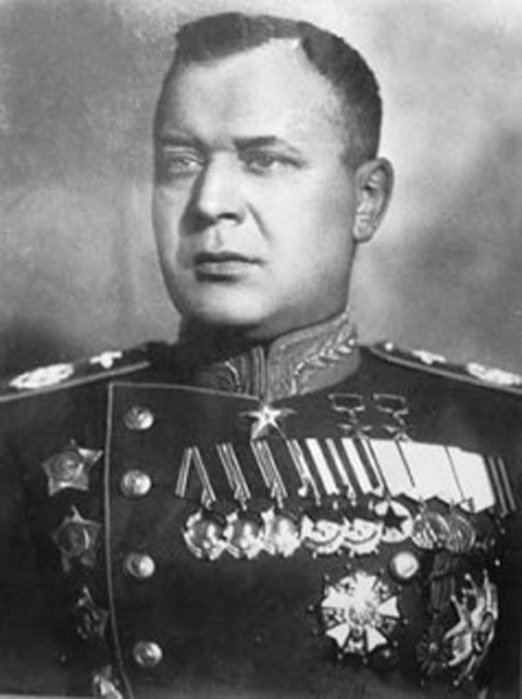
Surprisingly, the man in charge of it all - Pavel Zhigarev - would survive the invasion, both avoiding enemy fire and the wrath of a panicked NKVD. He remained commander of the VVS through the end of the year, seeing the VVS through the Battle of Moscow. Though the invasion was disastrous, his service in light of the circumstances was enough to save his life. He was replaced (but not arrested or executed) in early 1942 and transferred to the Far East, where he commanded all the air forces there. In his place, none other than Major General Alexander Novikov took over. He would go on to apply the same concepts he pioneered with the VVS Northern Front to the VVS as a whole, ultimately resulting in a restructuring effort that would last most of the rest of the war. Novikov would remain supreme commander of the VVS until the end of the war.
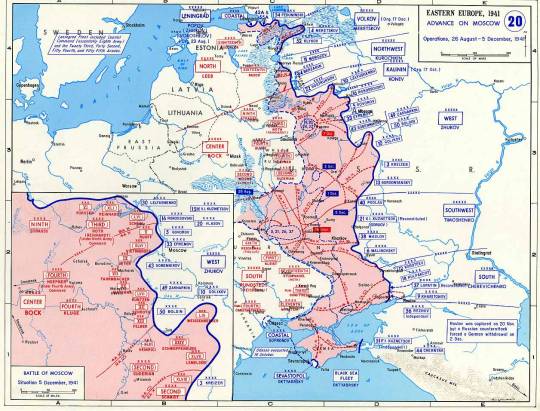
Though the USSR had survived the opening months of the invasion, the worst was yet to come. On October 2, Army Group Center opened up Operation Typhoon, aimed at encircling and capturing Moscow. Further north, the siege of Leningrad continued, with the situation worsening with every coming day. In the south, things were little better. Odessa would finally fall in mid-October, and an Axis offensive into Crimea began around the same time. 1941 would end with the enemy at the gates of Moscow, Army Group South in control of most of the Donets basin, and the cities of Leningrad and Sevastopol besieged with little hope of relief. The USSR may have survived Operation Barbarossa, but the future was by no means certain.
8 notes
·
View notes
Text
/k/ Planes Episode 95: Russian Bombers

It’s time for another episode of /k/ Planes! This time we’ll be looking at Russia’s medium and heavy bombers.
Russia’s bomber fleet occupies an interesting place in aviation history. Though they would mark the first heavy bomber force in history, the bombers of the early Russian/Soviet Air Force for much of their history seemed to develop in waves, with each successive generation belatedly coming in reaction to a major change in doctrine. The Second World War further complicated the situation - though a potentially capable series of long-range bombers took shape, medium bombers took priority, and thus as the war came to an end the VVS was scrambling to catch up with the West’s heavy bombers. Though the first step of this hasty modernization involved blatant copying, bomber development progressed quickly. Medium bombers fell out of favor, and in their place the Russian bomber fleet grew into a combination of intermediate and long range strategic bombers. Whereas the West reacted to the advent of SAMs by introducing low-level penetration tactics, the VVS instead felt the use of standoff cruise missiles was a more promising option. As such, every Soviet bomber project since the ‘60s has been first and foremost a cruise missile carrier, with many projects forgoing conventional munitions entirely.
Sikorsky Ilya Muromets
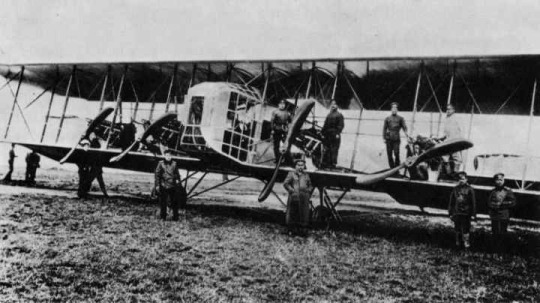
Following the successful testing of the four-engined Russky Vityaz, Sikorsky set his sights on an even larger design. Dubbed the Ilya Muromets, the aircraft was conceived as a luxurious four-engined airliner, complete with an insulated cabin, electric lighting and heating, and even the world’s first airborne toilet. First flying in December 1913, the two prototypes began to set records immediately. While it brought Sikorsky much glory, the focus of the design would shift radically as war loomed in 1914. Sikorsky redesigned the Ilya Muromets, creating the world’s first purpose-built bomber. The militarized Ilya Muromets replaced the passenger cabin with an internal bomb bay for 800kg of bombs, as well as 5mm armor plates around the engines and nine defensive machineguns.
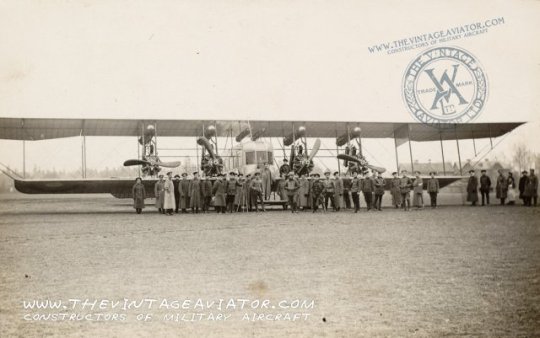
Only two Ilya Muromets were in service when war broke out, and it would take until December for the first bomber squadron to be formed. Bombing operations began in February 1915, primarily targeting frontline positions. It gained a fearsome reputation amongst German pilots thanks to its formidable defensive armament, and, while its bombing sorties were hardly decisive, it was enough for a more substantial production run to be ordered. It would take until September 1916 for the first loss to occur, with a Muromets downing three enemy fighters before being shot down itself. Meanwhile, the Russians refined their tactics, introducing formation flying and adopting such practices as night raids and post-raid reconnaissance.
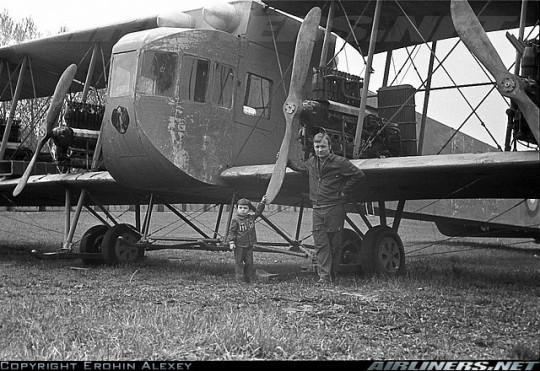
Unfortunately, the Ilya Muromets would be eclipsed in the latter half of the war by the first generation of bombers from other powers. They were withdrawn to training roles in early 1917 after flying some 400 sorties and dropping 65 tons of bombs. When the 1917 revolution began, several returned to combat service, flying with the Imperial Army, Red Army, and Polish forces. This allowed their combat service to extend a bit longer - until 1919. A handful of Ilya Muromets served into the early ‘20s as airliners, but ultimately the last Ilya Muromets airliners would be retired in 1922 due to the difficulty of maintaining the engines and airframes.
KOMTA-1

In 1920, the Red Army formed a new heavy aircraft commission - KOMTA - to develop a replacement for the Ilya Muromets. The design was finalized by the end of 1920, but construction dragged on, and only in 1922 was the bomber completed. The KOMTA bomber was a large triplane machine powered by two 240hp Fiat engines slung under the middle wing. It featured a large, boxy fuselage much like that of the Ilya Muromets, but the structure was far more robust. Ground testing began in early 1922, culminating in high-speed taxi tests. Unfortunately, a minor crash delayed the project, so flight testing wouldn’t begin until the Fall of 1923. By the time the KOMTA bomber finally did fly, performance was found to be disappointing. Top speed was a pitiful 130 km/hr, while the flight ceiling was a uselessly low 600m. The newly established TsAGI used their extensive wind tunnel facilities to try to find a solution to improve performance, but to no avail. Ultimately, the KOMTA bomber was abandoned in 1924.
Farman F.62BN.4
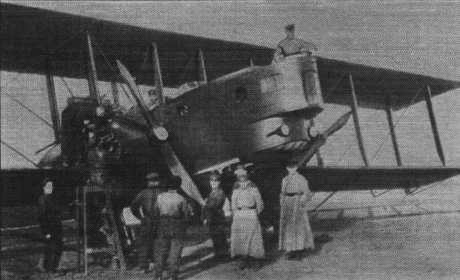
In 1925, the Soviets were looking for a stopgap to serve as a replacement for the Ilya Muromets until the TB-1 was ready to enter service. They found their answer in a French design from the manufacturer Farman. Dating to 1918, the F.60 series design was originally designed as a bomber, but it was repurposed as an airliner as the war ended. Efforts to market the F.60 to commercial users - leading to reduced costs and a variety of compatible powerplants - ended up attracting the Soviets, who ordered the F.62BN.4 variant (powered by two 450hp Lorraine-Dietrich engines). The Farman bombers would come to fly with two squadrons. Domestic production was considered as well, but it was decided against, as the TB-1 would already be in production by the time the F.62 production could begin. Ultimately, the F.62’s service with the VVS was brief. As TB-1s entered service, the F.62s were used as transitional trainers and paratroop carriers before being retired altogether.
Tupolev ANT-4/TB-1
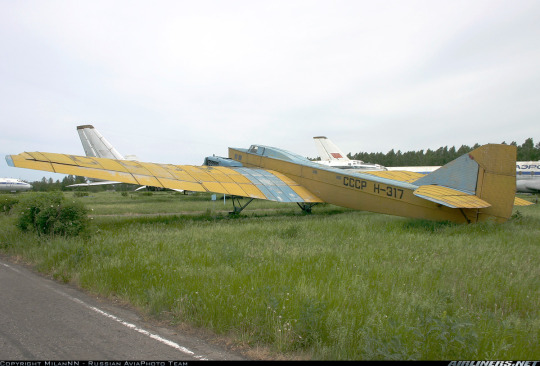
In 1924, TsAGI was instructed to develop a heavy bomber by the VVS, and the task was assigned to Tupolev’s new OKB. Tupolev’s latest design, the ANT-4, would build on previous works with all-metal aircraft to create a groundbreaking design. With just 9 months to produce a bomber, Tupolev created an all-metal twin-engined cantilever monoplane bomber - the first of its kind in the world. The ANT-4 was to have a crew of six and carry a payload of 1,000kg of bombs. While the prototype was unarmed, positions around the aircraft provided for six defensive machineguns. Little over a year after the project began, in late November 1925, the ANT-4 took flight for the first time. Minor modifications were made after preliminary tests, but by the end of 1926, the ANT-4 had passed state acceptance tests and was ordered into production as the TB-1.
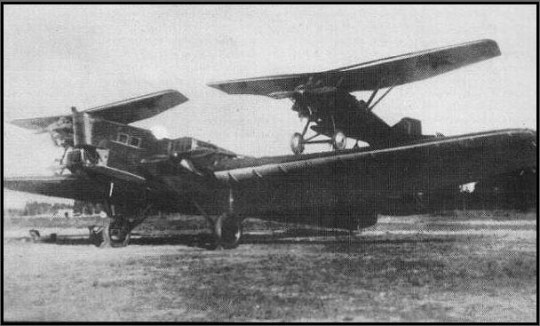
Difficulties procuring resources meant that the production TB-1s wouldn’t roll out until 1929. Numerous variants were developed, ranging from torpedo bomber to cargolifter and airliner. It would prove a popular and reliable platform during its service, though it was gradually eclipsed by more modern bombers. During the 1930s, the TB-1 was the basis for several experiments. In 1933, modified TB-1s served as a mothership for the Zveno parasite fighter program, carrying sn I-5 over each wing. Other experiments involved rocket-assisted takeoff systems, aerial refueling, paradropping heavy cargo, and even radio remote control. The TB-1’s military service would last until 1936, by which time modern (or at the very least less obsolete) types had taken over. As a transport aircraft, it would remain in use as late as 1948.
Kolpakov-Miroshnichenko LB-2LD
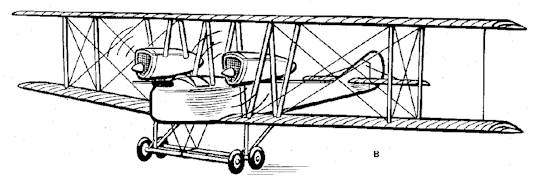
In competition with Tupolev’s ANT-4 project, the design team of Kolpakov and Miroshnichenko was also instructed to develop a bomber. Under the designation LB-2LD, the team derived their design from the Lebed-XIV reconnaissance aircraft developed in WW1. Thus, the LB-2LD was somewhat archaic in appearance - it had thin, heavily braced biplane wings and four-wheeled landing gear. A single 450hp Lorraine-Dietrich engine was to be mounted outboard of the fuselage about halfway between the wings, although only 240hp Fiat powerplants were available for the prototype. It carried over the same crew arrangement as its predecessor, with space for a pilot and three gunners in nose, dorsal, and ventral positions. The LB-2LD took flight in 1926, but initial flight testing revealed dangerous deformations of the tail. It was decided to perform destructive testing on the prototype to be sure the aircraft was able to withstand flight-related loadings. Though the LB-2LD was found to be able to withstand slightly more stress than it was designed for, the project would end there - it was glaringly obsolete, particularly in comparison to Tupolev’s ANT-4, which would go on to win th competition and gain the designation TB-1.
Polikarpov TB-2
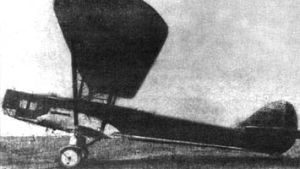
In 1927, Polikarpov began work on a new bomber project. Designated the TB-2, it was a clean sesquiplane design mounting two 680hp BMW engines. Carrying a crew of five, it could mount a payload of up to 800kg of bombs. Though archaic in layout, Polikarpov did what he could to make the TB-2 competitive. The struts holding the upper wing were simplified and streamlined compared to earlier biplane designs, and the engines were mounted on the lower wings in streamlined nacelles. First flying in 1930, the TB-2 was somewhat a success - it demonstrated better performance than the more modern TB-1. However, performance was still lacking, and the biplane layout was already considered obsolete by Soviet authorities. Ultimately, the TB-2 would never enter production, with authorities instead opting for Tupolev’s more modern TB-3.
Tupolev ANT-6/TB-3
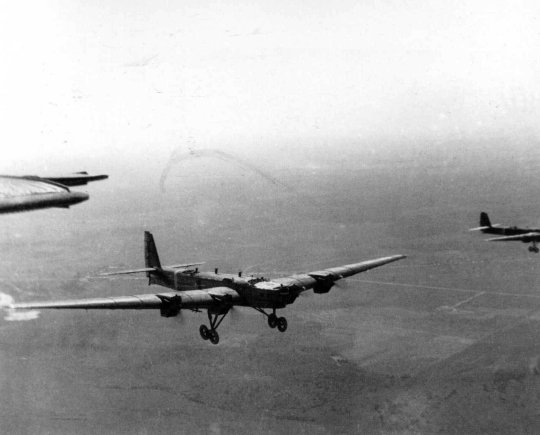
In 1925, Tupolev was assigned a project to develop a bomber with 2,000hp of total engine output. Although design work began soon after, it would take until 1929 for full requirements to be finalized. To meet the required engine output, Tupolev was forced to use a four-engined design based off of the TB-1. The new aircraft roughly resembled a scaled-up TB-1, mounting four of the predecessor’s M-17 engines and retaining a similar crew and armament, but doubling payload to 2,000kg. The first TB-3 prototype was completed in 1930, with flight tests beginning in late December of that year. It was submitted for state trials soon after, and by February of the next year, the TB-3 was ordered into production.

As with the TB-1, it would take some time for production TB-3s to start rolling out of the factories. The first pre-production machine didn’t fly until early 1932, and production was further slowed after preliminary tests found the type to be grossly overweight due to poor factory tolerances. These issues were partially alleviated, allowing production to begin in earnest. The corrugated aluminum behemoth soon rose to form the backbone of the largest heavy bomber force in the world, and, by the time production ended in 1937, over 800 had been built. Unfortunately, its reign was brief. The archaic-looking bomber was understandably lumbering and vulnerable, and although experiments were made to address the more obvious flaws in the design - the corrugated skin and numerous open positions - improvements in performance were not enough to keep the bomber competitive.

By the end of the decade, the TB-3 was now horribly obsolete and unsuitable for conventional heavy bombing. However, the massive aircraft would prove to be incredibly useful in a variety of other roles. The spacious cabin and heavy payload capacity meant many would see use as conventional transports or even drop aircraft for paratroopers, and, like the TB-1 before it, the TB-3 would be subject to several Zveno parasite aircraft experiments. These experiments saw anywhere from two to five fighters being attached to the TB-3 with the intention of extending range and providing bombers with their own escort.
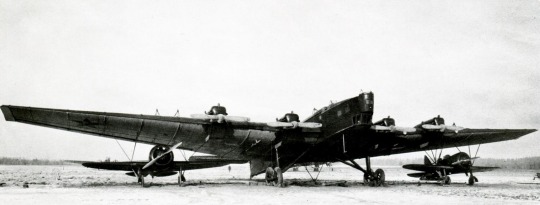
The TB-3 would make its belated combat debut in 1939 over Khalkhin Gol. There, 25 TB-3s operated from distant airfields, flying night raids almost exclusively due to their vulnerability to Japanese fighters. Nevertheless, when Operation Barbarossa began, over 500 TB-3s were still in VVS service, making up 25% of the bomber force. From the first day of the war, they continued to fly night missions, although the occasional daylight raid, complete with predictably disastrous results, would occur as well. Apart from these more conventional raids, the TB-3 also participated in more unique attacks on Romania. The final product of the Zveno program, the Zveno-SPB (two FAB-250-loaded I-16s carried by a TB-3) would fly sorties out of Sevastopol to hit strategically important bridges and pipelines in Romania once war broke out. Against all odds, the system worked surprisingly well - the fighters were reasonably accurate with their strikes, and losses were low.
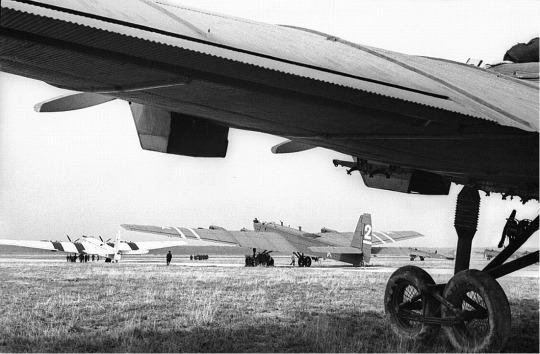
The Zveno strikes would be short lived, as their factory in the Crimea was soon overrun. However, the TB-3 would continue to fly in auxiliary roles with the VVS. In combat roles, they were exclusively relegated to night missions, while in other roles, they became vital transports and paratrooper platforms. They would participate in every major battle on every front through 1943, by which point attrition had whittled their numbers down. As the VVS reformed, the TB-3 took a backseat to more modern types and was gradually phased out. However, they would stick around until the end of the war - the 18th Air Army (successor to the Long-Range Aviation forces) had 10 TB-3s on their roster at the end of the war. Only as the war finally came to a close was the most iconic symbol of Soviet interwar airpower finally retired.
Tupolev ANT-16/TB-4
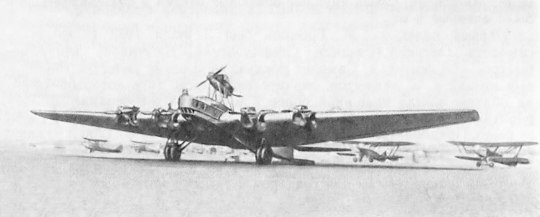
The penultimate development of Tupolev’s corrugated-skin bombers would come in the form of the gargantuan TB-4. Designed around the philosophy of the payload efficiency of larger aircraft, the TB-4 was double the size of the already impressive TB-3. Two engines were mounted in a push-pull nacelle above the fuselage, while the remaining four were mounted in the leading edge of the two-meter thick wing. The centerpiece of the design was the two massive bomb bays designed to carry an internal load of 4,000kg. The TB-4 would not stop there, however - external racks allowed for an overload condition of 10,000kg of payload. Though the absurdly large bomber was projected to be slow (with a top speed below 150mph), it was envisioned that a heavy defensive armament of four 20mm cannon and ten machineguns - manned by a crew of twelve - would protect the bomber. Testing began in the summer of 1933. Unfortunately, the TB-4 was found to be inadequate. The thick wing cut into the performance of the engines, while the push-pull nacelle produced lower than expected thrust. Plans were made to up-engine the type to alleviate the issues, but such proposals were never carried out. In the end, it seems the VVS had decided the lumbering behemoth (which was even slower than the TB-3) was too slow for operational use.
Kalinin K-7
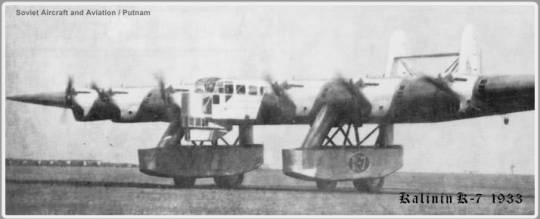
At the end of the ‘20s, Kalinin conceived a concept for a massive 120-person airliner, beginning work on it as the K-7. The concept quickly caught the attention of the VVS, so work on a bomber variant soon followed. The massive projected payload of the K-7 was to be far from its only distinguishing feature. The design consisted of a thick 53 meter elliptical wing in which most of the payload and crew would be carried with a twin-boom tail extending to the rear and seven AM-34F engines (six on the leading edge, one on the trailing edge) were to power it. Instead of conventional landing gear, two large pods extended under either wing, each carrying three wheels. As a bomber, these pods also accommodated two gunners. Total firepower as a bomber amounted to eight 20mm cannon and eight machineguns across 12 positions laid out such that every angle was covered by at least three guns. Payload was also heavy, with space for up to 6,000kg of bombs provided. The K-7 would first fly in August 1933, but testing was put on hold after the first flight revealed dangerous stability and vibration issues. This was “solved” by shortening and strengthening the tail, but the vibrational issues persisted, ultimately causing the crash of the prototype on its seventh test flight. Though two more prototypes had been ordered, the project was cancelled in 1935 before they could be completed.
Tupolev ANT-26/TB-6
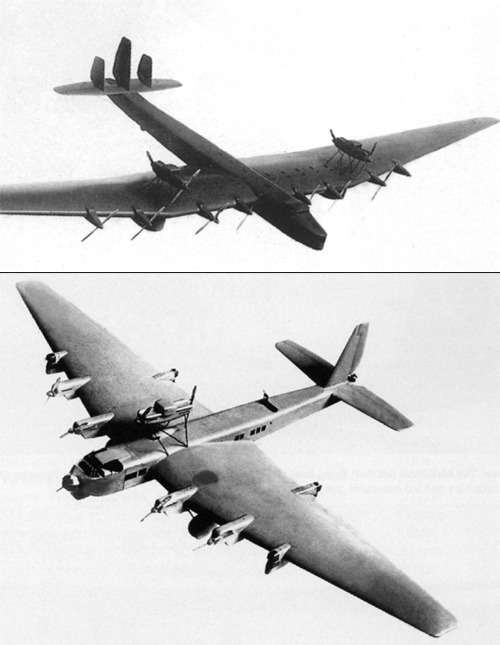
Even the absurdly large TB-4 apparently wasn’t enough for Tupolev’s engineers. Soon after design work began on the TB-4, an even larger bomber would begin development. Planned to be called the TB-6, the aircraft would be powered by twelve AM-34 engines producing 1,200hp each. Four engines were to be mounted in either wing, while the remaining engines were to be carried above the fuselage in push-pull nacelles. Taking everything from the TB-4 to the extreme, the TB-6 would have a gross weight of 70 metric tons and wingspan of 95 meters, making it one of the largest aircraft in the world even by today’s standards. Normal payload would dwarf anything else then flying - 15 tonnes - while external racks could boost that to almost 25 tonnes in overload. Of course, the TB-6 would be slow like its predecessors, but it was hoped that a heavy defensive armament of one 37mm cannon, four 20mm ShVAK, and five machineguns could adequately protect the bomber. And of course, this behemoth would not be complete without a fittingly impractically large crew of 17. A scale model glider prototype with a wingspan of 20m was flown to validate the design, and in October 1932 construction of the prototype began. However, work proceeded slowly, and, after the VVS found even the smaller TB-4 to be impractical, the decision was made to abandon the TB-6 as well.
Tupolev ANT-22/MK-1
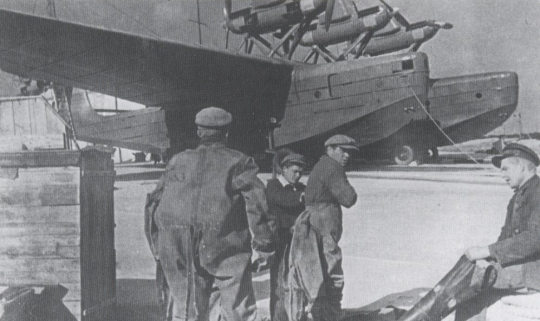
In the latter half of the 1920s, the Soviet Navy gained interest in a long-range heavy bomber flying boat. After some preliminary work in the preceding decade, the Tupolev OKB was issued full requirements in mid 1931 for a flying boat bomber with a top speed of 300km/h, operational radius of 1,000kg, and a payload of six metric tons. Preliminary studies found that a single large hull would cause too much drag, so Tupolev instead created an unusual twin-boom double hull design. Designated the ANT-22, the twin-hulled machine would be powered by six engines in three push-pull nacelles above the wing, and payload would be carried in the wing center section that connected the two hulls. Construction began as early as September 1933, but issues procuring engines meant the ANT-22 wouldn’t fly until August 1934. While handling and stability proved satisfactory in state tests, it failed to meet the state’s performance requirements. Tupolev made several changes to reduce weight and drag to address the performance issues, but in the end it failed to meet requirements and was abandoned.
Tupolev ANT-36/DB-1

The success of the ANT-25 prompted the VVS to issue a requirement for a bomber developed from the design. Tupolev responded with the ANT-36, a minimal-change derivative of the ANT-25 with a crew of three and payload of 1,000kg of bombs. The ANT-36 took flight in 1934, but state tests of the type - now called the DB-1 - didn’t begin until the second half of the next year. Before state tests even started, Tupolev began production, assuming the type would enter service. However, tests revealed numerous manufacturing issues, and the type was rejected. In the end, only 18 DB-1s were built. Ten entered regimental service, but saw little use before being retired in 1937. The others saw use as test aircraft until 1938, when the last were withdrawn from service.
Tupolev ANT-40/SB
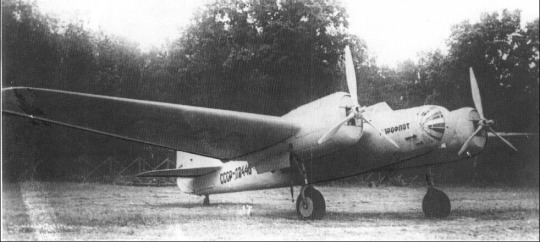
Although early VVS bomber doctrine emphasized heavy payload and armament over performance, by the early years of the 30’s this focus had radically shifted. The VVS issued requirements to Tupolev for a bomber fast enough to evade enemy fighters, so Tupolev’s engineering teams went to work. The resulting ANT-40 was a far cry from previous Tupolev bombers - it was small, sleek and fast. Powered by two Hispano-Suiza 12 engines, the bomber could carry 600kg of bombs in an internal bay. While it was hoped that the bomber’s speed would protect it, it was not entirely defenseless - it carried a single ShKAS in dorsal and ventral positions and two ShKAS in the glazed nose. The first prototype - powered by Wright Cylones - would take flight in October 1934, but the lighter engines of this aircraft would be outpaced by the Hispano-Suiza powered prototype that flew that December. Though crashes would delay official acceptance tests, the bomber was promising enough that production plans proceeded before the completion of state trials.

The SB’s combat debut would come remarkably early in its career. Not long after the type had entered VVS service, the SB became one of the first aircraft shipped to Spain to support the Republicans. Their first sorties came that October, and they quickly established a reputation for excellence. The SBs (flown by Soviet “volunteers”) easily outpaced the biplane fighters of the Nationalists. Unfortunately, the SB’s reign was brief - the arrival of the Bf 109 in Spain meant the bomber was no longer able to outrun its adversaries, and crews quickly found that its modest armament was wholly inadequate to fend off fighters. Losses skyrocketed, and, although additional deliveries would allow the SB to keep flying until the end of the war, 40 SBs would be lost to enemy action by the March 1939. The 19 survivors were taken into service by the Nationalists, but they suffered from poor serviceability and saw little use.
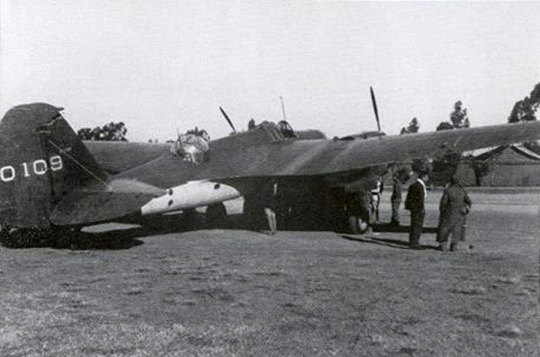
China would be the next theater to see SBs flying over it. As part of the Sino-Soviet nonaggression pact, SBs would be flown by Soviet volunteers in support of Nationalist China. The first deliveries came in the second half of 1937, and the SBs would be put to use across 1938 making strikes on Japanese shipping on the Yangtze. The battle for Wuhan saw the SBs suffer heavy losses to Japanese fighters, forcing a withdrawal from combat. As Soviet crews switched over to the DB-3 in 1939, SBs were transferred to the Nationalist Air Force. Unfortunately, the Chinese put the bombers to little use. The Battle of Khalkhin Gol in 1939 would cement the failure of the driving doctrine behind the SB - it was too slow and underarmed to be safe from enemy fighters at altitudes where it could accurately bomb, and its payload was too small and bombsights inadequate to effectively bomb from safer altitudes.
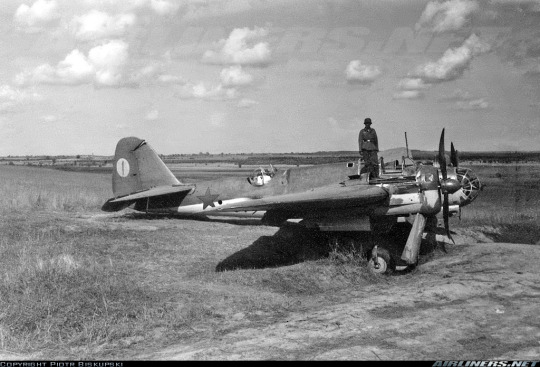
The Winter War would only serve to reinforce what had been learned over Mongolia - the SB was past its prime. In just 15 weeks of war, over 100 SBs were lost. Although plans were made in the following years to replace the SB with more modern types, 94% of the Soviet frontline bomber force in June 1941 consisted of SBs. Those that survived the initial carnage of the invasion fared poorly - after several days of heavy losses, surviving SBs were relegated to night bombing. They continued to see heavy use as night bombers through the end of 1941, but by then few SBs remained in operational service. Now practically useless for combat roles, the few surviving SBs were related to secondary roles for the remainder of the war
Bolkhovitinov DB-A
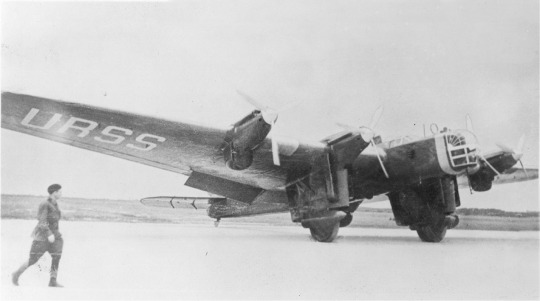
In 1933, a project began to modernize the TB-3 to keep it competitive. As Tupolev was busy pursuing an entirely new heavy bomber project - the ANT-42 - the project was handed off to a design team under Bolkhovitinov. Designated the DB-A, the new bomber retained the general lines of the TB-3, but was considerably refined. The corrugated surfaces of the TB-3 were smoothed out, and the open cockpits and gunner positions were all enclosed. To simplify development, the majority of the landing gear struts were just faired over, with the wheels retracting just a short distance into long “pants” that extended down from the inboard engine nacelles. The large spaces behind the engine nacelles provided space for an unusual gunner position - a gunner sat behind either wheel well. Either nacelle held two ShKAS, while nose and tail positions held a further ShKAS and a dorsal turret was fitted with a ShVAK cannon. A larger internal bomb bay provided space for 5 tons of bombs (compared to the TB-3’s 2 tons), and, to top it all off, the engines were upgraded to the 1,000hp-class M-34.
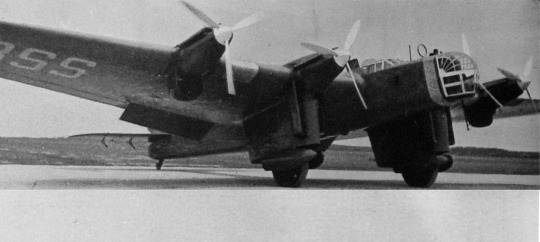
The DB-A would first fly in May 1935, immediately beginning acceptance tests. Performance was generally good, with the DB-A proving about 50km/hr faster than the TB-3. Over the course of the next couple of years, the DB-A would serve as a propaganda piece, setting various load-to-altitude records, culminating in a trans-arctic flight from Moscow to the US. Unfortunately, the rushed modifications made to support this flight meant that it would suffer an engine failure in flight. The crew reported the failure, but it would be the last they were ever heard from - the DB-A was lost in the flight. A second prototype, completed in March 1936, allowed testing to be completed, and in late 1937, an order for 16 aircraft was placed. Production went slowly, and in 1940, with only 12 DB-As delivered, the order was cancelled as the TB-7/Pe-8 was proving more promising.
Tupolev ANT-37/DB-2
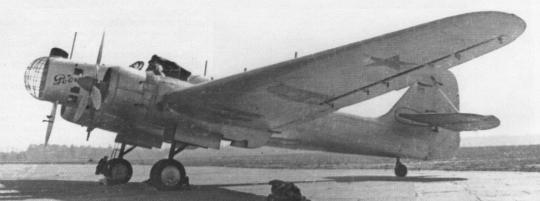
Although the DB-1 was a failure, it would not mark the last attempt to militarize the ANT-25. Work began on an improved derivative of the ANT-25 in 1934, aiming for a more radical redesign than the DB-1. The DB-2 that took shape was a twin-engined bomber with a new glazed nose and redesigned tailfin. Testing began in June 1935, but the DB-2 prototype’s career was short - it crashed just a month after its first flight. After fixing the issues that led to the crash, the type was submitted for state trials, only to be rejected in favor of Ilyushin’s DB-3 owing to excessive flutter. Having failed to gain a production order, Tupolev would construct two more DB-2s stripped of military equipment for record-setting flights.
Ilyushin DB-3
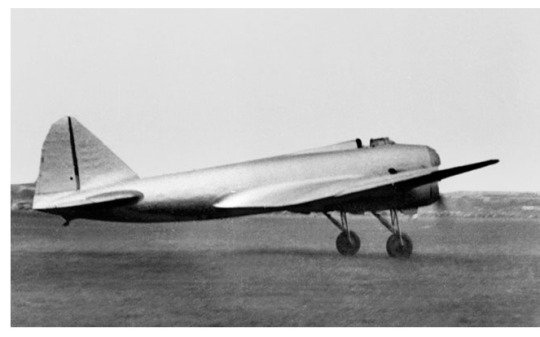
In the early ‘30s, Ilyushin began work on a new bomber to compete with Tupolev’s DB-2. As a demonstrator for his proposed DB-3, Ilyushin hastily threw together a prototype, designated the TsKB-26. The TsKB-26 was a low-winged twin-engine monoplane with many of the features that would be seen on the final design, including a streamlined oval cross-section fuselage and retractable landing gear. To speed production, however, Ilyushin took the open cockpit from the failed TsKB-12 fighter and left out critical features like defensive turrets and a bomb bay. Taking flight in the summer of 1935, the TsKB-26 proved surprisingly good despite its crude construction. The wooden airframe was quite strong, and the TsKB-26 proved to be fast, maneuverable, and easy to fly. In fact, the TsJKB-26 was so promising that a refined all-metal prototype was ordered as the TsKB-30. Trials went well, and in mid 1936 the type was ordered into production as the DB-3.
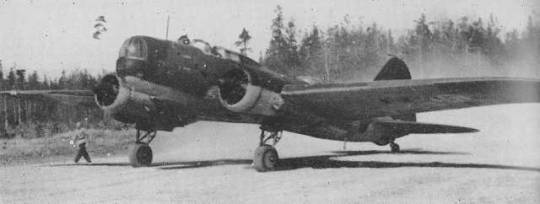
The production DB-3 would feature several refinements from the prototypes. The top-mounted cockpit was now enclosed, and defensive armament was added in the shape of a dorsal and nose turret and a ventral position, all fitted with a single ShKAS machinegun. A bomb bay was added with space for up to ten 100kg bombs, while external racks from the prototypes remained to provide space for 500 or 1000kg bombs, giving a total overload payload of 2500kg. Though armament was light in retrospect, the DB-3 was otherwise a quite capable platform. The VVS was enthusiastically adopting the type, while Soviet Naval Aviation had procured their own variant in the form of the torpedo-carrying DB-3T.
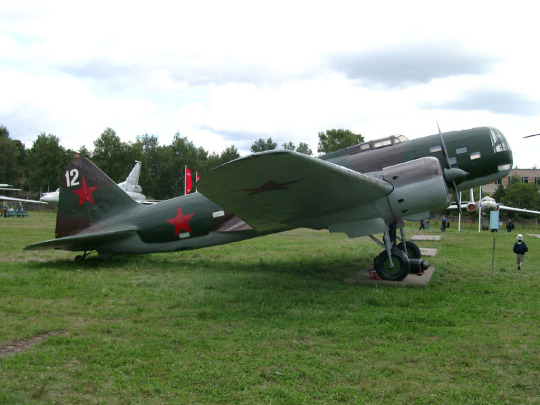
Through the end of the ‘30s, Ilyushin progressively improved upon the DB-3 design, ultimately leading to the substantially improved DB-3F/Il-4 taking over production. Oddly enough, the DB-3 would make its combat debut in foreign hands, with 30 DB-3s supplied to the Republic of China in 1939 to aid in their war against Japan. Thew operated from Sichuan, striking deep into enemy territory on several raids before finally being replaced by B-24s in 1943. The Soviet combat debut would come over Finland, where they supported the poorly-executed invasion of Karelia. A significant number of DB-3s were still in frontline service at the outbreak of war in 1941, and many would see combat in some form. In August 1941, 15 DB-3Ts from the Baltic Fleet would be the first Soviet aircraft to bomb Berlin. Ultimately, however, it seems that the DB-3 was phased out of service in favor of the Il-4 soon after the outbreak of war.
Tupolev ANT-41/T-1
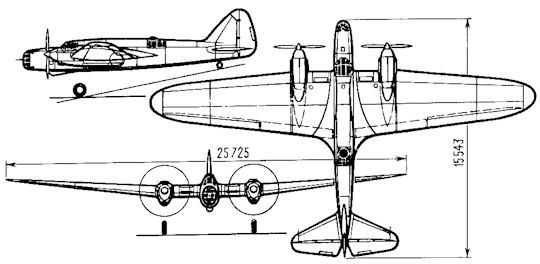
In early 1934, Tupolev was asked to develop a multirole aircraft for the Soviet Navy. Under the designation ANT-41, the OKB began a project similar to the SB. To meet payload requirements, the aircraft was significantly larger than the SB, allowing for a fuselage wide enough to carry two torpedoes side-by-side in an internal bomb bay. Two AM-34 engines cooled by radiators in the inboard section of the wing were to power the aircraft, while a crew of four would man two 12.7mm machineguns and a ShVAK cannon for defense. Both landplane and seaplane variants were envisioned, though the prototype would be a landplane. The ANT-41 would take flight in June 1936, encountering severe tail flutter on its maiden flight. Flutter issues continued until the 14th flight of the aircraft, when the issues caused a wing failure. Before Tupolev could construct another prototype, Soviet Naval Aviation selected the competing DB-3 to meet their requirements.
Tupolev ANT-42/Petlyakov TB-7/Pe-8

Russia’s only true modern heavy bomber in WW2 could trace its origins back to 1934, when Tupolev was issued requirements for a replacement for the TB-3 with a payload of 2,000kg, operational radius of 4,500km, and cruise speed of 440km/h - effectively doubling the performance of the TB-3. Tupolev assigned the project - designated ANT-42 - to Petlyakov’s design team. The aircraft that took flight at the end of 1936 would considerably diverge from earlier Tupolev bombers - it was a sleek four-engined bomber bristling with guns and powered by four AM-34 engines. An internal bomb bay could carry up to 4,000kg of stores, while external racks could hold two more FAB-500 500kg bombs. Defensive armament consisted of a ShKAS in dorsal and ventral positions and a ShVAK cannon in tail, nose, engine nacelle positions (a gunner sat in the rear of each inboard engine nacelle). Things seemed promising at first - state trials began in mid 1937, and the TB-7 seemed set to enter production. However, the arrest of Tupolev and Petlyakov in October 1937 stalled the program, meaning the second prototype wouldn’t fly until mid 1938.
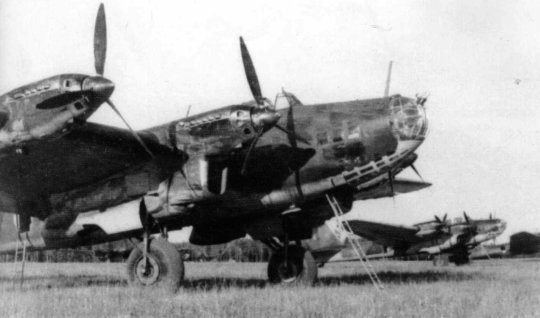
Although the TB-7 would eventually complete trials and be ordered into production - it ran into new problems. There was great difficulty procuring superchargers for the AM-34 engines, and soon enough the engines themselves became scarce. Desperate for a replacement engine, the AM-35 was selected as a new powerplant, but the factories would soon find that the powerplant was prioritised to tactical bombers, meaning the shortages continued. Thus, when Barbarossa began in June 1941 only a single squadron was flying the TB-7, and none of its nine aircraft were operational. At the end of June the squadron was reformed as a regiment to make long-range strikes into German territory to boost morale. Unfortunately, their first mission - bombing Berlin from Leningrad - caused little damaged. Only four of the eight bombers set out actually reached the target, and only two of those made it back to base.

Operations through the end of the year remained sporadic and ineffective. One aircraft served as a transport for Foreign Minister Molotov on his trip to America, while operational numbers remained painfully low at the front. With the death of Petlyakov in January 1942, the TB-7 was renamed the Pe-8 in his honor. However, production difficulties still plagued the program. Only in late 1942, when the Shvetsov ASh-82 was fitted to the type, did engine shortages finally end. Ineffective long-range sorties against the enemy homeland gradually gave way to shorter-range missions at local strategic targets like supply depots and transportation hubs. Even so, low operational numbers meant that they had little impact where they were used. While VVS records show the Pe-8 remaining in service through the end of the war, the sole unit flying them would re-equip to fly Lend-Lease B-25s in early 1944. Though the bomber remained on the roster, no units flew the aircraft as their primary type by the end of the war.
Ilyushin DB-3F/Il-4 “Bob”
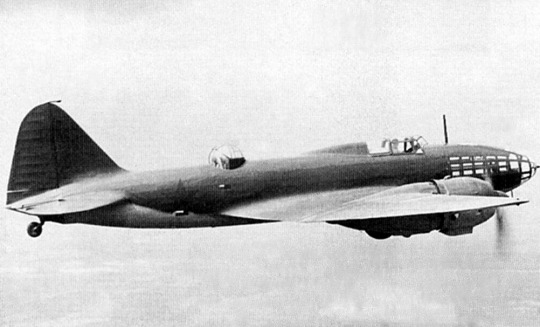
In 1938, Ilyushin began a substantial reworking of the DB-3 design. Taking flight in May 1939, the DB-3F, as it was known, most notably featured a new streamlined nose. Less noticeable was the new larger wing, simplified landing gear, and improved gun mounts. Overall, the structure, hydraulics, and fuel system were also simplified and refined to streamline production. Given the popularity of the DB-3, the enthusiasm over the DB-3F was not too surprising. The type was ordered into production before the first prototype had even flown, and production would begin in 1939 with one final change - the M87 radials were replaced with the more powerful M-88.

The DB-3F would slowly come to replace the DB-3 in Soviet long-range bomber units, eventually taking on the designation Il-4. As the long-range bomber units were well behind the forward military districts, the Il-4 fleet largely survived the opening stages of Barbarossa. Though the Baltic Fleet’s DB-3Ts would be the first bombers to fly over Berlin, VVS Il-4s would take over the operations soon after. Unfortunately, these raids were small and ineffective, and, as the war situation got desperate, they were ceased to allow resources to concentrate on more pressing needs. Il-4 production was interrupted at the end of 1941 as factories relocated, and, when production resumed, Ilyushin had made more refinements to the design, adding armor, more powerful defensive armament, and wooden sections of the structure to reduce the need for strategic materials.

Though the mediocre performance of the Il-4 meant that it was obsolete by the middle of the war, it remained the backbone of Soviet long-range aviation until the war came to an end. Armament and protection for the crew remained a glaring deficiency through the entire course of the war, but the Il-4’s long range, high payload, and, most critically, unparalleled ease of production meant that it would remain the primary platform for long-range bomber units. Soviet Naval Aviation also adopted the type as a torpedo bomber, putting it to great use in campaigns in the Black Sea and Baltic. Meanwhile, the Il-4s of the VVS proved surprisingly capable, performing long-range strikes on local strategic targets. Though they grew increasingly vulnerable as the war went on, the dwindling numbers of Luftwaffe fighters were increasingly concerned with fending off the tactical aircraft closer to the front, leaving the Il-4s undisturbed.
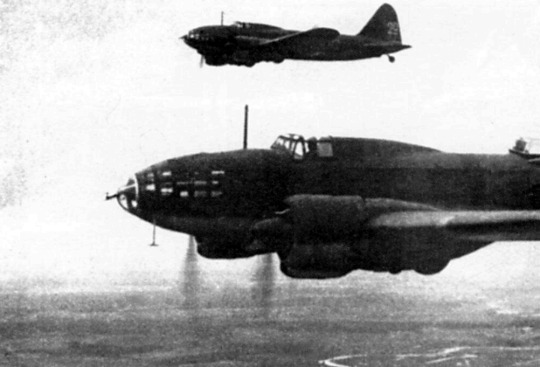
Production of the Il-4 continued until sometime in 1944. Some 5,000 Il-4s of all types were built, dwarfing the 1,500 DB-3s before it. It remained in service postwar just long enough to receive a NATO reporting name (“Bob”), but postwar service was very brief. Though its service was distinguished in the Second World War, the onset of jet aircraft meant it was now glaringly obsolete and unacceptably vulnerable. More capable heavy bombers like the Tu-4 would come along to replace it, and, soon after the war ended, the Il-4 was among the obsolete types phased out of service.
Belyayev DB-LK

Around the end of the ‘30s, Viktor Belyayev began work on a long-ranged bomber based off of his flying wing experiments. Though the resulting aircraft wasn’t technically a flying wing, it was far from conventional. The DB-LK, as it was designated, was a unique design with two fuselages, each of which held an M-88 radial and two crewmen. These were connected by a large center wing section that held a tailplane. Outboard of the fuselages, the heavily tapered wing had a 5 degree forward sweep. Armament consisted of two ShKAS in either tailcone for defense and two forward firing ShKAS mounted in the center wing section. Testing began at the end of 1939 with high-speed taxi tests. During one of these tests, the undercarriage collapsed, delaying the DB-LK’s first flight until early 1940. Testing generally went well and performance was found to be good, but the DB-LK was too sensitive to changes in the center of gravity, so no production order would ever be received.
Yermolayev Yer-2
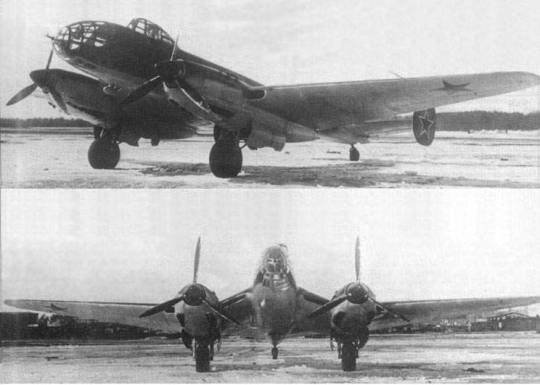
In 1938, Roberto Bartini had developed the Stal-7 airliner, which proved to have quite impressive performance and payload capacity. However, the crash of the prototype in early on in testing led to Bartini’s imprisonment, so the project was handed off to Vladimir Yermolayev, who was tasked with developing the Stal-7 into a long-range bomber. As work began on the bomber, the Stal-7 was repaired, allowing it to continue testing and even perform a record-breaking nonstop flight of over 5,000km. The bomber conversion of the airliner, given the internal designation DB-240, ended up retaining little from the Stal-7 apart from its inverted gull-wing layout. An extensively glazed nose was given a single ShKAS gun, while the high-mounted cockpit was offset to the port to give the pilot a better downward view. Below and to the right of the pilot was a radioman’s position, and aft of the wing a retractable dorsal turret with a UBT machinegun and a ventral ShKAS were added. To improve the gunner’s field of fire, a split tail was used. An internal bomb bay provided space for up to 2,000kg of bombs, while racks allowed two more FAB-500s to be carried externally.
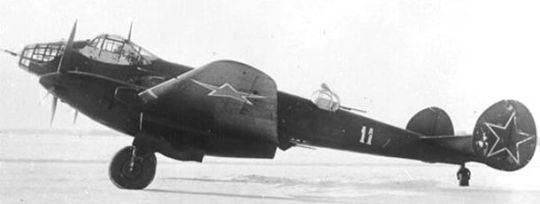
The DB-240 prototype would fly in May 1940, substituting the originally planned M-106 engines with the less powerful M-105s. Though trials found a variety of issues, ranging from lower than expected performance to poor defensive armament, the unparalleled payload and range of the type allowed it be ordered into production as the Yer-2. Production began in March 1941, and by the outbreak of war 50 had been produced, flying with two air regiments created soon after the war began. On August 10, they accompanied Pe-8s on a raid on Berlin. Only two would actually manage to bomb Berlin, and of those, one was shot down on the return flight by friendly fighters. Further long-range raids targeted Konigsberg, but the raids were too small to have any significant impact, even if the bombs ever landed anywhere important.
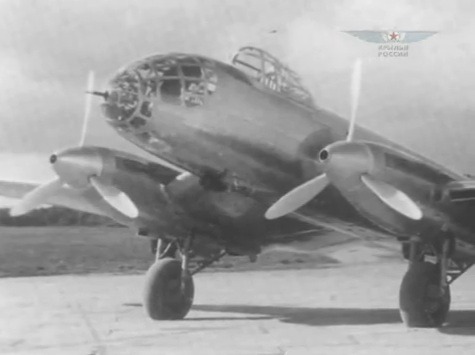
Unfortunately, Yer-2 production had terminated in August 1941 with 128 examples produced, as the Il-2 was given priority. By October 1941, only 34 Yer-2s were operational, and losses - both to the enemy and accidents - were unsustainably high. Losses remained high over the coming months, with the situation exacerbated by the deployment of the type as a low-level tactical bomber over Moscow. Only 10 remained operational by August 1942, but they would see one final brief deployment to Stalingrad before being withdrawn. Survivors persisted in service until August 1943, at which point they were sent off to training units.
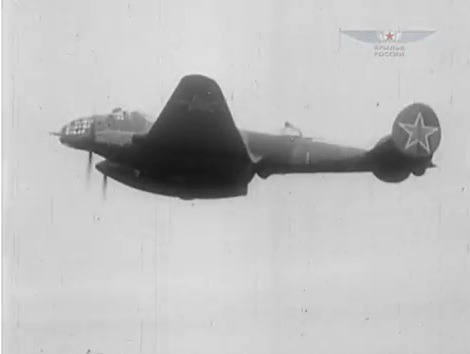
The Yer-2 returned to production at the end of 1943, finally reaching combat units in June of the next year. Operational numbers steadily rose, with 42 serviceable in January 1945 and 101 by the end of the war. The first combat missions, however would have to wait until April 1945, when the Yer-2 was committed to the assault on Konigsberg. Ultimately, the Yer-2 never really got used to its full potential. It remained in operational service after the end of the war, but by the end of the decade it was replaced by the Tu-4. Though it remained in service postwar, it never received a NATO reporting name.
Arkhangelsky Ar-2
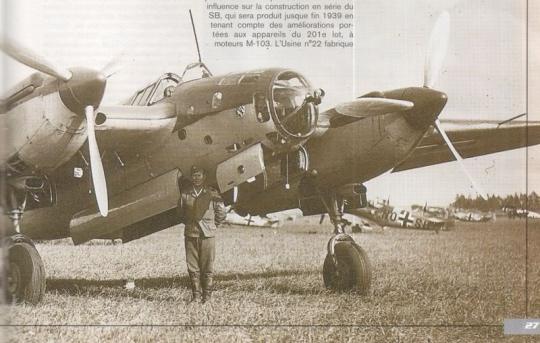
After the arrest of Tupolev, the OKB was handed off to his lieutenant Arkhangelsky, who immediately went to work modernizing the SB. Two SBs were modified to the SB-MMN standard, which gave the bomber a new, streamlined nose, various aerodynamic refinements, and the new M-105 engine. In addition, the outer wing sections were refined, and various changes were made to streamline production. The SB-MMN proved incapable of meeting requirements, but Arkhangelsky pushed ahead, adding dive-bombing to the requirements. A new design - the SB-RK - took shape. The SB-RK carried over many of the changes from the SB-MMN, but it further refined aerodynamics, changed the wings once more, and added dive brakes a special bomb release to facilitate dive bombing. Tests began in October 1940, finding engine cooling and longitudinal stability issues, but nevertheless the design was passed on to the VVS for state tests.
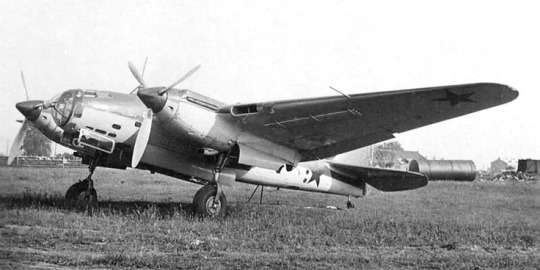
Despite early issues, the SB-RK performed well in tests. It fell short of the expected top speed, but it was a capable dive bomber and it was a significant improvement in almost every aspect over the SB. It was ordered into production as the Ar-2, with production beginning at the end of the year. Unfortunately, the production run was brief - the Ar-2 was soon eclipsed by the Pe-2 and Tu-2 prototypes, so, with only 190 examples built, production was halted to speed Pe-2 production. The 190 Ar-2s were passed on to SB units, flying alongside their older cousins. At least half of the Ar-2 fleet would be destroyed in the opening days of Operation Barbarossa, and very quickly they were shifted to secondary duties. A number remained in service into 1943, but they would never see any significant combat use.
Petlyakov Pe-2 “Buck”
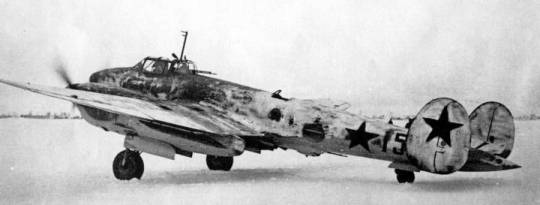
Petlyakov’s famous Pe-2 medium bomber had its origins in a 1939 heavy fighter project designated the VI-100. Developed by Petlyakov’s design team in the Gulags, the VI-100 was a heavily armed twin-engined aircraft making use of advanced features such as an onboard electrical system and cabin pressurization. Though it proved promising when it took flight at the end of 1939, the invasion of France in June 1940 spurred authorities to demand the aircraft be adapted as a dive-bomber. In just a month and a half, Petlyakov reworked the design as the PB-100. The general design and features like the electrical system were retained, but the heavy forward armament was replaced with a glazed nose and the turbochargers and pressurized cabin were removed. Dive brakes were added to facilitated dive bombing, and two ShKAS machineguns were placed in the nose. A bombsight was added, allowing the PB-100 to perform both level bombing and dive bombing. Three bomb bays were placed in the aircraft - one in the fuselage and one behind either engine. Total payload capacity was 1,000kg, though typical payloads were just 600kg.

The PB-100 had been ordered into production without a prototype, but the ambitious production schedule proved impossible to meet. The PB-100 would only take flight for the first time at the end of 1940, gaining the service designation of Pe-2 as Petlyakov had since been rehabilitated. The first five production Pe-2s would be very crudely built, but nevertheless they served as prototypes for state acceptance tests. The Pe-2 carried over some of the unfavorable characteristics of the VI-100, including high landing speeds and poor stall characteristics, but it made up for that with its incredible performance, being faster than many fighters while still being a capable and rugged bomber. The Pe-2 was rushed into production, and by the spring of 1941 the first frontline units were receiving the type.
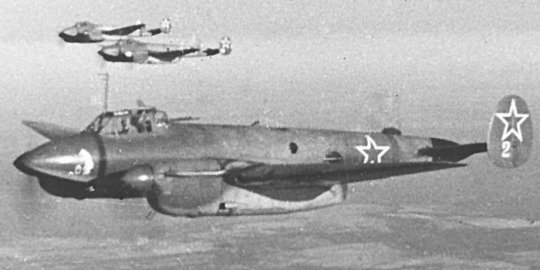
Though the Pe-2 was not immune to the destruction wrought on the VVS in the opening weeks of Barbarossa, it did manage to distinguish itself from the start. Luftwaffe fighters soon found that the Pe-2 was a difficult opponent to catch, and, while bombing sorties may have been unable to reverse the course of events on the ground, the Pe-2 was proving capable in every role it was pressed into, be it night fighting, bombing, or reconnaissance. It fell into a comfortable middle ground between the Il-4s of long-range bomber forces and the Il-2s of the Shturmovik units, and soon enough units began to standardize around the type. By 1942, the Pe-2 had become the primary medium bomber of the VVS.
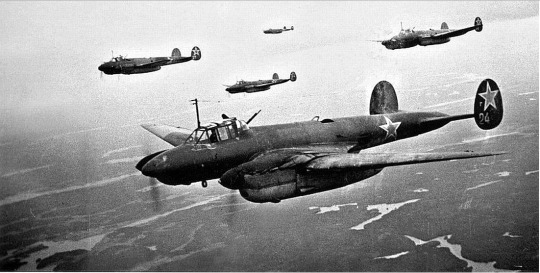
Though the Pe-2 was a quite capable platform, it never enjoyed the complete domination of its field as the Il-2 and Il-4 did. The need for bombers of its class outstripped production, so the Pe-2 was often serving alongside Lend-Lease bombers like the A-20 and B-25 and the more modern Tu-2. The Pe-2 remained a ubiquitous feature on the front through the end of the war, with Petlyakov’s team continually refining the design to keep it competitive. Postwar, the Pe-2 was largely handed off to new satellite states, namely bulgaria, China, Czechoslovakia, Hungary, Poland, and Yugoslavia. They did seem to enjoy quite a bit of use postwar, with the last examples leaving service in 1954,, but the Soviets seemed fairly quick to retire it, as the Pe-2 had been eclipsed by the newest generation of jet bombers.
Arkhangelsky SBB
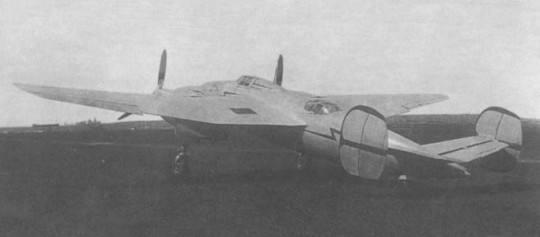
Parallel to the SB-RK/Ar-2, Arkhangelsky was working on an even more tactically-oriented SB derivative designated SBB. The SBB would improve upon the Ar-2 further by refining aerodynamics once more, fully enclosing the gunner’s position, and eliminating the ventral gun. A new twin-tail was designed to improve the gunner’s field of fire, while a retractable tailwheel was to further reduce drag. Wing area was decreased, as was loaded weight and payload. The SBB prototype was completed in late 1940, with the first flight coming in early 1941. Factory trials began in March, but they wouldn’t be completed until July, by which point was had already broken out. Arkhangelsky hoped for the SBB to compete with the Pe-2, and in fact it did have some favorable characteristics, particularly in terms of climb rate and takeoff and landing performance. However, the Pe-2 was good enough, and more importantly, already in production. With the war getting increasingly desperate as the days passed, there were few resources to commit to a redundant project, so the SBB was abandoned.
Tupolev ANT-58/Tu-2 “Bat”
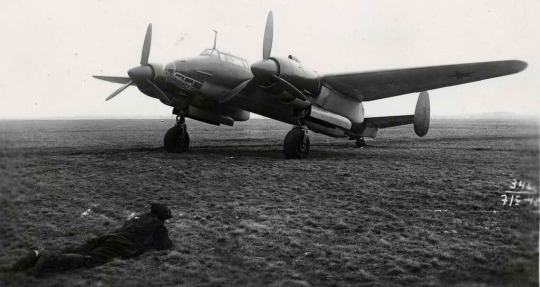
In 1938, Tupolev and his team of engineers in prison were ordered to develop a replacement for the aging SB. Requirements called for something vaguely similar to the SB - a high-speed twin-engined platform capable of outrunning enemy fighters. In addition to the fast-bomber requirements, the new bomber also had to be capable of medium-angle dive bombing. Tupolev developed a clean mid-winged bomber designated the ANT-58, which, after being inspected by the state, received an order for a prototype. The ANT-58 would fly in early 1941, quickly demonstrating spectacular performance. The second prototype (ANT-59) would fly in May, mounting more reliable M-82 radials (rather than the AM-37s of the ANT-58). However, the outbreak of war stalled development - the third prototype didn’t fly until December 1941, and combat evaluations of pre-production aircraft didn’t occur until September 1942. Fortunately, evaluations went well, and the type was rushed into production as the Tu-2.
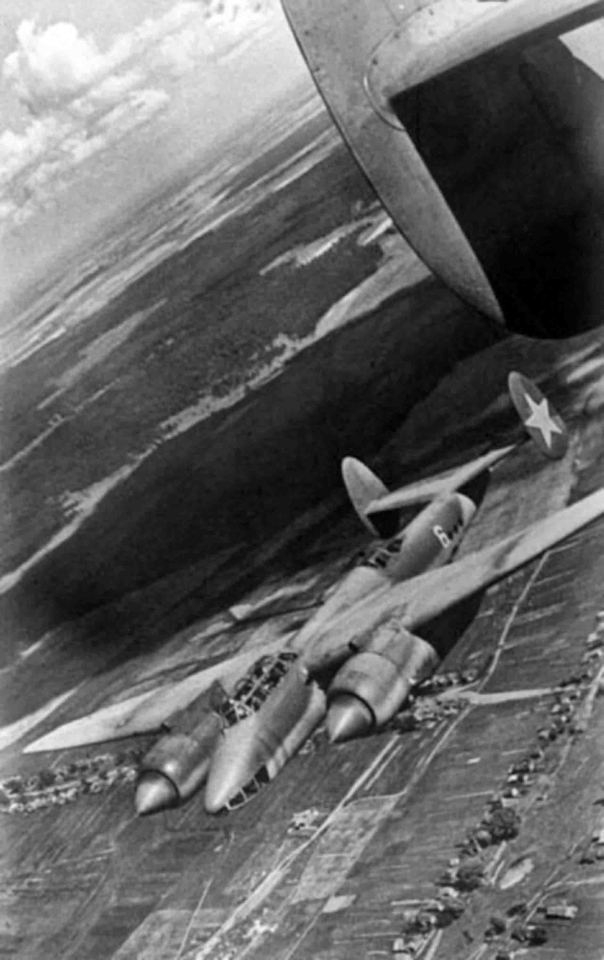
Due to the priority given to production of Pe-2s, the Tu-2 didn’t reach frontline units until early 1944. In fact, production was even halted for some time until it became apparent that the smaller Pe-2 was lacking in range and payload. Although the Tu-2’s operational debut came incredibly late, it would be tremendously successful. It handled like a fighter despite its size, and it was tremendously durable. Its longer range and higher payload than the Pe-2 allowed for greater battlefield utility, and its forward-firing armament of two 20mm cannon meant it could even perform the odd strafing run better than its predecessor. They rose to prominence in the final years of the war, seeing heavy use over fortified cities such as Konigsberg and Kustrin. After Germany fell, Tu-2s participated in the brief Manchurian campaign. In all, 1,111 Tu-2s were built during the Second World War.

Tu-2 production and service continued in the immediate postwar period. In Soviet service, the type soldiered on in frontline service for a few years before jet bombers came along to replace them. However, the platform was used as the basis for countless tests and variants, ranging from simple re-enginings to full-fledged fighter, reconnaissance, and night-fighter variants. The Tu-2 would also see extensive export across Eastern Europe and Asia. Tu-2s were supplied to newly “liberated” nations in Europe to bolster air forces ravaged by years of war, while China and North Korea would also receive examples that served well into the 1950s. Chinese and Korean Tu-2s would actually see limited combat use in the Korean War, although UN air superiority hindered the effectiveness of such missions. Production would cease in 1948, with a total of 2,257 Tu-2s of all types constructed. Though it left Soviet service relatively quickly, foreign operators retained the types for some time - Polish Tu-2s remained in service into the 60’s, and the PLAAF was still flying Tu-2s (probably and hopefully trainer variants) up until 1982.
Douglas A-20/DB-7 Boston “Box”

The most numerous foreign bomber to serve in the VVS during the Second World War would be Dogulas’ DB-7. Deliveries began sometime in early 1942, with the aircraft arriving through the Alaska-Siberia air-ferry. Initial deliveries were of the A-20C variant, which featured a conventional glazed nose with a bombardier and four forward firing .30-caliber Browning machineguns. These were rushed into service by the middle of the year, and soon enough the VVS was proving an enthusiastic user of the type. Minor modifications were made, primarily replacing the slower-firing Browning machineguns with the domestic ShKAS. The Bostons performed much like the Pe-2s that the Soviets loved, with excellent performance and handling, while the far better crew ergonomics and radios made them a popular piece of equipment.
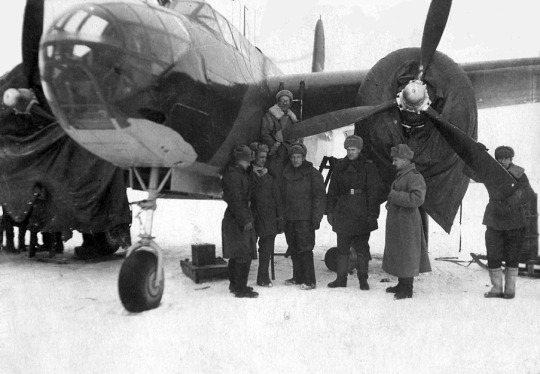
Over the course of the war, four variants of the Boston would be delivered to the Soviets - the A-20B, C, G, and H. The variants were largely the same, but the later series deliveries featured a solid nose fitted with machineguns rather than a bombardier's position. Many found their way into the hands of the Soviet Navy, where they excelled as torpedo bombers. With the VVS, the Bostons generally flew in the same types of units as the Pe-2, although on occasion they were attached to long-range bomber aviation. Meanwhile, those of the Soviet Navy were primarily used in blockade operations, such as those at Sevastopol in 1944 and Konigsberg in 1945. By the end of the war, the Soviets had received 3,414 Bostons, of which 2,771 made their way into the hands of the VVS, while the remainder likely were operated by the Soviet Navy. It was the most numerous bomber to be received under Lend-Lease, and in fact was the second most delivered Lend Lease aircraft of the war after the Bell P-39.
North American B-25 Mitchell “Bank”

The next most numerous bomber to be delivered under Lend-Lease would be the North American B-25. B-25B, D, G, and J series bombers would be delivered to the VVS via the Alaska-Siberia ferry route, but such deliveries were far less frequent than the A-20. Making its combat debut over Stalingrad, B-25 units gradually increased in size and number over the course of the war. Initial teething issues were found, particularly related to poor suitability for cold-weather operations, but officials were quite happy to find that they could often request minor changes to the aircraft and receive new-built bombers under Lend-Lease meeting the new requirements in a matter of months.
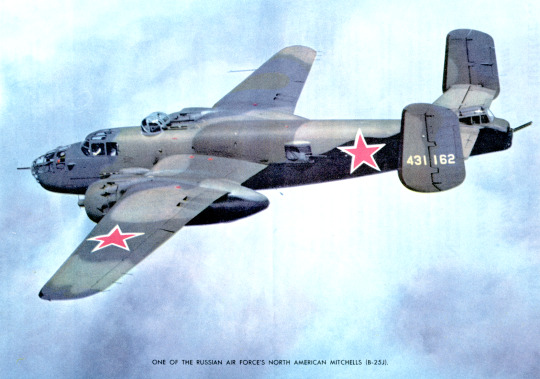
In service, the B-25 proved less agile than the A-20s and Pe-2s of the VVS Frontal Aviation, but they were nevertheless generally capable enough to serve with both regular bomber units as well as long-range aviation. Though by no means a heavy bomber, the B-25 seemed to be capable enough for the VVS to phase out the Pe-8s of the sole active bomber squadron and replace them with B-25s by the end of 1944. Unfortunately, details of actual combat use seem scarce, part in thanks to the tendency for the Soviets to downplay the use of all but the most popular pieces of Lend-Lease equipment. By war’s end, 861 B-25s had been delivered to Russia. Many of these remained in service in the immediate postwar period, earning the type the NATO reporting name “Bank.”
Handley Page Hampden TB.I
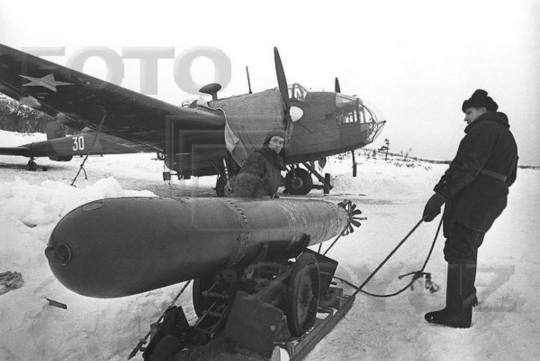
Following the disastrous losses suffered by arctic convoy PQ 17 in mid 1942, the British decided to ferry a force of aircraft to protect their ships as they approached Murmansk..The RAF decided to ferry two squadrons of Hampden torpedo bombers to operate out of Murmansk and provide cover for arctic convoys from Axis surface shipping, particularly the battleship Tirpitz. 32 Hampdens from 144 and 455 Squadron flew from the Shetland Islands to Vaenga near Murmansk, losing nine of their number en-route. The bombers began operations just in time to provide cover for PQ 18, though, as torpedo bombers, they accomplished little. PQ 18 would still lost 13 of their number, but 28 ships had arrived safely, and the operation had cost the Germans three U-boats and 40 German aircraft. Following the operation, the 23 surviving Hampdens were transferred to the Soviet Navy, forming the 3rd Squadron of 24 MTAP. Details of their service are unclear, but it appears that they served at least into the next year. However, with no spares arriving through Lend-Lease and a very small number of aircraft in service, it’s unlikely that they saw any significant use by the Soviets, especially in the fairly quiet Murmansk theater.
Myasishchev DVB-102
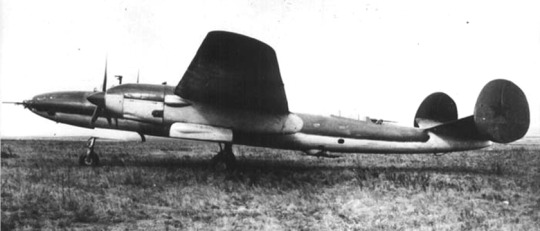
Though Myasishchev was arrested in 1938, he was sent to one of the Gulag engineering units. During his stay, he was ordered to develop a high altitude heavy bomber. Work began in 1940, with the project receiving the designation DVB-102. The aircraft that took shape was a twin-engined aircraft with the kind of layout one would expect from a high-altitude platform. The DVB-102 had large high aspect-ratio wings and a long, slender fuselage that, given the projected flight ceiling approaching 40,000ft, was likely pressurized. It featured a crew of five, and was powered by two ASh-71 radial engines. Unusually, despite being a high-altitude bomber, it had a heavy armament in the nose rather than a bombardier’s position. Two 20mm cannon and four 12.7mm machineguns were concentrated in the nose, while defensive armament was a comparatively light dorsa 20mm cannon and ventral 7.62mm machinegun. It appears that two prototypes were built and flown sometime around 1942, but the project remained on low priority throughout the war. Once the USSR got its hands on the B-29, it was decided to drop the DVB-102 in favor of copying the American bomber, as the B-29 offered similar performance, but more than double the range and payload, all while being a proven design.
Myasishchev DB-108
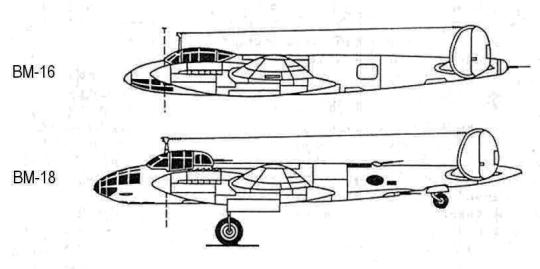
In 1944, Myasishchev was ordered to develop a long-range twin-engined bomber making use of two VK-108 engines. Specifications called for a range of 2,000km, speed of 700km/hr at 6km altitude, and a payload of 1,000kg. Myasishchev selected the Pe-2 as the base for the design, enlarging the fuselage and incorporating the VK-108 engines to create the DB-108. Three variants were proposed - the BM-16, which was to be the standard design, the BM-17 with a third crewman and dive brakes, and the BM-18, featuring a crew of four and larger bomb bay. The latter two variants were also fitted with points on the wings to attach rocket boosters to shorten takeoff rolls. The BM-16 prototype would be the first to fly, taking flight on December 30, 1944. The BM-17 followed in June 1945, and the BM-18 would be the last to fly a short time later. Ultimately, none of the DB-108 projects would complete testing. With the war coming to an end and the far more capable B-29/Tu-4 selected for production, the DB-108 project was cancelled.
Myasishchev DVB-302
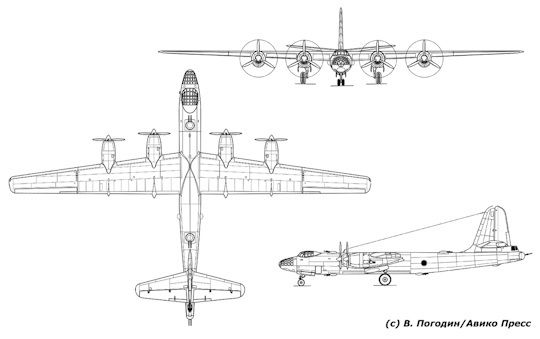
The culmination of Myasishchev’s long-range bomber work during the war would be the DVB-302. The DVB-302 was effectively a domestic analog to the B-29, designed as a four-engined, long range heavy bomber. With a long high aspect-ratio wing, remote-controlled armament, and a heavily glazed nose, the DVB-302 was vaguely reminiscent of the B-29, and in most aspects of performance it was nearly identical. The DVB-102 was projected to be significantly lighter than the B-29, while carrying a max overload payload of 16 tons and a defensive armament of 12 B-20 cannons. As the cabin was to be pressurized, the armament was to be controlled remotely in a manner similar to that of the B-29. Unfortunately, the DVB-302 would never fly. The Tu-4 was projected to offer similar performance, all while being able to enter service far quicker than the DVB-302. Thus, the DVB-302 was cancelled sometime in 1946 without ever flying.
Keldysh Bomber
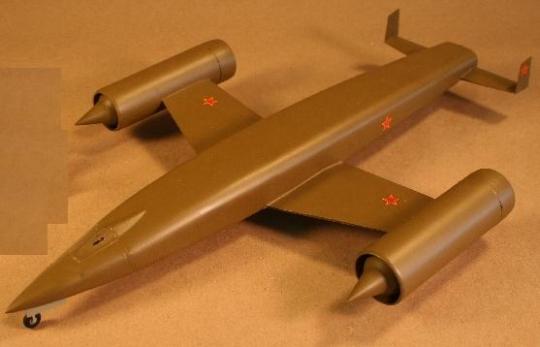
In the closing stages of WW2, Russian troops overran the German works at Peenemunde, getting their hands on, among other things, the projects of Eugen Sanger. Sanger, who was heavily involved in German rocket research, had proposed a novel new bomber concept that would use a “boost-glide” flight profile to skip along the edge of space for an intercontinental bombing run. In late 1946, a team was formed to investigate and develop the concept, led by mathematician Mstislav Keldysh. Keldysh would retain most of Sanger’s design, which incorporated a wide, flat body and a long track along which the aircraft would accelerate for takeoff. However, studies determined that the originally intended rocket powerplant would require too much fuel for the bomber to be practical. To compensate, ramjets were added to the wings. The math seemed to work out, with the bomber projected to have a 12,000km range. However, estimates also called for technology far exceeding current abilities, and it was expected that it wouldn’t be until the mid-50s that serious work could even start. Because it was expected that bomber technology would have far exceeded the project by then, the Keldysh Bomber study was concluded.
Tupolev Tu-8
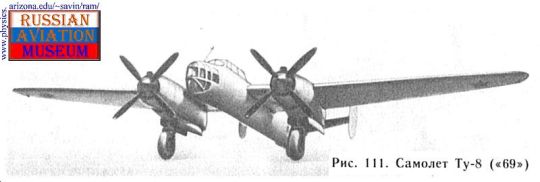
Continuing with earlier attempts to develop a long-range Tu-2 derivative, Tupolev would substantially redesign the aircraft as the Tu-8 in the immediate postwar period. The Tu-8 retained the M-82 radials of its predecessor, but the majority of the aircraft was extensively redesigned. The forward fuselage was altered to allow for side-by-side seating of the pilots, and the navigator was given a seat in an extensively glazed nose. Defensive machineguns were replaced with 20mm B-20 cannon in remotely controlled turrets sighted through blisters on the sides of the rear fuselage. The wing and tail area increased, and a bombsight derived from the American Norden bombsight was installed to aid in aiming the payload of up to 4,500kg of bombs. Testing began in May 1946, but numerous problems (particularly in the remote-controlled armament) prolonged testing until April of the next year. State trials began in the second half of 1948, but reports were unfavorable. Not only did the type fail to compete with jet bombers then being developed, but it had stability issues, lingering problems with the armament, and structural deficiencies. Tupolev continued to propose improved variants of the type, but none were accepted as the state decided to divert funding to more promising jet bombers.
Tupolev Tu-4 “Bull”
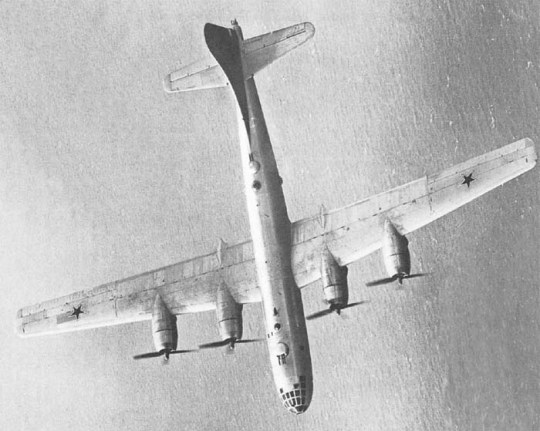
Throughout WW2, the USSR had been unable to develop a strategic bomber available in large numbers. As the war neared its end, such capabilities only became more necessary. While the VVS had requested long range strategic bombers, including the B-29, under Lend-Lease, their requests were refused, with only tactically-oriented medium bombers supplied instead. However, the Soviets received a stroke of luck in 1944, when on four occasions B-29s were forced to land in Soviet territory. Citing Russo-Japanese neutrality, the Soviets interned the bombers officially while sending the three serviceable aircraft off to Tupolev for analysis. Tupolev rushed to clone the aircraft before the end of the war in Europe, after which the Soviets were obligated to join the war against Japan.
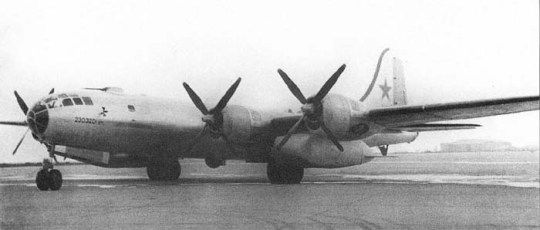
The resulting Tu-4 was effectively a B-29 built in metric. Different metal gauges had to be used, forcing extensive re-engineering. Differences included the engines, defensive weapons (23mm cannon instead of .50s), and the radios. Despite all the challenges, however, the resulting Tu-4 was only 340kg heavier than the B-29. While the interned B-29s and their crews were returned upon the Soviet declaration of war on Japan, Tu-4 development continued. The first prototype finally took flight in May 1947, with serial production starting immediately. Four aircraft were revealed to the public in the Aviation Day parade that August, confirming the West’s fears that the B-29 had been copied.
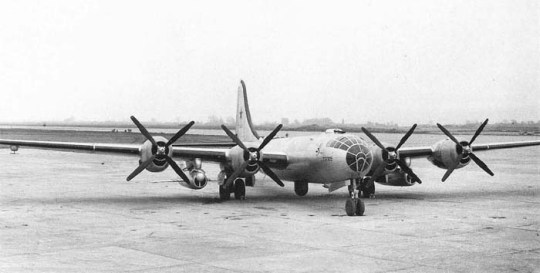
In total, 847 Tu-4s were built, with production ending in 1952. It formed the basis for the Soviet’s first real strategic air arm, and became the aircraft to drop the first Soviet nuclear weapon. The design formed the basis for countless other variants, both bombers and transports. However, they were soon to be replaced, with the Tu-16 and Tu-95 starting to replace the Tu-4 as early as 1954. By the start of the 1960s, the only operational Tu-4s operated as transports. However, even these had been retired by the middle of the decade.
Sukhoi Su-10
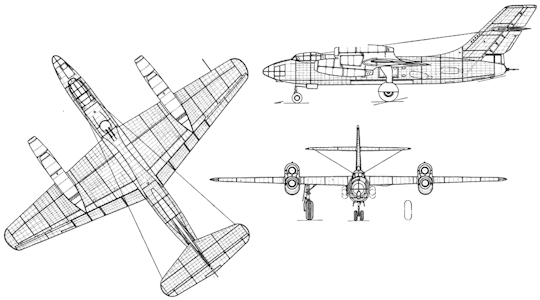
In early 1946, Sukhoi received an order from the Council of Ministers to develop a jet bomber using four Lyulka TR-1 turbojets. Starting work in April, Sukhoi opted to study several different arrangements and alternative powerplants, including the RD-10/Jumo 004 and Rolls-Royce Derwent engine in four- and six-engine layouts. Ultimately, the design that was approved for full development was a fairly conventional straight-winged arrangement with a crew of four. A bombardier sat in the glazed nose, with a pilot and gunner in a cockpit behind him. In the tail, another gunner's position was installed as well. Armament consisted of a forward-firing B-29 cannon, two B-20s in a remote-controlled dorsal turret, and two B-20s in the tail, while an internal bomb bay provided space for up to 3 tons of stores. The engine arrangement was perhaps the only notable feature of the design, with engines placed together midway down the wing in a staggered arrangement that straddled the wing. Unfortunately, the Su-10 would never leave the drawing board - the Sukhoi OKB was dissolved in March 1947.
Ilyushin Il-22

In February 1946, Ilyushin was ordered to develop a bomber making use of four Lyulka TR-1 turbojets. Ilyushin, who had been working on jet bomber projects since 1945, proceeded quickly, developing a conventional high-winged aircraft with engines slung under the wings in individual pods. Crew sat in a heavily glazed stepless cockpit, allowing for simplified pressurization, while defensive armament consisted of a remote controlled dorsal turret and manned tailgunner position. Payload of 2,000kg would be carried in an internal bomb bay. The prototype, designated Il-22, took flight in July 1947. Unfortunately, the TR-1 turbojets fell well short of expectations, only producing 80% of planned thrust. The Il-22 was terribly underpowered, so much so that Ilyushin mounted JATO rockets on the prototype to complete testing (incidentally marking the first Soviet aircraft to use a JATO system). Unlike the competing designs from Sukhoi and Tupolev, the Il-22 had no provisions for mounting other engines available, and, with Tupolev’s projects proving far more promising, the decision was made to not submit the Il-22 for state acceptance tests.
Tupolev Tu-77/Tu-12
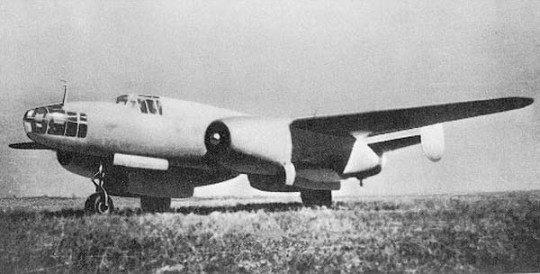
As the Tu-73 project ran into delays, Tupolev used the ubiquitous Tu-2 as the basis for yet another project. Under the designation Tu-77, Tupolev went to work adapting the RD-45/Rolls-Royce Nene engine to the Tu-2 airframe. Though the adaptation seemed simple at first, Tupolev would have to alter much of the design for a satisfactory conversion. The piston engine nacelles of the Tu-2 were replaced with RD-45s, and new tricycle landing gear was designed to prevent the engines from damaging runways. The nose was revised as well to give the navigator a better view, and various improvements were made to the wings and fuel tanks. Testing began in July 1947, and two examples would make appearances at the 1947 Tushino Air Show. When submitted for state tests, it was redesignated the Tu-12. Tests found numerous flaws in everything from armament (forward firing guns damaged the glazed nose and defensive guns were unusable at high speeds) to insufficient power for onboard systems and poor crew ergonomics. In the end, the five Tu-12s built would serve as testbeds for developing jet fighter and bomber tactics. These tests would reveal the inadequacy of machineguns for armament in high-speed engagements, leading to the decision that all subsequent bomber armament would be cannons.
Tupolev Tu-73

In response to a VVS requirement for a new jet bomber, Tupolev would develop an entirely new straight-winged design designated the Tu-72. Following requirements closely, the Tu-72 was to be powered by two Rolls-Royce Nene engines slung under straight, mid-mounted wings. However, due to fears over the inadequacy of the twin-engined layout, Tupolev further developed the design into the three-engined Tu-73. The Tu-73 was almost identical to the Tu-72, but it added a Rolls-Royce Derwent engine in the tail, fed by an intake at the base of the tailfin. The third engine precluded the use of tail or dorsal turrets, so the only defensive armament was a ventrally-mounted remote-controlled barbette holding two 23mm cannon. Additionally, four 23mm cannon were fived firing forward, and, as per requirements, an internal bomb bay could hold up to 3,000kg of bombs. The Tu-73 would fly in late 1947, performing reasonably well. However, the development of the more powerful Nene-derived VK-1 meant that the three-engined layout of the Tu-73 was unnecessary and wasteful, forcing Tupolev to go back to the drawing board.
Ilyushin Il-28 “Beagle”
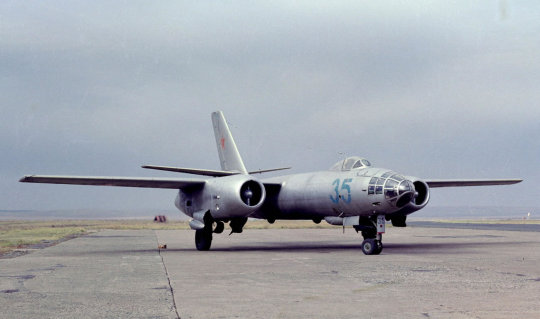
At the end of 1947, Ilyushin began work on a new twin-engined jet bomber making use of the Rolls-Royce Nene turbojet. Though done under Ilyushin’s own initiative, the project soon gained official approval as the Il-28. Full development was approved in early 1948, with the Il-28 materializing as a compact three-man bomber. It shared much of the Il-22’s design, including the high-mounted straight wing, podded engines, and tail gunner, but it was was a compact design, reducing crew to three and dropping the dorsal turret while increasing forward-firing armament to two 23mm cannon. An internal bomb bay provided space for up to 3 tons of bombs, guided by a bombsight derived from the American Norden bombsight.
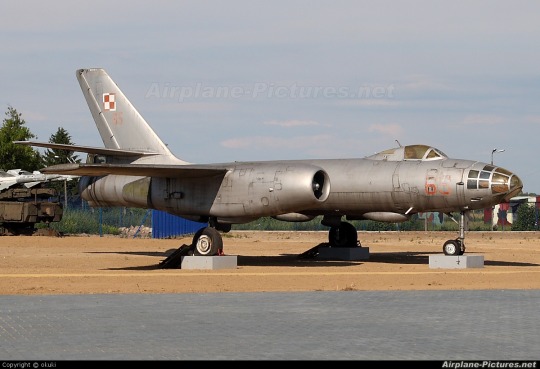
The Il-28 prototype would first fly in July 1948. Factory tests proved promising, so the Il-28 was sent off to state tests to compete with the Tu-14. It ended up beating out the Tu-14, much to Tupolev’s ire, and in 1949 the Il-28 was ordered into production. The Il-228 began to reach operational service by the end of 1950, becoming the first jet bomber to see significant use with the VVS. Crews quickly grew to love the bomber thanks to its excellent performance and handling and fairly good ergonomics. It was reliable and rugged, allowing it to operate from forward airfields with ease, and it proved a capable platform for various secondary roles as it was eclipsed by newer types. The conventional Il-28 was followed up by the reconnaissance-oriented Il-28R, ASW/torpedo bomber Il-28T, and nuclear-capable Il-28N. Later on, a jammer variant arose as well, designated Il-28RTR.

Unfortunately, the Il-28 was quickly eclipsed in Soviet service by strike fighters, and, though the VVS planned to convert the fleet to the Il-28Sh attacker standard, these planes were dropped, and most Il-28s would be shifted to secondary roles by the end of the ‘50s. The first foreign customer would be China, who received their first Il-28s in 1952. They would make their combat debut in 1956 over the Taiwan Straits, ultimately losing several of their number to enemy fighters. They would later take part in the suppression of the Tibetan uprising in 1959 as reconnaissance platforms, again losing several aircraft. When the Sino-Soviet Split occurred, Harbin was tasked with unlicensed production of the type as the H-5. Though the H-5 would be obsolete by the time it was finally in service, there were no better alternatives, so the type would serve with the PLAAF well into the ‘90s.
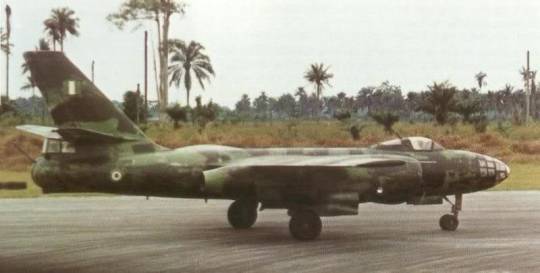
Nearly every Soviet-aligned state would end up receiving the Beagle at some point, although most never used the aircraft in combat. Egypt amassed a large fleet of the type in the years leading up to the 6 Day War, but they became a priority for Israeli air strikes and most were destroyed on the ground. Of those that survived, they fared little better against IAF air superiority. The type persisted into the ‘70s, even flying a few sorties in the 1973 war, but their use was generally limited to reconnaissance. Cuba briefly became a base for Il-28Ns in 1962, but in the aftermath of the Cuban Missile Crisis, they were withdrawn from the region. The final combat use of the Il-28 took place in the ‘80s, flying with the Soviet-backed Afghan government. They proved surprisingly capable COIN platforms, making low level passes and covering egresses by hosing down the target area with the tailgun. Despite its age, the Il-28 remains in limited service across the world, primarily with third-world air forces like North Korea.
Tupolev Tu-14 “Bosun”

With the development of the more powerful VK-1 turbojet, Tupolev redesigned the Tu-73 to eliminate the superfluous tail-mounted engine. Tupolev also planned to add a navigation radar, increasing rew of what was supposed to be a fairly light bomber to five, but the VVS rejected this idea and forced Tupolev to reduce crew to three. The resulting redesign eliminated all defensive armament outside of a tail barbette. The prototype would take flight in October 1949, and five pre-production aircraft were assembled from Tu-73 parts for trials. One was evaluated by the Soviet Navy, while the remainder competed with the Il-28 for the role as the new VVS medium bomber under the designation Tu-14. While the Tu-14 lost out to the Il-28, the Soviet Navy recommended production, allowing Tupolev to secure a production order for 150 Tu-14s. These bombers served with mine-torpedo regiments until 1959. After being retired, several were given to China, though the extent of their service there is unknown.
Ilyushin Il-30

In 1948, Ilyushin began work on a new bomber project that was substantially more modern than the Il-28. Working under the designation Il-30, the bomber added an extra crewman, 1 more ton of payload, and intended to increase range by 500km and speed by 100km/hr. The TR-3 turbojet was selected as the powerplant, with one engine under either wing as with the Il-28. Unlike the Il-28, however, the Il-30 featured a 35 degree swept wing and bicycle undercarriage with outriggers under the engine nacelles. Armament consisted of six 23mm cannon in paired mountings in the tail, dorsal turret, and nose. The Il-30 was also fitted with an advanced navigation suite for all-weather operations. Ground tests got as far as high-speed taxi runs, but numerous problems prevented the Il-30 from ever flying. The structure of the wing was called into question, as was the reliability of the TR-3 engine. With other projects like the Il-28 given priority, the OKB lacked the resources to fix the issues, so the Il-30 was abandoned.
Tupolev Tu-80
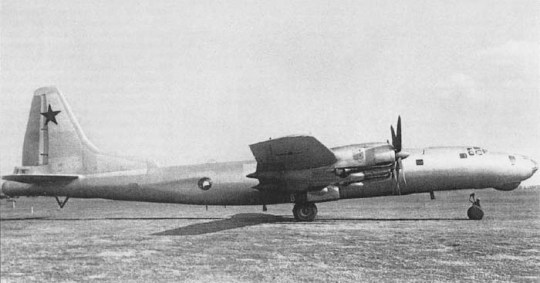
While the Tu-4 had provided a base for the Soviets to establish a strategic bombing force, the bomber rapidly became obsolete. Hoping to provide a new design, Tupolev developed the Tu-80. The Tu-80 enlarged the Tu-4 design, while using better aerodynamics, more efficient engines, and more fuel tanks to extend range. Work began in early 1948. The forward fuselage was redesigned, with the stepless canopy of the original design abandoned. Wings were increased in area, and the lift-to-drag ratio was increased from 17 (in the Tu-4) to 18. The Tu-80 took flight in December 1949. Unfortunately, by this time, development had already been cancelled for several months. While engineers had hoped to revive the project with promising test performance, the Tu-80 was unable to perform well enough to revive the program. The single prototype served out the rest of its life as a research aircraft.
Tupolev Tu-85
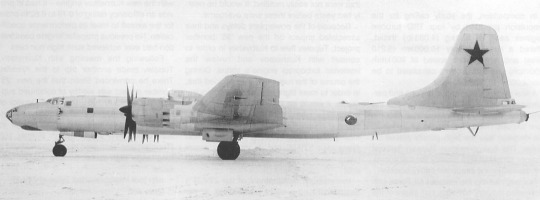
A more ambitious development of the Tu-4 was the Tu-85. As even the Tu-80 was projected to lack the range for true intercontinental operations, Tupolev developed a much larger aircraft. Design work began in mid 1949, resulting in a much larger aircraft than both the Tu-4 and Tu-80. Like the Tu-80, the aircraft abandoned the stepless canopy, and new, more efficient engines were used. Payload was increased to 40,000lb, and range to 12,000km. The first prototype took flight in June 1951, with trials lasting until November. While the Tu-85 had shown a massive improvement over the Tu-4 and Tu-80, the success of the MiG-15 in Korea had shown the vulnerability of such bombers, and thus development focus was shifted to higher performance turboprop and turbojet bombers.
Ilyushin Il-46
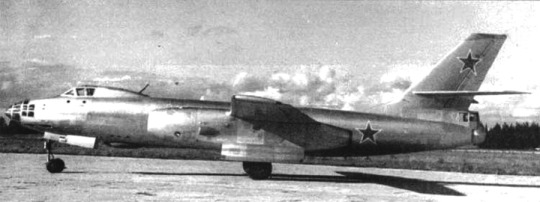
Soon after the Il-28 was accepted into service, Ilyushin began work on an enlarged derivative. Designated the Il-46, the new bomber was intended to significantly improve range and payload of the Il-28. Due to a tight schedule, the design would closely resemble a scaled-up Il-28. It was about twice as heavy as the Il-28, and more powerful AL-5 turbojets in longer, slimmer nacelles were used to maintain performance. To allow the aircraft to operate from rough airfields, the Il-46 was fitted with twin-wheel undercarriage and mounts for JATO rockets. Unusually, the crew and armament arrangement of the Il-28 was retained, including the twin forward firing cannon. The Il-46 first flew in March 1946, demonstrating a top speed of over 900km/hr, payload of 5 tons, and range of nearly 5,000km. In late 1951, Ilyushin had also finalized a derivative designated Il-46S with a 35 degree swept wing and thick inner wing section filled with fuel tanks projecting that the bomber would have a significantly longer range and a top speed of 1,000km/hr. Intended to compete with the Tupolev Tu-16, the Il-46S was never completed, as the Tu-16 had been ordered into production. Meanwhile, the straight-winged Il-46 would also be abandoned, as it was now surplus to requirements.
Tupolev Tu-16 “Badger”
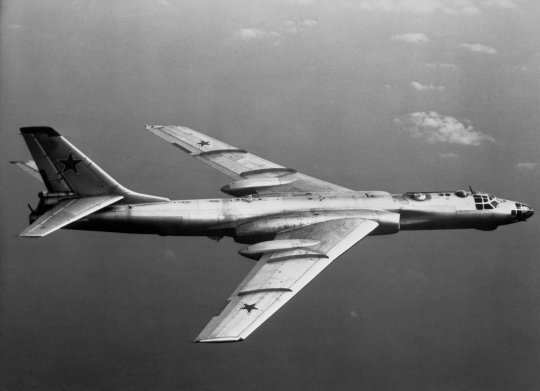
In 1950, requirements were issued to Tupolev and Ilyushin for a swept-wing jet bomber powered by two AL-5 turbojets with a range of 8,000km, payload of 5,000kg, and seven defensive cannons. Tupolev quickly produced a slender design with an engine mounted in either wing root designated the Tu-16. Apart from the tail gun, all armament was to be in remote barbettes. Unusually, main gear would be carried in prominent pods outboard of the engines. The Tu-16 would take flight in April 1952, but, to the disappointment of Tupolev, it clearly would not meet state requirements. It was submitted for state tests regardless, which recommended several changes. A second prototype improved on the Tu-16’s shortcomings, but it still lacked the required range. Nevertheless, there was little alternative - Ilyushin had already abandoned their contender. Thus, the Tu-16 was ordered into production.

Almost 700 conventional freefall bomber Badgers (300 conventional Tu-16s and 400 nuclear-capable Tu-16As) would be built through the 1950s. While these would serve the VVS well through the 50’s, they were quickly overshadowed by the missile-carrying Tu-16 variants. After experiments in the 1950s, the focus of the Tu-16 fleet gradually shifted towards missile carrying. Earlier variants were fairly straightforward modifications, adding a targeting radar and a hardpoint under either wing for a cruise missile. As the size of missiles increased, however, more extensive modifications were required to provide a recessed position under the fuselage to carry only a single missile. As Soviet bomber doctrine shifted towards the use of cruise missiles, the missile-carrying Tu-16s would surpass the conventional Badgers.
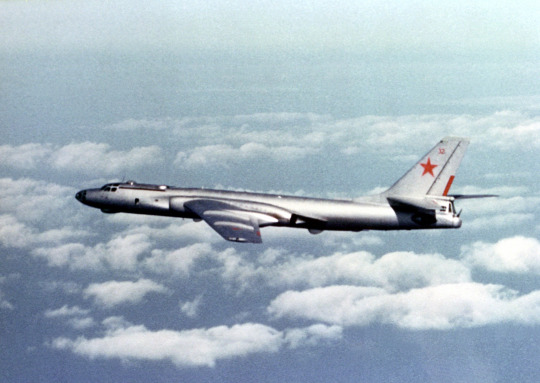
The long range of the Badger meant it would also see use in a variety of other roles. First to be developed was the Tu-16SPS EW variant, which consisted of about 40 aircraft converted in 1955. Later jammer variants were more specialized depending on their role - the Badger-H was oriented towards chaff-laying, while the Badger-K, -J, and -L would be pure jammers. The jammer Tu-16s would end up being the only Badgers to ever see operational use - they provided jamming support near the Pakistani border in Afghanistan. The next non-bomber Tu-16 to arise was the reconnaissance-oriented Tu-16R (began production in 1957). . Fitted with cameras, countermeasures, and ELINT gear, the Tu-16R retained all defensive armament but carried no payload.
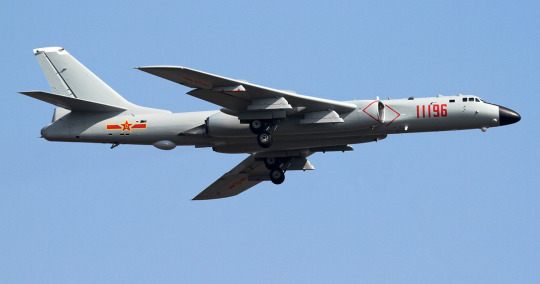
The Tu-16 would see a fair amount of export. Apart from the Soviets, the Badger would fly with Egypt, Iraq, China, and Indonesia. China became an enthusiastic operator of the Tu-16, securing license production rights soon after the acquired the type in 1959. Development of the H-6 (as it is known in Chinese service) generally followed that of the Soviets - early models were freefall bombers, while specialized EW and reconnaissance versions followed, ultimately leading to missile-carrier variants. Unusually, though, the H-6 makes up the entire Chinese strategic bomber force. Serving as missile carriers, the bombers apparently more than meet PLAAF requirements, and Xian (the manufacturer of the H-6) has even gone as far as developing a radical upgrade of the H-6 designated the H-6K.
Myasishchev M-32
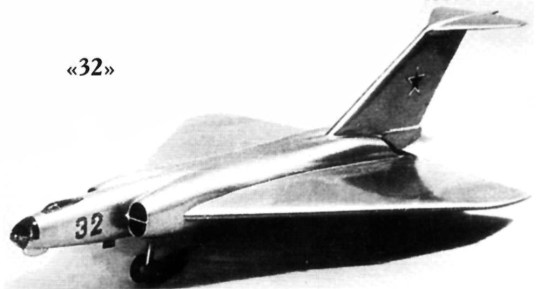
Just a year after the establishment of the Myasishchev OKB, they began work on a new transonic bomber under the internal designation M-32. The M-32 was wildly different from its contemporaries, with a large delta wing dominating the fuselage. The M-32 was to be powered by four VD-5 turbojets coupled on the top and bottom of the wings, giving the aircraft a projected top speed of about Mach 1.1. It was to have a crew of five, complete with a glazed nose for the bombardier, although details of payload and defensive armament are unclear. Projections called for a range of about 7,000km and loaded weight of 180 tons, putting the bomber in the same weight class as the Tu-95 while only offering the range of the Tu-16. Ultimately, it appears the project was too ambitious for the time, and, owing to its complexity, it was never approved by the state for full-scale development.
Tupolev Tu-95/Tu-20/Tu-142 “Bear”
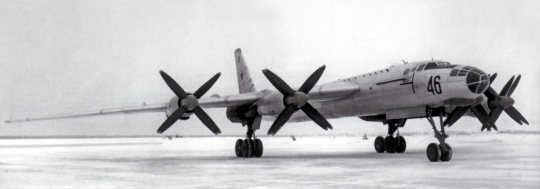
After experience in Korea showed that piston-engined bombers were no longer feasible, Tupolev was forced to look to turbine engines for their next-generation strategic bomber. Tupolev began looking into a swept-wing development of the Tu-85 mounting either turboprops or turbojets. Though turbojets offered higher speeds, they were too thirsty to give the bomber the necessary range. Thus, Tupolev settled on four TV-2F turboprops. The resulting Tu-95 was a far cry from its predecessors. Swept wings and tail surfaces gave it a much more modern appearance, and a long, thin fuselage seemed more like that of the Tu-16 than the B-29 derivatives. Testing began in November 1952, but the crash of the prototype in March 1953 due to an engine defect. Development was suspended for some time as Kuznetsov refined the engines. In the meantime, production would be ordered without tests being completed. Fortunately for everyone, when the Tu-95 did fly again in early 1955, all issues were solved.
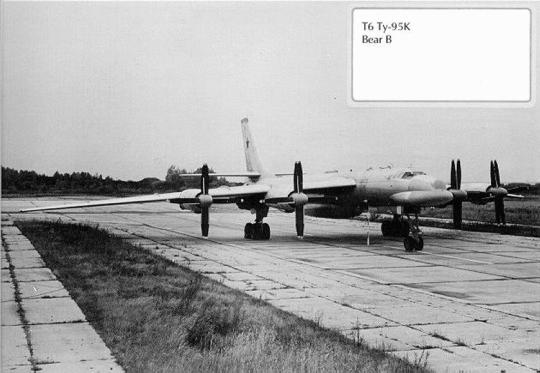
Although the type had been ordered into production as the Tu-20, it would be better known by its internal designation - the Tu-95. The Tu-95 would enter service in 1956, and it quickly proved to be a popular aircraft. It was easy to fly and maintain, and even the seemingly archaic contra-rotating propellers (normally a problem on any aircraft with them) were hardly an issue. Although the Tu-95 would not be as fast as turbojet aircraft, it was anything but slow - in fact, it was the fastest propeller-driven military aircraft ever. Early production variants remained conventional freefall bombers, typically carrying a 5,000kg payload of nuclear stores. As such, they were fitted with six 23mm cannon in dorsal and ventral barbettes and a tail position.
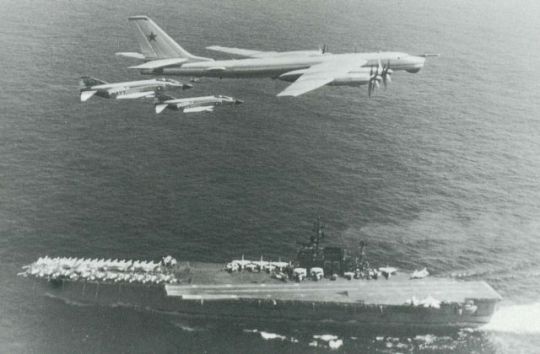
As Soviet bomber doctrine evolved, planners began looking at adapting the Bear as a missile carrier. These projects began before the Tu-95 had even entered service, and thus, the first missile-carrying Tu-95K would fly the same year the conventional Bear entered service. These first variants were hardly ideal - the semi-recessed missile and new targeting radar caused excess drag and cut into range, forcing the addition of a refueling probe in the nose to compensate. The Bear continued to evolve to suit payloads being developed for it, gradually taking on new radars, countermeasures suites, and missile loadouts. By then, the missile-carrying Tu-95s had completely taken over from the freefall variants.

The incredible endurance of the Bear would eventually attract the attention of the Soviet Navy, who wished to use the aircraft as a surveillance platform to guide antiship missiles. Work began on a patrol Bear in 1959, culminating in the Tu-95RT. The Tu-95RT replaced the bomb bay with a massive ventral radar bulge and various antennas for controlling missiles and communicating with other aircraft and surface vessels. Entering service in the mid-60s, the Bear-D became a regular sight for NATO naval forces across the world. Along with the development of reconnaissance variants, interceptions of wayward Bears became all the more regular for Western-aligned nations, and soon enough escorting Bears away from your borders became an indication of a country’s relevance.

With the advent of the submarine-launched ballistic missile, Tupolev was asked to develop an ASW variant of the Bear to deal with NATO SSBNs. In the early 60’s, Tupolev went to work on a new variant - designated the Tu-142 - based on the Tu-95RT. The Tu-142 would be a major revision of the standard Bear - the forward fuselage was extended and cockpit enlarged, while landing gear and wings were altered slightly and the dorsal and ventral turrets were deleted. The avionics suite was built around the Berkut search radar, which was complemented by various ELINT, IR, and sonobuoy systems. Unlike the earlier patrol Bears, the Tu-142 would retain its bomb bay to carry sonobuoys, depth charges, and mines. The Tu-142 would enter service in 1972, initially proving unpopular with crews due to issues with the avionics suite. However, onboard systems have evolved over time, turning the Tu-142 into a capable ASW platform. Whereas the standard Bears would never see export, the ASW-oriented Tu-142 would attract an export order from India, who began flying the type in the 80’s. Soviet Tu-142s would see service across the world as well - unlike the bombers, which flew from Soviet territory, Tu-142 were deployed to friendly bases across Africa and Asia.

With the advent of the Kh-55 cruise missile, the Bear was set for another upgrade to serve as missile carriers. As the Tu-142 was the current production version of the Bear at the time, Tupolev used that airframe as a base for the new Kh-55-carrier - the Tu-95MS. The Tu-95MS would be the ultimate version of the Bear. It retained the reduced armament of the Tu-142, but added a prominent nose bulge carrying a modern avionics suite for managing the payload of missiles. As for payload, a rotary launcher was added in the bomb bay to carry up to six Kh-55s, while external pylons would add space for several more missiles. The Tu-95MS would come to replace the other bomber Bears over the years, eventually being the sole offense-oriented Tu-95 variant in service.
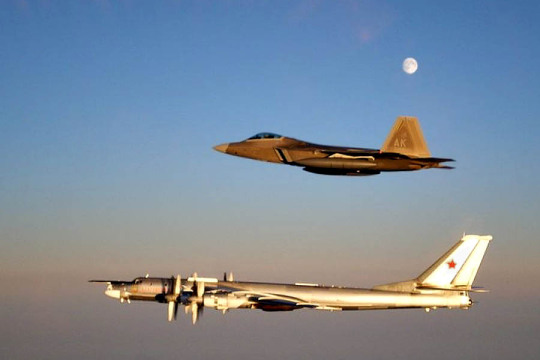
Though the design may seem archaic in modern times, the Bear has been an enduring symbol of Russian air power. Production has continued up until 1994, and, although the older airframes have been retired, the Russian Air Force retains a sizeable fleet of Tu-95MS and Tu-142MZ. Though budget limitations temporarily halted the Bear patrols that regularly probed less-than-friendly airspace, these flights have returned in 2007. Just like its American counterpart, the B-52, the Russians seem intend on keeping the versatile airframe around for the foreseeable future. Of course, that depends on the maintenance crews, who may not be up to the task - two Bears have crashed this past year, leading to the grounding of the fleet.
Myasishchev M-4 “Bison”
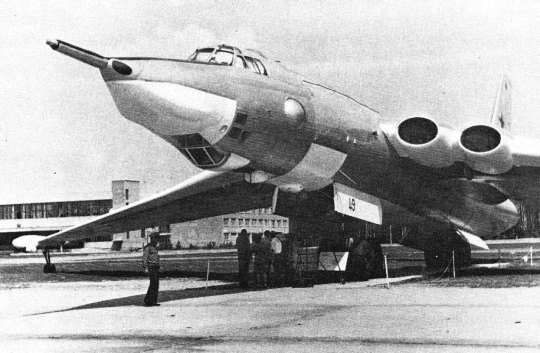
The inaugural project of the revived Myasishchev OKB would be an ambitious proposal for a four-engined heavy strategic bomber. Requirements set out called for a range of 12,000km, top speed of around 900km/hr, and payload of 5 tons. The bomber that took shape would be a fairly conventional design with all swept surfaces, bicycle landing gear, and four AM-3 turbojets mounted side-by-side in the wing roots. For defense, the bomber was to have guns in a tail position as well as remote controlled dorsal and ventral turrets. Design work proceeded quickly, and in January 1952, the prototype bomber - now designated the M-4 - would fly for the first time.
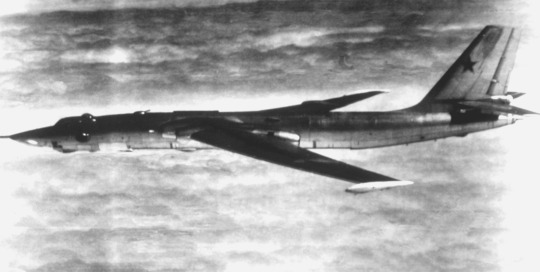
The Soviet were enthusiastic about the M-4, showing it off at the 1952 May Day Parade before trials had even completed. Unfortunately, while they boasted of the type’s impressive performance to the rest of the world, the reality was that the M-4 was falling well short of specifications. Range was only 9,500km, not the 12,000km required for intercontinental bombing, and it had a far lower than expected ceiling and excessively long takeoff roll. Tupolev’s Tu-95 seemed to offer a more promising solution, but, as the Tu-95 was running into issues of its own, it was decided to order the M-4 into production. The Bison would enter service by 1956, although the initial production run would end with just 34 aircraft constructed. Fortunately, when the Bear did enter service, the M-4 still held enough of an advantage to warrant updating the airframe.

As the M-4 entered service, Myasishchev had already begun work on an updated version. The 3M, or Bison-B, as NATO called it, would make several changes to increase range, including the use of more efficient VD-7 turbojets, a lighter, more aerodynamic central fuselage, and an inflight refueling probe. The glazed nose was replaced with an aerodynamic radome while the wing was enlarged and refined to reduce drag and improve flight ceiling. The effect of the changes was readily apparent - the Bison-B was 6.5 tons lighter than the M-4, while the engines had a 25% lower specific fuel consumption. Unfortunately, the VVS by then had little interest in the design - the Bison-B still lacked the range to strike America. Rather, the Soviet Navy would adopt the type, as it offered sufficient range for a maritime patrol platform. The 3M was adopted for maritime patrol in 1958, eventually being superseded by Bear-based patrol platforms.

Ultimately, the M-4 would never see much use in combat roles. Though Myasishchev worked to adapt the bomber as a missile carrier when doctrine shifted towards the use of standoff cruise missiles, the VVS was never really enthusiastic about the upgraded variant, and, with the dissolution of the Myasishchev OKB in 1960, the upgrade program was halted. The most significant use of the M-4 would end up being as a tanker. Myasishchev had been working extensively with inflight refueling systems ever since the issues with the original M-4 were discovered, and, as part of the efforts to develop the 3M’s refueling probe, the OKB had also produced a tanker demonstrator. Trials of the tanker would lead to the conversion of the M-4 fleet as probe-and-drogue tankers starting in the late ‘50s. In the ‘70s and ‘80s, the 3M fleet followed, with most aircraft converted to tankers as well. Oddly enough, however, though most of the fleet was converted to tankers by the end of the decade, the only combat use of the Bison would come in Afghanistan, with several Bison-Bs converted back for conventional bombing to provide heavy-handed air support. Being support aircraft, they survived the fall of the Soviet Union better than many obsolete combat aircraft, but nevertheless they wouldn’t serve into the new millennium - the last Bison tanker was retired in 1994.
Ilyushin Il-54 “Blowlamp”
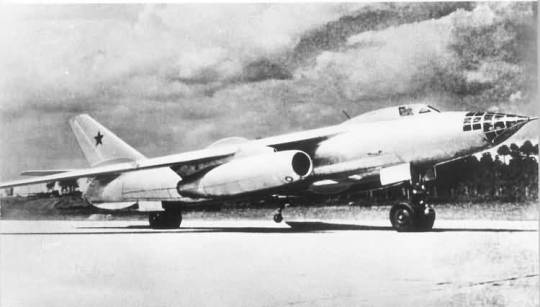
In the early ‘50s, Ilyushin was directed to develop a transonic bomber for state trials by 1954. Early proposals involved a mid-winged design with a T-tail and engines in the wing roots, but by the end of 1953 Ilyushin had settled on a high-winged proposal more akin to their earlier failed swept-wing bombers. The Il-54, as it was designated, had a shoulder-mounted wing under which a single AL-7 turbojet was slung. It featured bicycle landing gear with outrigger struts on the wing tips, and the nose gear featured a mechanism to raise the nose to improve takeoff performance. Crew remained just three, with a pilot, bombardier, and gunner. Continuing the trend with Ilyushin bombers, the Il-54 had a standard payload of 3 tons with an overload of 5 tons, and defensive armament consisted of two cannons in the tail and a single fixed forward firing cannon. Trials for the I-54 began in April 1955. It was found to have good performance and handling in flight, but the novel new landing gear system made the bomber difficult to control on takeoff and landing. Changes to the landing gear fixed these issues, and the Il-54 would successfully complete state tests. Despite this, the Il-54 program was terminated. The sudden shift towards ballistic missiles saw bombers fall out of favor. Though the Il-54 would make an appearance at the Tushino Air Show as the Il-149 - receiving the NATO codename “Blowlamp” - it would never enter production.
Bartini A-57

As supersonic bombers gained favor in the mid-’50s, Bartini joined in the efforts with an ambitious proposal. Designated the A-57, the centerpiece of the design was an elegant compound sweep delta-wing with a blended-wing/body. Five NK-10 or NK-6 turbojets would be installed above the trailing edge of the wing, and, perhaps most unusually, the bomber was designed as a seaplane to reduce the vulnerability of the aircraft to a preemptive strike. Onboard systems were to be very advanced - the A-57 was designed with an SVR-1 nav/attack radar, several active jammers and chaff dispensers, and communication systems to allow the bomber to communicate with submarines. The A-57 was fitted with an internal bomb bay for a single 3 ton nuclear store, while Bartini would also add provisions for accommodating Tsybin’s S-30 nuclear missile above the fuselage. All this would be managed by a crew of three concentrated in the nose. Performance projections were quite ambitious - the A-57 was to be a 250 ton platform with a top speed of 2,500km/hr and an operational range of up to 14,00km. Unfortunately, the project would not be approved for full development when submitted in 1957. Though Bartini had attracted support from TsAGI and MAI, and even the competing Myasishchev OKB, the shift towards ICBMs would ultimately kill the project before it ever left the drawing board.
Myasishchev M-70

Due to concerns over the vulnerability of land-based strategic bombers to a preemptive strike, Myasishchev was ordered to develop a seaplane strategic bomber in 1956. Requirements set out called for a 200 ton aircraft with a cruising speed ranging from high subsonic to about Mach 2 and a range of about 7,000km. By making use of submarines for refueling, the bomber would ideally extend its range to almost 20,000km. The M-70 that emerged would be fairly conventional, with a large shoulder-mounted delta wing and conventional tail. Power was to come from four turbojets - two mounted at the base of the tail, and the other two mounted on pylons above the wings. The project was presented to the state in August 1957, but apparently it was rejected, spelling the end for the M-70.
Tupolev Tu-98 “Backfin”

In the early 1950s, Tupolev was issued requirements for a new supersonic bomber powered by two AL-7F turbojets capable of reaching a top speed of 1,300km/h. The design that emerged under the designation Tu-98 was a slender area-ruled aircraft with 55 degree swept wings and engines mounted side-by-side in the rear fuselage. An internal bomb bay could carry a single nuclear store of four 1,000kg bombs, and a remote-controlled defensive barbette was placed in the tail. The crew of three was concentrated in the nose, and, unusually for a supersonic bomber, the bombardier still had a glazed position in the nose. The Tu-98 would first fly in July 1956, but official interest in the program waned as Khrushchev decided to focus on ballistic missiles. Though Tupolev continued testing and planned for several modifications, the whole program would be cancelled in February 1958.
Tupolev Tu-22 “Blinder”

Although the Tu-98 would be cancelled, Tupolev continued work on a parallel supersonic bomber design study. The new bomber was considerably larger than the Tu-98 before it, but it incorporated critical elements such as area ruling and swept wings, along with a similar crew arrangement and defensive armament. However, the new aircraft would be faster (top speed of 1,500km/h) and be powered by two engines mounted at the base of the vertical stabilizer. Though the Tu-98 would meet its end in 1958, the larger supersonic bomber project lived on. Several months after the Tu-98 was cancelled, the new bomber prototype took flight for the first time. As Tupolev tested and refined the prototype, production of the new bomber was authorized as the Tu-22. The Tu-22 would come in two variants - the bomber Tu-22B and reconnaissance Tu-22R. For the bombing role, an internal bay could carry a standard load of 12,000kg of stores. Like the Tu-98, crew was concentrated in the nose and a remote-controlled gun barbette was fitted in the tail.
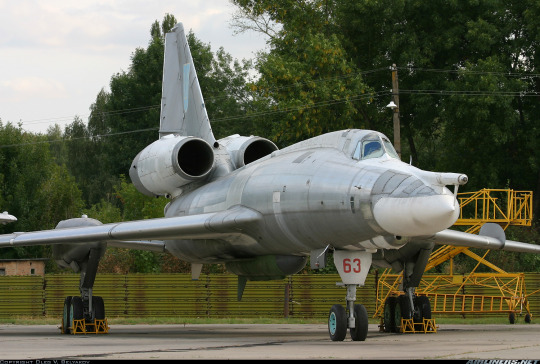
Unfortunately, the Tu-22B proved to be so problematic that it never entered service. Combined with the abandonment of the freefall bomber concept, the VVS saw little use for the bomber, so only 15 Tu-22Bs would ever be built. Rather, production focused on the reconnaissance Tu-22Rs. Tu-22Rs were regularly fitted with both reconnaissance and jamming equipment, meaning that they could serve as escort jammers for strike packages. This support role would come to define the Blinder’s service with the VVS - it was difficult to fly and a failure in the bomber role, so the majority of Tu-22s would live out their lives as jammers. However, Tupolev did try to salvage some offensive capability out of the bomber. With the advent of the Kh-22 cruise missile, Tupolev developed the Tu-22K, which featured the ability to carry a single missile under the fuselage. However, fewer than 100 would be built, and, going back on its support role, many were configured for defense suppression with ELINT gear to target radars and the antiradiation Kh-22P missile.
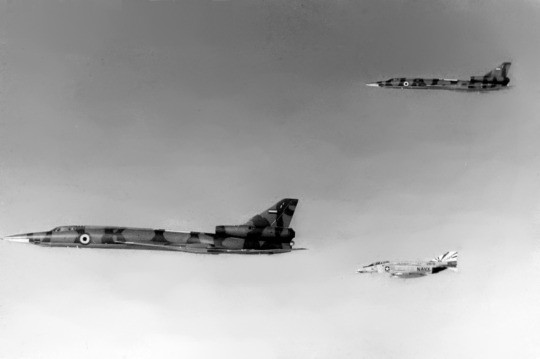
Unsurprisingly, combat service of the Tu-22 was limited. The aircraft was unforgiving and ergonomics were poor, and unsurprisingly accident rates were high. Though the fleet was originally assigned the mission of making nuclear strikes on Europe and the Mediterranean, the unreliable aircraft gave way to newer types in offensive roles, leaving only the jammers in service. In the end, the only Blinders to see operational use in Soviet service would be the few Tu-22PD jammers deployed to Afghanistan to protect strike packages from Pakistani air defenses. Oddly enough, the unfortunate Tu-22 would see some export success, with freefall bomber variants flying with Libya and Iraq. Libyan Tu-22s would make the type’s combat debut in 1979, when they flew strikes against Tanzania in support of Uganda. Across the next decade they flew strikes into Sudan and Chad, but never really caused much damage. Iraqi Blinders fared a little better, successfully making strikes against Iranian cities and shipping, but not without heavy losses. Although some may have survived up until the Gulf War in 1991, none of the Iraqi bombers would participate in the conflict.
Tsybin RS
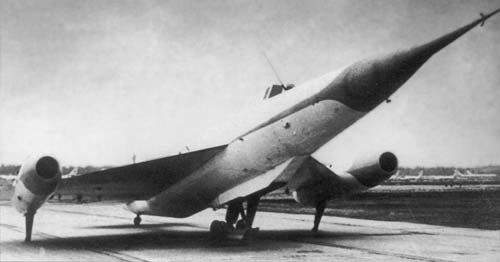
In 1953, Tsybin had proposed a long-range heavy supersonic cruise missile under the designation RSS/S-30. While the S-30 offered impressive performance (projections called for a 3,000km/hr cruise), the missile’s guidance system was unacceptably flawed, as it required the launch aircraft to guide the missile remotely for the duration of its flight. With such a system clearly unacceptable, as it prevented the launch aircraft from making any reasonable evasive maneuvers, Tsybin decided to switch efforts to a manned concept. Now designated the RS, the new bomber was a single-seat design sharing the same layout of the S-30. A small trapezoidal wing would mount RD-013 ramjets on the ends along with two liquid-fueled rocket boosters for supplementary thrust. A single 3 ton nuclear weapon would be carried internally. The aircraft itself was to be carried by a mothership to a suitable launch location, at which point it would separate, complete the mission, and return to base under its own power.

The RS proposal was submitted in 1956 for approval, along with a high-altitude reconnaissance variant dubbed the RSR. As the goals of the RS were becoming increasingly unrealistic and ICBMs were taking the center stage from strategic bombers, the RS was eventually dropped, with the RSR taking priority. In many ways, the RSR was to be the Soviet analog to the SR-71 - it had a top speed approaching Mach 3 and an intercontinental range. Because of the unusual design, Tsybin would build and test a low speed demonstrator - the NM-1 - using MiG-21 engines to validate the design. Testing seemed to go well, with the NM-1 completing tests successfully. However, in 1959, the whole program was cancelled with five RSR airframes assembled and awaiting engines. The RSR was seen as unimportant in the age of ICBMs, so, in October 1959, the Tsybin OKB was dissolved and folded into Myasishchev, and all its projects terminated.
Tsybin RGSR

Leveraging off of the seaplane bomber proposals of Bartini and the in-house development of the supersonic RS, Tsybin would propose another supersonic bomber/reconnaissance platform under the designation RGSR. Unlike previous projects, the RGSR was to be able to operate independently of a mothership. Because it was still to be far too small for intercontinental operations, the aircraft was envisioned as using submarines for refueling and rearming, particularly for highly-secretive strategic reconnaissance missions. Being a seaplane, the RGSR would be significantly different from the projects it was derived from. The fuselage took the shape of a hull, and, to keep the engines clear of the water, they were placed above the wings well behind the leading edge. In their place, large fuel tanks were installed on the wingtips, both expanding fuel capacity and stabilizing the aircraft at sea by serving as outriggers. The RGSR would not leave the drawing board, however. It was cancelled along with the rest of Tsybin’s projects when the OKB was dissolved, and the project never gained much support, as it was thought that satellites and ballistic missiles would adequately cover its role.
Myasishchev M-50 “Bounder”
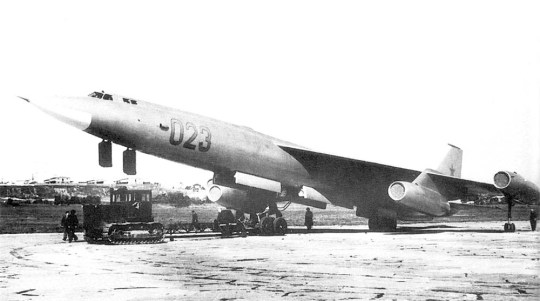
In 1953, Myasishchev was commissioned to begin preliminary work on a two-stage supersonic strategic bomber based around Tsybin’s designs. Aiming for a 5 ton payload, range of 13,00km, top speed of 1,800km/hr, and a supersonic cruise, Myasishchev unsurprisingly found the concept to be impractical. Multiple alternative configurations were considered, many being wildly unconventional, but ultimately, in July 1955, Myasishchev settled on a fairly conventional design. Specifications meanwhile had changed to call for a higher top speed, but a range reduced to just 11,00km. Under the designation M-50, Myasishchev worked closely with TsAGI to create a design to meet these specifications. The design that emerged was a slender conventional aircraft with a shoulder-mounted delta wing and four RD-16-17 turbojets. Even with the combined efforts of Myasishchev and TsaGI, however,the M-50’s projected performance fell well short of goals, with a projected range of just 9,600km.
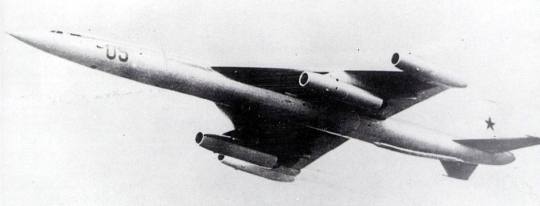
Despite failing to meet requirements, production of a prototype was approved. The M-50A prototype would roll out in July 1958. Owing to issues in the RD-16-17 powerplant’s development, the bomber was instead fitted with VD-7 turbojets, of which only the underwing engines were afterburning. A crew of two sat in a pressurized cabin, but they still wore pressure suits due to the projected high operating altitudes. The M-50A was also fitted with an advanced navigation and attack system featuring the most modern avionics available. The M-50A would take flight in late October 1959. Ground accidents slowed testing, but the program slowly progressed. In 1961, the second prototype, designated M-52, was almost ready, featuring such improvements as an inflight refueling probe, a tail gun, and support for two Kh-22 missiles. Meanwhile, the first prototype made its flyby at the Tushino Airshow that July. Unfortunately, that marked the M-50’s last flight. While the Soviets were sure to talk up the bomber, the shift towards ballistic missiles served as the final straw to kill an already-struggling program. The M-50A was sent off to a museum and the M-52 was scrapped before completion, marking the end of Myasishchev’s bomber.
Myasishchev M-56
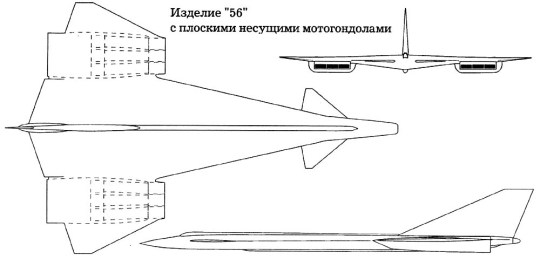
In 1959, Myasishchev began work on a supersonic bomber with far more ambitious goals than the M-50. Designated the M-56, the bomber was to have a cruise speed between Mach 2.5 to 3.25 and range of 12,000km, all in a 250 ton package. The wing planform - a cranked delta with two tails and canards - was finalized very quickly, but the aerodynamics would refine over the course of development. Early proposals called for four engines slung under the wings in individual pods and a distinct fuselage, while the final design used a blended wing/body with six engines grouped together near the trailing edge of the wing. Parallel to the project, Myasishchev was also looking into creating a nuclear powered variant, designated the M-60. Meanwhile, small-scale radio-controlled models were built and tested, validating the design, and work began on a full-sized mockup. Unfortunately, this all came to an end in 1960, when the Myasishchev OKB was dissolved. The project was terminated, and all relevant materials were transferred to Tupolev.
Myasishchev M-30
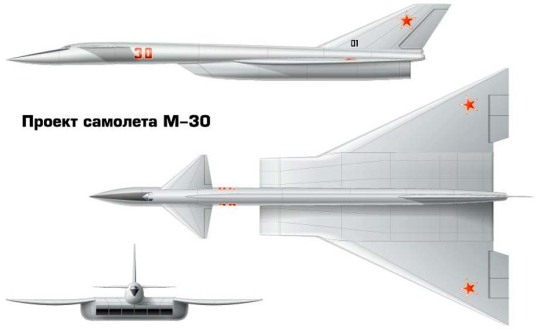
Myasishchev’s second nuclear powered bomber proposal would be the M-30. With work beginning in May 1959, Myasishchev settled on a canard-delta design fairly quickly, though details like engine placement would fluctuate. The plan called for a takeoff weight of around 170 tons, of which 30 tons were the reactor and protection 25 tons were payload, and up to 40 tons were coolant. Details such as crew layout and size, and expected performance are unclear, though it is likely that, given the arrangement chosen, the M-30 would have been designed for fairly high supersonic speeds. Whatever the case, Myasishchev would never get to prove the design - the M-30 came to an end when the Myasishchev OKB was dissolved in 1960.
Myasishchev M-57
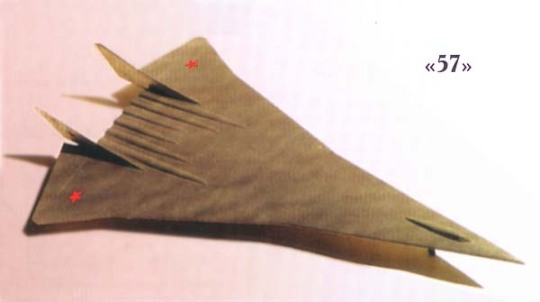
In 1959, Myasishchev was commissioned to develop yet another high-speed bomber proposal, this time under the designation M-57. Apparently drawing heavily from the cancelled Bartini A-57, the M-57 was a massive delta-wing design with a 75 degree sweep to the leading edge. The design was projected to have a takeoff weight of about 250 tons with a range of around 16,000km and a top speed of Mach 3.6, but payload was surprisingly small - just two Kh-22 missiles. Myasishchev projected the first flight to take place in 1963, but the aircraft was discontinued in 1960 with the dissolution of the OKB.
Myasishchev M-58
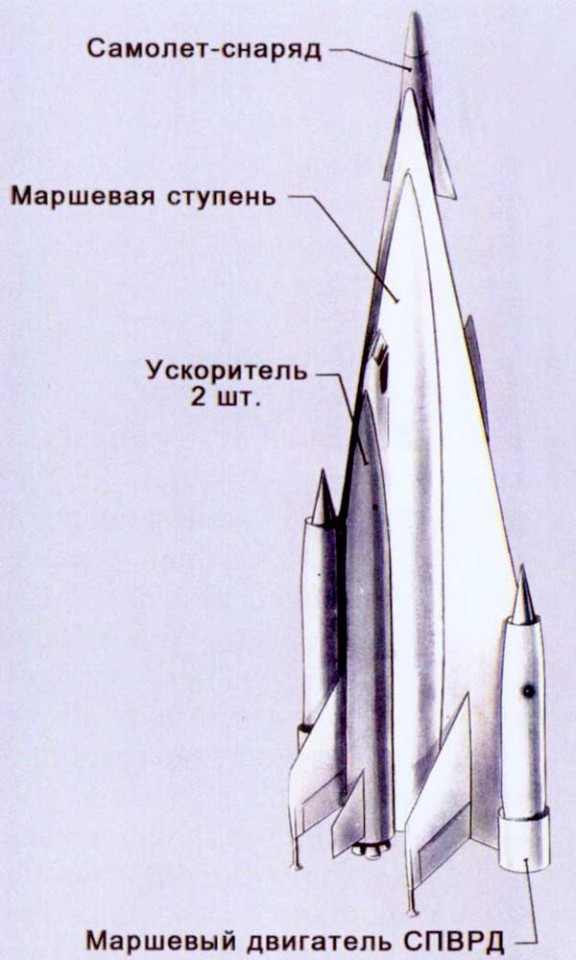
Perhaps the most unusual project to come out of the Myasishchev OKB would be the M-58 bomber. Unlike all of the OKB’s other projects, the M-58 was to be a composite system, consisting of a rocket-powered first stage, manned ramjet-powered second stage, and a single massive cruise missile third stage. Hoping to reduce reliance on large, vulnerable airfields, Myasishchev planned for the M-58 to take off vertically under the power of the four liquid-fueled rockets that made up its first stage. These rockets would bring it to altitude, at which point they would be jettisoned and the second stages ramjet would take over, bringing the bomber to a Mach 4.5 cruise. During the brief cruise, the aircraft would climb to 25km to release its payload before turning home. For landing, a rocket booster in the tail would provide adequate thrust for a vertical descent, ending with the aircraft landing on its tail. Unsurprisingly, such a concept never left the drawing board. Myasishchev spent the brief period between the M-58’s conception and the OKB’s dissolution working on solutions to the difficult prospect of landing the massive platform vertically, and they would never solve all the issues before the OKB was closed.
Tupolev Tu-125
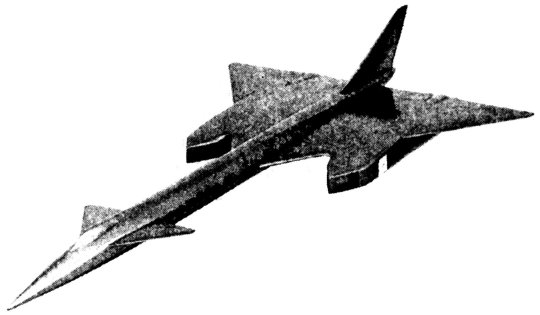
The relative failure of the Tu-22 combined with the new VVS program to create a counterpart to the American XB-70 would spark Tupolev to begin work on a new intermediate-range supersonic bomber at the end of the ‘50s. Given the internal designation Tu-125, the bomber was originally to be a simple canard-delta design with a payload of a single 4 ton missile and range of about 4500km with a speed of 2500km/hr. Aerodynamic heating meant that the Tu-125 would extensively incorporate titanium into its structure. The project would outlast the Myasishchev OKB, and indeed the final configuration submitted in 1962 seems to show some influence from Myasishchev’s M-56, with now four engines grouped outboard of the centerline. Unfortunately, Tupolev’s predictions were found to be too optimistic, expecting far better aerodynamic and fuel efficiency than would be practical. Even if that wasn’t the case, however, that would have meant little - the Tu-125 was rejected due to the doctrinal shift towards ballistic missiles.
Tupolev Tu-135
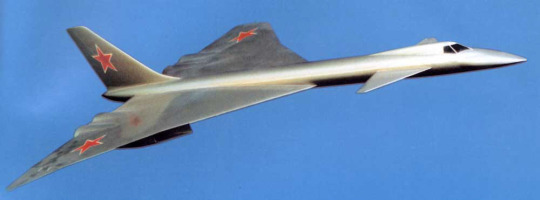
Parallel to the intermediate range Tu-125, Tupolev worked on a truly intercontinental supersonic bomber - the Tu-135. Compared to the Tu-125, top speeds were slightly lower to allow the use of easier-to-work materials in the construction. However, the Mach 2.3 cruise would remain, and range increased to 8,000km at supersonic speeds and 12,000km at subsonic speeds. To achieve this (all while carrying a payload of two to four Kh-22 missiles or air-launched ballistic missiles), the Tu-135 was to be massive - projections called for a max takeoff weight of over 200 metric tons. Hoping to secure the project’s future, Tupolev also envisioned several other roles for the bomber, ranging from supersonic transport to patrol aircraft to long-range interceptor. In the end, however, the Tu-135 fell victim to the same problems that killed the Tu-125 - it was not efficient enough to meet requirements, and the doctrinal shift to ballistic missiles made it no longer necessary.
Tupolev Tu-22M “Backfire”
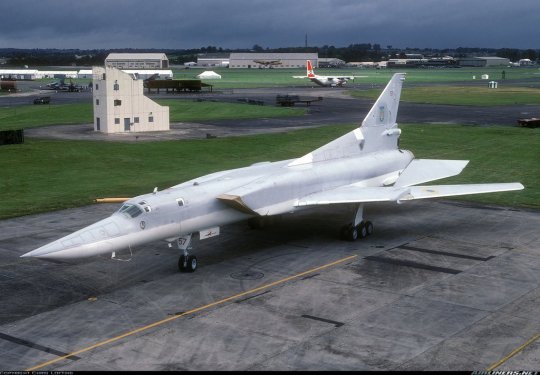
Recognizing the expense of the Mach 3 high-performance bombers being developed in the 60’s. Tupolev would propose a less sophisticated and capable alternative. Khrushchev’s preference for Sukhoi’s T-4 project would mean that Tupolev’s proposal would be sidelined for the time being, but after Khrushchev was ousted in 1964, Tupolev’s project was revived as a more capable replacement for the Tu-22 Kh-22 missile carrier. The project would be assigned the service designation of Tu-22M, although it was an entirely new aircraft. The Tu-22M did away with the sleek lines of the Tu-22, placing two massive NK-25 turbofans in boxy housings on either side of the fuselage, and swing-wings were used to improve low-speed handling. The main weapon of the Tu-22M, the Kh-22, could be carried in a semi-recessed position under the fuselage, as well as on hardpoints on either wing glove. The spacious bomb bay could also be loaded with up to 24,000kg of conventional stores. In the end, the Tu-22M that took flight in 1969 only retained the bomb bay doors of the Tu-22.
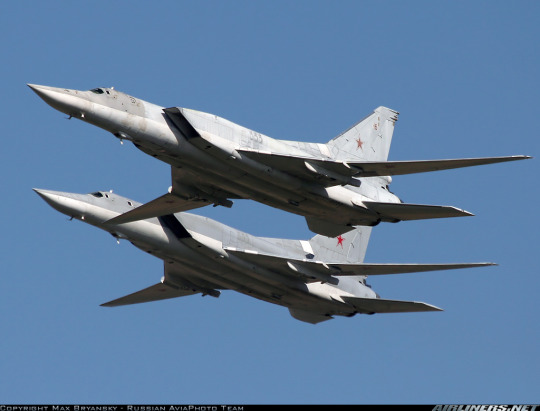
The Tu-22M would be rushed into service, replacing both the Tu-22 with the VVS and the Soviet Navy’s Tu-16 missile carriers. The Backfire, as it was known to the West, was a massive step up from the Blinder, although it was plagued with reliability issues at the start. The Backfire would be the backbone of the Soviet Navy’s strike force, while the VVS would fly the Tu-22M as both a conventional and nuclear bomber. The Backfire would make its debut in Afghanistan, flying conventional bombing missions in formations as large as 16 bombers. 370 Backfires were in service when the Soviet Union collapsed in 1991, and the majority of the fleet fell into Russian hands. Russian Tu-22Ms would continue to see combat use in conventional roles through the coming decades. Backfires bombed Grozny during the war in Chechnya, and in 2008, the Tu-22M returned to combat as a bomber and reconnaissance platform. During the war in Georgia, one Tu-22MR reconnaissance aircraft was lost to Georgian SAMs. Along with the Tu-95, the Backfire has returned to long-range probing patrols near foreign airspace as of 2007
Sukhoi T-4
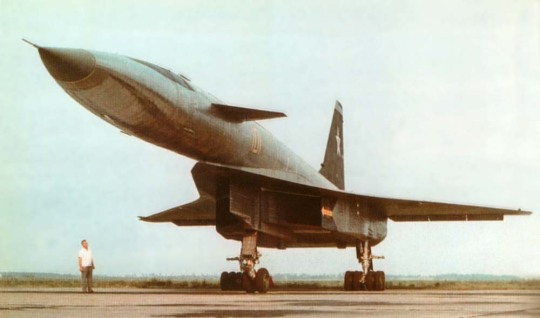
Though Khrushchev worked hard to kill most of the USSR’s bomber projects in the ‘60s, a few resilient projects would soldier on. Among these projects was Sukhoi’s T-4, aimed at serving as an intermediate-range supersonic strike platform. The T-4 built on the supersonic bomber project of the previous decades, resulting in an aircraft with a long, slender fuselage, delta-canard layout, and engines podded under the wing. A great deal of effort was put into making the aircraft capable of sustained Mach 3 flight, resulting in, among other things, a drooping nose that would cover the windscreen during cruising flight. A mockup was built in 1966, showing off various planned roles including cruise-missile carrying and strategic reconnaissance. The design was approved for prototyping, and Sukhoi went to work on bringing the T-4 to life.

The incredibly advanced nature of the T-4 meant that it wouldn’t be until 1971 that the first prototype was actually rolled out. With such a novel layout, Sukhoi had spent years testing different wings and a fly-by-wire control system on various small-scale platforms, delaying development. The T-4 finally made its inaugural flight in August 1972, reaching a top speed of Mach 1.28 over a total of 10 flights. A second prototype had been completed by then, and two more were under construction, and overall the project seemed to be going well. The VVS had even made tentative plans to procure 250 T-4s, giving the design potential to be one of the most numerous bombers in Soviet service. However, in 1974, the project was terminated. Tupolev successfully pitched the more conservative Tu-22M as a safer alternative, so the production order went to the Tu-22M. The T-4 would come to an end without ever completing its test program. Nevertheless, it provided valuable test data that would greatly aid Sukhoi with bomber projects that followed.
Soviet Super Bomber
Soon after the ousting of Khrushchev, the push to develop a supersonic strategic bomber returned. In November 1967, authorities would issue requirements for a new strategic bomber, calling for Mach 3 performance, an intercontinental range, and payload of multiple standoff weapons. Sukhoi and the newly revived Myasishchev OKB would be the first to create studies, with Tupolev joining in on the competition in 1970. Meanwhile, requirements had been fully fleshed out - the bomber was to have a top speed of 3,500km/hr, ceiling of 18km, range of 13,000km at low altitudes and 18,000km at high altitudes, and payload of 45 tons. Unsurprisingly, these requirements proved impossible to meet, as officials learned after the submission of initial proposals in 1972. Thus, requirements were slightly relaxed, with the required top speed dropping to Mach 2 while other areas remained the same.
Sukhoi T-4M
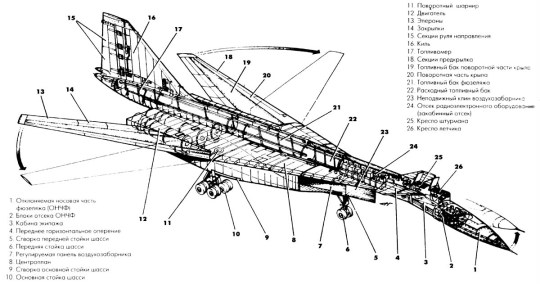
Sukhoi’s original design study had its origins in several projects predating this latest bomber effort. Derived from the T-4, the T-4M was designed to meet both the ambitious recent bomber requirements as well as Soviet Navy requirements for a high-performance maritime strike platform. It was slightly larger than the T-4, with a loaded weight about 20 tons more than its predecessor, and it added things like a third crewman and swing-wings to the design. However, the T-4M preserved the unique figure of the T-4, retaining the canards, four RD-36 engines, and drooping nose. Unfortunately, the project ran into issues, primarily relating to aeroelastic deformation of the new wing. Meanwhile, the finalized requirements for the new bomber were released, revealing a payload requirement of 45 tons - well in excess of the T-4M’s design payload of just 18 tons. With the project already struggling and now not even capable of meeting requirements, Sukhoi finally dropped it, moving on to a fresh design study.
Myasishchev M-20
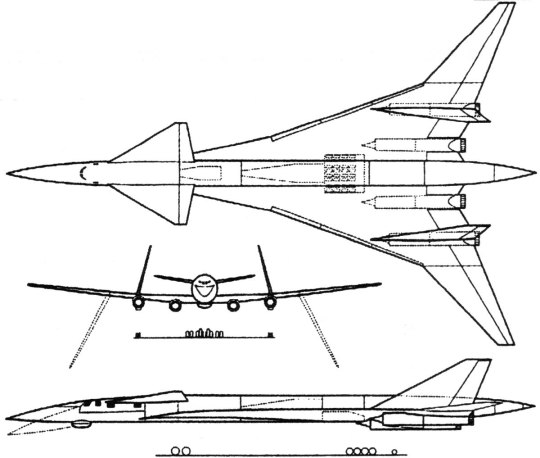
Myasishchev’s M-20 series design studies would take a similar multirole approach as seen in many other contemporary bomber projects. Apart from the more recent requirements, the M-20 studies were aimed at creating a long-range antisubmarine strike, strategic reconnaissance, and transport interdiction platform. It appears that three general layouts were settled on, all sharing the M-20 designation. The M-20-I was a conventional design with a takeoff weight of 150 tons and a shoulder-mounted swept wing giving it a rough resemblance to a massively scaled-up F-111. The M-20-II design studies were more radical, incorporating a cranked-arrow wing with drooping wingtips for better supersonic performance and a canard layout, all while doubling the takeoff weight. The final, most promising design - the M-20-III - was a 300-ton monster vaguely reminiscent of Sukhoi’s T-4M, with a distinct fuselage, swing-wings, and engines mounted on the underside of the aircraft. This would be the final design submitted in 1972.
Tupolev 160
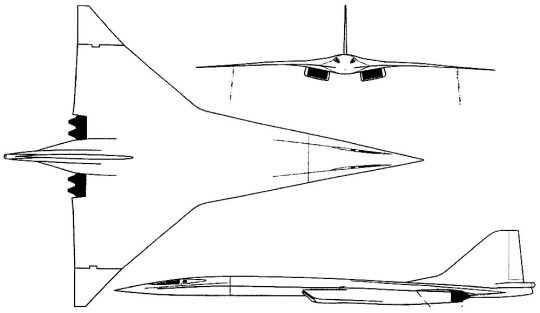
In 1970, Tupolev finally joined in the new bomber effort with their project 160. Capitalizing off of experience with the Tu-144 SST and planned Tu-244 successor, the 160 refined the design into a supersonic bomber. Unsurprisingly, the 160 ended up sharing the same cranked delta wing of the OKB’s SSTs. However, it featured a far flatter fuselage blended into the wing, reducing drag and providing a fair degree of lift from the body. Unusually, instead of working to meet the Mach 3 cruise requirements, Tupolev aimed for a Mach 2.3 cruise that the 160’s wing planform had already been validated on. It appears higher supersonic speeds would be attainable, and the wingtips were designed to droop to aid in Mach 3 flight. Ultimately, the 160 was rejected, and it would not form the basis for Tupolev’s final design.
Sukhoi T-4MS

After the abandonment of the T-4M, Sukhoi began a new design study under the designation T-4MS. Though the T-4MS shared the designation of the earlier supersonic bomber projects, the new design was an entirely new creation. Coming in at around 200 tons, it was roughly twice the size of the T-4 and T-4M, and a large blended wing/body with variable sweep outer wing sections would replace the distinct fuselage of the predecessors. The spacious wing and fuselage allowed for a massive internal bomb bay and impressive fuel capacity, providing for a projected range of 14,000km at subsonic speeds and 9,000km at Mach 3. In addition, the T-4MS was projected to be able to break the speed of sound at low altitudes. Maximum payload was to be 24 cruise missile carried internally with a weight of 45 tons, while standard payload was a more conservative 9 tons of missiles. The project was initially declared the winner, but Sukhoi’s factories at the time were far too busy with production of the Su-24 and T-10/Su-27. Tupolev examined the design with the possibility of producing the aircraft at their facilities, but they declared it unfit, instead opting to work with the competing Myasishchev design to create a production aircraft.
Myasishchev M-18
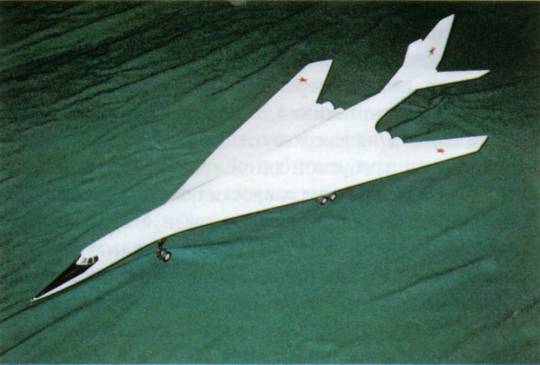
Following the revision of project requirements, Myasishchev would produce a new design for the final round of selection. Basing their proposal off of the last M-20 design studies, the M-18 that took shape was a sleek 150 ton machine with a conventional tail and a fuselage blended into the wings. As with most of the other proposals, swing-wings were incorporated, giving the M-18 the appearance very similar to the American B-1. The M-18 was a promising design, but it fell short in some areas - payload, for example, was to be just two Kh-45 missiles. Nevertheless, it was the runner-up design behind Sukhoi’s T-4MS, and thus received support for development as a backup. Because Myasishchev lacked the resources to further develop the design, it was passed onto Tupolev, who enlarged it into what would become the T-160.
Tupolev Tu-160

Though Tupolev’s initial project 160 would come in dead last during the final selection, they lucked out when Myasishchev was found to not have the facilities to fully develop their M-18 design. Tupolev, with far more experience with heavy bomber development, was given the design, refining it and enlarging it into a 250 ton monster with a 40 ton payload. The original designation - Tu-160 was retained - but in reality the new bomber had almost nothing to do with Tupolev’s original project. By the middle of the decade, it was determined that Sukhoi also lacked the facilities to manufacture their bomber while also handling production of the Su-24 and Su-27, and, while Tupolev was asked to produce the T-4MS, the refused. In place of the T-4MS, Tupolev would produce the Tu-160, finally emerging as the winner of the decade-long program.
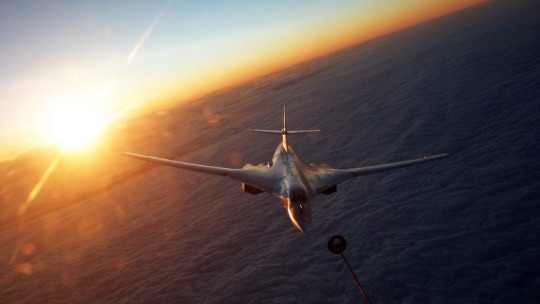
The Tu-160 that would take flight in late 1981 was a far cry from the original Tupolev design or Sukhoi’s T-4MS. The Blackjack, as it was known to the West, was a massive swing-wing bomber vaguely similar in appearance to the American B-1B. Four NK-32 turbofans provide the Tu-160 with the ability to reach speeds of Mach 2, while twin tandem bomb bays allow the bomber to carry a payload of up to 40 metric tons of stores. Normally, the bays carry six Kh-55 missiles each in rotary launchers. The end result of over a decade of development was the largest combat aircraft in history. Although the project was shifted to Tupolev to fast-track production, deliveries of the Tu-160 were painfully slow - the first pre-production aircraft wasn’t delivered until 1984, and the Blackjack only became operational in 1987. By the time the Soviet Union collapsed, only 35 Tu-160s had been completed.

The dissolution of the USSR saw a significant portion of the Blackjack fleet fall into the hands of a Ukrainian government that was fairly hostile to Russia. Although Russia worked hard to secure the return of the aircraft, Ukraine scrapped nine bombers and turned another into a static display, meaning that only nine Ukrainian Tu-160s would ever fly again. Meanwhile, attrition took its toll on the fleet, even as production lines remained operational (albeit at a glacial pace). Active numbers have dropped to just 20 aircraft in recent years, and although the Russians have restarted production of the type, budget limitations mean that Blackjack numbers will likely remain low for the foreseeable future.

Given the late arrival of the Tu-160, operational service has been mainly limited to doing what Russian bombers do best: flying absurdly long distances to molest other countries’ airspace. These patrols resumed in 2007, with Blackjacks probing the airspace of various Baltic countries. In 2008, they participated in the largest Russian strategic bomber exercise since 1984, marking the first time the bomber fired its full complement of missiles. In 2008 and 2013, Tu-160s made nonstop flights from Russia to Venezuela, flying through international airspace, as a show of support. Unfortunately, the Tu-160’s fairly uneventful service history takes away from its significance - it marks the largest combat aircraft ever, as well as the largest supersonic aircraft and the highest-payload combat aircraft ever.
Sukhoi T-60S

In 1983, Sukhoi was tasked with developing a new intermediate-range strategic bomber to replace the T-22M. Given the internal designation T-60S, the general design was taken from the T-4MS, but it was considerably scaled down, keeping gross weight at 85 tons. While basic elements like the swing-wings and wide, flat body remained, the T-60S incorporated some new features, most notably two experimental dual-core variable-bypass engines fed by top-mounted intakes. The engine would operate as a high-bypass turbofan for regular cruise, while this bypass air would be diverted to a second engine core for high-speed dashes, effectively switching back and forth between a twin-engined high-bypass turbofan layout and a four-engined turbojet. Few details are known beyond the novel powerplant, though it appears the project survived the initial post-Soviet culling of design projects. No word has come from it for some time, though it appears the project was put on hold rather than cancelled in the mid’90s.
Tupolev Tu-230
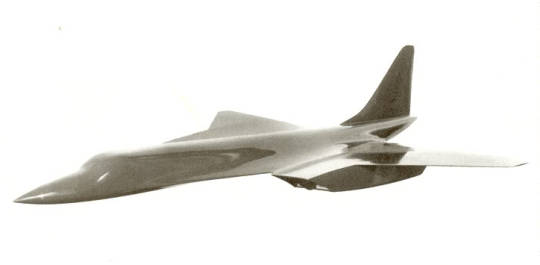
Even as the Tu-160 development concluded, there were plans in place for an even more capable bomber. Through the ‘70s, Tupolev had been conducting hypersonic research, aiming to create strategic bombers with Mach 4 and Mach 6 capabilities. The Mach 4 proposal would be given the internal designation Tu-230, with development beginning in 1983. Completed in 1985, the Tu-230 design was to be a two-man bomber with a gross weight of 180 tons. It used a cranked delta layout similar to previous Tupolev projects, while power was to come from four D-80 engines fueled by liquid hydrogen. Cruising at nearly 30 km, the bomber was expected to have a range approaching 10,000km. The project would never leave the drawing board, as it appears it was killed by the end of the Cold War.
Tupolev Tu-360

Tupolev’s Mach 6 bomber project would proceed under the designation Tu-360. Aimed at creating a bomber with a 15,000km range, Mach 6 cruise speed, and 10 ton payload, the Tu-360 was to use a dual-mode turboramjet. For low-speed operations, the Tu-360 would rely on its six turbojets for propulsion, while cruising flight would bypass these to use hydrogen-fueled ramjets. Unsurprisingly, the Tu-360 proposal was massive. Though it had just a crew of two, it was to have a gross weight of 350 tons, of which 100 tons was the fuel. Even with such a massive platform, the final projections for the design fell short of original goals - the Tu-360 had a practical range of just 8,000km. Given just how similar the Tu-360’s operating conditions were to the planned Tu-2000, the project would share a good deal of development work. However, the Tu-360 would come to an end in 1992 after the USSR collapsed.
Tupolev Tu-2000
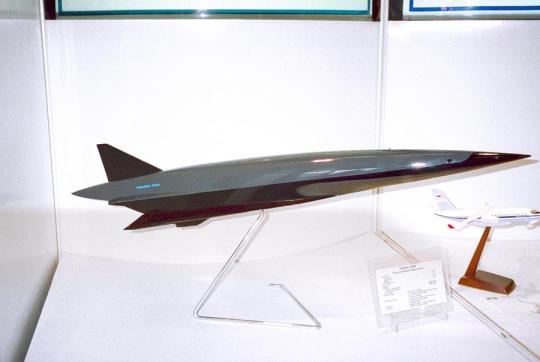
In 1986, having learned of the American X-30 spaceplane project, the Council of Ministers ordered Tupolev to produce a SSTO capable of serving as a bomber. Making extensive use of previous work with hypersonic designs, Tupolev took these concepts to the extreme with the Tu-2000. A variable cycle turboramjet fueled by hydrogen and methane would power the aircraft to Mach 6 in the atmosphere or Mach 25 in orbit. Tupolev planned to create a tech demonstrator - the Tu-2000A - that would be of reduced size to determine the feasibility of Mach 6 flight at 30km. If it succeeded, Tupolev planned for a full-size Tu-2000B to serve as a bomber (Mach 6 cruise, two-man crew, 10,000km range), while a separate SSTO would be used for space launches. The Tu-2000B would be 350 tonnes (150 of which were fuel) and powered by eight turboramjets. To reach orbit, the SSTO would be supplemented by a scramjet or rocket booster. The Tu-2000 actually got fairly far along in development - Tupolev was building structural elements and cryogenic fuel tanks and lines by the time lack of funding killed the project in 1992.
10 notes
·
View notes
Text
/k/ Planes Episode 94: Cripple Fight!
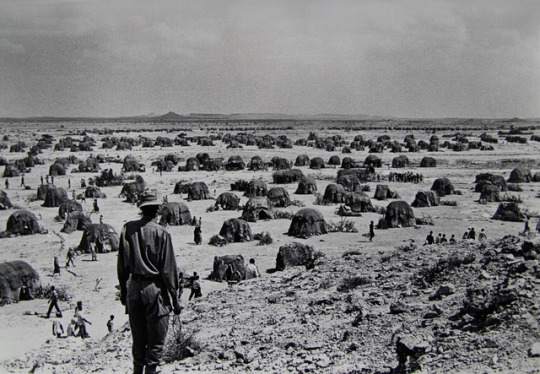
It’s time for another episode of /k/ Planes! This time, we’ll be looking at the Ogaden War between Ethiopia and Somalia in 1977.
Ever since the Horn of Africa decolonized, the predominantly ethnic-Somali region of Ogaden has been a major point of contention between Ethiopia and Somalia. In 1977, these tensions peaked, culminating in a full-blown war between the two nations. The war would be one of the more interesting conflicts in postcolonial Africa, as the pro-Soviet Somalis would be dropped by their former allies, who turned to back the formerly American-aligned Ethiopians, while the West stepped in in Somalia to get a new regional ally to replace the Ethiopians. Despite being a conflict between third-world nations, the Ogaden War would be notable for its quite impressive air campaign, particularly on the Ethiopian side.
The Belligerents: Ethiopian Air Force

Unusually for an African power, the Ethiopian Air Force was quite a capable force. Since the restoration of the monarchy after WW2, Ethiopia had worked hard to create a capable air force, forgoing quantity and aiming for quality instead. Getting their start with Swedish help, they soon fell under the influence of the United States, giving their pilots access to some of the best pilot training programs in the world. Unfortunately, this apparent benevolence did not extend to exports - despite efforts to procure F-4 Phantom IIs, the EtAF was only able to procure a small force of F-5As and F-5Es before US support was withdrawn in the aftermath of the 1974 Coup. Though American support cut the best training programs, the EtAF hardly declined by 1977. The bulk of their fleet - aging Swedish trainers and F-86Fs - may have been retired before the war broke out, but the EtAF remained capable. Unlike their Soviet-trained foes, they were well prepared for air combat and independent action, and, with the help of well-placed American-supplied radars and excellent maintenance personnel, the EtAF would prove far superior to their numerically superior foes.
The Belligerents: Ciidamada Cirka Soomaaliyeed

Like many African nations, Somalia had fallen under the Soviet sphere after they gained independence in 1960. Whereas Ethiopia had received only fairly reluctant support from America, the Soviets were enthusiastic to have a base in the Horn of Africa, supplying the Somalis with large amounts of equipment, advisors, training. Their Air Force ballooned as they received not just fighters and trainers, but transports, air defenses, and even the odd bomber. Unfortunately, the training they received would prove poor. Soviet fighter training emphasized ground-controlled interception and did little to prepare crews for independent operations. Whereas Soviet doctrine was decidedly defensive in nature, the Somalis would find it poorly suited to the offensive war they were fighting. Worse, their short-ranged MiGs were unable to provide adequate coverage over the battlefield, forcing the Somalis to yield the skies to their foes.
The Belligerents: Defensa Anti-Aérea Y Fuerza Aérea Revolucionaria

When foreign support for Ethiopia finally arrived in late 1977, a small detachment of Cuban advisers from the DAAFAR was among the forces pouring into the country. While they were originally intended to aid Ethiopian pilots in the conversion to the MiG-17s and MiG-21s flooding into the country, they would instead fly the foreign aircraft (diverted from Yemen’s stocks) for the Ethiopians as the 4th Squadron. Outfitted with a mix of MiG-15UTI trainers and MiG-17F and MiG-21MF fighters, language barriers largely prevented them from flying alongside Ethiopian fighters. Rather, they operated largely independently, flying missions in support of Cuban ground forces while the Ethiopians supported their own forces. Although the Cuban detachment flew aircraft more suited to interceptor operations, by the time they were flying over Ogaden, the skies had been cleared of Somali aircraft. As such, the Cubans instead spent their time in Ethiopia flying strike missions.
The Aircraft: Northrop F-5A/B Freedom Fighter
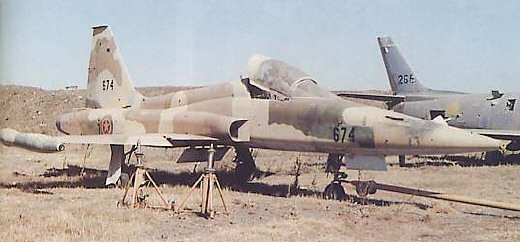
In the mid-60’s the EtAF had acquired a squadron’s worth of F-5As. Flying with the 5th Squadron, they numbered about 18 aircraft by the time the war began. Among them were two F-5Bs and a single example converted to the RF-5A standard for reconnaissance. Unlike many foreign F-5As, 5th Squadron’s Freedom Fighters were never outfitted with avionics for the AIM-9B. Though they retained the twin onboard cannon, the inability to use the Sidewinder meant that they would be kept out of fighter operations during the war. Instead, they served as strike aircraft, able to make diving attacks with relative impunity on the exposed Somali supply lines. Though on paper they were inferior in performance to the Somali MiG-21s, skillful use of patrolling fighters and the two radars Ethiopia had looking out over Ogaden allowed 5th Squadron to remain relatively safe.
The Aircraft: Northrop F-5E Tiger II

Just before US support ended in 1976, the EtAF managed to procure 8 F-5Es complete with AIM-9B missiles. Though support cut off just after the aircraft arrived, the EtAF successfully transitioned 9th Squadron’s pilots to the type, finally giving them a fighter on par with Somalia’s MiG-21s. Though the Tiger II had a significantly slower top speed than the MiG-21, it was in most respects far superior to the Fishbed. It was more agile than the MiG-21 at most speeds, and the cockpit ergonomics - everything from visibility to pilot workload - were vastly superior. Just as important, the F-5E had nearly double the range of the MiG-21, allowing for longer patrols and further strike missions than the Somalis could fly. Thanks to adequate stockpiles of spares and excellent maintenance personnel, the 7 flying F-5Es (one was lost in a rocket attack before the war started) of 9th Squadron would be a constant force over Ogaden, allowing Ethiopia to secure air supremacy.
The Aircraft: English Electric Canberra B.52

After reaching a dead end with talks to procure a viable counter to Somalia’s bombers from America, Ethiopia looked to Britain in 1968 to purchase four Canberra bombers. Modified for COIN duties to reduce protests from the US, they entered service with the 44th Bomber Squadron. Though one bomber was lost when its pilot defected to Somalia after the Derg coup, the three remaining bombers were serviceable when war broke out in 1977. Like the F-5As, they performed vital strike missions, primarily targeting vulnerable enemy supply lines. Being less agile than the F-5s, they were forced to perform more vulnerable approaches, but overall they performed reasonably well during the conflict.
The Aircraft: Mikoyan-Gurevich MiG-17F “Fresco”

Somalia’s modest MiG-17 fleet, contemporaries of Ethiopia’s (now retired) F-86Fs, were among the oldest aircraft in the Somali inventory. 40 examples were delivered to Somalia soon after the country gained independence, but poor training and low readiness rates meant that by 1977 they had been reduced to roughly 30 examples across two squadrons. The MiG-17Fs of the Somali Air Force were assigned to fighter-bomber squadrons, flying strike missions in support of ground forces. Unfortunately, the MiG-17 was poorly suited to the role. Though its formidable cannon armament was useful for strafing duties, the fighter’s two pylons gave it a payload of just 500kg of stores in the form of unguided rockets or bombs. Worse, the two hardpoints were the only place external fuel tanks could be mounted, so the operational range of the MiG-17F was very limited. They did what they could to support ground forces, but Somalia’s MiG-17s were unable to make a significant impact on the conflict. The MiG-17F would also fly in Cuban hands exclusively as a strike aircraft. Though glaringly obsolete, they flew against no fighter opposition from bases far closer to the front, so their service was considerably more distinguished.
The Aircraft: Mikoyan-Gurevich MiG-21MF “Fishbed”

At the outbreak of war, Somalia’s fighter force consisted of 29 MiG-21MFs across two squadrons. On paper, they had superior performance to Ethiopia’s F-5s, but they were hampered by their short range and lack of an early-warning network. A standard payload of four R-3S AAMs was often reduced to two for patrols, as Somali MiG-21s often carried three drop tanks to extend their range. Unfortunately, performance of the Somali MiG-21s was nothing short of abhorrent, despite their numerical advantage. Poor training meant an otherwise fairly even matchup was heavily in favor of their opponents, and readiness rates for the aircraft were perpetually low. The Cuban-flown MiG-21s that appeared in the later part of the war performed better, however. With the skies cleared of Somali fighters, they were tasked with ground-attack duties, mounting FAB-250 bombs and rocket pods for missions. The Ethiopians also were converting to the type during the war, but they were unenthusiastic about the MiG-21 for a variety of reasons, so it usually remained second to the F-5.
The Aircraft: Ilyushin Il-28 “Beagle”
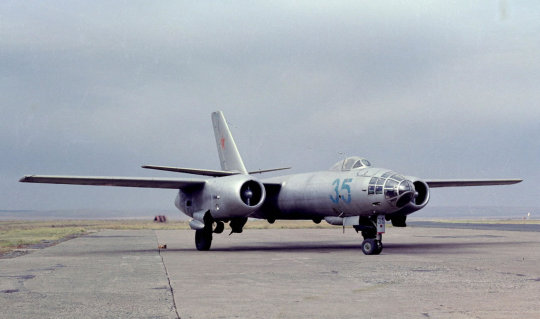
Around the turn of the decade, Somalia had acquired four Il-28 bombers. Flown by MiG-17 pilots, the aircraft had the potential to be decisive back when they first arrived, but by the time the war actually came to Ogaden they were outdated. Only three Il-28s remained in service by the time the war began, none of which would survive the war. They would support the initial invasion, but they were fairly ineffective thanks to the decision to make high-altitude bombing runs. Once the EtAF began to contest the skies, the Il-28s were withdrawn from combat, remaining at their airfields until Ethiopian air strikes took them out.
The Aircraft: Mikoyan-Gurevich MiG-23BN “Flogger-H”
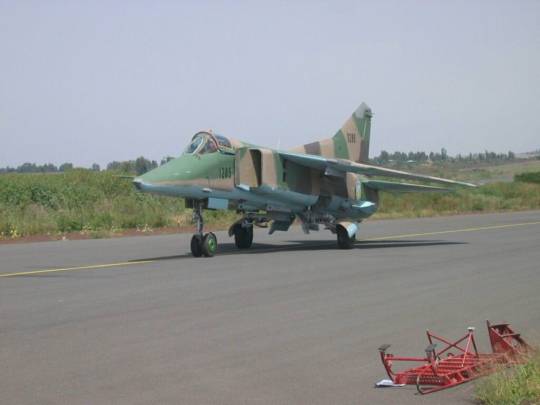
With the onset of Soviet support for Ethiopia, the EtAF ordered 100 MiG-23BNs. Optimized for strike missions, it offered to provide the EtAF with unparalleled strike capabilities. Though its range and payload were on paper little better than the F-5, the MiG-23BN had a vastly improved nav/attack suite, the ability to use guided munitions, and low-altitude supersonic capabilities. Unfortunately, the war would be mostly over by the time MiG-23BNs actually started to enter service. They flew some sorties in the closing stages of the war, and they continued to support counterinsurgency operations after the official end of hostilities, but, despite a reputation for robustness, loss rates were unusually high. This can likely be explained by a combination of the MiG-23’s infamously high pilot workload and the generally poor training the Ethiopian pilots were receiving from the Soviets.
Background
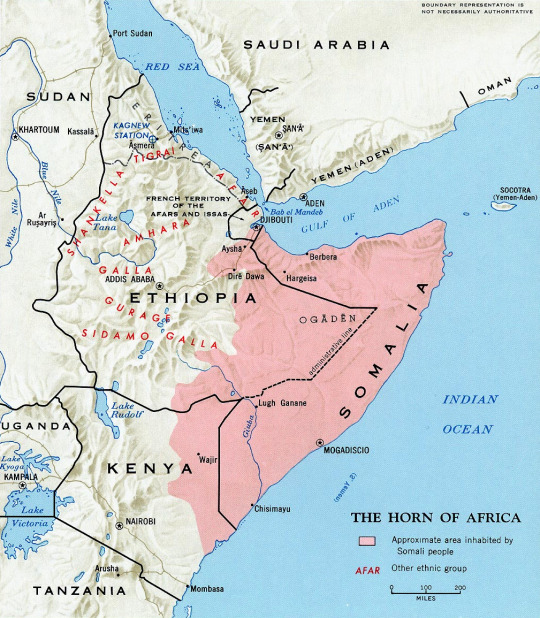
The origins of the Ogaden War can be traced back to the 19th century, when the kingdom of Ethiopia’s borders became defined by the arbitrary borders created at the Berlin conference. Though Ethiopia would itself become a colony after Italy invaded in the ‘30s, the liberation of the country in 1941 saw the country’s pre-war borders restored. Unfortunately, the eastern end of Ethiopia, known as Ogaden, was largely ethnic Somali. While the borders during colonial times meant little to the locals, the creation of the modern state of Somalia saw a surge in Somali nationalism to create what was known as “Greater Somalia.” Greater Somalia encompassed most of the Horn of Africa, spanning not just the current country of Somalia, but also Ogaden and northern Kenya. Soon after Somalia gained independence, they began actively sponsoring insurgency movements in these disputed regions, leading to tensions with Ethiopia.
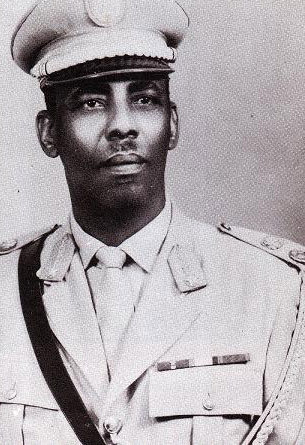
In the decade or so leading up to the war, tensions skyrocketed. In 1969, a coup put Siad Barre in control of Somalia. He worked hard to expand the military, getting large shipments of Soviet AFVs and MiG-21s. Meanwhile, Ethiopia was busy suppressing a rebellion in Eritrea, sapping their resources away from the threat to the east. By 1974, unrest in Ethiopia had hit a tipping point, culminating in a coup that installed the Derg (a collection of top military officials) as the new leaders of Ethiopia. The Derg tried to maintain the good relations the deposed Emperors had enjoyed with the US, but by 1976 this had fallen through, and all US support had been withdrawn. As the turmoil in Ethiopia continued, the Somalis silently prepared their positions on the border for the coming invasion.
Kicking Things Off
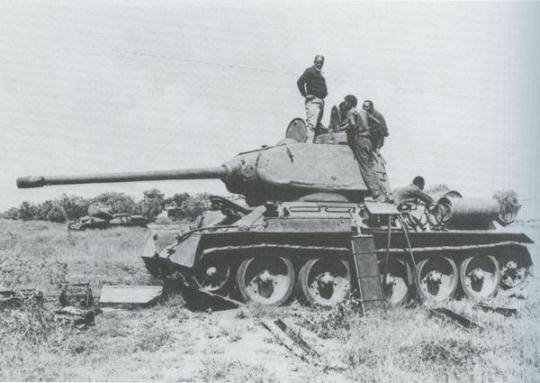
At 0300 on July 13, 1977, five Somali brigades crossed the border into Ogaden, officially starting the Ogaden War. As the Somalis had severed diplomatic relations two weeks earlier, the invasion came as a surprise to the Ethiopians, who initially took the attack as merely an unusually strong insurgent effort. The Somali forces pushed their way towards Gode, reaching the town around dawn. There, they met stiff resistance from the Ethiopian 5th Brigade, so the CCS was called into action. 50 sorties were flown against Gode in the early morning, but they were unable to dislodge the enemy. The fighting bogged down, and the Somalis were forced to bear down on the town with aircraft and artillery.

Fighting carried on to the next day, by which point the EtAF was called into action. Still unaware of the scope of the battle, three F-5As were sortied to strike the enemy. The lead plane, experiencing radio problems, took the number two position and handed command off to his wingman. Though the aircraft made their attack run successfully, the leader’s aircraft was targeted by at least one SA-7. Unable to hear the warnings from his wingmen due to a faulty radio, the pilot’s first warning was the SA-7 smashing into the left side of his aircraft. With the Gode airfield out of action due to Somlai shelling and his aircraft too stricken to make it home, the flight leader ejected. The pilot made it back to friendly forces alive and well, but this marked the first combat loss of the war. The EtAF responded quickly. Attack profiles were modified, calling for medium-altitude dive bombing that kept the aircraft out of the engagement envelope of the SA-7 until their final approach, or, alternatively, a low-altitude attack followed by an egress towards the sun to prevent the SA-7 from getting a lock.
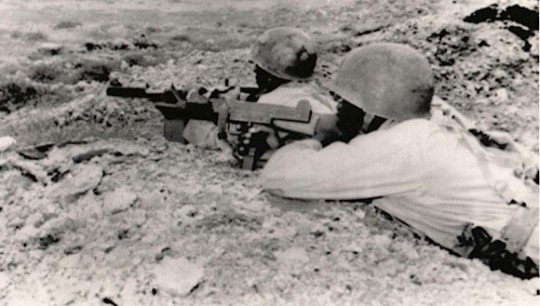
On the northern border of Ogaden, things remained quiet for the first couple of days. Still operating under secrecy, the Somalis moved under cover of darkness, reaching the town of Aisha on July 16. As the assault on the town began the next morning, the CCS again backed up the offensive with MiG-17s and a single Il-28, along with MiG-21s flying top cover. The bomber sorties opened up the assault, after which artillery began bombarding the town. Ethiopian early warning radars spotted the Il-28, which was flying high like a civilian airliner, and a pair of F-5Es was sortied from Dire Dawa to intercept. Meanwhile, further sorties were flown in defense of the town, just as had happened over Gode.
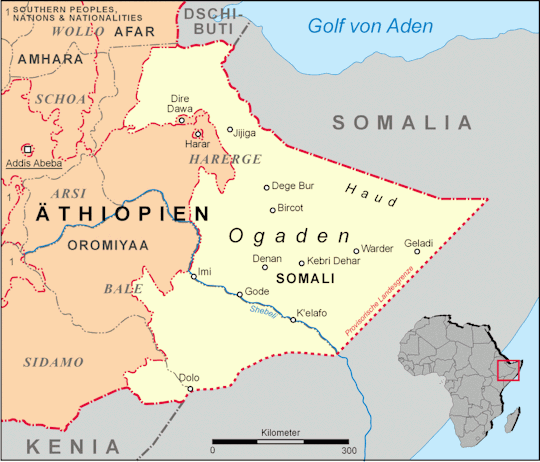
Just days after the outbreak of war, the situation was critical for Ethiopia. The Somalis were streaming across Ogaden, and those garrisons that did not fold were being enveloped and slowly overrun. All the while, the EtAF was scrambling to contain the situation. Pilots were flying as many as three sorties a day, guided by the TPS-43D radar at Karamara Pass, but they were unable to alter the course of the battle. The F-5Es were particularly aggressive, getting into air battles on June 16 and June 20, but stringent reporting standards and the chaotic situation meant that none of the pilots were credited with any victories.
A Panicked Response
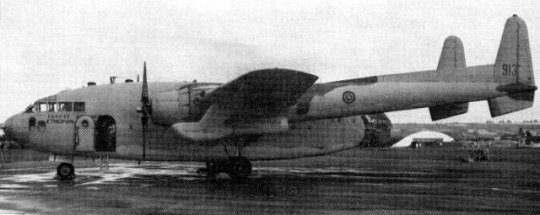
On July 21, the Ethiopians finally began to muster a coherent response. Still unaware that the enemy was not just insurgents but the Somali Army, they sortied most of their fleet of DC-3s and C-119s to resupply the garrisons cut off by the advancing enemy. During one of these missions, a DC-3 was intercepted by two CCS MiG-17s. The DC-3 maneuvered hard to evade the enemy, making tight, low-level turns, but eventually it was riddled with cannon fire and forced down. Two of the seven aboard were killed, and the remainder were captured by the Somalis.

As the resupply effort began, the CCS finally, definitively announced their presence over Ogaden with an airstrike on Harar airfield. The strike caused minimal damage, claiming only an Ethiopian Airlines DC-3, but this, coupled with the loss of the DC-3 over Ogaden, finally alerted the EtAF to the true scope the conflict. Regular F-5E patrols began in earnest, and F-5s were to be airborne whenever a transport was over the combat zone. These patrols ultimately paid off - on the afternoon of July 24, a pair of F-5Es were vectored to intercept two MiG-21s heading towards a transport. Thanks to the expert guidance of the radar operators, they rolled in right behind the unsuspecting enemy. The two F-5s engaged the Somali flight in a brief engagement. The leader survived the opening shots and promptly sped off to safety, but the Somali wingman was downed, marking the first air-to-air victory of the war, and, more significantly, in EtAF history.

The very next day, the EtAF scored an even greater victory. Three F-5Es sortied to intercept four MiG-21s, coming in at high altitude above them. The MiGs apparently spotted the formation, as the two wingmen peeled off to engage. Unfortunately, this is where poor training set in - the two MiGs performed 180 degree turns before smashing into eachother head-on. The leader of the F-5s engaged the number 3 MiG, downing it with cannon fire, while the two others forced the survivor into low-speed evasive maneuvers that ended with the unfortunate MiG crashing into the earth. As they recovered, the F-5s spotted a formation of four low-flying MiG-17s, which they then turned to engage. Two MiG-17s were downed in quick succession by Sidewinders, but the victorious pilots were forced to turn back before they could finish off the final two MiGs due to low fuel. Ultimately, the strict reporting standards of the EtAF (maneuver “victories” weren’t counted as kills), only three of the downed aircraft were counted towards the pilots’ totals. Whatever the case, the impact on the Somalis was severe - in just two days, they had lost five MiG-21s and two MiG-17s along with their pilots.

A new day would bring yet another round of air combat, again ending with the EtAF on top. Two F-5Es were vectored to intercept two MiG-21s, but they failed to achieve surprise as the approached head-on. The MiGs split off to attempt to sandwich their foes, but the F-5s merely turned to pursue the leader. Maneuvering into position, they fired a Sidewinder, damaging the MiG and forcing it into a series of hard turns. As the MiG bled sped, the F-5s closed in for a gun kill. The F-5’s 20mm cannon cut the fighter apart, and it fell into a spin that lasted until it hit the ground. As the Ethiopians slaughtered the flight lead, the other MiG took the opportunity to flee.
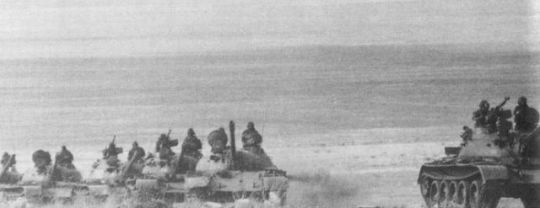
For all the exhaustive efforts in the air, the Ethiopians could do little to reverse the situation on the ground. Gode fell on the morning of July 25, with the 5th Brigade withdrawing westward. By the end of the month, the situation to the north was far more critical. The planned withdrawal from Kebri Dehar had devolved into a disorganized rout, and by the end of the month the Ethiopians were reforming their defenses over 300km away at Jijiga. The balance in the skies was decidedly in favor of the EtAF - for the loss of just a single F-5A and a DC-3, the Ethiopians had downed one way or another at least nine MiG-21s and six MiG-17s. The EtAF was further refining tactics to clear the skies of Somali fighters, but for all their success, they could not alter the hopeless state of affairs on the ground.
Standing Firm
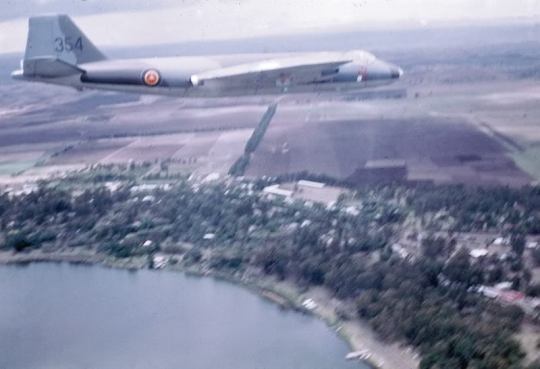
By early August, the front had stabilized, albeit not exactly in Ethiopia’s favor. The F-5As had flown nearly 300 strike sorties over the opening weeks of the war, and the focus of such missions gradually shifted to more strategic targets. Unable to effect the battle through direct intervention, F-5As and Canberras switched to interdiction sorties. These strikes, aimed at the vulnerable Somali supply lines, were tremendously effective. Post-strike reconnaissance revealed that the Somalis regularly lost upwards of 20 vehicles in every attack and forces on the front were soon feeling the effects. Nevertheless, the impact was still far from decisive - militias armed with small arms and molotov cocktails were still no match for undersupplied armored divisions.
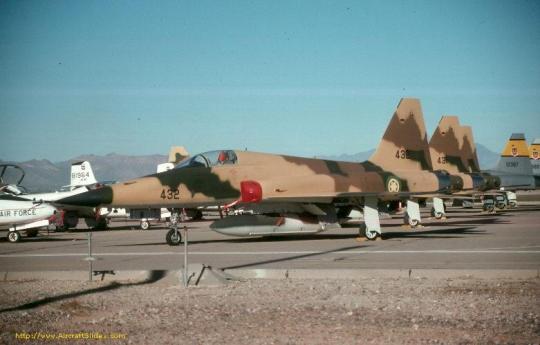
On August 12, the EtAF took the fight to Somalia for the first time. Four F-5Es outfitted for attack were sortied to strike the CCS base at Hargeisa. Splitting into pairs, they made two low-level passes, catching the Somalis off guard. The first pair cratered the runway, followed by a rocket attack from the second pair that destroyed one of the three precious Il-28s. The attackers then turned for their next run, one pair hitting the fuel dump and the other strafing the control tower. As the fighters turned for home, the airfield was devastated. At least one Il-28 and AN-26 had been destroyed, and several other aircraft likely were damaged or destroyed in the attack. Having caught the enemy completely by surprise, the F-5s weren’t even opposed by any air defenses.
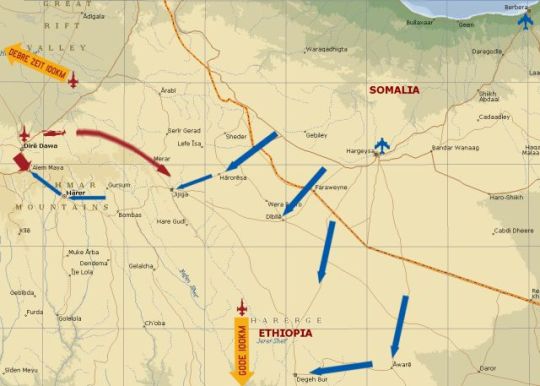
On the ground, the Ethiopians were now funneling all their resources into Ogaden. Forces were withdrawn from the ongoing conflict in Eritrea and sent to Harar and Jijiga to bolster defenses. By now, the Somalis had control of 80% of Ogaden, and they were threatening to advance into Ethiopia proper. With the Somalis now deep inside Ethiopia, the F-5s were withdrawn from Dire Dawa to Debre Zeit further to the rear. The 3rd COIN Squadron’s T-28s remained at Dire Dawa to provide CAS and reconnaissance for ground forces, but the bulk of the EtAF had been withdrawn.
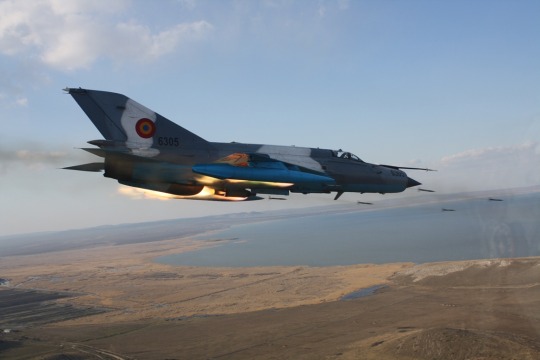
Hoping to make up for their heavy losses, the CCS spent the first half of August striking back. Unfortunately, the CCS proved it could fail at its mission without the help of the EtAF. Two MiG-21s sent to strike the airstrip at Aisha were both downed on August 11, and, when two MiG-17s were sortied to strike the radar at Karamara on August 14, both were lost when they crashed into the mountains. Though the EtAF’s fighters were forced to retreat to a safer base, they remained firmly in control of the skies.
Battle of Dire Dawa
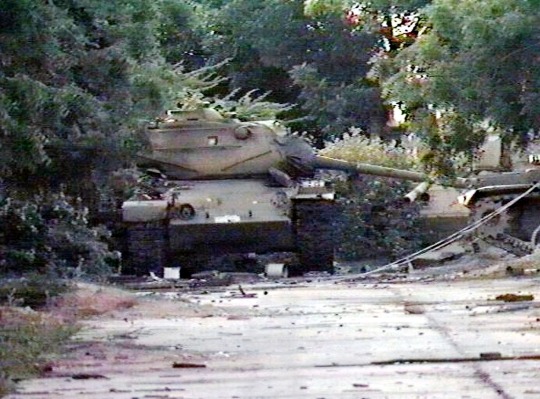
On August 17, the Ethiopians were caught by surprise when the Somalis began an assault on Dire Dawa. In the predawn hours, the Somalis moved onto the unprepared town. The EtAF sortied in support, while the CCS was notably absent. Though sorties continued throughout the day and EtAF fighters even managed to claim a MiG-21, the airfield at Dire Dawa fell to the Somalis that evening. The few T-28s that remained operational were destroyed, along with eight Saab B.17 trainers and much of the airbase infrastructure. By the end of the day, the Somalis were in control of most of the town.
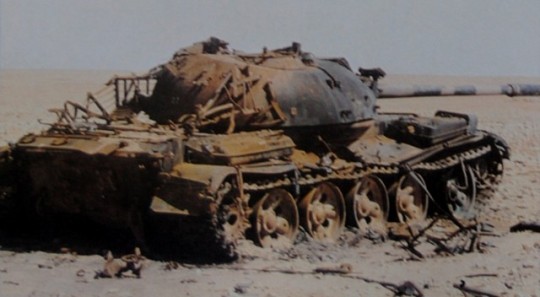
The Ethiopians launched a counterattack the next day. With little artillery to support them, the burden of ground support fell entirely upon the EtAF. Two F-5Es flew CAP, but, with the CCS nowhere to be seen, the EtAF soon began strike missions unopposed. 68 sorties were flown against the enemy by F-5s and Canberras, ravaging their forces. The EtAF was credited with destroying 16 T-54s and 80% of the enemy vehicles present, allowing friendly forces to recapture the airbase. Fighting continued across the rest of the town, but the important air base was back in Ethiopian hands.
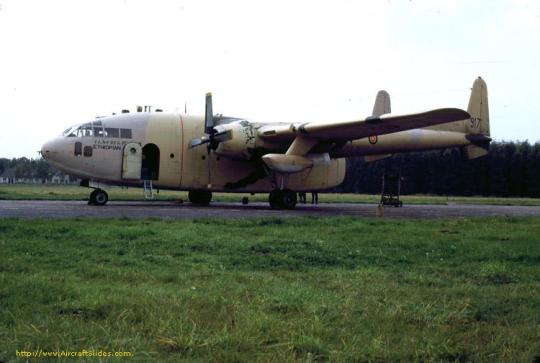
Over the next several days, the Ethiopians retook Dire Dawa. A lone MiG-21 was downed over the airfield on August 19, and in the coming days the air base was returned to operational condition. The now-cleared runway started to receive C-119s and F-5s on August 21, allowing the EtAF to resume sorties with an incredible tempo. The next day saw 50 sorties flown against the Somalis, with pilots flying up to eight sorties that day. The pace of the sorties would break the Somalis. An enemy withdrawal turned into a rout, and the retreating enemy left behind a trail of abandoned artillery, rifles, and vehicles. The recapture of Dire Dawa and clear air superiority the EtAF now held allowed for the resumption of supply missions to the isolated garrisons across Ogaden. Just as before, the CCS tried to intercept the sorties, only to lose yet another MiG-21 in air combat.
Battle for Jijiga

Though Dire Dawa had seen some bitter fighting, the real struggle came to the east at Jijiga. The Ethiopians were expecting the assault there, so they put up a far more impressive defense of the area. However, with the EtAF focusing its efforts on Dire Dawa, the CCS enjoyed air superiority for the first time of the war. MiG-17s and MiG-21s were present in numbers, making brief runs over Ethiopian positions. Even when the EtAF finally turned its attention to the region, the situation was not looking good for the Ethiopians. A valiant defense could not overcome the Somalis’ superior firepower, so on September 1, the town was abandoned.
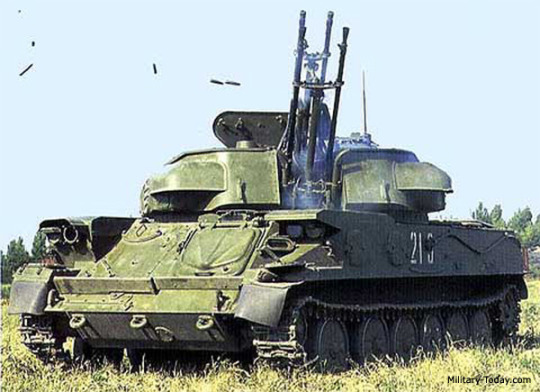
Over Jijiga, air battles sporadically popped up. On September 1, two F-5Es on a strike mission were diverted to intercept two MiG-21s, resulting in the final two aerial victories of the war. By now, the CCS had lost 12 MiG-21s and 13 MiG-17s, amounting to roughly half their air force. Though a Shilka managed to down the F-5E of Ethiopia’s top pilot later that day, leading to his capture, the war was hardly going well for the CCS. The initially outnumbered EtAF had lost just two F-5s, a DC-3, and a number of T-28s thus far in the war, putting the advantage now squarely in their hands.

The retreat from Jijiga would be brief, as the Derg organized a counterattack that retook the town on September 5. Battered and poorly supplied thanks to the EtAF’s efforts, the Somalis were initially unable to mount a response, instead opting to encircle the town. The CCS was ordered to support a renewed assault, but their response was anemic. Only four days after they were ordered to assist, on September 9, did the CCS appear over Jijiga in the form of two MiG-17s. The MiGs made an attack on a retreating Ethiopian column, only to have one of them caught by ground fire and brought down.
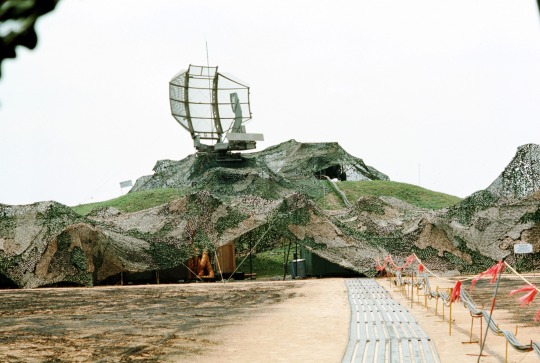
Even without the CCS aiding the, however, the Somalis now held the initiative. The Ethiopian retreat was devolving into a rout, and even the rapid sortieing of the EtAF wasn’t able to slow the Somali advance. On September 12, the Somalis reached Karamara Pass. Opening up with long-range artillery, they managed to knock out the TPS-43 radar that had proved so decisive earlier in the war. The assault that began later that day ended quickly - by the evening, Karamara Pass was in Somali hands. The loss of the Pass gave Somalia an open door with which to launch an offensive into the rest of Ethiopia. Just as bad, the loss of the radar forced the EtAF to reorganize. The radar at Debre Zeit was relocated to Mount Megezez, halfway between Addis Ababa and Karamara Pass. The EtAF could no longer rely on radar coverage as they flew over Ogaden.
Battle of Harar
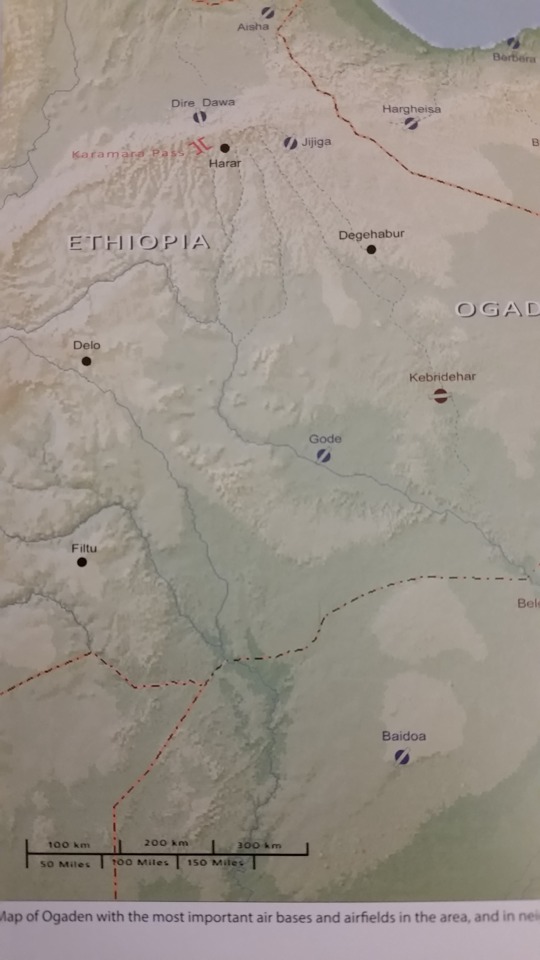
The capture of Karamara Pass would mark the high water mark of the Somali invasion. They had since pushed beyond the reach of the CCS and now well under the umbrella of the EtAF, and EtAF’s ongoing interdiction campaign along with the rapid advance had worn the Somalis too thin to continue their offensive. They dug in, holding their positions until October to consolidate in preparation for an assault on Harar. This gave the Ethiopians a much needed respite. Harar, surrounded on three sides by the Somalis and with the mountains at its back, was reinforced with the remnants of the battered Ethiopian forces and two recently arrived Yemeni tank battalions.

The Somalis began their assault on Harar in late September. Supported by the occasional sortie of MiG-17s, the effort went poorly. Aimed at a hill southeast of Harar, the bitter fighting saw the objective change hands multiple times. The battle soon devolved into trench warfare, and three MiG-17s were lost to ground fire during the battle. The final assault on the hill came on October 19th, but the Somalis were repulsed after suffering over 200 dead. On October 23, the Somalis opened up a new offensive on the northwest end of the pocket. Forces were rushed in to stop the assault, grinding it to a halt after causing another 600 casualties.

On October 30, another offensive came. Helicopters supported the defense effort by deploying two paracommando battalions, and the beleaguered defenders held their ground for almost a week. However, on November 4, the Somalis were finally gaining ground, forcing the Ethiopians to rush in the 2nd Paracommando Brigade. On November 16, the final Somali offensive of the year began. Aimed at the same place where the failed assault came on October 23, they supported the assault with intensive bombardment from BM-21s and sporadic MiG-17 sorties. The Somalis finally broke through, threatening to overrun the town, and only a desperate helicopter assault by the two paracommando brigades present managed to halt the enemy.

Behind the scenes, the EtAF had managed another major strategic victory. On November 16, two F-5Es, two F-5As, and two Canberras took off to strike the Somali forward base at Jeldessa. Unbeknownst to the EtAF, the base was the location of the main Somali ammunition depot, and consequently was heavily defended by mobile air defense systems. The first four aircraft made their attack without incident, but the two F-5As that made the final run were targeted by a now very alert and very angry enemy air defense network. One of the F-5s was heavily damaged by a Shilka during the attack run. Though it managed to make it back to base under its own power, the damage prevented it from lowering its landing gear. As there was no arrestor barrier available, the pilot opted to eject. Though the raid had cost the EtAF another precious F-5A, the impact on the Somalis was devastating - the entire depot was literally blown away. The Somali offensive had stalled, and they would never regain their momentum.
Soviet Aid
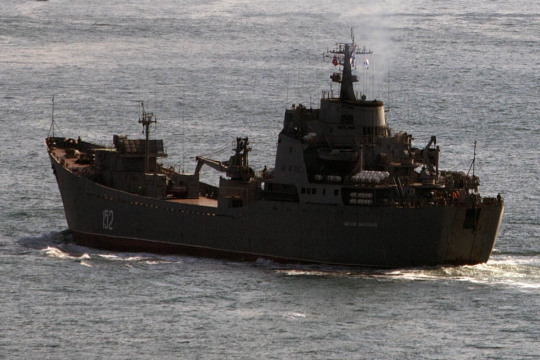
Just as the final Somali offensives were set to begin, the Somalis made a major blunder that upset the entire balance of power in the region. The Soviets were far less supportive of the Barre regime’s invasion of Ogaden then Barre had predicted, and, as the Soviets began to grow closer to Ethiopia, Somalia looked to the West for support. As Somali forces raged across Ogaden, Barre visited Moscow in an attempt to keep the Soviets neutral, all while negotiating with the West for arms shipments. Ultimately, however, all these efforts fell through. Though the West was happy to have an ally in the region to replace Ethiopia, they were reluctant to supply a nation taking part in an offensive war, so no weapons would ever come. Meanwhile, the Soviets were dismissive of Barre, and, when Leonid Brezhnev refused to meet with Barre when he visited Russia in early November, Barre lost his temper. On November 13, 1977, Somalia terminated its 20-year Treaty of Friendship with Moscow and expelled all 20,000 Soviet advisors and citizens.

This proved to be a fatal mistake. Though the Soviets had been preparing to send advisors to Ethiopia since August 1977, the sudden expulsion from Somalia made things far more serious. No longer worried about provoking the West to intervene, Brezhnev ramped up aid to Ethiopia. On November 25, 1977, one of the largest airlift efforts in Soviet history began. 225 Il-18s, An-12s, and Il-76s formed an air bridge to ferry supplies from Tashkent to Addis Ababa, making stopovers in Baghdad and Aden. For the next six months, a Soviet transport was landing at Bole International Airport every 20 minutes. Aboard these transports were some 600 T-55s and T-62s, 300 IFVs, and over 400 artillery pieces.

The onset of Soviet aid galvanized support from other Soviet-aligned nations as well. Yemen, having already deployed two armored battalions, diverted 12 or 13 MiG-17s and two MiG-15UTIs to Ethiopia, while eight new-built MiG-21UMs, 12 MiG-21MFs, and 20 Mi-8Ts were delivered direct from the factory. Apart from the MiG-17s and MiG-21MFs, all aircraft were free to Ethiopia, paid for by Moscow. The MiG-21 trainers were first to arrive, being assigned to deactivated F-86 squadrons for conversion training. Soviet advisors arrived the next month to facilitate the conversion, and by January 1978, several pilots were qualified to fly the MiG-21. However, the conversion would not be complete by the end of the war, and few EtAF MiG-21s took part in the combat.
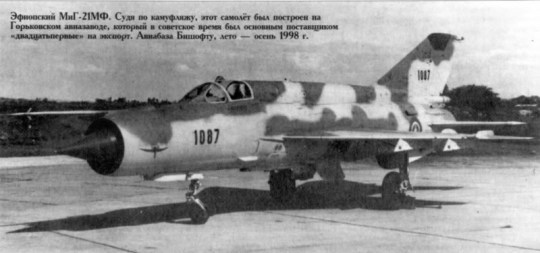
Perhaps just as significant was the contribution from the Cubans. 18,000 Cubans were sent to support Ethiopia, not just to serve as advisors, but to fight alongside the Ethiopians. A small detachment of pilots had been sent over as well to aid in conversion training, but they would find themselves flying on the front in MiG-21s. Forming the 4th Squadron, the Cuban pilots operated independently of the EtAF. Due to language barriers, cooperation between the Cubans and EtAF was limited to a few well-planned missions. Otherwise, the Cubans were on their own, free to support their own men on the ground.
Counterattacks
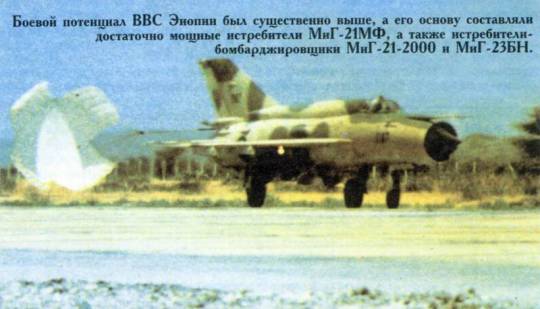
The impact of the foreign aid was soon felt by Somalia. On December 4, the Soviets launched the Kosmos 964 reconnaissance satellite, which flew over the region on December 17. Images of Bergera and Hargeisa air bases were soon transferred to the EtAF, giving them a detailed picture of what they were up against. On December 27, four F-5Es were sortied against Berbera. Each carrying two Sidewinders and two Mk.83 bombs, they were supported by a C-119 acting as an airborne command post. The fighters cratered the runway at Berbera before turning around and expending their 20mm shells on softer targets. The last CCS Il-28 fell victim to the raid, as well as at least one more MiG-21. The impact of the raid was mixed. The strike emboldened the Ethiopians and their supporters, but it was met with outrage across the Arab worlds, and, with only four operational F-5Es, the EtAF was unwilling to continue similar strikes.

Of course, it was hardly necessary to commit to further strikes against CCS bases. After the heavy losses suffered in the first half of the war, the CCS could barely put a pair of fighters into the air. By the start of 1978, CCS fighters no longer dared to fly anywhere near Ogaden. The last offensive sorties flown by the CCS would be night-bombing sorties flown by modified An-24s, but these came to an end with little impact after one was nearly intercepted by EtAF F-5s. The CCS was working to acquire replacements, eventually negotiating a deal with China for F-6/MiG-19S fighters, but they could not be delivered until 1979 at the earliest. Thus, the CCS was effectively neutralized for the remainder of the war.
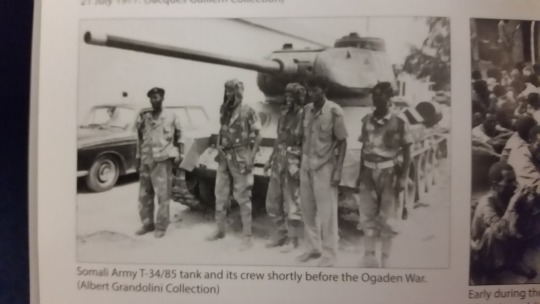
Apart from the raid on Berbera, Ogaden remained fairly quiet until late January 1978. Poor weather prevented major air operations, meaning that apart from sporadic reconnaissance flights by the RF-5A or Canberras, the skies were cleared. That all changed on January 22, when the Somalis launched their last offensive of the war. Aimed at Harar, the Somalis concentrated almost all off their 135 remaining T-54s into two pincers. They were met by a harsh Ethiopian response. On the ground, heavily reinforced defenders stopped the Somalis in their tracks. In the air, the EtAF struck the Somali rear, devastating supply depots and convoys caught in the open. Mere hours after the final Somali offensive failed, the Ethiopians responded in kind, and the whole war came crashing down.
The Rout
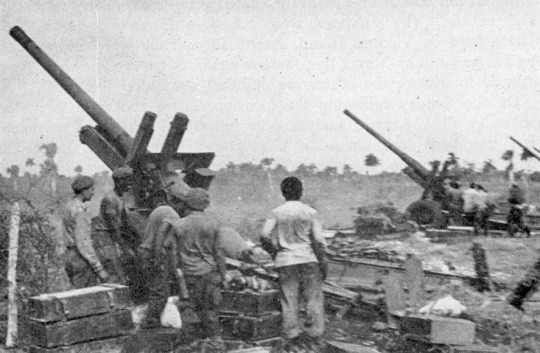
By pure coincidence, the Ethiopian counteroffensive was scheduled to begin on the same day that the Somalis launched their attack. Calling for a double envelopment, the Ethiopians would push from the south towards Somali positions near Harar, while the Cubans would swing north of Dire Dawa and attack the enemy’s north flank. The unfortunate coincidence proved lucky for the Ethiopians, as the masses of artillery and aircraft prepared for the coming offensive easily turned their attentions to stopping the last Somali push before beginning their own offensive later that day. However, the Somali offensive left the Ethiopians concerned that the CCS would reappear over Ogaden, so a new strike on Hargeisa was planned to silence the CCS once and for all.
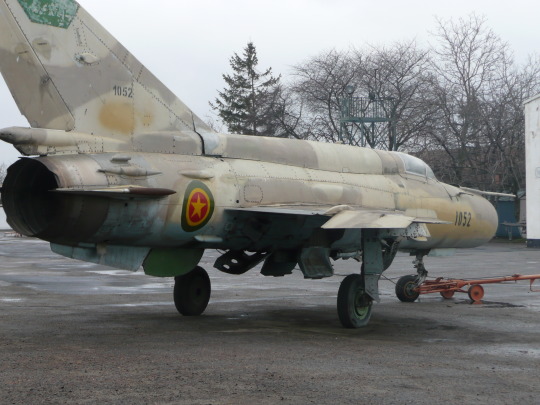
The raid on Hargeisa would be the largest single air operation of the war. All four F-5Es were committed to provide top cover, while strike elements consisted of a flight of four F-5As and two pairs of MiG-21MFs. One pair of MiG-21s was tasked with knocking out Hargeisa’s radar, while the remaining strike elements were to attack the airfield itself. The attack went perfectly - working with Soviet satellite intelligence, the MiG-21s destroyed the radar without being detected, and the six other aircraft devastated the airfield. Though top cover had been provided, it wasn’t necessary - the CCS was nowhere to be seen.

As the EtAF devastated Hargeisa, the DAAFAR and the rest of the EtAF were striking across Ogaden. The remaining F-5As and two remaining Canberras were flying unopposed across Ogaden, targeting Somali supply lines as they had done before. The Cubans, on the other hand, were taking a far more aggressive approach on the front. Concentrating efforts on Somali air defenses, they flew dangerous missions against everything from Shilkas to simple ZSU-23-2s and even MANPADS teams. Not too surprisingly, this risky behaviour led to losses, and soon after the offensive started, the Cubans suffered their first loss of the war when a MiG-21 was downed.
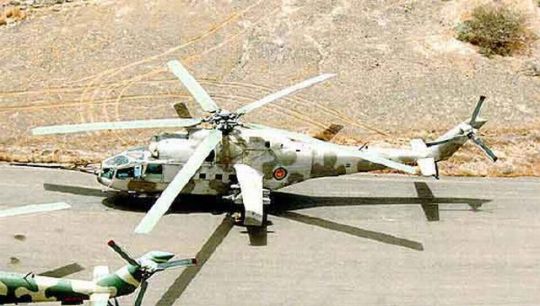
On the ground, things were going smoothly for the Ethiopians. By the second day of the offensive, they had advanced as far as Fedis, capturing 15 tanks, 48 artillery pieces, seven AA guns, and numerous APCs. The forces moved fast, and by the end of January, those Somalis that remained in the Karamara Pass were enveloped. On February 1, the Ethiopian/Cuban forces feigned south, keeping the attention of the Somalis while the 1st Paracommando Brigade was stealthily ferried around the Somali flank. The Somalis counterattacked at the Allied feint, only to break themselves when the Paracommandos broke their cover and took the Somalis completely by surprise. The Somalis fell back to Jijiga, leaving a rearguard to cover their evacuation, but with little effect. The rearguard fell with little effort, the Somalis leaving behind 42 tanks, 50 artillery pieces, and countless other vehicles.
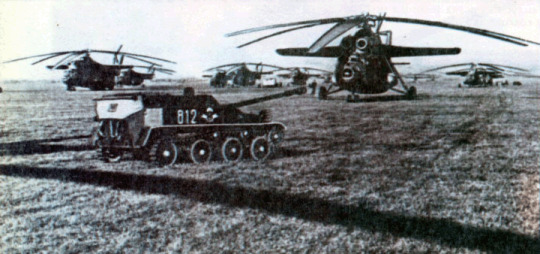
North of Jijiga, the Cubans and Ethiopians slowly dislodged the Somalis from their positions and repulsed counterattacks, slowly closing in on Jijiga. By mid February, preparations for the final assault were beginning. EtAF and DAAFAR fighters and bombers flew over the battlefield, striking troop concentrations and artillery positions. The defenders responded with fierce ground fire, damaging both Canberras (enough that one was written off after landing) and downing a Cuban MiG-17 and MiG-21. The Somalis stood firm, but they could not hold the town once the Allied offensive began on March 5. 140 sorties from the DAAFAR and EtAF softened the enemy positions, and Mi-6s ferried soldiers, BMD-1s, and ASU-57s in place to the Somali rear to facilitate a major assault on the Somali flanks. Resistance continued into the next day, but by the end of March 6, the Somalis began a general retreat. At Jijiga, they left 3,000 casualties as well as most of their heavy weapons.
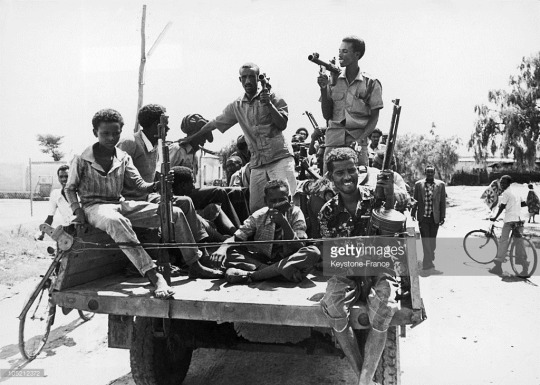
After learning of the disaster at Jijiga, Barre gave the order for all troops to retreat back to the border. Thus began a race to the border. The Allied forces chased down and destroyed straggler elements, threatening the complete destruction of the Somali Army. By March 8, the Ethiopians had recaptured Degehabur 200km south of Jijiga. Holdouts persisted at Fik, Kebri Dahar, and Kelafo, but without air support or heavy weapons, they suffered just as the Ethiopians defending the towns had so many months before. On March 23, the last frontier post had been recaptured, marking the official end of the Ogaden War.
Wrapping Things Up
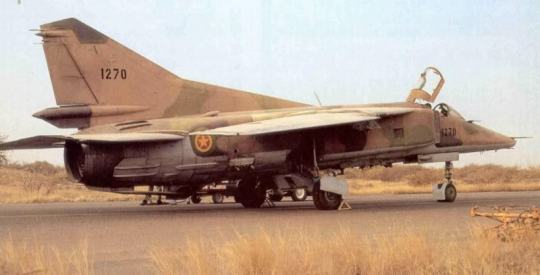
As the Ogaden War came to an end, the first of the 44 MiG-23BNs ordered by the EtAF reached service. As the Ethiopians chased down the last scattered remnants of the Somali Army, the commenced Operation Lash, aimed at clearing out what remained of Somali forces and insurgents from northeast Ogaden. Through early April, the MiG-23 made its debut in the operation. While the CCS claimed to have downed several F-5s and MiG-21s, the reality was quite different. The CCS remained firmly on the ground, and the two reported EtAF losses - both MiG-23s - came from ground fire.
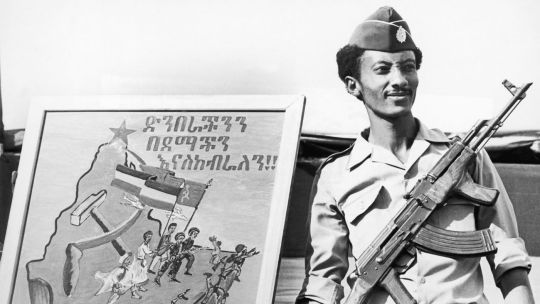
The ultimate goals of the Ethiopians as they reached the border were unclear. They may have wanted to pursue the fleeing Somalis across the border, and they very well may have been able to. However, the Soviets had been aggressive enough in the conflict, and they feared further action would provoke a direct Western intervention, so the offensive stopped at the border. Operation Lash came to an end by early April, and with it the last part of the Ogaden War was over.
Aftermath
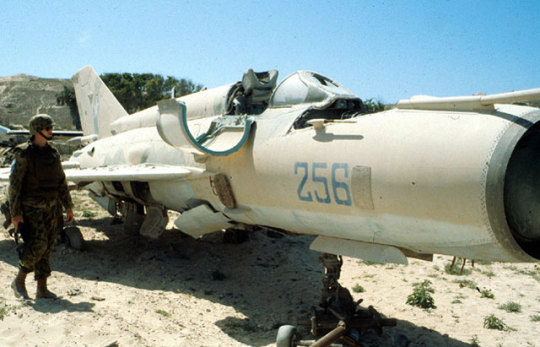
As the dust settled, both sides counted their losses. The Ethiopians reported roughly 5-6,000 killed, 10,000 wounded, 3,799 MIA and 1,362 deserters. Cuba suffered 400 dead, Yemen a further 100 and the Soviets 33 dead and missing. Due to the chaos in Somalia since the war, Somali losses are harder to quantify. Ethiopia reported 6,453 Somalis killed, 2,409 wounded, and 275 captured, but given the stringent reporting standards for the Ethiopians, these figures may not be reliable. Losses in the air were easier to quantify. Though the CCS claimed some 50 EtAF aircraft, actual EtAF losses totaled 23, including two F-5As and three F-5Es downed by ground fire, one written off during a pre-war rocket attack, three DC-3s (one forced down by MiGs, the others destroyed on the ground), and the T-28 and eight B.17s lost when Dire Dawa fell into enemy hands. The CCS, on the other hand, suffered heavily. The EtAF is reported as having destroyed 18 MiG-21s and 9 MiG-17s in air combat (though only 11 kills were credited to pilots), as well as six more MiGs on the ground. Total CCS losses for the war amounted to roughly half the fleet, as well as all of the surviving Il-28s.
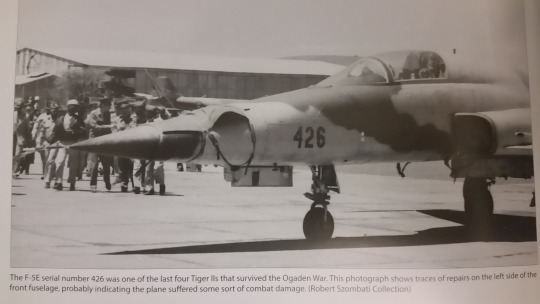
Though the Ethiopian losses represented a significant portion of the pre-war air force, given the circumstances they performed incredibly well. The EtAF had flown 2,865 combat sorties between July 1977 and June 1978, giving them a loss rate of .003 losses per sortie. The DAAFAR reportedly flew 1,013 sorties during the final offensive of the campaign, half of which were with MiG-17s, for the loss of three aircraft. The details of the CCS are far less clear, but after the dust settled, only about a dozen MiG-17s and eight MiG-21s were still intact. By the time the Chinese-built F-6/MiG-19s arrived, the CCS would retire their entire pre-war inventory.
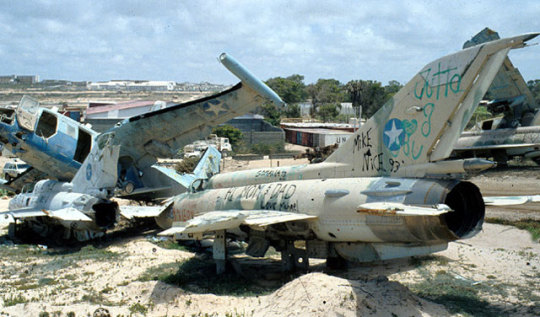
One of the more interesting aspects of the war was the pitting of a NATO-trained air force against a Soviet-trained one. Though neither belligerent was anything close to the forces they emulated, they offered an interesting insight into both sides’ air doctrines. The defensively-oriented Soviet air doctrine of the CCS - emphasizing ground controlled intercept with minimal practical combat training - proved poorly suited for the offensive operations the CCS was flying, particularly without the ability to relocate forces as the front moved. Worse, without the cohesive early warning network integral to Soviet doctrine, the CCS wasn’t even able to defend friendly skies from the EtAF. On the other hand, the NATO-based doctrine of the EtAF proved effective. Though aided by a more effective early warning network, the emphasis put on air combat training for the EtAF pilots gave them a decisive edge in what would have otherwise been a fairly even matchup between the F-5E and MiG-21.
Epilogue
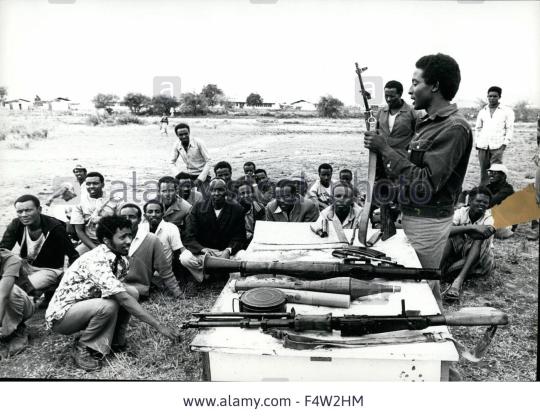
Unfortunately, the Ogaden War would not be the end of the dispute over the region. The Ethiopians failed to completely destroy the insurgent groups, so by the end of 1978, much of Ogaden was under the control of Somali-aligned insurgents. Though the crippled Somali military could not capitalize on this, it would take until 1981 for the entire region to be back under Ethiopian control. The war had a major impact on the Barre regime’s power, leading to the establishment of an opposition group soon after the war. Though Somalia replaced Ethiopia postwar as the nominal US ally in the region, support never approached that Ethiopia enjoyed from the Soviets. Ethiopia may have come out of the war better than Somalia, but neither was really in a good position. Somalia’s defeat in 1978 would sow the seeds for the eventual collapse of the government in 1991 (partly thanks to endemic Ethiopian support for rebels), but Ethiopia had their own issues to deal with - numerous oppositions groups had sprung up against the Derg government, adding to their existing troubles dealing with rebels in Eritrea and Ogaden. Famine wracked the country by the mid-80s, and the Derg was formally abolished in 1987.
7 notes
·
View notes
Text
/k/ Planes Episode 93: Experimental Slavshit

It’s time for another episode of /k/ Planes! This time, we’re looking at the various experimental planes to come out of Russia.
Despite the general criticism of the Soviet regime, the Soviets were very enthusiastic about aircraft when they came into power in the ‘20s. Apart from a general push to develop competitive combat aircraft, state organizations like the Central Aerohydrodynamic Institute (TsAGI), Air Force Research Institute (NII VVS), and the aviation institutes at Kharkov and Moscow (KhAI and MAI) sponsored countless programs through the years to investigate less-than conventional designs. However, unlike many foreign experimental aircraft, the products of these experimental programs were often militarized. The militarized elements of the experimental aircraft were not always practical, but they nevertheless reflected the general focus of Soviet aircraft development - military service. During the Cold War, the line between tech demonstrator and prototype blurred, and in many cases the only reason an aircraft would be considered “experimental” rather than a prototype was the fact that it lost out to a competing project. Unfortunately, though experimental work clearly carried on past the end of the Cold War, details of many projects are hard to come by thanks to Soviet secrecy. At a glance, it seems as though large-scale experimental work was far less prolific than with organizations like NASA, but it very much could be the case that much of the work remains secret.
Tupolev ANT-1
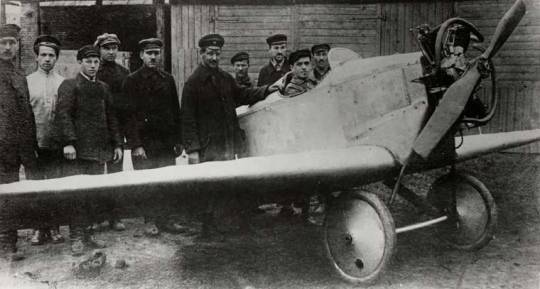
Andrei Tupolev’s first aircraft would have its origins in 1911, but the outbreak of the first World War and subsequent civil war put the project on hold. Fortunately, Tupolev found himself as part of TsAGI’s design department after the dust settled, and by 1922 his first design - a mixed-construction cantilever monoplane designated ANT-1 - would begin to materialize. Modest in performance, it was intended more as a testbed for metal aircraft construction techniques. The ANT-1 would first fly in October 1923. It would fly intermittently in tests for two years, but the engine gradually wore out so it was retired. Rather than scrap the aircraft, Tupolev hung the ANT-1 from the assembly workshop ceiling. It would remain on display as such until the Second World War, when it was lost in the confusion.
Aleksandrov-Kalinin AK-1
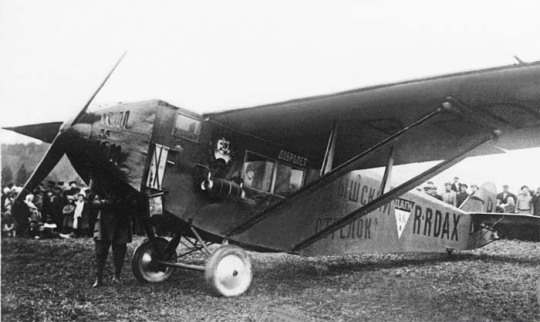
In the early 1920s, TsAGI had been investigating various thick airfoil sections, and they sought a practical aircraft to verify their calculations. The AK-1 that would take shape was a simple high-winged monoplane powered by a single engine in the nose. In addition to the thick airfoil section designed by TsAGI, the AK-1 was built using experimental new low-cost construction techniques and designed to carry two passengers. Flight tests began in February 1924, continuing until that June. After successful testing, it lived out its life as an airliner and occasional propaganda aircraft.
Tupolev ANT-2
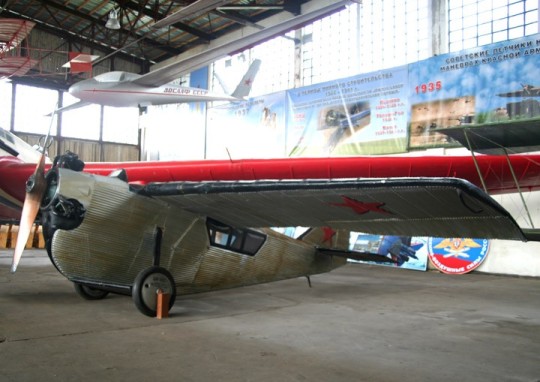
After the success of the ANT-1, Tupolev and his team were commissioned by TsAGI to create an all-metal aircraft. The ANT-2, as it was designated, was a high-wing cantilever monoplane made of a domestically developed duralumin alloy. A deep triangular fuselage gave the aircraft structural strength while also providing space for two passengers (as well as a pilot) internally. The ANT-2 would take flight in May 1924. It was initially found to be unstable, but after some changes to the tail, handling was satisfactory. Unfortunately, materials shortages would prevent any production of the ANT-2. The ANT-2 was powered by a foreign-supplied Bristol Lucifer engine, and there were no suitable domestic powerplants to replace it, so the ANT-2 would never see significant service beyond testing.
Cheranovsky BICh-3
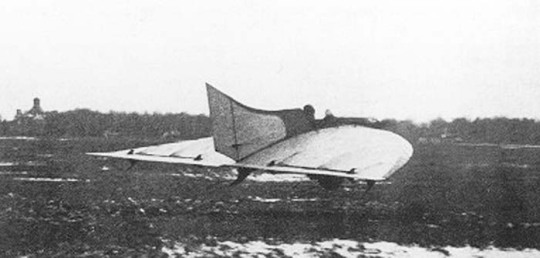
In 1921, Boris Cheranovsky presented a proposal for an experimental parabolic flying wing design to TsAGI. Though met with disbelief and resistance at first, TsAGI would nevertheless show support for the proposal after wind tunnel studies showed the flying wing would fly. Two gliders - the BICh-1 and -2 - would be presented for testing in 1924, both being wide parabolic designs with the cockpit buried in a larger vertical stabilizer. The BICh-1 was fairly crude, but the BICh-2 performed fine, becoming the world’s first flying wing aircraft. With glider testing validating the parabolic design, Cheranovsky set out to create a powered prototype, dubbed the BICh-3. The BICh-3 was a simple conversion of the BICh-2 glider with an 18hp engine installed in the nose. Testing began in 1926. Stability issues were found at first, but handling was satisfactory, and, after some minor modifications, the BICh-3 was made safe to fly. The test program seems to have been uneventful, but the BICh-3 would pave the way for further flying wing development.
Cheranovsky BICh-7
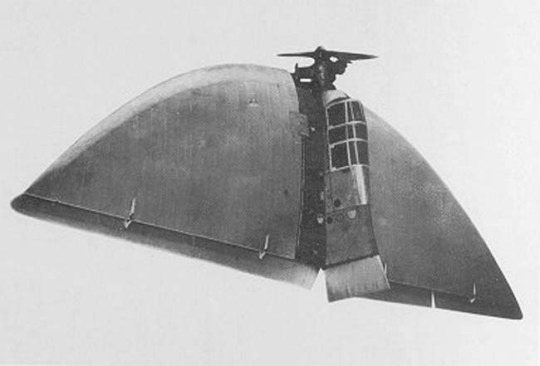
Following the success of the BICh-3, Cheranovsky began work on two new flying wing projects. The first, the BICh-5, was to be a twin-engined bomber, but it would be cancelled before wind tunnel testing could conclude. However, elements of the BICh-5 design, including the Junkers-style underslung control surfaces, would carry over to the BICh-7, which was designed as a far more reasonable two-seat touring aircraft. As originally designed, the BICh-7 was about 1.5 times the size of the BICh-3. Rudders were placed on the wingtips, tandem open cockpits were placed along the centerline, and landing gear consisted of two wingtip skids and a single main wheel. Flight testing in 1929 had dismal results, however, with the BICh-7 barely able to leave the ground. To salvage the design, Cheranovsky spent several years rebuilding the BICh-7 as the BICh-7A. The new aircraft used a rudder faired into the cockpits (which were now enclosed) as with the earlier designs, and conventional landing gear was used. Flying again in 1932, the BICh-7A performed much better. Issues were still found with engine vibrations and excessive speed loss during turns, but slight changes to the elevons alleviated the worst of the problems.
Kamov-Skrzhinski KASKR-1/2 “Krasny Inzhener”

Inspired by the successful testing of autogiros by Juan de la Cierva, a team of engineers under Nikolay Kamov set out to create their own autogiro. Using an Avro 504K trainer as a base, the KASKR-1 replaced the upper wing with a four-bladed rotor and modified the landing gear. As the first aircraft of its type in Russia, testing would not be without issues. On the first taxi testing of the KASR-1, the rotor lost balance and chopped off the tail. It was rebuilt with a longer, lower tail, but control issues were encountered when flight testing finally began in September 1929. Asymmetric drag from the rotor took some getting used to, and the aircraft was perpetually underpowered. After it crashed in October, Kamov would rebuild it with a new engine with more than double the power. Now dubbed the KASKR-2, it would fly about 90 more test flights. In 1931, it was successfully demonstrated to Party leaders, paving the way for future autogiro development.
Vinogradov Igrado 3B/M
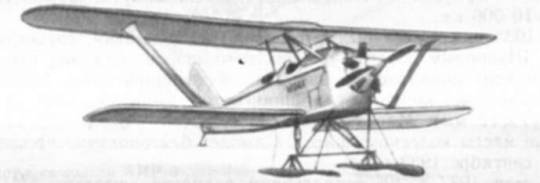
At the end of the ‘20s, veteran pilot Ivan Vinogradov conceived an unusual concept for a modular aircraft. Taking shape as the Igrado 3B/M, the aircraft was to be capable of serving as a monoplane or biplane and with easily removable gear to allow use with skis or floats. The forward fuselage was all-aluminum, while the wings were wood with fabric skin and the tail all wood. The Igrado would be flown by Vinogradov himself in 1931, but it was quickly discovered that even in the biplane configuration, the 60hp engine left it horribly underpowered. A more powerful engine was planned to be installed, but the whole project was abandoned after the aircraft was damaged in a landing accident.
The Recoilless Rifle Fighters
With the rifle-caliber machineguns that were standard on fighters in the ‘20s verging on obsolescence, the VVS was looking for a new standard armament at the end of the decade. Meanwhile, Leonid Kurchevsky would develop a new recoilless rifle concept with calibers ranging from 37mm to 420mm. One gun in particular - the 76mm APK-4 - would catch the attention of the VVS, who sought to create a fighter around the weapon for anti-bomber duties. The project would be assigned to two design bureaus. Grigorovich was the first to begin work, with the assignment coming in the summer of 1930, while Tupolev followed soon after. At first, the program was highly secretive - so much so that Grigorovich’s fighter used a designator that did not exist in the cyrillic alphabet (Z). By the time Tupolev began work, however, the security had loosened enough for regular designations to resume. Whatever the case, the recoilless rifle program would be a spectacular failure. Reliability issues plagued the guns, and their low muzzle velocity made them uselessly inaccurate. The APK program was abandoned in 1936, and their designer was arrested and executed the next year.
Sukhoi I-4 APK-4

Although the dedicated APK-4 platforms would fly in mid-1931, the decision was made to mount two DRP-76 guns on an I-4 fighter to serve as a testbed. A single I-4 was converted at the end of 1931, with engineers slinging a single gun under the outboard section of the upper wing for ground tests. Test firings began in December of that year, with the I-4 successfully making test firings at ground targets. Unfortunately, during one of the test firings, one of the guns exploded, seriously damaging the aircraft. Despite the catastrophic failure of the DRP-76, the I-4 was repaired and returned to service, serving as a testbed for various APK recoilless rifles until the end of 1935.
Grigorovich I-Z
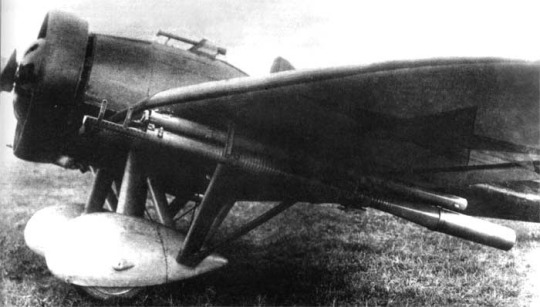
Grigorovich’s recoilless rifle fighter project would be designated the I-Z. A conventional corrugated wing monoplane, the only real unique feature to distinguish it from contemporary fighters was the recoilless rifle slung under each wing. To speed development, Grigorovich took much of the design from other aircraft. The forward fuselage came from an I-5, although one of the two rifle-caliber machineguns was removed, while the remainder was an entirely new design. A monocoque duralumin tail featured a high-mounted tailplane intended to keep the horizontal surfaces clear of the gun blast, and the straight, corrugated wings were braced to carry the APK rifles. The originally installed guns were fairly simple single-shot devices, but they would be replaced with multi-shot APK-4s on later series aircraft.
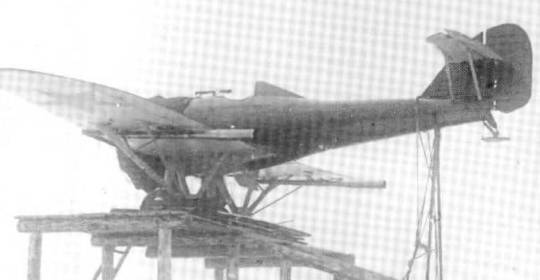
The I-Z would fly for the first time in the summer of 1931, requiring minor changes to the tail to be deemed acceptable. Testing generally went well, and by 1933 a pre-production batch of 21 and 50 production aircraft had been ordered. Production aircraft would differ from the prototype in that they made use of a Townend ring in place of the I-5’s cowling and used wooden structures in the wing in place of metal. Unfortunately, service trials went poorly. The various issues with the APK rifles plagued the I-Z, and, with only a single machinegun for armament and modest performance, it couldn’t really be accepted for service without the guns. The I-Z would be accepted for service in 1935, but only after the replacement of the original APK-4 guns with the 37mm APK-11. Given that the 50 production aircraft had already been completed with the APK-4 mounted, the conversions would take place when the aircraft reached their units. Service of the I-Z was brief and uneventful. A few I-Zs participated in the Zveno parasite fighter program, but the majority only saw a brief career with frontline units before being replaced by the I-16.
Tupolev ANT-23/I-12
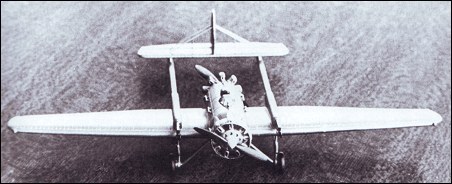
Tupolev took an entirely different approach for his recoilless rifle fighter, which was designated the I-12. Making use of a push-pull twin-boom design, the I-12 incorporated the APK-4 guns into the structure of the tail boom. The pilot sat in an open cockpit in a central nacelle with a Bristol Jupiter engine forward and aft of him, and a conventional single-rudder tail extended to the rear of the aircraft. Taking flight at the end of 1931, the I-12’s test career went poorly. It failed to pass factory tests, partly thanks to the massive drag afforded by the corrugated skin and tall fixed landing gear (necessary to give the rear propeller ground clearance). The rear engine performed poorly, as it lay in the wake of the forward propeller, and the pilot had no way to bail out as there was no emergency stop for the rear engine. In May 1932, the first in-flight test firing of the APK-4 guns occurred, ending when one of the guns exploded. The aircraft was landed safely, but it was grounded for some time while being repaired and refined. Ultimately, flight tests would stop in September 1932. Refinements continued until 1933, but the program was terminated that year before the second prototype could be completed.
TsAGI 2-EA
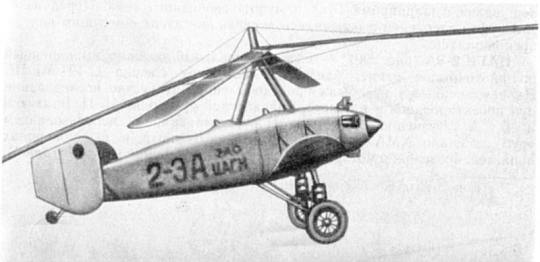
After the relative success of Kamov’s autogiro experiments, TsAGI began work on an autogiro testbed to examine all the elements of autogiro construction. Designated the 2-EA, the aircraft was an entirely new design with a steel tube fuselage, wooden wings and fabric skin. As with Kamov’s autogiro, it had a crew of two, but it made use of a far more powerful Gnome-Titan engine. Special care was taken to protect the tail from the rotor blades, with rudders mounted on a fairly short double tail kept well clear of the rotor. Testing began in 1931. It performed well and finished trials without incident before being passed on to the propaganda air group “Maxim Gorky.”
Vakhmistrov/Tupolev Zveno 1

In 1931, Vladimir Vakhmistrov began work on a parasite fighter program. Dubbed “Zveno,” the project aimed to provide a means for fighters to operate beyond their normal range and payload, both to provide escort for long-range bombers and allow the fighters to make dive-bombing attacks with payloads far exceeding their regular capacity. The first of the Zveno projects centered around Tupolev’s TB-1 bomber. With the TB-1 as a carrier, an I-4 would be rolled up onto either wing with a ramp and attached to the bomber via three locks. These locks were controlled by the pilots of the fighters, allowing them to detach during flight. For takeoff, all three aircraft would use their engines, helping the TB-1 account for the extra weight. Flight testing began in December 1931. Though one of the I-4s had problems detaching due to deformation of the locking mechanism, both fighters took off and detached successfully. Testing continued into 1932, and as testing concluded, the VVS recommended series production of Zveno-style aircraft.
Cheranovski BICh-11/RP-1

Cheranovski’s next flying wing design would be notable for being the first purpose-designed rocket powered aircraft in the world. The BICh-11 shared the control surfaces and wingtip rudders of the BICh-7, but it was a considerably more compact design with a low-sitting fuselage and straight leading edge. On either side of the cockpit were two fairings for rocket motors. Unfortunately, the BICh-11 would never fly with its intended rocket powerplant. The OR-2 rocket motors under development were deemed too dangerous to mount on an aircraft, so the BICh-11’s flight testing would begin in 1932 with catapult-launched gliding flight. Testing eventually progressed to powered flight, with a small 35hp engine installed, but, despite successful demonstration of the OR-2 engine in 1933, the BICh-11 would never mount the motor.
Tupolev ANT-25
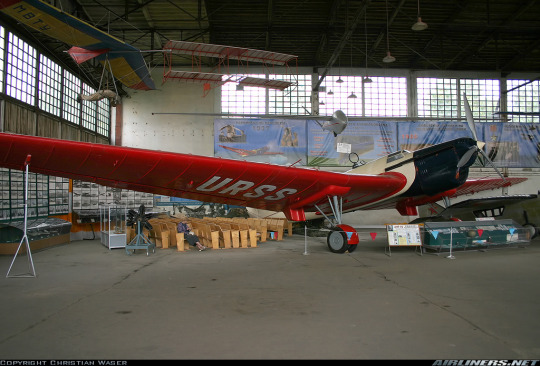
Under the recommendation of Kliment Voroshilov in December 1931, Tupolev was commissioned to develop a long-range experimental aircraft. Intended to set distance records, the resulting ANT-25 was a clear cantilever monoplane with a massive 34m wingspan. A single Mikulin M-34 powered the aircraft, while the spacious wings and fuselage were filled with fuel tanks, making fuel over half the aircraft’s weight at takeoff. The high aspect ratio wings required special attention, leading to new research in flutter from TsAGI to ensure the design’s safety. In the event of ditching at sea, the ANT-25 was also fitted with air bags to stay afloat. The ANT-25 would first fly in 1933, but record attempts would have to wait until the next year while factory tests concluded. The first such flight took the ANT-25 on a 12,000km course, staying aloft for 75 hours. Later, it would break the straight-line record, flying over 9,000km from Moscow to Portland, Oregon. Record flights continued until the middle of the decade. The VVS looked into militarizing the design, but it was found to be terribly impractical - slow, clumsy, and underpowered, the ANT-25 design was poorly suited to combat roles, even after significant modifications.
Kalinin K-7
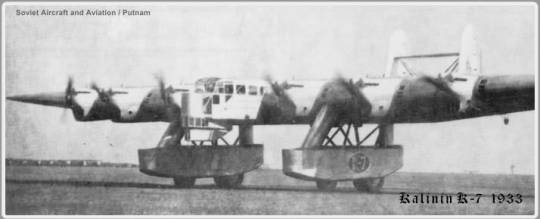
At the end of the ‘20s, Kalinin conceived a concept for a massive 120-person airliner, beginning work on it as the K-7. The concept quickly caught the attention of the VVS, so work on a bomber variant soon followed. The massive projected payload of the K-7 was to be far from its only distinguishing feature. The design consisted of a thick 53 meter elliptical wing in which most of the payload and crew would be carried with a twin-boom tail extending to the rear and seven AM-34F engines (six on the leading edge, one on the trailing edge) were to power it. Instead of conventional landing gear, two large pods extended under either wing, each carrying three wheels. As a bomber, these pods also accommodated two gunners. Total firepower as a bomber amounted to eight 20mm cannon and eight machineguns across 12 positions laid out such that every angle was covered by at least three guns. Payload was also heavy, with space for up to 6,000kg of bombs provided. The K-7 would first fly in August 1933, but testing was put on hold after the first flight revealed dangerous stability and vibration issues. This was “solved” by shortening and strengthening the tail, but the vibrational issues persisted, ultimately causing the crash of the prototype on its seventh test flight. Though two more prototypes had been ordered, the project was cancelled in 1935 before they could be completed.
Bartini Stal-6

Soon after being appointed leader of a design team, Bartini would set out to develop an incredibly advanced aircraft. Designed around a Curtiss Conqueror engine, the Stal-6 was made as compact and clean as possible. The cockpit was made flush with the fuselage and an evaporative cooling system in the skin reduced drag, while weight was reduced through the use of monopod landing gear and an extremely light structure. Taking flight in the fall of 1933, the Stal-6 immediately validated all the novel concepts Bartini had put into the design. The unconventional landing gear arrangement performed just as well as standard landing gear, and testing found the Stal-6 to be capable of a top speed of 420 km/hr - 150km/hr faster than contemporary fighters. Coming at a time when other OKBs were claiming that such speeds were impossible with contemporary technology, the Stal-6 was groundbreaking. With the design largely proven, Bartini progressed to the Stal-8, a more practical militarized development of the design.
Bartini Stal-8
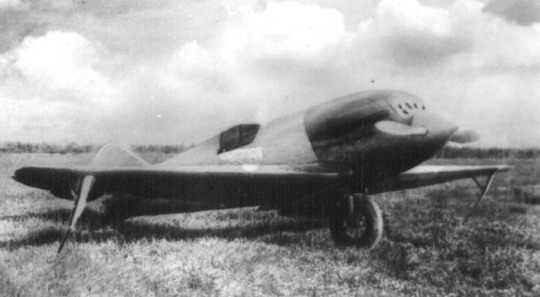
Developed from the Stal-6, Bartini’s Stal-8 was a slightly larger version of his testbed aircraft intended to serve as a fighter. The cockpit was raised to give the pilot a reasonable field of view, and two 7.62mm machineguns were added in the nose. The novel landing gear, cooling system, and construction were retained, although empty weight increased by almost 300kg. To compensate for the added weight, the Stal-8 was to use the Hispano-Suiza 12Y derived M-100 engine, which provided more power than the original Curtiss Conqueror. Unfortunately, despite the Stal-6’s success, it was facing criticism over the vulnerability of its cooling system. Hoping to counter the criticism, Bartini would test the Stal-6 with simulated damage to the cooling system for flights lasting up to half an hour, while also redesigning the Stal-8’s system to be more robust. Unfortunately, politics seemed to get in the way of things. Bartini’s OKB was part of GVF (predecessor to Aeroflot), who had little interest in the design, and other departments that would have been interested in the design were not willing to intervene to preserve the project, particularly with more conventional fighters like the I-15 and I-16 already entering production. In the end, the Stal-8 was cancelled with the prototype 90% complete on grounds that the cooling system was too vulnerable.
Kharkov Aviation Institute KhAI-4
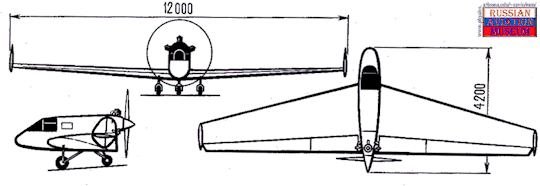
In the early ‘30s, KhAI began experimenting with tailless aircraft. As a demonstrator, they produced the KhAI-4 - a two-seater tailless design powered by a 100hp pusher engine. A first for the USSR, it featured tricycle landing gear with a steerable nosewheel. Unlike the works of Cheranovsky, the KhAI-4 was less a flying wing and more a tailless aircraft with a distinct fuselage and wings. Testing began in the summer of 1934, finding numerous problems. Torque from the engine made handling difficult, and the short moment arm of the elevons made rotation on takeoff only possible at very high speeds. Worse, the high-mounted engine produced a nose-down moment, making climbing difficult. In the end, the program ended after the KhAI-4 was declared too dangerous to fly. The basic concept of a tailless aircraft had been proven, but the KhAI-4 itself was by no means practical or safe.
Chetverikov SPL

In 1931, Chetverikov began work on an interesting new project to develop a seaplane capable of being carried aboard a submarine. Designed around a 7.5m long and 2.5m wide “hangar” tube, the new aircraft had to be easily assembled in no more than five minutes. Unsurprisingly, the resulting SPL was a crude design more resembling a civilian sport aircraft than a military design. The tail, engine, and wings all detached for stowage, the tail and engines were mounted away from a small hull on support struts. Fitting the size and assembly requirements came at the cost of low engine power (100hp) and small tail surfaces. To lower drag, the crew of two was sat low in the fuselage, resulting in a very poor field of view for the observer. The first prototype lacked a wing folding mechanism, intended to serve instead as a testbed for the rest of the design. It would fly in mid 1934, followed by a smaller, more refined prototype (complete with wing folding) that December. Trials lasted until August 1935. While the SPL had numerous flaws, it fulfilled all design requirements. However, it quickly became apparent to state officials that such a design would rapidly become obsolete, so no production was ordered. The SPL became a propaganda piece, being shown off at airshows and setting records (mainly for altitude) for its class while the Soviet government abandoned the submarine aircraft concept.
Moskalev SAM-4
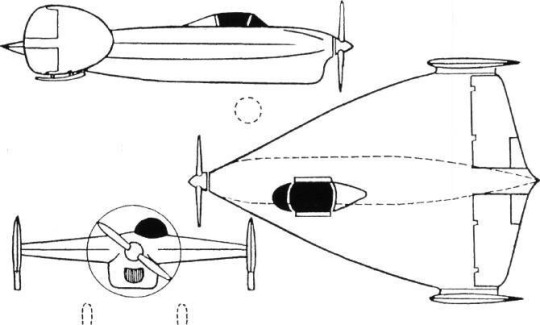
In 1933, Aleksandr Moskalev at Voronezh University began experiments with high speed wing design. Ultimately aiming to create an aircraft capable of supersonic speeds, Moskalev would first begin with a subsonic demonstrator. Designated the SAM-4, the aircraft was to have an ogival wing without any tail. Two 760hp Hispano-Suiza engines would power contra-rotating propellers with scimitar-shaped blades (intended to delay the onset of supersonic flow), and rudder endplates were designed to improve low-speed handling and reduce the negative impacts of the low aspect ratio wing. To reduce drag, the cockpit was to be flush with the fuselage and the pilot placed in a prone position. The project was ambitious, aiming to reach a top speed somewhere between 900 to 1000km/hr. Unfortunately, when presented to state officials in 1934, it was received poorly. Because Moskalev was also working on several other projects at the time, the SAM-4 would be shelved.
Cheranovksy BICh-14
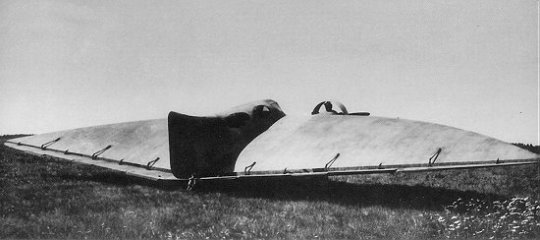
Following the success of the BICh-7, Cheranovsky finally began serious work on a twin-engined parabolic flying wing. Originally working under the designation BICh-10, small-scale testing found numerous flaws in the design, so it was refined to become the BICh-14. A step up from previous works, the BICh-14 would have a duralumin cabin and retractable landing gear. A single 100hp engine was placed on the leading edge of the wing on either side of the cabin, and a small vertical tail was faired into the crew compartment. Flight testing began in late 1934, with the design presented to the VVS. Unfortunately, the design was found to have unsatisfactory handling and stability, a consequence of the engine placement, poor airflow over the tail, and poor design of the elevons.
Vakhmistrov/Tupolev Zveno 2/3/5/6/7

Following the successful demonstration of the Zveno concept on the TB-1, Vakhmistrov set his sights on the larger TB-3 heavy bomber. The first new Zveno experiment - the Zveno-2 - was little different from the original concept. A single I-5 was rolled up onto either wing via a ramp, while a third one was rolled up onto the wing and muscled over onto a mount atop the fuselage. Tests of the Zveno 2 began in August 1934. Although it successfully demonstrated the ability to take off with all aircraft and detach in flight just as the original Zveno did, remounting the third fighter above the fuselage was incredibly cumbersome, so after several tests the third I-5 had become a semi-permanent fixture on the aircraft.
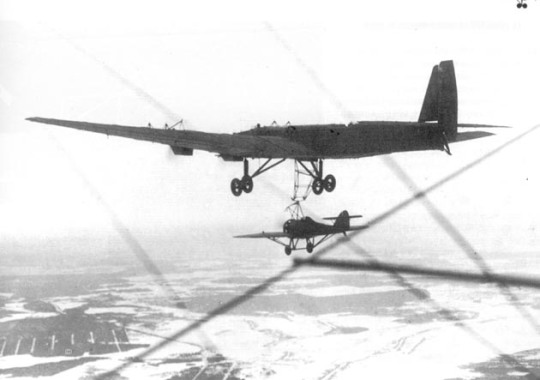
Later that year, work on the Zveno-3 project began. Though based around the TB-3, the Zveno-3 would take an entirely different approach. Rather than mounting the parasite fighters atop the wings, Vakhmistrov instead created a mounting under each wing to allow two I-Zs to be carried. Because the fighters sat low enough for their gear to touch the ground, they were fitted with a floating frame to account for uneven ground. Unfortunately, this floating frame would be the thing that put an end to the Zveno-3: on one test flight, the frame failed to lock after takeoff, causing one of the I-Zs to crash into the wing. Still suspended from the bomber, the crippled machines moved in for an emergency landing, but as the bomber slowed, the damaged I-Z fell to the ground, killing its pilot. The last of the I-Z Zveno experiments would be dubbed Zveno-5. This project involved aerial docking, with the TB-3 suspending a trapeze under the fuselage to which an I-Z would hook on. This maneuver was successfully demonstrated in March 1935, with the aircraft linking up at 1,000m in what would be the world’s first mid-air docking between fixed-wing aircraft.
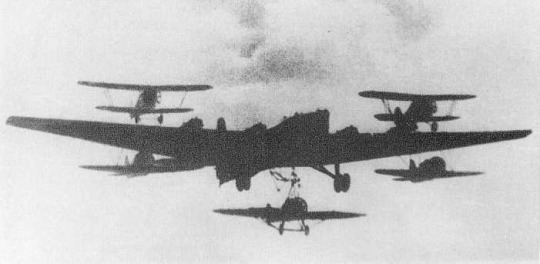
By mid 1935, a new Zveno project had been started. Working with the same under-wing attachment layout as the Zveno-3, the Zveno-6 would avoid the dangerous floating mounts by using I-16s with landing gear retracted on the ground. First flying in August 1935, the concept worked perfectly, although they had no means for reattaching in flight. The Zveno-7 would eventually come around to provide a means for the I-16s to redock, but the system only took flight in late 1939 and was never put into practice. Instead, Vakhmistrov set his sights elsewhere. A new project, known only as Aviamatka, would fly in November 1935, serving as the culmination of all previous Zveno projects. Two I-15s were mounted above the wings, and two I-16s were suspended below them, while the trapeze of the Zveno-5 was added to allow a single I-Z to dock in flight. Amazingly, the absurd concept not only flew, but tested successfully. Vakhmistrov hoped the Aviamatka would serve as the basis for an airborne mothership concept in which a flight of eight I-16s would be able to dock and refuel with a TB-3, but unfortunately the concept never came to fruition.

Though Vakhmistrov’s more ambitious goals were never realized, his Zvenos did get to see combat. A more conservative project called the Zveno-SPB worked off the I-16 experiments to turn the Zveno into a strike platform. Each I-16 would be fitted with a pair of FAB-250 bombs, more than doubling their standard capacity while extending range by 80%. Initial production began in June 1940, with six SPBs converted using I-16 type 24s. They were shipped to Sevastopol, where they were stationed when war broke out the next year. The SPB was spared the slaughter along the front, instead participating in a surprisingly aggressive bombing campaign across the Black Sea against Romanian oilfields. Some 30 Zveno-SPB missions were flown, hitting strategic bridges, pipelines, and refineries in Romania without suffering any losses. One one occasion, four Zveno-launched I-16s even engaged two Bf 109s, claiming both of them. Unfortunately, the Zveno-SPB’s career was short. All the aircraft involved were outclassed by enemy fighters, and, with Axis forces closing in on the Crimea, there were no longer spare resources for harassment raids on Romania. Some of the last sorties of the Zveno-SPB aimed to stall the enemy advance by striking bridges on the Dniepr. It appears that this marked the last real combat use of the system.
Grokhovsky G-39
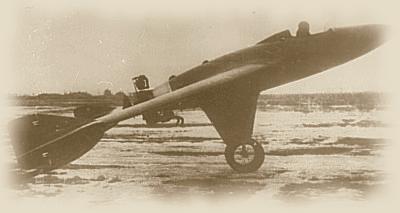
Sometime around 1932, the VVS began a secret project to develop a ramming fighter. Given the codename “Taran,” the program looked at several manned and unmanned solutions. The most successful of these would be Grokhovsky’s G-39 project, which began in 1933. The G-39 was an unusual aircraft with a long boom extending from the nose. Two steel wires extended from this boom to the wingtips, while the leading edges of the wings themselves were strengthened should the wires fail. The engine sat in a pusher arrangement behind the cockpit, and, rather than use a tail, the G-39 had rudders mounted near the tips of its 38 degree swept wings. Because of the projected danger from enemy guns, the windscreen was fitted with a retractable bullet shield. The unusual aircraft was rolled out in the spring of 1935 for trials. Unfortunately, it failed to fly. The 100hp engine left the aircraft terribly underpowered, and the placement of the engine reduced propeller efficiency. Ultimately, the G-39 project would be dropped without ever taking flight.
Moskalev SAM-6
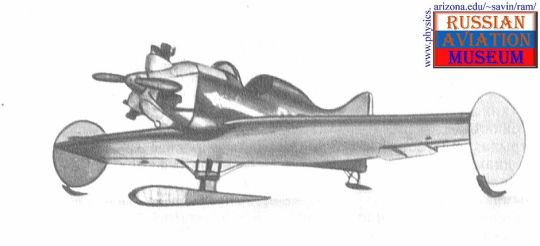
As part of his work on tailless aircraft, Moskalev had conceived single-point landing gear. Rather than wait until the final design was ready to see if the new landing gear concept would work, he opted to build a small-scale demonstrator, dubbed the SAM-6. The SAM-6 was a simple tailless design with a conventional rudder and wingtip plates. A small 65hp engine sat in the nose in front of an open cockpit, and a single large landing gear strut was placed under the fuselage. To keep the aircraft balanced, small outriggers were placed on the tail and wingtip plates. Taking flight in January 1935, the SAM-6’s career was fairly uneventful. It flew with both wheeled and ski landing gear, proving the undercarriage arrangement to be reliable.
Moskalev SAM-7
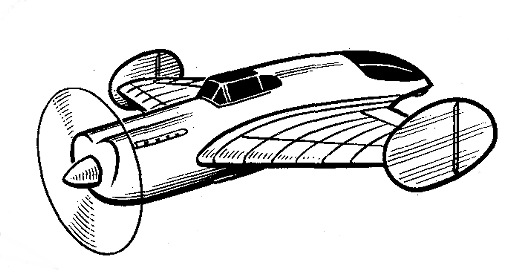
The success of the SAM-6 demonstrator allowed Moskalev to progress to his full-scale design. Designated the SAM-7, the aircraft was an all-metal tailless two-seat fighter. Like the SAM-6 before it, it made use of a single conventional wing with endplates, but it lacked the vertical tail - instead, rudders were placed on the endplates. A 750hp M-34 engine was placed in the nose driving a four-bladed wooden propeller, and two ShKAS guns were provided for each crewman (two synchronized for the pilot, two flexible for the gunner). Despite all the effort put into making monopod landing gear, the SAM-7 used conventional retractable gear. The SAM-7 would fly in 1936. Though an unusual center of gravity would suggest stability issues, the SAM-7 was surprisingly stable. However, trials were very limited, with the majority of tests consisting of high-speed taxis and the occasional hop. The program was cancelled before any significant testing could begin, as officials stated aerodynamic and structural issues had not been resolved.
Kalinin K-12

Kalinin, who had been working on tailless designs since 1934, would produce an experimental tailless bomber in 1936 designated the K-12. The K-12 was a three-man, twin-engined design fitted with two defensive machineguns in nose and tail positions and a bomb bay for 500kg of bombs. The conventional tapered wings were fitted with Junkers-style control surfaces and end-plates with rudders, giving it an unusual appearance akin to a conventional aircraft with the tail chopped off. The K-12 was fitted with conventional retractable landing gear, although the necessity to provide clearance for the propellers and short tailwheel meant the K-12 would sit with the nose very high up while on the ground. Kalinin worked extensively to validate the design before full-scale testing could begin, with a 1/2 scale glider flying 100 times before the K-12 would finally be cleared to fly. It would take flight in Fall 1936. The end-plate rudders were found to have poor authority at low speeds and minor stability problems were encountered, but the design overall seemed to validate the tailless aircraft concept. Confidence was high, and the design was ordered into production while the prototype was painted a yellow-and-red feather pattern for a flypast at Tushino in 1937. However, the whole program came to an end when Kalinin fell victim to Stalin’s purges. Production was abruptly ended, and the aircraft would ever enter service.
Kalinin K-15

The end goal of Kalinin’s tailless designs was the surprisingly modern looking K-15. The K-15 was to build on previous experience with tailless designs as well as emerging rocket technology, ideally allowing Kalinin to produce a rocket-powered delta-wing aircraft. The K-15 was a simple design, featuring a highly-swept delta wing and cockpit faired into a vertical fin. For research purposes, small-scale tests were conducted with gunpowder rockets and models to refine the aerodynamic layout. Though the design would never materialize, Kalinin’s extensive work into tailless delta designs was unparalleled anywhere else in the world at the time. Unfortunately, all his work was cut short when he fell victim to Stalin’s purges in 1938. His design bureau was dissolved, and the K-15 project came to an end.
Domrachev LEM-3
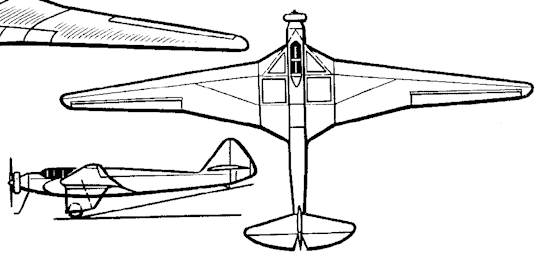
In the latter half of the 1930s, the concept of a motorglider for transport duties gained traction within the USSR. A design at the Leningrad Institute for Civil Airfleet would be the first of the proposals to fly, gaining the desgination LEM-3. The LEM-3 had a massive tapering high aspect ratio wing, fixed landing gear, and a long spacious fuselage. The crew of two sat in an open cockpit in the nose with a 100hp engine in front of them, and four cargo bays placed behind them provided space for up to 700kg of cargo or eight men. These bays were placed abreast, taking up the central fuselage and extending into the wings. The LEM-3 would take flight in 1936. It could take off under its own power with a modest payload, but it required towing to takeoff under full load. Nevertheless, the LEM-3 would pass tests. In the end, it would crash during a transit flight between Moscow and Leningrad. By then, the motorglider concept had lost its appeal, so the LEM-3 was not restored.
Antonov LEM-2
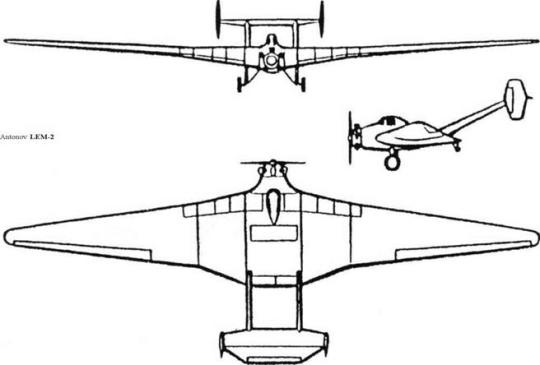
The other motorglider concept to fly would also hold the distinction of being the first powered aircraft designed by Oleg Antonov. Antonov’s glider, the LEM-2, was a far more unconventional design. The LEM-2 consisted of a large thick wing section with a specially designed airfoil that could carry the crew and cargo. The tail was held on two booms extending rearwards from the wing, and a 100hp engine was placed in the nose. Nine cargo bays were placed throughout the aircraft, providing a payload capacity of 1280 kg. Tests began in April 1937, with the LEM-2 showing the ability to take off under full load. Though the LEM-2 proved far more successful than its competitors, it would not enter production, as the USSR would soon drop the motorglider concept.
Bakshaev RK
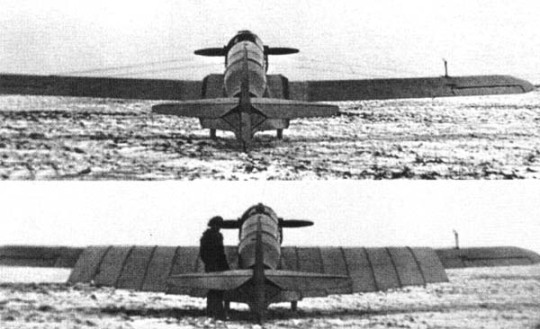
In the mid-30s, Grigori Bakshaev conceived an unusual concept for a new highly efficient wing. By using retracting wing section, an aircraft could in theory achieve low wing loading for improved takeoff and landing performance while still have an efficient high aspect ratio wing. As a demonstrator for the concept, Bakhaev created the RK. The RK was a conventional two-seat monoplane powered by a 100hp M-11 radial engine. Its only distinguishing feature was the telescoping inner wing sections that would extend to about 2/3 span to increase wing area by about a third. The RK would fly in 1937, with all design elements functioning properly. The wings were found to be easier to manipulate in the air than on the ground, and the effects of the extended wing were impressive - landing speed was reduced from 100km/h to 75 km/h, and both takeoff and landing rolls were roughly halved. With the wings retracted, however, top speed and range improved slightly. With such a compact aircraft, the improved drag from the wing was fairly small, but the effect was still significant. With the basic concept proven Bakshaev would tender a proposal for a high-speed record setting aircraft in 1938, which would gain approval from the government.
Moskalev SAM-9 Strela
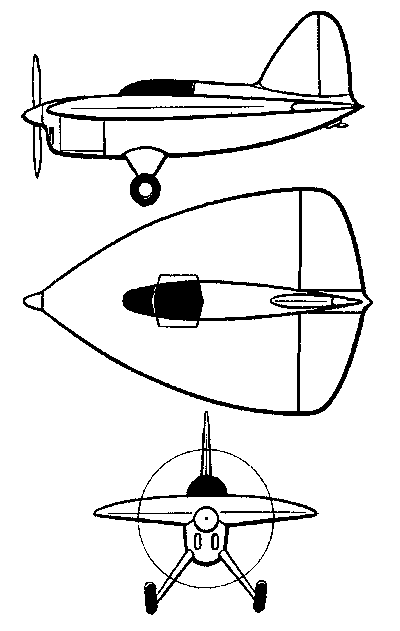
In 1936, after receiving reports that the US was studying high-speed aircraft with low aspect ratio wings, TsAGI officials belatedly offered support for Moskalev’s high-speed aircraft project. Two years after his SAM-4 was rejected, he was ordered to develop a low-speed demonstrator dubbed the SAM-9. The SAM-9 was a simple compact aircraft with a low aspect ratio ogival wing. Fitted with a 140hp engine and fixed landing gear, the design was completed in just three days. Construction took just 70 days, during which time TsAGI was aggressively testing models in wind tunnels. Tests finally began in the spring of 1937. Initial tests were problematic - the SAM-9 seemed incapable of climbing out of ground effect. However, it was soon discovered that this was the result of the delta wing-like characteristics, meaning the SAM-9 required a far higher angle of attack (in this case 22 degrees) to provide lift. Once this was figured out, trials went well. With the conclusion of trials, Moskalev was ordered to develop an interceptor based on the ogival wing. Unfortunately, because he was preoccupied with other more conventional projects, the design wouldn’t be ready until 1944.
Grushin Sh-Tandem
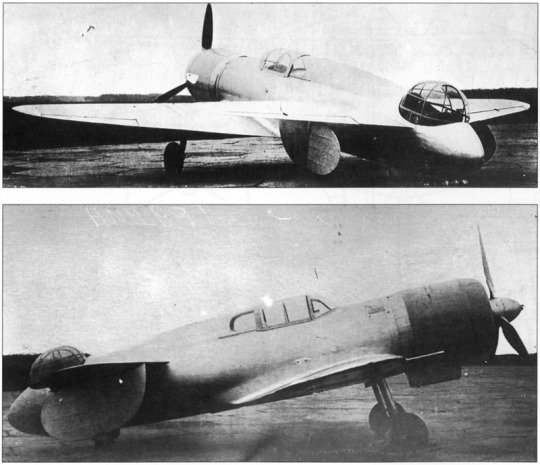
In 1937, the Moscow Aviation Institute produced an experimental new aircraft to meet a state requirement for a new ground attack platform. Suitably named the Sh-Tandem, the aircraft was a two-man design with a tandem wing. In place of a conventional tail, the Sh-Tandem had a massive horizontal surface about 45% the size of the main wing. Where the vertical tail would normally be placed was a defensive turret, and, to keep the gunner’s field of view clear, double rudders were placed under the rear wing. Unusually, both wings were to be fitted with elevators and ailerons. First flying in December 1937, the Sh-Tandem would undergo testing until 1939. Tests went well, with the Sh-Tandem demonstrating better handling than normally observed on tandem wing aircraft, but the design still lacked the support to reach production.
Cheranovsky BICh-20

Cheranovsky’s next flying wing experiment would be the compact BICh-20. The BICh-20 was a compact design intended to test a new triangular wing layout. Control came from Junkers-style control surfaces designed with an inverted airfoil section. As with many of Cheranovsky’s designs, the BICh-20 had the cockpit faired into a vertical fin and a single engine. As originally designed, it was fitted with an 18hp Blackburn engine. Trials began in 1938. During trials, it was reengined with a 20hp engine for the duration of testing. Tests found that the BICh-20 was very stable, particularly on takeoff and landing. The design would go on to serve as the basis for the larger BICh-21.
Korolev Object 218

Soon after the establishment of the RNII in 1933, Sergei Korolev began work on a high-performance rocket powered aircraft. Unlike previous rocket-powered aircraft proposals, Korolev proposed a highly advanced purpose-built design intended for very fast, very high altitude operations. First presenting his proposal in 1935, Korolev hoped to create a very light aircraft - just 640kg empty - powered by a 19.6 kN rocket. With a single pilot in a pressure suit, the aircraft would take off from the ground, climbing at 60 degrees to an altitude of 32 km, where it would hopefully reach a top speed of over 2,500km/hr. The project would gain the designation Object 218, but it would radically change in the coming years. A second crewman and pressurized cockpit was added, and the ambitious rocket motor and Mach 2 performance was dropped. However, flight ceiling goals were ambitious - the Object 218 was to reach altitudes as high as 50km. Unfortunately, the project seems to have lost favor in 1938 after Korolev was arrested as part of the purges.
Korolev RP-318

As the Object 218 was under development, Korolev decided to develop a testbed for the rocket powerplants. A simple glider, originally designated the SK-9, was built, designed for up to 7G of loading (far beyond that of a normal glider) to withstand the expected forces. As originally designed, the SK-9 had tandem cockpits for a crew of two, but the conversion to the RP-318 testbed saw the rear cockpit replaced with fuel tanks. The RP-318 would undergo ground tests through 1938, performing more than 30 test runs of the engine. However, when Korolev was arrested in 1938, the project was put on hold. It was transferred to another department to be finished, requiring minor repairs after the acidic propellant damaged the tail. Flight tests finally began at the end of 1938 with ballast installed in place of the engine, but it wouldn’t be until the end of February 1940 that the RP-318 would finally fly under its own power. Though priority went to the Bolkhovitinov BI in 1941, testing of the RP-318 would continue until August 1941, when the RP-318 was burned as the test facilities were evacuated in the face of the advancing Axis forces.
Bisnovat SK-1
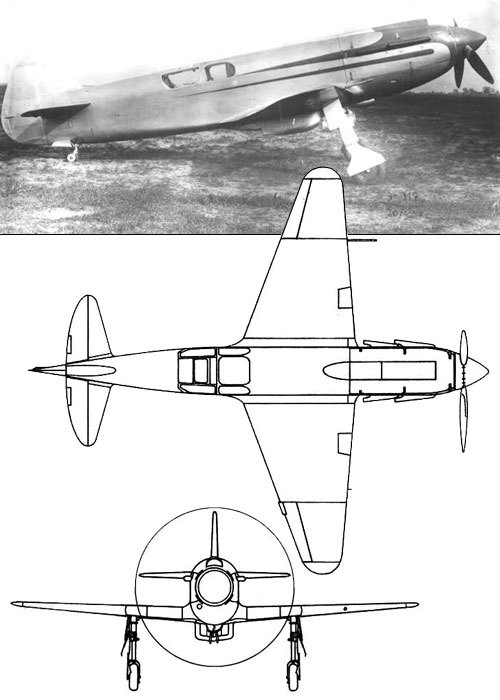
In 1938, Bisnovat was allowed to form his own OKB to construct a high-speed research aircraft. Designated the SK-1, the idea behind the design was to have the smallest possible airframe while mounting the most powerful engine available. With speed as the primary focus, the fuselage was dominated by the M-105 engine in the nose. A pressurized cooling system allowed for a radiator half the normal size, while the cockpit was set flush with the fuselage. For takeoff and landing, the pilot had a hydraulically boosted seat to raise him up so he could see ahead. Testing began in January 1939 with good results. The SK-1 had surprisingly good handling and agility despite its small wings, and, more importantly, the aircraft was tremendously fast - it hit a top speed of 710 km/hr (421mph).
Bolkhovitinov S
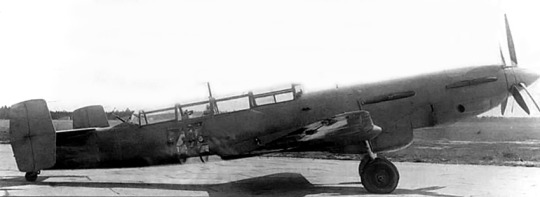
At the end of the ‘30s, Viktor Bolkhovitinov conceived an unusual design for a high-speed light bomber. Nicknamed the “Sparka”, the bomber was to use two M-103 engines joined in tandem driving contra-rotating propellers. Thus, the Sparka had a long, sleek fuselage with the crew sitting far back under a greenhouse canopy. Defensive armament consisted of a remote controlled mount in the tail. To alleviate negative effects from the small wing, the Sparka was fitted with large flaps. Payload of four 100kg bombs would be carried in a smal bomb bay between the pilot and gunner. The Sparka would first fly in 1939 with only one engine to validate the design. The next year, the second engine was mounted, allowing full testing to occur. Testing went well - the Sparka was capable of reaching a top speed of 570km/hr, and, outside of takeoff and landing, handling was good. However, range and top speed still fell short of projections. Ultimately, the despite minor improvements to the design, the Sparka would not enter production.
Nikitin-Shevchenko IS-1
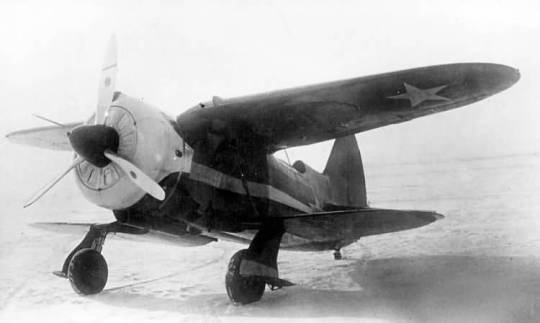
In 1938, engineer Vasili Nikitin and test pilot Vladimir Shevchenko came together to develop a unique new concept. Hoping to combine the high-speed capabilities of a monoplane with the good short-field and climbing performance of a biplane, the team conceived a fighter with a retractable wing. Taking an I-153 fuselage as a base, the team replaced the wings to fit their project. The upper wing was larger in span but narrower in chord, while the lower wing had two folding points controlled by hydraulic jacks. On the ground, the wings would drop down with the landing gear, making the IS-1 a biplane for takeoff and landing. However, landing gear would retract with the lower wing into the underside of the upper wing, turning the fighter into a monoplane for conventional flight. The IS-1 was completed in late 1939 and flown at the end of the year. The first transition between biplane and monoplane flight took place in June of the next year, proving the concept to be workable. However, performance still fell short of the modern monoplanes then in development. Rather than abandon the concept, however, the worked to refine the design.
Polikarpov I-190
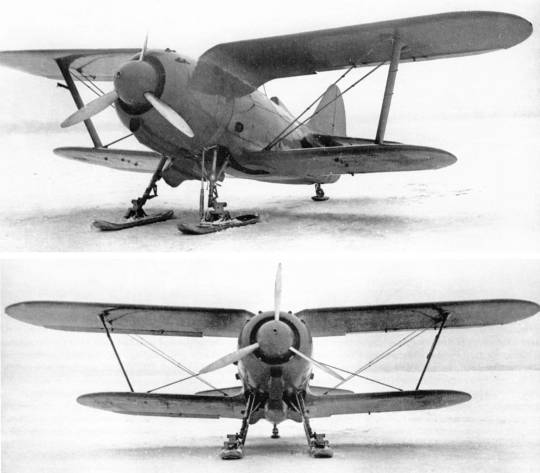
Though service over Khalkhin Gol and Spain had affirmed the biplane’s time was coming to an end, Polikarpov would make one final effort to to create a competitive biplane fighter to supplement the I-16. Working with the I-153 as a base, the I-190 was effectively the ultimate biplane fighter. A new M-88 radial with 1100hp was fitted to the nose with a new cowling, and various aerodynamic refinements were intended to improve performance. Armament options were also changed - the originally mounted four ShKAS were retained, but the option to mount two 20mm ShVAK in their place was added. Testing began on December 30, 1939. The first prototype was followed by a refined variant with a pressurized cockpit and turbocharger. Unfortunately, the results were poor. The I-190 had a significantly higher top speed at low altitudes (375 km/hr compared to the I-153’s 300 km/hr), but performance was still well below that of even the obsolete I-16. The VVS was already switching over to an all-monoplane fighter corps by then, so, after the prototype crashed in early 1941, the project was abandoned.
Moskalev SAM-13
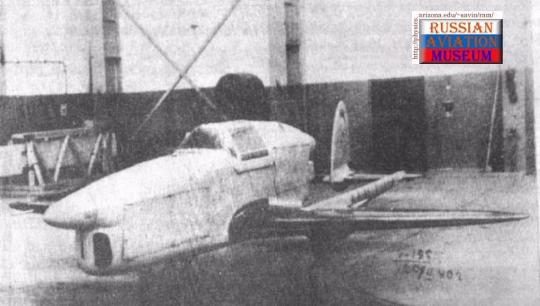
Moskalev’s last pre-war project would be a twin-engined fighter designated SAM-13. Using a push-pull configuration, the SAM-13’s more notable feature was the use of a single tail rather than the double tail commonly used on similar designs. The design overall was very sleek, with retractable landing gear and a very small frontal area, but it was hampered by its powerplants - two 236hp Renault engines driving twin-bladed propellers. The rear engine was fitted with an emergency stop to allow the pilot to bail out safely. Flight testing took place in 1940, finding numerous flaws. The low engine power and high wing loading meant takeoff rolls were long, climb performance was poor, and the flight ceiling was low. Trials went slowly, ultimately coming to an end when the German invasion began.
Grushin BB-MAI
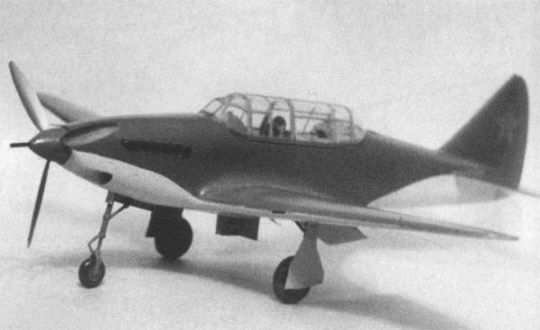
As war loomed, the Moscow Aviation Institute began work on a new light bomber concept. The BB-MAI, as it was known, was a two-man design powered by an M-105 engine and fitted with tricycle landing gear. Outwardly unimpressive, the design featured an advanced wood laminate construction that resulted in a very light yet robust airframe. Apart from the tricycle landing gear, notable features of the design included a supercharger and leading edge slats. The BB-MAI began testing in late 1940. Performance was generally good, even with all the advanced design elements. Unfortunately, the BB-MAI received little interest from the VVS, who ultimately selected the Ilyushin Il-2 to meet their light bomber requirements.
Nikitin-Shevchenko IS-2
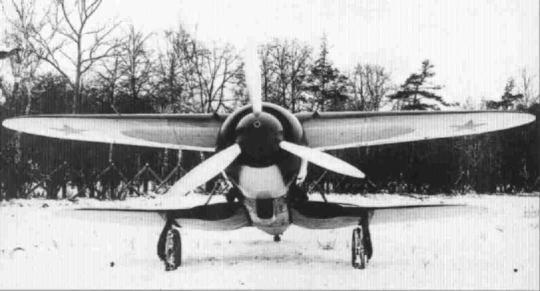
After the successful demonstration of the wing folding mechanism on the IS-1, Nikitin and Shevchenko went to work on creating a testbed more suitable for service. Their first attempt would be designated the IS-2. The IS-2 refined the lines of the original design, replacing the I-153’s fuselage and engine with a smaller-diameter M-88 radial with a redesigned cowling. Taking flight in 1941, it demonstrated better performance than the IS-1, but it still wasn’t enough to justify the extra weight and complexity of the wing folding mechanism. It ended up being cancelled without even being submitted to state trials.
Nikitin-Shevchenko IS-4
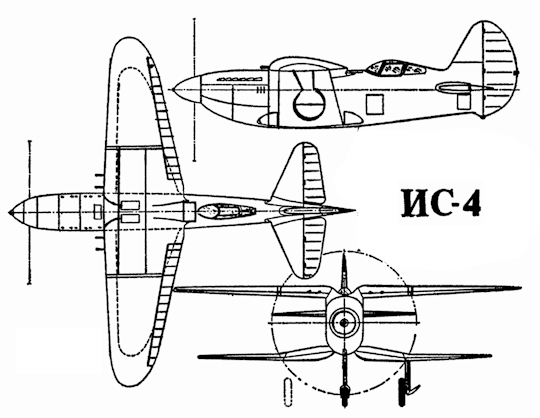
The final development of the Nikitin-Shevchenko wing folding mechanism would be the IS-4. A complete reworking of the previous designs, the IS-4 hoped to create a competitive design by making use of powerful inline engines - either the 1650hp M-120 or the 1400hp AM-37. A new, sleek fuselage featured an enclosed cockpit, and the conventional undercarriage of the previous designs was replaced with tricycle landing gear. Projected performance was impressive - the IS-4 2 was to reach a top speed of 720 km/hr. It apparently would fly sometime in 1941, but the aircraft and testing records were lost during the German invasion. Ultimately, the IS-4 program would end there. The desperate war situation meant there was little time or resources to spare on such an unconventional design, so the IS folding-wing concept was dropped
Cheranovsky BICh-21
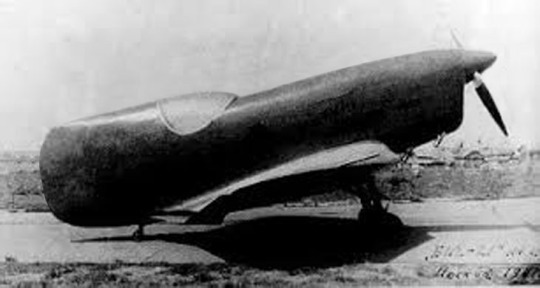
After successful testing of the BICh-20, Cheranovsky decided to scale up the design. The BICh-21 would share the same general layout, but it featured retractable landing gear, a rudder, and an engine 11 times more powerful than the one on the BICh-20. Preliminary wind tunnel tests were promising, showing the design to be sound despite minor longitudinal instability that was alleviated with changes to the tailfin. Test flights began in 1941, running until being interrupted by the war. The BICh-21 was found to be stable and easy to fly, eventually setting a speed record for its class. However, trials would not be completed because of the onset of the war.
Belyayev EOI/PBI
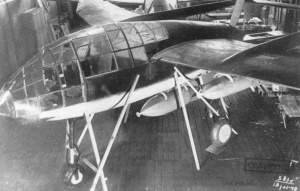
In August 1939, Viktor Belyayev was commissioned to develop an experimental twin-boom pusher-engined fighter. Belyayev would design a compact aircraft with slightly swept wings, tricycle landing gear, and an egg-shaped fuselage nacelle. The pilot was placed in the extreme nose in a greenhouse canopy that provided an excellent forward view, and the M-105 engine that drove the aircraft sat behind him. Parallel to the fighter design (designated EOI), a dive-bomber variant was also proposed under the designation PBI (literally Dive Bomber Fighter). Unfortunately, work went slowly, and the prototype was not complete by the time the war broke out in June 1941. Belyayev’s workshop was overrun in October, and the prototype along with the vast majority of the design work was lost.
Bakshaev RK-800
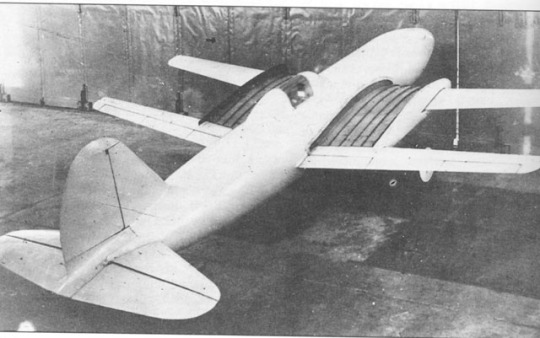
The success of the RK retractable-wing demonstrator spurred Bakshaev to develop a more ambitious experimental aircraft based on the same concept. Designated the RK-800, the new aircraft featured two very thin tandem wings, over which the retractable wing glove could extend the entire span. When extended, the forward wing was covered completely, while the trailing edge of the aft wing was left uncovered to allow control surfaces to function. With the wing glove retracted, wing area dropped from 28 square meters to just under 12. Fitted with an M-105 engine, the RK-800 was intended to break 800km/hr in level flight. It was originally ordered in 1938 for trials in 1940, but work went slowly by the 1940 deadline the project had only goteen as far as full-scale wind tunnel testing of mockups. By then, the engine had changed to the more powerful M-106. Unfortunately, this engine would kill the project. The prototype airframe took shape fairly quickly, but major delays in the M-106 engine development prevented the RK-800 from flying. Before the German invasion even began, Bakshaev was reassigned to more pressing projects and his project was put on hold. It would be abandoned completely after the invasion.
Bereznyak-Isayev BI
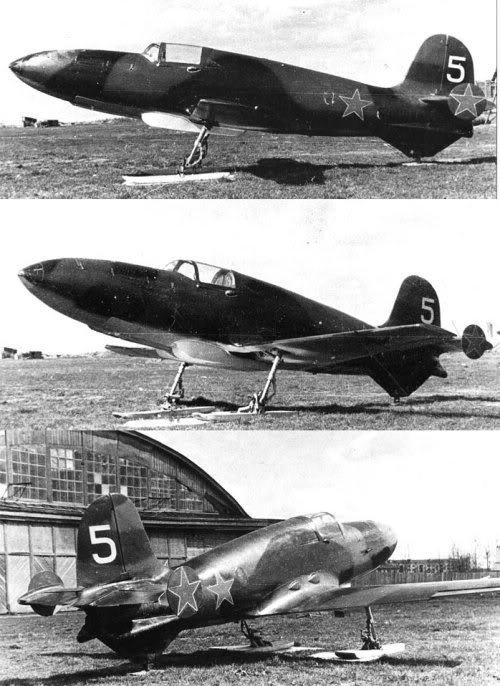
In 1938, engineers Alexander Bereznyak and Aleksei Isayev of the Bolkhovitinov OKB presented a proposal for a high-speed rocket-powered aircraft to TsAGI. The proposal gained support, so they developed a preliminary proposal in 1940 that called for a 1500kg aircraft to mount the planned 1400kgf motor then under development by RNII. Unfortunately, motor development was slowing the project. The planned D-1A-1100 motor was producing far less force thrust than expected due to issues with the fuel compression system. Though the project was on fairly low priority at first, the capabilities offered by the team’s proposal allowed it to not only survive the chaos following the German invasion in 1941 but be placed on priority for development. The project gained the designation BI, and, with the project’s success being of the utmost importance, a simple compressed air system was used to alleviate the engine issues.
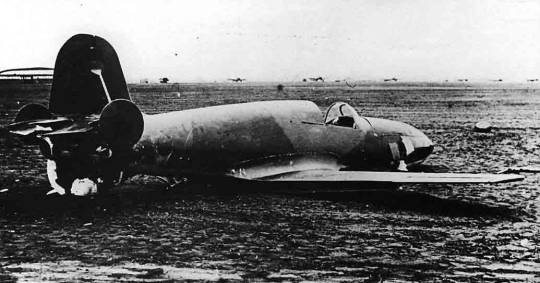
The BI that took shape was a simple low-winged monoplane design. The single rocket motor was placed in the extreme tail, while a solid nose provided space for a pair of ShVAK cannon. Mostly wood in construction, the fuselage was filled with propellant tanks. Though the propellant was highly corrosive, the tanks were not corrosion resistant, meaning that they would have to be regularly maintained and replaced. Glide tests began in September 1941, as the motor was still not ready, and the next month, the entire team was evacuated to the Urals. Static engine tests began soon after the relocation, and by May 1942 flight testing had finally begun. Unfortunately, the corrosive fuel would end up heavily damaging the airframe, forcing the retirement of the first prototype after just two powered flights. The second prototype would fly in January 1943, followed by a third in March.

Testing slowly pushed the flight envelope, first reaching full engine thrust and then working to reach maximum attainable speeds and climb rates. Unfortunately, on a low-altitude high-speed run, the third prototype abruptly nosed over and crashed, killing the pilot. Subsequent investigations discovered the BI lost control authority at transonic velocities. During the investigation, the team developed the BI-6, which aimed to address the short burn time of the engine by mounting ramjets on the wingtips of the fighter. After relocating to Moscow in 1944, testing began again. The BI-6 began glide tests, but proved unable to start both ramjets in flight. Meanwhile, the only other powered prototype - the BI-7 - would be fitted with the RD-1 motor. Again, work went slowly, and only in early 1945 did flight tests begin. Ultimately, it would only fly twice before corrosion permanently grounded the aircraft. Unfortunately, the numerous corrosion, stability, and flutter issues that plagued the program would delay the BI so long that it would never enter service. By 1945, turbojets were proving a more promising avenue for fighter development, so the BI project came to an end.
Tikhonravov I-302
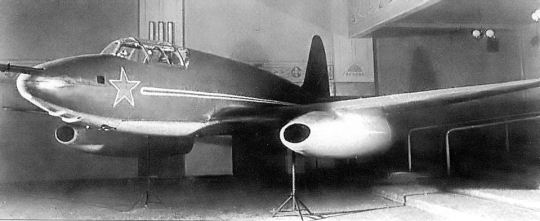
Parallel to the BI interceptor project, another rocket powered fighter was being developed directly by the RNII. After the arrest of Korolev, Tikhonravov was placed in charge of the department, and in 1940, work began on a rocket powered interceptor with ramjets mounted under the wings. Intended to mount the same D-1A-1100 motor of the BI, it would carry four ShVAK cannon in the nose. Original plans called for the I-302 to be a clean low-winged monoplane with ramjets slung under each wing midway down the span and a rocket motor in the tail, but delays in the ramjet development meant that the project would proceed as a purely rocket-powered aircraft at first. Meanwhile, the powerplant had switched over to the RD-2 motor, and development was halted briefly as the RDII relocated to the Urals. Full-scale development was only approved at the end of 1942. Extensive glide and wind tunnel testing began in 1943, continuing into 1944. The I-302 was proving very stable and easy to fly, but engine issues continued to plague development. Ultimately, this would spell the end for the project - in March 1944, the I-302 was cancelled on the grounds that the engine was not providing the expected performance.
Polikarpov Malyutka

In June 1943, the Polikarpov OKB began work on a rocket-powered point-defense interceptor. As with the other rocket interceptor design projects of the time, the Malyutka, as the project was known, was a simple low-winged monoplane with two cannon in the nose. Fairly compact, it featured elements never before seen on a Polikarpov design, including a pressurized cockpit and tricycle landing gear. It was planned to reach a top speed of almost 850 km/hr with an endurance between 8 and 14 minutes. Work was generally going well, with the prototype under construction by 1944. The prototype was almost complete when, on July 30, 1944, Polikarpov died of a heart attack. Following Polikarpov’s death, his OKB was folded into Lavochkin and all ongoing projects were cancelled, putting an end to the Malyutka.
Tomashevich Pegas

One of the most peculiar designs to come out of the USSR in the Second World War was the Pegas. By the end of 1941, the practice of nighttime harassment bombing had become standard, but such operations were largely conducted by a wide variety of obsolete aircraft. Hoping to create a simpler, cheaper platform with which to perform these missions, Tomashevich was ordered to develop a night bomber. The resulting Pegas was incredibly crude. A very simple angular wooden design was intended to be as easy and cheap as possible to assemble, while a heavy armored cockpit was developed to protect the pilot. Power came from two M-11 radial engines, and armament was to be a single fixed UB machinegun and racks for a single 500kg or two 250kg bombs. Five prototypes were built, the first of which was configured as a biplane. Testing began in Siberia in 1943. Unfortunately, though the Pegas was amazingly simple and cheap, it still wasn’t enough to warrant production - night bombing duties would remain the domain of the ubiquitous U-2, R-5, and R-Z biplanes.
Gudkov Gu-VRD

In 1943, Gudkov was tasked with developing an airframe for the still developing Lyuka VDR turbojet. As the USSR’s first attempt to develop a jet fighter, the Gu-VRD understandably had several unusual features. Apart from a general layout more suited to a conventional piston-engined fighter (heavily derived from the LaGG-3), the Gu-VRD was designed with a stepped layout, with the engine venting under the fuselage, and an unusual pointed nose with four separate intakes. The project proposal was submitted to the VVS in April 1943, calling for a top speed of 900km/hr, range of 700km, and armament of a single ShVAK cannon and BS machinegun. Unfortunately, the program was cut short by the failure of another of Gudkov’s projects - the Gu-1 fighter - which had ended in a fatal crash. Gudkov’s design bureau was dissolved, and the ongoing delays in Lyulka’s engine gave little reason for the project to continue.
Lavochkin La-VRD

In early 1944, Lavochkin began their own project to develop a jet fighter using the very same VDR turbojet that Gudkov’s project was designed around. Unlike Gudkov, Lavochkin used a far less conventional design, with a twin-boom layout and side-mounted intakes. The pilot sat in a pressurised cockpit in the central nacelle along with an armament of two NS-23 cannon, with an armored plate and Lyulka turbojet sitting behind him. Tricycle landing gear was used, as was a laminar-flow airfoil. TsAGI was consulted for advice on the design, approving of the design. Unfortunately, engine issues would stall the project. The Lyulka powerplant was having issues with accelerating from idle, and plans called for the prototype to only be ready by March 1946. Design work on the prototype was completed by the end of 1944, but the project was soon cancelled as the decision was made to accelerate jet fighter development by making use of captured German engines.
Sukhoi Su-7

As part of efforts to create a stopgap fighter until jets came along, Sukhoi converted one of the single-seat prototypes for their failed Su-6 attacker into a rocket-powered fighter. Designated the Su-7, the fighter had all armor removed and the tail modified to mount an RD-1 rocket. Fuel for up to four minutes of rocket boost was provided. Testing began in 1944, finding that the rocket motor provided a speed boost of over 100km/hr. However, performance without the rocket booster was mediocre compared to other fighters already in service. Testing nevertheless continued into 1945, but after the rocket motor exploded in flight - killing the pilot and destroying the aircraft - the project was abandoned.
Lavochkin La-7R
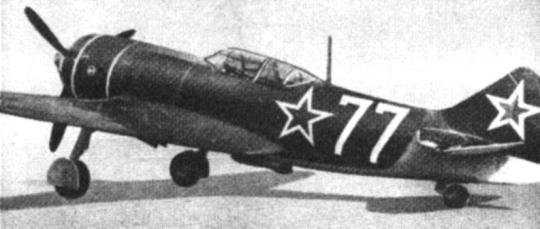
At the end of 1944, the Lavochkin OKB was tasked with adapting the RD-1 rocket motor to their La-7 fighter to serve as a stopgap until jet engines were available. Two La-7s were converted, one with the RD-1 and one with the R-1KhZ motor, both of which provided 300kg of thrust . The motors were mounted in the tail of the La-7s, requiring modifications to the rudder to accommodate it and a 90 liter tank for kerosene and 180 liters of nitric acid. Flight trials began at the end of 1944. During trials, the first La-7 had its motor explode on the ground in May 1945. The surviving aircraft would suffer an explosion in flight, but it was safely landed, repaired, and returned to service in time to make a flyover at the Tushino parade in August. 1946. While the La-7R was capable of achieving a brief 80 km/hr boost, this came at the cost of reduced handling and maneuverability, as well as the dangers associated with the rocket motor. With turbojets now coming into service, the La-7R was no longer necessary, so after the Tushino flypast, the program came to an end.
The Motorjets
As the end of the Second World War loomed, the USSR was still struggling to develop a workable jet engine even as other nations were beginning to field jet fighters. Hoping to provide a simple stopgap while captured German engines were reverse-engineered for production, the development of motorjet fighters was commissioned. The motorjet concept was a fairly simple albeit crude solution - use a piston engine to drive the compressor fans for a jet. Effectively amounting to a ducted fan with an afterburner, this was still more promising than the various rocket-powered aircraft proposals, so work went ahead. Sukhoi and Mikoyan Gurevich were commissioned to develop their designs, resulting in the Su-5 and I-250. Ultimately, neither proposal would see significant production, as jet development had finally picked up pace as testing began.
Mikoyan Gurevich I-250
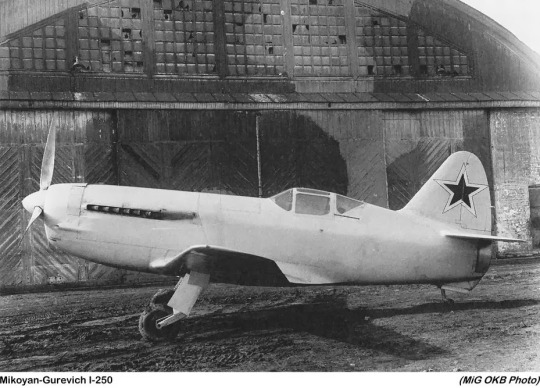
MiG’s motorjet fighter was the ungainly I-250. While conventional in layout, the airframe was dominated by the twin powerplants of the design. Primary power came from a 1650hp VK-107 piston engine in the nose, with intakes under the engine fed to a VRDK motorjet, which bled power from the engine to function. Because of the massive size of the engine, the pilot sat very far back in the fuselage. Despite the aircraft’s large size and deep fuselage, fuel capacity for the motorjet was small - the I-250 would only be able to run the VRDK for 10 minutes. Though nominally a technology demonstrator, the I-250 was armed with three B-20 cannon. The first prototype would fly in March or April 1945 without the VRDK installed. Subsequent tests installed the motorjet, but the powerplant proved troublesome.

Although one prototype would be lost during testing, the I-250 would be ordered into production in July 1945 after being deemed superior to the competing Su-5. An order for several pre-production machines was placed, but production issues delayed their delivery until mid 1946. Despite the delays, an order had already been placed that February for 50 production machines under the tentative designation MiG-13. Tests of the pre-production machines went terribly. Engine problems prevented a planned appearance at Tushino in August 1946, and acceptance tests themselves would be delayed due to the longer-than-expected trials of the VRDK engine. Meanwhile, the VVS and PVO had settled on the MiG-9 for their new fighter, leaving the I-250 without an operator. MiG tried to save the design by pitching it to Soviet Naval Aviation as an escort for torpedo bombers, allowing it to begin trials once more in 1947. However, this effort was short lived. In April 1948, the I-250 program came to an end when the Soviet Navy declared that the I-250 had failed acceptance tests.
Sukhoi Su-5
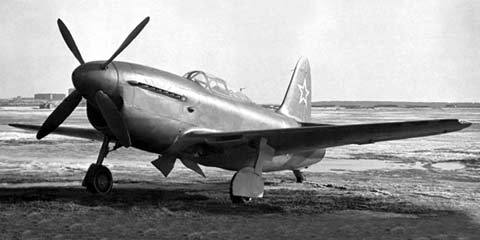
Sukhoi’s motorjet fighter was given the designation Su-5. Like the I-250, the Su-5 was fitted with the 1650hp M-107 powerplant in the nose and a VRDK motorjet in the tail, resulting in a large, deep fuselage. Armament consisted of a 23mm cannon and two 12.7mm machineguns. Flight testing began in June 1945. During tests, it was determined that the Su-5 was inferior to the I-250. Though it may have had a more favorable cockpit layout, the Su-5 had a significantly shorter range and endurance, only carrying enough fuel to run the motorjet for three minutes (compared to the I-250’s 10 minutes).
Florov Samolyot 4302/4303
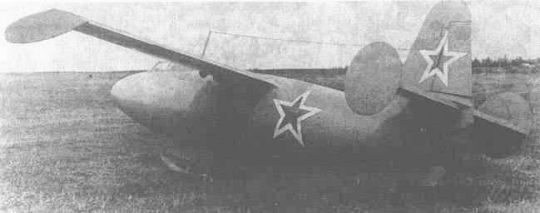
At the end of WW2, the VVS commissioned Ilya Florov to develop an experimental aircraft to investigate high speed transonic flight. Given the intended role, the Samolyot 4302 had to be incredibly compact - the fuselage was just barely large enough to fit the pilot rocket, and fuel. With swept-wing information not yet available to Florov, he instead settled on a shoulder-winged design that oddly enough closely resembled the Heinkel He 162. A thin laminar flow airfoil was developed with TsAGI for use on the design, and a pressurized cockpit was provided for the pilot. The first 4302 was designed with fixed landing gear, while all subsequent aircraft would use a jettisonable cart and retracting skid much like the Me 163. Flight tests began with unpowered glides in 1946, followed by powered tests the next year. Meanwhile, the more capable 4303 was awaiting its powerplant. However, in mid 1947, the whole project was cancelled due to progress with jet engines. The powerplant slated to be used on the 4303 was diverted over to MiG, who was still working on their rocket-powered I-270.
DFS/Bereznyak 346
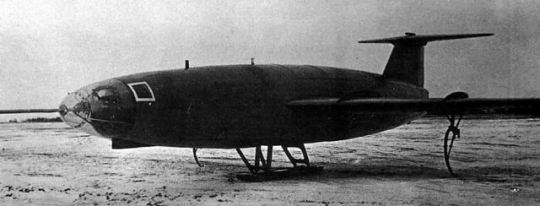
During WW2, Felix Kracht of the German Sailplane Institute (DFS) began work on a high-speed research aircraft. Unlike any other designs to come from DFS, the 346 was a heavily streamlined aircraft with swept wings and a rocket powerplant intended to propel it through the sound barrier. The pilot was to be placed in a prone position in the nose to reduce drag, with the cockpit being pressurized and designed to detach as an escape capsule in an emergency. Plans called for the 346 to be carried on the back of a Do 217 to a comfortable launch altitude, at which point the aircraft would detach, fire its motors, and climb to 100,00ft and reach Mach 2.6. Operationally, there were tentative plans to use it for reconnaissance. Unfortunately for Kracht, the project fell into the hands of the Red Army at the end of the war.

Fortunately, the end of the war would not spell the end for the 346. The project continued under the Soviets, resuming development in 1946. TsAGI wind tunnel testing revealed several aerodynamic deficiencies, resulting in the installation of several wing fences and the lengthening of the fuselage. The original prototype was completed and glide tested in 1946, but it wouldn’t be until mid 1951 that powered flights would begin. Launched from under the wing of a Tu-4, the 346 was found to have stability and control issues as it approached the speed of sound, so tests were limited to Mach 0.9. Nevertheless, the 346 would be lost in a crash on its third powered flight after the aircraft lost control in a high speed run. Although the pilot safely ejected (thanks to the escape capsule), the crash of the prototype put an end to the program.
Mikoyan Gurevich I-270
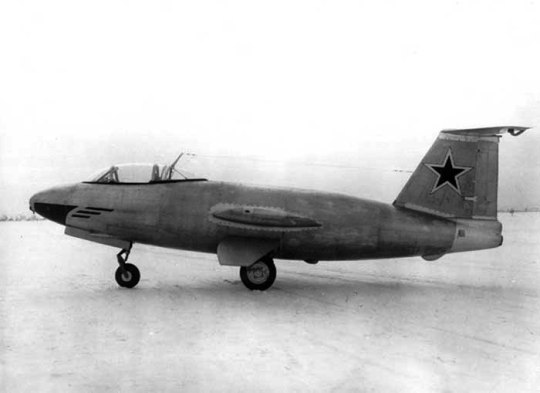
Although rockets had generally fallen out of favor, MiG would pursue one final effort to produce a rocket-powered interceptor at the end of WW2. Because of the poor performance of early jets, a rocket could theoretically offer superior performance at altitude. Under the designation I-270, MiG designed an aircraft heavily derived from the Messerschmitt Me 263 while working closely with TsaGI. Problems with swept wing designs caused MiG to opt for a thin straight wing instead, while anticipated highs-speed stability issues led to the adoption of a T-tail. The I-270 would first fly in glide tests at the end of 1946. A second prototype began powered testing early the next year, but both prototypes would soon be damaged beyond repair in landing accidents. By then, jet development was progressing smoothly enough that a need for a point-defense rocket interceptor was gone, so the VVS canceled the I-270.
Cheranovsky BICh-26

Through WW2, Cheranovsky was running his own design bureau with the intent of developing a new high-speed aircraft. Through design studies designated BICh-24 and -25, he gradually settled on a compound-sweep tailless design, while the advent of jet propulsion made much higher top speeds far more practical. By the end of WW2, Cheranovsky was working on a novel new fighter design designated the BICh-26. The BICh-26 was incredibly modern looking, with a compound-sweep tailless layout. It was powered by a single AM-5 turbojet fed by intakes in the cheeks, leaving space in the nose for armament or radar. Even better, the wing planform allowed for a thick, spacious wing and fuselage to be used without compromising high speed performance. Thanks to Cheranovsky’s extensive experimentation, the BICh-26 was projected to have a top speed of Mach 1.7. Ultimately, however, the BICh-26 would never come to pass - by 1948, Cheranovsky’s health was failing, and all his projects came to an end.
Bisnovat 5
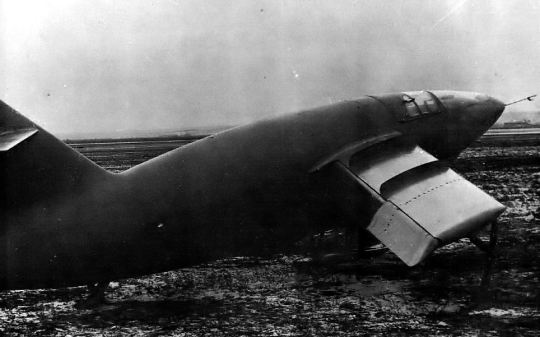
Shortly after work began on the 346, Matus Bisnovat began a separate high-speed project, building on his previous experience with the I-302. With similar goals to the 346, it’s unsurprising that the design was very similar - a bullet shaped fuselage with swept wings, a high-mounted tail, landing skids, and wing fences. The pilot sat in a heavily streamlined, pressurized cockpit in a conventional ejection seat, as the prone position of the 346 was deemed too uncomfortable. Unlike the 346, however, the Bisnovat 5 was to use a Pe-8 as its carrier aircraft. Before full-scale tests began, TsAGI would run wind tunnel tests up to Mach 1.45, paving the way for flight testing. Unfortunately, things went poorly from the start. The first unpowered test drop resulted in the prototype hitting the Pe-8 right after release, and subsequent flights found the aircraft had poor lateral stability, ultimately leading to the crash of the first prototype.The second prototype would fly in January of 1949, making use of changes to fix the stability issues. Unfortunately, the Bisnovat 5 would never make a powered flight. It would prove satisfactory, but the American X-1 and D-558-2 had already broken the sound barrier, as had the Lavochkin La-176. The high-speed test platform that was the Bisnovat 5 was no longer needed, so, in June 1949, the project came to an end.
Tsybin LL
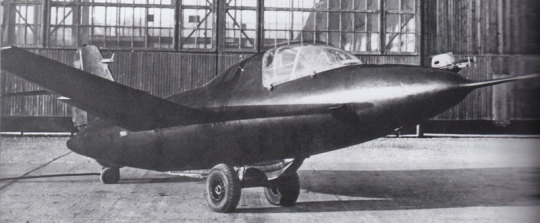
In September 1945, Tsybin was tasked with developing new wing planforms for high speed flight. Working with TsAGI, Tsybin created two new wing designs, one being a conventional unswept layout and the other being a forward-swept design. These wings were put onto a fuselage developed by Bereznev, fitted with a rocket engine for testing. The straight-winged design was first fly in mid 1947, being towed to a launch altitude by a Tu-2. At the end of the year, the LL was refitted with the forward swept wings. These wings were a radical departure from any previous design - they featured a sweep of 30 degrees and dihedral of 12 degrees. It would fly the next year, making over 100 flights and reaching a top speed of Mach 0.97 without incident. The project provided large amounts of valuable data on high-speed flight, but the novel wing planform would not progress any further.
Yakovlev Yak-1000
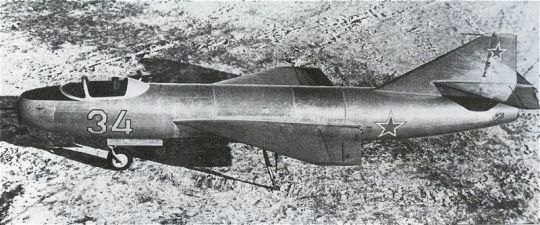
In 1950, Yakovlev was directed to develop an experimental supersonic fighter around the AL-5 turbojet. Hoping to reach speed approaching Mach 2, Yakovlev closely followed TsAGI recommendations for a compact aircraft with a small cropped delta wing. Bicycle landing gear was used, and, despite the use of outrigger struts to stabilize the aircraft on the ground, its landing gear track remained dangerously narrow. Unfortunately, the AL-5 ran into delays as the Yak-1000 progressed, so the RD-500 was substituted. While this would still allow for supersonic performance, the performance losses were still enough to shift the focus of the program to a pure demonstrator aircraft. The prototype Yak-1000 was completed in early 1951, beginning taxi trials in March. Unfortunately, on the second day of testing, a strong gust blew the aircraft off the runway on a high-speed taxi trial. The resulting damage from the incident grounded the Yak-1000 as the prototype was repaired and engineers worked to remedy instability issues revealed in the brief testing. Ultimately, however, the efforts were brief - the Yak-1000 was cancelled in October 1951.
Mikoyan Gurevich SM-12

As the MiG-19S began to enter service, MiG commandeered several examples to serve as a testbed for new high-speed intakes. Under the designation SM-12, the new aircraft were to be a simple conversion of the MiG-19, retaining the majority of the fuselage and wings, as well as the armament. The first two prototypes were little more than a MiG-19S with a refined intake fitted with a shock cone. The conversion was fairly simple, so the first examples would take flight in 1956. The third prototype was fitted with upgraded engines, allowing it to reach significantly higher speeds than the other two aircraft. As such, the SM-12 entered consideration for use as a point-defense interceptor. Subsequent prototypes would receive the designation SM-12PM, replacing the MiG-19S’s armament with an air-intercept radar and two K-5M beam-riding missiles. In 1958, MiG went a step further, mounting a rocket booster on the sixth prototype to allow the SM-12PM to reach a top speed of Mach 1.69. However, the program would end there - the decision had been made to manufacture the Ye-7 instead as the MiG-21.
Mikoyan Gurevich Ye-50
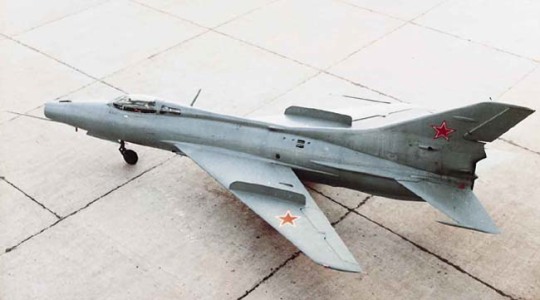
After the selection of the delta-winged Ye-4 over the swept-winged Ye-2 to become the MiG-21, MiG took the Ye-2 prototype and converted it to serve as a testbed for various interceptor concepts. Under the designation Ye-50, the Ye-2s were fitted with a S-155 rocket booster at the base of the tailfin. Other modifications were minor, such as removing one of the three 30mm cannon the prototypes had been armed with. Flight testing began in 1956. Over the course of testing, at least one of the prototypes was modified further with an extended nose and the removal of all armament, while another would be more extensively reworked with a new R-11E-300 turbojet and large ventral fuel tank. Testing generally went well - the Ye-50 proved capable of reaching Mach 2.3, and the rocket booster extended the flight ceiling to 23km. It was considered for use as a dedicated U-2 interceptor, but it would never be put into production.
Matveyev Turbolet

The USSR’s first jet-powered VTOL platform design - the Turbolet - would take shape in the 1950s under the command of the LII (Flight Research Institute). Like many early VTOL testbeds, the Turbolet was crude and impractical. It consisted of a large vertically-mounted turbine engine with scaffolding around it to support four-point landing gear, a cockpit, and outrigger jet nozzles for stabilization. To provide control, airflow from the engine could be vented outwards to the four outrigger nozzles. Flight testing began in 1957, with flights made by the USSR’s preeminent helicopter test pilot. The extent of testing is unclear, but the program appears to have gone without incident, providing valuable data for a nascent VTOL jet program.
Tsybin NM-1
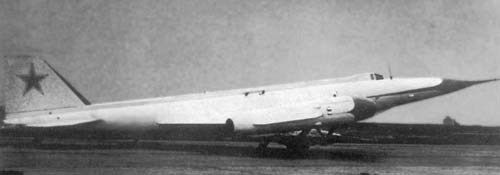
In 1955, Tsybin was selected to develop a Mach 3 ramjet-powered strike/reconnaissance aircraft. With the ultimate design to be designated the RS, Tsybin would first be commissioned to create a full-scale tech demonstrator under the designation NM-1. The NM-1 was a simplified version of the final design, carrying proven AL-5 turbojets in place of ramjets and stressed for lighter loads. Unlike the planned final product, the NM-1 would take off under its own power rather than be launched from a Tu-95. However, landing gear remained simple - a jettisonable cart for takeoff and retractable skids for landing. As work began on the NM-1, the RS was determined to be incapable of meeting project requirements, so it was modified, dropping the nuclear strike role and taking on the designation RSR.

The NM-1 would take flight in 1959. Testing emphasized low-speed performance as the design was expected to have issues at low speeds. The first flight found that the aircraft had a far higher takeoff and landing speed than anticipated, but otherwise it was aerodynamically sound. A total of 32 tests were flown, finding the NM-1 to handle fine. Despite the high stall speed, test pilots reported favorably about takeoff and landing characteristics, declaring that it was easier than on a MiG or Sukhoi aircraft. Although the NM-1 provided invaluable data that was applied to the RSR, the final product would never be. Five airframes were completed and awaiting engines in 1961 when Nikita Khrushchev cancelled it due to a new emphasis on ballistic missiles.
Mikoyan Gurevich Ye-8
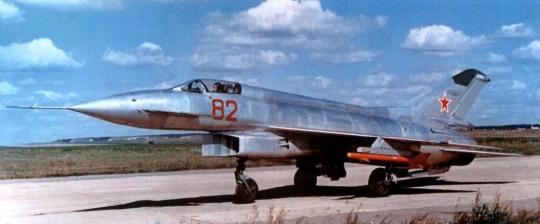
In 1961, MiG was commissioned to develop a replacement for the MiG-21. Taking a MiG-21 as a base, MiG substantially modified the aircraft to create the Ye-8. The Ye-8 had a completely redesigned nose to accommodate the Sapfir-21 radar, forcing MiG to move the inlet under the nose. Numerous other innovations were added as well, including free-floating canards, blown flaps, and a folding ventral fin. To top it all off, the new R-21F engine was installed. The Ye-8 made its maiden flight in April 1962. That September, the first prototype was lost to a catastrophic engine failure at Mach 1.7. A subsequent crash investigation revealed lateral oscillation issues that would cause uncontrollable spins, as well as numerous other technical issues. Although the Ye-8 had served as a useful testbed for various new technologies, it would have to be abandoned.
Beriev Be-1
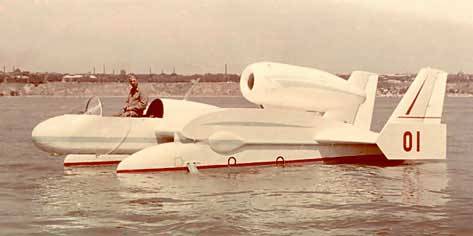
In 1956, Bartini came to Beriev with a proposal for a wing-in-ground-effect vehicle. Beriev liked the proposal, commissioning a small-scale testbed to explore the characteristics of such an aircraft. The testbed, named the Be-1, was a floatplane featuring two floats connected to the fuselage by a very low aspect-ratio wing. Smaller wing panels extended further outboard of the floats, and small hydrofoils were placed under the floats to assist in takeoff. A single RU-19 turbojet, placed above the fuselage, powered the design. The Be-1 took flight for the first time in 1961, starting with flights from land. Flight tests continued for several years, gradually transitioning to flights over water and validating the concept of a ground-effect vehicle.
Tupolev Tu-95LAL
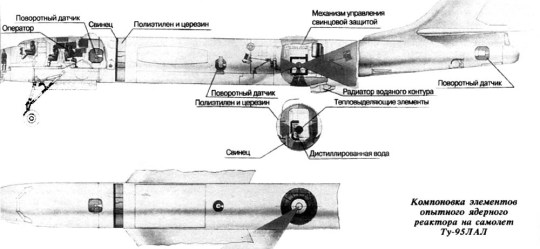
In 1955, Myasishchev and Tupolev were commissioned to begin developing a nuclear-powered bomber. As Kuznetsov and Lyulka figured out the finer details of the powerplants, Tupolev went ahead with a demonstrator to examine the feasibility of using an airborne nuclear reactor. A Tu-95M was modified for the role, taking on the designation Tu-95LAL. A small nuclear reactor was installed in the rear bomb bay along with various pieces of radiation shielding. The reactor provided no power to the aircraft, as the Tu-95LAL was intended primarily to test the safety of the arrangement. The reactor was turned on in 1958, allowing ground testing to commence, and in 1961 the Tu-95LAL would fly for the first time. The first flights occurred with the reactor shut down, although later tests would fly with a working reactor. Tests revealed that the radiation shielding was satisfactory, so work went ahead on the Tu-119, which was to use the reactor to power the two inboard engines. However, the project would never leave the drawing board - the shift towards ballistic missiles, as well as safety concerns in the event of a crash, led to the cancellation of the nuclear-powered bomber program
Alekseev SM-1

Parallel to Beriev’s ground-effect vehicle demonstrator, the Alekseev OKB had begun their own ground-effect vehicle program. Since the end of WW2, Alekseev had been pushing hard for the development of a ground-effect vehicle for coastal naval operations, and in 1960 he finally got approval for a full-scale demonstrator. Designated the SM-1, the aircraft was a fairly long machine featuring tandem low aspect-ratio wing and powered by a single turbojet mounted above the fuselage. A crew of three to four was placed in a tandem cockpit in the fuselage. The SM-1 would make its first flight in July 1961. Initial tests went poorly, as the SM-1 had a very high takeoff speed and poor handling. However, by rebuilding it with a T-tail, the worst of the issues were alleviated. Over the course of testing, Alekseev arranged a ride for the soon-to-be Defense Minister, bringing the project a high degree of support. Unfortunately, testing ended early when the second prototype was heavily damaged in a fire and the first crashed in January 1961. Testing of the concept would continue, but the SM-1’s career was over.
Alekseev SM-2

After the second SM-1 prototype was damaged in a hangar fire, it was rebuilt as the refined SM-2. Taking flight in 1962, the SM-2 built upon lessons learned from the SM-1, using a more streamlined design (particularly in the engine mounting). Two engines were mounted on the aircraft - one in the tail and another in the nose. While the aft engine vented normally, the forward engine exhausted under the wings, improving the ground-effect lift. Nevertheless, the SM-2 still demonstrated impractically high takeoff speeds. While it was a definite improvement over the SM-1, the concept still had a ways to go. Fortunately, a successful demonstration to Kruschev was enough to bring Alekseev support for a larger-scale demonstrator.
Moscow Aviation Institute MAI-62
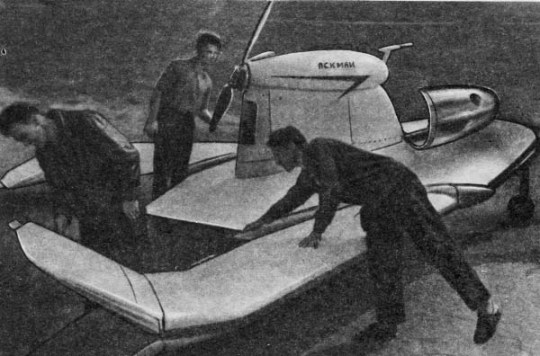
In 1958, a team of students at the Moscow Aviation Institute began work on an experimental tailless aircraft designated MAI-62. The MAI-62 was a compact design powered by a single 80hp engine mounted behind the cockpit. Although the tailless layout was nothing new, the control surfaces were a novel new design. At either wingtip, a surface extended straight back beyond the trailing edge. These long, thin surfaces would act as the elevons to provide control. Testing began in 1962. Although the MAI-62 was plagued with overheating issues, it apparently performed reasonably well, winning the design team their diplomas as well as a medal.
Yakovlev Yak-36 “Freehand”

In 1961, Yakovlev was tasked with developing a practical VTOL jet demonstrator. As Yakovlev went to work on an airframe, Tumansky began adapting the R-27 turbojet into a non-afterburning variant with thrust-vectoring nozzles. Although the resulting Yak-36 was more practical than the “flying bedstead” designs that preceded it, it could hardly be called practical. The two R-27-300 turbojets took up most of the fuselage and were positioned over the center of gravity, providing little space for a cockpit, fuel, or any other mission equipment. The wings and tail seemed more an afterthought, existing more to provide space for outrigger wheels and a place for bleed air to vent out for stabilization. In fact, the long nose boom existed for the sole purpose of providing a forward puffer port. Range was cripplingly short at just 200nmi, as was payload - two hardpoints provided a total capacity of 200kg of stores.
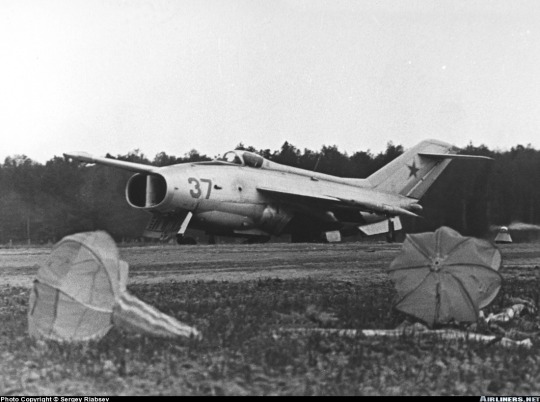
Flight testing of the Yak-36 began in January 1963 with tethered hovers. From the start, they ran into issues with re-ingestion of hot gasses sapping engine power, and the bleed-air system intended to provide control in hovering flight proved problematic. Several modifications were made to fix the issues before untethered flights could finally being (with conventional flights) in mid 1964. The first full VTOL flight, with vertical takeoff, transition to horizontal flight, and vertical landing, would have to wait until 1966. the next year it was revealed to the West at an airshow. Though it was presented as a combat aircraft (it was fitted with rocket pods during public demonstrations) and received a NATO designation (“Freehand”), there was no serious intention of putting the Yak-36 into service. The marginal performance of the type meant that it was unsalvageable for any practical use. Though the Yak-36M that succeeded it would initially share its designation, it morphed into an entirely new design, gaining the designator Yak-38. However, elements of the Yak-36 program carried over, notably the automatic ejection system that was developed but never installed for the Yak-36.
Alekseev SM-3/4
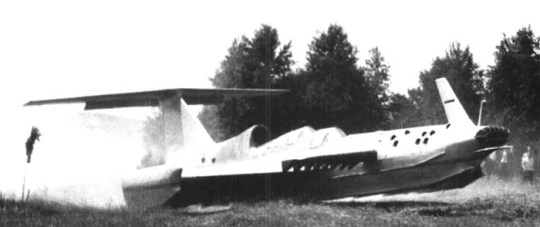
Following successful testing of the SM-2, Alekseev’s next ekranoplans would build upon the blown wing concept. The SM-3 and larger SM-4 would share the tandem engine layout of their predecessors, but they made use of an improved nozzle for the forward engine. A novel new nozzle design spread the exhaust across a wider area, improving the lift over a wider part of the wing. The SM-3 would take flight in 1962, and, after validating the basic design, the scaled-up SM-4 took shape. Testing went without incident, paving the way for further Ekranoplan development.
Alekseev SM-5

Parallel to the SM-3 and -4 demonstrators, Alekseev had created the SM-5. The SM-5 was a more refined design that built off of previous experiments to serve as a sub-scale demonstrator for what became the massive KM ekranoplan. The SM-5 incorporated numerous changes, moving the cockpit to the extreme nose of the aircraft and adding in the special wing-blowing nozzles developed in previous designs. Testing began in 1963 or 1964, but the SM-5’s career was tragically cut short when it apparently hit a powerful gust during testing, knocking the aircraft out of control and causing a crash that killed the crew.
Sukhoi S-22I
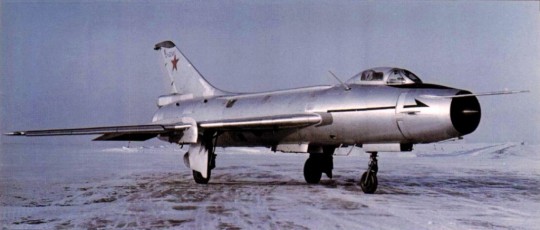
Although the Su-7B had come to form the backbone of the VVS Frontal Aviation’s attacker corps, the highly swept wing of the design had resulted in generally poor payload and performance, particularly on takeoff and landing. Hoping to improve payload and short-field capabilities, Sukhoi looked into variable geometry wings as a solution. An Su-7 would become a technology demonstrator, receiving entirely new wings that featured variable-geometry panels outboard of the landing gear. Although only the very outer sections of the wing could change their sweep, the impact of the change was significant when the S-22I first flew in 1966. The high-speed capabilities of the Su-7 remained, but testing revealed that the swing-wings increased payload by 50%, while halving the takeoff and landing roll and doubling effective range. The S-22I was a tremendous success, paving the way for further modifications to the design that resulted in the Su-17.
Sukhoi T-58VD
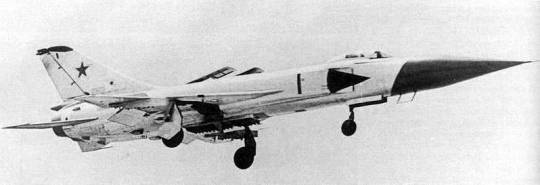
By the mid-1960s, a renewed focus on STOL aircraft had led to two diverging concepts. While variable-geometry wings offered one solution, the recent development of the compact RD-36 lift jets seemed to offer a mechanically simpler solution. As such, Sukhoi would convert the T-58D-1 - the first Su-15 prototype - as a testbed. The T-58VD, as it was designated, was fitted with three RD-36-35 engines along the fuselage centerline, forcing the development of an entirely new fuselage center section. Testing began in 1966, with generally good results. Although the engines didn’t provide enough thrust to lift the aircraft on their own, they reduced takeoff speeds by 100km/hr and reduced takeoff and landing rolls from 1,170m and 1,000m to 500m and 600m, respectively. Tests did discover an issue with the engine placement, leading to a large pitching moment from the engines, but these were addressed by leaving the forward engine off for landings. Testing ended in 1967 after providing invaluable data to Sukhoi.
Alekseev SM-8
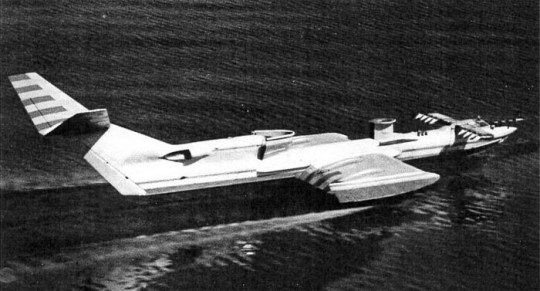
Although the SM-5 had failed catastrophically, Ekranoplan development was not deterred. The SM-8 would be the next stage of KM development, incorporating various improvements to the SM-5 design so as to ensure that such a catastrophic crash would not be repeated. The SM-8 featured an enlarged tail with a high dihedral, as well as large shrouds surrounding the intakes for the engines. Though larger than the SM-5, it was still dwarfed by the KM that was built alongside it. Unusually, though the SM-8 was intended as a sub-scale prototype for the KM, it would begin testing alongside its larger cousin. Testing went well, but as the program progressed, the SM-8 fell by the wayside, eclipsed by the massive KM.
Alekseev KM
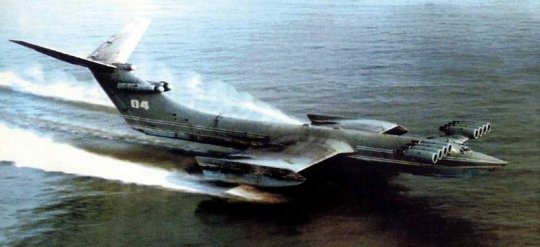
The culmination of the past half decade of ekranoplan development would be the gargantuan KM. The KM was the largest design yet created by the Alekseev OKB, and in fact the largest ekranoplan ever. Four times the size of the SM-8, it had a max takeoff weight of 544 metric tons. Whereas previous designs relied on vectoring thrust from a single engine for wing blowing, the KM instead had eight engines mounted on pylons ahead of the wings to serve the same purpose. In all, the leviathan had ten VD-7 turbojets - eight near the nose and a further two mounted midway up the tail. The KM would take to the skies in 1966 with Alekseev himself at the controls. Nominally intended as a prototype transport, it would never see production. Instead, it lived out its career as a one-off test vehicle. Despite the lack of production, the KM was hardly unimpressive. Until the flight of the AN-225, it was the heaviest flying machine ever, and with a cruise speed of 232 kts, it seemingly offered a comfortable middle ground between the speed of a strategic airlifter and payload of a ship. Ultimately the KM’s career would come to an end in 1980, when pilot error led to a crash. Although no fatalities were reported, the KM was too heavy to salvage, so it was left to sink.
Mikoyan Gurevich MiG-21PD

Parallel to Sukhoi’s lift-jet experiments, MiG was running their own STOL lift-jet testbeds for a MiG-21 successor. Their first such experiment would be the MiG-21PD. A single MiG-21PFM was modified for the role by installing a 900mm section at the center of gravity fitted with two RD-36 lift jets. The only other significant modification appears to be that the landing gear was fixed. Overall, the conversion was fairly quick and simple, allowing tests to begin in mid 1966. Tests ended in 1967, but not before it made a public appearance for Party officials. Though the MiG-21PD itself would not go further in development, it provided valuable information for MiG’s new fighter program.
Mikoyan Gurevich Ye-23DPD/MiG-23PD
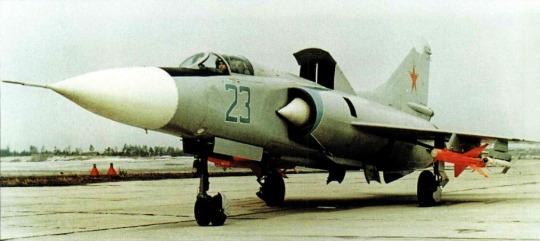
Parallel to the MiG-21PD, MiG was developing a more practical prototype for their MiG-21 successor. In competition with the swing-wing Ye-23IG (what ultimately became the MiG-23 prototype), the Ye-23DPD took shape using the same lift-jet technology demonstrated on the MiG-21PD. The same tailed delta surfaces of the MiG-21 were carried over, albeit with some modifications, and shock-cone inlets were used on either side of the fuselage. The centerpiece of the design was the two RD-36 lift jets mounted in the fuselage and blown flaps for STOL operations. It would make its first flight in April 1967, making comparative tests with the Ye-23IG. Unfortunately, the Ye-23DPD’s test career was very brief - the swing-wing Ye-23IG was selected for full-development fairly quickly, and the Ye-23DPD test program was cut short before anything beyond takeoff and landing characteristics could really be examined.
Sukhoi T-6-1
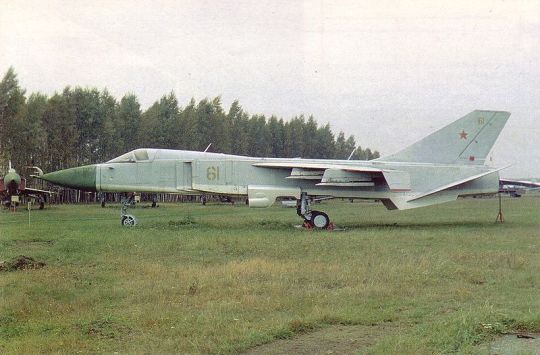
Building on experience with the T-58VD, Sukhoi would follow MiG’s example of building two competing prototypes for their newest aircraft. Intended to serve as a strike platform, Sukhoi would develop a high-winged plane with side-by-side seating designated the T-6. The first prototype - the T-6-1 - was fitted with a conventional delta wing and four vertically mounted lift jets, while the second prototype was given swing-wings. The T-6-1 would beat its competitor into the air, flying in mid 1967, but it would end up losing the final contest, as the swing-wing proposal was considered more flexible. Though rejected for production, the T-6-1 continued to prove itself useful, flying on until 1974 as a testbed for various electronic equipment.
Mikoyan Gurevich MiG-21I Analog
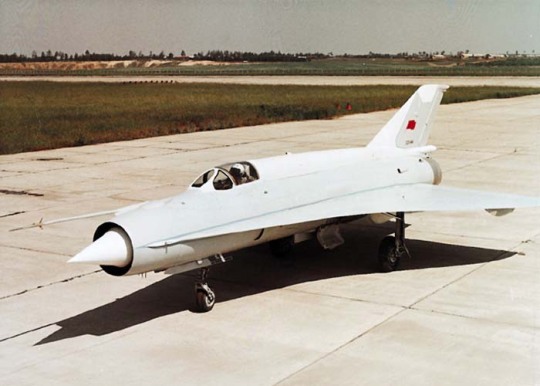
As part of the development of the Tupolev Tu-144 supersonic transport, a new ogival wing planform had been developed. Because such a wing planform was unprecedented for Soviet aircraft, the decision was made to convert a MiG-21 to serve as a testbed for the new wing. The MiG-21I, as it was known, had all horizontal surfaces replaced with a single large ogival wing scaled down from the Tu-144’s design that spanned the entire length of the fuselage. In the nose and tail, remote mass balances were installed, allowing the center of gravity to be shifted around for testing. Starting in April 1968, 140 test flights were performed, testing the MiG-21I from the edge of stall all the way up to Mach 2.06. Upon the conclusion of testing, one prototype was lost during an acrobatic demonstration, while the other was used to train the first Tu-144 pilots before being passed on to the Monino Air Force Museum. The test program was overall a success - the wing planform was validated, allowing the Tu-144 to enter service.
Sukhoi 100LDU
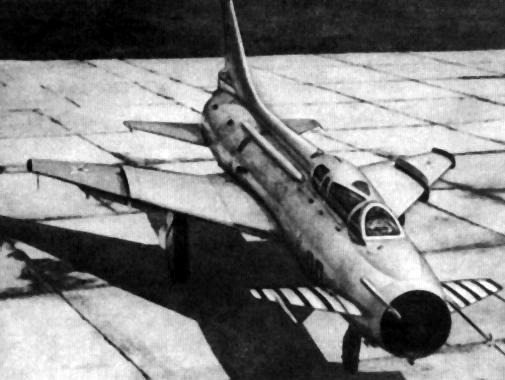
During the design phase of the T-4 supersonic bomber project, Sukhoi determined that a fly-by-wire control system was going to be necessary for the aircraft. With such little practical experience with such systems, Sukhoi decided to create a FBW testbed. An Su-7U trainer was selected as the testbed aircraft, being modified with canards to create a longitudinally unstable testbed for the FBW system. Designated the 100LDU, the aircraft took flight in 1968. Testing went well - it validated the control system developed for the T-4, and it would stick around as a controls testbed into the next decade, performing the same duties in 1973-73 as Sukhoi developed the Su-27.
Alekseev SM-6

Although the KM would mark the peak of ekranoplan development, it would not be the last such design to fly. The Soviet Navy had caught onto the idea of the ground-effect vehicle, and by the end of the ‘60s they were looking for an ekranoplan to serve as a high-speed transport. In 1972, Alekseev would fly the SM-6, which was intended to serve as a subscale prototype for the upcoming A-90 intended to fill this role. The SM-6 was radically different from previous designs- although it shared the same T-tail and low aspect ratio wing, it lacked the prominent wing-blowing surfaces. Instead, two TRD-25 engines in the nose would exhaust under the roots of the wings, while a single AI-20 turboprop mounted at the peak of the tail would provide supplementary thrust. Unlike the previous ekranoplans, the SM-6 proved capable of flying out of ground effect, with a modest flight ceiling of 3,000m. Ultimately, the SM-6 was a success - the A-90 would fly that year, with five prototypes produced.
Bartini-Beriev VVA-14
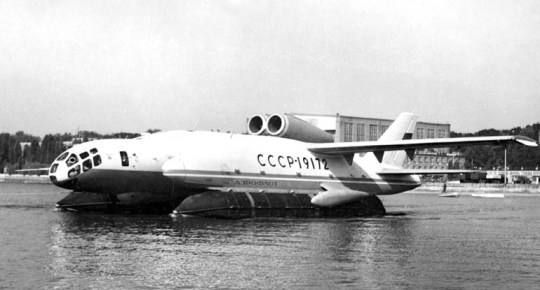
In the early ‘60s, Bartini had proposed a massive 2500-ton ground effect vehicle. Though the project gained some support, it was decided to first develop a technology demonstrator. Under the designation VVA-14, Bartini teamed up with Beriev to create a dual-role aircraft that could serve as an ASW/patrol platform while also validating the larger design. The VVA-14 was an unusual beast - it was fitted with both conventional landing gear and pontoons (first fixed, then inflatable) for amphibious operations, a large center wing section for ground-effect flight, and thinner outboard wing sections allowing for conventional flight. Though the two prototypes were only fitted with two D-30 turbofans above the fuselage, final plans called for twelve RD-36 lift jets to allow the VVA-14 to achieve VTOL flight. Flight testing began in September 1972, generally going well despite some vibration issues. The inflatable pontoons were fitted in 1974, as were engines forward of the wing to provide a blowing effect. Unfortunately, the VVA-14 program was hit hard by Bartini’s death at the end of 1974. Bartini’s projects fell by the wayside as Beriev projects like the A-40 and A-50 took priority, and by the end of 1975, the VVA-14 was abandoned.
Mikoyan Gurevich MiG-105 Spiral

In 1965, the USSR commenced an ambitious spaceplane project under the project name Spiral. Vaguely similar to the American lifting-body spaceplane projects,the Spiral was to use a small Though the orbiter itself was vaguely similar to the American lifting body projects, the full scope of the program was far more radical. The Spiral was to involve a carrier aircraft that would bring the whole assembly up to Mach 6 at an altitude of about 30km, jettisoning the orbiter, which would be propelled into orbit via a large rocket booster. Plans called for the ultimate design to have a payload of about 10 metric tons in a 150km orbit. Once in orbit, it would serve as a manned reconnaissance, strike, or interception platform, with enough onboard fuel to change inclination by 17 degrees.
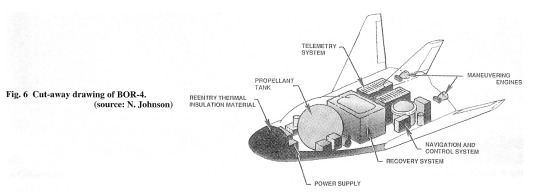
Given how ambitious the Spiral program was, extensive sub-scale testing was to take place long before a true prototype would take flight. The experimentation stage involved two classes of test vehicles - unmanned high-speed prototypes to test reentry characteristics, and manned low-speed vehicles to examine landing characteristics. The unmanned test models, designated BOR-1, -2, and -3, made several vertical launches from rockets into the upper atmosphere starting in 1969. BOR-1 was a 1:3 scale model, making a single flight which accelerated the machine to suborbital velocities at 100km. It would descend to about 60km, at which point it was burned up on reentry (planned as part of the program). The BOR-2 that followed was more robust, allowing it to make four test launches between 1969 and 1972. The BOR-3, following the same general plans, would fail in both of its tests, with one lost during a launch accident and the other lost when its parachute failed to deploy on its maiden flight in 1974.
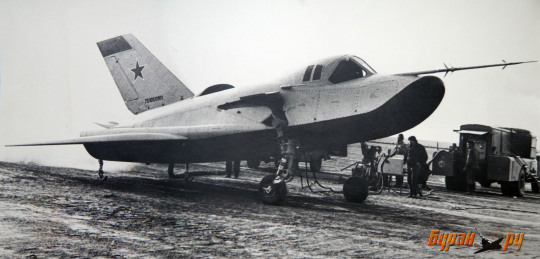
The manned Spiral testbed, designated EPOS, wouldn’t take flight until long after the design was validated by the BOR test vehicles. Though intended as a low-speed testbed, the EPOS would incorporate many elements of the planned final design, including the folding outer wing sections and a pressurized escape capsule. Though it lacked the rocket boosters intended for orbital maneuvers, it was fitted with a single RD-36 turbojet with 10 minutes of fuel, intended to allow the EPOS to make multiple landing attempts or divert to another airfield. Unfortunately, the death of Artyom Mikoyan in 1970 put the project on hold, and when it resumed in 1972, the ambitious Spiral program was now geared towards research work. The EPOS would finally be ready for testing sometime in the mid-70s, but ground testing would delay the aircraft’s first flight.

Only in May 1976 did the EPOS fly for the first time, taking off and flying under its own power for a brief flight. The next stage of testing began in 1977, involving dropping the EPOS from a Tu-95K. After several captive carry tests, the EPOS made its first drop test in October 1977, gliding from an altitude of 5km to an airfield. Nine more test flights would occur, but during that time, the new USSR Defense Minister had changed the course of Soviet spacecraft development. Although a supersonic EPOS testbed was ready to fly and a hypersonic variant was under construction, priority was given instead to the Buran program. The death blow to the EPOS came in 1978, when the prototype was damaged in a landing accident. Though repaired and returned to flying condition, it effectively signaled the end of the program - the EPOS would never fly again.
Sukhoi Su-27UB-PS

In the early ‘80s, Sukhoi began research into the use of thrust-vectoring engine nozzles. With initial experiments involving flat 2 dimensional nozzles, Sukhoi got around to a full-scale demonstrator at the end of the decade. In 1989, A pre-production Su-27UB was fitted with a new nozzle over the port engine to evaluate the new thrust vectoring system. The nozzle itself consisted of flat plates, only being capable of moving up and down. Flight testing began in 1989. 20 test flights were flown, apparently going fairly well. Ultimately, however, the course of Sukhoi’s thrust-vectoring development would soon change. Sukhoi moved on to three dimensional thrust vectoring experiments.
Sukhoi Su-37
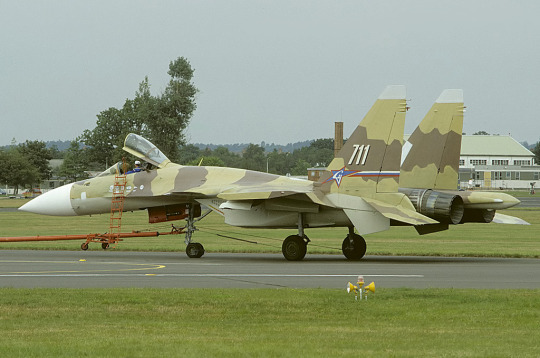
Although the 2D thrust-vectoring Sukhoi experimented with at the turn of the decade was to be a dead end, it was hardly the last of Sukhoi’s experiments into thrust vectoring. While work began on the T10M/Su-35, Sukhoi had plans in store for a far more advanced demonstrator. In 1995, the 11th T10M prototype was extensively rebuilt as the Su-37. The Su-37 improved upon just about everything from the Su-35. The structure was rebuilt with more composites and Al-Li alloys, and the avionics and cockpit were improved from the already impressive suite on the Su-35. The 2D thrust-vectoring AL-31FP engine was installed, with plans for the AL-37FU with 3D vectoring nozzles to be mounted once the powerplant’s development finished. The AL-31FP nozzles could swivel 15 degrees up or down, providing the aircraft with pitch and roll authority at extreme angles of attack. At a glance, however, the Su-37 was nearly indistinguishable from the Su-35. Apart from the squared-off vertical stabilizers, the aircraft was virtually identical to the prototype Su-35s.
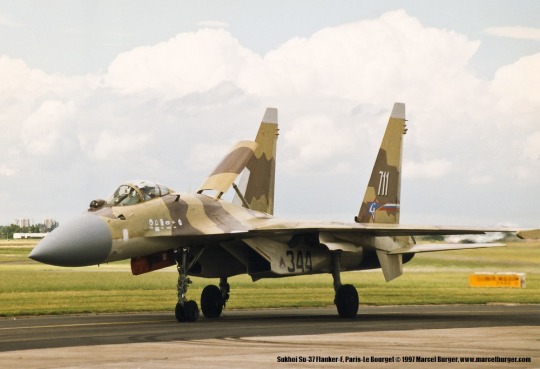
The Su-37 would make its maiden flight in the spring of 1996, completing preliminary testing in time to make its debut at the Farnborough Airshow in September of that year. Sukhoi made sure to show off the aircraft’s agility, with the Su-37 reaching 180 degrees angle of attack in a “Super Cobra” maneuver, as well as various other post-stall maneuvers. Appearances at airshows across the world continued until 2001, when the Su-37 was finally fitted with the 3D thrust-vectoring AL-37FU engines, along with updated avionics and controls. Unfortunately, the Su-37’s career in this configuration was brief - the sole example crashed in December 2002. The strain caused by the heavy maneuvers at airshows had damaged the right horizontal stabilizer, causing it to fail in flight. The crash of the Su-37 signaled the end of the program. The Su-37 would never reach production, and it’s unclear if Sukhoi ever even intended it to do so. Whatever the case, the Su-37 was far from useless - elements tested in the design carried over to various Flanker projects, including the Su-30 and second-generation Su-35s.
Sukhoi Su-47
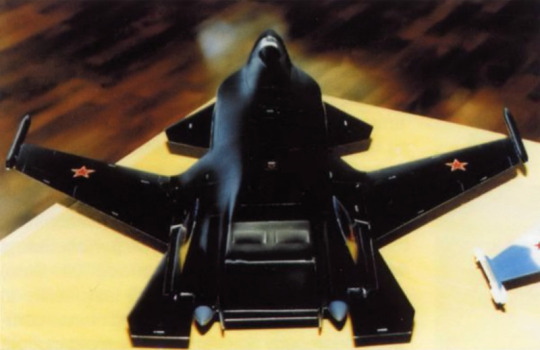
When the USSR began its next-generation fighter programs at the end of the ‘70s, Sukhoi decided to take a radically different approach than they had used for their previous designs. Working closely with TsAGI, they began efforts to develop a forward-swept wing fighter. As TsAGI wind tunnel studies were showing, such a wing would provide excellent flight characteristics in the transonic envelope. Sukhoi leveraged off of the TsAGI studies and their own experiments with supermaneuverability, creating a proposal for a light and heavy fighter. Both designs were dynamically unstable three-surface machines with thrust-vectoring to improve post-stall performance. It appears that work progressed the furthest on a design known as the S-32, which was a larger machine intended to serve as a successor for the Su-33. The S-32 was to be a major leap from the Flanker series - forward swept wings and advanced controls would give excellent agility, while moderate stealth shaping would reduce RCS, and, most notably, a large single thrust-vectoring nozzle derived from the design used on the Su-27UB-PS would vector the thrust from both engines.
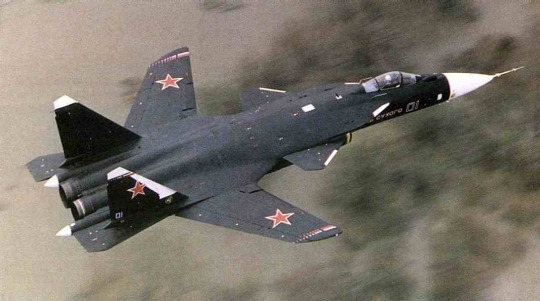
Unfortunately for Sukhoi, the project dragged on until the economic crisis of 1989 forced its cancellation. The structural issues associated with forward-swept wings meant that Sukhoi spent much of the decade developing a composite wing structure for the aircraft, so Sukhoi was only just beginning construction of prototypes when the Cold War ended. . Fortunately for Sukhoi, the export success of the Flanker gave them plenty of extra cash during the ‘90s, allowing them to continue development of their cancelled fighter. In 1991, they began flying 1 ton scale models in drop tests from helicopters, allowing them to validate the design. The S-32 would morph slightly, losing its naval features and box-like nozzle to become the S-37. The S-37 was initially fitted with two D30F-11 turbofans without thrust-vectoring nozzles, retaining the same advanced layout developed for the S-32 but making use of the forward nose and landing gear of an Su-27 to reduce costs.
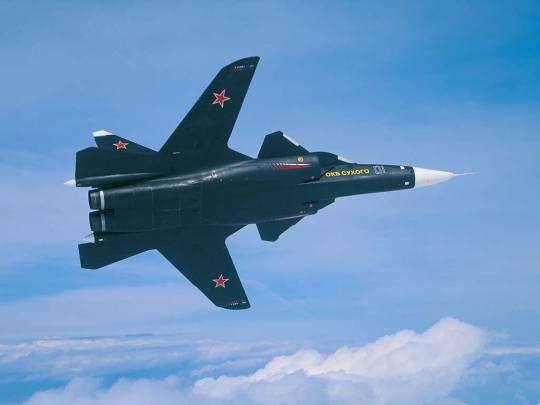
The S-37 was completed in late 1996, taking flight in September of the next year. Tests slowly pushed the flight envelope, eventually taking the S-37 to a top speed of Mach 1.4. Meanwhile, Sukhoi’s engineers were working to not only clear the fighter for higher speeds, but adapt the design to serve as a technology demonstrator for a next-generation fighter, as funding and support was drying up for the MiG 1.44 that had won the MFI contract. Plans called for the D30F engines to be replaced by thrust-vectoring AL-41s, while the aircraft was outfitted with various modular avionics packages to showcase its capabilities. In 1999, it made its public debut at the MAKS airshow as the Su-47. Ultimately, the Su-47 would remain a tech demonstrator. The test program ended sometime around the new millennium without the AL-41s ever being fitted, and, as the PAK FA program began, the Su-47 was retired.
9 notes
·
View notes
Text
/k/ Planes Episode 92: X-Planes
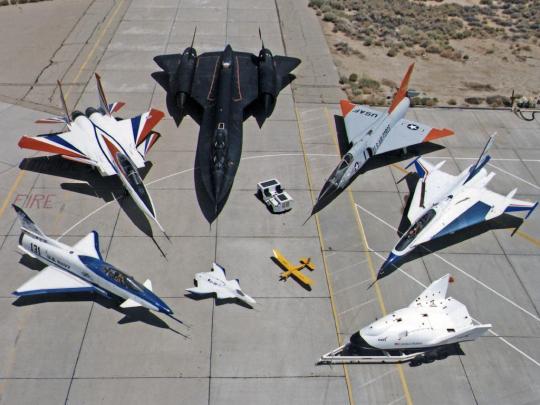
It’s time for another Episode of /k/ Planes! This time, we’re looking at the experimental planes tested by NASA.
Though NACA had done its share of experimental work before WW2, things really kicked off at the end of WW2. While conducting research into high-speed flight, NACA commissioned a series of experimental planes, holding the designator “X.” These X-planes began pushing the limits of powered flight, paving the way for those who followed. Over time, NASA’s X-planes diverged in focus - some pushed ever higher and faster, while others went on to explore other concepts. As time went on, the X-series designator would somewhat lose its meaning. The USAF and USN would assign several tech demonstrator prototypes an X designator (like the X-35 and X-47), while several other testbeds seemingly worthy of the X designation would merely hold the name of their program. Regardless, NASA’s experimental work has resulted in some of the most interesting and influential aircraft in history.
Bell X-1

During the latter half of the Second World War, both the US and Britain were working on parallel projects to break the sound barrier in level flight. In Britain, Miles Aircraft was working on the turbojet-powered M.52, while unbeknownst to the British, Bell Aircraft was working on their own rocket-powered plane. In 1944, an agreement was signed with Britain to exchange high-speed research data, giving Bell access to British high-speed test data. The agreement would fall through by the end of the year, leaving both countries to continue work alone. In early 1945, NACA and the USAAF contracted Bell to produce three prototypes for their design under the designation XS-1 (later changed to X-1). The X-1 was a simple aircraft, with extremely thin straight wings and a conventional tail built around a bullet-shaped fuselage. A single rocket motor placed in the tail would provide propulsion, but they had such a short endurance that the X-1 would be reliant on a B-29 to carry it to a suitable launch altitude.

The first X-1 flight occurred in January 1946, with test pilots taking it on ten glide flights. Powered testing began in September, but the cautious pace of testing would cause the Army Air Force to cancel their order for the final prototype. Nevertheless, testing continued. The conventional tailplane of the X-1 was replaced with an all-moving tailplane as the machine ran into compressibility issues, and the X-1 pushed ever closer to the sound barrier. Finally, on October 14, 1947, an Air Force captain by the name of Chuck Yeager would take the X-1 past the speed of sound. On what was the aircraft’s 50th flight, the X-1 was dropped from a B-29 at 20,000 feet, reaching a top speed of of Mach 1.06 before gliding down to a dry lake bed for landing.

The success of the X-1 reignited Air Force interest in the program. In April 1948, they ordered the X-1A. Though similar in shape, the X-1A was longer and heavier than the X-1 and fitted with a bubble canopy, designed with the intention of flying past Mach 2 at 90,000 feet. Testing of the X-1A began in late 1953, culminating in a flight - again by Yeager - reaching Mach 2.44 at 74,700 ft. However, the aircraft was almost lost on that same flight as inertia coupling caused it to spin out of control. Later testing would set a new altitude record at 90,440 ft. the X-1A was transferred to NACA in September 1954, but it would be lost in an explosion while preparing for launch in August 1955.
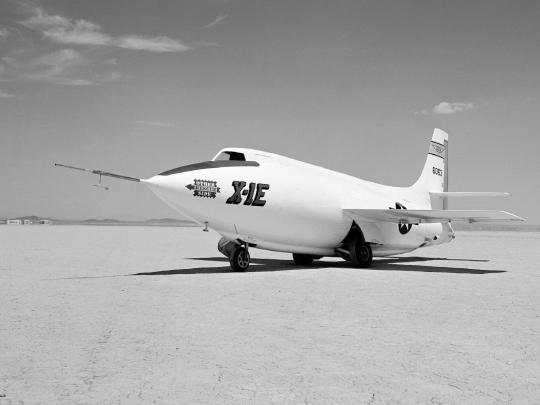
The USAF would place orders for several other X-1 variants as well. The X-1B, flying in October 1954, was a modified X-1A used to gather data on aerodynamic heating at high speeds. The X-1C was intended to serve as a testbed for armaments at transonic and supersonic speeds, but the Air Force cancelled it before it could materialize because of the development of transonic fighters. The first real second-generation X-1, the X-1D, would only make a single unpowered test flight, as it exploded in August 1951 while being prepared for powered flight. After the loss of the X-1D, NACA rebuilt the second X-1 as the X-1E. The X-1E received an updated canopy, ejection seat, new propulsion system, and a new wing just 3/8 in thick at the root. The X-1E would fly for the first time in December 1955, culminating in 21 flights, in which the X-1E reached speeds as high as Mach 2.24 at 75,000 ft. However, the X-1E would be grounded in 1958 after the discovery of structural cracks on the hull.
Douglas D-558-I Skystreak
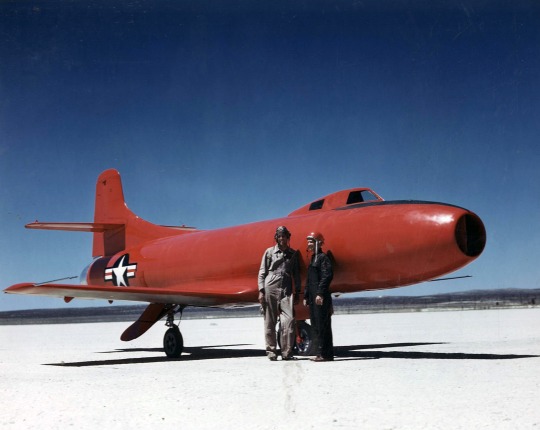
At the end of WW2, the Navy and NACA came together to develop a research aircraft for transonic flight. Conceived as a three-part program, it would start with a jet testbed, followed by a mixed-propulsion aircraft, ending in a combat aircraft design. Douglas was contracted to develop a design, which became the D-558-I. The D-558-I was a simple straight-winged design powered by a single J-35 axial-flow turbojet. Following NACA suggestions, the tail was considerably thinner than the wing to avoid simultaneous transonic shocks over the wing and tail, and, in the absence of an ejection seat powerful enough to clear the tail, the entire nose was designed as a jettisonable ejection capsule. Three D-558-Is were ordered, gaining the nickname Skystreak. They were originally painted red, although this was later changed to white to improve optical tracking.
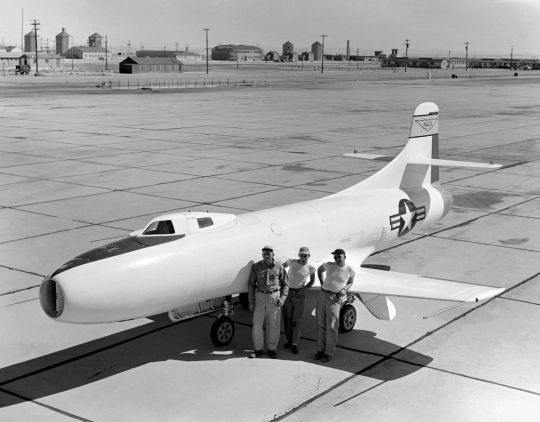
The first Skystreak flew in April 1947. That August, it set a new speed record of 640.7 mph, only to be surpassed by the second prototype five days later. The second Skystreak was delivered to NACA in November 1947 after 21 test flights by the Navy, but the first prototype was retained by the Navy until 1949, finally being delivered to NACA after 101 flights. The second prototype was destroyed on its 20th flight with NACA in May 1948 due to a compressor disintegration that killed the pilot. The third prototype would be delivered in 1949, taking over the test program left by the destroyed second aircraft. It would make 78 flights before being retired in 1953. The Skystreak only reached Mach 0.99 in level flight, and it was only barely capable of breaking the sound barrier in a dive. While the test data was helpful, the Skystreak was quickly overshadowed by the far more capable X-1.
Aerojet X-8
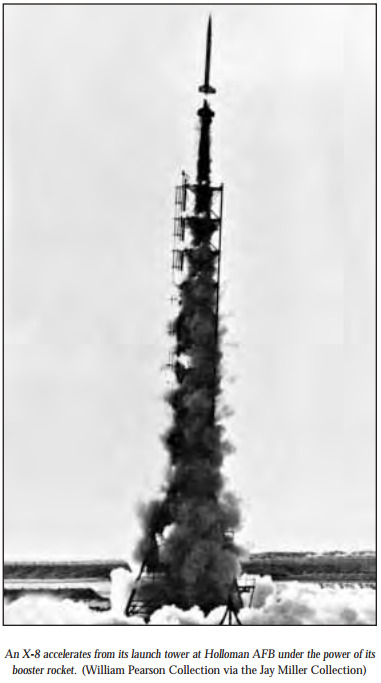
In response to a requirement for a cheap means of gathering data on the upper atmosphere, Aerojet was contracted to produce the X-8. The X-8 was conceptually very simple - a 20 foot two stage rocket with a 18,000lbf solid-fuel first stage, 2,600lbf liquid-fueled second stage, and a 150lb payload. Flights began in April 1947, and over the years several variants with improved second-stage motors were created. A total of 108 X-8s would be made, the result of the rocket’s non-reusable nature. The end of the X-8 program by no means spelled the end for the design - Aerojet would use the X-8 as the basis for their Aerobee sounding rocket.
Douglas D-558-II Skyrocket
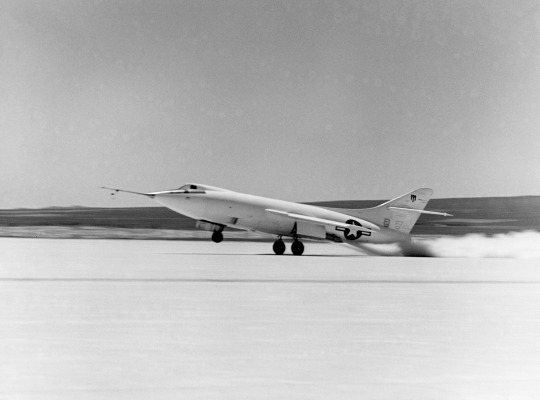
With the success of the D-558-I, the next phase of the program could begin. It quickly became obvious that the D-558-I could not accommodate both a jet and a rocket, so the design was dropped and Douglas conjured up an entirely new aircraft. A new, much sleeker fuselage was developed, and a 35 degree swept wing and 40 degree swept tail was mounted, taking advantage of new aerodynamic research with high-speed flight. A J34 turbojet fed by side intakes would provide power for takeoff, climbing, and landing, but the power for supersonic flight would come from the same rocket motor seen on the X-1. The Skyrocket, as it became known, was originally fitted with a flush canopy as seen on the X-1, but this was replaced by a raised cockpit to improve visibility. Like the D-558-I, the D-558-II had the entire nose designed to jettison in case of an emergency.

Test flights began in early 1948, with the aircraft flying solely under jet power. Initial flights were intended to test stability and control characteristics of swept-wing aircraft, and the program ran into issues with uncontrolled pitch-ups at high speeds. These issues were solved, however, and in 1950 Douglas replaced the turbojet with the rocket and configured it for air launch. In this configuration, the Skyrocket reached a top speed of Mach 1.88 at nearly 80,000 ft. In late 1953, the Skyrocket would push to Mach 2.005 in a shallow dive, becoming the first aircraft to break Mach 2. Towards the end of the program, engineers began testing the effects of external stores on supersonic performance. In all, the three Skyrockets would fly 313 flights before the program ended in 1956.
Northrop X-4 Bantam
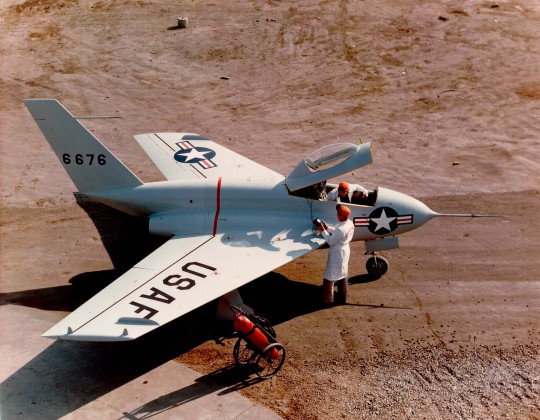
The first X-plane designed to investigate something other than supersonic flight was the X-4. Rather than go for speed and altitude records as previous X-planes would, the X-4 was intended to test a tailless configuration in high subsonic flight. Northrop handled construction, building a compact design vaguely reminiscent of the Me 163. Powered by two J30 turbojets, it was given a vertical tail, but it lacked any horizontal surfaces. The first X-4 would fly in November 1948, but a host of mechanical issues forced NACA to retire the aircraft early. Fortunately, the second prototype proved reliable enough to allow testing to commence. Pitch testing found that the X-4 experienced pitch oscillations as it approached Mach 0.88, and problems with inertia coupling and Mach tuck began to arise past that. A hastily engineered solution - propping the split flaps open 5 degrees - solved the instability issues, allowing pilots to push the X-4 up to Mach 0.92. Unfortunately, while the problems were mitigated, the configuration remained unsuitable for supersonic flight. The X-4 would be a success in that it met test program goals, but ultimately it would prove tailless designs to be unsuitable for supersonic flight.
Bell X-9 Shrike
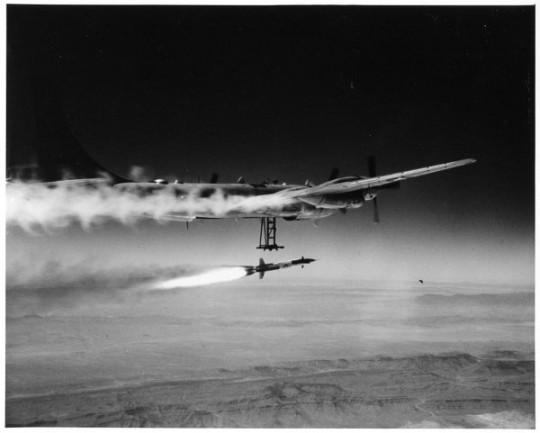
The Bell X-9 was intended to serve as a sub-scale testbed for the planned GAM-63 RASCAL air-to-surface missile. Powered by a liquid-fueled rocket motor, the X-9 was about 20 feet long and crammed with equipment to test stability and aerodynamic characteristics, as well as assist in developing a guidance system. 93 X-9s would be ordered, but production was cut short at 31. As with the X-8, it was not intended to be reusable, so none of the missiles survived testing. Ultimately, the program was uneventful. It ran from 1949 to 1951, providing adequate test data for the GAM-63 to proceed with full-scale development.
Bell X-5
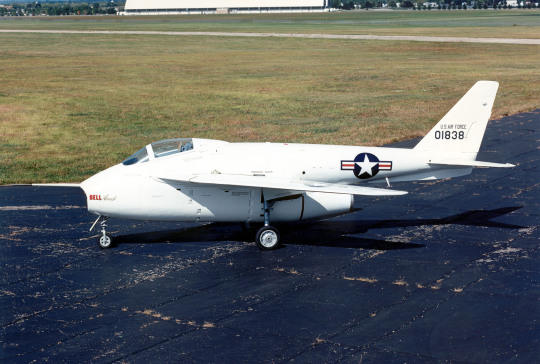
When Messerschmitt’s incomplete P.1101 was shipped to America, it caught the attention of the engineers at Bell. Though the aircraft itself was too heavily damaged from transit, Bell would seize upon the most interesting aspect of the design - the variable-sweep wings. Although the P.1101 could only sweep its wings with the help of ground crews, Bell felt the concept could be taken a step further. Soon after they got their hands on the P.1101, Bell proposed a tech demonstrator based off of the design that would be able to change the angle of the wings in flight. Bell’s final proposal drew heavily on the P.1101, retaining much of the aircraft’s general appearance while scaling it up in size to accommodate the wing-actuating systems. The system for moving the wings involved a jackscrew that would not only rotate the wing, but also move the root forward or aft as the wing rotated. The wing was designed to switch between three sweep angles - 20, 40, and 60 degrees. The design was approved by the Air Force in early 1949, and two prototypes were ordered as the X-5.
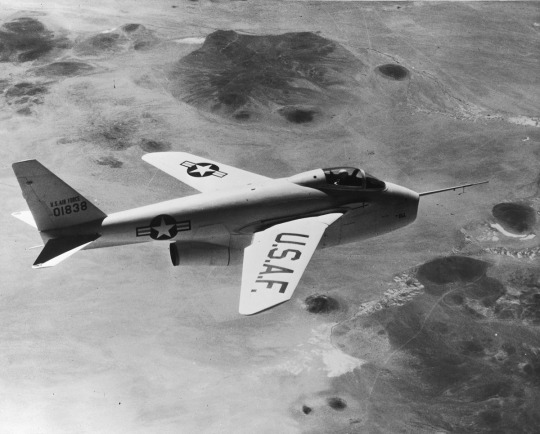
Both X-5 prototypes would take flight in June 1951, flying with NACA. The results of testing were mixed. The changing sweep did validate predictions about the effects of variable wing sweep on high-speed flight, but the aircraft itself had numerous issues. The changing of the sweep in flight made control difficult, as the center of pressure would shift with the wing sweep. Further complicating this was the choice of the pod-and-boom layout led to vertically unbalanced drag and thrust and dangerous stall characteristics. The poor aerodynamic design of the aircraft would ultimately lead to a crash in 1953 when one X-5 entered a stall with the wings set to 60 degrees. Ultimately, the X-5 program would continue until 1955. Though the general concept of a swing-wing aircraft was validated, the X-5 itself had proven entirely unsuitable for operational use. Worse, the system of pivoting the wings within the fuselage was unsatisfactory.
Lockheed X-7
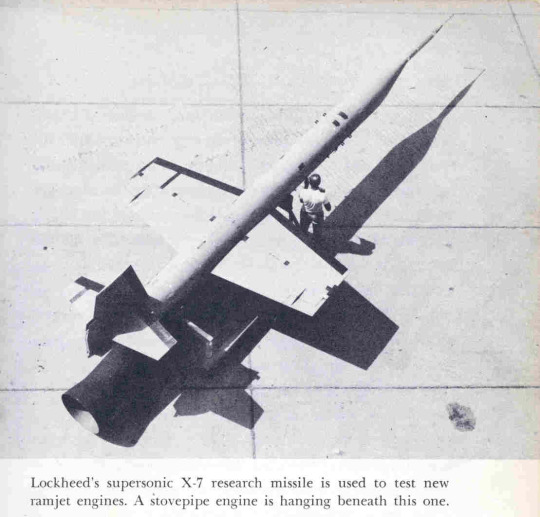
As part of a program to test high-speed ramjets, Lockheed was contracted to build the X-7. Unlike previous X-planes, the X-7 was to be unmanned, allowing Lockheed to significantly decrease size and weight. The X-7 that resulted was a very unusual aircraft - a thin, dart-like fuselage was fitted with small wings with just a 4% thickness ratio and a rocket motor in the tail. The ramjet would be slung under the machine, allowing various different powerplants to be tested. Due to the expected high temperatures at operating speeds, the aircraft was made mostly of steel. Testing began in 1951. Flights required the X-7 to be launched from a B-29 or B-50, after which a rocket motor would fire to bring the aircraft to 1,000mph, at which point the ramjet would kick in. Once fuel ran out, the X-7 would deploy a parachute to slow its descent. 130 X-7 flights would occur between 1951 and 1960, during which time various different ramjets and a boron-based “zip” fuel were tested. Of the X-planes thus far, the X-7 was by far the fastest, reaching a top speed of Mach 4.31 at over 100,000ft. Also unusual for an X-plane, the X-7 would serve as the basis for the AQM-60 high-speed target drone.
Bell X-2

Although the X-1 and D-558-II had proven invaluable for research efforts, they both were limited to about Mach 2. To push past this, Bell was commissioned to develop the X-2. Due to the high temperatures and unusual aerodynamic conditions at such speeds, development was prolonged as Bell worked to flesh out everything from aerodynamics to control systems and temperature-resistant materials. To survive the anticipated high temperatures, the X-2’s skin was made of an advanced new steel alloy. Meanwhile, Curtiss-Wright had developed a novel new throttleable rocket engine capable of producing more than double the thrust of the X-1. Glide testing of the X-2 began in 1952, but it wasn’t until November 1955 that powered flights began. This was mainly due to issues with the rocket engine - the first prototype was lost after the engine exploded while being carried by an EB-50, and it took some time before the system was considered safe enough to fly.
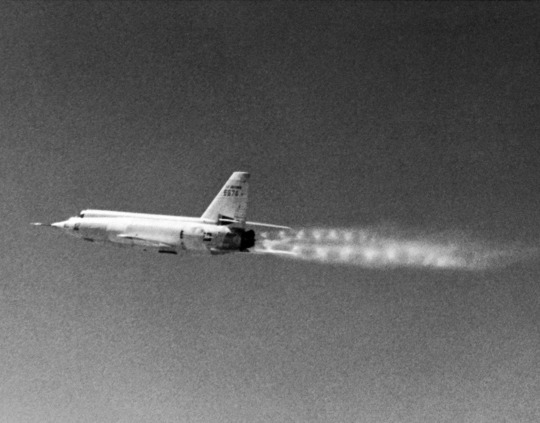
Though years behind schedule, the X-2 was proving promising. In July 1956, the X-2 would set a new speed record at Mach 2.87. At such speeds, the controls began to lose effectiveness, and data from flight testing, wind tunnels, and simulations showed that the X-2 would become unstable at Mach 3. Nevertheless, the X-2 continued to push the envelope. In September 1956, the X-2 would become the first aircraft to break 100,000ft, reaching a maximum altitude of 126,200 ft. Just 20 days later, a carefully planned and executed flight took the X-2 to Mach 3.2. However, soon afterwards, the X-2 tumbled violently out of control thanks to inertia coupling. Although the ejection capsule was fired, the pilot was unable to escape to deploy his own parachute, and he tumbled with the capsule to his death. With the loss of the second X-2, the program was terminated with much of the planned test schedule incomplete.
Douglas X-3 Stiletto
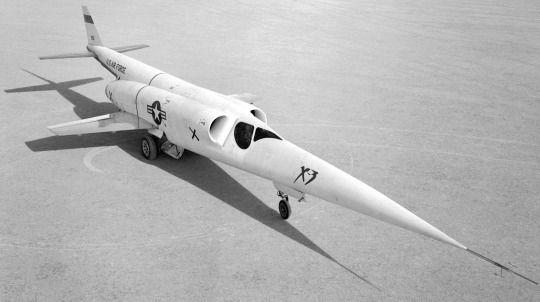
NACA’s next X-plane would be a radical departure from the portly rocket-propelled machines they were then flying. Hoping to test low aspect-ratio wings, sustained supersonic flight, and the large-scale use of titanium, Douglas would produce an odd-looking aircraft aptly nicknamed “Stiletto.” Original plans called for the X-3 to take off, climb to high altitude, sustain Mach 2 flight, and then land all under its own power. However, the J46 engines the X-3 was designed around were a failure, forcing Douglas to substitute the J34 instead. The new engines put out only 4,900lb of thrust each compared to the planned 7,000, and performance unsurprisingly suffered. Testing began in October 1952, finding the X-3 to be underpowered and difficult to control. Takeoff speeds were unusually high, and testing would find the X-3 to be incapable of breaking the sound barrier in level flight. In fact, to reach just Mach 1.2, the X-3 had to perform a 30 degree dive at full afterburner. With the X-3 incapable of meeting design goals, NACA truncated the test program, primarily looking at the effects of the high aspect-ratio wing. In October 1954, inertia coupling nearly caused the loss of the aircraft and subjected it to such heavy loading that it was grounded for a year. Though it returned to service in 1955, it would perform only 10 more flights before being retired the next year. In the end, the X-3 did prove useful, but not for its intended application. Lockheed took great note of the tests, as their F-104 used a similar wing, and the design provided insight into inertia coupling.
North American X-10

To aid in the development of the SM-65 Navajo cruise missile, North American would built the X-10 as a technology demonstrator. The X-10 would unsurprisingly resemble a scaled-down Navajo with significantly lower performance goals. In place of the planned rocket/ramjet propulsion of the Navajo, the X-10 was fitted with two J40 turbojets, giving it a top speed about half of the projected Mach 3 performance of the final design. Aerodynamically, however, the X-10 shared the same unstable delta-canard layout, allowing it to serve as a testbed for aerodynamics and control systems, as well as the inertial navigation and recovery systems. The X-10 would first fly in October 1953, and a total of 13 test aircraft would be built. The X-10 would be among the fastest turbojet aircraft at the time, but it came at the cost of poor reliability. In the first 15 test flights, one exploded on takeoff, another crashed in flight, and two more were lost in landing accidents. The program continued on until 1958, with three more X-10s expended in dive-attack tests and two more lost in landing accidents. Despite all the crashes, the X-10 was generally considered a success, allowing the Navajo missile to begin full-scale testing. The X-10 itself would later become a candidate for a nuclear-armed cruise missile, but it was passed over in favor of ICBMs. Three of the X-10s to survive the test program were selected for use as targets for the BOMARC SAM. Though plans called for the target drones to be reusable, none would actually complete their flights - two crashed on landing and the other was deliberately flown into the ocean when mechanical issues arose.
Convair X-6

In 1946, the USAF commenced a study to create a nuclear-powered aircraft. Several concepts were studied, culminating in the Aircraft Nuclear Propulsion program, which aimed to convert two B-36s as nuclear testbeds. One aircraft would serve as a testbed to ensure a reactor could safely be carried aboard a B-36, while the other would serve as a testbed for nuclear propulsion. The first aircraft, designated NB-36H, was converted from a B-36H damaged in a tornado. The forward crew compartment was replaced with an 11 ton lead-lined cabin for two pilots, a flight engineer, and two nuclear engineers, and a 3 megawatt nuclear reactor was placed in the bomb bay. The NB-36H would take flight in September 1955, making a total of 47 test flights. Meanwhile, NASA had bigger plans, with an order for two nuclear-powered X-6s already placed. While the reactor on the NB-36H provided no power to the aircraft, the X-6 would be powered solely by a nuclear reactor in the aft bomb bay. In the end, the X-6 would never materialize, with the program being terminated in 1961 before construction could begin on the aircraft.
Ryan X-13 Vertijet

In 1953, after conducting several years of tests with VTOL rigs, Ryan was contracted by the USAF to develop a flying jet-powered VTOL aircraft under the designation X-13. Powered by a single Rolls-Royce Avon engine, the X-13 was a compact delta-winged aircraft designed to take off and land sitting on its tail. For vertical flight, the X-13 would rely on vectoring engine thrust and diverting airflow to nozzles on the wings to provide control. Two X-13s would be made, the first of which made its first conventional flight in December 1955 to test general aerodynamics. with aerodynamics validated, the X-13 began vertical tests in May 1956. These gradually progressed to a full cycle flight, involving a vertical takeoff, transition to conventional flight, and then vertical landing. Though the X-13 failed to result in a production aircraft, it would demonstrate for the first time the feasibility and practicality of achieving vertical flight with jet thrust alone. Unfortunately, the X-13’s small size limited payload and endurance and the concept did not scale up well, so when the test program ended in September 1957, there would be no attempt to militarize the design.
Bell X-16
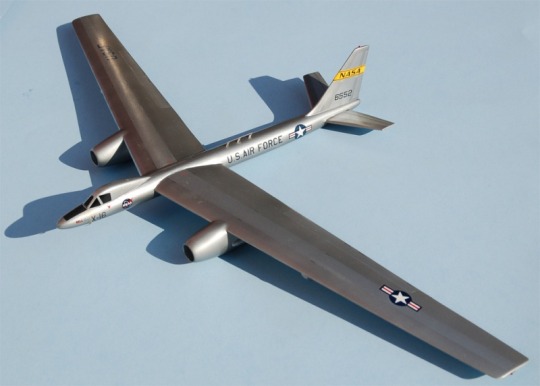
The Bell X-16 would be unique among the X-planes in that it was not an experimental prototype, but rather a designation to cover a secret project. Bell had been contracted alongside Martin in 1953 to develop a high-altitude reconnaissance aircraft powered by two J57 engines. While Martin proposed a variant of their B-57, Bell was contracted to build an entirely new design based around a novel new wing. The wing, with a span of over 100ft, had an aspect ratio of 11.9, with a single engine slung under the wing partway down the span. A long, slender fuselage carried bicycle landing gear, while outrigger wheels were placed outboard of the engines, both stabilizing the aircraft on the ground and providing support for the flexible wings. The entire aircraft was made as light as possible to meet requirements for a 3,000 mile range and ceiling of 70,000ft, resulting in an unusually flexible structure throughout the aircraft. Though the USAF cancelled the project in 1956 with the sole prototype 80% complete, the X-16 would pioneer elements of lightweight aircraft design that would prove invaluable for the U-2.
Lockheed X-17
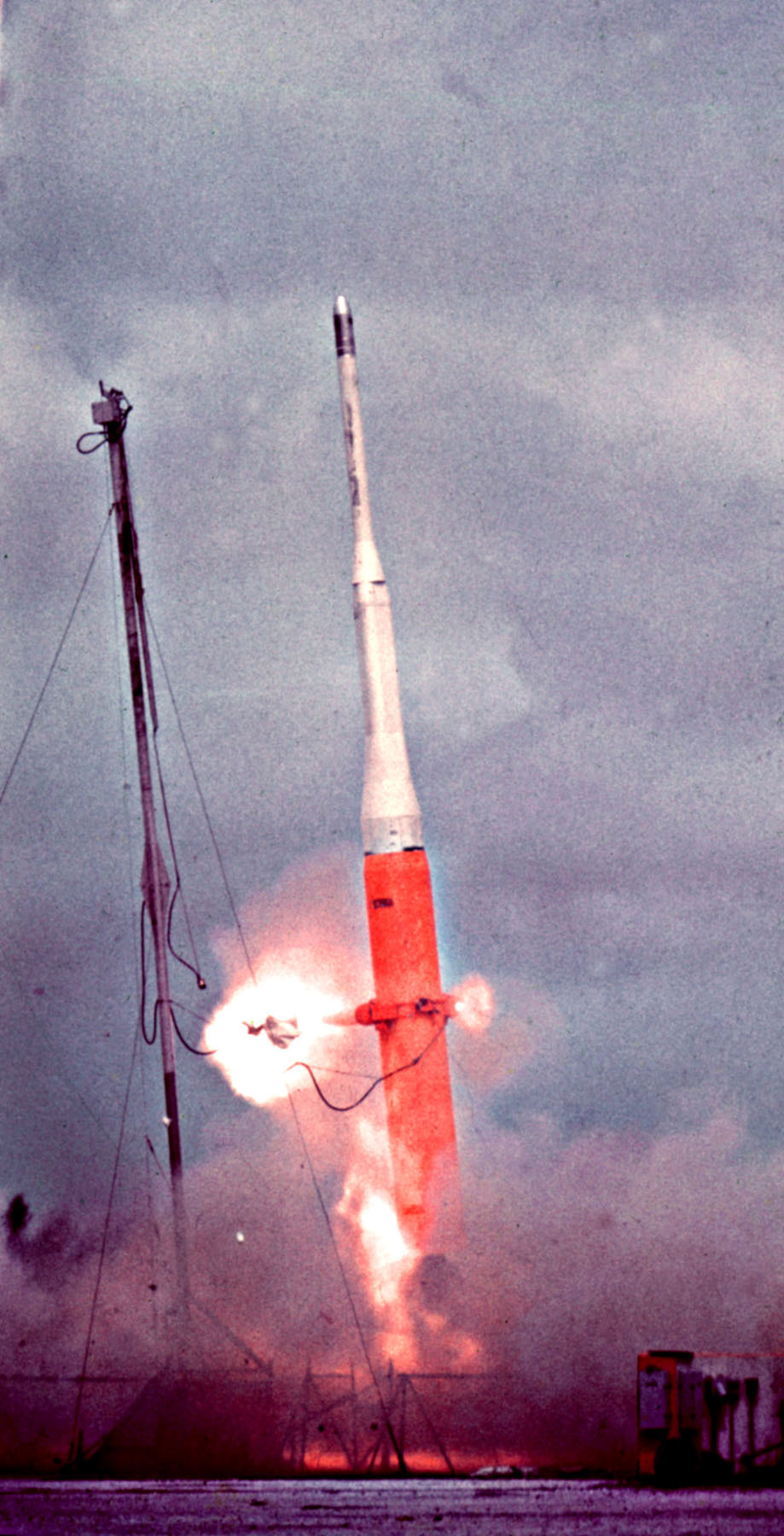
The X-17 was a multistage rocket designed to test high-speed atmospheric reentry. Unlike most multistage rockets, the X-17’s later stages were intended to accelerate the payload to simulate atmospheric reentry conditions rather than lift the rocket higher or reach orbit. The first stage would bring the X-17 up to 100 miles, at which point the remaining stages would be used to accelerate the vehicle to orbital speeds. Flight testing began in April 1956, and a total of 34 launches would occur. Over the course of testing, the X-17 reached speeds approaching Mach 15 and Reynolds numbers of about 24 million, providing the first practical data on the characteristics of various shapes in hypersonic flow. This data would be applied directly to the development of ICBM reentry vehicles and early spacecraft, proving invaluable for both programs.
Bell X-14
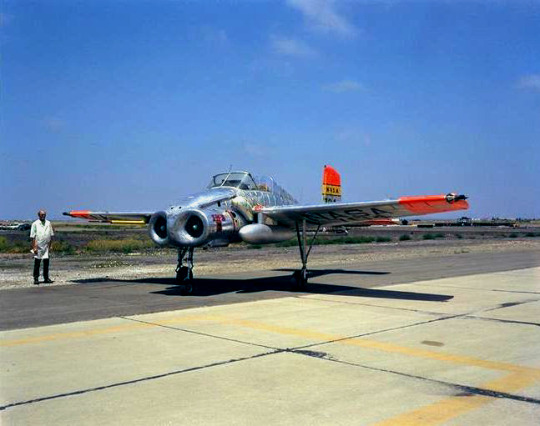
In the early ‘50s, Bell was contracted by the USAF to develop a thrust-vectoring VTOL demonstrator under the designation X-14. With modest requirements, Bell would produce a compact, anachronistic design. Straight rectangular wings and fixed landing gear were taken from a Beechcraft Bonanza, while the tail came from a Beech T-34. Though the fuselage was of new design, the pilot sat in an open cockpit. Placed in the nose were two Armstrong Siddeley Viper turbojets equipped with deflectors that could direct thrust vertically under the aircraft’s center of gravity. Flight testing of the X-14 began in February 1957, starting with untethered hover testing. In 1958, the first transition to conventional flight occurred, and the next year the Viper engines were replaced with J85s.
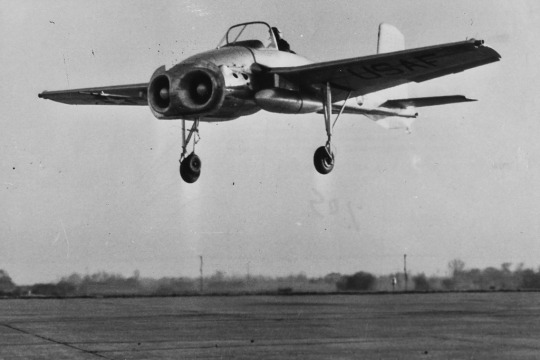
Unlike many of the earlier X-planes, the X-14 would have a long and illustrious career. After its delivery to NASA in 1959, it was used for training 25 test pilots to prepare them for other VTOL systems. As part of the development of the Hawker Siddeley P.1127 (predecessor to the Harrier), test pilots were sent over from Britain to acquaint themselves with controlling an aircraft in hovering flight. Later, it would serve as a testbed for lunar landing maneuvers, as the flight control system was similar to that of the Lunar Lander. It ended up even serving as a trainer for the Apollo astronauts, including Neil Armstrong. As the X-14’s career progressed, NASA continued to use it as a testbed for new projects. New engines and a digital fly-by-wire control system were installed in 1971, allowing it to more accurately emulate the characteristics of other VTOL aircraft. It would also be used to test out various hover-related systems, like NASA’s direct side-force maneuvering system. In the end, the X-14 continued to fly until it was damaged in a landing accident in 1981.
Convair X-11/X-12
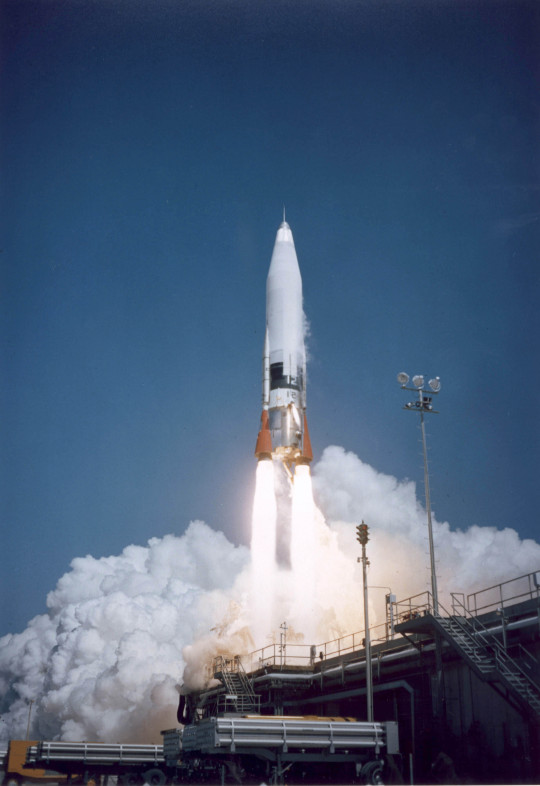
As part of the development of the Atlas ICBM, Convair would produce two incremental test vehicles to develop the technology necessary for such an advanced platform. With the Atlas was envisioned as a massive 160-foot missile powered by four boosters and one sustainer and weighing nearly half a million pounds, Convair would start off with the X-11, which was to mount just a single sustainer to validate the aerodynamics. However, advancements in nuclear weapon design allowed Convair to shrink the design and drop two of the boosters. Adjusting the program, Convair decided to test the entire powerplant on the X-11, which now became known as the Atlas A. 16 Atlas As would be built, eight of which made test launches starting in 1957. The X-11 was meant to be followed by the X-12, which was to test the guidance systems for the rocket, but, after the changes to the program, the X-12 was replaced by the Atlas B. Nine suborbital tests were made with five successes and four failures. The Atlas B would successfully demonstrate booster staging and reentry vehicle separation with a range of 6,500 miles. More significantly, however, the Atlas testbeds would pioneer a construction technique where the internal pressure of the propellant tanks supported the thin walls of the vehicle, allowing structural weight to be significantly reduced.
Ryan VZ-3 Vertiplane
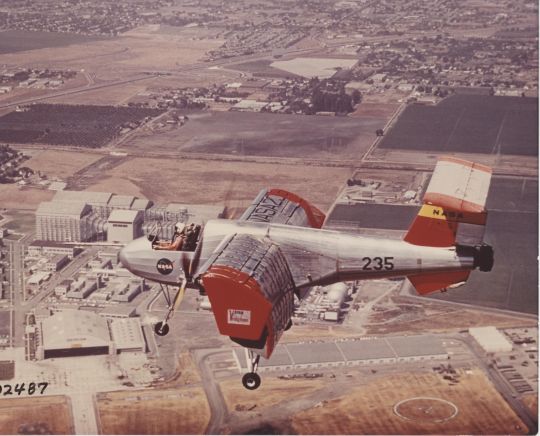
At the end of the 1950s, the US Army commissioned Ryan to create a demonstrator for a vertical takeoff proposal they had developed. Designated the VZ-3, the aircraft was a simple design using a single turboshaft engine geared out to two propellers mounted just under a specially designed wing. The wing, which extended just beyond the furthest reach of the propellers, was fitted with wide span retractable flaps that, when fully extended, had the trailing edge perpendicular to the ground. The idea behind such a system was to both vector propeller thrust downwards and create a system of blown flaps to produce enough thrust and lift to achieve vertical takeoff. Testing began at the end of December 1958, finding the VZ-3’s design to generally be sound. It could takeoff in under 30ft at a speed of just 25mph, and at 3,700ft, it was capable of hovering. It flew 21 flights until it crashed in 1959 after which it was rebuilt with some modifications and handed over to NASA.
North American X-15
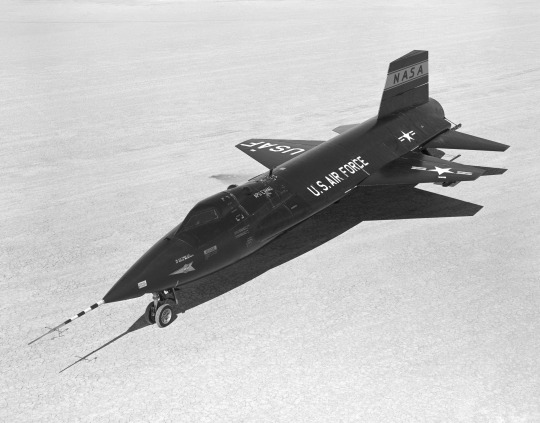
In December 1954, NACA issued a request for proposals for an airframe for a hypersonic research aircraft, followed by a request for a rocket engine the next year. North American would end up winning the contract for what became the X-15, producing a large aircraft that looked like a cross between a plane and a rocket. A long round fuselage was fitted with small trapezoidal wings midway down its length and a massive wedge-shaped vertical stabilizer extended above and below the tail to ensure hypersonic stability. Landing gear consisted of a conventional nosewheel and retractable skids that required the ventral stabilizer to be jettisoned. Because the X-15 would be operating at altitudes above where conventional control surfaces would be effective, it was fitted with a reaction control system. A stability augmentation system was also used to assist the pilot in controlling the aircraft at high speeds. The pilot was given a pressure suit, as the cockpit was only pressurized to 3.5psi. This allowed for a practical ejection seat to be used, which was rated to speeds as high as Mach 4 and altitudes up to 120,000ft. Upon ejection, fins would stabilize the pilot and seat until it had descended and slowed enough for the parachute to safely deploy.

The first X-15 would fly in June 1959, dropping from a B-52 as part of an unpowered glide test. The first powered flight came that September, with the X-15 mounting the XLR-11 motor used on the X-1, followed by flights with the planned XLR-99 motor beginning in November 1960. Testing went incredibly well. By the end of 1961, the X-15 had met design goals of a top speed of Mach 6 and ceiling of 200,000 ft, and by 1962, flights were regularly exceeding 300,000ft. In 1963, pilot Joseph Walker even managed to pass 100km, meeting the threshold to be considered outer space. Meanwhile, the X-15 was seen as so promising that NASA had been looking for more practical uses for it. They had already rejected a proposal to convert it into a spaceplane in favor of the Mercury and X-20 programs, but proposals continued, including one 1962 concept to use the X-15 to put 150lb satellites into orbit.
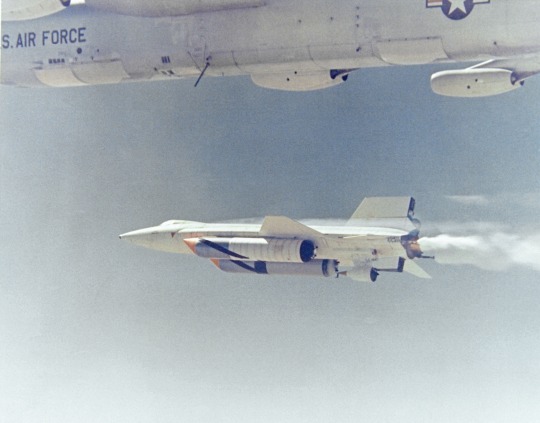
After one X-15 crashed on landing in 1962, NASA decided to rebuild it to a slightly different configuration. Designated X-15A, the new design had a lengthened fuselage, large external drop tanks, and a new ablative coating. Originally intended for longer flights to test scramjets, the X-15A would end up doing several high-speed runs as well. On October 3 1967, the X-15A would set the speed record for the program, reaching a top speed of Mach 6.7 and causing enough damage to the aircraft for it to be retired immediately afterwards. The program would not go without a major accident, unfortunately. On November 15, 1967, Major Michael Adams was killed on flight number 191 when his X-15 entered a hypersonic spin coupled with violent oscillations. Under 15Gs of force, the X-15 broke up at 60,000ft, killing Major Adams. The X-15 program would continue until 199 flights, finally coming to an end in December 1968.
Hiller X-18
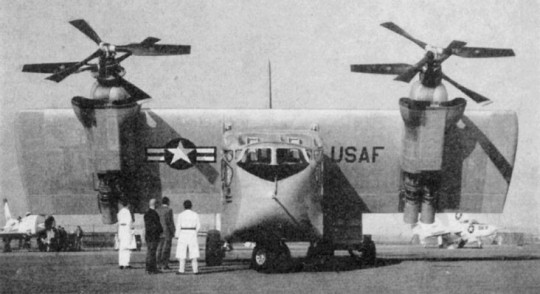
The Hiller X-18 would be conceived as a testbed to assess the practicality of a tiltwing transport. The project dated back to 1955, when the USAF contracted Hiller to produce a prototype for their tiltwing design. Work was sped along by salvaging parts from other programs, including the fuselage from a C-122 and turboprops from the cancelled XFV and XFY VTOL fighter programs. The general concept was simple - the X-18 had a turboprop on either wing driving contra-rotating propellers to provide thrust for both conventional and hovering flight, and a J34 in the tail turbojet would provide reaction control at low speeds. To hover, the entire low aspect-ratio wing assembly would rotate, tilting the engines with them to provide vertical thrust. flight testing began in November 1959. Numerous problems were noted, including the tendency for the large wing to catch the wind while hovering and the vulnerability of the design to engine failure, as the engines were not cross-linked. Additionally, thrust control came from adjusting the throttle rather than the propeller blades, making reaction times too slow for acceptable control. Only 20 flights were conducted, and the X-18 was grounded after propeller issues put the aircraft into a spin on its last flight. Tests on a hover rig continued for some time afterwards, but the program was put to an end three years later in January 1964.
Lockheed/Schweizer X-26
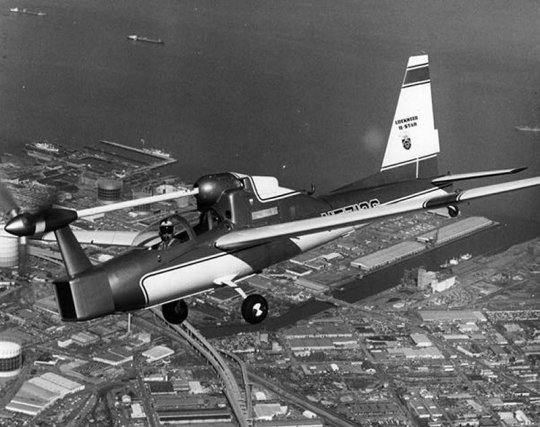
After finding conventional jet trainers too dangerous for instruction on yaw and roll coupling, the Navy ordered the SGS 2-32 sailplane from Schweizer to serve as a specialized trainer. Procured with minimal modifications, the slow roll rate and docile characteristics of the glider were just what the Navy needed. The first of the gliders would fly in July 1962, with a total of four ordered. Miraculously, Navy pilots proved capable of crashing even the most docile of aircraft, managing to lose three of them fairly quickly after the X-26 entered service. However, replacements were ordered, and the X-26 still flies to this day. The X-26 would also serve as a testbed for an experimental quiet observation aircraft, with Lockheed mounting a small motor and several sensors on two of the X-26s, creating the X-26B. They were sent ot Vietnam for operational testing, proving successful enough for the type to be ordered into production as the YO-3A. Once the YO-3As entered service, the X-26Bs were converted back to gliders and sent back to the Navy. After the end of the war in Vietnam, at least one YO-3A made its way into NASA’s hands, where it served as a research aircraft for acoustic signatures.
Northrop X-21
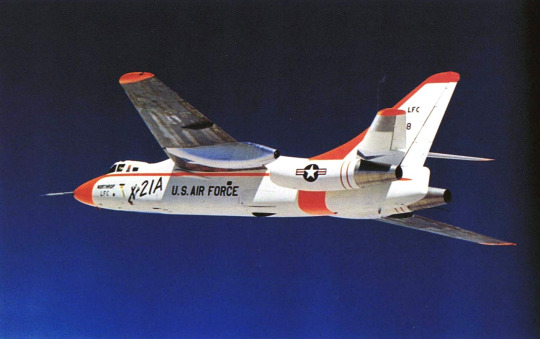
Northrop’s X-21 was designed to participate in a NASA program to investigate the feasibility of a full-scale boundary layer control system. The idea behind such a system was to establish laminar flow over the majority of an aircraft’s wing, thereby greatly reducing drag. A Douglas B-66 Destroyer was selected as the test aircraft, requiring several modifications to become the X-21. To make space for the boundary layer control system, the two podded J71 engines under the wings were replaced with two XJ79s placed on the tail, and a system was installed to bleed air from the engines into turbines which were used to such boundary layer air into small holes placed along the wings. The wings themselves were modified as well, with sweep reduced from 35 to 30 degrees, and 800,000 slots installed to allow the boundary layer control system to work. Two X-21s were converted, with testing beginning in April 1963. Ultimately, the X-21’s boundary layer control system did prove effective, reaching a maximum of 95% laminar flow over the wing, but this came at a cost of absurdly high maintenance due to the susceptibility of the holes to being plugged by debris and icing. In the end, no solution would be found for the maintenance issues, so NASA would never progress with the concept. However, the X-21 provided useful data on the effects of surface irregularities and three-dimensional boundary layer characteristics.
NASA M2-F1
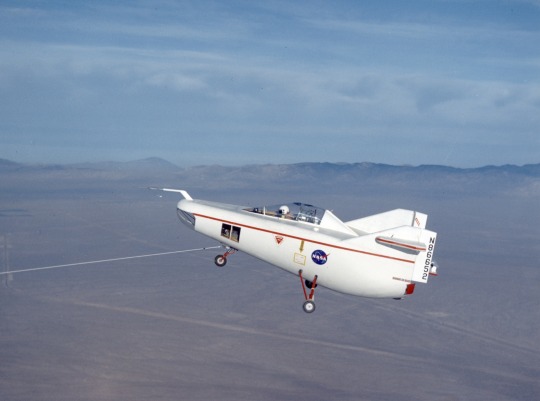
In the mid-’50s, NASA developed a concept for a lifting-body design that could prove ideal for an orbital reentry vehicle. Though details varied, the lifting body designs studied were unusually portly aircraft with a delta-shaped fuselage and no real wings. In early 1962, NASA approved the construction of an unpowered lifting body testbed, designated the M2-F1. Despite its advanced appearance, the M2-F1 was a crude design, consisting of a steel tube frame with a plywood shell and fixed landing gear. Due to the high angles of attack required to maintain flight at low speeds, a clear nose was installed to allow the pilot to see the runway on landing. Tow testing began in August 1963, unusually involving a Pontiac convertible for the test vehicle. After some modifications, the Pontiac was able to tow the M2-F1 to 110 mph, allowing the vehicle to climb to a modest 20 feet. Subsequent tests involved a NASA C-47, taking the aircraft to 12,000 ft for glide testing. By the end of the program, over 400 ground tows and 77 tow flights were conducted, successfully validating the lifting body concept and paving the way for further development.
Curtiss-Wright X-19

As a private venture, Curtiss-Wright had developed the tiltrotor X-100 technology demonstrator, which would fly in 1960. The concept caught the attention of the USAF, so when Curtiss-Wright began work on the larger X-200, two prototypes would be ordered as the X-19. The X-19 was an unusual aircraft, using a fairly conventional transport fuselage but featuring four tilting propellers placed on the tips of the aircraft’s small tandem wings. The aircraft’s two turboprop engines drove two propellers each. First flying in November 1963, the X-19 was used to explore the feasibility of tiltrotor transports during its brief test program. Stability, hovering flight, and transition to and from conventional fight were all successfully demonstrated by the prototype, but the program was cut short when the first prototype was lost in an accident in August 1965. Though a second prototype was in the works, the decision was made to cancel the program. The X-19 nevertheless provided valuable data on tiltrotor designs, even if the tandem rotor layout would never again be used.
Boeing X-20 Dyna-Soar
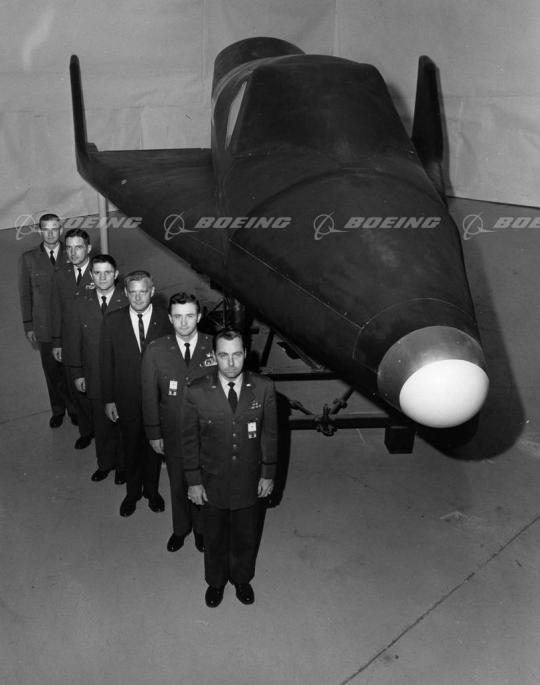
The development of the X-20 could traced back to the projects of Eugene Sanger, designer of the Silbervogel suborbital bomber concept. After WW2, engineers involved in the Silbervogel project came to America as part of Operation Paperclip, and the concept of a transatmospheric aircraft took hold. Various design studies were conducted through the ‘50s, ranging from sub-orbital bombers to reconnaissance aircraft. In 1957, the USAF consolidated these projects into a single program known as Dyna-Soar. Drawing on experience from the studies conducted through the decade, the USAF hoped to combine the reconnaissance and bombing roles of the other projects into a single platform, all while also creating a successor to the X-15. Ideally, the project would be three phases, consisting of a research vehicle followed by a reconnaissance platform and finally a strategic bomber. Project plans called for glide tests to begin in 1963, followed by powered research flights the next year, culminating in a fully operational weapon system in 1974. In 1958, nine companies tendered proposals for the Dyna-Soar contract, and in June 1959, Boeing was given the contract for the Dyna-Soar, now designated X-20.
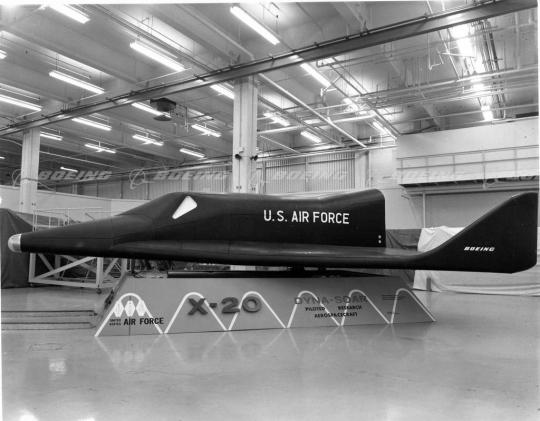
The X-20 would be a compact tailless delta aircraft fitted with vertical winglets on the wingtips. The concept behind the design was ambitious - it was intended to “skip” across the upper atmosphere in a suborbital profile, making use of hypersonic lift to extend range and maneuver the aircraft. A pilot was placed in the nose with a payload bay right behind him, and the majority of the aircraft was to be covered in the highly heat-resistant Rene 41 nickel alloy. The cockpit was fitted with a heat shield for reentry which would be jettisoned once the aircraft slowed down to allow the pilot to see for landing. Behind the equipment bay was a rocket motor which would be used to place the X-20 into orbit and serve as an emergency escape feature should a launch have to be aborted on the pad. This booster would be jettisoned before reentry. For orbital flight, the upper atmospheric “skipping” profile would still be used, but the booster would serve as a means to put the X-20 back into orbit after it performed its maneuvers. The vehicle itself would be carried aboard large booster to serve as a first stage, putting it on a suborbital profile before the orbiter-based booster fired.
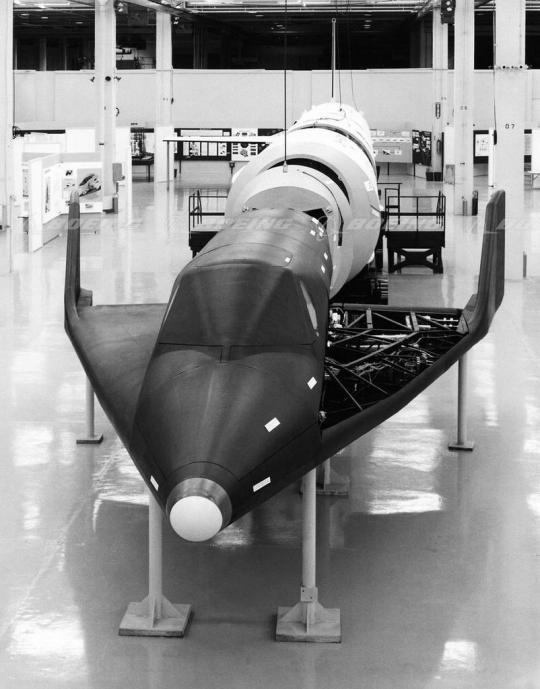
In 1960, seven astronauts were selected for the Dyna-Soar, and by the end of 1962, the X-20’s booster had been successfully tested. In 1963, testing for the inertial guidance system was completed, and overall, the X-20 seemed on track to meet the 1963 glide-test deadline. Initial problems in finding a powerful enough booster to put the five-ton test vehicle into space were solved, and much of the static testing for the Dyna-Soar was completed. However, there was resistance over the USAF conducting its own space program, a concept seen to be the domain of NASA. Defence Secretary McNamara, in his infinite wisdom, directed the USAF in early 1963 to study the feasibility of the Gemini program over the Dyna-Soar, and, when the study was still showing preference to the Dyna-Soar, he dismissed the USAF’s choice due to “placing too much emphasis on controlled re-entry.” Ultimately, at the end of 1963, McNamara cancelled the Dyna-Soar. Despite the fact that the X-20 never progressed beyond preliminary construction stages, the program would be immensely helpful for subsequent programs. Work with the Space Shuttle capitalized on development of the X-20, and many subsystems designed for the Dyna-Soar would make their way to the X-15 for flight research.
Ryan XV-5 Vertifan
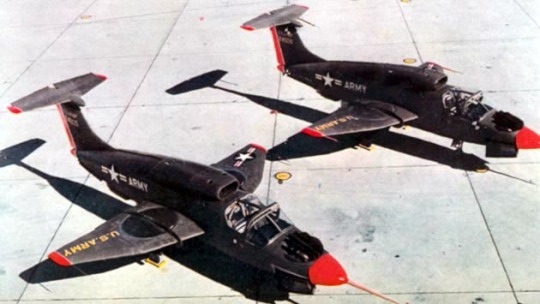
The next of Ryan’s VTOL ventures would be designated the XV-5. The XV-5 was a more practical venture, powered by two J85 turbojets and fitted with an unusual system of fans to provide vertical lift. Each wing had a 62.5 inch lift fan installed in it, while the nose had a 36 inch fan just forward of the cockpit. Panels would open up when in operation, and a set of louvers would be used to provide control while hovering. Power for the fans would come directly from the engines themselves. Though it was an unconventional system, it was undoubtedly efficient - the fans produced about 16,000lb of thrust, or about three times the output of the engines. Two prototypes were built, the first of which began testing in May 1964. One would be destroyed in a crash in 1965, while the other flew on until 1966, when it too was severely damaged in a crash while performing trials as a rescue aircraft. It would be rebuilt, flying on until 1971 before being retired.
Bell X-22
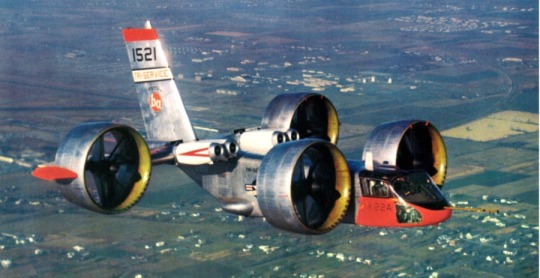
In 1962, the Navy put out a request for a prototype STOVL aircraft powered by four ducted fans. Bell, with extensive experience in VTOL aircraft, was quick to respond, and in 1964, they had their design contracted by the Navy as the X-22. The X-22 would have its four ducted fans placed in tandem, synchronized by a wave-interconnection system and powered by four turbine engines placed on the rear wings. Control surfaces were placed behind the propellers, allowing the aircraft to maneuver without tilting the ducted fans. The first flight of the X-22 came in March 1966. Unlike nearly every other VTOL program, the transition from hovering to conventional fight came almost immediately. Unfortunately, the first prototype was short-lived, as the prop control - the only non-redundant part of the power chain - failed in August 1966, causing a crash that damaged the X-22 beyond repair. The second X-22 would fly a year later, differing from the original in that it featured a new flight control system that significantly improved performance. Although the X-22 was a capable aircraft, the test program was more concerned with advancing the science of STOVL flight than refining Bell’s design for production. The Navy would eventually transfer the sole surviving prototype to Cornell Aeronautical Laboratory, flying with them until finally being retired in 1988.
Northrop M2-F2

The success of the M2-F1 paved the way for further development of the lifting-body concept, resulting in the M2-F2 demonstrator. The M2-F2 would share the general design pioneered by its predecessor, but it was a far more advanced design, making use of retractable landing gear, a modern metal construction, and a rocket motor to provide power in flight. To alleviate the visibility issues experienced on the M2-F1, the M2-F2 had the cockpit moved forward. Glide testing began in July 1966, but on the final glide test, the pilot briefly lost control due to a pilot-induced oscillation, culminating in a landing accident that severely damaged the aircraft. Though the pilot survived the crash, the M2-F2 would never fly again in its current configuration. Control problems, uncorrected by the stability augmentation system, were discovered, so when NASA rebuilt the aircraft as the M2-F3, it would feature a third vertical fin.
Martin X-23 PRIME

The X-23 would be the result of a joint NASA/USAF program to develop a maneuverable reentry vehicle as part of the Precision Recovery Including Maneuvering Reentry program. The X-23 was intended as the high-speed portion of a multi-stage test program, and thus it was a compact, unmanned testbed not intended to actually perform a controlled landing. The underside was covered in an ablative heat shield, and control was to come from a combination of flaps and rudders and a nitrogen-based reaction control system. In place of landing gear, the X-23 was to deploy a parachute to slow its descent enough for a specially modified JC-130B to recover it as it descended. The first X-23 would be launched in December 1966 atop an Atlas rocket, simulating reentry from low-earth orbit. Unfortunately, the parachute failed to completely deploy, and the X-23 crashed into the Pacific. The second test launch came in March 1957, successfully demonstrating a descent and hypersonic maneuvering, but, while the parachute did deploy, an issue with the system made it too risky to recover in air. It landed in rough seas, and the onboard flotation devices were unable to keep the aircraft afloat long enough for surface vessels to recover it. The final mission, taking place in April 1967, finally had all systems perform perfectly, allowing the X-23 to be successfully recovered. The X-23 was inspected and declared flyable, although no more missions would be flown. Despite its failures, the X-23 was a major step in the understanding of atmospheric reentry and the development of effective heat shielding.
Northrop HL-10

Parallel to the M2-F2, Northrop also built the HL-10 lifting body. The HL-10 was generally similar to Northrop’s other lifting body, differing primarily in its third vertical fin and the unusual cockpit buried in the extreme nose. Flight tests began in December 1966 with unpowered glides, but powered testing would begin after 11 drops. Over the course of testing, the HL-10 performed 37 flights, proving to be the easiest to fly and most capable of the three first-generation heavy lifting bodies (HL-10, X-23A, and M2-F2). It reached speeds up to Mach 1.86 and altitudes as high as 90,000ft, making it both the fastest and highest flying of all the lifting bodies as well. HL-10 testing continued until 1970, at which point the program came to an end.
Bensen X-25
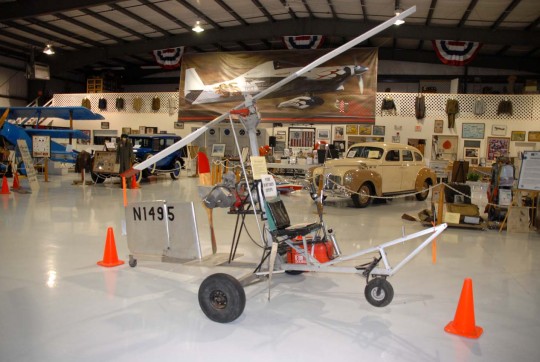
The next aircraft on the roster of X-planes was almost comically crude compared to the high-tech machines it shared the “experimental” designation with. The X-25 was procured as part of the USAF Discretionary Descent Vehicle program, aimed at giving crews bailing out of an aircraft the means to choose a more favorable landing site than a parachute would allow. The DDV evolved into a concept for an autogyro to be deployed by crews, so Benson would contracted to develop several variants of their autogyro design. The baseline X-25 was based off of the Bensen autogyro, differing mostly in that it was unpowered and designed to be folded up when not in use and automatically deployed upon ejection, even at supersonic speeds. However, the baseline X-25 never saw any flight testing, with the focus instead going to the powered X-25A and B. Flight testing began in June 1968, focusing on determining piloting techniques and training requirements. However, the Air Force lost interest in the program as Operation Rolling Thunder came to an end, and the X-25 was quickly dropped.
Martin X-24A
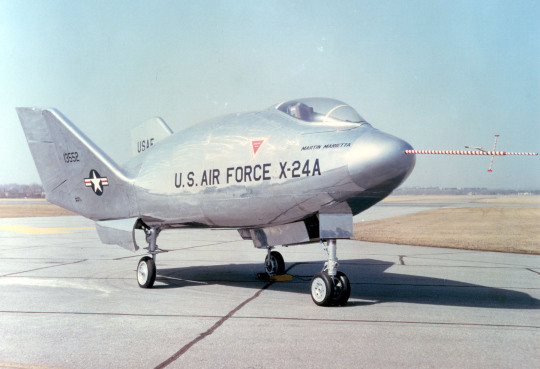
Although the X-23 validated the hypersonic characteristics of the lifting-body reentry vehicle design, the low-speed end of things still needed testing. Thus, Martin would also create the X-24A, which would be a manned aircraft sharing the same layout as the X-23 but intended for low-speed testing, particularly for landings. First flying in April 1969, the X-24A was launched from a B-52 just as many other X-planes, accelerating to supersonic speeds at high altitudes before descending unpowered to landings. 28 test flights were made, taking the X-24A to speeds as high as Mach 1.4 and altitudes of over 70,000 ft, validating the feasibility of a lifting-body vehicle that had been studied by NASA for several years. With the success of the X-24A, engineers decided to radically redesign the aircraft to test a more advanced lifting body shape, resulting in the X-24B.
NASA Hyper III

As part of the ongoing lifting body test program, NASA conceived the Hyper III as as demonstrator for a pop-out wing concept. Under the program, the unmanned Hyper III would consist of a lifting body without any control surfaces and long high aspect ratio wings fitted with control surfaces designed to simulate the planned pop-out wings. It was a simple, cheap design, being under 1,000lb and just 32 ft long. Fitted with fixed landing gear, remote control systems, and an emergency parachute, the Hyper III would make its first and only flight at the end of 1969, being dropped from a helicopter at 10,000ft. It glided 5km away from the airfield before turning around and landing without incident. However, NASA’s interests had since shifted elsewhere, and the Hyper III was never flown again.
Northrop M2-F3
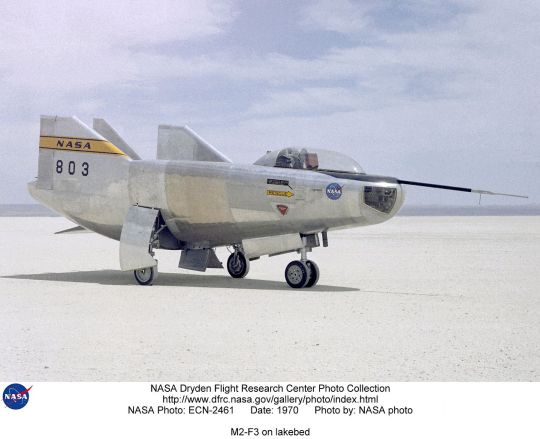
After the crash of the M2-F2, NASA would rebuilt the aircraft with modifications to address the control issues that resulted in the crash. Most significant among these changes was the addition of a third vertical fin, intended to improve control characteristics. Though most of the M2-F2 was salvaged after the 1967 crash, it took three years to return the aircraft to service due to the extensive damage. Unpowered flight testing began in June 1970, and by the end of the year powered tests had began. Tests found the M2-F3 to be challenging to fly but more stable than its predecessor, allowing pilots to take the M2-F3 to Mach 1.6 and a ceiling of over 70,000ft. Towards the end of the test program, a reaction control system was installed on the aircraft to test its efficacy. Testing concluded at the end of 1972 after 27 flights.
Osprey X-28
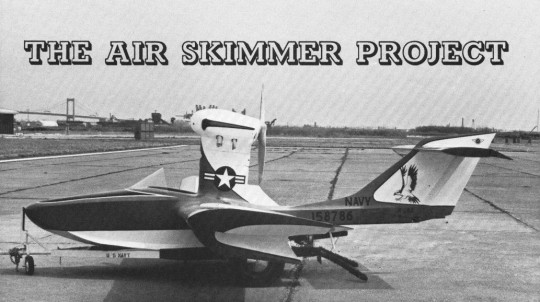
During the war in Vietnam, the Navy began looking into procuring a light, cheap seaplane for patrol duties. Requirements were only that the aircraft had to be cheaper than $5,000 and simple enough to manufacture in Vietnam without any major investment. The Osprey GP2 Osprey seaplane would catch the Navy’s attention, and an order would be placed as the X-28. Flight testing began in 1970. The Navy found the X-28’s performance to be exceptional, especially considering its engine produced only 90hp. Unfortunately, the program the X-28 was procured for was cancelled, so no production order would ever be placed.
Lockheed CL-1200/X-27
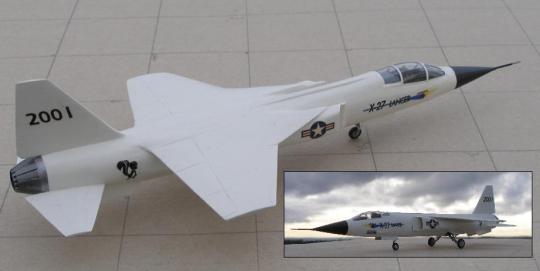
The X-27 would be another example of a design that was less an experimental program and more a misleadingly-named weapon system prototype. Designed as a replacement for the F-104, it made use of a lengthened F-104 fuselage with 46% more internal fuel capacity. While there were minor changes to the tail, the big difference with the X-27 was the new shoulder-mounted wing with 53% more area and leading edge root extensions. The new wing required Lockheed to modify the tail, both by increasing its area and by moving the horizontal stabilizers to low on the fuselage to keep it out of the wing’s wash at high angles of attack. Though the J79 of the F-104 was retained, Lockheed had plans for changing the fuselage to accommodate a modern turbofan like the TF30 in the future. The big was in armament - nine weapons stations provided a payload capacity of 12,000lb, and the X-27 was to be capable of carrying the AIM-7. Unfortunately, the project received little support from either the USAF or Congress. Though the USAF did have an interest in procuring at least one CL-1200 as the X-27 for high-speed testing, it was generally perceived as superfluous by Congress and a threat to F-15 funding by the USAF. It was officially cancelled in late 1970, and although Lockheed tried to revive it for the Lightweight Fighter competition, it would never gain any significant support.
Vought TF-8A Supercritical Wing

In the 1960s, NASA had developed a new airfoil optimized for supersonic speeds dubbed the supercritical airfoil. After considerable testing in wind tunnels, they finally decided to perform full-scale testing in the latter half of the decade. The F-8 Crusader, with its easily removable wing and Mach 1.7 performance, was selected as the testbed aircraft. The original wing was removed and replaced with a larger cranked-arrow wing using a supercritical airfoil. Flight testing began in March 1971, but it would have to wait until May for supersonic testing to occur. In August 1971, the TF-8A was fitted with instrument bulges on the fuselage cheeks, and studies of wing performance began. Testing confirmed the predictions of NASA, although the fuselage cheeks were found to produce more drag rather than reduce it as NASA had hoped. Nevertheless, the supercritical wing had improved transonic efficiency by as much as 15%. Though it never got to see use on an SST as NASA had hoped, the supercritical wing would become a mainstay of commercial air travel in the years since the program’s end.
Martin X-24B
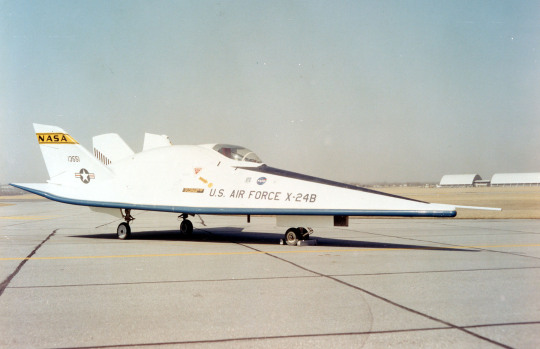
In 1972, NASA engineers decided to convert the successful X-24A demonstrator to a new configuration to test a more advanced lifting body shape. Redesignated the X-24B, the new aircraft lost its bulbous shape, taking on a triangular flatiron appearance as a new shell was hastily put over the existing airframe. With a much better lift-to-drag ratio, the X-24B would ideally provide far better performance than the X-24A design. Testing began in August 1973, with the X-24B making similar flight profiles to the original X-24. However, interest soon shifted to providing data for the upcoming Space Shuttle, so the majority of the X-24B’s 36 test flights were spent examining precision landing techniques.
Lockheed L-301
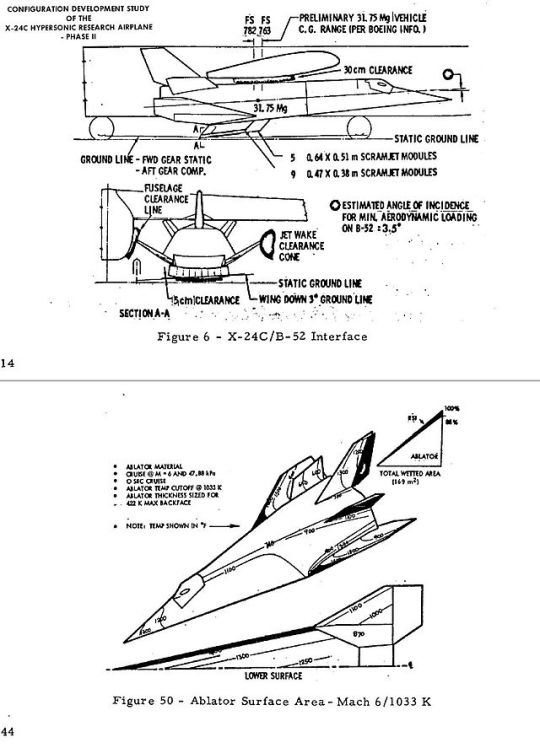
As a follow-on to the X-15 and X-24, NASA worked with Lockheed to develop a hypersonic lifting body design. Given the internal designation L-301, the design was far more ambitious than either the X-15 or X-24. The L-301 used the triangular lifting body of the X-24B, but it was much larger to accommodate the sustainer rocket from an Atlas launcher and a ventral scramjet. With these propulsion systems, the L-301 was planned to reach speeds as high as Mach 8 with the potential of performing suborbital skip-glide maneuvers. Compared to previous projects, the L-301 would be the heaviest machine yet dropped from a B-52 at 32 metric tons. NASA drew up plans in January 1977 to operate two vehicles for 100 flights under the tentative designation X-24C, but that September it was cancelled due to budget constraints and a lack of need.
Rockwell RPRV-870 HiMAT
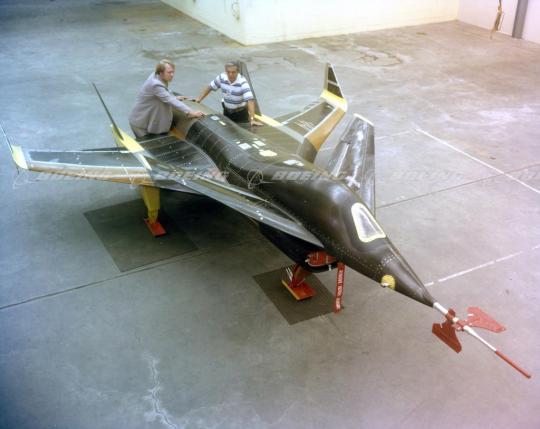
In 1973, NASA began the Highly Maneuverable Aircraft Technology program, aimed at developing technologies for next generation fighters. General project goals called for a 100% increase in aerodynamic efficiency over 1973 technology along with reduced costs and the agility to perform an 8G sustained turn at Mach 0.9. Rockwell was awarded a contract in 1975 for their design, which was a compact modular single-engined unmanned design featuring canards. Making the machine unmanned reduced the risks associated with such an advanced design while also allowing the HiMAT to be shrunk - the final design had a max takeoff weight of 3,400lb and was powered by a single compact J85 turbojet. Flown remotely by operators on the ground, it was controlled by an advanced fly-by-wire system and an autopilot. A high-risk approach to the design process was used, making extensive use of unproven computational design tools to shorten wind-tunnel testing, allowing development time to be significantly reduced.

The HiMAT began flight testing in 1979, being carried aloft under the wing of a B-52. Though the remote control system proved capable, NASA opted to program much of the test regime into the autopilot to allow for maneuvers to be accurately repeated for testing purposes. Thanks to that, the test program could be drastically shortened - the two test aircraft would fly just 26 times in the 3 and a half year long program. Though flight testing was surprisingly short, the HiMAT proved incredibly helpful. It validated various emerging concepts such as composite structures and close-coupled canard designs, as well as aeroelastic tailoring to reduce the negative impact of aeroelasticity. It also contributed greatly to the design process itself, showing that computational software could be used in aircraft design to reduce reliability on wind-tunnel testing.
NASA AD-1
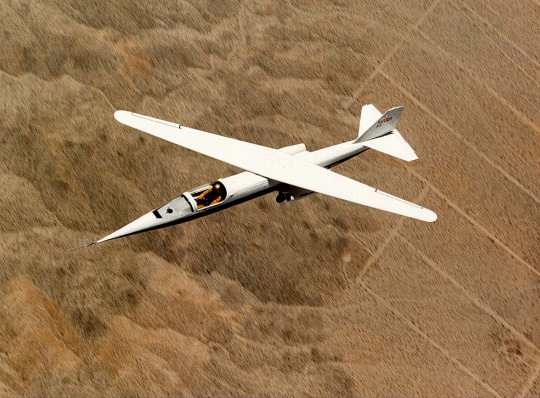
In the ‘70s, NASA became interested in the idea of an oblique wing after studies found that a wing pivoted about 60 degrees could provide significantly improved supersonic performance. A concept soon arose for an aircraft with a pivoting wing. For low speeds, the wing would be perpendicular to the fuselage, but as speed increased, the wing would rotate about the fuselage to reduce drag. Sufficiently convinced of the concept’s benefits, NASA decided to build a low-speed demonstrator to test the design. Designated the AD-1, the aircraft was a compact design powered by two turbojets with a combined thrust of under 500lb. A large high aspect ratio wing was mounted atop the fuselage, attached to a mechanism that would rotate the wing counterclockwise up to 60 degrees. The fixed gear sat very close to the fuselage to reduce drag, making the aircraft just 6 feet tall on the ground. Thanks to extensive use of composites, the AD-1 was also incredibly light, coming in at under 1,500lb.
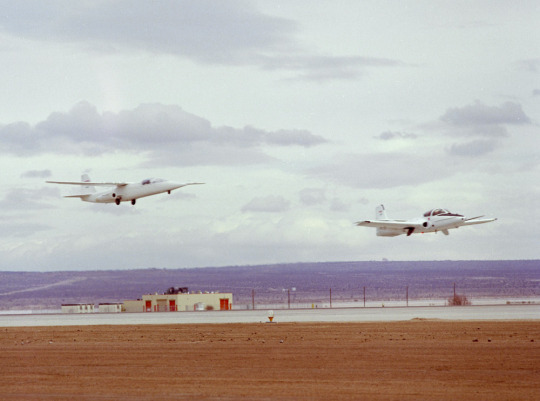
The AD-1 flew for the first time in late 1979. Tests incrementally increased the wing sweep, finally reaching the full 60 degrees in mid 1981. Flight testing would continue until 1982. Unfortunately, the AD-1 demonstrated several unfavorable characteristics. At sweep angles above 45 degrees, the AD-1 began to experience dangerous aeroelastic and pitch/roll coupling effects that led to poor handling. Unfortunately, while these problems could largely be addressed through the use of a stiffer wing and advanced control system, NASA chose not to pursue further testing of an oblique wing design in the transonic and supersonic regime.
Grumman X-29
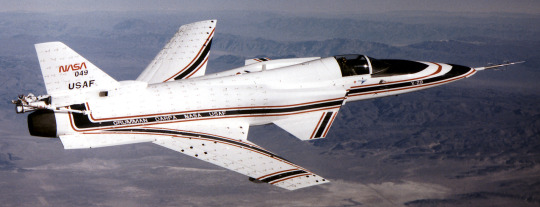
Although the concept of forward-swept wings had been around since at least WW2, the concept led to structural challenges that wouldn’t be surmountable until the advent of advanced composites. As such materials came into use in the late ‘70s, DARPA put out a request for proposals for a testbed for, among other things, forward swept wings. Grumman would base their proposal off of the F-5, ultimately winning the production contract in 1981. Designated the X-29, the aircraft would be far from purely a forward-swept wing demonstrator. It was fitted with canards and an advanced forward-swept wing, while the horizontal tail was replaced with strakes fitted with flaps to aid in control. The design was highly unstable, so a fly-by-wire control system was developed to compensate. The real centerpiece of the X-29, however, was its advanced wings. Newly developed composites were employed in the wing, arranged in such a way that the bending moment from lift caused the leading edge to bend downwards, opposite the direction of lift-related twisting moments. Thus, the wing was not only lighter than previous forward-swept wing designs, but it completely avoided structural divergence as well.

The X-29 made its maiden flight in December 1984, becoming the third forward-swept wing ever to fly (after the Junkers Ju 287 and Hansa Jet). A year after it first flew, the X-29 made history by becoming the first forward-swept wing aircraft to break the sound barrier. The second X-29 would begin more radical testing, experimenting with maneuverability. Tests found the X-29 to be maneuverable up to 25 degrees angle of attack, while maneuvers could briefly bring the aircraft to a 67 degree angle of attack. Between 1984 and 1991, 242 flights were made by the two aircraft. They successfully demonstrated composite construction techniques, three-surface control, and the feasibility of forward-swept wings. However, the expected drag reductions NASA was hoping for never materialized, so, while the forward swept wing was proven to be possible, it failed to offer much to make up for the costs associated with its construction.
McDonnell Douglas F-18 High Alpha Research Vehicle
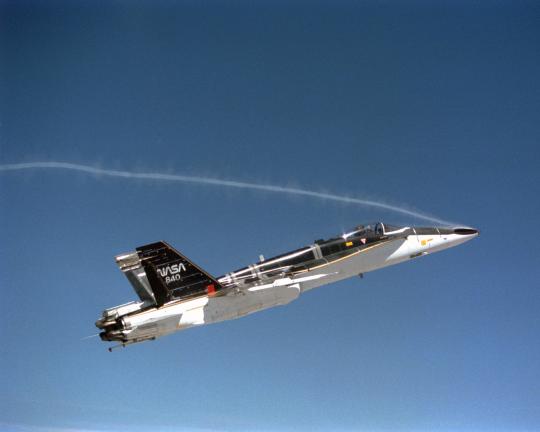
As part of a program to study the viability of thrust-vectoring for high-alpha maneuvers, NASA selected the F-18 as a testbed. A single F-18 was taken for testing, being first modified with various instruments and flown starting in 1987 to serve as a baseline. Initial tests to took the HARV to 55 degrees angle of attack, with test officials noting the strong buffeting over the tail caused by vortices from the leading edge root extensions. In 1989, the HARV was fitted with thrust vectoring nozzles consisting of three paddles behind each engine. These changes resulted in the loss of the original engine nozzles, making supersonic flight no longer possible. With thrust vectoring, the HARV took flight in 1991. It demonstrated a major increase in agility at lower angles of attack, and it remained controllable long beyond the point where traditional control surfaces stopped working, reaching a maximum angle of attack of 70 degrees. In 1995, movable strakes were added near the nose, intended to provide yaw control at angles of attack where the tail was no longer useful. Testing concluded in September 1996 after 385 flights.
McDonnell Douglas F-15 STOL/MTD/ACTIVE
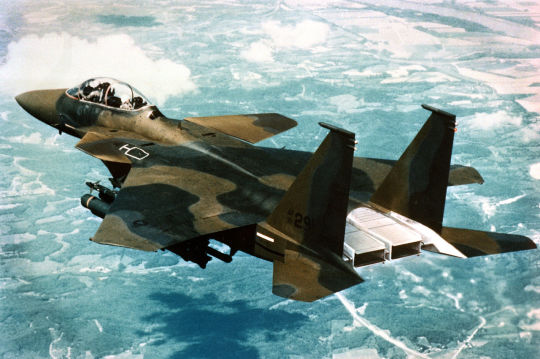
In 1975, NASA began looking into two-dimensional thrust-vectoring, culminating in a program to adapt such a system to the F-15. Meanwhile, in preparation for the Advanced Tactical Fighter program, the USAF was looking for a demonstrator to examine the feasibility of the maneuverability and STOL characteristics being proposed. In 1984, this resulted in a contract being placed with McDonnell Douglas for the F-15 STOL/Maneuver Technology Demonstrator. The STOL/MTD program aimed to demonstrate the same STOL and maneuverability characteristics of the ATF requirements, particularly in respect to using thrust reversers to aid in combat maneuverability. To meet these requirements, McDonnell Douglas used an F-15B as a base, adding the tailplanes of an F/A-18 forward of the wing to act as canards (canted upwards to avoid having vortices go over the wing) and specially designed engine nozzles. Although requirements only called for thrust-reversers, McDonnell Douglas took the opportunity to add two-dimensional thrust vectoring as well.
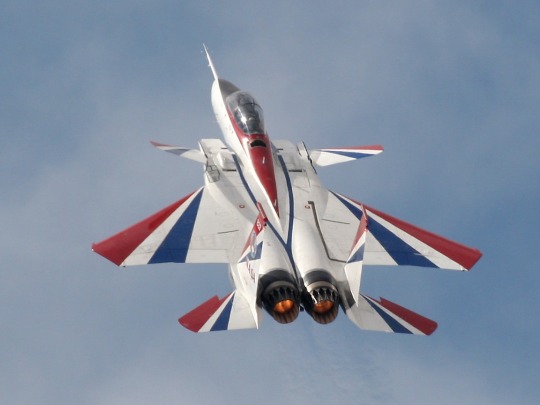
The F-15 STOL/MTD would first fly in September 1988. During tests, it would demonstrate a 25% reduction in takeoff roll, and, by vectoring thrust, it could achieve rotation at just 42mph. By using the canards as airbrakes and engaging the thrust reversers, the STOL/MTD could land in just 500m, just over a fifth of what the standard F-15B required. It would also demonstrate incredible maneuverability, being controllable at an angle of attack of 80 degrees and demonstrating the ability to decelerate very quickly in the air by engaging air brakes and thrust reversers. However, the incredible performance came at a cost. The thrust reversers were incredibly complicated and expensive, requiring an extensive cooling system and adding to the empty weight. Plus, the effectiveness of a maneuver that dumps all the aircraft’s energy was questionable, so in December 1988, the USAF dropped the thrust reversers from the ATF requirements and relaxed STOL requirements.
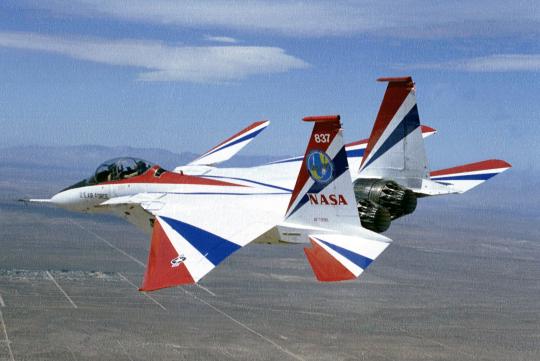
Though the STOL/MTD program came to an end in 1991, the sole prototype would continue to see use. After being given to NASA, it was used in the Advanced Control Technology for Integrated Vehicles program. The F-15 ACTIVE would retain the canards and nozzles, but it was given a new control system. The ACTIVE program explored the use of thrust-vectoring in supersonic flight, as well as the possibility of replacing vertical fins with thrust vectoring nozzles. Flights began in early 1996, and before the year was out the F-15 ACTIVE had demonstrated thrust vectoring at Mach 1.95. Though the ACTIVE came to an end in 1999, that would not mark the end of this particular F-15’s career. It would be selected for the Intelligent Flight Control System program, which aimed to apply an intelligent control system to the aircraft designed to optimize aircraft performance. The idea behind the concept was to allow the control system to compensate for the loss of any single control surface by working around the problem. The IFCS F-15 would fly in 2005, testing for three more years before finally being retired.
Rockwell/MBB X-31
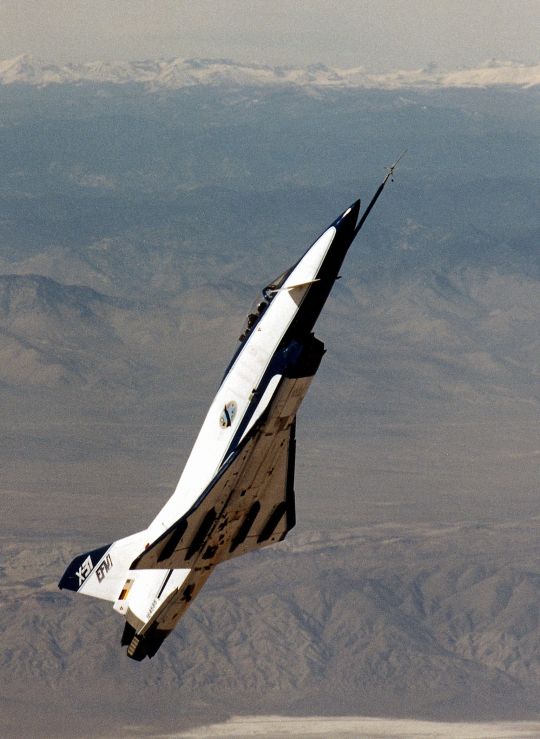
At the end of the ‘80s, DARPA, the USN, and West Germany came together to create the Enhanced Fighter Maneuverability program, aimed at developing an aircraft capable of post-stall maneuverability. Rockwell and MBB would come together to manage the project, making use of a single engine canard-delta design similar to the Eurofighter MBB had been working on and the Rockwell SNAKE design. Unusually, it had no horizontal control surfaces on the wing, instead relying on three movable paddles at the engine outlet to vector thrust and computer-controlled canards for control. The aircraft itself was compact, with a max takeoff weight just under the 16,000lb thrust output of its F404 engine. Work finished by 1990, allowing the X-31 to take flight that October.

Over the course of the test program, the X-31 would prove incredibly maneuverable. In November 1992, the X-31 demonstrated controlled flight at 70 degrees angle of attack, and the next year, the aircraft had successfully performed a Herbst maneuver. Though the first X-31 was lost in 1995 after over 200 flights, it was replaced by a second aircraft, allowing testing to continue. Towards the end of the decade, the program partners came together again for a new test program. After being shipped to NAS Patuxent River in 2000, the X-31 had its vertical tail removed to test the efficacy of using thrust vectoring in place of a vertical tail, and an autonomous landing system was installed. Tests also investigated the X-31’s STOL capabilities, with the aircraft demonstrating various takeoff and landing approaches on a virtual runway 5,000 ft in the air. With such approaches validated, the X-31 would perform the first ever autonomous landing of an aircraft at a high angle of attack (24 degrees in this case). Flight tests ended in 2003 after 288 flights were made.
General Dynamics F-16 VISTA
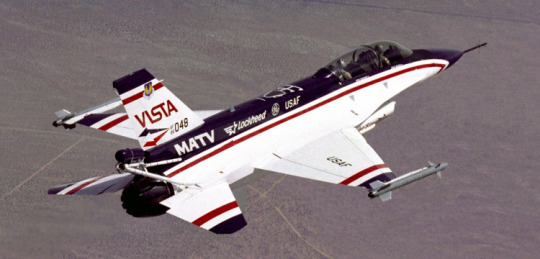
The F-16 VISTA had its origins in a private venture program between GE and General Dynamics to develop a thrust-vectored variant of the F-16. When the USAF demonstrated little interest, they went to Israel, ending in an agreement in which an F-16D would be supplied for conversion in testing. Around the same time, the USAF had contracted General Dynamics to develop an F-16 variant for the Variable Stability In-Flight Simulator program. In 1991, the USAF got involved in the Israeli project as well, combining the VISTA with the thrust-vectoring program as Israel withdrew the next year. The VISTA program took priority, however. The VISTA conversion involved adding a center stick to both cockpits and using new software to allow for variable stability flight. The F-16D was also given strengthened landing gear and more powerful hydraulics to allow it to simulate other aircraft, and, when the Israelis dropped their involvement, a thrust-vectoring nozzle was added.
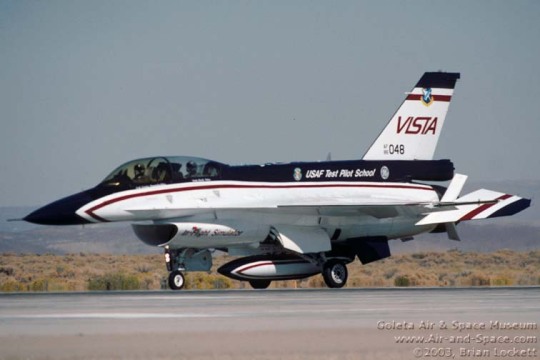
The F-16 VISTA would fly in 1992, but within a year it had been transferred over to the Multi-Axis Thrust Vectoring program. Exact details of the differences between the VISTA and MATV conversions were (other than removing the center stick for the variable stability system), but over the course of testing, the F-16 VISTA would demonstrate controllable flight at angles of attack as high as 86 degrees and instantaneous angles of attack up to 180 degrees. About 100 missions seem to have been flown, with the program coming to an end in 1998.
Rockwell X-30 National Aero-Space Plane

The X-30 could trace its roots back to DARPA’s COPPER CANYON program, which ran from 1982 to 1985, studying hypersonic vehicles. After President Reagan mentioned a hypersonic transport with a top speed of Mach 25 in his 1986 State of the Union address, work on creating such an aircraft kicked off. Though aerodynamic heating presented a theoretical limit of Mach 8 for such aircraft, NASA and DARPA would study the use of passing hydrogen over the aircraft’s skin for cooling, while aerospace companies began competing for contracts. In 1990, Rockwell was given the lead role in the program, which was now designated X-30. Unfortunately, the program was absurdly ambitious. Mach 25 would put the X-30 into orbit, meaning the design was to be an SSTO. Meanwhile, the Defense Department wanted the X-30 to be capable of carrying a small payload and a crew, causing weight to skyrocket. Structurally and conceptually, the X-30 was progressing well. The aircraft was to be a wedge-shaped lifting body with a scramjet mounted underneath, maintaining flight through compression lift. Various heat-resistant materials, including a titanium-based composite, were developed for the program. However, such an ambitious project was doomed to failure. In 1993, due to budget cuts and technical concerns, the X-30 was cancelled.
Boeing/McDonnell Douglas X-36
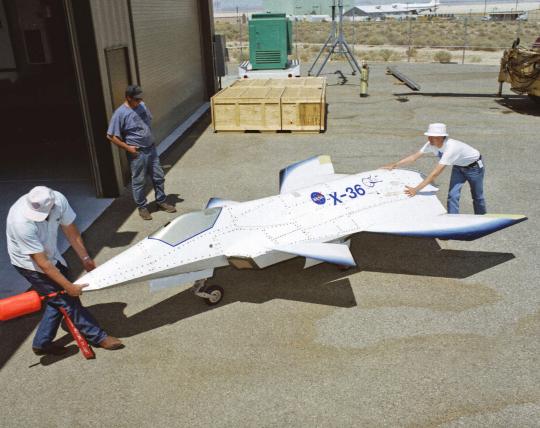
In the latter half of the ‘90s, McDonnell Douglas entered a partnership with NASA to develop a new fighter testbed. Contracted as the X-36, the design was an unmanned sub-scale aircraft with canards and no vertical flight surfaces. Intended to investigate the viability of eliminating all vertical surfaces on a fighter to improve stealth, the X-36 instead would rely on thrust-vectoring and split flaps to provide yaw control. Additionally, the X-36 was unstable in both yaw and pitch axes, so and advanced fly-by-wire system was developed. Control would come from a pilot on the ground, using a nose-mounted camera to guide the aircraft remotely. As the project progressed, Boeing acquired McDonnell Douglas and took over the X-36. The X-36 that was rolled out in 1997 was surprisingly small, just 1,250 lb and 19 feet long. Flight testing began in May 1997, flying for a total of 31 flights, during which the X-36 reached a maximum angle of attack of 40 degrees. The X-36 validated the idea that a fighter could be made without any vertical flight surfaces, proving highly agile and controllable at all ends of the flight envelope. Though lower priority, testing also looked at several different control systems, including a neural-net software package designed to compensate for failures of control surfaces in flight.
Boeing X-40
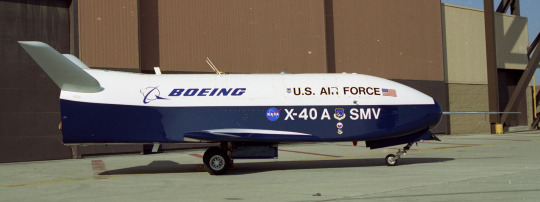
As part of the program that ultimately resulted in the X-37, Boeing would develop a sub-scale aerodynamic demonstrator to evaluate their final design. Given the designation X-40, the aircraft was effectively an unpowered 80% scale X-37 fitted with the autonomous navigation systems Boeing intended to employ in the final design. The X-40 first flew in August 1998, flying one test flight with Boeing before being transferred to NASA for further testing. It would fly a further 7 test flights, validating the aerodynamic design of the X-40/37 and the effectiveness of the navigation system Boeing had developed, particularly for landings. With the conclusion of the 8th flight in 2001, the X-40 was retired.
NASA X-38

As the International Space Station program started up, concerns over the safety of crews aboard the station in an emergency arose. As the ISS’s capacity is limited by the crew rescue capacity, NASA decided to develop a dedicated escape capsule in cooperation with the ESA and DLR. Designated the Crew Return Vehicle, the aircraft was a simple lifting body design with a capacity of seven people. As designed, the mission profile called for the CRV to be semi-permanently docked with the ISS, using a propulsion system to deorbit when activated. Upon reentry, a steerable parafoil would be deployed, allowing the crew to safely maneuver the CRV for landing. To test the design, NASA built the sub-scale unmanned X-38, which began testing in 1999. Several prototypes were dropped from 45,000ft by a B-52, deploying a massive 7,500 square foot parafoil to land. Unfortunately, while the X-38 was going smoothly, the ISS program was not. Skyrocketing costs led to the establishment of the ISS Management and Cost Evaluation Task Force, which began to cut many elements of the ISS program. In April 2002, the X-38 fell victim to these cuts, ending the program with the full-scale prototype 90% complete.
Orbital Sciences X-34
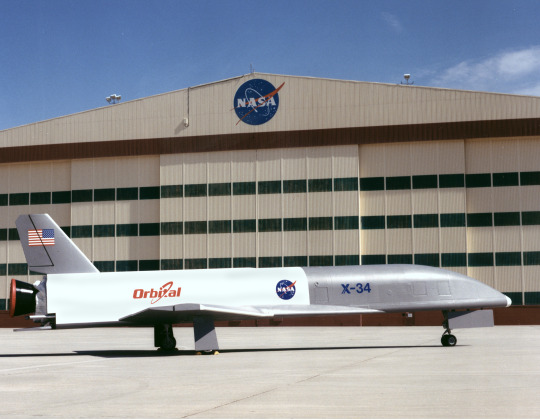
The X-34 was ordered as a testbed to demonstrate various cost-reducing technologies in a reusable orbiter. Designed as an autonomous suborbital demonstrator, the X-34 made use of structural composites and a composite fuel tank, as well as a new thermal protection system. Plans called for 25 test flights a year to take the X-34 to Mach 8 at 250,000ft. The first of three X-34s would begin captive-carry flights in 1999 under Orbital’s L-1011, with full flight testing scheduled for late 2000. A special hangar was constructed at Kennedy Space Center to support the program, and the X-34 seemed to be progressing well. However, NASA would revise requirements in 2000, causing costs to rise without any associated extra funding. Without funding to accommodate the new requirements, Orbital refused to make the changes, so the X-34 came to an end in March 2001.
X-42 Pop-Up Upper Stage
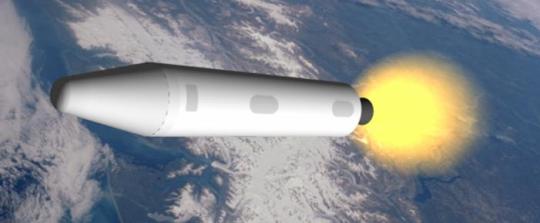
The X-42 designation has been reserved for a classified project known as Pop-Up Upper Stage. Unlike many of the other space-related X-planes, the X-42’s specifications were fairly benign on the surface, calling for an expendable liquid-fueled rocket upper stage intended to put 2,000-4,000lb payloads into orbit. The project apparently started some time in the ‘90s, and plans set out had called for preliminary hardware testing to be completed in 1997 and a test launch in 2000. It seems that the X-42 was intended to be a support element for the USAF’s other space related projects by providing a more capable final stage to place newly developed vehicles into more favorable orbits. The fate of the program is unknown - it doesn’t seem to be cancelled, but no recent news has come from it and no test launches appear to have occurred.
Lockheed X-44 MANTA

The X-44 designation was reserved for the USAF Multi-Axis No-Tail Aircraft program, intended to work with around a heavily modified F-22. The MANTA program planned to convert one of the prototype F-22s to use a large delta wing similar to that proposed for the FB-22 and new thrust-vectoring nozzles. The tail was eliminated, as were all control surfaces. The result would ideally be a structurally simple aircraft with a lighter, stealthier airframe with more space for fuel and payload at minimal cost to aircraft agility. Unfortunately, the X-44 would never materialize. Conversion of the prototype never occurred, and funding was cut in 2000, ending the X-44 program.
X-39 Future Aircraft Technology Enhancements

The X-39 designation was reserved for the USAF Future Aircraft Technology Enhancements program, which aimed to develop a host of new technologies for the next generation of combat aircraft. The program investigated technologies such as active aeroelastic wings, new composite structures, advanced inlet designs, and adaptive flight controls. The FATE program called for a technology demonstrator to ultimately be produced to test these technologies, but the program was cancelled in the project definition stage and folded into the UCAV Advanced Technology Demonstrator program.
Boeing X-32
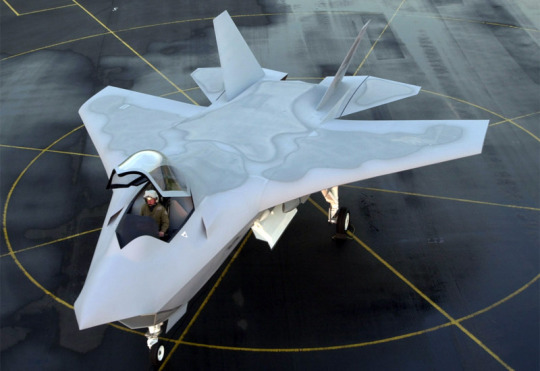
After winning the first round of selection for the Joint Strike Fighter program, Boeing would draw heavily on their experience with the ATF and various programs through the ‘90s for their design. Contracted as the X-32, the aircraft was a portly tailless design featuring a prominent chin intake similar to the one developed for the Boeing ATF proposal. Boeing opted for a simple thrust-vectoring system similar to that seen on the Harrier for STOVL operations, requiring the engine to be placed near the center of gravity. The massive wing consisted of a single piece of carbon fiber composite, and was spacious enough to carry 20,000lb of fuel. The massive chin intake was configured to extend outwards on the STOVL variant, increasing airflow into the engine for vertical flight. Two prototypes would be built - the conventional X-32A and STOVL X-32B. Although maneuverability requirements forced Boeing to perform a major redesign of the final F-32 design (adding a conventional tail), but it would be too late to modify the prototypes for the fly-off against the X-35.

The X-32A would fly for the first time in September 2000, followed by the X-32B in March of the next year. Testing quickly found the X-32 to be completely uncompetitive with the X-35. The X-32B was incapable of hovering and reaching supersonic speeds in the same flight, and the X-32A’s maneuverability was hampered by the unusual center of gravity produced by the central engine placement. If it wasn’t bad enough that the X-32 couldn’t meet maneuverability requirements, the X-32B required several parts to be removed for STOVL operations. Boeing promised that the final design would address these issues, but there really was no question as to who the winner was. In October 2001, Lockheed’s X-35 was selected as the winner of the Joint Strike Fighter.
Lockheed Martin X-35
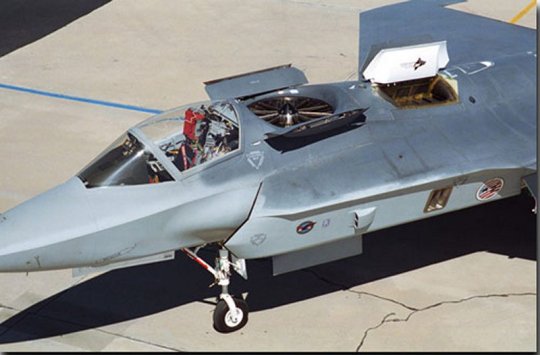
Lockheed’s X-35 would be designed around the novel lift fan system they had developed as part of the ASTOVL program. Overall very conventional in appearance, the X-35 was fitted with the Rolls-Royce Lift System, which was linked directly to the driveshaft of the aircraft’s F135 engine to provide vertical thrust for STOVL operations. Effectively working on the same principle as a turboprop, the X-35’s lift system was by far the most promising of all the JSF proposals. Diverting power to drive the lift fan did reduce the thrust of the main engine, but the resultant thrust of the lift fan far outweighed those losses. Because the lift fan produced a comparatively cold column of air, it also offered the ability to reduce the chance of ingesting hot engine exhaust during hovering flight. Even better, the design allowed for a conventional layout, meaning the non-STOVL variants would not be forced to work with an unfavorable layout purely to allow for commonality between variants.
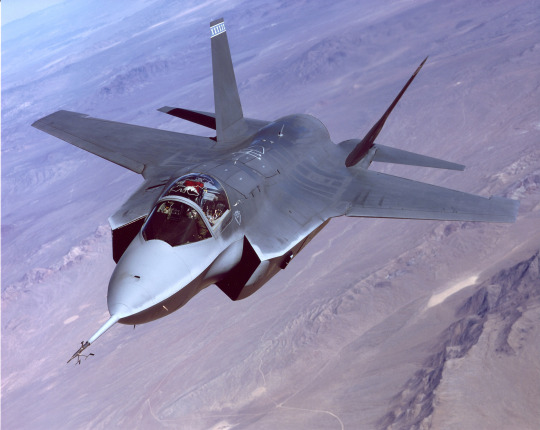
The X-35A would fly for the first time in October 2000, followed by the X-35C carrier variant. After successful testing of the X-35A, Lockheed fitted it with the VTOL systems, turning it into the X-35B. The X-35B began vertical flight testing in June 2001, and over the course of testing it proved far superior to the X-32. As the conversion from the X-35A to B had shown, there was significantly more commonality between variants than the X-32, and, unlike the X-32, the X-35B was capable of taking off in under 500 feet, reaching supersonic speeds, and then landing vertically. With Lockheed’s design blowing Boeing out of the water, and the X-32 not even fully meeting program requirements, it came as no surprise when the X-35 was selected as the winner of the JSF in October 2001.
Microcraft X-43
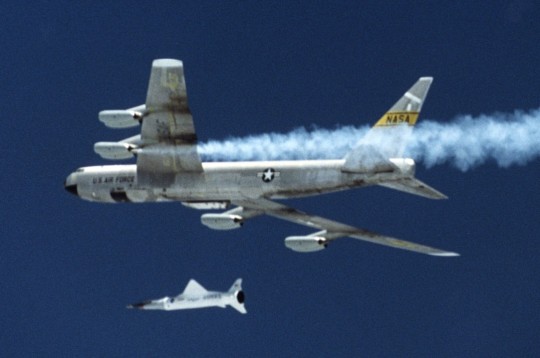
As part of NASA’s Hyper-X program, the X-43 was intended to serve as a demonstrator for air-breathing hypersonic flight. The X-43A vehicles were small wedge-shaped unmanned vehicles just under 4 meters long. It was powered by an experimental scramjet engine placed on the aircraft’s underside, using hydrogen for fuel. Because the scramjet engine required hypersonic speeds to function, the X-43 would be brought to speed by a Pegasus rocket deployed from a B-52. To deal with compression heating, the X-43A circulated water under its skin. The first test of the X-43A came in June 2001, ending in failure after the Pegasus booster spiraled out of control. Fortunately, the second test in 2004 went far better. The X-43A was deployed at 95,000ft, igniting its scramjet engine and reaching a top speed of Mach 6.83, making it the fastest free-flying air breathing aircraft in history. It would break this record by the end of the year, setting a new speed record of Mach 9.6. Both flights ended without recovery of the vehicle, as the mission profile entailed the X-43 crashing into the sea to end the mission.
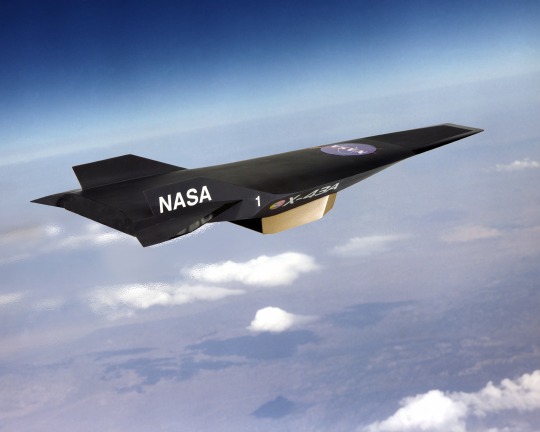
The success of the X-43A led to various proposals for more capable follow-on vehicles. Original plans called for the X-43A to be merely a sub-scale demonstrator for a larger design, known as the X-43B. The X-43B would incorporate a combined-cycle engine, ideally allowing the aircraft to accelerate itself to the required speeds for the scramjet flight to occur. Around the same time as the first successful tests of the X-43 occurred, the X-43C would be cancelled. The X-43C was intended to be a slightly larger X-43A using hydrocarbon-based fuel. However, it was indefinitely suspended after the successful tests of the X-43A. The final X-43 variant, the X-43D, was intended to push the flight envelope to Mach 15. However, it seems that all the planned X-43 variants have been suspended or cancelled. DARPA’s FALCON project and the Air Force’s WaveRider would replace the X-43 program.
Lockheed Martin X-33

The X-33 was intended to serve as a half-scale prototype for Lockheed’s proposed VentureStar reusable launch vehicle. Though the final product of the program was to be a SSTO, the X-33 was merely a suborbital aircraft, intended to reach a top speed of Mach 15 and validate the general design. Powered by two experimental aerospike engines, the X-33 was to have a takeoff weight of 285,000lb of which 210,000lb would be fuel. Plans called for it to take off vertically and land horizontally like the Space Shuttle, but, being an SSTO, no external fuel tanks or boosters would be required. Unfortunately, the X-33 ran into a host of technical difficulties, including stability issues and excess weight, and, in 1999, the failure of the composite liquid hydrogen tanks during a full-scale test led to major cost overruns. Ultimately, funding was cut in 2001, with the prototype 85% assembled and launch facility completed. Meanwhile, a significant drop in the number of commercial satellite launches meant that the VentureStar would no longer be profitable, so Lockheed dropped the project soon after.
Boeing X-53 Active Aeroelastic Wing
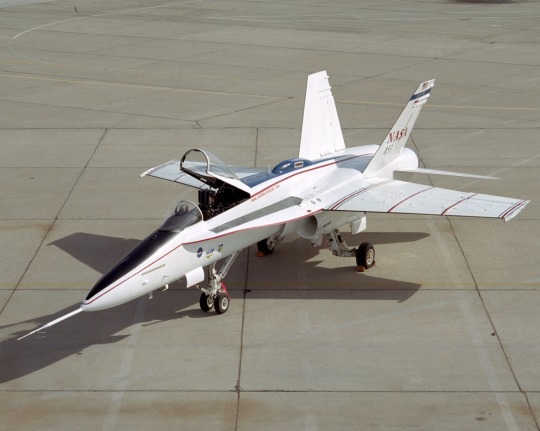
The X-53 was the result of a proposal to use aeroelasticity effects to aid in maneuverability of an aircraft. Normally, the forces on an aircraft’s wings cause deformations that are generally detrimental to performance. However, through skillful deployment of control surfaces, these deformations could theoretically be used to an aircraft’s advantage. Thus, NASA set out to test the theory, contracting Boeing to modify a single F/A-18 as the X-53. Several wing panels were replaced with new thinner sections, and the outboard sections of the wings were completely replaced with a new section with ailerons and slats specially designed to cause controlled aeroelastic deformation. The X-53 would first fly in its modified form in November 2002, but it took until 2004 for the concept to really be tested in full-scale roll maneuvers. The test program was a success, validating the idea that aeroelasticity could be used to an aircraft’s benefit and paving the way for more efficient thin, high aspect ratio wings to be used in future high-performance aircraft.
Joint Unmanned Air Combat Systems
At the end of the 90’s, the USAF and USN began separate programs to develop a stealthy UCAV to meet their needs. The USAF contracted Boeing in 1998, while the Navy was slower to catch on, only starting their own program in 2000. In 2003, the J-UCAS program was started by DARPA to manage these two programs and better develop requirements Fittingly, both companies would receive contracts - Boeing’s X-45 would receive the USAF contract, while the Navy would select the Northrop Grumman X-47A. Though the J-UCAS program was cut short in 2006, the USN and USAF continued the projects alone.
Boeing X-45A
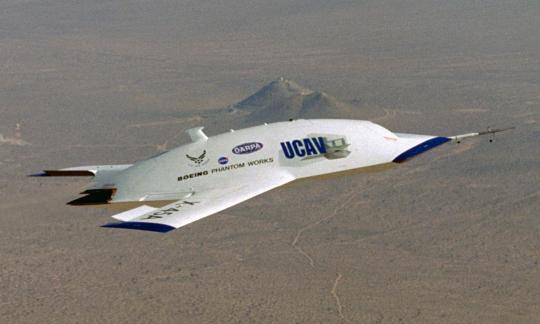
Boeing’s winning design, designated the X-45A, drew heavily on experience gained with the Bird of Prey program. Retaining the general shape of the Bird of Prey, the X-45A removed the cockpit and flattened out the wings. Two internal weapons bays were added, allowing the X-45A to carry two JDAMs or up to eight SDBs. Flight testing of the X-45A began in May 2002. Two prototypes were built, both successfully completing flight tests and weapons trials. Designed with penetrating air defense networks in mind, the X-45A would demonstrate the ability to autonomously determine and execute an optimal attack pattern in a simulated air defense network. During tests, the two prototypes showed the ability to not only operate autonomously, but do so in concert with eachother to optimize mission performance.The test program concluded at the end of 2005, after which both prototypes were sent off to museums.
Northrop Grumman X-47A Pegasus
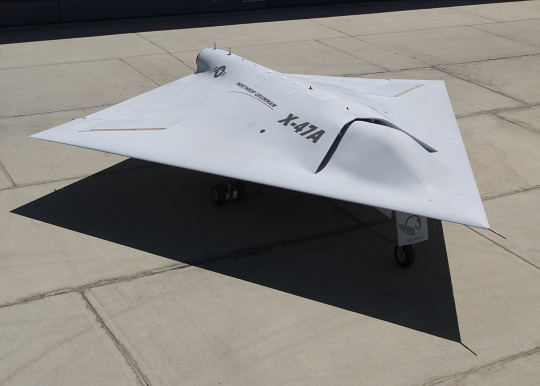
After winning the Navy UCAV contract, Northrop Grumman would build their own UCAV demonstrator - the X-47A. The X-47A was a simple diamond shape with a 55 degree leading edge sweep and 35 degree trailing edge sweep. A single engine powered the machine, buried behind a carefully designed inlet. However, to keep costs low, the exhaust pipe was conventional and unstealthy. Two weapons bays were installed, but no testing of weapons deployment would be conducted. First flying in early 2003, the X-47A was tested by the Navy, who were primarily looking at low-speed handling and precision navigation capabilities. While the X-47A lacked suitable arresting gear for a carrier landing, carrier operations were simulated by having the X-47A navigate to a touchdown point using Shipboard-Relative GPS.
NASA Shaped Sonic Boom Demonstration
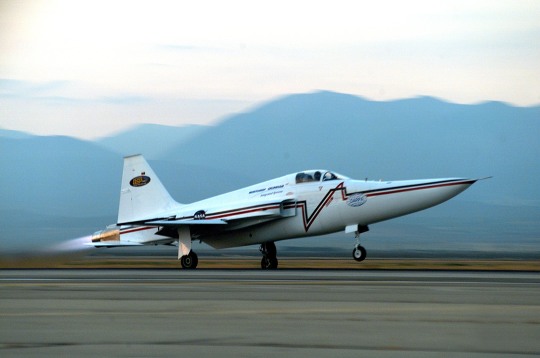
The Shaped Sonic Boom Demonstration would be the result of ongoing NASA efforts to reduce the sound produced when an aircraft goes supersonic. Through careful aerodynamic shaping, the sonic boom reduced by an aircraft can be reduced. To demonstrate this, NASA modified an F-5E was modified with a new nose section. A few baseline flights were flown by an unmodified F-5E to provide initial data against which the new aircraft would be compared, and in August 2003 the SSBD began testing. Data was accumulated by a variety of sensors on the ground, as well as a modified F-15B flying chase and an L-23 flying 10,000ft below the test aircraft. The program was successful, demonstrating that careful shaping could reduce an aircraft’s sonic boom - in this case, by about a third.
Boeing X-50 Dragonfly
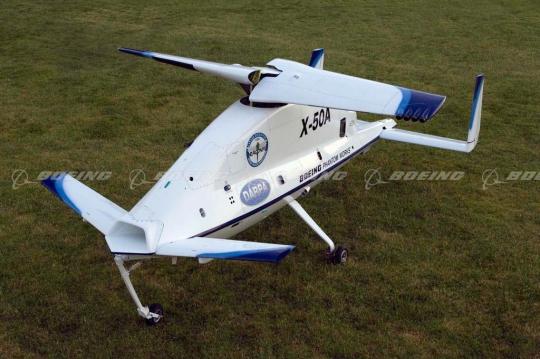
In 1998, Boeing received a DARPA contract to develop their Canard Rotor/Wing concept as the X-50. Splitting costs between DARPA and Boeing, the X-50 would be one of the most unusual aircraft of the X-series. The X-50 was a three-surface aircraft, with small canards and tail surfaces at the front and rear of the aircraft and a comparatively small wing mounted atop the center. Powered by a single turbofan engine, the X-50 was capable of diverting engine exhaust through nozzles in the wing to rotate it. This allowed the X-50 to take off vertically like a helicopter and transition to conventional flight. The unmanned demonstrator would take flight in November 2003, but early on in testing, the prototype would crash due to cross-coupling of controls. A second prototype was built, but it too was lost on its 6th flight in 2006. The cause was found to be the coupling of aerodynamic moments from the forward airspeed and rotor wake creating a pitch-up force that the control surfaces were incapable of compensating for. After the investigation, DARPA decided the design was inherently flawed and withdrew funding for the X-50. In the end, the X-50 program terminated without ever making a successful transition to forward flight.
Boeing X-45B/C

As a follow on to the X-45A, Boeing developed the significantly larger X-45B, which was then enlarged again as the X-45C. The X-45C’s most notable difference from the X-45A was the new wing, which extended the leading edge all the way to the nose to expand wing area. Boeing received funding for three prototypes, the first of which was scheduled to fly in 2006. Test schedules as laid out by Boeing called for the X-45C to demonstrate autonomous aerial refueling by 2010, among other things. However, the Air Force dropped the program when the J-UCAS was terminated in 2006. Boeing tried to salvage the X-45C by pitching a naval variant - the X-45N - to the Navy, but the contract went to Northrop Grumman instead.
NASA/Gulfstream Quiet Spike

NASA’s next reduced-sonic-boom demonstrator would be the Quiet Spike. Working off of an F-15B test aircraft, the Quiet Spike involves a retractable 24ft retractable spike mounted in the F-15B’s nose cone. Capable of retracting to 14ft in its shortest configuration, the Quiet Spike would ideally create three parallel shockwaves that would produce a quieter sonic boom than the F-15B normally would produce. Testing began in August 2006, flying over 50 flights by the time the project ended in January 2007. The program ended in success, demonstrating a sonic boom of only about 70dB - a reduction of over 35dB from the unmodified F-15B.
Piasecki X-49

The X-49 was created as part of a joint Navy/Army program to increase the speed of helicopters to above 200kts. Piasecki would receive a contract to modify a single YSH-60F Seahawk as a demonstrator. Wings were taken from an FJ-100 business jet, and the conventional tail rotor was replaced by a rear-facing ducted fan fitted with control vanes to provide yaw control. The X-49 would first fly in late June 2007, demonstrating that the aircraft was still capable of all the hovering maneuvers of a helicopter. The real significance of the changes, however, was the reduced loading on the airframe. The lift provided by the wings in flight took the load off the main rotor, reducing vibrations and extending range. Over 80 test flights, the X-49 would demonstrate a top speed 50% faster than the original design, along with a doubled operational range, better maneuverability, and significantly reduced stress on the airframe. By the end of the test program, all program goals were met or exceeded.
Boeing X-48

Since the ‘90s, McDonnell Douglas/Boeing Phantom Works has been developing a blended wing-body concept for transport aircraft. Although Boeing at first saw little promise for the concept after they acquired McDonnell Douglas, they would come to accept its feasibility for transport designs. They pitched it to NASA, receiving support for a sub-scale demonstrator designated X-48. Blended wing-body models had been flown as early as 1997, but the originally planned 35ft-span X-48A demonstrator would be cancelled early on, delaying the project for several years. Extensive wind-tunnel testing and design work was done to study and model the X-48’s flight characteristics, particularly at low speeds, so it wouldn’t be until 2007 that the X-48 would finally fly. The X-48 was 400lb demonstrator with a 21 ft wingspan powered by three small turbojets mounted above the trailing edge of the wing. It is intended to serve as a 8.5% scale model of a proposed 240ft-span final design. Testing through 2010 successfully showed the X-48 to have decent low-speed characteristics and be safe in stall conditions. The original 3-engined X-48Bs were followed by a twin-engined X-48C, which tested yaw characteristics with two engines for eight months, concluding in 2013.
Lockheed Martin X-55 Advanced Composite Cargo Aircraft
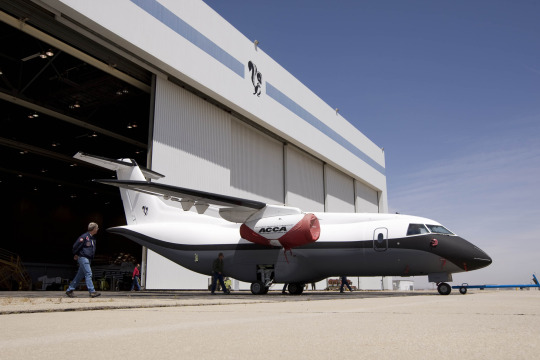
The X-55 is designed as a simple test aircraft intended to demonstrate the viability of the use of advanced composites in the fuselage of a conventional transport aircraft. Developed from a Fairchild Dornier 328JET, the X-55 was a comparatively simple conversion that replaced most of the original aluminum fuselage with a newly designed fuselage constructed using new manufacturing techniques for composites. Fabrication began in April 2008, with the first flight planned for that winter. However, problems encountered during manufacturing caused the schedule to slip, so the X-55 wouldn’t fly until June 2009. Despite the delays, the program was generally a success. The new manufacturing techniques were found to be practical, and costs, particularly for assembly, were dropped dramatically. Compared to the section of the fuselage replaced, the composite structure added had only 300 structural parts rather than 3,000 and only 4,000 fasteners instead of the original 40,000. The success of the X-55 should pave the way for more extensive use of composites in aircraft, especially in an industry traditionally very cautious when it comes to new concepts.
DARPA FALCON

In 2003, the designation X-41 was reserved by DARPA as part of the Force Application and Launch from Continental United States program. The FALCON program aimed to ultimately develop a hypersonic platform for weapons delivery. Initiated in 2003, the program planned to create three demonstrators before the full-scale X-41 would take shape. The first - the Hypersonic Technology Vehicle 1 - was planned to fly in 2007, but was cancelled before it could take shape. Similarly, a larger-scale design designated HVT-3X had taken shape, but it too was cancelled in 2009. Unlike the other FALCON projects, the HVT-3X was intended to take off under its own power conventionally under turbojet power and fly to a cruise altitude where ramjets could take over. Unfortunately, the HVT-3X would not receive funding as part of the 2009 defense budget, so it was cancelled.
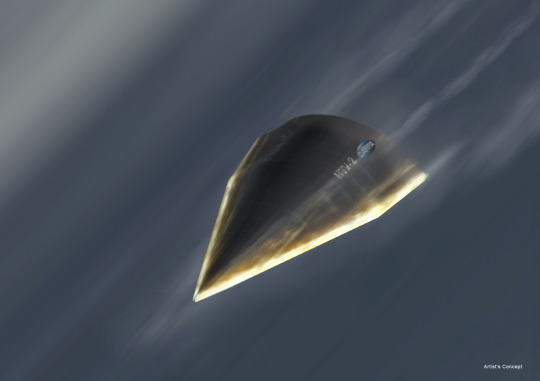
A similar demonstrator, designated HTV-2, was slated to fly in 2010, however. The HTV-2 was a compact triangular lifting body glider designed to fly at Mach 20. The first test flight of the HTV-2 took place in April 2010. Contact was lost with the vehicle 9 minutes into the planned 30 minute mission, and it was determined that the autopilot terminated the mission after the HTV-2 began to violently roll. A second flight occurred in 2011 with similar results. Despite the termination of both HTV-2 flights, DARPA considered the data gathered sufficient enough for the HTV-2 program to terminate. Meanwhile, the FALCON program’s focus shifted away from strategic strike to tactical strikes against heavily defended targets. The HTV-2 program resumed in 2014, but no further flights have occurred. Currently, the FALCON program seems to be proceeding, albeit at a slow pace. Just when a final product will take shape, and if it will even be called the X-41, is unclear.
Boeing X-37
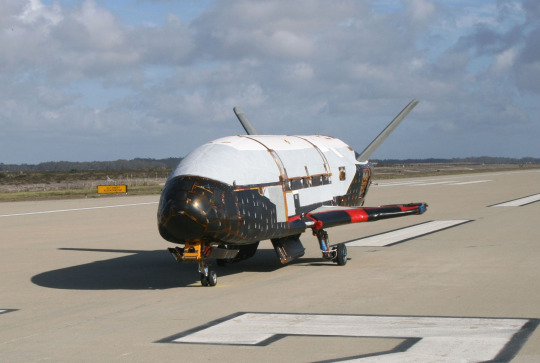
In 1999, NASA contracted Boeing to develop a reusable orbiter with 7,000mph of delta-V for orbital maneuvering. Boeing evaluated a variety of different designs, eventually settling on something similar to an unmanned Space Shuttle. Originally designed to be deployed from the Space Shuttle’s cargo bay, it would instead change to fit atop a Delta IV because the Shuttle flights were deemed uneconomical. In 2004, the program was transferred to DARPA and the X-37 became a classified project. Captive carry tests began in 2005 beneath the Scaled Composites White Knight, and in April 2006, the X-37 was revealed to the public on its first free glide flight. By the end of the year, the project caught the Air Force’s attention, and a program was announced to create the X-37B, aimed at meeting USAF requirements. The X-37B would take the forefront in testing, becoming the orbital demonstrator for the program. Designed to operate in orbit for up to 270 days, the X-37 would be carried atop a Delta II rocket, covered in an aerodynamic shroud for launch.

The X-37B made its maiden flight in April 2010. Unfortunately, details of the X-37 missions are scarce, as the project remains a secret. Other than the fact that it was orbiting about 250 miles up and that it landed entirely autonomously, no information was released about the flight. The second X-37B followed in March 2011, remaining in orbit well beyond the specified 270 days without incident. It landed in June 2012 after 469 days in space, again without any aid from ground operators. Subsequent X-37 missions went even longer - the third mission was launched in October 2012, landing 675 days later, and the last mission, launched in May 2015, is ongoing as of early 2016.
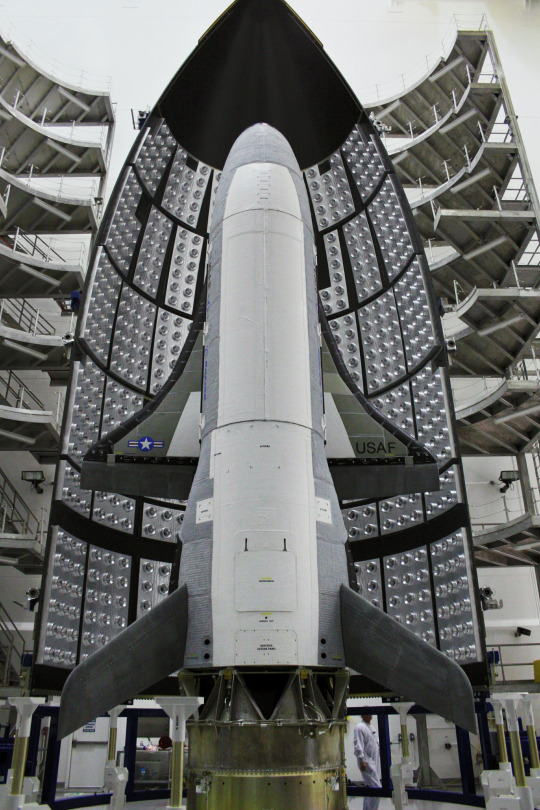
While the X-37B remains mostly secretive, there are some facts that are known. The Air Force states that it’s primarily testing fairly benign technologies, particularly autonomous missions, reusable insulation, and various avionics. It has a 4 by 7 foot payload bay, so it has the ability to deploy other payloads in orbit, but the nature of what’s been carried in the payload bay is unknown. Given the original specifications for a high degree of orbital maneuverability, it’s likely that the X-37B also relied on atmospheric drag to aid in plane-change maneuvers. By descending into the upper atmosphere and maneuvering aerodynamically, the X-37 would be able to perform far more radical maneuvers than the single AR2-3 rocket it carries would otherwise allow. The future of the X-37B is looking good, fortunately. The two orbiters have taken over the old Space Shuttle hangars, and as of 2011, Boeing has been working on a scaled-up X-37C that will be capable of carrying a crew compartment for up to six astronauts into space.
Boeing X-46
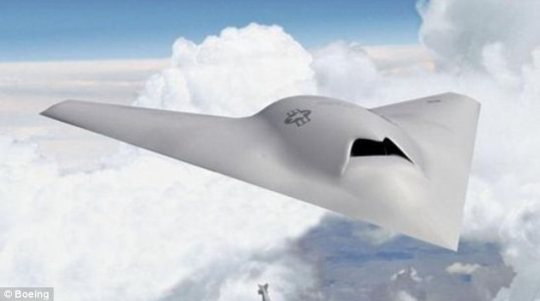
In 2000, Boeing was contracted alongside Northrop Grumman to develop navalized versions of their UCAV designs for the Navy under the UCAV-N program. Given the designation X-46 for their design, the aircraft would diverge from the compact X-45A being developed for the USAF, extending its wing’s leading edge forward to make it more of a flying wing. Unfortunately, the X-46 program terminated in 2003 when the USAF and USN UVAC programs were combined into the J-UCAS program. When the J-UCAS program terminated in 2006, the Navy restarted their UCAV program, and Boeing pitched a proposal heavily based upon the X-46 designated X-45N. Unfortunately, Boeing lost the contract in November 2008 to Northrop Grumman, so the X-46/X-45N would never materialize.
Boeing X-51 WaveRider
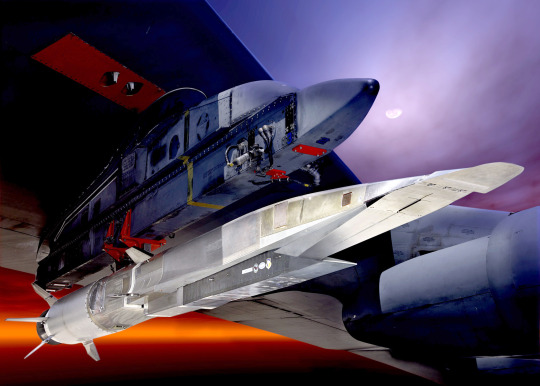
In the ‘90s, Pratt & Whitney had developed a hydrocarbon-fueled scramjet engine (as opposed to the traditionally hydrogen fueled). Originally planned to be mounted on the X-43C, it would be applied to a separate Air Force scramjet project in 2003. After the X-43C was cancelled, the USAF project, now designated X-51, took priority. The X-51 was designed to be propelled by a solid rocket booster to Mach 4.5 to allow the scramjet to deploy, bringing the vehicle to Mach 6. Compared to the X-43 before it, the X-51 is considerably heavier (4,000lb empty compared to 3,000lb loaded) and longer (7.6m to 4m). Ground testing began in 2006, continuing until Mach 5 flight was successfully simulated in 2007. Test flights were scheduled to begin in 2009, but they would be delayed until 2010.
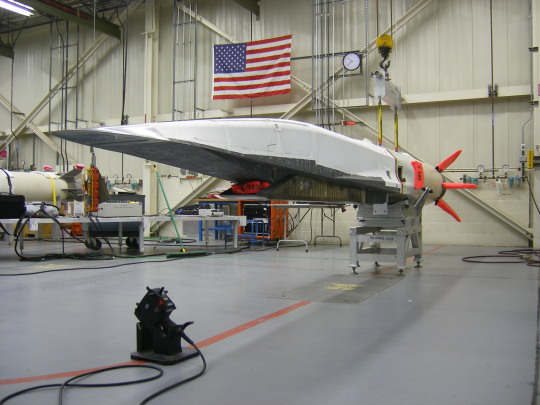
The first test flight took place on May 26, 2010, with the X-51 successfully reaching Mach 5 at 70,000ft. Though it failed to reach the planned 300 second flight duration, it set a record for the longest hypersonic burn time at 140 seconds shattering the X-43’s previous record of 12 seconds. The second test occurred in 2011, but it ended in failure after the scramjet failed to transition from the ethylene used to start it to the JP-7 it would run on. The next flight in 2010 would also end in failure after control was lost over one of the fins, causing the vehicle to crash into the Pacific. The fourth test flight in 2013 would mark the X-51’s first fully successful mission. It accelerated to Mach 5.1 with a 210 second burn time, flying for a total of 370 seconds before crashing into the Pacific. With the end of the fourth test, the X-51 program came to an end. The Air Force plans to use the data collected for research into a future hypersonic platform.
Northrop Grumman X-47B
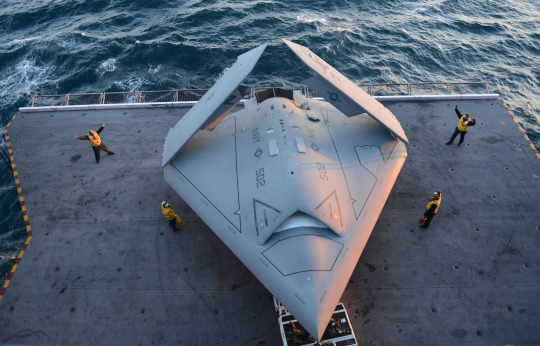
Although the J-UCAS was terminated in 2006, the Navy chose to continue UCAV development. Boeing and Northrop Grumman would re-submit proposals for the new UCAV program, and in 2006 Northrop Grumman’s X-47B was selected as the winner. The X-47B generally preserved the lines of the X-47A, but it made use of a stealthier engine outlet and had outer wing sections extending beyond the diamond shaped fuselage. The X-47B was significantly larger than the X-47A (20 ton max takeoff weight as opposed to 2.6 tons), and it featured folding wings, carrier arrestor gear, strengthened landing gear, and internal bays for up to two tons of ordnance. The first of two prototypes was rolled out in 2008, but the scheduled first flight was delayed until late 2011.
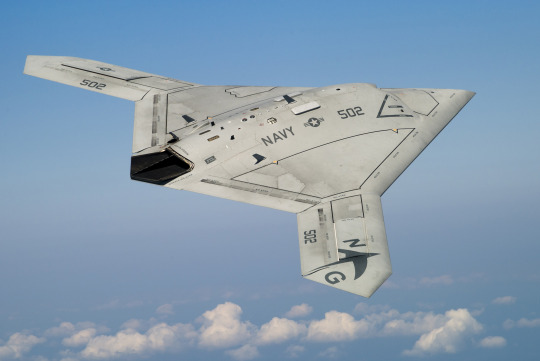
Testing of the X-47B would go smoothly. Airworthiness tests were ended early due to excellent flying qualities, and in mid 2012, preliminary testing for carrier suitability began on land. In late 2012, the first land-based catapult launch occurred. Deck testing found the X-47B to be excellently suited to operations on a carrier, and in May 2013, the X-47B made the first ever catapult launch from a carrier. That July, the first ever landing of a UAV on a carrier at sea occurred. In April 2015, the X-47B again made history when it made the first ever fully autonomous aerial refueling. By the time the X-47B program terminated in mid-2015, the aircraft had blown through all evaluations, even the difficult carrier trials. Though the design has proven incredibly solid, the decision was made to run another design competition for a production UCAV to enter service.
Lockheed Martin X-56
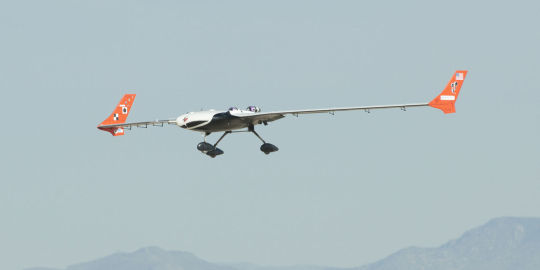
Commissioned in 2005, the X-56 is a UAV testbed intended to study various anti-flutter techniques. Building on Lockheed’s previous experience with UAVs, the X-56 is a flying wing design powered by two small turbojets with a combined output of less than 200lb of thrust and fixed, spatted landing gear. The centerpiece of the X-56 design is the active anti-flutter system, designed to counter flutter effects and allow for lighter structures than would normally be possible. However, as Lockheed had validated the anti-flutter system in several expendable small-scale demonstrators earlier, the X-56 has also been designed with modularity in mind, leaving space for a variety of other test equipment. The X-56 would make its maiden flight in July 2013, flying 20 flights before being handed over to NASA. Unfortunately, the first prototype was severely damaged in a crash during its first demonstration of the active anti-flutter system. The test program is ongoing as of early 2016, but no further anti-flutter tests have occurred since the crash in November 2015.
Gulfstream X-54
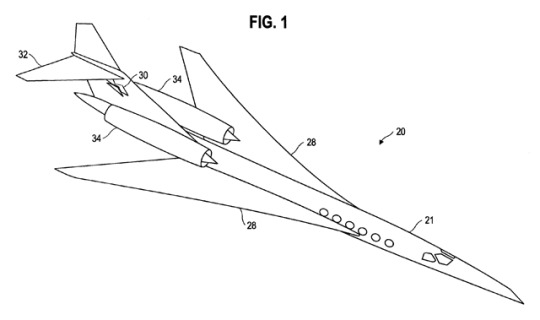
In 2008, Gulfstream was given the X-54 designation for a future quiet supersonic aircraft. If the program goes as planned, the X-54 would make use of carefully designed shaping to reduce the sound generated by sonic booms to hopefully cause a shift in FAA regulations prohibiting supersonic flight over the continental US. Continuing on DARPA’s Quiet Supersonic Aircraft program, the X-54 will build upon the technologies demonstrated with the Quietspike, Shaped Sonic Boom Demonstrator, FaINT, and WSPR projects. Goals for the X-54 program involve the development of a viable supersonic transport capable of cruising at Mach 1.4 at 50,000ft while producing under 75 pdB on the ground. The Rolls Royce Tay has been selected as the powerplant for the X-54, and Gulfstream has released some preliminary drawings of their proposed design. However, it seems the program is progressing slowly due to the fact that regulations have yet to change - Gulfstream is reluctant to produce an SST unless supersonic flight over the continental US is allowed, opening up the market enough to make development economically feasible.
4 notes
·
View notes
Text
/k/ Planes Episode 91: 2spoopy
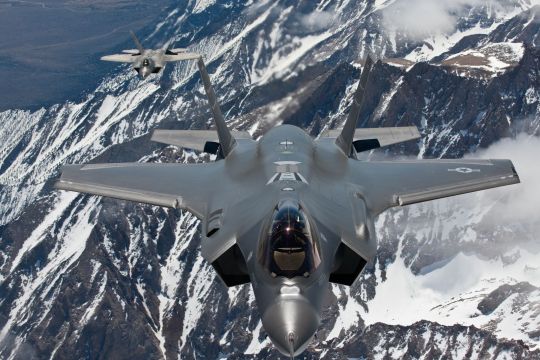
It’s time for another episode of /k/ Planes! This time, we’re looking at stealth aircraft.
By the mid 1970s, advances in ground-based air defenses were reaching the point where they could make air operations unsustainable. Recognizing this, the US would begin looking into the development of a more survivable aircraft,. Focusing on reducing visibility to radar, engineers made use of Soviet-developed mathematical models for electromagnetic reflection to develop a stealth aircraft. As America secretly took the forefront on stealth development, the rest of the world lagged. Germany would independently begin their own program, and by the 80’s France and Britain were developing stealthy designs, but only America would get a stealth platform into operational service. As the new millennium came, stealth had finally come to the forefront of aircraft development. Thanks to advances in computational analysis, stealth aircraft can be reasonably aerodynamic. As such, just about every recent military aircraft project, both manned and unmanned, incorporates stealthy features to some degree.
McDonnell Douglas Model 226 Quiet Attack Aircraft
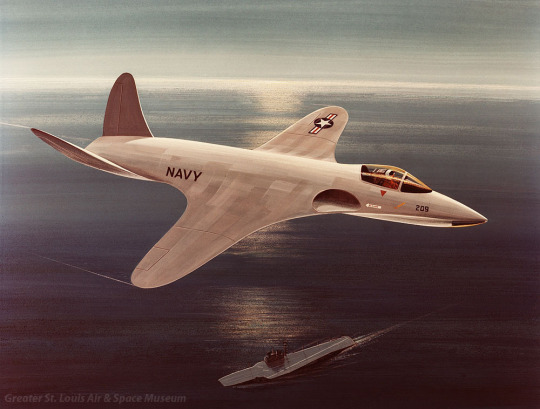
In 1973, the US Navy would launch the Quiet Attack Aircraft program, aimed at developing a stealthy aircraft that would minimize detection chances by both radars and human observers. McDonnell Douglas would lead the effort, being perfectly suited to the job thanks to their ownership of the test ranges at Grey Butte Microwave Measurement Facility. Over the course of the study, they would publish a document detailing the necessary RCS to defeat enemy radars, and, through time-consuming trial-and-error with clay on models, they would develop a preliminary design. The Model 226, as it was designated, made use of constantly curving surfaces to minimize the area directly reflecting incoming radar signals. RAM was to be added as well to reduce returns. One of the more notable features would be the lights mounted around the aircraft to mimic ambient lighting, thereby making the aircraft harder to see. IR signatures were also reduced through the use of a specially designed exhaust nozzle. While the design was projected to significantly reduce detection chances, its radar-stealth capabilities were flawed by the fact that the design worked to minimize area reflecting directly back to the enemy rather than reflect all incoming signals in different directions. Just how effective the Mode 226’s features would have been is unclear - the Navy would not pursue the design any further.
DARPA Experimental Survivable Testbed (XST)
In the aftermath of the Yom Kippur War, analyses of IAF loss rates discovered that a similar air defenses would deplete NATO aircraft in two weeks in a war with the Warsaw Pact. In 1974, DARPA sent out requests to five manufacturers to develop a solution to this. DARPA requested an analysis of the characteristics necessary for a stealth platform and the practicality of designing and manufacturing such an aircraft. Fairchild, Grumman, and General Dynamics declined to participate, leaving only McDonnell Douglas and Northrop to develop solutions. Though Lockheed was not approached by DARPA, they would catch wind of the program and successfully lobby to be included. In the end, this lobbying effort would pay off. Not only did Lockheed end up being one of the two finalist selected (along with Northrop), but their design would end up being the winning proposal.
Lockheed Hopeless Diamond
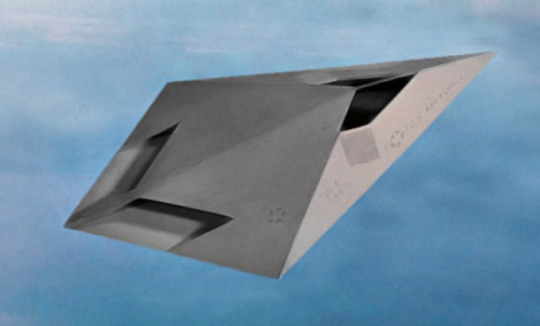
Although the equations for calculating radar cross section were widely known, analytically determining the signature for an arbitrary shape was a difficult concept. Given the relatively low power of computers at the time, Lockheed’s engineers would have to simplify things by creating a design of flat panels. By simplifying things, they were able to create RCS-predicting software, which they called ECHO 1. 20 preliminary designs were developed by Lockheed’s engineers which were then put into the ECHO 1 program for further analysis. The winning design was a clean diamond-shaped aircraft, lacking a vertical tail and venting its engine exhaust on the upper side of the aircraft. Though the ECHO 1 program showed it was optimal, many of Lockheed’s engineers were skeptical, including the famous Kelly Johnson, ultimately earning it the nickname “Hopeless Diamond.” Despite the skepticism, Lockheed employees would find that ECHO 1’s predictions were accurate when they tested a scale model of the design. Though it would go through several refinements before being submitted to DARPA, the Hopeless Diamond would form the basis of the Lockheed XST proposal.
Lockheed XST

With their preliminary design validated, Lockheed’s engineers could go about refining the design. More panels were added to the design, raising the cockpit and intakes and thinning out the wings to improve aerodynamic performance. The bottom of the aircraft was flattened, and a specially designed radar-blocking grill was placed over the engine inlets. The wing planform was revised as well, morphing from a compact diamond to a delta wing with a serrated trailing edge. Vertical tail surfaces - nonexistent on the Hopeless Diamond - were added, placed just outboard of the exhaust and canted inwards both to reduce their effect on the RCS and hide the heat signature of the engines. Owing to the aircraft’s highly swept wing and low aspect ratio, handling characteristics were expected to be terrible, particularly with roll control. To alleviate this, the center of gravity was shifted backwards to make the design unstable, and plans were made for fly-by-wire controls to compensate in a flyable version.
McDonnell Douglas Model 268
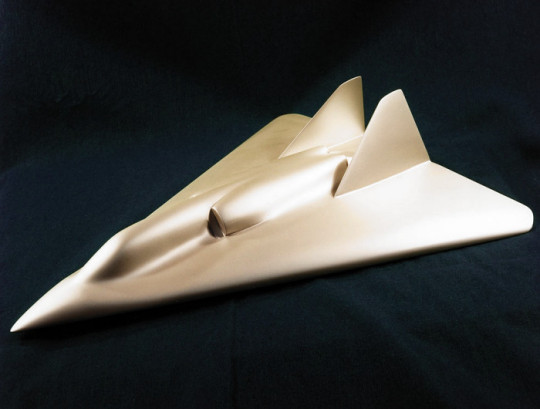
McDonnell Douglas would draw on their experience with the Navy’s Quiet Attack Aircraft program from 1973 for their XST proposal. While the prior experience helped, McDonnell Douglas was unable to reuse their design from the QAA, instead developing an entirely new aircraft. The resulting Model 268 had a large highly-swept delta wing, upon which the rest of the aircraft was placed. Engines were placed on top of the aircraft in the middle of the wing, using conventional exhausts but shielding them with the aft section of the aircraft and the inward-canted vertical stabilizers. The Model 268 would not be the final submission, but it would form the basis for the final product.
McDonnell Douglas/Teledyne Ryan XST

Around the same time as the XST was going on, Teledyne Ryan was working on a similar project for a stealth UAV. After their design was dropped by the USAF for being considered impractical, they would take their talents to McDonnell Douglas, forming a consortium for the XST. The Model 268 was refined, slimming down the fuselage and reducing the sweep of the wings. The engines were somewhat hidden, and the intakes and exhausts were flattened out. Of major note was the smoother appearance of the McDonnell Douglas proposal to the other competitors - it seems that McDonnell Douglas did not rely on any special RCS-modeling software, unlike the other contenders, meaning that they did not have to simplify the design for computer analysis. Unfortunately, a cleaner appearance would do little to win the consortium favor. McDonnell Douglas would be dropped from the competition after their proposal was compared to the Northrop and Lockheed designs. Teledyne Ryan would go on to patent the final design in 1977.
Northrop XST
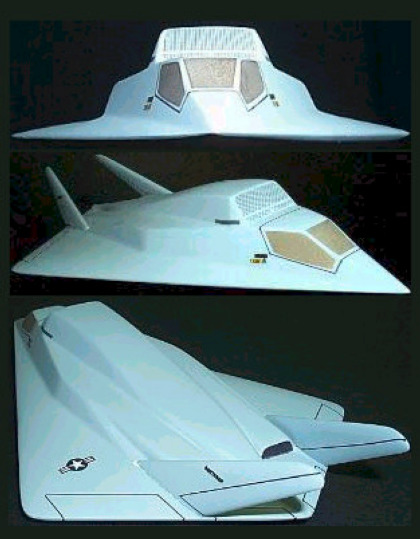
Northrop, having worked on RCS-reduction programs since 1966, they had considerable experience with RCS analysis. In 1970, they had produced an RCS analysis program that was publicly available, and when the XST program started, they went to work updating it for their new design. The new program allowed more precise modeling and analysis than the Lockheed ECHO 1, albeit at the cost of setup time. Preliminary tests for the program on an F-4C took three weeks of data gathering and another week to enter data. With a more effective program, Northrop went about trying to develop a design adapted to a wider range of wavelengths than specified. The resulting design shared much in common with the Lockheed Hopeless Diamond, using an rhomboid wing with the fuselage placed on top. The pilot sat in the extreme nose under a two-piece canopy, and the intake for the engines was placed above and behind the cockpit. Two vertical stabilizers were placed on either side of the exhaust, but they remained upright.

Unfortunately, this layout had several unsatisfactory characteristics. The large superstructure on the front of the aircraft disturbed airflow over the tail, reducing its effectiveness. Even if aerodynamics were to be ignored, the vertical tails were highly radar reflective. At the end of 1975, the Northrop design was submitted alongside Lockheed’s, and models of both were built for practical testing. It was here that tests would show that Northrop’s effort to widen the spectrum to which it was stealthy did not pay off. Tests were performed with the radar from a ZSU-23-2, testing the frontal arc of the designs at an unspecified distance. Tests found Lockheed’s XST had a lower RCS for J-band radars, which was the primary focus of the XST program, as well as lower returns for the lower frequencies the radar could track at. The Northrop XST did have a significant advantage at lower frequencies (A-band, VHF), but these bands were considered to be of dubious use for tracking targets. Though both designs offered RCS reductions on the order of 1,000 times less than conventional aircraft, DARPA gave the contract for two prototypes to Lockheed, owing to the greater experience of Skunkworks at building and testing top-secret aircraft.
Lockheed HAVE BLUE
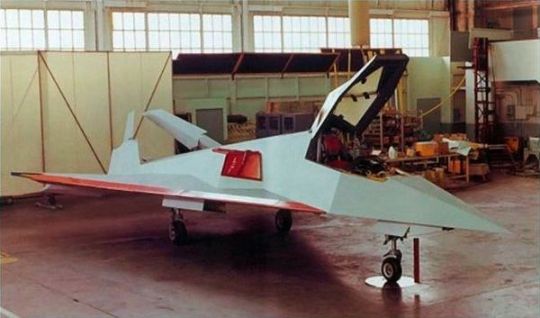
As Lockheed went to work on their flying XST prototypes, the significance of the program was finally noticed by the higher-ups. Recognizing the impact of such stealth programs, the program was immediately classified under the codename HAVE BLUE and funding was increased. The two HAVE BLUE prototypes were compact aircraft, each fitted with two J85 turbojets salvaged from T-2B trainers. To keep costs down, the fly-by-wire system was modified from F-16s, while the ejection seats, landing gear, and cockpit instrumentation were salvaged from F-5s. No provisions for armament were installed, and small fuel tanks would limit endurance to just an hour. The first of two prototypes - intended for static aerodynamic tests - was completed at the end of 1977 at the plant in California and airlifted to Nevada for testing. There, it was given a special camouflage scheme intended to confuse any observers. Under extreme security, the first HAVE BLUE prototype took flight on December 1, 1977.

Surprisingly, despite all the pessimism over the HAVE BLUE’s projected handling, the aircraft handled fine, with most issued corrected with minor tweaks to the FBW controls. Unfortunately, the FBW couldn’t fix everything. Very high landing speeds were endemic to the design, ultimately leading to a hard touch-and-go landing that jammed the aircraft’s landing gear and forced the pilot to eject. The crashed prototype was hastily buried under the desert rather than recovered. The second HAVE BLUE prototype would fly in July 1978, flying with a RAM skin that was not present on the first prototype. Tests found that the HAVE BLUE was tremendously effective against radars. While not invisible, it reduced detection ranges significantly, so much so that many Soviet radar systems would have no time to react. Though the second HAVE BLUE was lost as well after a hydraulic leak set the aircraft ablaze during a flight in July 1979, the program was a success. Lockheed had already gained approval for a full-scale design, and no further testing of the HAVE BLUE was necessary.
Lockheed F-117 Nighthawk
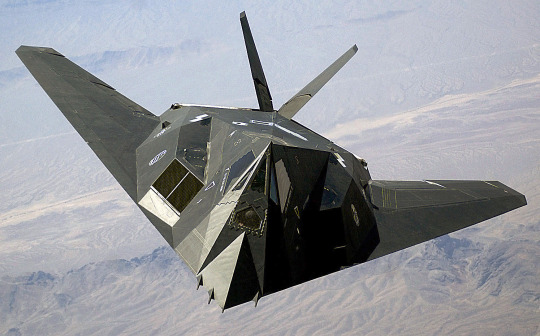
With the first HAVE BLUE prototype validating Lockheed’s design, Lockheed would suggest two proposals for a militarized variant - a two-seat, four-engined bomber and a twin-engined single-seat strike fighter. The USAF would prefer the smaller design, contracting Lockheed for development in late 1978 under the codename SENIOR TREND. SENIOR TREND would entail a general enlargement of the HAVE BLUE, although minor refinements were also made. To alleviate the poor aerodynamic performance of the HAVE BLUE, SENIOR TREND’s wing sweep was reduced from 72.5 degrees to 67.5. HAVE BLUE testing had also found the inward-canted tailfins of the HAVE BLUE to be detrimental as they reflected heat back down. To fix this, the tail surfaces were moved in between the engine outlets and canted outwards. Operational equipment included expanded fuel tanks, aerial refueling equipment, and an internal bay for two 2,000lb LGBs. Because of the stealth focus, sensors were primarily passive - FLIR was used for targeting, and inertial navigation systems were used to minimize electromagnetic emissions.
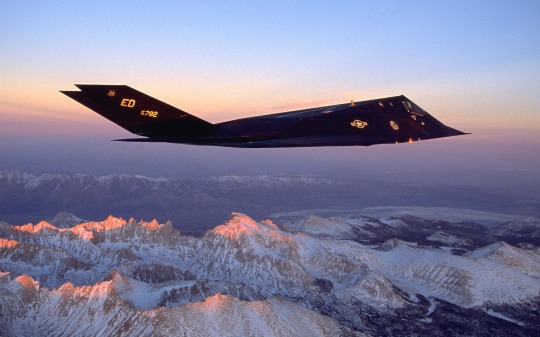
In December 1979, Lockheed received a contract for five SENIOR TREND prototypes and a further 15 production aircraft under the designation F-117. Production was delayed by teething issues, but in the spring of 1981 the F-117 had flown. Teething problems would extend testing, but the USAF was eager to get the Nighthawk into service. A conversion group had already been established in 1979, flying A-7Ds as cover while their real aircraft remained a secret. A base was established for the group in the Nevada Desert, and, once deliveries of aircraft began in 1981, conversion training began. However, to maintain secrecy, flights were limited to night operations. Meanwhile, the Air Force order had expanded. Plans to equip just a single 18-plane squadron were changed to call for a whole wing of Nighthawks, resulting in a total production run of 59 aircraft.
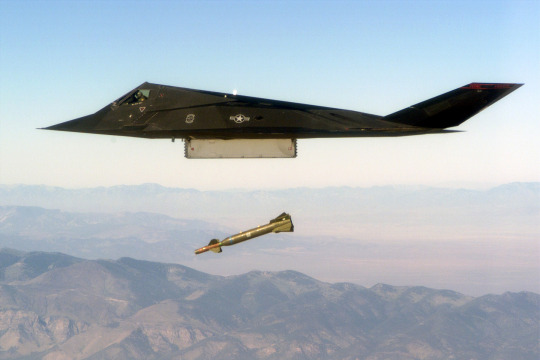
For all the enthusiasm about the F-117, the USAF was reluctant to commit it to operations. It was considered for strikes in Lebanon in 1983 and the El Dorado Canyon raids in 1986, but in both cases conventional aircraft were used instead. At the end of 1988, after struggling for over a decade to conceal the existence of the program, did the USAF finally admit to the F-117’s existence, and it would only be displayed to the public in 1990 - a year after it made its combat debut over Panama. While Operation Just Cause marked the Nighthawk’s debut, the real test would come a year later.

The Nighthawk would get its first real combat test in 1991 when Iraq invaded Kuwait. In the early morning hours of January 15, 1991, a formation of F-117s appeared undetected over Baghdad. After surprising the Iraqis with attacks on various communications centers, the nearly 4,000 AA guns defending the city opened up. Over the course of the night, three waves of Nighthawks hit Baghdad. Though the skies were ablaze with gunfire, the strike aircraft were untouched, remaining invisible to Iraqi radars. Over the course of the war, they continued to fly strikes against some of the most high-value targets in Iraq. By the time the war ended, the 40 F-117s deployed had flown 1,270 sorties, dropping 30% of the guided bombs deployed in the war.

Postwar, the F-117 continued to fly over Iraq in support of the No-Fly Zones. In addition to using LGBs, they were fitted with HARMs, working with F-16s acting as bait to destroy Iraqi radars. In 1997, all f-117s were grounded following a crash, but in 1999 they returned to service to participate in the NATO intervention in Serbia. Unfortunately, this deployment would result in the only combat loss of an F-117. After flying multiple missions on the same predictable path, one Serbian SAM crew picked up on the consistency. Unprotected by ECM, the Serbs were able to track an F-117 by modifying their radars, allowing them to fire an SA-3 and down the aircraft. Though the incident was significant, it was deemed to be more the result of excellent work on the part of the Serbs coupled with poor operational planning. Despite the shootdown, Lockheed continued to upgrade the surviving fleet to keep it competitive. A new wave of modernization expanded the F-117’s catalog of weapons, improved navigation systems, and added newly developed RAM to reduce maintenance and keep RCS low. Though plans originally called for the F-117 to stay in service until 2018, the arrival of the F-22 changed that. The F-22 could do everything the F-117 could and more, and, with the Nighthawks being so expensive to fly for such a niche role, they were finally put of for retirement. In 2008, the last F-117 was retired, with the fleet mothballed to allow them to return to service if the need arises.
Northrop TACIT BLUE
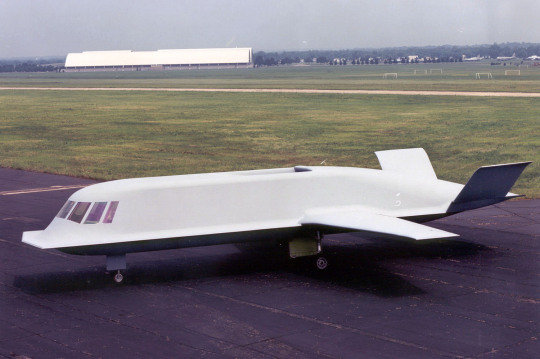
Although Northrop’s XST proposal had been rejected by DARPA, the concept of all-aspect stealth generated much interest. Thus, in December 1976, DARPA contracted Northrop to develop a stealthy surveillance platform for the newly-created Battlefield Surveillance Aircraft - Experimental (BSAX) program. Given the aircraft’s expected role requiring long loiters over a battlefield, stealth from every angle was of the utmost importance. Northrop's engineers would refine their radar analytical software to allow for curvilinear analysis, resulting in a much smoother appearance. However, the TACIT BLUE was by no means a graceful design. A large, boxy fuselage was used to provide space for side-looking radars, and the aircraft’s two engines were buried in the rear of the fuselage, fed by a dorsal intake. Flight testing began in February 1982. 135 flights for a total of 250 flight-hours were flown, with the test program ending in 1985. Unfortunately, by then the USAF had shifted its focus. In 1984, the Army and Air Force had decided to develop a non-stealthy surveillance platform instead. The TACIT BLUE was dropped, and in its place the E-8 Joint Stars - derived from the Boeing 707 - was created.
Messerschmitt-Bolkow-Blohm Lampyridae

In the early 1980s, the West German Luftwaffe commissioned MBB to develop an experimental stealth fighter. Despite starting efforts almost a decade after the American stealth program, MBB would produce a far more simple design. Although computers at the time could handle complex calculations, concerns over maintenance for an aircraft expected to serve for at least 30 years encouraged a simple, easy to maintain design with little use of RAM. Additionally, a simple design would reduce development time and costs that would otherwise be spent on RCS-calculating software. The result was a very simple design consisting of large, flat panels with surprisingly little ERA. Compared to the Lockheed HAVE BLUE, it had just half the number of faceted surfaces. However, a more conventional arrangement was used, with a distinct fuselage carrying the single engine and pilot, and a single vertical stabilizer rather than two canted surfaces.
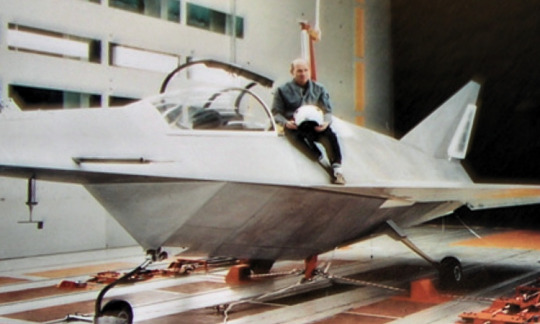
Sub-scale wind tunnel testing began in 1985, confirming MBB’s projections of surprisingly good maneuverability. With aerodynamic testing complete, MBB built two larger mockups, one almost full-scale (12 meters long compared to the planned 16 meter full-size design) and the final being full-scale. These models performed more tests, both testing the design’s RCS and aerodynamic performance. Takeoff and landing conditions were simulated in tests, as was flight in angles of attack up to 27 degrees. In 1987, MBB presented the design to a group of American engineers. The program came as a shock to America, who had no idea the Germans were working on such projects. Unfortunately, this seemed to spell the end for the Lampyridae. Exact reasons for the design’s cancellation remain unclear, and the official reason cited high program costs. However, it is speculated that American pressure played a part in the cancellation of the program.
Dornier LA-2000

In the mid-80s, Dornier had begun their own stealth aircraft program. The LA-2000, as it was apparently designated, was a simple tailless triangular aircraft. Two turbofan engines were placed on the underside of the aircraft in a special nacelle to reduce their RCS (complete with a radar-blocking inlet) and provide two-dimensional thrust vectoring. Payload was to be carried internally in a 6 cubic meter bay. Details of the project are hard to come by, with the most significant mention of it being a captioned illustration in Flight International Magazine in 1986. The fate of the project is unknown, but it’s probably safe to say it was cancelled.
DASA FTT/TDEFS
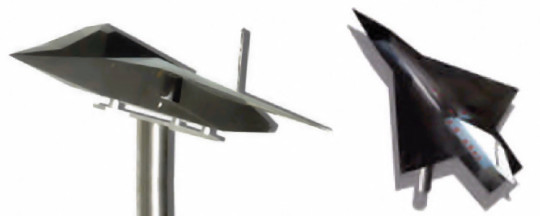
Although the Lampyridae had come to an end, DASA - the successor to MBB - would continue studies for a stealth fighter. Long-term goals included refining technologies developed for the Lampyridae as well as fly-by-wire controls, thrust vectoring, and modular avionics to create a modern manned stealth combat aircraft. To give the program a better chance of success, DASA looked for international partners. Unfortunately, the project would never come to fruition. DASA did get as far as wind tunnel models for the proposed final design, which resembled a larger twin-engined Lampyridae with cleaner lines, but funding rapidly dried up. With defense budgets slashing at the end of the Cold War, there was little money to give to the program, and all potential partners were more concerned with getting the Eurofighter/Rafale/Gripen into service than starting on an entirely new project. Further hurting chances of success was the stealth aspect - advances in stealth development had since made the faceted Lampyridae-derived stealth features obsolete.
Advanced Technology Bomber
Although the Pentagon had put preference on a scaled-up version of the HAVE BLUE demonstrator, the larger bomber variant also interested them. Lockheed and Northrop were both contracted to develop stealth bomber designs in 1978, with proposals to be submitted by August of the next year. The two proposals - the Lockheed SENIOR PEG and Northrop SENIOR ICE - followed roughly similar designs. SENIOR PEG would be a tailed flying wing with a passing resemblance to the F-117, while SENIOR ICE was a full flying wing with much cleaner lines. Initially, Northrop participation was seen only as a fallback in case SENIOR PEG was a catastrophic failure. However, Northrop’s design would prove to be better suited to the ever-evolving Air Force requirements. Originally calling for a high-altitude penetration bomber, requirements formally issued in 1980 would call for exceptional low-altitude capabilities as well. Additionally, total payload and loaded weights had rose, putting the program in Northrop’s favor. Ultimately, Northrop would win the ATB contract in 1981.
Lockheed SENIOR PEG
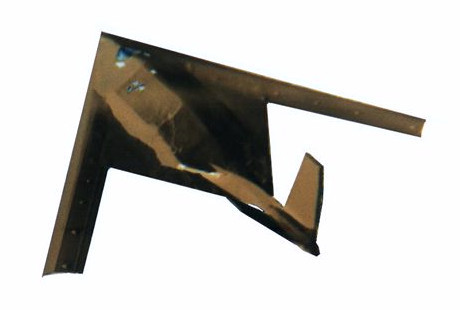
As originally designed, SENIOR PEG would roughly resemble a scaled-up HAVE BLUE. SENIOR PEG would have a diamond-shaped fuselage with wings extending out past its edges and a V-tail extending backwards on a boom. Critical elements of the HAVE BLUE design - including the engine inlet grates and heavily faceted design - would be carried over to SENIOR PEG. With computer analysis of radar cross sections improving since the development of the HAVE BLUE, Lockheed could improve upon their design, making limited use of curved sections on the SENIOR PEG. However, the limited use of curved sections could not compete with Northrop’s far more advanced design, and thus, in 1981, Northrop’s design was selected for development as the B-2.
Northrop B-2 Spirit
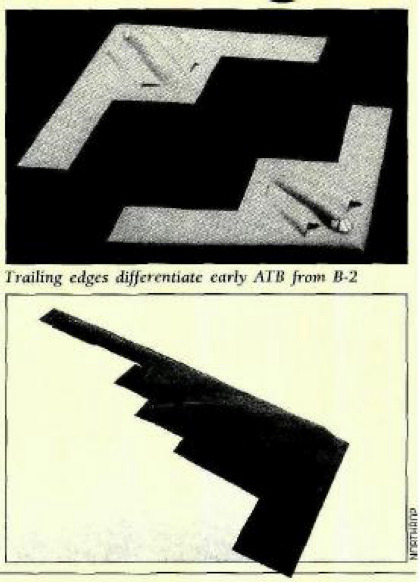
Northrop’s SENIOR ICE would be a pure flying wing design from the start. Such a design allowed for the elimination of vertical surfaces improving stealth. As originally designed around the high-altitude mission, SENIOR ICE used a diamond-shaped center section with long, high-aspect ratio wings extending outwards from it. The decision to add low-altitude capabilities briefly forced Northrop to re-evaluate their design. The large wings of the SENIOR ICE would lead to high gust loading at low altitudes and a bumpy ride, so Northrop looked into configurations with a higher sweep and lower aspect ratio. However, these configurations reduced range and affected directional stability enough to require the addition of vertical fins. Worse, it hampered takeoff performance to the point that SENIOR ICE would have to incorporate afterburning engines purely to meet takeoff requirements. Thus, Northrop reverted to the original design, making a superficially minor change to compensate instead. The trailing edge of the center section was modified heavily, giving it a W-shaped cutout to change the aerodynamic loading and smooth the ride. This was accompanied by a structural change as well, allowing SENIOR TREND to meet the USAF requirements perfectly.
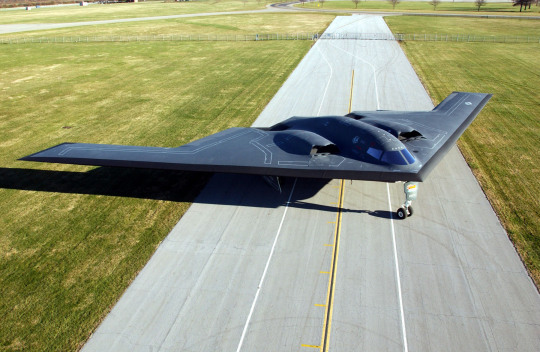
The design that would win the ATB contract in 1981 would come to be known as the B-2. Taking flight for the first time in mid 1989, the B-2 was a large smoothly contoured flying wing. The four F118 engines are paired together on nacelles on either side of the cockpit, with RAM-lined S-curve intakes and exhausts carefully designed to reduce IR signatures. A rear-facing LIDAR system would be installed as well to detect contrails and alert the pilot, allowing them to adjust altitude to compensate. Two side-by-side bays were designed to accommodate up to 50,000lb of munitions, and bomb bay doors were specially designed to reduce their RCS impact. Rotary launchers allow the bomber to carry up to 16 1,000kg-class munitions, including the B61 nuclear bomb, while the bomb bay also has space for up to eighty 500lb conventional bombs. Thanks to extensive automation, the B-2 has a crew of just two men. Navigational systems were originally an “astro-inertial” system, combining stellar navigation with a standard INS for greater accuracy. It also possesses the AN/APQ-181 radar for navigation and attack, and an extensive (but very secret) countermeasures suite was installed to protect the aircraft.
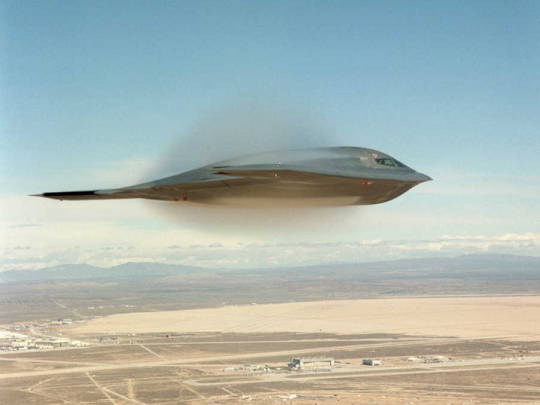
Originally, the USAF had planned to procure 132 B-2s to form the backbone of the strategic bomber force. However, even before the end of the Cold War, escalating costs due to delays and the design’s highly advanced nature made it controversial. With the order slashed to just 20 aircraft, it would become even moreso. Without a long production run to spread costs over, the flyaway cost ballooned to nearly a billion dollars. Although 10 of the 20 B-2s would be delivered by 1995, they were only Block 10 machines, lacking most of the capabilities the bomber was advertised with. Only in 1997, with the delivery of the last 10 aircraft as Block 20 machines, did the B-2 fleet finally reach IOC. The entire fleet was rapidly brought up to the Block 20 standard, which was soon followed by the Block 30 upgrade, including avionics improvements, a satellite link, support for the latest guided weapons, and substantial improvements to the stealth features.
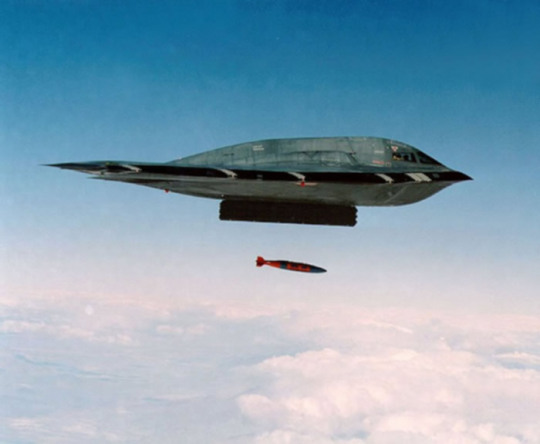
The B-2 would finally make its combat debut in 199, taking part in the opening phases of Operation Allied Force. Over the course of the campaign, the B-2 would fly several strikes against heavily-defended targets, dropping JDAMs with impunity. In 2001, they were called into action again, this time over Afghanistan. One mission, lasting 44 hours, took bombers from Whiteman AFB in Missouri to Afghanistan to Diego Garcia, where the aircraft refueled and rearmed before performing the same trip in reverse. Four B-2s would see action over Iraq two years later. Despite its incredible capabilities, however, the B-2 has been an expensive aircraft to fly. The RAM on the aircraft’s skin is sensitive to weather, requiring special storage conditions, and, until the post-Block 30 upgrades maintenance-per-flight-hour has amounted to 20.8 hours. The newest upgrades have significantly reduced maintenance, lowering it to 9.2 hours-per-flight-hour. The latest round of upgrades has also added AESA radars, as well as the capability to deploy the SDB II and Massive Ordnance Penetrator. Currently, there are no plans to replace the B-2 anytime soon. It’s scheduled to fly until at least 2040, although the fairly docile flight profiles of the bomber mean it likely will be able to fly long past that date.
Advanced Tactical Fighter
Not long after the F-15 first flew, the USAF was already starting work on a replacement. Studies for requirements for a next-generation fighter took place all through the ‘70s on low priority, picking up pace when spy satellites discovered the MiG-29 and Su-27 in 1979. In 1981, a request for information was sent out to nine manufacturers, requesting design studies making use of stealth, supercruise, and short-takeoff characteristics. The next year, a more formal RFI was sent out, with Boeing, General Dynamics, Lockheed, McDonnell Douglas, Northrop, and Rockwell receiving contracts to study new designs. By 1983, the ATF program had officially started. Finalized requirements called for a max takeoff weight of 50,000lb, combat radius of 800 miles, Mach 1.4 supercruise, and the ability to operate from runways as short as 2,000ft. In parallel, Pratt & Whitney and General Electric were contracted to develop an engine. Although the program began in the early ‘80s, development and final selection would drag the program into the end of the millennium. It took until the end of the decade to narrow down proposals to two designs (YF-22 and YF-23), and only in 1991 was the winner finally announced.
Rockwell Concept 6
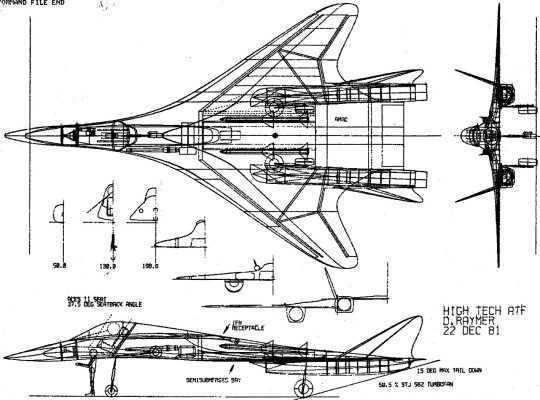
Rockwell’s most promising ATF proposal would be known only as Concept 6. Concept 6 made use of a large, flat body with widely-spaced engines and fairly conventional swept wings. Lacking a conventional horizontal tail, Concept 6 instead placed moving surfaces on the trailing edge of the fuselage tunnel. Though the widely-spaced engines would be a liability in the event of an engine failure, they provided ample room along the centerline of the aircraft for internal weapons bays. Apart from this feature, however, stealth seemed to be an afterthought with the design. Later iterations would work to improve stealth characteristics, eliminating graceful clean lines in favor of faceted surfaces, but it did little to improve the flaws of the design. A modified version of the Concept 6 would be submitted as Rockwell’s final proposal, unsurprisingly coming in dead last in the competition.
General Dynamics Sneaky Pete
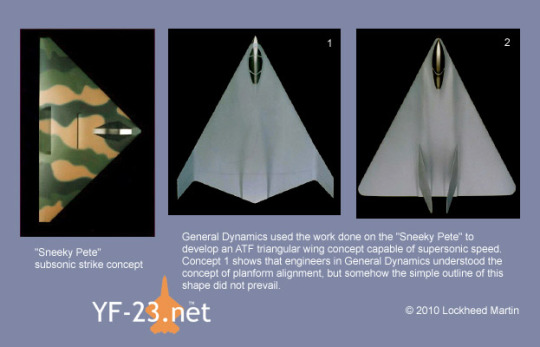
One of the more radical General Dynamics proposals dated back to the late ‘70s. Sneaky Pete, as it was known, was a simple tailless triangular design seemingly putting all emphasis on reducing RCS. Originally designed as a strike aircraft, the Sneaky Pete would be heavily modified to fit the ATF requirements. The planform was given a much greater sweep, and changes to the fuselage, wings, and tail were made in hopes of improving supersonic performance and maneuverability. However, the emphasis on stealth seemed to be too detrimental to the design - while it offered excellent stealth characteristics, this came at the cost of agility.
McDonnell Douglas Concept 4
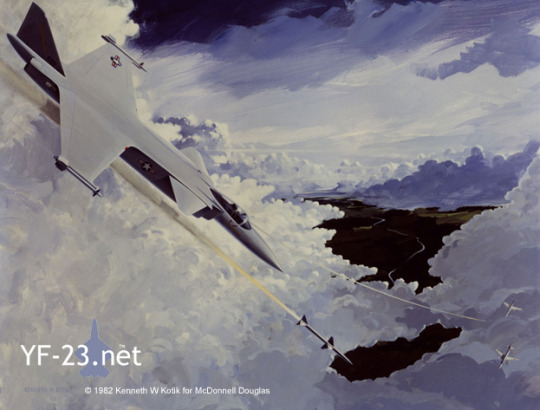
After McDonnell Douglas had their proposal for an upgraded “F-15XX” rejected, they would go to work on two diverging designs for their initial ATF design studies. The first, Concept 4, was a peculiar light fighter design. With a gross weight of just 17,700 lb, it was one of the lightest proposals submitted. Concept 4 was designed with a canard layout optimized for maneuverability, largely forgoing any stealth features. With the two engines taking up most of the fuselage, there doesn’t appear to have been any space for an internal bay, and all concept art shows the Concept 4 with externally-carried missiles. Worse, critical areas like the tailfin and intakes seemed to lack any stealth features at all. Unsurprisingly, the compact Concept 4 wouldn’t get very far.
McDonnell Douglas Concept 17/18
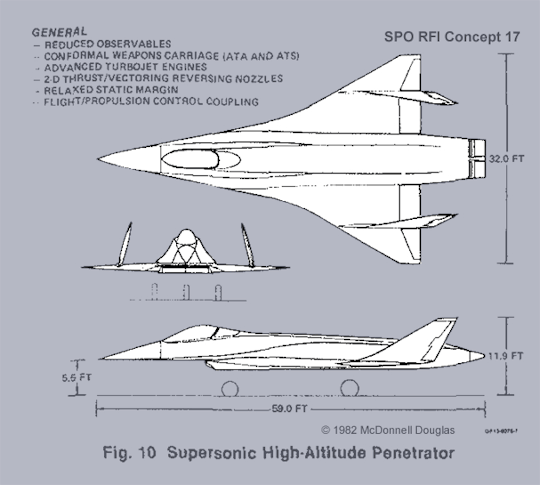
As a counterpart to the compact Concept 4, McDonnell Douglas also submitted two similar designs - Concept 17 and 18. Coming in at over 70,000lb, these concepts were far more practical designs that incorporated stealth features. A large double-delta wing would rely on fly-by-wire controls and 2-dimensional thrust vectoring to provide maneuverability. Stealth features included canted vertical stabilizers and shallow intakes, but, without the space for an internal weapons bay, the designs were instead reliant on recessed positions to reduce the RCS impact of the weapons.
Boeing Concept 7/8
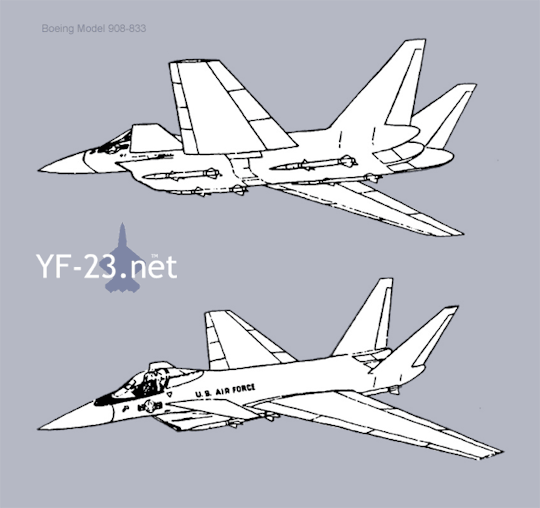
Of the three proposals submitted by Boeing in 1982, two were fairly similar canard designs. Under the designations Concept 7 and Concept 8, both designs shared the twin-engined, twin-tailed concepts with recessed positions for their missiles and ventral intakes. They differed primarily in their wing planform - Concept 7 had large high-aspect ratio wings, whereas Concept 8 used a conventional delta wing. Concept 7 came in at a projected 52,000lb gross weight, whereas the slightly larger Concept 8 was projected to weight almost 58,000lb. Concept 8 would also form the basis for a slightly larger Concept 16, sharing the same general configuration but increasing gross weight to 62,000lb.
Boeing Concept 15
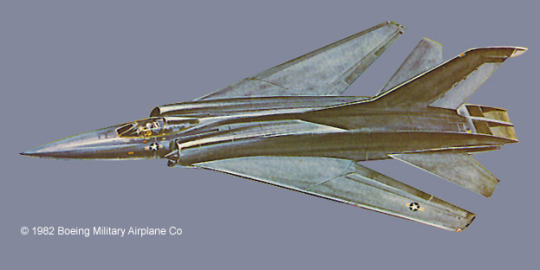
The third proposal submitted by Boeing was given the designation Concept 15. Concept 15 was a more conventional design that superficially resembled the cancelled Anglo-French AFVG swing-wing strike aircraft. Apart from the thrust-vectoring nozzles, the design was hardly remarkable, even with its variable geometry wings. In fact, with such a conventional layout, it was perhaps the most unremarkable of all the designs submitted by any manufacturer. As with the other Boeing designs, little space was left over for an internal weapons bay, so any weapons carriage was to be external.
Lockheed Concept 12/19

Lockheed would submit two proposals for the 1982 RFI, both of which used the same configuration. Receiving the designations Concept 12 and 19, these designs were by far the largest proposals. Coming in at over 110,000lb, the designs were derived from the SR-71/YF-12 designs and optimized for high-altitude, high-speed operations. Although it incorporated thrust vectoring and retractable canards, the design was by no means a dogfighter, but rather a long-range high-performance interceptor. Seemingly regressing from the stealthy designs SR-71/YF-12, the Lockheed concepts used a single vertical fin, compromising stealth characteristics. Although a more open canopy would improve forward view, little effort was put into improving the view to the rear as well.
Grumman Concept 9

Of the four concepts submitted by Grumman, Concept 9 would be the most radical. Concept 9 was a radical twin-tailed canard design with forward-swept wings based off of the X-29. Engines were to be placed in nacelles on the underside of the rear fuselage, making use of thrust-vectoring to improve agility. Although concept art released for the design varies in the details, it appears that forward-swept vertical stabilizers were also a feature of the design. Coming in at a gross weight of about 52,000lb, it was similar in size to most of the other proposals.
Grumman Concept 10/11/13

The other three Grumman proposals were all based around the same general ganard layout. An Engines were to be placed in pods on the trailing edge of the cranked-arrow wing, with a long, graceful fuselage extending far ahead of it. Two-dimensional thrust vectoring nozzles were to be used, and small internal bays were to be added in the space between the engines for a modest armament of air-to-air missiles. Though the concepts varied in details, all were about the same size, with the Concept 10 coming in at the lightest at 51,414lb, while Concept 13 was the heaviest (57,000lb), and Concept 11 sat at about 56,500lb. Although wind tunnel models and much of the concept art shows the designs with single vertical tails, the design submitted in 1982 were all revised with a double tail.
Northrop Concept 1
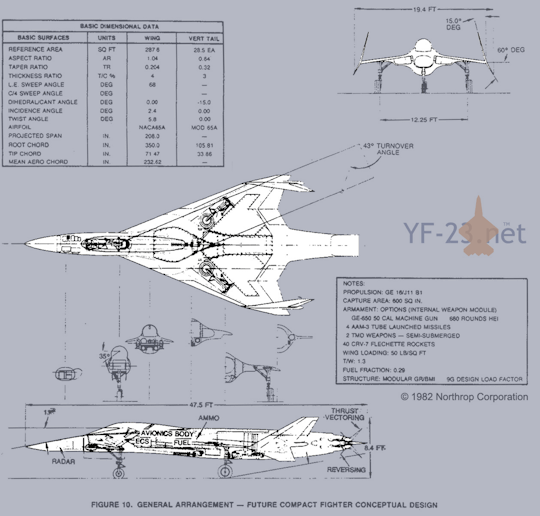
Of the three concepts submitted by Northrop in 1982, Concept 1 would be not just the lightest Northrop design, but the lightest of all the proposals. At just under 18,000lb, Concept 1 was designed around a single thrust-vectoring engine and a tailless wing planform. Intakes were set in the leading edge of the wing, and, to reduce the aircraft’s profile, the pilot would be placed in a reclined seat. Although this would restrict the pilot’s view of the instruments, Northrop planned to compensate by making use of a larger HUD and a helmet-mounted display. The design also entailed an entirely new set of weapons. Doing away with the conventional missiles then in service, the Concept 1 was instead designed to use a modular pallet pre-loaded with missiles with folding fins in a concept not unlike a scaled up Matra rocket pod.
Northrop Concept 2/3

Concepts 2 and 3 were progressively larger proposals using a layout vaguely similar to the YF-23 that would take shape several years later. These concepts both used a single mid-mounted diamond-shaped wing with twin tails canted outwards. Nicknamed the “missileer,” Concept 2 came in at just under 30,000lb gross weight. Concept 3 took the design to the next level. Projected weight grew to 50,000lb, and the wing layout of Concept 2 was refined further. Weapons were to be carried on the wingtips and in recessed positions on the underside of the aircraft.
General Dynamics ATF Proposal

The final proposal submitted by General Dynamics would refine the basic delta wing design of the Sneaky Pete. The nose of the design gradually morphed into a full fuselage extending from the leading edge of the wing, and various tail surface arrangements were tested - some placing them on booms on the wings, while others having them closer to the centerline. The final submission would use a single large vertical tail. Pods were placed on the outer sections of the wings to hold electronic countermeasures and sensors. To improve rear-aspect stealth, the trailing edge of the wing was given a jagged appearance, complete with special engine nozzles. While the final General Dynamics proposal did have numerous flaws that caused it to not be selected for full development, it was a promising contender, only barely failing to compete with the Lockheed and Northrop proposals that won. Even then, critical features of the design - particularly the nose - would carry over to the YF-22 thanks to collaboration with Lockheed for the final stage of the ATF program.
Boeing ATF Proposal
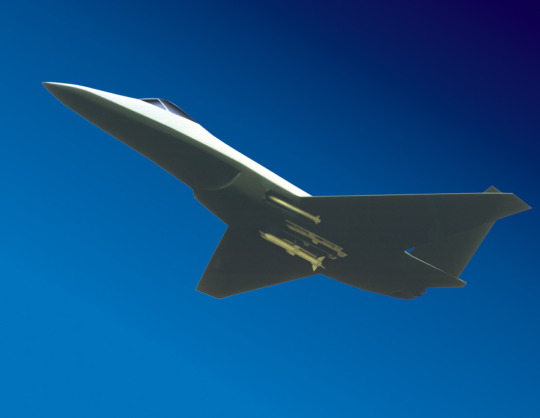
The proposal Boeing would submit in 1986 would prominently feature an advanced chin intake. Through careful design, Boeing had developed a stealthy diverterless supersonic inlet, allowing for a clean transition between the fuselage and intake. Outside of the prominent intake, the design had much in common with the Northrop design that would win this stage of the competition. The pilot sat in a high mounted cockpit, providing an excellent view, and the space immediately behind the intake was filled with a shallow weapons bay capable of carrying up to six missiles. Unfortunately, Boeing’s proposal would come in dead last in the competition.
McDonnell Douglas ATF Proposal
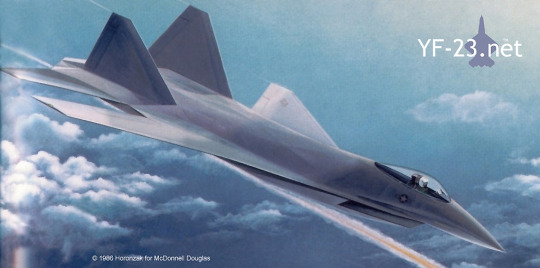
McDonnell Douglas’ initial ATF design studies that produced tailless delta and canard designs would give way to a strangely conventional final submission. A conventional twin-tail layout was distinguished by its prominent chin intakes and frameless canopy (the only such proposal to use such a feature). Most of the design followed stealth practices fairly closely, with shielded exhausts, canted fins, and parallel angled edges. However, a fairly poor understanding of stealth within McDonnell Douglas meant that these features all fell apart as one made it to the forward fuselage. The nose section regressed to subtle faceting that would complicate the manufacturing process, and the haphazard junction between the leading-edge root extensions and the nose resulted in an ugly transition from the forward fuselage to the nose. Regardless, the design was technically sound, although a fairly small wing area meant that maneuverability was questionable. In the end, the McDonnell Douglas ATF proposal would come in fourth in the competition.
Lockheed ATF Proposal
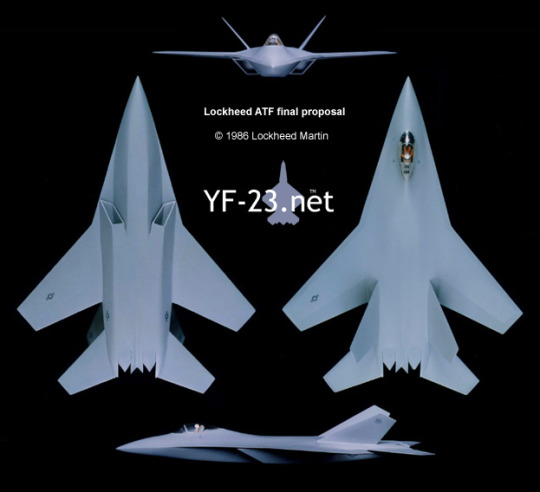
Lockheed would submit several final designs to the ATF program, but only one would end up being chosen for further development. Building on previous experience with stealth designs, Lockheed’s ATF would boast the stealthiest intakes of any proposals. Fairly small lifting surfaces were optimized for Mach 2 flight, but would detract from maneuverability. Armament was to be carried in a rotary weapons bay. Unusually, while this design was selected for further development, Lockheed’s final product would more closely resemble a different configuration that was actually rejected by the USAF. As part of an agreement with Boeing and General Dynamics, the companies had made the decision to support whichever of their designs won the competition. Thus, Boeing and General Dynamics would join in on Lockheed’s project as subcontractors.
Northrop YF-23

Northrop would be selected as one of the two companies to test a prototype for the ATF program. Their design, given the designation YF-23, resembled a greatly refined version of the proposals Northrop had submitted in 1982. The unusual diamond-shaped wing and heavily canted tail surfaces gave the design carried over, but stealth characteristics were improved greatly, most notably with the prominent engine nacelles and internal weapons bays. A complex “Vehicle Management System” was developed to handle control inputs and monitor control systems, compensating for damage if need be. Originally designed with thrust reversers, these were eliminated after the USAF changed the landing roll requirement to 3,000ft. This would allow for the engine nacelles to be downsized in production aircraft, but the change came too late to apply to the two prototypes. To keep costs low, Northrop salvaged what they could from existing designs - the main landing gear came from an F/A-18, while nose gear and the cockpit came from an F-15E.

In August 1990, the YF-23 would fly for the first time. Tests were quick to demonstrate the capabilities of the design, with both prototypes reaching supercruise (Mach 1.43 for the YF119-equipped version and Mach 1.6 for the YF120. The weapons bays in particular were tested extensively, although no test firings occurred. Nevertheless, the YF-23 was proving promising. Tests took it up to a top speed of Mach 1.8 (although that was by no means the limit of the design) and angles of attack as high as 25 degrees. It was found to meet all requirements for survivability, supercruise, stealth, and maintenance, and it demonstrated superior stealth characteristics than the competing YF-22. However, the YF-22 had also met all requirements while demonstrating far better agility than the YF-23. With the YF-22’s stealth deemed acceptable, the Air Force would select Lockheed as the winner of the competition.
Lockheed YF-22
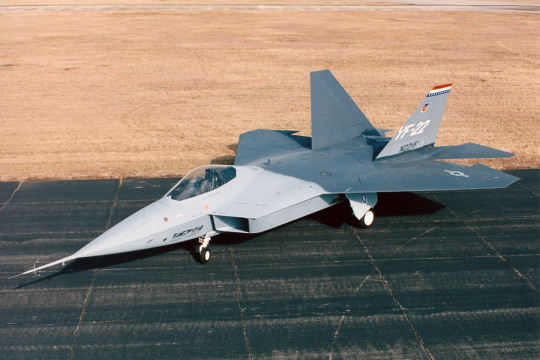
Unusually, the YF-22 that would fly in September 1990 looked nothing like the Lockheed design that had won the contract for prototypes. Having joined forces with Boeing and General Dynamics, Lockheed would incorporate the best elements of their proposals into the YF-22. The nose of the aircraft took on the shape of General Dynamics’ proposal, while the swept surfaces were filled out, giving them more of a diamond shape as seen on the Boeing design. Oddly enough, the resulting YF-22 looked a lot like one of the Lockheed proposals that was rejected in 1986. Unlike its Northrop counterpart, it used thrust vectoring nozzles to improve maneuverability that would ultimately prove decisive in the final competition.
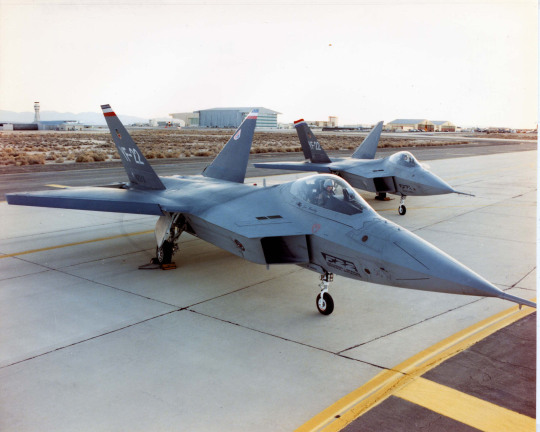
Not long after the YF-22 flew for the first time, it was sent off to trials against the YF-23. Testing was far more rigorous, exceeding program requirements by conducting test firings of AIM-9s and AIM-120s from the internal weapons bays. The two prototypes would reach supercruise speeds of Mach 1.58 and 1.43, while top speed was demonstrated to be over Mach 2. Agility tests took the YF-22 prototypes to angles of attack as high as 60 degrees and discovered the aircraft had a pitch rate roughly double that of the F-16 at low speeds. By the end of the year, testing concluded. In April 1991, the winner was announced. Though the YF-23 was faster and stealthier, the YF-22’s superior agility would win it the contract.
Advanced Tactical Aircraft - ATA
As part of efforts to upgrade the inventory, the Navy began a search for a new strike aircraft to replace the A-6 Intruder in 1983. Under the program name Advanced Tactical Aircraft, the Navy asked for a carrier-capable strike aircraft aimed at replacing the aging A-6. Paralleling the Air Force’s Advanced Tactical Fighter program, the Navy would request that stealth be an integral part of the design. Additionally, contractors were encouraged to team up to improve efforts rather than submit countless single proposals. Thus, Northrop, Grumman, and Vought would form one group while McDonnell Douglas and General Dynamics would create a competing proposal. The program was to be incredibly valuable - the Navy and Marines planned to procure almost 900 examples of the ATA, while it also caught the attention of the Air Force and the RAF, who considered replacing their F-111s and Tornadoes, respectively, with the ATA.
Northrop/Grumman/LTV ATA Proposal

Northrop, Grumman, and Vought would develop a proposal heavily based off of Northrop’s extensive work with the Advanced Technology Bomber program (which spawned the B-2). Incredibly similar in appearance to the B-2, the ATA proposal was a twin-engined flying wing with engines mounted on top of the aircraft so as to shield exhausts from detection from below. Compared to the later B-2, the ATA proposal would be distinguishable by the fact that the engines were part of the central dorsal hump rather than separated in their own humps, and the presence of just one “tooth” on the trailing edge. Unfortunately, this proposal would not be selected for further development.
McDonnell Douglas/General Dynamics A-12 Avenger II
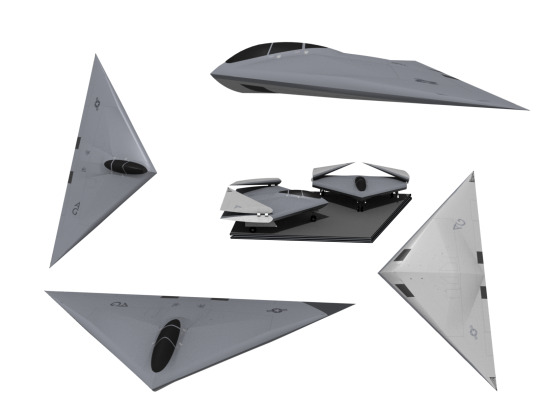
The winning proposal, which would gain the designation A-12, would come from the McDonnell Douglas/General Dynamics team. The A-12 was considerably simpler in appearance than its competitor - it was a simple, featureless triangle, aptly nicknamed “the flying Dorito.” Two F412 turbofans were to provide power, while internal weapons bays were to carry a payload of up to 2,300kg of stores, including precision-guided munitions and two AGM-88s or AMRAAMs. Unfortunately, the program would soon run into development trouble. The design hinged on the success of promising new composites, which ended up proving heavier than anticipated. Projected weights spiraled, while other issues arose in the A-12’s complicated sensor suite.

Only in 1990 after a review by Defense Secretary Cheney did the full scope of the issues come to light. The Marines would drop their order, and skyrocketing program costs along with further engineering issues put the project under great scrutiny. Over the course of 1990, numerous inquiries into the A-12 program were performed, resulting in several very critical reports both of the cost of the program itself as well as the performance of the planned aircraft. By the end of the year, the Navy was asked to justify the program, which threatened to eat up the majority of the Navy’s budget. After receiving an unsatisfactory response, Secretary of Defense Cheney cancelled the program in January 1991 for breach of contract.
Naval Advanced Tactical Fighter
In 1986, as the Navy began a search for a replacement for the F-14, Congress directed them to have the design be derived from the Air Force’s ATF (compensating for this by having the Air Force replace the F-111 with the Navy’s ATA). By 1988, with Lockheed and Northrop finalizing their designs, the Navy had established a program office and sent out contracts for navalized variants of the aircraft. Requirements differed from the ATF - the NATF was to have a max takeoff weight of 65,000lb and landing weight of 52,000lb. It was to be no larger than the F-14, and take up the same space while stowed. Mission requirements were also different, calling for a fleet-defense interceptor rather than an air superiority fighter, necessitating longer ranged weapons and sensors and putting a preference on a two-man crew. Ultimately, however, the NATF would never materialize. Projected weights of the ATF designs kept rising, and, in 1991, the NATF was cancelled, citing rising costs and program delays.
Lockheed F-22N
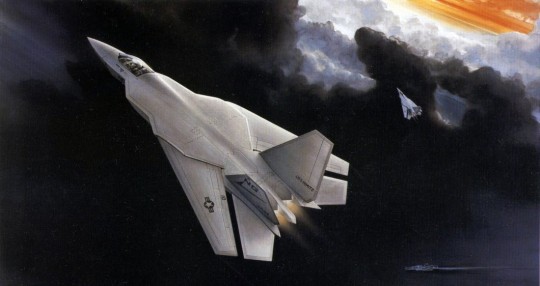
Lockheed’s NATF design superficially resembled a swing-wing variant of their more conventional land-based F-22. Called the F-22N, the design would likely share little with the F-22. Variable-geometry wings would change much of the central structure of the F-22, and the horizontal tail surfaces were completely different to be better suited to the new aerodynamics. Perhaps the only true commonality between the designs was to be the avionics and engines. Although far from nothing (avionics and engines were projected to make up over 40% of the ATF cost) effectively building a new aircraft for these requirements would undoubtedly remain expensive. Even without considering budgetary concerns, the F-22N had its share of issues - it was projected to have a gross weight far exceeding the capacity of current carriers. In the end, the F-22N would be cancelled before it left the drawing board when the Navy abandoned the NATF effort in favor up less radical upgrades to existing designs. Even if the Navy had followed through with the NATF, the anticipated weight issues likely would have kept the F-22N from becoming a reality.
Northrop NATF-23

Northrop’s NATF proposal was an even more radical departure from their ATF design. The distinctive arching curves of the F-23 were gone, and the unusual ruddervators of the original design gave way to canards and vertical tail surfaces. The only thing retained from the original F-23 proposal was the wing planform, which itself was moved aft to make space for the canards. Structurally, these wings were to be radically different from the F-23’s, being much larger and incorporating a folding mechanism. Like the F-22N, it was have a crew of two in tandem. Actual proposed specifications are unclear, but, just like the F-22N, Northrop’s NATF proposal would meet its end when the Navy abandoned the NATF program for cheaper alternatives.
Advanced-Attack/Advanced/Fighter-Attack - A-X/A/F-X
Following the cancellation of the ATA and NATF (navalized adaptation of the Air Force’s ATF), the Navy began a new program to replace the A-6. Designated the A-X, the program aimed to replace the A-6 with an advanced two-man all-weather attack aircraft. Such a program attracted the attention of the Air Force, who was concurrently seeking to replace the F-111. As the Navy added on requirements to fill the gap left by the cancellation of the NATF, the program changed focus from an attacker to a multirole, causing the program name to change to A/F-X. As with previous programs, the A/F-X encouraged contractors to form teams to produce a solution - in this case, teams were Grumman/Lockheed/Boeing, Lockheed/Boeing/General Dynamics, McDonnell Douglas/Vought, Rockwell/Lockheed, and General Dynamics/McDonnell Douglas/Northrop. In the end, no proposals would make it to full-scale development - the A/F-X would end up being cancelled, with efforts instead directed towards the emerging JAST program (which later led to the Joint Strike Fighter).
Grumman/Lockheed/Boeing A/F-X Proposal
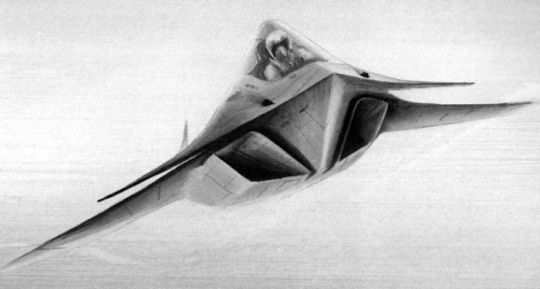
The Grumman/Lockheed/Boeing team would create an unusual proposal, notable for being the only one to feature canards. Not much is clear about the design, apart from its use of a canard layout, twin tails, and a heavily faceted design. To reduce radar cross-section, the tails were to be canted inwards. The intakes appear to be derived from Lockheed’s ATF proposal, but otherwise the design shares little with either the ATF or any other proposal. This is likely due to the internal secrecy - although Lockheed had its hands in three separate proposals, there was no communication between design teams for the competing proposals.
Lockheed/Boeing/General Dynamics A/F-X Proposal
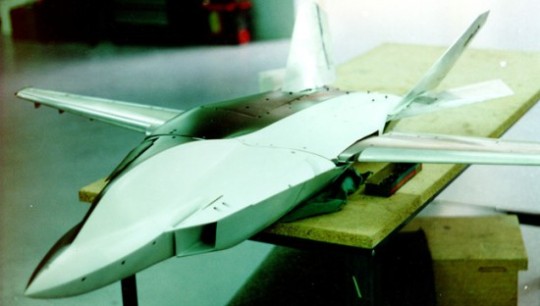
The Lockheed/Boeing/General Dynamics team would develop what amounted to the successor of the failed Lockheed NATF proposal. This team’s proposal was a swing-wing aircraft derived from the F-22 and featuring extensive changes to better suit the aircraft for air-to-ground operations and carrier takeoffs and landings. Extensive changes were made to the wings and tail, and unlike the NATF proposal, which appeared to be little more than an F-22 with swing-wings, this new proposal was an entirely new aircraft.
Rockwell/Lockheed A/F-X Proposal
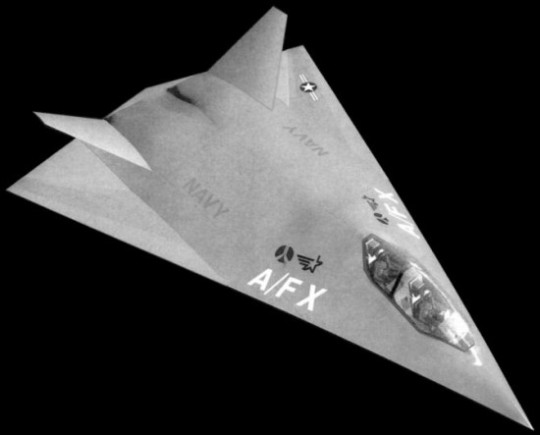
Lockheed’s third A/F-X proposal was again greatly diverging from other designs. Rockwell had opted for a radical elongated delta planform, lacking any horizontal tail and making use of two heavily canted vertical stabilizers. While intakes were situated under the aircraft, exhaust was to vent just above the trailing edge of the wing to reduce detectability. Unusually, the wings were very small for the aircraft size, indicating that the body of the aircraft was likely intended to produce a great deal of lift to allow for sufficient low-speed performance so as to allow for carrier operations.
General Dynamics/McDonnell Douglas/Northrop A/F-X Proposal
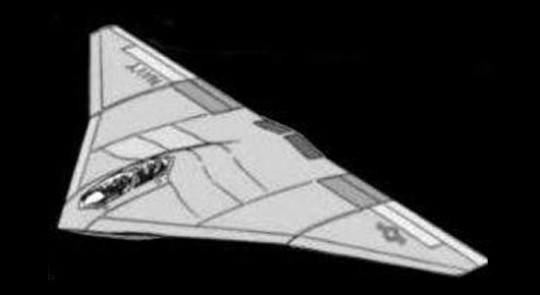
Undeterred by the failure of the A-12, General Dynamics and McDonnell Douglas teamed up with Northrop to modify their cancelled A-12 design to meet the new requirements. The same distinct clean profile with a straight trailing edge was retained, but the new proposal would take away the A-12’s distinct “flying Dorito” shape. The sweep of the wing decreased on the outer wing sections, providing greater wing area. These outer panels would fold upwards for storage aboard the carrier just as with the A-12, but the pointed wingtips were clipped to reduce footprint on the carrier.
Lockheed F-117N
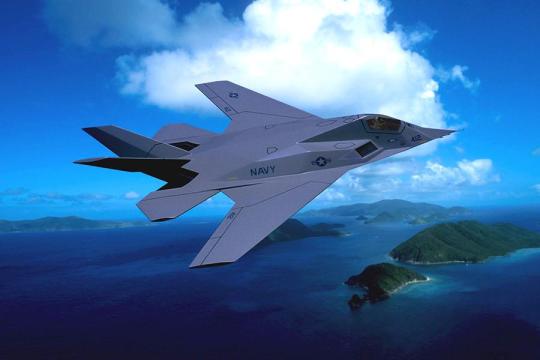
After the cancellation of the A/F-X and start of the Joint Advanced Strike Technology program, Lockheed developed a new proposal as an alternative, based on the F-117. Designated the F-117N, the proposal entailed a heavily modified F-117 with a redesigned wing and tail, new bubble canopy, and GE F414 turbofans. A new radar would allow for both air-to-ground and air-to-air missions, and external hardpoints were to supplement an expanded internal bomb bay. Unsurprisingly, the proposal was received poorly. The Navy had already tested the F-117 in 1984 and found it unsuitable for carrier operations, and the F-117N could hardly compete with all the momentum behind the JAST program. After being rejected once, Lockheed updated the F-117N with afterburners and expanded air-to-air capabilities, but they were again rebuffed.
British Aerospace P.125
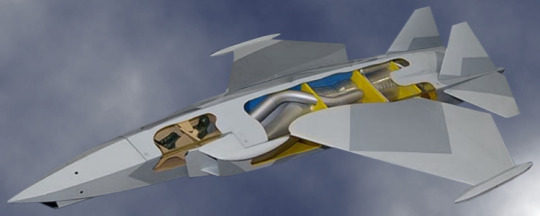
In cooperation with the DARPA, British Aerospace joined in on the Advanced STOVL program in the 80’s to develop a replacement for the Harrier. Among the various designs developed by BAe, the most unusual would be the P.125. In terms of the lift system, the P.125 was unremarkable - it used a remote augmented lift system, effectively diverting air from the engine compressor through several nozzles and applying a reheat to increase thrust. However, unlike the many other proposals from BAe, the P.125 would be their only design to incorporate stealth features. A clean, faceted fuselage with canted tail surfaces was developed, and, most notably, the cockpit lacked a canopy. Instead, the pilot would rely on cameras placed around the aircraft projecting onto screens around the cockpit for a view of the outside world. With no canopy to worry about, the engineers then buried the cockpit in the fuselage, placing the pilot in a reclined position to reduce the aircraft’s profile. Dating to about 1988, the project would be abandoned when the ASTOVL program was folded into the Joint Strike Fighter. Rather than pursue the ambitious design alone, the UK opted to join the JSF program, putting an end to the P.125’s development.
British Aerospace Tornado 2000

In the aftermath of the Gulf War, the British Ministry of Defense commissioned a design study for an extensively modernized Tornado IDS, aimed at having the resulting design enter service by the new millennium. Under the tentative designation Tornado 2000, BAe went to work, using the Tornado IDS as a base. The forward fuselage was extensively redesigned, with a new faceted nose developed and new stealthy intakes added to reduce RCS. Fuselage plugs were added forward and aft of the wings, filled with new avionics and fuel tanks, while a large ventral conformal fuel tank was developed with recessed positions on the sides to carry missiles. Unfortunately, the project was short-lived. The end of the Cold War and the associated slashing budgets put an end to the project by the middle of the decade.
Lockheed Martin RQ-3 DarkStar
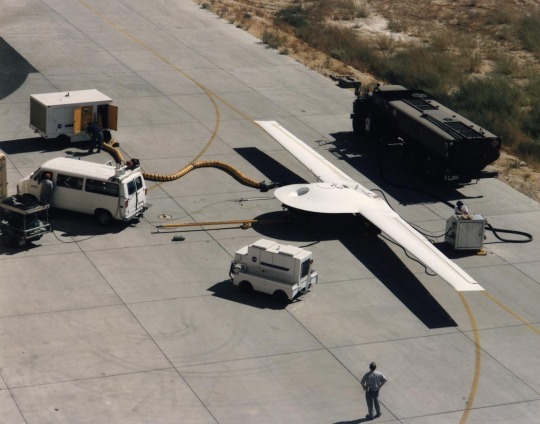
The RQ-3 had its origins in 1983, when the USAF, CIA, and NRO initiated a program to develop a high-altitude UAV for strategic reconnaissance. The program progressed without any aircraft entering service until its cancellation in 1992. However, Lockheed’s UAV program was allowed to continue on low priority under the designation Tier III. The Tier III program ended up splitting, calling for separate stealthy and non-stealthy platforms to meet the strategic reconnaissance requirements. Lockheed’s design became Tier III Minus, eventually receiving the designation RQ-3 DarkStar. The DarkStar was an unusual aircraft, with a compact, flat semi-circular fuselage containing a single engine and avionics, while massive high aspect ratio wings extended out in either direction. The first flight of the RQ-3 took place in March 1996, but on its second flight the aircraft was lost due to incorrect modeling of control laws. A modified design would take flight in 1998, making five flights before the program was cancelled on grounds of the RQ-3 being too unstable. Despite its cancellation, the program remained a black project until 2003, when it was finally revealed to the public.
Boeing Bird of Prey
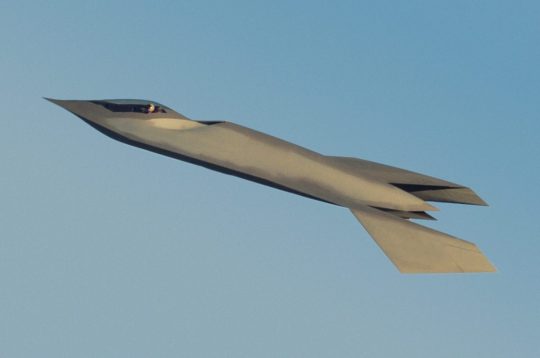
In 1992, McDonnell Douglas Phantom Works began work on an unusual stealth technology demonstrator known only as the Bird of Prey. The design was incredibly unconventional - a long, lozenge-shaped fuselage had a pilot in the nose and a dorsal intake, and heavily swept gull wings were placed at the extreme rear of the fuselage. Oddly enough, the Bird of Prey was a stable design, requiring no special control system for the pilot. Hoping to keep costs down, McDonnell Douglas salvaged many parts from existing aircraft - including nose gear from an F-100. Cockpit instrumentation was minimal, and hydraulic controls were used in place of fly-by-wire. Taking flight for the first time in 1996, the Bird of Prey was surprisingly docile and easy to fly. This was in part thanks to the significant amount of lift generated by the flat body. The project was transferred over to Boeing in 1997 when McDonnell Douglas merged with them, flying for two more years before being retired in 1999. The program remained secret until 2002, when it was declassified.
Lockheed Martin F-22 Raptor

For all the effort poured into the ATF program, the end of the Cold War and slashing budgets that followed put the F-22’s future in jeopardy. The production order was slashed, first from 750 to 648, then down to 442. Lockheed hoped to preserve the program’s future by adding a modest secondary attack role, but this did little to prevent further scrutiny - by 1997, the two-seat F-22B was cancelled, and order had been reduced to 339. Owing to the extensive changes Lockheed had to make to the YF-22, it would take until that same year for the first prototype to fly. The F-22 that flew in 1997 was a much better looking machine than the YF-22 prototype. The cockpit was moved forward and intakes moved back, and the wings and tail were reshaped. Two Pratt & Whitney F119 engines powered the F-22, giving it the ability to supercruise at Mach 1.5 and reach a top speed exceeding Mach 2. Thrust vectoring nozzles, controlled by the fly-by-wire control system, improve agility at lower speeds. While dimensions had remained roughly the same, weight had ballooned - the F-22 weight 10,000lb more empty than the YF-22, and max takeoff weight had increased by over 20,000lb.

Despite its impressive appearance and performance, what really made the F-22 special was the electronics. The glass cockpit features six LCD displays and a wide-angle HUD, as well as HOTAS controls and a helmet-mounted sight. The AN/APG-77 AESA low probability of intercept radar can detect targets at 250 nautical miles and track at 125 nmi with ELINT, jamming, and datalinking capabilities as well. With 1500 T/R modules, it has a field of view of 120 degrees, working in concert with passive sensors across the aircraft to narrow down the area of the sky to illuminate. Other capabilities include collating information on aircraft and potential targets in the area, classifying them, and alerting the pilot to high-priority targets. Outside of the radar, the F-22 features the AN/ALR-94 radar homing and warning system, which features 360 degree coverage and can be used to direct the radar. Missile warning and active IR countermeasures are also present, although the details are classified. To handle all the advanced electronics, two Common Integrated Processors are present on the aircraft. These help manage onboard systems to reduce pilot workload, and provide diagnostics to account for battle damage while flying and ease maintenance on the ground. Thus, despite being significantly more advanced, maintenance demands for the F-22 are estimated to be roughly half that of the F-15.

Testing of the F-22 was quite extensive. Nicknames and designations fluctuated, with the aircraft being called the “Lightning II,” “Rapier,” and “SuuperStar” at various times before receiving the final name of “Raptor.” Hoping to protect the program from budget cuts, the Air Force also changed the designation to F/A-22 in 2002, reinstating the original designation in 2005. In December 2005, the F-22 finally reached IOC. Exercises began the next year, finding the F-22 to be tremendously effective, not only with simulated air combat, but with secondary roles like surveillance, and, most critically, there were no issues with maintenance. The first overseas deployments began in 2007, with F-22s being deployed to Japan. This first deployment uncovered a software issue caused by crossing the international date line, but this was addressed and fixed within 48 hours. That same year, they would perform their first NORAD interception of Tu-95s probing American airspace.
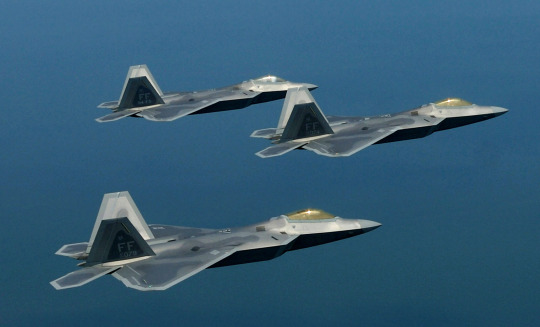
The F-22 has not been without teething problems, however. Maintenance has been time consuming and expensive, with the lowest maintenance-man-hours-per-flight-hour number attained being over 10 hours. At nearly $70,000 per flight hour, the F-22 is three times as expensive to fly as an F-16. The stealth characteristics account for almost a third of maintenance, particularly in the advanced RAM skin. Reportedly, although the F-22’s RAM is far more robust than on older stealth aircraft, it is still susceptible to weather. Teething problems were found in the Raptor soon after IOC, mostly relating to structural issues due to manufacturing defects. The onboard oxygen generating system would be the source of continual problems as well. The fleet would be grounded for four months in 2011, but issues persisted for some time. Only in 2013 were flight restrictions relating to the faulty OBOGS lifted.
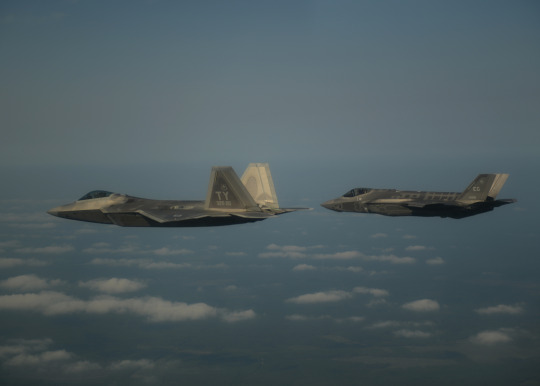
Unfortunately, the decision was made to cut F-22 production in 2009 with just 187 aircraft delivered. However, the tooling was retained to allow production to resume if the need arises. That same year, the F-22 would make its first deployment to the Middle East, flying out of Al Dhafra Air Base in the UAE. In 2012, these became rotating deployments. Unlike most other foreign deployments, F-22s at Al Dhafra are within 200 miles of Iran, putting them in a position for incidents with hostile aircraft. In 2013, an F-22 intercepted an Iranian F-4 that approached too close to an MQ-1 Predator UAV, sneaking up on them and politely asking them to go home before escorting the Predator back to safety. In 2014, F-22s finally made their combat debut, dropping several guided bombs on the Balsamic State in Syria. Between September 2014 and July 2015, 204 sorties were flown over Syria, dropping 270 bombs. Currently, there is no plan to replace the F-22. With a projected lifespan of about 30 years, it is expected that the Raptor will keep flying until at least the 2030s, at which point it should be superseded by a 6th-generation fighter.
British Aerospace Replica
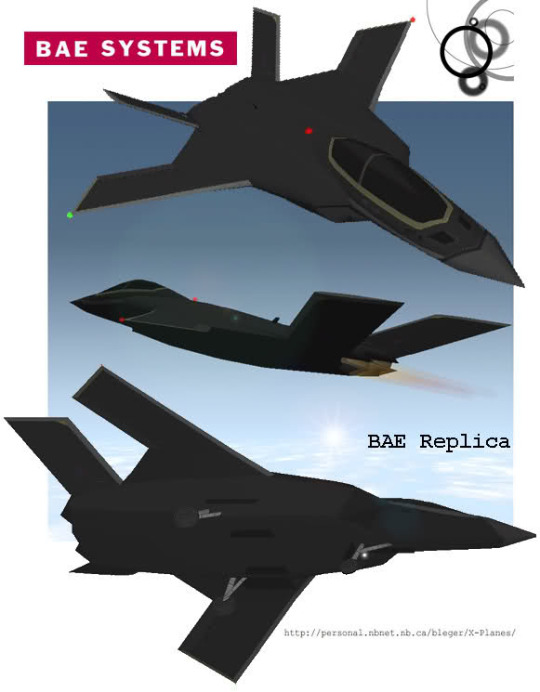
As part of efforts to develop a next-generation successor to the Panavia Tornado, BAe began the Replica program in 1994. Aimed at developing a stealth airframe, the Replica was unique in that the end goal was not necessarily a functioning aircraft, but rather a static technology demonstrator for a stealth airframe. The resulting concept incorporated the requirements of the Future Offensive Air System program, with a crew of two and internal weapons bays for missiles and bombs, but the main focus of development was on stealth technologies. Making extensive use of computer design techniques, the Replica was vaguely reminiscent of the YF-23 and the joint BAe/McDonnell Douglas/Northrop Joint Strike Fighter proposal, but in fact was an entirely independent design. A scale mockup was built for practical testing, making use of new composites and construction techniques developed specifically for the program. Once the Replica was completed, it spent several years having various aspects - particularly stealth characteristics - tested. The program terminated in 1999, with relevant experience transferring over to the JSF, but the project remained secret until 2003.
Joint Strike Fighter
The infamous Joint Strike Fighter program could trace its origins back to the early 80’s, when DARPA began the Advanced STOVL program to develop a supersonic successor to the Harrier. In 1987, after concluding technology was not up to meet requirements, Lockheed was contracted to develop a solution. Meanwhile, the USAF was looking into developing an F-16 successor, and the Navy, having abandoned the ATA, was pursuing the A-X/A/F-X. In 1994, after Lockheed’s lift-fan system finally provided a realistic means to implement the supersonic STOVL fighter concept, the decision was made to fold the three fairly common requirements from the two services into a single program - the Joint Advanced Strike Technology. The JAST was intended to mature technologies and develop requirements for a common multirole aircraft for the USAF, USN, and USMC. Concepts were submitted by just about every major aerospace company in America, culminating in the selection of proposals from Boeing and Lockheed in 1997 and the commencement of the Joint Strike Fighter program in 1997.
McDonnell Douglas/Northrop Grumman/British Aerospace JSF Proposal
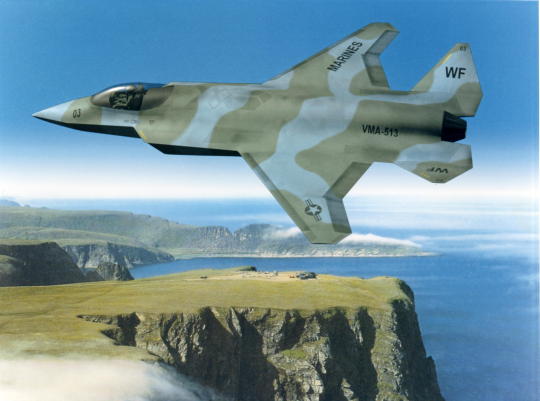
McDonnell Douglas, Northrop Grumman, and BAe would team up for their JSF proposal. Their design went through several iterations, but retained the characteristic cranked wing and canted tail surfaces. Unable to make use of the lift-fan design that Lockheed had patented, the consortium instead was forced to go with a far less promising proposal. The single engine would divert thrust downwards out of the main exhaust nozzle, while a separate lift engine would be placed behind the cockpit on the STOVL variant. While this system was the most archaic and inefficient of the proposals submitted, it allowed the consortium to use a conventional layout with minimal compromises for the conventional variants. However the DoD did not favor such a system, and ultimately passed it over in favor of the Boeing and Lockheed Martin designs.
Boeing X-32

Boeing would draw heavily on their experience with the ATF and predecessor programs to the JAST for their design. Contracted as the X-32, the aircraft was a portly tailless design featuring a prominent chin intake similar to the one developed for the Boeing ATF proposal. Boeing opted for a simple thrust-vectoring system similar to that seen on the Harrier for STOVL operations, requiring the engine to be placed near the center of gravity. The massive wing consisted of a single piece of carbon fiber composite, and was spacious enough to carry 20,000lb of fuel. The massive chin intake was configured to extend outwards on the STOVL variant, increasing airflow into the engine for vertical flight. Two prototypes would be built - the conventional X-32A and STOVL X-32B. Although maneuverability requirements forced Boeing to perform a major redesign of the final F-32 design (adding a conventional tail), but it would be too late to modify the prototypes for the fly-off against the X-35.
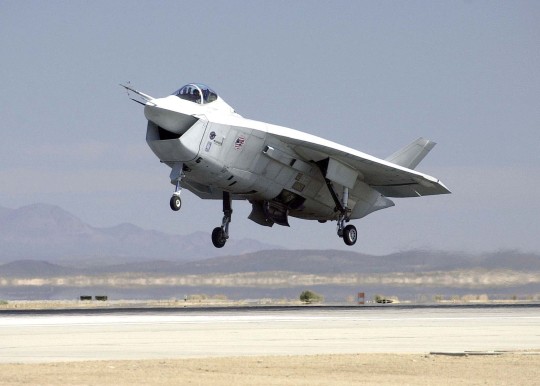
The X-32A would fly for the first time in September 2000, followed by the X-32B in March of the next year. Testing quickly found the X-32 to be completely uncompetitive with the X-35. The X-32B was incapable of hovering and reaching supersonic speeds in the same flight, and the X-32A’s maneuverability was hampered by the unusual center of gravity produced by the central engine placement. If it wasn’t bad enough that the X-32 couldn’t meet maneuverability requirements, the X-32B required several parts to be removed for STOVL operations. Boeing promised that the final design would address these issues, but there really was no question as to who the winner was. In October 2001, Lockheed’s X-35 was selected as the winner of the Joint Strike Fighter.
Lockheed Martin X-35
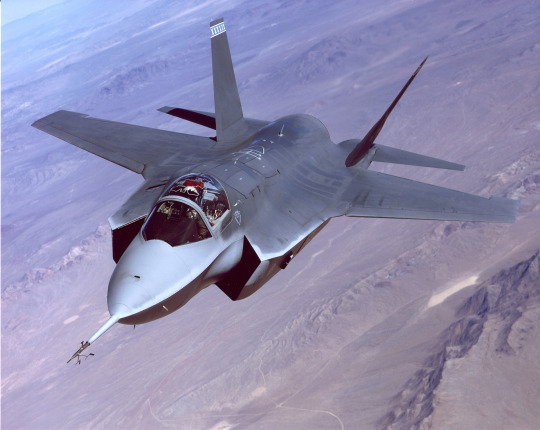
Lockheed’s X-35 would be designed around the novel lift fan system they had developed as part of the ASTOVL program. Overall very conventional in appearance, the X-35 was fitted with the Rolls-Royce Lift System, which was linked directly to the driveshaft of the aircraft’s F135 engine to provide vertical thrust for STOVL operations. Effectively working on the same principle as a turboprop, the X-35’s lift system was by far the most promising of all the JSF proposals. Diverting power to drive the lift fan did reduce the thrust of the main engine, but the resultant thrust of the lift fan far outweighed those losses. Because the lift fan produced a comparatively cold column of air, it also offered the ability to reduce the chance of ingesting hot engine exhaust during hovering flight. Even better, the design allowed for a conventional layout, meaning the non-STOVL variants would not be forced to work with an unfavorable layout purely to allow for commonality between variants.
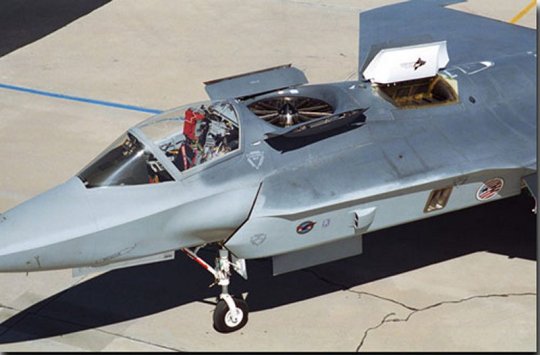
The X-35A would fly for the first time in October 2000, followed by the X-35C carrier variant. After successful testing of the X-35A, Lockheed fitted it with the VTOL systems, turning it into the X-35B. The X-35B began vertical flight testing in June 2001, and over the course of testing it proved far superior to the X-32. As the conversion from the X-35A to B had shown, there was significantly more commonality between variants than the X-32, and, unlike the X-32, the X-35B was capable of taking off in under 500 feet, reaching supersonic speeds, and then landing vertically. With Lockheed’s design blowing Boeing out of the water, and the X-32 not even fully meeting program requirements, it came as no surprise when the X-35 was selected as the winner of the JSF in October 2001.
Joint Unmanned Air Combat Systems
At the end of the 90’s, the USAF and USN began separate programs to develop a stealthy UCAV to meet their needs. The USAF contracted Boeing in 1998, while the Navy was slower to catch on, only starting their own program in 2000. In 2003, the J-UCAS program was started by DARPA to manage these two programs and better develop requirements Fittingly, both companies would receive contracts - Boeing’s X-45 would receive the USAF contract, while the Navy would select the Northrop Grumman X-47A. Though the J-UCAS program was cut short in 2006, the USN and USAF continued the projects alone.
Boeing X-45A

Boeing’s winning design, designated the X-45A, drew heavily on experience gained with the Bird of Prey program. Retaining the general shape of the Bird of Prey, the X-45A removed the cockpit and flattened out the wings. Two internal weapons bays were added, allowing the X-45A to carry two JDAMs or up to eight SDBs. Flight testing of the X-45A began in May 2002. Two prototypes were built, both successfully completing flight tests and weapons trials. Designed with penetrating air defense networks in mind, the X-45A would demonstrate the ability to autonomously determine and execute an optimal attack pattern in a simulated air defense network. During tests, the two prototypes showed the ability to not only operate autonomously, but do so in concert with eachother to optimize mission performance.The test program concluded at the end of 2005, after which both prototypes were sent off to museums.
Northrop Grumman X-47A Pegasus
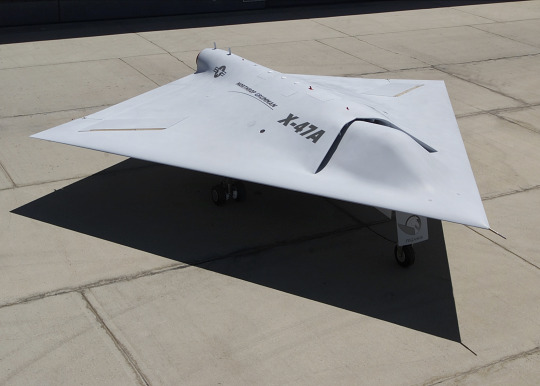
After winning the Navy UCAV contract, Northrop Grumman would build their own UCAV demonstrator - the X-47A. The X-47A was a simple diamond shape with a 55 degree leading edge sweep and 35 degree trailing edge sweep. A single engine powered the machine, buried behind a carefully designed inlet. However, to keep costs low, the exhaust pipe was conventional and unstealthy. Two weapons bays were installed, but no testing of weapons deployment would be conducted. First flying in early 2003, the X-47A was tested by the Navy, who were primarily looking at low-speed handling and precision navigation capabilities. While the X-47A lacked suitable arresting gear for a carrier landing, carrier operations were simulated by having the X-47A navigate to a touchdown point using Shipboard-Relative GPS.
BAE Systems Raven

In 1997, the British Ministry of Defense began the Future Offensive Air System program with the intention of developing a replacement for the Tornado GR.4. BAe would pursue both manned and unmanned solutions, both emphasizing stealth. Small-scale testing of unmanned demonstrators took place until 2003, when enough data had been gathered to commence work on a more practical prototype. Under the designation Raven, BAe developed a sleek flying wing UAV. A single engine was buried in the fuselage, featuring a stealthy intake but still using a conventional tail. Two prototypes were made, both making extensive use of composites later used on the F-35, with the first flights taking place in December 2003 near Woomera, Australia to ensure secrecy. Though the FOAS program would end in 2005, the Raven’s design would carry over to the UCAV efforts that followed.
Dassault Moyen Duc
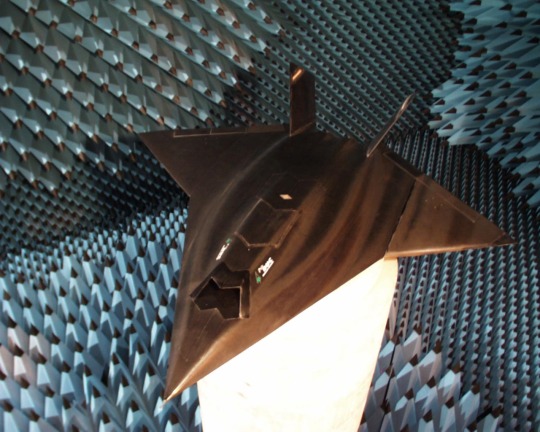
Dassault’s recent UCAV development can trace its origins back to 1999, when the company began a private venture UCAV program. Starting with a small demonstrator called the Petit Duc flying in 2000, Dassault planned to create three successively larger prototypes, culminating in a full-scale design that could be adapted to combat roles. The design of the Petit Duc would incorporate many stealth features, including a dorsal intake and stealth shaping, but it differed greatly from Dassault’s final designs with its twin tails and cranked-arrow layout. This small-scale prototype, built to 1/100 the weight of the planned final design, was primarily intended as a stealth demonstrator, allowing Dassault to perfect stealth techniques before moving on to a full-scale design.
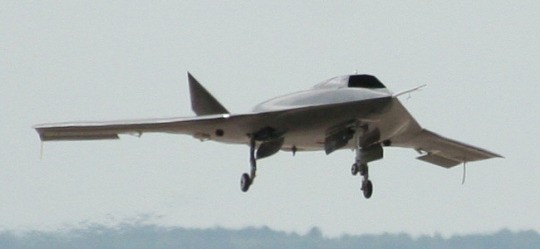
Following the successful testing of the Petit Duc, Dassault moved on to the 1/10 scale Moyen Duc. The Moyen Duc significantly changed the design of the Petit Duc, starting to take the shape seen on most modern UCAV designs. The cranked-arrow wing gave way to a diamond-shaped fuselage with swept outer wing sections, but critical elements of the design, including the vertical tails and engine intake, were retained. Whereas the Petit Duc was a stealth demonstrator, the Moyen Duc would test control systems. Taking flight in 2004, engineers would remove the vertical tails as testing progressed bringing them closer to their final design. Unfortunately, by then, the planned final design - the Grand Duc - had been cancelled in favor of the pan-European nEUROn UCAV.
Dassault/Sagem Slow-Fast
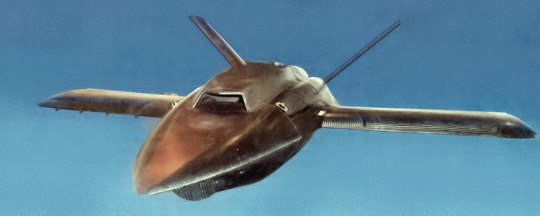
In 2004, Dassault began a joint project with Sagem to develop a tactical reconnaissance UAV to meet French Army requirements. Unlike previous tactical reconnaissance UAVs, which were generally simple, unstealthy machines with unimpressive performance, the specifications issued to Dassault/Sagem called for a low-observable design capable of operating at speeds ranging from 220 km/hr to Mach 1.6 with an endurance of three to four hours. Modular avionics were required, as was the ability to operate in any weather conditions. Making use of experience gained with the Moyen Duc, Dassault produced a radically different design to their UCAV proposals. The characteristic stealthy intake remained, but the Slow-Fast UAV had a clear fuselage with a V-tail and rectangular swept wings. A sensor package up to 50kg in weight could be placed in a ventral position under the nose, but there were no RCS-reducing features on the mounting. Though Dassault produced a design relatively quickly, the program wouldn’t last long - by the end of 2004, it had been cancelled.
BAE Systems Corax
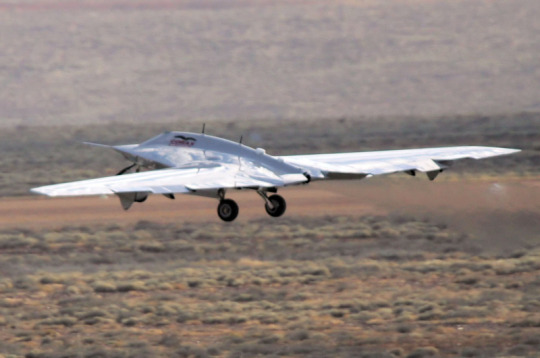
As part of cost-saving efforts, BAE also looked to make the Raven into a modular multi-mission design. In 2004, the Corax program began, adapting the Raven fuselage with a new high aspect ratio wing to create a strategic reconnaissance UAV. The new wing would preserve the stealth properties of the Raven, and, while the prototype would not feature anything special, ultimate plans called for the Corax to have conformal antennas mounted along the wings. Flight testing began in late January 2005, again in Woomera. From takeoff to landing, the Corax flew entirely autonomously. Unfortunately, the design would never enter production. It appears Corax development ended with the FOAS program. It, along with the Raven, would be revealed to the public in 2006.
Boeing X-45B/C
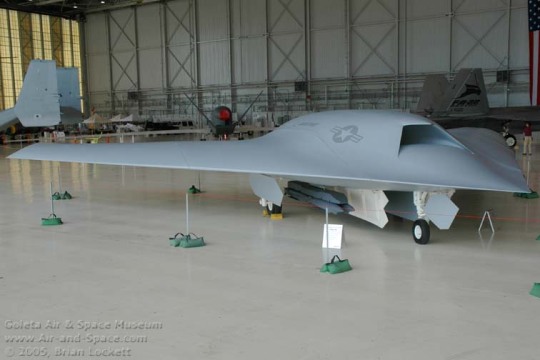
As a follow on to the X-45A, Boeing developed the significantly larger X-45B, which was then enlarged again as the X-45C. The X-45C’s most notable difference from the X-45A was the new wing, which extended the leading edge all the way to the nose to expand wing area. Boeing received funding for three prototypes, the first of which was scheduled to fly in 2006. Test schedules as laid out by Boeing called for the X-45C to demonstrate autonomous aerial refueling by 2010, among other things. However, the Air Force dropped the program when the J-UCAS was terminated in 2006. Boeing tried to salvage the X-45C by pitching a naval variant - the X-45N - to the Navy, but the contract went to Northrop Grumman instead.
Interim Bomber
Around the turn of the millennium, the Air Force recognized a looming capabilities gap with the bomber fleet. The next planned bomber program was scheduled to put a new bomber into service in 2037, but, with a significant portion of the fleet consisting of aging B-52s, this would leave a widening gap in the bomber fleet as time went on. To act as a stopgap, the Air Force looked for a cheap interim solution, aptly named the Interim Bomber. The Interim Bomber was to be a comparatively cheap and simple design making use of existing technologies to allow it to enter service by 2018. Official specifications were issued in 2004, but were met with little enthusiasm. Only Boeing, Lockheed, and Northrop would submit proposals. Although each company submitted several proposals, the most developed ones submitted would all be based off of existing platforms. In the end, the Interim Bomber never made it past the preliminary proposal stage - it was cancelled in 2006 in favor of the Next Generation Bomber program.
Lockheed FB-22
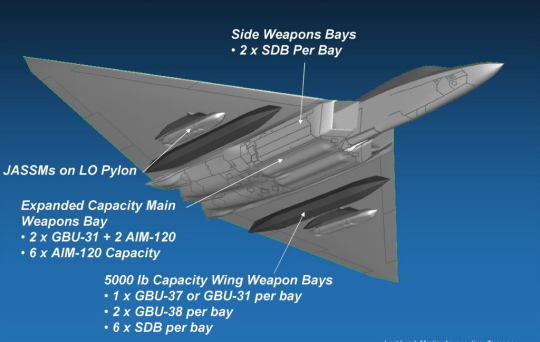
Lockheed’s most developed concept would be the FB-22. Derived from the F-22, the FB-22 began development in 2002, starting out as just an F-22 with expanded air-to-ground capabilities but radically changing over time. Initial concepts centered around an enlarged fuselage to make space for more weapons. The conventional planform of the F-22 was replaced with a semi-delta wing, with wing area increasing with each successive concept. The final concept used the stock F-22 fuselage, but enlarged the bomb bays by bulging the doors out. The largest wing yet proposed was to be mounted increasing payload and range, and stealthy external pods for various munitions were to be designed, bringing total payload of SDBs from 8 (on the F-22) to 30. Additionally, the expanded bomb bays allowed for larger bombs to be carried - while the F-22 was limited to 1,000lb JDAMs, the FB-22 would be able to carry the 5,000lb GBU-28 internally. Because supermaneuverability was not part of the requirements, the thrust-vectoring nozzles were eliminated. However, air-to-air capabilities remained. This came at the cost of supercruise abilities and top speed, but overall the concept was solid. Lockheed tried to keep the concept alive in the aftermath of the Interim Bomber’s cancellation in 2006 by pitching it to the Next Generation Bomber program, but it would be rejected and subsequently cancelled.
Northrop FB-23
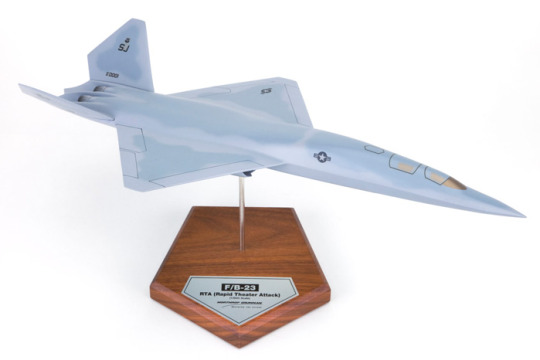
Northrop’s FB-23 was a more straightforward development of their failed F-23. Making use of the refined design they planned for the production F-23, Northrop enlarged the aircraft, bringing it to roughly 30 meters in length. The added drag would be compensated for by two Pratt & Whitney F135s or GE F136s (of the F-35), which were to be buried in the aft fuselage to preserve stealth. Projections with the more powerful F136 engine called for a top speed of Mach 2.4, making the hypothetical FB-23 even faster than the F-23. Diverterless supersonic inlets were used, further improving stealth characteristics. The distinctive humps for the engines seen on the F-23 would disappear, however, as the aft fuselage filled out to make space for fuel and payload. A crew of two seems to be planned, with crew sitting in tandem seating. The fate of the project is not known. It appears that Northrop didn’t follow Lockheed’s example and try to carry the design over to the Next Generation Bomber program, so the FB-23 was likely cancelled in 2006.
EADS Barracuda

Around the turn of the millennium, Germany and Spain came together to jointly develop a UCAV. A general design was settled on fairly quickly, with a stealthy twin-tailed platform with swept wings and a distinct fuselage, but details such as weight and role remained would vary. By 2003, a design for a five-ton machine optimized for precision attacks was finalized. A single jet engine would power the aircraft - now named Barracuda - fed by a dorsal intake. Work on a demonstrator began in secrecy in 2003. The avionics suite was designed with modularity in mind, and off-the-shelf components were used in many areas to reduce costs. Though not intended to be a production machine, the prototype was still fitted with various operational sensors in its payload bay. Taking flight in 2006, the Barracuda ran into problems fairly quickly when the prototype crashed in September. The program was put on hold for two years, resuming in 2008. Unfortunately, despite flying several years before the French and British UCAV demonstrators, the Barracuda program seems to be lagging behind. It remains a testbed and technology demonstrator, and there seems to be no talk of any production variant.
Lockheed Martin RQ-170 Sentinel
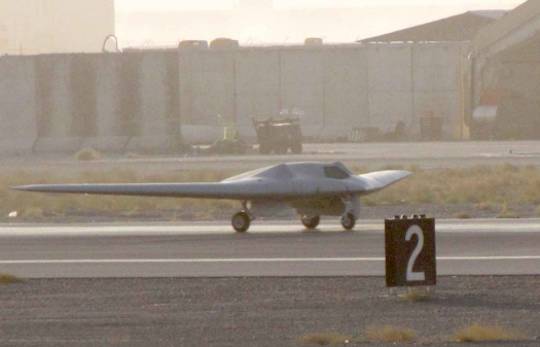
Though the RQ-3 proved a failure, it seems Lockheed’s efforts to develop a stealthy reconnaissance UAV weren’t entirely wasted. In 2007, the RQ-170 first flew in secret, entering service two years later. Not much is known about the RQ-170, but it appears to be a large flying wing design with engines placed on the upper side of the aircraft in a dorsal hump. On either side of the hump are two distinct bulges, likely filled with mission equipment. Onboard equipment includes an AESA radar and various systems for electronic intelligence operations. Navigation can be done either autonomously or through an operator on the ground, and a built-in failsafe is present to have the aircraft return to base if communication with the operator is lost. Little is known about the RQ-170’s operations, although they seem to be used heavily to support recent operations in the Middle East and Central Asia. One incident of note was the capture of an RQ-170 by the Iranians. Exact details of the incident are unclear - the USAF only stated that they lost contact with the machine, while the Iranians claim they hacked it to get it to land at their airfield.
Mikoyan Skat
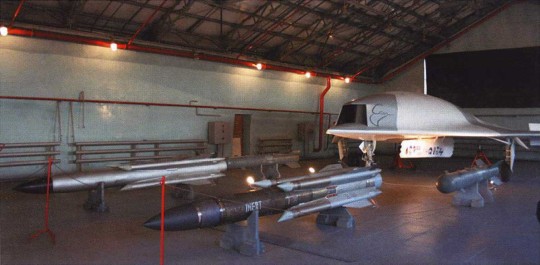
In 2007, Mikoyan would unveil a new UAV at the MAKS Airshow. Originally intended purely as a reconnaissance drone, it was a simple flying wing design with a dorsal RD-5000B engine. According to Mikoyan’s specifications, the Skat has a max takeoff weight of 11 tonnes, high subsonic top speed, and a range of 4,000km. Since the Skat’s first appearance at MAKS 2007, the design has morphed into a UCAV, with internal bays providing space for up to two tons of ordnance. In May 2013, Mikoyan signed a contract with the Russian government for development of a production aircraft based on the Skat. However, there has been no public reports about the program since then.
Lockheed Martin F-35 Lightning II

Following the selection of the X-35 as the JSF winner, Lockheed went to work on turning the design into the fully militarized F-35. As with the YF-22/F-22, the F-35 would change quite a bit from the demonstrator, although the basic design remained the same. Three main variants would arise - the conventional F-35A, STOVL F-35B, and carrier-capable F-35C. Fairly large limited production runs would be used in lieu of prototyping, allowing for more rapid testing and training, all while hopefully revealing the design’s teething problems before it actually entered service. The first of these limited rate initial production (LRIP) F-35s would be an F-35A, which first flew in December 2006. The F-35B would follow with a conventional flight in 2008 and hovering flight in 2009, and the F-35C would make its belated first flight in late 2011.
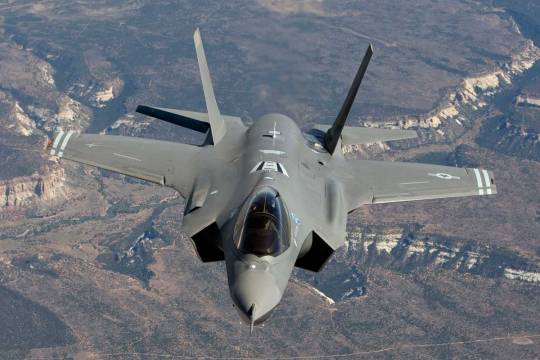
The most conventional F-35 variant - the F-35A - was designed around the Air Force’s needs. Powered by the same Pratt & Whitney F135 engine that propels all F-35 variants, it is the only variant to carry an internal gun (the 25mm GAU-12). The wings and tail are identical to the F-35B, but smaller than those on the F-35C. Because of the lack of the lift fan and carrier-capable airframe, the F-35A is the lightest of the variants, coming in at just under 30,000lb empty. Space saved by omitting the lift fan allows the F-35A to carry a fuel tank just behind the cockpit, as well as a receptacle for a refueling boom. Two internal bays provide space for up to 3,000lb of stores across four pylons, originally designed to accommodate a single JDAM and AMRAAM each. There are also provisions for six external pylons, bringing total possible weapons load to 18,000lb. Despite controversy over poor maneuverability, the F-35A has been designed to have superior maneuverability to the F-16 it replaces at combat loads, and its airframe is rated to the same 9G conditions of the F-16.
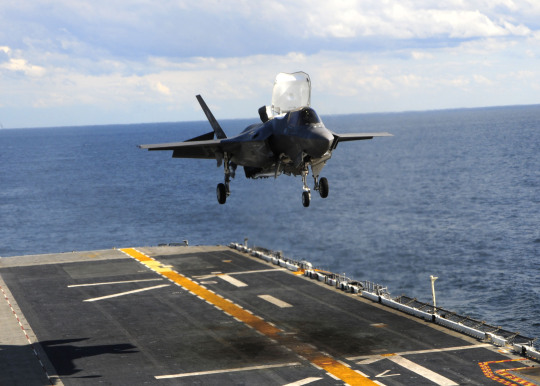
The STOVL F-35B is perhaps the most unusual of the variants. Though it is the same size as the F-35A, the addition of the lift fan increases empty weight to 32,000lb and cuts internal fuel capacity by about 4,000lb. It lacks an internal cannon, instead relying on an external pod to be mounted ventrally, and a retractable refueling probe replaces the dorsal receptacle of the F-35A. The addition of the lift fan creates a noticeable bulge behind the cockpit and forced a reduction in the size of the internal bays. Additionally, the F-35B is only rated to 7.5Gs and has a max takeoff weight 10,000lb less than the other variants. With the lowest internal fuel capacity of all variants, it also has the shortest range and combat radius. However, these deficiencies only seem bad when compared to the other variants rather than the aircraft it’s supposed to replace. The F-35B has a larger payload, longer combat radius, and far better performance in every aspect than the AV-8B, and without a doubt is the most capable STOVL platform ever to enter service.

The F-35C is designed for CATOBAR operations to replace the Navy’s F/A-18s. The most noticeable difference from other variants is the enlarged wings and tail and folding outer wing sections, which provide the aircraft with the best low-speed performance and handling of all the variants. The larger wings provide space for expanded fuel tanks, meaning the F-35C has the highest internal fuel capacity of all the variants, as well as the longest range and combat radius. Although it lacks the lift system of the F-35B and internal gun of the F-35A, the F-35C’s strengthened airframe and landing gear give it the highest empty weight of all variants at nearly 35,000lb. Like the F-35B, it’s reliant on an external gun pod for cannon armament, and a retractable refueling probe is mounted to work with the USN’s refueling practices. The Navy and USMC plan to replace their Legacy Hornets with the F-35C, but it will not replace the F/A-18E/F Super Hornets.
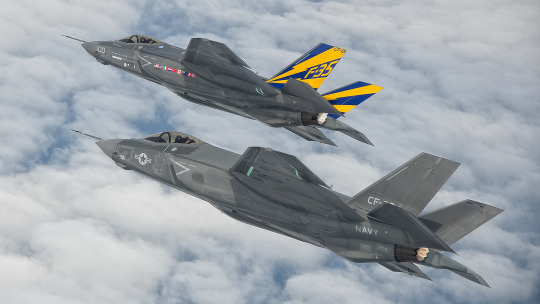
The real centerpiece of the F-35’s design, which remains common across all variants, is the software and avionics. Taking much of the F-22’s avionics to the next level, the heart of the F-35’s avionics suite is the AN/APG-81 AESA radar. Derived from the F-22’s AN/APG-77, it’s limited by the airframe’s size, giving it fewer T/R modules and limiting range to about two-thirds that of the APG-77. Placed around the airframe are six IR sensors, providing IRST detection and tracking capabilities in every direction. Under the nose is an electro-optical targeting system, which consists of a variety of optical sensors to provide everything from target designation to missile launch warning. As with the F-22, all the input from the F-35’s countless sensors is handled by an onboard computer. However, having been developed about a decade after the F-22, the F-35’s onboard systems are considerably more advanced.
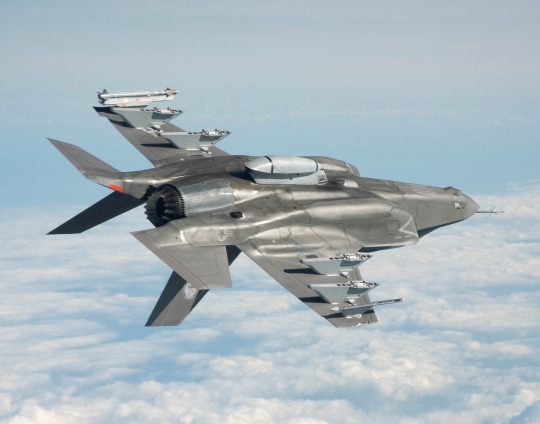
For all the hopes and promises of the JSF program, the F-35 has not been without controversy. The LRIP model of testing has led to very high per-aircraft cost in initial production runs, and the decision to mature so much technology with the program has revealed numerous problems, often requiring costly and time-consuming solutions. Even more controversially, the program had fallen behind schedule, forcing a major program reworking in 2010. Original plans called for the F-35 to enter service in 2010, but, as that date approached, it became clear that the F-35 was far behind schedule and over budget. The program was reorganized in 2010, calling for the F-35 to enter service in 2015. Despite all the controversy that has plagued the program, the F-35 seems to be doing well as of late. Costs have been dropping with every successive LRIP, and the program seems set to reach the planned production cost of $83 million per plane (F-35A). Even better, the F-35B reached IOC with the Marines in mid-2015, and it seems on schedule to enter service with the USAF by the end of 2016.

Unsurprisingly, the F-35 has attracted a significant amount of foreign attention. In addition to the US, orders have come in from Australia, Israel, Italy Japan, the Netherlands, Norway, Korea, Turkey, and the UK. Canada had also planned to procure F-35s, although the current Canadian administration has thrown that order into question. Currently, foreign orders are at 150 aircraft, while total planned foreign procurement may reach as high as 700 aircraft. With America planning to procure over 2,000 more F-35s, the F-35 looks well on its way to becoming the staple of Western air power for the next several decades.
Long Range Strike Bomber
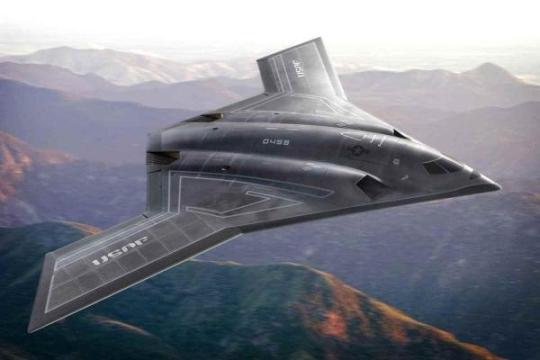
The Next Generation Bomber program that replaced the Interim Bomber would morph over the years into the Long Range Strike Bomber. Requirements had changed greatly, making the Interim Bomber proposals no longer feasible. With a focus on affordability, the LRS-B was to be a subsonic design with a unit cost of a little over half a billion dollars. Designs were to rely heavily on state-of-the-art stealth technologies, but, to keep costs down, manufacturers were reportedly encouraged to use many off-the-shelf components. Little is known about the specifications issued for the LRS-B, but the program generally seems to be calling for a comparatively small strategic bomber with a shorter range and smaller payload than the B-1 and B-2, but with far better stealth characteristics. Lockheed Martin would team up with Boeing as a subcontractor for the LRS-B, while Northrop Grumman would go it alone. Though no solid details have yet been released about either submitted proposal, Northrop Grumman was announced the winner of the LRS-B contract in late October 2015. However, Boeing responded almost immediately by challenging the decision, putting the program on hold until the validity of the decision to contract Northrop Grumman is proven.
Sukhoi PAK FA
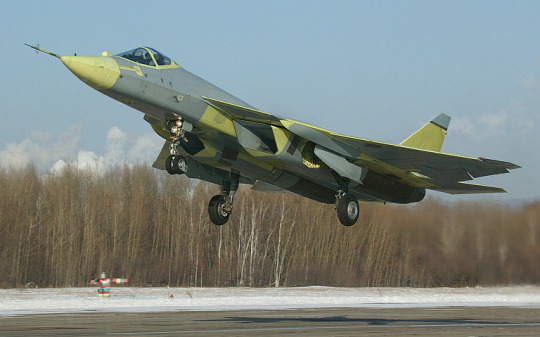
In 2001, the Russian government launched the PAK FA program, aimed at producing a fifth-generation fighter to enter service in 2010. Sukhoi was announced winner of the PAK FA contract in 2002 with their T-50 design. Though the T-50’s design could roughly be described as “a Flanker that someone sat on,” there isn’t much to indicate that it is in fact derived from the Su-27. The T-50 has broad trapezoidal wings with prominent movable leading edge root extensions and a wide, flat fuselage. Stealth shaping is notably present across most of the aircraft, although there are fairly obvious deficiencies with the exposed engine fairings, conventional exhaust nozzles, and exposed compressor blades. The AL-41F engines that power the aircraft feature three-dimensional thrust vectoring, although plans call for the production version to mount an improved powerplant. Two tandem weapons bays, each with a capacity of two long-range missiles, are placed in the fuselage tunnel, while a bay in either wing root provides space for a single short-ranged AAM. In addition to air-to-air loadouts, the T-50 is also capable of deploying various guided and unguided air-to-ground munitions.

As with most other fifth-generation fighters, the centerpiece of the T-50 is its avionics suite. The Sh121 radar system is the main component of this, consisting of an N036 X-band AESA radar in the nose with over 1,5000 T/R modules as well as side-facing N036B AESA radars with 358 modules each on either side of the forward fuselage. L-band transceivers are also placed on the leading edge root extensions, intended to handle IFF and EW duties. The inputs of the various radars will be processed by an onboard computer to reduce pilot workload and provide more useful information to the pilot. The prominent IRST on the nose is part of the 101KS electro-optical system, allowing the T-50 to detect and track multiple targets without the use of radar. A datalink system will allow the aircraft to transmit and receive targeting information between other aircraft and ground stations. Countermeasures include the L402 suite, which has arrays mounted in the tail stinger and makes use of the N036 radar system, as well as various infrared warning and countermeasure systems.

Not too surprisingly, the PAK FA program fell behind schedule. The first flight of the prototype was scheduled for 2007, but unspecified technical problems and engine issued delayed testing for three years. The first T-50 finally took flight in early 2010, but it lacked combat avionics. The second prototype was similarly delayed, with its first flight pushed back from 2010 to 2011. The third and fourth aircraft, with most of their systems installed, would take flight more on schedule in 2011 and 2012. In early 2014, the first aircraft was delivered to the state for acceptance tests. Testing has been slow, and continuing technical issues have hampered the program. In June 2014, the fifth prototype was severely damaged in an engine fire, although it would be repaired and returned to service.
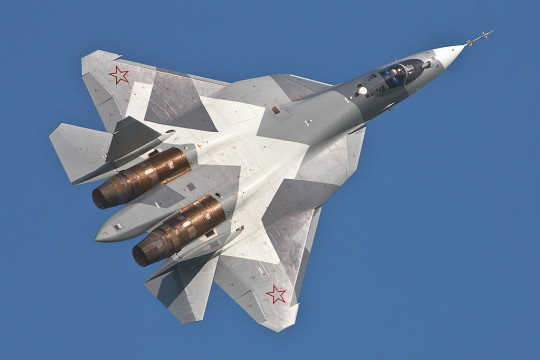
Unfortunately, the future for the PAK FA isn’t looking good. Sukhoi has made efforts to market the aircraft abroad, contacting South Korea, India, and Brazil. Only India would accept Sukhoi’s offers, taking part in a joint development program. However, India has raised doubts about the program, though they officially remain a partner in the program. Meanwhile, the Russian order for the aircraft has dropped. Plans originally called for an initial production run of over 50 aircraft to be delivered by 2020, but more recently the VVS announced that its initial order will be reduced to just 12 aircraft, with subsequent production pending based on the results of operational trials. The PAK FA does seem to have potential, particularly if it works as advertised by Sukhoi. However, ever-shrinking production orders, near constant delays, and an increasing amount of resistance on the part of the Indian government isn’t exactly inspiring confidence in the PAK FA’s future.
Northrop Grumman X-47B
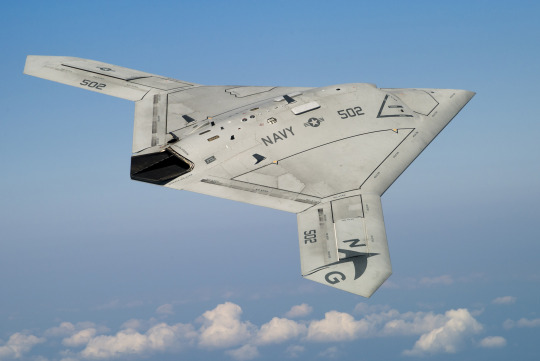
Although the J-UCAS was terminated in 2006, the Navy chose to continue UCAV development. Boeing and Northrop Grumman would re-submit proposals for the new UCAV program, and in 2006 Northrop Grumman’s X-47B was selected as the winner. The X-47B generally preserved the lines of the X-47A, but it made use of a stealthier engine outlet and had outer wing sections extending beyond the diamond shaped fuselage. The X-47B was significantly larger than the X-47A (20 ton max takeoff weight as opposed to 2.6 tons), and it featured folding wings, carrier arrestor gear, strengthened landing gear, and internal bays for up to two tons of ordnance. The first of two prototypes was rolled out in 2008, but the scheduled first flight was delayed until late 2011.
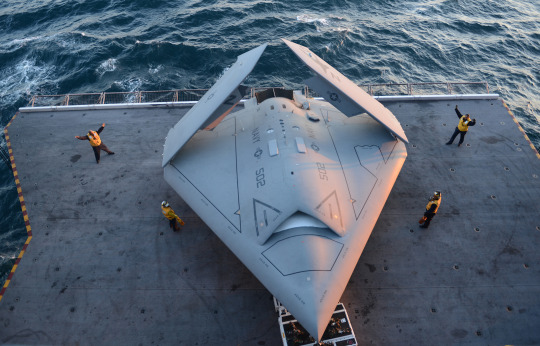
Testing of the X-47B would go smoothly. Airworthiness tests were ended early due to excellent flying qualities, and in mid 2012, preliminary testing for carrier suitability began on land. In late 2012, the first land-based catapult launch occurred. Deck testing found the X-47B to be excellently suited to operations on a carrier, and in May 2013, the X-47B made the first ever catapult launch from a carrier. That July, the first ever landing of a UAV on a carrier at sea occurred. In April 2015, the X-47B again made history when it made the first ever fully autonomous aerial refueling. By the time the X-47B program terminated in mid-2015, the aircraft had blown through all evaluations, even the difficult carrier trials. Though the design has proven incredibly solid, the decision was made to run another design competition for a production UCAV to enter service.
Boeing Phantom Ray
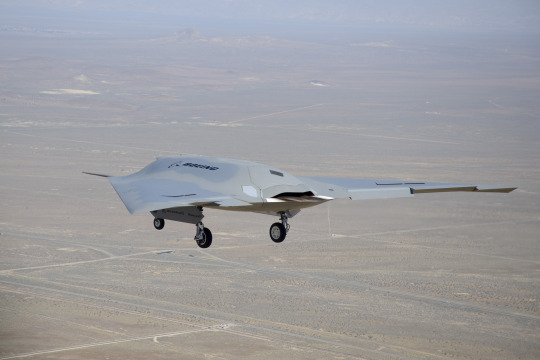
After the cancellation of the X-45C, Boeing would commence an internal project for a new UCAV. Roughly derived from the X-45, the new project, known only as Phantom Ray, is not aimed at any particular military program, although Boeing seems to be marketing it for the wide variety of roles the cancelled J-UCAS called for. The Phantom Ray would fly for the first time in April 2011 after being flown to the test site on the back of a Boeing 747 Shuttle Carrier. Being marketed for a wide variety of roles, it is likely that the Phantom Ray or a derivative of it will be Boeing’s contender for an eventual Navy UCAV competition. However, for the time being, it seems that the Phantom Ray is a prototype without a customer.
Chengdu J-20
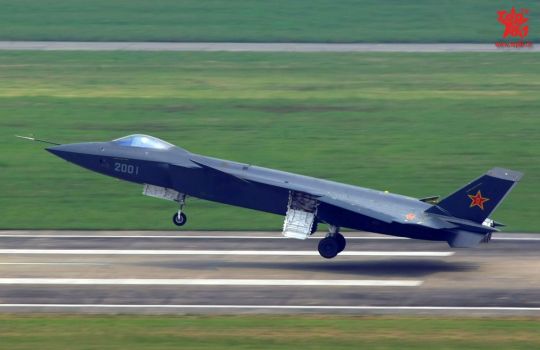
Development of China’s first indigenous stealth fifth-generation fighter can be traced all the way back to the 1990’s, when the PLAAF began the J-XX program, aimed at creating a next-generation fighter in the same class as the F-22. Design goals were roughly similar to those of the American ATF program, calling for a fighter with stealth, supercruise, supermaneuverability, and short-takeoff capabilites. Shenyang and Chengdu would both produce designs, with Chengdu apparently winning the resulting competition and having their design ordered into production as the J-20. The J-20 they produced seemed to share much with the cancelled J-9VI rather than any foreign designs. With a twin-engined delta-canard layout and twin tail, the J-20 refined the bulky shape of the J-9VI to improve aerodynamics and stealth. Diverterless supersonic inlets lay on either side of the nose, and the wings and canards were shoulder-mounted. A wide, flat body provides space for an internal weapons bay and serpentine inlets, intended to obscure the engine compressor blades.
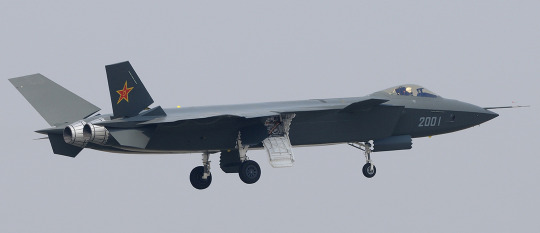
Given that information on the J-20 is tightly controlled, all the information on the aircraft we have is either speculation or ever-reliable Chinese state media reports. The design is clearly unstable, requiring a fly-by-wire control system to ensure adequate control. This, along with the prominent leading-edge root extensions, twin-tails, and canards, ideally would let the J-20 meet the PLAAF’s supermaneuverability requirements. The J-20 reportedly features a glass cockpit and an AESA radar, and later prototypes were fitted with what appears to be an IRST/EOTS system. The forward-aspect stealth characteristics of the J-20 seem to be solid, although stealth qualities seem to be lacking in other areas, particularly in the rear. Though the canards have faced criticism for hindering stealth, it’s likely that they are carefully designed and controlled to minimize their adverse impact. For all China’s efforts to talk up the J-20, it is not without some obvious deficiencies. Currently, prototypes are flying with the WS-10/AL-31F engine, and, although China is working on the WS-15 engine that has performance in the same class as the F-22’s F119, producing state-of-the-art engines seems to be an endemic issue with the Chinese aerospace industry. More glaring is the armament - the large size of Chinese AAMs means that the J-20 appears to only be able to carry four AAMs internally (two long-range and two short-range).
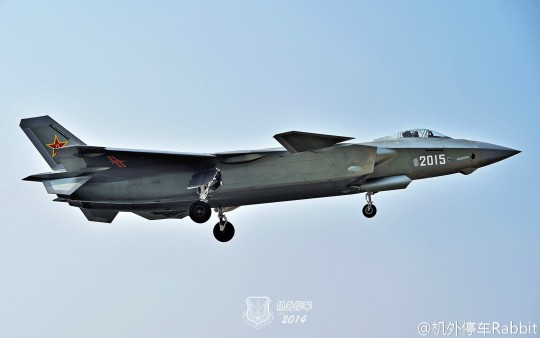
Though the J-XX program was revealed to the public in 2002, the existence of the J-20 was a secret until the prototype’s first flight in 2011. Each successive prototype seems to be more refined than the last. A prototype revealed in 2012 showed the presence of a new radome, and what appear to be pre-production machines feature noticeably redesigned tail surfaces, and EOTS, and what appears to be a new RAM coating. During at least one test, a J-20 was spotted sporting what appears to be a Luneberg lens, implying that the Chinese are satisfied with the stealth characteristics of the new fighter. In the latter half of 2015, an even more refined prototype was revealed, this time with new intakes and major revisions to the rear fuselage. At the end of 2015, a new prototype was revealed, appearing to be the first low-rate initial production J-20. Just when the PLAAF plans to put the J-20 into service is unclear, but it will likely enter service before the decade is out.
Shenyang J-31/FC-31
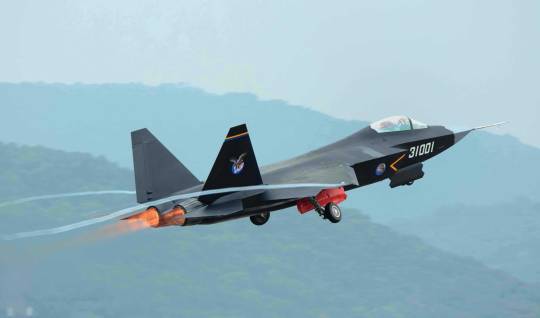
In 2012, another Chinese stealth fighter was revealed to the world when it first flew in October. Unfortunately, if the PLAAF seemed secretive about the J-20, they were even more so with this new fighter, reportedly designated the J-31. The J-31 uses a more conventional configuration than the J-20, in many ways resembling a twin-engined F-35. Far smaller that the J-20, it apparently is powered by two RD-93 turbojets (as seen on the MiG-29), though plans call for the production version to use the domestic WS-13A engine. Armament layout is different than the J-20, with two internal bays being configured for two PL-12 medium-ranged AAMs each. Models displayed publicly have also shown the J-31 with two external hardpoints on either wing.
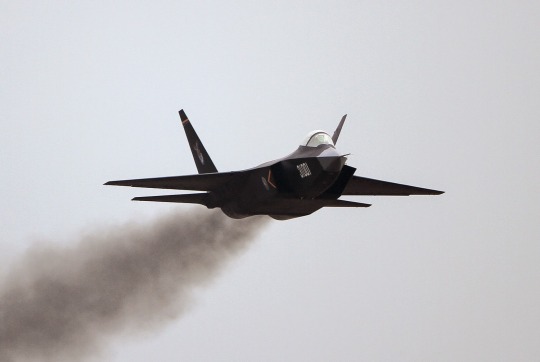
With so much secrecy surrounding the J-31, even its intended role is unclear. Early speculation centered around the J-31 being intended for carrier operations - a theory supported by the twin-wheel nose undercarriage and compact size - while others suggest that it’s aimed at export. Even official reports are unclear on this note. Engineers from Shenyang have hinted towards the fighter being navalized at some point, while AVIC - the consortium in charge of Chinese aerospace industry - has said only that it’s intended to compete with the F-35 on the export market. However, with so little known about the aircraft, just how successful it will be is in question. Only one prototype has been revealed to the public, and, during public demonstrations, it seemed to struggle to sustain turns - a symptom of its apparently underpowered engines. With the aircraft’s success dependent on the ever-problematic domestic engine development, the J-31’s entry into service - or the export market - might still be quite far off.
Dassault nEUROn
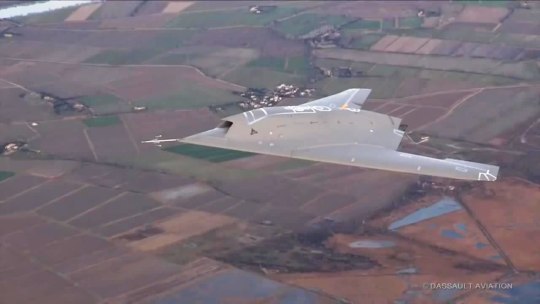
Though the Dassault UAV program was going well, there was a great drive within the French Air Ministry to form a cooperative program to reduce costs. At first, they looked to Britain, but they refused, as they were already participating in a similar program with America. Similar efforts with Germany were met with failure due to financial reasons. Ultimately, a deal was announced in 2003 between Dassault, EADS France, and Thales, and the project name was changed to nEUROn. Dassault would lead the project, subcontracting out to the various partners. Sweden, Greece, Italy, Switzerland, and Spain would eventually join in on the project. As Dassault worked to get partners for the project, the nEUROn design morphed. Originally intended to be a twin-engined, five-ton machine, gross weight rose to 7 tonnes, and just a single Adour engine (to be replaced by the Snecma M88 on production variants) was planned to be used.
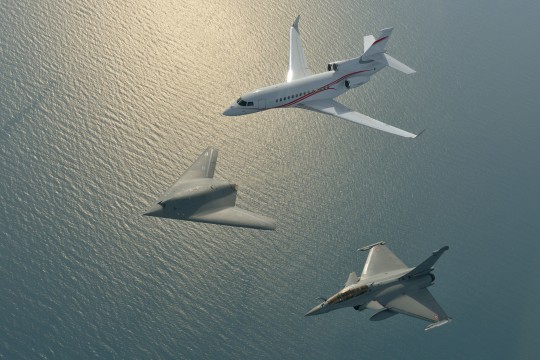
The nEUROn would first fly in December 2012. Initial flight trials, which evaluated stealth characteristics and the flight envelope, took three years. During that time, an agreement was signed with BAE Systems to combine experience for a future pan-european UCAV that would combine elements of the nEUROn and Taranis. After successful testing in France, it was transferred to Italy, where sensor testing took place. The final leg of testing will take place in Sweden, where the nEUROn’s combat capabilities will be tested. The nEUROn demonstrator that is flying in testing seems to be little more than a technology demonstrator. Although it can carry a payload of bombs, it is limited to just two 500lb guided bombs by its small bomb bays, so practical applications are comparatively minimal. However, Dassault plans to derive a series of combat-capable UAVs from the nEUROn design, and the Anglo-French agreement reached in late 2014 seems to show promise for a practical UCAV to enter service in the near future.
BAE Systems Taranis
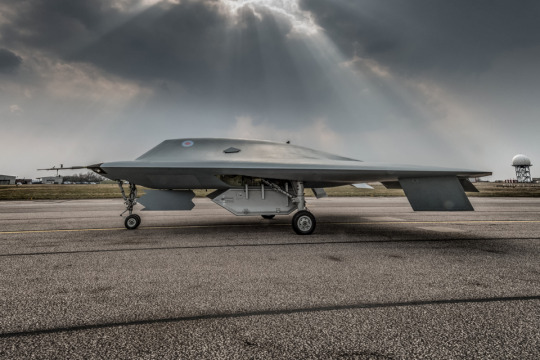
In 2005, the FOAS program gave way to the Strategic UAV Experiment. Abandoning the prospect of manned fighter development, the British settled on a domestically-designed stealth UAV to meet their strike needs. BAE went to work, making use of the Raven design they had carefully crafted for the FOAS. To reduce program risks, BAE from the outset planned to develop the aircraft for at least 10 years before the final design entered production. The new design, designated Taranis, was significantly larger than the Raven, and it featured several refinements like a new stealthy nozzle for the engine. With a max takeoff weight of 8,000kg, it features two internal weapons bays and is designed to operate entirely autonomously. A contract for technology demonstrator prototypes was placed in late 2006. Work began on the prototype in 2007, and assembly took place the next year. Despite reports of the Taranis flying in 2009, it would not fly for several years.
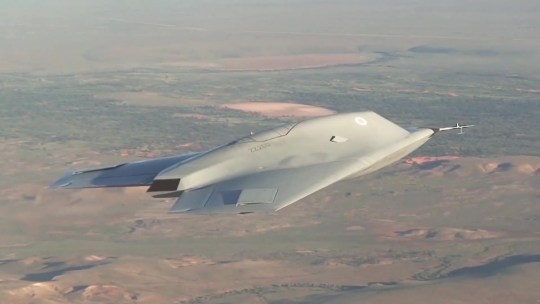
Finally revealed to the public in 2010, the Taranis program would be heavily delayed for flight testing. Planned to take flight in 2011, it was delayed progressively over the next two years, until it finally took flight in 2013. Unfortunately, the program delays have caused cost overruns and pushed back the planned service entry date. Original hopes of getting the Taranis in service by 2020 have been dashed, with current projections now looking at getting the UCAV in service post-2030. Despite initial reservations over cooperation with the French, the British came to an agreement with Dassault in 2014, signing a development contract for a joint European UCAV that will combine components of the Taranis and nEUROn.
Saab Flygsystem 2020
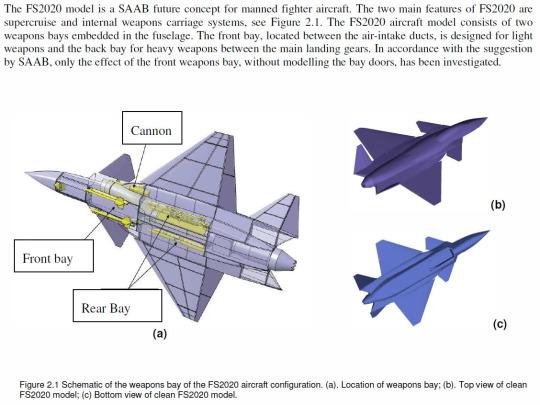
Although the JAS 39 Gripen is currently the mainstay of the Swedish Air Force, the looming obsolescence of the type, has caused the Swedish Air Force to begin a program to develop a replacement. Aimed at reaching service in 2020, when the Gripen is projected to be obsolete, the FS 2020 has apparently gained little traction within a Swedish government consistently slashing defense budgets. Though there is little official information out about the program, it seems that Saab has contracted Linköping University to study a preliminary design. A 13% scale remote-controlled testbed would fly in 2009, intending to show the viability of a modern light fighter in the same class as the Gripen. According to the model the university was working with, the FS 2020 would be a single-engined design with heavily canted vertical stabilizers, canards, and internal bays for two short-ranged and four medium/long-ranged AAMs. Unfortunately, the fate of the FS 2020 program is unknown, and, given recent trends with Swedish defense spending, it seems increasingly likely that such an aircraft will never materialize.
Mitsubishi ATD-X Shinshin
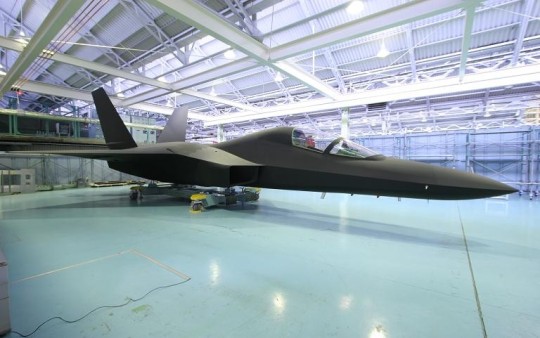
With Japan looking to procure a replacement for their F-15s, but blocked by Congress from purchasing F-22s, the JASDF was forced to look for a domestic solution. Around the turn of the millennium, Mitsubishi began work on a sub-scale technology demonstrator to mature technologies for a domestic stealth fighter, tentatively designated F-3. The Advanced Technology Demonstrator - X, as the demonstrator is known, took shape fairly quickly as a conventional twin-tailed, twin-engined design vaguely similar in appearance to the F-22. The IHI XF5-1 turbofan was developed to power the design, while a fly-by-optics (where fiber optics replace wires) was developed for control systems. Control is to be managed by a combination of traditional flight surfaces and three-dimensional thrust-vectoring, using three paddles on either engine nozzle similar to that seen on the Rockwell X-31.
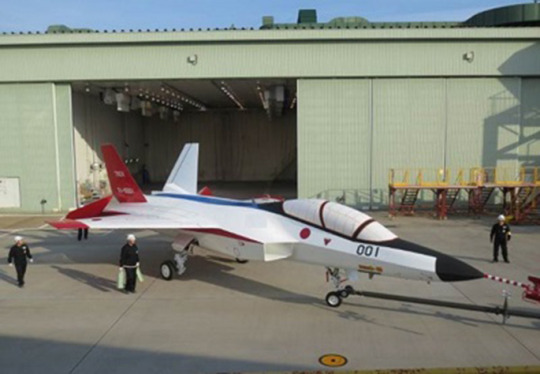
In 2006, a 1/5 scale remote-controlled prototype was flown to validate the design and gather data on performance at high angles of attack, as well as test the in-flight damage detection systems under development. With the basic design validated, a full-scale prototype - about the size of the Gripen - was commissioned. Meanwhile, development of systems for the final product, including and advanced AESA radar and engines, began. Full-scale structural testing reportedly began in 2012, and in 2014, official pictures were released of a prototype reportedly used for ground testing. A prototype is reportedly scheduled to fly in 2016, and, if all goes well, Mitsubishi hopes to have a prototype for the F-3 flying by 2018, and production of the final design to begin in 2027.
Hindustan Aeronautics Limited Advanced Medium Combat Aircraft
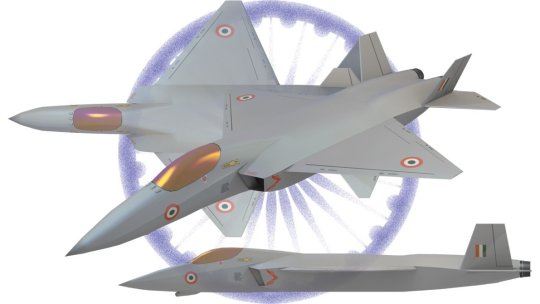
India’s domestic fifth-generation fighter program evolved out of the Medium Combat Aircraft program, aimed at replacing a diverse, aging fleet of aircraft with a single modern multirole. In 2008, detailed studies began, and by 2010, specifications had been issued to HAL and the program was named the AMCA. The design settled on in 2013 would be a twin-engined, twin-tailed conventional aircraft similar in appearance (albeit significantly smaller) to the F-22. Final specifications put it at a max takeoff weight of 29 tonnes with 2 tonnes of internal payload across eight hardpoints, 4 tonnes of internal fuel, and a top speed of over Mach 2. Engines are intended to be of domestic design, although India has been looking for a partner to jointly develop a powerplant. Currently, the biggest obstacle in development is technology limitations. Lacking the domestic experience for modern fighter development, India has been working hard to develop the skills to create a competitive fifth-generation fighter, both through projects like the LCA/Tejas, as well as securing technology transfer with foreign procurement programs like the MCA and PAK FA/FGFA. If all goes according to plan, two technology demonstrators and four of seven prototypes should begin testing in 2019.
Korean Aerospace Industries KF-X
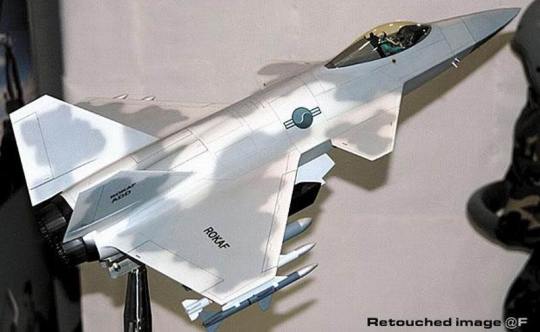
In 2008, South Korea began efforts to develop an indigenous next-generation fighter. Such an ambitious undertaking would be costly, so KAI looked abroad for support, reaching a partnership with Indonesia in 2010. With fairly modest design goals for an aircraft more capable than the Block 50 F-16s currently in Korean service, the KF-X is proposed to be a twin-engined fighter about 10 tonnes gross weight. To keep development costs down, stealth goals for initial production versions are modest - aiming for an RCS similar to the Typhoon or Super Hornet. Later versions are intended to improve upon this, adding internal weapons bays and improving stealth characteristics through better shaping and the application of RAM, bringing it more on par with the F-117 and eventually the F-35. However, no timeline has been been discussed for these later upgrades. Current plans call for six prototypes to fly 2025, but the Korean/Indonesian consortium has yet to finalize the design. Currently, two proposals are on the table, both with similar specifications, but one being conventional in layout with the other using canards. Though the program has hit obstacles early on, it seems to be on track more recently. In late December 2015, a deal with Lockheed Martin was signed, transferring F-35 related technologies for the KF-X program. With such progress made, the KF-X increasingly seems set to materialize on schedule.
Turkish Aerospace Industries TFX
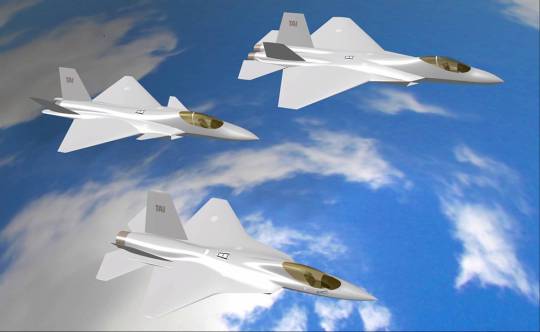
In 2010, Turkey announced a program to develop an indigenous fighter with the intention of replacing the F-16 and supplementing a fleet of F-35s. Three years of preliminary design work occurred, and in 2013 Turkey announced a partnership with Saab for assistance on their project. However, this has since fallen through, and in late 2015 TAI reached a new agreement with BAe for technical assistance. Three preliminary designs have been produced - a single-engined delta-canard proposal and two conventional designs, one with a single engine and one with two engines. All designs incorporate stealth features and internal weapons bays, and are projected to have supercruise capabilities, a domestically developed AESA radar, and various domestic and foreign avionics systems. The powerplant will not be of domestic design, with Turkey contacting General Electric, Pratt & Whitney, and Eurojet for powerplant proposals. In early 2015, it was announced that a derivative of the EJ200 engine (as used on the Eurofighter Typhoon) would be used on the TFX. The design is yet to leave the drawing board, but Turkey plans for it to enter service by 2025.
14 notes
·
View notes
Text
/k/ Planes Episode 90: Strike Fighters
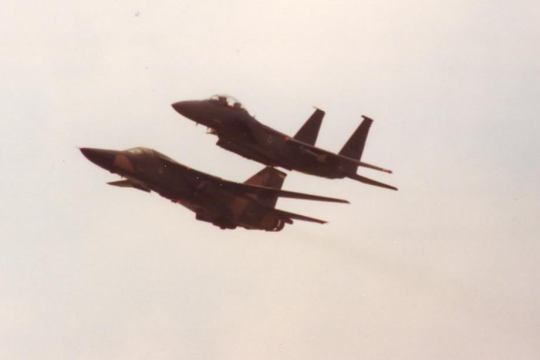
It’s time for another episode of /k/ Planes! This time, we’ll be looking at strike fighters.
The term “strike fighter” tends to be vague and hard to distinguish from fighter-bombers and light bombers, but for my purposes a strike fighter is going to be a light bomber with fighter-like performance but negligible focus on actual fighter duties. Although a similar class of aircraft existed during the Second World War (dive bombers), the strike fighter as we know it today didn’t really come into existence until the decade after the war. In the ‘50s, engineers the world over began producing a new class of high-performance fighter-bombers. Generally intended for precision strike (often with nuclear weapons), strike fighters consequently would be some of the most advanced aircraft of their time. Although improving technology would gradually make multiroles more viable, the strike fighter concept would survive through the end of the Cold War. Unfortunately, although strike fighters continue to fly with operators across the world, there doesn’t seem to be any development of new ones. Slashing budgets have made multiroles far more attractive, and, thanks to advances in electronics, fewer design sacrifices are necessary for an effective multirole. Thus, though aircraft like the F-35 may carry the Joint Strike Fighter name, they are less strike fighters and more all-purpose combat aircraft.
Saab A 32 Lansen

In 1948, the Swedish Air Board started the development of a new jet-powered attacker. Specifications called for an all-weather aircraft armed with four 20mm cannon plus underwing stores. Originally, Sweden wanted the aircraft to be powered by a domestically designed engine, but when the powerplant suffered delays, the Rolls-Royce Avon took its place. SAAB’s final design was considerably more graceful than the Tunnan before it. Fitted with a low-mounted 35-degree swept wing, it had intakes on the sides of the fuselage to make space in the nose for a navigation radar. The crew of two was placed in a tandem cockpit, with the navigator sitting in the rear seat. Notably, it was compatible with the Rb04 anti-ship missiles, of which it could carry two. Four prototypes were ordered, and the aircraft was given the designation A 32. The first prototype would take flight in November 1953, and within a year it was ordered into production.
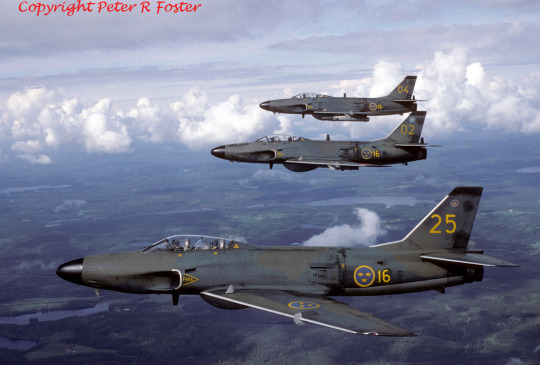
The Lansen, as the A 32 was known, would enter service in 1955, growing in numbers until they equipped twelve squadrons. Although designed with an attack radar, only a quarter of A 32As would carry the system. During operations, a radar-equipped Lansen would lead the rest of the aircraft in its flight while navigators were omitted from the radar-less aircraft. SAAB would also create an all-weather fighter variant of the Lansen (J 32B), replacing the nav/attack radar of the A 32 with an air-intercept radar and computerized fire control system complete with radar gunsight. Originally, stores pylons were fitted with 75mm unguided rockets but the J 32B would later be modified to carry AIM-9 Sidewinders. The J 32 would come into service in 1958, flying with a total of seven squadrons. As with the Tunnan, SAAB also produced a reconnaissance variant of the Lansen for night operations. Changes were limited to a redesigned nose featuring a modified radar and cameras in the place of the cannons.

As with the Tunnan, the Lansen was prone to accidents, losing a third of their number during service. As Sweden began its nuclear program, the Lansen was slated to carry tactical warheads, although no such weapons were ever carried. As Sweden’s last purpose-built attacker, the Lansen’s career was short-lived. The Viggen began to replace the Lansen in 1971, and the J 32 would be the first variant to leave service. The A 32 and S 32 would stick around longer, finally leaving service in 1978. In 1972, 15 J 32s were modified as jammers, receiving the designation J 32E. While other Lansens left service, the J 32E remained in its niche role. Flying in both operational and training roles, the Lansen jammers would stay in operational service until 1997.
Sukhoi Su-7 “Fitter”
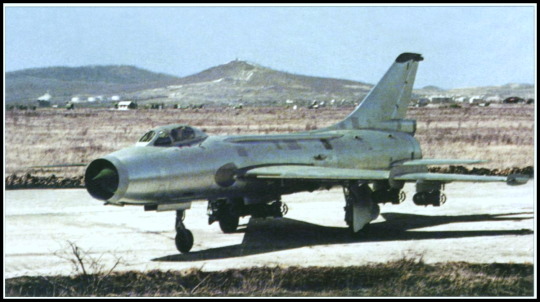
Just a month after the death of Stalin, the Sukhoi OKB was revived, and by the summer, had been assigned two projects - one for a frontline tactical fighter, and another for an interceptor, both using the Lyulka AL-7F engine. Sukhoi’s two designs were fairly similar - a stovepipe fuselage with mid-mounted wings - differing mostly in the wing arrangement. The S-1, as the preliminary design for the Su-7 was known, used highly swept wings, intended to improve low-altitude handling compared to the delta-winged interceptor counterpart. Development proceeded quickly, and in September 1955, the S-1 prototype took flight. While testing found the AL-7F to be troublesome, the aircraft itself was by no means underperforming - the S-1 shattered the specifications, flying over 2,000km/h during tests. Testing concluded in 1956, and the aircraft was ordered into production as the Su-7.

Initial production of the Su-7 was slow. Minor changes were made to the production variants, including the introduction of the recently-discovered area ruling, but production remained low as the VVS’s priorities shifted towards replacing their aging fleet of shturmoviks. As Su-7 testing concluded, the VVS redirected development towards adapting the Su-7 for such a role. Sukhoi refined the design, adding six hardpoints for up to 2,000kg of stores, and strengthening the airframe to better handle the low-level operations. The Su-7B, as it was known, took flight in 1959.
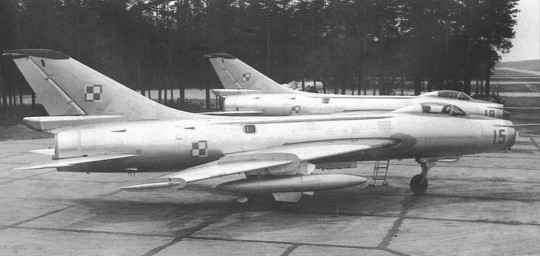
While the Su-7B was rushed into service, numerous issues were found. As with many Soviet fighters, range and endurance were almost cripplingly short. To extend range, drop tanks became almost a permanent fixture on the aircraft. Again a common trend with second-generation Soviet fighters, takeoff and landing speeds were very high. Blown flaps and JATO systems were experimented with, but the issue would persist until the development of the Su-17. In spite of the issues, however, the Su-7 was far from a poor design. A fast, stable weapons platform, it quickly became the mainstay of the VVS’s tactical strike force, and was a popular export product.

While the Su-7 saw no combat by the VVS, it proved its worth in foreign hands. Egypt found them to be excellent strike aircraft after the 1967 war, able to fly in, drop bombs, and escape before the IAF could scramble interceptors. Egypt’s Su-7s remained in service until the ‘80s, continually upgraded to stay competitive. India also used the Su-7 heavily, flying 1,500 sorties with the type in the 1971 Indo-Pakistan War without a single loss - even when two were hit with Pakistani AIM-9s. In the end, despite its peculiarities, the Su-7 had proven to be Sukhoi’s greatest success to date.
Republic F-105 Thunderchief

In 1951, Republic began work on a private venture strike aircraft to replace the F-84F Thunderstreak. The design started as a development of the F-84F, stretching it to accommodate a bomb bay for a tactical nuke and a J71 turbojet. Intakes were moved to the wing roots to make space for advanced avionics in the nose, and pylons were added under the wings to allow the aircraft to carry new ASMs and AAMs. The USAF showed interest at first, placing a tentative order in 1953 for 199 aircraft. However, shifting requirements killed the program briefly, only for it to be revived again in 1954, receiving a solid order for 15 pre-production machines. The aircraft, now designated YF-105, would take to the skies for the first time in October 1955. The massive aircraft had comparatively small wings, hurting agility but ensuring a smooth ride at low altitudes. Plans had since changed to call for the J75 turbojet, but the engine was not available by the time the prototype was ready, so a J57 was substituted. Despite the downrated thrust, the YF-105 had impressive performance, being capable of reaching Mach 1.2.

Though the two YF-105 prototypes would suffer landing accidents, Republic went ahead with the pre-production F-105Bs. The F-105B featured several changes. Apart from using the originally intended powerplant, the F-105B was given the characteristic forward-swept variable-geometry intakes that would become a defining feature of the design, and the newly discovered area rule was applied to the fuselage. The F-105B would enter service in 1958, quickly proving to be a maintenance nightmare. The complicated electronics were unreliable and the hydraulics lacked any backups, and initial production aircraft were found to require 150 hours of maintenance per flight hour. Gradually, the USAF brought the fleet’s serviceability up, improving the F-105’s reputation. Production F-105Bs were fitted with a M61 Vulcan cannon in the nose as well as five hardpoints for 4,000lb of stores and a bomb bay for a further 8,000lb. The avionics package included a fire control system complete with ranging radar and gunsight, as well as an automated toss-bombing system for low-level nuclear attack. Despite its impressive payload capacity, the Thunderchief’s intended payload was actually quite small - just a single Mk 28 or Mk 43 tactical nuke carried in the bomb bay. In all, F-105B production was brief - just 75 were built. Republic had almost immediately begun work on an improved all-weather variant - the F-105D, which would come to be the definitive production variant of the aircraft.
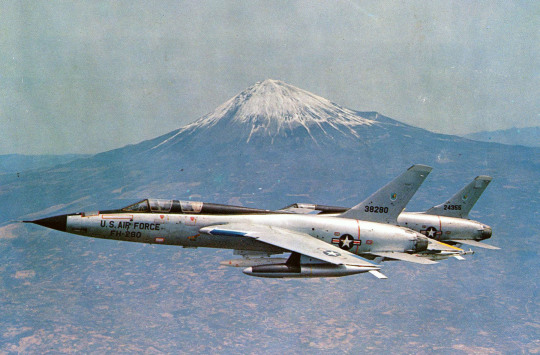
The F-105D was notable off the bat from its significantly enlarged nose. A multimode radar allowed for air-to-air, air-to-ground, and terrain-following capabilities, and a new nav/attack system was installed. The cockpit was also reworked to use easier to read dials. The new avionics forced the cannon to be pushed back and offset more to the side. A new engine complete with water injection was also added, as was an arresting hook and strengthened gear to prevent the fighter from overshooting the runway in emergencies. The first F-105D took flight in June 1959, entering service in 1961. Although the USAF had cancelled plans for the two-seat F-105E, they would reverse their decision once the F-105D entered service, ordering the F-105F. The F-105F featured a larger tailfin and stretched fuselage to accommodate the second seat, and it was built to the same standards as the latest F-105Ds. Production ended in 1965 with over 800 F-105s of all types built.

Just as the Thunderchief production lines shut down, the F-105 was called into action for the first time. In 1964, a squadron of Thunderchiefs was deployed to Thailand. Though officially there to provide cover for air rescue operations, they in fact were flying strike missions into Laos. Not long after they arrived, on August 14, the first F-105 loss occurred when a Thud, heavily damaged by ground fire, was written off after an emergency landing. After six months of operations the lone Thud squadron in Thailand was joined by several more. Secret strikes into Laos continued into 1966, but they were soon eclipsed by a greater campaign. In February 1965, in retaliation for a VC attack on a US camp in South Vietnam, F-105s formed the backbone of the USAF component of the Operation Flaming Dart strikes. The next month, Operation Rolling Thunder had kicked off with a not-so-inauspicious start. On the very first day of the campaign, three Thuds were lost and the North Vietnamese seemed unphased.
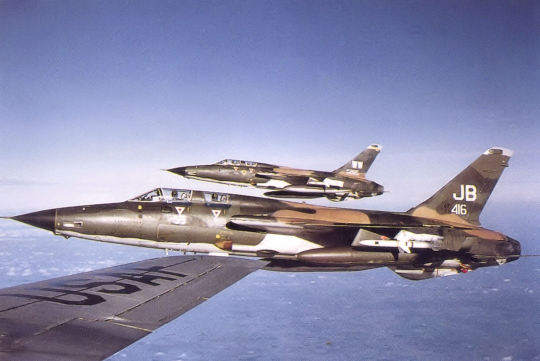
As Rolling Thunder kicked into full gear, the Thud found itself on the forefront of the campaign. Missions were far from the tactical nuclear strikes the aircraft was originally designed around, instead involving large formations of Thuds heavily laden with conventional bombs. Though it allowed the Thud to to quite a bit of damage to targets, the added drag cut the F-105’s performance so much so that even the aging MiG-17s of the VPAF could easily outrun them. Though the F-105s never flew without escort, the VPAF soon learned they could force Thuds to jettison their bombs and abort the mission by making use of ambush tactics. Fortunately, losses from these attacks were comparatively low, as the F-105 was nearly unparalleled in its low-altitude abilities. Far worse were the losses to enemy air defenses. Although the EB-66 was deployed to provide ECM support for such missions, it was hardly adequate for the role, so F-105s began to carry newly developed jammer pods. The jammers helped - the North Vietnamese were now expending five times as many SA-2s per kill, but losses continued to be heavy.
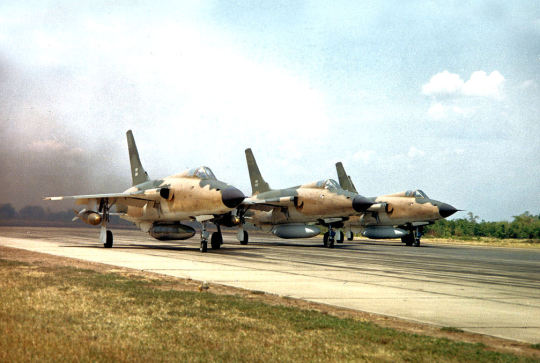
With air defenses posing an ever-increasing threat, the USAF began targeting air defenses directly. However, losses were predictably high, and it soon became apparent that a more dedicated platform was required. Although the F-100F was the first platform to experiment with the new “Wild Weasel” role, the focus soon shifted back to the F-105, this time in the two-seater -F variant. The Wild Weasel Thuds were outfitted with an advanced countermeasures suite and radar warning receiver, and the rear cockpit was outfitted to manage these systems. Conversions began in 1966, and by the middle of the year the Wild Weasel F-105 was flying over North Vietnam. Hunter-killer tactics soon developed, with the Wild Weasels baiting the enemy SAMs and directing F-105Ds to the target. The Wild Weasels themselves weren’t harmless, however. They normally carried an assortment of bombs and rockets, and as the war went on they were fitted with the AGM-45 and -78 antiradiation missiles. As tactics and avionics improved, what remained of the Wild Weasel fleet was upgraded to the F-105G standard. The F-105G upgraded all the systems of the EF-105Fs that had been the original Wild Weasels, while jammer equipment was built in to the airframe, freeing up pylons for more bombs and missiles.
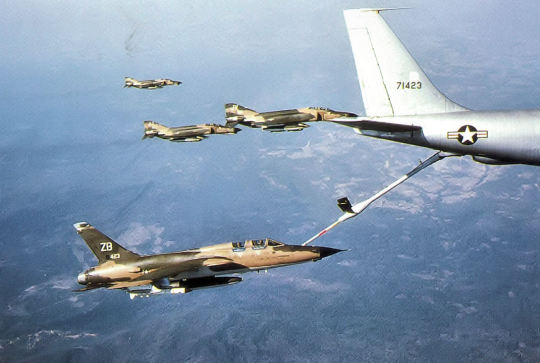
For all the Thud’s fame, it would suffer heavy losses during Rolling Thunder. Bearing the brunt of the air campaign took its toll on the fleet, and the limited scope of the campaign coupled with predictable flight paths meant that losses never receded, even as the USAF scrambled to upgrade the fighter. Although plans were already in place to replace the F-105 with the F-4, the losses sustained during Rolling Thunder accelerated the retirement. 312 Thuds were lost to ground fire, and a further 22 were downed by the NVAF. Adding to the 61 losses to accidents, total Thud losses in Vietnam amounted to roughly half the aircraft’s total production. They had done their share of damage, and had claimed 27.5 enemy fighters, but the losses were not sustainable. With the end of Rolling Thunder, surviving F-105Ds were withdrawn from Southeast Asia. F-105Gs, still without a replacement, stuck around until the end of the war. However, they too suffered heavy losses, and Wild Weasel F-4s would supplement their numbers towards the end of the war. With the end of the war in Vietnam, surviving Thuds were transferred to ANG units. There, they flew on for several more years, but by the end of the 1970s airframe fatigue meant their days were numbered. The last of the F-105s was finally retired in 1983.
North American F-107
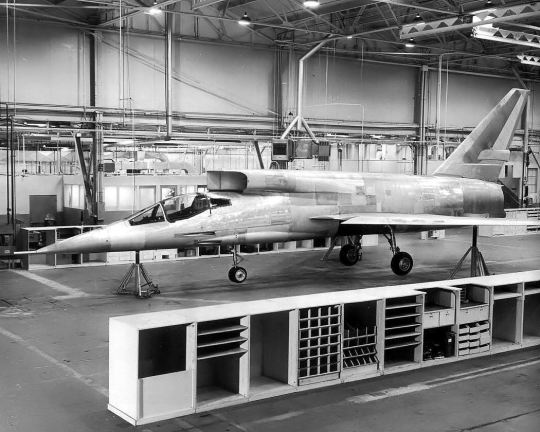
In 1953, North American began a series of design studies for advanced F-100 variants. Two designs - the NA-211/F-100BI interceptor and NA-212/F-100B fighter-bomber - were produced, with the majority of design work concentrating on the F-100B project. Though derived from the F-100, both designs diverged considerably, making use of a solid nose and redesigned intake. Whereas the F-100BI had a ventral intake, the decision to give the F-100B a recessed position for a nuclear store forced North American to move the fighter-bomber’s intake to a dorsal position right behind the cockpit. Though unconventional, the design had attracted the attention of the USAF, receiving an order for nine prototypes. The finalized design would be similar to the F-100 aft of the nose, but it made use of various refinements to the wings and tail, as well as an automated flight control system intended to improve handling at supersonic speeds. With all the changes made, the preliminary designation “F-100B” didn’t really suit the aircraft anymore. Instead, the USAF chose to contract the new design under an entirely new designation - the F-107.

The first F-107 would fly in September 1956, breaking the sound barrier on its first flight. By the end of the year, the F-107 had pushed it beyond Mach 2, and weapons tests had commenced. Testing went well, so Tactical Air Command decided to have it fly off against the F-105, which was built to the same requirements with the same engine. The results were close - the F-107 offered better performance, particularly in climb rate and flight ceiling, but the F-105 had a better payload and thrust-to-weight ratio. Unfortunately for North American, TAC went with the F-105, which by then had already been ordered into production. With only three of the ordered nine prototypes completed, the order was cut and the program terminated. The first and third prototypes were given to NACA for high-speed testing, but the second prototype - devoid of vital instruments like navigation radios and cockpit lights - was unfit for further service and instead was flown off to the National Museum of the United States Air Force, where it remains to this day.
Naval Staff Requirement Number 39 (NA.39)
The expansion of the Soviet Navy in the early 1950s would spark a wave of new development for the Royal Navy. As a direct counter to the newest generation of Soviet cruisers, the RN hoped to procure a carrier-based attack aircraft capable of performing low-level toss-bombing attacks.In 1952, the NA.39 requirements were released, calling for a two-seat carrier-based attack aircraft capable of carrying a single nuclear warhead internally or payload of up to 4,000lb with a top speed of Mach .85 at 60 meters and a combat radius of 740km. Due to the limitations of the RN’s carriers, the maximum weight of the aircraft was limited to 45,000lb. Most British manufacturers tendered proposals, but this would soon be narrowed down to three designs - the Armstrong Whitworth AW.168, Short PD.13, and Blackburn B.103.
Armstrong Whitworth AW.168
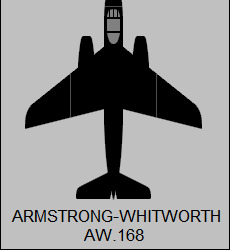
Of the three finalists, the Armstrong Whitworth AW.168 would be the most conventional design. The AW.168 would use a conservative layout with a shoulder-mounted swept wing and a single Bristol Siddeley Gyron Junior turbojet mounted under either wing in a nacelle. To meet the low-speed handling requirements necessary for carrier operations, the AW.168 would use an advanced system of blown flaps, a boundary layer control system, and exhaust deflectors for the engines. Crew was to sit side-by-side under a large canopy. As the most conservative proposal, the AW.168 offered the quickest solution to the Royal Navy, and was the only design projected to be ready for service by the 1960 service deadline set by the program. Unfortunately, this was not enough to win Armstrong Whitworth the contract. The design was outperformed by the competitors, and, while it met the specifications, it offered little room for further development.
Short PD.13
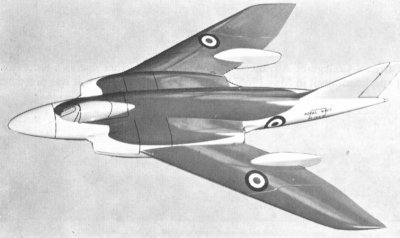
Whereas Armstrong Whitworth proposed a conservative design, Short would go an entirely different direction with their PD.13 proposal. The PD.13 was a tailless design, making use of a highly-swept “aero-isoclinic” wing developed earlier that decade on the SB.4 demonstrator which featured moving outer wing sections to provide control. Power came from a Rolls Royce Avon engine in either wing root fitted with exhaust deflectors to reduce takeoff and landing rolls. The crew sat side-by-side, but the navigator sat in a lower position recessed into the fuselage. Although the PD.13 was far from conventional, Short had validated the general layout and the novel wing earlier that decade, finding that it was actually quite pleasant to fly. Unfortunately, Short’s experimental work wasn’t enough to convince the Air Ministry. Being so advanced, it offered the most risk, so it too was passed over for full development.
Blackburn Buccaneer
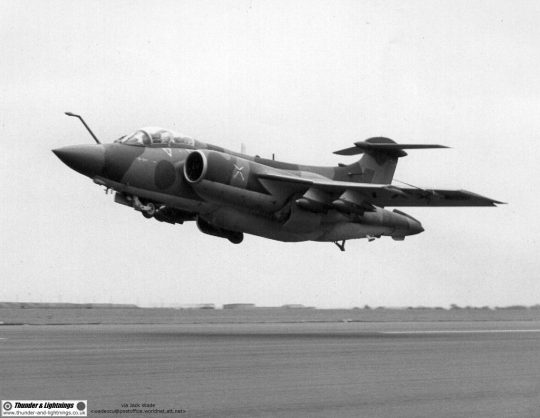
Blackburn’s B.103 proposal would offer a comfortable middle ground between the other contenders. The B.103 used a more conventional layout than the PD.13, but it was far more aerodynamically refined than the AW.168. A Gyron Junior engine sat on either side of the fuselage, and area-ruling was incorporated to reduce transonic drag. As with the other contenders, it made use of blown flaps and a boundary layer control system to improve takeoff and landing performance, but it did not use thrust deflectors. Payload was to be carried in a spacious bomb bay with a rotating door designed to accommodate four 1,000lb bombs or a single nuclear weapon, and four underwing pylons were added for external stores. In the end, the design proved to be exactly what the Air Ministry was looking for. In 1955, the B.103 was selected for full development under the name Buccaneer. The first prototype took flight at the end of April 1958, and although one prototype was lost in 1960, the decision to order a total of 20 pre-production aircraft for testing meant that the Buccaneer would finish testing fairly quickly.

The Buccaneer S.1 would enter Royal Navy service in July 1962. With operational cruises beginning the next year, the Buccaneer would earn a solid reputation among crews. Though intended as a nuclear strike aircraft, it would fly with a variety of conventional payloads, ranging from eight 2,000lb bombs to rocket packs. the Buccaneer S.1 was evaluated with the AGM-12 Bullpup missile as well, but the system proved too unreliable for the Royal Navy. The bomb bay was also adapted to carry a 2,000 liter fuel tank or reconnaissance palette. Plans were also in place for a bomb-bay mounted gun pack, but this would be abandoned, leaving the Buccaneer without guns for its entire career. The Buccaneer S.1 wasn’t without its problems, however. The Gyron Junior engines left the Buccaneer underpowered, and, with the boundary layer control system sapping 10% of the engine power at takeoff, early Buccaneers were unable to takeoff with a full fuel load - instead relying on tanker aircraft to top them off after launch. Only 40 S.1s would be built, and at the end of 1970 the last S.1s were abruptly grounded after two Buccaneers crashed due to issues with the Gyron Junior engines.

Fortunately, Blackburn had been working on the engine issues before the S.1 even entered service. In early 1962, the Buccaneer S.2 was ordered, mounting non-afterburning Rolls Royce Speys that offered far more thrust and better fuel economy. The S.2 required minimal modifications to accommodate the new engine, allowing Blackburn to get the S.2 into service by 1965. Unfortunately, by the time they were making tours with the fleet, the carriers were on their way out. Even so, the Buccaneer S.2 fleet was progressively modified, allowing them to carry the Martel guided missile and ejector racks for three 1,000lb bombs per pylon. Unfortunately, upgrading the fleet took some time. Martel-capable S.2s only entered service in October 1972, by which point the Buccaneers were being phased out. Though plans called for the Buccaneer to leave Royal Navy service by the middle of the decade, the S.2 would stick around until 1978, just before the Royal Navy’s last CATOBAR carrier - Ark Royal - left service. For all the effort put into the design, the Royal Navy’s Buccaneers would never fire a shot in anger.
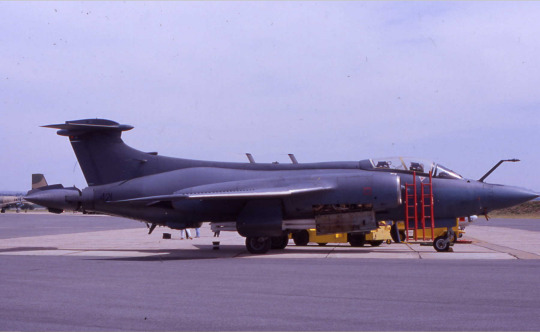
Fortunately, the Buccaneer’s career would not end there. In 1963, South Africa ordered 16 Spey-powered Buccaneers. Minor modifications were made, including removal of the carrier gear, larger external tanks, and the addition of ventral strakes and retractable rocket boosters. Though one was lost in an accident, they would become one of the most important SAAF aircraft of the war. Deploying iron bombs, rockets, AS-30 guided missiles, and specially designed antipersonnel bombs, SAAF Buccaneers were tasked with some of the most critical targets of the war. The Buccaneer proved excellently suited for the low-level precision strikes that the SAAF performed, consistently hitting enemy positions in Angola in the face of Soviet-supplied air defenses. Though they flew against some of the most heavily defended targets in the region, the ended the Border War without suffering a single loss. As part of the South African nuclear program, the Buccaneer was also slated to deploy the warheads under development. Unfortunately, international arms embargoes would do what the Angolans could not. Spares ran out and airframes hit their fatigue limits, and by 1991, only five Buccaneers were still flyable. As apartheid came to an end and the embargoes lifted, the Buccaneer fleet was retired.
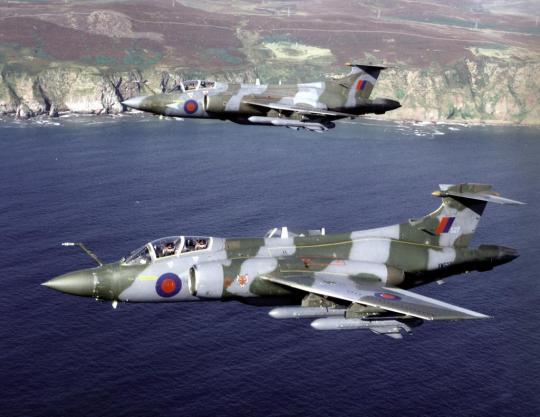
The last operator to procure the Buccaneer would be the RAF. After the cancellation of the TSR.2 and F-111K, the RAF was left without a replacement for their glaringly obsolete Canberras. Though they had worked hard in the past to avoid procuring the Buccaneer, they finally relented in 1968, ordering 26 new-built denavalized S.2s. Unusually, although supersonic Buccaneers fitted with afterburning Speys had been proposed earlier that decade, the RAF opted for the faster option, as the Buccaneer was intended to be stopgap while the Anglo-French variable geometry strike fighter was under development. Though the RAF had spent the better part of the decade avoiding the Buccaneer, they were quite enthusiastic once they got their hands on it. As the RN phased out their fleet, they fell into RAF hands, and over the years, the fleet was continually upgraded.
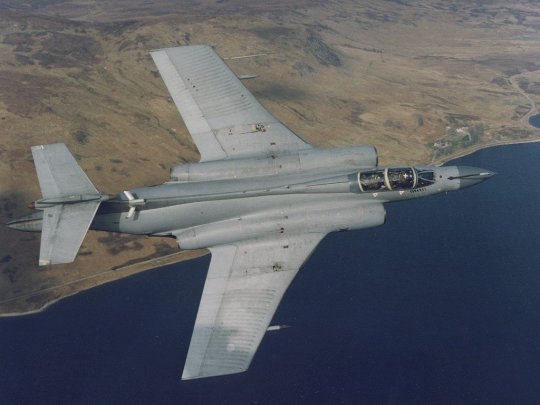
By the early ‘80s, the Tornado was starting to replace the Buccaneer in the overland strike role. They were gradually shifted back to maritime strike, though the retained overland strike as a secondary role. Despite being slated for replacement, upgrades continued, though such programs focused on adapting to new weapons rather than upgrading avionics. Surprisingly, they managed to fly until the 90’s without seeing combat. When the Gulf War broke out, 12 Buccaneers were fitted with laser designator pods, updated radios, and IFF transponders and deployed to Saudi Arabia. They would fly 250 combat sorties, designating targets for 169 bombs from other aircraft and dropping 48 bombs on their own. Unfortunately, this would be the RAF Buccaneers’ only combat use. The end of the Cold War saw the Tornado fleet withdrawn back to Britain, allowing the Buccaneer to be phased out. By 1995, the last Buccaneers had be retired.
North American A-5 Vigilante
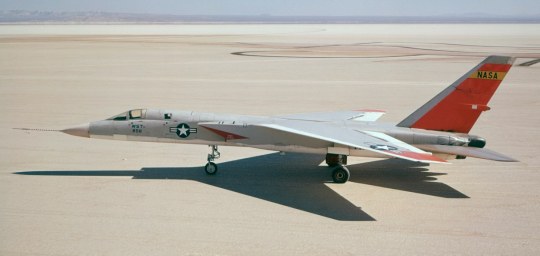
In 1953, recognizing the looming obsolescence of the current generation of nuclear bombers in the USN arsenal, North American began a private venture effort to develop a next-generation strike aircraft. After discussing operational requirements with the Navy, North American produced the NA-233 - a large twin-engined design fitted with advanced attack avionics. By mid 1956, the design was contracted for two prototypes as the YA3J Vigilante. At a glance, the Vigilante very much resembled a fighter. A crew of two sat in tandem under separate canopies, and a J79 engine was placed on either side of the fuselage. Rather than use hardpoints or a conventional bomb bay to carry the aircraft’s expected nuclear payload, the Vigilante would make use of a unique linear bomb bay in which the payload was jettisoned out the rear of the aircraft rather than downwards. To allow for extended flights on afterburner, the Vigilante was a massive aircraft (allowing for an impressive internal fuel capacity). Though this made the Vigilante one of the largest aircraft the Navy would operate, an advanced boundary layer control system complete with blown flaps was used to keep landing speeds reasonable. For all the groundbreaking features of the airframe, the avionics were the real selling point. The Vigilante would be fitted with the most advanced nav/attack systems yet mounted on an aircraft, complete with a solid-state computer, heads-up display, multimode radar, inertial navigation system, and fly-by-wire controls.
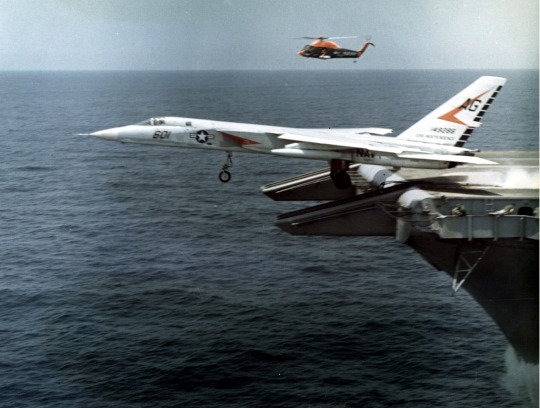
Two years after the order for prototypes was placed, the Vigilante would take flight for the first time. Though the A3J was incredibly advanced, testing went smoothly, and by 1960 the first production aircraft had flown. Deliveries to operational units began in 1961, ending two years later. By now, the Vigilante had been redesignated the A-5. In service, the A-5 had quite a few teething issues. Though the airframe was reliable, the avionics were problematic and maintenance-intensive at first. The advanced system of flaps didn’t entirely eliminate the difficulties of landing the A-5 on a carrier, either. The Vigilante would gain a reputation for being difficult to land on carriers, although its unparalleled performance seemed to make up for that. Even worse, the linear bomb bay was far less reliable than North American’s engineers had hoped. In some cases, catapult launches from the carrier would cause the payload to be jettisoned onto the deck. During test runs, crews found that the wake of the Vigilante disturbed the payload as it left the aircraft, making accurate attacks incredibly difficult. By the time the last original productoin A-5s were delivered in 1963, the Vigilante’s days already seemed numbered. The A-5 was an expensive niche-role design that took up a lot of space on the carriers, and the nuclear strike role was being shifted over to SLBMs, making the Vigilante obsolete.
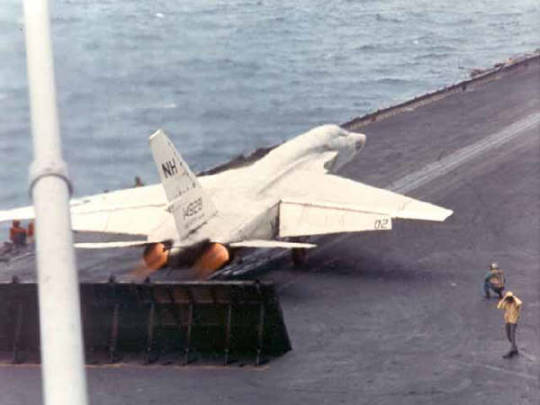
Fortunately, North American had been working on updating the Vigilante since 1961. A large dorsal hump was added, substantially increasing fuel capacity, and the flaps and boundary layer control system were refined. Two variants - the attack-oriented A-5B and reconnaissance RA-5C - were designed around this improved airframe. Both variants were fitted with four 2,000lb hardpoints, but the RA-5C had its avionics suite revised and a large ventral “canoe” ran most of the length of the aircraft. The canoe held various photographic and electronic reconnaissance systems, including oblique cameras, side-looking radars, and an infrared sensor. The linear bomb bay remained on both the A-5B and RA-5C, and the RA-5C retained its nuclear strike capabilities. The A-5B would first fly in April 1962, followed by the RA-5C two months later. 18 A-5Bs were ordered, but only six would be completed as the Navy dropped the Vigilante in the attacker role. The remainder of the order were converted over to RA-5Cs, and an order for 43 more was placed. Once this order was completed, 43 surviving A-5A/Bs were converted to the RA-5C standard as well.

The RA-5C would enter service in 1964, and almost immediately it would make its combat debut over Vietnam. The incredibly advanced nature of the Vigilante’s systems meant that it would be limited to flights over friendly territory at first, but these restrictions were soon lifted. Missions generally involved low-altitude runs, with the Vigilantes flying on full afterburner the entire time they were over North Vietnam. The camera-based systems and radars worked excellently, but the ELINT system on the Vigilante would prove troublesome. Despite being able to outrun any fighter it encountered (friend or foe), the Vigilante would suffer the highest loss rate of any Navy aircraft of the war. Flying both pre- and post-strike missions exposed it to alert and agitated air defenses. 13 Vigilantes were downed by AAA, two more by SAMs, another by a MiG-21, and two more to unknown causes.
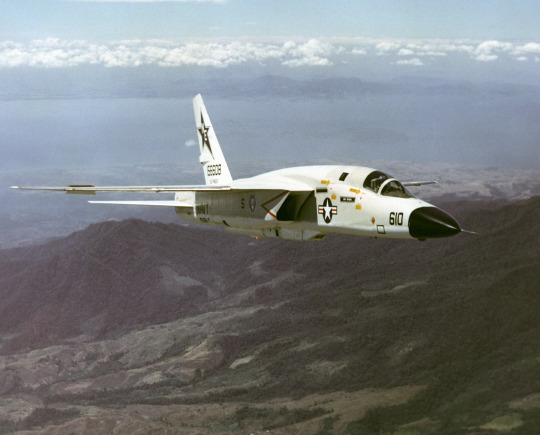
By the 1970s, A-5 operations were winding down. An order for 46 more A-5s had been cut short to 36, and the push towards standardization was hitting the Vigilante fleet hard. The Vigilante was now out of production, and maintenance of the complicated aircraft was becoming increasingly difficult. Worse, the Navy was losing interest in a niche-role reconnaissance aircraft that took up so much space, instead preferring to mount reconnaissance pods on the smaller, cheaper attackers and fighters. Even against dedicated platforms like the RF-8 Crusader or RF-4 Phantom II, the Vigilante was losing favor. As the war in Vietnam came to an end, so would the Vigilante’s service. The first squadrons were disbanded in 1974, and by the end of the decade, the Vigilante had been retired.
Grumman A-6 Intruder

After an excellent showing by the AD-6/7 all-weather Skyraider variant in the Korean War, the Navy began a search for a dedicated jet-powered replacement. In 1957, a request for proposals was issued, and by the start of 1958 Grumman’s proposal had been selected for prototyping under the designation A2F. The A2F was a twin-engined plane distinguishable by its bulbous nose (housing a radar) and its side-by-side seating for the crew. An advanced electronics suite was installed not only to aid in navigation and attacks, but also to notify the crew of damage to or failures of any onboard systems. Additionally, the A2F was to have wingtip mounted airbrakes and rotating engine nozzles (intended to aid in short takeoffs; would not make it to the production line).
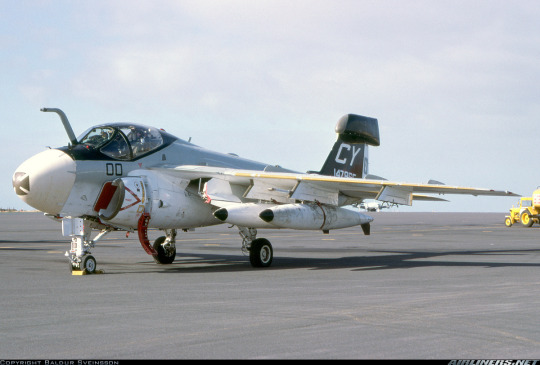
The A2F would first fly in 1960, but by the time it had made it to squadron service in 1963 the change in the designation system took place and the A2F was redesignated the A-6. Soon after its introduction, the A-6 would make its combat debut over Vietnam. During the war, the A-6 would prove invaluable - it could carry the same payload as an F-4 Phantom for a fraction of the cost, while its all-weather capabilities made it invaluable for night missions. The Intruder would also take on several auxiliary roles, including buddy-tanker and even EW platform. As the war in Vietnam escalated, the USMC adapted several A-6s to become EA-6As, which replaced their aging EF-10s. These EA-6As had considerably reworked onboard systems, and were notable for their large antenna fairing on the tail. In all, 84 A-6s of the USN and USMC would be lost in Vietnam.
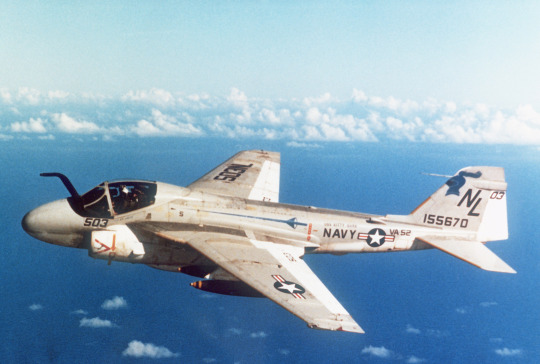
Following the end of the war in Vietnam, Grumman began work on an advanced jammer variant of the A-6, basing efforts off of the USMC’s EA-6As. Designated the EA-6B, the aircraft featured an extended cockpit that held a crew of four and an extensively reworked avionics suite designed around its EW and ELINT equipment. The heavy payload capacity of the A-6 remained, but the mission of the EA-6B became more tailored to its designation - hardpoints more often than not carried jamming pods, while offensive stores were almost exclusively AGM-88 HARM antiradiation missiles
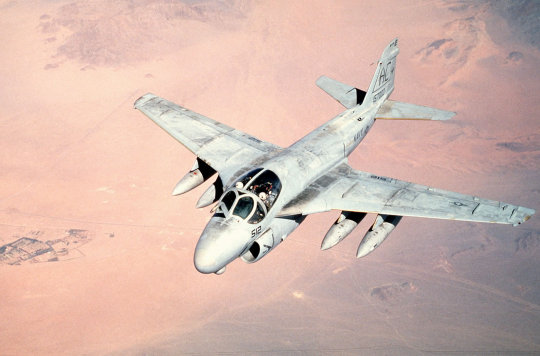
The next theater to see the A-6 would be the Middle East. As part of the intervention in Lebanon, A-6s were called into action, flying missions alongside A-7s against enemy positions. During the operations, one A-6 was downed by a Syrian SAM. Both Intruders and Prowlers would participate in the bombing of Libya in 1986. There, two squadrons of A-6s took part in the strikes, while EA-6Bs provided jamming support. In the 1991 Gulf War, the Intruder continued to shine, serving as the Navy and Marines’ primary bombing platform during the conflict while flying almost 5,000 sorties. The 39 EA-6Bs supporting the mission would fly a further 1,600 sorties without loss.
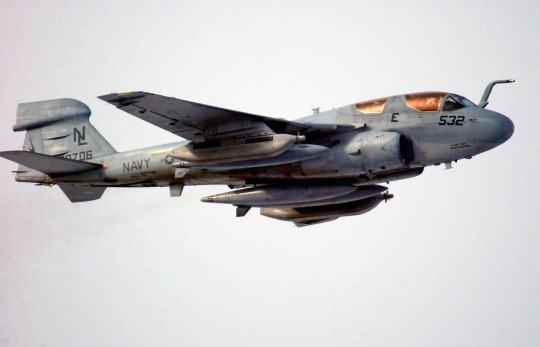
Unfortunately, the A-6 was not to last forever. Aging airframes gradually reached the end of their service lives, and, while the A-6 was supposed to be replaced by the A-12, the cancellation of the program left the A-6 without a direct replacement. The Navy’s A-6s left the fleet in 1993, with the USMC following suit four years later. The A-6’s role was taken over by F-14Ds and F/A-18Ds, and later the Super Hornet. However, this has left a gap, as current aircraft have neither the payload nor range to fully replace the Intruder. The Prowler would persist for a bit longer. While the EA-18G would come along to replace the Navy’s Prowlers in 2015, the USMC continues to fly the EA-6B.
NATO Basic Military Requirement 3b - AC.169b
The second - and far more important - part of the NBMR-3 program was the AC.169b requirements - the subsonic fighter-bomber. Originally developed in 1961, the AC.169b requirements were broken off as the NBMR-3 requirements were released and NATO called for a supersonic VTOL fighter to support the strike aircraft. However, it would be the NBMR-3b program - calling for a VTOL strike aircraft with a combat radius of 250 nmi, cruise speed of Mach .92 at 500ft, and a payload of a single 2,000lb tactical nuke - would see far more interest than the NBMR-3a fighter. German and Italian projects would take the center stage, although British, French, and American projects would be submitted as well. In the end, the NBMR-3b would be heavily revised in 1963, narrowing the focus of the project to the four most promising contenders. Nevertheless, the NBMR-3b program would fare little better than the NBMR-3a - France’s abandonment of the NBMR-3a and Britain’s withdrawal from the NBMR-3b under similar circumstances would effectively kill the program.
Lockheed CL-704

Of the proposals submitted to the NBMR-3b requirements, Lockheed’s was perhaps the strangest. Rather than develop an entirely new design, Lockheed thought it would be easier to just slap 14 lift jets onto the F-104, Taking the F-104 as a base, the CL-704 was a surprisingly simple modification that entailed adding a large pod on either wingtip containing seven vertically mounted lift jets. To account for the added weight, a new Rolls Royce engine would also be used in place of the original J79 for conventional flight. Unsurprisingly, NATO officials weren’t too keen to the idea of creates an even more dangerous variant of the F-104. Although the CL-704 was probably the most developed of the rejected NBMR-3b proposals, it remained just that - a rejected paper project that would progress no further.
EWR VJ 101C
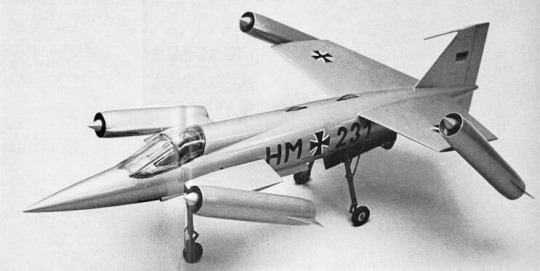
The oldest submissions to the NBMR-3b requirements would be the product of the German Vertikal Jager (VJ) program. Through the latter half of the 1950s, West Germany had been working on its own VTOL fighter program. Numerous design studies had already been conducted, and, in 1959, Heinkel, Messerschmitt, and Bolkow created a consortium - EWR Sud - to create their VTOL fighter aircraft under the designation VJ 101. Messerschmitt and Heinkel both produced independent design studies, which would receive the designations VJ 101A and VJ 101B. Heinkel’s VJ 101A proposed the use of six tiltjets in pods on the ends of wings and canards to provide both vertical and conventional flight. Messerschmitt’s VJ 101B was more conventional in layout - it was a tailed-delta design that would make use of four engines in the central fuselage that could either be ducted downwards for vertical thrust or vented backwards for cruising flight.
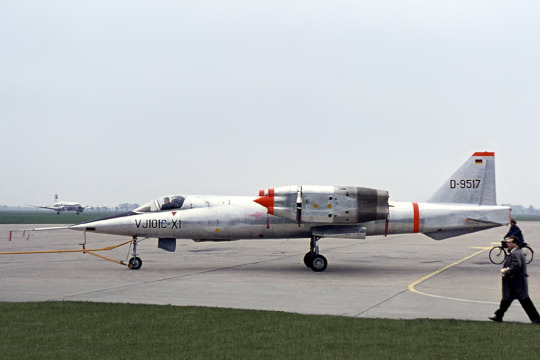
In the end, neither of the first two proposals would be accepted. Rather, EWR chose to go with an entirely new design that took the tilting engine pods from Heinkel’s VJ 101A. The VJ 101C, as it was to be designated, would be very similar to Bell’s (entirely independent) D-188A VTOL fighter program. Engines would be paired in rotating pods on the tip of either wing, while two further lift jets were placed immediately behind the cockpit to assist in vertical flight. As the design finalized, the NBMR-3 requirements were issued, so EWR decided to submit the VJ 101C to the competition. However, as proposed, the VJ 101C demonstrator then being constructed was hardly a practical weapon - it was far too small to carry an adequate load of fuel or weapons, and the six RB 145 turbojets mounted on the aircraft lacked the power for an operational fighter. Assuming the VJ 101C testing went smoothly, EWR hoped to refine the design to make it suitable for operational use.
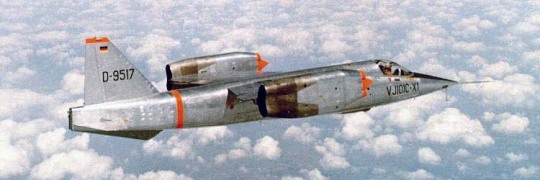
The VJ 101C prototype was completed in late 1962, making its first tethered ground tests in December of that year. In April 1963, the VJ 101C made its first hovering flight, and the next month it was revealed to the public. The first conventional takeoff came in August, and through the end of the year, the advanced control systems were refined until the VJ 101C could make a successful vertical takeoff, transition to horizontal flight, and vertical landing all in one flight. Although the first prototype was lost in an accident in 1964, EWR was undeterred, constructing a second prototype equipped with afterburning engines. Although the second prototype was successful - even breaking the sound barrier in level flight - the program soon lost momentum. EWR had already shifted its focus to the more conventional VJ 101D that had been selected as the second part of the program.
Tactical Fighter Experimental - TFX
In 1957, the USN began developing requirements for the next generation strike aircraft. Looking to British NA-39 requirements (which would produce the Blackburn Buccaneer) for guidance, the Navy was soon expanding their horizons to a multirole design making use of variable geometry wings. In 1959, USAF Tactical Air Command had developed similar requirements - a long-range supersonic multirole aircraft with an emphasis on low-level strike and the ability to operate from unprepared airfields. As projections for conventional fixed-sweep aircraft showed that the loaded weight of such a design would be in excess of 100,000lb, the new USAF requirements would also call for variable-sweep wings. The parallel requirements caught the attention of Secretary of Defence McNamara, who combined them into a single program - the TFX - in 1961. From the start, the program would meet resistance. Though both services wanted a swing-wing aircraft, that was about all they could agree on. The Navy wanted side-by-side seating and an emphasis on air-to-air duties for use as a fleet-defense interceptor, while the Air Force was hoping for a tandem-seat low-level penetration interdictor. Ultimately, these diverging requirements would lead to the Navy’s withdrawal from the TFX.
Republic/Vought TFX
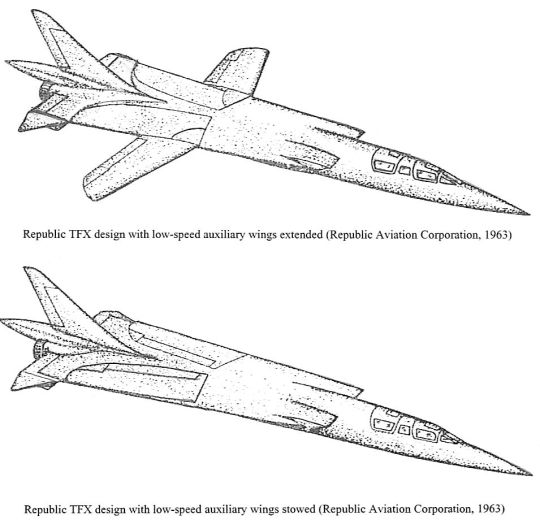
Republic and Vought would team up for the TFX program, modifying Republic’s design that had been developed with Fokker for the NBMR-3 STOVL fighter requirements. The new proposal shared much with the STOVL D.24 Alliance pitched to NATO - it had a crew of two in tandem and an unusual delta wing that the swing-wings would fold back onto for high-speed flight. Other notable elements - such as small internal bays for AIM-9 Sidewinders - were also retained. However, the single massive BS100 engine of the D.24 gave way to two conventional engines fed by intakes in the roots of the wings. To meet range and payload requirements, and to accommodate the new engines, the D.24 design was scaled up. Unfortunately, the proposal would not be accepted for further development. Unlike the D.24, it wouldn’t even make it as far as a mockup.
Boeing Model 818

Boeing’s TFX proposal was the Model 818. Immediately apparent from looking at the proposal are the unique dorsal engine intakes, likely an attempt to reduce wasted space in the fuselage. The crew sat in a side-by-side cockpit in individual ejection seats, while the wings pivoted in a narrow glove between 25 and 70 degrees. The USAF variant would differ from the Navy’s Model 818N mainly in changes to the nose and tail. The Model 818N made use of a smaller nosecone and eliminated the “stinger” that extended rearwards beyond the tail. In addition, it featured avionics for the AIM-54 missile and a probe for aerial refueling. Although the dorsal intakes were undoubtedly a questionable choice, the design otherwise was sound. When presented to the selection board, the Model 818 (along with every other proposal) was found unacceptable. However, with some changes (namely to the engines, missile storage, and the use of an escape capsule for the crew), it was resubmitted. The Air Force would prefer the Model 818 over the competing General Dynamics proposal, while the Navy found both designs to be unacceptable. Ultimately, it would go on to win all four stages of the selection competition. Unfortunately, Boeing would fall victim to McNamara’s decisions. Despite being favored at every single stage of development, McNamara went against the wishes of the selection board and awarded the contract to General Dynamics on grounds that there was greater commonality between the USAF and USN variants.
General Dynamics F-111A/D/E/F Aardvark
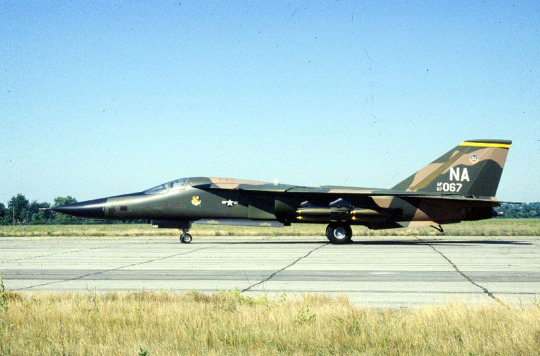
The original General Dynamics proposal closely resembled the final product that would enter production. The crew sat side-by-side in a special ejection capsule, and semicircular shock cone intakes similar to those seen on the F-104 were used. Though deemed unacceptable in the first round of evaluations, General Dynamics’ proposal would be selected alongside Boeing’s Model 818 for further development. Through four successive rounds of evaluations, the design morphed - leading edge root extensions extended over the tops of the intakes, and minor revisions to the tail brought the all-moving stabilators on same plane as the wings. By 1962, things weren’t looking good for the General Dynamics proposal. Both the USAF and USN were favoring the Model 818, and General Dynamics had lost every round of the selection process to Boeing. Against the wishes of the selection committee, however, Secretary of Defense McNamara would choose General Dynamics’ design as the winner of the TFX. The reason for the selection was the anticipated savings associated with General Dynamics’ design, which was to have up to 80% commonality between the USAF and USN variants.
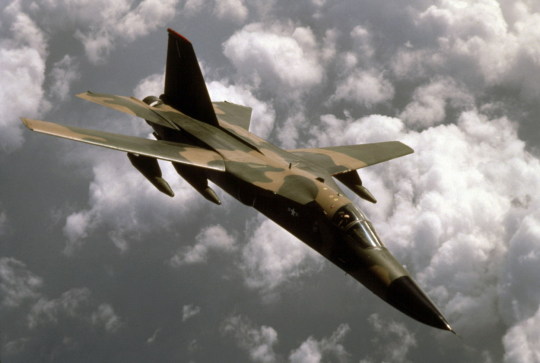
Two years after being selected as the TFX winner, what was now known as the F-111 took to the skies for the first time. The F-111A - the USAF variant - began its troubled test program at the end of 1964. The F-111A came in significantly overweight, and testing was continually plagued with issues relating to the reliability of the TF30 turbofans and poorly designed intakes. The engines in particular were problematic, exaggerating the negative effects of the aircraft’s excess weight due to early TF30s producing less than their rated thrust. Outside of the reliability and weight issues, however, the F-111A showed promise - an advanced avionics and navigational suite included cutting-edge countermeasures and a terrain-following radar, and a combination of an internal bomb bay and wing hardpoints allowed the F-111A to carry up to 20,000lb of stores. If the situation required, fuel tanks could be mounted on every hardpoint and in the internal bomb bay, further extending the already impressive range of the Aardvark. Even with the weight and engine issues, the F-111A was hardly sluggish - it could easily break the sound barrier at altitude, and it was even capable of performing low-level supersonic dashes.
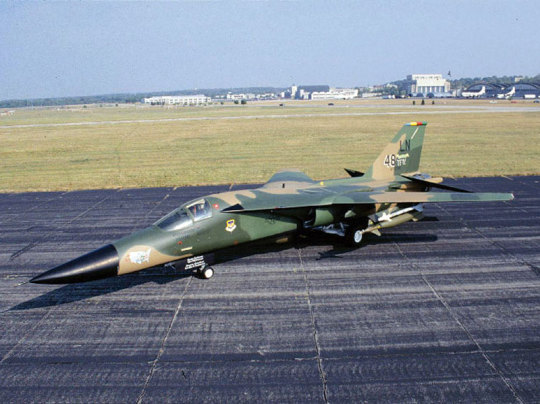
The first F-111As would make their operational debut in 1968, when TAC deployed six aircraft to Thailand. This first deployment had mixed results. Though the missions generally went well considering the F-111As were sent out alone on poor-weather precision strikes, three F-111s were lost in just 55 sorties to accidents. By the fall of 1968, surviving F-111As were sent back to the US. They would return to Southeast Asia in 1972 as part of Operation Linebacker, this time with a force of 48 aircraft. With the kinks ironed out, the F-111A now performed spectacularly. The F-111 consistently showed that it could hit heavily defended targets with impunity, flying without escort and reaching targets without the need of a tanker. Over seven months, they flew more than 4,000 sorties for the loss of just six aircraft. They continued to fly strikes into Laos and Cambodia in 1973, and in 1975, the flew arguably the last combat sorties of the Vietnam War. As part of the Mayaguez Incident, F-111A made use of their powerful radars to find the hijacked SS Mayaguez, and ultimately they managed to sink a Cambodian gunboat.

By the end of the Vietnam War, the first round of upgrades to the F-111 were beginning. TAC had ordered the upgraded F-111D in 1967, aiming to install new avionics, a glass cockpit, newer engines, and revised intakes on the F-111. As a stopgap while the complicated F-111D was developed, the simpler F-111E was also ordered. The F-111E incorporated the simpler elements of the F-111D, such as the revised intakes and modified stores management system, but retained the old engines and avionics package. F-111Es began deliveries in 1969, but they would never be replaced by the ambitious F-111D. The F-111Ds proved too complicated and unreliable, and, despite continuing efforts to upgrade them throughout their lives, they never attained a high serviceability. In 1969, a new, less ambitious upgrade package was ordered - the F-111F. The F-111F made use of an improved avionics suite derived from the FB-111A, eliminating strategic bombing modes and replacing them with elements more suited to tactical strike. The intakes were improved once more, and newer TF30 engines provided more thrust than those on the F-111A and -E. Unusually, they also were given the ability to mount the AIM-9 Sidewinder, although it appears this was never used operationally.
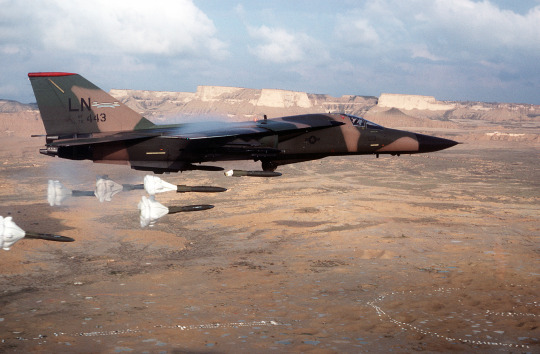
The F-111F would come to be the backbone of the USAF F-111 fleet by the end of the 1970s. The next operational use of the Aardvark would come in 1986, when F-111Fs flying out of the UK supported strikes on Libya as part of Operation El Dorado Canyon. Unfortunately, one F-111F was lost to Libyan air defenses during the attack. The next major operation involving the F-111 came in the 1991 Gulf War. Before the main part of the Desert Storm air campaign began, F-111s were tasked with hitting strategic targets in low-altitude interdiction missions. Once the ground offensive started, they took to more aggressive roles - SCUD hunting, suppression of airfields, and tank plinking. The F-111’s performance as an anti-armor platform was nothing short of spectacular. Equipped with PAVE TRACK IR pods and laser designators, the 66-plane F-111 force was credited with the destruction of over 1,500 Iraqi AFVs, primarily with GBU-12s. Although the F-111 was supplemented by the F-15E during the campaign, it did have its niches. During Desert Storm, it would be the only aircraft to deploy the GBU-15 and the 5,000lb GBU-28 Bunker Buster. Unfortunately, the F-111’s career after Desert Storm was limited. The F-15E had arrived to replace it, and, thanks to the post-Cold War drawdown, surviving F-111A/D/E/Fs were retired by 1995.
Nanchang Q-5 “Fantan”

As domestic production of the MiG-19/J-6 began in 1958, the PLAAF requested a dedicated attack variant to be developed from the fighter. Without any solid specifications, the details of the design were left up to Shenyang. After an extensive study of attack aircraft, Shenyang went to work with ambitious goals - getting the aircraft flying in under a year. Though design work went quickly, manpower shortages meant that the project would be transferred to Nanchang in 1959. The original design handed off to Nanchang was vaguely similar to the final product, with a solid nose and intakes moved to the cheeks. Nanchang’s engineers refined the design further, lengthening the nose, applying area ruling, and revising the canopy. Experimental work began in 1960, but the faltering Chinese economy caused the Q-5 to be canceled in 1961. Nanchang’s engineers kept the project alive, however, until it was resumed officially in 1963. Quality control issues plagued static testing and delayed flight tests, but on June 4, 1965, the Q-5 would finally fly for the first time. Numerous flaws were found in the original design, and it would take four more years of gradual refinement before the Q-5 was deemed fit for service.

The Q-5 that would enter service in 1970 was less a MiG-19 variant and more an entirely new plane with MiG-19 wings. A significantly larger fuselage fitted with armor and bombs meant that the max takeoff weight was almost 10,000lb higher than the MiG-19, but, despite mounting the same engines, it boasts superior speed at altitude and similarly excellent low-altitude performance. The third cannon of the MiG-19 was deleted, leaving just a single 30mm cannon in either wing root, but payload capacity massively expanded to 2,000 kg over 10 hardpoints. Initial production aircraft were fitted with an internal bay, as were several specially modified nuclear-strike versions, but by the 1980s this was replaced with an expanded fuel tank due to the type’s cripplingly short range.
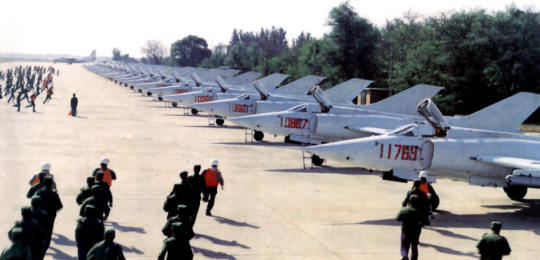
For a first-generation domestic design, the Q-5 would be surprisingly successful. The PLAAF would be an enthusiastic user of the type, continually upgrading the capabilities of the fleet with new attack avionics and munitions, and the PLAN would procure their own special variant optimized for torpedo strike (later switching over to antiship missiles). Somewhat surprisingly, the Q-5 has seen quite a bit of export success. Operators across Asia and Africa would come to fly the Q-5 (or A-5, as export aircraft were known), and China took advantage of warming relations with Western nations to equip the export aircraft with Western avionics. Early A-5s were outfitted to carry Western AAMs like the Matra 550, while later variants worked on giving the aircraft an avionics suite derived from the AMX strike aircraft. The most promising developments would fall through, however, as relations with the West soured in the aftermath of the Tiananmen Square Massacre. By the time things improved, China was more concerned with the new generation of strike aircraft under development, so work on the Q-5 stagnated. Though the type persists, it’s on its way out as modern strike platforms enter service.
BAC TSR.2

By the mid-1950s, the RAF was in search of a replacement for the English Electric Canberra, which was rapidly approaching obsolescence. Ambitious specifications - GOR.339 - were issued in 1957, calling for an all-weather strike/reconnaissance aircraft with a long range, heavy payload, supersonic performance, and good short-field performance. Through luck and political maneuvering, the requirement managed to survive the infamous 1957 Defense White Paper, and in early 1958, nearly every major British manufacturer had issued a proposal. Two designs in particular stood out - the English Electric P.17 and Vickers-Armstrong Type 571. The P.17, which won the initial round of the competition, closely resembled what would become the final product - a long twin-engined plane with small shoulder-mounted wings. The Vickers proposal would be a close second, thanks to engineers working hard to accommodate the logistical side of things as well. With the British government encouraging companies to consolidate, the Air Ministry decided to have the companies collaborate on a single design, which was greenlighted in 1959 as the Tactical Strike & Reconnaissance 2 - TSR.2.
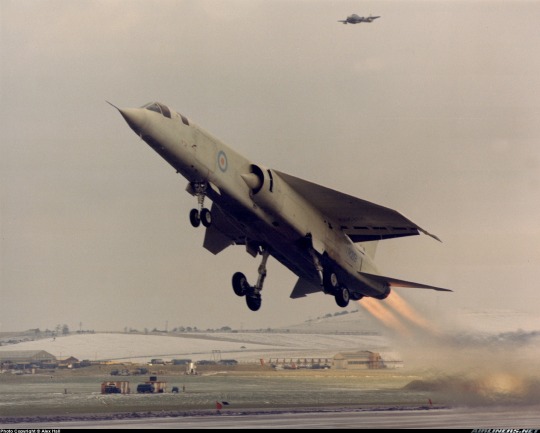
The TSR.2 that would take shape combined the finer elements of the Vickers 571 with the general layout of the P.17. The long, sleek aircraft had its crew of two in tandem in the extreme nose and was powered by two Bristol Siddeley Olympus engines. A small shoulder-mounted delta wing with anhedraled wingtips provided a smooth ride at Mach 1.2 at sea level, albeit at the cost of poor maneuverability. Despite the TSR.2’s high wing loading, short-field performance was excellent, with an advanced system of blown flaps reducing takeoff roll for a typical payload to just under 500m. An internal bay provided space for up to 6,000lb of stores, and four underwing hardpoints were capable of carrying a further 10,000lb. One of the most advanced nav/attack systems in the world was developed for the TSR.2, allowing for all-weather operations and toss-bombing of a nuclear gravity bomb. The windscreen was hardened to deal with high-speed bird strikes and covered in a gold film to protect the crew from nuclear flashes. Given the intended rough-field operations, the TSR.2 was also fitted with an onboard APU for startup and an advanced, strengthened landing gear system.
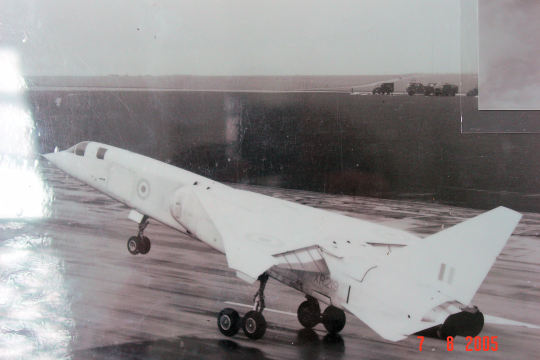
Unsurprisingly, the lofty goals of the program forced the TSR.2 to incorporate countless advanced features, ultimately resulting in an expensive program that became the target of politicians. Cost estimates were dangerously unrealistic, and the powerful Olympus engine was having problems of its own. Nevertheless, development continued on, likely thanks to the fact that the TSR.2 was keeping much of Britain’s defense industry employed. The TSR.2 would take to the skies for the first time in September 1964, conducting 24 flights through March of the next year. For all its criticism, the TSR.2 was hardly an unimpressive aircraft. It had excellent handling despite its high wing loading and blazing low-altitude performance. It did have its problems, however, particularly lingering issues with the landing gear. Unfortunately, that was as far as the TSR.2 would get. With just 13 hours of flight testing complete, the Labour government cancelled the TSR.2 on April 6, 1965, the same day the second prototype was set to fly. As if to ensure the TSR.2 would never be, the Labour government ordered everything scrapped. Nearly everything associated with the program was disposed of, with the only flying prototype being used as a gunnery target. The only survivors were two ground-test prototypes given to museums.
Dassault Mirage F2

In the mid 1960s, France was working on several new designs to replace their Mirage IIIs. Among these projects were several new strike aircraft. The Anglo-French Variable Geometry program and parallel Mirage G offered a high-tech solution, but the Armee de l’Air was also interested in a lower-risk alternative, giving rise to the Mirage F2. The F2 was a significant divergence from the earlier Mirage series designs. In place of a delta wing, the F2 used conventional swept surfaces and a shoulder-mounted wing fitted with various high-lift devices. The fuselage itself was derived from the still-in-development Mirage G swing-wing fighter, and a single American-designed TF30 turbofan was selected to power the aircraft. Though itself a derivative of the two-seat Mirage G, the F2 would fly before its parent design, taking flight in June 1966. Performance wise, the F2 seemed adequate, with a top speed well over Mach 2, and it arguably offered a cheaper alternative to both the AFVG and the Mirage G. However, the Armee de l’Air determined the F2 was surplus to requirements, so they turned their attention to the other Mirage F-series designs.
Sukhoi Su-17/20/22 “Fitter”
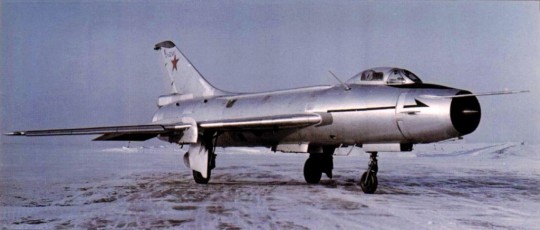
While the Su-7 would go on to be a fairly successful strike aircraft, its poor takeoff and landing performance, coupled with its short range, severely limited performance. Among the various concepts explored by both the Sukhoi and MiG OKBs aimed to improve short-field performance were lift-jets and variable-geometry wings. Following the recommendations of TsAGI, Sukhoi experimented with variable geometry wings on the Su-7. For simplicity, only the outer panels of the wings moved, allowing the landing gear to remain unchanged, as well as having the benefit of minimizing the change to the center of pressure as the wings moved. The converted demonstrator, designated S-22I, took flight in 1966, confirming the efficacy of the arrangement.

Initial production versions of the new aircraft, designated Su-17, were effectively Su-7BKLs with variable-geometry wings and updated avionics. Takeoff and landing performance was vastly improved, but range remained fairly short. Regardless, the Su-17 had completely replaced the Su-7 on production lines by 1971. In 1970, Sukhoi began work on an upgraded Su-17, fitting the more efficient AL-21F turbojet to the design. The new engine freed space for more fuel, allowing range to be further improved. Meanwhile, further refinements were made to the design, and avionics were upgraded once more to allow for the use of newly developed R-3 short-range AAMs. This new variant, the Su-17M “Fitter-C,“ doubled the range and payload of the standard Su-7.
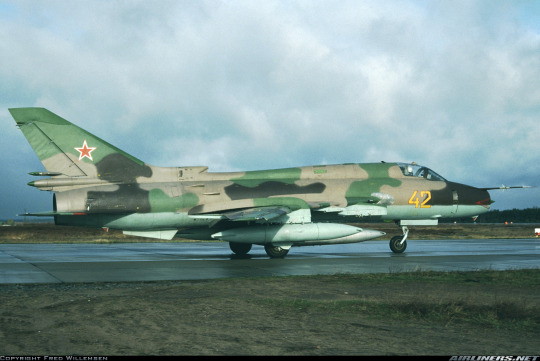
Like the Su-7 before it, the Su-17 quickly rose to be the mainstay of VVS tactical aviation. Soviet service of the Su-17 was fairly uneventful except for operations in Afghanistan. While the unforgiving climate of Afghanistan limited payload, the Su-17 deployed a variety of munitions, including fuel-air-explosives and mine dispensers. Reconnaissance variants used infrared linescan and ELINT systems to scan the mountains at night for Mujahedin. While the Su-17 was a durable aircraft, it nevertheless lost about 15 to ground fire during the war. As ground-based defences began to appear, ground crews modified their Su-17s, adding extra armor and flares. With the fall of the Soviet Union, about 1,000 Su-17M3s remained in the Russian inventory. While these aircraft saw use in the First Chechen War, they have since been withdrawn from service.

Compared to the Su-7 before it, the Su-17 was an even greater export success. Under the designations Su-20 and -22, the Fitter was exported to just about every country to see Soviet assistance. Syria’s Fitters were perhaps the first to see combat, being used heavily in the 1973 War. There, they deployed unguided bombs and cluster bombs against Israeli positions over about 100 sorties. However, they lost four of their inventory of eight to ground fire. Later Syrian use amounted to strikes and reconnaissance in Lebanon - there, however, they again fell victim to Israeli forces, particularly in the disastrous Bekaa Valley engagement.
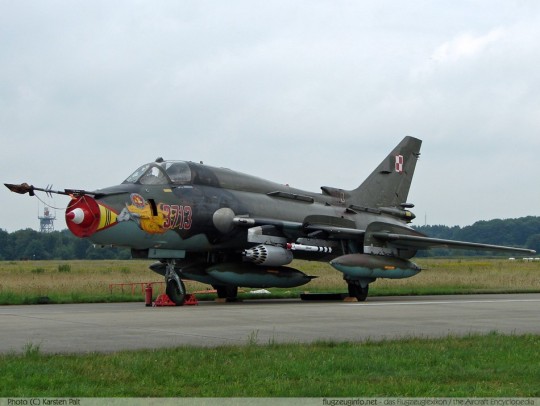
Libya’s Su-22s became famous when, in 1981, they attacked and were shot down by two F-14s. Later that decade, they saw heavy use in Libya’s conflict with Chad. Several aircraft remained in service long enough to see use in the 2011 civil war. Iraq’s Fitters saw heavy use in the Iran-Iraq war, deploying not only conventional weapons but gas dispensers as well. Service in the 1991 Gulf War was poor - four were shot down, 14 more destroyed on the ground, and the remainder of the fleet fleeing to Iran. The only first-world nation to still operate significant numbers of Fitters is Poland. Thanks to massive stockpiles of Su-22 stores and weapons, the Poles deemed it to be more expensive to scrap the fleet than to continue flying them. The fleet has undergone minor modifications to improve avionics, and, as of 2014, the Poles plan to keep the Su-22 in service for the near future.
Vertikal Startendes Aufklarungs-und-Kampflug 191
In 1963, after reviewing all the proposals and declaring the Hawker Siddeley P.1154 and Dassault Mirage IIIV joint winners of the NBMR-3a, the NATO committee refined the specifications and narrowed down the NBMR-3b competitors to four proposals (Hawker Siddeley, Focke Wulf, EWR, and Fiat). In 1963, the selection was announced, with the four winning designs assigned the designations VAK 191 A through D. VAK indicated the intended role - a VTOL combat aircraft - while the “191” number was given because the aircraft was to be the successor to the Fiat G.91. Unfortunately, the VAK 191 program quickly stagnated - West Germany and Italy teamed up to work on the favored VAK 191B, but Britain, sensing that Hawker Siddeley’s design had lost favor, withdrew from the program. Although the joint German-Italian project would continue on, bureaucratic difficulties ultimately caused the dissolution of the NBMR-3b program in June 1966. By the time the VAK 191B did finally fly, it would be little more than a dead-end tech demonstrator.
Hawker Siddeley P.1170/VAK 191A

For their second NBMR-3 proposal, Hawker Siddeley produced yet another derivative of their P.1127 Kestrel design. Original proposals had centered around a design that added two lift engines to supplement the main lift/cruise engine, but the final proposal - the P.1163 - reverted to the single-engined configuration of the P.1127. Unhindered by the diverging requirements that had hamstrung the P.1154, Hawker Siddeley was free to make the VAK 191A design (now designated the P.1170) fit the requirements as closely as possible. The Kestrel’s bicycle landing gear and short, drooping wings were retained, but the aircraft was slimmer and longer than the Kestrel to meet the speed requirements. Most notable was the change in the engine, which was to feature plenum chamber burning (which the P.1127 lacked). Unfortunately, the decision of West Germany and Italy to combine efforts with the VAK 191B threatened Britain’s investment in the VAK 191A. Rather than risk failure, the British decided to cut their losses, dropping the P.1170 in favor of jointly developing the more conservative P.1127 with America, ultimately resulting in the Harrier.
Focke Wulf FW-1262/VFW VAK 191B

Focke Wulf’s proposal - the FW-1262 - was very similar to the Hawker Siddeley P.1159 design study in that it made use of a single main lift/cruise engine supplemented by two lift jets. Rather than use the massive Pegasus engine Hawker Siddeley mounted on their designs, Focke Wulf proposed instead to use the Rolls Royce RB193 - a Spey turbofan modified with vectoring nozzles. Although this reduced the size of the aircraft, it lacked the thrust to provide vertical flight on its own, so a single RB162 lift jet would be added on either end of the main engine. As cooperation between manufacturers was going smoothly with the VJ 101 project, it was decided to create another consortium of manufacturers to lead the project. Focke-Wulf, Heinkel, and Weser merged their interests into a new company, under the name Vereinigte Flugtechnische Werke (VFW). They would soon be joined by Fiat, who decided to prioritize the cooperative project with Germany rather than continue their design alone.

As with the VJ 101 before it, the VAK 191B would start practical testing with a skeletal hover rig. An open-girder body intended to simulate the properties of the final aircraft held five lift engines - two were place in the same position as final aircraft, while the three remaining lift jets simulated the thrust of the main engine, which was still in development. With the success of this, a prototype was built, and captive hover testing began. Meanwhile, NATO doctrine shifted away from nuclear strike and towards more conventional missions, which the fairly small VAK 191B was poorly suited for. The NATO requirement was fully withdrawn in 1967, leading to Fiat’s withdrawal from the project. VFW continued testing the design as a purely experimental program, and by 1971, the VAK 191B was ready for flight tests.
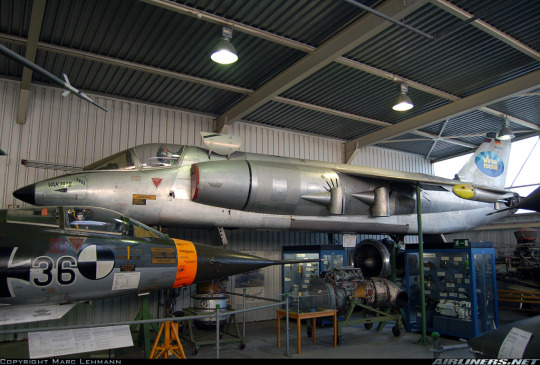
Flight testing of the VAK 191B began in September 1971, with surprisingly good results. Hover performance was good outside of ground effect, and the advanced autopilot systems aboard the aircraft made pilot workload remarkably low. Hovering in ground effect was hazardous for long periods, as exhaust air would recirculate into the engines. As testing moved to short and conventional takeoffs, however, the design’s failings became apparent. In short takeoffs, the extended lift engine rams caused high drag, and the small wings of the design provided little lift. Short takeoffs proved to produce too much of a pilot workload to be operationally suitable. Conventional takeoffs were little better. The small wing area meant that takeoff speeds were approaching 230 kts, and the bicycle landing gear made rotation on takeoff difficult. Only one conventional landing was ever made, with similarly poor performance.

Conventional flight proved equally poor, with high transition speeds, poor acceleration, and high 1drag from the low-aspect ratio wings. With the design proving barely suitable for the obsolete nuclear strike role, VFW proposed a more capable conventional strike variant, with 50% larger wings, four wing hardpoints, and uprated engines. However, this proposal was never accepted. Without a role and generally a failure, the VAK 191B was retired at the end of testing. While its VTOL systems proved capable, the design suffered greatly in nearly every other aspect.In effect, VFW had made the perfect VTOL platform while neglecting every other relevant aspect of the design. Testing continued into 1975, but with the NBMR-3 requirements withdrawn and the Hawker Siddeley Harrier now rapidly outstripping the VAK 191B (even in the proposed conventional strike variant), the VAK 191B was ultimately cancelled.
EWR VJ-101D/VAK 191C

The final product of the Vertikal Jager program started almost a decade before was EWR’s VJ 101D. Going back to Messerschmitt’s proposals, the VJ 101D did away with the rotating engine pods of the VJ 101C, instead opting for a more conventional layout making use of vectored thrust and lift jets. Conventional flight would be powered by two RB153 engines in the rear of the aircraft, while hovering flight was to be achieved by vectoring the thrust of the main engines downward, while four RB162 lift jets mounted in tandem behind the cockpit would provide the extra thrust needed for a vertical takeoff. For the intended nuclear strike role, the VJ 101D/VAK 191C would carry a single gravity bomb in a semi-recessed position just behind the lift jets. Although requirements were centered around low-level strike, EWR also intended for the VAK 191C to be able to reach supersonic speeds to perform as a fighter. However, the design would never leave the drawing board - development stagnated, and when the NBMR-3 requirements were withdrawn in 1966, the VAK 191C was cancelled.
Fiat G.95/4/VAK 191D
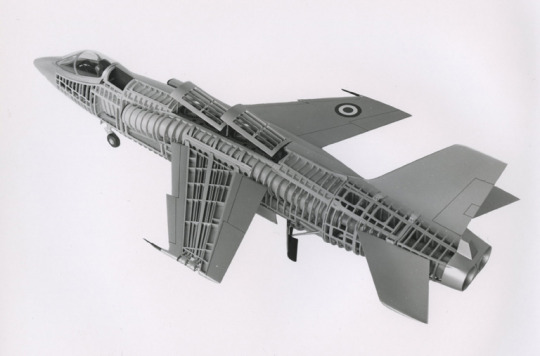
Fiat would conduct several design studies under the designation G.95 before settling on their final design. All G,95 proposals were similar in design and layout, although minor changes were made across each variant. Every proposal was a conventional swept wing design that made use of lift jets as the sole means of vertical flight. However, the placement and number of the jets varied. The G.95/3 and /4 both had four jets, while the /3 and six-lift-jet /6 both placed the jets on either end of the fuselage. In the end, Fiat settled on the G.95/4 - powered by four lift jets in the center of the fuselage and two cruise engines placed in the tail. Fiat did get as far as making a skeletal VTOL testbed to validate the design, but the decision to join forces with Germany would doom the project. All serious work had concluded in 1965, and, although Italy had withdrawn from the VAK 191B project in 1966, the G.95/5 would be completely abandoned in 1968.
Sukhoi Su-24 “Fencer”
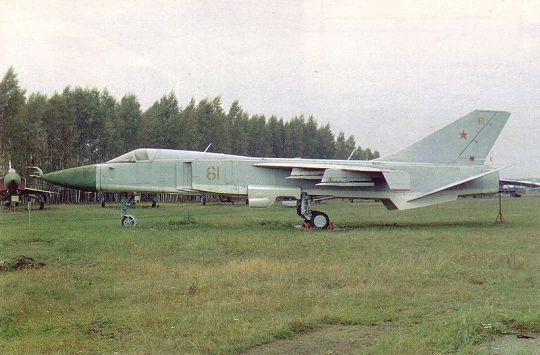
In the mid-1960s, the VVS was in need of a long-range, low-level precision strike aircraft to replace the failed Yak-28. MiG and Sukhoi had developed the MiG-27 and Su-17 aimed at filling this role, but they lacked the capabilities the VVS was looking for However, to get the Su-17 accepted into service, Sukhoi agreed to develop a precision strike variant. Initial plans centered around a lift-jet concept - an aircraft with a cranked-delta wing using lift jets to shorten the takeoff roll. Crew sat side-by-side, while two engines powered the aircraft. Designated the T-6, the prototype first flew in 1967. However, in late 1967, data provided by TsAGI convinced Sukhoi to change the design to a swing-wing design. Sukhoi altered the original design - keeping the side-by-side cockpit for the crew and twin engines, but eliminated the lift jets and replaced the cranked delta wing with variable-geometry wings.
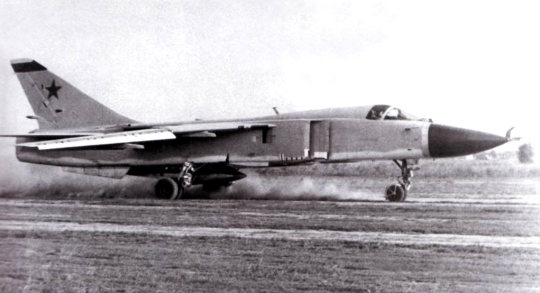
The new prototype took flight in January 1970. Testing continued until 1976, but production was ordered five years prior in 1971. Unlike previous Sukhoi aircraft, the Su-24 was an incredibly advanced strike aircraft. Optimized for low-level strike, the Su-24 can perform supersonic dashes at sea level, and can carry up to 8,000kg of ordnance on eight pylons. Compatible weapons include R-60 AAMs for defence, most unguided bombs and rockets, cannon pods, and a variety of guided air-to-ground and antiradiation missiles. Low-level precision strikes were facilitated by the use of onboard pulse-Doppler and terrain-following radars, several jammers and radar warning receivers, and radio targeting systems. For newer laser-guided weapons, a targeting pod could be mounted as well.

The Su-24 reached peak operational capacity in the mid-80s. With its formidable low-level strike capabilities, the Su-24 was slated to deploy tactical nuclear weapons in the event of war, and thus was constantly on alert. By the end of the decade, many had been transferred to the Baltic Fleet for the maritime strike role. The Fencer made its combat debut in the Afghan War in 1984. It flew a series of heavy bombing missions and precision strikes, but left the more dangerous close-air-support missions to the durable Su-17. Only in 1988 were strikes resumed, with the Fencer dropping cluster bombs, fuel-air-explosives, and FAB-500 and -1500 bombs to cover the withdrawal of Soviet forces.
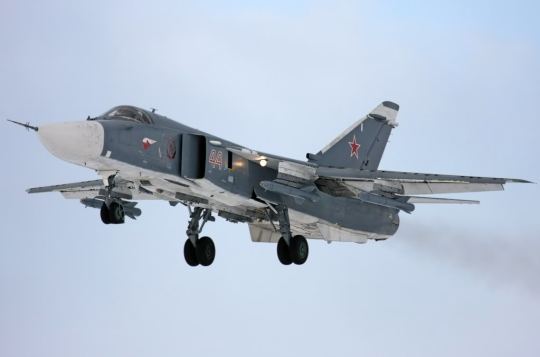
Since the end of the Cold War, the Su-24 has remained an important element of the VVS. Unlike the Su-17, the VVS has kept a sizeable fleet of over 300 Fencers in various roles. In the Chechen Wars, the Su-24 supported operations with bombing and reconnaissance sorties, and continued the practice later in the 2008 South Ossetia War. In 2000, Sukhoi pitched an upgraded variant of the Su-24 incorporating more powerful onboard systems and conformal fuel tanks, but, likely due to budget constraints, the VVS has instead opted for cheaper basic overhauls to extend the service life of the fleet.
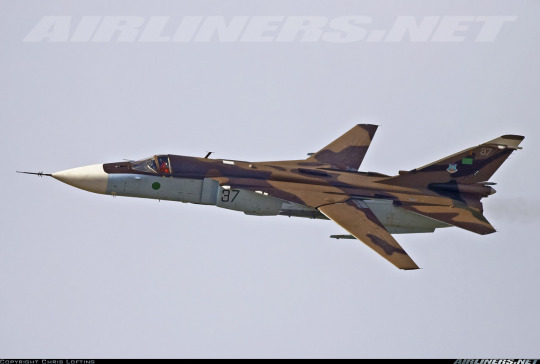
Despite the aircraft’s advanced nature, the Su-24 has seen some export. Iraq acquired 30 Su-24MKs after the Iran-Iraq War, only to lose five on the ground during Operation Desert Storm and have 24 more evacuate to Iran, never to return. The sole surviving Su-24 remained in service after the war. Libya also acquired several Su-24s, with the aircraft making an appearance in the 2011 Civil War. At least one such aircraft was downed during the conflict. Syrian Su-24s have fared little better in their ongoing civil war. Since the start of the civil war, at least two Syrian Su-24s have been downed by ground fire.
BAC/Dassault Anglo-French Variable Geometry

In 1965, Britain and France would come together to develop a two new combat aircraft. The first was to be a combat-capable advanced trainer (what would become the SEPECAT Jaguar) while the other would be a variable-geometry multirole fighter. Based off of earlier BAC design studies, the design was to fill French and British requirements for a high performance strike aircraft (particularly to fill the void left by the cancelled TSR-2), while meeting a British requirement for a replacement for the Lightning and a French requirement for a new carrier-based fighter. Working with Dassault, BAC modified their P.45 design study that the AFVG was based off of, adding Dassault’s distinctive shock-cone inlets and making use of engines jointly developed with the French. The final design was a two-seat aircraft intended to mount two SNECMA/Bristol Siddeley M45G engines. Armament would be two 30mm cannon, and, for the strike role, a single 2,500lb tactical nuclear store would be carried.
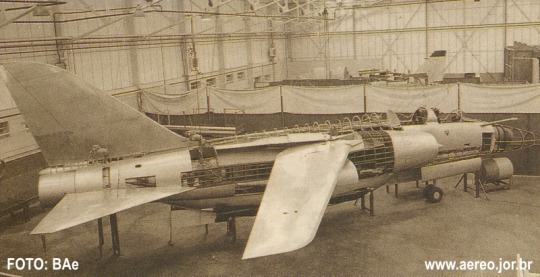
By 1966, developments in Britain had radically shifted the focus of the AFVG. F-4 Phantoms were procured to replace the Lightning, and the British hoped to fill the role of the aging Canberra bombers with the AFVG. Meanwhile, the French had been increasingly looking to develop the AFVG as a fighter. Requirements began to diverge, and further political developments (particularly the decision to procure the F-111K) cut into the potential AFVG order, bringing costs up. Although very general specifications were agreed upon in the middle of 1966, the Anglo-French committee was unable to finalize the requirements for the aircraft. Worse, cost projections pointed to skyrocketing expenses and unit costs. France was rapidly losing interest in the project, both due to rising costs and internal pressure from Dassault who was fairly actively working to undermine the program. France would withdraw in 1967, but the cancellation of the F-111K that same year left a massive capabilities gap among RAF strike aircraft. Thus, Britain had no option but to continue work on the AFVG alone. Although they would continue to look for foreign partners, BAC would soldier on alone for the time being to keep Britain’s last strike fighter program alive.
Dassault Mirage G

While the AFVG program was ongoing, the French defense ministry had requested Dassault develop a parallel swing-wing design capable of operating from carriers. Although such a design would directly compete with the AFVG, it received alarming support from the French government, who ordered a prototype in 1965. Dassault’s design, the Mirage G, was heavily derived from more conventional Mirage F2. The Mirage G retained most of the critical features of the Mirage F2, but replaced its wings with advanced variable-geometry wings fitted with full-span flaps. In March 1967, it was presented to BAC officials, and later that year it made an appearance at the Paris Air Show. By October 1967, it had flown for the first time. Tests of the single-engined Mirage G went well. In just 20 flights and 2 months of testing, the Mirage G had broken Mach 2 and demonstrated touch-down speeds as low as 108 knots.
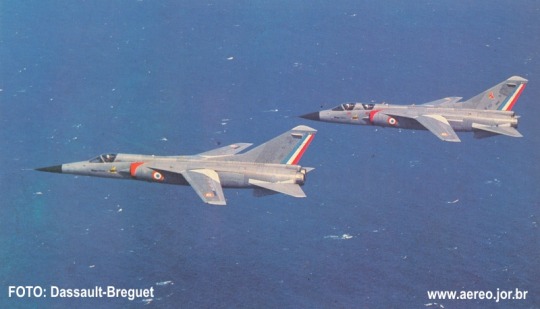
Although the single-engined Mirage G’s performance was satisfactory, France preferred a variant powered by two domestic SNECMA Atar 9 engines. Specifications were refined by 1968, calling for a two-seat nuclear strike fighter. Construction of prototypes for this new variant, dubbed the Mirage G4, began, but before they were completed, economic difficulties had put the project on hold. Hoping to salvage the work done on the program, requirements were changed once more to call for a single-seat interceptor, now designated the Mirage G8. The two incomplete Mirage G4 prototypes were converted to the smaller and cheaper G8 standard, although the first prototype retained the two-seat layout. These prototypes also were far more practical than the original Mirage G demonstrator - they were fitted with the navigational and attack radars to be used on production aircraft. The two-seat prototype took flight in May 1971, followed by the single-seater in July of the next year. Performance remained excellent - the second G8 even managed to set the continental speed record at Mach 2.34. Unfortunately, even this more practical design could not secure the aircraft’s future. No funding was allocated for the G8, and by the mid-70s, the Mirage G program had ended.
General Dynamics F-111K

Although Britain had been working on a domestic tactical strike platform (the BAC TSR-2) in the early 1960s, American enthusiasm over the F-111 coupled with ongoing efforts by the Labour government to do everything in their power to dismantle the British military meant the RAF was soon forced to evaluate the F-111 as a cheaper solution. With the future of the TSR-2 now uncertain, the Australians withdrew and selected the F-111C to meet their requirements, further undermining the project. Two years later, the TSR-2 was cancelled in favor of procuring 110 F-111s. A special variant would be made for the British - the F-111K. The F-111K would take the best elements from all variants - it had the wings of the F-111B, avionics developed from the F-111D, and undercarriage of the FB-111. Other changes included a revised weapons bay, integration with British reconnaissance packages, and an aerial refueling probe. Unfortunately, the Labour government felt they needed to undermine the F-111K as well. The planned procurement dropped to 50 aircraft by 1966, but by April a firm commitment had only been made for 10. Although the end of the AFVG seemed to secure the F-111K’s position, that was far from the case. Production delays and rising costs (due to the devaluation of the sterling) made the F-111K another easy target for the Labour government. In 1968 - a year after construction of the first airframes began - the F-111K was cancelled.
Fairchild Republic/EWR Advanced Vertical Strike

The end of the NBMR-3 program would not mark the last effort to develop a STOVL fighter by West Germany. In 1964, West Germany joined forces with the United States to develop a STOVL fighter to replace the F-104G. The project was ambitious - plans called for not only STVOL operations, but the use of variable geometry wings in the new fighter. EWR would handle the German side of things, while the US side was handled first by Boeing then Fairchild Republic. The joint project soon produced an unusual proposal. The AVS would be powered by two main engines with vectoring thrust (either a P&W JTF16 or GE 1/10) fed by top-mounted intakes to avoid ingesting hot gases. For vertical flight, the Rolls-Royce/Allison XJ99 lift engine was in development. Four of these engines were to be used, mounted in retractable pods stored under the wing glove. The project seemed to have advanced quite far, despite its complexity - various wind tunnel models were made, and even a full-scale mockup of the AVS was built. Unfortunately, the projected complexity (and consequent cost) of the fighter would be its downfall - West Germany cancelled the project in 1968, and America had no interest in pursuing the design for domestic use.
General Dynamics FB-111A/F-111G

With the program to replace the B-52 advancing at a glacial pace, SAC was in search of an interim strategic bomber to fill the gap. McNamara’s pet program would unsurprisingly be pitched as a solution, and by 1965, SAC had selected a new variant of the F-111 - the F-111B - as their new bomber. The FB-111A featured significant changes from the F-111A it was derived from. The longer wings of the F-111B marked the only significant external difference between the variants, while less visible changes included stronger landing gear, larger fuel tanks, more powerful engines, revised intakes, and a new avionics suite with improved navigation and capable of handling nuclear stores (including freefall bombs and the AGM-69 SRAM). The first FB-111A would fly in 1968, and plans called for 263 FB-111s to be produced. When the UK cancelled its F-111K order in 1968, components from the cancelled order were diverted to FB-111 production. In 1969, the order was cut to just 76 aircraft, with deliveries ending in 1971.
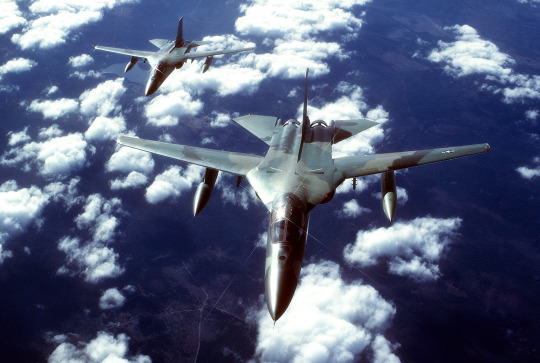
Given their more strategic role, the FB-111 fleet had a far quieter career than its cousins. When the B-1A was cancelled by the Carter Administration, the FB-111 became the basis for several proposals for improved variants. The FB-111B would have a stretched fuselage to mount GE F101 turbojets, while the FB-111H took it a step further, lengthening the fuselage even more to improve range and payload along with incorporating an avionics upgrade. However, these proposals couldn’t compete with the B-1B program when it was revived by Reagan, so they were abandoned. After the B-1B finally came into service, 51 FB-111s were retired from the strategic bomber role and converted to F-111Gs. Now serving with TAC, the F-111Gs had their nuclear strike capabilities eliminated and modifications were made to allow them to better handle conventional stores. Unfortunately, the F-111G’s career was brief. The F-111 was already on its way out when the conversion began, and in 1991 surviving FB-111s were retired. Two years later, the F-111G fleet followed suit, although 15 were purchased by Australia, who flew them until 2007.
Mikoyan Gurevich MiG-23BN/MiG-27 “Flogger-H/Flogger-D/J”
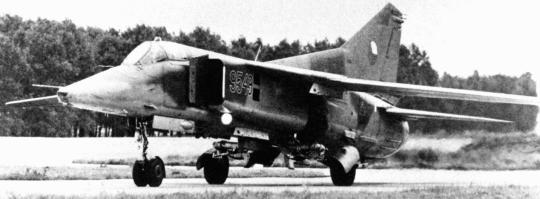
As part of the effort to upgrade the VVS-Frontal Aviation strike force at the end of the 60’s, Mikoyan Gurevich was commissioned to develop a new attack platform. After much consideration, it was determined that the fastest and cheapest solution was to adapt their MiG-23 fighter. Under the designation MiG-23B, a prototype would fly in 1971. The MiG-23B externally was identical to the standard MiG-23, but it featured various changes. Four new pylons would carry a heavy payload, and a new AL-21F engine was supplemented by added internal fuel tanks. Extra armor around vital systems was added, and the air-to-air avionics of the MiG-23 gave way to a new attack-oriented suite. Issues procuring enough engines meant that, while the MiG-23B would be ordered into production, it was to mount a different engine - the R-29B. After a minor redesign to fit the new powerplant, the new attack-Flogger would enter production as the MiG-23BN.

Despite the appearance of the MiG-23BN, the VVS-FA would operate only about 100 of the type. This wasn’t so much due to problems with the MiG-23BN, but the arrival of a newer variant - the MiG-27. Simplified intake ramps, strengthened landing gear, and added pylons improved payload to 4,000kg, while the MiG-23’s GSh-23L gave way to the GSh-6-30 gatling gun. A new digital nav-attack system reduced pilot workload, especially during the guidance of air-to-ground missiles, and a heads-up-display was added. The MiG-27 would take flight in late 1972, and by the next year it was in production. Thus, the MiG-23BN production line could be shifted over to deal with export orders, while the MiG-27 would go directly to VVS-FA.
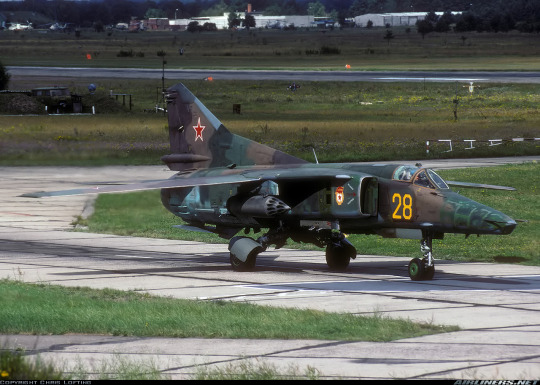
Unfortunately for all the effort put into refining the attacker-Floggers, those serving with the VVS-FA would have to wait quite a while to see combat. While the USSR would be involved in Afghanistan for a decade, the Su-17 would be doing all the heavy lifting while Floggers remained elsewhere. In 1988, a single air regiment was finally deployed for a combat evaluation. Results were predictable - the MiG-27 performed its job well, but in the low-intensity environment of the war, such a heavily armored, technically advanced strike aircraft was a bit overkill. The biggest issue found was with the MiG-27’s gun - the high rate of fire caused intense vibrational issues that almost always broke landing lights, and even after reducing its fire rate, the gun often presented a danger of cooking-off its ammunition after extended bursts. Worse, the gun itself was very maintenance-intensive.

In export service, the attacker-Floggers were popular aircraft. Nearly every Soviet-aligned nation would come to fly the type in some capacity, almost always flying the downgraded MiG-23BN rather than the Soviets’ MiG-27. India was a particularly enthusiastic operator, acquiring almost 100 Floggers for use as SEAD, precision strike, and reconnaissance aircraft. Iraq would also operate a number with success in their war with Iran. Iraqi MiG-23BNs were notable for the addition of a fixed refueling probe and the French-made ATLIS targeting pod. Currently, the MiG-23BN and MiG-27 still fly with several states in Africa and Asia, although the Indians and Russians have moved their fleets to reserve or retired them entirely.
General Dynamics F-111C
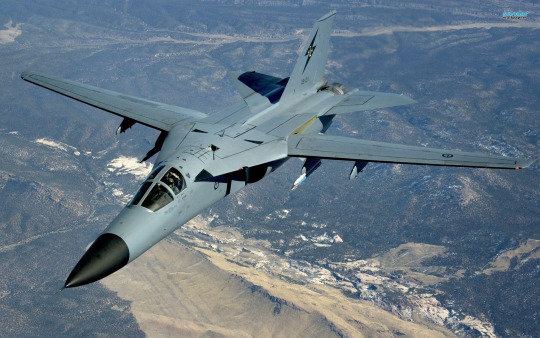
By the end of the 1950s, Australia was in search of a replacement for their Canberra bombers. Although they were at first showing interest in the BAC TSR-2, they set aside funds in 1963 to evaluate various foreign proposals, including the American TFX. Because the TFX was both cheaper and not threatened with cancellation, the Australians selected the TFX to meet their requirements. Of course, the order would require a special variant to be developed, but unlike the later British order, the resulting F-111C would be a fairly simple modification. Apart from the use of the longer F-111B wings and strengthened undercarriage of the F-111D, the F-111C was merely a standard F-111A. The first F-111C would fly in July 1968, and deliveries would begin later that year. However, due to a host of structural issues and problems with the original intakes delayed the type’s entry into service. Worse, the cancellations of the British and USN orders, coupled with the loss of three F-111As due to mechanical failure in Vietnam and rising costs associated with the program made the F-111C order a controversial issue in Australia.

Fortunately, by the time the F-111C entered RAAF service in 1973, the flaws had mostly been dealt with and the controversy evaporated. With the arrival of their Aardvarks, the Australians returned the F-4 Phantoms that had been loaned as a stopgap by the USAF. The new aircraft greatly expanded the RAAF’s capabilities. They could now strike anywhere in Indonesia (their main rival) with aircraft based in Australia, and, unlike the Canberras they replaced, the F-111C featured an advanced avionics and countermeasures suite. Several upgrade programs were conducted through the F-111C’s career. In 1979, four were converted for reconnaissance duties, and in 1983, minor upgrades centered around compatibility with the PAVE TRACK FLIR pod. In the 90’s, upgrades focused on updating the engines and making use of the newest digital avionics. For all Australia’s love for the machine, service has been fairly quiet. Apart from reconnaissance flights flown over East Timor during Australia’s involvement in the region, the F-111C has seen no operational use (though they were on standby for launching strikes if the situation required). Unfortunately, the F-111 wouldn’t last forever. In 2010, the aging airframes were replaced with Super Hornets (although not without controversy).
Panavia Tornado
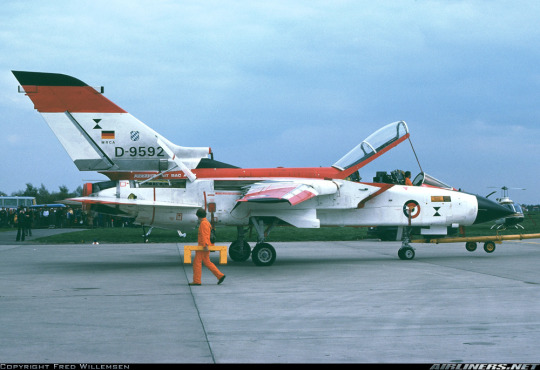
In the aftermath of the collapse of the AFVG, Britain was in search of a new partner to develop their strike aircraft. For about a year, they worked alone on the design, but by mid 1968 they had gained the interest of Germany and Italy. By 1969, the three countries had come together to create the Multirole Combat Aircraft program, merging their interests into a multinational consortium named Panavia. Work was split evenly between BAC and MBB (42.5% each) while Aeritalia picked up the difference. Although preliminary requirements called for an aircraft very similar to the failed AFVG - a two-man multirole fighter with an emphasis on strike - significant changes would be made to the design before it left the drawing board. The MRCA would be slightly larger than the AFVG, and the distinctive inlets developed by Dassault were replaced with new square ones. However, the general layout remained the same, allowing development to move comparatively quickly.
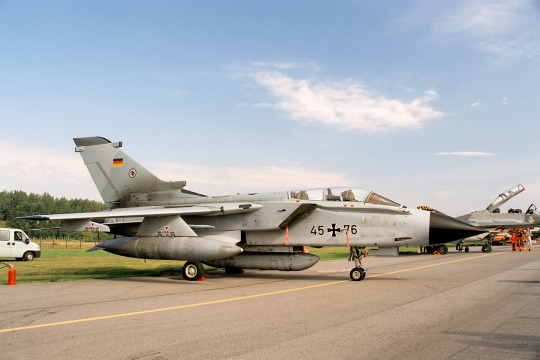
Although rising costs and delays threatened the program several times, the MRCA - now called the Tornado - took to the skies in 1974. By this time, the unit cost had almost doubled, bringing it on par with the American F-111 in terms of cost. The Tornado was hardly a bad aircraft, however. Though nominally multirole, the Tornado was primarily focused on strike operations, and consequently was filled with advanced ground-attack avionics. Advanced terrain-following radars were added to facilitate low-level strikes, and the Tornado was made compatible with just about every guided munition in the NATO inventory. On paper, many aspects seemed to be a step down from the proposed AFVG - it was slightly slower, shorter-ranged, and carried only a single internal cannon. However, the advanced onboard systems more than made up for the perceived shortcomings of the design. Even with all the controversy over delays and rising costs, the Tornado would be a success - the first orders were placed in 1976, and over 800 would be ordered for the three nations of the Panavia consortium.
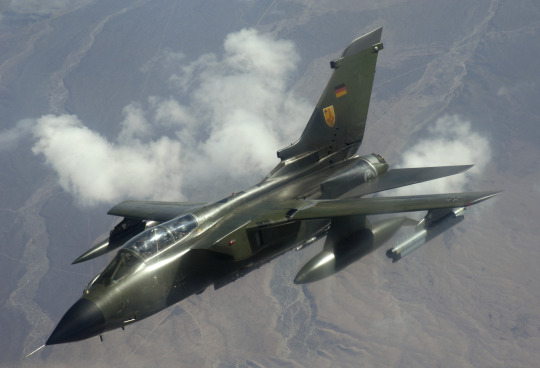
Germany would be the first recipient of the production Tornado, with the first deliveries coming in mid 1979. Replacing the unpopular F-104G, the Tornado was a massive step up in capabilities for the Luftwaffe. The Marineflieger would get their first aircraft soon after, configuring their aircraft for reconnaissance and anti-shipping duties. Italy would come to operate comparatively few Tornadoes - their 100 Tornado IDS were fewer in number than those flown by the West German Marineflieger. The RAF, on the other hand, was a particularly enthusiastic operator - they procured not only the standard IDS strike variant flown by other countries, but developed the Tornado ADV for interception duties as well. The Tornado ADV replaced the ground-attack avionics of the Tornado IDS with air-to-air radars and did away with provisions for air-to-ground armament, instead replacing them with hardpoints for up to four short-range AAMs under the wings and four semi-recessed hardpoints for long-range AAMs.
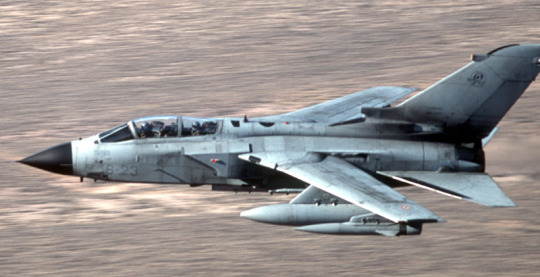
By the late 80’s, Germany and Italy had decided they wanted a dedicated SEAD platform developed from the Tornado. Dubbed the Tornado ECR, the new variant would add various radar warning receivers and provisions for using the AGM-88 HARM. The Luftwaffe would order 35 new-production ECRs, which had their cannons removed but added a built-in reconnaissance systems, while Italy converted 16 of their standard Tornado IDS, retaining the cannon and forgoing the recce systems. Deliveries would begin in 1990, continuing through the decade. Meanwhile, the RAF took to conducting a general mid-lift overhaul for the fleet, bringing them from the GR1 to GR4 standard. The GR4 upgrades generally focused on updating avionics and integration with newly developed guided munitions.
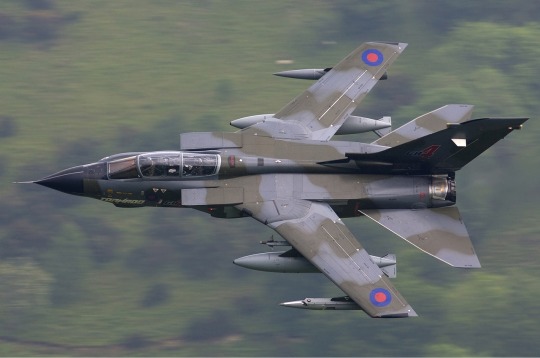
Although it entered service in the mid-70’s, the Tornado remained stationed in Europe until the end of the Cold War and thus wouldn’t make its combat debut until 1991. During the Gulf War, the RAF deployed a sizeable force of Tornado GR1s along with several ADVs to the region. Italy would also commit a contingent, and the Saudis committed their ADVs. Early sorties involved low-level raids on Iraqi airfields with a mix of general purpose and runway denial bombs. As the Tornadoes were not yet equipped with targeting pods, Blackburn Buccaneers were deployed to illuminate targets with lasers for destruction by the Tornadoes. As the war continued, Tornadoes switched to medium-level sorties on strategic targets. Overall, Coalition Tornadoes proved very effective in the war - across countless sorties, only seven Tornadoes were lost, despite flying incredibly dangerous missions in contested airspace. After the war, Italian and British Tornadoes remained in the region to support the No-Fly Zone over Iraq.
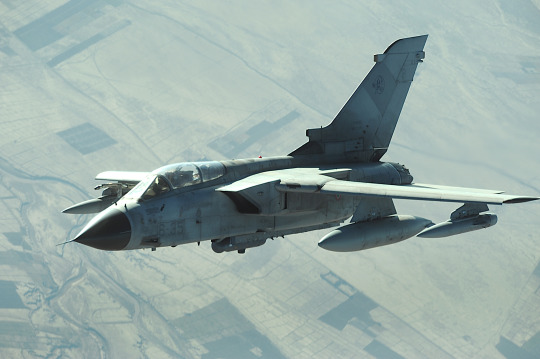
When NATO got involved in Yugoslavia in the 90’s, German Tornadoes would finally get to make their combat debut. Flying out of Italy, they were tasked with tactical reconnaissance and the occasional SEAD mission, while the more numerous Italian and British examples handled actual attack missions. German and British Tornadoes would later be deployed to Afghanistan, while British Tornadoes participated actively in the invasion of Iraq in 2003. Although active numbers have dropped in recent years, none of the four operators of the Tornado have fully retired their fleets yet. Rather, they have been modernized in recent years with the intention of keeping the aircraft in active service until at least 2020. Britain very well may keep the Tornado around longer - a new wave of upgrades was conducted this decade, and the GR4s have had an active role in the bombings of Libya and ISIL-held territories in recent years.
Enhanced Tactical Fighter
At the end of the 1970s, the USAF began preliminary studies for a replacement for the F-111 and remaining F-4s. Studies looked at both procuring further F-111Fs as well as creating a new variant of the F-15 to meet the requirement. As requirements shifted to call for reasonable air-to-air capabilities, the F-111 was dropped from consideration, as were proposals to procure the Panavia Tornado. When the Enhanced Tactical Fighter program finally commenced in 1981, requirements were for a fighter capable of performing deep interdiction strikes without fighter or jamming escort. Only two proposals would be considered - McDonnell Douglas’ F-15E and General Dynamics’ F-16XL. Both were notable in that their development had been underway long before the USAF had begun the program.
General Dynamics F-16XL
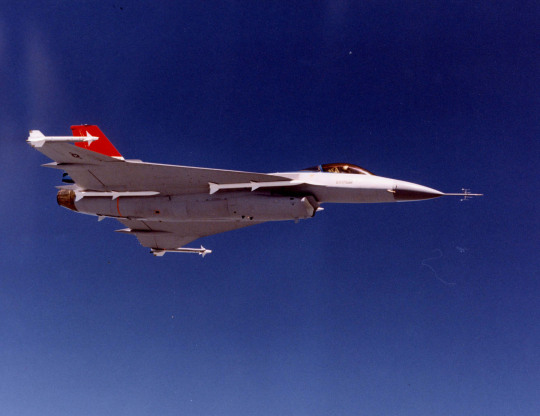
General Dynamics’ ETF design had its origins in the 1977 Supersonic Cruise and Maneuver Prototype (SCAMP) project. Working with NASA, GD had developed a cranked-arrow wing for the F-16. The new wing was intended to improve supersonic performance, but it also had the benefit of being able to carry far more fuel. Even better, the typical downsides of the tailless-delta layout the SCAMP had were largely negated by the F-16’s fly-by-wire system. Less notable but just as important was the 40-inch fuselage stretch, providing more room for fuel and reducing supersonic drag. In 1979, the SCAMP had gained the USAF’s attention, and preliminary design work to militarize it began. Now working under the designation F-16XL, the details of the design were finalized. 27 hardpoints were placed around the aircraft, including four semi-recessed stations for AMRAAMs, two wingtip rails, a centerline hardpoint, two chin stations for targeting pods, two “wet” wing pylons, and 16 wing hardpoints rated for 750lb payloads. The fuselage extension grew to 56 inches, and the total fuel capacity increased 82% over the original F-16. The new wing also provided significantly better performance, improving lift-to-drag ratio by 25%. In all, the F-16XL would be capable of carrying double the payload of the F-16 up to 40% further.

Despite being a radical reworking of the parent aircraft (compared to McDonnell Douglas’ proposal) and the extensive use of composites in the design, the F-16XL prototypes were completed surprisingly fast. Little over a year after the ETF program began, the first F-16XL flew. Two prototypes - a single seater and two-seater - were made, converted from F-16As. Initial testing centered around supercruise evaluations, but the F-16XL was unable to meet the performance goal. Testing quickly shifted focus to the ETF evaluations. Testing went on for two years, but ultimately the USAF decided to go with the F-15E due to the type’s greater commonality with aircraft already in production, two engines, and all-around better performance. The F-16XLs were put into storage for several years before being handed over to NASA in 1988. NASA experimented with laminar flow wing devices and new engines. The two-seater F-16XL, after being fitted with a new engine, would accidentally achieve supercruise while testing a new wing glove. Testing continued into 1999, when the aircraft were returned to storage. NASA briefly looked into returning the aircraft to service in 2007, but the aircraft never got past taxi tests. Ultimately, the F-16XLs were permanently retired in 2009.
McDonnell Douglas F-15E Strike Eagle
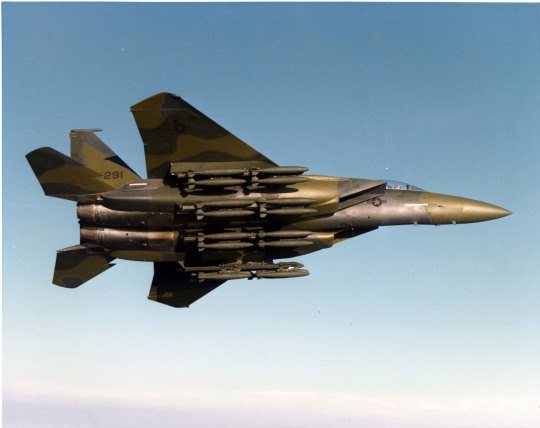
McDonnell Douglas had been working on a multirole version of the F-15 practically the minute it took flight. Hardpoints were configured to allow the aircraft to carry up to 18 500lb bombs, and the very first production machines were fitted with the wiring for carrying various bombs. However, the Air Force had no need for a multirole F-15 at the time, so the Strike Eagle remained a low-priority project for some time. When the USAF began looking for an F-111 replacement, McDonnell Douglas accelerated work, ultimately teaming up with Hughes to develop the air-to-ground capabilities of the F-15. The TF-15A prototype was modified using company funds, first flying in July 1980. Outfitted with previously developed conformal fuel tanks and a Pave Track targeting pod, it would form the basis for the F-15E. The Strike Eagle prototype would fly off against the F-16XL in trials, winning the competition thanks to its superior performance, two engines, and minimal modifications of a proven airframe. Production of the F-15E began in July 1985, and by the end of the next year it was flying. In 1989, the Strike Eagle reached IOC.
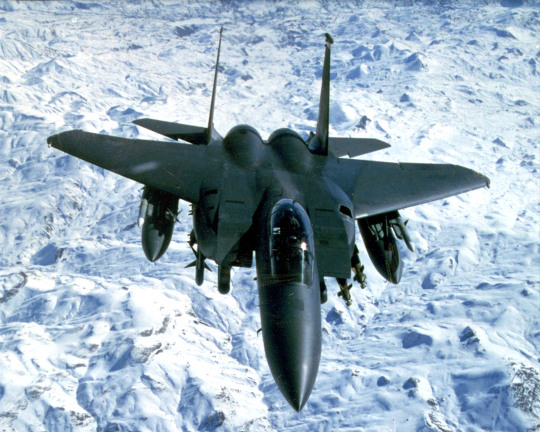
The Strike Eagle that entered service in 1989 was far more than just a quick conversion of the two-seater F-15s. Cockpits were completely redesigned, and the rear cockpit was reconfigured for the WSO to manage the various air-to-ground systems. The old analog flight control system was replaced by digital fly-by-wire, and the multimode AN/APG-70 radar preserved the air-to-air capabilities of the F-15C while also allowing the mapping of ground targets. The conformal fuel tanks were modified to mount several hardpoints for 500lb bombs, providing a total payload capacity of 23,000 lb. Given that low-altitude missions were expected to be frequent, the Strike Eagle’s airframe was strengthened. In all, the changes increased empty weight by about 3,000lb and max takeoff weight by 13,000lb. To compensate for the added weight, the Strike Eagle was designed to accommodate the P&W F100 and GE F110 engines, requiring minor modifications to the rear fuselage.

The Strike Eagle would make its combat debut over Iraq in 1990, when the aircraft were deployed in reaction to Iraq’s invasion of Kuwait. Strike Eagles would prove invaluable to the air campaign. They supported opening actions of the Desert Storm air campaign, blasting a hole in the Iraqi IADS and then streaming deep into Iraq to attack SCUD launchers, airfields, refineries, and command and control centers. At night, Strike Eagles roamed the skies over Western Iraq, searching for mobile SCUD launchers and attacking targets of opportunity. They also supported special forces on the ground deep inside Iraq, ultimately scoring the type’s only aerial victory of the war during one of these support missions. Spotting a flight of Mi-24s unloading troops, a Strike Eagle targeted one of the helicopters with a GBU-10, hitting it about 800 ft off the ground. Closer to the front, Strike Eagles were also flying alongside F-111s, performing the same “tank plinking” missions against Iraqi vehicles.
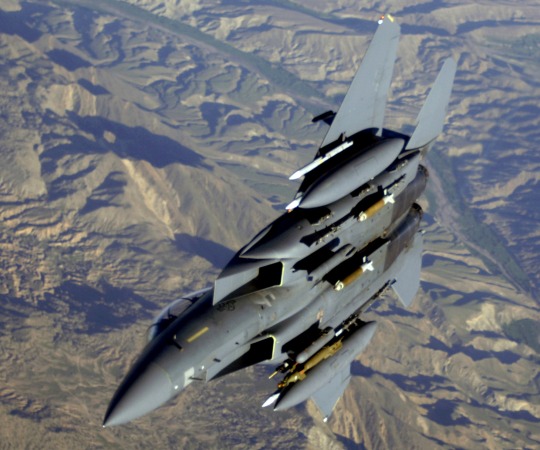
Through the rest of the decade, the Strike Eagle would prove invaluable in the enforcement of the no-fly zones over Iraq. F-15Es performed regular patrols, their excellent endurance meaning they could easily be vectored off to punish violators. For larger punitive actions, Strike Eagles would also make a showing. Towards the end of the decade, these punitive strikes increased in intensity, primarily targeting SAM sites. Similar operations took place over the Balkans. Operation Deny Flight saw 2,500 Strike Eagle sorties flown over Bosnia, again primarily targeting air defenses, and Deliberate Force would see operations expanded into anti-armor duties. Operation Allied Force involved a mix of the standard SEAD operations the Strike Eagle had flown in previous years as well as a new combat patrol pattern. The new pattern involved long patrols with two refuelings and a heavy mixed payload, allowing them to loiter until a target arose or ground forces requested close air support.

In the post-9/11 rampage across Afghanistan, Strike Eagles were flown out of Kuwait to support the invasion. On the first night of the campaign, Strike Eagles hit everything from Taliban supply depots to al Qaeda caves. Without any serious threat in the air immune to the MANPADS that formed the Taliban’s air defense network, the Strike Eagles operated with impunity and quickly ran out of targets. As the war deteriorated into a counterinsurgency effort, the long patrols that had been developed over Kosovo in 1999 would become the norm for the F-15E. The Strike Eagle would get to have a bit more fun during the invasion of Iraq that followed. Similarly impotent air defenses ensured the Strike Eagles could largely operate with impunity, but the Iraqis offered far more targets for the aircraft overhead. F-15Es were credited with destroying 60% of the Iraqi Medina Republican Guard, as well as 65 enemy aircraft on the ground. Working closely with other strike aircraft, they also targeted the command and control centers for the Iraqi IADS. Their flights were not completely without danger, however - one Strike Eagle was downed during the invasion. Strike Eagle operations in more recent years have been limited to low-intensity bombing campaigns like the ones over Libya or against ISIS/ISIL/the Balsamic State/Rainbow Daesh - Jihad is Magic.

Since the retirement of the F-111, the Strike Eagle has come to be the only true strike fighter in the USAF inventory. Though payload has slightly reduced from the aircraft it replaced, its compatibility with most everything in the USAF inventory means that it’s expected to serve well into the new millennium. The Strike Eagle is expected to outlive the pure-fighter F-15Cs thanks to their newer airframes and more versatile role, and there is currently no slated replacement for the F-15E. In 2007, the Strike Eagle fleet began a major upgrade, installing AESA radars and general avionics upgrades to keep the aircraft competitive into the new millennium. Although the design itself may seem dated, the Strike Eagle has seen considerable export success, flying with Israel, Korea, Saudi Arabia, and Singapore, each in their own specially modified variants. All in all, despite being derived from one of the very first fourth-generation fighters, the Strike Eagle looks like it will be sticking around at least until the arrival of the sixth generation.
Lockheed F-117 Nighthawk
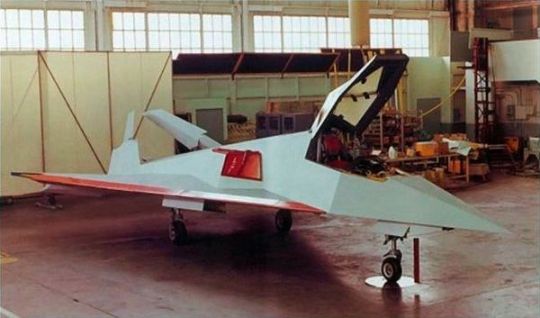
The world’s first operational stealth aircraft would trace its origins all the way back to 1974, when DARPA initiated the Experimental Survivable Testbed program. Though Lockheed was not originally included in the program, they successfully lobbied to be included, ultimately producing a design that became the frontrunner alongside the Northrop competitor, winning a contract for prototypes. Designated HAVE BLUE, the XST demonstrator was an ugly, heavily faceted aircraft, a product of the comparatively low power of computers at the time. Covered in RAM, it had a wing sweep of 72.5 degrees and vertical stabilizers canted inwards over the exhaust to hide their IR signature. Intakes were covered with a radar-blocking mesh, while the engine exhaust ports were an unusual flat shape, further reducing IR signature. Though incredibly advanced on the outside, the HAVE BLUE demonstrators salvaged most of their parts from other aircraft - flight control systems were modified from an F-16’s, while the ejection seat, landing gear, and cockpit instrumentation were taken from an F-5. Being purely testbeds, the HAVE BLUE demonstrators were incredibly compact, and they had an endurance of just an hour.
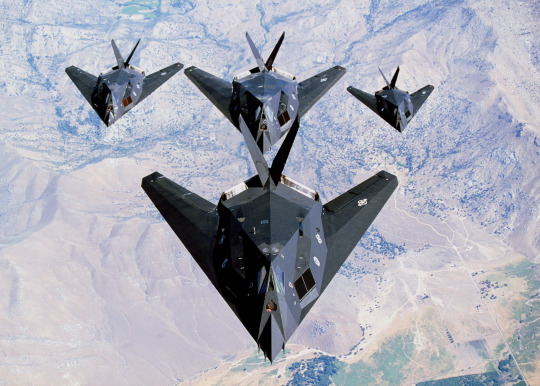
Testing began at the end of 1977 in extreme secrecy. Though it was by no means invisible to radar, the stealth aspects of the design were without a doubt a success, reducing detection ranges significantly. However, the low RCS was the result of fine tuning the design - seemingly minor things like bird shit or screws sticking out too far were found to cause significant increases in the RCS. Though both HAVE BLUE demonstrators were lost in crashes, testing went well enough for a full-scale combat aircraft to be ordered. Lockheed had proposed two developments of the design - a two-man four-engined bomber and a single-seat strike fighter. Under the codename SENIOR TREND, the design was tweaked and enlarged. Wing sweep was reduced to 67.5 degrees to improve aerodynamic performance, and the tailfins were revised and canted outwards. A full avionics package was added, as were larger fuel tanks, a refueling receptacle, and a bomb bay for two 2,000lb laser-guided bombs. As conventional radar-based navigation systems would compromise the stealth focus of the design, SENIOR TREND was given an inertial navigation system and various infrared sensors in lieu of radars.
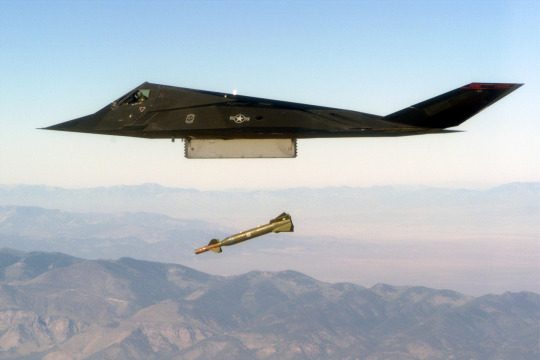
Lockheed would receive a contract for full development of the design in 1979, and by 1981, the first prototype had flown. While it was hard to fly even with the fly-by-wire controls, work continued. Ultimately, the design was designated “F-117A” - despite having no air-to-air capabilities - and by Christmas 1982, the F-117 had reached IOC. Though the F-117 remained a secret, the USAF was incredibly enthusiastic about the plane. Original plans for just a single squadron of 18 aircraft gave way to a total production run of 59 aircraft. Unfortunately, the secrecy surrounding the aircraft prevented it from seeing combat for some time. It was considered for retaliatory strikes in Lebanon in 1983 and Libya in 1986, but both times the missions were given to conventional aircraft instead. The F-117 remained a secret through the end of the decade, finally being revealed to the public in 1988.
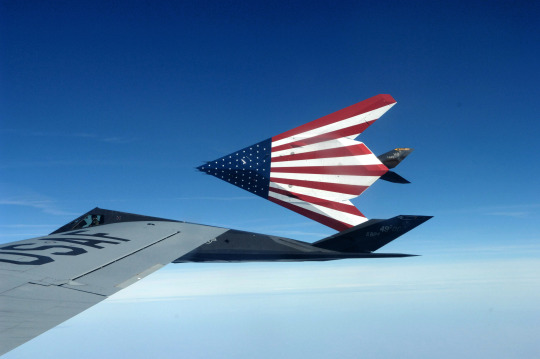
The Nighthawk would finally make its belated combat debut in 1989, when the US invaded Panama. Though the Panamanians lacked air defenses, the aircraft were called in for their precision strike capabilities, which they excelled at. They got their first real test in 1991, when Iraq invaded Kuwait. In the early morning hours of January 15, 1991, a formation of F-117s appeared undetected over Baghdad. After surprising the Iraqis with attacks on various communications centers, the nearly 4,000 AA guns defending the city opened up. Over the course of the night, three waves of Nighthawks hit Baghdad. Though the skies were ablaze with gunfire, the strike aircraft were untouched, remaining invisible to Iraqi radars. Over the course of the war, they continued to fly strikes against some of the most high-value targets in Iraq. By the time the war ended, the 40 F-117s deployed had flown 1,270 sorties, dropping 30% of the guided bombs deployed in the war.

Postwar, the F-117 continued to fly over Iraq in support of the No-Fly Zones. In addition to using LGBs, they were fitted with HARMs, working with F-16s acting as bait to destroy Iraqi radars. In 1997, all f-117s were grounded following a crash, but in 1999 they returned to service to participate in the NATO intervention in Serbia. Unfortunately, this deployment would result in the only combat loss of an F-117. After flying multiple missions on the same predictable path, one Serbian SAM crew picked up on the consistency. Unprotected by ECM, the Serbs were able to track an F-117 by modifying their radars, allowing them to fire an SA-3 and down the aircraft. Though the incident was significant, it was deemed to be more the result of excellent work on the part of the Serbs coupled with poor operational planning. Despite the shootdown, Lockheed continued to upgrade the surviving fleet to keep it competitive. A new wave of modernization expanded the F-117’s catalog of weapons, improved navigation systems, and added newly developed RAM to reduce maintenance and keep RCS low. Though plans originally called for the F-117 to stay in service until 2018, the arrival of the F-22 changed that. The F-22 could do everything the F-117 could and more, and, with the Nighthawks being so expensive to fly for such a niche role, they were finally put of for retirement. In 2008, the last F-117 was retired, with the fleet mothballed to allow them to return to service if the need arises.
Chinese Strike Fighters
Although China was an enthusiastic operator of the Q-5, glaring flaws in the design were revealed during the Battle of the Paracel Islands in 1974. Lacking in range and payload, the Q-5 was unable to provide air support for ground troops. Both the PLAN and PLAAF recognized the need for a more sophisticated aircraft with a longer range, higher payload, and all-weather capabilities, and in June 1976, engineers from Nanchang, Xian, and Shenyang were summoned to Beijing to receive the specifications. The resulting designs would vary widely. Nanchang’s Q-6 would be heavily derived from foreign designs, while Shenyang would propose a simple ground-attack variant of their J-8, only to have their proposal rejected. In the end, Xian’s clean-sheet proposal - the JH-7 - would be the most successful.
Nanchang Q-6
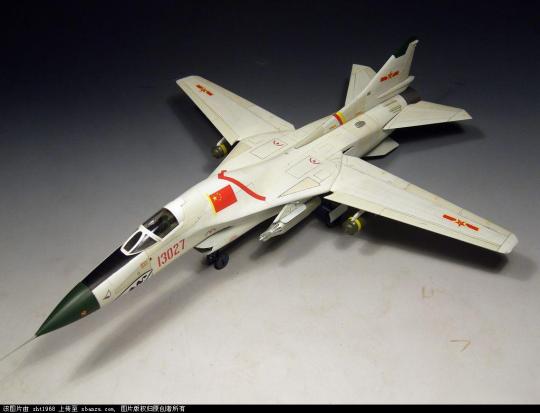
Nanchang’s Q-6 would effectively be an unusual amalgamation of Soviet and American aircraft technology. Although their main source of Soviet technology had been cut off following the Sino-Soviet split, China managed to acquire several MiG-23s from Egypt, which they immediately went to work on reverse-engineering. Nanchang took the MiG-23BN design and refined it, presenting a proposal for a 14.5 ton aircraft with a 4.5 ton payload and 900km combat radius in 1979. The PLAAF and PLAN would change their requirements to call for an attack radar, to which Nanchang responded by adapting avionics taken from F-111s downed in Vietnam to the design. Such a large radar forced a complete redesign of the nose, raising the cockpit and pushing the intake into a ventral position. As Chinese industry was not up to the task of miniaturizing electronics as well as the West had, Nanchang was forced to enlarge the aircraft, ultimately bringing it up to the size of the Su-24 rather than the MiG-23. Worse, they struggled to copy the swing-wing mechanism of the MiG-23, resulting in a system significantly larger and heavier than that which they copied. As more difficulties arose, the competing JH-7 was becoming ever more attractive. With smoother development and a two-man crew more suited to strike missions, the JH-7 would catch the attention of the PLAAF and PLAN, and Nanchang would not be able to shift the focus back to their design. Nevertheless, Nanchang worked hard to refine the Q-6 into something competitive, finally making a breakthrough by the end of the 80’s. By then, however, it was too late. The JH-7 would fly at the end of 1988, ultimately signaling the end of the Q-6.
Xian JH-7 “Flounder”

Oddly enough, the only successful design to come from the PLAAF/PLAN specifications was the only clean-sheet design. Beginning development as the H-7, Xian envisioned two variants of the design - a tandem-cockpit variant for the PLAN and a side-by-side seating variant for the PLAAF. However, PLAAF interest waned by the early 80’s, leaving the project as a pure PLAN venture. As the design finalized, the designation morphed to JH-7 - fighter-bomber. The final design was superficially similar to the SEPECAT Jaguar, although it was significantly larger and about twice as heavy. As originally designed, it was to carry the domestic WS-6 engine, but underwhelming performance and poor production quality forced Xian to substitute the Rolls-Royce Spey. The first of six prototypes would fly at the end of 1988. Along with a 23mm cannon and six plyons, the JH-7 prototypes were fitted with a multimode radar for tracking surface and air targets. Unfortunately, early production JH-7s were plagued by quality control issues, ranging from severe vibrations literally shaking the instrument panel apart to the entire rudder falling off in flight. Though it nominally entered service in 1994, it wouldn’t really see significant use until the arrival of the significantly improved JH-7A.
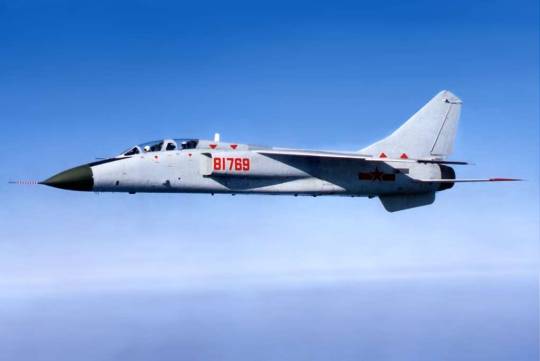
The JH-7A would follow up on the original design, massively expanding capabilities. Extensive modifications to the airframe both strengthened and lightened it, expanding payload to 9 tons and allowing the JH-7A to carry four antiship missiles rather than the two of the JH-7. Multifunction displays were added to the cockpit, and newly developed radars, countermeasures, and a helmet-mounted sight were installed. The JH-7’s ability to deploy guided weapons expanded, and two more wing hardpoints were added. Despite all the improvements to the airframe and electronics, engine troubles persisted. China struggled to copy the Spey powerplant, meaning that JH-7 testing and production was heavily reliant on imported engines for some time. Only around the turn of the century did domestic production of the Spey begin as the WS-9, meaning that the JH-7A wouldn’t enter service until 2004.
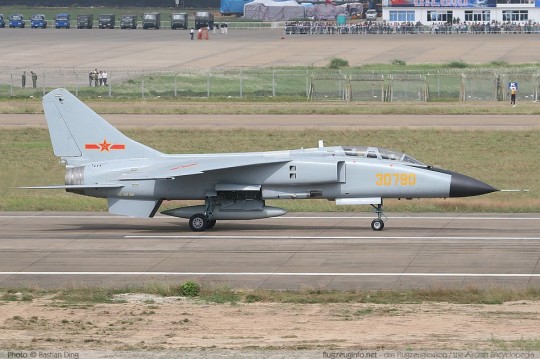
Although the PLAAF had pulled out of the project early in its development, they would reverse their decision as the JH-7 began to enter production. The PLAAF and PLANAF each operate 120 JH-7As, and although the initial production run for the aircraft has ended, there has been significant interest in starting production of the JH-7B, which would incorporate further avionics upgrades, an aerial refueling probe, and RCS-reducing features. Although all JH-7 variant have featured radars with air-to-air capabilities, they don’t seem to be flown as fighters, and, given that they’re only capable of mounting the short ranged PL-5, -8, and -9 AAMs, the fighter capabilities seem to be defensive more than anything else. Currently, the future of the JH-7 is uncertain. The JH-7B was expected to enter production in 2015, but it’s unclear if it has done so, and with the newest generation of multiroles coming along with similar capabilities, the need for such a platform seems to be reduced. Furthermore, despite being offered for export, the JH-7 has failed to attract any customers. Whatever the case, the JH-7 will likely stick around for a while, if for no other reason then that there are aircraft still in service with the PLAAF and PLANAF that are in far more urgent need of replacement than the JH-7 (particularly the J-7/MiG-21, Q-5, and J-8).
Vought YA-7F
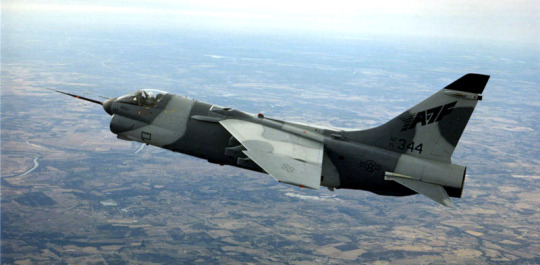
In 1985, the USAF issued preliminary requirements for a CAS/interdiction platform. Vought decided, rather than submit an entirely new design, to propose an extensively upgraded variant of the venerable A-7. The proposal was a significant divergence from the original A-7, designed around the P&W F100 engine to give the design supersonic performance. Originally known as the A-7D Plus, it was contracted in 1987 as the A-7F. The A-7F would require a 4-foot fuselage extension to accommodate the new engine, and a larger tail assembly and leading-edge-root-extensions were added to improve handling. Though avionics were unchanged in the YA-7F prototype, plans called for production aircraft to have significant upgrades in that area as well. The YA-7F would fly at the end of 1989. Testing went smoothly, and proposals were tendered to bring about 400 A7Ds of the ANG as well as the Navy’s A-7Es to the A-7F standard. Unfortunately, these coincided with the end of the Cold War. The Corsairs then in service were retired rather than upgraded, and the program that brought about the YA-7F was terminated.
Advanced Tactical Aircraft - ATA
As part of efforts to upgrade the inventory, the Navy began a search for a new strike aircraft to replace the A-6 Intruder in 1983. Under the program name Advanced Tactical Aircraft, the Navy asked for a carrier-capable strike aircraft, aimed at replacing the aging A-6. Paralleling the Air Force’s Advanced Tactical Fighter program, the Navy would request that stealth be an integral part of the design. Additionally, contractors were encouraged to team up to improve efforts rather than submit countless single proposals. Thus, Northrop, Grumman, and Vought would form one group while McDonnell Douglas and General Dynamics would create a competing proposal. The program was to be incredibly valuable - the Navy and Marines planned to procure almost 900 examples of the ATA, while it also caught the attention of the Air Force and the RAF, who considered replacing their F-111s and Tornadoes, respectively, with the ATA.
Northrop/Grumman/LTV ATA Proposal

Northrop, Grumman, and Vought would develop a proposal heavily based off of Northrop’s extensive work with the Advanced Technology Bomber program (which spawned the B-2). Incredibly similar in appearance to the B-2, the ATA proposal was a twin-engined flying wing with engines mounted on top of the aircraft so as to shield exhausts from detection from below. Compared to the later B-2, the ATA proposal would be distinguishable by the fact that the engines were part of the central dorsal hump rather than separated in their own humps, and the presence of just one “tooth” on the trailing edge. Unfortunately, this proposal would not be selected for further development.
McDonnell Douglas/General Dynamics A-12 Avenger II
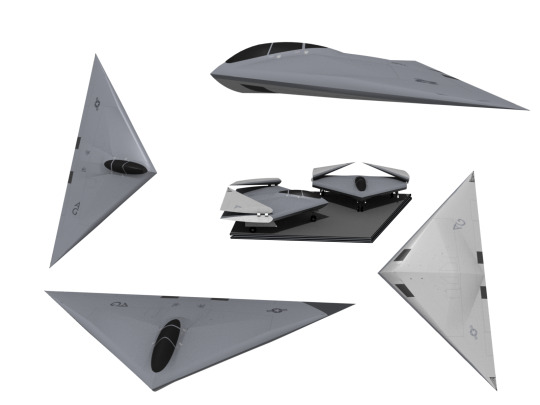
The winning proposal, which would gain the designation A-12, would come from the McDonnell Douglas/General Dynamics team. The A-12 was considerably simpler in appearance than its competitor - it was a simple, featureless triangle, aptly nicknamed “the flying Dorito.” Two F412 turbofans were to provide power, while internal weapons bays were to carry a payload of up to 2,300kg of stores, including precision-guided munitions and two AGM-88s or AMRAAMs. Unfortunately, the program would soon run into development trouble. The design hinged on the success of promising new composites, which ended up proving heavier than anticipated. Projected weights spiraled, while other issues arose in the A-12’s complicated sensor suite.
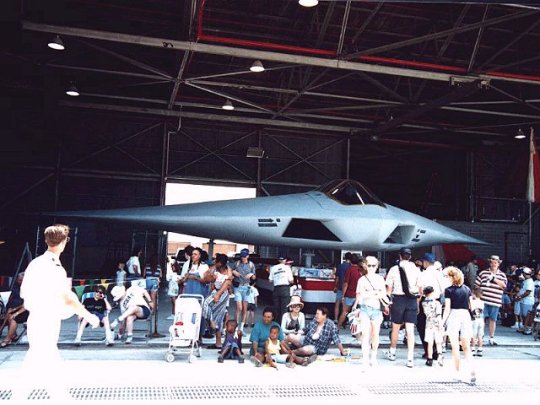
Only in 1990 after a review by Defense Secretary Cheney did the full scope of the issues come to light. The Marines would drop their order, and skyrocketing program costs along with further engineering issues put the project under great scrutiny. Over the course of 1990, numerous inquiries into the A-12 program were performed, resulting in several very critical reports both of the cost of the program itself as well as the performance of the planned aircraft. By the end of the year, the Navy was asked to justify the program, which threatened to eat up the majority of the Navy’s budget. After receiving an unsatisfactory response, Secretary of Defense Cheney cancelled the program in January 1991 for breach of contract.
Advanced-Attack/Advanced/Fighter-Attack - A-X/A/F-X
Following the cancellation of the ATA and NATF (navalized adaptation of the Air Force’s ATF), the Navy began a new program to replace the A-6. Designated the A-X, the program aimed to replace the A-6 with an advanced two-man all-weather attack aircraft. Such a program attracted the attention of the Air Force, who was concurrently seeking to replace the F-111. As the Navy added on requirements to fill the gap left by the cancellation of the NATF, the program changed focus from an attacker to a multirole, causing the program name to change to A/F-X. As with previous programs, the A/F-X encouraged contractors to form teams to produce a solution - in this case, teams were Grumman/Lockheed/Boeing, Lockheed/Boeing/General Dynamics, McDonnell Douglas/Vought, Rockwell/Lockheed, and General Dynamics/McDonnell Douglas/Northrop. In the end, no proposals would make it to full-scale development - the A/F-X would end up being cancelled, with efforts instead directed towards the emerging JAST program (which later led to the Joint Strike Fighter).
Grumman/Lockheed/Boeing A/F-X Proposal

The Grumman/Lockheed/Boeing team would create an unusual proposal, notable for being the only one to feature canards. Not much is clear about the design, apart from its use of a canard layout, twin tails, and a heavily faceted design. To reduce radar cross-section, the tails were to be canted inwards. The intakes appear to be derived from Lockheed’s ATF proposal, but otherwise the design shares little with either the ATF or any other proposal. This is likely due to the internal secrecy - although Lockheed had its hands in three separate proposals, there was no communication between design teams for the competing proposals.
Lockheed/Boeing/General Dynamics A/F-X Proposal

The Lockheed/Boeing/General Dynamics team would develop what amounted to the successor of the failed Lockheed NATF proposal. This team’s proposal was a swing-wing aircraft derived from the F-22 and featuring extensive changes to better suit the aircraft for air-to-ground operations and carrier takeoffs and landings. Extensive changes were made to the wings and tail, and unlike the NATF proposal, which appeared to be little more than an F-22 with swing-wings, this new proposal was an entirely new aircraft.
Rockwell/Lockheed A/F-X Proposal
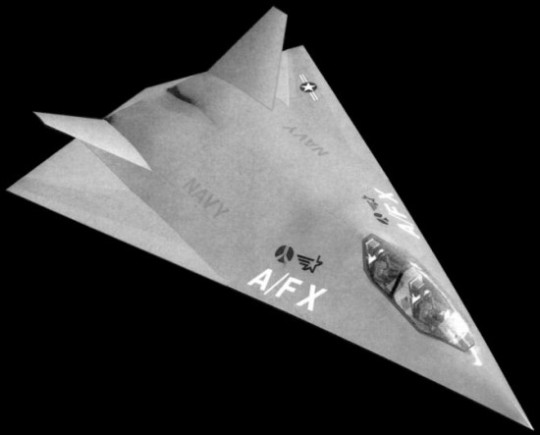
Lockheed’s third A/F-X proposal was again greatly diverging from other designs. Rockwell had opted for a radical elongated delta planform, lacking any horizontal tail and making use of two heavily canted vertical stabilizers. While intakes were situated under the aircraft, exhaust was to vent just above the trailing edge of the wing to reduce detectability. Unusually, the wings were very small for the aircraft size, indicating that the body of the aircraft was likely intended to produce a great deal of lift to allow for sufficient low-speed performance so as to allow for carrier operations.
General Dynamics/McDonnell Douglas/Northrop A/F-X Proposal

Undeterred by the failure of the A-12, General Dynamics and McDonnell Douglas teamed up with Northrop to modify their cancelled A-12 design to meet the new requirements. The same distinct clean profile with a straight trailing edge was retained, but the new proposal would take away the A-12’s distinct “flying Dorito” shape. The sweep of the wing decreased on the outer wing sections, providing greater wing area. These outer panels would fold upwards for storage aboard the carrier just as with the A-12, but the pointed wingtips were clipped to reduce footprint on the carrier.
Lockheed F-117N

After the cancellation of the A/F-X and start of the Joint Advanced Strike Technology program, Lockheed developed a new proposal as an alternative, based on the F-117. Designated the F-117N, the proposal entailed a heavily modified F-117 with a redesigned wing and tail, new bubble canopy, and GE F414 turbofans. A new radar would allow for both air-to-ground and air-to-air missions, and external hardpoints were to supplement an expanded internal bomb bay. Unsurprisingly, the proposal was received poorly. The Navy had already tested the F-117 in 1984 and found it unsuitable for carrier operations, and the F-117N could hardly compete with all the momentum behind the JAST program. After being rejected once, Lockheed updated the F-117N with afterburners and expanded air-to-air capabilities, but they were again rebuffed
6 notes
·
View notes
Text
/k/ Planes Episode 89: Saab
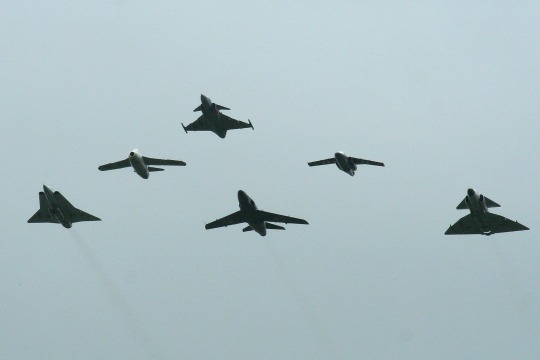
It’s time for another episode of /k/ Planes! This time, we’re looking at the only relevant Swedish manufacturer: Saab.
Svenska Aeroplan AB has its origins in the end of WW1. Because the terms of the Treaty of Versailles prevented Germany from having any significant aircraft manufacturing capabilities, Ernst Heinkel and Clemens Bucker traveled to Sweden, founding Svenska Aero in 1921. Svenska Aero started off producing foreign designs under license, but by the middle of the decade, they had started up their own design department. Though the company was far from unsuccessful, Bucker sold off Svenska Aero in 1932 to ASJA. ASJA would continue to develop their own designs as well, but their time was short - in 1937, before any of their designs could really materialize, they were acquired by SAAB. SAAB brought ASJA’s projects to life, growing to be the primary aerospace manufacturer of Sweden by the end of the Second World War. Though Sweden was by no means a first-rate power in the Cold War, SAAB continued to pump out modern, competitive aircraft for the Swedish air force. They would become one of the few European aerospace companies to survive the Cold War intact, and, far from regressing with the end of the Cold War, they’ve been met with unprecedented export success with the Gripen.
Svenska Aero Jaktfalken
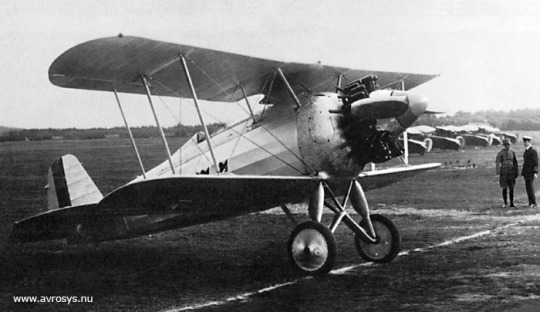
At the end of the 20’s, Svenska Aero’s newly established design department began work on a new fighter as a private venture. Although they had contacted the Swedish Air Force for specifications, they received no reply, so Svenska drew on foreign designs to set the guidelines for their project. Powered by an Armstrong Siddeley Jaguar radial engine, the resulting Jaktfalken was hardly extraordinary. A welded steel structure was largely covered with fabric, although aluminum plating was used on the forward fuselage. Armament was the twin synchronized rifle-caliber machineguns that were standard for the interwar period. The Jaktfalken prototype would take flight in late 1929, and in November of that year it was publicly demonstrated to government officials. The prototype was purchased by the government, entering service as the J 5, and an order for two production examples was placed alongside an order for three British-built Bristol Bulldogs for comparative tests.
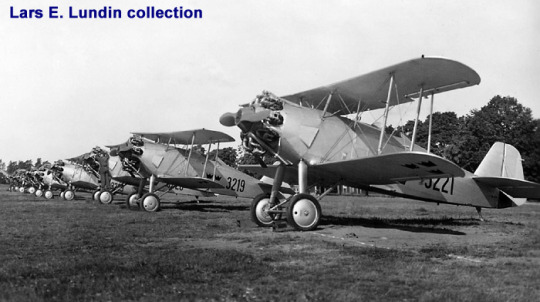
Soon after the orders were placed, the Swedish Air Force made the decision to standardize aircraft engines, selecting the Bristol Jupiter as their primary fighter engine. Svenska was forced to heavily modify their production aircraft to accommodate the new engine. The resulting aircraft - which entered service as the J 6 - experienced moderate vibrational issues, but nevertheless entered service and received an order for five more production aircraft. Meanwhile, Svenska was working hard to find foreign customers for the Jaktfalken. Argentina and Japan sent representatives to test the aircraft, but no orders followed. Norway was the only foreign customer, but their order - a single example fitted with an Armstrong Siddeley Panther engine - was only intended for comparative tests with the Hawker Fury (which the Jaktfalken would lose). In all, Sweden would come to operate a total of 18 Jaktfalkens in various variants. As was common for interwar aircraft everywhere, their service was limited, and by 1938, the seven J 6s remaining in service were flying as trainers. The three oldest examples were given to Finland in late 1939 during the Winter War, but these were too obsolete for even the Finn’s liking. They served as trainers until 1945, at which point they were scrapped. Sweden’s Jaktfalkens had left service long before then - the four survivors were scrapped in 1941.
SAAB 17
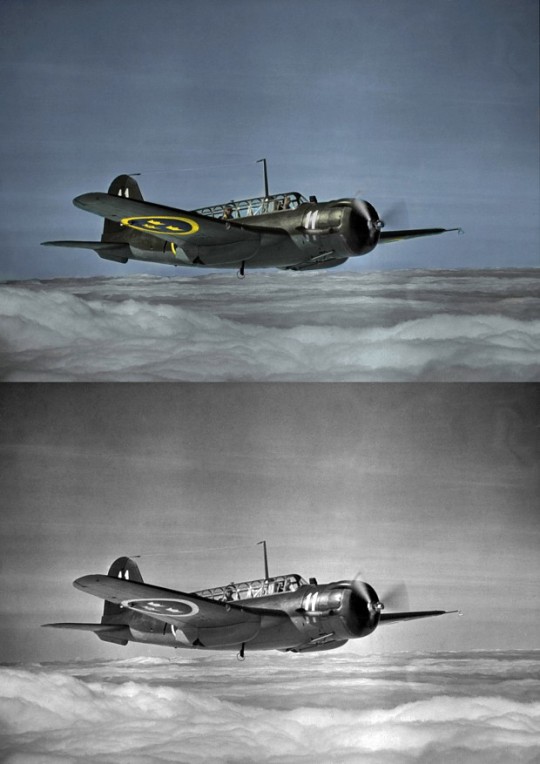
The first original design to come out of the newly-formed SAAB had its origins in the projects of ASJA. Through the 1930s, ASJA had been working on a single-engined reconnaissance aircraft under the internal designation L-10. Building on experience gained from license-producing foreign designs, the L-10 was a significant divergence from the archaic biplanes previously developed by ASJA. As work progressed, dive-bombing was added to the aircraft’s proposed role, requiring ASJA to strengthen the aircraft’s structure and the addition of dive brakes. In an unusual move, ASJA chose to incorporate the dive brakes into the landing gear, meaning employing the dive brakes required lowering the landing gear. The addition of the dive bomber role also changed the design’s armament - a single defensive gun and two forward-firing machineguns were mounted, and a small internal bomb bay was added in the fuselage. Two prototypes were ordered, one mounting a Bristol Mercury and the other a Pratt & Whitney Twin Wasp. Before the aircraft were completed, ASJA was absorbed into SAAB, and the project was redesignated the SAAB 17.
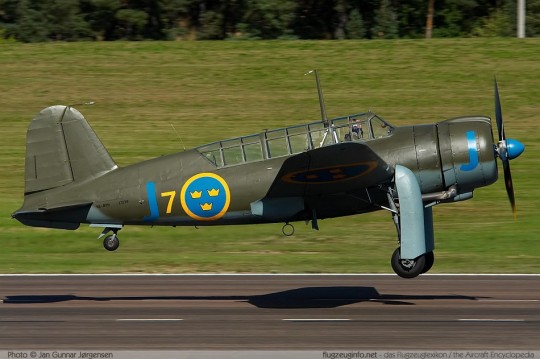
When the SAAB 17 finally took flight in May 1940, Sweden was desperately in need for modern aircraft. Though performance was unremarkable, Sweden ordered the production of 322 examples in five variants - the B 17A, B, and C differing in their choice of engine, and the S 17BL and BS differing in their use of conventional or floatplane landing gear. Though the B 17 had been developed without any specialized bombing aids, SAAB would introduce an advanced bombsight on later production models. Though the full order of 322 aircraft would be filled, the SAAB 17 was slow to enter service - only in 1942 were the first frontline units flying the type. Postwar, they were rapidly overshadowed by jet-powered aircraft, and by the end of the decade they were out of service. 46 were sold off to Ethiopia, flying until 1968, while two more were sold to Finland to fly as target tugs (only to quickly crash). Other examples also made their way into Austrian service, though their use appears to have been limited.
SAAB 18
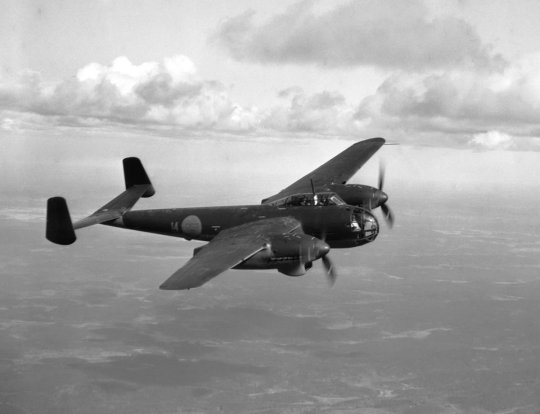
In 1938, the Swedish Air Force released requirements for a bomber to replace the Ju 86. ASJA, SAAB, and Gotaverken would submit proposals. As work progressed, ASJA was absorbed into SAAB and their competing projects were folded into a single design. Working with a team of American engineers, SAAB produced the SAAB 18 - a high-winged monoplane bomber vaguely resembling the German Dornier Do 17. The SAAB 18 was originally designed with tricycle landing gear, but this would be changed to a conventional arrangement to fit the preferences of the Swedish Air Force. An all-metal structure was used, and for the first time in Swedish aviation armor had been integrated into the aircraft’s structure. The crew of three were concentrated in the nose, with an offset canopy for the pilot/radioman and a glazed nose for the bombardier. Armament consisted of three heavy machineguns, while an internal bomb bay provided space for up to 1,500kg of stores. The competing GP 8 from Gotaverken seemed to promise better performance, but was considerably more expensive, and, when the Gotaverken design department dissolved, the Swedish Air Force selected SAAB’s proposal for full development.
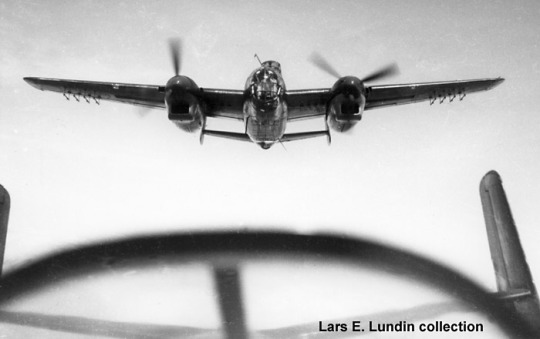
Unfortunately, the outbreak of war in Europe caused Sweden to put priority on the SAAB 17. Development slowed to allow the SAAB 17 to be rushed into service, meaning that the SAAB 18 wouldn’t fly until June 1942. By then, the design had been modified, replacing the original British-designed engines with domestically-built Twin Wasps. The SAAB 17 remained the priority through most of the war, and only in 1944 did the SAAB 18 enter service as the B 18. The first 62 were configured as conventional level bombers, flying with the same archaic tactics they used with the Ju 86. Soon after the end of the war, they were reconfigured for reconnaissance and redesignated S 18s, serving until 1959. In 1945, the refined B 18B was developed. The B 18B used new engines, deleted the ventral gun, and was reconfigured for dive-bombing. A strengthened structure and new bombsight (first used on the B 17) allowed for this new attack profile, and the bombardier was removed.
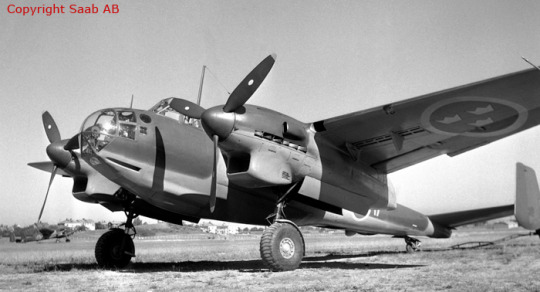
The B 18B would come to replace the original production versions. At the end of the decade, they were fitted with hardpoints for rockets on the wings and fuselage. In 1947, SAAB created the T 18B, configured for anti-shipping duties. The T 18B had a drastically redesigned nose and the same dive-bombing capabilities of the B 18B, but its bomb bay was modified to carry a single 1,00kg mine or 950kg torpedo. Trials found torpedo attacks to be impractical, so two 20mm cannon were fitted in the nose and the bomb bay was adapted to mount a 57mm cannon. Tests were also done with 40mm cannons in the nose, but it was found to be impractical. The B 18B and T 18B would both serve through the end of the ‘40s, living on until 1958 when they were replaced by the Lansen.
SAAB J 19

As part of the rearmament program leading up to the outbreak of WW2, ASJA was working on a modern fighter to replace the Gloster Gladiator. Developed under the designation L12, the fighter became the SAAB 19 once ASJA was taken over. As with previous designs, SAAB made use of the American engineers then working for them to create an all-metal low-winged monoplane design. Intended to mount the Bristol Taurus II engine, the J 19 would have an armament of four wing-mounted 13mm machineguns and two synchronized 8mm machineguns. As originally designed, the J 19 was projected to have a top speed of around 375 mph, putting it on par with most contemporary fighters. Unfortunately, the outbreak of war in Europe put an end to SAAB’s plans. Britain cut engine exports, and, although SAAB looked to America to procure Pratt & Whitney Twin Wasps as a replacement, they soon found that America was also unwilling to export the engines. Unfortunately, the J 19 program would come to an end without ever leaving the drawing board as the Swedish Air Force chose to concentrate efforts on the B 17 and B 18.
SAAB J 21
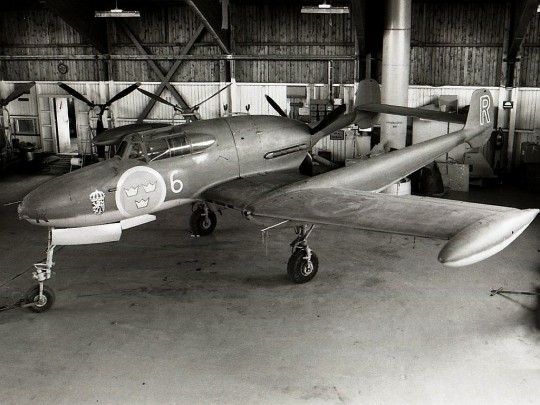
With the cancellation of the J 19, SAAB began work on a series of new designs based around the German DB 605 engine. SAAB considered several designs, the most advanced of which was derived from design studies dating back to 1939 for a pusher-engined fighter. Progressing under the designation J 21, the design emerged as a twin-boom pusher-engined fighter with a laminar-flow swept wing and tricycle landing gear. Owing to the risks associated with ejections on a pusher-engined plane, SAAB opted to develop an ejection seat for the J 21. Armament was heavy, with a 20mm cannon and two 13mm machineguns mounted in the nose, and another 13mm machinegun mounted in either wing. Work would progress alongside the more conventional J 23 proposal until the end of 1941, when the Swedish Air Force approved full development of the J 21. The J 23 was abandoned, and the J 21 took priority.
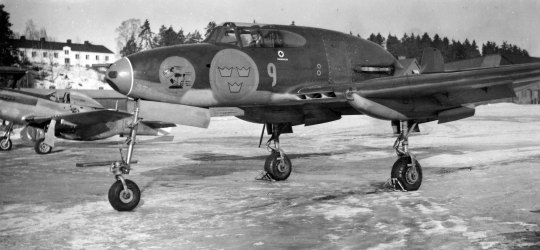
The J 21 would make its first flight in July 1943. Testing went fairly smoothly (aside from the problematic first flight) , but SAAB was slow to get the type into production. Only in December 1945 did the J 21 finally enter service. Despite their late arrival, they proved capable aircraft. Compared to surplus P-51s acquired postwar, they were more maneuverable and comparable in performance at low altitudes. However, performance dropped with altitude, and the fighter suffered from poor rearward visibility and heavy controls. Production would be almost evenly split between the fighter J 21s and attacker A 21s. The A 21s differed in that they were fitted with a bombsight and six stores pylons (two 600kg pylons and four 50kg). Unfortunately, the J 21’s service would be brief. Production ended in 1948, and, being quickly surpassed by the arrival of jets, the J 21 fleet would be retired in 1954.
SAAB J 23
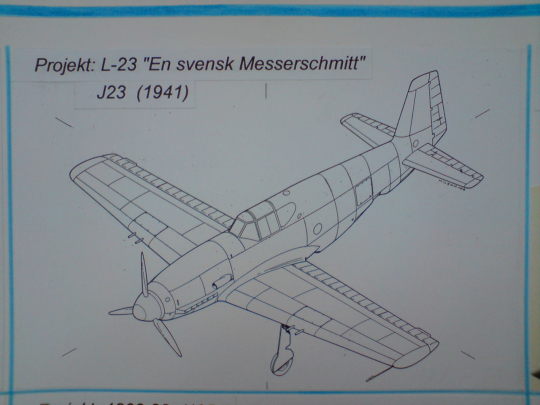
Recognizing the risks associated with the J 21, SAAB would embark on a more conventional fallback design in early 1941. Designed around the same DB 605 used on the J 21, the J 23 took on a simple conventional design resembling a cross between the Bf 109 and the P-51. Square-tipped wings held a total of four 13mm machineguns and the inward-retracting landing gear, and the cockpit developed for the J 21 was hastily adapted to the new design, complete with the experimental ejection seat. Aft of the cockpit. the J 23 very much resembled the early model P-51s with its squared-off tail surfaces and ventral radiator. In addition to the wing-mounted machineguns, SAAB planned to mount a 20mm cannon firing through the spinner. Ultimately, the J 23 was cancelled at the end of 1941, reportedly due to the projected poor agility of the design.
SAAB B/J 24
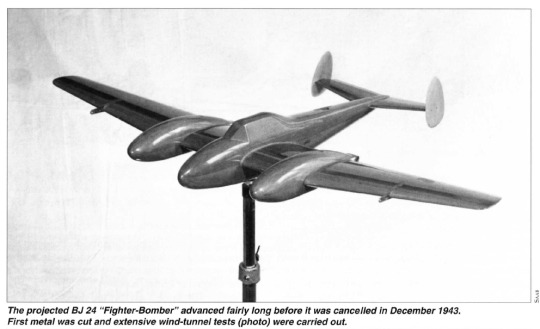
One of SAAB’s more advanced projects during the Second World War was the SAAB 24. Designed around two DB 605 engines, the SAAB 24 was intended to serve as a high-performance dive-bomber and night fighter. At a glance, it closely resembled a Bf 110, although the details of the design diverged significantly. Tricycle landing gear was to be used, and crew was to be just a single pilot. As a bomber, the B 24 would carry about 1,000kg of stores, four 8mm machineguns and two 20mm cannon, while the night fighter J 24 would carry six 13mm machineguns and two 20mm cannon along with a radar. Though requirements were constantly changing, SAAB got fairly far with the design. Only in December 1943, when it became apparent that its roles were already filled by existing designs, was the SAAB 24 finally cancelled.
SAAB J 27

At the end of WW2, Sweden was in search of a new fighter offering better performance than the J 21 could offer. Selecting the Rolls Royce Griffon as the powerplant, SAAB initially looked into adapting the engine to the J 21. However, this proved impractical, so SAAB started work on a clean-sheet design. The J 27, as it was known, ended up closely resembling the latest designs to come from Britain. The Griffon engine driving contra-rotating propellers sat in the nose, and wings similar to those used on the Fairey Firefly (complete with Fairey’s characteristic Youngman flaps) were developed. Armament was to be concentrated in the wings, and just as with the J 23, the radiator was placed in a ventral position similar to the arrangement on the P-51. Unfortunately, while its projected top speed of 700km/h was impressive for a piston-engined fighter, it was inadequate in the oncoming jet age. In the end, SAAB opted to drop the piston engined fighter in favor of jet fighter endeavours.
SAAB J 21R

Although plans to adapt the Rolls Royce Griffon to the J 21 fell through, the J 21 would be subject to a more ambitious project to adapt a jet engine to the fighter. After acquiring a de Havilland Goblin turbojet, SAAB worked to adapt the engine to the fighter in hopes of a quick solution for a jet fighter. Unfortunately the resulting J 21R required a far more extensive redesign than SAAB had hoped. The tailplane had to be raised, and the wings were reprofiled, while the central nacelle had to be extensively reworked to accommodate the new engine. The J 21R would first fly in March 1947, and through the testing program several prototypes were converted from J 21s. Originally, the Swedish Air Force had planned to procure over 120 examples, but the development of the Tunnan that followed the J 21R led to production being cut to just 60.
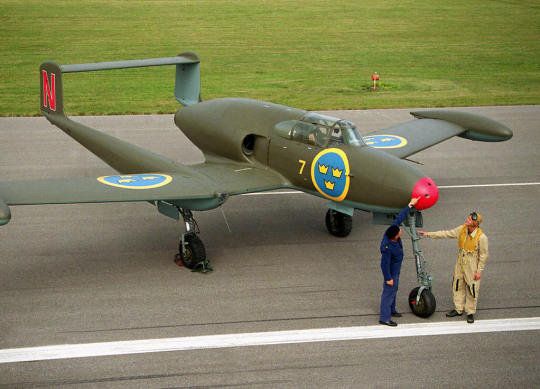
Entering service in 1950, it was obsolete from the start and quickly relegated to attacker duties. Though procured as fighters, they took on the A 21R designation with their new role.Typical loadouts included various unguided rockets and a centerline-mounted machinegun pod. Performance-wise, the J 21R shared the excellent handling of its predecessor along with overall better performance figures, but the design was no match for the purpose-built first-generation fighters appearing across the world. Worse, endurance was poor, even with SAAB’s efforts to expand internal fuel tanks. Ultimately, the J 21R wouldn’t last much longer than its piston-engined predecessor - by 1956, all surviving examples were retired.
SAAB J 29 Tunnan
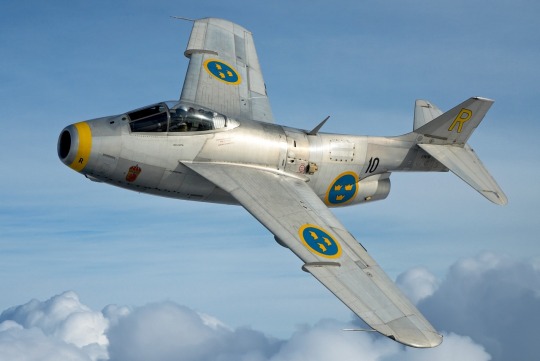
Parallel to the J 21R, SAAB was working on a clean-sheet project for a new jet fighter. Also designed around the Goblin engine, the design used a very thin laminar flow wing, necessitating a portly fuselage to accommodate the cockpit, intake, and landing gear. Extending rearwards beyond the exhaust was a boom holding the tail surfaces. Although preliminary work was mostly complete by October 1945, the development of the more powerful de Havilland Ghost turbojet caused development to stall as SAAB worked to adapt the new design to fit the engine. Meanwhile, SAAB engineers in Switzerland discovered German research data on swept wings, bringing their discoveries back to Sweden and modifying the design to mount a 25 degree swept wing. The revised design, now featuring a swept wing and the Ghost turbojet, was complete in early 1946. By the Fall of that year, the Swedish Air Force had placed an order for three prototypes under the designation J 29. It would be two years before the first J 29 took flight, and two more years before the aircraft had entered service.

The arrival of the J 29 in 1952 would finally give the Swedes a modern fighter on par with those fielded by other major powers. Having earned itself the nickname Tunnan owing to its portly shape, the fighter was fast, agile, and easy to fly, and it proved popular with ground crews, being easy to maintain in even the crudest facilities. The initial production Tunnan would be followed by the J 29B in 1953, which added extra fuel tanks and external pylons to allow the fighter to perform ground-attack missions. Even with the changes, the Tunnan was capable - it set a world speed record over a 500km course in 1954. Over the years, SAAB continued to refine the Tunnan, modifying the wings, adding an afterburning engine, and allowing the fighter to work with the AIM-9 Sidewinder. A special reconnaissance variant - the S 29C - was developed, and the bulk of the fleet would be updated to the ultimate J 29F variant by the end of the decade.
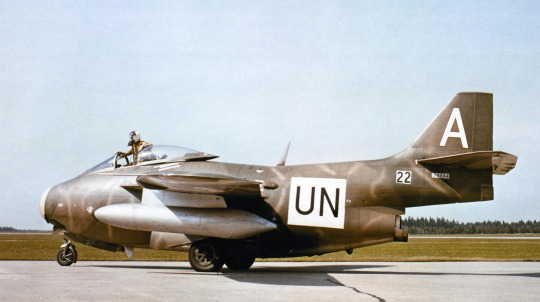
The Tunnan would be the first of SAAB’s fighters to see combat use after a deployment with the UN to the Congo in the 60s. Nine J 29Bs and two S 29Cs were sent in 1961. Missions generally involved strafing with rockets and the internal cannons, and, despite heavy ground fire, the Tunnan performed exceptionally. Four were returned to Sweden in 1963, but the others remained in the Congo until the termination of the UN mission the next year, at which point they were destroyed at their base (Sweden determined that would be cheaper than retrieving them). The only foreign customer, Austria, would purchase 30 J 29Fs, which served until 1972. SAAB tried to export to Israel, Finland, and Yugoslavia, but the potential deals fell through. Back in Swedish service, the Tunnan would acquire a poor accident record owing to pilots’ unfamiliarity with swept wings, but otherwise the service record was good. Ultimately, the Tunnan would fly on with the Swedes into the mid-60’s, by which point it was replaced by more modern types in frontline duties and retired to secondary tasks like target tugging.
Saab A 32 Lansen
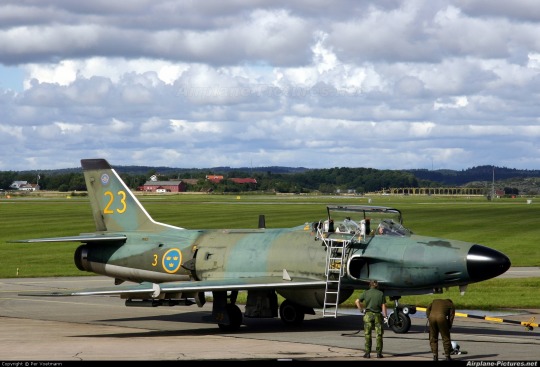
In 1948, the Swedish Air Board started the development of a new jet-powered attacker. Specifications called for an all-weather aircraft armed with four 20mm cannon plus underwing stores. Originally, Sweden wanted the aircraft to be powered by a domestically designed engine, but when the powerplant suffered delays, the Rolls-Royce Avon took its place. SAAB’s final design was considerably more graceful than the Tunnan before it. Fitted with a low-mounted 35-degree swept wing, it had intakes on the sides of the fuselage to make space in the nose for a navigation radar. The crew of two was placed in a tandem cockpit, with the navigator sitting in the rear seat. Notably, it was compatible with the Rb04 anti-ship missiles, of which it could carry two. Four prototypes were ordered, and the aircraft was given the designation A 32. The first prototype would take flight in November 1953, and within a year it was ordered into production.

The Lansen, as the A 32 was known, would enter service in 1955, growing in numbers until they equipped twelve squadrons. Although designed with an attack radar, only a quarter of A 32As would carry the system. During operations, a radar-equipped Lansen would lead the rest of the aircraft in its flight while navigators were omitted from the radar-less aircraft. SAAB would also create an all-weather fighter variant of the Lansen (J 32B), replacing the nav/attack radar of the A 32 with an air-intercept radar and computerized fire control system complete with radar gunsight. Originally, stores pylons were fitted with 75mm unguided rockets but the J 32B would later be modified to carry AIM-9 Sidewinders. The J 32 would come into service in 1958, flying with a total of seven squadrons. As with the Tunnan, SAAB also produced a reconnaissance variant of the Lansen for night operations. Changes were limited to a redesigned nose featuring a modified radar and cameras in the place of the cannons.
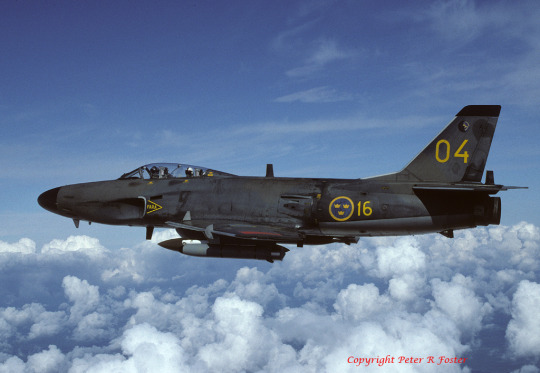
As with the Tunnan, the Lansen was prone to accidents, losing a third of their number during service. As Sweden began its nuclear program, the Lansen was slated to carry tactical warheads, although no such weapons were ever carried. As Sweden’s last purpose-built attacker, the Lansen’s career was short-lived. The Viggen began to replace the Lansen in 1971, and the J 32 would be the first variant to leave service. The A 32 and S 32 would stick around longer, finally leaving service in 1978. In 1972, 15 J 32s were modified as jammers, receiving the designation J 32E. While other Lansens left service, the J 32E remained in its niche role. Flying in both operational and training roles, the Lansen jammers would stay in operational service until 1997.
Saab 210 Lildraken
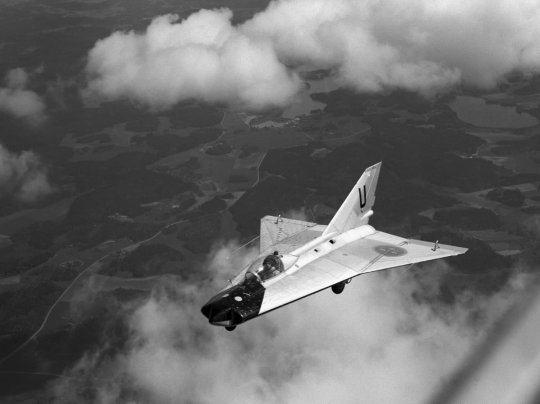
At the end of the ‘40s, Saab was requested to develop an interceptor to follow the Tunnan. Performance specifications were standard for interceptors of the time - calling for a top speed above Mach 1.4 - but the Swedes added some unusual requirements on top of that. The new fighter needed to be rugged, cheap, and easy to maintain, and it had to be able to operate from sections of highways as part of Sweden’s distributed airbase scheme. Saab’s engineers considered several arrangements for the new fighter design, eventually settling on an unprecedented double-delta arrangement. A thicker inboard section of the wing would have an 80 degree sweep, providing space for fuel, landing gear, and intakes, while the outboard section would be thinner and feature a reduced sweep of 57 degrees to improve low-speed handling. With nothing of the sort ever flown before, Saab wanted extensive testing before a full-scale prototype was made. Wind tunnel tests progressed to tethered scale model flights until finally Saab felt confident enough to create a 70% scale demonstrator - the Saab 210.

The Saab 210 would be a tiny aircraft powered by an Armstrong Siddeley Adder turbojet and identical in arrangement to the planned final design. Taking to the skies in early 1952, the 210 was underpowered but nevertheless stable. As originally conceived, intakes were placed in the nose and separated by a pyramid-shaped nosecone. However, this was found to be unsatisfactory, so Saab completely redesigned the forward fuselage, giving the aircraft a solid nose and moving intakes to the roots of the wings. Ultimately, this would form the basis for the final design of the fighter. Though perpetually underpowered, the Saab 210 would perform thousands of test flights, validating Saab’s design and allowing them to progress to full-scale development.
Saab J 35 Draken
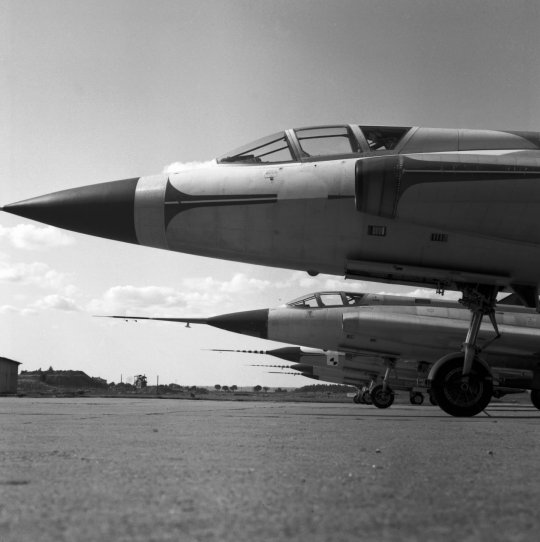
With the general layout validated, Saab was contracted in August 1953 for three full-scale prototypes and pre-production aircraft. The fighter, designated J 35, was scaled up from the 210 demonstrator layout and fitted with a rolls Royce Avon turbojet. Testing began in 1955, but the test program would go on for five years before the Draken finally entered service. As originally configured, the J 35A carried a single 30mm cannon outboard of either intake, an AIM-9 pylon under each wing, and a centerline hardpoint for a drop tank or twin-Sidewinder rack. Though not intended for all-weather operations, they did carry their share of advanced electronics, including an autopilot, air intercept radar, and later, an IRST. Initial service of the Draken was not without its issues - pitch oscillations were a major problem in the fighter’s early days, and only after Sab reworked the control system was the concern resolved.

Before the J 35A was in service, Saab was already working on a substantially improved successor. The J 35B, which entered service just a year after the first Drakens, was fitted with a new radar system, allowing for side or head-on intercepts of the target rather than the tail-chase intercepts the J 35A was limited to. Given that early-generation AIM-9s could only target an aircraft’s exhaust, the J 35B would be fitted with two 75mm FFAR packs for interceptions. The first generation Drakens would be followed up by the definitive production variant - the J 35D. The J 35D was externally identical to the earlier iterations (except minor changes to the intakes), but it boasted moderately improved electronics and a new engine that for the first time allowed the fighter to break Mach 2. The J 35D would also form the basis for the reconnaissance-oriented S 35E, which featured a redesigned nose filled with cameras.
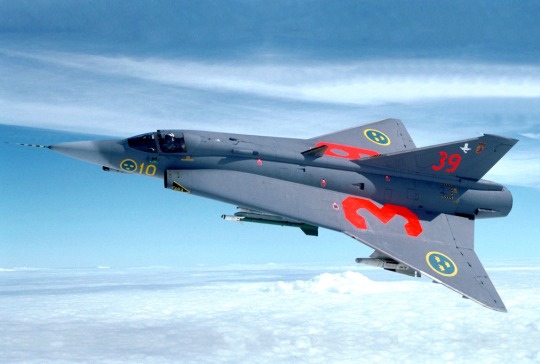
Although originally conceived as a pure interceptor, the Swedes found the Draken to have exceptional maneuverability. Recognizing the potential of the design to be a true fighter, Saab developed the J 35F, giving it a bulged canopy for improved visibility and updating avionics to allow it to carry the AIM-4 Falcon. The continuing upgrades to the Draken fleet ensured it would remain in active service through the end of the Cold War, even as more capable fighters like the Viggen came into service. In 1985, Saab performed one final overhaul on the Drakens, bringing them to the final J standard. Avionics were modified, fuel tanks enlarged, two extra pylons were added, and the airframes overhauled to extend their service lives. 54 Drakens were brought to the new standard with the intention of flying them into the new millennium. Unfortunately, although the aircraft were more than capable of flying for several more years, the Drakens were all retired in 1999 due to rising maintenance costs.

Although it would take time to attract customers, the Draken would mark Saab’s first major export success. Sweden evaluated a special variant fitted with the English Electric Lightning’s avionics in 1960, but they selected the Mirage III instead. It would take until 1968, when Denmark ordered a new variant derived from the J 35F. Their special export variant would boast greater fuel capacity, structural reinforcement, a new outer wing, and most notably, air-to-ground capabilities. The radar was removed, and five more stores pylons were added, bringing the total to eight for a capacity of 10,000lb of ordnance. The Danish Drakens were integrated with various unguided rockets and bombs, as well as the AGM-65 Maverick. While Sweden flew the Draken purely as a fighter, the Danes deployed them as strike aircraft. In the 80’s the fleet was modernized, giving them new navigational systems, a reworked cockpit, a laser rangefinder and target designator, and new countermeasures. Although by far the most unique and arguably most capable Draken variant developed, the Danish Drakens wouldn’t last much longer than the Swedes’. In 2000, the last Danish Drakens were retired in favor of F/A-18s.
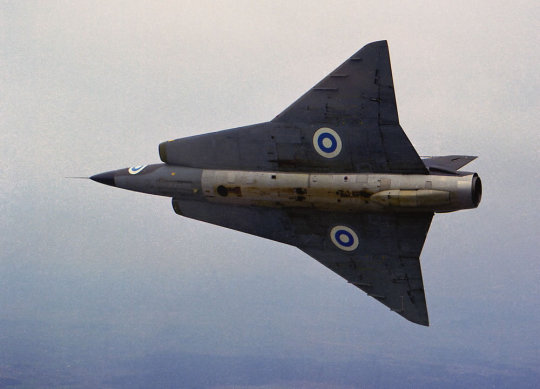
Other export customers were soon to follow. Finland decided to obtain the Draken in 1970, leasing secondhand Swedish Drakens for several years until deliveries of production aircraft began. Though focused on air defense just as the Swedish Drakens, Finland did have moderate air-to-ground capabilities added to their Drakens. Finland would end up being an incredibly enthusiastic operator of the Draken, ultimately buying the leased aircraft from Sweden and later purchasing several more refurbished aircraft, bringing their fleet total to 48. As with Denmark, they flew the fighter until its final retirement in 2000, replacing them with Hornets. The final foreign customer, Austria, made their decision to buy the fighter in 1985. Secondhand J 35Ds were purchased and refurbished, adding various improvements from the J 35F like the bulged canopy. As originally deployed, they flew only with their internal cannons (and occasionally a reconnaissance pod) owing to neutrality agreements. With the end of the Cold War, rules relaxed, allowing Austria to finally arm their Drakens with missiles in 1983. The Austrian Drakens were supposed to be short lived - they were slated to be retired in 1998. However, difficulties finding a replacement meant they would be the last Drakens to leave service, only finally being retired in November 2005.
Saab 1300 Series Fighters
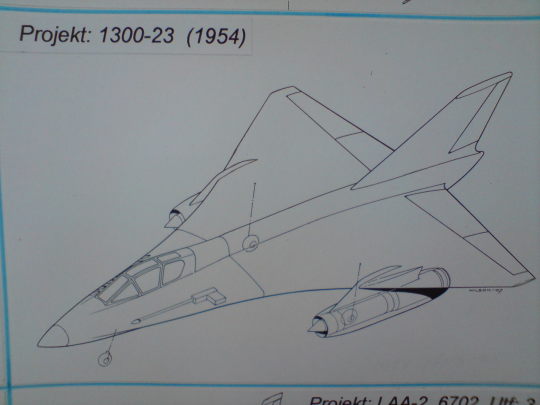
As a follow on to the success of the Draken, Saab would conduct a series of delta-winged design studies with a roughly similar layout to the Draken. Under the general designation 1300, Saab studied both fighter and bomber proposals. Fighter proposals would focus on ever-increasing engine power, making use of the newest powerplants to come out of Britain. The number and type of powerplants would vary between types - one proposal would use two de Havilland rockets, and later proposals progressed to use two de Havilland Gyron turbojets and a booster rocket in the tail. Although the general layout of the Draken was retained, the design studies refined the aerodynamics, smoothing out the Draken’s lines. Instead of mounting the Gyron engines inside the fighter, the design studies slung the turbojets individually under the wings in nacelles. Dated to about 1952, these projects never left the drawing board. While the exact reasons for their abandonment are unclear, it’s likely they were dropped due to a combination of doctrinal shifts away from interceptors and the failure of the Gyron engine program.
Saab A 36
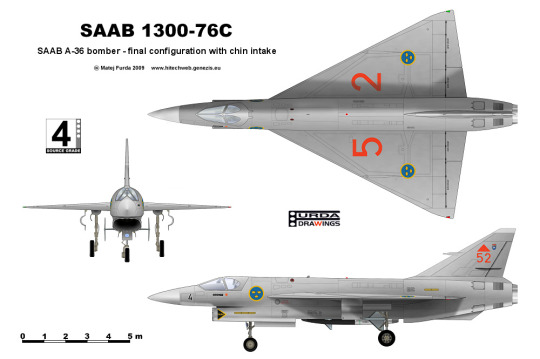
The counterparts to the 1300-series fighter design studies were a series of heavy strike aircraft intended to carry the nuclear weapons Sweden was then developing. Building off of the 1300 series design studies, the bomber proposals were considerably larger designs. One study made use of the Gyron engine, but most selected the Bristol Olympus (used on the Avro Vulcan) instead. The two final designs that Saab had settled on by the end of the program were the 1376 and 1377. Slightly larger than the Draken, they both were single-seat, single-engined designs with a simpler delta wing fed by a chin intake (on the 1376) or dorsal intake (on the 1377). Top speed was to be Mach 2 at altitude and Mach 1.2 at sea level. Just as with the Draken, short-field capabilities were expected. The payload of a single 600-800kg freefall tactical nuclear weapon would be carried in a centerline bomb bay. The project made it far enough to gain a tentative designation of A 36, but ultimately would be cancelled in 1957 as the Swedish government decided to focus on a cheaper and more versatile multirole.
Saab 1410
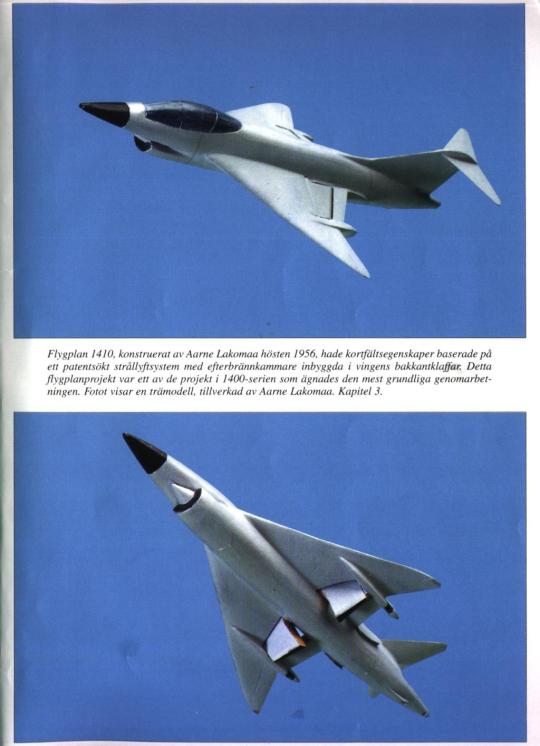
In 1956, Saab began work on an unusual STOL-oriented fighter design study. Diverging completely from the delta-winged 1300-series, the 1410 design study used a more conventional tailed arrangement. A single engine would be fitted into the fighter, but instead of venting out the tail, it exhausted through unique thrust-vectoring flaps on the trailing edge of the wing. These flaps carried afterburners, theoretically allowing the fighter to reach speeds as high as Mach 2. The landing gear arrangement would roughly resemble that of the Harrier due to the wing nozzles displacing landing gear to the outer sections of the wings. Reportedly, the project was intended to provide STOVL flight, although it’s doubtful that true vertical flight would be possible given the placement of the nozzles.
Saab 1421
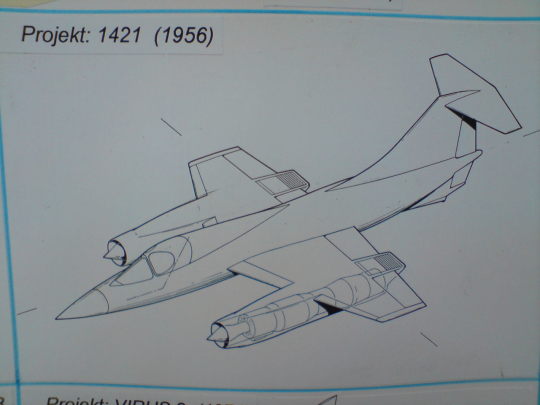
Another product of the 1400 series design studies would be the P.1421. Also dated to 1956, the fighter was a more conventional project to replace the Draken with an interceptor capable of speeds approaching Mach 3. A conventional wing and T-tail was used for this design study, and a single large turbojet would be mounted under either wing. Owing to the expected high temperatures at the aircraft’s design top speed, the triangular canopy was significantly more robust and restrictive of the pilot’s field of view than that of the Draken. For all Saab’s hopes, however, the P.1421 would never leave the drawing board. The days of the dedicated interceptor were numbered, and Saab would never secure enough support for full-scale development.
Saab 105/Sk 60
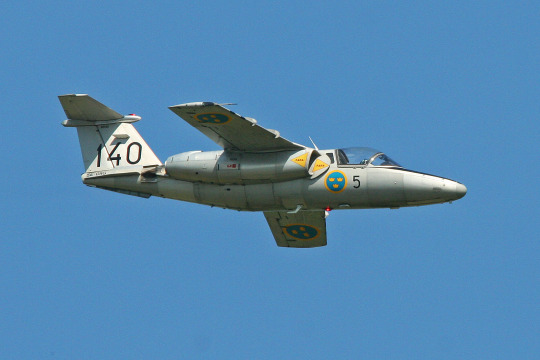
At the end of the ‘50s, Saab launched a private venture effort to develop a trainer to replace Sweden’s inadequate de Havilland Vampires. Around the same time, a requirement arose for a light trainer/attacker, so Saab tweaked their proposal to fit the specifications. Although the proposal had yet to leave the drawing board, it was selected in 1961 as the winner of the competition over several readily available foreign designs. The Saab 105 prototype that would fly in 1963 was a compact aircraft with side-by-side seating, a shoulder-mounted wing, and two engines. For the attacker role, three stores pylons were placed on each wing. Testing went quickly, and in 1966 deliveries of production aircraft began.

In Swedish service, the Saab 105 would receive the designation Sk 60. Although flown as unarmed trainers, all 149 initial production aircraft were capable of mounting a multifunction sight and were integrated with the Rb 05 air-to-surface missiles. However, only 45 machines would actually be configured for attack, carrying a mix of dumb bombs and rocket or gun pods for a total of 700kg of stores. Though capable of deploying the Rb 05, the weapon was never flown on the Sk 60. By the mid-60s, Saab had followed up with the improved Sk 60C, fitted with a camera nose and configured for reconnaissance and forward air control. Although Sweden had planned to replace the Sk 60s with a next-generation advanced trainer, the end of the B3LA program in 1979 put an end to these plans and forced Saab to overhaul the fleet to keep it serviceable. Starting in the late ‘80s and carrying into the ‘90s, Saab reinforced airframes, modernized the aircraft, and installed new engines. Thanks to these upgrades, the Sk 60 remains in service to this day.
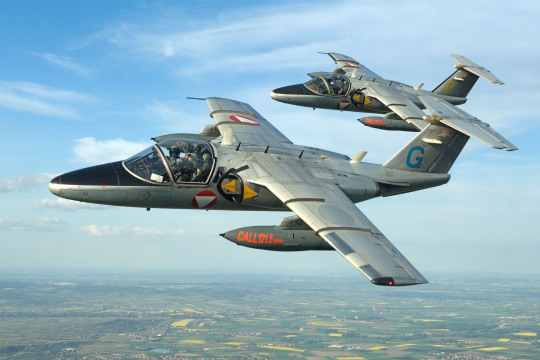
While the Saab 105 was marketed heavily on the export market as everything from an attacker to a business jet, the market was already saturated with such aircraft and Saab found little success. An export variant was created, boasting upgraded engines, stronger wings, a higher payload (2,000kg), and the ability to carry AIM-9s. Mainly targeted at third-world nations, in the end it would only find a single customer - Austria. The Austrians procured 20 Saab 105s, using them to replace their Saab 29 fighters in reconnaissance, attacker, and fighter duties. In 1970, Swiss interest in the design seemed promising enough for another new variant - adding built-in ADEN cannon, wingtip tanks, and an advanced bombsight - to be designed. However, it too would fall through as the Swiss decided to procure F-5Es.
Saab JA 37 Viggen
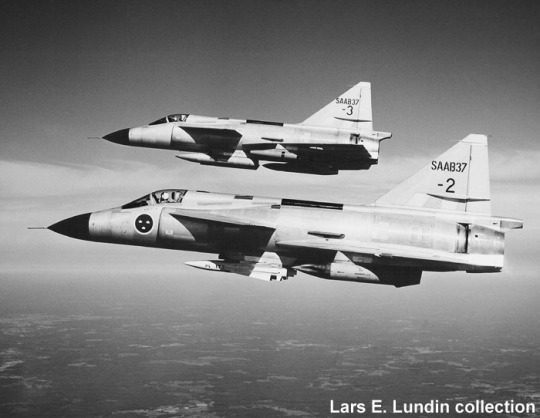
By the 1960s, Sweden was looking for a replacement for both the Lansen and Draken. Hoping to combine the roles into a single aircraft, Saab was issued specifications for a single new multirole. Requirements called for an aircraft capable of both high- and low-altitude supersonic flight, integration with Sweden’s air defense network, and short-field capabilities to allow the aircraft to operate from the distributed air bases and roadways around Sweden. Although Saab had been working on various different projects from 1952 onwards, the design study that would get the JA 37 designation would be significantly different from anything Saab had looked at before. The new design made use of a canard-delta layout and a unique afterburning engine fitted with thrust reversers to make the most of short-field capabilities. State of the art avionics were installed, but Saab made sure to keep maintenance simple to allow it to be serviced by conscripts. The proposal was approved in September 1962, and several prototypes were ordered in 1965. On February 8, 1967, the Viggen took to the skies for the first time. Testing went well, and pilots gave favorable reports of the Viggen, particularly compared to the tricky Draken.
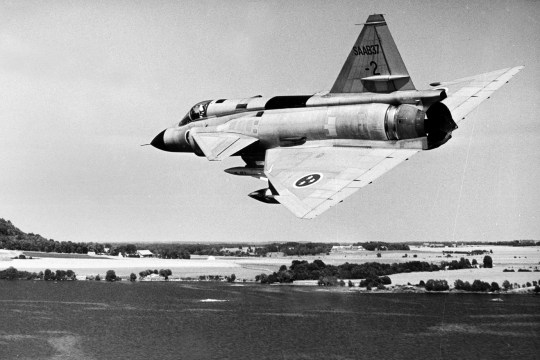
With testing going well, Sweden ordered the Viggen into production in 1968. By June 1971, the first aircraft were reaching frontline units. The Viggen would come in several different variants. The first - the AJ 37 - was strike oriented, fitted with a HUD, nav/attack computer, and seven stores pylons for 7,000kg of ordnance. Lacking an onboard cannon, the Viggen had the option to carry cannon pods, but more often carried a mix of guided and unguided bombs as well as a pair of AIM-9s for defense. Due to the lack of an onboard radar, it was unable to use the AIM-4 Falcon. The second to come would be the SF 37 reconnaissance variant. Designed around the AJ 37, it was fitted with a distinct camera-filled nose. This was followed by the SH 37, modified from the AJ 37 for maritime patrol. While compatible with the same reconnaissance pods as the SF 37, the SH 37 retained the radome in the nose to allow it to use a search radar.
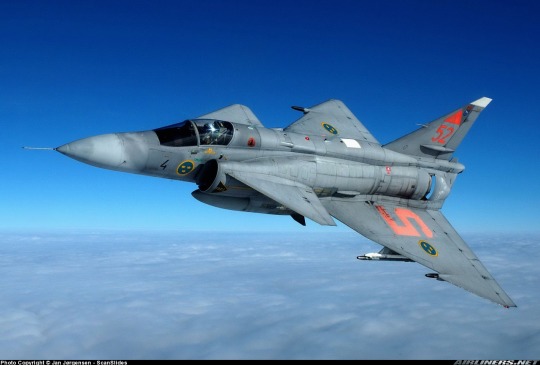
The final variant to take flight would be the most capable. The JA 37 interceptor was stretched to accommodate a more powerful engine, and the wings were strengthened and control surfaces improved to aid in air combat maneuvering. A pulse-doppler look-down-shoot-down radar was installed in the nose, and a partial glass cockpit was used. Whereas earlier Viggens lacked an onboard cannon, the JA 37 was fitted with a 30mm cannon in the belly. Primary armament was to be four AIM-9s and two Skyflash AAMs. The JA 37 retained the ability to carry unguided air-to-ground stores, but lacked the onboard systems to effectively use them. Given the extensive reworking of the JA 37, it understandably took some time to enter service. The first example made its initial flight in 1974, and deliveries to frontline units only began in 1980.

Throughout the Viggen’s career, the fleet has been subject to near constant rolling upgrades. Strike variants were constantly updated to give compatibility with the newest weapons, and the fighters would see upgrades to the radar, gunsight, and countermeasures. Initially, Viggens were flown in their natural bare metal, but Sweden would develop an elaborate camouflage scheme after several years. Although Sweden had hoped to replace most of their inventory with the Viggen, the Lansen and Draken would never be fully replaced by it. The Viggen was more than enough to take over the Lansen’s strike role, but the Viggen was not able to fill the role of the jammer Lansens, so they persisted. Although the Viggen outpaced the Draken as a fighter, Sweden opted to overhaul the Drakens rather than replace them. Ultimately, the Viggen would only barely outlast the aircraft it was meant to replace. Sticking around until 2005, it was retired in favor of the Gripen. Saab did try to market the Viggen abroad, but unlike the Draken, it was unable to attract customers. While the Viggen was a competitive design, it was subject to both US arms restrictions (owing to the American-designed engine) and domestic concerns over selling to non-democratic countries.
Saab B3LM
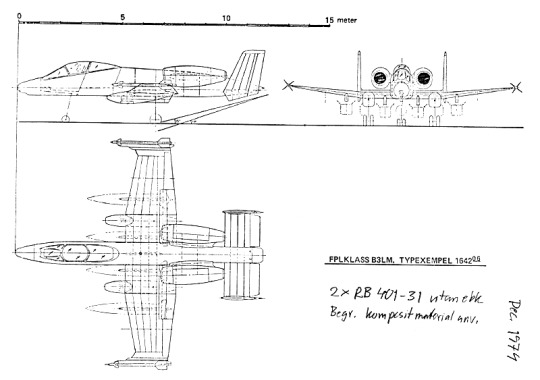
The Soviet invasion of Czechoslovakia in 1968 would spark a wave of panic among Swedish military planners, spurring Saab to begin a new round of design studies for attack aircraft. Under a program known as B3LM, Saab aimed to create a lightweight attacker to supplement the Viggen. The most publicized of these design studies, the P.1642, would end up looking alarmingly similar to the American A-10. Though significantly smaller and lacking a gun, Saab’s B3LM design shared the characteristic twin-tail and widely-spaced engines of the A-10. The nose seems to be configured for some kind of sensors, and five underwing hardpoints (one on either side of the main landing gear and one centerline) were planned in addition to wingtip rails for AIM-9s. A radar was not planned to be installed on the design in hopes of keeping costs low. Power was to come from two compact Rolls Royce RB 401 high-bypass turbofans, sacrificing performance and thrust for efficiency. As with most of Saab’s design studies, the P.1642 was a dead end. The B3LM program was abandoned for unknown reasons sometime in the mid-70’s as Sweden chose to focus efforts on the more advanced B3LA attacker program.
Saab B3LA/A/Sk 38

In the mid-70s, Sweden began a search for a new attacker to replace the early Viggen variants. Two routes were proposed by Saab - an all-new dual-role attacker/trainer under the tentative designation B3LA, and a next-generation development of the Viggen, dubbed the A 20. While the A 20 was an entirely domestic project, the B3LA was a joint venture between Saab and Aermacchi. Unfortunately, both the A 20 and B3LA would fall victim to cost concerns and optimistic projections about what became the Gripen. Though the A 20 was cancelled, Saab managed to keep the B3LA alive as part of a proposal that gained the designation A/Sk 38. Vastly simplifying the design, Saab managed to keep most of the design as a proposed replacement for the Sk 60. Though it gave the project a little while longer to develop, it would not last forever. In 1979, the A/Sk 38 was cancelled. The project wasn’t entirely wasted, fortunately. With Saab ending the project, Aermacchi took the design elsewhere, eventually finding a partner with Embraer, ultimately resulting in the AMX.
Saab JAS 39 Gripen
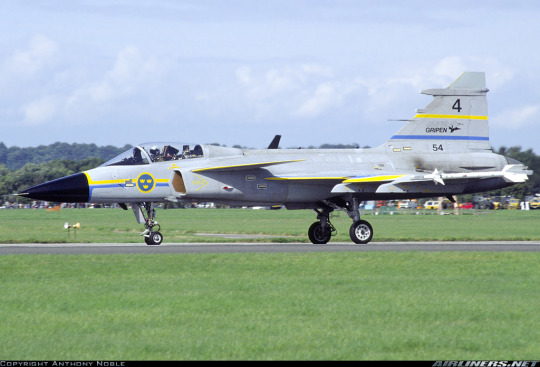
By the mid-70’s the Swedes were beginning their search for a next-generation fighter to replace the Viggen. The American F-16 and F/A-18 were briefly considered, but these proposals were dropped on logistical and protectionist grounds. In 1980, Saab was issued requirements under a program known only as JAS - implying a high-performance multirole. All of Sweden’s major military companies came together for the effort as Saab went to work on design studies. Reportedly, they received help from British Aerospace, who provided their P.106 design that had been rejected by what became the Eurofighter consortium. However, Saab was also conducting several similar design studies around the same time, so just how much of the P.106 carried over to Saab’s new fighter is unclear. Whatever the case, the JAS did embody the basic principles of the P.106. It was a compact single-engined fighter with a delta-canard layout. An even greater emphasis was placed on affordability and serviceability, but comparatively lenient range requirements allowed Saab to keep the aircraft small. A mockup was completed in early 1986, but the program ran into difficulties as cost overruns, schedule slips, and political pressure threatened the JAS. Fortunately, the fighter would survive all the pressure, finally taking flight in December 1988 as the JAS 39 Gripen.
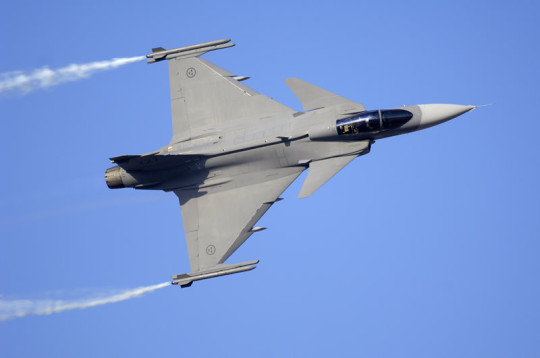
Compared to contemporary designs under development in Europe, the Gripen sped through development. Although one prototype was lost in a crash, the first production Gripens were flying by March 1993. It was a quite compact fighter, being half the empty weight of the Viggen and three-quarters that of the F-16. Designed around Sweden’s distributed airfield doctrine, the Gripen seemed perfect for Sweden’s needs. It needs only 600m for takeoff and landing, and it can be fully serviced by a crew of six - only one of which needs any special training - in just ten minutes. Compared to the Viggen, the Gripen requires 40% less maintenance and half the fuel. The small size by no means meant it was a downgrade, however. All new electronics installed were both more significantly more capable and lighter than those on the Viggen.

The Gripen would enter Swedish service in 1997. Deliveries ended in 2008, with the last batch of aircraft consisting of Gripen Cs - brought up to NATO standards and fitted with an inflight refueling probe. Even with the changes, the Gripen was doing well. The last batch of Gripens came in 10% below the expected price at under $30 million a plane. In 2011, the Gripen became the first Swedish fighter since the 1960s to fly combat sorties when Sweden participated in the no-fly-zone over Libya. Eight Gripens were deployed for three months, flying 650 reconnaissance missions for NATO. Unfortunately for Sweden, the Gripen lost its competitive edge quite quickly. With the new generation of fighters entering service, the Gripen C is becoming outdated, so Sweden is looking to update much of the fleet to the E/F standard. However, this changed by 2014 as Sweden decided to purchase 60 new-built Gripen Es.
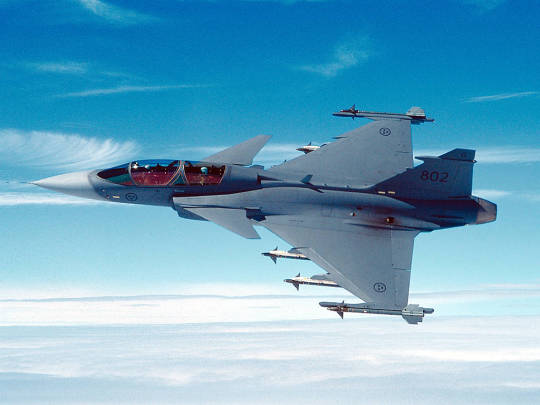
Unsurprisingly, a cheap, easy to maintain aircraft such as the Gripen attracted significant export attention. Coupled with the end of the Cold War and the relaxation of Swedish arms restrictions, the Gripen has become Saab’s greatest success to date. The first export customer came in 1999, when South Africa ordered 28 to replace their aging Mirage F1s. Hungary followed in 2001, leasing 14 fighters from Sweden for a decade (and extending it again when it ran out). The Czech Republic also opted to lease the Gripen to 2026. Thailand would become the last customer of the Gripen C/D, ordering their new production aircraft in 2008. For all the Gripen’s success, it has not been without failure. Although it may be incredibly cheap, it’s outperformed by its most prominent competitors, and it even has difficulties competing with Legacy aircraft like the F-16 and F-18 thanks to their comparable performance and more widely available parts.

By the time the new millennium came around, Saab had begun work on the next-generation Gripen. Taking flight in 2008, the new Gripen demonstrator (Gripen E/F) featured ten revised hardpoints for an external load of 6,000kg, uprated F414 engine, increased fuel capacity, and updated avionics. The new Gripen revitalized the fighter’s export opportunities. Switzerland, Finland, Croatia, and Brazil have all ordered the Gripen E/F, and Brazil’s Embraer has entered in a partnership to produce the Gripen E domestically. The Brazilian order also seems to have sparked development of another variant - the Sea Gripen. As the name suggests, the Sea Gripen would be navalized, ideally allowing the aircraft to replace the aging A-4’s on Brazil’s carrier Sao Paulo. Sea Gripens may be a long way off, but the Gripen E is here to stay. Although its main selling point - low costs - has been diminished with the Gripen E, it still seems to be attracting customers all over the world.
6 notes
·
View notes
Text
/k/ Planes Episode 88: Dassault

It’s time for another episode of /k/ Planes! This time, we’ll be revisiting the Dassault thread I did forever ago.
Dassault Aviation would have its origins all the way back in WW1, when Marcel Bloch and Henry Potez teamed up to create an aviation company. Though Bloch and Potez were met with moderate success, the end of the war cut orders, and Bloch left the industry. Only in 1929, after the establishment of the French Air Ministry, did Bloch return to the market, creating a new company. His firm rose in prominence over the years, eventually being absorbed into SNCASO in 1936 when the French arms industries were nationalized. After the fall of France, Bloch refused to collaborate with the Germans, leading to his imprisonment by first the Vichy government and eventual transfer to Buchenwald. He survived his internment, however, and upon his release he changed his last name to Dassault, soon enough founding a new venture under the new name. Dassault Aviation rapidly rose to be the primary aviation company of France, making use of both excellent engineering and political maneuvering to ensure their dominance on the French market. Thanks to this, they have survived the post-Cold-War drawdown and have become the sole major aerospace company in France.
Société d'Études Aéronautiques SEA IV
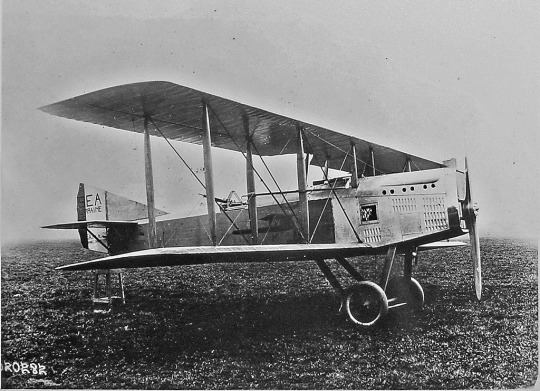
Bloch’s first foray into aircraft design would come towards the end of the first world war. Partnering up with Louis Coroller and Henry Potez, Bloch established the firm SEA and went to work on a series of new aircraft designs. Work started on the SEA I, a single-seat observer powered by a 120hp engine. Though the engine was underpowered, the airframe was solid, allowing the group to further develop the design. Two subsequent designs - the two-seat SEA II and three-seat trimotor SEA III - were developed, but the firm continued to be hampered by a lack of suitable engines. The emergence of the Lorraine 370hp engine solved their problems. A new design - the SEA IV - was produced, intended to be flown as a two-seat fighter. The SEA IV took to the skies at the end of 1917, and soon enough, the French had placed an order for 1,000 examples. Unfortunately, the firm’s fortunes were cut short. The first production aircraft rolled out the very day the war ended, and soon enough the production order was cut to just 115 examples. The postwar aviation slump would spell the end for SEA - Bloch withdrew from the firm soon after the end of the war, shifting his efforts to real estate for several years.
Bloch MB.81

With the establishment of the French Air Ministry in 1928, Bloch returned to the aviation business. Founding a new company under his own name, he went to work immediately to meet a requirement for an air ambulance. The MB.80 that resulted was a simple cantilever monoplane with fixed gear and a single engine in the nose. The pilot sat well aft of the wing, and a large enclosed compartment was put between the cockpit and engine to carry a stretcher. Although the stretcher compartment was separated from the cockpit, an intercom system was installed to allow communication between the passenger and pilot. The MB.80 had excellent rough-field performance, intended to facilitate operations in the French North African colonies. The MB.80 prototype took flight in the Summer of 1932, performing tests without incident. The newly formed Armee de l’Air would order 20 production examples under the designation MB.81. The MB.81 would enter service in 1935, and it served through the interwar period in North Africa and the Middle East. A few were brought back to France when war broke out, and the last survivors would fly on in Vichy-controlled Syria until the colony fell to the British in 1941.
Bloch MB.200
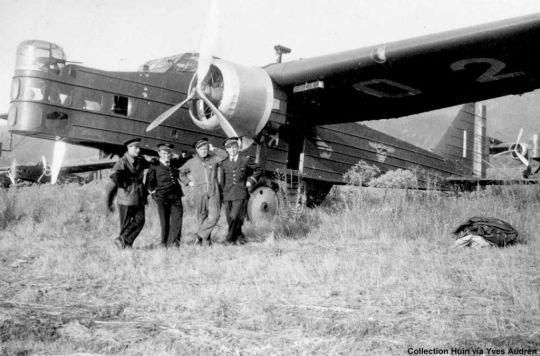
When the French Air Ministry issued requirements for a five-seat night bomber in 1932, Bloch responded with the MB.200. The MB.200 was an ugly shoulder-winged monoplane with a distinct interwar feel to it. Fixed, spatted undercarriage was slung under the corrugated wings, while a large boxy fuselage with a glazed nose would carry the crew and payload. Defensive armament was three machineguns - one in a nose and dorsal position, as well as a ventral gondola. The MB.200 prototype would take flight in June 1933. Performance fell short of expectations, but it nevertheless was selected as one of the contest winners and ordered into production. By the time the MB.200 had entered service in 1935, it was already glaringly obsolete. Even so, the French continued to produce it (eventually operating 200 examples), and the Czechs, desperate for a new bomber, licensed the design for domestic production. It took some time for production lines to get started, and only in 1937 did production of the Czech machines begin. Ultimately, over 100 Czech MB.200s were built, eventually passing into German service when the country fell. Captured machines were placed in training schools with the Luftwaffe and Bulgarian Air Force. French MB.200s fared little better. Over 100 remained in frontline service when war broke out, although they were rapidly shifted to second-line duties. They lived on after the Fall of France, flying in the Vichy-controlled colonies. In Syria in 1941, they flew perhaps their only combat sorties, attacking British shipping as the British moved to occupy the colony.
Bloch MB.130
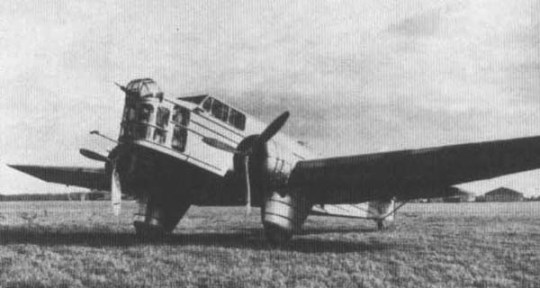
In 1933, the French Air Ministry had issued requirements for a multirole combat aircraft. Bloch was among the eight manufacturers that responded to the requirements, producing a low-winged design sharing much with the boxy corrugated bombers before it. Designated the MB.130, the aircraft took flight in June 1934 with fixed, spatted landing gear fitted. After preliminary tests, the MB.130 was refined - its corners were smoothed, and retractable gear was added. Testing continued for some time, as Bloch continually revised the aircraft, proposing various different tail configurations and powerplants. By October 1935, Bloch was in talks for production of 40 examples for the Armee de l’Air, but these would fall through. Bloch would continue improving his design to create the MB.131, but the corrugated MB.130 would never enter production.
Bloch MB.210
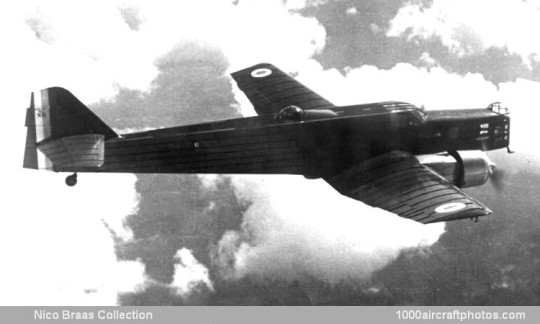
In 1933, Bloch began work on a private venture project to meet a French Navy requirement for a heavy torpedo bomber. Designated the MB.210, the new bomber shared most of the construction principles of the preceding MB.200, Corrugated skin and a boxy fuselage with poorly-streamlined protruding turrets was used just as in the MB.200, but a more modern layout - a low cantilever wing with retractable landing gear - would hopefully make the aircraft more competitive. The MB.210 would take flight in late November 1934. The French Navy requested the development of a floatplane variant, but when it began testing in 1936, it proved unsatisfactory and thus no production was ordered. Fortunately for Bloch, the design had attracted the attention of the Armee de l’Air. At the end of 1936, the MB.210 was ordered into production. While the bomber offered improved performance over the older bombers it replaced, it was problematic in service. Its retractable landing gear and variable pitch propellers were problematic, as were the originally installed powerplants. The engines were underpowered and prone to overheating, leaving the aircraft sluggish and hurting takeoff performance. Fortunately, the fleet would be re-engined as war loomed.

When war finally broke out in Europe, the MB.210 was flying with 12 bomber units. They flew in both day and night missions, but the Armee de l’Air quickly discovered that they were horribly obsolete. The MB.210 units were progressively withdrawn and re-equipped with modern types, while retired examples were shifted over to flight schools. However, not all conversions had been completed when the German offensive finally came in 1940. They did see some combat use during the Battle of France, but their showing was poor, despite flying exclusively night missions - five were shot down, two lost to accidents, and nine were written off after landing. About 160 examples survived to the Armistice, 37 of which were captured by the Germans.
Bloch MB.131
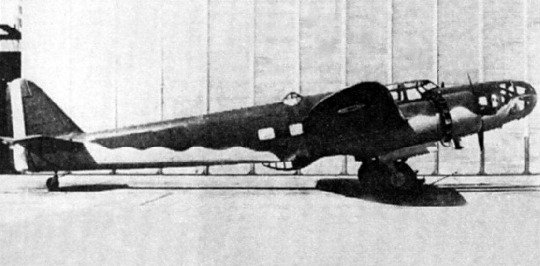
After about two years of continuing revisions of the MB.130, Bloch had settled upon the distinctly modern-looking MB.131. The boxy corrugated fuselage of the MB.130 was replaced with a sleek, streamlined one. The dorsal and ventral gondola were reduced in size and streamlined as well, reducing their fields of fire but improving overall performance. The MB.131 would first fly in August 1936, but it too had several deficiencies. Only after a radical redesign, which took another year, was the design finally accepted for production. By the time the MB.131 had entered service, it was june 1938. By the outbreak of war, 109 were flying with frontline reconnaissance units. Early missions involved unescorted flights over Germany, which quickly proved to be ill-conceived as losses mounted. The Armee de l’Air gradually began shifting the MB.131 to secondary roles, but when the German offensive began on May 10, 35 were still on the front. 53 examples survived the fall of France in the Free Zone, and a further 21 were captured by the Germans. However, they would see no service with the Vichy - the Germans scrapped those they captured, and Vichy France moved survivors to training units.
Bloch MB.134/135

When the French Air Ministry issued requirements in 1936 for a modern medium bomber, Bloch settled on two solutions. The first, the MB.134, was distantly derived from the MB.131, making use of new wings, a twin tail, and more powerful engines. One was built and flown in July 1939, but it faced resistance from the Air Ministry due to its similarity to designs already in production. Ultimately, the MB.134 was rejected, causing Bloch to resign his position as the head of SNCASO in early 1940. Parallel to the MB.134, Bloch had developed the four-engined MB.135. The MB.135 carried over most of the changes of the MB.134, but a slightly revised inner wing section was used. As with the MB.134, it performed well in tests, but it faced resistance from officials because it offered little over types already in service. In the end, neither of the Bloch proposals would enter production.
Bloch MB.150
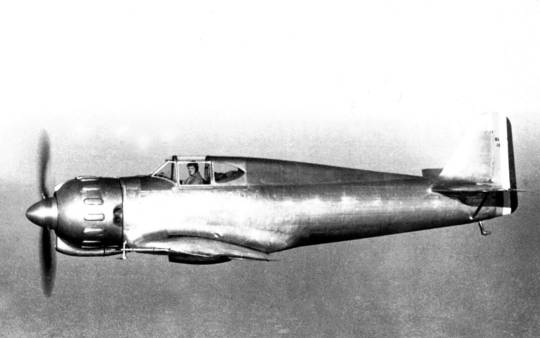
In 1934, the French Air Ministry issued requirements for a modern monoplane fighter. Bloch would respond with the MB.150 - a low-winged all-metal monoplane powered by an 850hp radial engine. The MB.150 prototype was completed in early 1936, but it was incapable of taking flight when Bloch attempted its maiden flight later that year. Though the competing Morane-Saulnier MS.405 would win the competition, Bloch resumed work on the design in 1937 after his company was nationalized. After the installation of a new engine and larger wings, the MB.150 would finally fly in October 1937. Although performance was unimpressive, the Armee de l’Air’s desperate shortage of modern fighters meant that Bloch’s design would receive a production order. As the MB.150 was found to be unsuitable for production, a rapid redesign resulted in the MB.151. A revised fuselage, new wings, metal control surfaces, and an armament of two 20mm cannon and two 7.5mm machineguns were added to the machine, which took flight in August 1938.
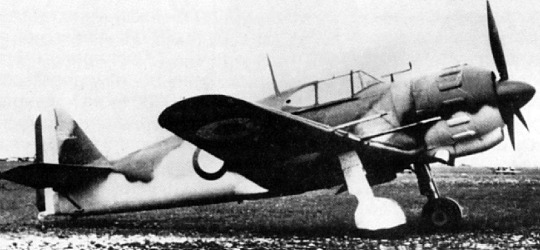
Unfortunately, the MB.151 would also fall short of expectations, so Bloch further refined the design into the MB.152. Changes with the MB.152 included a longer wingspan and a new radial engine providing 200hp more than previous iterations. The MB.152 would fly in December 1938, and it would be rushed into production. Deliveries of the first production examples began early the next year, but cooling issues were soon discovered. Boch alleviated this by implementing a new cowling, but this increased drag and cut performance. By the time the German invasion began in May 1940, 363 MB.152s were in service, but only 80 had received all the modifications necessary to make the type combat ready. Their showing the in the Battle of France was poor. They proved to be a steady gun platform and were robust aircraft, but they suffered from a short range, poor climb rate, and issues with icing on the guns. Even so, they claimed about 190 enemy aircraft for 86 losses. Six squadrons would continue to fly with the Vichy government after the armistice, but they quickly made the decision to switch over to the D.520. By the end of 1942, the MB.150-series fighters had been completely removed from frontline use.
Bloch MB.174/175
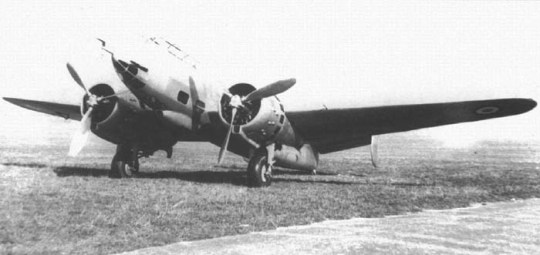
In 1936, the French Air Ministry issued requirements for a two or three seat multirole aircraft to serve in reconnaissance and light bomber roles. Bloch’s response, the MB.170, would be a fairly conventional low-winged twin-engine design with a double tail. The first prototype was a two-seater, fitted with two 20mm cannon and two machineguns firing forward and two defensive machineguns fitted in dorsal and ventral positions for the rear seater. A second prototype, configured for a crew of three, removed the ventral cupola, extended the canopy, and enlarged the tail. Both prototypes would take flight in early 1938, but a host of revisions would be required before the type would be acceptable to enter service. A year after the MB.170 flew, the revised variant - the MB.174 - finally took flight, receiving an order for 50 examples to serve with reconnaissance units.
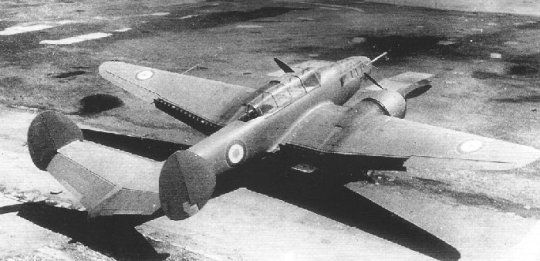
Deliveries of the MB.170 began in March 1940, with the aircraft replacing the Potez 637 with strategic reconnaissance units. When the German offensive began in May, the reorganization was thrown into chaos, meaning that only one unit would ever fully equip with the type. This sole unit of MB.174s performed exceedingly well. Its excellent speed and maneuverability at altitude allowed it to evade Luftwaffe fighters, and over the course of the campaign only three examples would be lost to enemy fire. Most surviving examples would evacuate to North Africa after the Armistice, where they fell into the hands of the Vichy government. They would fly regular reconnaissance flights over Gibraltar until 1942, when French North African forces switched sides in the aftermath of Operation Torch. Surviving MB.174s would serve into the Tunisian campaign with reconnaissance units before finally being replaced by reconnaissance variants of the P-38.

Parallel to the reconnaissance-oriented MB.174, the light-bomber MB.175 was created. The MB.175 differed from the MB.174 primarily with its enlarged bomb bay, allowing it to carry 200kg bombs rather than the 50kg bombs of the MB.174. To accommodate this new bomb bay, the fuselage was lengthened and widened. First flying in December 1939, it was ordered into production, but the more pressing need for reconnaissance aircraft to replace the Potez 637 meant that the MB.175s would be delivered to reconnaissance units. Though service history paralleled that of the MB.174, they were far less numerous than their reconnaissance-oriented counterpart - only 25 would be delivered. When the French Navy reformed in 1945, the MB.175 was given new life by a requirement for a torpedo bomber. The MB.175T added underwing racks for rockets as well as the required torpedo-bombing capacity, and in 1947 it would enter Aeronavale service. A total of 80 examples would be built, but their service was brief - by 1950, the MB.175T was retired.
Bloch MB.480
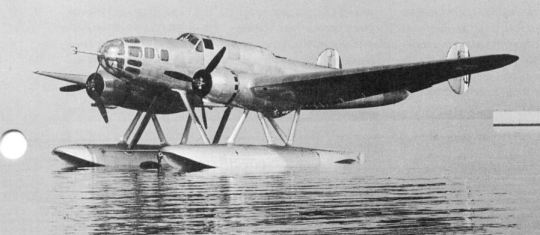
In 1937, the French Air Ministry ordered Bloch to develop two prototype floatplanes to serve with the French Navy as patrol torpedo bombers. Bloch derived his design from the MB.131, giving it a crew of five, two defensive machineguns and a dorsal cannon turret, and provisions for up to two torpedoes or various bombs. Though the first prototype was completed in 1938, it would not fly until late June 1939. Various modifications were made, but overall the MB.480 prototypes performed well. Unfortunately, by this time the French Navy’s doctrine had changed. The French Navy had since decided that their patrol bomber requirements could be met by land-based aircraft. Seaplane development was suspended, and the French Navy instead ordered the significantly faster Loire et Olivier LeO 451, which was already in production for the Armee de l’Air.
Bloch MB.700

Bloch’s light fighter proposal vaguely resembled the MB.150 series fighters then under development. The MB.700 was an all-wooden semimonocoque design powered by a closely-cowled Gnome-Rhone radial engine that produced 700hp. Armament was to be two 20mm cannon and two 7.5mm machineguns. While the development contract was issued in 1936, a heavy commitment to other projects meant that a prototype wouldn’t roll out until 1940. Only in April 1940 did testing begin, and by the time the airfield fell to the Germans, the first prototype had flown just 10 hours. The Germans burned the first prototype, and, although work began on a second prototype, it would not be completed before France fell.
Bloch MB.162

Bloch’s last combat aircraft to fly before the fall of France would be the MB.162 heavy bomber. Designed in response to a requirement for a five-seat heavy bomber capable of day and night operations, the MB.162 was derived from an earlier Bloch design for a long-range transport (MB.160). The MB.162 would be a four-engined machine fitted with two machienguns in nose and ventral positions and two cannon in dorsal and ventral positions for defense. Payload was an impressive 3,600kg carried in an internal bay. Unfortunately, the MB.162 prototype would only fly in June 1940, days away from the Fall of France. While the MB.162 proved quite fast (although poorly protected), the Armistice would put an end to its development. It would never enter production, and the sole prototype was taken into Luftwaffe service with the clandestine I/KG 200.
Dassault MD 450 Ouragan

In 1947, the newly reformed Dassault would propose a jet fighter to the French government. Although they showed interest, no contract was placed, so Dassault decided to go it alone. Detailed design work began in late 1947, and in April the next year construction of a prototype began. the new fighter closely resembled other first-generation designs. It had a stovepipe fuselage with an intake in the nose and a bubble canopy, and fuel tanks were placed on the tips of the low-mounted straight wings. Although it superficially resembled the Republic F-84 Thunderjet, it was considerably smaller and lighter. Power was to come from a license-built Rolls-Royce Nene. The new fighter, designated the Ouragan, would take flight in 1949. Three prototypes would be followed up by 15 pre-production aircraft intended to evaluate various armament configurations and engines. In August 1950, this was followed up by an order for full production.
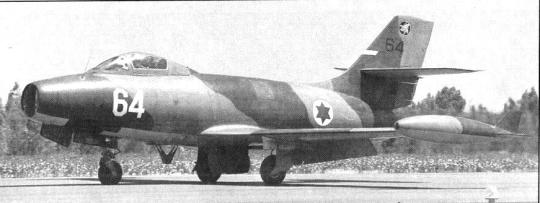
Deliveries of production aircraft began in 1952, replacing the foreign-designed de Havilland Vampire. It would be a popular aircraft thanks to its pleasant flying characteristics and stability as a firing platform, but its service with the Armee de l’Air was fairly short-lived thanks to the arrival of newer Dassault fighters. They were gradually replaced by the Mystere IV, finally leaving service completely in 1961. Foreign customers were a bit more enthusiastic about the type. India ordered 71 Ouragans in 1953, receiving most of the aircraft by the end of the year. They would later supplement their fleet with secondhand French Ouragans, although they too would begin phasing out of service by the end of the decade. The Israelis would purchase a number of Ouragans in 1955, just in time to make its combat debut in the Suez Crisis. Being outclassed by the Egyptian MiG-15s, the aircraft were assigned to ground-attack duties, where they performed well. Although not flown in fighter duties, they nevertheless claimed their share of victories over the Egyptian pilots. Though they were progressively withdrawn as better aircraft became available, they would stick around long enough to fly in the 1967 Six-Day War.
Dassault MD 452 Mystere I/II

Before deliveries of the Ouragan had even began, Dassault was working on a successor. Designated the Mystere I, the new design was a simple improvement upon the Ouragan, making use of 30 degree swept wings. Three prototypes were made, the first of which took flight in 1951. These would be refined into the Mystere II, which revised armament and made use of the new Rolls Royce Tay engine. Tests of the new aircraft seemed promising - a Mystere II prototype became the first French aircraft to break the sound barrier during a shallow dive in October 1951. The aircraft would be ordered into production as the Mystere IIC, featuring an armament of two 30mm DEFA cannon and an Atar 101D turbojet, as well as a revised tail and fuel tank layout. The first Mystere IIC flew in June 1954, and deliveries began later that year. However, it was quickly overshadowed by the latest fighters under development, meaning that by the time deliveries had finished in 1957, the Mystere II was already being relegated to training duties. The type did briefly attract the attention of the Israelis, who looked into ordering 24 examples, but they would later change their minds in favor of procuring the more advanced Mystere IV.
Dassault MD 453 Mystere IIIN
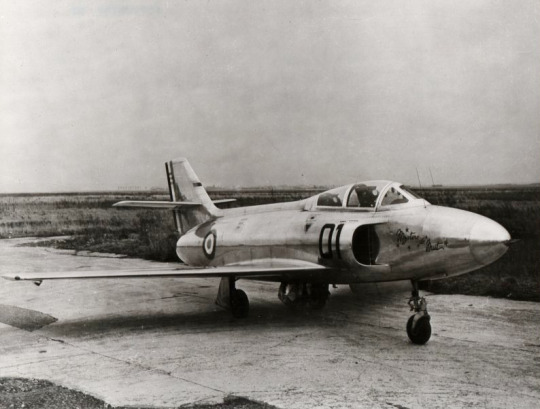
Dassault had been performing experiments on the Ouragan to create a two-seat night fighter variant, but when the Mystere came along, the focus of development was shifted to the new fighter. The resulting Mystere IIIN shared much of the special night-fighter features designed for the Ouragan, including a solid nose (containing a radar), side-mounted intakes, and a tandem two-seat cockpit. As with the Mystere IIC, it was fitted with the twin ADEN 30mm cannon. The Mystere IIIN would take flight in July 1952, and a total of three prototypes were planned but only the original was ever built. Unfortunately, this project was just as short-lived as the night-fighter Ouragans, as the newest Dassault fighter - the Mystere IV - had taken the limelight.
Dassault Mystere IV
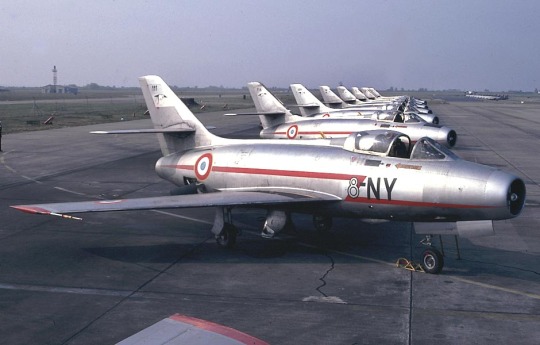
The next design to carry the Mystere name would be more of a clean-sheet design than a modification of previous iterations. The new Mystere IV would share the armament, layout, and engine of its predecessors, but an entirely new fuselage featuring vastly improved aerodynamics was developed. Taking flight in 1952, it quickly received a massive production order from the Armee de l’Air. The first production Mystere IV would fly in 1954, and by the end of that year it had entered service. As with previous Dassault jet fighters, the Mystere IV would attract export to Israel and India. The Mystere IV would make its combat debut over the Suez Canal in 1956, flying with both the Armee de l’Air and the IAF. IAF Mystere IVs in particular made a good showing - flying 147 sorties (primarily ground attack) they claimed four Egyptian Vampires, a MiG-15, and a MiG-17 for the loss of a single aircraft to ground fire.
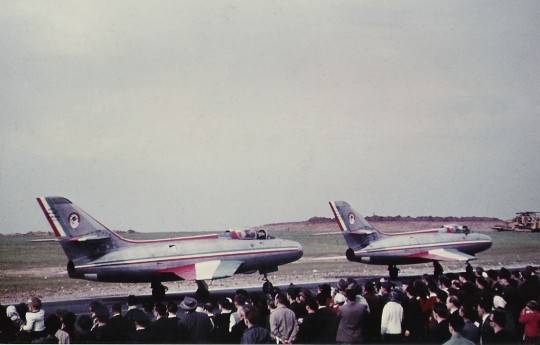
Although Israel was phasing the Mystere IV out of service by 1967, two squadrons still flew the type during the war. Again flying as an attacker, they flew 610 sorties and claimed two enemy fighters for the loss of seven of their own (five to ground fire, two to enemy MiG-21s). India’s fleet of Mystere IVs would see extensive use in their 1965 war with Pakistan. They claimed at least two aerial victories (including an F-104), and numerous other aircraft were also destroyed on the ground by the Mysteres. Soon after the war, however, the Indians began to phase out the aircraft. Though examples stuck around long enough to fly in the 1971 War, they would completely leave service by 1973.
Dassault Super Mystere
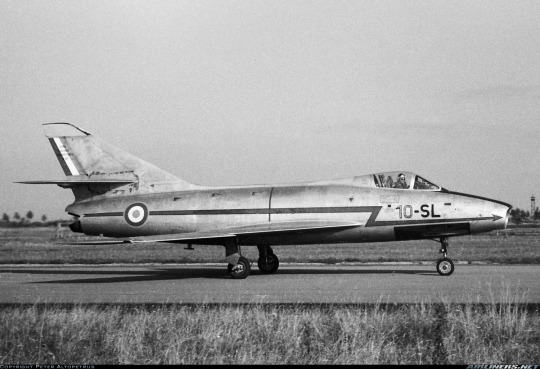
The final iteration of the Mystere design would aptly be named the Super Mystere. The Super Mystere was another major refinement of the design, incorporating a refined fuselage, new thin 45 degree swept wing, and a new engine. Taking flight in March 1955, it distinguished itself from the first day of tests - it broke the sound barrier in level flight. Quickly receiving a production order, it would become the first Western European supersonic aircraft to enter production. Early production models would have a retractable Matra rocket pack to supplement its cannons, but these were omitted on later variants. Deliveries began in 1956, ending in 1959. Unfortunately, the Super Mystere was eclipsed by the Mirage III, meaning that they would rapidly be relegated to the attacker role. As such, they were integrated with the latest air-to-ground munitions. Underwing pylons provided space for up to 900kg of stores, including rocket packs, bombs, fuel tanks, AIM-9 Sidewinders, and the AS-30 guided missile.

Israel would come to acquire 36 Super Mysteres diverted from the original French order. These were found to be a match for the Arab MiG-19s, and, thanks to better training, IAF Super Mysteres regularly came out on top in the occasional engagement. They would serve as attackers in the 1967 War, and, in the early 1970s, the IAF upgraded the fleet with new avionics and the American-designed J52 engine. This new configuration would make its debut in the 1973 War, again performing well. They would soon be phased out of IAF service, but 12 would be sold to Honduras, who flew them until 1989.
Dassault Mystere Delta 550/Mirage I
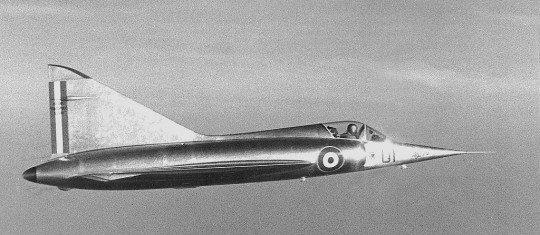
In 1953, after a year of design studies, the French government issued requirements for a lightweight high-performance interceptor. With requirements calling for an excellent climb rate and top speed well over Mach 1, Dassault selected a delta-winged configuration for their new design. Although it carried the Mystere name, the new fighter - the Mystere Delta 550 - was nothing like the preceding fighters. It was a simple tailless-delta fighter, fitted with two Armstrong Siddeley Viper turbojets. The first prototype, lacking an afterburner or the planned rocket booster, would fly in June 1955. After successful tests, it received several modifications. The afterburners and rocket motor were installed, and the tailfin was revised and reduced in size. Now renamed the Mirage I, the fighter succeeded in reaching the specified Mach 1.3 in level flight, and, with the rocket firing, it reached Mach 1.6. However, it quickly became apparent that its projected payload - just a single AAM - was insufficient. The Mirage I was an interesting proof of concept, but a much larger design was necessary for the layout to be feasible.
Dassault Mirage III
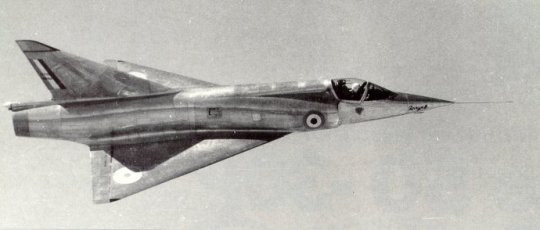
Following the successful testing of the Mirage I, Dassault looked into a new design - the Mirage II - fitted with Turbomeca Gabizo engines, but before the proposal left the drawing board Dassault had determined that it was still insufficient. Around the same time, a significantly larger proposal, making use of a single SNECMA Atar turbojet, was developed. Known as the Mirage III, it was 30% heavier than the Mirage I, and it made use of the newly discovered area rule to reduce transonic drag. Like the Mirage I, it had provisions for a rocket booster in the tail for high-speed dashes. The Mirage III prototype would first fly in November 1956, hitting a top speed of Mach 1.52 on its seventh flight. After modifications to the intake shock cones and the addition of the rocket booster, the Mirage III performed even better, hitting a top speed of Mach 1.8. The success of the Mirage III resulted in an order for 10 pre-production Mirage IIIA fighters. The Mirage IIIA shared the name of the prototype, but made significant changes. The fuselage was lengthened by two meters, a larger, thinner wing was fitted, and an air intercept radar was fitted.
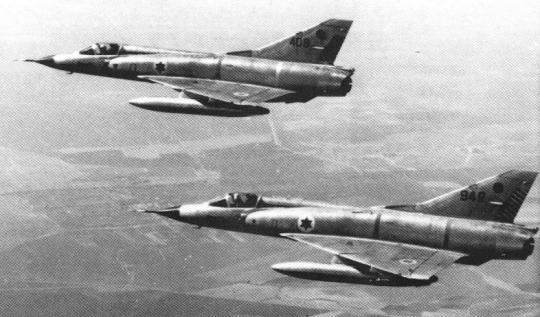
The Mirage IIIA would fly in May 1958, eventually becoming the first European aircraft to break Mach 2 in level flight. The Mirage IIIA was followed up on by the first definitive production model - the Mirage IIIC. The Mirage IIIC took flight in October 1960, and by the next year it had entered service with the Armee de l’Air. Though designed as an interceptor, they were qualified for ground attack operations with unguided bombs and rocket packs. Switzerland, South Africa, and Israel would all come to fly the IIIC, and Israel would be the first to fly the type in combat. In 1963, they claimed their first kills against Egyptian MiGs, and over the years it proved a match for the Soviet-supplied MiG-21s. In the Six-Day War, they were put to use as attackers, performing preemptive strikes on enemy airfields. Though not designed for such duties, they performed the sorties without incident.
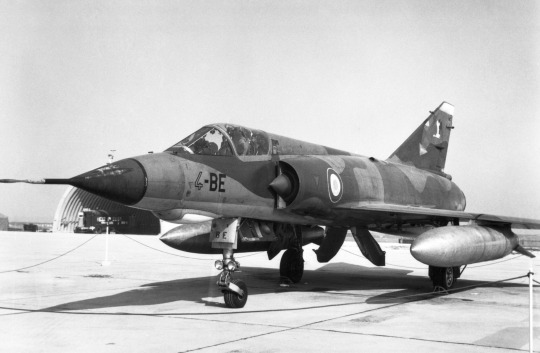
The Mirage IIIC was followed up by the considerably improved IIIE. The IIIE had an extended forward fuselage fitted with extra avionics, included a dual-mode radar. Two extra stores pylons were added, bringing the total to five, and the extra space in the fuselage was filled with fuel to make up for the IIIC’s poor range. The Mirage IIIE would be a smashing success. At home, France ordered almost 200, and customers all over the world received their own special variants tailored to their needs. The IIIE would also become the basis for several reconnaissance variants (holding the designation IIIR). The IIIR retained its combat capabilities (including its cannons), but replaced the radome with a new faceted nose filled with cameras. By the 1970s, Mirage IIIs were flying all over the world.
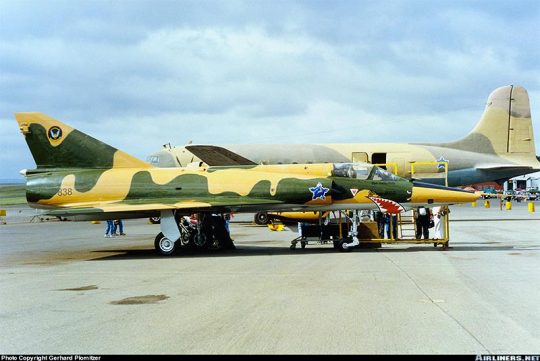
Combat performance of the Mirage III was generally good, although its shortcomings were readily apparent. In the 1973 Yom Kippur War, Mirage IIIs were relegated entirely to air-to-air duties, where they reportedly fared well. With other operators, the short range of the Mirage III would be a liability. South Africa had great difficulty using their Mirage IIIs in the Border War due to range limitations, and the poor takeoff and landing characteristics of the type made operations from the comparatively rough airstrips near the Cutline difficult. Nevertheless, they would perform well when called into action. Mirage IIIRZ and R2Zs were increasingly deployed to fly reconnaissance missions too dangerous for any other SAAF aircraft, and over the course of the entire war, only one Mirage III - an R2Z hit by AAA fire - would be lost to enemy action. By the time of the Falklands War, the Mirage III was clearly reaching obsolescence. Unable to fly from the short runway at Stanley, Argentine Mirage IIIs were forced to fly all the way from the mainland to provide fighter cover over the islands. Lacking a refueling probe, they were only able to make a single ineffectual pass before having to return to base. In the few engagements they had with British Harriers, they never came out on top.
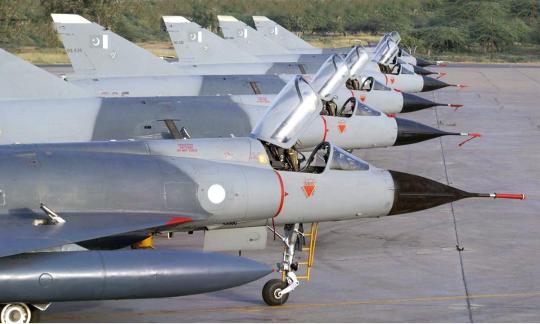
By the end of the 80’s, the failings of the Mirage III were finally sinking in with its operators. Australia, South Africa, and France all retired their fleets in the late 80’s and early 90’s, and Israel has since replaced their Mirage IIIs with more advanced domestic developments or American-built aircraft. Smaller nations would fly the Mirage III for some time longer - many South American and African nations flew the Mirage III into the 2000s. Argentina still flies the Mirage III in small numbers, though their condition has only deteriorated since the Falklands War. Pakistan stands out, however, with its advanced fleet. They purchased Mirage IIIs from countries across the world as the type was progressively phased out, and a total of 75 aircraft were given a major overhaul to modernize avionics. Under the Project ROSE program, PAF Mirage IIIs were integrated with BVR missiles, inflight refueling probes, and an entirely reworked and modernized cockpit.
Dassault Etendard VI
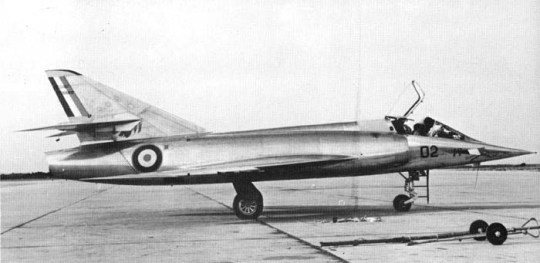
In 1953, NATO had issued the NBMR-1 requirements for a lightweight strike fighter. Specifications called for a cheap aircraft capable of rough-field operations powered by a Bristol Orpheus engine. At the same time, the Armee de l’Air had issued similar requirements for a strike fighter. Hoping to meet both requirements simultaneously, Dassault created a common airframe known as the Etendard. The Etendard built upon experience with the latest Mystere series designs (and in fact was originally given the designation “Mystere XXII”), using a fuselage similar to the Mirage 1 and surfaces derived from the swept-wing Mysteres. The Etendard VI - the proposal tailored to NATO requirements - would receive an order for three prototypes in 1955. Taking flight in March 1957, the Etendard VI closely followed the specifications. It was powered by a single Orpheus turbojet and had a top speed just below the speed of sound, and an armament of four 12.7mm machineguns and pylons for 540 kg of external stores was fitted. The second prototype would feature revised intakes and two 30mm DEFA cannon in place of the .50s. The third prototype, which would not be built before the contest decision was made, would further improve the design by incorporating area ruling. Unfortunately, the design failed to gain favor with NATO. Though both prototypes were tested, officials instead selected the Fiat G.91 as the contest winner.
Dassault Etendard II
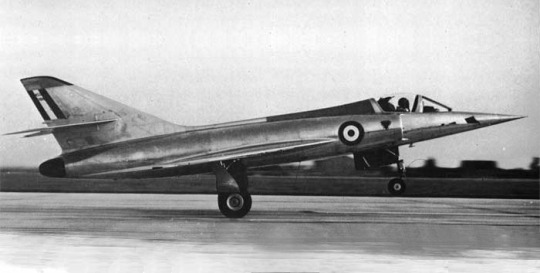
Parallel to the Etendard VI, Dassault would produce the Etendard II. Not limited by the NATO requirements, the Etendard II was closer to what the Armee de l’Air wanted - it widened the Etendard fuselage to accommodate two Turbomeca Gabizo engines, and armament was replaced with two 30mm DEFA cannon or a pack of 32 Matra rockets. The changes to the design resulted in an aircraft slightly larger and heavier than the Etendard VI, all while featuring less overall thrust. The Etendard II would fly in July 1956, and unsurprisingly it proved horribly underpowered. Several different engine fits were proposed - everything from afterburning engines to entirely new powerplants, but ultimately the project was deemed unpromising and it was cancelled.
Dassault Etendard IV
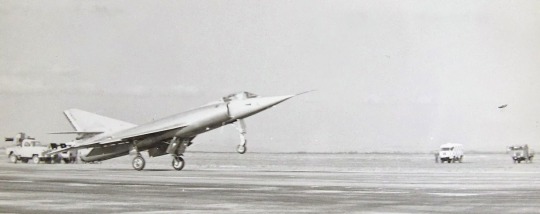
Although the Etendard II and VI would be a dead end, Dassault continued to pursue the concept as a private venture. The more successful Etendard VI was scaled up and fitted with a SNECMA Atar 101E turbojet, increasing the empty weight by about 30%. Taking flight in 1956, the design was pitched as everything from an advanced trainer to a multirole carrier fighter. The Armee de l’Air had by now lost interest in the Etendard concept, but the Aeronavale showed great interest in the navalized proposal. A semi-navalized prototype was ordered in late 1956, followed by an order for 5 pre-production machines the next year. The prototype Etendard IVM would fly in May 1958. One of the pre-production machines was fitted with an advanced boundary layer control system, but the concept progressed no further. The finalized Etendard IVM was significantly refined from the early Etendards. Two pylons were fitted on each wing for a modest payload of 3,000lb. In practice, the inboard hardpoints more often than not carried drop tanks to compensate for the Etendard’s poor range.
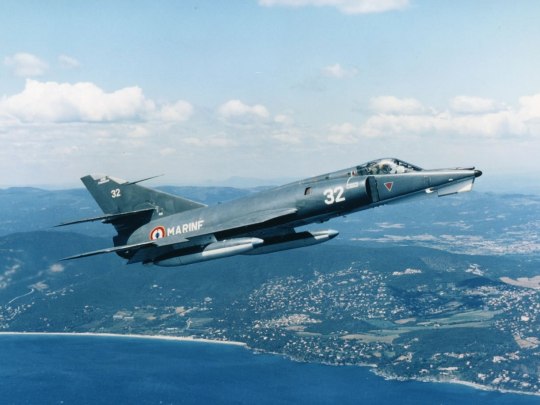
The Etendard IVM would enter service in 1962. A total of 90 would be made, both in standard IVM attacker and IVIP reconnaissance variants. Service was fairly quiet, although attrition took its toll on the fleet, forcing the Aeronavale to convert several IVMs to the IVP standard at the end of the ‘70s. The Etendard IVM would see no combat during its service, as it was replaced by the Super Etendard before the French Navy committed itself to any combat operations. The IVP stuck around longer, allowing it to see the occasional flight over the Middle East in the ‘70s and even a few sorties over former Yugoslavia in the ‘90s. At the end of the 80’s, a modernization program for the IVPs had begun, updating the cockpits, countermeasures, and navigational systems. Thus, while the IVM would be retired from trainer duties in 1991, the IVP would stick around until 2000 in active service.
Dassault Mirage IV

In 1956, France issued requirements for a new bomber to serve as the nation’s nuclear deterrent. Dassault responded by producing a scaled-up Mirage III design. Dubbed the Mirage IV, Dassault originally looked into a massive proposal mounting two J75 engines before settling on a more conservative design making use of two of the Mirage III’s Atar turbojets. Taking flight in 1959, the Mirage IV was 50% bigger than the Mirage III and twice as heavy. The crew of two was placed in tandem, and every inch of the airframe was crammed with fuel, precluding the use of a bomb bay. Because of the poor takeoff characteristics of a delta wing, the airframe was integrated with RATO boosters. Testing went smoothly, with the Mirage IV setting a world speed record on a 1,000km closed circuit. In 1961, an order for pre-production machines came,
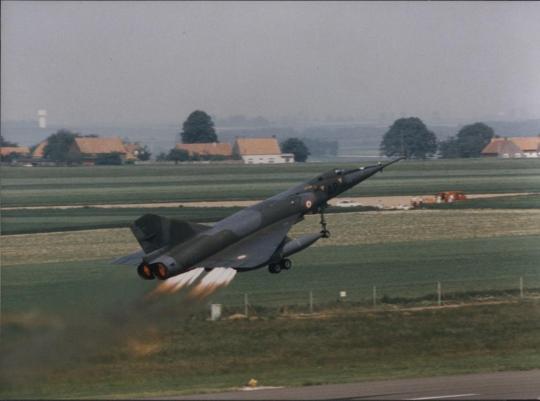
The Mirage IV would finally enter service in 1964, forming the basis for France’s nuclear deterrent. Standard operations called for the Mirage IV to carry a single nuclear payload in a semi-recessed position under the fuselage and a large drop tank under each wing. Even so, the Mirage IV lacked the range to strike strategic targets and return home without refueling. To remedy this, Mirage IVs were deployed in pairs, with one aircraft acting as a buddy tanker for the other. Later, a fleet of tankers was purchased to better serve the bombers. Outside of the nuclear strike role, the Mirage IV did have provisions to carry six 1,200kg conventional bombs or four AS-37 antiradiation missiles. However, they were never realistically going to perform such missions, as they were occupied with the deterrent role.
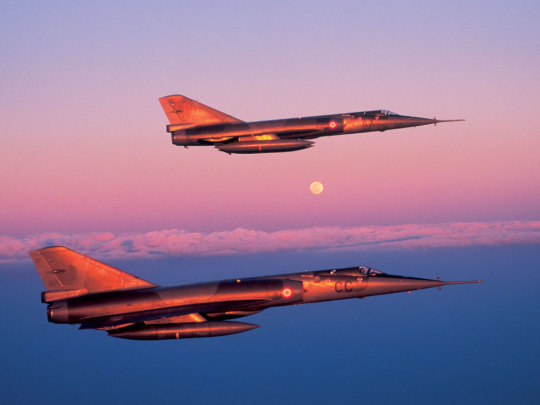
By the 1960s, the high-and-fast attack profile of the Mirage IV was no longer feasible. Crews were retrained to fly extremely low-level attack runs, but this cut into the combat radius and airframe lives. As the projected effectiveness of the bomber declined through the 70’s, France developed a standoff missile for the Mirage IV (the ASMP). In the mid ‘80s, the Mirage IV fleet began upgrading to mount the new missile and a new reconnaissance package. Under the designation Mirage IVP, the bombers received a much-needed update to their avionics as well. Even so, the IVP was short lived. In 1996, they were formally retired as bombers, with the nuclear strike mission passed on to the Mirage 2000N. They would remain in the reconnaissance role, flying over Iraq, Afghanistan, and former Yugoslavia, but the last of the Mirage IVs would finally leave service in 2005.
Dassault Mirage Balzac V
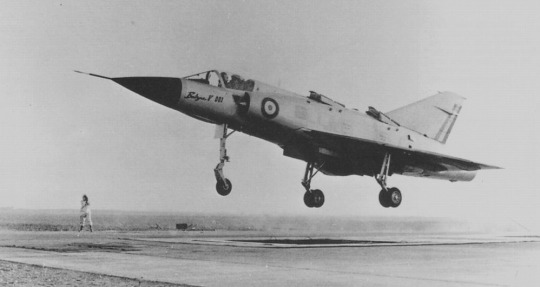
When NATO released the NBMR-3 requirements for a STOVL supersonic fighter in the early 1960s, Dassault would produce a proposal based off of their successful Mirage III. The basic design was simple - take a standard Mirage III and slap eight lift jets in the fuselage for vertical flight. The Mirage III prototype was taken out of storage and heavily modified to serve as a tech demonstrator for the concept. Renamed the Balzac V, the aircraft was fitted with eight RB108 lift jets and the associated systems for vertical flight, but devoid of any combat systems. Hovering flights began in October 1962, and the first transition to conventional flight took place in March of the next year. The Balzac would continue testing and fleshing out the concept for two more years. In 1964, it crashed, killing its pilot, but it was repaired and returned to service, flying until it crashed once again (killing another pilot), putting an end to the program. Though the Balzac would not be repaired after the second crash, the program was a success - it proved the general concept sound and allowed Dassault to go forward with full development.
Dassault Mirage IIIV
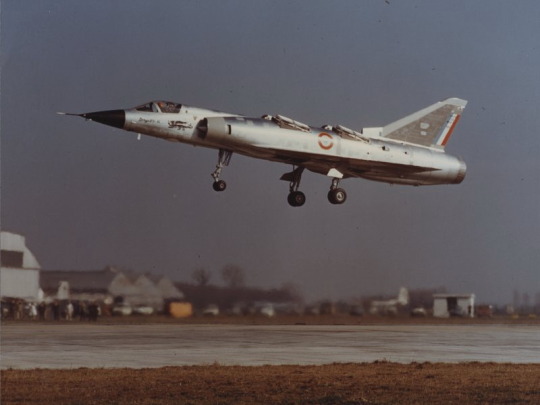
The follow-on to the Balzac V was the full-scale Mirage IIIV. The Mirage IIIV was extensively modified from the base design, and in many ways was an entirely new aircraft. The fuselage was lengthened and enlarged to accommodate the eight RB162 lift jets, and the Atar engine of the Mirage III was replaced with a Pratt & Whitney TF-104 turbofan. The wing was also enlarged to account for the extra weight. Two prototypes were ordered, the first of which flew in early 1965. The second prototype (fitted with a TF-30 in place of the TF-104) would fly in 1966. They seemed to perform reasonably well, even reaching Mach 2 in level flight, but NATO officials seemed more keen to the British competitor - the Hawker Siddeley P.1154. The maintenance nightmare offered by the Mirage IIIV seemed to deter NATO, and, following the loss of the second prototype at the end of 1966, the Mirage IIIV was dropped in favor of the P.1154. In response, France withdrew from the NBMR-3 program, resulting in its collapse.
BAC/Dassault Anglo-French Variable Geometry
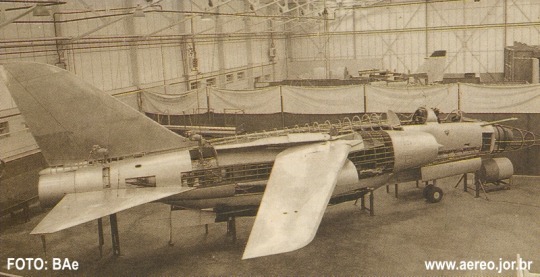
In 1965, Britain and France would come together to develop a two new combat aircraft. The first was to be a combat-capable advanced trainer (what would become the SEPECAT Jaguar) while the other would be a variable-geometry multirole fighter. Based off of earlier BAC design studies, the design was to fill French and British requirements for a high performance strike aircraft (particularly to fill the void left by the cancelled TSR-2), while meeting a British requirement for a replacement for the Lightning and a French requirement for a new carrier-based fighter. Working with Dassault, BAC modified their P.45 design study that the AFVG was based off of, adding Dassault’s distinctive shock-cone inlets and making use of engines jointly developed with the French. The final design was a two-seat aircraft intended to mount two SNECMA/Bristol Siddeley M45G engines. Armament would be two 30mm cannon, and, for the strike role, a single 2,500lb tactical nuclear store would be carried.

By 1966, developments in Britain had radically shifted the focus of the AFVG. F-4 Phantoms were procured to replace the Lightning, and the British hoped to fill the role of the aging Canberra bombers with the AFVG. Meanwhile, the French had been increasingly looking to develop the AFVG as a fighter. Requirements began to diverge, and further political developments (particularly the decision to procure the F-111K) cut into the potential AFVG order, bringing costs up. Although very general specifications were agreed upon in the middle of 1966, the Anglo-French committee was unable to finalize the requirements for the aircraft. Worse, cost projections pointed to skyrocketing expenses and unit costs. France was rapidly losing interest in the project, both due to rising costs and internal pressure from Dassault who was fairly actively working to undermine the program. France would withdraw in 1967, but the cancellation of the F-111K that same year left a massive capabilities gap among RAF strike aircraft. Thus, Britain had no option but to continue work on the AFVG alone. Although they would continue to look for foreign partners, BAC would soldier on alone for the time being to keep Britain’s last strike fighter program alive.
Dassault Mirage F2
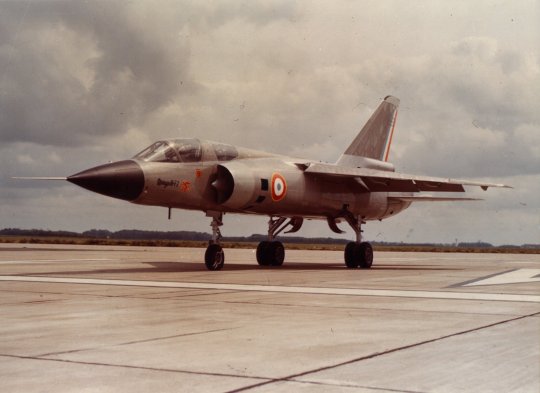
In the mid 1960s, France was working on several new designs to replace their Mirage IIIs. Among these projects were several new strike aircraft. The Anglo-French Variable Geometry program and parallel Mirage G offered a high-tech solution, but the Armee de l’Air was also interested in a lower-risk alternative, giving rise to the Mirage F2. The F2 was a significant divergence from the earlier Mirage series designs. In place of a delta wing, the F2 used conventional swept surfaces and a shoulder-mounted wing fitted with various high-lift devices. The fuselage itself was derived from the still-in-development Mirage G swing-wing fighter, and a single American-designed TF30 turbofan was selected to power the aircraft. Though itself a derivative of the two-seat Mirage G, the F2 would fly before its parent design, taking flight in June 1966. Performance wise, the F2 seemed adequate, with a top speed well over Mach 2, and it arguably offered a cheaper alternative to both the AFVG and the Mirage G. However, the Armee de l’Air determined the F2 was surplus to requirements, so they turned their attention to the other Mirage F-series designs.
Dassault Mirage F1
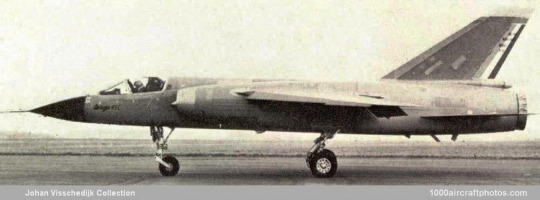
Parallel to the strike-oriented Mirage F2, Dassault had developed two parallel designs for a fighter. Both would be scaled-down single-seat designs, but the F3 was designed as an advanced interceptor while the F1 was a cheaper multirole. Dassault gave preference to the F1 (likely due to its better export prospects), funding a prototype as a private initiative. The F1 prototype would fly in December 196, breaking Mach 2 a month later. Though the Armee de l’Air was originally looking for something along the lines of the pure interceptor the F3 offered, they would instead choose to procure the more flexible F1. In February 1967 an order was placed for 100 F1s, and by the end of the year the F3 had been abandoned entirely. A definitive order for the production Mirage F1C was placed in 1969, with the aircraft reaching service by 1974.

The F1C would be a significant divergence from the Mirage deltas that shared its name. Though nominally configured for interception, the F1 was far better suited for bombing missions than the deltas. Three of the seven stores pylons were configured for multiple ejector racks for larger payloads of bombs, and the outer pylons were configured to handle both short-ranged IR and longer-ranged radar-guided missiles. Various guided missiles were integrated with the F1, handled either by onboard systems or a targeting pod mounted on the centerline hardpoint. The rocket booster on the Mirage III was gone, although the F1 retained a similar top speed. On paper, the F1 had a similar range to the Mirage III, but the F1 boasted superior short-field capabilities, allowing it to operate far closer to the front than the deltas ever could.

As with the Mirages before it, the F1 saw quite a bit of export. Although it was overshadowed later in its career by the Mirage 2000, it nevertheless gained the attention of customers across the world. In French service, the F1 would make its first combat deployments to Chad in the mid-80s. There, they flew escort for Jaguars during strikes against Libyan-backed insurgents and performed pre- and post-strike reconnaissance. Oddly enough, the F1 flew on both sides of this conflict - Libyan F1s would also fly over Chad, although they made sure to keep clear of the Armee de l’Air. In 1991, French F1s were deployed to Qatar to support Coalition forces in the Gulf War. Though they were grounded in the early parts of the campaign to avoid being mistaken for Iraqi F1s, they began flying strike missions in the last month of the war. Thanks to their more capable navigation systems, they were used to lead Jaguar formations to targets and perform tactical reconnaissance. By the end of the war, they had flown 114 sorties. In recent years, the F1 has remained an important component of the Armee de l’Air. The last deployments as strike aircraft came in the previous decade, with deployments to the Ivory Coast and Afghanistan, but reconnaissance variants have stuck around to see service over Libya and Mali. Ultimately, the F1 wouldn’t last forever. The F1 was finally replaced by the Rafale in 2014.
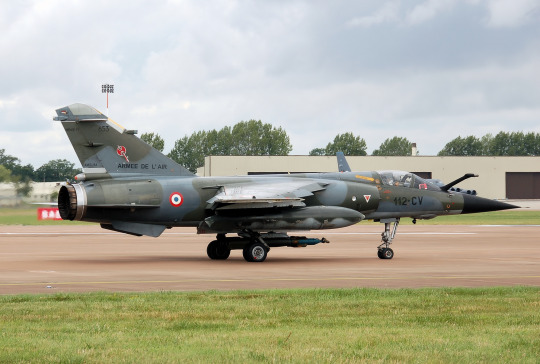
The F1’s career in foreign service would be by far the most intense of any Dassault aircraft. Libya and Iraq would fly the F1 extensively in their respective wars in Chad and Iran. Iraqi F1s in particular performed exceedingly well. In late 1981, they accounted for the first Iranian F-14 to be shot down, and they quickly rose to the position of Iraq’s most capable fighter. They claimed 35 enemy aircraft over the course of the war, while admitting to the loss of just seven of their own. In addition to the fighter duties, they also flew attack and interdiction missions. In particular, they made several Exocet strikes on enemy shipping. Though the strikes rarely sank anything, they did do their share of damage - as the accidental shooting of the USS Stark showed. In the Gulf War, F1s were flying on both sides of the conflict (with Iraq, France, and Kuwait). Unfortunately for the Iraqis, the F1’s time had come. Three F1s were downed by F-15s on the first day of the air war, while another was maneuvered into the ground as it chased down an EF-111. A total of eight F1s would be lost to Coalition fighters before the surviving F1s fled to Iran.

One can’t discuss the F1’s export service without looking at South Africa. South Africa had planned to produce 100 F1s domestically, but when arms embargoes set in, they were forced to make do with just 16 F1Czs and 32 F1AZs hastily delivered before the embargo took effect. Delivered in 1977, they made regular deployments to Namibia over the course of the Border War. They would claim the only two aerial victories of the conflict (two Angolan MiG-21s) and became the primary strike aircraft of the SAAF. Rocket pods and iron bombs gradually gave way to domestically developed pre-fragmented bombs, and domestically developed countermeasures were hastily developed and applied to the fighters to counter the improving Angolan air defenses. Thanks to the practice of toss-bombing and the incredibly flat terrain of the region, F1 losses during the war were remarkably low - just two were shot down by enemy SAMs and another damaged by a MiG-23. Unfortunately, the F1’s age was showing by 1989. Their unreliable AAMs were no match for the all-aspect missiles supplied to Angola, and the MiG-23MLs that were becoming all too common completely outclassed the F1 in every way. Once the Border War ended and sanctions finally lifted, the F1s were finally retired.
Dassault Mirage V
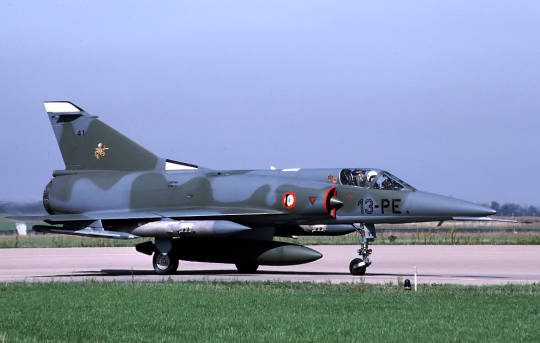
The next development of the Mirage airframe was a request of the Israelis. The Israelis had found the advanced attack avionics of the Mirage IIIE to be unnecessary in the Middle East, so they requested a simplified variant, replacing the all-weather avionics with larger fuel tanks. Dubbed the Mirage V, the aircraft would be significantly cheaper and easier to maintain than the Mirage IIIE with little loss of combat capability. Israel ordered 50 examples in 1966, and in May of the next year the Mirage V prototype had flown. The Mirage V looked almost identical to the Mirage III, but it was fitted with a new longer nose, two extra stores pylons, and the provision for the rocket booster in the tail was removed. Unfortunately for the Israelis, rising tensions caused France to place an embargo on Israel. The 50-aircraft order was completed and IAF pilots were sent to France to train, but the aircraft would not be delivered. Ultimately, Israel was refunded, and the Mirage Vs were taken into service by the Armee de l’Air.
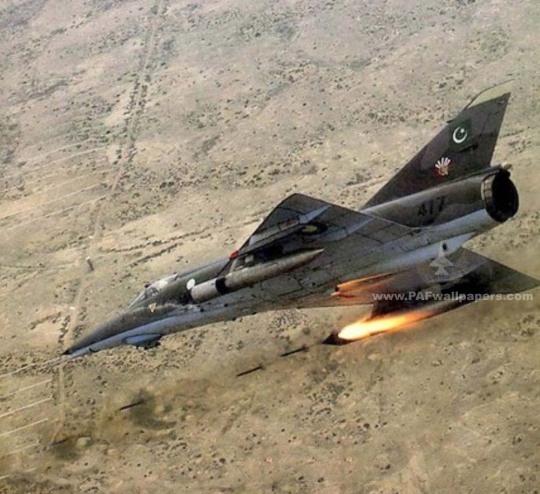
Although the Mirage V on paper seemed to be a downgrade from the Mirage III, it managed to attract a huge amount of export. Nearly 600 Mirage Vs would ultimately be built, and, although the Mirage V was intended as a cheap attacker, advances in electronics allowed the progressive upgrade of the aircraft over the years, expanding its abilities while retaining the extra range afforded by the smaller avionics bays. As with export Mirage IIIs, Mirage Vs were tailored to the customer - Belgian examples were fitted with US avionics, for example, while the Egyptians made use of the Alpha Jet’s avionics suite for their aircraft. The Mirage V would end up flying all over South America, Africa, and the Middle East. As with the Mirage III, Pakistan has been an enthusiastic operator, buying up examples from other operators as they’ve been retired and overhauling them to keep them competitive. Despite the extensive export, however, the Mirage V’s service history has been fairly quiet. The Mirage V-derived Nesher/Dagger has seen significant use, but the Mirage V itself as envisioned by Dassault has apparently never seen combat use.
Dassault Mirage G
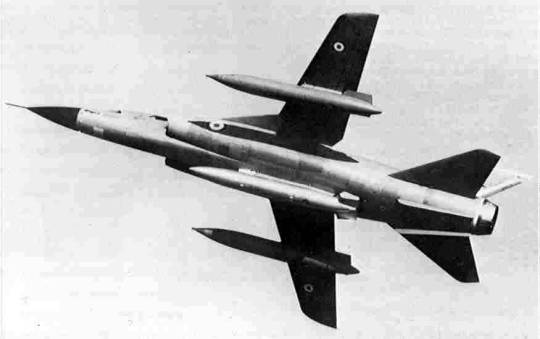
While the AFVG program was ongoing, the French defense ministry had requested Dassault develop a parallel swing-wing design capable of operating from carriers. Although such a design would directly compete with the AFVG, it received alarming support from the French government, who ordered a prototype in 1965. Dassault’s design, the Mirage G, was heavily derived from more conventional Mirage F2. The Mirage G retained most of the critical features of the Mirage F2, but replaced its wings with advanced variable-geometry wings fitted with full-span flaps. In March 1967, it was presented to BAC officials, and later that year it made an appearance at the Paris Air Show. By October 1967, it had flown for the first time. Tests of the single-engined Mirage G went well. In just 20 flights and 2 months of testing, the Mirage G had broken Mach 2 and demonstrated touch-down speeds as low as 108 knots.
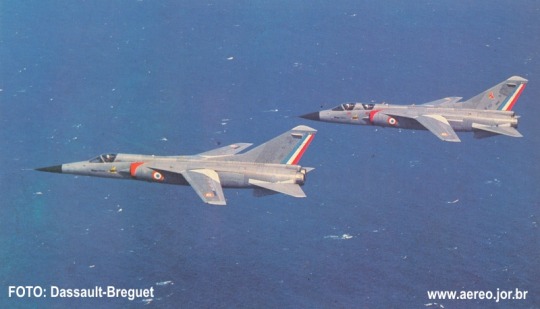
Although the single-engined Mirage G’s performance was satisfactory, France preferred a variant powered by two domestic SNECMA Atar 9 engines. Specifications were refined by 1968, calling for a two-seat nuclear strike fighter. Construction of prototypes for this new variant, dubbed the Mirage G4, began, but before they were completed, economic difficulties had put the project on hold. Hoping to salvage the work done on the program, requirements were changed once more to call for a single-seat interceptor, now designated the Mirage G8. The two incomplete Mirage G4 prototypes were converted to the smaller and cheaper G8 standard, although the first prototype retained the two-seat layout. These prototypes also were far more practical than the original Mirage G demonstrator - they were fitted with the navigational and attack radars to be used on production aircraft. The two-seat prototype took flight in May 1971, followed by the single-seater in July of the next year. Performance remained excellent - the second G8 even managed to set the continental speed record at Mach 2.34. Unfortunately, even this more practical design could not secure the aircraft’s future. No funding was allocated for the G8, and by the mid-70s, the Mirage G program had ended.
Dassault/Breguet/Dornier Alpha Jet

In the aftermath of the SEPECAT Jaguar program, France was left without an advanced trainer (a role the Jaguar was originally supposed to fill). Hoping to co-develop another aircraft, France first looked to Britain, who showed no interest, and then to Germany. Specifications were issued in 1968, resulting in several proposals from multinational teams. The winning proposal would have its origins in parallel design studies from Dornier and Breguet. Breguet’s proposal, the Br.126, had a forward fuselage markedly similar to the final product but used a low-mounted wing and engines exhausting at the extreme tail. Dornier’s proposal, on the other hand, made use of a shoulder-mounted wing and engines mounted more on the sides of the aircraft. When the companies came together, they combined their efforts into the TA501, which would be accepted in 1970 as the Alpha Jet. A contract for prototypes was placed in 1972, calling for Dassault/Breguet to build two prototypes while Dornier handled construction and testing of two more. The first French Alpha Jet flew in 1973, followed by the German prototype in January of the next year. Testing was extensive, and only in 1977 did deliveries of production aircraft begin.
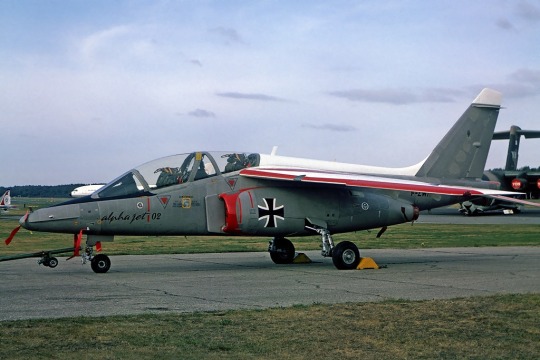
France would quickly take to their Alpha Jets, flying them exclusively as trainers to replace their aging T-33s and Mystere IVAs. Though their order was fewer than the agreement originally called for (176 rather than 200 aircraft), the French are hardly unenthusiastic users of the type. They fly the Alpha Jet with demonstration teams, and recent upgrades (particularly to the cockpit) have been done to keep the aircraft useful with the newest generation of aircraft. The Luftwaffe would opt for a different role for their Alpha Jets, flying them as light strike aircraft to replace the G.91. Although they see sporadic use as trainers, the Luftwaffe decided to continue outsourcing fighter training to the USAF, freeing up the Alpha Jet for more aggressive roles. As with the French, they procured fewer aircraft than originally agreed - 175 instead of 200.
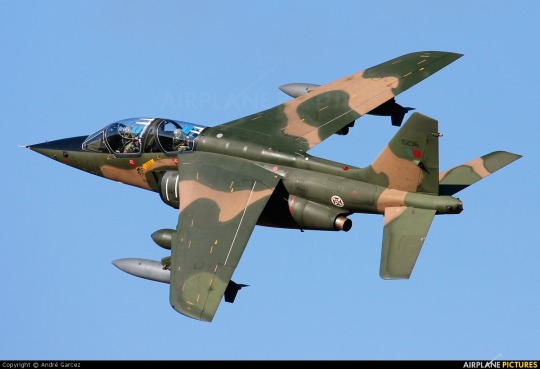
The Alpha Jet would soon rise to prominence on the export market, proving competitive with BAe Hawk being offered by the British. Belgium and Egypt would become the first foreign customers. France’s considerable pull across Africa and the Middle East would secure further orders from various former colonies in Africa as well as Qatar. With the end of the Cold War, Germany began to phase out their Alpha Jets, shifting some to advanced trainer duties while placing others up for sale. Portugal, Thailand and the UK would acquire these secondhand aircraft after being refurbished by Dornier. In the end, production would cease in 1991 with a total of 480 Alpha Jets made (80 more than originally planned). Although Germany has phased out its Alpha Jets entirely, they remain in active service with most other operators - even France.
Dassault Super Etendard

By the end of the ‘60s, France was looking for a replacement for the Etendard IVM. The Aeronavale had originally planned to replace it with the navalized Jaguar M, but numerous political and technical issues led to the design being dropped. France initially looked to America for a replacement, considering the A-7 and A-4, but Dassault would soon come out ahead with their own proposal. Aiming to win by keeping costs low, Dassault proposed the Super Etendard - an update of the Etendard that was advertised as having 90% parts commonality with the Etendard IVM. The Super Etendard was declared winner of the competition in January 1973. Dassault took three Etendard IVs to convert to the new standard, replacing the engine, modifying intakes and the exhaust nozzle, expanding the internal fuel capacity, and updating avionics. The wings were also revised to account for the new weight. Ultimately, the prototype that would fly in 1974 was almost an entirely new aircraft. With the advertised low costs never materializing, the French order was cut from 100 to just 71.

Oddly enough, the Super Etendard would make its combat debut not in French hands, but with the Argentines. Argentina had come to acquire four Super Etendards out of a planned order of 14 by the time they invaded the Falkland Islands. Although only five Exocet missiles - the primary focus of the Super Etendard’s avionics - were available to the Argentines, they put them to great use. Two missiles were fired at the destroyer Sheffield, severely damaging her and ultimately leading to her sinking as she was towed from the theater, and two more sank the merchant ship Atlantic Conveyor. The final missile was expended on a failed attack on HMS Invincible. Those three attacks would mark the end of the Super Etendard’s involvement in the war. With a pitifully small payload and underwhelming performance, the aircraft were effectively useless once their Exocets ran out.
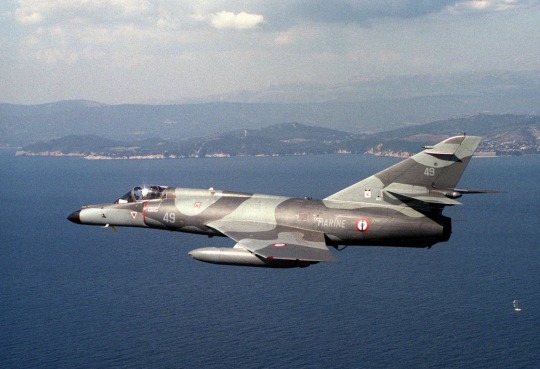
The Super Etendards of the French order would see their operational debut in Iraqi hands. In 1983, five Super Etendards were loaned to Iraq to launch Exocets at Iranian shipping until the latest F1Es were delivered. 34 attacks on shipping in the Gulf were conducted, and one aircraft was lost to Iranian fighters. The Aeronavale would be the last to throw the Super Etendard into combat. In September 1983, Super Etendards off of Foch flew strikes against targets in Lebanon. Through the second half of the ‘80s, the fleet was updated to handle the newest generation of guided munitions. These upgrades continued into the 90’s, meaning that the fleet would not see use in the 1991 Gulf War. They would make a showing over Serbia in 1999, however, flying 400 missions and destroying 75% of targets. They continued flying into the new millennium, supporting the American invasion of Afghanistan and sporadically returning to support peacekeeping efforts both as strike aircraft and as target designators for Rafales. Currently, the Aeronavale is progressively replacing the Super Etendard with the Rafale M. The last Super Etendards are slated to leave service in 2016.
Dassault Super Mirage G8A
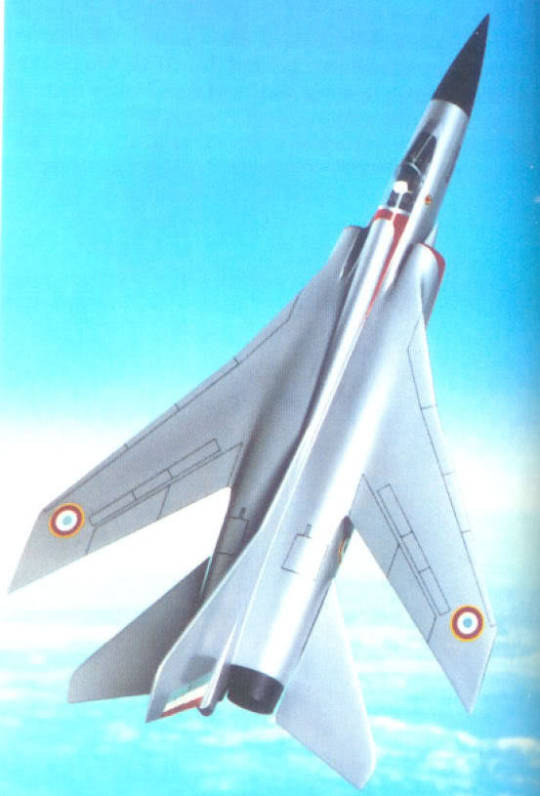
In 1973, the Armee de l’Air issued requirements for a replacement for the Mirage III. The new aircraft was to fill the gap left by the end of the AFVG/G8 (meaning it would take on all-weather low-level strike) as well as act as a high-performance interceptor. Dassault opted to modify the stillborn G8, replacing the complicated swing-wings with 55-degree swept wings. Such changes would reduce costs and empty weights, while opening space on the wings for more stores pylons. To power the Super Mirage, the new M-53 turbojet replaced to G8’s Atars, giving the new design a significantly better thrust to weight ratio. Unfortunately, the requirements for Mach 2.5+ performance and advanced radars brought costs up and led to program delays. Dassault had originally been contracted to fly a prototype by 1974, but as 1975 came and went the G8A lingered in construction. As delays hit the program and costs rose, France gradually lost interest in the program. Ultimately, in mid December 1975, the G8A was cancelled.
Dassault Mirage 2000
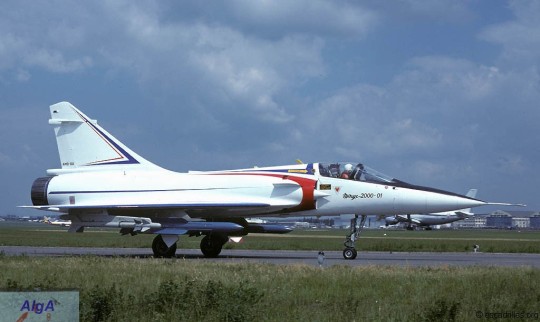
In 1972, Dassault began looking into a series of smaller design studies for an improved Mirage III. Smaller than the Super Mirage G8A, it was developed on low priority while the Mirage G8A took center stage, only to be submitted as an alternative solution when the ACF was cancelled. The Mirage 2000, as it was known, would take advantage of the SNECMA M53 turbofan developed for the ACF. Angered by the selection of the F-16 over the Mirage F1 for the standardized NATO fighter competition in 1975, Dassault also aimed to develop an export-oriented aircraft. Work fell behind the schedule Dassault had hoped for, but regardless the Mirage 2000 would develop quickly - the first prototype flew in 1978, and by 1984 the Mirage 2000 had entered service.
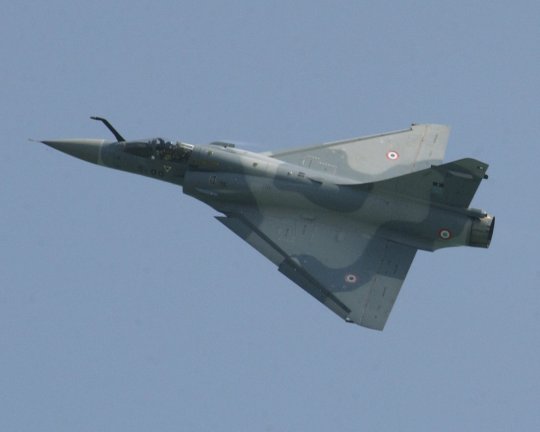
Compared to previous Mirage designs, the Mirage 2000 was considerably more advanced. While the tailless delta planform seemed to be a technological regression, considerable effort was put into making the simple design competitive. The center of lift was shifted forward of the center of gravity, leading to a relaxed-stability design that would improve maneuverability and takeoff performance. Fly-by-wire controls would be developed to account for the instability. Payload was to be up to 6.3 tons on nine pylons, supplemented by two DEFA 30mm cannon.

Apart from the standard fighter-bomber variants, Dassault would also develop the two-seat Mirage 2000N nuclear strike platform to replace the aging Mirage IVs that served as the backbone of France’s nuclear deterrent. Derived from the two-seat Mirage 2000B, the 2000N featured a strengthened airframe for low-level flight and revised avionics for terrain-following precision strikes. As the ASMP nuclear missile was to take up the center pylon, new wing tanks were developed for the Mirage 2000 to extend range. Additionally, the ECM suite of the Mirage 2000N was improved over standard versions.
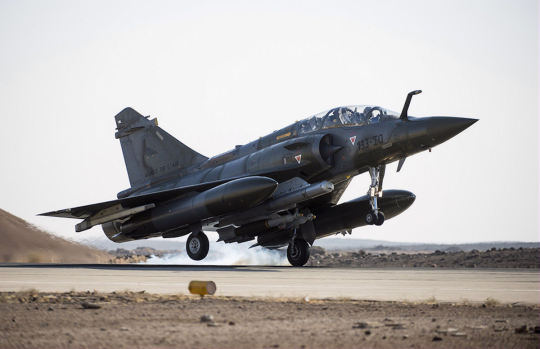
The Armee de l’Air’s Mirage 2000s would make their operational debut in the 1991 Gulf War, but unfortunately they did not see much combat use. Their real combat debut would come in the Balkans, where Mirage 2000s were committed to support NATO peacekeeping operations. During Operation Deliberate Force, a Mirage 2000D would be downed by a Serbian Igla, prompting a scramble for a revised countermeasure suite. In 2001, Mirage 2000Ds made a brief deployment over Afghanistan, supporting coalition forces with guided munition strikes. While the arrival of the Rafale in 2006 spelled the beginning of the end for the Mirage 2000, its replacement has been slow, allowing the Mirage 2000 to participate in operations in Libya in 2011.
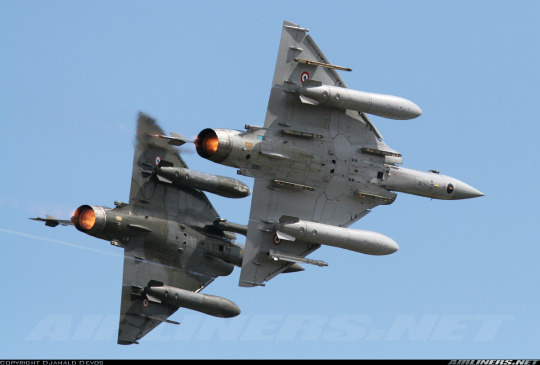
The Mirage 2000 would be fairly successful on the export market as Dassault had hoped. Egypt would be the first customer, ordering 16 examples in 1981, followed by India, who placed a large order for Mirage 2000s to fill conventional and nuclear strike roles. In the 1999 Kargil War, IAF Mirage 2000s performed spectacularly well. After a series of modifications to drop unguided bombs, they were used to great effect in the war, dropping 55 tons of ordnance across 240 strike missions. India continues to upgrade their Mirage 2000s, adding new radars, helmet-mounted displays, and reportedly the ability to mount some of the Soviet-designed stores in their inventory.
Dassault Mirage 4000
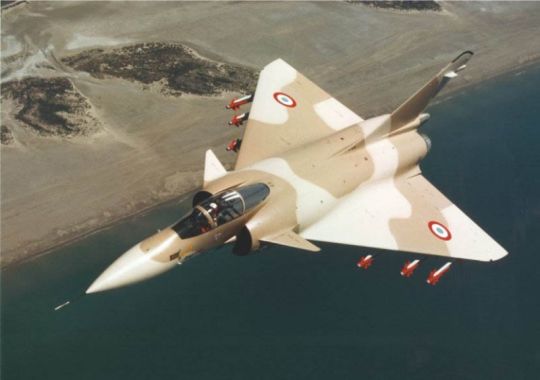
In 1975, Dassault announced a follow-on to the Mirage 2000, aptly named the Mirage 4000. Intended to compete with the F-15 on the export market, the Mirage 4000 was a private venture design scaled up from the Mirage 2000. The basic design of the 2000 was scaled up and a second M53 engine was added. Composites were used extensively in the construction, and canards were added just aft of the intakes. Payload was increased by almost 2 tons over the Mirage 2000, and larger internal fuel tanks gave the aircraft a longer range. The Mirage 4000 prototype would take flight in 1979, making its way to various public demonstrations and airshows over the years to attract customers. Unfortunately, everything seemed to be working against the Mirage 4000. The Saudis opted for the F-15, and, although Iraq wanted to buy the fighter, they lacked the funds to do so. Even the Armee de l’Air showed little interest in the type, content instead to purchase the cheaper Mirage 2000. The Saudis began talking about buying it again in 1985, bringing new life to the program, but talks continued to drag on and eventually it was dropped once more. By now, the Mirage 4000 was no longer an attractive export option. Dassault continued to fly it for several years as a testbed for technologies on the Rafale, finally retiring it in early 1988.
Dassault ACX
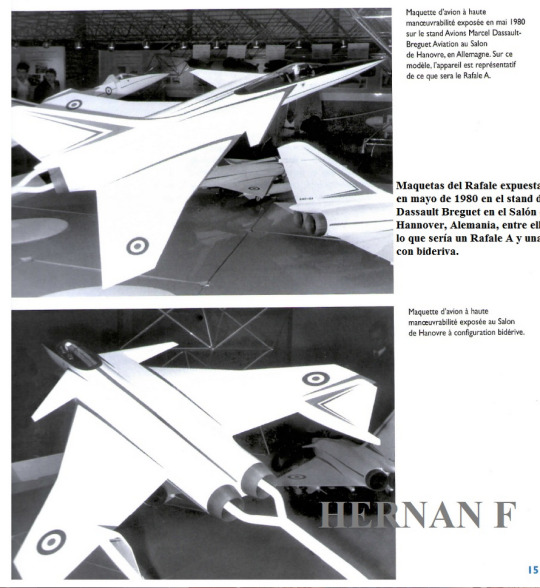
In 1979, Britain and Germany decided their requirements for a next-generation fighter were similar enough for a collaborative project to begin. MBB and BAe came together to form the European Collaborative Fighter program, and in the Fall of that year they were joined by France’s Dassault. Dassault’s design study, the ACX, went through several different configurations. Like the other member nations, Dassault quickly determined that a twin-engined cranked-delta canard layout was ideal, but they would study several different configurations for vertical stabilizers. Apart from the standard single and double stabilizer layouts seen on the German and British designs, Dassault also looked into a unique wing-mounted stabilizer design. In these proposals, a boom would extend backwards from the middle of either wing, holding a vertical stabilizer behind the rest of the aircraft. Ultimately, however, this was dropped in favor of a conventional single vertical tail. Dassault continued to refine the design, and by the time they had withdrawn from the ECA, their ACX design study morphed into what would become the Rafale.
Dassault Rafale
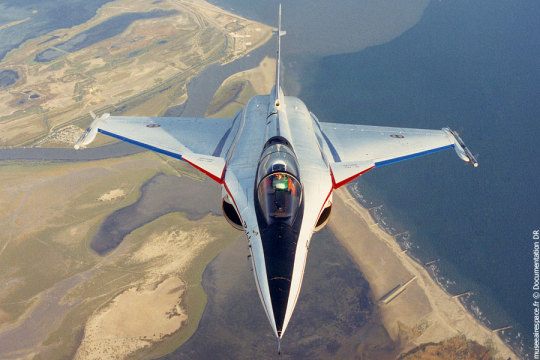
As the 70’s came to an end, the Armee de l’Air and Aeronavale found themselves in need of a replacement for their respective aircraft. As requirements for the services were found to be very similar, they were combined to form the Avion de Combat Experimental (ACX), calling for a 9 ton aircraft with an armament of 6 AAMs, payload of up to 3,500kg, and combat radius of 650km. Development began in 1980, and France, looking to cut costs, attempted to add their requirements into the pan-European ECF program. However, other partners were unwilling to compromise the project with French carrier requirements, and the demand that Dassault lead the multinational project seemed designed to sabotage it from the start. Thus, France left the program in 1981, taking their work with them.
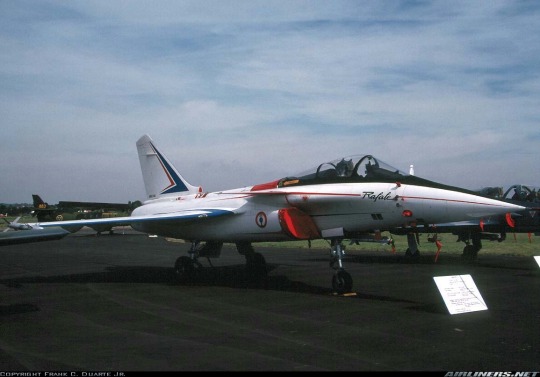
Fortunately for the French, Dassault had performed the bulk of the aeronautical design for the proposed fighter. Seemingly anticipating the withdrawal, Dassault had continued work on the Rafale on the side, allowing the first prototype to roll out soon after the withdrawal from the FECA. The Rafale prototype would take to the skies in 1986, proving itself to be a capable design even with the lower-power engines propelling the prototype. Testing continued throughout the decade, with carrier trials starting in 1991. Due to the lack of suitable facilities domestically, the Rafale would perform catapult trials at USN facilities in Lakehurst, NJ.

As the new millennium loomed, three main variants of the Rafale were developed. The single seat Rafale C was to be the primary fighter, supplemented by the two-seat Rafale D strike fighter. For naval operations, the Rafale M - featuring 95% commonality with the Rafale C - was created, but the planned two-seat Rafale N for fleet-defense would be cancelled on grounds of cost. The Rafale would be powered by two SNECMA M88 turbofans, and feature advanced composites and fly-by-wire controls in its construction. While the original requirements called for a multirole fighter, the initial production Rafales would be primarily air-defense oriented, lacking integration with air-to-ground munitions.

The first Rafales would be delivered to Aeronavale at the end of 2000, with the aircraft becoming operational by 2004. They would make their combat debut in 2002 before reaching full operational status, flying off of Charles de Gaulle in support of the US-led invasion of Afghanistan. The Armee de l’Air would start to receive their Rafales several years after Aeronavale, with the first aircraft arriving in 2006. In 2007, a crash program was started to integrate the Rafale fleet with guided air-to-ground munitions, allowing them to deploy the GBU-12 guided bomb in operations in Afghanistan. By the time the 2011 intervention in Libya rolled around, the Rafale had matured as a multirole platform. Thanks to an advanced countermeasure suite, the Rafale would fly strike missions over Libya unsupported by SEAD elements.

For all of Dassault’s hopes of creating a successful export product, the Rafale has had a difficult time attracting customers. With a pricetag of around $200 million apiece and limited integration with non-French stores, the Rafale’s saving grace would be its immediate availability and the lack of air-to-ground capabilities on the Eurofighter. France would make several failed bids across the last decade, losing to the Gripen and Strike Eagle, while efforts to sell a large number to India have been complicated by the insistence that Dassault be held responsible for HAL’s production standards. While a small order for 36 airframes has been approved, the larger contract for 126 remains in negotiations. However, this recent order seems to have been enough to kickstart export orders. Egypt is looking into procuring the Rafale, as are several other Middle Eastern countries.

Nowadays, the Rafale occupies an interesting niche. While extensive upgrades arguably make it the most capable air-to-ground platform in Europe, it lags behind the Eurofighter in terms of fighter performance - both kinematically and technically. It is the sole CATOBAR fighter outside the US to be competitive with contemporary fighters, and overall has spectacular performance. Following the example set by the American Advanced Tactical Fighter, the Rafale has a high degree of sensor fusion to improve combat performance, although the RBE2 AESA radar it mounts has an unusually low number of T/R modules.
17 notes
·
View notes
Text
/k/ Planes Episode 87: Die Kaplyn

It’s time for another episode of /k/ Planes! This time, we’re looking at the South African Border War.
For over two decades, South Africa fought a war in Southwest Africa (Namibia) and Angola, Starting out as just another bush war against anti-colonial terrorist groups, the Border War would expand over the years, ultimately culminating in conventional warfare. During this time, South Africa found itself on the wrong side of history. Its allies fell apart over the years, leaving them alone and surrounded by hostile nations, all while international sanctions took their toll. Their primary enemy - Communist forces in Angola - had their own interesting distinctions, maintaining perhaps the best military in post-colonial Sub-Saharan Africa thanks to extensive foreign support. Ultimately, events at home and abroad would conspire to turn a minor bush war in a corner of Africa into the most intense aerial operations the continent had ever seen.
Belligerents: South African Air Force

By the early 1960s, South Africa’s air force was in terrible shape. The quality and number of aircraft had declined since the SAAF’s involvement in Korea, and the onset of arms embargoes due to the illegal occupation of SWA meant that the SAAF was hard pressed to update their forces. Efforts to procure new aircraft were often hamstrung by new rounds of sanctions, meaning that the SAAF would be forced to procure small numbers of several types of aircraft to fulfill their needs. Once the embargoes completely cut off access to parts for their aircraft, the SAAF looked inwards, making use of their domestic arms industry to not just keep their aircraft flying, but upgrade them as well. Weapons, avionics, and countermeasures packages were all developed for the SAAF to employ over the course of the 23-year long conflict.
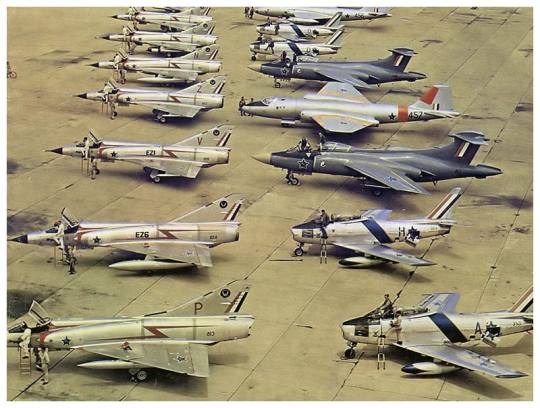
Even so, the SAAF was hardly in a good position. South Africa was completely unable to replace losses, meaning that every aircraft was invaluable. Over the years, the SAAF adapted tactics to counter the increasing foreign support for the MPLA. Low-altitude flight profiles became the norm, and pre-fragmented bombs with toss-bombing profiles would replace the more aggressive rocket-pod attacks by the end of the war. Long-range oblique photography would replace the riskier medium-level overflights, and short-ranged guided missiles would give way to longer-ranged glide bombs. By the end of the war, the danger to crews would only grow as Angolan air defenses solidified and the newest Soviet-supplied MiG-23s outclassed the SAAF’s Mirage F1s. Ultimately, the SAAF’s luck would catch up with them. The last major battle of the conflict - Cuito Cuanavale - would for the first time see the Angolans holding air superiority.
Belligerents: UNITA

The National Union for the Total Independence of Angola was one of the three primary rebel groups in Angola during the border war. Though South Africa started the conflict fighting against them in support of the Portuguese, they would come to be South Africa’s closest ally in the region by the time the war had ended. Being an anti-government guerrilla group, UNITA lacked an air force, but they would down more Angolan aircraft than the SAAF ever did thanks to the massive amounts of supplies coming from the US and captured from the enemy. Being opposed to the communist-supported MPLA, they would work with South Africa to secure the portions of the Angola-SWA border from SWAPO terrorists, and their forces would often make up the bulk of South African task forces. Unfortunately, UNITA’s losses are usually omitted from battle statistics. While SADF casualties were always low, UNITA footsoldiers usually suffered just as much as their foes. By the end of the war, they were increasingly dependent on South Africa - particularly the SAAF - to halt attempts to crush them.
Belligerents: South West Africa People’s Organization

In response to the illegal occupation of South West Africa and the onset of South Africa’s oppressive apartheid policies in the territory, SWAPO formed in hopes of bringing their country freedom. When peaceful means failed, the left-leaning organization resorted to terrorism, basing themselves out of SWA’s unstable neighbors. SWAPO would see active support from South Africa’s neighbors, and, although South Africa regularly performed cross-border raids to weed out SWAPO, they never succeeded in ending foreign support for SWAPO. As with UNITA, SWAPO resorted to asymmetrical warfare and terrorism, meaning that their anti-air capabilities were more often than not limited to RPGs, Strelas, and Iglas. They did down their share of SAAF helicopters and light aircraft, but they were not doing well by the end of the war. SWAPO only barely survived to the end of the Border War, which would end not due to the organization’s power or any recent attacks, but rather international pressure against South Africa.
Belligerents: MPLA

The communist-aligned People’s Movement for the Liberation of Angola started out as one of the three primary resistance groups in Portuguese Angola and rose to take control of the country by the time independence was gained. Their support for SWAPO meant they were increasingly clashing with South Africa, and their communist alignment meant they received quite a lot of foreign aid from Soviet-aligned nations. Soviet-supplied aircraft would allow the MPLA to create an air force in 1976, and advisors from Cuba, Russia, East Germany, and Romania would help them get their air forces off the ground. Similarly, the foreign support led to the creation of an air defense network that by the 80’s covered almost the entire border with SWA. They did have their shortcomings - training was lacking, limiting night operations and making navigation difficult and accident rates high - but by the end of the war the MPLA possessed the largest and most advanced air force in Sub-Saharan Africa. The newest MiGs and missiles outpaced even the SAAF, and it showed. At the end of the conflict, the MPLA was for the first time able to secure air superiority over their own territory.
Belligerents: Cuba

The Cubans had been involved in Angola since the 1950s, providing support for MPLA rebels in their struggle against Portugal. Involvement was fairly minor up until Operation Savannah, at which point the Cubans began to commit ground and air forces to defend the MPLA. Although the MPLA had created an air force as early as 1976, for much of the war the skies were defended by Cuban pilots and aircraft, as they were better trained and maintained than the Angolan fighters. Although the MPLA’s presence in the air improved over the course of the war, Cuban MiGs would be a persistent presence over the battlefield, particularly at Cuito Cuanavale. Over 50,000 Cubans were in Angola by the end of the war, and they were often fighting alongside the MPLA against UNITA and the SADF. Where other communist powers were in Angola purely in support roles, the Cubans were actively fighting on the front.
The Aircraft: North American Harvard

Known as the T-6 Texan in American service, the Harvard Trainer would be among the first fixed-wing aircraft to participate in the Border War. Although not originally intended for combat operations, the poor state of the SAAF in the early days of the war and the good rough-field performance of the trainer meant that it would have to make do. Their normal armament of two .30 caliber machineguns was supplemented by underwing hardpoints for rocket - either 3 inch rockets or 37mm pods. The Harvard would be most active in the opening years of the war, flying in support of Portuguese counterinsurgency operations until the SAAF got more capable aircraft available for deployment to the theater. By the time of the Carnation Revolution in 1974, the Harvard had stopped flying in combat roles.
The Aircraft: English Electric Canberra B(I)
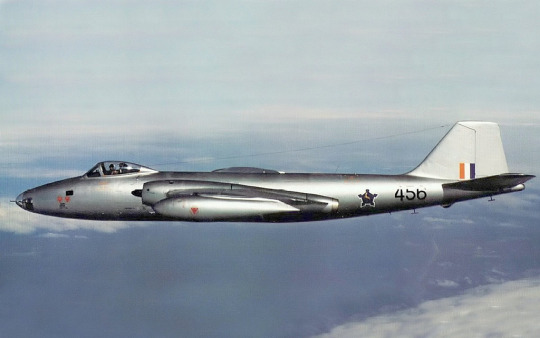
By the time the Border War broke out, the SAAF had 9 Canberras flying with 12 Squadron, and Rhodesia had a further 20 in their inventory. Though already verging on obsolescence, the total air supremacy the SAAF enjoyed during the first part of the war ensured that the Canberra could serve actively until the last years of the conflict. They made their first deployments towards the end of Portuguese involvement in Angola for strategic reconnaissance and mapping the border region, but over time they began to expand to bombing missions as well. On occasion, they flew strikes alongside their Rhodesian counterparts to strike rebel camps in the nations surrounding their respective countries. However, as the war drew on and the Angolan air defense network expanded, missions over the border eventually became prohibitively dangerous. Bombing sorties were curtailed to only the most lightly defended targets, and even the odd reconnaissance flight became increasingly scarce in the last months of the war.
The Aircraft: Blackburn Buccaneer

South Africa had acquired its fleet of 16 Buccaneers in 1965, equipping them with 24 Squadron. Although the SAAF had hoped to procure more examples, the onset of sanctions cut the orders short at just 16 airframes. Fortunately for the SAAF, the 16 planes of 24 Squadron would be the most capable strike platform of the war. They had the range and performance to strike heavily defended targets deep inside Angola, and its crew of two allowed it to deploy guided munitions like glide bombs and TV-guided missiles. Spectacular low altitude performance meant that the Buccaneer fleet was often committed for precision strikes on some of the most strategically important targets of the conflict. Even though 24 Squadron flew against some of the most heavily defended targets of the war, they performed excellently - by the time the fleet was retired in 1991, their only loss had been in an accident - incidentally on their very first deployment of the conflict.
The Aircraft: Dassault Mirage III

The Mirage IIIs of Cheetah Squadron would see surprisingly sporadic use during the Border War. Having converted from Sabres back in 1963, Cheetah Squadron’s Mirage IIIs had proven to be poorly suited to the conditions along the border. High landing speeds limited the airfields the aircraft could operate from, and, coupled with its short combat radius, it was unable to hit targets deep in Angola. Although the fighter-equipped CZ, DZ, and EZs were largely replaced along the Cutline once the Mirage F1 came along, the reconnaissance-equipped RZ and R2Zs would remain in the theater for much of the war. Because the photo-recon Mirage IIIs were the only aircraft other than the Canberras equipped for reconnaissance, their deployments to the Cutline would be increasingly common as the war continued.
The Aircraft: Dassault Mirage F1 AZ/CZ
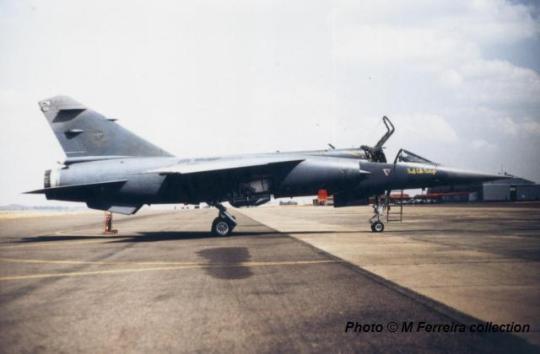
In 1971, the SAAF had made plans to purchase 100 Mirage F1 fighters to replace the Mirage III. However, the onset of new sanctions meant that the order was threatened, and, although the rushed procurement allowed for some aircraft to be delivered, final numbers amounted to just 16 F1CZ and 32 F1AZ. With deliveries beginning in 1975, the Mirage F1s wouldn’t make their first deployment to the border region until 1978. During the last decade of the war, they would prove invaluable. They finally provided the SAAF with a fighter capable of striking deep into Angola, and, although it would eventually be eclipsed by the arrival of the Angolan MiG-23s, the Mirage F1 would claim the only aerial victories of the war. Although the fighter role was more glorious, where the Mirage F1s really came to shine was as an attacker. Deploying unguided bombs almost exclusively, crews perfected the tactic of toss-bombing, allowing them to safely provide close air support even in the presence of enemy SAMs. Four Mirage F1s would be hit by SAMs over the course of the conflict, but only one would actually be downed by enemy fighters over the course of the 23-year conflict.
The Aircraft: Aermacchi Impala

The unsung hero of the Border War was undoubtedly the Aermacchi Impala. The SAAF had come to acquire a fairly large contingent of two-seater Impala Mk.1s and single-seat Mk.2s by the time the Border War had broke out. Though far from competitive with modern strike fighters, it was easy to fly and maintain, meaning that it would be the only fixed-wing aircraft permanently deployed to the border over the entire course of the war. Armed with rockets, bombs, and internal cannons, Impalas regularly flew armed reconnaissance sorties with great effect. Whereas the faster aircraft were generally only employed for larger operations, the Impala ensured the SAAF could maintain a constant presence over the Cutline. When treaties and SAMs began to restrict the Impala’s cross-border sorties, they took on more benign roles, such as Telestar (airborne communication relaying). Although the Impala was eclipsed later in the war, it stuck around until the conflict’s conclusion, flying some of the last combat sorties of the war.
The Aircraft: Mikoyan Gurevich MiG-21MF “Fishbed”
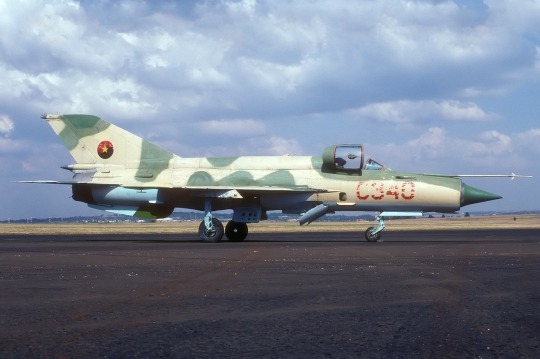
The nimble MiG-21 would be among the first fighters to see combat use over Angola. Arriving with the Cubans in 1976, they provided a much-needed supplement to the MPLA’s nascent air force. By 1981, MiG-21s began to reach MPLA units, serving with them for the entire war. Although the MiG-21 was an ever present threat, it was rarely seen. Its short range and the emphasis on ground-controlled intercept meant that they were often scrambled late, rushing in on SAAF bombers more to scare them off early rather than down them. Given the more passive use of the MiGs, their performance was fairly underwhelming even operating over friendly territory. The only engagements the MiG-21s took part in always ended in SAAF victories, and they failed to down any SAAF aircraft during the war. Looking at the fairly extensive losses among the MPLA/Cuban MiG-21 forces to SAMs, it seems that they were also used in strike missions as well. However, poor training, small payloads, and short ranges limited the Fishbed’s effectiveness in the role.
The Aircraft: Mikoyan Gurevich MiG-23ML “Flogger”
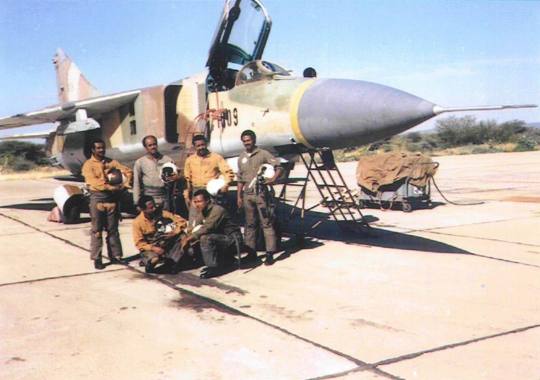
With the arrival of the MiG-23ML in 1984, Angola finally had a fighter at its disposal that outclassed anything the South Africans could field. The MiG-23ML boasted an excellent thrust-to-weight ratio and long-range radar-guided missiles, giving it an edge over the Mirage F1s that formed the backbone of the SAAF fighter corps. For perhaps the only time in the aircraft’s history, the MiG-23 was actually the most capable fighter in the conflict. Although normally configured for air-to-air duties, the Angolan Floggers would more commonly see use as strike aircraft. To the South Africans, they often made their presence known just as the MiG-21s had - as fast-moving blips on early warning radars. As with the MiG-21, engagements between the MiG-23 and SAAF F1s were few and far between. However, the Flogger was markedly superior to the older MiGs. Its incredible acceleration allowed it to stay well clear of SAAF missile engagement envelopes, while its superior avionics and long-range missiles allowed the Floggers to score a hit on a South African Mirage without any losses of their own in air combat. For all their prowess in the air, however, they suffered heavy losses. Early operations were marred by training accidents (a product of the Flogger’s horrific pilot workload), and losses to ground fire (particularly UNITA SAMs) more than made up for their excellent performance in air-to-air combat.
Background
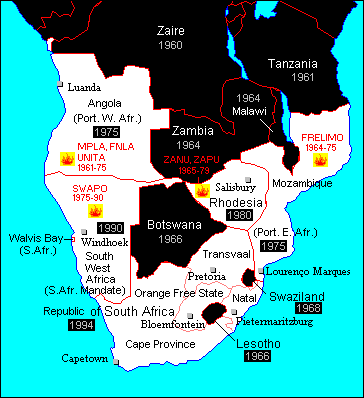
In the years following the Second World War, the world slowly moved towards decolonization. Most European countries came to relinquish their colonies (willingly or otherwise), and those holding back were being met with increasing pressure from the international community. South Africa, Portugal, and Rhodesia would be the main targets of such pressure in Africa. South Africa had occupied German South West Africa (SWA) since WW1 by mandate of the League of Nations, but this had been reversed by the UN, who declared that the nation should be independent. South Africa resisted such pressure and treated the nation as a fifth province, ultimately giving rise to a resistance movement - SWAPO. In the neighboring Portuguese colonies and Rhodesia, the situation was similar. Portugal had been fighting three separate guerilla groups in Angola since the 50’s (MPLA, FNLA, and UNITA), culminating in a full-scale civil war starting in 1961, and Rhodesia, unwilling to end the white minority rule, declared independence from Britain in 1965, sparking yet another bush war.
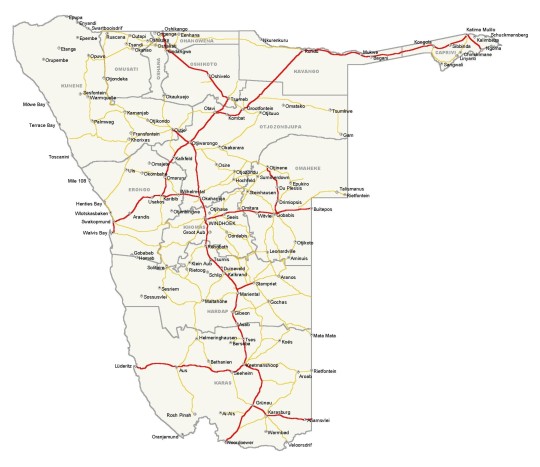
Although air operations would span most of Southern Africa in the coming 23 years, the bulk of the fighting would take place in a region of SWA known as Ovamboland. Ovamboland was the region of the SWA-Angola border just south of the Cutline - a crude four-foot fence devoid of vegetation on either side spanning 420 km from Ruacana Falls to the Cubango River. Being close to the equator, the climate was quite extreme. Ovamboland and the area to the north was almost perfectly flat and featureless, devoid of even rocks. Once the massive flooding from the yearly April rains dried up, the area was akin to a massive sandy beach without an ocean. Elsewhere, it was little better - low brush provided visual cover for men on the ground, but such vegetation could hardly be called a forest.
1965 - 1974: Police Actions
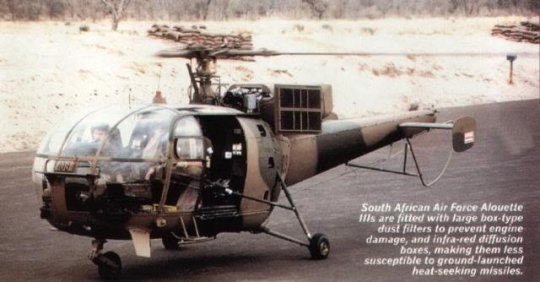
In July 1965, a group of terrorists crossed into SWA near Rundu to establish a base of operations for their coming attacks. Over the course of the second half of the year, the six men had orchestrated two attacks, killing at least five people. As attacks continued into the next year, the South African Police moved two SAAF Alouette IIIs up to Windhoek to help track down the terrorists. Over the coming months, a total of seven helicopters were moved to the region, all while the SAP tracked down the location of the terrorist camp. By now, the camp had moved closer to Ruacana. In late August 1966, the seven helicopters relocated to Ruacana airfield in preparation for the first helicopter assault in SAAF history - Operation Blouwildebees. The nighttime assault would be a resounding success. Two terrorists were killed and another eight captured, although an unknown number escaped into the wilderness. Though the helicopters were returned back to South Africa after the operation, it did not mark a de-escalation. When the next attack came in December 1966, the SADF was now offering assistance in the form of logistics and aircraft (both fixed and rotary wing).

At the end of July 1967, the SAAF made the choice to bring in fixed-wing air support to deal with an expanding counterinsurgency. Eight Harvard trainers, equipped for combat, were to be stripped of any identifying markings and transferred to Rundu airbase near the Cutline. Each was given 400 rounds for their machineguns, two were configured for carrying 3-inch rockets, and the remaining aircraft were fitted with SNEB 37mm rocket pods. Flying out of South Africa, they had to make several stops along the way to refuel, but they would make it to the border without incident. Upon arrival, the crews learned of their mission - they were to support a helicopter assault (by SAP, of course) on a village 80 miles north of the Cutline in Angola where terrorist leaders were to be meeting. Unfortunately, the raid went poorly. The slow-moving formation dropped their men at the wrong village at first, and by the time they found their target the enemy had been alerted and abandoned their positions.
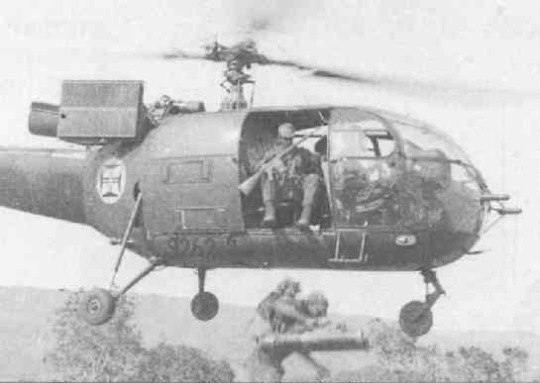
Though this raid was a failure, it seems the police actions were succeeding - major incidents seemed to be declining, and the SAP were getting better at hunting down terrorists infiltrating from Botswana and Angola. However, for the Portuguese, things were getting worse. At the request of Portugal, the SAAF agreed to covertly provide assistance. Flying alongside the Portuguese Air Force, the SAAF committed helicopters and light aircraft as part of Operation Mexer in the Cuito Cuanavale region - well north of the Cutline. Through 1971 and ‘72, the SAAF secretly fought alongside Portugal in an effort to eradicate the UNITA and FNLA insurgents.

As the South African presence in Angola escalated in 1972, the joint South African and Portuguese forces found a lack of adequate maps, so the SAAF was enlisted to address the issue. The Canberras of 12 Squadrons were called into action, beginning an intensive photo-recon program that would span two years. Flying out of Portuguese bases in Angola, they mapped the whole country, and, with the cooperation of the Rhodesians, they covered all of Mozambique as well. Unfortunately, things only seemed to worsen for Portugal. Even the aid of the South Africans was not enough to stem the tide, and, as the years went on, things only got worse. The MPLA, FNLA, and UNITA were rising in strength due to foreign (primarily Soviet) support, and although MPLA support had been cut off in 1974 after a split with the Soviets, the Carnation Revolution took place in Portugal in late April, putting an end to the colonial wars overnight.
Operation Savannah
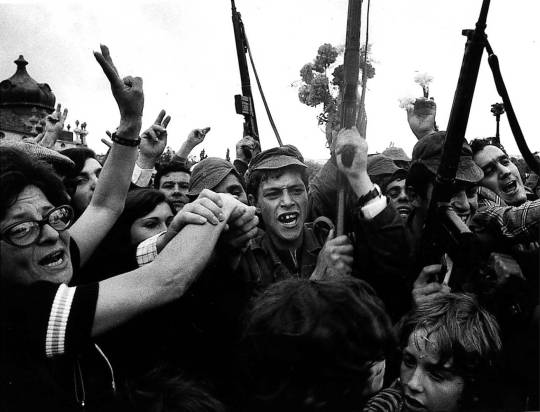
Although Portugal had relinquished control of her colonies almost overnight, Angola would not have a peaceful transition to majority rule. Rather, a three-way war broke out between the MPLA, FNLA, and UNITA. Soon enough, the CIA got involved, hoping to raise enough support to defeat the communist-aligned MPLA. Recognizing that neither of these groups had any chance of overcoming the MPLA without foreign support, the US convinced South Africa to get involved. Less than a year after the Portuguese had left Angola, South Africa rushed into the country, ironically fighting alongside the very UNITA rebels they had been trying to kill. All the while, joint operations were beginning with Rhodesia, who now found that they had to contend with terrorists free to operate out of a now-free Mozambique.

The intervention that would be known as Operation Savannah started out small. At first, South Africa merely provided arms and advisors (much like America was doing). Though 24 Squadron had deployed four Buccaneers to Grootfontein in May 1975, they remained but a passive show of force. In August, a small SADF contingent advanced 50km into Angola to capture the hydroelectric complex that controlled the power and water supply for much of Ovamboland. Major raids against SWAPO bases soon followed, and agreements were made with UNITA and the FNLA to fight against the MPLA and SWAPO. All the while, however, the anti-MPLA forces were losing ground. Advisors seemed to be helping little, and passive support from light aircraft only accomplished the loss of a Puma and Cessna-185 to ground fire.
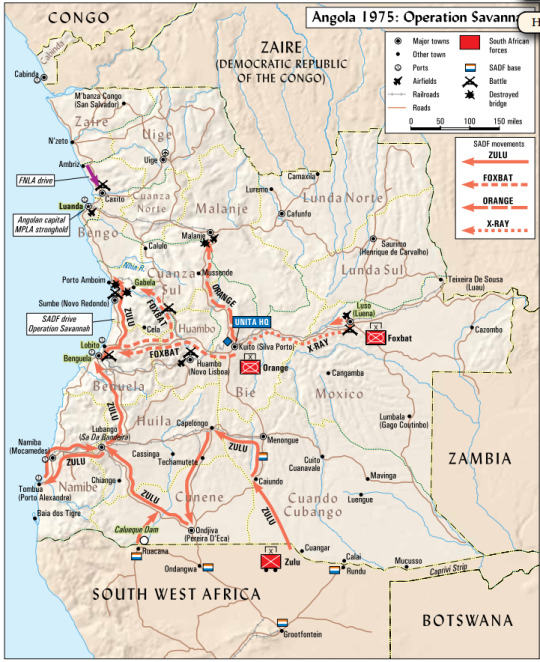
Everything changed on October 14, when Operation Savannah officially (albeit secretly) began. A motorized column codenamed Zulu crossed the Cutline at its eastern end, taking advantage of the chaos between the factions to rapidly advance across the country. Zulu sped across southern Angola almost unopposed. Rocadas fell on the 20th, followed by Lubango on the 24th, and before the month was out Zulu had reached the coast. To support Zulu, the SADF had formed three more task forces comprised of UNITA footsoldiers and SADF heavy weapons (Foxbat, Orange and X-Ray). Forming the the east and central parts of the country, they drove west to the ocean as Zulu raced up the coast. Orange made its way north from the UNITA HQ at Kuito, while Foxbat met up with Zulu at Lobito before breaking off to drive north parallel to Zulu and Orange. By early November, the SADF was racing towards Luanda almost unopposed.
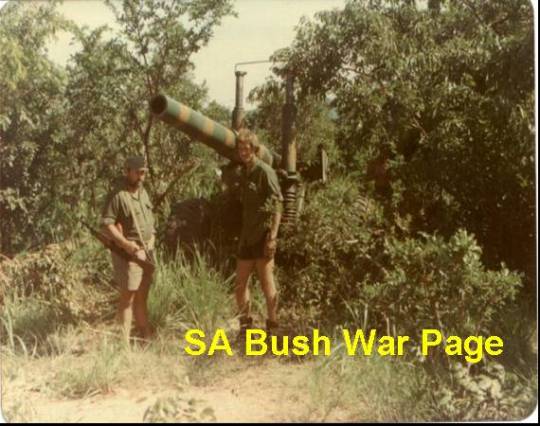
Savannah’s incredible pace would not last forever. The first engagements with Cuban forces came on November 2, and soon enough Cuban forces were arriving in bulk. On November 9, the first 100 men of a special-forces battalion landed in Luanda, and the very next day, the combined MPLA/Cuban forces drove back the enemy assault with overwhelming firepower. Although the SAAF offered support with sporadic Canberra sorties, neither the SAAF’s bombers nor the SADF’s obsolete artillery could hope to compete with the BM-21s and long-range artillery. Where the SAAF really shined was with the transports. C-130s and C-160s were flying almost nonstop, bringing in supplies and evacuating casualties for the rapidly advancing spearheads.
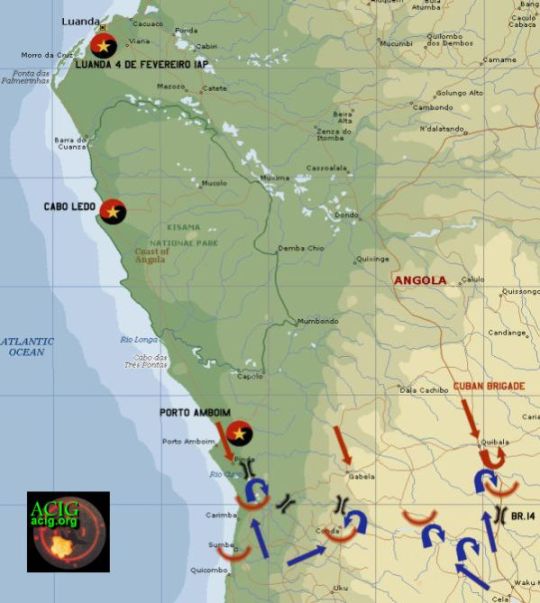
By November 13, the Cubans had halted Zulu on the south bank of the Queve River. Despite concerted efforts to break out and take Luanda, the SADF would advance no further. Their obsolete equipment could not hope to compete with the overwhelming artillery superiority of the enemy, and they were now well beyond the range of the SAAF’s bombers. Cuban support was increasing with every day, and with the end of the year the SADF was faced with rotating out its soldiers on the front for fresh conscripts. The death blow to Savannah came in December, when Operation Savannah and the CIA involvement was revealed to the world by the New York Times. CIA support ended almost immediately (later to be made illegal by the Clark Amendment), and South Africa’s already strained relations with the rest of the world worsened. With all hope of capturing Luanda fading, the SADF made the decision to withdraw. The record of the campaign was impressive. Zulu had advanced 3,159km in 33 days, fighting 21 engagements and claiming 210 MPLA dead and 96 enemy wounded for just 5 dead and 41 wounded on their end. Due to the fact that South Africa was not officially in Angola, the 49 casualties across the four task forces were listed as MIA.
The Long Haul
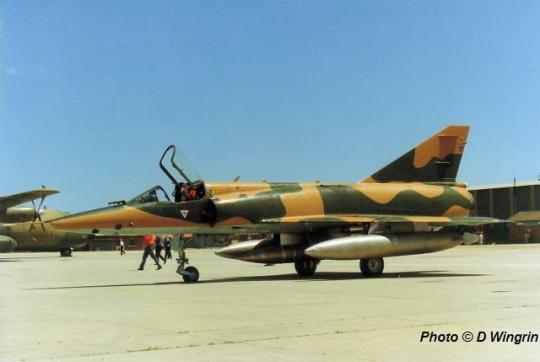
With Savannah put to an end, South Africa was faced with an unsightly prospect. Direct intervention in Angola was now a political impossibility, meaning that the SWAPO terrorists were fairly free to set up bases just north of the Cutline. The new alliance with UNITA would come in handy in regions where UNITA controlled the border, but for much of the border the MPLA had regained control. In response to escalating SWAPO incursions, the SAAF saw increasingly common deployments to SWA. Initially, these deployments were just a continuation of the extensive photo-recon efforts that ended in 1974. In May 1976, Mirage IIIs from Cheetah Squadron were deployed to Ondangwa to fly three tactical reconnaissance sorties. Due to the threat of MPLA MiG-21s, Mirage IIICZs flew escort for the R2Z. Fortunately, these sorties went without incident, and Cheetah Squadron returned home. Two months later, they would make similar missions over Mozambique.
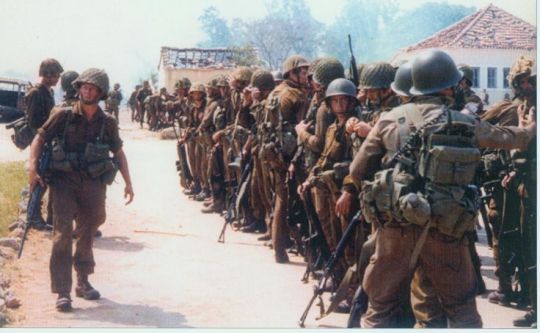
Gradually, deployments of aircraft to SWA were expanding beyond brief reconnaissance missions. 24 Squadron's Buccaneers made a brief deployment some time in 1977, but it wasn’t until 1978 when the first permanent deployment - six Impalas to Ondangwa - was made. This deployment came as part of a greater shift in doctrine. Recognizing that South Africa lacked the resources to sit idly by and counter SWAPO incursions within SWA, the SADF would now be tasked with more active COIN operations. This meant yet another escalation. To fight SWAPO, cross-border raids would become the norm. The first of these - Operation Bruilof - was planned for May 1978, aimed at a base just across the Cutline. However, in the late stages of planning, a larger base was discovered at Cassinga - 250km inside Angola. The target of the operation was changed, as was the name - it was now Reindeer.

Reindeer called for a massive paratrooper assault supported by a preliminary attack by Buccaneers and Mirage IIIs. As the date of the operation approached, Mirage IIIs began relocating to the theater (the other aircraft had already been deployed), only to run into an unexpected problem - lack of transports. The entire C-130 and C-160 fleet had been earmarked for the operation, so the SAAF was only able to spare a single DC-3 to ferry maintenance crew. Thus, 12 men would have to keep the four Mirage IIIs flying for Reindeer. Early on the morning of May 10, the first aircraft set out. Four Canberras arrived over Cassinga first, dropping their Alpha bombs (special antipersonnel weapons), followed by a flight of four Buccaneers carrying 1000lb bombs. Two Mirages met the 250 paratroopers as they dropped over Cassinga and patrolled until fuel ran short, but were unable to provide direct fire support because of the hectic situation on the ground.
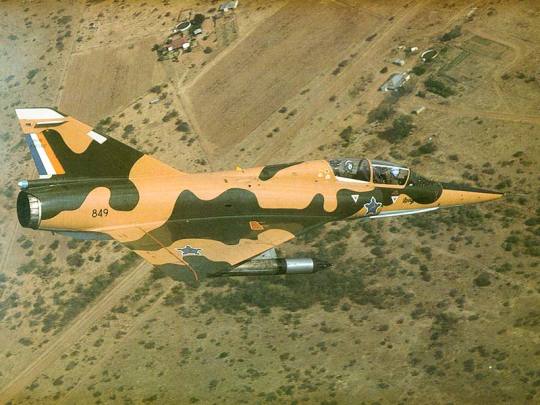
As the assault on Cassinga came to an end, a large helicopter force set out to evacuate the men. During the evacuation, an MPLA armored column was discovered to be advancing on the town, so a request for any available aircraft was sent out. Two Mirages were the first to arrive, making several strafing runs until fuel ran out, at which point a single Buccaneer took over. The Buccaneer strafed until ammunition ran out, at which point it continued to buzz the enemy forces at low level. Ultimately, the evacuation was a success. SADF casualties were 3 dead and 11 wounded, while SWAPO lost over 1,000 men. However, the real significance of the Cassinga operation was its escalation - what had primarily been a helicopter-supported war had for the first time seen the introduction of high-performance jets.
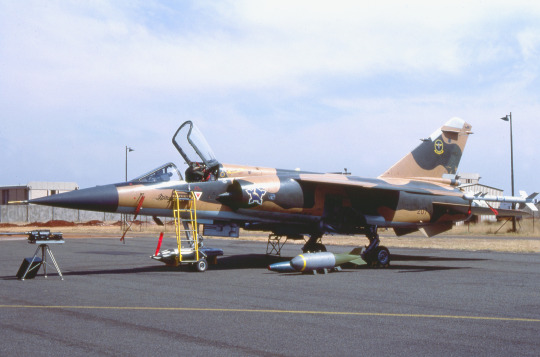
Reindeer would not be the only major incident of 1978, either. After a SWAPO attack in the Caprivi strip, another retaliatory raid was planned. After reconnaissance by a Mirage IIIR2Z supported by an F1AZ (the first SAAF Mirage F1 sortie), Buccaneers and Canberras hit a SWAPO base in Zambia over the course of two days. The air raids themselves weren’t too productive (only 16 enemy casualties), but the helicopter assault that followed would put an end to SWAPO incursions in the Caprivi Strip for the remainder of the war. In November, five Mirage F1CZs were deployed to Ondangwa to escort the Mirage IIIR2Zs. They operated without incident, although on one occasion they were nearly intercepted by two unidentified Angolan aircraft. By now, Impala operations had also become regular. Armed reconnaissance sorties around the Cutline had become the norm, with the Impalas flying at treetop level in search of SWAPO insurgents. In the event a target was found, they would make use of their underwing rocket pods and 30mm cannons to dispatch the threat.
Cooperation With Rhodesia

By 1979, the crisis in Rhodesia was reaching its peak. In February of that year, Air Rhodesia Flight 827 was shot down by ZIPRA rebels, killing 58 people. Rhodesia wanted to respond with an air strike, but with only four Canberras available, they requested support from the SAAF. The SAAF sent three bombers from 12 Squadron to Rhodesia at the end of the month to begin preparations. The Rhodesians had located a massive ZIPRA training camp near Luso in Angola - over 600 nmi from the airbase near Victoria Falls. The camp held an estimated 3,000 rebels, as well as an unknown number of Cuban and East German advisors. Plans called for the SAAF Canberras and three of the Rhodesian bombers to be loaded with 300 antipersonnel Alpha bombs, while the final Canberra would carry 1,000lb bombs.
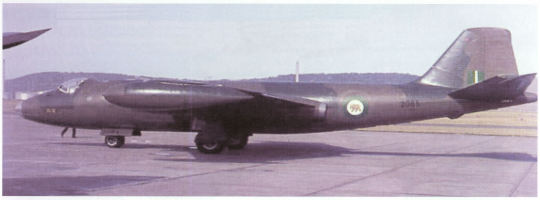
At dawn on February 26, 1979, the combined South African and Rhodesian forces took off towards their target. Escorted by two Sidewinder-armed Hawker Hunters and supported by a DC-3 monitoring enemy radios, they made their way at high altitudes over Zambia before descending at low level for their bombing run. After the successful attack, the formation split up. The Rhodesians returned to the main airfield at Salisbury, but the SAAF bombers landed at an auxiliary airfield to avoid unwanted attention. The operation would be the most successful Canberra strike of the war, and it was hailed by the Rhodesian media. The three SAAF Canberras would participate in several more joint operations with the Rhodesians, this time striking targets in Zambia in August of 1979. The attacks were also a success, although one SAAF Canberra was damaged by shrapnel from one of the bombs on the low-level attacks.
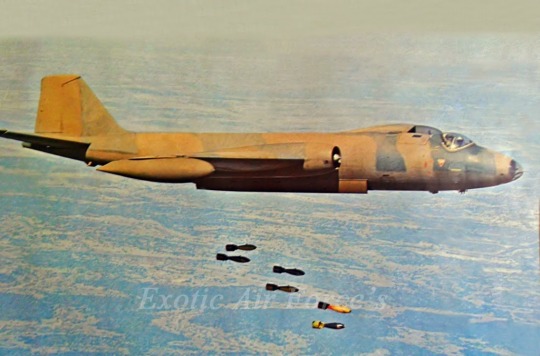
In September, Rhodesia launched a series of operations aimed at strategic targets in Mozambique. 24 Squadron’s Buccaneers and Canberras flew support, doing extensive damage to the enemy targets.At the end of the year, one final combined Buccaneer/Canberra strike occurred. However, things were hardly going well. The first operation (Ulric) marked the first operational failure of the Rhodesians in the entire war, and by the end of the year, Rhodesia had given in to majority rule. Two successive waves of voting occurred - one as the unrecognized state of Zimbabwe Rhodesia, and then another “legitimate” round in early 1980 after Zimbabwe had gained official independence. Unfortunately, ZANU aggressively intimidated rivals, leading to Robert Mugabe winning the elections. Almost overnight, South Africa lost their last ally in the region.
Rekstok and Saffraan

When SWAPO responded to a peace initiative with renewed attacks, the SADF launched two new operations - Rekstok, aimed just across the Cutline, and Saffraan, aiming to hit SWAPO bases in Zambia. In early March 1979, the SADF crossed into Angola to destroy SWAPO bases, supported by Canberras and Mirage IIIR2Zs. As a precaution against Angolan fighters, Mirage F1s were deployed as well to fly CAP, escort, and armed reconnaissance. Low-level Canberra raids dropping Alpha bombs generally went well, but on March 14th, one Canberra was downed by ground fire after stray rounds incapacitated the pilot. F1s were scrambled to search for survivors, but none were found. Over the course of Rekstok, 25 sorties had been flown by the Canberras, dropping 7,300 Alpha bombs.
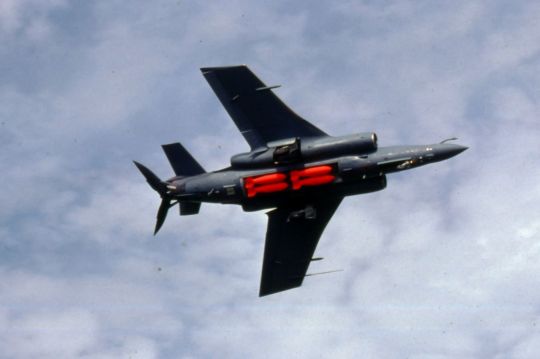
Saffraan would have heavier air support. 12 Impalas were flown out to Mpacha in early March, and Canberras and Buccaneers flying from more distant bases were also earmarked for the operation. Unfortunately, on their first raid, the faster bombers missed their target, leaving the only air support to the Impalas. Although the Impalas hit their mark, the raid was called off for fears that the target had not been suppressed enough. Fortunately, later raids went better. A concerted bombing campaign lasted for about 5 weeks, supported by recce teams on the ground reporting damage assessments. Infiltrations with larger teams to assault the bases would find the bases long since abandoned. However, the operation was a resounding success. The target bases were all destroyed, and Zambia responded to the attacks by withdrawing its support for SWAPO, denying them their country as a base of operations.

By the middle of 1979, one of the targets of Rekstok was discovered to be active again. A new strike, codenamed Rekstok II, was launched with two Buccaneers and seven F1AZs, wreaking havoc on the SWAPO compound. Meanwhile, another F1AZ hit a radio station just across the Cutline, while four Impalas hit a logistics depot at the same site. By the end of the year, the small Ondangwa airbase had morphed from a rough airstrip surrounded by tents and temporary structures to a major operations base. An intensive care unit had been established for casualties, and the Special Forces had established a headquarters at the base. A Fireforce reaction unit was permanently stationed at the base, as were maintenance personnel from the SAAF and a mobile radar unit to look across the border. Being just 30km from the border, security was tight, so much so that helicopter gunships covered any passenger aircraft coming in or out of the base.
A New Decade

As 1980 came, SWAPO had begun to change their tactics. Active attacks across the border were now too risky, so an aggressive minelaying campaign began to keep casualties lower. Meanwhile, cross-border airstrikes and regular Impala patrols had forced SWAPO to remain idle during the day, moving only at night. Fortunately, Impala pilots were quick to adapt as well. Round-the-clock armed reconnaissance flights began with ever-increasing effectiveness as pilots refined their nighttime tactics. SWAPO trucks soon began driving with no headlights, but Impala crews would soon learn to pick out even the faint brake lights among the dark terrain. Eventually, SWAPO abandoned moonlight driving as well. From now on, SWAPO would only move trucks on nights when the moon was not visible. Impala crews still took their toll on these darker nights, but such raids were more stressful for aircrews.
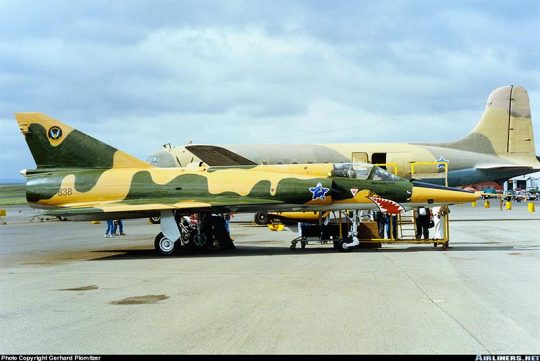
The next major operations of the war - Sceptic, Smokeshell, and Klipklop - would come in the middle of 1980. For the SAAF, these operations followed the pattern set in the previous years. F1s would escort Mirage IIIR2Zs to perform pre-raid reconnaissance, and then F1s and Buccaneers would follow up in waves of attacks on the targets. However, these targets were becoming ever more dangerous. Thanks to communist support, SWAPO got their hands on SA-2s, SA-3s, and SA-7s, which they used to great effect. AAA layouts of bases improved, and in some cases bombing runs following the initial wave had to be abandoned due to the threat of the now-alerted air defense networks. Things were also worsening for the Impala crews. Several Impalas were downed by SWAPO MANPADS during 1980, and several more received significant damage. 1980 would end with Operation Wishbone - an unusual medium-level bombing raid of F1s led by a Canberra. The operation was a failure - not only was the drop inaccurate, but the target camps were vacant by the time the bombers arrived.

As 1980 turned into 1981, the war showed no signs of stopping. 1980 had been the deadliest year thus far for both SWAPO and the SADF, and SWAPO operations only seemed to be intensifying. Finally, by mid 1981, the SADF decided to launch a major operation to root SWAPO out of the border region. Operation Protea would involve two mechanized task forces to destroy the SWAPO strongholds at Xangongo and Ongiva and then seek and destroy logistical and training infrastructure. The SAAF had their own objectives. They aimed to neutralize MPLA air defenses along the border to give them freedom of movement for the foreseeable future as well as provide general support for the SADF task forces. For this, the SAAF assembled their largest force thus far in the war - 12 F1AZs, 8 F1CZs, 13 Mirage IIICZ/D2Zs, 18 Impalas, 5 Buccaneers, 6 Canberras, 3 Mirage IIIR2Zs,38 helicopters, and 29 transports and auxiliary aircraft.
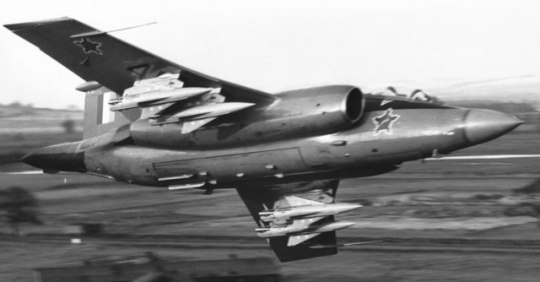
Three days before the planned start date of Protea, SAAF fighters began to converge on their airbases. Shorter ranged aircraft like the Impalas and Mirage IIIs were stationed at Ondangwa, but the base could not handle all the aircraft, so those that could afford to do so - the Buccaneers and F1s - were deployed to Grootfontein. On August 23, 1981, 24 Squadron opened the offensive, flying deep into Angola to attack radar stations at Chibemba and Cahama. Lead aircraft fired AS-30 guided missiles, while the other Buccaneers performed high-altitude dive-bombing runs that kept them out of the SA-7’s engagement envelope. Just minutes behind them, formations of F1s led by a Canberra struck the targets with a combination of contact- and delay-fused bombs. Two more waves followed after that, this time hitting another radar installation that was yet untouched. Strikes against the two towns continued for the rest of the day, and as day turned to night, the SADF began advancing on the ground. Impalas were soon sortied to support ground forces
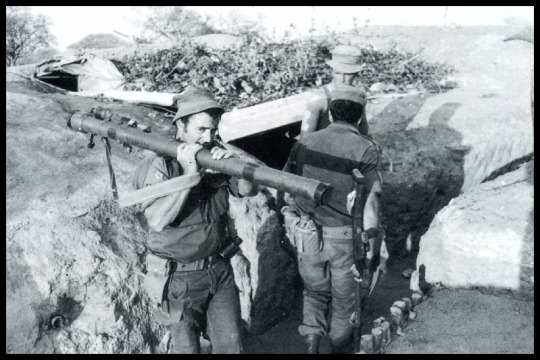
With the MPLA air defense network neutralized, the SAAF now shifted its focus to supporting the SADF. August 24’s air operations were kicked off by Impalas, which struck air defenses near the target towns. Buccaneers then swooped in, hitting high value targets with AS-30s, followed by Canberras and F1s as medium altitudes dropping iron bombs. Overall, Protea was going spectacularly. Ground forces were advancing, and the SAAF was meeting all objectives without loss. With the threat of MPLA fighters gone, the Mirage IIIs were switched over to act as fast-reaction CAS aircraft. As ground forces advanced, they captured a small airfield, allowing DC-3s to provide more timely resupplies. By the end of the month, the SADF had reached its objectives and had begun withdrawal. Protea had been a complete success. SWAPO and MPLA casualties approached 1,000 men, while the SADF had suffered just 10 dead and 64 wounded. over 3000 tons of equipment was captured, and the SAAF interdiction efforts had been so successful that intercepted radio messages were constantly complaining about serious supply shortages. Most importantly, the SADF had achieved a diplomatic coup by capturing a Soviet advisor, providing proof to the world that the Soviets were actively supporting SWAPO despite their denials. In the largest SAAF operation since WW2, 1,112 sorties were flown, dropping 333 tons of bombs, 1,774 rockets, and 18 AS-30 missiles. One helicopter was lost, and a Mirage III was damaged by an SA-7.
Operation Daisy - A MiG Kill

Protea’s long-term impacts would be felt for the remainder of the war. UNITA was introduced to the recently captured border region, pushing SWAPO bases well beyond the Cutline. Brief, violent incursions were now a thing of the past. In November, the SADF would launch Operation Daisy, aimed at further disrupting SWAPO plans. CAS was entrusted to 15 Impalas, but Mirage IIIs would be brought in for reconnaissance, along with 20 F1s for air superiority and 3 Buccaneers in case the SAAF needed to suppress enemy airfields. The operation started off uneventfully, but two days in the Angolan air force became surprisingly aggressive. Mirage F1s were kept on interception standby, and early in the morning of November 6, two fighters were sortied to intercept contacts. They flew out at low level to avoid detection by enemy radars, only climbing as they got close to the contacts. Flying at 20,000 ft, they identified the aircraft as two MiG-21s several miles to the port flying the opposite direction.
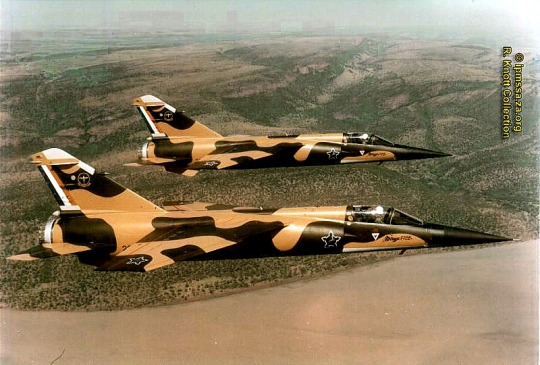
The F1s jettisoned their tanks and turned hard to get behind the unsuspecting MiGs. They closed for intercept, but the targets were flying into the sun, precluding the use of the Matra 550 IR AAMs. Instead, they closed to gun range. The lead F1 fired a burst of 30mm at the #2 MiG at about 350 m, hitting it. Both MiGs broke into evasive maneuvers, which the F1s followed. The lead F1 attempted to launch a missile, but it malfunctioned, so he closed back in for a gun kill. The MiG made the mistake of reversing his turn, allowing the lead Mirage to set his sights on it once more and down it. Meanwhile, the wingman was chasing down the lead MiG. In a high-speed descending turn, the wingman’s missiles twice malfunctioned, allowing the MiG to get away.

The MiG kill on the second day of Daisy would mark the first aerial victory of the war and the first SAAF kill since Korea. Daisy continued on for over a week, and the F1s were scrambled on several more occasions. However, the MiGs were being far more cautious, and they seemed to be flying purely in defense of their bases. 13 days into Daisy, the Mirages were withdrawn. On November 17, Daisy finally came to an end. the SAAF had flown 272 sorties from Ondangwa in support of it, while light aircraft operating from an airfield north of the border flew another 207. Daisy marked another major success along the lines of Protea. Another major SWAPO logistical base had been destroyed, and SWAPO was pushed even further into Angola. For South Africa, Daisy marked the deepest penetration into Angola since Operation Savannah.
‘82
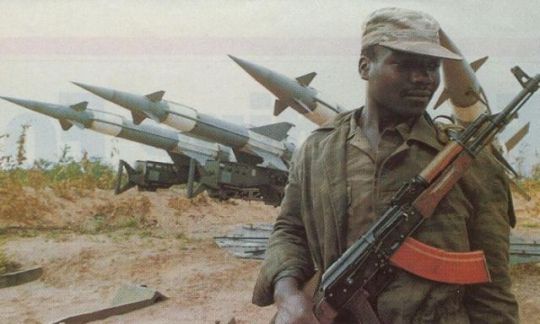
Even after the devastation wrought in Protea and Daisy, SWAPO attacks continued. After Operation Super revealed that SWAPO was building camps to open a new front in Kaokoland, to the west of the Cutline, the SADF authorized a reconnaissance operation to update maps of the border region. Mirage IIIs and Canberras were earmarked for what would become Operation Rekstok III, with 1 Squadron’s F1AZs deployed to provide fighter cover. The operation went smoothly - the only notable incident occurred when one escort flight was vectored off to strafe a helicopter carrying enemy senior military staff. Rekstok III would end when the April rains came, leaving the SAAF time to prepare for a bombing campaign once the weather improved. Starting in May, this new campaign focused efforts around Cassinga. Given Cassinga’s reputation for active AAA crews, F1s and Buccaneers would handle the attack. F1s came in low, pitching up at the last moment to perform dive-bombing attacks, while the Buccaneers tried (unsuccessfully) to execute the first toss-bombing attack of the war. On the receiving end, there were also some firsts - the ZSU-23-4 Shilka was firing back at the attackers.

By July, the MPLA and SWAPO were preparing to retake the towns lost in Operation Protea a year prior, so the SADF launched Operation Meebos to stop them. As Angolan air defenses had recovered since their last beating, the SAAF side of the operation would focus on neutralizing the network once more. On July 21, eight F1AZs escorted by two F1CZs struck the Angolan radars monitoring the region, knocking them out. Those on CAS standby were less active, however. Difficulties locating SWAPO headquarters meant they would have to wait until August for their first real sorties to be flown. When they were finally called into action on the first day of August, however, it would be hectic. 12 F1s were sortied to support ground forces near Techamutete with Mk 82 bombs, followed by two F1AZs fitted with 68mm rocket pods. The rocket-equipped F1s followed the bombers, loitering until the skies opened up with RPGs and Strelas, providing the F1s with targets to strike. Once again, the SADF was successful, capturing or destroying vast amounts of enemy stores. However, it came at a high cost - 29 men were killed. Politically, it was also unsightly - the SADF had advanced as far north as Cuvelai.
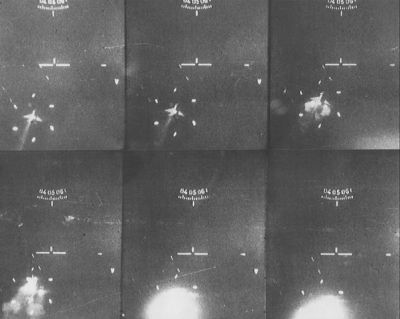
On October 5, 1982, two F1CZs were escorting a Canberra on a recon flight when ground-control alerted them to incoming contacts. The fighters broke off to engage, meeting their targets at 30,000 feet and closing with them at twice the speed of sound. As they crossed paths, the enemy - MiG-21s - fired missiles, which flew past them harmlessly. The F1s immediately turned hard to get on the enemy’s 6, finding that the MiGs were making a gentler turn to preserve their supersonic speed and escape. However, the lead F1 flipped on his radar, and as he did, the MiGs made a sharp turn - either to intercept the Canberra or a reaction to the radar. The F1s accelerated to Mach 1.3, catching up with the MiGs. As they did, the flight lead fired one of his missiles, but, being at the edge of its engagement range, it burnt out harmlessly. Closing in, he fired a second missile, which exploded behind the target as it cut into a split-S. Though damaged, it would limp back to base. The F1s then turned their attention to the remaining MiG, which had performed a split-S the opposite direction. The F1s closed rapidly, and the leader opened up with his 30mm DEFA cannons at 230 m. The MiG exploded in a fireball, and the leader, with no time to evade, stalled out his engine as he flew through the fireball. Fortunately, the engine was restarted in flight, and the F1s returned home without incident. The SAAF had just claimed their second MiG kill of the war.
Slowing Down

As the new year came, it seemed as if the war was finally defusing. Major operations were few and far between, and those that did come harkened back to earlier days, when Canberras, Impalas, and light aircraft were the only SAAF support. Operation Maanskyn, involving eight Impalas on nighttime raids, proved so effective that just ten days of operations brought international pressure for new negotiations that would ultimately accomplish little other than forcing the SAAF to stop the raids. In their place, less conventional concepts were tried. A propaganda campaign making use of loudspeaker-equipped light aircraft and pamphlet-dropping DC-3s was conducted, and several DC-3s were converted to gunships a-la the American AC-47. Gunship DC-3s - Dragons - were equipped with 20mm cannons aimed out the left side of the aircraft as well as the “Skyshout” aerial loudspeaker system. For the first time in years, operations remained solely domestically oriented. However, Mirage F1s would be deployed to Ondangwa in April, complete with newly developed pre-fragmented bombs that would soon make rocket pods obsolete.
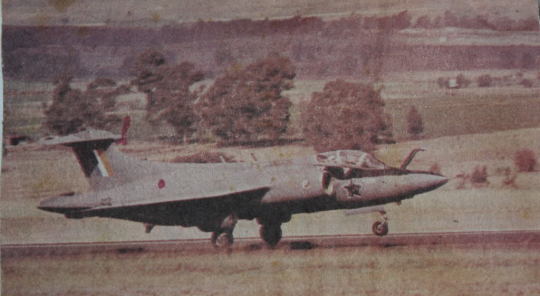
Even the first “real” air operation of the year - Skerwe - would be done with Impalas. In retaliation for an ANC bombing in Pretoria, eight Impalas with rockets were sortied to strike ANC buildings in Maputo, Mozambique. By the middle of the year, ground operations had picked up - the SADF was performing sweeps into the shallow area of Angola again, regaining its offensive posture. However, SAAF operations continued to be limited to sporadic Maanskyn flights. In August, when the MPLA retook the town of Cangamba, A UNITA request for support in retaking the town was met with a new operation - Karton - which would be heavily dependent on the SAAF. With transports and helicopters providing logistical support, the centerpiece of the operation was to be an air attack on hardened MPLA positions. With how far north Cangamba was, only Canberras and Buccaneers would be able to reach the target. The SAAF committed four of each, loading them with a total of 24 1,000lb bombs, 36 500lb bombs, and eight AS-30 missiles.
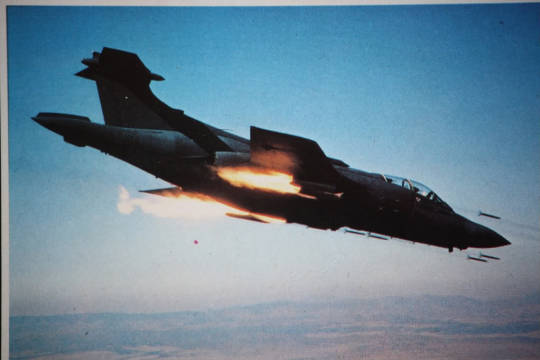
On August 13, the bombers were relocated to Grootfontein in preparation for the attack. Plans called for the bombers to attack out of the sun at 8:00 the next morning. The aircraft took off the next day without incident, flying under radio silence once the Cutline was crossed. Given the lack of air defenses over the target, the bombers could take a more leisurely attack profile. While the Buccaneers would kick off the attack with AS-30s aimed at the entrances to enemy bunkers, the next wave - the Canberras - came at a comfortable medium altitude, providing time for the bombs to achieve a steep penetration angle. With the Canberras’ payloads expended, the Buccaneers returned to drop their bombs, this time in a dive-bombing profile. The attack went almost perfectly. The AS-30s made their first impacts at exactly 8:00, and the attack devastated the combined Cuban/MPLA forces. Uniquely, the casualty figures of the battle seemed more like that of an SADF operation than a UNITA one. The enemy suffered 829 casualties and 300 captured, while UNITA lost only 63 men.
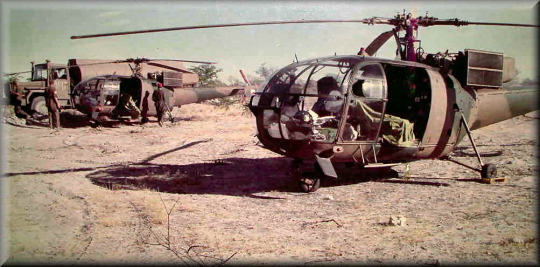
Much of the rest of the year consisted of a series of ground operations punctuated by the occasional air strike intended to prepare for the SADF’s next major blow against SWAPO - Operation Askari. Infiltration teams were sent across the border to scout out targets, and COIN operations on both sides of the Cutline continued. Meanwhile, the “Dragon” gunship had proven so effective that the SAAF ordered a second conversion. However, fixed-wing air support was more often limited to Impala strikes. With the SAAF preparing for Askari, they were unwilling to spare their fast jets for such minor targets. COIN operations slowed as the weather worsened, and, although recce teams would infiltrate Angola at the end of November in preparation for Askari, the coming rains forced other operations to be put on hold.
Askari

In early December, Operation Askari kicked off. SADF forces initially focused their efforts on Cahama, which for some time had been the subject of air attacks due to its radars. Actual operations against the town began in mid November - recce teams were constantly attacking supply lines. Once Askari officially began, the SAAF joined in, striking important targets and identifying enemy positions for SADF artillery to bombard. As part of this attack on Cahama, a concerted effort was made to drive the SA-8 batteries positioned at the town far enough south for the SADF to capture them Things went well at first. The SA-8s were forced to relocate several times, with each new position getting progressively closer to the SADF. At Cahama, MPLA morale was plummeting, and it seemed as though the SADF would overrun the town. Unfortunately, Askari had attracted the attention of the rest of the world, and with international attention came outrage. International pressure mounted, and on the last day of December 1983, the assault on Cahama was called off.

Further north were the twin objectives of Quiteve and Mulondo. Plans for the assault on those towns were little different from the assault on Cahama. First in the line of fire was Quiteve, which would fall almost without firing a shot on December 11 in the face of artillery and airpower. The MPLA sent two tanks south to help stall the advance, but the SAAF responded with F1s, destroying one of the tanks and forcing a withdrawal. Unfortunately, the SADF advance would soon be checked by Soviet-supplied D30 artillery pieces, which outranged the SADF guns. Air support earmarked for the assault on Cuvelai had to be diverted to make up for this shortcoming. Even so, SADF forces moved slowly. The Angolans and their air defense network were now on high alert, making attacks increasingly dangerous. On December 23, an Impala was struck by a Strela on a CAS sortie. Fortunately, it managed to limp back to base under its own power. The ultimate plan of capturing Mulondo would never be completed - as with the assault on Cahama, the Mulondo objective had to be abandoned in early January due to mounting international pressure.
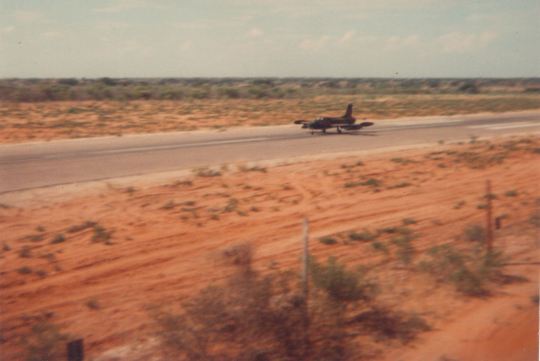
The final part of Askari - the assault on Cuvelai - began in late December. The operation began with an extensive photo-recon effort, followed by air attacks that began on December 27. Combined efforts of Impalas and Canberras targeted air defenses and the town’s airstrip, hoping to cut enemy morale and convince them to abandon the town. Unsurprisingly, the MPLA remained undeterred. Attempts to assault the town by ground forces were driven back by tanks, artillery fire, and 23mm AA guns. Both sides dug in and prepared for the next attack. On the afternoon of January 3, ten Impalas, followed by four Canberras performed a massive airstrike. Soon after the first wave left the skies over Cuvelai, eight more Impalas appeared overhead to drop more bombs. The attack would be tremendously successful. ELINT operators picked up the Angolans desperately requesting aid from HQ, reporting that 75% of their artillery had been destroyed.

On January 4, the ground assault began. SADF artillery opened up, and Ratel APCs began to cross the open minefields to break into the town. MPLA T-55s counterattacked, but they were driven off by artillery fire. By the end of the day, the SADF had entered Cuvelai to find it deserted. Fleeing MPLA forces found themselves caught between SADF elements in Cuvelai and Techamutete to the north. As SADF forces mopped up the surrounded enemy, international pressure reached its peak. With ground forces losing momentum due to poor weather and the threat of further sanctions looming, the SADF finally halted Askari on January 10. By February 1984, the front had stabilized, and South Africa now found itself in control of all the territory between the Cunene and Cubango rivers as far north as Tetchamutete. With Askari now officially over, the results could be tallied. the MPLA lost 429 men and SWAPO a further 56, while five Cubans were killed and another captured. The SADF lost 25 men and 65 wounded, all while capturing vast swathes of enemy territory and massive stores of enemy equipment. Unfortunately, Askari would only serve to attract more aid from the Soviets and Cubans. Things were not going to be ending anytime soon.
An Uneasy Peace

International pressure in reaction to Operation Askari forced South Africa to the negotiating table at the end of 1983. While SWAPO had been crippled, they remained a threat, and after some negotiations, relative peace was agreed upon. South Africa withdrew back south of the Cutline, but SWAPO activities were reduced. This by no means pointed to an end of malicious intent - as with every break in the war, SWAPO and the MPLA took full advantage of any lulls to bolster their position. In early 1984, SADF intelligence got their hands on a document that came to be known as the “Iko Carreira Plan.” The plan detailed the long-term communist strategy for neutralizing the SAAF through the establishment of an effective air defense network. Through extensive support for Angola, Zambia, Zimbabwe, and Mozambique, the Soviets hoped to establish an early warning network that covered nearly all of South Africa’s borders. Stations along the Angolan border could peek over the Cutline at 20,000 feet, and most alarmingly, Mozambican radars could see well into South Africa proper. 1984 would be largely uneventful apart from extensive reconnaissance operations that hoped to find evidence that the MPLA was violating the terms of the peace agreements, but to no avail. They did find many alarming things - like the establishment of a Zambian fighter airfield near the Caprivi Strip - but legally there was nothing that could be done.
Proxy War
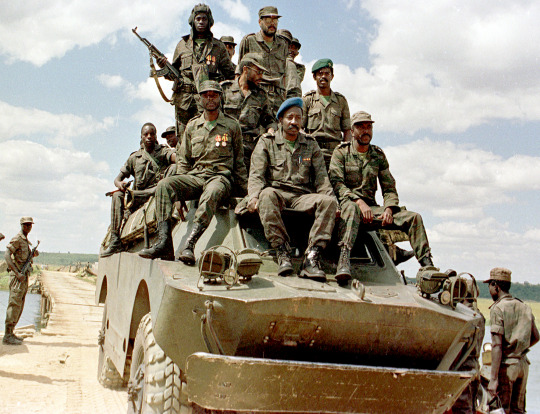
By mid 1985, it seemed as though the days of peace were over. Intelligence reports, corroborated by Canberra reconnaissance flights, pointed to a massive buildup of MPLA forces near Cuito Cuanavale and Menonque in preparation for an assault on the strategically important airfield at Mavinga. Fortunately for UNITA, their cause had gained favor in the international community. The US repealed the Clark Amendment in July 1985, opening the door to support for UNITA. Though hamstrung by the peace agreements, the SADF would also do their utmost to aid UNITA in the coming offensive. When the Cuban/MPLA forces finally launched their assault in July as part of Operation Congresso II, the SAAF launched their own support operation - Magneto. Unable to provide direct combat support, they instead ferried reinforcements between Gago Coutinho to Cazombo in the besieged enclave to north. Due to the threat of Angolan MiGs, all flights were to take place at night. Nevertheless, the SAAF racked up an impressive record - fixed-wing transports flew 220 hours between 23 August and 10 September.

Unfortunately, the SAAF’s ferrying of troops was incapable of fending off the Cuban-supported MPLA forces. Thus, on 11 September, an evacuation effort began - Operation Wallpaper. If Magneto seemed hectic, Wallpaper would be even more so. C-130s, C-160s, L-100s, and DC-4s were earmarked for the operation, flying 310 hours (again only at night) until the operation ended on October 8 to pull UNITA troops out of the Cazombo enclave. Soon after Wallpaper began, Jonas Savimbi (the leader of UNITA) was pleading for direct SADF intervention, as it was clear that they could not hold off the MPLA at Mavinga alone. Finally, on September 16, the much-needed intervention began. Operation Weldmesh, a series of airstrikes aimed at stopping the enemy advance.

During Weldmesh, the SAAF took advantage of the poor state of Angolan air defenses in the far corner of the country. The same critical gap in regional radar coverage that the SAAF had capitalized on for the transport operations earlier that month would again be critical for these airstrikes to succeed. The MPLA had only two airfields in the region - Cuito Cuanavale and Menonque - and only Menonque was capable of handling fighter operations. Although the MPLA had deployed MiG-23s to provide fighter cover, crew quality was poor. Radio discipline and navigational procedures were poor, and no night operations were flown. In the absence of an extensive ground-based air defense network as seen along the Cutline, the SAAF could operate relatively freely.

A key element of Weldmesh would be anti-helicopter duties. Combined efforts of the SADF/UNITA ground forces were wreaking havoc on enemy supply lines, so helicopters became the primary means of support. With only 10 Soviet-supplied helicopters at their disposal, the MPLA logistics were incredibly vulnerable. Close cooperation with ground-based recon and Impalas allowed the aircraft to sneak in at treetop level when a helicopter took off, intercepting them over the battlefield and downing them before fleeing in the face of Angolan MiG-23s. On September 27, the first successful mission was flown, claiming two Mi-25s, and two days later, the remaining Hinds and two Mi-8/17s were downed as well. Helicopter operations soon stopped, and with it the MPLA offensive stalled. By the time Weldmesh ended, the SAAF had flown over 200 hours in the F1, 37 with Buccaneers, 69 with Canberras, and 241 with Impalas. Air operations over Eastern Angola for the remainder of the year were more benign - Buccaneers were configured for long-range oblique photography over the stabilized front, and Impalas largely flew telestar missions to keep radio contact with rapidly moving ground forces.
Calm Before the Storm

By the end of 1985, the MPLA/Cuban offensive had petered out and the war had stabilized once more. Conventional warfare had halted, but SAAF operations continued. Transports continued to fly in support of UNITA forces, and the occasional bombing run on enemy positions was conducted. Thanks to the newly-arrived Boeing 707 tankers of 60 Squadron, the SAAF bombers could expand their area of operations - a vital improvement given that most fast jets were limited to flying from Grootfontein. The nature of these new bombing runs was significantly different from older campaigns, however. The threat of Angolan MiGs and ground-based air defenses was increasing with every day, and extreme measures had to be taken to protect the aircraft. Strikes were almost exclusively flown by F1s, coming in a treetop level to perform toss-bombing strikes or the semi-toss Gatup attack profile. The SAAF would make history in May, when their F1s performed the first night toss-bombing raid in history.
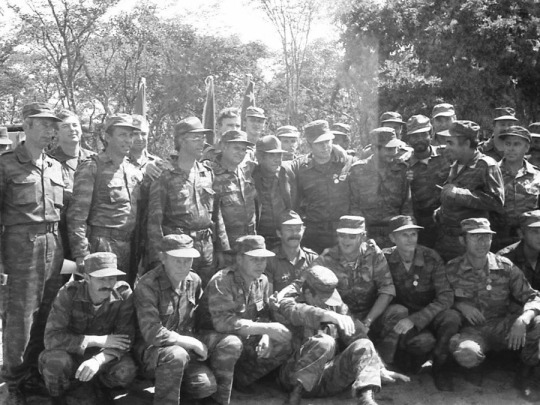
After the disastrous defeat of the MPLA in 1985, they and their allies began to investigate the reasons for their losses. While the most apparent - a lack of suitable air defenses - was already being addressed, other measures were slower to take hold. A major revision of the logistics structure - the MPLA’s achilles’ heel in the last campaign - had to be undertaken, and troops began training to make use of passive air defense measures to reduce the impacts of air attacks. Cuban troop levels were boosted to 50,000 men, and more new Soviet equipment than ever was flooding into the country. The SAAF would also take the time to bolster their side. Rundu, the closest airbase to the front, got its share of improvements. A mobile radar was brought in to look over the border, and various extensions and improvements were made to the airfield to allow for the SAAF to deploy more fast jets along the Cutline.

To the west, things remained calm as well (save the endemic SWAPO incursions). In late June, two Buccaneers were sent out to perform an oblique-photography recce flight over Namibe to confirm the presence of Su-25s at the airbase there. Though the mission profile called for the aircraft to pop up to 21,700ft for their photo run (keeping them a comfortable 12 nmi from the base), unexpectedly low clouds forced them to complete the run at 2,000 ft instead - bringing them directly over the airfield. Regardless of how ill-advised the run was, it was successful. Local air defenses were caught by surprise, and the Buccaneers returned home unscathed, having proven the existence of the Angolan Frogfoots. The only other major air operation that year would be Operation Bernico in September. The aim of Bernico was to use Mirage IIIs (both fighter and recce variants) to bait Angolan radars for ELINT purposes. Other more regular reconnaissance missions were also flown as the year came to an end, including one over a now very unfriendly Zimbabwe.
1987
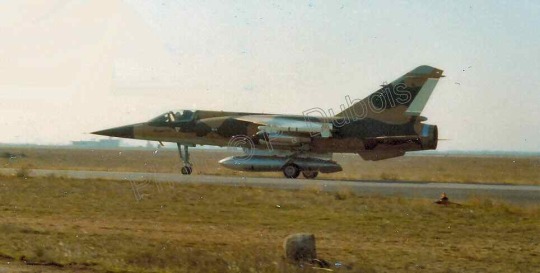
Although SWAPO activity had never really recovered from Askari, they remained enough of a threat to warrant renewed cross-border operations. However, such missions were now primarily ground- or helicopter-based, as the SAAF was more concerned with the increasingly aggressive Angolan MiGs. In May, a special forces team was sent to Lubango in hopes of sabotaging the enemy aircraft stationed there, and in April, the SAAF started serious attempts to lure the Angolans into an ambush. Tactics involved scrambling pairs of Mirages to loiter at low level whenever a MiG was detected. If the MiGs reached a certain point, the Mirages would be vectored to the enemy, popping up only at the last minute and activating their radars only just long enough to fire their missiles. Unfortunately, the efforts were in vain - not a single such sortie was successful.
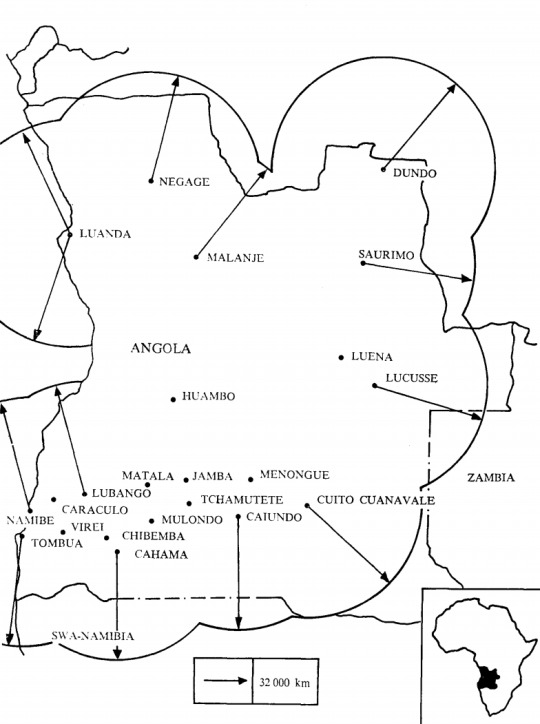
By June, the SAAF had revised their tactics. New radars were brought for ground control, as the older ones were unable to determine the target’s altitude, and those squadrons not deployed along the front had been spending their time training back home. By late June, the Angolans seemed to have caught on to the SAAF’s intentions. On June 28, a formation of 22 aircraft appeared on the radars, rather than the one or two formations that normally sortied. Intelligence soon determined after the fact that the Angolans set up the formation as a trap. Fortunately for the SAAF, an overly cautious ROE (no engaging unless a kill was ensured) meant that the large formation was never engaged. Overall, the skies over the Cutline were uneventful in 1987. Both sides had their sights set further east, and the Angolan air defense network would ensure that the SAAF would not get too bold over Western Angola.
Across the Lomba River - Operation Moduler
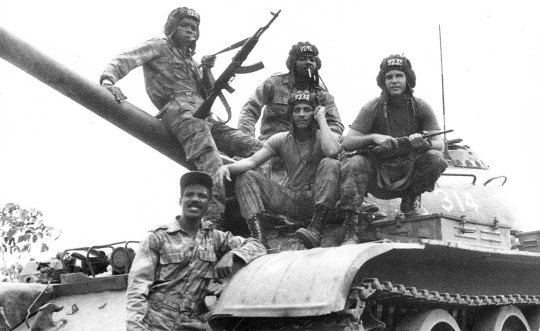
In the east, the situation was much different. After over a year and a half of waiting, the MPLA crossed the bridge at Cuito Cuanavale on June 22, 1987, pushing towards Mavinga. On paper, the offensive was almost identical to the one halted in 1985. However, that would be the only similarity to that failed operation. This time, the communists brought mobile air defense systems - SA-6, SA-7, SA-8, SA-9, SA-13, SA-14, and SA-16. Increasing numbers of helicopters, both Mi-8/17 transports and Hind attack helicopters, were deployed to Cuito Cuanavale, and MiG-21s, -23s, and Su-22s were deployed at Menongue. On the ground, the main push would be spearheaded by T-55s, BRDMs, and BTRs and supported by the same long-range artillery pieces that had been outgunning the SADF artillery since Operation Savannah over a decade prior.
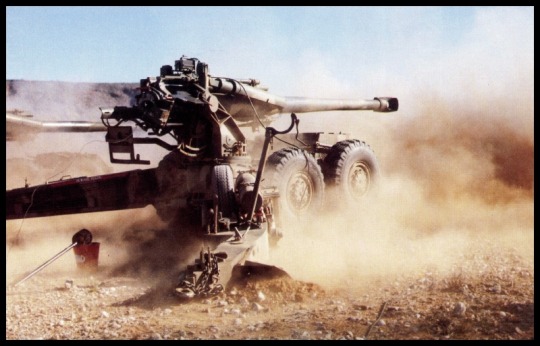
The SADF quickly caught wind of the enemy column advancing on Mavinga, and in early August they made their first attempt to halt it. Mirage IIIR2Vs scouted out the column, and in late August special forces were used to blow the bridge at Cuito Cuanavale, forcing the Angolans to rely on helicopters to ferry supplies across the river. Unwilling to risk invaluable manned aircraft to track the enemy, the SADF soon resorted to another first for the war - remotely piloted vehicles. On the ground, artillery duels had already began, and at night, Bosbok light aircraft were flown to spot for the guns. Unfortunately, the Angolans would prove to the SADF that they were no longer invulnerable at night - on September 3, a Bosbok was downed by an enemy SA-8.

Because of substantial MiG activity over the advancing enemy forces, the SAAF deployed 3 Squadron’s F1CZs to Rundu on September 4. Continuing the same MiG-hunting tactics being used over the Cutline, they finally succeeded in intercepting two MiG-23s on September 10. Two F1s intercepted the Floggers head-on, banking hard to get on the 6 of the enemy, who were maneuvering more gently. The F1 wingman got in position to fire his missiles, but both times he fired the unreliable Matra 550s exploded harmlessly in the exhaust plume of the target MiG. The engagement would end up being indecisive - both groups withdrew after the last missile fell short.
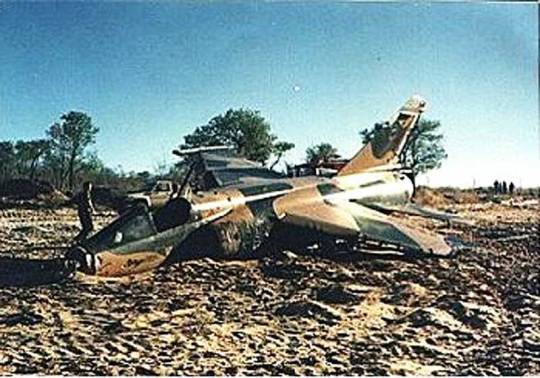
Meanwhile, 1 Squadron had ferried to Grootfontein. On September 16, they would fly the opening airstrikes of the South African reaction to the MPLA advance - Operation Moduler. Given the extreme threat of SAMs, the attacks were now exclusively toss-bombing sorties. Even with such a profile, the F1s were hitting their marks, and the newest generation of pre-fragmented bombs was proving invaluable. On September 27, the next MiG encounter came. Two F1s popped up in front of two Floggers just as before. They passed eachother head-on, and both formations banked left to engage. As they turned, the F1s were met with three missiles coming head-on. One narrowly missed the leader, but one of the others exploded near the tail of the wingman. Both sides disengaged, and the wounded F1 limped back to base. Unfortunately, on landing, the damaged F1 found it had lost hydraulics and its drag shoot. Unable to brake, the aircraft shot off the end of the runway at high speed. A heavy impact on the rough ground fired the ejection seat, which had insufficient time to deploy the parachute. When rescue crews found the pilot - Arthur Piercy - he was still strapped into his seat. Though he survived, he suffered a broken neck and would never walk again.

This incident finally forced the SAAF to face the fact that the technical advantage lay firmly in the hands of the MPLA. 3 Squadron was hastily restricted to base defense and escort duties, and the MiG ambush efforts were ended. Meanwhile, 1 and 24 Squadrons were flying multiple strikes a day from Grootfontein to hold back the enemy. On October 11, a Buccaneer flew an oblique recon flight over the Cuito Cuanavale bridge alongside a combined Buccaneer/F1 strike. Unfortunately, the camera equipment had been jarred a couple degrees off-target, forcing the Buccaneer to fly the tremendously hazardous mission again three days later (fortunately without incident). Fortunately, the intense aerial and artillery bombardment paid off. On October 5, the MPLA forces began to withdraw on foot. As the dust settled, the battle was clearly an SADF victory. The MPLA had lost 61 tanks, 53 BTRs, 7 BMPs, 23 BRDMs, 20 BM-21s, and suffered over 3,000 casualties. Meanwhile, SADF losses amounted to five APCs, one Bosbok light aircraft, and a single RPV, along with 17 soldiers killed and 41 wounded.
On the Offensive - Operation Hooper
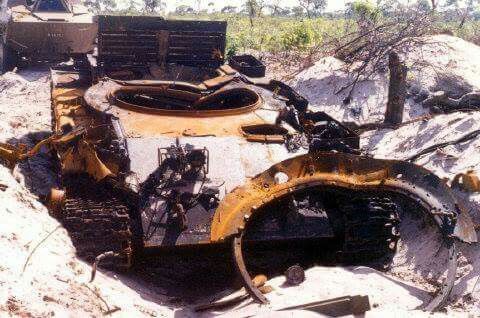
With the Angolans withdrawing, the SAAF was doing its utmost to turn an orderly retreat into a rout. Mirages and Buccaneers made use of the newest pre-fragmenting bombs to destroy enemy vehicles and wreck logistics, cutting enemy morale and forcing them to proceed on foot. Even as they did, missions were becoming all the more dangerous. Flights over Cuito Cuanavale were now accompanied by the constant drone of radar warning receivers, and only through skillful planning and even more skillful flying were crews able to make it home alive. On the ground, the MPLA had been pushed up along the east bank of the Cuito River, unable to cross due to UNITA guerillas to the west and SADF artillery to the east. With the MPLA in such a precarious position, against the advice of SAAF planners, the SADF launched an operation to destroy the MPLA forces - Operation Hooper
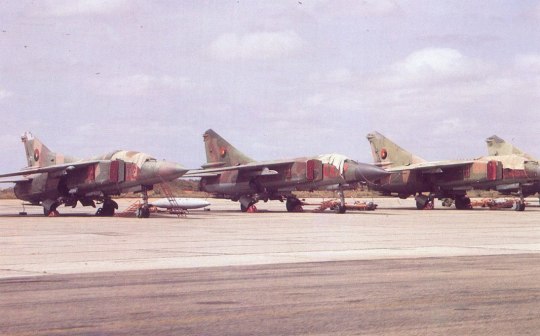
The SAAF’s reservations for launching the offensive would soon enough prove all too apparent. While the battle on the Lomba River took place equidistant to both the MPLA airfield at Menongue and the SAAF airfield at Rundu, Hooper aimed to attack where the enemy held the advantage. Rundu’s radars could not see over the battle area, while the MPLA had full view of the theater, and the differing distance to the battlefield gave SAAF F1s only 2 minutes’ loiter time and a 45 minute transit, while Angolan Floggers had just 11 minutes of transit and 45 minutes of loiter. Drop tanks could improve loiter time, but the F1s were having trouble enough competing with the MiG-23 completely clean. Everything had conspired to give the MPLA air superiority for the first time in the entire conflict. They had superior aircraft and equipment, an air defense network backing them up, and radars that could now see the entire battlefield, whereas the enemy were blind below 24,000ft.
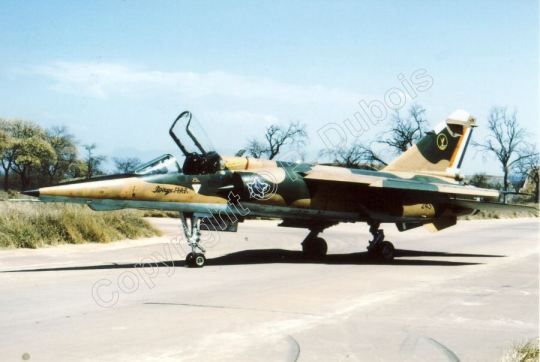
Nominally, Hooper began with the conclusion of Moduler at the end of November. The SAAF hoped to neutralize enemy air superiority with a new weapon - the H2 glide bomb - to knock the airfield at Menongue out of action. On November 25, the Buccaneers escorted by four F1s made their way out to the target, flying at low-level to evade detection. The launch profile required a steep climb to the drop altitude, followed by a careful quick descent that maintained line-of-sight with the weapon for the navigator to keep control. Unfortunately, the attack was unsuccessful. That same day, the SADF launched an unsuccessful attack on the enemy forces, which had now dug in at Chambinga Heights. Minefields, Cuban reinforcements, and most critically of all, enemy fighters stalled the SADF advance.

Hoping to stem the tide of reinforcements, subsequent glide bomb attacks targeted the bridge at Menongue. By mid-December, the bridge had finally been destroyed, but the supplies kept flowing. Special forces teams were then tasked with scouting out the enemy supply lines, and, despite the enemy air superiority, the SAAF would do what it could to cut the enemy logistical lines. Taking advantage of the Angolan reluctance to fly night operations, missions were flown exclusively by F1s and Buccaneers at either dawn or last light, and they were almost always toss-bombing missions. By the end of the month, however, Hooper had stalled. The SADF was forced to sit idle as the conscripts ended their service and the new wave of recruits was phased in, and the heavy summer rains prevented any significant operations.
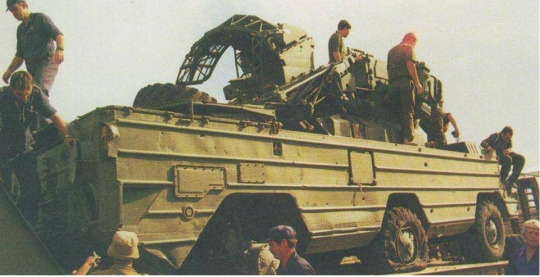
The battle resumed in mid January as the SAAF opened up with airstrikes against the Angolan positions. Though the SADF advanced, the positions were handed over to UNITA forces and soon lost to counterattacks. By early February, the battle had resumed in earnest. The SAAF employed more glide bombs to destroy the bridge across the Cuito River, and, sensing the threat to the airfield at Mavinga, an air defense network (ironically composed of both domestic SAMs and captured 23mm AAA and an SA-9) was established around the town. Though modest, the network did seem to work. The SA-9 battery managed to damage a MiG, and the Angolans almost immediately learned to avoid the town altogether. Meanwhile, 12 F1AZs of 1 Squadron were shifted up to Rundu in preparation for the next stage of Hooper.
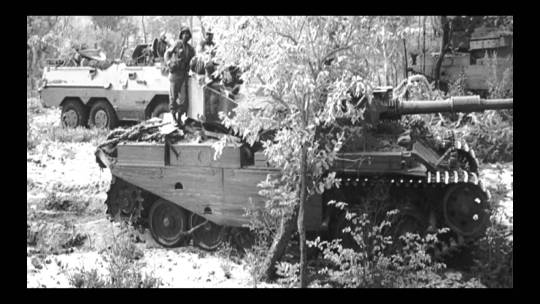
As the SAAF shifted its focus east, SWAPO took advantage of the chaos to launch a terrorist attack. On February 19, a bomb exploded at Oshakati, and the SAAF was tasked with retaliating against SWAPO training centers near Lubango. Two flights of F1AZs were tasked with executing two separate strikes the next morning. The first flight, making a toss-bombing attack, missed the target due to a navigational error. The second attack hit its mark, however, and all aircraft returned home safely. Back on the battlefield, the SADF was pushing forward as F1s continued to provide air support. On the afternoon of February 20, F1s were sortied to attack an enemy column on the Menongue-Cuito Cuanavale road. Although they executed the standard toss-bombing profile that normally kept them out of harm’s way, the Angolans had set up a trap, placing an SA-9 battery just under the pitch-up point for the attack. As an F1 flown by Major Ed Every broke off, a missile locked on, striking the aircraft as it reached low level. Though an intense SAR operation was launched, it soon became clear that Every had not survived.

By now, the Angolans had free reign over the skies. MiGs kept the SAAF away, allowing Angolan aircraft to bomb the SADF forces with impunity. Everything the MPLA had suffered in the previous years was now inflicted upon the SADF. Vehicles had to remain dormant and hidden during the day for fear of enemy air attacks, and artillery could only be fired at night, lest they expose their position to the prowling enemy fighters. Two dogfights broke out on February 25, both involving formations of two F1AZs being intercepted by two MiG-23s. The F1s turned to engage both times and in the later case succeeded in getting into a firing position, but the MiGs made use of their better acceleration to escape. Though the F1s made it home alive each time, such engagements forced them to jettison their external stores and abandon their missions. By March, it was clear that Hooper had failed. The MPLA/Cuban bridgehead remained, and all momentum had been lost.
One Last Push - Operation Packer
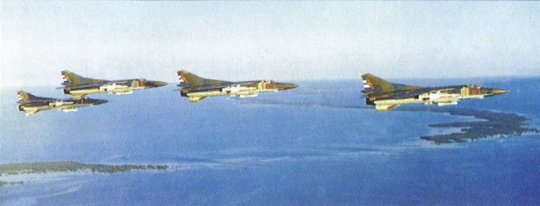
On March 12, the SADF launched Operation Packer. Packer’s aim was identical to Hooper - drive the enemy off the east bank of the Cuito - but the time table was a bit ambitious - it called for this to be accomplished in just 8 days. Before the operation even began, there seemed to be little chance of success. Cuban MiGs hit SADF supply lines on March 9, and the SAAF could do little to respond. Air support for Packer wouldn’t come until March 19, when six F1AZs were ferried back to Grootfontein to launch a late-night diversionary attack on Longa. Though just a day before the operation was set to end, the hope was that the belated attack would divert enemy resources away from the planned axis of attack. Unfortunately, even nighttime could no longer protect the F1s. The formation attacked the target successfully, despite poor weather, but as they crossed the Cutline a SAM streaked up and plucked another MiG out of the sky. As with the previous loss, this crash would be fatal - Major Willie von Coppenhagen was killed as the aircraft crashed through the trees.
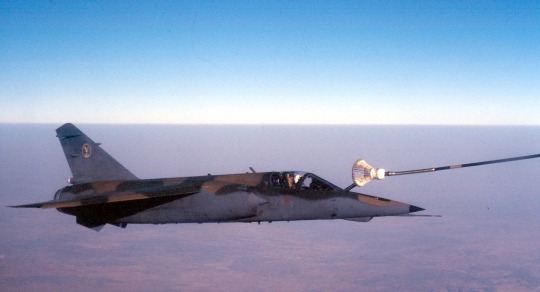
The deadline for Packer came and went, with the SADF/UNITA forces still far from their objectives. Packer was extended into the next month, but poor weather would preclude any offensive operations for the next two days. Offensive sorties resumed on March 23, despite the still terrible weather. Coming in at 100 ft, three F1s made a toss-bombing attack at dawn, marking the last F1 sortie of the war. Two days later, the F1s were stood down and returned to South Africa. Although Packer nominally continued until the end of April, the battle had ground to a stalemate by the time the F1s flew their last sortie. With international pressure peaking, South Africa’s time in Angola was coming to an end. The Cubans and MPLA remained on the east bank of the Cuito, but there was nothing more that could be done.
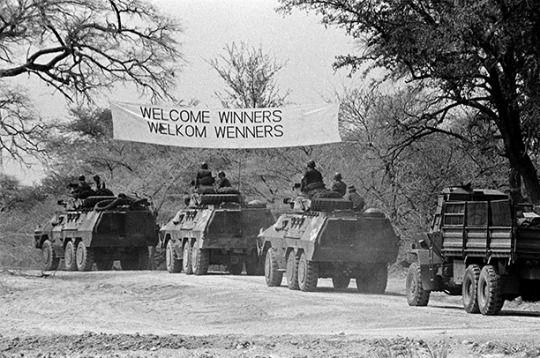
The Battle of Cuito Cuanavale was a mixed bag for the SAAF. 794 sorties had been flown, dropping over 4,000 bombs and encountering at least 112 missiles from SA-2, -3, -6, -7, -8, -9, -11, -13, -14, and -16 systems, and enemy losses were estimated to be about 5,000. However, the SAAF was clearly outmatched. The Angolan Air Force had flown 1,200 sorties during the same time, and they managed to keep a continuous presence over the battlefield. Their particularly aggressive stance and comparatively poor training meant that they would suffer losses (8 MiG-23MLs lost between September 1987 and April 1988, including two to friendly fire), but they for the first time in the country’s history held air superiority over their enemy. The SAAF had lost only four of their own men and two fighters, but was wholly unable to support the offensive operations after Moduler. Air transport operations to Mavinga were limited to night sorties due to the threat of MiGs, meaning that supply lines were incredibly vulnerable.
An End to the War

As Packer ground to a stalemate, the SADF gradually began withdrawing its troops. Keeping a facade up on the front, they moved UNITA into their positions as the bulk of the forces withdrew. Meanwhile, negotiations that had been going on since the beginning of the year finally seemed to be making headway. As Packer came to an end, the Cubans launched an armored division towards Ruacana on the west end of the Cutline, and radars began to pick up enemy MiGs day and night. However, the thrust seemed to be a feint - they stopped 50km from the border without any SADF reaction. Packer gave way to a concerted withdrawal effort - Displace - at the end of April, lasting until the end of August. Meanwhile, the SAAF performed several operations of their own. A highly publicized fighter training excercise was performed in Ovamboland,, while more discreet photo-recon missions by Mirage IIIs were flown over the border. At the same time, supplies were flown into UNITA, who was now going to have to fight without direct SADF intervention.
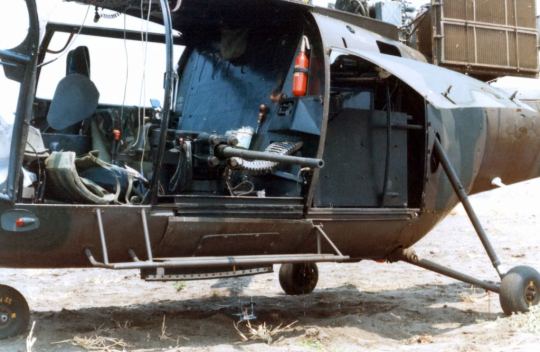
In the end, the Border War would come to an end not through military but political means. In May 1988, US and Soviet leaders met in Moscow to declare that the Cubans would leave Angola and Soviet aid for the MPLA would end if South Africa left Namibia. By December 1988, the New York Accords were drawn up, and on December 22, 1988, Cuba, Angola, and South Africa agreed to the UN Resolution 435, which called for a South African withdrawal from Namibia and UN control over the country for a transition to independence. And that should have been that. The SADF spent the first half of the next year withdrawing, but on April 1 - the day the resolution took effect - SWAPO launched another offensive. Intense fighting occurred, during which SWA police were horribly outgunned and the SADF was forced to sit idly by until permission to engage was finally (and belatedly) given. As part of the SADF reaction, the final fixed-wing combat sorties of the war were flown by an Impala striking SWAPO positions. The fighting came to an end eventually, but at the cost of almost 400 lives. Ultimately, this was the last major incident of the border war. Minor disturbances along the border continued through the transition period, but in November 1989, Namibia finally held its first free elections in the country’s history. By the next year, Namibia was fully independent.
Epilogue
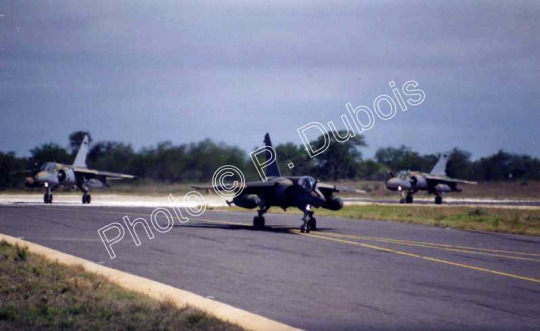
As with nearly every war in Africa, there would be no “happily ever after” the punctuate the end of the Border War. Namibia transitioned to independence better than many nations had, but the end of foreign involvement in Angola would not spell the end of the war. Political reform briefly showed promise at ending the war, but ultimately UNITA continued to fight on. Only in 2002 did the Angolan Civil War finally end with the death of Jonas Savimbi and dissolution of UNITA. Fortunately, the South Africa that had fought the Border War and been the source of such controversy for so long wouldn’t very long after the war. In 1994, Apartheid came to an end, and the country held free elections for the first time in its history. The end of Apartheid was a mixed blessing for the SAAF. Sanctions were lifted, meaning the beleaguered SAAF could finally update its obsolete inventory, but with no more war to fight and a much reduced threat from their neighbors, South Africa slashed budgets. Obsolete aircraft like the Canberra were withdrawn almost immediately, and the 15 surviving Buccaneers of 24 Squadron were retired in 1994. Five squadrons in total would be retired. Meanwhile, the Angolan Air Force has remained strong. Still forced to fight UNITA, they maintained a large inventory of aircraft to get the job done.
8 notes
·
View notes
Text
/k/ Planes Episode 86: Something Something Danger Zone

It’s time for another episode of /k/ Planes! This time, we’ll be looking at the wonderful world of swing-wing aircraft.
The effects and benefits of swept wings would be known since the 1930s, but it wouldn’t be until the very end of WW2 that they would start to be relevant. Soon, the compromises of such wings were recognized, and at least one attempt was made to address it - Messerschmitt’s P.1101. The P.1101 was designed around a novel concept - adjustable wing sweep. Although only adjustable on the ground, it would allow for the aircraft to be adjusted based on the planned mission profile for better performance. This concept was seized upon by the US postwar (particularly the USN), resulting in several tests with swing-wing aircraft capable of adjusting wing sweep in flight. However, the various flaws in early systems would delay the concept’s acceptance until the 60’s, when skyrocketing loaded weights coupled with a renewed emphasis on short-field performance finally made the variable-geometry wing practical. The swing-wing offered numerous advantages - high wing sweeps could be retained for optimal high-speed flight, while low-speed performance could remain relatively uncompromised and cruises could be made more efficient. Unfortunately, the disadvantages of the systems would never be fully eliminated. Wing sweep mechanisms were heavy and often difficult to maintain, and changing the wing sweep affected the center of pressure, which, coupled with the center of pressure shift caused by supersonic flight, could lead to control issues. Unfortunately, these issues would mean the swing-wing’s reign was brief. The onset of fly-by-wire controls and relaxed stability offered similar advantages for far less weight and complexity, and slowly, the swing wing’s days came to an end. The last production swing-wing aircraft - the B-1B and Tu-160 - would fly in the 80’s, and, although proposals for variable-geometry wing platforms survived into the next decade, no new swing-wing designs have come to fruition.
Messerschmitt P.1101
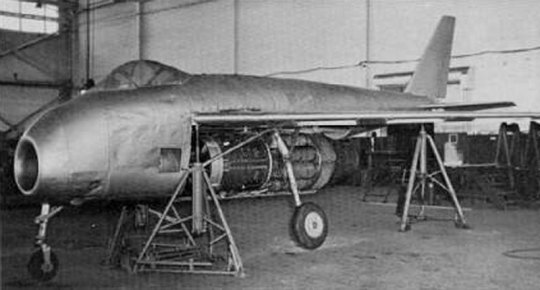
Designed in response to the Emergency Fighter specifications issued in 1944, Messerschmitt’s P.1101 project was originally unremarkable. As originally envisioned, it was a simple pod-and-boom jet fighter making use of a mid-mounted compound sweep wing. By August, it had been revised to use a simple 40 degree swept wing, and soon enough this was further changed to make use of variable-sweep wings. Although there was no mechanism for changing the wing sweep in flight, the P.1101 was designed to be quickly convertible between wing sweep angles of 35, 40, and 45 degrees. It would not be selected as the winner of the Emergency Fighter Program (losing to the Ta 183), but the significant progress made on the design by that point convinced the RLM to fund further development. As the war worsened, work on a prototype began, making extensive use of parts from other aircraft. The landing gear was salvaged from Bf 109s, while the variable-sweep wings were taken from an Me 262. Unfortunately, the factory was overrun by American troops with the prototype only 80% finished. Though Messerschmitt engineers lobbied for the prototype to be completed by the Americans, it would never do so in its current form. It would not be a complete waste, however - it was eventually shipped to America, making its way into the hands of Bell in 1948.
Bell X-5

When Messerschmitt’s P.1101 was shipped to America, it caught the attention of the engineers at Bell. Though the aircraft itself was too heavily damaged from transit, Bell would seize upon the most interesting aspect of the design - the variable-sweep wings. Although the P.1101 could only sweep its wings with the help of ground crews, Bell felt the concept could be taken a step further. Soon after they got their hands on the P.1101, Bell proposed a tech demonstrator based off of the design that would be able to change the angle of the wings in flight. Bell’s final proposal drew heavily on the P.1101, retaining much of the aircraft’s general appearance while scaling it up in size to accommodate the wing-actuating systems. The system for moving the wings involved a jackscrew that would not only rotate the wing, but also move the root forward or aft as the wing rotated. The wing was designed to switch between three sweep angles - 20, 40, and 60 degrees. The design was approved by the Air Force in early 1949, and two prototypes were ordered as the X-5.

Both X-5 prototypes would take flight in June 1951, flying with NACA. The results of testing were mixed. The changing sweep did validate predictions about the effects of variable wing sweep on high-speed flight, but the aircraft itself had numerous issues. The changing of the sweep in flight made control difficult, as the center of pressure would shift with the wing sweep. Further complicating this was the choice of the pod-and-boom layout led to vertically unbalanced drag and thrust and dangerous stall characteristics. The poor aerodynamic design of the aircraft would ultimately lead to a crash in 1953 when one X-5 entered a stall with the wings set to 60 degrees. Ultimately, the X-5 program would continue until 1955. Though the general concept of a swing-wing aircraft was validated, the X-5 itself had proven entirely unsuitable for operational use. Worse, the system of pivoting the wings within the fuselage was unsatisfactory.
Grumman XF10F Jaguar
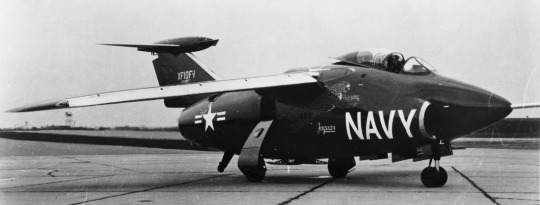
Emerging research into the effects of swept wings and the rising takeoff weights of fighters would lead the Navy to look into the development of a swept wing fighter at the end of the 1940s. Although the USAF and NACA were involved in the development of Bell’s swing-wing concept, the Navy wanted a platform more readily available for operational use. Thus, they looked to Grumman, requesting the development of a swing-wing testbed that could be turned into a fighter. Designated the XF10F, the new fighter was a shoulder-winged single-engined design with a T-tail and cheek intakes. Apart from the novel wing actuating mechanism (which worked similar to that of the X-5), it made use of a free-floating horizontal stabilizer (controlled by smaller surfaces that disturbed airflow over the tail) and the experimental XJ40 turbojet. Though the design was entirely new (rather than a development of an existing design as with the X-5), development went surprisingly fast - the XF10F would take to the skies in May 1952, less than a year after the X-5.

The Navy was incredibly enthusiastic about the Jaguar before it even took flight. Recognizing the superiority of swept-wing fighters after encounters with the MiG-15 in Korea, the Navy ordered 131 F10Fs and made plans for rapid full-scale production. Unfortunately, the test program quickly proved this to be a poor decision. In addition to the issues associated with the shifting center of pressure also encountered on the X-5, the XF10F had similarly poor stall characteristics. The unique horizontal stabilizer was far less effective than envisioned, leading to poor control response times and unpredictable pitch authority. Worse, the XJ40 engine the aircraft was built around was itself proving to be a failure. Oddly enough, it seemed the wing sweep mechanism was the only part of the aircraft that wasn’t prone to mechanical failure. Although Grumman solved the issues with the tail surfaces by mounting a more conventional horizontal stabilizer, it would not be enough to save the program. After less than a year of testing, the Navy cancelled the XF10F program in April 1953.
Tactical Fighter Experimental - TFX
In 1957, the USN began developing requirements for the next generation strike aircraft. Looking to British NA-39 requirements (which would produce the Blackburn Buccaneer) for guidance, the Navy was soon expanding their horizons to a multirole design making use of variable geometry wings. In 1959, USAF Tactical Air Command had developed similar requirements - a long-range supersonic multirole aircraft with an emphasis on low-level strike and the ability to operate from unprepared airfields. As projections for conventional fixed-sweep aircraft showed that the loaded weight of such a design would be in excess of 100,000lb, the new USAF requirements would also call for variable-sweep wings. The parallel requirements caught the attention of Secretary of Defence McNamara, who combined them into a single program - the TFX - in 1961. From the start, the program would meet resistance. Though both services wanted a swing-wing aircraft, that was about all they could agree on. The Navy wanted side-by-side seating and an emphasis on air-to-air duties for use as a fleet-defense interceptor, while the Air Force was hoping for a tandem-seat low-level penetration interdictor. Ultimately, these diverging requirements would lead to the Navy’s withdrawal from the TFX.
Republic/Vought TFX

Republic and Vought would team up for the TFX program, modifying Republic’s design that had been developed with Fokker for the NBMR-3 STOVL fighter requirements. The new proposal shared much with the STOVL D.24 Alliance pitched to NATO - it had a crew of two in tandem and an unusual delta wing that the swing-wings would fold back onto for high-speed flight. Other notable elements - such as small internal bays for AIM-9 Sidewinders - were also retained. However, the single massive BS100 engine of the D.24 gave way to two conventional engines fed by intakes in the roots of the wings. To meet range and payload requirements, and to accommodate the new engines, the D.24 design was scaled up. Unfortunately, the proposal would not be accepted for further development. Unlike the D.24, it wouldn’t even make it as far as a mockup.
Boeing Model 818
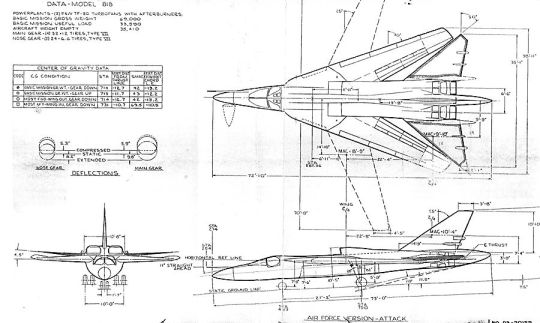
Boeing’s TFX proposal was the Model 818. Immediately apparent from looking at the proposal are the unique dorsal engine intakes, likely an attempt to reduce wasted space in the fuselage. The crew sat in a side-by-side cockpit in individual ejection seats, while the wings pivoted in a narrow glove between 25 and 70 degrees. The USAF variant would differ from the Navy’s Model 818N mainly in changes to the nose and tail. The Model 818N made use of a smaller nosecone and eliminated the “stinger” that extended rearwards beyond the tail. In addition, it featured avionics for the AIM-54 missile and a probe for aerial refueling. Although the dorsal intakes were undoubtedly a questionable choice, the design otherwise was sound. When presented to the selection board, the Model 818 (along with every other proposal) was found unacceptable. However, with some changes (namely to the engines, missile storage, and the use of an escape capsule for the crew), it was resubmitted. The Air Force would prefer the Model 818 over the competing General Dynamics proposal, while the Navy found both designs to be unacceptable. Ultimately, it would go on to win all four stages of the selection competition. Unfortunately, Boeing would fall victim to McNamara’s decisions. Despite being favored at every single stage of development, McNamara went against the wishes of the selection board and awarded the contract to General Dynamics on grounds that there was greater commonality between the USAF and USN variants.
General Dynamics F-111A/D/E/F Aardvark

The original General Dynamics proposal closely resembled the final product that would enter production. The crew sat side-by-side in a special ejection capsule, and semicircular shock cone intakes similar to those seen on the F-104 were used. Though deemed unacceptable in the first round of evaluations, General Dynamics’ proposal would be selected alongside Boeing’s Model 818 for further development. Through four successive rounds of evaluations, the design morphed - leading edge root extensions extended over the tops of the intakes, and minor revisions to the tail brought the all-moving stabilators on same plane as the wings. By 1962, things weren’t looking good for the General Dynamics proposal. Both the USAF and USN were favoring the Model 818, and General Dynamics had lost every round of the selection process to Boeing. Against the wishes of the selection committee, however, Secretary of Defense McNamara would choose General Dynamics’ design as the winner of the TFX. The reason for the selection was the anticipated savings associated with General Dynamics’ design, which was to have up to 80% commonality between the USAF and USN variants.
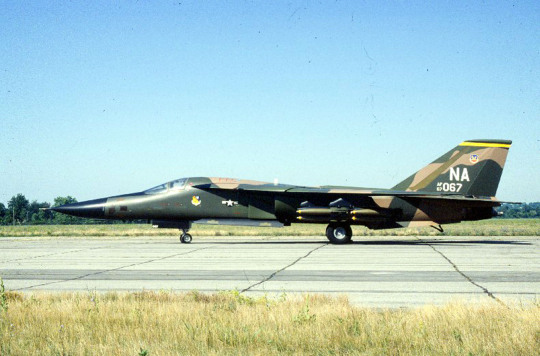
Two years after being selected as the TFX winner, what was now known as the F-111 took to the skies for the first time. The F-111A - the USAF variant - began its troubled test program at the end of 1964. The F-111A came in significantly overweight, and testing was continually plagued with issues relating to the reliability of the TF30 turbofans and poorly designed intakes. The engines in particular were problematic, exaggerating the negative effects of the aircraft’s excess weight due to early TF30s producing less than their rated thrust. Outside of the reliability and weight issues, however, the F-111A showed promise - an advanced avionics and navigational suite included cutting-edge countermeasures and a terrain-following radar, and a combination of an internal bomb bay and wing hardpoints allowed the F-111A to carry up to 20,000lb of stores. If the situation required, fuel tanks could be mounted on every hardpoint and in the internal bomb bay, further extending the already impressive range of the Aardvark. Even with the weight and engine issues, the F-111A was hardly sluggish - it could easily break the sound barrier at altitude, and it was even capable of performing low-level supersonic dashes.
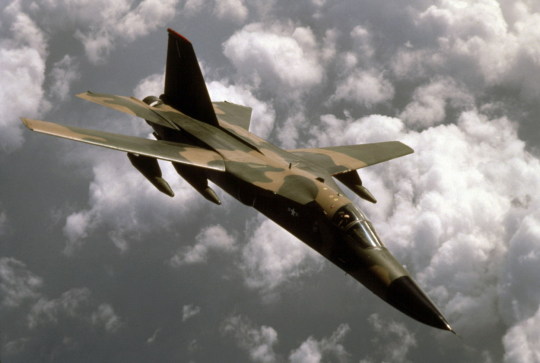
The first F-111As would make their operational debut in 1968, when TAC deployed six aircraft to Thailand. This first deployment had mixed results. Though the missions generally went well considering the F-111As were sent out alone on poor-weather precision strikes, three F-111s were lost in just 55 sorties to accidents. By the fall of 1968, surviving F-111As were sent back to the US. They would return to Southeast Asia in 1972 as part of Operation Linebacker, this time with a force of 48 aircraft. With the kinks ironed out, the F-111A now performed spectacularly. The F-111 consistently showed that it could hit heavily defended targets with impunity, flying without escort and reaching targets without the need of a tanker. Over seven months, they flew more than 4,000 sorties for the loss of just six aircraft. They continued to fly strikes into Laos and Cambodia in 1973, and in 1975, the flew arguably the last combat sorties of the Vietnam War. As part of the Mayaguez Incident, F-111A made use of their powerful radars to find the hijacked SS Mayaguez, and ultimately they managed to sink a Cambodian gunboat.

By the end of the Vietnam War, the first round of upgrades to the F-111 were beginning. TAC had ordered the upgraded F-111D in 1967, aiming to install new avionics, a glass cockpit, newer engines, and revised intakes on the F-111. As a stopgap while the complicated F-111D was developed, the simpler F-111E was also ordered. The F-111E incorporated the simpler elements of the F-111D, such as the revised intakes and modified stores management system, but retained the old engines and avionics package. F-111Es began deliveries in 1969, but they would never be replaced by the ambitious F-111D. The F-111Ds proved too complicated and unreliable, and, despite continuing efforts to upgrade them throughout their lives, they never attained a high serviceability. In 1969, a new, less ambitious upgrade package was ordered - the F-111F. The F-111F made use of an improved avionics suite derived from the FB-111A, eliminating strategic bombing modes and replacing them with elements more suited to tactical strike. The intakes were improved once more, and newer TF30 engines provided more thrust than those on the F-111A and -E. Unusually, they also were given the ability to mount the AIM-9 Sidewinder, although it appears this was never used operationally.
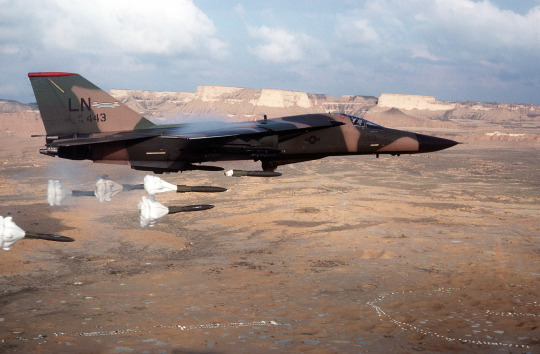
The F-111F would come to be the backbone of the USAF F-111 fleet by the end of the 1970s. The next operational use of the Aardvark would come in 1986, when F-111Fs flying out of the UK supported strikes on Libya as part of Operation El Dorado Canyon. Unfortunately, one F-111F was lost to Libyan air defenses during the attack. The next major operation involving the F-111 came in the 1991 Gulf War. Before the main part of the Desert Storm air campaign began, F-111s were tasked with hitting strategic targets in low-altitude interdiction missions. Once the ground offensive started, they took to more aggressive roles - SCUD hunting, suppression of airfields, and tank plinking. The F-111’s performance as an anti-armor platform was nothing short of spectacular. Equipped with PAVE TRACK IR pods and laser designators, the 66-plane F-111 force was credited with the destruction of over 1,500 Iraqi AFVs, primarily with GBU-12s. Although the F-111 was supplemented by the F-15E during the campaign, it did have its niches. During Desert Storm, it would be the only aircraft to deploy the GBU-15 and the 5,000lb GBU-28 Bunker Buster. Unfortunately, the F-111’s career after Desert Storm was limited. The F-15E had arrived to replace it, and, thanks to the post-Cold War drawdown, surviving F-111A/D/E/Fs were retired by 1995.
Vickers Supermarine Type 583

One of the better known Vickers swing-wing design studies would emerge out of a Royal Navy requirement for a new carrier-based fighter to replace the de Havilland Vixen. Given the comparatively small size of Britain’s carriers, excellent low-speed performance was an absolute priority. To avoid compromising the machine’s combat abilities, Vickers Supermarine opted for an advanced swing wing design. The Type 583 that materialized had a high-mounted variable-geometry wing fitted with advanced blown flaps to get the best possible low-speed performance. Power was to be provided by two Rolls-Royce Spey engines in the rear of the fuselage fed by intakes just forward of the wings. Owing to intended role of fleet-defense interceptor, the Type 583 would have a crew of two in tandem and a powerful radar in the nose. When NATO issued their NBMR-3 requirements for a VTOL strike fighter, Vickers Supermarine chose to adapt the design to meet those requirements as well. Replacing the two Speys with a single BS100 lift/cruise engine, the Type 583V had a significantly revised fuselage and reduced crew of just a single cockpit, but it retained the characteristic swing wings of the design.

Unfortunately, the Type 583 would fall victim to changing requirements and slashing budgets. The RN’s requirements for a fleet-defense interceptor were merged with an RAF request for a fighter-bomber to replace the Hawker Hunter, and the government seemed to be favoring the competing Hawker P.1154. The VTOL Type 583V would end up being rejected by the NATO commission, though probably for the best - the three diverging requirements the P.1154 hoped to meet ended up being one of the main causes for the end of the project. Not having to worry about accommodating STOVL flight, Vickers Supermarine had a better chance at creating a common airframe. However, they would never have a chance to validate their design. Though the Royal Navy had pulled out of the competing P.1154 in 1964, they seemed more concerned with a foreign design - the F-4 Phantom - than they were with the Type 583. The death knell of the Type 583 came in 1966. In one fell swoop, the 1966 Defense White Paper practically dismantled the British military’s hopes and dreams. Countless projects, including the P.1154 and the CVA-01 carriers the Type 583 was designed around, were cancelled, and the gaps left by all the cancelled domestic projects were to be filled with foreign (primarily American) designs. The Royal Navy selected the F-4 Phantom for their new fleet defense interceptor, once and for all killing the Type 583.
General Dynamics ATF Design Studies
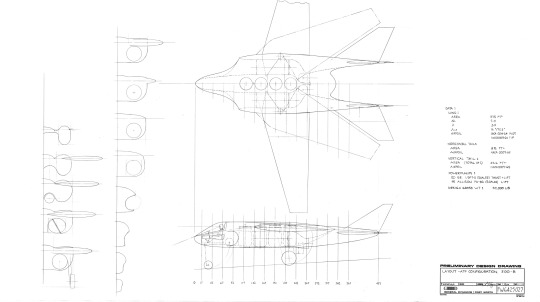
Seizing on the emphasis for short-field operations in the mid-1960s, General Dynamics created several unusual design studies for swing-wing STOVL fighters equipped with lift-jets. The design studies greatly varied in just about every aspect. Size, number of engines, and likely role varied across the designs. For example, the compact 300-B study made use of four PD-82 lift engines and two lift/cruise engines in a compact design that seemed to leave little room for any mission-related equipment. A short nose provided no space for a radar, and, with a gross weight of 30,000lb, there likely would have been little room for payload once the cockpit, six engines, and wing sweep mechanism was accounted for.

Other studies, like the 506 design, were larger and more practical. The 506 made use of four lift engines and two cruise engines as well, but did so in a much larger airframe. Lift engines were spread out (three behind the cockpit and one in the tail), and a large nose provided space for a radar and a crew of two. A spacious fuselage seemed to provide room for an internal weapons bay, and, with a VTOL gross weight of 45,000lb (or STOL weight of 55,000lb), the 506 design study likely would have been a more capable combat platform. The 508A took things a step further, adding thrust-vectoring nozzles to the cruise engines of the 506 design, likely bringing the VTOL potential up even higher. As with nearly every VTOL design study of the time, however, none of these projects would ever come to fruition.
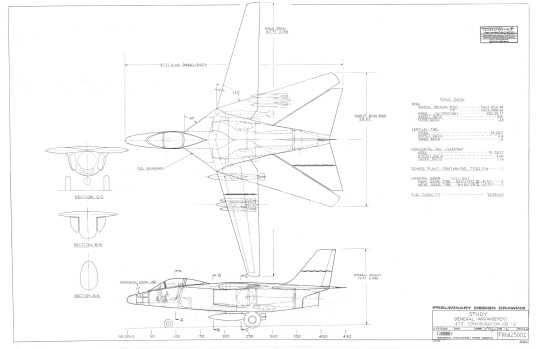
The “102” design study stands out among the other ATF designs in that it did not pursue STOVL operations. Rather, it appeared to be a compact attack platform along the lines of the A-7 Corsair. It made use of a single TF30-P-6 engine (as used on the F-111) mounted in the rear fuselage, and the nose was large enough to fit attack-related electronics. Making use of experience with the F-111, General Dynamics would plan to have five hardpoints on the “102” - one ventral hardpoint on the fuselage and two fully-rotatable hardpoints on either wing, allowing the aircraft to make the most of its wing sweep mechanism without compromising performance.
Lockheed CL-507
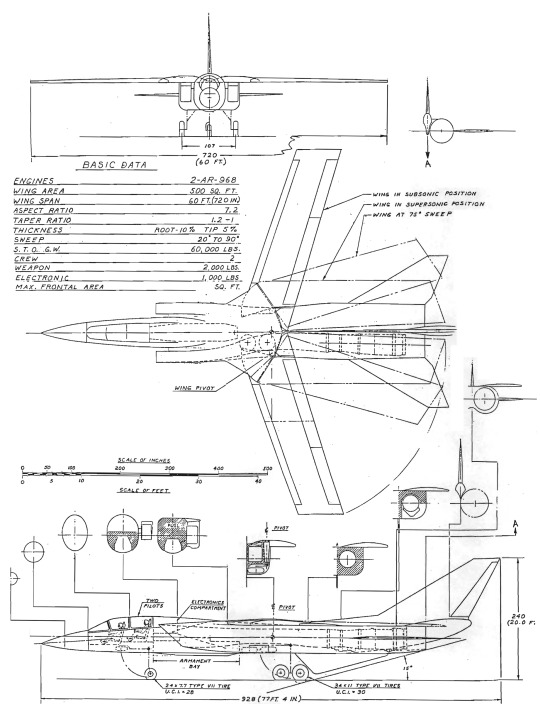
Sometime in the 1960s, Lockheed’s engineers produced the CL-507 design study. The CL-507 was considerably advanced for the time - weapons were to be carried in an internal bay (partly a consequence of the lack of space on the wing gloves for pylons), and significant space was allocated for electronics. Though its intended role is not clear, the allocation of a second crewman indicates that it was likely intended to be an interceptor. One of the more notable features of the design was the extent of the wing folding. Three positions detailed in the study include the standard low-sweep arrangement for subsonic flight, a 75 degree sweep for high-speed flight, and a 90 degree sweep - presenting none of the leading edge to oncoming airflow - for supersonic flight. Unfortunately, this unusual and interesting machine would never leave the drawing board.
Fokker/Republic D.24 Alliance
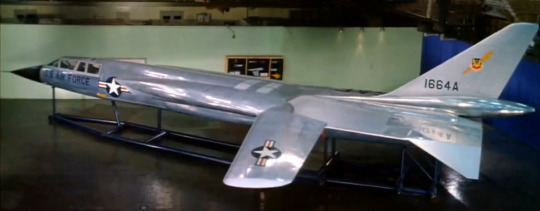
When the NBMR-3 requirements were issued for a STOVL supersonic fighter, Republic teamed up with Fokker to produce an unusual swing-wing contender. Sharing much with the domestic proposal for the TFX (F-111) program, the resulting D.24 Alliance made use of both swing-wings and a delta wing. Power was to come from a single Bristol-Siddeley BS100 lift/cruise engine, fed by large intakes placed on the underside of the forward fuselage. At least some armament was to be stored internally, as the mockup presented to the public featured retractable AIM-9 stations in wing gloves. Looking back, however, the D.24 was likely a bit too advanced for its own good. On top of meeting the established requirements for a STOVL supersonic fighter, the multinational team was hoping to incorporate yet-unproven swing-wings on an incredibly unconventional layout. In the end, the D.24 would never progress beyond the mockup stage - NATO officials instead opted for the more conservative and promising Dassault Mirage IIIV and Hawker Siddeley P.1154.
Vickers Supermarine Type 581/589
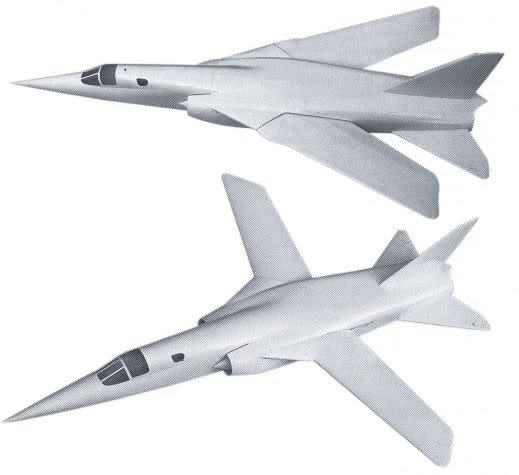
Vickers’ next most significant swing-wing design studies had their origins in Operational Requirement 346, issued in 1959. Calling for a multirole strike aircraft for the Royal Navy, the requirements would necessitate the use of variable-geometry wings to meet the performance specifications. Design studies worked off of the single-engined Type 571 (what would become the TSR.2), sharing much of the fuselage but incorporating entirely new swing wings. These gradually morphed into the Type 581 - an unusual aircraft lacking horizontal stabilizers and instead relying on a lift engine behind the cockpit to provide pitch control when the blown flaps were in use. The Type 581 would morph into the more conventional Type 589, which returned to conventional tail surfaces. By then, the Navy had withdrawn its support, but the RAF had now gained interest. No longer limited by the weight restrictions of the RN, the weight (and payload) of the aircraft soared, almost reaching 30,000lb of stores by its final iteration. Although a mockup was presented to the RAF in 1960, the Type 589 would never take to the skies as originally designed. Rather, it formed the base for the AFVG and eventual Panavia Tornado, which would finally fly almost a decade and a half after the Type 589 was finalized.
General Dynamics/Grumman F-111B
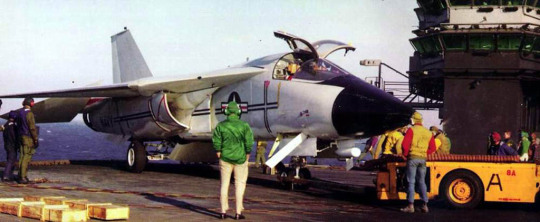
For the navalized variant of the F-111, General Dynamics teamed up with Grumman, who had far more experience with naval aviation. The USN’s version of the aircraft, the F-111B, required significant changes from the F-111A. The nose had to be shortened to make the aircraft small enough to fit in carrier hangars and widened to mount the AN/AWG-9 radar for air intercept duties. The wings were lengthened, bringing the wingtips flush with the horizontal tail when fully swept, increasing the wing area to get stall speeds low enough to meet carrier requirements, Additionally, the landing gear was strengthened and arrestor gear was added. Intended armament was to be six AIM-54 Phoenix AAMs (two in the bomb bay and four on the wings). Though six hardpoints were fitted on the wings, the outermost hardpoints could only carry a drop tank. Though met with great resistance from the Navy, the design soldiered on, finally taking flight in 1965.
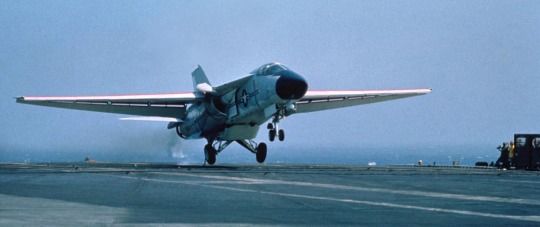
Unfortunately, the F-111B proved a disaster from the start. All the issues of the F-111A - poor inlet design and unreliable, underpowered engines - were present on the F-111B, but the excess weight was even more apparent. Initial weight projections were found to be grossly inaccurate, and, despite attempts to cut weight, the F-111B remained far too heavy. The desperate attempts to save weight did succeed in undermining the critical feature that got the F-111 selected for production in the first place - parts commonality. As the Grumman/GD team worked to reduce weight, parts commonality with the F-111A dropped from 80% to just 30%. Meanwhile, the F-111B remained grossly overweight and entirely unsatisfactory, and Navy interest was waning with every day. By May 1968, Congress had cut funding for the F-111B, and the program was formally cancelled in December. Testing continued beyond the official cancellation, culminating in carrier trials. Four F-111Bs would continue flying as testbeds for the AIM-54 until 1971.
Sukhoi Su-17/20/22 “Fitter”
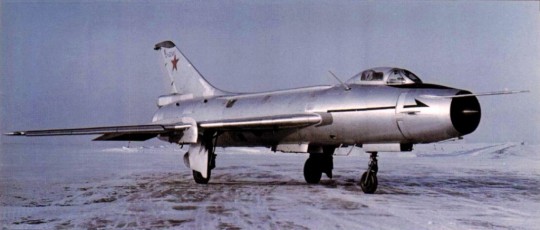
By the early 1960s, the VVS had shifted its focus towards improving short-field capabilities of their aircraft. The primary attack aircraft of the VVS at that time, the Sukhoi Su-7, was hardly suited to such operations, and simpler efforts to improve short-field performance - RATO gear and brake parachutes - did little to improve the situation. Thus, Sukhoi was forced to pursue a more extensive reworking of their fighter. Other OKBs were experimenting with vertically mounted lift jets, but the Su-7 lacked the space and payload to waste on such a system. Rather, following TsAGI recommendations, they looked towards variable-geometry wings as a solution. Sukhoi modified an Su-7BM as a testbed, becoming the S-22I. The S-22I was notably different from western variable-geometry designs - to minimize changes to the design, only the outer wing sections were changed, allowing Sukhoi to preserve the wing hardpoints and landing gear of the Su-7. The S-22I took flight in 1966, becoming the very first Soviet variable-geometry jet to take flight.
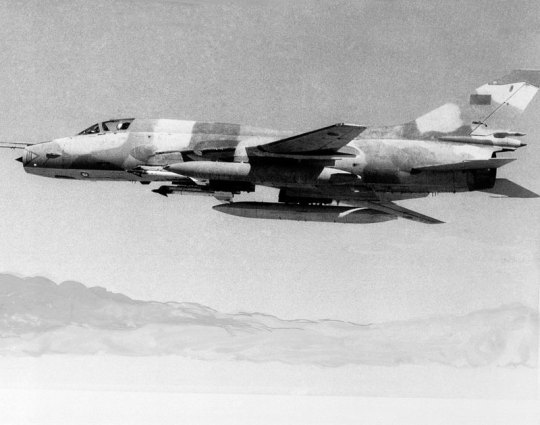
Trials of the S-22I continued for a year, demonstrating excellent performance. The takeoff and landing roll of the Su-7 was halved, and, although the empty weight had increased and internal fuel tanks were reduced, the S-22I had a slightly longer range than the Su-7. By the end of the year, it was approved for full production as the Su-17. The production Su-17 would incorporate several changes, including the addition of a dorsal spine and updated avionics for navigation and attack. Fuel tanks were also enlarged, and various changes were made to access panels to ease maintenance. Before production lines had even fully converted over to the Su-17 from the Su-7, Sukhoi had already developed an improved variant. The Su-17M would take flight in 1970, differing in that it had the new AL-21F engine and expanded fuel capacity. Avionics were again updated, allowing the Su-17 to carry the newest guided munitions and the AA-2 Atoll air-to-air missile. Entering production in 1972, it would mark a massive improvement over the Su-7, doubling its range and payload.

The Su-17 would rise to be the mainstay of the VVS Frontal Aviation tactical strike force by the end of the 70’s. Though capable of mounting a variety of guided munitions, it more often than not took a simpler approach, carrying a variety of FAB-250/500 unguided bombs or unguided rocket pods. Soviet Su-17s would make their combat debut in Afghanistan, where they performed reasonably well. They flew regular attack missions largely with unguided rockets and bombs, although the occasional guided munition was used. Armed reconnaissance sorties were also common, making use of the latest infrared linescan devices for nighttime missions. The Su-17 proved to be incredibly durable and tolerant to ingestion of sand and dust, keeping serviceability fairly high. However, the hot and high conditions limited payloads to just 1,000kg, and the addition of extra armor only further cut performance. Although it gained a reputation for durability in the war, it was far from invulnerable - 29 were lost in the war (half to accidents) - and the threat of MANPADS fire had forced them to operate at medium altitudes by the end of the war.

Although over 1,000 Fitters were in VVS service by the collapse of the Soviet Union, the fleet wouldn’t last long. Massive budget cuts hit the Su-17 fleet hard, and, although the latest Su-17 variants saw combat in the Chechen Wars, the last Su-17s would leave the VVS inventory in 1998. In foreign service, however, the Su-17 proved to be tremendously popular. Syria’s Su-20s (export version of the aircraft) were the first to see combat, flying about 100 sorties in the 1973 war. There, results were mixed. Low level strikes with unguided munitions and cluster bombs proved effective, but they lost eight machines - half the fleet - to ground fire. Performance in Lebanon almost a decade later was similar - the Su-20 was a capable attack platform, but it remained vulnerable to air defenses. Libya’s Fitter fleet would come to be most famous for being shot down. In 1981, two Su-22s engaged two USN F-14s in the Gulf of Sidra, getting themselves downed in the ensuing engagement.
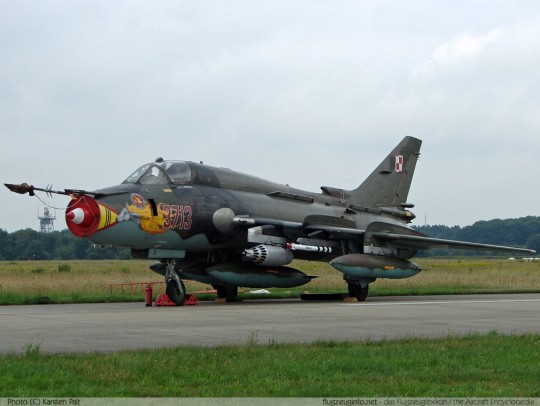
Iraq would extensively employ the Su-20/22 in their war with Iran. Apart from regular attack and strike sorties, they would be the primary platform for chemical weapons attacks. Their showing in the 1991 Gulf War would be catastrophically bad. The bulk of the fleet fled to Iran, and those that remained were either shot down (four) or destroyed on the ground (14). Angola would receive several Fitters in the early 80’s for their conflict with UNITA and South Africa, but they performed poorly. Even with the aid of the Cubans and Soviets, losses due to accidents were high. Nevertheless, the small serviceable fleet would be used extensively (if conservatively) through the end of the war. Due to the cautious employment of the aircraft, their only combat loss came from a UNITA SAM.

Nowadays, most operators of the Fitter have abandoned their fleets. Although the Su-17/20/22 was ubiquitous and Sukhoi was offering various upgrade packages for the fleet, there was often better options for those nations that flew the type. Only Angola, Poland, Syria, Vietnam, and Yemen still fly the Fitter, and only Poland’s fleet can be said to be in good condition. Poland chose to retain their Su-22s after the fall of communism, extensively upgrading them to meet NATO standards. In Polish service, the Fitter seems to have benefited from the vast stockpile of Soviet weapons left over from the Cold War, giving the Poles enough of an excuse to keep it around. Furthermore, they enjoy a higher serviceability than the other two combat aircraft in the Polish inventory (MiG-29 and F-16), and, after the recent round of upgrades, they will likely remain in service well into the next decade.
McDonnell Douglas F-4(FV)S
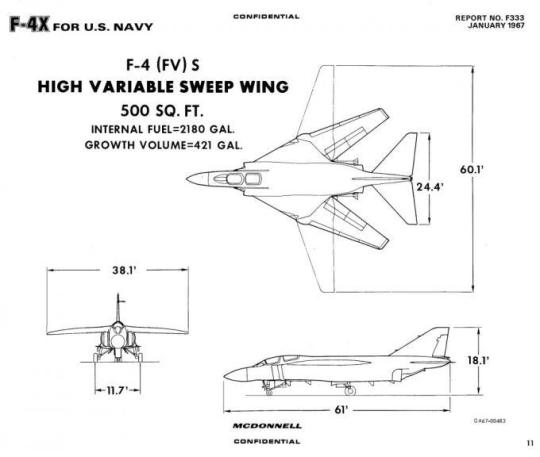
In 1966, sensing the impending failure of the F-111B, McDonnell Douglas produced an interesting new proposal as an alternative to the failing aircraft. The proposed F-4(FV)S would be a radical redesign of the F-4 Phantom, replacing the characteristic low swept wings of the Phantom with a high-mounted variable-geometry wing. Other notable changes included revised landing gear and a flat (rather than anhedraled) tail. Although the proposal offered a cheaper replacement for the F-111B, it was lacking in key areas. The aging AN/AWG-10 radar and AIM-7F missiles of the F-4J the proposal was derived from were retained, and the aircraft was unable to mount the larger AN/AWG-9 radar and AIM-54 missiles that the Navy wanted. After being rejected by the Navy, McDonnell Douglas turned their attention to Europe, pitching the design as an alternative to the ailing AVFG. Unfortunately, the design would be rejected by the British as well, and consequently would never leave the drawing board.
English Electric Sea Lightning
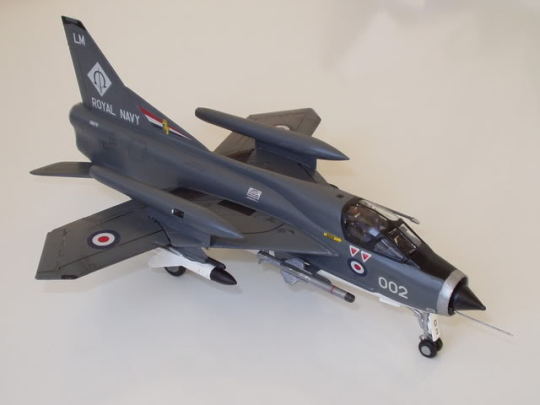
While the Admiralty was looking to equip the fleet with F-4 Phantoms, English Electric came up with their own proposal for a new carrier-based fighter. Using their characteristic Lightning interceptor as a base for their new design, English Electric’s Sea Lighting proposal was perhaps the strangest concept to come from the company. The two-seat T.5 trainer became a base for the new aircraft, with the side-by-side seats making communication between the pilot and RIO easier. To get landing speeds low enough for RN requirements, the distinct wing of the Lightning would be given variable-sweep outer wing sections. The inner section was unmodified, allowing landing gear, and hardpoints to remained unchanged, but the outer section would have more advanced slats and flaps added to improve low-speed control. The preliminary proposal seemed to focus on a quick modification of the wings, although this eventually matured into a refined fleet-defence interceptor proposal with a nose-mounted radar and intakes moved to the cheeks. Two more hardpoints for missiles were added, and more efficient engines and an expanded fuel capacity would hopefully make the Sea Lighting more than the point-defense interceptor that its land-based cousin was. Unfortunately, the Sea Lightning would never be. The Admiralty rejected the proposal, ultimately settling on their first choice - the F-4.
BAC/Dassault Anglo-French Variable Geometry
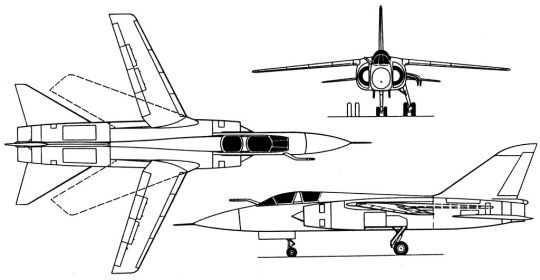
In 1965, Britain and France would come together to develop a two new combat aircraft. The first was to be a combat-capable advanced trainer (what would become the SEPECAT Jaguar) while the other would be a variable-geometry multirole fighter. Based off of earlier BAC design studies, the design was to fill French and British requirements for a high performance strike aircraft (particularly to fill the void left by the cancelled TSR-2), while meeting a British requirement for a replacement for the Lightning and a French requirement for a new carrier-based fighter. Working with Dassault, BAC modified their P.45 design study that the AFVG was based off of, adding Dassault’s distinctive shock-cone inlets and making use of engines jointly developed with the French. The final design was a two-seat aircraft intended to mount two SNECMA/Bristol Siddeley M45G engines. Armament would be two 30mm cannon, and, for the strike role, a single 2,500lb tactical nuclear store would be carried.

By 1966, developments in Britain had radically shifted the focus of the AFVG. F-4 Phantoms were procured to replace the Lightning, and the British hoped to fill the role of the aging Canberra bombers with the AFVG. Meanwhile, the French had been increasingly looking to develop the AFVG as a fighter. Requirements began to diverge, and further political developments (particularly the decision to procure the F-111K) cut into the potential AFVG order, bringing costs up. Although very general specifications were agreed upon in the middle of 1966, the Anglo-French committee was unable to finalize the requirements for the aircraft. Worse, cost projections pointed to skyrocketing expenses and unit costs. France was rapidly losing interest in the project, both due to rising costs and internal pressure from Dassault who was fairly actively working to undermine the program. France would withdraw in 1967, but the cancellation of the F-111K that same year left a massive capabilities gap among RAF strike aircraft. Thus, Britain had no option but to continue work on the AFVG alone. Although they would continue to look for foreign partners, BAC would soldier on alone for the time being to keep Britain’s last strike fighter program alive.
Mikoyan-Gurevich MiG-23 “Flogger”
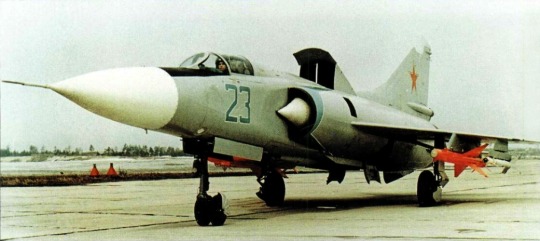
In the early 1960s, MiG was tasked with developing a next-generation fighter for the VVS. In addition to meeting requirements for an improved radar, longer range, and higher payload than the MiG-21 before it, the VVS wanted the new fighter to fall in line with the new doctrinal focus on short-field capabilities. Unlike Sukhoi’s swing-wing design being developed in parallel, the requirements given to MiG could not be met by merely adapting an existing design. Rather, an entirely new aircraft had to be developed. As always, MiG closely followed TsAGI recommendations, developing two designs for the new fighter. The first, working under the proposed designation of MiG-23PD, made use of lift jets to get the desired STOL performance. The MiG-23PD would have an all-new nose and redesigned intakes, but the small delta wings of the MiG-21 it was to replace would remain. Mounted in the center of the fuselage were to be two RD-36 lift jets, and blown flaps would help shorten takeoff rolls. The MiG-23PD demonstrator would fly in April 1967, but tests found it to be unacceptable. Not only did the lift jets create lots of dead weight in flight, but using them for STOL operations was incredibly dangerous and impractical.
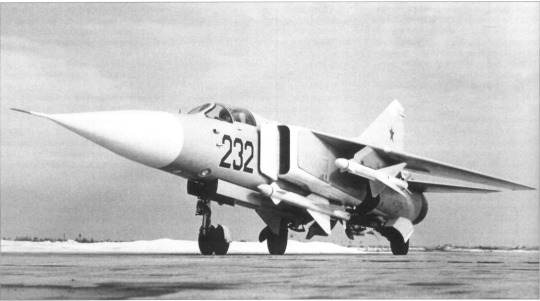
Parallel to the lift-jet equipped prototype, MiG created a second design following another TsAGI recommendation - swing wings. The swing-wing prototype had a similar forward fuselage to the MiG-23PD, but a shoulder-mounted swing-wing was used instead of the impractical lift jets. Other less notable changes included revised inlets and a new tail. This new prototype, which would become the basis for the MiG-23, would fly in June 1967. The swing-wing design was exactly what the VVS wanted - tests went smoothly, and by the end of the year, it had been ordered into production as the MiG-23. The production MiG-23 would be fitted with a ventral GSh-23-2 cannon and hardpoints under the fuselage and wing gloves for 2,000kg of stores (either AAMs, bombs, or the Kh-23 guided missile). Although deliveries of the first production series MiG-23s began in 1969, these early variants would see little use. They were far more complex machines than the VVS was used to, so early production MiG-23s were primarily evaluation platforms for MiG and the VVS to identify and work out teething issues.
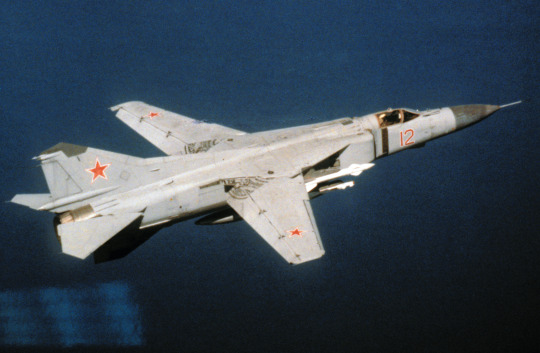
By 1972, MiG had developed the new series MiG-23 that would serve as the basis for all variants to come. Wing area was increased, giving the wings their characteristic “tooth” near the glove, and the tail surfaces were moved aft. The unreliable engine and avionics of the early production models were updated, and a badly-needed rear-view mirror was added. Even with the changes, the MiG-23 still had its problems. It was less agile than the MiG-21, and the complex aircraft was hard on ground crews and pilots alike. However, in the vertical envelope, the MiG-23 performed spectacularly, and its ability to make use of the newest radar guided AAMs made it invaluable. While MiG was always working to improve the Flogger, the MiG-23M fixed enough flaws for the type to finally see widespread service.
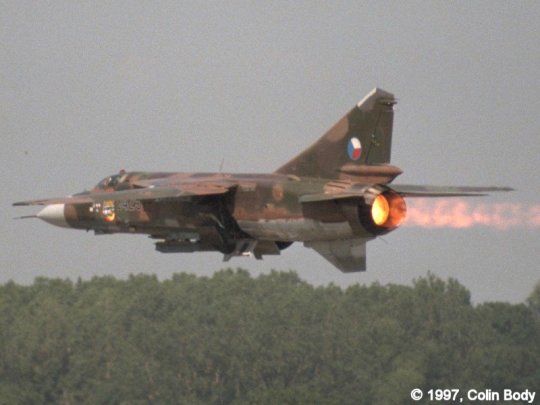
In VVS service, the MiG-23 was ubiquitous but hardly popular due to its alarmingly high accident rate. In the hands of the PVO, who generally flew more docile operations, the MiG-23 was more popular. The MiG-23 made its operational debut in Soviet hands in 1984, when the VVS began rotating squadrons into Afghanistan. They flew escort for strike packages, sat on standby as quick reaction interceptors, and occasionally flew strike missions with dumb bombs. Occasional skirmishes with Pakistani F-16s occurred with mixed results. On one occasion, a Flogger ate two Sidewinders and returned to base under its own power. Over the five years the MiG-23 flew in Afghanistan, ten aircraft would be lost - five to ground fire and five to accidents. As the MiG-29 and Su-27 came into service in the 80’s, MiG-23s would start to see use with aggressor squadrons for training new pilots. About 1,5000 were in VVS and PVO service when the Soviet Union collapsed, but over the coming decade they were gradually retired. By 1998, the last Russian Floggers had been shifted to reserve.
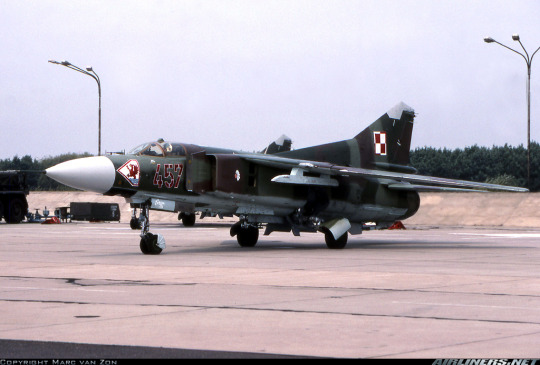
Foreign service of the MiG-23 was mixed. Iraqi Floggers performed well against all but the Iranian Tomcats, band the showdown over the Gulf of Sidra between USN Tomcats and Libyan MiG-23s in 1989 seemed to cement the former’s superiority. Syria’s Floggers had far worse performance, as shown by the slaughter of the Syrian Air Force over the Bekaa Valley in 1982. Angola’s MiG-23s would see fairly active service against the SAAF in the late 80’s, but given the numerous factors in their favor (from quality of the aircraft to better early warning systems and missiles), performance was fairly disappointing. Ultimately, most MiG-23 operators would relinquish their aircraft at the end of the Cold War. Every former Warsaw Pact nation retired or sold off their fleet by the end of the 90’s, and generally those still flying the types (Syria, North Korea, Cuba, and several African countries) seem to be doing so more out of a lack of suitable replacements more than a real desire to keep the Flogger in service.
Dassault Mirage G
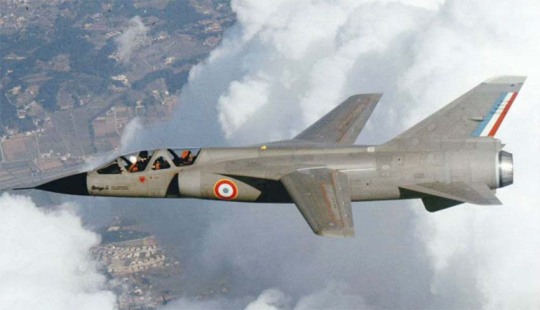
While the AFVG program was ongoing, the French defense ministry had requested Dassault develop a parallel swing-wing design capable of operating from carriers. Although such a design would directly compete with the AFVG, it received alarming support from the French government, who ordered a prototype in 1965. Dassault’s design, the Mirage G, was heavily derived from more conventional Mirage F2. The Mirage G retained most of the critical features of the Mirage F2, but replaced its wings with advanced variable-geometry wings fitted with full-span flaps. In March 1967, it was presented to BAC officials, and later that year it made an appearance at the Paris Air Show. By October 1967, it had flown for the first time. Tests of the single-engined Mirage G went well. In just 20 flights and 2 months of testing, the Mirage G had broken Mach 2 and demonstrated touch-down speeds as low as 108 knots.
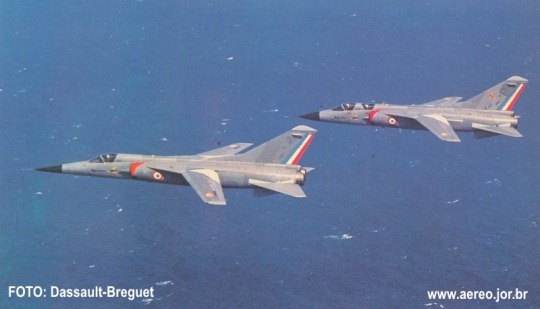
Although the single-engined Mirage G’s performance was satisfactory, France preferred a variant powered by two domestic SNECMA Atar 9 engines. Specifications were refined by 1968, calling for a two-seat nuclear strike fighter. Construction of prototypes for this new variant, dubbed the Mirage G4, began, but before they were completed, economic difficulties had put the project on hold. Hoping to salvage the work done on the program, requirements were changed once more to call for a single-seat interceptor, now designated the Mirage G8. The two incomplete Mirage G4 prototypes were converted to the smaller and cheaper G8 standard, although the first prototype retained the two-seat layout. These prototypes also were far more practical than the original Mirage G demonstrator - they were fitted with the navigational and attack radars to be used on production aircraft. The two-seat prototype took flight in May 1971, followed by the single-seater in July of the next year. Performance remained excellent - the second G8 even managed to set the continental speed record at Mach 2.34. Unfortunately, even this more practical design could not secure the aircraft’s future. No funding was allocated for the G8, and by the mid-70s, the Mirage G program had ended.
General Dynamics F-111K

Although Britain had been working on a domestic tactical strike platform (the BAC TSR-2) in the early 1960s, American enthusiasm over the F-111 coupled with ongoing efforts by the Labour government to do everything in their power to dismantle the British military meant the RAF was soon forced to evaluate the F-111 as a cheaper solution. With the future of the TSR-2 now uncertain, the Australians withdrew and selected the F-111C to meet their requirements, further undermining the project. Two years later, the TSR-2 was cancelled in favor of procuring 110 F-111s. A special variant would be made for the British - the F-111K. The F-111K would take the best elements from all variants - it had the wings of the F-111B, avionics developed from the F-111D, and undercarriage of the FB-111. Other changes included a revised weapons bay, integration with British reconnaissance packages, and an aerial refueling probe. Unfortunately, the Labour government felt they needed to undermine the F-111K as well. The planned procurement dropped to 50 aircraft by 1966, but by April a firm commitment had only been made for 10. Although the end of the AFVG seemed to secure the F-111K’s position, that was far from the case. Production delays and rising costs (due to the devaluation of the sterling) made the F-111K another easy target for the Labour government. In 1968 - a year after construction of the first airframes began - the F-111K was cancelled.
Fairchild Republic/EWR Advanced Vertical Strike
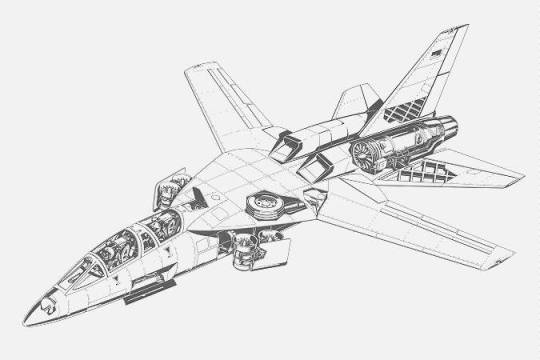
The end of the NBMR-3 program would not mark the last effort to develop a STOVL fighter by West Germany. In 1964, West Germany joined forces with the United States to develop a STOVL fighter to replace the F-104G. The project was ambitious - plans called for not only STVOL operations, but the use of variable geometry wings in the new fighter. EWR would handle the German side of things, while the US side was handled first by Boeing then Fairchild Republic. The joint project soon produced an unusual proposal. The AVS would be powered by two main engines with vectoring thrust (either a P&W JTF16 or GE 1/10) fed by top-mounted intakes to avoid ingesting hot gases. For vertical flight, the Rolls-Royce/Allison XJ99 lift engine was in development. Four of these engines were to be used, mounted in retractable pods stored under the wing glove. The project seemed to have advanced quite far, despite its complexity - various wind tunnel models were made, and even a full-scale mockup of the AVS was built. Unfortunately, the projected complexity (and consequent cost) of the fighter would be its downfall - West Germany cancelled the project in 1968, and America had no interest in pursuing the design for domestic use.
General Dynamics FB-111A/F-111G

With the program to replace the B-52 advancing at a glacial pace, SAC was in search of an interim strategic bomber to fill the gap. McNamara’s pet program would unsurprisingly be pitched as a solution, and by 1965, SAC had selected a new variant of the F-111 - the F-111B - as their new bomber. The FB-111A featured significant changes from the F-111A it was derived from. The longer wings of the F-111B marked the only significant external difference between the variants, while less visible changes included stronger landing gear, larger fuel tanks, more powerful engines, revised intakes, and a new avionics suite with improved navigation and capable of handling nuclear stores (including freefall bombs and the AGM-69 SRAM). The first FB-111A would fly in 1968, and plans called for 263 FB-111s to be produced. When the UK cancelled its F-111K order in 1968, components from the cancelled order were diverted to FB-111 production. In 1969, the order was cut to just 76 aircraft, with deliveries ending in 1971.

Given their more strategic role, the FB-111 fleet had a far quieter career than its cousins. When the B-1A was cancelled by the Carter Administration, the FB-111 became the basis for several proposals for improved variants. The FB-111B would have a stretched fuselage to mount GE F101 turbojets, while the FB-111H took it a step further, lengthening the fuselage even more to improve range and payload along with incorporating an avionics upgrade. However, these proposals couldn’t compete with the B-1B program when it was revived by Reagan, so they were abandoned. After the B-1B finally came into service, 51 FB-111s were retired from the strategic bomber role and converted to F-111Gs. Now serving with TAC, the F-111Gs had their nuclear strike capabilities eliminated and modifications were made to allow them to better handle conventional stores. Unfortunately, the F-111G’s career was brief. The F-111 was already on its way out when the conversion began, and in 1991 surviving FB-111s were retired. Two years later, the F-111G fleet followed suit, although 15 were purchased by Australia, who flew them until 2007.
General Dynamics F-111C

By the end of the 1950s, Australia was in search of a replacement for their Canberra bombers. Although they were at first showing interest in the BAC TSR-2, they set aside funds in 1963 to evaluate various foreign proposals, including the American TFX. Because the TFX was both cheaper and not threatened with cancellation, the Australians selected the TFX to meet their requirements. Of course, the order would require a special variant to be developed, but unlike the later British order, the resulting F-111C would be a fairly simple modification. Apart from the use of the longer F-111B wings and strengthened undercarriage of the F-111D, the F-111C was merely a standard F-111A. The first F-111C would fly in July 1968, and deliveries would begin later that year. However, due to a host of structural issues and problems with the original intakes delayed the type’s entry into service. Worse, the cancellations of the British and USN orders, coupled with the loss of three F-111As due to mechanical failure in Vietnam and rising costs associated with the program made the F-111C order a controversial issue in Australia.
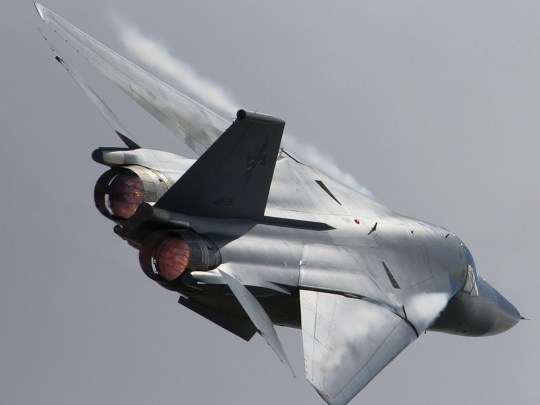
Fortunately, by the time the F-111C entered RAAF service in 1973, the flaws had mostly been dealt with and the controversy evaporated. With the arrival of their Aardvarks, the Australians returned the F-4 Phantoms that had been loaned as a stopgap by the USAF. The new aircraft greatly expanded the RAAF’s capabilities. They could now strike anywhere in Indonesia (their main rival) with aircraft based in Australia, and, unlike the Canberras they replaced, the F-111C featured an advanced avionics and countermeasures suite. Several upgrade programs were conducted through the F-111C’s career. In 1979, four were converted for reconnaissance duties, and in 1983, minor upgrades centered around compatibility with the PAVE TRACK FLIR pod. In the 90’s, upgrades focused on updating the engines and making use of the newest digital avionics. For all Australia’s love for the machine, service has been fairly quiet. Apart from reconnaissance flights flown over East Timor during Australia’s involvement in the region, the F-111C has seen no operational use (though they were on standby for launching strikes if the situation required). Unfortunately, the F-111 wouldn’t last forever. In 2010, the aging airframes were replaced with Super Hornets (although not without controversy).
Sukhoi T-4M
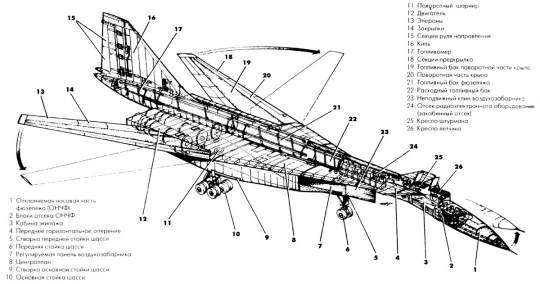
In 1967, new requirements were issued for a high-speed intercontinental bomber with a range of at least 14,000km. Though Sukhoi had been working on their own high-speed bomber project - the T-4 - through the 60’s, it lacked the range to meet the new requirements set out for them. However, the T-4 otherwise had much potential, so Sukhoi hoped to modify the platform to extend its range. To do so, Sukhoi created the T-4M design study. The T-4M was a fairly simple conversion of the T-4, incorporating variable-geometry wings in place of the fixed delta used on the T-4. Just about everything else about the design remained the same - top speed was to be about Mach 3, power was to come from four RD-36 turbojets, and a payload of two Kh-45s or eight Kh-2000s would be carried internally. Although loaded weight increased by about 20,00kg, Sukhoi was still able to conserve much of the original T-4. Although Sukhoi would be contracted to develop the bomber by the end of 1967, the program would not last. In 1968, requirements were revised, calling for a 45 ton payload that could not be met by the T-4 airframe. As even the original T-4 prototype ran into delays and VVS requirements further diverged from the T-4M’s capabilities, Sukhoi eventually dropped the aircraft altogether. The T-4 would go on to fly in 1972, but by then Sukhoi had long abandoned the T-4M.
Tupolev Tu-22M “Backfire”

Recognizing the expense of the Mach 3 high-performance bombers being developed in the 60’s. Tupolev would propose a less sophisticated and capable alternative. Khrushchev’s preference for Sukhoi’s T-4 project would mean that Tupolev’s proposal would be sidelined for the time being, but after Khrushchev was ousted in 1964, Tupolev’s project was revived as a more capable replacement for the Tu-22 Kh-22 missile carrier. The project would be assigned the service designation of Tu-22M, although it was an entirely new aircraft. The Tu-22M did away with the sleek lines of the Tu-22, placing two massive NK-25 turbofans in boxy housings on either side of the fuselage, and swing-wings were used to improve low-speed handling. The main weapon of the Tu-22M, the Kh-22, could be carried in a semi-recessed position under the fuselage, as well as on hardpoints on either wing glove. The spacious bomb bay could also be loaded with up to 24,000kg of conventional stores. In the end, the Tu-22M that took flight in 1969 only retained the bomb bay doors of the Tu-22.

The Tu-22M would be rushed into service, replacing both the Tu-22 with the VVS and the Soviet Navy’s Tu-16 missile carriers. The Backfire, as it was known to the West, was a massive step up from the Blinder, although it was plagued with reliability issues at the start. The Backfire would be the backbone of the Soviet Navy’s strike force, while the VVS would fly the Tu-22M as both a conventional and nuclear bomber. The Backfire would make its debut in Afghanistan, flying conventional bombing missions in formations as large as 16 bombers. 370 Backfires were in service when the Soviet Union collapsed in 1991, and the majority of the fleet fell into Russian hands. Russian Tu-22Ms would continue to see combat use in conventional roles through the coming decades. Backfires bombed Grozny during the war in Chechnya, and in 2008, the Tu-22M returned to combat as a bomber and reconnaissance platform. During the war in Georgia, one Tu-22MR reconnaissance aircraft was lost to Georgian SAMs. Along with the Tu-95, the Backfire has returned to long-range probing patrols near foreign airspace as of 2007.
Sukhoi Su-24 “Fencer”
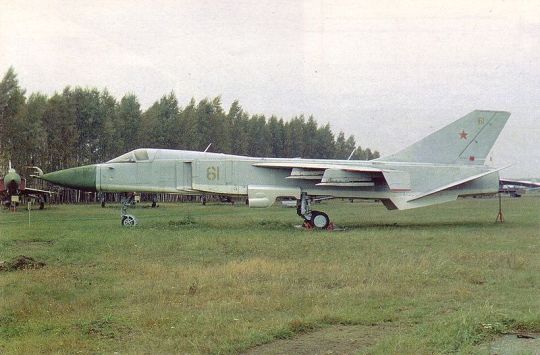
In the mid-1960s, the VVS was in need of a long-range, low-level precision strike aircraft to replace the failed Yak-28. MiG and Sukhoi had developed the MiG-27 and Su-17 aimed at filling this role, but they lacked the capabilities the VVS was looking for. However, to get the Su-17 accepted into service, Sukhoi agreed to develop a precision strike variant. Initial plans centered around a lift-jet concept - an aircraft with a cranked-delta wing using lift jets to shorten the takeoff roll. Crew sat side-by-side, while two engines powered the aircraft. Designated the T-6, the prototype first flew in 1967. However, in late 1967, data provided by TsAGI convinced Sukhoi to change the design to a swing-wing design. Sukhoi altered the original design - keeping the side-by-side cockpit for the crew and twin engines, but eliminated the lift jets and replaced the cranked delta wing with variable-geometry wings.
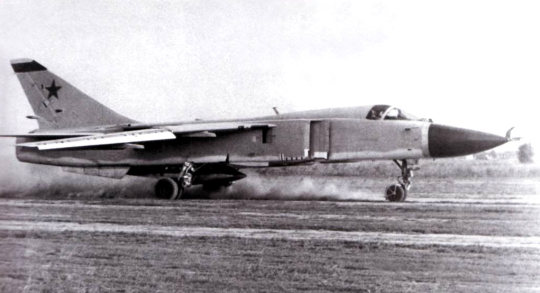
The new prototype took flight in January 1970. Testing continued until 1976, but production was ordered five years prior in 1971. Unlike previous Sukhoi aircraft, the Su-24 was an incredibly advanced strike aircraft. Optimized for low-level strike, the Su-24 can perform supersonic dashes at sea level, and can carry up to 8,000kg of ordnance on eight pylons. Compatible weapons include R-60 AAMs for defence, most unguided bombs and rockets, cannon pods, and a variety of guided air-to-ground and antiradiation missiles. Low-level precision strikes were facilitated by the use of onboard pulse-Doppler and terrain-following radars, several jammers and radar warning receivers, and radio targeting systems. For newer laser-guided weapons, a targeting pod could be mounted as well.

The Su-24 reached peak operational capacity in the mid-80s. With its formidable low-level strike capabilities, the Su-24 was slated to deploy tactical nuclear weapons in the event of war, and thus was constantly on alert. By the end of the decade, many had been transferred to the Baltic Fleet for the maritime strike role. The Fencer made its combat debut in the Afghan War in 1984. It flew a series of heavy bombing missions and precision strikes, but left the more dangerous close-air-support missions to the durable Su-17. Only in 1988 were strikes resumed, with the Fencer dropping cluster bombs, fuel-air-explosives, and FAB-500 and -1500 bombs to cover the withdrawal of Soviet forces.
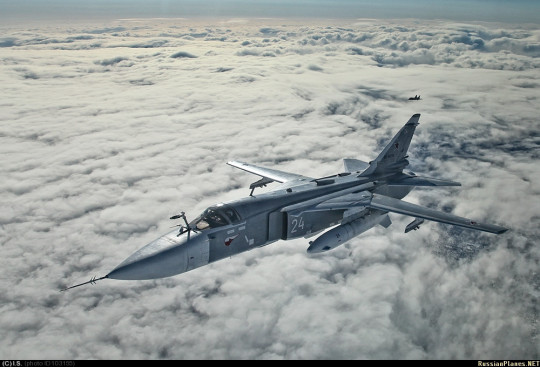
Since the end of the Cold War, the Su-24 has remained an important element of the VVS. Unlike the Su-17, the VVS has kept a sizeable fleet of over 300 Fencers in various roles. In the Chechen Wars, the Su-24 supported operations with bombing and reconnaissance sorties, and continued the practice later in the 2008 South Ossetia War. In 2000, Sukhoi pitched an upgraded variant of the Su-24 incorporating more powerful onboard systems and conformal fuel tanks, but, likely due to budget constraints, the VVS has instead opted for cheaper basic overhauls to extend the service life of the fleet.
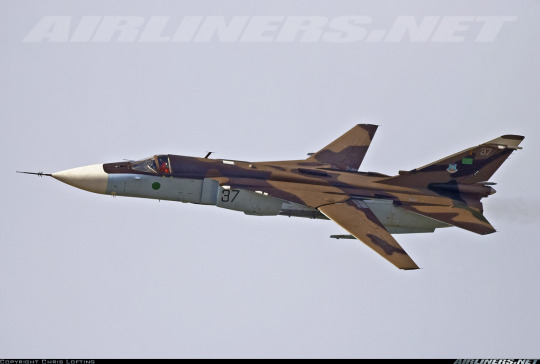
Despite the aircraft’s advanced nature, the Su-24 has seen some export. Iraq acquired 30 Su-24MKs after the Iran-Iraq War, only to lose five on the ground during Operation Desert Storm and have 24 more evacuate to Iran, never to return. The sole surviving Su-24 remained in service after the war. Libya also acquired several Su-24s, with the aircraft making an appearance in the 2011 Civil War. At least one such aircraft was downed during the conflict. Syrian Su-24s have fared little better in their ongoing civil war. Since the start of the civil war, at least two Syrian Su-24s have been downed by ground fire.
Mikoyan Gurevich MiG-23BN/MiG-27 “Flogger-H/Flogger-D/J”

As part of the effort to upgrade the VVS-Frontal Aviation strike force at the end of the 60’s, Mikoyan Gurevich was commissioned to develop a new attack platform. After much consideration, it was determined that the fastest and cheapest solution was to adapt their MiG-23 fighter. Under the designation MiG-23B, a prototype would fly in 1971. The MiG-23B externally was identical to the standard MiG-23, but it featured various changes. Four new pylons would carry a heavy payload, and a new AL-21F engine was supplemented by added internal fuel tanks. Extra armor around vital systems was added, and the air-to-air avionics of the MiG-23 gave way to a new attack-oriented suite. Issues procuring enough engines meant that, while the MiG-23B would be ordered into production, it was to mount a different engine - the R-29B. After a minor redesign to fit the new powerplant, the new attack-Flogger would enter production as the MiG-23BN.
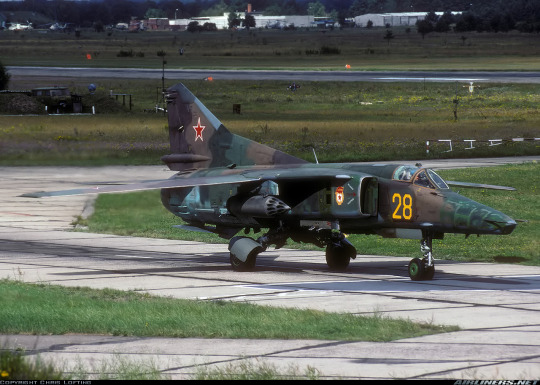
Despite the appearance of the MiG-23BN, the VVS-FA would operate only about 100 of the type. This wasn’t so much due to problems with the MiG-23BM, but the arrival of a newer variant - the MiG-27. Simplified intake ramps, strengthened landing gear, and added pylons improved payload to 4,000kg, while the MiG-23’s GSh-23L gave way to the GSh-6-30 gatling gun. A new digital nav-attack system reduced pilot workload, especially during the guidance of air-to-ground missiles, and a heads-up-display was added. The MiG-27 would take flight in late 1972, and by the next year it was in production. Thus, the MiG-23BN production line could be shifted over to deal with export orders, while the MiG-27 would go directly to VVS-FA.
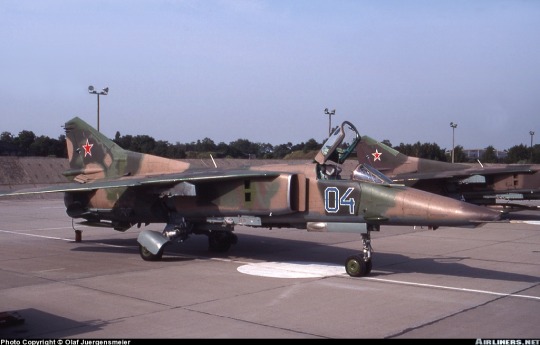
Unfortunately for all the effort put into refining the attacker-Floggers, those serving with the VVS-FA would have to wait quite a while to see combat. While the USSR would be involved in Afghanistan for a decade, the Su-17 would be doing all the heavy lifting while Floggers remained elsewhere. In 1988, a single air regiment was finally deployed for a combat evaluation. Results were predictable - the MiG-27 performed its job well, but in the low-intensity environment of the war, such a heavily armored, technically advanced strike aircraft was a bit overkill. The biggest issue found was with the MiG-27’s gun - the high rate of fire caused intense vibrational issues that almost always broke landing lights, and even after reducing its fire rate, the gun often presented a danger of cooking-off its ammunition after extended bursts. Worse, the gun itself was very maintenance-intensive.
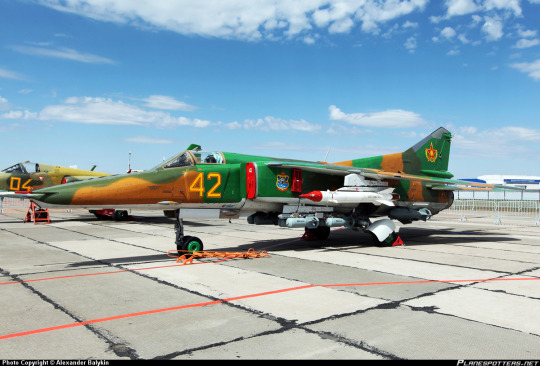
In export service, the attacker-Floggers were popular aircraft. Nearly every Soviet-aligned nation would come to fly the type in some capacity, almost always flying the downgraded MiG-23BN rather than the Soviets’ MiG-27. India was a particularly enthusiastic operator, acquiring almost 100 Floggers for use as SEAD, precision strike, and reconnaissance aircraft. Iraq would also operate a number with success in their war with Iran. Iraqi MiG-23BNs were notable for the addition of a fixed refueling probe and the French-made ATLIS targeting pod. Currently, the MiG-23BN and MiG-27 still fly with several states in Africa and Asia, although the Indians and Russians have moved their fleets to reserve or retired them entirely.
Naval Fighter Experimental (VFX)
The VFX program was started in response to the failure of the navalized F-111B. In light of new developments in Cold War naval doctrine, the Navy was in desperate need of a high-performance interceptor to protect the fleet from attacks by air-launched anti-ship missiles. In 1968, the Navy issued the VFX program, calling for a tandem two-seat, twin-engined interceptor with a top speed of Mach 2.2, armed with a built-in M61 Vulcan to supplement its missiles, and with a secondary ground attack role. Missiles to be carried would be either six AIM-54 Phoenix or six AIM-7 Sparrow and four AIM-9 Sidewinder missiles. Bids were received from Grumman, General Dynamics, Ling-Temco-Vought, McDonnell Douglas, and North American Rockwell.
Vought V-507

Vought’s proposal was roughly similar to the winning proposals. The V-507 was a swing-wing, single tailed design, able to mount both the six-Phoenix or ten mixed-missile armaments specified. The engines were placed side-by-side, with semicircular intakes on either side of the fuselage. The mockup of the aircraft also appeared to show the capability of the tail surfaces to cant downwards. One of the four swing-wing design submitted to the Navy, the design filled the specifications exactly. However, it was not among the designs selected for further development.
North American Rockwell VFX Proposal
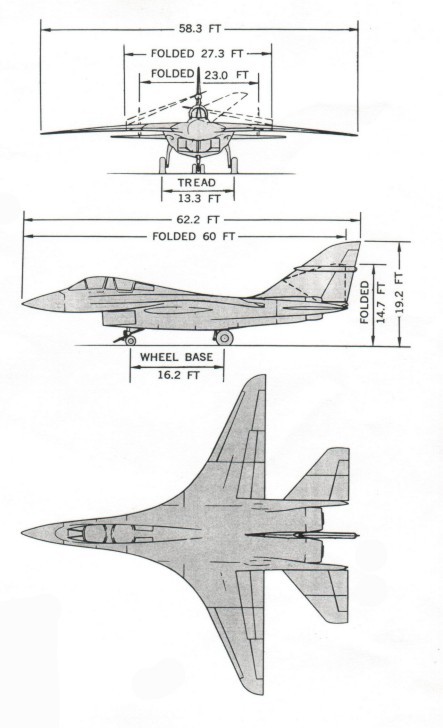
North American Rockwell opted for a more conservative approach for their VFX proposal, basing their design off of their land-based F-X (F-15 program) proposal. Their proposal was the only to featured conventional wings instead of variable geometry wings. Engines were mounted in a pod underneath the aircraft. Crew were to sit in a nose arching over the chin-mounted intakes, giving the aircraft an interesting look akin to a cross between an F-16, MiG-29, and F-15. The complement of missiles was to be carried under and on the sides of the aircraft. Due to the lack of variable geometry wings, the aircraft featured folding wings and tail surfaces to allow for easier storage aboard the carrier. While North American promised excellent performance out of the design, the Navy was skeptical (as was NASA). In the end, North American would not get a chance to validate their design - they were not selected for further development.
McDonnell Douglas VFX Proposal

McDonnell Douglas produced perhaps the most ambitious VFX design. Like three of the other four designs, their proposal featured variable geometry wings. However, they also incorporated canards into the design, as well as a double tail. The wings were mounted low on the aircraft, while engines dominated the fuselage. While the fuselage was somewhat square and un-aerodynamic, it provided a large space for which to mount missiles. The ambitious project was partially successful, perhaps gaining favor due to the anticipated good maneuverability that the canards and twin-tails lent themselves to. The design was one of the two finalist designs selected for further development in late 1968.
General Dynamics VFX Proposal
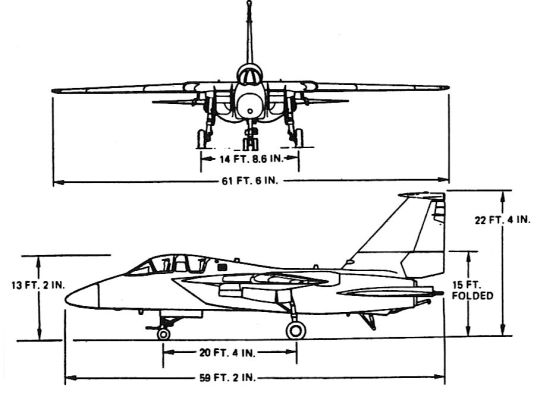
General Dynamics developed a proposal vaguely similar to their F-111 design. Retaining the same variable geometry wings and general layout, differences included being significantly smaller in length and wingspan, while having a larger vertical stabilizer. As per the requirements, the aircraft had crew in tandem, and, to fit better into the carrier, the tailfin folded down to reduce the aircraft’s height from 22 feet to 15 feet. As with the other designs, the armament of missiles would be carried under the fuselage. The General Dynamics proposal was not selected for further development.
Grumman F-14 Tomcat
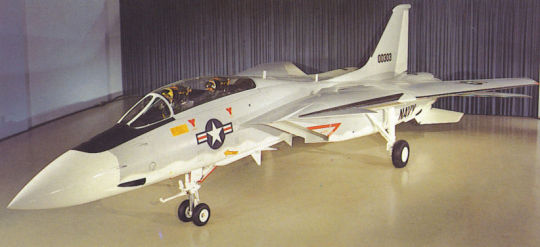
Grumman’s work on the VFX dated back to when the F-111B program was still ongoing. Although the Navy was testing the F-111B at the end of the 1960s, when it became apparent that it would not meet USN requirements, Grumman was contracted to develop design studies for a suitable replacement. Thus, when the VFX was officially launched, Grumman had a major leg up on the competition. Grumman developed several designs, the most successful being their 303E design. The 303E was nearly identical to the F-14 we all came to know and love: A tandem crew, swing-wings, retractable canards, and separated engines allowing the fuselage to produce lift as well as hold the missiles in a lower-drag position. The most notable difference in the design was the single tail and the retractable ventral fins (making up for the relatively small tail surface). The 303E was selected for further development, and, following modifications into the production design, Grumman was awarded the contract in early 1969. Testing began in late 1970, with the Navy foregoing prototyping and ordering the design directly into production. Although smaller than the failed F-111B, the F-14 was the largest production fighter to serve on a USN carrier, a consequence of the large radar, heavy payload, and impressive performance necessitated by the VFX program.
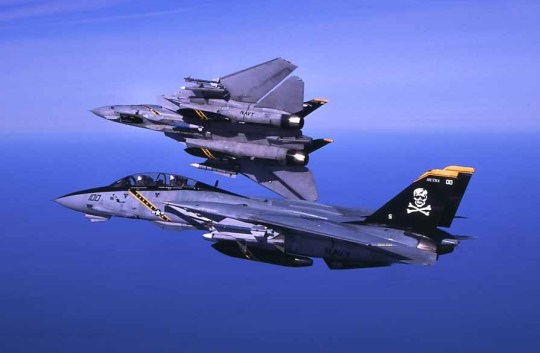
The F-14 entered service in 1974, making its first deployment aboard CVN-65 Enterprise. It made its operational debut during the US evacuation of Saigon in 1975, providing fighter cover for the evacuation route. The next year, the F-14 began performing duties more along the lines of what it was designed for. As Russian bombers would continually shadow US fleets, F-14s would regularly intercept the bombers to escort them away from the fleet. Bear intercepts became a regular occurrence for F-14s, with the encounters only increasing during operational exercises or times of crisis. The combat debut of the F-14 in American service came in 1981, with the first Gulf of Sidra incident. In this incident, F-14s intercepted Libyan fighters on a path towards the carrier group, and, after being fired upon, shot the Libyan aircraft down without suffering any losses.
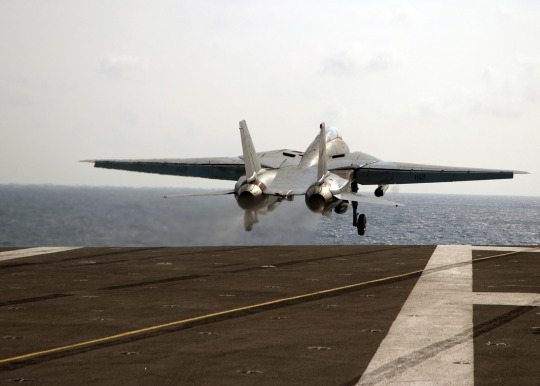
The next theater of action the F-14 would see service in was Lebanon. From 1982 to 1986, the F-14 supported operations in the theater, flying combat air patrols and tactical reconnaissance flights to identify artillery batteries. On several occasions, Syrian SAM batteries in the region fired upon F-14s performing reconnaissance missions. In each instance, the F-14s escaped unscathed, and retaliatory strikes soon silenced the batteries. On one occasion, eight Syrian MiGs were engaged by two F-14s, with locks being attained before the MiGs turned home without being fired upon. In 1989, the F-14 would see combat over the Gulf of Sidra once more, downing two MiG-23s in an engagement similar to the one that occurred eight years previously.

F-14s also saw extensive use of the Persian Gulf, a consequence of the 1990 Persian Gulf War. There, the F-14 saw disappointingly little action, as it was relegated to covering the Gulf. Lack of communication between USAF AWACS and USN aircraft meant that F-14s were often not alerted of contacts that ventured into their zone of control, with land based aircraft making the intercepts instead. The F-14’s powerful radar almost proved to be a liability, alerting enemy aircraft of their presence, leading to enemy aircraft fleeing before they could be engaged. This demoralizing effect was capitalized upon, with several Iraqi aircraft downed while fleeing from F-14s. In addition to CAP duties, F-14s also flew tactical reconnaissance flights. In the entire war, F-14s were credited with only a single kill - an Mi-8 helicopter.
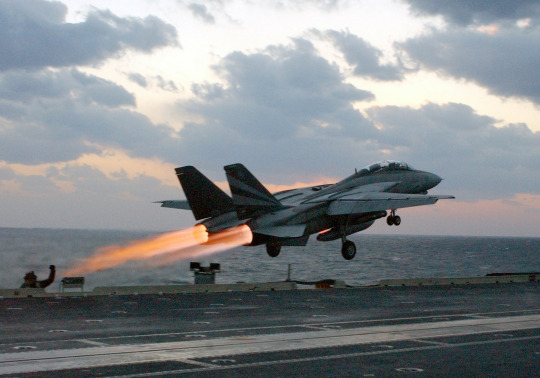
The F-14 was involved in subsequent operations over Iraq, enforcing the No-Fly Zone. New ground-attack capable F-14Ds made their debut in these operations, dropping several PGMs on strike missions. During Operation Desert Fox, F-14Ds achieved several “firsts,” including the first combat use of GBU-24s by the USN, first multiple GBU-24 drop in combat, first combat use of the LANTIRN pod, and first combat use of the AIM-54 missile - an unsuccessful firing on a MiG-25. With the F-14D proven in combat, the F-14 saw much more eventful use in its final years of service. In the Balkans, they performed precision strikes, and, during the post-9/11 bloodthirsty rampage across Afghanistan and Iraq, F-14s made their impact more in the amount of ordnance dropped than in their patrolling the skies for nonexistent aircraft. The final years of F-14 service saw all remaining units deployed to support operations in Iraq. In 2006, however, the aging F-14 was finally retired.
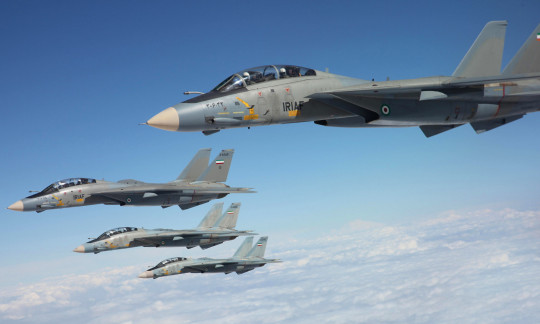
Iran received several F-14s before their revolution in the late 70’s. Despite lack of training, spares, and sabotage of the IRIAF Tomcats, they seemed to perform surprisingly well in the Iran-Iraq War. Their powerful radar proved to be a useful asset, often being used to spot targets for other aircraft to engage. Similar to the USN F-14s in the Gulf War, the F-14 proved to be a demoralizing force, with Iraqi aircraft often withdrawing when they detected the F-14. For all their usefulness, however, the fleet was incredibly small - lack of parts meant that fewer than 20 of the original fleet of 80 were airworthy at any time. Effectiveness decreased as parts ran out, airframes became more fatigued, and the Iraqis began to develop tactics to counter the F-14. However, the F-14’s impact was impressive - IRIAF F-14s claimed at least 160 aircraft, and Iraq purchased Mirage F1s specifically to counter the Tomcat.
Tupolev Tu-148
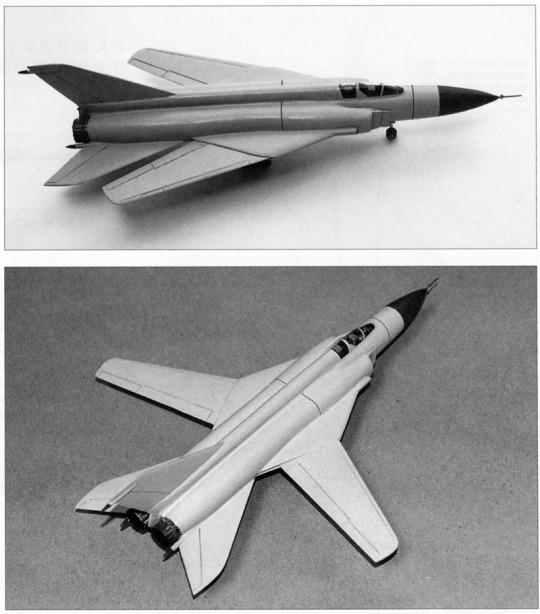
In 1965, Tupolev began another Tu-128-successor project designated Tu-148. The defining feature of this new design would be the use of variable-geometry wings. As the project proved far more promising than its predecessors, it took priority, allowing more specific details to be ironed out. The massive Smerch-100 radar would be installed, requiring a large nose radome. To reduce drag, the Tu-148 would carry its payload of four K-100 missiles internally. Additionally, Tupolev envisioned several other roles for the aircraft - everything from AEW and ELINT to tactical bombing. However, the VVS was resistant to the idea, feeling that the expansion into other roles would detract from the pure interceptor that they wanted. Tupolev went back to the drawing board, revising the Tu-148 to mount the newer Zaslon radar and R-33 missiles, along with the RD-36 engine. Though the project had great promise, the VVS preferred MiG’s Ye-155MP (which would become the MiG-31) so the Tu-148 was canceled.
Panavia Tornado
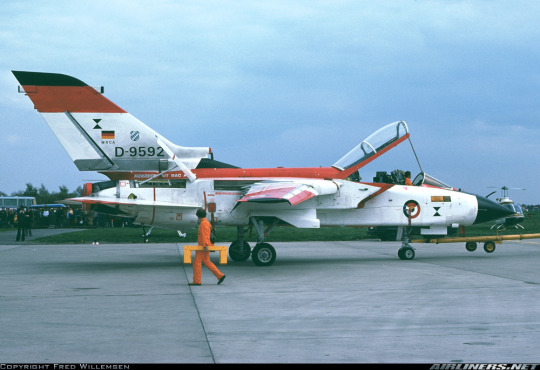
In the aftermath of the collapse of the AFVG, Britain was in search of a new partner to develop their strike aircraft. For about a year, they worked alone on the design, but by mid 1968 they had gained the interest of Germany and Italy. By 1969, the three countries had come together to create the Multirole Combat Aircraft program, merging their interests into a multinational consortium named Panavia. Work was split evenly between BAC and MBB (42.5% each) while Aeritalia picked up the difference. Although preliminary requirements called for an aircraft very similar to the failed AFVG - a two-man multirole fighter with an emphasis on strike - significant changes would be made to the design before it left the drawing board. The MRCA would be slightly larger than the AFVG, and the distinctive inlets developed by Dassault were replaced with new square ones. However, the general layout remained the same, allowing development to move comparatively quickly.
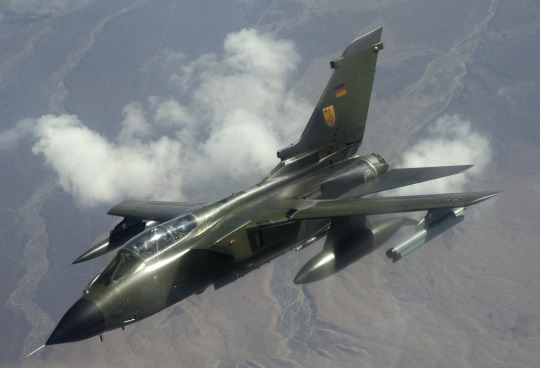
Although rising costs and delays threatened the program several times, the MRCA - now called the Tornado - took to the skies in 1974. By this time, the unit cost had almost doubled, bringing it on par with the American F-111 in terms of cost. The Tornado was hardly a bad aircraft, however. Though nominally multirole, the Tornado was primarily focused on strike operations, and consequently was filled with advanced ground-attack avionics. Advanced terrain-following radars were added to facilitate low-level strikes, and the Tornado was made compatible with just about every guided munition in the NATO inventory. On paper, many aspects seemed to be a step down from the proposed AFVG - it was slightly slower, shorter-ranged, and carried only a single internal cannon. However, the advanced onboard systems more than made up for the perceived shortcomings of the design. Even with all the controversy over delays and rising costs, the Tornado would be a success - the first orders were placed in 1976, and over 800 would be ordered for the three nations of the Panavia consortium.
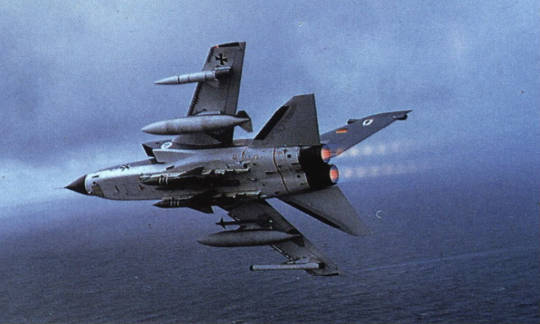
Germany would be the first recipient of the production Tornado, with the first deliveries coming in mid 1979. Replacing the unpopular F-104G, the Tornado was a massive step up in capabilities for the Luftwaffe. The Marineflieger would get their first aircraft soon after, configuring their aircraft for reconnaissance and anti-shipping duties. Italy would come to operate comparatively few Tornadoes - their 100 Tornado IDS were fewer in number than those flown by the West German Marineflieger. The RAF, on the other hand, was a particularly enthusiastic operator - they procured not only the standard IDS strike variant flown by other countries, but developed the Tornado ADV for interception duties as well. The Tornado ADV replaced the ground-attack avionics of the Tornado IDS with air-to-air radars and did away with provisions for air-to-ground armament, instead replacing them with hardpoints for up to four short-range AAMs under the wings and four semi-recessed hardpoints for long-range AAMs.

By the late 80’s, Germany and Italy had decided they wanted a dedicated SEAD platform developed from the Tornado. Dubbed the Tornado ECR, the new variant would add various radar warning receivers and provisions for using the AGM-88 HARM. The Luftwaffe would order 35 new-production ECRs, which had their cannons removed but added a built-in reconnaissance systems, while Italy converted 16 of their standard Tornado IDS, retaining the cannon and forgoing the recce systems. Deliveries would begin in 1990, continuing through the decade. Meanwhile, the RAF took to conducting a general mid-lift overhaul for the fleet, bringing them from the GR1 to GR4 standard. The GR4 upgrades generally focused on updating avionics and integration with newly developed guided munitions.

Although it entered service in the mid-70’s, the Tornado remained stationed in Europe until the end of the Cold War and thus wouldn’t make its combat debut until 1991. During the Gulf War, the RAF deployed a sizeable force of Tornado GR1s along with several ADVs to the region. Italy would also commit a contingent, and the Saudis committed their ADVs. Early sorties involved low-level raids on Iraqi airfields with a mix of general purpose and runway denial bombs. As the Tornadoes were not yet equipped with targeting pods, Blackburn Buccaneers were deployed to illuminate targets with lasers for destruction by the Tornadoes. As the war continued, Tornadoes switched to medium-level sorties on strategic targets. Overall, Coalition Tornadoes proved very effective in the war - across countless sorties, only seven Tornadoes were lost, despite flying incredibly dangerous missions in contested airspace. After the war, Italian and British Tornadoes remained in the region to support the No-Fly Zone over Iraq.

When NATO got involved in Yugoslavia in the 90’s, German Tornadoes would finally get to make their combat debut. Flying out of Italy, they were tasked with tactical reconnaissance and the occasional SEAD mission, while the more numerous Italian and British examples handled actual attack missions. German and British Tornadoes would later be deployed to Afghanistan, while British Tornadoes participated actively in the invasion of Iraq in 2003. Although active numbers have dropped in recent years, none of the four operators of the Tornado have fully retired their fleets yet. Rather, they have been modernized in recent years with the intention of keeping the aircraft in active service until at least 2020. Britain very well may keep the Tornado around longer - a new wave of upgrades was conducted this decade, and the GR4s have had an active role in the bombings of Libya and ISIL-held territories in recent years.
Advanced Manned Strategic Aircraft - AMSA
Through the 1960’s, the USAF conducted a series of design study programs intended to develop the next generation strategic bomber in the wake of the cancellation of the B-70. Studies focused on low-altitude penetration rather than the high-speed, high-altitude flight profile of the B-70, and each successive program would be more ambitious. Initial studies looked at a small subsonic platform, followed by a long-range supersonic program with a modest (10,000lb) payload, ultimately expanding to the Advanced Manned Strategic Aircraft in 1964. The AMSA differed from its predecessors in that it demanded similar performance to the Mach 2-class B-58 that would be replaced on top of excellent low-altitude performance. Boeing, General Dynamics, and North American would participate in the program. Though McNamara would do his best to kill the AMSA, it would be revived by Nixon, and in 1969, the winning proposal from North American Rockwell would be given the designation B-1A.
General Dynamics AMSA Proposal
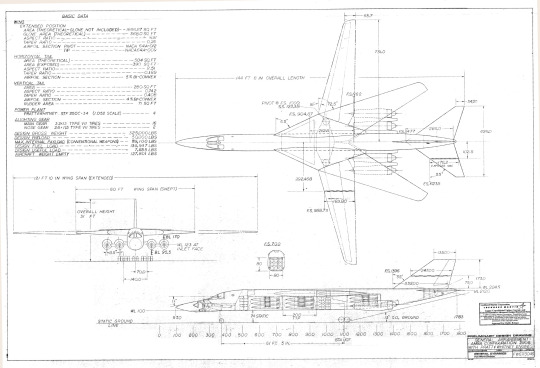
The final design that General Dynamics settled on a design study that dated back to at least 1967. Though details such as wing sweep, overall size, and payload varied over time, the general arrangement remained the same. The aircraft had a shoulder-mounted swing-wing and conventional tail, mounting the projected four GE F101 engines on pylons extending from the rear fuselage under the wings. Details on the final design are hard to find, but whatever the case, it appears that General Dynamics’ proposal was not enough to compete with North American Rockwell’s AMSA design.
North American Rockwell B-1A
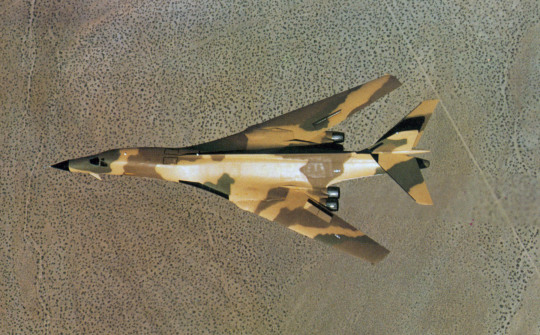
North American had produced another swing-wing design study for the AMSA. The sleek design that would become the B-1A resembled a fighter more than a bomber - it had a low-mounted swept wing that blended into the fuselage, and the four engines were paired together just under the trailing edge of the fixed section of the wings. As contracted in June 1970, Rockwell was to produce one static and five flying prototypes, though this would be reduced to just three flying airframes. The first B-1A prototype would take flight in late 1974, followed by the second and third prototypes in 1976. Unfortunately, the B-1A would become a target for the Carter Administration. Costs were spiraling upwards, and a combination of the belief of the superiority of ballistic missiles and the push for disarmament caused Carter to cut the program in 1977. The decision was not entirely ill-conceived, considering Carter was informed of the development of stealth bombers in 1975, and the newest generation of cruise missiles would allow the B-52 to perform the nuclear strike role just as well as the B-1A.Testing of the B-1A was allowed to continue, and Rockwell would conduct a series of studies simplify the design and reduce costs, but as originally conceived, the B-1A was dead.
General Dynamics/Grumman EF-111A Raven

By the end of the 1960s, the latest generation of jammer aircraft were reaching the end of their useful lives. TAC was in search of a modern replacement, but they were dragging their feet with the search. The EA-6B Prowler flown by the Navy was rejected due to concerns over inadequate range and speed, along with the fact that it was a Navy plane. In 1972, they decided to look into adapting the F-111 to fill the role. Work went slowly, and only in 1974 did the Air Force even begin feasibility studies. In January 1975, Grumman was contracted to modify two F-111As into the EF-111A prototypes. Modifications were quite extensive. The AN/APQ-160 attack radar and AN/APQ-110 terrain-following radars replaced the older systems of the F-111 to improve navigation, while the centerpiece of the aircraft - the AN/ALQ-99E jamming system - was placed in a long ventral “canoe.” Receivers for the complicated jamming system were placed in a large pod on the tip of the vertical stabilizer. Though the crew remained just two men, the systems aboard the EF-111A were considerably more automated than those on the EA-6B, keeping crew workload reasonably low. The first EF-111A prototype, fitted with all the fairings of production aircraft but devoid of any actual jamming equipment, would fly in 1977.
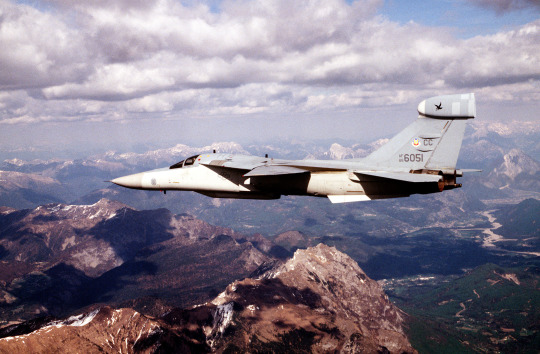
Two years of testing went by before the go-ahead was given to convert 42 F-111s to the new EF-111A standard. Deliveries began in late 1981, and they reach FOC in 1983. Service through the end of the Cold War was quiet. The fleet received several upgrades (new engines in 1986 and modernized avionics in 1989), but their only operational use during the 80’s was in Operation El Dorado Canyon in 1986 and Just Cause in 1989. Where the Raven really came to shine was in the Gulf War. They flew over 1,300 sorties into Iraq, escorting deep interdiction strikes and even flying alongside F-117s over Baghdad. Over the course of the war, every major strike package the USAF flew would have EF-111 support. Despite not mounting any armament, one kill was claimed by the Raven during the war when an EF-111 maneuvered a pursuing Mirage F1 into the ground. The only combat loss would be to crew error - an EF-111 maneuvered into the ground while trying to evade a perceived enemy aircraft.
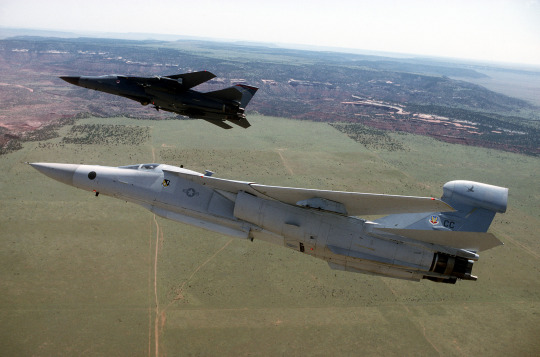
The EF-111 would remain in the Middle East until the end of its career, flying missions in support of the No-Fly Zones established over Iraq. Several examples were also deployed to Italy to support the NATO intervention in Bosnia in 1995. Unfortunately, the EF-111 would not last forever. Although the USAF began a modernization program for the jamming systems in 1991, they were hit with budget cuts after the collapse of the Soviet Union. The USAF had hoped to fly the EF-111 well into the new millennium, but with budgets falling, the Raven soon fell. By the latter half of the 90’s, they were on their way out, and in April 1998, the last Raven had been retired. Ironically, their replacement would be the very aircraft the USAF had initially rejected - the EA-6B.
Mikoyan-Gurevich MiG-23K

When work began on the first generation of true fixed-wing aircraft carriers for the Soviet Navy, requirements were issued for a carrier-capable fighter to fly from the new ships. The first proposal to be submitted would be from MiG, first surfacing in 1972 as the MiG-23K. Derived from the MiG-23ML, the MiG-23K added arrestor gear to the original design, while redesigning much of the fuselage to be better suited to carrier operations. The cockpit was raised and canopy redesigned to improve visibility both forward and aft, and the tail was redesigned as well to account for different aerodynamics. Horizontal stabilizers were also lowered, while an inflight refueling probe was added in the nose. The project was abandoned after brief testing in 1977 when the MiG-29K and Su-27K programs showed more promise.
The Soviet Super Bomber
Back in 1967, the VVS had set out requirements for a new strategic bomber in reaction to the American AMSA program. New requirements were issued to Sukhoi and Myasishchev, calling for a bomber with a range of 13,000km, payload of 45,000kg, and a cruise speed of Mach 3. Sukhoi and Myasishchev both produced designs, but by 1972 it became apparent that the requirements were not feasible with current technology. Thus, the Mach 3 cruise requirement was dropped to Mach 2 and the OKBs were sent back to work, along with Tupolev, who was added onto the project. The result of the second round of the program was the selection of Sukhoi’s proposal. However, with Sukhoi’s factories too busy with other projects, the program was handed off to Tupolev, who would choose to work with Myasischev’s proposals for their new bomber.
Myasishchev M-20
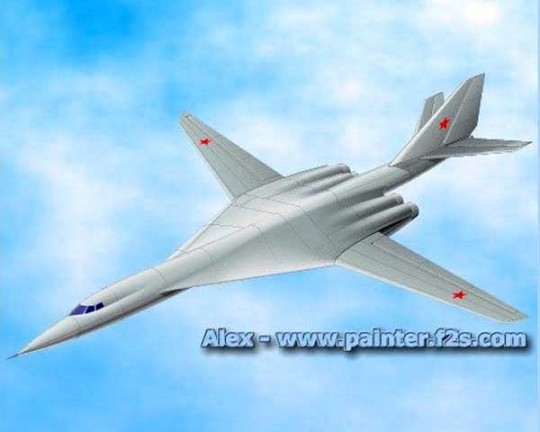
The original series of Myasischev design studies produced for the first wave of program requirements was designated M-20. The M-20 designs varied greatly, but most shared one common characteristic - variable geometry wings. The M-20 design studies morphed from a four-engined beast that resembled an Su-24 or F-111 to an unusual drooping-wing design closer to the cancelled XB-70, and eventually settling on a swing-wing design close to the cancelled Sukhoi T-4M by the end of the decade. The final design studies submitted to the VVS would be far more refined - four engines were placed individually under the wing, and the unsightly “tube with wings” shape of the T-4M and later M-20 studies gave way to something that looked more like a plane. This final design study would go on to form the basis for Myasishchev’s new proposal when the next round of development began.
Sukhoi T-4MS
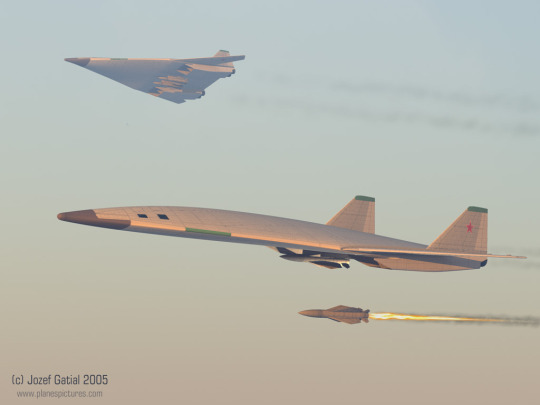
Although Sukhoi’s newest strategic bomber study shared the name of the T-4 program, it was in fact an entirely new machine. The T-4MS was a massive flat bomber, designed to take advantage of the effects of a lifting body and variable geometry wings. The massive triangular body would carry the crew, fuel, and payload, all while producing a significant portion of lift, while comparatively small outboard wing sections could move to provide more efficient cruise or lower drag for high-speed flight. Through the 1970s, Sukhoi continued refining the design, producing an impressive proposal. The T-4MS had a takeoff weight approaching 200 tons, range of 14,000 km, top speed of Mach 3, and payload of up to 45 tons. In effect, it was everything the VVS wanted. Although Myasischev’s parallel design studies offered similar performance, their lack of experience in the area seemed to guarantee Sukhoi’s victory in the program. However, when Sukhoi’s T-4MS was selected, it was found that their facilities were occupied with other projects. The T-4MS could go ahead, but doing so threatened the T-10 (Su-27), T-6 (Su-24), and the latest round of Su-17 modernization. Unwilling to drop these three promising programs, the VVS tried to transfer design work over to Tupolev for completion. However, Tupolev rejected the T-4MS, instead opting to work with Myasishchev’s design studies to create their new bomber.
Myasishchev M-18

When program requirements were revised in 1972, Myasishchev went to work on the M-18, which was derived from the final M-20 design study. The M-18 was an overall refinement of the M-20 design, and it ended up closely resembling the American B-1. Engines sat on the inboard section of the wing’s trailing edge, and more work was done to blend the wing into the fuselage to improve aerodynamic efficiency. Overall a more simplified and improved version of the M-20, the M-18 had its advantages over the Sukhoi T-4MS - notably, it was only 150 tons loaded for a similar payload. However, Myasishchev’s inexperience would mean they would never head the project, even after it was determined that Sukhoi was unable to proceed and Tupolev was unwilling to work with the T-4MS. Myasishchev’s design work would be transferred to Tupolev by the end of the decade, forming the basis for what would become the Tu-160.
Tupolev Tu-160 “Blackjack”

Tupolev’s original proposal was roughly based on the Tu-144 supersonic transport - it had a large cranked-arrow wing and single tail, and was powered by four engines paired together under the wings. During cruise, wingtips were to droop to “ride” the supersonic shockwave. However, the design met resistance from the start. The “160” proposal failed to meet requirements set out, and there were concerns that the aerodynamic work was fraudulent. In the end, Sukhoi’s T-4MS would win, but Sukhoi lacked the facilities to produce the bomber. Tupolev was asked to produce Sukhoi’s design, but they instead selected Myasishchev’s M-18 proposal to produce. Tupolev made some changes to the design before constructing the design as the Tu-160.
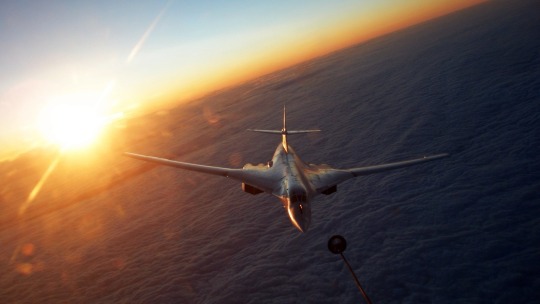
The Tu-160 that would take flight in late 1981 was a far cry from the original Tupolev design or Sukhoi’s T-4MS. The Blackjack, as it was known to the West, was a massive swing-wing bomber vaguely similar in appearance to the American B-1B. Four NK-32 turbofans provide the Tu-160 with the ability to reach speeds of Mach 2, while twin tandem bomb bays allow the bomber to carry a payload of up to 40 metric tons of stores. Normally, the bays carry six Kh-55 missiles each in rotary launchers. The end result of over a decade of development was the largest combat aircraft in history. Although the project was shifted to Tupolev to fast-track production, deliveries of the Tu-160 were painfully slow - the first pre-production aircraft wasn’t delivered until 1984, and the Blackjack only became operational in 1987. By the time the Soviet Union collapsed, only 35 Tu-160s had been completed.
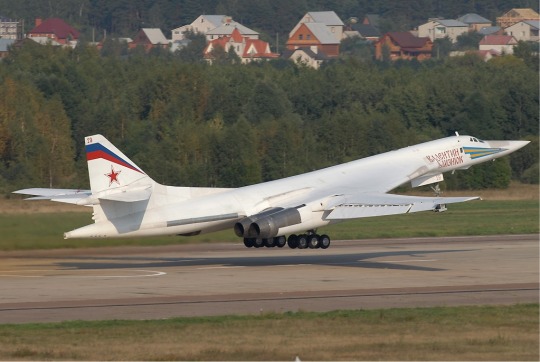
The dissolution of the USSR saw a significant portion of the Blackjack fleet fall into the hands of a Ukrainian government that was fairly hostile to Russia. Although Russia worked hard to secure the return of the aircraft, Ukraine scrapped nine bombers and turned another into a static display, meaning that only nine Ukrainian Tu-160s would ever fly again. Meanwhile, attrition took its toll on the fleet, even as production lines remained operational (albeit at a glacial pace). Active numbers have dropped to just 20 aircraft in recent years, and although the Russians have restarted production of the type, budget limitations mean that Blackjack numbers will likely remain low for the foreseeable future.
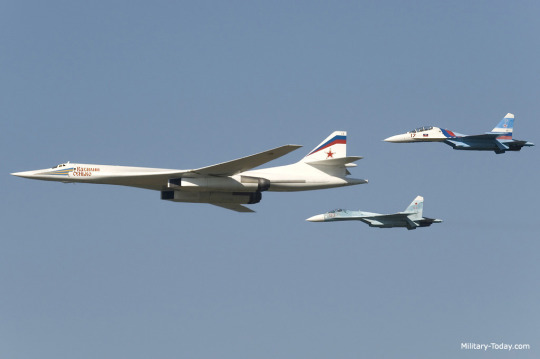
Given the late arrival of the Tu-160, operational service has been mainly limited to doing what Russian bombers do best: flying absurdly long distances to molest other countries’ airspace. These patrols resumed in 2007, with Blackjacks probing the airspace of various Baltic countries. In 2008, they participated in the largest Russian strategic bomber exercise since 1984, marking the first time the bomber fired its full complement of missiles. In 2008 and 2013, Tu-160s made nonstop flights from Russia to Venezuela, flying through international airspace, as a show of support. Unfortunately, the Tu-160’s fairly uneventful service history takes away from its significance - it marks the largest combat aircraft ever, as well as the largest supersonic aircraft and the highest-payload combat aircraft ever.
Rockwell B-1B Lancer

Although Carter had killed the B-1A, the Air Force worked with Rockwell to develop an improved cruise missile-carrying variant on low priority. Rising tensions with the Soviets led to a resurgence in defense spending, and when Reagan took office in 1980, he revived the B-1 as the B-1B. Though the B-1B would retain the same outward appearance of the B-1A, the B-1B would have countless changes. The high-altitude, high-speed envelope was all but abandoned due to the expected superiority of Soviet air defenses, allowing Rockwell to eliminate features like the variable-geometry intake ramps and reduce the top speed below Mach 2. Instead, the new focus became low-altitude operations with reduced chances of detection. New engine inlets and other design features reduced radar-cross section, and, although top speed at altitude dropped to Mach 1.25, low-altitude top speeds went up from Mach .85 to Mach .92. Max takeoff weight increased by over 80,000 lb, allowing for more fuel to be carried as well as a massive internal and external payload. The focus of payload would also switch to cruise missiles rather than freefall bombs.

The advanced B-1B would prove equally controversial and even more expensive than its predecessor, but Reagan would keep the program alive. The B-1A prototypes were modified to the B-1B standard to test the design, and in 1984, the first production B-1B would take flight. Deliveries began in 1985, and by the end of the decade, the entire production order of 100 aircraft was delivered. Unfortunately, it remained controversial early in its service. Several aircraft were lost to accidents, and availability was low (due to inadequate funding for spares). It faced further criticism when it didn’t make a showing in the 1991 Gulf War, although this was due to the fleet being reserved for nuclear strike and not yet equipped for conventional strike. However, as a response to the criticism over its lack of utility, the USAF embarked on a program to expand the B-1B’s ability to use conventional munitions in the mid-90’s.
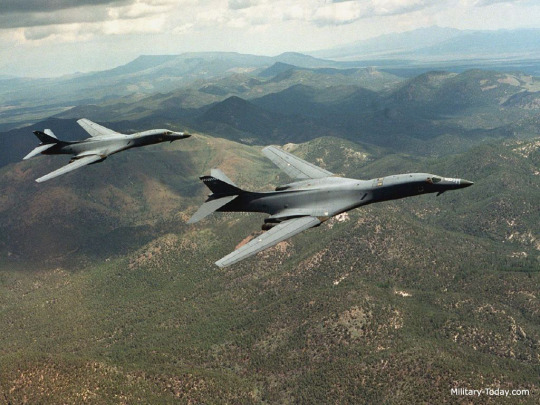
The B-1B would finally make its combat debut in 1998 over Iraq as part of Operation Desert Fox, where it dropped unguided bombs for four days. Several months later, it made an appearance over Kosovo during Operation Allied Force, again dropping iron bombs. The B-1B would really come to shine in the post-9/11 rampage across the Middle East and Central Asia. During both invasions, they showed their utility as a CAS platform, loitering for long periods over battle zones loaded with JDAMs to hit whatever targets arose. Although they would run into the issue of being unable to confirm targets, the USAF would address this by the end of the decade by fitting the B-1B with an external targeting pod. Nowadays, the B-1B is perhaps the most useful bomber in the inventory. Experience over Iraq and Afghanistan cemented its utility as a tactical bomber, and all of the teething issues experienced early in service seem to be gone. Not only is availability rate high, but it has a lower cost-per-flight-hour than the B-2 and even the archaic B-52.

Although the B-1B was originally intended to be a state-of-the-art strategic bomber, it has since lost its ability to deploy nuclear weapons. Thanks to various strategic arms reduction treaties and the renewed focus on conventional strike, the entire fleet had its nuclear capabilities disabled. However, it has hardly lost its place as an effective bomber. The USAF continues to employ it in various COIN operations and incidents like the bombing of ISIL. It continues to be upgraded to deal with more conventional threats, both in terms of sensors and countermeasures as well as armament. Though the Long Range Strike Bomber will eventually come along to supplement the B-1B, the Air Force plans to keep the B-1B flying for the foreseeable future.
Nanchang Q-6
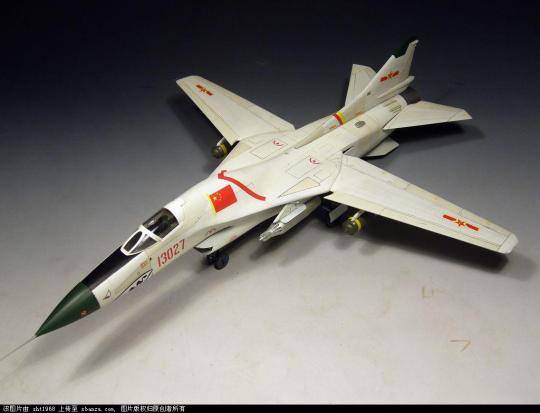
In response to the failings of the PLAAF revealed in the Battle of the Paracel Islands, requirements were set out for a new attack aircraft to replace the MiG-19-derived Q-5. The new aircraft was to have a significantly longer range, better equipment, and the ability to fly all-weather missions. Nanchang, Shenyang, and Xian would respond to the requirements issued in 1976, although Shenyang’s proposal was rejected. Nanchang’s design was given the designation Q-6. The Q-6 was heavily derived from the MiG-23, copying just about everything from the wings back but extensively modifying the forward fuselage and intakes. Although the original design was based off the MiG-23BN, the PLAAF requirement for an attack radar meant that the nose would be changed to fit electronics derived from the F-111 (captured from downed planes in Vietnam). The nose and cockpit was enlarged and raised to accommodate the new radar, and the intakes were moved under the nose. Ultimately, the Q-6 would prove too ambitious for the time. Nanchang ran into issues reverse-engineering everything from the wing-sweep mechanism to the engines, and the capabilities of the electronics used (which would make the Q-6 the most advanced aircraft in the PLAAF inventory) were beyond the abilities of Chinese industry to mass-produce. The design’s weight gradually grew while engines fell short of performance goals, forcing Nanchang to undergo almost a complete redesign. By this point, the Q-6 had been surpassed by Xian’s JH-7. Work fell behind that of the JH-7, and, following successful flight tests of the competitor, the Q-6 program was cancelled.
Lockheed F-22N
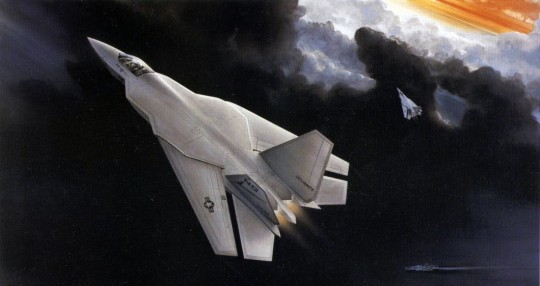
Parallel to the Air Force’s ATF program (that would produce the F-22 and YF-23), the Navy was made to establish the NATF, intended to navalize one of the designs for their next-generation fighter. Establishing the program in 1988, requirements for the NATF included a max takeoff weight of 65,000lb and landing weight of 52,000lb, while being no larger than the F-14 and capable of taking on the fleet-defense interceptor role, preferably with a second crewman. Unfortunately, the new requirements meant that the NATF proposals had almost nothing in common with the aircraft from which they were derived. Lockheed’s proposal, the F-22N, threw swing-wings on the F-22 design in hopes of attaining the low-speed handling the Navy wanted. Unfortunately, the changes made to the structure brought the F-22N’s projected loaded weight up too much, meaning it wouldn’t be able to fly from carriers. The Northrop contender fared little better, and by the early 90’s the Navy had dropped the NATF program altogether as the contenders both had proven impractical.
Lockheed/Boeing/General Dynamics A/F-X Proposal

Following the cancellation of the ATA and NATF (navalized adaptation of the Air Force’s ATF), the Navy began a new program to replace the A-6. Designated the A-X, the program aimed to replace the A-6 with an advanced two-man all-weather attack aircraft. Such a program attracted the attention of the Air Force, who was concurrently seeking to replace the F-111. As the Navy added on requirements to fill the gap left by the cancellation of the NATF, the program changed focus from an attacker to a multirole, causing the program name to change to A/F-X. The Lockheed/Boeing/General Dynamics team would develop what amounted to the successor of the failed Lockheed NATF proposal. This team’s proposal was a swing-wing aircraft derived from the F-22 and featuring extensive changes to better suit the aircraft for air-to-ground operations and carrier takeoffs and landings. Extensive changes were made to the wings and tail, and unlike the NATF proposal, which appeared to be little more than an F-22 with swing-wings, this new proposal was an entirely new aircraft. Ultimately, neither this nor any of the A/F-X proposals would reach full-scale development. Rather, the program was cancelled in the mid-90s and folded into the Joint Strike Fighter.
7 notes
·
View notes